OPNAV M-5090.1
25 Jun 2021
ENVIRONMENTAL
READINESS
PROGRAM
MANUAL

DEPARTMENT OF THE NAVY
OFFICE OF THE CHIEF OF NAVAL OPERATIONS
2000 NAVY PENTAGON
WASHINGTON DC 20350-2000
OPNAV M-5090.1
N4
25 Jun 2021
FOREWORD
This manual implements the policy set forth in Chief of Naval Operations Instruction
(OPNAVINST) 5090.1E, Environmental Readiness Program. It is issued under Secretary of the
Navy Instruction (SECNAVINST) 5090.8A, Policy for Environmental Protection, Natural
Resources and Cultural Resource Program, 30 January 2006. It contains the Navy’s policy
guidance for environmental readiness. It discusses requirements, delineates responsibilities, and
issues policy guidance for the management of the environmental, natural, and cultural resources
for all Navy ships and shore activities.
This manual is effective immediately. It is mandatory and applicable to all afloat and ashore
Navy commands.
This manual may be accessed via the Department of the Navy (DON) Issuances Web site,
(https://www.secnav.navy.mil/doni/default.aspx) under the “Manuals” tab. This manual is
approved for authorized registered users and distribution is unlimited. References for this
manual that are not legislation, regulations, executive orders, or international agreements are
located on the DON Issuances Web site, (https://www.secnav.navy.mil/doni/default.aspx), on the
DoD Issuances Web site, (https://www.esd.whs.mil/dd/), and on the Office of the Chief of Naval
Operations, Energy and Environmental Readiness Division (OPNAV N45) Environmental
Planning and Compliance Library Web site, (https://epl.navfac.navy.mil/).
R. L. WILLIAMSON
Deputy Chief of Naval Operations
(Fleet Readiness and Logistics)
OPNAV M-5090.1
25 Jun 2021
i
ENVIRONMENTAL READINESS PROGRAM MANUAL
TABLE OF CONTENTS
SECTION I — GENERAL REQUIREMENTS AND MANAGEMENT
Chapter 1: Organization and Coordination............................................................................ 1-1
1-1 Scope ......................................................................................................................... 1-1
1-2 Legislation ................................................................................................................. 1-5
1-3 Requirements ............................................................................................................. 1-5
1-4 Responsibilities ...........................................................................................................1-18
1-5 Definitions ..................................................................................................................1-30
Chapter 2: Funding ................................................................................................................. 2-1
2-1 Scope ...........................................................................................................................2-1
2-2 Legislation ..................................................................................................................2-1
2-3 Requirements ..............................................................................................................2-2
2-4 Responsibilities ...........................................................................................................2-8
2-5 Definitions ..................................................................................................................2-9
Chapter 3: Environmental Readiness Training .................................................................... 3-1
3-1 Scope .......................................................................................................................... 3-1
3-2 Legislation ................................................................................................................. 3-2
3-3 Requirements ............................................................................................................. 3-2
3-4 Responsibilities .......................................................................................................... 3-14
3-5 Definitions ................................................................................................................. 3-15
Chapter 4: Environmental Performance Reporting ............................................................... 4-1
4-1 Scope .......................................................................................................................... 4-1
4-2 Legislation ................................................................................................................. 4-2
4-3 Requirements ............................................................................................................. 4-2
4-4 Responsibilities .......................................................................................................... 4-6
4-5 Definitions ................................................................................................................. 4-7
Chapter 5: Outreach and Communications ........................................................................... 5-1
5-1 Scope .......................................................................................................................... 5-1
5-2 Legislation ................................................................................................................. 5-2
5-3 Requirements ............................................................................................................. 5-2
5-4 Responsibilities .......................................................................................................... 5-6
5-5 Definitions ................................................................................................................. 5-6
Chapter 6: Reserved for Future Use
Chapter 7: Sampling and Laboratory Testing ...................................................................... 7-1
7-1 Scope .......................................................................................................................... 7-1
7-2 Legislation ................................................................................................................. 7-2
7-3 Requirements ............................................................................................................. 7-3
OPNAV M-5090.1
25 Jun 2021
ii
7-4 Responsibilities .......................................................................................................... 7-6
7-5 Definitions ................................................................................................................. 7-7
Chapter 8: Reserved for Future Use
Chapter 9: Reserved for Future Use
SECTION II — PLANNING AND CONSERVATION
Chapter 10: Environmental Planning Under the National Environmental Policy Act and Executive
Order 12114 ............................................................................................................................. 10-1
10-1 Scope ........................................................................................................................ 10-3
10-2 Legislation ............................................................................................................... 10-5
10-3 Requirements ........................................................................................................... 10-6
10-4 Responsibilities ........................................................................................................ 10-89
10-5 Definitions ............................................................................................................... 10-90
Chapter 11: Reserved for Future Use
Chapter 12: Natural Resources Conservation ....................................................................... 12-1
12-1 Scope ........................................................................................................................ 12-1
12-2 Legislation ............................................................................................................... 12-5
12-3 Requirements ........................................................................................................... 12-6
12-4 Responsibilities ........................................................................................................ 12-38
12-5 Definitions ............................................................................................................... 12-42
Chapter 13: Cultural Resources Compliance and Management ........................................... 13-1
13-1 Scope ........................................................................................................................ 13-1
13-2 Legislation ............................................................................................................... 13-3
13-3 Requirements ........................................................................................................... 13-4
13-4 Responsibilities ........................................................................................................ 13-16
13-5 Definitions ............................................................................................................... 13-22
Chapter 14: Coastal Zone Management ................................................................................ 14-1
14-1 Scope ........................................................................................................................ 14-1
14-2 Legislation ............................................................................................................... 14-2
14-3 Requirements ........................................................................................................... 14-2
14-4 Responsibilities ........................................................................................................ 14-10
14-5 Definitions ............................................................................................................... 14-12
Chapter 15: Navy Operational Range Environmental Sustainment ..................................... 15-1
15-1 Scope ........................................................................................................................ 15-1
15-2 Legislation ............................................................................................................... 15-2
15-3 Requirements ........................................................................................................... 15-2
15-4 Responsibilities ........................................................................................................ 15-7
15-5 Definitions ............................................................................................................... 15-9
OPNAV M-5090.1
25 Jun 2021
iii
Chapter 16: Reserved for Future Use
SECTION III — SHORE COMPLIANCE
Chapter 17: Environmental Management Systems and Environmental Compliance
Audits Ashore ......................................................................................................................... 17-1
17-1 Scope ........................................................................................................................ 17-1
17-2 Legislation ............................................................................................................... 17-3
17-3 Requirements ........................................................................................................... 17-3
17-4 Responsibilities ........................................................................................................ 17-23
17-5 Definitions ............................................................................................................... 17-28
Chapter 18: Reserved for Future Use
Chapter 19: Processing Notices of Violation Under Environmental Laws and Regulations19-1
19-1 Scope ........................................................................................................................ 19-1
19-2 Legislation ............................................................................................................... 19-2
19-3 Requirements ........................................................................................................... 19-2
19-4 Responsibilities ........................................................................................................ 19-8
19-5 Definitions ............................................................................................................... 19-9
Chapter 20: Clean Water Ashore ........................................................................................... 20-1
20-1 Scope ........................................................................................................................ 20-1
20-2 Legislation ............................................................................................................... 20-2
20-3 Requirements ........................................................................................................... 20-3
20-4 Responsibilities ........................................................................................................ 20-10
20-5 Definitions ............................................................................................................... 20-12
Chapter 21: Safe Drinking Water Compliance Ashore ......................................................... 21-1
21-1 Scope ........................................................................................................................ 21-1
21-2 Legislation ............................................................................................................... 21-3
21-3 Requirements ........................................................................................................... 21-3
21-4 Responsibilities ........................................................................................................ 21-20
21-5 Definitions ............................................................................................................... 21-21
Chapter 22: Clean Air Ashore................................................................................................ 22-1
22-1 Scope ........................................................................................................................ 22-1
22-2 Legislation ............................................................................................................... 22-3
22-3 Requirements ........................................................................................................... 22-3
22-4 Responsibilities ........................................................................................................ 22-23
22-5 Definitions ............................................................................................................... 22-32
Chapter 23: Hazardous Materials Management Ashore ....................................................... 23-1
23-1 Scope ........................................................................................................................ 23-1
23-2 Legislation ............................................................................................................... 23-3
23-3 Requirements ........................................................................................................... 23-3
23-4 Responsibilities ........................................................................................................ 23-5
OPNAV M-5090.1
25 Jun 2021
iv
23-5 Definitions ............................................................................................................... 23-8
Chapter 24: Pesticide Compliance Ashore ............................................................................ 24-1
24-1 Scope ........................................................................................................................ 24-1
24-2 Legislation ............................................................................................................... 24-2
24-3 Requirements ........................................................................................................... 24-3
24-4 Responsibilities ........................................................................................................ 24-9
24-5 Definitions ............................................................................................................... 24-12
Chapter 25: Toxic Substances Control Act ........................................................................... 25-1
25-1 Scope ........................................................................................................................ 25-1
25-2 Legislation ............................................................................................................... 25-2
25-3 Requirements ........................................................................................................... 25-2
25-4 Responsibilities ........................................................................................................ 25-11
25-5 Definitions ............................................................................................................... 25-14
Chapter 26: Procedures for Implementing the Emergency Planning and Community
Right-to-Know Act .................................................................................................................. 26-1
26-1 Scope ........................................................................................................................ 26-1
26-2 Legislation ............................................................................................................... 26-3
26-3 Requirements ........................................................................................................... 26-3
26-4 Responsibilities ........................................................................................................ 26-17
26-5 Definitions ............................................................................................................... 26-18
Chapter 27: Hazardous Waste Management Ashore ............................................................ 27-1
27-1 Scope ........................................................................................................................ 27-1
27-2 Legislation ............................................................................................................... 27-3
27-3 Requirements ........................................................................................................... 27-3
27-4 Responsibilities ........................................................................................................ 27-20
27-5 Definitions ............................................................................................................... 27-26
Chapter 28: Solid Waste Management and Resource Recovery Ashore ............................. 28-1
28-1 Scope ........................................................................................................................ 28-1
28-2 Legislation ............................................................................................................... 28-3
28-3 Requirements ........................................................................................................... 28-3
28-4 Responsibilities ........................................................................................................ 28-11
28-5 Definitions ............................................................................................................... 28-13
Chapter 29: Low-Level Radioactive Waste Disposal Program ............................................ 29-1
29-1 Scope ........................................................................................................................ 29-1
29-2 Legislation ............................................................................................................... 29-2
29-3 Requirements ........................................................................................................... 29-2
29-4 Responsibilities ........................................................................................................ 29-3
29-5 Definitions ............................................................................................................... 29-5
Chapter 30: Oil Management Ashore .................................................................................... 30-1
OPNAV M-5090.1
25 Jun 2021
v
30-1 Scope ........................................................................................................................ 30-1
30-2 Legislation ............................................................................................................... 30-2
30-3 Requirements ........................................................................................................... 30-2
30-4 Responsibilities ........................................................................................................ 30-8
30-5 Definitions ............................................................................................................... 30-9
Chapter 31: Storage Tanks ..................................................................................................... 31-1
31-1 Scope ........................................................................................................................ 31-1
31-2 Legislation ............................................................................................................... 31-2
31-3 Requirements ........................................................................................................... 31-2
31-4 Responsibilities ........................................................................................................ 31-10
31-5 Definitions ............................................................................................................... 31-12
Chapter 32: Reserved for Future Use
Chapter 33: Reserved for Future Use
SECTION IV — AFLOAT AND OVERSEAS COMPLIANCE
Chapter 34: Overseas Environmental Compliance Ashore .................................................. 34-1
34-1 Scope ........................................................................................................................ 34-2
34-2 Legislation ............................................................................................................... 34-3
34-3 Requirements ........................................................................................................... 34-3
34-4 Responsibilities ........................................................................................................ 34-11
34-5 Definitions ............................................................................................................... 34-14
Chapter 35: Environmental Compliance Afloat .................................................................... 35-1
35-1 Scope ........................................................................................................................ 35-1
35-2 Legislation ............................................................................................................... 35-3
35-3 Requirements ........................................................................................................... 35-4
35-4 Responsibilities ........................................................................................................ 35-63
35-5 Definitions ............................................................................................................... 35-75
Chapter 36: Permitted Ocean Disposition ............................................................................. 36-1
36-1 Scope ........................................................................................................................ 36-1
36-2 Legislation ............................................................................................................... 36-2
36-3 Requirements ........................................................................................................... 36-2
36-4 Responsibilities ........................................................................................................ 36-5
36-5 Definitions ............................................................................................................... 36-7
Chapter 37: Reserved for Future Use
Chapter 38: Reserved for Future Use
OPNAV M-5090.1
25 Jun 2021
vi
SECTION V — SPILLS, DAMAGE, AND RESTORATION
Chapter 39: Oil and Hazardous Substance Spill Preparedness and Response ..................... 39-1
39-1 Scope ........................................................................................................................ 39-1
39-2 Legislation ............................................................................................................... 39-3
39-3 Requirements ........................................................................................................... 39-3
39-4 Responsibilities ........................................................................................................ 39-21
39-5 Definitions ............................................................................................................... 39-30
Chapter 40: Sunken Military Craft ........................................................................................ 40-1
40-1 Scope ........................................................................................................................ 40-1
40-2 Legislation ............................................................................................................... 40-1
40-3 Requirements ........................................................................................................... 40-2
40-4 Responsibilities ........................................................................................................ 40-4
40-5 Definitions ............................................................................................................... 40-5
Chapter 41: Natural Resource Damage ................................................................................. 41-1
41-1 Scope ........................................................................................................................ 41-1
41-2 Legislation ............................................................................................................... 41-3
41-3 Requirements ........................................................................................................... 41-3
41-4 Responsibilities ........................................................................................................ 41-18
41-5 Definitions ............................................................................................................... 41-21
Chapter 42: Environmental Restoration ................................................................................ 42-1
42-1 Scope ........................................................................................................................ 42-2
42-2 Legislation ............................................................................................................... 42-4
42-3 Requirements ........................................................................................................... 42-4
42-4 Responsibilities ........................................................................................................ 42-26
42-5 Definitions ............................................................................................................... 42-33
SECTION VI — APPENDICES
A Summary of Major Legislation, Regulations, Executive Orders, and International
Agreements ......................................................................................................................... A-1
B Acronyms ........................................................................................................................... B-1
C Message Formats ............................................................................................................... C-1
D Afloat Environmental Checklists ...................................................................................... D-1
E Web Sites ............................................................................................................................ E-1
F Forms and Reports.............................................................................................................. F-1
LIST OF FIGURES
10-1 Generalized Geographic Applicability ......................................................................10-7
10-2 NEPA Process Flowchart ...........................................................................................10-40
10-3 E.O. 12114 Environmental Planning Flowchart for Navy Actions .........................10-78
OPNAV M-5090.1
25 Jun 2021
vii
14-1 CZMA Federal Consistency Flowchart .....................................................................14-4
21-1 Water System Classification Flowchart .....................................................................21-6
42-1 Navy ER Process .........................................................................................................42-5
LIST OF TABLES
1-1 EPA Regions and DoD RECs ....................................................................................1-10
1-2 EPA Regions and Navy RECs ....................................................................................1-10
3-1 NERTP Formal Training Courses ..............................................................................3-7
10-1 Geographic Applicability ............................................................................................10-8
10-2 Guidance for Choosing the Environmental Planning Process for Complying
with NEPA and E.O. 12114 .......................................................................................10-10
10-3 Sample “Impact” and “Harm” Conclusions for Environmental Planning
and Decision Documents ............................................................................................10-16
10-4 Summary of EIS Version Nomenclature and Management .....................................10-20
10-5 Comparison of Programmatic and Comprehensive Environmental Planning
Documents ...................................................................................................................10-23
10-6 Department of the Navy List of CATEXs .................................................................10-41
10-7 List of Actions Normally Requiring an EA ...............................................................10-47
10-8 Notification Elements ..................................................................................................10-49
10-9 Core Components of an EA ........................................................................................10-51
10-10 Factors for Determining When to Elevate an EA for OPNAV N45 Action............10-54
10-11 Template for a FONSI ...............................................................................................10-55
10-12 Factors to Be Considered When Determining the Level of Public Participation
for an EA .....................................................................................................................10-58
10-13 Elements of an NOI Package .....................................................................................10-61
10-14 Core Components of an EIS ......................................................................................10-65
OPNAV M-5090.1
25 Jun 2021
viii
10-15 Potential Stakeholders to Be Considered in DEIS Distribution ..............................10-68
10-16 Information Required in an NOPM or NOPH ..........................................................10-70
10-17 Template for a ROD ...................................................................................................10-74
10-18 Elements of a Negative Decision ..............................................................................10-80
10-19 Core Components of an OEA .....................................................................................10-84
10-20 Core Components of an ER or ES..............................................................................10-88
10-21 Action Proponent Guidance .......................................................................................10-91
14-1 Elements of a Consistency Determination ................................................................14-5
14-2 Elements of a Negative Determination .....................................................................14-6
17-1 Required Elements of an EMS ...................................................................................17-4
22-1 Primary Applicable Requirements in Nonattainment Areas ....................................22-4
22-2 Commonly Applicable NESHAPs .............................................................................22-7
22-3 Commonly Applicable NSPSs and EGs ....................................................................22-10
22-4 Regulations Applicable to Engines and Fuels ...........................................................22-11
27-1 Health and Safety Training Requirements for HW and Emergency Response .......27-22
35-1a Summary of Navy Pollution Control Discharge Restrictions ..................................35-12
35-1b Summary of Navy Pollution Control Discharge Restrictions ..................................35-12
35-1c Summary of Navy Pollution Control Discharge Restrictions ..................................35-14
35-2 Permissible VOC Limits for Applications .................................................................35-32
35-3 Disposal of Shipboard HM .........................................................................................35-84
39-1 Facilities Criteria .........................................................................................................39-5
40-1 Minimum Review Panel Representation ...................................................................40-2
40-2 Review Panel Procedures After Notification of Potential Release ..........................40-3
OPNAV M-5090.1
25 Jun 2021
ix
C-1 Navy Root Cause Analysis Codes..............................................................................C-13

OPNAV M-5090.1
25 Jun 2021
1-1
CHAPTER 1
ORGANIZATION AND COORDINATION
Table of Contents
1-1 Scope ....................................................................................................................................1-1
1-1.1. Related Chapters ........................................................................................................1-2
1-1.2. References ..................................................................................................................1-2
1-1.3. Applicability ..............................................................................................................1-3
1-1.4. Related Programs .......................................................................................................1-4
1-2 Legislation ............................................................................................................................1-5
1-3 Requirements .......................................................................................................................1-5
1-3.1. Organization ..............................................................................................................1-5
1-3.2. Coordination ..............................................................................................................1-10
1-3.3. Disputes .....................................................................................................................1-15
1-3.4. Environmental Management Systems ......................................................................1-15
1-3.5. Environmental Regulatory Agency Interface ...........................................................1-15
1-3.6. Information Security ..................................................................................................1-16
1-3.7. Environmental and Natural Resources Regulator Permits .......................................1-17
1-3.8. National Defense or Military Activities Waivers .....................................................1-18
1-3.9. Sovereign Immunity ..................................................................................................1-18
1-3.10. Record Retention and Recordkeeping ....................................................................1-18
1-4 Responsibilities ....................................................................................................................1-18
1-5 Definitions ............................................................................................................................1-30
1-1 Scope
a. Environmental readiness encompasses all aspects of environmental compliance, planning,
conservation, pollution prevention (P2), and remediation. The mission of the Navy’s
environmental readiness program is to ensure that U.S. Navy forces effectively train, test, and
operate worldwide. Doing so in an environmentally responsible manner helps ensure continued
access to land, air, and sea. The environmental readiness program provides Navy commanders,
operators, design agents and life-cycle managers, installation managers, Navy military and
civilian employees, and government contractors with comprehensive and effective policy
guidance, tools, and training to support operational readiness and sustainability in compliance
with environmental laws, regulations, and executive orders (E.O.) across the Navy enterprise.
b. This manual identifies and is consistent with applicable Federal, State, and local
environmental laws, statutes, regulations; E.O.s; Department of the Navy (DON) regulations,
requirements, and instructions; and Department of Defense (DoD) directives, instructions, and
other issuances. It directs commands, when and where appropriate, to consult the applicable

OPNAV M-5090.1
25 Jun 2021
1-2
DoD final governing standards (FGS) for host-nation-specific criteria, or the Overseas
Environmental Baseline Guidance Document (OEBGD) when host-nation-specific FGSs have
not been developed (see chapter 34 (Overseas Environmental Compliance Ashore) of this
manual). It also establishes and provides Navy policy guidance for managing and complying
with these requirements and assigns responsibility for their planning and execution. Directives
set forth in this manual should be read in a manner consistent with higher guidance. All
subsequent Navy environmental readiness program-related instructions, manuals, guidance, and
directives derived from this manual must be aligned with the direction set forth herein.
1-1.1. Related Chapters. Each chapter in this manual covers a specific environmental readiness
program area. The Related Chapters paragraph in each chapter of this manual lists where
program areas overlap one or more other chapters. Related chapters and their associated
references should be referred to as appropriate.
1-1.2. References
(a) Public Law 101-508, Pollution Prevention Act of 1990;
(b) OPNAVINST 5100.23G, Navy Safety and Occupational Health Program Manual;
(c) OPNAVINST 11010.40, Encroachment Management Program;
(d) DoD Directive 5000.01 of 12 May 2003, The Defense Acquisition System;
(e) DoD Instruction 5000.02 of 8 December 2008, Operation of the Defense Acquisition
System;
(f) SECNAVINST 5000.2E, Implementation and Operation of the Defense Acquisition
System and the Joint Capabilities Integration and Development System;
(g) SECNAV-M 5000.2, DON Acquisition and Capabilities Handbook;
(h) SECNAVINST 5090.8B, Policy for Environmental Protection, Natural Resources, and
Cultural Resources Programs;
(i) DoD MIL-STD-882E, DoD Standard Practice: System Safety, 11 May 2012;
(j) OPNAVINST 5100.24B, Navy System Safety Program Policy;
(k) E.O. 13834, Efficient Federal Operations;
(l) OPNAVINST 5440.77B, Missions, Functions, and Tasks of United States Fleet Forces
Command;
(m) OPNAVINST 5450.337B, Missions, Functions, and Tasks of Commander, United States
Pacific Fleet;

OPNAV M-5090.1
25 Jun 2021
1-3
(n) CNO message 261950Z Sep 03;
(o) Department of the Navy (DON) and U.S. Special Operations Command (USSOCOM)
Memorandum of Agreement of 30 Apr 10;
(p) Commander, Navy Installations Command (CNIC) and Commander, Naval Special
Warfare Command (COMNAVSPECWARCOM) Memorandum of Agreement Ser 00/0523 of
09 Jul 12;
(q) DoD Instruction 4715.02 of 28 August 2009, Regional Environmental Coordination;
(r) USD memo of 15 Apr 08, Department of Defense Supplemental Guidance for
Implementing and Operating a Joint Base;
(s) DoD Instruction 4715.17 of 15 April 2009, Environmental Management Systems;
(t) SECNAVINST 5510.30B, Department of the Navy (DON) Personnel Security Program
(PSP) Instruction;
(u) SECNAV M-5510.36 of 30 June 2006, Department of the Navy Information Security
Program;
(v) SECNAVINST 5000.37, Provision of Department of the Navy Documentary Material;
(w) SECNAVINST 5090.6A, Environmental Planning for Department of the Navy Actions;
(x) E.O. 12114, Environmental Effects Abroad of Major Federal Actions;
(y) SECNAVINST 5400.15C, Department of the Navy Research and Development,
Acquisition, Associated Life-Cycle Management, and Logistics Responsibilities and
Accountability;
(z) E.O. 12344, Naval Nuclear Propulsion Program; and
(aa) DoD Directive 3200.15 of 18 December 2013, Sustaining Access to the Live Training
and Test Domain.
1-1.3. Applicability. The policies and procedures in this manual apply to all Navy commands,
organizations, installations, personnel (civilian and military), Navy contractors, and non-Navy-
supported components under joint basing within the Chief of Naval Operations (CNO) chain of
command. In addition, some requirements of this manual apply to organizations, personnel, and
commands outside of the CNO chain of command through DON policy statements and
instructions. This manual describes the internal management of the Navy’s environmental
readiness program and is not intended to create any right or benefit, substantive or procedural,
enforceable by law by any party against DON, its officers, its employees, or any person. This
manual does not apply to Marine Corps or other military Service activities, except when they are
tenant commands located on Navy installations as described in subparagraph 1-3.2f of this
manual.

OPNAV M-5090.1
25 Jun 2021
1-4
1-1.4. Related Programs. All environmental readiness program areas covered within this
manual are under the cognizance of the Office of the Chief of Naval Operations, Energy and
Environmental Readiness Division (OPNAV N45), except as specifically noted. Other related
references and instructions relevant to specific programs under OPNAV N45 cognizance are also
identified, including:
a. P2. Reference (a) requires all Federal agencies to prevent or reduce pollution at the
source where feasible, recycle waste, and handle and dispose of waste in an environmentally safe
manner. P2 covers multiple programs and is addressed specifically in chapter 17 (Environmental
Management Systems and Environmental Compliance Audits Ashore), chapter 23 (Hazardous
Materials Management Ashore), and chapter 27 (Hazardous Waste Management Ashore) of this
manual.
b. Noise. Noise impacts primarily related to occupational safety and health are not included
in this manual as a standalone chapter. These impacts are covered in reference (b). The
requirements for assessing the noise impacts of proposed Navy actions, however, should be
considered during the environmental planning process discussed in chapter 10 (Environmental
Planning Under the National Environmental Policy Act and Executive Order 12114) of this
manual.
c. Readiness Sustainment and Compatibility (RSC) Program. A key element of the RSC
program is encroachment management. Per reference (c), encroachment is any action or
condition that restricts or prohibits the attainment or sustainment of the Navy’s statutory
responsibilities to man, train, maintain, and equip a combat-ready force. Additionally, any lack
of action by the Navy to work with local communities and monitor development plans or to
adequately manage its facilities and real property can result in encroachment. Encroachment
arises in a variety of ways including, but not limited to urban development; competition for air,
land and sea space; foreign proximity concerns; threatened and endangered species; and other
environmental or incompatible development concerns. The Navy’s ability to manage
encroachment properly relies upon an RSC program that identifies and addresses encroachment
challenges and issues early and systematically, and it is imperative that the Navy’s management
of encroachment be coordinated with all internal stakeholders. This process requires a
coordinated effort led by OPNAV N45 and involves the commands whose responsibilities
include sustaining mission readiness at installations, ranges, and operating areas (OPAREA)
within the United States; its territories, trusts, and possessions; and assets where the Navy
manages, controls, or otherwise operates. Community planning and liaison officers are the
primary positions dedicated to RSC at the installation level.
d. Environmental Readiness in Acquisition
(1) This program provides and implements Navy program policies and procedures to
ensure environmental readiness at reduced cost over an acquired system’s life cycle.
Environmental readiness in acquisition refers to the ability of a new system to be used in realistic
testing, training, and operations, in full compliance with environmental requirements upon
delivery to the fleets.

OPNAV M-5090.1
25 Jun 2021
1-5
(2) DoD and Secretary of the Navy (SECNAV) policy concerning environmental
readiness requirements shall be applied to the Navy’s implementation of the Defense Acquisition
System. The Defense Acquisition System, which is described in references (d) and (e),
establishes the framework of policy, processes, and documentation for the acquisition of
systems, and the planning and decision-making for the life-cycle sustainability of those systems.
For Navy acquisition programs, environmental readiness in acquisition requirements and
considerations shall be fully incorporated into the development and testing of new systems to
ensure realistic fleet training and operations, in full compliance with applicable environmental
laws and regulations. Navy acquisition programs shall comply with DoD and SECNAV
environmental provisions and policy as outlined in references (d) through (j).
e. Strategic Sustainability
(1) Sustainability is not an individual departmental program but an organizing paradigm
that applies to all DoD mission and program areas. Today our military has sufficient access to
energy, clean water, healthy air, and land, which allows our military to train, fight, and provide
humanitarian support anywhere in the world. DoD’s vision of sustainability is to maintain this
capability to operate in the future without decline. Reference (k) provides an approach for
complying with Federal requirements related to energy and environmental performance in a
manner that increases DoD efficiency, optimizes performance, eliminates unnecessary use of
resources, and protects the environment. DoD’s vision of sustainability is to maintain sufficient
access to energy, clean water, healthy air, and land in order for our military to train, fight, and
provide humanitarian support anywhere in the world.
(2) Sustainability Report and Implementation Plan requirements are addressed in
individual chapters of this manual, including chapter 4 (Environmental Performance Reporting).
1-2 Legislation. Major legislation applicable to each chapter’s subject matter and Navy
responsibilities is listed in each chapter and summarized in appendix A (Summary of Major
Legislation, Regulations, Executive Orders, and International Agreements) of this manual.
1-3 Requirements
1-3.1. Organization
a. Budget Submitting Offices (BSO). For the purposes of this manual, BSOs plan, program,
budget, and allocate resources to fund environmental readiness requirements for their
subordinate commands. BSOs provide oversight of their subordinate commands to ensure they
adhere to the policies in this manual and comply with applicable environmental readiness
requirements.
b. Commander, United States Fleet Forces Command (COMUSFLTFORCOM) and
Commander, United States Pacific Fleet (COMUSPACFLT). COMUSFLTFORCOM and
COMUSPACFLT are echelon 2 commands under the administrative control of CNO. Per CNO-
delegated authority (references (l) and (m)), COMUSFLTFORCOM and COMUSPACFLT
organize, man, train, equip, and maintain assigned Navy forces and shore activities to generate

OPNAV M-5090.1
25 Jun 2021
1-6
required levels of current and future fleet readiness. COMUSFLTFORCOM and
COMUSPACFLT are BSOs with financial management authority and responsibility for assigned
forces, shore activities, military and civilian personnel, infrastructure, and budget.
COMUSFLTFORCOM generates and communicates Navy global force management solutions
concerning general-purpose forces and ad hoc forces retained by the Secretary of the Navy. To
support their missions, COMUSFLTFORCOM and COMUSPACFLT develop and execute
environmental readiness programs to support fleet warfighting, basing, and training in support of
operational readiness.
c. Commander, Navy Installations Command (CNIC). CNIC is an echelon 2 command. It
has overall shore installation management responsibility and authority as the BSO for installation
support, and is the Navy point of contact for installation policy and program execution oversight.
CNIC is the supporting commander to the warfighter for shore services. Support is provided
through region and installation commands. CNIC encompasses the region commands of
Commander, Naval District Washington; Commander, Navy Region Mid-Atlantic
(COMNAVREG MIDLANT); Commander, Navy Region Midwest (COMNAVREG
MIDWEST); Commander, Navy Region Northwest (COMNAVREG NW); Commander, Navy
Region Southeast (COMNAVREG SE); Commander, Navy Region Southwest (COMNAVREG
SW); Commander, Navy Region Europe Africa Southwest Asia; Commander, Navy Region
Hawaii (COMNAVREG PEARL HARBOR HI); Commander, Navy Region Japan; Commander,
Navy Region Korea; Commander, Joint Region Marianas (COMJTREG MARIANAS GU); and
the corresponding installations within each region. Per reference (n), CNIC is responsible for
Navy shore environmental readiness program execution and oversight, as well as planning,
programming, and budgeting for regional and shore installation environmental readiness
program management requirements for the host installation, and coordination with tenant
commands. Exceptions may exist in the case of non-CNIC tenants and when environmental
memoranda of agreement (MOA) are negotiated with tenant commands or their BSOs, as
described in subparagraph 1-3.2f of this manual.
(1) Commanders of Navy Region Commands. Commanders of region commands are
assigned a specific shore-based geographic area of responsibility (AOR). As an echelon 3
command reporting to the fleets or the cognizant outside the continental United States
(OCONUS) naval forces commander for operational control, and CNIC for administrative
control for installation support, the commanders of Navy regions are the focal point for all shore
services, fleet support, and delegated mission environmental readiness programs in the region.
Region commanders have the responsibility to oversee and coordinate matters of wide-ranging
Service interest, including matters related to areas designated as “special areas.” Region
commanders may direct the actions of all tenant and visiting commands, including those
commands not otherwise aligned to an installation, on matters concerning the safeguarding or
preservation of Navy-owned or Navy-controlled property and the security, safety, and welfare of
all individuals and families on board Navy-owned or Navy-controlled property. Region
commanders are responsible for compliance with all Federal and State environmental laws,
regulations, E.O.s, and DoD and DON policy throughout the region.
(2) Navy Installation Commanding Officers (ICO). As echelon 4 commands reporting to
the Region Commander, the ICOs are responsible for all shore services and support for fleet

OPNAV M-5090.1
25 Jun 2021
1-7
operations. ICOs oversee and coordinate matters of common interest to ensure the effective and
efficient operation of the installation. ICOs are responsible for environmental readiness program
management aboard their installation, including coordinating the actions of all tenant and visiting
commands and individuals on matters concerning the safeguarding or preservation of Navy-
owned or -controlled property. They also oversee the security, safety, and welfare of all
individuals and families on board the installation.
d. Commander, Navy Facilities Engineering Command (COMNAVFACENGCOM).
COMNAVFACENGCOM is the shore facilities systems command (SYSCOM) for the facilities
life cycle (including planning, design, construction, and maintenance); utilities and energy
systems; and environmental, transportation, weight handling, and real estate services.
COMNAVFACENGCOM delivers engineering services, develops and maintains shore facilities,
acquires and manages capabilities for the Navy’s expeditionary combat forces, provides
contingency engineering responses, and enables energy security and environmental stewardship.
COMNAVFACENGCOM serves as the Navy’s primary technical authority and primary
execution agent in support of CNIC for environmental planning, compliance, restoration, and
natural and cultural resources conservation for Navy shore facilities. It also serves as the
primary execution agency for COMUSFLTFORCOM and COMUSPACFLT at-sea and range
environmental planning and compliance documentation.
e. SYSCOMs. SYSCOMs include COMNAVFACENGCOM, Office of Naval Research;
Commander, Naval Sea Systems Command (COMNAVSEASYSCOM); Commander, Naval Air
Systems Command (COMNAVAIRSYSCOM); Commander, Naval Supply Systems Command
(COMNAVSUPSYSCOM); and Space and Naval Warfare Systems Command
(COMNAVSPAWARSYSCOM). SYSCOMs have been established to provide Navy-wide
support in specific areas of technical expertise and, with the exception of
COMNAVFACENGCOM, are the BSOs for these areas. The BSO for
COMNAVFACENGCOM is CNIC. SYSCOMs and their affiliated program executive offices
(PEO) are charged with programming, budgeting, procuring, and maintaining Navy facilities,
platforms, and weapon and sensor systems. They are responsible for providing systems
engineering with due consideration to environmental readiness, including compliance, natural
and cultural resources conservation, and environmental planning, as applicable. This includes
the responsibility to ensure environmental readiness requirements are appropriately considered in
their assigned mission. SYSCOMs that are also BSOs are charged with programming,
budgeting, procuring, and maintaining platforms and weapon and sensor systems.
(1) SYSCOMs, BSOs, and Tenant Environmental Staffs. SYSCOMs and other tenant
BSOs have chosen to fund their own environmental staffs at tenant commands when required
services or specific technical expertise is not available through CNIC or
COMNAVFACENGCOM, or does not meet specific needs. To avoid duplication, however,
responsibilities must be de-conflicted using environmental MOAs as described in subparagraph
1-3.2f of this manual.
(2) PEOs. PEOs are in charge of major acquisition programs. PEOs report directly to the
Assistant Secretary of the Navy (Research, Development, and Acquisition) (ASN(RD&A)) and
are affiliated with an individual SYSCOM. Each PEO must assign or delegate a person to

OPNAV M-5090.1
25 Jun 2021
1-8
review all specifications for systems compliance with all environmental laws, regulations, E.O.s,
and DoD and DON policy.
f. Environmental Specialty Offices. Environmental specialty offices have been established
under COMNAVSEASYSCOM, COMNAVAIRSYSCOM, and COMNAVFACENGCOM to
provide Navy-wide support in unique areas of technical expertise.
(1) Naval Ordnance Safety and Security Activity. The Naval Ordnance Safety and
Security Activity (NOSSA) Ordnance Environmental Support Office (OESO), located in Indian
Head, MD, serves as the Navy’s technical authority and provides core expertise and leadership to
the Navy on issues related to environmental support in the area of military munitions and
ordnance-related processes. OESO serves as the delegated authority for ordnance range
sustainment, munitions rule implementation, munitions response aspects of environmental
remediation, and materials potentially presenting an explosive hazard. This includes program
management, oversight of program execution, program assessment and verification, and
development of guidance and training for ordnance-related environmental programs.
(2) Laboratory Quality and Accreditation Office. The Laboratory Quality and
Accreditation Office, located at Naval Weapons Station Charleston, SC, provides core expertise
and leadership to the Navy on issues related to environmental sampling, laboratory testing, and
data quality. This includes environmental sampling and testing policy development, technical
assistance, legislative review, and development of guidance and training.
(3) Aircraft Environmental Support Office (AESO). AESO, located in North Island, CA,
provides Navy-wide support relative to aircraft and aircraft facility environmental protection.
AESO serves as the Navy’s technical expert and provides Navy organizations with
environmental support on aircraft engines in areas including conformity determinations,
environmental planning for basing, atmospheric dispersion modeling, noise mapping, and jet-
engine emissions testing.
(4) Naval Facilities Engineering and Expeditionary Warfare Center (NAVFAC EXWC).
The NAVFAC EXWC is located in Port Hueneme, CA, and provides Navy-wide support relative
to specialized environmental engineering, technology, and information management expertise.
NAVFAC EXWC conducts environmental protection systems and technology development,
testing, evaluation, adaption, technology transfer, and implementation. Products and services
support environmental aspects of installation operations including facilities management, utility
systems, port and air operations, and strategic sustainable practices that maintain the ability to
operate without decline.
g. Commander, Naval Special Warfare Command (COMNAVSPECWARCOM).
COMNAVSPECWARCOM is an echelon 2 command in an active, fully operational status under
the Combatant Command, U.S. Special Operations Command (USSOCOM). It is the special
warfare component of the U.S. Navy and serves as the USSOCOM lead component for maritime
special operations. Per references (o) and (p), the Navy is responsible for funding and providing
Service-common services. For environmental readiness programs, this is interpreted to include
environmental compliance (e.g., disposal of containerized hazardous waste) and shore
installation environmental planning documentation that supports the development of categorical

OPNAV M-5090.1
25 Jun 2021
1-9
exclusions. COMNAVSPECWARCOM is responsible for funding environmental planning
documentation such as environmental assessments and environmental impact statements (i.e.,
National Environmental Policy Act (NEPA) documents) for COMNAVSPECWARCOM.
Support to COMNAVSPECWARCOM is provided through Navy region and installation
commands. CNIC and its regional commanders and installation commanders are responsible for
providing shore installation management as well as environmental planning support for regional
and shore installations where COMNAVSPECWARCOM is a tenant. Environmental planning
support includes environmental compliance; development of NEPA documents; real estate
actions; and engagement, coordination, and consultation with external agencies and tribes to
support COMNAVSPECWARCOM activities and operations or both within the established
CNIC regions.
h. Naval History and Heritage Command (NHHC). NHHC is an echelon 2 command with
Field Support Activity as its BSO. NHHC has the responsibility to collect, preserve, protect, and
make available the artifacts, documents, and art that best embody naval history and heritage for
present and future generations. NHHC advances the knowledge of naval history and heritage
through professional research, analysis, interpretation, products, and services, and is under the
administrative control of CNO. Furthermore, NHHC develops, reviews, and implements policies
related to the preservation and protection of U.S. Navy sunken military craft and associated
contents, and serves as the principal technical advisor on matters related to submerged cultural
resources. Refer to chapter 13 (Cultural Resources Compliance and Management) and chapter
40 (Sunken Military Craft) of this manual for more information.
i. U.S. Navy Judge Advocate General’s Corps (JAG) and Office of the General Counsel
(OGC). The Navy JAG and OGC attorneys within the chain of command are a command’s
primary legal resource. Attorneys specializing in environmental law are available for assistance
and are assigned to fleet commanders, BSOs, Navy regional environmental coordinators (REC),
region legal service offices, and COMNAVFACENGCOM subordinate commands. They are
also available to provide additional environmental legal support upon request. The OGC’s Naval
Litigation Office provides environmental litigation support. Environmental legal advice is also
available from the Office of the Assistant General Counsel (Energy, Installations, and
Environment). Legal questions, including interpretations of laws, regulations, E.O.s, permits,
compliance agreements, and similar legal documents, must be referred to and coordinated with
the appropriate environmental counsel.
j. Chief, Bureau of Medicine and Surgery (BUMED). The Navy and Marine Corps Public
Health Center under BUMED provides specialized technical support in the areas of public health
risk assessment and risk communication, industrial hygiene, entomology, radiation health,
environmental and occupational medicine, toxicology, food sanitation and water, disease cluster
investigation, and epidemiology. Products and services support environmental health aspects of
Navy installations and afloat operations.
1-3.2. Coordination
a. DoD RECs

OPNAV M-5090.1
25 Jun 2021
1-10
(1) Reference (q) establishes a framework for DoD RECs and component RECs within
the United States. Oversight of this program is provided by the Office of the Assistant Secretary
of Defense for Sustainment (OASD(Sustainment)).
(2) Under the DoD REC construct, the secretaries of the military departments serve as the
DoD REC for their assigned Federal regions. The DoD REC for each Federal region is
responsible for coordinating Federal, regional, State, and local environmental matters among the
DoD components in the region. DoD RECs also engage appropriate regional, State, and local
officials on proposed legislation, regulation, policies, and other environmental readiness matters
of interest to DoD to articulate a single coordinated DoD position. The DoD REC for each
region has a military department representative (DoD REC representative) located in the region,
to coordinate the DoD REC program with the other DoD components as indicated in table 1-1.
In Environmental Protection Agency (EPA) regions 1 and 3, COMNAVREG MIDLANT is the
DoD REC representative. In EPA Region 9, COMNAVREG SW is the DoD REC
representative.
Table 1-1. EPA Regions and DoD RECs
EPA Region
DoD REC
1, 3, and 9
Secretary of the Navy
4, 5, 7, and 8
Secretary of the Army
2, 6, and 10
Secretary of the Air Force
b. Component RECs
(1) In support of the DoD RECs, the Army, Navy, and Air Force also designate
component RECs in each Federal region to coordinate environmental readiness issues (as well as
energy and encroachment issues) for their respective Services. The DoD REC representative in a
region can also serve as the component REC in the same region. Component RECs coordinate
with the DoD REC representative regarding their Service’s activities in the region and
communications with Federal, regional, State, and local agencies and officials. Component
RECs elevate issues requiring DoD-wide attention to the DoD REC via the DoD REC
representative and appropriate chain of command. One Navy Region Commander must be
assigned as the Navy REC for each Federal EPA region, with the exception of EPA Region 9,
where there are three. Navy RECs are identified by Federal EPA region in table 1-2.
Table 1-2. EPA Regions and Navy RECs
EPA Region
Navy REC
EPA Region 1 (CT, ME, VT, NH, MA, RI)
COMNAVREG MIDLANT
EPA Region 2 (NY, NJ, PR, VI)
COMNAVREG MIDLANT; coordinating
with COMNAVREG SE on Puerto Rico and
Virgin Islands issues
EPA Region 3 (DE, DC, MD, PA, VA, WV)
COMNAVREG MIDLANT
EPA Region 4 (AL, FL, GA, KY, MS, NC,
SC, TN)
COMNAVREG SE; coordinating with
COMNAVREG MIDLANT on NC and KY
issues
EPA Region 5 (IL, IN, MI, MN, OH, WI)
COMNAVREG MIDLANT; coordinating

OPNAV M-5090.1
25 Jun 2021
1-11
EPA Region
Navy REC
with COMNAVREG NW on MN issues
EPA Region 6 (TX, LA, OK, NM, AR)
COMNAVREG SE; coordinating with
COMNAVREG SW on NM issues
EPA Region 7 (IA, KS, MO, NE)
COMNAVREG SE; coordinating with
COMNAVREG NW on NE and IA issues
EPA Region 8 (CO, MT, ND, SD, UT, WY)
COMNAVREG NW; coordinating with
COMNAVREG SW on UT and CO issues
EPA Region 9 (AZ, CA, NV)
COMNAVREG SW
EPA Region 9 (HI)
COMNAVREG PEARL HARBOR HI;
coordinating with COMNAVREG SW as
needed
EPA Region 9 (Commonwealth of Northern
Mariana Islands, Federated States of
Micronesia, Freely Associated States of the
Republic of the Marshall Islands, Guam,
Republic of Palau, and United States Flag
Area of American Samoa)
COMJTREG MARIANAS GU; coordinating
with COMNAVREG SW as needed
EPA Region 10 (AK, ID, OR, WA)
COMNAVREG NW
(2) There are no designated overseas RECs. Overseas coordination is discussed in
subparagraph 1-3.2g and chapter 34 (Overseas Environmental Compliance Ashore) of this
manual.
(3) Reference (q) formalized coordination requirements when developing final DoD
positions on environmental readiness matters. Navy region commanders serving as the DoD
REC representative or the Navy REC must implement these requirements in these ways:
(a) DoD and component positions developed within a region must conform to existing
DoD and component policy. All communication among OASD(Sustainment), DoD RECs,
military department representatives, component RECs, and DoD components must follow the
chain of command. For operational environmental matters, including, but not limited to at-sea
compliance; range documentation and permitting; home-basing decisions; and afloat and
shipboard environmental compliance, the chain of command for the Navy component REC or the
Navy’s military department representative must be via the appropriate fleet commander
(COMUSFLTFORCOM or COMUSPACFLT) for matters within their respective AORs, and
OPNAV N45. For shore installation matters, the chain of command must be via CNIC, the
applicable BSO, and OPNAV N45.
(b) Issues with the potential to affect afloat assets or forces, issues of potential
national significance, and issues affecting the relationship between Federal and State regulation
must be coordinated with OPNAV N45 via the chain of command.
(c) Navy RECs are assigned to correspond to specific EPA regions and do not
necessarily align with Navy region commands. Where Navy region commanders are assigned as
Navy RECs for areas or States in another Navy region command, the Navy REC must keep the

OPNAV M-5090.1
25 Jun 2021
1-12
appropriate Navy region command informed of environmental readiness issues that occur in the
Navy region to which the area or State belongs. Navy regions responsible for a State or States in
another REC’s AOR must immediately inform the designated REC of all regulatory issues
related to shore installation compliance; enforcement actions; permit conditions; visits by State
and Federal regulators; or any other issues that may impact other Navy or DoD installations
within the REC’s AOR. To ensure consistent application of Navy policy throughout Federal
EPA regions, Navy regions responsible for States in another REC’s AOR must coordinate all
interactions with State or Federal regulators regarding shore installation compliance with the
designated Navy REC.
(d) For issues requiring immediate attention from OASD(Sustainment), the DoD
REC, not the military department representative or Navy REC, must notify OASD(Sustainment)
and the Navy chain of command, including OPNAV N45.
c. Area Environmental Coordinators (AEC). COMUSFLTFORCOM and COMUSPACFLT
are designated as AECs. As AECs, COMUSFLTFORCOM and COMUSPACFLT must ensure
consistent application of environmental readiness policy for Navy actions occurring from the
high-water mark seaward within their assigned AORs.
d. Joint Bases (including Joint Region Marianas)
(1) The Navy as Supporting Component. Per reference (r), in those instances where the
Navy is the supporting component (lead Service), the Navy will be responsible for all
environmental compliance, environmental conservation, P2, and environmental restoration
functions. The Navy will also be responsible for budgeting to meet those requirements for the
joint base upon transfer of real property to the Navy. Responsibilities include:
(a) Maintaining and complying with all existing, previously negotiated, and executed
permits, orders, and agreements;
(b) Overseeing environmental contracts; and
(c) Reporting all environmental readiness requirements and metrics.
(2) The Navy as Supported Component. Where a Navy activity is a tenant on a non-
Navy installation, the activity must participate in the host environmental compliance program per
an inter-Service support agreement. Where the non-Navy host environmental compliance
program is not consistent and less restrictive than Navy, BSO, and parent command policy, Navy
activities must follow Navy, BSO, and parent command instructions, directives, and policy
guidance. In addition, the Navy must:
(a) Make its facility and environmental information accessible to the supporting
component;

OPNAV M-5090.1
25 Jun 2021
1-13
(b) Notify the supporting component and obtain prior approval for all new, modified,
or decommissioned pollution sources or regulated activities on the installation used by the Navy
or its contractors; and
(c) Provide the supporting component all requirements identified or programmed to
meet minimum environmental standards identified under common output levels of services.
(3) Media- and Program-Specific Guidance. Whether or not joint bases have one or
multiple environmental readiness programs or environmental reporting requirements depends on
the specific media or environmental program area as detailed in reference (r) and on whether or
not the parts of the joint base are geographically contiguous (or adjacent to each other) or are
non-contiguous (or geographically separate). In all cases, where the Navy is not the lead
Service, the Navy must coordinate with and report through the joint base lead.
e. Fleet and Shore Facility Relationship
(1) When naval vessels or aircraft are present at a shore facility, personnel assigned to
associated operating units must comply with the host command’s environmental readiness
program policies to ensure compliance. To the maximum extent possible, shore commands and
Navy RECs must provide afloat units with assistance in meeting shore facility environmental
readiness requirements. When in a private shipyard, personnel must follow shipyard policy.
(2) Operational environmental readiness issues including at-sea compliance; range
documentation and permitting; home-basing and home-porting decisions; afloat and shipboard
environmental compliance; fleet NOSC; and other similar issues that affect readiness or fleet
operations such as coastal and marine spatial planning; ecosystem-based management; mission
compatibility assessments; and offshore gas, oil, and renewable energy compatibility
assessments must also be coordinated with the appropriate COMUSFLTFORCOM or
COMUSPACFLT fleet commander.
f. Host and Tenant Relationships
(1) Navy ICOs of host commands are responsible for all aspects of environmental
readiness at their installation. Host commands may elect to share responsibility for an
environmental aspect with the CO or officer in charge of a tenant command per environmental
MOAs.
(2) Environmental MOAs can be initiated by either the host or tenant command and must
be developed between host commands and tenant commands that have their own environmental
functions and staffs to document roles and responsibilities with respect to environmental
compliance and establish mechanisms for internal and external communication, dispute
resolution, performance evaluation, and methods to hold each other accountable. The intent of
the agreement is to ensure that both parties have a common understanding of the environmental
readiness responsibilities that apply to their operations as well as the procedures both parties will
coordinate and execute to ensure each is able to accomplish their respective mission in full

OPNAV M-5090.1
25 Jun 2021
1-14
compliance with all applicable laws, regulations, E.O.s, and DoD and DON policy relating to the
protection of the environment.
(3) Commands must establish environmental compliance boards consisting of host and
tenant management personnel. At a minimum, commands should include both host and tenants
on environmental management system (EMS) review boards (refer to chapter 17 (Environmental
Management Systems and Environmental Compliance Audits Ashore) of this manual).
(4) Knowledge of compliance status and permit requirements is necessary for both host
and tenant commands to perform varying operations and missions. Hosts and tenants must share
information and ensure all applicable Navy RECs and BSOs, as well as CNIC, have appropriate
information to assess environmental readiness and compliance status, to include warning letters,
notices of deficiency, and notices of violation (NOV).
(5) Disputes between host and tenant commands regarding environmental readiness
program interaction should be elevated to the appropriate BSOs for resolution. The Deputy
Chief of Naval Operations for Fleet Readiness and Logistics (CNO N4) must adjudicate disputes
among BSOs.
g. Overseas Coordination. DoD-designated lead environmental components (LEC) are
responsible for identifying applicable host-nation environmental standards, monitoring
regulatory trends, and maintaining copies of applicable host-nation environmental documents,
standards, and regulations per DoD FGSs for host-nation-specific criteria and the OEBGD when
host-nation-specific FGSs have not been developed. The LEC consults with host-nation
authorities, the Chief of the United States Diplomatic Mission in the host nation, the affected
military Service through the chain of command, and the geographic unified combatant command
on significant issues arising from DoD environmental readiness policy in that country. The LEC
also resolves requests for waivers of FGS, OEBGD, or other applicable requirements submitted
by DoD components. Navy shore activities, facilities, and installations located outside the
United States, its territories, and its possessions must coordinate environmental issues, including
requests for waivers from any applicable requirements, with the LEC for the host nation via the
appropriate chain of command. Chapter 34 (Overseas Environmental Compliance Ashore) of
this manual contains additional information.
h. Contractor Compliance. Navy contracting officers must ensure contractors performing
work on Navy installations and on Navy systems, platforms, and other equipment comply fully
with applicable Federal, State, and local statutes, laws, regulations; E.O.s; DoD and DON
policies and requirements; and Navy installation-specific environmental readiness policies and
requirements, including training requirements under the applicable EMS. Contracting officers
must ensure contractors monitor subcontractors for compliance.
i. Government-Owned, Contractor-Operated (GOCO) Facilities. Navy BSOs or activities
sponsoring GOCO facilities must exercise oversight through the facility’s lease, use, or
management contracts to ensure the operating contractor complies with applicable environmental
laws, regulations, E.O.s, and DoD and DON policy. When a GOCO facility has no operating

OPNAV M-5090.1
25 Jun 2021
1-15
contractor or lessee, the BSO for the GOCO facility must comply with the requirements of this
manual.
j. Facilities Leased or Rented by the Navy
(1) Facility-use contracts, rental agreements, or leases must require the lessee be
responsible for ensuring the facilities comply with all applicable environmental requirements.
The lessee must operate all facilities and equipment under all applicable substantive and
procedural environmental readiness requirements, obtain all necessary permits, and sign as
operator, unless otherwise directed by contract.
(2) The lessor must ensure lease contract terms and conditions place full responsibility
for environmental compliance on the lessee. The lessor must exercise appropriate oversight of
the leased property to ensure lessee compliance with environmental laws, regulations, E.O.s, and
DoD and DON policy, including scheduled and documented environmental compliance reviews
and, if applicable, resource management plans.
k. Real Estate Purchases. The purchasing command must conduct a pre-purchase
environmental survey and a property transaction audit that includes a preliminary assessment (PA)
for potential hazardous material (HM)-contaminated sites. If the seller completed a PA, then the
purchasing activity must review documents for accuracy to determine the need for an onsite
survey. If contamination is suspected or known, refer to chapter 42 (Environmental Restoration)
of this manual for additional guidance.
1-3.3. Disputes. Unresolved issues between two organizations under the cognizance of different
BSOs must be elevated through both chains of command for resolution. If the two cognizant
BSOs cannot reach agreement, the issue must be elevated to CNO N4 for resolution.
1-3.4. Environmental Management Systems. EMS is the Navy’s primary system for ensuring
environmental readiness and maintaining environmental compliance at Navy shore activities,
reducing the number of NOVs, improving environmental quality, and achieving P2 goals. Per
reference (s), EMS must be integrated into missions, activities, functions, contracts, and
installation support agreements as a business practice for improving overall performance. EMS
is not just an environmental readiness program function, but it requires active participation from
all functions and organizations. Additional EMS requirements can be found in chapter 17
(Environmental Management Systems and Environmental Compliance Audits Ashore) of this
manual.
1-3.5. Environmental Regulatory Agency Interface
a. Routine interactions with regulatory agencies should be conducted by or in coordination
with the host commands at the local or regional level as appropriate. Exceptions, which must be
approved by CNO N4, include issues of a national or regional scope requiring interactions with
the National Marine Fisheries Service (NMFS) headquarters, EPA headquarters, United States
Fish and Wildlife Service (USFWS) headquarters, the Advisory Council on Historic Preservation
(ACHP), and State and tribal historic preservation officers (SHPO and THPO).

OPNAV M-5090.1
25 Jun 2021
1-16
b. The Navy must establish consistent regulatory consultation approaches and responses
throughout the United States to similar questions presented by different regulatory agency
regions. This avoids establishing an adverse precedent in one Navy region that regulatory
agencies apply to other regions. Commands must send all interpretations or agreements likely to
set Navy-wide precedents to CNO N4 immediately, via the chain of command, with copies to the
Navy REC.
c. Environmental, natural, and cultural resources permits, conditions, demands for payment
of Navy funds, compliance agreements, settlements, negotiations, responses to written NOVs,
and other related interactions with regulatory agencies for land-based and coastal zone issues
must be fully coordinated with the Navy REC and all other affected Navy commands.
d. Interaction with regulatory agencies for actions occurring from the high-water mark
seaward and other environmental issues that affect readiness or fleet operations must also be
coordinated with the appropriate AEC.
(1) Facility Inspections. Navy shore installation commanders and tenant commanders
must allow entry during reasonable hours of operation per permit requirements to Federal, State,
and local environmental regulators or their representatives, upon presentation of proper
credentials, to examine or copy records, inspect monitoring equipment, inspect work being
performed in regard to environmental and regulatory compliance, or sample any wastes or
substances that they have the authority to regulate. Such inspections must comply with
information and facility security requirements set forth in reference (t) and paragraph 1-3.6 of
this manual. Installations must notify CNIC, affected tenant BSOs, and the Navy REC of
scheduled regulatory inspections and may request cognizant COMNAVFACENGCOM
commands or Navy REC assistance at such inspections. If an inspection is to occur solely at a
tenant command and is coordinated by the regulatory agency directly with the tenant command,
the tenant command must notify the installation environmental program director (IEPD) and
affected tenant BSO upon learning of the inspection and may request support from either the
IEPD or BSO as needed. Chapter 34 (Overseas Environmental Compliance Ashore) of this
manual provides guidance on access by host nations. Chapter 35 (Environmental Compliance
Afloat) of this manual provides requirements for inspections aboard ships.
(2) NOVs. Chapter 19 (Processing Notices of Violation Under Environmental Laws and
Regulations) of this manual contains instructions for the processing of notices of non-compliance
and associated chain-of-command responsibilities.
1-3.6. Information Security. Representatives of Federal, State, and local agencies, exercising
their regulatory authorities under environmental laws and regulations, periodically visit Navy
shore commands. Activities must properly enforce Federal statutes and Navy regulations
governing the control and protection of classified and controlled unclassified information.
Should regulators demand access to classified information, they must comply with Federal laws
and regulations regarding access to that information. Commands must adhere to the guidelines
listed in subparagraphs 1-3.6a through 1-3.6d of this manual and ensure they are reflected in
instructions they issue covering this area. Chapter 35 (Environmental Compliance Afloat) of this
manual discusses information security regarding ships.

OPNAV M-5090.1
25 Jun 2021
1-17
a. Classified Information. Only personnel with appropriate security clearances or access
authorizations must be permitted access to classified information and then only upon a
determination by the cognizant Navy official that a need-to-know (limited to classified
information required to resolve the matter at hand) exists to fulfill a legitimate regulatory
purpose. When permitting access, activities must negotiate arrangements under reference (t) to
assure continued protection of the information by the regulatory personnel.
b. Controlled Unclassified Information. While security clearances or access authorizations
are not generally required for access to controlled unclassified information, a need-to-know
determination must be made as described in subparagraph 1-3.6a of this manual. Per reference
(u), the holder of the information must comply with applicable security and dissemination
regulations and must ensure the recipient understands and complies with applicable information
controls before permitting access.
c. Naval Nuclear Propulsion Information. Access to classified or unclassified naval nuclear
propulsion information or to the propulsion plant spaces of nuclear-powered ships requires the
specific approval of the Director, Naval Nuclear Propulsion Program (CNO N00N).
d. Publicly Releasable Information. Because access to classified and sensitive unclassified
information by regulatory personnel creates administrative burdens for both the Navy and the
regulator, as described in paragraph 1-3.6 of this manual, Navy commands are encouraged to
satisfy the needs of regulatory personnel using information that is publicly releasable.
1-3.7. Environmental and Natural Resources Regulatory Permits
a. Navy commands must apply for and obtain all required Federal, State, and local permits
(e.g., permits, letters of authorization, incidental harassment authorizations), including those for
the construction and operation of facilities and ranges, and for actions related to at-sea and
ashore training and research, development, test, and evaluation (RDT&E) activities, and must
comply with all permit terms and conditions.
b. Host commands must coordinate permit conditions with all affected tenant commands.
Where appropriate, ICOs of host commands should delegate authority to negotiate, sign, and
hold environmental permits to COs of tenant commands where operations under the permit fall
completely under that tenant and such permits directly impact the ability of the tenant command
to perform its mission. ICOs must review ownership of all permits and determine if permit
ownership has been delegated from the ICO to the tenant CO. Where appropriate and warranted,
the ICO must ensure a delegation letter is issued and a copy is included in the command EMS
documentation. In addition, the environmental MOAs must address permit coordination and
communication. COs of tenant commands must coordinate all such permits with the host
command, Navy REC, and tenant-command BSO prior to signing the permit. In some instances,
region commanders may choose to sign regional permits covering multiple commands. These
permits should be coordinated with all affected host and tenant commands.
c. Each Navy organization sponsoring a GOCO facility must sign, as owner, for all
environmental permits the operating contractor or lessee of the GOCO facility is required to

OPNAV M-5090.1
25 Jun 2021
1-18
have. Contractors must obtain all necessary permits and sign the permits as operators unless
otherwise directed by contract. Contractors must advise the Navy of any permit and its
conditions, and provide periodic compliance status reports as required by the managing Navy
office.
d. Regardless of the permit holder, permits for environmental and natural resources actions
at Navy shore installations must be coordinated with the appropriate Navy REC. Additionally,
permits for any actions from the high-water mark seaward must be coordinated with the AECs or
Navy range owners in whose AOR(s) the action will occur. Regulatory registrations, even if
called “permits,” do not require advance coordination with the appropriate Navy REC unless the
terms require negotiation prior to being issued. If such a document is issued directly to a tenant
who owns or operates the equipment or process, the tenant must provide a copy of the document
to the IEPD.
1-3.8. National Defense or Military Activities Waivers. When, in the interest of national
defense or a particular mission, a Navy command considers that compliance with an applicable
requirement is impractical or inappropriate due to security considerations or impact on the
military mission, the issue must be referred to CNO N4 via the chain of command. National
defense exemptions may be available under some statutes, but Navy policy is to achieve and
maintain compliance with applicable laws, regulations, and E.O.s. Commands must seek
waivers from applicable environmental requirements only as a last resort, after reasonable effort
is made to come to comply with the regulatory requirement, and CNO N4 must not authorize
pursuit of such waivers where compliance is deemed practical. Commands seeking waivers must
comply with environmental readiness requirements while the request is pending. Note: Most
waivers or exemptions require approval at the SECNAV or Secretary of Defense level,
sometimes with Cabinet-level coordination, and require both robust documentation of rationale
and regulatory coordination efforts. The typical timeline for obtaining waivers or exemptions
can range from 3 to 6 months.
1-3.9. Sovereign Immunity. Where environmental statutes contain waivers of sovereign
immunity, Federal agencies must comply with applicable Federal, State, and local statutes,
regulations, and other requirements. As the application of sovereign immunity waivers varies
with specific situations, personnel should seek the advice of Navy legal counsel. Requirements
for the payment of fees, fines, or taxes are discussed in chapter 19 (Processing Notices of
Violation Under Environmental Laws and Regulations) of this manual.
1-3.10. Record Retention and Recordkeeping. All documentary material requests, including
administrative and litigation holds, must be conducted per reference (v). Environmental-media-
and program-specific requirements are in their respective chapters and may be more stringent.
1-4 Responsibilities
Note: Additional subject-specific responsibilities are listed in subsequent chapters.
1-4.1. CNO N4, through OPNAV N45, per references (h) and (w), must:
OPNAV M-5090.1
25 Jun 2021
1-19
a. Monitor proposed Federal environmental legislation, Federal regulations, and proposed
rules; coordinate Navy impact analyses; and ensure articulation of Navy positions and concerns
in conjunction with the Navy Office of Legislative Affairs (OLA) and Assistant Secretary of the
Navy (Energy, Installations, and Environment) (ASN(EI&E));
b. Establish and regularly update implementing policy guidance and direct and monitor
progress of the Navy environmental readiness programs;
c. Coordinate environmental readiness policy guidance and program matters with
ASN(EI&E), OASD(Sustainment), other Services, EPA, and other Federal agencies;
d. Coordinate review and issuance of NEPA documents and documents prepared under
reference (x);
e. Serve as CNO’s assessment and resource sponsor (RS) for fleet and shore environmental
readiness program and requirements as well as radiological controls;
f. Coordinate with RSs; the Deputy Chief of Naval Operations for Integration of Capabilities
and Resources (CNO N8); the Assistant Secretary of the Navy, Financial Management and
Comptroller; the Bureau of the Fiscal Service; and the Office of Management and Budget in the
reconciliation of environmental readiness requirements versus budgeted resources;
g. Serve as the CNO environmental readiness advocate to ASN(RD&A) in all matters
dealing with environmental logistics during initial and iterative systems development throughout
the acquisition program life cycle, per reference (y);
h. Provide oversight of EMS to ensure compliance with all applicable environmental laws,
regulations, E.O.s, and DoD and DON environmental policies; and
i. Inform Navy personnel and the public about exceptional achievements in environmental
resources protection.
1-4.2. CNO N00N must fulfill all responsibilities prescribed in reference (z) and implement
Navy instructions for all matters pertaining to naval nuclear propulsion, including all radiological
aspects of naval nuclear propulsion, oversight of radiological environmental compliance and
monitoring, and involvement, where needed, in other environmental compliance and monitoring
matters that affect naval nuclear propulsion.
1-4.3. The Navy Office of Information must:
a. Provide guidelines for the release of information involving environmental readiness
matters;
b. Provide guidance on environmental readiness matters of public concern or interest; and
OPNAV M-5090.1
25 Jun 2021
1-20
c. Implement an outreach program to gather and publicize Navy environmental readiness
program accomplishments.
1-4.4. In addition to the command-specific BSO responsibilities assigned throughout this
chapter, echelon 2 commands and their BSOs must:
a. Provide appropriate oversight of their subordinate commands to ensure they adhere to the
policies in this manual and comply with applicable environmental readiness requirements;
b. Plan, program, budget, and allocate sufficient resources to fund environmental readiness
requirements for their activities;
c. Issue guidance to activities regarding planning, programming, and budgeting of
environmental readiness requirements and execution of associated programs and projects;
d. Ensure all subordinate organizations maximize the use and reuse of geospatial information
and Navy enterprise geographic information systems to enhance decision making while reducing
cost;
e. Ensure all subordinate organizations, including GOCOs, submit all environmental
readiness requirements to BSOs as soon as such requirements are foreseen;
f. Support CNO N4 as program assessment and RS by providing detailed information in
support of program baseline assessments as requested;
g. Provide input on requirements for OPNAV N45-sponsored RDT&E programs through the
individual processes defined for each program, and direct the implementation of innovative
solutions to environmental compliance, cost, and liability issues;
h. As requested, review draft policy, legislation, and regulations and provide OPNAV N45
with timely comments and assessments on the impact of draft policy, legislation or regulations
on their activities;
i. Ensure consistent application of environmental policy within AORs and coordinate all
environmental planning and compliance for actions taking place at sea (from the high-water
mark seaward) with the appropriate AEC;
j. Cooperate with CNIC and COMNAVFACENGCOM in systematically identifying,
assessing, and reporting other accrued environmental liability (OEL) costs that
COMNAVFACENGCOM estimates and CNIC reports on behalf of the Navy; and
k. Provide Navy environmental readiness advocacy and support to Navy acquisition
programs during design, development, procurement, and sustainment of Navy systems.
OPNAV M-5090.1
25 Jun 2021
1-21
1-4.5. CNIC must:
a. Serve as the BSO and program manager (PM) and execute planning, programming,
budgeting, and execution (PPBE) functions for the environmental planning, compliance, P2, and
natural and cultural resources conservation programs for Navy shore installations;
b. Provide oversight for regional environmental coordination regarding shore installation
management matters;
c. Appoint a senior naval officer in each region under their cognizance to serve as the
shoreside NOSC;
d. Ensure consistent application of environmental policy for Navy installations;
e. Provide oversight of installation execution of the environmental readiness program
through a compliance evaluation program and coordinate with naval SYSCOM oversight
programs, if applicable;
f. Coordinate with COMUSFLTFORCOM and COMUSPACFLT, as appropriate, on all
operational environmental readiness issues, including at-sea compliance; range documentation
and permitting; home-basing and home-porting decisions; afloat and shipboard environmental
compliance; fleet NOSC; coastal and marine spatial planning; and ecosystem-based
management; and
g. Serve as the PM and execution agent for the U.S. Navy Environmental Portal, to include
Environmental Readiness Program Requirements Web, Environmental Data and Metrics Web,
and Environmental Management System Web Site (refer to appendix E (Web Sites) for Web site
addresses).
1-4.6. COMNAVFACENGCOM must:
a. Serve as the Navy’s primary technical authority and primary execution agent in support of
CNIC for environmental planning, compliance, P2, restoration, and natural and cultural
resources conservation for Navy shore installations;
b. Fulfill the responsibilities of technical authority by establishing and assuring adherence to
technical standards and policy, and providing a range of technically acceptable alternatives with
risk and value assessments;
c. Establish, monitor, and approve technical standards, tools, and processes in conformance
with higher authority policy, requirements, architectures, and standards;
d. Ensure the safety, environmental compliance, and competency of work delivered to the
Navy;
OPNAV M-5090.1
25 Jun 2021
1-22
e. Serve as the execution agent for the CNIC Environmental Compliance and Environmental
Conservation Programs;
f. Serve as the PM and execution agent for the Base Realignment and Closure (BRAC)
Program; Environmental Restoration, Navy Program; and Tier 1 Oil Spill Response Equipment
Program;
g. Serve as execution agent for agricultural outleases and forestry;
h. Manage the Living Marine Resources (LMR) RDT&E Program and Navy Environmental
Sustainability Development to Integration RDT&E Program;
i. Serve as the execution agent for environmental projects and OEL programs for the Navy
on a reimbursable basis;
j. Serve as the acquisition authority to deliver environmental products and services through
various contract mechanisms as delegated by ASN(RD&A);
k. Serve as the acquisition authority to enter into Defense Environmental Restoration
Program, BRAC functions, natural and cultural resources, and technology cooperative
agreements as delegated by ASN(RD&A);
l. Prepare analyses of relevant operational, legal, and technical issues raised by proposed
Federal, State, and local environmental legislation as requested;
m. Provide environmental, technical, legal, data-management, and information-exchange
support to Navy organizations;
n. Develop, manage, and disseminate environmental program data as requested by CNO or
CNIC;
o. Ensure consistent application of environmental policy and coordinate all environmental
planning and compliance within the appropriate Navy REC and AEC;
p. Assist OPNAV N45 in managing shoreside P2 technology-transfer efforts; and
q. Provide technical assistance to shore commands to implement P2 practices and
incorporate P2 technology into command processes.
1-4.7. COMUSFLTFORCOM and COMUSPACFLT must develop and execute environmental
readiness programs to support fleet warfighting, basing, and training in their respective AORs in
support of operational readiness. Actions include:
a. Complete and maintain necessary environmental compliance for training range complexes
and OPAREAs;
OPNAV M-5090.1
25 Jun 2021
1-23
b. Complete all necessary environmental compliance documentation for proposed home-
basing and home-porting actions within assigned areas of the continental United States
(CONUS) and the western Pacific;
c. Manage range sustainability programs to ensure continued access to fleet training ranges
from an environmental compliance, encroachment, and human health and safety perspective,
including operational range clearance;
d. Per reference (aa), maintain a list of current and projected range training requirements,
and conduct environmental data collection and environmental document reviews to inform
stakeholders of COMUSFLTFORCOM and COMUSPACFLT efforts to ensure environmental
readiness on training ranges as well as ensure appropriate articulation of operations requirements
for subsequent environmental analysis;
e. Assist fleet training area managers and scheduling authorities with environmental subject
matter expertise and manpower to incorporate environmental readiness consideration into their
range complex sustainment responsibilities and provide headquarters-level environmental policy
development and coordination to implement an effective Navy-wide environmental program;
f. Per reference (aa), maintain a list of current and projected range training requirements, and
conduct environmental data collection and environmental document reviews to inform
stakeholders of COMNAVAIRSYSCOM efforts to ensure environmental readiness on training
ranges as well as ensure appropriate articulation of operations requirements for subsequent
environmental analysis;
g. Provide all necessary products, tools, reporting mechanisms, and environmental
professional services to fleet operators and the numbered fleets to assist in complying with
environmental laws, regulations, E.O.s, and permits during the conduct of live training;
h. Per reference (aa), maintain a list of current and projected range training requirements,
and conduct environmental data collection and environmental document reviews to inform
stakeholders of COMNAVSEASYSCOM efforts to ensure environmental readiness on training
ranges as well as ensure appropriate articulation of operations requirements for subsequent
environmental analysis;
i. Engage with OPNAV N45 and SYSCOM environmental staffs on environmental readiness
in acquisition integration during major defense acquisition programs;
j. Support preparation and review of annual marine mammal and endangered marine species
environmental compliance reports and provide recommendations and tools to meet requirements
more efficiently and to minimize the impact to U.S. Navy at-sea readiness activities;
k. Assess current and potential marine mammal and endangered marine species
environmental mitigations and coordinate with OPNAV N45 to propose modifications to
mitigation measures that reflect scientific efficacy while meeting fleet military readiness
objectives;
OPNAV M-5090.1
25 Jun 2021
1-24
l. Evaluate and provide recommendations on DON research related to the potential effects of
anthropogenic sound from naval activities on LMR and serve as advocate for integrated fleet
research requirements and priorities in various forums within the U.S. Navy;
m. Coordinate operational environmental issues as the AECs for assigned CONUS areas,
AORs, fleet training ranges, and OPAREAs that support CONUS-based units or deployed units;
and ensure consistent application of environmental policy within AORs. Monitor all mission and
operational matters including, but not limited to at-sea compliance; range documentation and
permitting; home-basing and home-porting decisions; afloat and shipboard environmental
compliance; coastal and marine spatial planning; and ecosystem-based management;
n. Execute environmental PPBE functions to support environmental compliance for fleet
actions, to include requirements management for environmental compliance, natural and cultural
resources conservation, and range sustainment funding;
o. Ensure program objective memorandum and project review environmental funding
requirements development and submittal is coordinated between the fleets; and
p. Develop, manage, implement, or use information management tools in cooperation with
COMNAVFACENGCOM, CNIC, and COMNAVSPAWARSYSCOM that support operational
and environmental planning and compliance, natural resources conservation, and range
management for fleet training and OPAREAs.
1-4.8. COMNAVSEASYSCOM must:
a. Manage the Shipboard, Ordnance, and Munitions Environmental Protection RDT&E
Program;
b. Manage the Radiation Detection, Indication, and Computation Development RDT&E
Program;
c. Maintain tier 2 and tier 3 oil and hazardous substance (OHS) pollution response
equipment and expertise for Navy offshore and salvage-related OHS spills or releases through
the Supervisor of Salvage and Diving;
d. Plan, program, and budget to implement management of historic ships afloat and historic
ships in the inactive fleet under COMNAVSEASYSCOM control, in coordination with NHHC;
e. Plan, program, and budget to provide Navy-wide support on ordnance environmental
issues through OESO;
f. Complete and maintain necessary environmental compliance for operational range
complexes;
g. Manage range sustainability programs to ensure continued access to
COMNAVSEASYSCOM test and evaluation ranges from an environmental compliance,
OPNAV M-5090.1
25 Jun 2021
1-25
encroachment, and human health and safety perspective. Work includes operational range
clearance; and range and water range sustainability environmental program assessments;
h. Prepare and maintain range complex management plans and conduct data collection and
environmental document reviews to inform stakeholders of COMNAVSEASYSCOM efforts to
protect access and to sustain, upgrade, modernize, and transform operational ranges as well as
ensure appropriate articulation of assigned mission requirements for subsequent environmental
analysis;
i. Provide all necessary products, tools, reporting mechanisms, and environmental
professional services to COMNAVSEASYCOM RDT&E efforts to assist in complying with
environmental laws, regulations, E.O.s, and permits during the conduct of live RDT&E events;
and
j. Provide environmental readiness program oversight and policy guidance to directorates,
affiliated PEOs, and field activities.
1-4.9. COMNAVAIRSYSCOM must:
a. Plan, program, and budget to provide Navy-wide support on aircraft- and aircraft-facility-
related environmental readiness issues through AESO;
b. Provide environmental readiness program oversight and policy guidance to Naval Air
Warfare Center, Aircraft Division; Naval Air Warfare Center, Weapons Division; and fleet
readiness center facilities;
c. Provide environmental readiness advocacy and support to Navy acquisitions programs
throughout the life cycle;
d. Manage range sustainability programs to ensure continued access to
COMNAVAIRSYSCOM test and evaluation ranges from an environmental compliance,
encroachment, and human health and safety perspective. Work includes operational range
clearance and range and water range sustainability environmental program assessments;
e. Complete and maintain necessary environmental compliance for assigned test and
evaluation range complexes;
f. Prepare and maintain range complex management plans and conduct data collection and
environmental document reviews to inform stakeholders of COMNAVAIRSYSCOM efforts to
protect access and to sustain assigned test and evaluation ranges as well as ensure appropriate
articulation of requirements for subsequent environmental analysis;
g. Assist COMNAVAIRSYSCOM test and evaluation range managers and scheduling
authorities with subject matter expertise and manpower to accomplish their range complex
sustainment responsibilities and provide headquarters-level policy development and coordination
to implement an effective Navy-wide program; and
OPNAV M-5090.1
25 Jun 2021
1-26
h. Provide all necessary products, tools, reporting mechanisms, and environmental
professional services to COMNAVAIRSYSCOM RDT&E efforts to assist in complying with
environmental laws, regulations, E.O.s, and permits during the conduct of live RDT&E events.
1-4.10. COMNAVSPAWARSYSCOM must provide environmental readiness program
oversight and policy guidance to COMNAVSPAWARSYSCOM Systems Center Pacific and
COMNAVSPAWARSYSCOM Systems Center Atlantic facilities.
1-4.11. BUMED must:
a. Serve as environmental PM and BSO for environmental readiness program requirements
to BUMED activities;
b. Determine, validate, and establish health-related criteria and standards not available
through Federal, State, or local laws and regulations or health advisories;
c. Provide assistance to activities, offices, and commands concerning the health aspects of
pollution sources or pollution control equipment, including development of medical monitoring
programs; provide human health risk assessments; and health and safety, toxicological disease
clusters, and risk communication support;
d. Provide industrial hygiene, medical expertise, human health risk assessments, and risk
communication to activities during spill events and other environmental emergencies;
e. Coordinate with the Agency for Toxic Substances and Disease Registry (ATSDR) for the
timely completion of public health assessments for National Priorities List sites, toxicological
profiles on any specific contaminants, health education, health consultations, and other activities
provided in the DoD or ATSDR annual plan of work;
f. Serve as the Navy subject matter experts for dental, medical, and pharmaceutical waste;
and provide technical input to OPNAV N45 upon request for the development of policy
guidance;
g. Promulgate policy guidance for the disposition of dental, veterinary, regulated medical,
and pharmaceutical waste generated by BUMED facilities;
h. Provide a broad range of expertise and services in preventive medicine, occupational
health, environmental health, risk assessment epidemiology, toxicology, and risk communication
to evaluate the health aspects of the Navy’s environmental readiness program;
i. Provide leadership and services to anticipate, identify, assess, and counter environmental
health threats, as requested by echelon 2 commands; and
j. Provide health and environmental risk communication support to Navy environmental
readiness program, to include training and consultation.
OPNAV M-5090.1
25 Jun 2021
1-27
1-4.12. COMNAVSUPSYSCOM must:
a. Support the Navy HM distribution and the Consolidated HM Reutilization and Inventory
Management Program per chapter 23 (Hazardous Materials Management Ashore) of this manual;
and
b. Provide technical support for bulk-fuel-related environmental compliance through the
COMNAVSUPSYSCOM energy office.
1-4.13. The Naval Education and Training Command must:
a. Ensure effective training programs on environmental readiness exist throughout the Navy;
and
b. Through the Naval Civil Engineer Corps Officers School, execute approved
environmental training courses and provide programming and budgeting information to CNO
N4.
1-4.14. Commander, Military Sealift Command (COMSC) must:
a. Ensure COMSC-owned and COMSC-chartered vessels, as public vessels, comply with the
policies and procedures of this manual;
b. Include applicable environmental readiness requirements of this manual in all charters,
contracts, and leases for vessels; and
c. Ensure consistent application of environmental policy within AECs’ AORs, and
coordinate all environmental readiness activities for actions taking place at sea (from the high-
water mark seaward) with the appropriate AEC.
1-4.15. Office of the Judge Advocate General Environmental Law Division and OGC must:
a. Review the Navy Environmental Readiness Training Program courses for currency; and
b. Develop, conduct, and budget for environmental law training courses for their respective
personnel sufficient to meet recommended training levels for Navy military and civilian
attorneys providing legal advice on environmental law issues.
1-4.16. The JAG and OGC attorneys must provide advice and counsel on:
a. Interpretation of environmental laws, regulations, and E.O.s and their effect on the Navy;
b. Responses to NOVs or similar assertions of non-compliance and to demands for payment
of Navy funds from any environmental agency; and
c. Provisions in contracts or agreements with respect to environmental readiness matters.
OPNAV M-5090.1
25 Jun 2021
1-28
1-4.17. Navy region commanders, as Navy-component RECs, must:
a. Execute responsibilities of DoD military department representative if assigned;
b. Coordinate public affairs and community relations in the region with respect to
environmental readiness matters and serve as the Navy point of contact for public and media
inquiries when appropriate for matters of regional scope;
c. Ensure consistent Navy positions, agreements, permit conditions, and responses to
regulatory agencies within the region, coordinating closely with affected shore installations and
commands, BSOs, and COMNAVFACENGCOM organizations;
d. Assist in reconciling the positions and developing a single Navy position within the region
in instances where activities are taking inconsistent positions on similar environmental issues;
e. Elevate issues to CNO N4 via OPNAV N45 and the chain of command for resolution as
discussed in paragraph 1-3.3 of this manual if differences remain unresolved among affected
shore activities, BSOs, or other military-Service-component RECs;
f. Serve as the primary Navy interface with their region’s Federal, State, and local
environmental regulatory agencies;
g. If required, designate activities within their region to serve as the primary interface with
individual State and local environmental regulatory agencies for specific actions;
h. Coordinate exchange of environmental information among Navy shore activities in the
region, including the distribution of State, regional, and local laws; rules; and regulations;
i. Hold meetings and conferences, as necessary, for commands within their region on
environmental readiness issues and support stewardship when possible;
j. Monitor environmental readiness at commands within their region;
k. Develop regional plans of action for specific environmental readiness initiatives in
coordination with ICOs of Navy shore commands in the region and BSOs;
l. Coordinate regional environmental readiness training initiatives among Navy commands
and with other Federal, State, and local agencies to promote efficient use of training resources;
m. Provide assistance to installations and tenant commands in dealing with environmental
regulatory agencies as requested;
n. Act as the liaison between visiting foreign warships, environmental regulatory personnel,
and port services on environmental requirements during ship visits and refer to chapter 35
(Environmental Compliance Afloat) of this manual for Navy policy guidance on regulatory
agency inspections on board ships;
OPNAV M-5090.1
25 Jun 2021
1-29
o. Ensure agreed-upon Navy positions and concerns are articulated to Federal, State, and
local environmental regulatory officials and State lawmakers within their region by appropriate
Navy officials;
p. Review and evaluate proposed State environmental legislation and regulations for
potential impact on Navy installations and operations, and keep the chain of command and
appropriate BSOs and shore commands informed on the status of State legislative and regulatory
proposals;
q. Refrain from entering into any compliance commitment or agreement, for which the Navy
REC is not the permit holder, or signing any memorandum of understanding (MOU) or similar
document, if unresolved differences remain with any affected shore activities or commands;
r. Review proposed MOUs and MOAs that are to be agreed upon within their respective
AOR to ensure consistency with DoD and DON policy and legal requirements; and
s. Coordinate with COMUSFLTFORCOM or COMUSPACFLT as appropriate on all
operational environmental readiness issues including at-sea compliance; range documentation
and permitting; home-basing and home-porting decisions; afloat and shipboard environmental
compliance; fleet NOSC; coastal and marine spatial planning; and ecosystem-based
management.
1-4.18. Navy ICOs and commanding officers (CO) of other shore activities must:
a. Comply with applicable Federal, State, and local environmental laws, regulations, E.O.s,
and DoD and DON policy, and continuously strive for improvements in all areas of P2;
b. Cooperate with Federal, State, and local, and Native American tribal government
environmental, land management, and cultural resources regulatory officials;
c. Ensure consistent application of environmental policy within AEC’s AORs and coordinate
all environmental planning and compliance for actions taking place at sea (from the high-water
mark seaward) when the environmental coordinator or range owner delegates authority;
d. Coordinate installation environmental, natural, and cultural resources matters (e.g.,
enforcement actions, agreements, consultations, permit conditions) with Navy RECs, cognizant
BSOs, and the AEC for any actions from the high-water mark seaward;
e. Integrate environmental readiness requirements into all levels of management through
EMS and the application of program management procedures, including oversight, inspection,
and identification;
f. Request sufficient resources from the cognizant BSO to support all environmental
readiness program requirements;
g. Budget for and execute all environmental readiness program requirements;

OPNAV M-5090.1
25 Jun 2021
1-30
h. Cooperate with CNIC and COMNAVFACENGCOM in systematically identifying,
assessing, and reporting OEL costs that CNIC reports on the Navy’s behalf; and
i. Comply with the provisions provided in chapter 34 (Overseas Environmental Compliance
Ashore) of this manual for OCONUS commands.
1-4.19. COs and masters of naval vessels must:
a. Comply with applicable Federal, State, local, and overseas environmental laws,
regulations, E.O.s, and DoD and DON policy, and continuously strive for improvements in all
areas of P2;
b. Comply with written environmental directives of host shore facilities and cooperate with
hosts’ designated environmental management staff to ensure compliance with applicable Federal,
State, and local requirements; and
c. Comply with the provisions in chapter 35 (Environmental Compliance Afloat) of this
manual.
1-5 Definitions
1-5.1. Special Area. Special areas are geographically distinct areas that are remote from the host
installation’s main or primary site. Navy special areas will be assigned to an installation within
the geographic CNIC region in which they occur.

OPNAV M-5090.1
25 Jun 2021
2-1
CHAPTER 2
FUNDING
Table of Contents
2-1 Scope ....................................................................................................................................2-1
2-1.1. Related Chapters ........................................................................................................2-1
2-1.2. References ..................................................................................................................2-1
2-2 Legislation ............................................................................................................................2-1
2-3 Requirements .......................................................................................................................2-2
2-3.1. Environmental Readiness Program Priorities ...........................................................2-2
2-3.2. Environmental Readiness Levels ..............................................................................2-2
2-3.3. Environmental Readiness Program Funding Guidelines .........................................2-3
2-3.4. Appropriations ...........................................................................................................2-5
2-3.5. Additional Funding Guidelines .................................................................................2-6
2-3.6. Environmental Readiness Program Requirements Web ..........................................2-8
2-4 Responsibilities ....................................................................................................................2-8
2-5 Definitions ............................................................................................................................2-9
2-1 Scope. This chapter provides implementing policy guidance for identifying and programming
resources for environmental shore compliance; afloat compliance; radiological controls;
environmental restoration; information technology systems; other research, development, testing,
and evaluation (RDT&E); environmental planning; and natural and cultural resources
conservation. This chapter only applies to environmental programs funded by the Deputy Chief of
Naval Operations for Fleet Readiness and Logistics (CNO N4).
2-1.1. Related Chapters. This chapter relates to all other chapters that require funding.
2-1.2. References
(a) DoD Instruction 4715.08 of 1 November 2013, Remediation of Environmental
Contamination Outside the United States;
(b) UNDERSECNAV memo of 28 Dec 00, Compliance with Environmental Requirements
in the Conduct of Naval Exercises or Training at Sea (At Sea Policy); and
(c) 16 U.S.C. §670a–f.
2-2 Legislation. There is no specific legislation for this chapter.

OPNAV M-5090.1
25 Jun 2021
2-2
2-3 Requirements
a. The Navy environmental readiness program must achieve, maintain, and monitor
compliance with all applicable executive orders (E.O.) and Federal, State, interstate, regional, and
local statutory and regulatory environmental protection requirements worldwide. This includes
compliance with requirements in statutorily mandated or authorized documents such as permits,
judicial decrees, or consent or compliance agreements that seek to preserve, protect, or enhance
human health and the environment. In addition, Navy shore installations outside the United States
must achieve compliance with applicable final governing standards (FGS). Where FGSs have not
been issued, they must achieve compliance with the Overseas Environmental Baseline Guidance
Document (OEBGD) and other applicable requirements outlined in chapter 34 (Overseas
Environmental Compliance Ashore) of this manual.
b. The Office of the Chief of Naval Operations (OPNAV), Energy and Environmental
Readiness Division (OPNAV N45) is responsible for initiating program objective memorandum
(POM) guidance to environmental stakeholders. OPNAV N45 POM guidance must define the
Navy's vision and the required process, timelines, and deliverables needed to develop future
requirements.
2-3.1. Environmental Readiness Program Priorities
a. Environmental Readiness Objective and Priorities. The objective of the environmental
readiness program is to ensure human health and safety and maintain sustainable, legal compliance
in accordance with U.S. laws, regulations, E.O.s, FGSs, and the OEBGD in support of the Navy
mission to deliver combat ready naval forces. In alignment with Secretary of the Navy (SECNAV)
and Chief of Naval Operations (CNO) priorities, OPNAV N45 will prioritize its environmental
readiness programs to: (1) ensure the Navy is ready to fight today and lays the foundation of future
readiness; (2) bolster capabilities and readiness, and build a culture that “respects and protects” our
people; and (3) improve and strengthen business operations through reducing administrative and
regulatory burden. The Navy’s environmental readiness program is also committed to complying
with Department of Defense (DoD) policy and investing in future compliance to the extent that is
affordable. Requirements must be defined using environmental readiness levels (ERL). Refer to
paragraph 2-3.2 of this manual for the definitions of the four ERLs.
b. Emergent Requirements. The cost of emergent environmental readiness requirements that
must be addressed immediately to meet a legal requirement or a SECNAV commitment to
Congress, or to address an issue that poses an immediate risk to human health, must be funded by
the appropriate budget submitting office (BSO) during the budget execution years. Note: Cleanup
projects undertaken per reference (a) are considered emergent requirements.
2-3.2. Environmental Readiness Levels. ERLs, as defined in subparagraphs 2-3.2a through 2-3.2d
of this manual, are listed in order of funding priority, where ERL 4 is the absolute minimum
requirement to achieve compliance and has the highest funding priority.
a. ERL 4. ERL 4 is for legal requirements derived from existing laws, regulations, E.O.s,
FGSs, or the OEBGD, as applicable, and applies to Navy activities, platforms, and operations.

OPNAV M-5090.1
25 Jun 2021
2-3
b. ERL 3. ERL 3 is for requirements derived from DoD policy and Department of the Navy
policy, or proactive initiatives that could enable future compliance or result in a positive return on
Navy investments. They could also support critical readiness activities by decreasing
encumbrances of statutory compliance requirements. These efforts are not mandated by law or
other Federal, State, or local requirements but would minimize current or future impacts (including
costs) to the Navy mission.
c. ERL 2. ERL 2 is for requirements derived from pending Federal, State, or local legal
requirements, laws, regulations, or E.O.s that could enable future compliance but result in less
certain returns on investments and uncertain benefits to the Navy mission. These project efforts
are not mandated by existing law or other Federal, State, or local requirements. Funding
requirements should be based on best-available scientific or commercial data or on pending
Federal, State, or local regulations under development (where publication is scheduled) using
model State regulations or permit standards, if available.
d. ERL 1. ERL 1 is for investments in environmental leadership and general proactive
environmental stewardship.
2-3.3. Environmental Readiness Program Funding Guidelines. Navy environmental staff should
apply the guidelines described in subparagraphs 2-3.3a through 2-3.3d of this manual to determine
applicability of environmental readiness program funding:
a. Shore Environmental Readiness
(1) OPNAV N45 is the resource sponsor (RS) for compliance and conservation oversight
associated with all applicable Federal, State, and local environmental laws and implementing
regulations and E.O.s for Navy shore installations in the United States. For installations outside
the United States, OPNAV N45 is the RS for compliance oversight associated with the FGSs or,
where no FGSs have been issued, the OEBGD and other applicable requirements as outlined in
chapter 34 (Overseas Environmental Compliance Ashore) of this manual. Refer to the discussion
of OPNAV N45’s Environmental Readiness Program Requirements Web (EPRWeb) Guidebook
in subparagraph 2-3.6c of this manual for funding requirements.
(2) Shore environmental readiness funding does not encompass:
(a) Construction of, capital improvements to, installation of, or operation and
maintenance of real property, such as historic structures, drinking water treatment plants,
wastewater treatment plants, air pollution control equipment, process controls, and continuous
monitoring equipment;
(b) Purchase, modification, alteration, or maintenance and repair of plant equipment or
historic structures to meet new or existing environmental standards; and
(c) Operation of municipal solid waste disposal and recycling programs, or bird/animal
aircraft strike hazard (BASH) programs.

OPNAV M-5090.1
25 Jun 2021
2-4
(3) Environmental aspects and permitting requirements applicable to construction projects
(e.g., new construction, repairs, improvement projects) must be resourced through the project
programming process. For example, any environmental aspect of a construction project that meets
the applicable funding threshold for military construction (MILCON) must be resourced through
the MILCON programming process rather than the environmental program. Construction projects
(whether they meet MILCON threshold or not) required by new and existing permitting
requirements are also not considered valid environmental requirements (e.g., construction of
stormwater retrofits, best management practices). National Environmental Policy Act
requirements are considered planning and should be funded with operation and maintenance, Navy
(O&M,N) dollars.
b. Fleet Environmental Readiness. OPNAV N45 is the RS for actions associated with at-sea
environmental readiness, which includes environmental planning and shipboard environmental
compliance.
(1) Environmental planning includes homeporting and homebasing, and permits and
mitigation efforts required to protect and conserve natural or submerged cultural resources in the
marine environment. This includes environmental documentation and associated records of
decision; letters of authorization issued under the Marine Mammal Protection Act; biological
opinions issued under the Endangered Species Act that analyze training, testing, and maintenance
on Navy ranges and in open ocean areas; and compliance monitoring per reference (b).
(2) Compliance with ship and dry-dock requirements includes compliance with various
environmental media applicable to shipboard operations and the interface with shoreside
operations.
(a) OPNAV N45 is the RS for:
1. Procurement, storage, and readiness of the oil spill response equipment for the
timely response to a Navy or national major oil spill per Oil Pollution Act regulations; and
2. Life-cycle maintenance, in-service engineering agent support, and RDT&E for
ship environmental systems and platforms.
(b) OPNAV N45 is the requirements sponsor for U.S. Navy ships, submarines, floating
dry docks, and environmental readiness issues. The appropriate ship or submarine RSs (i.e.,
OPNAV, Strategic Mobility and Combat Logistics Division (OPNAV N42); OPNAV,
Expeditionary Warfare Division (OPNAV N95); OPNAV, Surface Warfare Division (OPNAV
N96); OPNAV, Undersea Warfare Division (OPNAV N97); or OPNAV, Air Warfare Division
(OPNAV N98)) are the respective RSs for new environmental systems and modernization of
existing ship environmental systems (i.e., procurement, installation, and initial technical or
logistics support).
c. Radiological Controls. OPNAV N45 is the RS and the requirements sponsor for the
Radiological Affairs Support Program and the Radiation Detection, Indication, and Computation
(RADIAC) program.

OPNAV M-5090.1
25 Jun 2021
2-5
d. Environmental Restoration. Environmental Restoration, Navy (ER,N) is a separate
appropriation that funds active installations for both the Installation Restoration Program and the
Munitions Response Program. Other types of funding are not authorized as substitutes or
supplements for ER,N funds except where the work is within the scope of the MILCON or
O&M,N-funded construction projects. The Navy must use the DoD or State memorandum of
agreement or the Navy cost reimbursement cooperative agreement to provide funds to State
regulatory agencies for oversight. ER,N only funds environmental restoration when undertaken
by the Navy within the United States. Refer to chapter 42 (Environmental Restoration) of this
manual for eligibility details. Environmental restoration does not apply outside of the United
States. ER,N funds can be used for Resource Conservation and Recovery Act corrective action
for past releases of hazardous waste (HW) at permitted facilities, or facilities seeking permits, if
these are the same types of releases covered by the ER,N program. For sites on an approved
base closure list, base realignment and closure funds are used exclusively for response actions.
2-3.4. Appropriations. OPNAV N45 resources its programs using three main appropriations.
O&M,N appropriations are used to finance those things whose benefits are derived for a limited
period of time and are not related to military personnel (i.e., expenses rather than investments).
For longer-term investments, OPNAV N45 uses Other Procurement, Navy (OPN) and RDT&E
appropriations.
a. O&M,N appropriations fund expenses such as Navy civilian salaries; training and
education; supplies and materials; travel; and recurring and non-recurring projects. The EPRWeb
Guidebook (refer to paragraph 2-3.6 of this manual) provides guidance for use by Navy
installations, regions, and headquarters staff in preparing environmental readiness program
requirements submissions for consideration during the POM process.
b. OPN appropriations fund those acquisition programs that have been approved for
production (to include low-rate initial production or acquisition objective quantities) and all costs
integral and necessary to deliver a useful end item intended for operational use or inventory upon
delivery. OPN is Navy procurement funding and can be obligated for 3 years, per DoD’s Financial
Management Regulation guidance, assuming it meets the other criteria for procurement dollars.
(1) Radiological Control. OPN appropriations are to be used for acquiring and deploying
RADIAC equipment and RADIAC equipment upgrades that cost $250,000 or more.
(2) Afloat Environmental Equipment. OPN appropriations are used to purchase and install
environmental equipment aboard U.S. Navy ships for retrofit and modernization.
(3) Oil Spill Equipment. The Navy Oil Spill Response Program is a centralized
procurement program that supports Navy shore installations. This equipment is used on a frequent
(daily or weekly) basis. OPN funds are also used to procure oil spill response and containment
equipment that is stored as Navy emergency ship salvage material and ready for immediate
worldwide deployment in case of an oil spill. Equipment includes skimmers, platform and utility
boats, and containment booms. The oil spill equipment enables the Navy to meet the National Oil
and Hazardous Substances Pollution Contingency Plan requirement for rapid and effective
response to oil spills.

OPNAV M-5090.1
25 Jun 2021
2-6
c. RDT&E appropriations accounts finance RDT&E efforts performed by contractors and
government installations to develop equipment, material, or computer application software; and
perform its development, test, and evaluation and initial operational test and evaluation. RDT&E
also funds the operation of dedicated research and development (R&D) installation activities for
the conduct of R&D programs. RDT&E funding may be used for any of these purposes:
(1) Shore Environmental RDT&E. OPNAV N45 is the RS and the requirements sponsor
for the shore environmental RDT&E appropriation through the Navy Environmental
Sustainability Development to Integration (NESDI) program. NESDI invests in innovative and
cost-effective technologies, processes, materials, and knowledge that support fleet readiness and
weapon-system-acquisition programs by minimizing operational risk, constraints, and costs
while ensuring shore-based environmental stewardship and regulatory compliance.
(2) Afloat Environmental R&D. OPNAV N45 is the RS and the requirements sponsor
for the afloat environmental R&D program. The afloat environmental R&D program
demonstrates and assesses data and technology solutions to afloat environmental compliance
issues on ships, submarines, and floating dry docks.
(3) Marine Resources R&D. OPNAV N45 is the RS and the requirements sponsor for the
Living Marine Resources (LMR) R&D program. The LMR R&D program develops,
demonstrates, and assesses data and technology solutions to protect biological marine resources
by minimizing the environmental risks of Navy at-sea training and testing activities while
preserving core Navy readiness capabilities.
(4) Radiological Control RDT&E. RDT&E appropriations are to be used to develop, test,
and evaluate RADIAC requirements, including designing prototypes and processes.
2-3.5. Additional Funding Guidelines. Navy environmental staff must apply the overarching
guidelines described in subparagraphs 2-3.5a through 2-3.5f of this manual when working with
matters related to funding worldwide, including requirements derived from FGSs, OEBGD, and
other applicable sources per chapter 34 (Overseas Environmental Compliance Ashore) of this
manual.
a. Replacements, Retrofitting, or Modification of Existing Vehicles, Vessels, and Equipment.
Replacements, retrofitting, or modification of existing vehicles, vessels, and equipment for
complying with both existing and new environmental requirements must be resourced through the
respective vehicles, vessels, and equipment programming process rather than the environmental
readiness program.
b. Aircraft and Weapons Systems
(1) Aircraft. Commander, Naval Air Systems Command, with fleet input, submits budget
requests for aircraft environmental systems to OPNAV N98, usually as part of airframe
modernization or engine upgrade programs.

OPNAV M-5090.1
25 Jun 2021
2-7
(2) Weapons Systems. The appropriate hardware systems command submits budget
requests for environmental compliance requirements of its weapons systems to the appropriate
weapon-system RS.
c. Environmental Permit Applications, Studies, and Plans. Environmental permit
applications, studies, and plans are valid environmental requirements unless exclusively required
for military operations or training, construction of new facilities, or maintenance or repair of
existing facilities or equipment.
d. Fees and Taxes
(1) Under many statutes, Federal facilities are subject to reasonable fees related to the
administration of the environmental readiness program imposed by Federal, State, and local
agencies. Service charges related to the discharge of effluent into bodies of water; discharge of air
emissions into the atmosphere; monitoring of underground storage tanks; and storage, treatment,
transportation, and disposal of HW are among the types of service charges that may be paid using
environmental funding. Additional information on payment of reasonable service charges related
to stormwater management is found in chapter 20 (Clean Water Ashore) of this manual.
(2) Congress has generally not provided for the payment of taxes by Federal installations
and activities. Fees and taxes, therefore, must be differentiated before activities begin making
payments. Disbursing authorities must consult with the command counsel or Navy regional
environmental counsel (who should also coordinate with the DoD regional environmental
coordinator (REC)) when an agency first presents a fee or service charge. Where appropriate or
necessary, final determinations regarding the legality of new fees must be formulated in
consultation with the Department of Justice at the headquarters level.
(3) In general, a command must examine charges presented as fees or for services to
determine whether:
(a) The charge in question is imposed on all regulated entities without discriminating
against Federal agencies;
(b) The charge fairly approximates the cost to the State or local authority in making the
services available; or
(c) The charge does not generate revenues over and above the cost of the relevant
programs it supports.
(4) Negative answers to any of the inquiries listed in subparagraph 2-3.5d(3) of this manual
suggest the charge is a tax rather than a fee, thus obliging the Navy to determine whether to contest
it. Commands should refer questions about these charges to command counsel or regional
environmental counsel, and must make clear to the authority demanding payment that the delay for
review is not a reflection of Navy resistance to regulatory action, but is necessary to evaluate legal
issues prior to payment. If a regulatory agency refuses to issue an environmental permit to a

OPNAV M-5090.1
25 Jun 2021
2-8
command because the command has not paid an assessment pending legal review, the command
must immediately notify OPNAV N45 via the chain of command and its REC.
e. Fines and Penalties. Notices of violation (NOV) must be processed per chapter 19
(Processing Notices of Violation Under Environmental Laws and Regulations) of this manual prior
to payment of any associated fines or penalties. In general, any payment of fines or penalties must
be from operating funds of the command responsible for the NOV.
f. Land-Management Fees and Proceeds. Fees and proceeds collected from hunting, fishing,
aquaculture, mariculture, and trapping must be used only to fund or supplement wildlife
management programs, including the funding of partnerships and cooperative or research
agreements with appropriate agencies. User fees collected for the privilege of hunting, fishing, or
trapping must be collected, deposited, and used per reference (c). Further collections must be used
exclusively for fish and wildlife conservation and management on the installation where collected.
2-3.6. Environmental Readiness Program Requirements Web. EPRWeb is the official online
database used for collecting programming and budgeting requirements and defining
environmental readiness requirements for all programs except ER,N.
a. Accessing EPRWeb. Users can access EPRWeb through the U.S. Navy Environmental
Portal (refer to appendix E (Web Sites) of this manual for Web site address).
b. Entering Budget Information into EPRWeb. BSOs are responsible for ensuring all
environmental requirements are entered into the financial module of EPRWeb and are available
for review by OPNAV N45 within specified timeframes. The financial module of EPRWeb
records data on project expenditures and provides immediate, Web-based access to requirements
entered by the command, region, and BSO locations, as well as from OPNAV N45.
c. EPRWeb Guidebook. The EPRWeb Guidebook, available on EPRWeb, provides
guidance on the funding requirements for each program. It is updated and maintained by
OPNAV N45 subject matter experts (SME). The EPRWeb Guidebook is a tool to help staff
estimate environmental readiness requirements for resource planning. Site-specific, detailed
requirements and cost estimates should be developed and submitted where practical.
2-4 Responsibilities. To ensure all legal requirements are properly funded, it is critical that all
proposed requirements continue via the chain of command until a decision is made.
2-4.1. OPNAV N45 must:
a. Respond to all inquiries from BSOs for ownership of requirements where there is a
discrepancy on who should fund the requirement;
b. Maintain and update the list of funding and appropriate RSs listed within this chapter;
c. Issue environmental readiness program POM planning guidance to BSOs identifying
requirements to comply with CNO N4 program development;

OPNAV M-5090.1
25 Jun 2021
2-9
d. Review all project submissions to render a final decision on approval for inclusion into
the POM cycle;
e. Conduct annual execution reviews;
f. Ensure the programming objectives of the planning, programming, budgeting, and
execution (PPBE) process are met; and
g. Act as the requirements sponsor for afloat environmental areas and radiological control
programs.
2-4.2. BSOs must:
a. Ensure subordinate commands prepare, submit, and promote EPRWeb budget
submissions with sufficient detail to support informed decision-making throughout the chain of
command;
b. Review and validate all environmental readiness program requirements submitted by
subordinate commands;
c. Ensure all environmental readiness program requirements are validated and vetted through
the appropriate CNO N4 RS;
d. Identify any potential opportunities for efficiencies within the environmental readiness
program;
e. Ensure all environmental readiness requirements are entered into EPRWeb and are
available for review and approval by the chain of command by the dates specified by OPNAV
N45; and
f. Conduct sufficient analysis to ensure sustained environmental compliance at the lowest
total ownership cost.
2-5 Definitions
2-5.1. Budget Submitting Office. BSOs budget and allocate resources to fund environmental
readiness requirements for their subordinate commands. BSOs effectively manage and execute
the appropriated funds to accomplish the budgeted workload.
2-5.2. Requirements Sponsor. The requirements sponsor is an OPNAV SME who evaluates a
program submitted by one or more echelon 2 commands and assigns funding requirements
across multiple RSs, based on program needs and legal drivers. The requirements sponsor is
typically one of the RSs and serves as the OPNAV advocate to the other OPNAV RSs during the
POM and budgeting process.

OPNAV M-5090.1
25 Jun 2021
2-10
2-5.3. Resource Sponsor. The RS is an OPNAV SME who is responsible for ensuring the
programming objectives of the PPBE process are met. OPNAV N45 is the primary organization
responsible for identifying, validating, and allocating funds required to execute the capabilities
needed to maintain environmental compliance, environmental restoration, natural and cultural
resources conservation, P2, and radiological compliance.

OPNAV M-5090.1
25 Jun 2021
3-1
CHAPTER 3
ENVIRONMENTAL READINESS TRAINING
Table of Contents
3-1 Scope ...................................................................................................................................3-1
3-1.1. Related Chapters ...................................................................................................3-1
3-1.2. References ............................................................................................................3-1
3-2 Legislation ............................................................................................................................3-2
3-3 Requirements .......................................................................................................................3-2
3-3.1. Navy Environmental Readiness Training Program Steering Committee .............3-2
3-3.2. Unauthorized Training ..........................................................................................3-2
3-3.3. Environmental Awareness Training .....................................................................3-3
3-3.4. Specific Environmental Readiness Training ........................................................3-3
3-3.5. Specialty Environmental Readiness Training.......................................................3-3
3-3.6. Billet-Specific Training ........................................................................................3-4
3-3.7. Reserve Component Environmental Readiness Training .....................................3-6
3-3.8. Formal Environmental Readiness Training Courses ............................................3-6
3-3.9. Embedded Environmental Readiness Training ....................................................3-13
3-3.10. Environmental Compliance Assessment Training and Tracking System ..........3-13
3-4 Responsibilities ....................................................................................................................3-14
3-5 Definitions ............................................................................................................................3-15
3-1 Scope. This chapter establishes the Navy’s implementation of policy guidance regarding
environmental readiness training, defines the organizational structure and responsibilities of the
Navy Environmental Readiness Training Program (NERTP), identifies required training for
specific billets, lists NERTP formal training courses, and assigns responsibilities for executing
the NERTP.
3-1.1. Related Chapters. This chapter is applicable to all other chapters in this manual regarding
courses or other vehicles to provide training for the identified requirements.
3-1.2. References
(a) Navy Environmental Readiness Training Program Navy Training System Plan (N45-
NTSP-X-10-10010B/A), April 2015;
(b) 29 CFR 1910.120; and
(c) E.O. 13834, Efficient Federal Operations.

OPNAV M-5090.1
25 Jun 2021
3-2
3-2 Legislation. Environmental readiness training is required by legislation and subsequent
regulation. The Clean Air Act; Clean Water Act; Resource Conservation and Recovery Act;
Comprehensive Environmental Response, Compensation, and Liability Act; and Hazardous
Materials Transportation Act are only a few of the laws with provisions that impact
environmental readiness training. A summary of this legislation is included in appendix A
(Summary of Major Legislation, Regulations, Executive Orders, and International Agreements)
of this manual.
3-3 Requirements. The Navy’s goal is to implement efficient and effective training that
provides the right training to the right people at the right time as required in support of the
Navy’s mission. The NERTP supports this goal by identifying and resourcing the development
and delivery of quality environmental readiness training courses. In addition to NERTP-
sponsored courses, other specialty schools may resource, develop, and deliver environmental
readiness training to meet specific requirements. The NERTP requirements are documented in
the NERTP Navy Training System Plan (NTSP) (reference (a)). The NTSP describes the roles
and responsibilities in the development, execution, and management of the NERTP and lists
formal courses, electronic learning (eLearning), and other training vehicles authorized within the
NERTP. Between NTSP revisions, the Office of the Chief of Naval Operations, Energy and
Environmental Readiness Division (OPNAV N45), in consultation with the NERTP Steering
Committee, may modify the program by authorizing new training, or modifying or deactivating
existing training. Additional environmental readiness training requirements are identified in
references (b) and (c).
3-3.1. Navy Environmental Readiness Training Program Steering Committee. The NERTP
Steering Committee manages a process to identify unmet environmental readiness training needs,
validate the needs, and recommend whether NERTP training should be made available. In
addition, it defines the environmental readiness training requirements, recommends priorities for
dedicated environmental readiness training courses, assesses the effectiveness and efficiency of
the training, and identifies and recommends actions to resolve training issues. This committee is
chaired by OPNAV N45 and comprises representatives from budget submitting offices (BSO),
the Naval Civil Engineer Corps Officers School (CECOS), the Naval Safety and Environmental
Training Center (NAVSAFENVTRACEN), and others as invited by the chair. At its discretion,
the NERTP Steering Committee may appoint working groups to address specific issues.
3-3.2. Unauthorized Training. It is the Navy’s intent to prevent duplicative or redundant
training efforts to best use Navy resources. To the greatest extent possible, and unless otherwise
specified by a specialty school such as the Naval Education Training Center, Naval Surface
Warfare School, Naval Supply School, or Naval Aviation School, Navy personnel are required to
attend the NERTP formal training courses listed in table 3-1 of this manual to obtain
environmental readiness training for specific job duties as assigned. Training courses offered
outside of the NERTP or specialty schools should be evaluated closely by questioning the
requirement and cost. The use of non-NERTP formal training courses is not allowed unless:
a. A specific course is unavailable through Navy sources (e.g., courses required to meet
State certification requirements);

OPNAV M-5090.1
25 Jun 2021
3-3
b. A course approved by the Inter-Service Environmental Education Review Board
(ISEERB) for Navy personnel does not exist (refer to paragraph 3-5.3 of this manual for ISEERB
information);
c. An enforcement action makes training time-sensitive, and a commercially available course
equivalent to a NERTP course is available; or
d. NERTP formal training course offerings do not meet or cannot be modified to meet the
legal requirements of the State or location in which the command is located.
3-3.3. Environmental Awareness Training. All personnel (i.e., civilian, active-duty military, and
reserve military) must receive initial and refresher environmental awareness training as soon as
is practical after reporting to an installation and at least every 3 years. The training must be both
command-specific and general and stress the roles and environmental responsibilities of the
individual as well as the command. Officers and enlisted personnel must receive environmental
awareness training during initial accession. Site-specific environmental management system
(EMS) training fulfills this requirement. If site-specific EMS training is not available, general
EMS training will suffice. Both site-specific and general EMS training can be obtained by
accessing the Environmental Compliance Assessment Training and Tracking System (ECATTS),
where available. See paragraph 3-3.10 of this manual for ECATTS information (refer to
appendix E (Web Sites) for Web site address).
3-3.4. Specific Environmental Readiness Training. All personnel (i.e., civilian, active-duty
military, and reserve military) must receive training as applicable to their specific job
assignments and levels of responsibility. Refer to individual chapters of this manual for specific
environmental readiness training requirements. NERTP course descriptions, target audiences,
and schedules are available on the CECOS and NAVSAFENVTRACEN Web sites (refer to
appendix E (Web Sites) of this manual for Web site addresses).
3-3.5. Specialty Environmental Readiness Training
a. Surface Warfare Officers. Surface warfare officers must receive environmental readiness
training through the Surface Warfare Officers School Command as part of their curriculum.
b. Supply Officers. Supply officers must receive environmental readiness training at the
Naval Supply Corps School and NAVSAFENVTRACEN as part of an appropriate curriculum.
c. Naval Aviators. Naval aviators must receive environmental readiness training as part of
flight training or soon thereafter. Embarked squadrons or detachments must participate in their
ships’ training programs. All involved in potential animal-related air strikes must take the
CECOS bird/animal aircraft strike hazard (BASH) awareness training through the Department of
Defense (DoD) Environment, Safety, and Occupational Health Network and Information
Exchange Web site (see appendix E (Web Sites) of this manual for Web site address).

OPNAV M-5090.1
25 Jun 2021
3-4
d. Submarine Officers. Submarine officers must receive environmental readiness training at
the earliest opportunity as part of prospective commanding officer (CO) or prospective executive
officer (XO), department head, and basic submarine officer training.
e. Navy Judge Advocate General Officers. At the earliest opportunity, staff judge advocates
(SJA) must receive environmental readiness training through the Naval Justice School SJA
course.
3-3.6. Billet-Specific Training. Subparagraphs 3-3.6a through 3-3.6h of this manual list select
billets and personnel categories required to attend specific NERTP course(s). These
requirements are not discussed in the individual chapters of this manual. Personnel must attend
the courses applicable to their specific job assignments and levels of responsibility. Personnel
not identified in subparagraphs 3-3.6a through 3-3.6h of this manual may require environmental
readiness training to ensure compliance and conformance with laws, regulations, executive
orders (E.O.), and DoD and Department of the Navy (DON) policies. As such, commands or
supervisors must identify those personnel’s environmental readiness training requirements.
Target audiences and course information for these courses are provided in table 3-1 of this
manual.
a. Installation COs (ICO) and XOs
(1) National Environmental Policy Act (NEPA) Navy Executive Overview (A-4A-0076);
(2) EMS for ICOs and XOs (CSFE-COXO-1); and
(3) Incident response training, as applicable. Refer to chapter 39 (Oil and Hazardous
Substance Spill Preparedness and Response) of this manual for specific training related to levels
of responsibility.
b. Regional Environmental Coordinators
(1) Advanced Environmental Management (A-4A-0063);
(2) Basic Environmental Law (A-4A-0058);
(3) Advanced Environmental Law (A-4A-0068);
(4) Incident response training, as applicable. Refer to chapter 39 (Oil and Hazardous
Substance Spill Preparedness and Response) of this manual for specific training related to levels
of responsibility; and
(5) NEPA Navy Executive Overview (A-4A-0076).
c. Civil Engineer Corps (CEC) Officers. Environmental readiness training requirements for
CEC officers, including public works officers (PWO), facility engineering and acquisition
division (FEAD) personnel, and resident officers in charge of construction (ROICC), are phased

OPNAV M-5090.1
25 Jun 2021
3-5
over the course of a CEC officer’s career. Training must be commensurate with levels of
responsibility for specific job duties and billet assignments. Training requirements could
include:
(1) Basic Environmental Law (A-4A-0058);
(2) Environmental Protection (A-4A-0036);
(3) NEPA Application (A-4A-0077);
(4) NEPA Executive Overview (A-4A-0076);
(5) Incident response training, as applicable (refer to chapter 39 (Oil and Hazardous
Substance Spill Preparedness and Response) of this manual for specific training related to levels
of responsibility);
(6) Advanced Environmental Management (A-4A-0063); and
(7) Buying Green: A Multifunctional Approach to Pollution Prevention (P2) (Defense
Logistics Agency (DLA) course DCPSO00R750).
d. Installation Environmental Program Directors (IEPD). Landscapes at Navy installations
vary greatly, depending on geographical locations as well as military operations that occur on the
installation. Installation landscapes range from industrial settings such as shipyards to vast
expanses of land that support natural resource areas with threatened or endangered species or
critical habitat. IEPDs must obtain environmental readiness training commensurate with levels
of responsibility and consider the landscapes that they manage.
(1) All IEPDs must take this training as they progress through their tenure as IEPDs:
(a) Basic Environmental Law (A-4A-0058);
(b) Environmental Protection (A-4A-0036); and
(c) Advancing an Effective EMS (A-4A-0098).
(2) Additional follow-on training, depending on the installation environmental landscape
or operations, could include one or more of:
(a) NEPA Application (A-4A-0077);
(b) Environmental Negotiation Workshop (A-4A-0067);
(c) Natural Resources Compliance (A-4A-0087);

OPNAV M-5090.1
25 Jun 2021
3-6
(d) Incident response training, as applicable (refer to chapter 39 (Oil and Hazardous
Substance Spill Preparedness and Response) of this manual for specific training related to levels
of responsibility);
(e) Introduction to Cultural Resources Management Laws and Regulations (A-4A-
0070); and
(f) Advanced Environmental Management (A-4A-0063).
e. Contracting Officers with Environmental Contracting Responsibilities
(1) Acquisitions Involving Environmental Sampling or Testing Services (eLearning
module);
(2) Green Procurement (Defense Acquisition University continuous learning course 046);
and
(3) Buying Green: A Multifunctional Approach to P2 (DLA course DCPSO00R750).
f. Facility Planners
(1) Air Installations Compatible Use Zones (AICUZ) Seminar (facility planners with air
installation responsibility);
(2) Buying Green: A Multifunctional Approach to P2 (DLA course DCPSO00R750);
(3) NEPA Application (A-4A-0077); and
(4) Basic Environmental Law (A-4A-0058).
g. Community Planning and Liaison Officers (CPLO). CPLOs should take the AICUZ
Seminar series as it pertains to their specific job duties to manage noise issues at naval air
stations.
h. Personnel with Collateral Environmental Duties. These personnel require Navy
environmental awareness training. ECATTS provides this and environmental readiness training
for specific environmental media and job duties. See paragraph 3-3.10 of this manual for
ECATTS information. Completion of CECOS Environmental Protection (A-4A-0036) will also
satisfy this requirement.
3-3.7. Reserve Component Environmental Readiness Training. Commanders and COs of naval
reservists must ensure, to the greatest extent possible, reserve personnel obtain appropriate
environmental readiness training in preparation for mobilization duties.
3-3.8. Formal Environmental Readiness Training Courses. A formal Navy environmental
readiness training course is a course that has been issued a Navy course identification number

OPNAV M-5090.1
25 Jun 2021
3-7
and has undergone a formal review process that validates the technical accuracy of the course.
Table 3-1 of this manual lists both the formal NERTP courses and the non-Navy-ISEERB-
approved formal courses. In addition to the courses listed in table 3-1 of this manual, other
Internet and computer-based training is available. Refer to appendix E (Web Sites) of this
manual for Web sites that contain course descriptions, target audiences, and schedules. CECOS
and NAVSAFENVTRACEN courses are offered tuition-free to all Navy military and civilian
personnel. Since non-standard courses do not promote standardized Navy environmental
readiness training, Navy personnel must take the NERTP courses identified in table 3-1 of this
manual unless justified by an exception listed in paragraph 3-3.2 of this manual.
Table 3-1. NERTP Formal Training Courses
Training Course Title and Target Audience
CECOS Courses
Specific course descriptions can be found on the CECOS Web site (refer to appendix E
(Web Sites) for Web site address).
Advanced Environmental Law (A-4A-0068)
Audience limited to officers O-1 through O-6, and civilians General Schedule (GS)
grades GS-5 through GS-15 whose responsibilities include managing installation and
other environmental management programs. Includes installation environmental
officers, deputy environmental officers, and program managers (PM) and their staffs in
the areas of compliance, training, natural and cultural resources, P2, and installation
restoration (IR) who need advanced training in environmental law and policy.
Advanced Historic Preservation Law & Section 106 Compliance (A-4A-0073)
Cultural resources managers (CRM), environmental lawyers, and environmental staffs;
collateral duty personnel responsible for cultural resources management and
compliance with Federal laws and DoD policy); and personnel who are non-cultural
resources specialists (civil works managers from U.S. Army Corps of Engineers
(USACE), facility planners; range planners, etc.) having a direct or indirect impact on
cultural resources during the performance of their duties.
Advancing an Effective EMS (A-4A-0098) (currently offered in Webinar format)
Navy military, civilian, and contractor professionals charged with managing,
implementing, and sustaining an installation’s or region’s EMS. Not only for
environmental professionals; includes guidance for senior process owners to
understand concepts necessary to ensure continued EMS conformance.
Advanced Environmental Management (A-4A-0063)
Military (O-2 and above, E-6 and above, and W-1 and above), and civilian (GS-11 and
above) personnel responsible for managing environmental programs at Navy and
Marine Corps shore activities or as the major duty at their commands.
Basic Environmental Law (A-4A-0058)
Environmental planners, engineers, scientists, other environmental specialists, SJAs,
and attorneys who need a survey of environmental law and whose duties involve
managing installation and other environmental management programs including
compliance, natural and cultural resources, P2, and IR.
Ecological Risk Assessment (A-4A-0081)

OPNAV M-5090.1
25 Jun 2021
3-8
Training Course Title and Target Audience
Remedial project managers (RPM), base realignment and closure (BRAC)
environmental coordinators (BEC), and engineers in charge (EIC) involved in IR,
BRAC, and underground storage tank (UST) programs.
Emergency Planning and Community Right-to-Know Act (EPCRA) and Toxics
Release Inventory (TRI) Reporting (A-4A-0082)
Military active duty or civil service employees responsible for EPCRA and TRI data
gathering or reporting.
Environmental Background Analysis (A-4A-0092)
IR program RPMs, remedial technical managers (RTM), BECs, and Navy personnel
responsible for Navy hazardous waste (HW) sites.
Environmental Negotiation Workshop (A-4A-0067)
Military and civilian personnel in environmental compliance, IR, and natural and
cultural resources and planning who are responsible for communicating and
negotiating with other environmental professionals, regulators, and public stakeholders
regarding environmental matters.
Environmental Protection (A-4A-0036)
Military and civilian personnel working in environmental and cultural and natural
resources programs and others whose jobs require direct knowledge of environmental
requirements. Useful to personnel working in environmental protection, compliance,
cultural and natural resources programs, including collateral duty and staff
assignments; public affairs, safety, facility planning, public works, acquisition, budget,
and management staff; and ROICCs.
Environmental Quality Sampling (A-4A-0026)
Military, civilian, or contractor personnel who collect or oversee the collection of
environmental samples for DoD.
Hazardous Waste Facility Operators (A-493-0076)
Personnel working at treatment, storage, and disposal facilities (TSDF), less than 90-
day accumulation facilities, and onboard HW trainers.
Hazardous Waste Operations and Emergency Response (HAZWOPER) for
Uncontrolled Hazardous Waste Site Workers-Initial 40 HR (A-4A-0075)
All personnel assigned to work at or oversee work at uncontrolled HW sites that
require initial safety training.
HAZWOPER for Uncontrolled Hazardous Waste Site Workers-Refresher (A-4A-
0074)
RPMs, ROICCs, and FEAD and other personnel who work at or oversee work at
uncontrolled HW sites and who have received the initial 40-hour HAZWOPER
training.
Health and Environmental Risk Communication Workshop (A-4A-0072)
Military and civilian personnel in environmental compliance, IR, natural and cultural
resources, and planning who are responsible for communicating environmental issues
associated with environmental risk management, including: RPMs, BECs, base closure
team members, IEPDs, technical experts, engineers, scientists, health and safety
personnel, natural and cultural resources personnel, environmental planners, public
affairs personnel, ICOs and their staff, executive staff, attorneys, and, on a case-by-case

OPNAV M-5090.1
25 Jun 2021
3-9
Training Course Title and Target Audience
basis, sponsored contractors. Also recommended for graphic illustrators; ROICCs; and
construction, contracts, law enforcement, and security officer personnel, depending on
job-duty assignments.
Human Health Risk Assessment (A-4A-0078)
RPMs, BECs, and EICs involved in IR, BRAC, and UST programs.
Integrated EMS and Compliance Auditing (A-4A-0079)
Individuals at the installation or regional level who will be engaged actively or semi-
actively on an internal assessment team’s execution of the Internal Assessment Plan.
As prescribed by Navy policy, lead auditors and team members performing internal and
external EMS audits, EMS management representatives, and environmental staff
responsible for implementation and maintenance of the EMS must complete the
CECOS Integrated EMS and Compliance Auditing training course. May include, but
are not limited to: IEPDs, media managers, major process owners (including energy
managers), installation cross-functional team members, and installation EMS
managers.
Introduction to Cultural Resources Management Laws & Regulations (A-4A-
0070)
CRMs, environmental lawyers and environmental staffs; collateral duty personnel
responsible for cultural resources management and compliance with Federal laws and
DoD policy; and personnel who are non-cultural resources specialists (civil works
managers from USACE, facility planners; range planners, etc.), having a direct or
indirect impact on cultural resources during the performance of their duties.
Introduction to Hazardous Waste Generation and Handling (A-493-0080)
Personnel (military or civilian) who generate, package, handle, store, transport, or
manage hazardous material (HM) or HW in the performance of their duties.
Munitions Response Site Management (A-4A-0093)
RPMs, BECs, and EICs involved in IR, BRAC, and UST programs.
NEPA Application (A-4A-0077)
In general, limited to officers O-1 through O-5 and civilians GS-5 through GS-15.
Targeted for major claimant staff, weapons acquisition program staff responsible for
environmental compliance, environmental professionals at engineering field divisions
and shore station activities, natural resources managers, real estate specialists,
environmental counsel/SJAs, and CEC officers assigned to environmental billets.
NEPA Navy Executive Overview (A-4A-0076)
Executive seminar targeted for senior military (O-3 and above) and civilian personnel
(GS-11 and above) including flag officers, base commanders, and their staff, including
tenants and PMs. Includes those in executive positions of authority who are
responsible for and manage fleet training and operational exercises; major acquisitions
programs; BRAC actions; construction projects and real estate actions; research,
development, testing, and evaluation; and shore facility operations.
Natural Resources Compliance (A-4A-0087)

OPNAV M-5090.1
25 Jun 2021
3-10
Training Course Title and Target Audience
Personnel who manage natural resources for DoD and the U.S. Coast Guard (USCG) as
their primary or collateral duty; environmental and community planners, acquisition
personnel, installation commanders, training and operations personnel, range
managers, restoration PMs, environmental coordinators, environmental and civil
engineers, and other conservation personnel. Contractors performing natural resources
duties for the government may attend, subject to being sponsored by an installation or
command and approved by headquarters personnel.
Navy Environmental Restoration Program (A-4A-0069)
RPMs, BECs, and EICs involved in IR, BRAC, and UST programs.
Optimizing Remedy Selection and the Site Closeout Process (A-4A-0089)
Military and civilian personnel responsible for the communication of environmental
issues associated with IR and environmental risk management, including RPMs, BECs,
base closure team members, IEPDs, technical experts, engineers, scientists, health and
safety personnel, natural and cultural resources personnel, environmental planners,
public affairs personnel, ICOs and their staff, executive staff, attorneys, and sponsored
contractors on a space-available basis. Also recommended for graphic illustrators,
construction and contracts personnel, ROICCs, and law enforcement and security
officer personnel.
Overseas Hazardous Waste Facility Operations (A-493-0093)
Overseas personnel (military or civilian) who manage, generate, package, handle,
store, transport, or manage HM/HW in the performance of their duties.
Overseas Hazardous Waste Generator (A-493-0094)
Overseas personnel who have completed the Overseas Hazardous Waste Facility
Operations course and require annual updates.
Resource Conservation and Recovery Act (RCRA) Hazardous Waste Review (A-
493-0081)
Generators of HW who accumulate waste for less than 90 days and personnel who
have completed the Hazardous Waste Facility Operators course or the Hazardous
Waste Generators/Handlers course and require annual updates.
Uniform Federal Policy for Quality Assurance Project Plans (UFP QAPP) (A-4A-
0095)
Personnel who develop, review, implement, or use quality assurance project plans
(QAPP) or personnel who must communicate QAPPs.
NAVSAFENVTRACEN Courses
Specific course descriptions can be found on the NAVSAFENVTRACEN Web site
(refer to appendix E (Web Sites) for Web site address).
Afloat Environmental Protection Coordinator (AEPC) (A-4J-0021-
Classroom)/(A-4J-0022-Global online)
Senior enlisted and officer personnel assigned as AEPCs or environmental compliance
officers and afloat staff aboard ships and submarines.
Facility Response Team (FRT) Five Day (A-493-0012)
Personnel who are, or may be designated as leaders or members, on the FRT or facility
spill management team.
FRT Three Day (A-493-0013)

OPNAV M-5090.1
25 Jun 2021
3-11
Training Course Title and Target Audience
Personnel who are or may be designated as leaders or members on the FRT or facility
spill management team.
Hazardous Substance Incident Response Management (HSIRM) (A-493-0077)
Civilian and military personnel ashore who may serve as activity emergency response
(ER) personnel as well as: fire and police department personnel; environmental
engineers, specialists, and technicians; environmental managers and supervisors; safety
and occupational health personnel; waste handlers and TSDF personnel, HM
minimization center personnel; warehousemen; and laboratory personnel. Shipboard
personnel will be granted quotas, as space is available, upon verification of
membership on the shipboard spill response team (SRT). All personnel must have at
least 12 months from the course date remaining in their job assignments.
HSIRM Refresher (A-493-0083)
Personnel who have met the initial training requirements of HAZWOPER regulations
and are required to receive refresher training to maintain competencies.
Incident Command System 300 (ICS 300) (A-493-2300)
Personnel who have previously taken the ICS 100- and 200-level courses. These are
civilian and military personnel who work at or support an Oil Pollution Act of 1990
(OPA 90) facility, who also should be assigned to the Navy on-scene coordinator
(NOSC) oil and hazardous substance (OHS) contingency plan or facility response plan
(FRP) spill management team or be designated to provide specific support, expertise,
or equipment to the NOSC spill management team or facility spill management team.
This may include upper management; SRT leaders; public affairs personnel; safety and
health personnel; natural resources personnel; environmental personnel; finance and
contract personnel; logistics and support personnel; and security, force protection, and
emergency management personnel.
Incident Command System 300 (ICS 300) Refresher (A-493-2301)
Personnel who have previously taken the ICS 300 course and must receive refresher
training to maintain competencies.
Oil and Hazardous Substance Spill Response Tabletop Exercise (OHSTTX) (A-
493-2501)
Personnel who have previously taken the ICS 100, 200, and 300 courses. Critical
personnel should be trained in the Incident Action Plan process. Civilian and military
personnel who work at or support an OPA 90 facility, who also should be assigned to
the NOSC OHS contingency plan or FRP spill management team or be designated to
provide specific support, expertise, or equipment to the NOSC spill management team
or facility spill management team. May include upper management; SRT leaders;
public affairs personnel; safety and health personnel; natural resources personnel;
environmental personnel; finance and contract personnel; logistics and support
personnel; and security, force protection, and emergency management personnel.
Non-Navy ISEERB Courses
Air Force Institute of Technology (AFIT), DLA, USACE, and USCG course
descriptions can be found on agency Web sites (refer to appendix E (Web Sites) for
Web site addresses).
Advanced Air Quality Management (AFIT) (WENV-532)

OPNAV M-5090.1
25 Jun 2021
3-12
Training Course Title and Target Audience
Installation or command air PMs, primary air program support personnel, attorneys
with environmental responsibilities, environmental flight chiefs, environmental
compliance chiefs, RECs, and regional environmental officers.
Air Quality Management (AFIT) (WENV 531)
Personnel who work in air compliance, whether at the regional or facility level.
Buying Green: A Multifunctional Approach to P2 (DLA) (DCPSO00R750)
Employees of DoD and other Federal employees in the contracting, procurement,
project planning, or credit-card-holder community. This includes employees
responsible for the purchasing or writing specifications to purchase items that can be
made with recovered materials, hazardous or toxic materials, ozone-depleting
substances, energy-efficient components, or items that use alternative fuels.
Comprehensive Environmental Response, Compensation, and Liability Act
(CERCLA)/RCRA Process (USACE) (356/33HEL01A)
800-series engineers; environmental protection specialists, PMs, engineering and
science, industrial hygienists, chemists, and geologists/hydrologists. Nominees must
have at least 1 year of environmental experience. Priority will be given to personnel
directly involved in environmental restoration.
Defense Hazardous Materials/Hazardous Waste Handling/Refresher (Army
Logistics University) (ALMC-HA/ALMC-DM)
Nominees should be military or civilian personnel (or supervisors of personnel) who
package, handle, store, transport, and manage HM/HW.
Environmental Laws and Regulations (USACE) (170/CECC-E 33ELRO1A)
Personnel assigned environmental duties that require understanding of environmental
laws and regulations.
Environmental Sampling Design and Data Quality Assurance (AFIT) (WENV
441)
IR program personnel who collect or oversee the collection and analysis of
environmental samples from uncontrolled HW sites.
Hazardous Waste Manifest/Department of Transportation (DOT) Certification
and Recertification (USACE) (223/CECW-ET/429/CECW-ET)
Persons who identify proper shipping names for HW as per DOT regulations; select
appropriate packaging, marking, labels and placards; determine RCRA waste
identification and classification; complete or review HW manifests and land disposal
restriction notifications; prepare shipping documents for HW, used oil, polychlorinated
biphenyls, and asbestos; ship analytical samples, load or unload HW; and prepare
waste/materials for transport.
On-Scene Coordinator Crisis Management Course (USCG) (OSCCM-MS-523)
Unit COs or XOs at O-6/O-5 level with on-scene coordinator responsibility for OHS
incidents.
Qualified Recycling Program (QRP) Management (AFIT) (WENV 160)
Installation-qualified recycling PMs and installation P2 PMs who manage the QRP.
Secondary audience is P2 PMs who supervise QRP managers, environmental flight
chiefs, and other recycling program personnel.

OPNAV M-5090.1
25 Jun 2021
3-13
Training Course Title and Target Audience
Transportation of HM/HW and Transportation of HM/HW Refresher (DLA)
(DCPSO00R510/DCPSO0610)
Meets the DOT initial and refresher training for personnel who package and transport
HM/HW. Focuses on compliance with shippers’ responsibilities for surface
transportation of HM/HW. Topics include: hazardous property identification and
classification, training requirements, ER information, shipping paper (manifest)
requirements, packaging, marking, labeling, and placards.
Water Quality Management (AFIT) (WENV 541)
All DoD water PMs.
COMNAVFACENGCOM Courses
Specific information can be found on the COMNAVFACENGCOM Web site (refer to
appendix E (Web Sites) for Web site address).
AICUZ Seminar
Personnel involved in naval air station AICUZ programs, including COs, XOs, air
operations officers, CPLO, PWOs, public affairs officers, designated AICUZ
personnel, planners, natural resources personnel, and safety personnel.
3-3.9. Embedded Environmental Readiness Training. In addition to the NERTP-approved
courses, many non-environmental Navy training courses have environmental content embedded
into their curricula. Though the environmental content may constitute a small portion of these
training courses, the accuracy and completeness of the environmental content must be
maintained. It is the Navy’s intent to continually update these courses to ensure the inclusion of
current environmental laws, regulations, E.O.s, and DoD and DON policies. Curriculum control
authorities are responsible for course content and must ensure environmental content in non-
environmental-readiness training courses are appropriate, accurate, and complete. When
curricula are under development or revision, curriculum control authorities may request
participation by a NERTP PM or their representative as a quality assurance check on the
accuracy and completeness of the environmental content.
3-3.10. Environmental Compliance Assessment Training and Tracking System
a. ECATTS is a Web-based environmental readiness training and assessment tool (refer to
appendix E (Web Sites) of this manual for Web site address) for Navy installations to use to
provide environmental compliance awareness training to military, civilian, and contractor
personnel.
b. Federal, State, and local environmental laws, regulations, E.O.s, DoD environmental
directives; DON-specific environmental instructions; and installations’ environmental policies
are integrated into ECATTS. Installations may use ECATTS as an integral part of their EMSs to
meet training requirements specified in reference (c). Refer to chapter 17 (Environmental
Management Systems and Environmental Compliance Audits Ashore) of this manual for more
specific EMS training requirements.

OPNAV M-5090.1
25 Jun 2021
3-14
c. ECATTS may not be available at all installations. For installations where ECATTS is not
available, the installation environmental office may provide guidance regarding installation-
specific environmental management and awareness training.
3-4 Responsibilities
3-4.1. OPNAV N45 must:
a. Provide overall program management for NERTP;
b. Act as the primary resource sponsor for the NERTP training courses. As such, provide
billets and funding for NERTP execution through the planning, budgeting, and execution
process;
c. Chair the NERTP Steering Committee;
d. Maintain the list of dedicated environmental readiness training courses and annually issue
an updated list of NERTP courses and other training vehicles;
e. Update the NERTP NTSP as required; and
f. Serve as the voting member representing the Navy on inter-Service training efforts such as
the ISEERB.
3-4.2. BSOs must:
a. Provide representation on the NERTP Steering Committee;
b. Ensure funding is provided to their commands to accomplish necessary environmental
readiness training;
c. Ensure officer, enlisted personnel, and civilian environmental awareness training is
accomplished during initial accession or employment; and
d. Provide subject matter experts (SME) to assist in training execution and course review.
3-4.3. The Naval Education and Training Command must:
a. Develop and maintain training course curricula to ensure accuracy with regulatory,
policy, and technical information;
b. Periodically accomplish a review of approved courses to ensure curricula technical
accuracy and completeness. The review must include SMEs not affiliated with the school and
ensure the course meets the needs of the target audience and accomplishes learning objectives;
c. Provide representation on the NERTP Steering Committee; and

OPNAV M-5090.1
25 Jun 2021
3-15
d. Through the Center for Seabees and Facilities Engineering, and CECOS:
(1) Execute approved environmental readiness training courses;
(2) Provide programming and budgeting information to OPNAV N45; and
(3) Provide representation on the NERTP Steering Committee.
3-4.4. NAVSAFENVTRACEN must:
a. Execute approved environmental readiness training courses;
b. Develop and maintain training course curricula to ensure accuracy with regulatory, policy,
and technical information;
c. Periodically accomplish a review of approved courses to ensure curricula technical
accuracy and completeness. The review must include SMEs not affiliated with the school and
ensure the course meets the needs of the target audience and accomplishes learning objectives;
d. Provide programming and budgeting information to OPNAV N45; and
e. Provide representation on the NERTP Steering Committee.
3-4.5. Navy ICOs must:
a. Ensure officers and enlisted personnel receive environmental awareness training during
initial accession. Site-specific EMS training fulfills this requirement. If site-specific EMS
training is not available, general EMS training will suffice. Refer to chapter 17 (Environmental
Management Systems and Environmental Compliance Audits Ashore) of this manual for more
specific EMS training requirements;
b. Budget for environmental readiness training as required; and
c. Ensure all personnel receive job-specific environmental readiness training so that
compliance with environmental laws, regulations, E.O.s, and DoD and DON policies is
maintained.
3-4.6. COs and officers in command of afloat Navy commands must ensure all personnel
receive job-specific environmental readiness training and training on environmental-related
equipment to ensure compliance with at-sea environmental programs as delineated in chapter 35
(Environmental Compliance Afloat) of this manual.
3-5 Definitions
3-5.1. Curriculum Control Authority. The curriculum control authority is the activity that
approves instructional methods and assists subordinate activities in the systematic development

OPNAV M-5090.1
25 Jun 2021
3-16
of curricula materials. Curriculum control authorities ensure training activities continuously
review and update all courses for quality and standardization, and ensure they meet the needs of
the students.
3-5.2. Electronic Learning. eLearning is a generic term that encompasses all forms of
electronically supported learning. eLearning applications and processes include Web-based
learning and stand-alone, computer-based learning using compact discs.
3-5.3. Inter-Service Environmental Education Review Board. ISEERB is a standing board of
the Inter-Service Training Review Organization. The board’s goal is to ensure environmental
education and training in the Services is accomplished with as little redundancy as possible. An
ISEERB-approved course is one suitable for use by more than one Service.
3-5.4. Inter-Service Training Review Organization. The Inter-Service Training Review
Organization is an organization established by the joint chiefs with a goal to eliminate
duplication and redundancy within the Services.

OPNAV M-5090.1
25 Jun 2021
4-1
CHAPTER 4
ENVIRONMENTAL PERFORMANCE REPORTING
Table of Contents
4-1 Scope ...................................................................................................................................4-1
4-1.1. Related Chapters ........................................................................................................4-1
4-1.2. References ..................................................................................................................4-2
4-1.3. Applicability ..............................................................................................................4-2
4-2 Legislation ............................................................................................................................4-2
4-3 Requirements .......................................................................................................................4-2
4-3.1. Reports to Congress and Department of Defense Environmental Management
Reviews......................................................................................................................4-2
4-3.2. Department of Defense Sustainability Report and Implementation Plan ...............4-2
4-3.3. Environmental Liabilities Reporting .........................................................................4-3
4-3.4. Environmental Planning Reporting...........................................................................4-4
4-3.5. Information Collection ..............................................................................................4-4
4-3.6. U.S. Navy Environmental Portal...............................................................................4-5
4-4 Responsibilities ....................................................................................................................4-6
4-5 Definitions ............................................................................................................................4-7
4-1 Scope. Accurate and timely data are of the utmost importance as they are used to develop
guidance; shape policy; determine upcoming regulatory impacts; and respond to Department of
Defense (DoD) environmental management reviews (EMR), Congressional inquiries, and annual
reports. This chapter provides policy guidance on environmental performance reporting for
Navy shore installations and identifies requirements and responsibilities for U.S. Navy
Environmental Portal (Portal) (refer to appendix E (Web Sites) for Web site address) data
collection.
4-1.1. Related Chapters. Chapter 2 (Funding) of this manual addresses the Portal financial
module, Environmental Readiness Program Requirements Web (EPRWeb) (refer to appendix E
(Web Sites) for Web site address). Chapter 12 (Natural Resources Conservation) of this manual
discusses the natural resources data-call station used to track integrated natural resources
management plan status and implementation measures for regulatory review. Chapter 13 (Cultural
Resources Compliance and Management) of this manual discusses data-call requirements related
to cultural resources. Environmental management system (EMS) reporting requirements are
discussed in chapter 17 (Environmental Management Systems and Environmental Compliance
Audits Ashore) of this manual, and notices of violation (NOV) reporting requirements are
discussed in chapter 19 (Processing Notices of Violation Under Environmental Laws and
Regulations). Reporting requirements pertaining to the Toxics Release Inventory (TRI) are located
in chapter 26 (Procedures for Implementing the Emergency Planning and Community Right-to-

OPNAV M-5090.1
25 Jun 2021
4-2
Know Act) of this manual. Chapter 41 (Natural Resource Damage) of this manual discusses the
cleanup management review.
4-1.2. References
(a) DoD Directive 5100.01 of 21 December 2010, Functions of the Department of Defense
and Its Major Components;
(b) E.O. 13834, Efficient Federal Operations;
(c) Public Law 101–576, Chief Financial Officer Act of 1990;
(d) Public Law 103–356, Government Management and Reform Act of 1994;
(e) Public Law 104–208, Omnibus Consolidated Appropriations Act;
(f) ASN(EI&E) memo of 24 Aug 16, Environmental Planning Process Improvements,
Metrics, and Reporting;
(g) DoD Instruction 8910.01 of 19 May 2014, Information Collection and Reporting; and
(h) 44 U.S.C. §35.
4-1.3. Applicability. This chapter applies to all Navy commands, as required.
4-2 Legislation. There is no specific legislation for this chapter.
4-3 Requirements
4-3.1. Reports to Congress and Department of Defense Environmental Management Reviews.
Reports to Congress describe environmental accomplishments in DoD programs including
conservation, compliance, pollution prevention, and environmental cleanup each fiscal year
(FY). To exercise the oversight role per reference (a), the Office of the Assistant Secretary of
Defense for Sustainment (OASD(Sustainment)) issues an annual data call to all DoD Services
requesting reporting of environmental program management information for each FY. The
OASD(Sustainment) data call may request additional data for a particular EMR to ensure DoD is
meeting its environmental goals and objectives related to a specific issue of DoD interest that
year. Following receipt of the OASD(Sustainment) data call, the Office of the Chief of Naval
Operations (OPNAV), Energy and Environmental Readiness Division (OPNAV N45) develops
and distributes its own data-call memo, which directs actions and responsibilities required of
Navy components (e.g., echelon 2 commands). The OPNAV N45 memo references particular
data requests from the OASD(Sustainment) data call and provides suspense dates. Requested
data must be submitted per stated deadlines by all affected echelons.
4-3.2. Department of Defense Sustainability Report and Implementation Plan. The DoD
Sustainability Report and Implementation Plan, required by reference (b), is DoD’s department-

OPNAV M-5090.1
25 Jun 2021
4-3
wide sustainability plan, which DoD is required to submit to the Office of Management and
Budget (OMB) annually. The plan contains qualitative and quantitative objectives, goals, and
sub-goals for meeting DoD’s sustainability requirements. In addition, DoD requires an annual
Navy-component Sustainability Report and Implementation Plan to describe Navy-specific
sustainability implementation strategies. OPNAV N45 issues data calls to support the
Sustainability Report and Implementation Plan based on DoD-driven timelines. Reporting
responsibilities fall under multiple OPNAV resource sponsors (e.g., environmental, facilities,
human resources). Requested data must be submitted per stated OPNAV N45 deadlines by all
affected echelons for DoD to meet the Federal deadline.
4-3.3. Environmental Liabilities Reporting. Environmental liabilities (EL) are required to be
recognized, measured, and valuated per references (c), (d), and (e). Additionally, ELs are
required to be reported quarterly on the DoD financial statement per the DoD Financial
Management Regulation. ELs occur in three broad areas: real property, facilities and
equipment, and weapons systems. The area of weapons systems includes nuclear environmental
disposal, chemical agents and munitions destruction, and other weapon-systems disposal. The
purpose of the reporting process is to provide an unqualified audit opinion for the EL line (Note
14) of the DoD-wide financial statement. Note 14 has three applicable categories: active
installation Defense Environmental Restoration Program (DERP), base realignment and closure
(BRAC), and non-DERP and non-BRAC (other accrued EL (OEL)).
a. Active Installation DERP EL and BRAC EL
(1) Active installation DERP EL and BRAC EL reporting is executed by Commander,
Naval Facilities Engineering Command (COMNAVFACENGCOM) for the Department of the
Navy (DON). It includes the Installation Restoration Program and the Munitions Response
Program and covers the identification, investigation, research and development, and cleanup of
contamination from hazardous substances, pollutants, and contaminants. It also includes the
correction of other environmental damage, such as detection and disposal of unexploded
ordnance, which creates an imminent and substantial endangerment to public health or welfare or
to the environment.
(2) Cost-to-Complete (CTC) estimates are prepared for DERP liability reporting purposes
and include, on a current cost basis, all anticipated costs required to affect the restoration of the
site, as well as the costs of complying with applicable legal and regulatory requirements. DON
also identifies and reports the subset of liabilities covered by un-liquidated obligations.
b. OELs
(1) OELs are the future environmental costs associated with the closure or cleanup (i.e.,
remediation, decommissioning, decontamination, and disposal) of operating shore assets not
under the purview of Active Installation DERP, BRAC, or environmental disposal for weapons
systems. The Navy’s OEL Program addresses ELs for a broad range of Navy and Marine Corps
assets including facilities, structures, utilities, land, relocatables, and non-military equipment.

OPNAV M-5090.1
25 Jun 2021
4-4
(2) Annually, OELs are re-evaluated through the OEL sustainment process to address
changes in asset inventories, regulations, and policies. Although the Navy’s OEL Program was
established to improve financial management, promote fiscal accountability, and produce reliable
financial information for the DoD financial statement, information retained in support of the
OEL Program is also a valuable resource to all other environmental programs. Commanders of
shore installations must ensure support for the OEL Program during execution of the OEL
sustainment process by OEL teams.
(3) DON’s OEL Program is executed by COMNAVFACENGCOM; Commander, Navy
Installations Command (CNIC); Headquarters, Marine Corps, Land Use and Military
Construction Branch; and Office of the Assistant Secretary of the Navy, Financial Management
Office.
4-3.4. Environmental Planning Reporting. Per reference (f), Navy components must report cost
and time data for all environmental assessments (EA) and environmental impact statements (EIS)
completed during the FY. The data are due each March following the FY being reported. The
collected and reported data must include:
a. Cost Data
(1) For documents prepared in-house by government employees, Navy components must
report the total cost as a function of labor, travel, and other related expenses necessary for the
completion of the document.
(2) For documents prepared using a contractor, Navy components must report the total
cost of the contract effort including change orders or contract modifications. Government in-
house labor management costs should not be included.
(3) Costs for key supporting studies (i.e.; noise, traffic, cultural resources, etc.) that
directly support the environmental planning effort should be reported.
(4) Total estimated costs of any mitigation commitments identified in the EIS or record of
decision (ROD) or EA or finding of no significant impact (FONSI) should be reported.
b. Time Data
(1) For EAs, time is measured from the project kickoff meeting date to the FONSI
signature date.
(2) For EISs, time is measured from the Federal Register notice of intent publication date
to the ROD signature date.
4-3.5. Information Collection. Per reference (g), prior to collecting information, users (e.g.,
budget submitting offices (BSO) or other requesting entities) requiring the information must
ensure it is not a duplication of information already available. When information is not already
available, users must ensure that other methods (e.g., statistical sampling) that may minimize the

OPNAV M-5090.1
25 Jun 2021
4-5
information collection burden cannot be used; and that the information collection request is
valid, accurate, and essential to the mission of the user’s organization.
a. Information Collection Requirements. Information collection requirements must be
designed to meet only essential needs, be as infrequent and as feasible as possible, and have
reasonable due dates. The number of copies to be prepared must be kept to a minimum. One-
time requirements may not be imposed when the need for a recurring information collection
requirement is indicated. When the requirement has been approved and the information is
collected, it must be made visible, available, and usable to any potential authorized user.
Information collection requirements that have not been properly approved will not be honored.
b. Public Information. Information that DoD components and other Federal agencies collect
from the public, as defined in reference (h), must be minimized, accounted for, and controlled.
Collection of information that contains individuals’ personal identification information requires
special handling, as outlined in reference (g).
c. Geographic Information System (GIS). To mitigate environmental impacts to the military
mission and facilitate compliance with environmental laws and regulations, commands should
strive to keep data (including GIS data) up-to-date and accurate. Activities should work together
and with CNIC and COMNAVFACENGCOM to store accurate and authoritative geospatial data
in the enterprise-based geodatabase managed by COMNAVFACENGCOM.
4-3.6. U.S. Navy Environmental Portal. The Portal is a means to improve and standardize the
data-collection process; manage environmental compliance and conservation data for the
installations, regions, BSOs, and OPNAV N45; and assist OPNAV N45 in responding to
Congressional requests, senior-level briefings, government agency reporting requirements, and
overall Navy environmental readiness program management.
a. Modules. The Portal includes a financial module (EPRWeb) and multiple data and
metrics modules, which are grouped under the Environmental Data and Metrics Web. EPRWeb
is discussed in more detail in chapter 2 (Funding) of this manual. OPNAV N45 requires the
Portal modules be used for data and metrics collection to support development of reports to
Congress and EMRs, as well as other environmental program requirements.
b. Accessing the Portal. Users can access the Portal to enter or obtain environmental data
(refer to appendix E (Web Sites) of this manual for Web site address).
c. Updating Information. Navy installations and tenant commands are required to update
Portal data fields continually as changes occur. Examples of events that would trigger updates
include permit updates and NOVs (new and closed). BSOs are required to review the Portal to
ensure accuracy of their information for these events per this schedule:
(1) NOV module—consistently;
(2) Water Quality module—1 November;

OPNAV M-5090.1
25 Jun 2021
4-6
(3) Air Quality module—31 January;
(4) Hazardous Waste module—15 March;
(5) Solid Waste module—1 November; and
(6) EMS metrics—1 November.
4-4 Responsibilities. For the Web-based data collection process to be effective, quality
assurance and quality control are required at every level in the chain of command.
4-4.1. OPNAV N45 must:
a. Respond to Congressional requests;
b. Issue environmental management information data-call memos to echelon 2 commands in a
timely fashion with reasonable response deadlines;
c. Request, collate, review, and conduct quality control of data and write-ups for reports to
Congress, EMRs, and sustainability report and implementation plans;
d. Review all Navy submissions for quality prior to submitting to the Office of the Secretary of
Defense (OSD);
e. Prepare the final report and presentation package for OSD, OMB, or Congress, or all three,
as required; and
f. Periodically access the Portal and obtain information to support reports to Congress,
senior-level briefings, government agency reporting requirements, and Navy environmental
readiness program management.
4-4.2. BSOs must:
a. Respond to all inquiries related to performance reporting;
b. Compile and review echelon 2 command comments and responses;
c. Consolidate and verify data prior to forwarding them to OPNAV N45;
d. Coordinate with the field to ensure data are put into the Portal by required deadlines; and
e. Review the Portal data to ensure their consistency and accuracy.
4-4.3. The Naval Facilities Engineering and Expeditionary Warfare Center must manage Portal
modules.

OPNAV M-5090.1
25 Jun 2021
4-7
4-4.4. Navy installation commanding officers (ICO) must:
a. Ensure completed data and metrics are compiled and submitted in a timely manner;
b. Ensure Portal data fields are continually updated as changes occur (e.g., permit updates,
NOV status); and
c. Ensure Portal data updates include the Environmental Protection Agency (EPA)’s
notifications of significant non-compliance (SNC).
4-4.5. COs of tenant commands must:
a. Ensure completed data and metrics are compiled and submitted in a timely manner in
support of BSO and host command requirements;
b. Ensure Portal data fields are continually updated as changes occur (e.g., permit updates,
NOV status); and
c. Ensure Portal data updates include EPA’s notifications of SNC.
4-5 Definitions. There are no definitions for this chapter.

OPNAV M-5090.1
25 Jun 2021
5-1
CHAPTER 5
OUTREACH AND COMMUNICATIONS
Table of Contents
5-1 Scope ...................................................................................................................................5-1
5-1.1. Related Chapters ........................................................................................................5-1
5-1.2. References ..................................................................................................................5-2
5-2 Legislation ............................................................................................................................5-2
5-3 Requirements .......................................................................................................................5-2
5-3.1. Key Stakeholder Engagement ...................................................................................5-2
5-3.2. Environmental Exhibits at Outreach Events .........................................................5-4
5-3.3. Ship Embarks ........................................................................................................5-4
5-3.4. Celebrations and Events .......................................................................................5-4
5-3.5. Training Requirements .........................................................................................5-5
5-4 Responsibilities ....................................................................................................................5-6
5-5 Definitions ............................................................................................................................5-6
5-1 Scope. This chapter discusses Navy-wide (ashore and afloat) policies and procedures for
environmental outreach and communications. Almost all aspects of the Navy’s environmental
and natural resources policies and programs covered within this manual are of potential interest
to other government agencies, commercial and private sector organizations, the media, and the
general public, particularly in cases where the Navy’s activities have the potential to affect
human health or the environment.
5-1.1. Related Chapters
a. Public affairs personnel and other Navy personnel who perform outreach and
communication functions with environmental components as part of their job responsibilities
should be familiar with the chapters of this manual and be prepared to communicate accurately
about those topics in a manner consistent with Navy policy.
b. Chapter 10 (Environmental Planning Under the National Environmental Policy Act and
Executive Order 12114) of this manual provides guidance on National Environmental Policy Act
(NEPA) regulations regarding public involvement. Information regarding marine mammal
incidents can be found in chapter 12 (Natural Resources Conservation) and chapter 35
(Environmental Compliance Afloat) of this manual. Chapter 17 (Environmental Management
Systems and Environmental Compliance Audits Ashore) of this manual provides the Navy’s
policy guidance for environmental management systems (EMS) at naval installations, including the
role of internal and external communications.

OPNAV M-5090.1
25 Jun 2021
5-2
5-1.2. References
(a) OPNAVINST 5726.8B, Outreach: America’s Navy;
(b) OPNAVINST F3100.6J, OPNAV Special Incident Reporting (OPREP-3 PINNACLE,
OPREP-3 NAVY BLUE, and OPREP-3 NAVY UNIT SITREP) Procedures (NOTAL);
(c) SECNAVINST 5720.44C, Department of the Navy Public Affairs Policy and Regulations;
and
(d) SECNAVINST 5730.5K, Mission, Function, and Responsibilities of the Office of
Legislative Affairs and Procedures for Handling Legislative Affairs and Congressional Relations.
5-2 Legislation. There is no legislation applicable to this chapter.
5-3 Requirements
5-3.1. Key Stakeholder Engagement. Per reference (a), educating the American public about the
capability, importance, and value of today’s Navy is essential. As resources allow, commands
should proactively engage key stakeholders (including media, government agencies, non-
government agencies, and Federally recognized Indian tribes) and the American public to
increase awareness of the Navy’s national security mission requirements and energy and
environmental stewardship activities.
a. Marine Mammal Incidents. Per reference (b), the Office of the Chief of Naval Operations,
Energy and Environmental Readiness Division (OPNAV N45) must be informed of all marine
mammal incidents (e.g., strikes, strandings) worldwide. Fleets and regions, as well as commands
conducting systems testing or maintenance at sea, must be prepared to respond or have
appropriate subordinate command(s) respond effectively and according to guidance in the event
that a marine mammal incident occurs near (within 100 nautical miles of) a Navy vessel or
within a Navy training range or transit lane. OPNAV N45 must coordinate with the Navy Chief
of Information (CHINFO) and issue marine mammal incident public affairs guidance to the
echelon 2 commands on an as-needed basis. This guidance outlines Navy-wide strategies and
actions necessary to successfully manage communications in response to a marine mammal
incident by compliance with reference (b).
b. Media Engagement. Many energy and environmental issues are of local, national, and
international interest. Per reference (c), all energy and environmental information provided to
national or international news media must be coordinated with the chain of command and
approved in advance by CHINFO and OPNAV N45. Local media inquiries require less
coordination. If a command learns that a news report will receive national or international
attention, the command must inform CHINFO and OPNAV N45 via the chain of command.
Controversial issues, such as chemical releases, oil spills, radiological contamination, and other
emerging events with potentially significant impacts to human health or the environment may
require increased coordination and planning among CHINFO; OPNAV N45; Chief, Bureau of

OPNAV M-5090.1
25 Jun 2021
5-3
Medicine and Surgery; relevant echelon 2 commands; and the fleets to ensure an effective public
affairs and communications response.
c. Congressional Inquiries and Requests. Responses to Congressional inquiries on Navy
energy or environmental programs and policy and requests to respond to the concerns of a
constituent must be coordinated with OPNAV N45 and the Office of Legislative Affairs (OLA)
(reference (d)).
d. Publicly Accessible Web Sites. Navy public affairs personnel and others responsible for
posting information on publicly accessible Navy Web sites should ensure environmental data and
information posted is accurate and reflects current Navy policy. Command-sponsored Web site
pages must be reviewed at least every 6 months, and any outdated or inaccurate information must
be refreshed or removed. However, if subject matter experts are aware that information
published on the Web site has changed or become outdated in between these reviews, a change
request should be submitted to the cognizant Webmaster. In particular, ensure potentially time-
sensitive content is updated on a frequency that is within industry standards for the subject
matter to maintain the Web site’s relevancy, accuracy, and credibility, even if that requires the
information to be reviewed more often than every 6 months.
e. Stakeholder Involvement in Natural and Cultural Resources. Installation planning
activities that may have an impact on certain natural resources such as endangered species or on
historically and culturally significant resources may be required to conduct consultations with
other Federal, State, or local agencies, and Federally recognized Indian tribes (refer to chapter 12
(Natural Resources Conservation) and chapter 13 (Cultural Resources Compliance and
Management) of this manual for more information).
f. Public Involvement Under NEPA. Public involvement is essential when pursuing certain
environmental planning efforts under NEPA. NEPA mandates that Federal agencies provide
documents in clear language and perform public outreach to involve the public in preparing and
implementing their NEPA procedures. Refer to chapter 10 (Environmental Planning Under the
National Environmental Policy Act and Executive Order 12114) of this manual for guidance. In
some cases, effective public involvement will require support by public affairs personnel and
OLA.
g. Public Involvement Under the Comprehensive Environmental Response, Compensation,
and Liability Act. Public involvement, especially through restoration advisory board activities,
is a cornerstone of the Navy’s environmental restoration program. Refer to chapter 42
(Environmental Restoration) of this manual for guidance on requirements for official
notification, public comment periods, and public meetings throughout the process.
h. Public Involvement Under the Resource Conservation and Recovery Act (RCRA). RCRA
requires permits for hazardous waste treatment, storage, and disposal facilities. RCRA public-
involvement activities are associated with obtaining and renewing permits to operate facilities.
RCRA also allows States to require certain corrective action or cleanup as a condition of a
facility’s permit. The Environmental Protection Agency (EPA) has developed a specific RCRA
public participation manual, which is available on its Web site (refer to appendix E (Web Sites)

OPNAV M-5090.1
25 Jun 2021
5-4
of this manual for Web site address). Also refer to chapter 27 (Hazardous Waste Management
Ashore) of this manual for additional information.
i. Public Involvement Under the Safe Drinking Water Act (SDWA). SDWA includes
requirements for notification to customers on the quality of drinking water being provided and
distributed, including both routine consumer confidence reports and reports of failure to comply
with applicable SDWA standards. Additional information is available on EPA’s Web site (refer
to appendix E (Web Sites) of this manual for Web site address) and chapter 21 (Safe Drinking
Water Compliance Ashore) of this manual.
j. Public Involvement Under the Clean Air Act. Most naval installations discharging
regulated air pollutants must obtain a permit from EPA or their State. The application process
for new or modified permits usually involves public notice or public meetings. Additional
information is available on EPA’s Web site (refer to appendix E (Web Sites) of this manual for
Web site address) and chapter 22 (Clean Air Ashore) of this manual.
k. Public Involvement Under the Clean Water Act (CWA). Opportunities for public
hearings must be provided before certain CWA permits can be issued, renewed, or modified.
Additional information is available on EPA’s Web site (refer to appendix E (Web Sites) of this
manual for Web site address) and chapter 20 (Clean Water Ashore) of this manual.
l. EMS. Chapter 17 (Environmental Management Systems and Environmental Compliance
Audits Ashore) of this manual provides the Navy’s policy guidance for EMSs at naval
installations, including providing for internal and external communications.
5-3.2. Environmental Exhibits at Outreach Events. To the extent practicable, Navy commands
worldwide should incorporate environmental messaging and related success stories as an aspect
of their local outreach event support. Large-scale Navy outreach events are included in
CHINFO’s “Calendar for America.” Additional information is included on the Navy Office of
Community Outreach Web site (refer to appendix E (Web Sites) of this manual for Web site
address).
5-3.3. Ship Embarks. Per reference (a), Commander, United States Fleet Forces Command
(COMUSFLTFORCOM) and Commander, United States Pacific Fleet (COMUSPACFLT) are
responsible for executing the “Leaders to Sea” embark program, to include at least four
environmentally oriented embarks annually for Office of the Deputy Assistant Secretary of the
Navy (Environment) (DASN(E)) and Deputy Chief of Naval Operations for Fleet Readiness and
Logistics (CNO N4). OPNAV N45 must work with COMUSFLTFORCOM and
COMUSPACFLT to prepare the crew of the aircraft carrier and other fleet assets in advance of
energy- and environmentally focused ship embarks.
5-3.4. Celebrations and Events. Event organizers must consider environmental stewardship
when planning ceremonies, homecoming celebrations, and outreach events. Event organizers
should implement measures to reduce solid waste generation, promote adequate wastewater
collection and treatment, and avoid generating plastic waste (e.g., water bottles) to the extent
feasible. “Greening Your Meetings and Conferences: A Guide for Federal Purchasers,” found

OPNAV M-5090.1
25 Jun 2021
5-5
on EPA’s Web site (refer to appendix E (Web Sites) of this manual for Web site address),
provides information on environmental aspects of event planning. In addition, because helium-
filled balloons travel significant distances from point of release and can harm terrestrial and
aquatic life, Navy commands must not release helium-filled balloons during ceremonies,
celebrations, or outreach events.
5-3.5. Training Requirements. The Navy’s goal is to implement efficient and effective training
that provides the right training to the right people at the right time in support of Navy’s mission.
The Navy Environmental Readiness Training Program (NERTP) supports this goal by
identifying and resourcing the development and delivery of quality environmental training
courses. In addition to NERTP-sponsored courses, other specialty schools may resource,
develop, and deliver environmental courses to meet their specific requirements.
a. All personnel (i.e., civilian, active-duty military, and reserve military) must receive
training as applicable to their specific job assignments and levels of responsibility. NERTP
course descriptions, target audiences, and schedules are available on the Civil Engineer Corps
Officer School and Naval Safety and Environmental Training Center Web sites (refer to
appendix E (Web Sites) of this manual for Web site addresses). Refer to chapter 3
(Environmental Readiness Training) of this manual for information on general overall and billet-
specific environmental training requirements as well as personnel who have collateral
environmental responsibilities. Chapter 3 (Environmental Readiness Training), table 3-1 of this
manual provides NERTP formal training courses and target audiences for each formal course
offered.
b. Public affairs personnel and other Navy employees involved in regular communication
with key stakeholders should receive appropriate job-specific education, experience, and training
to perform their assigned tasks. Personnel with environmental communication responsibilities
should consider the following training:
(1) Basic Environmental Law (A-4A-0058);
(2) NEPA Application (A-4A-0077);
(3) Health and Environmental Risk Communication Workshop (A-4A-0072);
(4) Navy Environmental Restoration Program (A-4A-0069);
(5) Naval Postgraduate School Strategic Communication Workshop; and
(6) Naval Postgraduate School Strategic Planning for Execution: Assessment and Risk
(SPEAR) Workshop.

OPNAV M-5090.1
25 Jun 2021
5-6
5-4 Responsibilities
5-4.1. COMUSFLTFORCOM and COMUSPACFLT must:
a. Engage key stakeholders and the American public to increase awareness of the Navy’s
national security mission requirements and environmental stewardship activities;
b. Be prepared to respond or have appropriate subordinate command respond effectively and
according to guidance provided by CHINFO and OPNAV N45 if a marine mammal incident
occurs. See reference (b) for the list of activities that qualify as marine mammal incidents. Any
messaging to the public must be coordinated with the holders of any Marine Mammal Protection
Act authorization in the region to ensure that public messaging is aligned with any reporting
requirements to the regulators;
c. As requested, support at least four environmentally oriented embarks annually for
DASN(E) and CNO N4; and
d. Consider energy conservation and environmental stewardship when planning ceremonies,
homecoming celebrations, and outreach events.
5-4.2. Commander, Navy Installations Command; systems commands; region and installation
commands; and tenant commands must:
a. Engage key stakeholders and the American public to increase awareness of Navy’s
national security mission requirements and energy and environmental stewardship activities;
b. Consider energy conservation and environmental stewardship when planning ceremonies,
homecoming celebrations, and outreach events; and
c. In the case of region commands, be prepared to respond effectively and according to
guidance provided by CHINFO and OPNAV N45 if a marine mammal incident occurs within or
near their area of responsibility.
5-5 Definitions. There are no definitions for this chapter.

OPNAV M-5090.1
25 Jun 2021
7-1
CHAPTER 7
SAMPLING AND LABORATORY TESTING
Table of Contents
7-1 Scope ....................................................................................................................................7-1
7-1.1. Related Chapters ........................................................................................................7-1
7-1.2. References ..................................................................................................................7-1
7-1.3. Applicability ..............................................................................................................7-2
7-2 Legislation ............................................................................................................................7-2
7-3 Requirements .......................................................................................................................7-3
7-3.1. Conformance with National and International Standards ........................................7-3
7-3.2. Uniform Standards for Sampling ..............................................................................7-3
7-3.3. Uniform Standards for Laboratory Testing ..............................................................7-3
7-3.4. Prohibited Practices ...................................................................................................7-4
7-3.5. Contract Improvement ...............................................................................................7-4
7-3.6. Personnel Qualifications ...........................................................................................7-5
7-3.7. Training Requirements ..............................................................................................7-5
7-4 Responsibilities ....................................................................................................................7-6
7-5 Definitions ............................................................................................................................7-7
7-1 Scope. This chapter identifies requirements, policy, and responsibilities for establishing
environmental quality systems for Navy activities and programs involving the collection,
management, and use of environmental data.
7-1.1. Related Chapters. This chapter is applicable to all other chapters in this manual involving
the collection or dissemination of environmental data.
7-1.2. References
(a) DoD Instruction 4715.15 of 11 December 2006, Environmental Quality Systems;
(b) DEPSECDEF memo of 10 Feb 03, Ensuring Quality of Information Disseminated to the
Public by the Department of Defense;
(c) DoD Directive 4715.1E, Environment, Safety, and Occupational Health (ESOH), of 19
March 2005;
(d) ANSI/ASQ E4-2004, Quality Systems for Environmental Data and Technology
Programs—Requirements with Guidance for Use [Copyrighted];

OPNAV M-5090.1
25 Jun 2021
7-2
(e) ISO/IEC 17025:2017, General Requirements for the Competence of Testing and
Calibration Laboratories [Copyrighted];
(f) DTIC ADA 395303 of March 2005, Uniform Federal Policy for Implementing
Environmental Quality Systems Evaluating, Assessing, and Documenting Environmental Data
Collection and Use Programs;
(g) DTIC ADA 427785 of March 2005, Uniform Federal Policy for Quality Assurance
Project Plans—Evaluating, Assessing, and Documenting Environmental Data Collection/Use and
Technology Programs;
(h) USD(AT&L) memo of 4 Dec 07, Acquisitions Involving Environmental Sampling or
Testing Services;
(i) Department of Defense (DoD) Department of Energy (DOE) Consolidated Quality
Systems Manual (QSM) for Environmental Laboratories (Version 5.1), 2017;
(j) ISO/IEC 17011:2017, Conformity Assessment—General Requirements for Accreditation
Bodies Accrediting Conformity Assessment Bodies [Copyrighted]; and
(k) Office of Management and Budget, Circular A-76 of 29 May 2003.
7-1.3. Applicability. This chapter applies to activities and programs involving the collection,
management, and use of environmental data that support all applicable laws, E.O.s, and regulations
at Navy operations, commands, and installations worldwide, including formerly used defense sites
and government-owned, contractor-operated facilities. It does not apply to contractor-owned and
contractor-operated facilities that are not on real property controlled by Department of Defense
(DoD), nor does it apply to radiological data collected under the Naval Nuclear Propulsion
Program.
7-2 Legislation
a. Legislation that contains provisions that pertain to the collection, management, and use of
environmental data includes:
(1) Clean Air Act, 42 U.S.C. §7401–7671q;
(2) Clean Water Act (Federal Water Pollution Control Act), 33 U.S.C. §1251–1387;
(3) Comprehensive Environmental Response, Compensation, and Liability Act, 42
U.S.C. §9601–9675;
(4) Data Quality Act, 44 U.S.C. §3504d(1) and 3516;
(5) Occupational Safety and Health Act, 29 U.S.C. §651–678;

OPNAV M-5090.1
25 Jun 2021
7-3
(6) Resource Conservation and Recovery Act (Solid Waste Disposal Act), 42 U.S.C.
§6901–6992k;
(7) Safe Drinking Water Act (Title XIV of the Public Health Service Act), 42 U.S.C.
§300f–300j-26; and
(8) Toxic Substances Control Act, 15 U.S.C. §2601–2697.
b. A summary of this legislation is included in appendix A (Summary of Major Legislation,
Regulations, Executive Orders, and International Agreements) of this manual.
7-3 Requirements. Reference (a) defines and implements policy for establishing environmental
quality systems for DoD activities involving the collection, management, and use of environmental
data, per references (b) and (c). Reference (a) also establishes the DoD Environmental Laboratory
Accreditation Program.
7-3.1. Conformance with National and International Standards. Navy commands must implement
environmental data quality systems for the collection and use of environmental data consistent with
references (d) and (e). In all cases where environmental sampling and testing services are
performed, periodic quality assurance (QA) surveillance must be performed by a Navy QA
manager (QAM), named by the commanding officer (CO) of the installation.
7-3.2. Uniform Standards for Sampling. Navy commands, including contractors and
subcontractors, must perform environmental sampling activities according to a documented
quality system meeting the requirements of reference (d). Quality systems documentation must
support, and be consistent with, established Navy administrative mechanisms allowing affected
persons to seek and obtain correction of information that does not comply with reference (b).
Quality systems documentation must include:
a. Documentation of the sampling organization’s quality system (usually called a quality
management plan) per reference (f);
b. Documentation of project specific sampling, testing, QA, and quality control activities
(usually called a QA project plan (QAPP)) per reference (g);
c. Descriptions of all QA surveillance activities to be conducted by the Navy; and
d. Specific procedures that will be used by the Navy to review and substantiate the quality of
environmental information before it is disseminated to the public.
7-3.3. Uniform Standards for Laboratory Testing. As required by reference (h), environmental
laboratories providing services to the Navy must possess any required State or host-nation
certification and have an established and documented laboratory quality system that conforms to
reference (e) as implemented by the latest version of reference (i). In addition:

OPNAV M-5090.1
25 Jun 2021
7-4
a. Laboratories must demonstrate the ability to generate acceptable results from analysis of
proficiency testing (PT) samples, subject to availability, using each applicable method in the
specified matrix;
b. Upon request, laboratories must make available to the Navy the results of all PT samples
analyzed by the laboratory during the period of performance;
c. Laboratories are subject to project specific reviews by authorized Navy representatives;
d. Laboratories providing environmental testing services in support of the Defense
Environmental Restoration Program (DERP) (refer to chapter 42 (Environmental Restoration) of
this manual) must be accredited for each applicable test method per reference (a); and
e. Laboratories providing environmental testing services to the Navy for all programs other
than DERP must be accredited for each applicable test method per reference (a) or by a
nationally recognized laboratory accreditation body (e.g., National Environmental Laboratory
Accreditation Program) compliant with reference (j). If the laboratory is not accredited per
reference (a), it must declare conformance to reference (i) per reference (h).
7-3.4. Prohibited Practices. Organizations performing sampling and testing on behalf of the
Navy must adhere to professional standards of ethical conduct defined in quality systems
documentation and must not engage in any prohibited practices defined in reference (h).
Examples of prohibited practices include:
a. Fabrication, falsification, or misrepresentation of data;
b. Improper date or time recording;
c. Unwarranted manipulation of samples, software, or analytical conditions;
d. Misrepresenting or misreporting quality control samples;
e. Improper calibrations;
f. Concealing a known analytical or sample problem;
g. Concealing a known improper or unethical behavior or action; and
h. Failing to report the occurrence of a prohibited practice or known improper or unethical
act to the appropriate laboratory or contract representative, or to an appropriate government
official.
7-3.5. Contract Improvement. As required by reference (h), the uniform standards contained in
this chapter must be incorporated into all solicitations and contracts involving sampling or
testing performed by, or on behalf of, the Department of the Navy (DON). This requirement also
applies to orders placed by non-DoD agencies (e.g., the General Services Administration) on

OPNAV M-5090.1
25 Jun 2021
7-5
behalf of DON. Contracting officer’s representatives must consult technically qualified
personnel when providing contract support services for solicitations and contracts involving
environmental sampling or testing. DON must document nonconformance with contract
specifications, including quality systems specifications, and must execute contract remedies,
where appropriate.
7-3.6. Personnel Qualifications. As required by references (f), (g), and (i), personnel involved in
sampling or testing must have the appropriate education and experience to perform their assigned
tasks.
a. Personnel performing the duties of the QAM must have a bachelor’s degree with at least 4
years of combined experience in the laboratory or as part of a consultant project management
team. If not a degreed chemist, the QAM must have knowledge and experience in the sampling
and analysis of environmental media and associated QA.
b. Personnel performing the duties of the government chemist must have at least 30 semester
hours in chemistry, supplemented by course work in mathematics through differential and
integral calculus, and at least 6 semester hours of physics. As applicable to the specific project,
the government chemist should have knowledge of environmental analytical chemistry
methodologies, general knowledge of the chemistry of remedial treatment technology and
chemical fate transport, and experience in the sampling and analysis of toxic and hazardous
chemicals in environmental matrices.
7-3.7. Training Requirements. Environmental sampling and testing organizations must
document training and keep records current, per their quality systems documentation. The
Navy’s goal is to implement efficient and effective training that provides the right training to the
right people at the right time in support of the Navy’s mission. The Navy Environmental
Readiness Training Program (NERTP) supports this goal by identifying and resourcing the
development and delivery of quality environmental readiness training courses. Refer to chapter
3 (Environmental Readiness Training) of this manual for information on general overall and
billet-specific environmental readiness training requirements as well as training requirements for
personnel who have collateral environmental responsibilities. Chapter 3 (Environmental
Readiness Training), table 3-1 of this manual provides NERTP formal training courses and target
audiences for each formal course offered.
a. Personnel performing the duties of environmental PMs, who routinely request sampling
and testing or develop sampling and testing quality systems documentation as part of their
management of a program, must have this minimum training provided via a documented training
plan:
(1) Environmental laws, E.O.s, and regulations relevant to the specific environmental
program for which sampling and testing are being conducted;
(2) Systematic planning process or development of data quality objectives (completion of
the Uniform Federal Policy for QAPPs training course (A-4A-0095) sponsored by CECOS will
satisfy this requirement); and

OPNAV M-5090.1
25 Jun 2021
7-6
(3) Training applicable to the specific area(s) of program management relative to
sampling plan development (e.g., sampling and testing for National Pollutant Discharge
Elimination System (NPDES) program compliance).
b. Documented training for sampling personnel must include, at a minimum (completion of
Environmental Quality Sampling (A-4A-0026) sponsored by CECOS will satisfy these
requirements):
(1) Basic sampling techniques (e.g., grab sampling, composite sampling, how to avoid
contamination, use of preservatives);
(2) Specific sampling techniques as required (e.g., NPDES sampling, bacteriological
sampling, potable water sampling);
(3) Completion of sampling documentation (e.g., sample container labels, field logs, chain-
of-custody documentation);
(4) Health and safety training; and
(5) Ethics training.
c. Documented training for laboratory personnel must include, at a minimum:
(1) Demonstrations of analyst proficiency;
(2) Training in the laboratory quality system;
(3) Training in general laboratory operations;
(4) Specific training applicable to the tests to be performed;
(5) Health and safety training; and
(6) Ethics training.
7-4 Responsibilities
7-4.1. The Office of the Chief of Naval Operations, Energy and Environmental Readiness
Division (OPNAV N45) must issue policy guidance, as appropriate, based on recommendations
made by the Navy Laboratory Quality and Accreditation Office (LQAO).
7-4.2. Budget submitting offices (BSO) must:
a. Plan, program, and budget for the implementation of quality systems associated with
environmental sampling and testing;

OPNAV M-5090.1
25 Jun 2021
7-7
b. Ensure shore commands comply with the requirements of this chapter;
c. Establish programs to monitor and achieve progress toward the implementation of
environmental quality systems; and
d. Include environmental data quality in periodic management reviews.
7-4.3. The Navy LQAO must:
a. Provide overall guidance and advice to OPNAV N45 for environmental sampling
operations and laboratory testing improvement initiatives Navy-wide;
b. Provide technical assistance and prepare appropriate manuals or other forms of guidance
for implementing proper sampling and testing techniques at Navy activities;
c. Coordinate efforts across commands including continual process improvement and cost
efficiencies for Navy sampling and laboratory testing services;
d. Coordinate BSO approval and implementation of Navy LQAO recommendations; and
e. Approve any exceptions to the uniform standards for laboratory testing contained in
paragraph 7-3.3 of this manual.
7-4.4. COs of shore commands must:
a. Implement environmental quality systems for activities and operations involving the
collection, management, and use of environmental data;
b. Designate a Navy QAM;
c. Use environmental laboratories meeting the requirements of paragraph 7-3.3 of this manual;
d. Conduct QA surveillance;
e. Implement any necessary corrective action identified during QA surveillance activities
and management reviews; and
f. Ensure training programs meeting the requirements of this chapter are established and
maintained for sampling and testing personnel under their command.
7-5 Definitions
7-5.1. Accreditation. Per reference (j), accreditation is defined as third-party attestation related to
a laboratory conveying formal demonstration of its competence to carry out specific tests.

OPNAV M-5090.1
25 Jun 2021
7-8
7-5.2. Accreditation Body. Per reference (j), the accreditation body is the authoritative body that
performs accreditation.
7-5.3. Data Quality Objectives. Data quality objectives are qualitative and quantitative statements
that clarify study objectives, define the appropriate type of data, and specify tolerable levels of
potential decision errors that will be used as the basis for establishing the quality and quantity of
data needed to support decisions.
7-5.4. Environmental Data. Per reference (d), environmental data are defined as any
measurements or information that describe environmental processes, location, or conditions;
ecological or health effects and consequences; or the performance of environmental technology.
7-5.5. Government Chemist. The government chemist is that individual responsible for providing
environmental chemistry expertise and developing contract- and project-specific performance
standards pertaining to environmental sampling and testing on behalf of the government.
7-5.6. Proficiency Testing. PT is a means of evaluating a laboratory’s performance under
controlled conditions relative to a given set of criteria through analysis of unknown samples
provided by an external source.
7-5.7. Project-Specific Reviews. Project-specific reviews are a process used by government or
contractor project chemists to ensure DoD Environmental Laboratory Accreditation Program
accredited laboratories are capable of meeting project-specific requirements.
7-5.8. Quality Assurance. QA involves an integrated system of activities involving planning,
quality control, quality assessment, reporting, and quality improvement to ensure a product or
service meets defined standards of quality with a stated level of confidence.
7-5.9. Quality Assurance Manager. The QAM is that individual responsible for reviewing and
approving project-specific quality systems documentation and for monitoring compliance with
contract- and project-specific performance standards on behalf of the government. The QAM must
be independent from units or commands performing sampling or testing and must have direct
access to senior project management.
7-5.10. Quality Assurance Surveillance. Per reference (k), QA surveillance is defined as the
government’s monitoring of a service provider’s performance per the QA surveillance plan and the
performance requirements identified in the solicitation.
7-5.11. Quality System. Per reference (d), a quality system is defined as a structured and
documented management system describing the policies, objectives, principles, organizational
authority, responsibilities, accountability, and implementation plan of an organization for ensuring
quality of its work processes, products, and services.
7-5.12. Systematic Planning. Systematic planning is a planning process based on the scientific
method. It is a common-sense approach designed to ensure the level of detail in planning is
commensurate with the importance and intended use of the data, as well as the available resources.
OPNAV M-5090.1
25 Jun 2021
10-1
CHAPTER 10
ENVIRONMENTAL PLANNING UNDER THE NATIONAL ENVIRONMENTAL POLICY
ACT AND EXECUTIVE ORDER 12114
Table of Contents
10-1 Scope ..................................................................................................................................10-3
10-1.1. Related Chapters .......................................................................................................10-3
10-1.2. References .................................................................................................................10-3
10-1.3. Applicability ..............................................................................................................10-4
10-2 Legislation ..........................................................................................................................10-5
10-3 Requirements .....................................................................................................................10-6
10-3.1. General Guidance Applicable to Environmental Planning Conducted Under
the National Environmental Policy Act and Executive Order 12114 .....................10-6
10-3.2. Limitations on Actions ..............................................................................................10-12
10-3.3. National Environmental Policy Act and Executive Order 12114 Signature
Authority ...................................................................................................................10-2
10-3.4. General Guidance for Conducting Environmental Planning ...................................10-15
10-3.5. Lead Agency, Cooperating Agency, and Other External and Internal
Coordination Requirements .....................................................................................10-27
10-3.6. Mitigation Identification and Implementation .........................................................10-30
10-3.7. OPNAV N45 Environmental Planning and Compliance Library and Reporting
Requirements ............................................................................................................10-31
10-3.8. Pre-Planning Process Requirement ..........................................................................10-35
10-3.9. Action Proponent Responsibility to Produce Quality Documents ..........................10-35
10-3.10. Training Requirements ...........................................................................................10-36
10-3.11. Weapons Systems Acquisition Programs ..............................................................10-37
10-3.12. Responsibilities for Environmental Planning Under the National Environmental
Policy Act ................................................................................................................10-37
10-3.13. National Environmental Policy Act .......................................................................10-37
10-3.14. Categorical Exclusions ...........................................................................................10-38
10-3.15. Environmental Assessments ...................................................................................10-46
10-3.16. Environmental Impact Statements ..........................................................................10-59
10-3.17. Emergency Actions .................................................................................................10-76
10-3.18. Executive Order 12114 Compliance Overview .....................................................10-76
10-3.19. Major Navy Actions Abroad ..................................................................................10-76
10-3.20. Exemptions to the Requirement to Prepare Environmental Documentation
Under Executive Order 12114 ................................................................................10-79
10-3.21. Negative Decision ...................................................................................................10-80
10-3.22. Executive Order 12114 Categorical Exclusions ...................................................10-81
10-3.23. Determining the Type of Environmental Planning Documentation
Based on Location of Effects ..................................................................................10-81
OPNAV M-5090.1
25 Jun 2021
10-2
10-3.24. Determining Significant Harm ...............................................................................10-82
10-3.25. Overseas Environmental Assessments ...................................................................10-82
10-3.26. Overseas Environmental Impact Statements ..........................................................10-84
10-3.27. Environmental Reviews or Environmental Studies ...............................................10-87
10-3.28. Combination National Environmental Policy Act and Executive Order 12114
Environmental Planning Documents ......................................................................10-88
10-4 Responsibilities ..................................................................................................................10-89
10-5 Definitions ..........................................................................................................................10-90
List of Figures
10-1. Generalized Geographic Applicability .............................................................................10-7
10-2. NEPA Process Flowchart .................................................................................................10-40
10-3. E.O. 12114 Environmental Planning Flowchart for Navy Actions ...............................10-78
List of Tables
10-1. Geographic Applicability .................................................................................................10-8
10-2. Guidance for Choosing the Environmental Planning Process for Complying
with NEPA and E.O. 12114 .............................................................................................10-10
10-3. Sample “Impact” and “Harm” Conclusions for Environmental Planning
and Decision Documents .................................................................................................10-16
10-4. Summary of EIS Version Nomenclature and Management ............................................10-20
10-5. Comparison of Programmatic and Comprehensive Environmental Planning
Documents ........................................................................................................................10-23
10-6. Department of the Navy List of CATEXs .......................................................................10-41
10-7. List of Actions Normally Requiring an EA .....................................................................10-47
10-8. Notification Elements .......................................................................................................10-49
10-9. Core Components of an EA ..............................................................................................10-51
10-10. Factors for Determining When to Elevate an EA for OPNAV N45 Action .................10-54
10-11. Template for a FONSI ....................................................................................................10-55
10-12. Factors to Be Considered When Determining the Level of Public Participation
for an EA .........................................................................................................................10-58
10-13. Elements of an NOI Package..........................................................................................10-61
10-14. Core Components of an EIS ...........................................................................................10-65
10-15. Potential Stakeholders to Be Considered in DEIS Distribution ....................................10-68
10-16. Information Required in an NOPM or NOPH ...............................................................10-70
10-17. Template for a ROD .......................................................................................................10-74
10-18. Elements of a Negative Decision ...................................................................................10-80
10-19. Core Components of an OEA.........................................................................................10-84
10-20. Core Components of an ER or ES..................................................................................10-88
10-21. Action Proponent Guidance ...........................................................................................10-91

OPNAV M-5090.1
25 Jun 2021
10-3
10-1 Scope. This chapter implements Navy policy for conducting environmental planning in
compliance with the National Environmental Policy Act of 1969 (NEPA); Executive Order
(E.O.) 12114, Environmental Effects Abroad of Major Federal Actions; and reference (a)
through reference (gg).
10-1.1. Related Chapters. Due to the interdisciplinary nature of environmental planning,
personnel should also refer to other chapters in this manual, specifically: chapter 2 (Funding) for
funding policy guidance and requirements, chapter 12 (Natural Resources Conservation) for
management of natural resources and guidance on preparing NEPA documents for integrated
natural resources management plans (INRMP), chapter 13 (Cultural Resources Compliance and
Management) for guidance on compliance with cultural resources requirements associated with
environmental planning, chapter 14 (Coastal Zone Management) for compliance with the Federal
consistency provisions of the Coastal Zone Management Act (CZMA), chapter 22 (Clean Air
Ashore) for policy requirements and procedures for preparing Clean Air Act (CAA) general
conformity evaluations, and chapter 34 (Overseas Environmental Compliance Ashore) for
overseas environmental compliance ashore.
10-1.2. References
(a) SECNAVINST 5000.2F, Defense Acquisition System and Joint Capabilities Integration
and Development System Implementation;
(b) UNSECNAV memo of 28 Dec 00, Compliance with Environmental Requirements in the
Conduct of Naval Exercises or Training At Sea (At Sea Policy);
(c) 40 CFR Parts 1500–1508;
(d) 54 FR 777;
(e) E.O. 12114, Environmental Effects Abroad of Major Federal Actions;
(f) 32 CFR Part 775;
(g) United Nations, Convention on the Law of the Sea, 10 December 1982;
(h) Office of the Judge Advocate General, Maritime Claims Reference Manual, February
2020;
(i) DoD 4715.05-G, Overseas Environmental Baseline Guidance Document, May 2007;
(j) SECNAV memo of 6 May 09, Supplemental Guidance to SECNAVINST 5090.6A for
Consultations and Regulatory Coordination;
(k) OPNAV ltr 5090 Ser N45B1/7U158202 of 17 Jul 07;
(l) E.O. 13526, Classified National Security Information;
OPNAV M-5090.1
25 Jun 2021
10-4
(m) E.O. 12344, Naval Nuclear Propulsion Program;
(n) SECNAV memo of 3 May 07, Policy Guidance for Environmental Planning Mitigation
Composition, Monitoring and Tracking;
(o) DoD Instruction 5000.02T of 23 January 2020, Operation of the Defense Acquisition
System;
(p) 40 CFR Part 93;
(q) SECNAV memo of 24 Aug 16, Environmental Planning Process Improvements, Metrics,
and Reporting;
(r) E.O. 13807, Establishing Discipline and Accountability in the Environmental Review and
Permitting Process for Infrastructure Projects;
(s) SECNAV memo of 28 Feb 19, Environmental Planning Timelines;
(t) ASN(EI&E) memo of 16 Apr 19, Implementation of ASN(EI&E) Environmental
Planning Timelines Memorandum;
(u) SECNAVINST 11011.47D, Acquisition, Management, and Disposal of Real Property
and Real Property Interests by the Department of the Navy;
(v) E.O. 12898, Federal Actions to Address Environmental Justice in Minority Populations;
(w) 76 FR 2681;
(x) Council on Environmental Quality, Emergencies and the National Environmental Policy
Act, 2016;
(y) 50 U.S.C. §1543 et seq.;
(z) E.O. 12333, United States Intelligence Activities;
(aa) E.O. 13470, Further Amendments to Executive Order 12333, United States Intelligence
Activities;
(bb) 5 U.S.C. §552;
(cc) ASN(EI&E) memo of 31 Oct 19, Delegation of Authority to Approve Notices and
Guidance Documents Published in the Federal Register;
(dd) ASN(EI&E) memo of 7 Feb 20, National Environmental Policy Act (NEPA)
Streamlining, Waivers, and New Department of the Navy NEPA Regulations;

OPNAV M-5090.1
25 Jun 2021
10-5
(ee) CNO ltr 5090 Ser N45/20U132586 of 10 Feb 20, Implementation of Navy National
Environmental Policy Act (NEPA) Streamlining and Categorical Exclusions Regulations;
(ff) ASN(EI&E) memo of 5 Jun 19, National Environmental Policy Act (NEPA) Public
Meeting Safety; and
(gg) 42 U.S.C. §5159, Stafford Act.
10-1.3. Applicability. This chapter applies to all Navy environmental planning actions including
those actions that fall within the realm of weapons systems acquisition (reference (a)), training
and exercises at sea (reference (b)), training and operations on land, science- and technology-
related programs, and shore installation management. In general, the environmental planning
requirements of NEPA and E.O. 12114 apply to all major Federal actions authorized, funded, or
carried out by the Navy that may affect the environment. A major Federal action under NEPA is
defined in reference (c). A major Federal action under E.O. 12114 is defined in paragraph 10-
3.19 of this manual.
a. NEPA Application. As a matter of Navy policy, NEPA applies to Navy actions that affect
the human environment in the United States, including the 12-nautical-mile (NM) U.S. territorial
sea. The Navy’s policy is based on reference (d) that extends the exercise of U.S. sovereignty
and jurisdiction under international law to 12 NM. Reference (d), however, expressly provides
that this proclamation does not extend or otherwise alter existing Federal law or any associated
jurisdiction, rights, legal interests, or obligations. Per judicial decision, NEPA also applies to
Federal agency actions that affect Antarctica (Environmental Defense Fund, Inc. v. Massey, 772
F. Supp. 1296 (1991)).
b. E.O. 12114 Application. Reference (e) applies to Navy actions occurring outside the
United States and its territories and possessions.
c. Geographic Applicability of Environmental Planning Requirements. Figure 10-1 of this
manual illustrates the generalized geographic applicability of NEPA and E.O. 12114. Table 10-1
of this manual indicates the geographic applicability of several key environmental laws and
E.O.s, which are often interrelated with analyses conducted under NEPA and E.O. 12114. Table
10-2 of this manual provides guidance regarding geographic scope, applicable references, and
document selection for environmental planning under NEPA and E.O. 12114.
10-2 Legislation
a. This legislation contains provisions pertaining to environmental planning, protection,
management, and conservation; this is not an all-inclusive list:
(1) Clean Air Act (CAA), 42 U.S.C. §7401–7671q;
(2) Clean Water Act (CWA) (Federal Water Pollution Control Act), 33 U.S.C. §1251–
1387;

OPNAV M-5090.1
25 Jun 2021
10-6
(3) Coastal Zone Management Act (CZMA), 16 U.S.C. §1451–1466;
(4) Endangered Species Act (ESA), 16 U.S.C. §1531–1544;
(5) Magnuson-Stevens Fishery Conservation and Management Act (MSFCMA), 16
U.S.C. §1801–1884;
(6) Marine Mammal Protection Act (MMPA), 16 U.S.C. §1361, 1362, 1371–1389, 1401–
1407, 1411–1418, 1421–1423h;
(7) National Environmental Policy Act (NEPA), 42 U.S.C. §4321–4370h;
(8) National Historic Preservation Act (NHPA), 54 U.S.C. §300101 et seq.; and
(9) National Marine Sanctuaries Act (NMSA), 33 U.S.C. §1431–1445.
b. A summary of this legislation is included in appendix A (Summary of Major Legislation,
Regulations, Executive Orders, and International Agreements) of this manual.
10-3 Requirements
10-3.1. General Guidance Applicable to Environmental Planning Conducted Under the National
Environmental Policy Act and Executive Order 12114. Paragraphs 10-3.1 through 10-3.11 of
this manual discuss the elements of environmental planning common to both NEPA and E.O.
12114 compliance. Paragraphs 10-3.12 through 10-3.17 of this manual address the NEPA
process, and paragraphs 10-3.18 through 10-3.28 of this manual address the E.O. 12114 process.
a. Environmental Planning Process. Navy environmental planning is the process of
identifying and assessing the potential environmental effects of a proposed action to allow
informed decision-making. In addition, preparation of an environmental planning document is
often used as a vehicle to facilitate and demonstrate compliance with several other environmental
requirements, including, but not limited to the CAA, CWA, CZMA, NHPA, MSFCMA, Fish and
Wildlife Coordination Act, Marine Protection, Research, and Sanctuaries Act (MPRSA),
Migratory Bird Treaty Act (MBTA), Pollution Prevention Act, MMPA, NMSA, ESA, E.O.
12898, E.O. 13045 (Protection of Children from Environmental Health Risks and Safety Risks),
and E.O. 13089 (Coral Reef Protection).
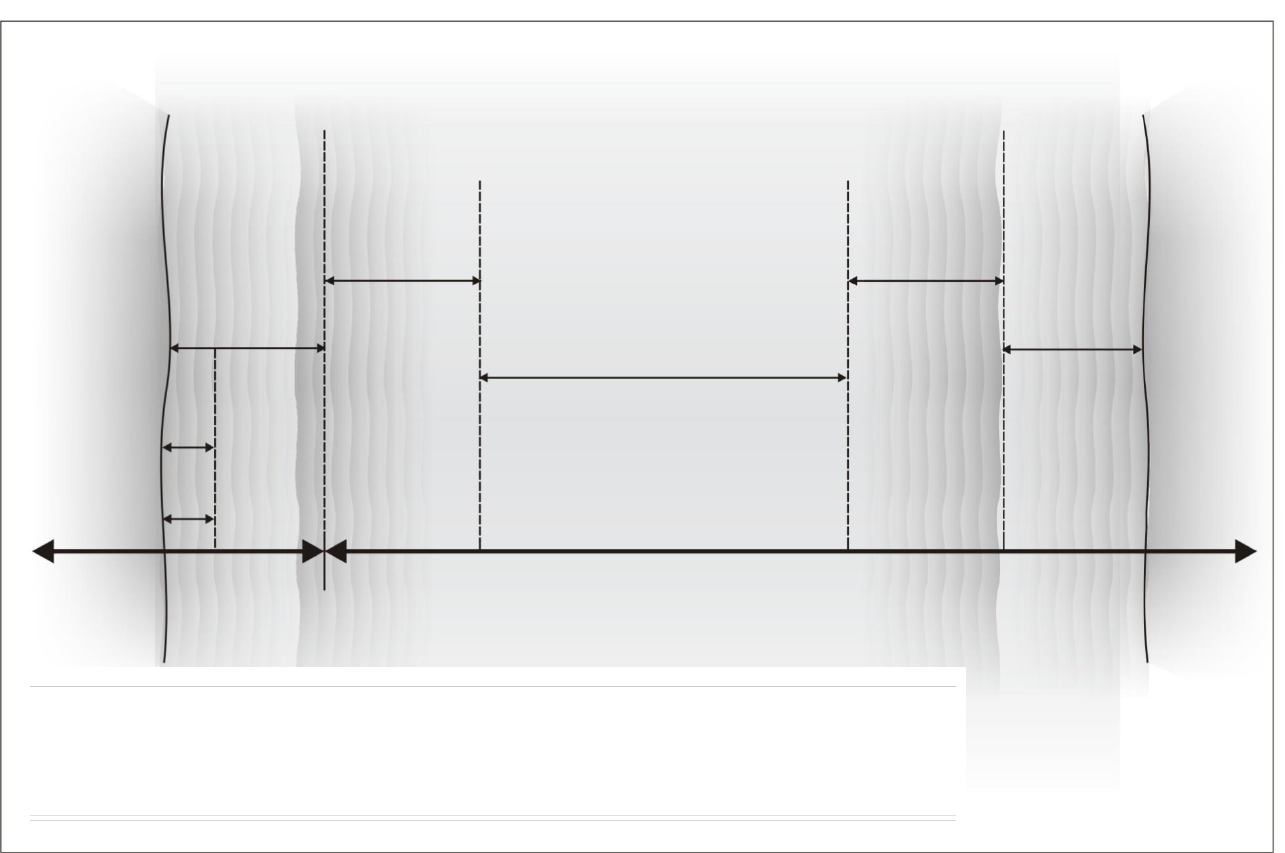
OPNAV-M 5090.1
25 Jun 2021
10-7
Figure 10-1. Generalized Geographic Applicability
NEPA
4,5
E.O. 12114
U.S. Territorial Sea
(0–12 NM)
U.S. Exclusive Economic
Zone (EEZ)
(12-200 NM
1
)
Global Commons
Limit of
Domestic
Law
(3 NM
3
)
Foreign Nation
EEZ (FEEZ)
(200-12 NM
1,2
)
Foreign Nation
Territorial Sea
(12-0 NM)
Foreign Nation Coastline
Foreign Nation Land Mass
U.S. Land Mass
U.S. Coastline
CZMA
NOT TO SCALE
1
This depiction is meant to provide general awareness of jurisdictional boundaries and is not intended to extend or otherwise alter existing
Federal or State law or any jurisdiction, rights, legal interests, or obligations derived therefrom.
2
EEZs as measured from the baseline per reference (g).
3
See reference (h) for claimed EEZ boundaries for foreign nations.
4
For Puerto Rico, Texas, and the Gulf Coast of Florida, waters subject to Commonwealth or State jurisdiction extend to 3 marine leagues
(approximately 9 NM).
5
Per judicial decision, NEPA (not E.O. 12114) applies in the Antarctica land mass.

OPNAV M-5090.1
25 Jun 2021
10-8
Table 10-1. Geographic Applicability
Statute/E.O.
Location of Effects
Within
3 (or
9) NM
of
U.S.
2
Within
U.S.
Territorial
Sea (12
NM off
coast)
Within
U.S.
EEZ
(12–
200
NM
off
coast)
Global
Commons
(High
Seas)
FEEZ
(200–
12
NM
off
coast)
3
Within
Foreign
Nation
Territorial
Sea (12–0
NM)
Landward
of Foreign
Nation
4
NEPA
1
X
X
E.O. 12114
X
X
X
X
X
ESA
1
X
X
X
X
MMPA
1
X
X
X
X
CZMA
5
X
X
MSFCMA
6
(Essential
Fish Habitat)
X
X
X
Act to
Prevent
Pollution
from Ships
X
X
X
X
X
X
Ocean
Dumping
Act
X
X
X
X
X
X
MPRSA
7
X
X
X
X
X
X
E.O. 13089
(Coral
Reefs)
X
X
X
1
The environmental planning provisions of NEPA apply within the 50 States, territories, and
possessions of the United States. As a matter of policy per reference (b), the Navy applies
NEPA to those Navy actions that affect the human environment within the 12-NM U.S.
territorial sea (0–12 NM) (reference (d)). Most environmental statutes apply seaward to the
pre-1988 limit of the U.S. territorial sea (0–3 NM). The MMPA and ESA represent two of the
most common statutes that apply to Navy activities outside the territorial sea (0–12 NM), but
are not the only statutes applicable to Navy activities outside the territorial sea.
2
For CZMA, generally, State seaward boundaries extend to 3 NM, with the exception of Texas,
the Gulf Coast of Florida, and the Commonwealth of Puerto Rico, where their seaward
boundaries are at 3 marine leagues, or approximately 9 NM.
3
Claimed EEZs of foreign nations are as set forth in reference (h).
4
For actions ashore, the requirements of chapter 34 (Overseas Environmental Compliance
Ashore) of this manual and applicable final governing standards (FGS) for the affected host
nation(s) apply. If FGSs have not been issued for the affected host foreign nation(s), Navy
shore activities must comply with the applicable status-of-forces agreement (SOFA) and
reference (i).

OPNAV M-5090.1
25 Jun 2021
10-9
5
Federal agency activities within or outside the State’s coastal zone that affect any land or water
use or natural resource of the coastal zone must be carried out in a manner that is consistent to
the maximum extent practicable with the enforceable policies of the approved State coastal
management program.
6
Councils may describe, identify, and protect habitats of managed species beyond the EEZ;
however, such habitat may not be considered EFH for the purposes of sections 303(a)(7) and
305(b) of the MSFCMA. The term “Council” means any Regional Fishery Management
Council established under section 302 of the MSFCMA.
7
MPRSA applicability is dependent on the type of activity (e.g., ocean dumping applies through
FEEZs; sanctuaries only apply through the U.S. EEZ).

OPNAV M-5090.1
25 Jun 2021
10-10
Table 10-2. Guidance for Choosing the Environmental Planning Process for Complying with
NEPA and E.O. 12114
Locations of
Effects
Environmental
Planning
Process
Applicable
Instruction/Guidance
Environmental
Planning
Document
1,2
Within U.S.
territory and 3
NM of U.S.
coast (State
waters)
NEPA
Reference (f)
Paragraphs 10-3.12 through
10-3.17 of this manual
Record of
categorical
exclusion
(CATEX)
Environmental
assessment (EA)
and finding of no
significant
impact (FONSI)
Environmental
impact statement
(EIS) and record
of decision
(ROD)
Within U.S.
territorial sea (0–
12 NM)
NEPA
Reference (f)
Paragraphs 10-3.12 through
10-3.17 of this manual
Record of
CATEX
EA and FONSI
EIS and ROD
Within U.S.
territorial sea and
U.S. EEZ (0–200
NM)
NEPA and E.O.
12114 may
apply
Reference (f)
32 Code of Federal
Regulations (CFR) Part 187
Paragraphs 10-3.12 through
10-3.28 of this manual
Record of
CATEX
EA and overseas
environmental
assessment
(OEA) and
FONSI and
finding of no
significant harm
(FONSH)
depending on
location of
effects
EIS and overseas
environmental
impact statement
(OEIS) and
ROD, depending
on location of
effects

OPNAV M-5090.1
25 Jun 2021
10-11
Locations of
Effects
Environmental
Planning
Process
Applicable
Instruction/Guidance
Environmental
Planning
Document
1,2
Within U.S. EEZ
(12–200 NM of
United States)
E.O. 12114
32 CFR Part 187
Paragraphs 10-3.18 through
10-3.27 of this manual
OEA and
FONSH
OEIS and
environmental
decision
document
Negative
decision
Within the global
commons (high
seas) or 200 NM
from any foreign
coastline
E.O. 12114
32 CFR Part 187
Paragraphs 10-3.18 through
10-3.27 of this manual
OEA and
FONSH
OEIS and
environmental
decision
document
Negative
decision
Within a FEEZ
(200–12 NM)
E.O. 12114
32 CFR Part 187
Paragraphs 10-3.18 through
10-3.27 of this manual
Environmental
review (ER)
Environmental
study (ES)
Negative decision
Within territorial
sea of a foreign
nation or
landward of the
coastline of a
foreign nation
(12–0 NM)
E.O. 12114
As required by SOFA or
other international
agreements or treaties or FGS
32 CFR Part 187
Paragraphs 10-3.18 through
10-3.27 and chapter 34
(Overseas Environmental
Compliance Ashore) of this
manual
As required by
SOFA or other
international
agreements or
treaties or FGS
ES
ER
Negative decision
1
A memorandum for the record (MFR) is prepared for actions relying on previously approved
Navy NEPA and E.O. 12114 environmental planning documentation and regulatory
consultations and coordination (refer to subparagraph 10-3.4f of this manual).
2
Acceptable combined documents are: EA/OEA; and EIS/OEIS. Unacceptable combinations
of documents are: OEA/ER or ES; OEIS/ER or ES; and OEA/NEPA record of CATEX.
b. General Requirements. The Navy is able to achieve its core mission at home, at sea, and
abroad more efficiently when environmental planning is properly integrated and sequenced into
Navy decision-making for those major Navy actions that may have significant environmental
impacts. It is important to note that the environmental planning process is intended to support
such activities as the strategic laydown process, homebasing, homeporting, and other Navy
processes to provide information to decision-makers, and it is not intended to be the final

OPNAV M-5090.1
25 Jun 2021
10-12
decision-making authority over proceeding with an action. To implement the NEPA and E.O.
12114 processes effectively and prepare quality and consistent environmental planning
documents, advanced planning and early coordination that engages all stakeholders, including
Navy environmental subject matter experts (SME), planners, and others, as appropriate, is
required. To this end, the Navy must:
(1) Conduct environmental planning and decision-making using a systematic,
interdisciplinary approach that integrates the natural and social sciences where there may be an
impact on the human environment under NEPA and the physical environment under E.O. 12114;
(2) Consider and evaluate a reasonable range of alternatives to proposed actions that
rigorously explores and sharply defines the issues, provides full disclosure of the potential
environmental consequences, and provides a clear basis for choice among options by the
decision maker and the public;
(3) Strive to achieve a balance between resource use and the Navy’s mission and seek to
site new construction, training, or testing in areas of least constraint to avoid or minimize the
potential for environmental impacts, risks to health and safety, or other consequences that are
undesirable and unintended; and
(4) Provide the opportunity for public involvement in the environmental planning
process, where applicable, including public meetings, public review and comment of
environmental planning documents, and access to project Web sites.
10-3.2. Limitations on Actions. Until environmental planning has been completed per the
provisions set forth in this chapter, no proposed Navy action may be undertaken that may have
an adverse environmental impact in the geographic area where NEPA applies, or significantly
harms the environment in the geographic area where E.O. 12114 applies, or results in an
irreversible or irretrievable commitment of resources that may prejudice the final selection of
any reasonable alternatives.
10-3.3. National Environmental Policy Act and Executive Order 12114 Signature Authority
a. Assistant Secretary of the Navy (ASN) (Research, Development, and Acquisition)
(ASN(RD&A)) and ASN (Energy, Installations, and Environment) (ASN(EI&E)) Have
Signature Authority Under NEPA and E.O. 12114
(1) ASN(RD&A) is the signature authority under NEPA and E.O. 12114 for actions
related to weapons systems acquisition programs and science-and-technology projects per
reference (a).
(2) ASN(EI&E) is the signature authority under NEPA and E.O. 12114 for all non-
weapons systems acquisition actions, such as training, shore installation management, and home
basing and homeporting of naval platforms. ASN(EI&E) must endorse actions related to
weapons systems acquisition programs and science-and-technology projects for ASN(RD&A)
signature per reference (a).

OPNAV M-5090.1
25 Jun 2021
10-13
(3) In addition, ASN(EI&E) has delegated its FONSI and FONSH signature authority to
the Office of the Chief of Naval Operations, Energy and Environmental Readiness Division
(OPNAV N45), as identified in reference (f), with authority to sub-delegate.
b. Sub-Delegation of FONSI and FONSH Signature Authority for Non-Weapons Systems
Acquisition NEPA and E.O. 12114 Environmental Planning Documents by OPNAV N45
(1) Delegation Eligibility. In appropriate circumstances, OPNAV N45 may delegate
FONSI and FONSH signature authority to eligible echelon 2 commands for non-weapons
systems acquisition program environmental planning documents. Commands may request
delegation by letter to OPNAV N45, provided these requirements have been (and will continue
to be) met:
(a) Qualified and dedicated environmental staff must be maintained at the command
level;
(b) Dedicated legal advisor with environmental law expertise must be maintained at
the command level; and
(c) Identification by the requesting command of one of the following as FONSI or
FONSH signer for non-weapons systems acquisition program environmental planning
documents: a designated flag officer or his or her designated deputy; a designated officer in the
grade of O-6 whose nomination for promotion to flag officer rank has been confirmed by the
Senate and who is serving in a flag officer billet and in command of a naval service unit or
activity; or, a vice commander at a systems command (SYSCOM).
(2) Delegations in Place. OPNAV N45 has delegated FONSI and FONSH signature
authority for non-weapons systems acquisition program environmental planning documents to:
(a) Commander, U.S. Fleet Forces Command (COMUSFLTFORCOM);
(b) Commander, U.S. Pacific Fleet (COMUSPACFLT);
(c) Commander, Navy Installations Command (CNIC), including eligible CNIC
region commanders;
(d) Commander, Naval Sea Systems Command (COMNAVSEASYSCOM); and
(e) Commander, Naval Air Systems Command (COMNAVAIRSYSCOM).
(3) Further Delegation of FONSI and FONSH Signature Authority. Commands that have
been delegated FONSI and FONSH authority may request to further delegate signature authority
by letter to OPNAV N45.
(4) Requirements for Maintaining Delegated FONSI and FONSH Signature Authority for
Non-Weapons Systems Acquisition Program Environmental Planning Documents. To retain
OPNAV M-5090.1
25 Jun 2021
10-14
delegated FONSI and FONSH signature authority for non-weapons systems acquisition program
environmental planning documents, each designated command must:
(a) Maintain qualified and dedicated legal and environmental staff within designated
command headquarters;
(b) Ensure OPNAV N45 is notified in writing via chain-of-command notification
letter or NEPA Notification to OPNAV EA Initiation Form (EA initiation form) before a scope
of work for an EA or OEA is finalized or funded with a government service provider (i.e., after
conducting appropriate pre-planning, refer to subparagraphs 10-3.15c and 10-3.25b of this
manual);
(c) Except as provided in subparagraph 10-3.4c of this manual, ensure no FONSI or
FONSH is signed before all consultation, coordination, and authorization processes have been
completed (reference (j));
(d) Prepare a memorandum of legal sufficiency (refer to paragraph 10-5.20 of this
manual) and complete form OPNAV 5090/3, Statement of Technical Review (refer to paragraph
10-5.33 of this manual), for every EA or OEA on which action is taken, including review,
approval, or endorsement. These memoranda must be retained in command files for a minimum
of 7 years and made available to OPNAV N45 upon request;
(e) Ensure all interactions with the headquarters staff of Federal agencies, including
the Environmental Protection Agency (EPA), National Marine Fisheries Service (NMFS), or
U.S. Fish and Wildlife Service (USFWS), are pre-coordinated with OPNAV N45;
(f) Coordinate with the area environmental coordinator (AEC) and regional
environmental coordinator (REC) and obtain an authorized representative’s signature on
OPNAV 5090/3 (refer to paragraph 10-5.33 of this manual) prior to public release and finalizing
an EA or OEA or signing a FONSI or FONSH when the proposed action would affect resources
under their cognizance (refer to chapter 1 (Organization and Coordination) of this manual for
AEC roles and REC responsibilities);
(g) Ensure all signed documents are uploaded to the OPNAV N45 Environmental
Planning and Compliance Library Web site (refer to appendix E (Web Sites) of this manual for
Web site address) no later than 30 working days after FONSI and FONSH signature (refer to
subparagraph 10-3.7c of this manual for requirements to upload environmental planning
documents to the OPNAV N45 Environmental Planning and Compliance Library Web site); and
(h) Submit an annual certification letter accompanied by an annual program review
summary to OPNAV N45 (refer to subparagraph 10-3.7f of this manual for more information) no
later than 45 working days following the end of the fiscal year (FY).

OPNAV M-5090.1
25 Jun 2021
10-15
c. Delegation of FONSI and FONSH Signature Authority for Acquisition Program NEPA
and E.O. 12114 Environmental Planning Documents
(1) Reference (a) delegates FONSI and FONSH signature authority for acquisition
program environmental planning documents to certain program executive officers (PEO),
SYSCOM commanders, and direct reporting program managers (DRPM). Such authority may
not be re-delegated. Prior to the signing of a FONSI or FONSH, the PEOs, SYSCOM
commanders, and DRPMs must obtain OPNAV N45 endorsement of the environmental planning
document (or the endorsement of OPNAV N45’s designated endorser, as applicable). OPNAV
N45 endorsement will require proof the action proponent has coordinated with the AEC and the
REC, as applicable.
(2) Reference (a), tables E6T1 and E6T2, footnote 3 grants endorsement authority to
OPNAV N45 for environmental planning documents prepared by the PEOs, SYSCOM
commanders, and DRPMs. Per reference (k), OPNAV N45 has delegated its endorsement
authority to COMNAVSEASYSCOM’s Maintenance, Modernization, Environment, and Safety
Department with respect to EAs, FONSIs, OEAs, and FONSHs prepared by
COMNAVSEASYSCOM-affiliated PEOs.
d. Delegated Authority. OPNAV N45 annually reviews selected environmental planning
documents prepared and signed by commands with delegated FONSI signature authority to
ensure conformance with statutory and regulatory guidance and this manual. OPNAV N45, at its
discretion, may assign audit responsibilities to commands with delegated FONSI or FONSH
signature authority to audit conformance within their command or sub-delegated command with
FONSI signature authority. If subsequent OPNAV N45 review of such assigned audits or if new
information demonstrates consistent or substantial nonconformance with the requirements of this
manual, delegation of FONSI or FONSH signature authority will be revoked.
10-3.4. General Guidance for Conducting Environmental Planning
a. Regulatory and Statutory Conclusions in Environmental Planning Documents
(1) All environmental planning documents must include appropriate and applicable
regulatory and statutory conclusions for NEPA and E.O. 12114 and applicable resource areas.
(2) All such resource-related regulatory and statutory conclusions must be supported by
appropriate analyses, and such analyses and conclusions must be specific to the statutory
requirement. Related, non-regulatory analyses should be addressed in separate subsections of an
environmental planning document. For example, the assessment of essential fish habitat (EFH)
should be specific to the discussion of potential adverse effects on defined EFH; other impacts to
fish species or fish assemblages should be addressed separately. Similarly, analyses of Federally
listed ESA species should be separate from discussions of State-listed species.
(3) Conclusions reached following the environmental analysis process should be phrased
such that the legal threshold, if any, pertinent to each particular environmental statute or
regulatory program is clearly identified.

OPNAV M-5090.1
25 Jun 2021
10-16
(4) Sample resource regulatory and statutory conclusions are available in the Document
Preparation Guide associated with the Environmental Planning Standards on the OPNAV N45
Environmental Planning and Compliance Library Web site. Sample impact or harm conclusions
specific to NEPA and E.O. 12114 environmental planning documents and related decision
documents are provided in table 10-3 of this manual.
Table 10-3. Sample “Impact” and “Harm” Conclusions for Environmental Planning and
Decision Documents
Document
Example Conclusion
Remarks
Record of
CATEX
“The proposed action is within the
scope of CATEX _____. No
extraordinary circumstances are present
in this case. Therefore, the proposed
action is excluded from the requirement
for further NEPA analysis.” Or “The
proposed action is within the scope of
CATEX _____. Although one or more
extraordinary circumstances are present
in this case, the proposed action’s
potential effects in terms of both context
and intensity are not considered
significant. Therefore, the proposed
action is excluded from the requirement
for further NEPA analysis.”
Case-by-case review of the facts of
the proposed action is required to
ensure that the proposed action is
covered by a listed CATEX, and that
either none of the extraordinary
circumstances are present or that one
or more extraordinary circumstances
apply, but the action proponent has
determined a CATEX is still
appropriate (refer to subparagraph
10-3.14d of this manual for more
information).
FONSI
“The proposed action will not
significantly affect the quality of the
human environment. Therefore, an EIS
will not be prepared.”
If the EA analysis shows there will
be a significant effect that cannot be
mitigated, then an EIS must be
prepared.
FONSH
“The proposed action will not
significantly harm the environment of
the global commons (high seas).”
If the OEA analysis shows there will
be significant harm that cannot be
mitigated, then an OEIS must be
prepared.
Negative
decision
“The proposed action does not have the
potential to cause significant harm to
the environment.”
If a major Navy action will not
result in significant harm to the
environment of a FEEZ, or a foreign
nation’s territorial sea, or territory
under E.O. 12114, a negative
decision is prepared.
NEPA EAs
“There would be no significant impact
on X resource.”
If there are significant adverse
impacts, then mitigation must be
identified or the proposed action
must be modified to incorporate
mitigation that will bring potential
impacts to below significance.
Otherwise, the action proponent
must prepare an EIS.

OPNAV M-5090.1
25 Jun 2021
10-17
Document
Example Conclusion
Remarks
E.O. 12114
OEAs
“There would be no significant harm on
X resource.”
If there would be significant harm to
a resource, then measures to
minimize or ameliorate the potential
harm must be identified or the
proposed action must be modified to
incorporate measures that will bring
impacts to below significant harm.
Otherwise, the action proponent
must prepare an OEIS.
b. NEPA and E.O. 12114 Analysis Involving Protected Species Impacts and INRMPs.
Action proponents should consult chapter 12 (Natural Resources Conservation) of this manual
for:
(1) Notification requirements when a proposed action triggers the need for a NEPA and
E.O. 12114 analysis and compliance under one or more other environmental protection statutes
(e.g., the ESA, MMPA, MBTA, MSFCMA (for impacts to EFH)) or other natural resources
compliance authority; and
(2) Specific NEPA compliance requirements for implementing INRMPs. This chapter
provides general NEPA guidance for preparing EAs and EISs.
c. Completion of Required Consultation, Coordination, and Authorization Processes
(1) Consultation, Coordination, and Authorization. Consultation, coordination, and
authorization processes under applicable environmental protection statutes (including, but not
limited to the ESA, MMPA, CZMA, MSFCMA, NMSA, and NHPA) must be completed before
a record of CATEX or a FONSI or FONSH may be signed or a final EIS (FEIS) or final OEIS
may be published (reference (j)). Prior to signature of a record of CATEX, consultations may be
required and compliance resolved to apply a CATEX when extraordinary circumstances are
present (paragraph 10-3.14 of this manual). The guidance in subparagraphs 10-3.4c(1)(a)
through 10-3.4c(1)(f) of this manual clarifies what constitutes completion of consultation,
coordination, and authorization processes:
(a) This requirement does not mean that every permit associated with the execution
of the proposed action is issued by the time a FONSI or FONSH is signed or an FEIS is
published. For example, while the CAA and CWA are identified on the list of statutes in
reference (j) that may have consultation, coordination, or authorization processes, this manual
recognizes that many of the specific permits issued under these two statutes are based on final
designs that likely will not be completed until after the signing of a FONSI, FONSH, or ROD, or
publication of the FEIS. Similarly, when an MMPA letter of authorization (LOA) is sought,
NMFS requires the Navy to release its FEIS and complete the 30-day wait period before it can
adopt the FEIS, sign its ROD, and conclude the ESA section 7 consultation process, and
thereafter issue an MMPA final rule.

OPNAV M-5090.1
25 Jun 2021
10-18
(b) In the context of the MMPA and ESA, when a proposed action requires an
MMPA authorization (incidental harassment authorization (IHA) or LOA) and ESA section 7
consultation, a FONSI or FONSH may be signed or an FEIS or final OEIS may be published no
earlier than the date on which the draft MMPA authorization or, if formal consultation is
required, the draft biological opinion (BO), have been received from the regulator for review
(i.e., before their final approval and signature), or after the section 7 consultation is completed by
receipt of a letter of concurrence. Publication of a notice of proposed IHA and request for
comments by NMFS in the Federal Register is not a draft IHA for the purposes of this manual.
All relevant requirements in the draft MMPA authorization and the draft BO or both must be
fully incorporated into the environmental planning analysis before a decision document (FONSI,
FONSH, or ROD) may be signed or the FEIS or final OEIS released to the public.
(c) In the context of the CAA and CWA, it is expected that initial coordination with
the regulatory agency will have occurred and any design or operating requirements or parameters
will have been identified and assessed as part of the NEPA or E.O. 12114 process. For example,
coordination with the U.S. Army Corps of Engineers regarding impacts to wetlands or other
waters of the United States should be completed, but an application for a dredge and fill permit
under section 404 of CWA may not be submitted until after a FONSI or ROD has been signed.
(d) Consultation under the NHPA should follow the guidance in paragraph 13-3.9 of
this manual.
(e) Regulatory agencies typically do not conduct consultations for all alternatives
being analyzed for a proposed action. Consultations or coordination, therefore, need not be
completed for every alternative assessed in an environmental planning document. It is
acceptable to complete consultation or coordination required by regulation only with respect to
the preferred alternative. A sufficient level of impact analysis, however, should be included in
the environmental planning document relative to all alternatives to ensure regulatory agencies
and the decision maker have information on the potential impacts and mitigation associated with
each alternative and that agency input can be presented in the environmental planning document
to allow a meaningful comparison of alternatives.
(f) As the timeline for completing consultation, coordination, and authorization
processes can be lengthy, it is critical that an action proponent develops a schedule that initiates
consultations and regulatory coordination early in the environmental planning process and
monitors progress to ensure these processes can be completed in a timely manner, per references
(q) through (ee).
(2) Justifications for Not Completing Required Consultation, Coordination, or
Authorization Processes Prior to Publication of an FEIS or a Final OEIS
(a) Per references (dd) and (ee), in situations where the required consultation,
coordination, or authorization processes cannot be completed in time to support the timely
publication of an FEIS or final OEIS, the action proponent must provide a detailed written
justification for moving forward to OPNAV N45 and ASN(EI&E). This justification, separate

OPNAV M-5090.1
25 Jun 2021
10-19
from any briefing materials and provided as part of the memorandum of legal sufficiency, should
include:
1. A summary of the current status of outstanding consultation, coordination, or
authorization processes;
2. Legal risk or impact to proposed action implementation timeline and budget if
publication is delayed until consultation processes are complete;
3. Reasons for the delay in completion of regulatory coordination;
4. Discussion of how the pending results of the consultations may impact the
determination of a preferred alternative;
5. Anticipated schedule for completing consultations; and
6. Anticipated outcomes of consultations, including mitigation requirements.
(b) Justification should be provided even when Federal and State agencies require the
completion of an EIS prior to finalizing consultation or authorization processes. The written
justification provides OPNAV N45 and ASN(EI&E) with an awareness of the issues, risks, and
implications of a decision to move forward with publication of the FEIS. FEIS publication will
occur only if the consultation, coordination, or authorization processes are completed as
documented in subparagraphs 10-3.4c(2)(a)1 through 10-3.4c(2)(a)6 of this manual, or if the
justification provided prior to publication of an FEIS is deemed acceptable by OPNAV N45 and
ASN(EI&E).
(c) For all EISs, the action proponent must provide OPNAV N45 with periodic status
reports (or briefs) regarding consultations and other authorizations. These reports must begin
with the preliminary draft EIS (DEIS) version (V.2) forwarded to OPNAV N45 for review (refer
to subparagraph 10-3.4d of this manual for discussion of document versions) and continue with
the submission of a status report for each subsequent version of a DEIS or FEIS, unless
otherwise directed by OPNAV N45. As appropriate, OPNAV N45 will keep ASN(EI&E)
informed of any problems, interagency disagreements, and other significant issues, along with
courses of action for resolution of identified issues.
(3) Justification for Not Completing Required Consultation, Coordination, or
Authorization Processes for an EA or OEA. Where there is an operational need to finalize an EA
or OEA and sign a FONSI or FONSH, but the required consultation, coordination, or
authorization processes are not complete, an action proponent will submit a written request to
OPNAV N45 to proceed. Such written request must include the items laid out in subparagraphs
10-3.4c(2)(a)1 through 10-3.4c(2)(a)6 of this manual. Written requests for proceeding without
completion of the required consultation, coordination, or authorization processes will be
considered on a case-by-case basis. OPNAV N45 will coordinate with ASN(EI&E) on each
request, and the action proponent may be required to brief senior leadership before action may be
taken on a FONSI or FONSH. These requirements also apply to the release of an FEIS.

OPNAV M-5090.1
25 Jun 2021
10-20
d. Management of Internal Navy Comments on Preliminary Draft Versions of EISs. Table
10-4 of this manual standardizes the nomenclature for review and release versions of a DEIS and
FEIS. Variations in this document review management scheme may occur after coordination
with OPNAV N45.
Table 10-4. Summary of EIS Version Nomenclature and Management
Version Identification
Explanation
Pre-draft DEIS or pre-
draft FEIS Version 1
(V.1)—team review
This first reviewable version of the EIS prepared by the action
proponent is typically reviewed internally by the action proponent
team, which should comprise the action proponent, its service
provider, and Navy echelon 2 or other stakeholders.
Pre-draft DEIS or pre-
draft FEIS Version 2
(V.2)—staff review
This second reviewable version of the EIS prepared by the action
proponent should be a complete analysis ready for headquarters
review. All issues raised during the review of V.1 should be fully
addressed. OPNAV N45, ASN(EI&E) staff, other concerned or
involved OPNAV N-codes, and cooperating agencies (if involved)
concurrently review the V.2 document for the time period
identified in exhibit C posted in the Reference Materials Library
module of the OPNAV N45 Environmental Planning and
Compliance Library Web site. Alternatively, OPNAV N45 and
the action proponent may mutually agree to another review time
period that accommodates the workload. Comments are returned
to the action proponent in a mutually acceptable method. A joint
tiger team meeting or conference call may be held to discuss the
comments.
Pre-release DEIS or
pre-release FEIS
Version 3 (V.3)—
critical error review
The action proponent incorporates Navy and cooperating agency
comments, as applicable, and prepares V.3 of the pre-release DEIS
or FEIS. V.3 is a redline-and-strikeout version of the document
that is transmitted digitally to OPNAV N45, ASN(EI&E), and any
cooperating agencies. V.3 must be accompanied by a comment
matrix explaining how each comment was responded to within the
document. V.3 is reviewed only for completeness and critical
errors. V.3 redline must be revised and resubmitted if
headquarters review identifies critical errors.
DEIS or FEIS public
release Version 4 (V.4)
V.4 is the version of the EIS ready for filing with EPA. V.4 is
transmitted to OPNAV N45 and is submitted, unless otherwise
agreed between the action proponent and OPNAV N45, with:
• Proper organizational endorsements or chain of command
endorsements;
• A statement of technical review (OPNAV 5090/3); and
• A memorandum of legal sufficiency.
V.4 is transmitted to OPNAV N45 digitally. There is limited
OPNAV N45 review of V.4.
Note: Distribution of each version is discussed in exhibit C available in the Reference
Materials Library module of the OPNAV N45 Environmental Planning and Compliance
Library Web site.

OPNAV M-5090.1
25 Jun 2021
10-21
e. Continuing Activities (Continuing Actions)
(1) The Council on Environmental Quality (CEQ) defines major Federal actions subject
to evaluation under reference (c) to include “continuing activities,” in addition to new projects or
programs (reference (c), section 1508.18, paragraph (a)). A continuing activity (action), which
may necessitate the preparation of an environmental planning document, is one that either:
(a) Began before January 1970 and that has continued substantially in the same
manner and environment; or
(b) Began after January 1970, for which the requisite environmental planning has
been completed, and that has continued in substantially the same manner and environment.
(2) An environmental planning document (new or supplemental) is required for a
continuing Navy action where:
(a) The currently occurring environmental effects have not been previously evaluated
in an environmental planning document and there is a discovery that substantial environmental
impacts are occurring, or are likely to occur, because of ongoing activities. Examples of
applicable situations include the discovery that significant beach erosion is occurring due to
continuing amphibious exercises; new wetland habitat has been designated; or the discovery that
an endangered species is inhabiting the area of the continuing activity;
(b) There is a discovery that either a major change in the nature of a continuing
activity or the circumstances surrounding that activity have resulted in environmental impacts
that are significantly or quantitatively different or more severe than previously predicted in an
existing environmental planning document prepared in connection with the commencement of
that activity;
(c) There has been a substantial change in a continuing activity (such as a substantial
change in operational tempo, area of use, or in technique or equipment) that has the potential for
significant environmental impacts; or
(d) The existing environmental planning document is outdated or inadequate (e.g., a
new methodology for assessing effects is developed; those data, which were the basis for the
analysis in the original document, become suspect) (refer to subparagraph 10-3.4f of this manual
for additional information when relying on previously approved environmental planning
documentation).
(3) If the action proponent decides not to prepare updated environmental planning
documentation for a continuing action because the situations described in subparagraphs 10-
3.4e(2)(a) through 10-3.4e(2)(d) of this manual are not triggered, the rationale for this decision
should be documented in an MFR and contain the information laid out in subparagraphs 10-
3.4f(2)(a) through 10-3.4f(2)(d) of this manual.

OPNAV M-5090.1
25 Jun 2021
10-22
f. Reliance on Previously Approved Navy Environmental Planning Documentation
(1) Validating the Previously Approved Documentation. When an action proponent
considers relying on previously approved Navy environmental planning documentation, the
action proponent must validate the analysis. As a general rule, when previously approved Navy
environmental planning documentation was prepared or approved 5 or more years prior to the
scheduled implementation of a proposed action, the action proponent should evaluate the
continued validity of the analysis for future decision-making or for incorporation by reference
into new environmental planning documents. Specifically, the action proponent should carefully
examine the description of existing conditions and the analytical methodologies used to assess
environmental impacts. The results of this examination must be justified in writing for the
administrative record (AR).
(2) Preparing an MFR when Relying on Previously Approved and Valid Navy
Environmental Planning Documentation. When an action proponent decides to rely on
previously prepared and valid Navy environmental documentation for coverage of a new
proposed action, an MFR must be prepared. The MFR need not be lengthy but at a minimum
should:
(a) Identify the environmental planning documents relied upon and confirm they
were reviewed to ensure they apply to the proposed action;
(b) Acknowledge coordination with the “owner” of the environmental planning
document;
(c) Delineate the mitigation required by permits and regulatory consultations and
authorizations applicable to the proposed action (the action proponent is required to comply with
mitigation and monitoring reporting and tracking as required in subparagraph 10-3.7e of this
manual); and
(d) Identify any other program-related considerations that are part of the proposed
action.
g. Comprehensive and Programmatic Environmental Planning Documents and Tiering
(1) Comprehensive Documents. A comprehensive environmental planning document
addresses a specific activity or facility that may be broad in nature and can occur at single or
multiple locations (e.g., training or testing activities). With comprehensive environmental
planning documents, there is no intent to phase the action or to prepare a future planning
document that tiers from the original environmental planning document.
(2) Programmatic Documents
(a) A programmatic or broad-scale environmental planning document is prepared to
address conceptual or planning alternatives that may include several phases or involve common
elements (e.g., groups of geographically or generically related projects or actions). The intent of

OPNAV M-5090.1
25 Jun 2021
10-23
a programmatic document is to provide “high-level” (i.e., broad-brush) analysis that requires at
least one more level of site-specific environmental planning analysis before an action proponent
can begin on-the-ground implementation (refer to table 10-5 and subparagraph 10-3.4g(3) of this
manual). The action proponent should avoid segmenting an action. Segmentation is when an
action is broken down into small parts to avoid the appearance of significance of the total action.
Table 10-5. Comparison of Programmatic and Comprehensive Environmental Planning
Documents
Parameter
Programmatic Documents
Site-Specific and Comprehensive
Study Area Documents
Tier
First Tier
First or Second Tier
Proposed action
Policy, strategy, or program
Specific activity or facility at single
or multiple locations
Alternatives
Typically, a set of policies or
scenarios, the specifics of which are
not yet known; range of alternatives
may have differing objectives.
Well-defined proposal with a known
location(s); range of alternatives
includes different ways to meet a
common objective.
Affected
environment
Broad geographic area or regional in
scope; may cross political boundaries
and cover numerous ecosystems.
Emphasis on individual project site
and immediate surroundings or
geographic study area. May involve
multiple locations with similar
ecosystems.
Impact focus
Emphasis on cumulative effects of
multiple activities.
Emphasis on direct and indirect
effects of a single activity or group
of related activities.
Mitigation
Emphasis on developing broad
environmental policies, programs, or
plans that would apply to many future
projects, the details and location of
which are not yet known.
Emphasis on minimizing impacts of
a proposed action.
(b) When deciding whether to prepare a programmatic environmental planning
document, the action proponent should consider such factors as the ripeness of the program,
policy, or action for discussion; and cost-effectiveness, long-term applicability, and complexity
of the proposed policy, program, or action. In addition to the content required by this manual for
other environmental planning documents, the programmatic document must provide, in as much
detail available at the time of preparation:
1. A description of the subsequent stages or sites that may ultimately be
proposed, including where and when deferred issues will be addressed;
2. The environmental impacts that will result from establishment of the overall
program itself that are similar for subsequent stages or sites as further implementation plans are
proposed; and

OPNAV M-5090.1
25 Jun 2021
10-24
3. The appropriate mitigation measures to be proposed for subsequent stages or
sites.
(3) Tiering. Tiering is appropriate when the action proponent prepares a site-specific
environmental planning analysis for a subsequent stage or phase of an action previously assessed
in a completed programmatic environmental planning document. This helps the action
proponent focus on those issues ripe for decision-making and exclude issues already decided or
not yet ripe for consideration. Each subsequently tiered analysis should:
(a) Summarize the program-wide issues discussed in the programmatic analysis,
incorporating by reference the analysis contained in the overarching programmatic document;
(b) Concentrate on the issues specific to the subsequent action; and
(c) State where the earlier document is available.
h. Revised Draft and Supplemental Environmental Planning Documents
(1) A revised draft or supplemental EA or EIS is prepared to amend an original
environmental planning document when the action proponent determines that:
(a) Substantial changes have been made to the proposed action that are beyond the
scope of the original environmental planning document (e.g., new or additional alternatives are
being considered);
(b) Significant new circumstances occur or information becomes available that could
affect the proposed action and its potential environmental impacts (e.g., baseline conditions have
changed; new analytical methodologies are available to assess potential environmental impacts);
or
(c) The Navy determines that doing so will further its interests or the purposes of
NEPA or E.O. 12114.
(2) The original environmental planning document should be incorporated by reference
into the supplemental document. Sufficient detail should be provided, however, to allow the
public to understand the substance of the new information and how the proposed action and its
potential environmental impacts may have changed since the public release of the original
environmental planning document.
(3) All supplemental environmental planning documents submitted for review and
approval by OPNAV N45 must be complete documents. Submission of changed pages with the
original document being supplemented as an attachment is not acceptable.
(4) Action proponents will prepare and circulate revised drafts or supplements as
required by this manual for environmental planning documents, including the publication of a
notice of intent (NOI) in case of an EIS.

OPNAV M-5090.1
25 Jun 2021
10-25
(5) Although scoping is not required for a supplement (or a revised draft environmental
planning document), the action proponent should consider these factors in making a
determination if scoping is appropriate: the reason for the revised draft or supplement; the
magnitude of the environmental effects and the need for mitigation; and whether there is a
potential for public controversy.
i. AR. The development of an AR begins when the environmental planning process is
initiated by the action proponent’s command. The AR consists of all papers, documents,
memoranda, studies, other bibliographic references, and electronic files used by the Navy to
reach a decision on whether or not to go forward with a particular proposed action. All
documents and materials relevant to the Navy’s decision-making process must be included in the
AR. The AR can include all documents and materials prepared, provided, reviewed, or received
by Navy personnel, and used by or available to the decision maker, even though the decision
maker may not actually have reviewed or known about those documents and materials.
(1) General Guidelines on Documents to be Included in the AR. The term “document”
has a very broad definition. It includes not only paper documents but also e-mail messages,
digital files, microfilm and microfiche, maps, graphics, raw data, video, audio recordings, and
any other format used to communicate, store, present, or maintain information. The term
“document” even includes electronic messages and data that have been stored but not printed.
Source documents identified in an environmental planning document, including paper or digital
copies of cited Internet Web sites, must be included in the AR.
(2) Responsibilities for Maintaining the AR. The action proponent must designate the
person responsible for maintaining the AR and develop a plan for what will be included in the
AR at the outset of the environmental planning process. All environmental planning team
members should be provided a copy of the plan. The AR should be kept up-to-date throughout
the development of the environmental planning document. The AR needs to be maintained by
the government for 7 years post-ROD or -FONSI or -FONSH. In addition, a litigation hold may
be a possibility, and it is in the best interest of the action proponent to hold documents in case of
such an event.
j. Incorporation by Reference. To the extent practicable, action proponents preparing
environmental planning analyses must incorporate material by reference to cut down on bulk
without impeding agency and public review of the action. Action proponents must cite the
incorporated material in the statement and briefly describe its content. Action proponents must
not incorporate any material by reference unless it is reasonably available for inspection by
potentially interested persons within the time allowed for comment. In addition, action
proponents must not incorporate by reference any material based on proprietary data.
k. Incomplete or Unavailable Information. When the action proponent is evaluating
significant adverse effects on the human environment in an environmental planning document
and there is incomplete or unavailable information, the action proponent must always make clear
that such information is lacking. CEQ provides more detailed guidance in reference (c), section
1502.22.

OPNAV M-5090.1
25 Jun 2021
10-26
(1) If the incomplete information relevant to reasonably foreseeable significant adverse
impacts is essential to a reasoned choice among alternatives and the overall costs of obtaining it
are not exorbitant in terms of funding or time, the action proponent must include the information
in the environmental planning document; and
(2) If the information relevant to reasonably foreseeable significant adverse impacts
cannot be obtained because the overall costs of obtaining it are exorbitant or the means to obtain
it are not known (i.e., the means for obtaining it are beyond the state-of-the-art), the action
proponent must provide a statement explaining the circumstances within the environmental
planning document.
l. Classified Actions
(1) Some aspects of a proposed action may involve information not releasable to the
public because it is classified within the definition found in reference (l) or sensitive for some
other legal reason (e.g., regulatory agency restrictions on the release of certain information to the
public, such as the exact location of specific resources protected under the ESA or the NHPA).
This does not relieve the action proponent of the duty to comply with the requirements of this
chapter. Personnel and commands preparing material that may be classified are responsible for
the proper handling, control, and safeguarding of all information and analyses that may be
classified per appropriate Department of Defense (DoD) and Navy requirements.
(2) The action proponent must prepare, safeguard, and disseminate environmental
planning documents per the requirements applicable to classified or sensitive unclassified
information. When the components of the environmental planning document have been
thoroughly scrubbed so that each component contains only unclassified information, the action
proponent must continue to be sensitive to the potential for the final assemblage of that
information to be considered classified. The requirement to safeguard classified information
takes precedence over any requirement to disclose records to the public.
(3) When feasible, the action proponent should organize the environmental planning
document in such a manner to include the classified or sensitive unclassified portions as
appendices. In this way, the action proponent can make unclassified portions available to the
public. If classified information will be included in an environmental planning document, in an
appendix or otherwise, the action proponent must coordinate special handling procedures with
OPNAV N45.
m. Timelines for Environmental Planning Documents. Beginning in FY 2020, all EA,
EA/OEA, and OEA documents must be completed in 1 year or less measured from the EA
kickoff meeting date to the signature date of a FONSI, FONSI/FONSH, or FONSH, or to the
determination date that an EIS, EIS/OEIS, or OEIS should be prepared. All EIS, EIS/OEIS, and
OEIS documents, except for at-sea documents (per reference (b)), must be completed in 2 years
or less from the NOI publication date in the Federal Register to the signature date of the ROD,
per references (s), (t), (dd), and (ee).

OPNAV M-5090.1
25 Jun 2021
10-27
(1) If an action proponent believes they cannot achieve these timeline goals, they may
request a waiver prior to initiating the NEPA effort. OPNAV N45 may grant waivers for EA,
EA/OEA, and OEA documents, whereas the Deputy Assistant Secretary of the Navy
(Environment) (DASN(E)) may grant waivers for EIS, EIS/OEIS, and OEIS documents, per
references (s), (dd), and (ee). For EA, EA/OEA, and OEA document waiver requests, the action
proponent must provide a written waiver request with the submittal of the notification letter or
within the EA initiation form via upload to the OPNAV N45 Environmental Planning and
Compliance Web site. For EIS, EIS/OEIS, and OEIS document waiver requests, in advance of
submitting the NOI package, the action proponent must submit the written waiver request
through the chain of command to the DASN(E), and the action proponent must upload the
waiver request letter and, if granted, the waiver letter to the OPNAV N45 Environmental
Planning and Compliance Web site. Waiver requests will be the exception and must provide a
written justification as to why the timeline is not attainable, recommendations to avoid such
delays in the future, and a projected timeline that is streamlined to the extent possible, per
references (dd) and (ee).
(2) In situations where a waiver was not requested for an EA, EA/OEA, or OEA
document during the notification stage but the action proponent determines later that the 1 year
or less timeline cannot be met due to unexpected delays, the action proponent must submit a
notification of delay letter to OPNAV N45 via the OPNAV N45 Environmental Planning and
Compliance Web site as soon as possible after the decision is made and before a FONSI is
signed, and provide the reason(s) for the delay and why the timeline cannot be met,
recommendations to avoid such delays in the future, and a projected timeline streamlined to the
extent possible (reference (dd)).
(3) In situations where a waiver was not requested at the start of an EIS, EIS/OEIS, or
OEIS document but the action proponent determines later that the 2 years or less timeline cannot
be met, the action proponent must notify the DASN(E), through the chain of command, as soon
as the delay has been identified. The notification must include the reasons why the timeline
cannot be met and recommendations to avoid such delays in the future (reference (dd)). In
addition to the overarching principles for NEPA streamlining highlighted in reference (dd),
action proponents should take these actions to help meet the timelines: pre-plan; engage
stakeholders early in the process; adhere to Navy NEPA templates and standards; seek chain-of-
command reviews as soon as possible; develop a clear proposed action, purpose, need, and range
of alternatives; and focus the analysis to align with the specific impacts of the proposed action.
10-3.5. Lead Agency, Cooperating Agency, and Other External and Internal Coordination
Requirements
a. Lead Agency. Navy stakeholders in the proposed action are responsible for determining
the lead agency for supervising the preparation of an environmental planning document using the
definition of action proponent in this manual and guidance found in reference (c), section 1501.5.

OPNAV M-5090.1
25 Jun 2021
10-28
b. Cooperating Agencies
(1) Identifying Cooperating Agencies. Cooperating agencies should be identified early in
the environmental planning process for all levels of environmental planning documentation.
Consideration must be given to Federal agencies that have jurisdiction by law and special
expertise with respect to all reasonable alternatives or significant environmental, social, or
economic impacts associated with the proposed action that requires environmental planning
analyses. Should a need be identified to partner with a State, local, or tribal government through
a cooperative agreement, the action proponent will coordinate with OPNAV N45 on the best way
to accommodate the legal requirements of the Navy and other parties. This may necessitate
additional coordination because of the unique legal requirements of State, local, and tribal
governments. The Federal Aviation Administration (FAA) is always invited to be a cooperating
agency when a proposed action involves the establishment, designation, or modification of
special use airspace, or use of commercial airports.
(2) Invitations to Cooperating Agencies
(a) OPNAV N45 will be responsible for inviting and coordinating with cooperating
agencies at the national level (headquarters). Such invitations and coordination must be
conducted, as required, with the Navy Secretariat. The action proponent will be responsible for
inviting and coordinating with cooperating agencies at the regional or district level, including
State, local, and tribal governments. Establishing a cooperating agency relationship neither
creates a requirement nor constitutes a presumption that a lead agency provides financial
assistance to a cooperating agency. When extending an invitation to another agency to enter into
a cooperating agency relationship, the action proponent should consider:
1. Whether such agencies are interested in and appear capable of assuming the
responsibilities of becoming a cooperating agency;
2. Setting time limits, identifying milestones, assigning responsibilities for
analysis and documentation, specifying the scope and detail of the cooperating agency’s
contribution, and establishing other appropriate ground rules addressing issues such as
availability of pre-decisional information; and
3. Documenting their expectations, roles, and responsibilities in a memorandum
of agreement (MOA) or correspondence.
(b) Whenever invited Federal, State, or local governments and agencies elect not to
become cooperating agencies, they should still be considered for inclusion in interdisciplinary
teams engaged in the environmental planning process and on distribution lists for review and
comment on environmental planning documents.
(3) Declining a Cooperating Agency Invitation. Other agencies may periodically request
that Navy be a cooperating agency for preparation of their environmental planning documents.
Navy commands or activities that do not accept cooperating agency status in whole or in part for
a proposed action must respond to the request in writing.

OPNAV M-5090.1
25 Jun 2021
10-29
(4) Adoption of an EA or EIS
(a) Sufficiency of Navy Environmental Planning Documents to Meet Other
Agencies’ NEPA Adoption Requirements. For actions where Navy environmental planning may
be adopted for the purpose of another Federal agency’s compliance with NEPA (e.g., for agency
permit issuance), Navy commands must identify this need, to the extent those requirements are
known, as part of the notification process and prior to any interagency coordination. Note:
Specific additional analyses may be required for the Navy environmental document to suffice in
meeting another agency’s NEPA requirements.
(b) Adoption of Another Agency’s EA or EIS
1. The Navy may adopt an EA or EIS prepared by another Federal agency where
a cooperating agency relationship has been established, and where the Navy’s proposed action is
substantially the same as that described in the EA or EIS. In such cases, the Navy action
proponent will independently review the EA or EIS and determine that it is current and satisfies
the requirements of this chapter. The Navy will then prepare its own FONSI or ROD, as
appropriate, and conduct the required public notification.
2. In situations where the proposed action is not substantially the same as that
described in the EIS or a cooperating agency relationship has not been established, a Navy action
proponent may adopt the EIS, or a portion thereof, after recirculating the EIS, as appropriate, as a
draft and then preparing the FEIS and ROD.
3. Where a cooperating agency relationship has not been established for an EA,
and the Navy’s proposed action is substantially the same as that described in the other agency’s
EA, the Navy action proponent will independently review the EA to determine it is current and
satisfies the requirements of this chapter. If so, the action proponent will process the adopted EA
and a FONSI as identified in this chapter.
4. A Navy action proponent may not adopt an environmental planning document
prepared by a State agency unless the Navy has participated in the preparation of the document
(analysis and documentation) to ensure it satisfies the requirements of NEPA.
(5) Cooperating Agency Status for Annual Program Review Summary. An echelon 2
command with delegated FONSI signature authority will input cooperating agency status as part
of its annual program review summary submittal to the OPNAV N45 Environmental Planning
and Compliance Library Web site.
c. Joint Basing Relationships. Refer to chapter 1 (Organization and Coordination),
subparagraph 1-3.2e of this manual for roles and responsibilities in meeting environmental
planning requirements for joint basing and host and tenant relationships.
d. Coordination with Director, Naval Nuclear Propulsion Program (CNO N00N). Under
reference (m), statutorily prescribed by Public Law 98-525, section 2511 of Title 50, U.S. Code,
CNO N00N is responsible for prescribing and enforcing environmental standards and regulations

OPNAV M-5090.1
25 Jun 2021
10-30
for the control of radiation and radioactivity associated with naval nuclear propulsion activities,
including the safety and health of workers, operators, and the general public. Accordingly, the
director or designee, in coordination with OPNAV N45 or the designee, is responsible for
applying CATEXs and approving records of CATEX and for developing, approving, and issuing
EAs and FONSIs for actions within the purview of CNO N00N, including obtaining the
concurrence of other affected Navy commands as appropriate. CNO N00N must coordinate with
OPNAV N45 in any decision to prepare an EIS. As appropriate, ASN(EI&E) or ASN(RD&A) is
the signature authority on any ROD.
e. Coordination with the Department of State (DOS) Under E.O. 12114. The Secretary of
State conducts U.S. foreign policy. When a proposed major Navy action may significantly harm
the environment of a foreign territorial sea or the territory of a foreign nation, coordination with
DOS may be required. OPNAV N45, per reference (f), will assist the Navy Secretariat in
executing any necessary coordination with DOS.
f. Coordination with AEC or REC. If a proposed action assessed in an environmental
planning document, including CATEXs with extraordinary circumstances present (paragraph 10-
3.14 of this manual), will occur in the area of responsibility (AOR) of an AEC or REC, the
action proponent must obtain written acknowledgement (an e-mail is sufficient or signature on a
statement of technical sufficiency) from the AEC and the REC concerning the consistency of
each proposed action with other actions occurring within their AOR, including the alternatives
considered and mitigation. For example, for shore installation management actions involving in-
water activities within the continental United States (CONUS), including pile driving, the action
proponent must coordinate with and obtain the signature of COMUSFLTFORCOM, the AEC,
and the REC.
10-3.6. Mitigation Identification and Implementation
a. To the extent feasible, action proponents will incorporate impact avoidance measures into
project planning to minimize or eliminate the need for mitigation measures (e.g., plan a road
around wetlands rather than through wetlands) (see notification requirements in tables 10-8 and
10-12 of this manual).
b. As required by reference (n), the action proponent will include a mitigation matrix or table
in all environmental planning documents. Alternatively, the action proponent may document
mitigation measures in a separate mitigation chapter. This matrix or mitigation chapter must
provide:
(1) Specific detailed description of the mitigation measure(s), including any
compensatory mitigation;
(2) Description of the anticipated benefit of the mitigation. Environmental planning
documents must identify those measures that result from regulatory compliance requirements
such as ESA consultation or MMPA permitting. The anticipated benefit of any identified
regulatory mitigation measure must be discussed in environmental planning documents;

OPNAV M-5090.1
25 Jun 2021
10-31
(3) Factors used in evaluating the efficacy of mitigation applied to avoid significance or
reduce the severity or intensity of the adverse impacts of an action;
(4) Description of how the mitigation measures would be implemented and monitored;
and
(5) Assignment of command responsibility for implementing mitigation measures and
determining their effectiveness (i.e., through monitoring).
c. An action proponent is legally responsible for implementing all mitigation measures to
which it has committed as part of its decision-making (e.g., in a FONSI, FONSH, or ROD)
whether undertaken for environmental planning purposes or to satisfy a regulatory requirement.
Refer to subparagraph 10-3.7e of this manual for information on reporting and tracking of
mitigation measures and monitoring requirements.
10-3.7. OPNAV N45 Environmental Planning and Compliance Library and Reporting
Requirements
a. OPNAV N45 Environmental Planning and Compliance Library: General
(1) The OPNAV N45 Environmental Planning and Compliance Library Web site (refer
to appendix E (Web Sites) of this manual for Web site address) is an online, searchable
electronic repository of completed and ongoing Navy environmental planning documents
covering actions undertaken worldwide. The library also serves as a tool for tracking the
completion of environmental planning documents, as well as the submission of required annual
environmental planning reports and program review submittal to the Navy Secretariat and other
authority.
(2) In addition, the library is maintained as a centralized policy resource for Navy
environmental planners and includes related statutes, regulations, DoD and Navy policy, and
other guidance documents. Specific policy adopted by OPNAV N45 may be accessed within the
library for processing environmental planning documents (i.e., processing timelines for EAs and
EISs), preparing environmental planning documents (i.e., environmental planning standards
preparation guide and associated document templates), reviewing Navy environmental planning
documents (e.g., the environmental planning checklist), and other aids to Navy environmental
planners.
b. Access to the OPNAV N45 Environmental Planning and Compliance Library Web Site.
The OPNAV N45 Environmental Planning and Compliance Library Web site is accessible to
individuals who have a DoD Common Access Card (CAC). An individual with a navy.mil e-
mail address may establish an account by registering his or her CAC with the Web site. OPNAV
N45 will approve such registrations as soon as possible. Contractors with a DoD CAC who have
a demonstrated need to obtain access to the Web site but do not have a navy.mil e-mail address
must request temporary access through a Navy sponsor before attempting to register their CAC
with the Web site. The Navy sponsor may submit such requests to OPNAV N45 by selecting the
“Contact Us” link found on the bottom margin of the Web site home page. The request should

OPNAV M-5090.1
25 Jun 2021
10-32
identify the non-Navy individual (including e-mail address) who requires access to the library,
the reasons for needing access, and the period during which access may be approved. OPNAV
N45 will approve valid requests for access. Existing registered Web site users may request
additional access permissions (e.g., upload permission) by request via the “Contact Us” link.
c. Requirement to Upload Environmental Planning Documents to the OPNAV N45
Environmental Planning and Compliance Library Web Site
(1) Action proponents must timely upload to the OPNAV N45 Environmental Planning
and Compliance Library Web site:
(a) Notifications to prepare an EA, OEA, ER, ES, or NOI package for an EIS, OEIS,
or hybrid document, with proper endorsements and potential waiver requests, as soon as the
notification is approved by the chain of command (per subparagraph 10-3.4m of this manual);
(b) Environmental planning and associated compliance documents not later than 30
working days after a decision document (e.g., FONSI, FONSH, ROD) is signed or a notice of
availability (NOA) is published for an EIS in the Federal Register. The types of documents that
must be uploaded include:
1. Approved EAs, OEAs, ERs, ESs, EISs, OEISs, or hybrid document (draft and
final);
2. Signed decision documents (e.g., FONSI, FONSH, ROD);
3. Related completed environmental compliance documents such as:
a. ESA biological assessments or evaluations (with transmittal letters) and
BOs;
b. MMPA permit applications (with transmittal letters), rules, and LOAs and
incidental take authorizations;
c. EFH assessments and consultation letters;
d. CZMA consistency and negative determinations; and
e. NMSA sanctuary resource statements;
4. Records of CATEX that rely on CATEX #43 or #44, and records of CATEX
that apply one or more extraordinary circumstances per paragraph 10-3.14 of this manual; and
5. Records of CATEX for Navy actions where a Programmatic Agreement (PA)
or MOA has been signed with a State Historic Preservation Officer to mitigate an adverse effect
on resource historic property (the PA and MOA must be uploaded with the signed record of
CATEX).

OPNAV M-5090.1
25 Jun 2021
10-33
(2) Uploaded documents must be in the latest Navy-Marine-Corps-Intranet-approved
version of Adobe Acrobat. In preparing the document for upload, action proponents must ensure
the document is saved such that text may be copied and images captured for inserting into a
word-processing document and that the file has been optimized to shrink its size and boost
display speed. Do not upload password-protected files.
(3) Do not upload preliminary draft documents, or memoranda of legal sufficiency or
statements of technical review (OPNAV 5090/3) (refer to paragraph 10-5.33 of this manual).
Only published DEISs and FEISs are to be uploaded to the OPNAV N45 Environmental
Planning and Compliance Library Web site.
(4) Commands wishing to obtain electronic copies of OPNAV N45 Environmental
Planning and Compliance Library Web site documents in a word-processing format such as
Microsoft Word should contact the action proponent that prepared the document.
d. Contacting OPNAV N45 via E-Mail. Do not e-mail environmental planning documents
to the OPNAV N45 action officers. The use of an e-mail address is not appropriate for the
transmission of large environmental planning documents. Draft documents for review by
OPNAV N45 must be transmitted electronically using an Internet file transfer protocol Web site,
such as the Environmental Information Management System (see appendix E (Web Sites) of this
manual for Web site address). Routine project-specific correspondence should always be sent to
the e-mail address of the assigned OPNAV N45 action officer. Copies of final documents should
be uploaded to the OPNAV N45 Environmental Planning and Compliance Library Web site.
e. Mitigation and Monitoring Reporting and Tracking. “Mitigation” reduces or avoids
potentially significant adverse effects of an action on the environment. “Monitoring” provides
information on the effects of the action on the environment and the effectiveness of the
mitigation measures themselves. Best management practices (BMP) or standard operating
procedures (SOP) are not considered mitigation measures for the purposes of reporting and
tracking. Results from mitigation and monitoring reporting must be used to support negotiations
with the regulatory agencies to ensure only effective mitigation measures are employed, assist in
adaptive management efforts, and track completion of mitigation measures that the action
proponent has committed to implement in an environmental planning decision document.
(1) Inputting Mitigation and Monitoring Requirements to the OPNAV N45
Environmental Planning and Compliance Library Web Site
(a) Action proponents must input mitigation and monitoring requirements committed
to in approved environmental planning decision documents into the OPNAV N45 Environmental
Planning and Compliance Library Web site (the mitigation and monitoring tracking tool is found
in the library’s Required Reporting module) as soon as possible after completion of the proposed
action (but in any case, no later than 30 working days after the signing of the applicable decision
document).
(b) Mitigation and monitoring data that will be inputted to the Web site are discussed
in detail in reference (n). All mitigation committed to within the applicable environmental

OPNAV M-5090.1
25 Jun 2021
10-34
planning decision document that reduces potential adverse environmental impacts below the
level of significance must be reported until the project has been completed. As mentioned
previously, BMPs or SOPs need not be tracked.
(2) Actions Spanning a Period of Years. For implementation of those actions that span a
period of years, the action proponent must, at a minimum, annually review and revise the
mitigation and monitoring data submitted to the Required Reporting module of the OPNAV N45
Environmental Planning and Compliance Library Web site. This review and revision
requirement may be discontinued upon completion of all mitigation measures committed to in a
FONSI or ROD.
(3) When Mitigation and Monitoring Reports are Prepared and Submitted to Regulators.
Some actions proposed in an environmental planning decision document or associated permits
require the preparation and submission of annual monitoring and exercise or test event reports to
regulators in compliance with consultations and permits (e.g., operational range EISs). To avoid
duplication, such annual monitoring and exercise or test event reports may be substituted for the
mitigation and monitoring reporting required in this subparagraph provided the action proponent
inputs the financial costs of implementing each mitigation or monitoring requirement to the
OPNAV N45 Environmental Planning and Compliance Library Web site. All annual monitoring
and exercise or test event reports submitted to regulators should also be uploaded to the Web site
(refer to subparagraph 10-3.7c of this manual).
f. Annual Certification Requirement and Annual Program Review Summary
(1) Annual Certification Requirement. No later than 45 working days following the end
of each FY, flag officers or civilian equivalents exercising NEPA or E.O. 12114 decision
authority delegated under this manual and PEOs (flag officers or senior executive service)
exercising NEPA or E.O. 12114 authority delegated under reference (a) must certify by letter
sent by official mail to OPNAV N45 (and uploaded to the OPNAV N45 Environmental Planning
and Compliance Library Web site) that all notifications, final environmental planning
documents, and reporting as required for the previous FY under subparagraphs 10-3.7c and 10-
3.7e of this manual have been uploaded and reported as required in a timely manner to the
OPNAV N45 Environmental Planning and Compliance Library Web site and that all mitigation
measures identified in decision documents have been and will be implemented. The annual
certification must also identify the members of their qualified legal and environmental staff.
Substantial nonconformance with the requirement to submit the annual certification by upload to
the OPNAV N45 Environmental Planning and Compliance Library Web site (accompanying the
annual program review summary) will result in revocation of delegated NEPA or E.O. 12114
decision authority.
(2) Annual Program Review Summary. No later than 45 working days following the end
of each FY, each command with delegated FONSI signature authority must input its annual
program review summary to the OPNAV N45 Environmental Planning and Compliance Library
Web site (Required Reporting module). Commands must submit cost data for each
environmental planning document as specified on the Web site.

OPNAV M-5090.1
25 Jun 2021
10-35
10-3.8. Pre-Planning Process Requirement. Action proponents will conduct pre-planning as
early as possible with their environmental planners and SMEs in project development to ensure
environmental considerations are fully integrated into project design and the identification of
preliminary alternatives (see subparagraphs 10-3.15a(2), 10-3.15c, and 10-3.16b of this manual
for the pre-planning requirements for an EA and an EIS, respectively). Early and comprehensive
pre-planning will support the action proponent in meeting the requirements and timelines
identified in references (q), (s), (t), (dd), and (ee).
10-3.9. Action Proponent Responsibility to Produce Quality Documents. Navy action
proponents will ensure environmental planning documents are prepared consistent with the
requirements of this chapter and are legally defensible if challenged.
a. Action proponents will conform to document preparation guidance and templates as
prescribed by OPNAV N45. These tools are available for download on the OPNAV N45
Environmental Planning and Compliance Library Web site.
b. OPNAV N45 recommends development and implementation of a quality assurance (QA)
plan in the form of an SOP that focuses attention on the need for quality documents and
delineates the action proponent reviews that will be undertaken to ensure quality.
c. It is also recommended that action proponents develop a diverse internal stakeholder team
to support the technical development and review of a quality document.
d. Echelon 2 commands are responsible for ensuring documents submitted to OPNAV N45
and the Navy Secretariat have been properly reviewed for quality (an environmental planning
checklist is available on the OPNAV N45 Environmental Planning and Compliance Library Web
site). Quality Navy environmental planning documents must be:
(1) Comprehensive and Logical. The analyses must consider all relevant data, and the
conclusions must clearly be supported by appropriate data;
(2) Consistent Across the Navy. The discussions of purpose and need, proposed action,
and environmental setting; and the analysis of environmental consequences, mitigation measures,
and cumulative impacts must be internally consistent, to the extent practicable, with other
environmental planning documents prepared by the same command and by other Navy
commands. The OPNAV N45 Environmental Planning and Compliance Library Web site
should be consulted to see how similar issues have been treated in recently completed
environmental planning documents;
(3) Legally Sufficient. The scope of issues and alternatives considered and the adequacy
of the technical analysis must be sufficient to meet legal standards established in NEPA, E.O.
12114, the Administrative Procedures Act, and other applicable statutes;
(4) Technically Sufficient. Each environmental planning document must be based on the
best available scientific information and data. The evaluation of all potentially affected areas of
the environment and the analyses must be prepared by SMEs knowledgeable about the resource

OPNAV M-5090.1
25 Jun 2021
10-36
at issue. Furthermore, the analyses must be objective and unbiased, take a “hard look” at the
issues, and anticipate and respond to potentially opposing views; and
(5) Understandable. An environmental planning document should be written so a
member of the general public, who has no advanced education or knowledge of the Navy, can
easily understand the purpose and need for the project, how each alternative would meet the
project’s goals, and the strengths and weaknesses associated with each alternative. Each
document must be kept as brief as possible, using clear, concise writing, an easy-to-use format,
effective graphics and visual elements, and discussion of issues and impacts in proportion to
their significance as is directed in the document preparation guides and templates as prescribed
by OPNAV N45 and available for download on the OPNAV N45 Environmental Planning and
Compliance Library Web site.
10-3.10. Training Requirements
a. The Navy’s goal is to implement efficient and effective training that provides the right
training to the right people at the right time in support of the Navy’s mission. The Navy
Environmental Readiness Training Program (NERTP) supports this goal by identifying and
resourcing the development and delivery of quality environmental readiness training courses. In
addition to NERTP-sponsored courses, other specialty schools may also resource, develop, and
deliver environmental courses to meet specific requirements. All personnel (i.e., civilian, active-
duty military, and reserve military) must receive training as applicable to their specific job
assignments and levels of responsibility. NERTP course descriptions, target audiences, and
schedules are available on the Civil Engineer Corps Officer School (CECOS) and Naval Safety
and Environmental Training Center (NAVSAFENVTRACEN) Web sites (refer to appendix E
(Web Sites) of this manual for Web site addresses). Refer to chapter 3 (Environmental
Readiness Training) of this manual for information on general overall and billet-specific
environmental readiness training requirements as well as training requirements for personnel
who have collateral environmental responsibilities. Chapter 3 (Environmental Readiness
Training), table 3-1 of this manual provides NERTP formal training courses and target audiences
for each formal course offered.
b. Within 3 years of assignment, Navy environmental planners must receive, at a minimum,
this training (or its equivalent):
(1) Basic Environmental Law (A-4A-0058);
(2) NEPA Application (A-4A-0077); and
(3) Advanced Environmental Law (A-4A-0068).
c. To build proficiency in performing specific job duties, an environmental planner should
take these courses (or their equivalent) as needed throughout his or her career:
(1) Health and Environmental Risk Communication (A-4A-0072);

OPNAV M-5090.1
25 Jun 2021
10-37
(2) Environmental Negotiation Workshop (A-4A-0067);
(3) Natural Resource Management and Compliance (A-4A-0087); and
(4) Introduction to Cultural Resources Management Laws & Regulations (A-4A-0070).
10-3.11. Weapons Systems Acquisition Programs
a. The program manager (PM) must comply with NEPA and E.O. 12114 when a research,
development, test, and evaluation (RDT&E)-related proposed action may affect or harm the
environment. It is prudent for the PM to consider environmental compliance at the earliest
stages of the acquisition process to avoid potential schedule delays and additional costs, as well
as to ensure an efficient introduction of weapons systems to the fleet for its use (reference (a)).
b. References (a) and (o) require PMs to prepare programmatic environment, safety, and
occupational health evaluations (PESHE) at various phases in the acquisition process. The
PESHE is a tool for PMs to integrate environmental considerations and risk into program
decisions. The PESHE requires a NEPA or E.O. 12114 compliance schedule that will
summarize program actions that may require environmental planning documentation. While the
schedule is a mandatory component of the PESHE, it does not satisfy the environmental planning
requirements for each identified action.
c. PESHEs prepared by PMs should be reviewed by the environmental and legal staffs of the
affiliated SYSCOM headquarters before being provided to gate and milestone reviewers during
the acquisition process.
10-3.12. Responsibilities for Environmental Planning Under the National Environmental Policy
Act. NEPA of 1969 is the basic charter for environmental planning within the United States. It
requires Federal decision makers to inform themselves of the environmental consequences of
proposed actions that may significantly affect the human environment and consider those
consequences in determining courses of action. NEPA requires some level of public
involvement in the decision-making process, particularly when the proposed action involves
preparation of an EIS.
10-3.13. National Environmental Policy Act. NEPA established CEQ, which issues regulations
to implement NEPA. CEQ regulations prescribe a three-tiered compliance approach (refer to
figure 10-2 of this manual) for determining and assessing predicted effects of proposed actions:
a. CATEXs;
b. EAs; and
c. EISs.

OPNAV M-5090.1
25 Jun 2021
10-38
10-3.14. Categorical Exclusions
a. The CEQ regulations (reference (c)) provide for the establishment of CATEXs for those
categories of actions that, after consideration by the Department of the Navy (DON), have been
determined to have no significant effect on the human environment, individually or
cumulatively, under normal circumstances, and therefore do not require completion of an EA or
an EIS. In addition, CEQ regulations provide for the establishment of extraordinary
circumstances in which a normally excluded action may have a significant effect on the
environment, as outlined in subparagraph 10-3.14d of this manual. Extraordinary circumstances
are those circumstances for which the DON has determined that further environmental analysis
may be required because an action normally eligible for a CATEX may have significant
environmental effects. The list of DON CATEXs and extraordinary circumstances (reference
(f)) is provided in table 10-6 and subparagraphs 10-3.14d(1)(a) through 10-3.14d(1)(e)5 of this
manual. At present, there are no approved CATEXs for use in complying with E.O. 12114 (see
paragraph 10-3.22 of this manual).
b. Although action proponents may apply more than one CATEX for a single proposed
action, action proponents may not split a single proposed action into separate elements for
applying multiple CATEXs as a substitute for preparing an EA or EIS. There may be limited
situations, where independent actions may be considered together for administrative or fiscal
purposes such that separate CATEXs may be applied to each of those independent actions. If
considering applying the use of multiple CATEXs for a proposed action, the action proponent
must ensure that the proposed action: has not been improperly segmented to meet the definition
of a CATEX; is not connected to other actions with potentially significant impacts; is not related
to other actions with individually insignificant but cumulatively significant impacts; and would
not irreversibly commit the Navy to one large action. CATEXs are applicable to those kinds of
military actions that do not significantly affect the quality of the human environment or result in
any significant change from existing conditions at the site of the proposed action, or whose effect
is primarily economic or social.
Example in Which Reliance on More Than One CATEX May Be Appropriate:
Separate CATEXs exist for the construction of a building and for the demolition of a building
(CATEXs #33 and #34). Even though the Navy would normally contract and fund, as a single
proposed action, the demolition of an existing building and the construction of a new building on
the same site, these two activities are essentially two different proposed actions. Given the
relationship between these two types of proposed actions, however, the application of two separate
CATEXs may be appropriate in lieu of preparing an EA, provided environmental impacts remain
the same (e.g., same level of traffic generated, same noise levels).
c. It is the responsibility of the action proponent to determine if the use of a CATEX is
appropriate for the proposed action and to document the decision to apply a CATEX as outlined
in subparagraph 10-3.14d of this manual. Clarifying guidance on the application of these
approved DON CATEXs and the extraordinary circumstances is available in the Reference
Materials Library module of the OPNAV N45 Environmental Planning and Compliance Library
Web site.
OPNAV M-5090.1
25 Jun 2021
10-39
d. Conditions under which a CATEX cannot be used when potential effects may be
individually or cumulatively significant relative to context and intensity and in consideration of
the extraordinary circumstances. A determination of whether the application of a CATEX is
appropriate for a proposed action, even if one or more extraordinary circumstances are present,
should focus on the proposed action’s potential effects and consideration of the environmental
significance of those potential effects in terms of both context (e.g., considerations of the
affected region, interests, and resources) and intensity (e.g., severity of impacts). The presence
of one or more of the extraordinary circumstances listed in subparagraphs 10-3.14d(1) through
10-3.14d(5) of this manual does not automatically preclude the application of a CATEX. Before
applying a CATEX, the action proponent should consider whether the proposed action would
individually or cumulatively:
(1) Adversely affect public health or safety;
(2) Involve effects on the human environment that are highly uncertain, involve unique
or unknown risks, or which are scientifically controversial;
(3) Establish precedents or make decisions in principle for future actions that have the
potential for significant impacts;
(4) Threaten a violation of Federal, State, or local environmental laws applicable to
DON; or
(5) Involve an action that may:
(a) Have more than an insignificant or discountable effect on Federally protected
species under the ESA or have impacts that would rise to the level of requiring an IHA under the
MMPA irrespective of whether one is procured;
(b) Have an adverse effect on coral reefs or on Federally designated wilderness areas,
wildlife refuges, marine sanctuaries and monuments, or parklands;
(c) Adversely affect the size, function, or biological value of wetlands and is not
covered by a general (nationwide, regional, or State) permit;
(d) Have an adverse effect on archaeological resources or resources listed or
determined to be eligible for listing on the National Register of Historic Places (NRHP)
(including, but not limited to ships, aircraft, vessels, and equipment) where the adverse effect has
not been previously resolved through an agreement in compliance with section 106 of the NHPA
has not been resolved through an agreement executed between DON and the appropriate historic
preservation office and other appropriate consulting parties; or
(e) Result in an uncontrolled or unpermitted release of hazardous substances or
require a conformity determination under the standards of the CAA General Conformity Rule
(reference (p), subpart B).
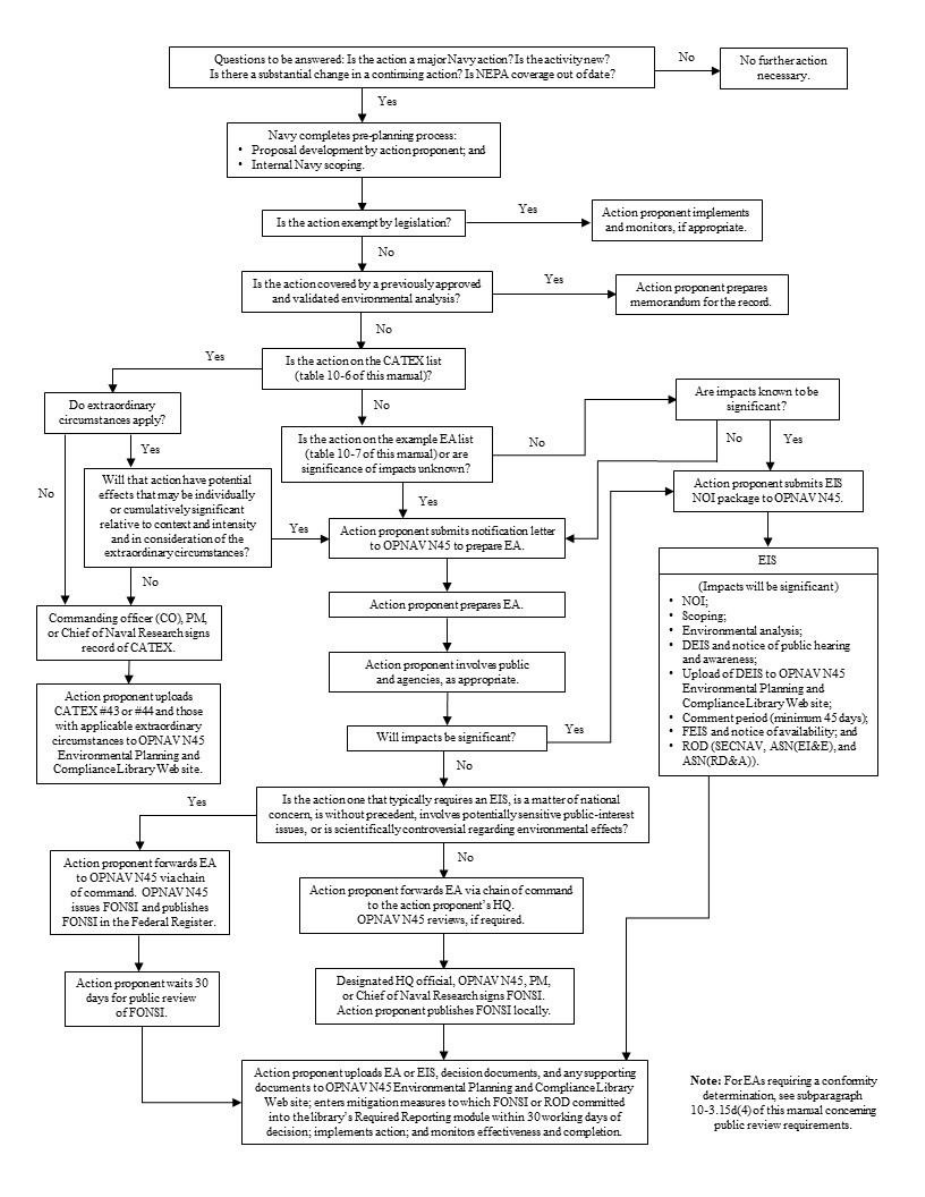
OPNAV M-5090.1
25 Jun 2021
10-40
Figure 10-2. NEPA Process Flowchart

OPNAV M-5090.1
25 Jun 2021
10-41
Table 10-6. Department of the Navy List of CATEXs
1. Routine fiscal and administrative activities, including administration of contracts;
2. Routine law and order activities performed by military personnel, military police, or other
security personnel, including physical plant protection and security;
3. Routine use and operation of existing facilities, laboratories, and equipment;
4. Administrative studies, surveys, and data collection;
5. Issuance or modification of administrative procedures, regulations, directives, manuals, or
policy;
6. Military ceremonies;
7. Routine procurement of goods and services conducted in accordance with applicable
procurement regulations, executive orders, and policies;
8. Routine repair and maintenance of buildings, facilities, vessels, aircraft, ranges, and
equipment associated with existing operations and activities (e.g., localized pest management
activities, minor erosion control measures, painting, refitting, general building/structural
repair, landscaping, grounds maintenance);
9. Training of an administrative or classroom nature;
10. Routine personnel actions;
11. Routine movement of mobile assets (such as ships, submarines, and aircraft, and ground
assets for repair, overhaul, dismantling, disposal, homeporting, home basing, temporary
reassignments; and training, testing, or scientific research) where no new support facilities are
required;
12. Routine procurement, management, storage, handling, installation, and disposal of
commercial items, where the items are used and handled in accordance with applicable
regulations (e.g., consumables, electronic components, computer equipment, pumps);
13. Routine recreational and welfare activities;
14. Alterations of and additions to existing buildings, facilities, and systems (e.g., structures,
roads, runways, vessels, aircraft, equipment) when the environmental effects will remain
substantially the same and the use is consistent with applicable regulations;
15. Routine movement, handling, and distribution of materials, including hazardous materials
(HM) and hazardous wastes (HW) that are moved, handled, or distributed in accordance with
applicable regulations;
16. New activities conducted at established laboratories and plants (including contractor-
operated laboratories and plants) where all airborne emissions, waterborne effluent, external
ionizing and non-ionizing radiation levels, outdoor noise, and solid and bulk waste disposal
practices are in compliance with existing applicable Federal, State, and local laws and
regulations;
17. Studies, data, and information gathering that involve no permanent physical change to the
environment (e.g., topographic surveys, wetlands mapping, surveys for evaluating
environmental damage, engineering efforts to support environmental analyses);
18. Temporary placement and use of simulated target fields (e.g., inert mines, simulated
mines, passive hydrophones) in fresh, estuarine, and marine waters for the purpose of non-
explosive military training exercises or RDT&E;
19. Installation and operation of passive scientific measurement devices (e.g., antennae, tide
gauges, weighted hydrophones, salinity measurement devices, water quality measurement
devices) where use will not result in changes in operations tempo and is consistent with
applicable regulations;

OPNAV M-5090.1
25 Jun 2021
10-42
20. Short-term increases in air operations up to 50 percent of the typical operation rate, or
increases of 50 operations per day, whichever is greater. Frequent use of this CATEX at an
installation requires further analysis to determine there are no cumulative impacts;
21. Decommissioning, disposal, or transfer of naval vessels, aircraft, vehicles, and equipment
when conducted in accordance with applicable regulations, including those regulations
applying to removal of HMs;
22. Non-routine repair and renovation, and donation or other transfer of structures, vessels,
aircraft, vehicles, landscapes, or other contributing elements of facilities listed or eligible for
listing on the NRHP;
23. Hosting or participating in public events (e.g., air shows, open houses, Earth Day events,
athletic events) where no permanent changes to existing infrastructure (e.g., road systems,
parking, sanitation systems) are required to accommodate all aspects of the event;
24. Military training conducted on or over non-military land or water areas, where such
training is consistent with the type and tempo of existing non-military airspace, land, and
water use (e.g., night compass training; forced marches along trails, roads, and highways; use
of permanently established ranges; use of public waterways; use of civilian airfields);
25. Transfer of real property from DON to another military department or to another Federal
agency;
26. Receipt of property from another Federal agency when there is no anticipated or proposed
substantial change in land use;
27. Minor land acquisitions or disposals where anticipated or proposed land use is similar to
existing land use and zoning, both in type and intensity;
28. Disposal of excess easement interests to the underlying fee owner;
29. Initial real estate in grants and out grants involving existing facilities or land with no
significant change in use (e.g., leasing of Federally owned or privately owned housing or
office space; agricultural outleases);
30. Renewals and minor amendments of existing real estate grants for use of government-
owned real property where no significant change in land use is anticipated;
31. Land withdrawal continuances or extensions that establish time periods with no significant
change in land use;
32. Grants of license, easement, or similar arrangements for the use of existing rights-of-way
or incidental easements complementing the use of existing rights-of-way for use by vehicles
(not to include significant increases in vehicle loading); electrical, telephone, and other
transmission and communication lines; water, wastewater, storm water, and irrigation
pipelines, pumping stations, and facilities; and for similar utility and transportation uses;
33. New construction that is similar to or compatible with existing land use (i.e., site and scale
of construction are consistent with those of existing adjacent or nearby facilities) and, when
completed, the use or operation of which complies with existing regulatory requirements (e.g.,
a building within a cantonment area with associated discharges and runoff within existing
handling capacities). The test for whether this CATEX can be applied should focus on
whether the proposed action generally fits within the designated land use of the proposed site;
34. Demolition, disposal, or improvements involving buildings or structures when done in
accordance with applicable regulations including those regulations applying to removal of
asbestos, polychlorinated biphenyls (PCB), and other HMs;
35. Acquisition, installation, modernization, repair, or operation of utility (including, but not
limited to, water, sewer, and electrical) and communication systems (including, but not limited

OPNAV M-5090.1
25 Jun 2021
10-43
to data processing cable and similar electronic equipment) that use existing rights of way,
easements, distribution systems, and facilities;
36. Decisions to close facilities, decommission equipment, or temporarily discontinue use of
facilities or equipment, where the facility or equipment is not used to prevent or control
environmental impacts;
37. Maintenance dredging and debris disposal where no new depths are required, applicable
permits are secured, and disposal will be at an approved disposal site;
38. Relocation of personnel into existing Federally owned or commercially leased space that
does not involve a substantial change affecting the supporting infrastructure (e.g., no increase
in vehicular traffic beyond the capacity of the supporting road network to accommodate such
an increase);
39. Pre-lease upland exploration activities for oil, gas, or geothermal reserves (e.g.,
geophysical surveys);
40. Installation of devices to protect human or animal life (e.g., raptor electrocution
prevention devices, fencing to restrict wildlife movement onto airfields, fencing and grating to
prevent accidental entry to hazardous areas);
41. Reintroduction of endemic or native species (other than endangered or threatened species)
into their historic habitat when no substantial site preparation is involved;
42. Temporary closure of public access to DON property to protect human or animal life;
43. Routine testing and evaluation of military equipment on a military reservation or an
established range, restricted area, or operating area (OPAREA); similar in type, intensity, and
setting, including physical location and time of year, to other actions for which it has been
determined, through NEPA analysis where DON was a lead or cooperating agency, that there
are no significant impacts; and conducted in accordance with all applicable SOPs protective of
the environment;
44. Routine military training associated with transits, maneuvering, safety and engineering
drills, replenishments, flight operations, and weapons systems conducted at the unit or minor
exercise level; similar in type, intensity, and setting, including physical location and time of
year, to other actions for which it has been determined, through NEPA analysis where DON
was a lead or cooperating agency, that there are no significant impacts; and conducted in
accordance with all applicable SOPs protective of the environment;
45. Natural resources management actions undertaken or permitted pursuant to agreement
with or subject to regulation by Federal, State, or local organizations having management
responsibility and authority over the natural resources in question, including, but not limited
to: prescribed burning, invasive species actions, timber harvesting, and hunting and fishing
during seasons established by State authorities pursuant to their State fish and game
management laws. The natural resources management actions must be consistent with the
overall management approach of the property as documented in an INRMP or other applicable
natural resources management plan;
46. Minor repairs in response to wildfires, floods, earthquakes, landslides, or severe weather
events that threaten public health or safety, security, property, or natural and cultural
resources, and that are necessary to repair or improve lands unlikely to recover to a
management-approved condition (i.e., the previous state) without intervention. Covered
activities must be completed within one year following the event and cannot include the
construction of new permanent roads or other new permanent infrastructure. Such activities
include, but are not limited to: Repair of existing essential erosion control structures or

OPNAV M-5090.1
25 Jun 2021
10-44
installation of temporary erosion controls; repair of electric power transmission infrastructure;
replacement or repair of storm water conveyance structures, roads, trails, fences, and minor
facilities; revegetation; construction of protection fences; and removal of hazard trees, rocks,
soil, and other mobile debris from, on, or along roads, trails, or streams;
47. Modernization (upgrade) of range and training areas, systems, and associated components
(including, but not limited to, targets, lifters, and range control systems) that support current
testing and training levels and requirements. Covered actions do not include those involving a
substantial change in the type or tempo of operation, or the nature of the range (i.e., creating
an impact area in an area where munitions had not been previously used);
48. Revisions or updates to INRMPs that do not involve substantially new or different land
use or natural resources management activities and for which an EA or EIS was previously
prepared that does not require supplementation pursuant to 40 CFR 1502.9(c)(1); and
49. DON actions that occur on another military Service’s property where the action qualifies
for a CATEX of that Service, or for actions on property designated as a joint base or joint
region that would qualify for a CATEX of any of the Services included as part of the joint base
or joint region. If the DON action proponent chooses to use another Service’s CATEX to
cover a proposed action, DON must obtain written confirmation the other Service does not
object to using its CATEX to cover the DON action. The DON official making the CATEX
determination must ensure the application of the CATEX is appropriate and that the DON’s
proposed action was of a type contemplated when the CATEX was established by the other
Service. Use of this CATEX requires preparation of a record of CATEX or decision
memorandum.
Source: Reference (f).
(2) When an EA is Being Prepared. A CATEX may not be applied to individual
components of an action that are the subject of an EA. The entire action must be evaluated in the
EA.
(3) When an Agreement Has Been Executed with Appropriate Consulting Parties to
Address a Potential Adverse Effect on Historic Properties. When compliance with section 106
of the NHPA has been previously resolved through the execution of an agreement between the
Navy and appropriate consulting parties, a CATEX may be applied to a proposed action that may
have an adverse effect on a historic property (archaeological or historic landscape or object that
is listed or eligible for listing in the NRHP). In such situations, the action proponent must
demonstrate evidence of completion of the NHPA section 106 process within the signed record
of CATEX. The executed agreement, with the signed record of CATEX, must be uploaded to
the OPNAV N45 Environmental Planning and Compliance Library Web site. In addition,
implementation of mitigation measures must be tracked using the mitigation and monitoring
tracking tool on the OPNAV N45 Environmental Planning and Compliance Library Web site.
e. Documenting Reliance on a CATEX. When the action proponent decides to apply a
CATEX to a proposed action that is more than administrative in nature, the decision must be
formally documented in a record of CATEX. Prior to signature of a record of CATEX,
consultations may be required and compliance resolved to apply a CATEX when extraordinary
circumstances are present (paragraph 10-3.14 of this manual). All consultation, coordination,
and authorization processes under applicable environmental statues must be completed before a

OPNAV M-5090.1
25 Jun 2021
10-45
record of CATEX may be signed. Records of CATEX with extraordinary circumstances present
must be vetted through the chain of command, including Region, and undergo counsel review
prior to signature. A record of CATEX is signed by the action proponent or installation
commanding officer (ICO) or his or her designee for a non-weapons systems acquisition action
or the PM or designee for a weapons systems acquisition action. As shown in subparagraph 10-
3.5d of this manual, the CNO N00N director or designee, in coordination with OPNAV N45 or
the designee, is responsible for applying CATEXs and preparing and approving records of
CATEX for proposed actions within the purview of CNO N00N. For proposed actions
documented with a record of CATEX where one or more extraordinary circumstances are
present, the action proponent must forward a copy of the signed record of CATEX, via the chain
of command, to OPNAV N45 by upload to the OPNAV N45 Environmental Planning and
Compliance Library Web site before implementing the action. This requirement to submit the
record of CATEX to OPNAV N45 is for awareness review only and not approval and is valid
through 6 January 2022. This requirement will continue to apply after that date only for all
records of CATEX that document the presence of extraordinary circumstances involving the
ESA or the MMPA per subparagraph 10-3.14d(1)(e)1 of this manual.
(1) Factors for Determining Whether to Prepare a Record of CATEX. A written record
of CATEX need not always be prepared. In determining whether it is appropriate to prepare a
record of CATEX for a proposed action, the signatory should consider that:
(a) Some activities may carry little risk of significant environmental effects such that
there is no practical need for, or benefit from, preparing and signing a record of CATEX.
Examples of such activities include routine fiscal and administrative activities, including
administration of contracts (CATEX #1); routine use and operation of existing facilities,
laboratories, and equipment (CATEX #3); or routine personnel actions (CATEX #10);
(b) For proposed actions that are more than administrative in nature (e.g., CATEX
#16, new activities conducted at established laboratories and plants), preparation of a record of
CATEX is required to demonstrate that the proposed action comports with any limitations
identified in prior NEPA analysis and that there are no potentially significant impacts expected.
As stated in subparagraph 10-3.14d(1) of this manual, the presence of one or more extraordinary
circumstances listed in subparagraph 10-3.14d of this manual does not necessarily prohibit the
application of a CATEX. In such cases, the record of CATEX should address proposed specific
factors and show consideration of extraordinary circumstances with regard to the potential for
localized impacts. Records of CATEX documenting when one or more extraordinary
circumstances are present must be submitted via the chain of command to OPNAV N45 for
awareness via the OPNAV N45 Environmental Planning and Compliance Library Web site per
subparagraph 10-3.7c of this manual;
(c) A record of CATEX is necessary to demonstrate compliance with the consultation
and coordination requirements of other laws, regulations, and policies, such as the ESA, MMPA,
or NHPA, when the extraordinary circumstances (refer to subparagraph 10-3.14d(1) of this
manual) are determined to apply;

OPNAV M-5090.1
25 Jun 2021
10-46
(d) A decision to rely on CATEX #43 or CATEX #44 for a proposed action always
requires the action proponent to prepare and sign a written record of CATEX. Records of
CATEX on CATEX #43 or CATEX #44 must be uploaded to the OPNAV N45 Environmental
Planning and Compliance Library Web site per subparagraphs 10-3.7c and 10-3.14e of this
manual;
(e) A record of CATEX is required when an action proponent is relying on a CATEX
for a proposed action that may result in an adverse effect on historic property and where the
action proponent has already executed an agreement with the appropriate consulting parties
under section 106 of the NHPA to mitigate that adverse effect. The record of CATEX must
address how the action proponent considered alternatives to avoid and minimize the potentially
adverse effects; and
(f) If lengthy documentation (more than 15 pages) is needed to establish a rationale
for applying a CATEX in a particular situation, the action proponent should consider whether it
is appropriate to apply the CATEX or if an EA should be prepared instead.
(2) Contents of a Record of CATEX. A record of CATEX is a concise document that
must describe:
(a) The specific CATEX(s) found applicable by the action proponent;
(b) Specific considerations as to whether extraordinary circumstances are applicable
(refer to the extraordinary circumstances in subparagraph 10-3.14d of this manual) and if
applicable, a discussion of why a CATEX is still appropriate (as discussed in subparagraph 10-
3.14d(1) of this manual);
(c) Facts supporting the use of the applicable CATEX (if one or more CATEXs are
being relied upon, the record of CATEX must address the potential for cumulative impacts) and
consultations, coordination, and authorizations resolved; and
(d) A record of CATEX supporting a request to the FAA for the establishment,
designation, or modification of special use airspace must provide sufficient project-specific or
related data and project impact analysis to allow decision making by the FAA as a cooperating
agency.
(3) Requirements for Retaining a Record of CATEX. At a minimum, the record of
CATEX must be retained in the action proponent’s files for 7 years and made available for
review during environmental quality assessments.
10-3.15. Environmental Assessments
a. General
(1) An EA is an analysis of the potential environmental impacts of a proposed action.
Action proponents must prepare an EA when they do not know beforehand whether a proposed

OPNAV M-5090.1
25 Jun 2021
10-47
action will significantly affect the human environment or be controversial regarding
environmental effects, and when a CATEX does not apply. An EA will either result in a FONSI
or, if a significant impact is identified in the EA, a decision to prepare an EIS.
(2) Pre-planning and advance coordination with environmental planners and conservation
program SMEs will enable action proponents to identify land areas with the fewest
environmental constraints for new construction, training, or testing, and for the analysis of
alternatives, thereby avoiding and minimizing the potential for impacts of proposed actions on
the environment.
(3) Procedural requirements applicable to NEPA, as indicated in paragraphs 10-3.4
through 10-3.9 of this manual, must be followed in the preparation of EAs. These include
requirements to: complete EAs in 1 year or less if no waiver is granted; include resource
regulatory and statutory conclusions in environmental planning documents; address mitigation
measures and their implementation; and upload final environment planning documents to the
OPNAV N45 Environmental Planning and Compliance Library Web site.
b. Actions Normally Requiring EAs. Table 10-7 of this manual lists examples of actions
that, under normal conditions, would likely require the preparation of an EA.
Table 10-7. List of Actions Normally Requiring an EA
1. Training exercises on or over (airspace) non-military property where such training is not
consistent with the type and tempo of existing non-military airspace, land, and water use.
2. Major training exercises on military property not categorically excluded, for which the
impacts are unknown, or for which the action proponent does not already know the impacts to
be significant.
3. Dredging projects that increase water depth over previously dredged or natural depths.
4. Proposed utilization of tidal and non-tidal wetlands that would require an individual permit.
5. Real estate acquisitions or outleases of land involving 50 acres or more where existing land
use will change and will not be categorically excluded.
6. Real estate acquisition of any size or in-grants or out-grants, which may be considered
environmentally controversial, regardless of the appropriation or intended use.
7. Family housing projects when resident population changes substantially.
8. New target ranges or range mission changes that would increase environmental impact.
9. Actions conducted at the request of States or territorial governments (e.g., ship sinking for
artificial reefs) wherein an environmental impact is expected.
10. New low-altitude aircraft training routes or special use airspace and warning areas where
overflights impact persons or wildlife (particularly endangered species).
11. Mission changes, base closures, relocations or consolidations, and deployments that would
cause major long-term population increases or decreases in affected areas. EAs are not
required where impacts are purely socioeconomic and involve no potential for significant
environmental impacts.

OPNAV M-5090.1
25 Jun 2021
10-48
12. Any activity proposed that may adversely affect Federally listed threatened or endangered
species, or the designated or proposed critical habitat of a Federally listed endangered species.
Chapter 12 (Natural Resources Conservation) of this manual discusses the associated but
separate need for a biological assessment and consultation under the ESA. (See paragraph 10-
3.14 of this manual for further information regarding extraordinary circumstances.)
13. Permanent closure or limitations on public access to any areas previously open to public
use, such as roads or recreational areas.
14. Construction or any other action resulting in discharges to or potential contamination of an
aquifer, watershed, or recharge zone regulated by the Safe Drinking Water Act (SDWA).
15. Irreversible conversion of “prime or unique farmland” to other uses.
16. Award or termination of contracts involving substantial quantities of natural resources,
wherein the Navy is the contracting agency.
17. Any action that will have a significant negative effect on the viability of a migratory bird
population per the MBTA. (See chapter 12 (Natural Resources Conservation), subparagraph
12-3.5b of this manual and paragraph 10-3.14 of this manual for further information regarding
extraordinary circumstances.)
18. Any action that may adversely affect the conditions of coral reef ecosystems. (See chapter
12 (Natural Resources Conservation), paragraph 12-3.6 of this manual and paragraph 10-3.14
of this manual for further information regarding extraordinary circumstances.)
c. Pre-Planning and Notification
(1) Pre-Planning Process. Before a scope of work for an EA is finalized or funded with a
government service provider or contractor, the action proponent must initiate early planning by
convening environmental SMEs, planners, and others to: identify the environmental issues
associated with the proposed action; assist in the development of preliminary alternatives for
analysis as outlined in reference (q); and develop a project timeline to complete the document
within the required 1 year or less timeframe as outlined in subparagraph 10-3.4m of this manual.
The action proponent must document the results of the pre-planning process per references (dd)
and (ee).
(2) Notification. Notification to OPNAV N45 of the intent to prepare an EA facilitates
overall awareness of internal Navy environmental planning activities and proposed projects,
ensures consistent application of policy, and avoids planning conflicts and delays. Notification
also facilitates awareness by the chain of command of potentially controversial issues or the
action proponent’s intent to release a document for public review. OPNAV N45 may provide
guidance on recently completed projects that are similar in scope or that should be included in a
cumulative effects analysis, new regulatory developments that could result in different effect
thresholds, or political sensitivities that the action proponent should consider in public
engagement planning. OPNAV N45 may grant the action proponent a waiver from the
requirement to complete the EA in 1 year or less when a waiver request is submitted with the
notification letter or EA initiation form (subparagraphs 10-3.15c(3) and 10-3.4m of this manual).
(a) Timing of Notification. Following completion of the pre-planning process, the
action proponent notifies OPNAV N45 of its intent to prepare an EA. The notification letter or
EA initiation form to OPNAV N45 must be coordinated within the action proponent’s chain of

OPNAV M-5090.1
25 Jun 2021
10-49
command and include the AEC, REC, and the affected Region Commander(s). Notification
letters or EA initiation forms must show proof of coordination with all affected mission-related
commands (i.e., REC and AEC signatures in the EA initiation form.
(b) Contents of the Notification. The notification for an EA should be sufficient to
provide the reader with a clear understanding of the proposed action and its elements addressing
the basic information identified in table 10-8 of this manual. Should changes to the proposed
action occur following submittal of the notification to OPNAV N45, the action proponent must
send OPNAV N45 an e-mail describing the changes via the “Contact Us” link on the OPNAV
N45 Environmental Planning and Compliance Library Web site.
Table 10-8. Notification Elements
1. Length: Preferably 3 to 5 pages, excluding any tables or charts
2. Elements:
1) Date of Notification;
2) Title of EA;
3) Action Proponent;
4) As a Result of Early Planning Process and Discussions, Identification of the
Commands, Specialties, and Dates that Discussions Were Conducted;
5) Date of Kickoff Meeting;
6) Estimated Decision Date(s). Identify date(s) for signing of the FONSI and
implementation of the proposed action. FONSI date should be within 1 year of the
formal EA kickoff meeting. If the action proponent believes that is not possible, they
may request a waiver by providing written justification as to why the timeline is not
attainable, recommendations to avoid such delays in the future, and a projected timeline,
streamlined to the extent possible, per references (s), (dd), and (ee);
7) Description of Installation/Location of Proposed Action. (Optional: Include map or
diagram, if available);
8) Description of the Proposed Action and its Location. Provide a brief description that
answers “what,” “where,” “when,” and “why.” Identify environmental factors
considered;
9) Explanation of Why a CATEX Cannot Be Applied. Explain why an action may not be
modified to qualify for use of a CATEX;
10) General Screening Factors that May Be Employed or an Outline of Preliminary
Alternatives or Both, Based on Early Planning Process and Discussions. Preliminary
alternatives under consideration should include an explanation of how the proposed
action (new construction, training, or testing) has been planned or designed, or
alternatives identified, to avoid or minimize the potential for significant environmental
impacts (refer to table 10-9 of this manual on core components of an EA for further
guidance on alternatives and guidance with respect to EAs supporting implementation of
an INRMP);
11) Description of How the Proposed Action Has Been Designed to Avoid or Minimize
the Potential for Environmental Impacts, if Possible;
12) Based on Current Knowledge, Identification of Issues of Potential Controversy or
Public Interest;

OPNAV M-5090.1
25 Jun 2021
10-50
13) Overview of Public Participation Elements, Based on Anticipated Interest. Indicate
whether public involvement is being considered in the form of public meetings, hearings,
or public release of the document for comment. In determining the appropriate level of
public involvement, the action proponent must document its rationale based on the factors
identified in subparagraph 10-3.15e(4)(b) of this manual;
14) Potential Regulatory Agency Consultations and Permits;
15) Relevant or Applicable Resource Areas to be Analyzed. Identification of important
or potentially significant environmental issues that will be analyzed in the document (e.g.,
wetlands, endangered species, high noise levels, presence of marine mammals);
16) Anticipated Monitoring or Mitigation Requirements;
17) Identification and Description of Potential Underwater Sound Sources. Identify any
underwater sound sources that may be used in marine, estuarine, and fresh waters (e.g.,
sonar, explosives, pile driving);
18) Any Cooperating Agency Relationships;
19) Whether OPNAV N45 Involvement Is Required (e.g., Endorsement, FONSI
Signature). If so, explain why;
20) For Joint Basing Actions or Where There Are Host and Tenant Relationships,
Explanation of How the Proposed Action Will Be Coordinated and Approved (e.g.,
FONSI Is to Be Signed by Both Parties). Refer to chapter 1 (Organization and
Coordination) of this manual for details on host and tenant relationships;
21) Action Proponent Point of Contact (POC) (Name, E-mail, Telephone);
22) Chain-of-Command Coordination and Endorsements with All Affected Mission-
Related Commands (i.e., REC and AEC Signatures and Dates). The AEC for CONUS is
COMUSFLTFORCOM. The AEC for Hawaii and Guam is COMUSPACFLT. The AEC
must ensure consistent application of environmental policy for Navy actions occurring on
fleet training ranges and at-sea OPAREAs from the high-water mark seaward within their
assigned AORs. AEC signature is required when a proposed action involves in-water pile
driving or has the potential to affect operational type, tempo, or duration, or all three.
(3) Update to Notifications and Notifications of Delay. If the proposed action or the
public-involvement strategy is substantially changed after submittal of initial notification to
OPNAV N45 (e.g., significant design changes may have potentially significant environmental
impacts; a determination is made to hold public meetings), the action proponent must notify
OPNAV N45 of the changes via the “Contact Us” link on the OPNAV N45 Environmental
Planning and Compliance Library Web site. In situations where a waiver was not requested for
an EA, EA/OEA, or OEA document during the notification stage but the action proponent
determines later that the 1 year or less timeline cannot be met due to unexpected delays, the
action proponent must submit a notification of delay letter to OPNAV N45 via the OPNAV N45
Environmental Planning and Compliance Web site as soon as possible after the decision is made
and before a FONSI is signed and provide: the reason(s) for the delay and why the timeline
cannot be met; recommendations to avoid such delays in the future; and a projected timeline
streamlined to the extent possible (subparagraph 10-3.4m of this manual).
(4) Cancellations. If, after notification, the action proponent subsequently cancels a
proposed action, then a timely cancellation notification should be submitted to OPNAV N45 as
soon as possible after the decision to cancel a proposed action is made. This may be

OPNAV M-5090.1
25 Jun 2021
10-51
accomplished via e-mail using the “Contact Us” link on the OPNAV N45 Environmental
Planning and Compliance Library Web site.
d. EA Content. When preparing an EA, the action proponent should focus on the issues of
concern and make the EA no longer than required to address those issues sufficiently. The core
elements that must be included in an EA are identified in table 10-9 of this manual. In addition:
(1) Document Preparation Guide and Templates. The action proponent must use the
Navy’s “Environmental Document Preparation Tools,” which include a document preparation
guide and standardized templates, as directed in reference (q), provided on the OPNAV N45
Environmental Planning and Compliance Library Web site (see appendix E (Web Sites) of this
manual for Web site address). The templates and preparation guide are provided in the
Reference Materials Library module under the Environmental Planning Standards tab. Updates
to the templates are encouraged and should be submitted to the OPNAV N45 Environmental
Planning and Compliance Library Web site (see appendix E (Web Sites) of this manual for Web
site address).
(2) Guidance on Assessing Impacts. The discussion of environmental impacts must
provide sufficient information to support a decision to prepare either an EIS or FONSI, taking
into account the definition of significantly, per paragraph 10-5.32 of this manual.
(3) Guidance on Assessing Climate and Resilience. The action proponent must address
the potential effects of a proposed action on regional or global climate. Where possible, the
analysis should quantify greenhouse gas (GHG) emissions (i.e., carbon dioxide, methane, nitrous
oxide, hydrofluorocarbons, perfluorocarbons, and sulfur hexafluoride) and describe the measures
to reduce GHG emissions (e.g., energy-efficient construction).
Table 10-9. Core Components of an EA
EA
Component
Guidance
Inside Cover
Sheet
(1 page)
1. Designation of the analysis as an EA.
2. Title of the proposed action that is the subject of the EA (and if
appropriate list related cooperating agency actions), together with the
State(s) (or other jurisdiction(s) if applicable) where the action is located.
3. Identity of the action proponent and cooperating agencies, if applicable.
Do not identify the Navy preparer or the contractor on the outside or inside
cover pages.
4. Name, address, and telephone number of the person at the responsible
command (action proponent) who can supply further information.
5. One-paragraph abstract of the statement.
Executive
Summary
(3–5 pages
maximum)
Place immediately after the cover sheet and before the table of contents to
include:
1. Name of the action.
2. Brief description of the action and the affected geographical region (State
and county, as applicable).
3. Description of alternatives considered.

OPNAV M-5090.1
25 Jun 2021
10-52
EA
Component
Guidance
4. Summary of the environmental impacts and major mitigating actions
required.
Body of EA
Need for the
Action
Brief description of the proposed action and concisely and objectively
explain the need for the proposed action, setting out the essential
requirements to be satisfied. Although not a requirement, the action
proponent may also describe the purpose of the proposed action.
Alternatives
Including the
Proposed
Action
The number of alternatives identified and carried through the analysis
should be determined by the level of unresolved conflicts concerning
alternative uses of available resources and identified issues. For all EAs
(except those prepared in support of implementing an INRMP, alternatives
should, at a minimum, include the proposed action, no action, and at least
one other reasonable action alternative. The rationale for not including an
action alternative in addition to the proposed action and no action must be
explained in detail. If screening factors will be used (e.g., operational or
locational needs), they must be listed. Alternatively, a summary of the
basis for identifying reasonable alternatives for analysis must be provided.
For actions associated with implementation of an INRMP, analysis of the
proposed action and no action alternatives is acceptable without including
a supporting rationale.
Existing
Environment
of the Proposed
Action
1. Concise description of the human environment and natural resources that
would be affected by implementation of the proposed action. The baseline
is used to compare the impacts of the various alternatives.
2. The amount of detail provided should be commensurate with the extent
and impact of the action (i.e., context and intensity) and with the analysis
required for the EA.
Environmental
Consequences
1. Description of the environmental impacts of reasonable alternatives in
terms of direct and indirect effects and cumulative impacts, including their
significance (i.e., an assessment of the positive and negative effects of the
proposed action), giving primary attention to the discussion of those factors
most evidently affected by the proposed action. Analyze cumulative
impacts.
2. Compliance with applicable regulatory processes must be addressed in
the analysis and conclusions reached should be consistent with the
guidance in subparagraph 10-3.4a of this manual:
(a) Refer to chapter 14 (Coastal Zone Management) of this manual for
additional information regarding Federal consistency under the CZMA;
(b) Discuss the potential effect on threatened or endangered animal or
plant species and designated critical habitat (refer to chapter 12 (Natural
Resources Conservation) of this manual);
(c) Address effects on cultural resources (refer to chapter 13 (Cultural
Resources Compliance and Management) of this manual), including
historic properties as defined in the NHPA; and

OPNAV M-5090.1
25 Jun 2021
10-53
EA
Component
Guidance
(d) Address effects on climate (include a comparison of the differences
between the alternatives in terms of their effects on climate).
3. Means to mitigate and monitor adverse environmental impacts (include
in mitigation matrix or separate chapter as required by paragraph 10-3.6 of
this manual).
List of
Agencies and
Persons
Consulted
List of any non-Navy agencies, organizations, groups, and persons
consulted in the development of the EA. This list should identify any
cooperating agencies.
List of
Preparers
List of the names, expertise, experience, and professional disciplines of the
persons who were primarily responsible for preparing the documents or
significant background papers, including Navy personnel directly
responsible for review.
Appendix
To substantiate impact analysis and to verify consultation and coordination
has been completed, each final EA must include, as appropriate and
preferably in an appendix, associated correspondence, memos to file,
associated e-mails, studies, biological evaluations or assessments and BOs,
permits, final rules, and the record of non-applicability (where required).
(4) CAA General Conformity Rule. The action proponent must determine if the CAA
General Conformity Rule (reference (p), section 7506) applies to the proposed action as defined
in the EA. The CAA General Conformity Guidance (refer to chapter 22 (Clean Air Ashore) of
this manual) describes the requirements and procedures for preparing a conformity evaluation.
The action proponent should include the results of the conformity evaluation as an appendix to
an EA proposing an action in a nonattainment or maintenance area:
(a) Where a record of non-applicability is required for a proposed action occurring in
a nonattainment or maintenance area, the action proponent will sign the record of non-
applicability and include it, along with the supporting analysis, in the EA as an appendix; and
(b) Where a conformity evaluation is required for a proposed action, the action
proponent must distribute a “review EA” (with the draft conformity evaluation as an appendix to
the EA) to the appropriate review agencies listed in the CAA General Conformity Rule and
interested parties for a 30-working-day comment period (refer to chapter 22 (Clean Air Ashore)
of this manual and subparagraph 10-3.15e of this manual for guidance on public involvement for
EAs). Concurrently, the action proponent must publish a public notice on the availability of a
draft conformity evaluation in the local newspaper. Once the EA and its conformity evaluation
are finalized by the action proponent, the EA is processed internally as shown in figure 10-2 of
this manual.

OPNAV M-5090.1
25 Jun 2021
10-54
e. Processing EAs
(1) Submitting the EA for Approval and FONSI Signature
(a) If the action proponent is in COMUSFLTFORCOM, COMUSPACFLT, CNIC
(and CNIC region commanders), COMNAVSEASYSCOM, COMNAVAIRSYSCOM, or
Strategic Systems Programs, the completed EA is submitted via the chain of command to the
flag-level official designated to sign FONSIs at its headquarters. Each EA submitted for review
by the chain of command must be accompanied by a memorandum of legal sufficiency (refer to
paragraph 10-5.20 of this manual) and a statement of technical review (OPNAV 5090/3) (refer to
paragraph 10-5.33 of this manual).
(b) If the action proponent is weapons systems acquisition-related, the EA is
processed per reference (b).
(c) If the action proponent is not in any of the chains of command identified in
subparagraph 10-3.15e(1)(a) of this manual, or the proposed action meets any of the factors
identified in table 10-10 of this manual, the action proponent must forward the EA, via the chain
of command, together with the statement of technical review (OPNAV 5090/3) and
memorandum of legal sufficiency, to OPNAV N45 for action. The action proponent must notify
the AEC and REC (as appropriate).
Table 10-10. Factors for Determining When to Elevate an EA for OPNAV N45 Action
1. The action proponent is not in a chain of command that has been delegated FONSI
signature authority (see subparagraph 10-3.1b(2) of this manual); or
2. The proposed action:
(a) Involves effects of national concern;
(b) Is closely similar to conditions that normally require the preparation of an EIS;
(c) Is without precedent;
(d) Involves potentially sensitive public interest issues; or
(e) Is scientifically controversial regarding environmental effects.
(2) EA Review and Decision-Making
(a) The designated decision maker and staff for the commands previously identified
in this manual with delegated FONSI signature authority, or OPNAV N45, as applicable, must
evaluate the documented impact of the proposed action on the environment and advise the action
proponent if additional information is required. Each EA must include appropriate resource
regulatory and statutory conclusions as supported by the analysis (refer to subparagraph 10-3.4a
of this manual for further guidance on regulatory and statutory conclusions).
(b) EAs that require OPNAV N45 action (i.e., review or signature or both) must be
submitted to OPNAV N45 with sufficient time to allow for a minimum of 30 working days for
review or decision-making or both by OPNAV N45. Information on EA and OEA processing
times is available in exhibit A in the Reference Materials Library module of the OPNAV N45

OPNAV M-5090.1
25 Jun 2021
10-55
Environmental Planning and Compliance Library Web site (refer to subparagraph 10-3.7a of this
manual).
(c) If a draft EA has been circulated for public review, the final EA must be revised
to address all substantive comments received. A separate appendix to the EA identifying and
addressing each comment is not required, but a record of disposition of all comments must be
developed and retained in the AR.
(d) After evaluating the analysis and conclusions documented in the EA, the
designated decision maker decides whether a FONSI is appropriate or whether the proposed
action would generate significant impacts requiring preparation of an EIS. If deemed
appropriate, the decision maker signs a FONSI. A template for a FONSI is provided in table 10-
11 of this manual.
Table 10-11. Template for a FONSI (5 or fewer pages in length)
DEPARTMENT OF DEFENSE
Department of the Navy
FINDING OF NO SIGNIFICANT IMPACT FOR [XXXXXXX AT XXXXXXX,
CITY/COUNTY, STATE]
Pursuant to the Council on Environmental Quality regulations (40 Code of Federal
Regulations [CFR] Parts 1500–1508) implementing the National Environmental Policy Act
(NEPA) and Department of the Navy (DON) NEPA regulations (32 CFR Part 775), DON
gives notice that an Environmental Assessment (EA) has been prepared and an Environmental
Impact Statement (EIS) is not required for XXXXXXXXX at CITY/COUNTY, STATE
(SPELLED OUT). This action will be implemented as set out in Alternative X. The
[IDENTIFY AGENCY] is a cooperating agency for this action [IF APPLICABLE].
Proposed Action: [BRIEFLY DESCRIBE THE PROPOSED ACTION IN NON-
ENVIRONMENTAL RESOURCE TERMS.]
Purpose and Need: [BRIEFLY DESCRIBE THE PURPOSE AND THE NEED FOR THE
PROPOSED ACTION.]
Alternatives Considered: The EA analyzes the potential environmental impacts of the
following alternatives: [BRIEFLY DESCRIBE EACH ACTION ALTERNATIVE ANALYZED.
THIS CAN BE IN A BULLETIZED OR NUMBERED LIST WITH A SUBSEQUENT
PARAGRAPH. EACH ALTERNATIVE SHOULD BE DESCRIBED SIMILARLY TO THE
PROPOSED ACTION. ENSURE THAT THE NO ACTION ALTERNATIVE IS IDENTIFIED
FIRST ON THIS LIST. DESCRIBE ALTERNATIVES THAT WERE ELIMINATED FROM
FURTHER CONSIDERATION. IDENTIFY WHETHER A PREFERRED ALTERNATIVE IS
BEING SELECTED AND PROVIDE A RATIONALE FOR THIS SELECTION].
Environmental Effects: No significant direct, indirect, or cumulative environmental impacts
would occur from implementing the proposed action. Certain environmental resources

OPNAV M-5090.1
25 Jun 2021
10-56
[IDENTIFY RESOURCES] were not analyzed in detail in this EA because implementation of
the proposed action would not be likely to result in any potential environmental impacts on
these resources or impacts would be negligible. Potential environmental impacts on
[IDENTIFY RESOURCES] are summarized here.
Identify Each Resource Area: [DESCRIBE THE MAJOR POTENTIAL ENVIRONMENTAL
EFFECTS OF THE PROPOSED ACTION FOR EACH RESOURCE AREA CARRIED
THROUGH THE ANALYSIS. ARE IMPACTS DIRECT, INDIRECT, LONG-TERM, MINOR,
OR SHORT-TERM? WHICH EFFECTS REQUIRE MITIGATION MEASURES? WHAT ARE
THE POSITIVE ENVIRONMENTAL EFFECTS, IF ANY? IS THE RATIONALE CLEAR
THAT SIGNIFICANT IMPACTS ARE REMOTE? IS THERE ANY OUTSTANDING
CONTROVERSY OR UNRESOLVED DISAGREEMENTS WITH REGULATORS OR
EXTERNAL GROUPS OR PERSONS (e.g., TRIBES, ENVIRONMENTAL GROUPS, PRIVATE
CITIZENS)? IF THERE IS, DESCRIBE SPECIFICALLY WHY THE NAVY DISAGREES.]
Mitigation Measures: Identify mitigation measures [NOTE: MITIGATION MEASURES
ARE MEANS/METHODS TO REDUCE OR AVOID POTENTIALLY SIGNIFICANT
ADVERSE EFFECTS OF AN ACTION ON THE ENVIRONMENT. BEST MANAGEMENT
PRACTICES OR STANDARD OPERATING PROCEDURES ARE NOT CONSIDERED
MITIGATION MEASURES SHOULD NOT BE IDENTIFIED AS SUCH].
Public Outreach: [BRIEFLY DESCRIBE THE PUBLIC OUTREACH PROCESS
EMPLOYED FOR THE EA, IF APPLICABLE.]
Finding: Based on the analysis presented in the EA, which has been prepared in accordance
with the requirements of NEPA and DON policies and procedures (32 CFR Part 775), and in
coordination with [XXXXXXX, YYYYYYYY, and ZZZZZZZZ (e.g., ALABAMA DEPT. OF
ENVIRONMENTAL QUALITY, U.S. FISH AND WILDLIFE SERVICE, STATE HISTORIC
PRESERVATION OFFICER, IF APPLICABLE)], DON finds that implementation of the
proposed action as set out in Alternative X will not significantly impact the quality of the
human environment. Therefore, an EIS will not be prepared.
Electronic copies of this EA and Finding of No Significant Impact may be obtained by written
request to: [INSERT ORGANIZATION (ATTENTION: XXXXXXX, TITLE), STREET
ADDRESS, STATE, ZIP CODE].
1. The inclusion of mitigation measures as part of the proposed action may bring
adverse impacts below the threshold of significance. Commitment to mitigation measures in the
FONSI is legally binding on the action proponent and must be implemented.
2. All consultation and authorization processes required by law, including, but
not limited to those set forth in the ESA, MMPA, NHPA, MSFCMA, MBTA, CZMA, NMSA,
CAA, and CWA, must be completed before a FONSI may be signed (see subparagraph 10-3.4c
of this manual for specific guidance).

OPNAV M-5090.1
25 Jun 2021
10-57
(e) After the FONSI is signed, the decision maker notifies the action proponent to
complete required public notification:
1. Before undertaking any physical action that would affect the environment, the
action proponent must make every effort to make the FONSI available for public review using
any combination of newspaper advertisements, radio or television announcements, Internet Web
sites (if established by an action proponent), mailings, and social media.
2. For projects previously determined to meet any combination of the factors in
table 10-10 of this manual, the action proponent will make the FONSI available to the public for
30 calendar days by means identified in subparagraph 10-3.15e(2)(e)1 of this manual for
notifying the public. Such notification must occur before the decision becomes final and before
implementation of any part of the proposed action.
(f) Implementing the Proposed Action. After public notification is complete, the
proposed action may be implemented.
(3) Mitigation Tracking and Uploads to OPNAV N45 Environmental Planning and
Compliance Library Web Site
(a) Within 30 days of FONSI signature, the mitigation measures committed to in the
FONSI must be inputted to the OPNAV N45 Environmental Planning and Compliance Library
Web site using the mitigation and monitoring tracking tool within the Required Reporting
module. Implementation of mitigation and monitoring measures will be tracked annually to
completion (see subparagraph 10-3.7e of this manual).
(b) The action proponent must ensure that within 30 working days of FONSI
signature, a copy of the final EA and FONSI is uploaded to the Web site. Guidance on the Web
site is provided in subparagraph 10-3.7c of this manual. (Memoranda of legal sufficiency or
statements of technical review should not be uploaded.) These documents should be retained in
command files for 7 years.
f. Public Participation Considerations for EAs. CEQ’s regulations recognize the importance
of public participation in preparing EAs. General guidelines for public participation are:
(1) EAs involving the preparation of a conformity evaluation or meeting the factors
identified in table 10-10, items 2(a) through 2(e) of this manual must always be circulated for
public review for 30 calendar days, as previously discussed in this manual.
(2) For all other EAs, the means for involving the public described in this chapter
pertinent to EISs may be employed at the action proponent’s discretion. Although a 30-day
public review period may be considered optimal, the intent of this manual is to allow the action
proponent flexibility in tailoring their EA public participation strategy to the complexity of and
potential for public interest in the proposed action. At a minimum, action proponents should
ensure appropriate communications are initiated and maintained with affected and interested
parties. Action proponents desiring to involve the public in the preparation of an EA will notify

OPNAV M-5090.1
25 Jun 2021
10-58
OPNAV N45 in advance of any public scoping or public review of an EA or of their intent to
hold public meetings (refer to notification requirements in subparagraph 10-3.15c of this manual
and to reference (gg)).
(3) In determining the extent to which public participation, including public review
periods and public meetings, is practicable for an EA, the action proponent should consider the
factors identified in table 10-12 of this manual, which should also be documented and explained
in the notification to OPNAV N45. Given non-governmental organization and Congressional
interest is often high, ensuring consistency in public engagement approaches within and across
Navy regions is an essential role of OPNAV N45.
Table 10-12. Factors to Be Considered When Determining the Level of Public Participation
for an EA
1. The complexity and scope of the proposed action;
2. The magnitude of the environmental effects and the extent to which mitigation measures
may be needed to bring potential impacts to a less than significant level;
3. Anticipated public interest or controversy;
4. Any relevant questions of national security and classification; and
5. State, local, and regional common practices regarding public participation.
(4) When an action proponent decides it is appropriate to circulate an EA for public
review:
(a) Every effort must be made to notify the public of the availability of the draft EA
using any combination of newspaper advertisements, radio or television announcements, Internet
Web sites (if established by an action proponent), mailings, and social media.
(b) The draft FONSI may be released for public review at the same time.
(c) To provide adequate time for review of the documents, the public must be
allowed a minimum review period of 15 calendar days unless a public meeting is proposed, in
which case the minimum review period is 30 calendar days. Upon completion of the final EA
and the signing of a FONSI, the action proponent notifies the public of its decision.
(5) Where there are significant non-English-speaking populations within the proposed
project study area, in coordination with the appropriate public affairs officer (PAO), the action
proponent must consider translating the executive summary of the EA or the complete EA or
FONSI into languages other than English.
(6) Internet Web sites and content posted on such sites that may be established or used to
support environmental planning efforts must comply with current Navy policy.
(7) All EAs and FONSIs released to the public must go through a security review prior to
publication to ensure that no classified or sensitive information is inadvertently released. The
security review would be conducted by the action proponent’s command with appropriate

OPNAV M-5090.1
25 Jun 2021
10-59
knowledge and clearance to verify that the documents contain no classified or sensitive
information.
10-3.16. Environmental Impact Statements. In an EIS, the action proponent provides a full and
unbiased analysis of significant environmental impacts and informs the decision makers and the
public of the reasonable alternatives that meet the proposed action’s purpose and need.
Procedural requirements applicable to NEPA, as indicated in paragraphs 10-3.4 through 10-3.9
of this manual, must be followed in the preparation of EISs. These include requirements to:
complete EISs in 2 years or less if no waiver is granted, except for at-sea EISs; include resource
regulatory and statutory conclusions in environmental planning documents; address mitigation
measures and their implementation; and upload final environment planning documents to the
OPNAV N45 Environmental Planning and Compliance Library Web site. Additional guidance
is provided in subparagraphs 10-3.16a through 10-3.16c of this manual.
a. Actions Normally Requiring an EIS. When an action is deemed to have the potential for
significant environmental impacts, or when an EA concludes that potential impacts would be
significant, the action proponent must prepare an EIS using the procedures outlined in this
chapter. Examples of actions that may have a significant impact on the quality of the human
environment, and for which an action proponent should consider the preparation of an EIS
include:
(1) Large dredging projects or dredging projects where dredged material disposal may
result in significant impacts (large is in the context of the body of water to be dredged);
(2) Proposed major construction and filling in tidelands or wetlands;
(3) Establishment of major new installations or significant mission changes at existing
installations that result in a change in infrastructure or land use;
(4) Major land acquisitions that result in a change in how the property is used (a major
land acquisition is as defined in reference (u));
(5) New municipal solid waste landfills or HW land disposal units; and
(6) Long-term use of sea ranges and OPAREAs or land ranges for training exercises and
RDT&E, which is expected to result in a significant number of “takes” of protected species as
defined in either the MMPA or the ESA, or adverse effects on historic properties under the
NHPA.
b. Pre-Planning (Project EIS Review Team Process) and NOI Package. As early as possible
in the planning process (and prior to EIS contract award), the action proponent must convene an
interdisciplinary project EIS review team to review all aspects of the proposed action, ensure
environmental considerations are fully integrated into project design and preliminary alternatives
development, and develop a project timeline for document completion within the required 2 year
or less timeframe, as outlined in subparagraph 10-3.4m of this manual. The project EIS review
team will consist of representatives from the action proponent, interdisciplinary environmental
OPNAV M-5090.1
25 Jun 2021
10-60
planners and SMEs, legal counsel, public affairs, and the EIS service provider (including the
designated EIS project manager) and invite headquarters staff from OPNAV N45 and
ASN(EI&E).
(1) The project EIS review team will review all aspects of the proposed action with
consideration given to:
(a) Ensuring the purpose is clearly defined and the need for the proposed action is
confirmed and has clear leadership support;
(b) Establishing a process for strategic communications and development of
consensus among internal Navy stakeholders;
(c) Providing adequate information for cost-effective contracting and document
preparation and review;
(d) Ensuring collection and development of current information, data, statistics, and
best available science that are the foundation of sound analysis and high-quality environmental
planning documents; and
(e) Using master plans and geographic information systems to identify land areas
with the fewest environmental constraints for new construction, training, or testing, and for
analysis of alternatives, thereby avoiding and minimizing the potential for impacts of proposed
actions on the environment up front.
(2) The pre-planning process must culminate in a common understanding and consensus
among Navy stakeholders as to why the proposed action is necessary, what the critical timing
considerations (i.e., delivery of a new platform) are, what requirements are essential to achieving
the proposed action’s purpose (screening criteria), and what reasonable alternatives could
achieve this purpose and avoid or minimize the potential for significant environmental impacts.
Per references (dd) and (ee), development of the project timeline must meet the requirement for
EISs, except for at-sea EISs, to be completed in 2 years or less starting from the NOI publication
date in the Federal Register and ending with the anticipated signature date of the ROD. The
DASN(E) may grant the action proponent a waiver from this requirement to complete the EIS in
2 years or less. In advance of submitting an NOI package, the action proponent must submit a
written waiver request through the chain of command to the DASN(E), including justification for
why the timeline is not attainable and provide a projected timeline that is streamlined to the
extent possible. The action proponent must upload the waiver request letter and, if granted, the
waiver letter to the OPNAV N45 Environmental Planning and Compliance Web site. In
situations where a waiver was not granted after the start of an EIS, EIS/OEIS, or OEIS document
but the action proponent determines later that the 2 year or less timeline cannot be met, the action
proponent must notify the DASN(E), through the chain of command, as soon as the delay has
been identified. The notification must include the reasons why the timeline cannot be met and
recommendations to avoid such delays in the future.

OPNAV M-5090.1
25 Jun 2021
10-61
(3) After conducting pre-planning, the action proponent prepares an NOI package with
the elements indicated in table 10-13 of this manual and the Federal Register Checklist found on
the OPNAV N45 Environmental Planning and Compliance Library Web site. The NOI package
is submitted to OPNAV N45 via the chain of command, including coordination with the AEC
and REC. OPNAV N45 is responsible for conducting a technical and legal review of the NOI
package and coordinating with ASN(EI&E).
Table 10-13. Elements of an NOI Package
Elements of an NOI Package (preferably no more than 20 pages total)
1. Cover Letter
(a) The identity of the action proponent;
(b) Summary of the proposed action and the results of project EIS review team discussions
to include a description of how the discussion shaped the proposed action, purpose and need,
and preliminary alternatives;
(c) The identity of the agency(ies) with which a cooperating agency relationship is being
considered. For joint basing actions or where there are host or tenant relationships, provide an
explanation on how this project will be coordinated and approved;
(d) Identification of any required permits, consultations, or authorizations that will be
undertaken as part of the proposed action and the agencies with regulatory jurisdiction;
(e) List of technical and legal points of contact; and
(f) If applicable, indicate if a waiver to the 2-year timeline was requested and granted.
2. Draft Stick Chart (stick chart is preferred, rather than a Gantt chart). Ensure the stick
chart delineates key milestones, including, but not limited to:
(a) Anticipated publication of the NOI;
(b) Dates for scoping meetings;
(c) Key dates for submittal of permit applications and consultation packages and proposed
and final rules and BOs, as appropriate;
(d) Anticipated date for completion of a DEIS;
(e) Target date for completion of a FEIS and ROD signature; and
(f) Tiger team reviews.
A notional stick chart is provided in the Reference Materials Library module of the
OPNAV N45 Environmental Planning and Compliance Library Web site.
3. Endorsements. Ensure the NOI package contains proper chain of command endorsements
and has been coordinated with the AEC and REC, as appropriate.
4. Preliminary DOPAA (10 pages excluding maps and charts)
(a) Cover, with the identity of the action proponent and, if applicable, the cooperating
agency(ies);
(b) Summary and scope of the proposed action, including locations to be affected (with
maps or charts);
(c) Summary of purpose and need (including mission and background, as appropriate);
(d) Brief explanation of how a reasonable range of alternatives will be generated and
evaluated and what, if any, internal coordination will be required between the action proponent
and other stakeholders (e.g., SYSCOMs, other OPNAV directorates). At least two action
alternatives plus the no action alternative must be identified and analyzed, unless rationale for
not including an action alternative in addition to the proposed action and no action alternative
is explained in detail. If screening factors will be used (e.g., operational or locational needs),

OPNAV M-5090.1
25 Jun 2021
10-62
Elements of an NOI Package (preferably no more than 20 pages total)
they must be listed. Alternatively, a summary of the basis for identifying reasonable
alternatives for analysis must be provided;
(e) Proposed alternatives (with maps or tables, including a table comparing the elements of
each alternative);
(f) An explanation of how the proposed action has been planned or designed, or what
alternatives have been identified, to avoid or minimize the potential for significant
environmental impacts;
(g) Regulatory considerations (e.g., potential permitting, consultations);
(h) Based on current knowledge, a summary of anticipated issues of concern, including
Congressional issues, public-interest issues, and issues of other interested parties; and
(i) Summary of public involvement plan.
5. Draft NOI: Prepare a draft NOI using this template.
DEPARTMENT OF DEFENSE
Department of the Navy
Notice of Intent to Prepare an Environmental Impact Statement (EIS) for [PROPOSED
ACTION] at [INSTALLATION/RANGE/OPAREA], [CITY/COUNTY], [STATE] and to
Announce Public Scoping Meetings
AGENCY: Department of the Navy (DON), DoD.
ACTION: Notice.
SUMMARY: Pursuant to section 102(2)(C) of the National Environmental Policy Act
(NEPA) of 1969; sections 4321 et seq. of Title 42, U.S. Code; Council on Environmental
Quality regulations (Parts 1500–1508 of Title 40, Code of Federal Regulations [CFR]); and
DON regulations (32 CFR Part 775), DON announces its intent to prepare an EIS to evaluate
the potential environmental consequences of [SUMMARY OF PROPOSED ACTION AND ITS
COMPONENTS]. DON’s action proponent for this proposal is [IDENTIFY ACTION
PROPONENT].
DATES AND ADDRESSES: Public scoping meetings will be held in
[CITY/COUNTY/STATE] to receive oral and written comments on environmental concerns that
should be addressed in the EIS. Public scoping meetings will be held on [DAYS, DATES,
TIMES, LOCATIONS].*
FOR FURTHER INFORMATION CONTACT: [POC, COMMAND, ADDRESS,
TELEPHONE, FACSIMILE, E-MAIL ADDRESS].
SUPPLEMENTARY INFORMATION: [TEXT SHOULD COVER THE FOLLOWING, AS
APPROPRIATE]:
Specific action proponent within DON [e.g., COMMANDER, NAVAL AIR STATION
WHIDBEY ISLAND OR COMUSFLTFORCOM]
Brief description of the proposed action, including identification of action proponent
and any cooperating agency.
Locations to be affected.
Purpose and need for the action.

OPNAV M-5090.1
25 Jun 2021
10-63
Elements of an NOI Package (preferably no more than 20 pages total)
Alternatives to be considered.
Extent and duration of action.
Resources to be evaluated based on knowledge of sensitive issues.
Public meeting dates, times, and locations. Deadline for receipt of written comments.
POC with address, telephone, facsimile, and e-mail address (as appropriate) to whom
comments should be sent.
*Action proponents must provide target dates for planned public scoping meetings; the
meeting dates, however, must be flexible to allow OPNAV N45 and ASN(EI&E) time for
approval of the NOI package after its submission.
(4) Per references (cc) and (dd), OPNAV N45 will publish the NOI in the Federal
Register after approval by ASN(EI&E). The action proponent mails the NOI directly to
concerned agencies and persons, making every effort to notify the public using any combination
of newspaper advertisements, radio or television announcements, Internet Web sites (if
established by the action proponent), mailings, and social media.
(5) If the action proponent cancels an activity for which an NOI was published in the
Federal Register, then the action proponent will submit a cancellation letter (with proper
endorsements) via the chain of command to OPNAV N45 as soon as possible after the decision
to cancel a proposed action is made. After discussion with ASN(EI&E), OPNAV N45 will
arrange for publication of a cancellation notice in the Federal Register.
c. Scoping
(1) Action proponents may hold public scoping meetings whenever practicable, but they
are not mandatory. There is no authority for the payment of expenses incurred by any private
person(s) in the preparation and presentation of information at these meetings. If no public
meeting is to occur, the cognizant command must address the issues received in response to
published notices.
(2) If public scoping meetings are to occur, the NOI must provide date, times, and
locations for the meetings, to the extent possible, and to minimize costs. Scoping meetings must
be held no earlier than 15 calendar days following the publication of the NOI (or a notice
announcing public scoping meetings, where applicable). The action proponent should refer to
subparagraph 10-3.16e of this manual and reference (ff) for guidance on procedures for
conducting public meetings or hearings. Public input received during scoping should be used by
action proponents to focus on issues of importance to the public and identify and de-emphasize
insignificant issues from detailed analysis in the EIS or those previously covered by other
environmental planning documents.
(3) The action proponent will provide OPNAV N45 with summaries of each public
scoping meeting no later than 5 days after the meeting is held. Each summary will include, at a
minimum, the total number of non-Navy attendees, attendance by Congressional representatives
(if any), attendance by press representatives (if any), and issues raised.

OPNAV M-5090.1
25 Jun 2021
10-64
d. DEISs
(1) Process Timeline
(a) EISs must be prepared in an expeditious manner, taking into consideration
timelines required for compliance with applicable laws, regulations, and this manual.
Information on EIS processing times is available in exhibit C (EIS Process Chart) in the
Reference Materials Library module of the OPNAV N45 Environmental Planning and
Compliance Library Web site (see appendix E (Web Sites) of this manual for Web site address)
and in reference (s).
(b) Before a final decision is made, cognizant commands must not take any actions
concerning the proposal that would constitute an irreversible or irretrievable commitment of
resources, would have an adverse environmental impact, or would limit the choice of reasonable
alternatives.
(2) DEIS Content
(a) General Guidelines. In preparing an EIS, an action proponent must consider that:
1. EISs should be analytic rather than encyclopedic. The action proponent should
make every effort to restrict the document only to pertinent facts, excluding material not directly
applicable to the expected impact and ensure there is sufficient information and baseline data to
support the conclusions reached. If desired, the action proponent may include additional data in
appendices to the EIS;
2. The action proponent must use the document template and preparation guide,
as directed in reference (q), provided on the OPNAV N45 Environmental Planning and
Compliance Library Web site (see appendix E (Web Sites) of this manual for Web site address).
The template and preparation guide are provided in the Reference Materials Library module
under the Environmental Planning Standards tab. Updates to the templates are encouraged and
should be submitted to the OPNAV N45 Environmental Planning and Compliance Library Web
site (see appendix E (Web Sites) of this manual for Web site address); and
3. Per reference (v), where there are significant non-English-speaking
populations within the proposed project study area, and in coordination with the appropriate
PAO, the action proponent should consider translating the DEIS or FEIS executive summary (or
other portions of the DEIS or FEIS) into languages other than English.
(b) Core Components of the DEIS. The core components of an EIS are identified in
table 10-14 of this manual. All relevant resource areas should be addressed in the description of
the existing environment and the analysis of environmental consequences.

OPNAV M-5090.1
25 Jun 2021
10-65
Table 10-14. Core Components of an EIS
EIS
Component
Guidance
Inside Cover
Sheet
(1 page)
1. Designate the analysis as a DEIS or FEIS, or draft or final supplement.
2. Provide the title of the proposed action that is the subject of the
environmental analysis (and, if appropriate, list of related cooperating agency
actions), together with the State(s) (or other jurisdiction, if applicable) where
the action is located.
3. Identify the action proponent. The outside or inside cover pages must not
identify the Navy preparer (service provider) or the contractor by name or by
the placement of logos.
4. Provide the name, address, and telephone number of the person at the
responsible command who can supply further information.
5. Provide a one-paragraph abstract of the proposed action.
Executive
Summary
(preferably
fewer than 20
pages)
Place immediately after the cover sheet and before the table of contents to
include:
1. Name of the action.
2. Description of the action and the affected geographical region (State and
county, as applicable).
3. Description of alternatives considered.
4. Summary of the environmental impacts and major mitigating actions
required.
5. Summary of significant environmental impacts of the proposed action and
the alternatives in comparative (table) form.
Body of EIS
Purpose of and
Need for the
Action
Briefly describe the proposed action and explain the purpose of and need for
the proposed action concisely and objectively. Set out the justification for
the action (purpose, goal, or objective to be achieved by the proposed action)
and the essential requirements that must be satisfied to achieve the purposes
of the action (the need or why the requirement is essential to the Navy).
Alternatives
Including the
Proposed
Action
1. Identify all reasonable alternatives, particularly those that might enhance
environmental quality or avoid some or all adverse environmental effects.
The potential environmental impacts of all reasonable alternatives must be
rigorously explored and objectively evaluated in the EIS.
2. Describe the factors for selecting alternatives. Where relevant, include
alternatives to the proposed action not within the existing authority of the
agency.
3. Indicate those considerations, including factors not related to
environmental quality that are likely to be relevant and important to a
decision to prevent premature foreclosure of options that might enhance
environmental quality or have less detrimental effects.
4. Examples of alternatives include: taking no action; postponing action;
selecting actions of a significantly different nature (i.e., meeting mission and
project objectives with different environmental impacts); and different
designs or details of the proposed action that would present different
environmental impacts (including mitigation measures).

OPNAV M-5090.1
25 Jun 2021
10-66
EIS
Component
Guidance
5. The alternatives analysis should be sufficiently detailed to reveal the
agency’s comparative evaluation of the proposed action and each reasonable
alternative.
6. The FEIS must identify the action proponent’s preferred alternative (if not
previously identified in the DEIS).
Existing
Environment
of the
Proposed
Action
1. Concisely describe the human environment and natural resources that
would be affected by implementation of the proposed action. The baseline is
used to compare the impacts of the various alternatives.
2. The amount of detail provided should be commensurate with the extent
and impact of the action (i.e., context and intensity) and with the amount of
information required at the particular level of decision-making.
Environmental
Consequences
1. Describe the environmental impacts of reasonable alternatives in terms of:
(a) Direct and indirect effects and their significance (i.e., an assessment of
the positive and negative effects of the proposed action) giving attention
those factors most evidently affected by the proposed action.
(b) Cumulative impacts as appropriate and in context with the action’s
scope and magnitude.
(c) Relationships between the proposed action and the objectives of
Federal, State, and local land use plans, policies, and controls for the area
concerned.
(d) Irreversible or irretrievable commitments of resources anticipated
upon implementation of the proposed action.
(e) Adverse environmental impacts that cannot be avoided if the proposal
is implemented.
(f) Relationship between local, short-term use of man’s environment and
maintenance and enhancement of long-term biological productivity.
(g) Means to mitigate and monitor adverse environmental impacts as
required by paragraph 10-3.6 of this manual (include in a separate chapter or
at a minimum in a mitigation matrix).
(h) Compliance with applicable regulatory processes must be addressed in
the analysis (refer to subparagraphs 10-3.4a and 10-3.4c of this manual).
2. For FEISs, discuss and provide responses to substantive public comments
received on the DEIS.
3. Summarize the significant environmental impacts of the proposed action
and the alternatives in comparative (matrix) form (same matrix as used in the
executive summary).
List of
Preparers
List the names, expertise, experience, and professional disciplines of the
persons who were primarily responsible for preparing the documents or
significant background papers, including Navy personnel directly responsible
for review.
Distribution
List
List the names and addresses of all Federal, State, and local organizations
and persons to whom the EIS is distributed.
Appendix
1. Include any of this information as appendices to the EIS:

OPNAV M-5090.1
25 Jun 2021
10-67
EIS
Component
Guidance
(a) Material prepared in connection with an EIS (as distinct from material
that is not so prepared or bulky documentation that is incorporated by
reference).
(b) Analytic and relevant material to the decision to be made (e.g.,
biological evaluations or assessments and BOs; coastal consistency or
negative determinations; archaeological, historical, or cultural evaluations).
(c) Material that substantiates any analysis fundamental to the impact
statement (e.g., permits, final rules).
(d) The results of the conformity evaluation as an appendix to the EIS if
the proposed action is in a nonattainment or maintenance area.
2. To substantiate impact analysis and to verify consultation and
coordination has been completed, each FEIS must include, as appropriate
and preferably in an appendix, associated correspondence, memos to file,
associated e-mails, studies, biological evaluations or assessments and BOs,
permits, final rules, and the record of non-applicability (where required).
3. For FEISs, provide comment letters received on the DEIS and
responses.
(c) Guidance on Assessing Climate and Resilience. The action proponent must
address the potential effects of a proposed action on regional or global climate. Where possible,
the analysis should quantify GHG emissions (i.e., carbon dioxide, methane, nitrous oxide,
hydrofluorocarbons, perfluorocarbons, and sulfur hexafluoride) and describe the measures to
reduce GHG emissions (e.g., energy-efficient construction).
(3) DEIS Review and Processing
(a) Headquarters Review of Preliminary DEIS. The action proponent must submit
the preliminary DEIS for review by OPNAV N45 and ASN(EI&E) staff, no later than V.2 (staff
review). Refer to table 10-4 of this manual for an explanation regarding EIS versions. The V.2
staff review of the DEIS must be accompanied by a written status summary (no more than three
pages in length) on the progress of all consultation, coordination, and authorization processes
pertaining to the proposed action.
(b) Filing of the DEIS and Public Outreach. Upon ASN(EI&E) approval, OPNAV
N45 will digitally file DEIS V.4 (release version) with EPA. The Office of Legislative Affairs
(OLA) will make the Congressional notifications prior to EPA’s publication of the NOA in the
Federal Register.
(c) Public Distribution of the DEIS. Reference (w) requires that an action proponent
publicly distribute DEISs no later than the time the DEIS is filed with EPA.
1. Action proponents, OPNAV N45, and the Navy Secretariat must coordinate
closely to ensure the DEIS is approved for release early enough to enable the action proponent to
make the required distribution.

OPNAV M-5090.1
25 Jun 2021
10-68
2. The action proponent will ensure the DEIS is posted electronically on the
project Web site the same day that the DEIS is filed with EPA and made available for public
review in local outlets such as libraries or county commissioners’ offices, whenever possible.
3. To the extent possible, the Navy must distribute electronic copies of the
document and post the DEIS on its project Web site. Consideration must be given to outreach
and distribution of the DEIS to the potential stakeholders identified in table 10-15 of this manual.
Table 10-15. Potential Stakeholders to be Considered in DEIS Distribution
1. Any Federal agency that has jurisdiction by law or special expertise regarding any
environmental impact involved or one authorized to develop and enforce standards applicable
to the proposed action (e.g., cooperating agencies).
2. Appropriate State and local agencies that are authorized to develop and enforce standards
applicable to the proposed action.
3. Native Hawaiian organizations, Native American or Alaskan Native tribal governments
when the effects of Navy proposed actions may impact their interests, on or off reservations.
4. Any agency that has requested that it receive EISs on actions of the kind proposed.
5. Non-governmental organizations with an interest in the proposed action.
6. The public, affirmatively soliciting comments from those persons or organizations that may
reasonably be interested or affected.
7. Minority and low-income populations.
(d) DEIS Public Review
1. DEIS Public Review Period. A minimum of 45 calendar days is allocated for
agency and public review, beginning on the date on which EPA publishes the NOA for the DEIS
in the Federal Register. Normally that date is the Friday following the week that the DEIS is
filed with EPA. Any requests for extensions of the public review period must be considered and
processed as identified in subparagraph 10-3.16e(7) of this manual. Typically, a public meeting
or hearing is held during the public review period, but such meeting or hearing is not mandatory.
2. Public Review for Conformity Evaluations. Where the EIS requires a
conformity evaluation, the action proponent must include a discussion of the public review
requirements in the notice of public meeting or hearing published in the Federal Register by
OPNAV N45 and in newspaper advertisements, radio or television announcements, Web sites (if
established by an action proponent), mailings, and social media. The public review of a
conformity evaluation runs concurrently with the 45-day DEIS review period.
3. NHPA Section 106 General Public Outreach Requirements. Where a proposed
action triggers compliance requirements under section 106 of the NHPA, and the action
proponent decides to use the NEPA public outreach process to satisfy the section 106 public
engagement requirement, it is important to notify consulting parties and the public of the plan to
coordinate public engagement under NEPA and section 106 of the NHPA. The action proponent
must accommodate section 106 general public outreach requirements during the public review
period following release of the DEIS. Chapter 13 (Cultural Resources Compliance and
Management), paragraphs 13-3.2, 13-3.3, and 13-3.9 of this manual provide additional section

OPNAV M-5090.1
25 Jun 2021
10-69
106 and cultural resources consultation and stakeholder engagement requirements, and policy for
NEPA integration with section 106.
e. Guidance for Conducting Public Meetings and Hearings
(1) General. Action proponents may conduct public meetings or hearings to fulfill the
public involvement requirements of NEPA and E.O. 12114. Public meetings or hearings are
appropriate:
(a) Where the Navy’s proposed action will have a direct or peculiar environmental
impact on the people living in a particular geographic area;
(b) Where public organizations or members of the public possess expertise
concerning the environmental impact of the action that may not otherwise be available;
(c) Where no overriding consideration of national security or time makes it illegal or
impractical to involve such organizations or members of the public in the consideration of a
proposed action in which there is evidence of wide public interest;
(d) When another agency with jurisdiction over the action submits a request for a
meeting or hearing and supports its reasons why a meeting or hearing will be helpful; or
(e) Where the proposed action may affect a minority or low-income population.
(2) Formats for Public Meetings or Hearings. The format for a public meeting or hearing
must be tailored to meet the action proponent’s objectives and take into account local or regional
customs and traditions, or reasonable accommodations, as necessary. The formats available to
Navy environmental planners include town hall meetings, open public information or poster
sessions, interactive Web sites, live “virtual” public meetings, recorded Webinars, and
combinations thereof. These formats share the same basic premise, which is to open up lines of
communication to increase knowledge and understanding, enhance trust and credibility, and
resolve conflict (see reference (ff)).
(3) Record of Attendance. A record of the names and addresses of meeting attendees
must be kept, when appropriate, to ensure a complete AR and for purposes of mailing lists. In
some instances, keeping a tally or count of the number of meeting attendees may be appropriate
because of the impracticality of having attendees sign in due to logistics issues. Action
proponents must take the necessary steps to protect the names and address information of private
citizens from disclosure to the extent allowable by law.
(4) Translating Environmental Public Information Materials, and Public Notices into
Languages Other than English. Per reference (v), where there are significant non-English-
speaking populations within the proposed project study area, in coordination with the appropriate
PAO, the action proponent should consider announcing public meetings in local foreign
language newspapers and translating crucial meeting materials (e.g., fact sheets, summaries,
displays) into languages other than English. In addition, whenever appropriate and practicable,

OPNAV M-5090.1
25 Jun 2021
10-70
the action proponent should provide interpreters at public meetings to ensure all citizens,
including those with limited writing ability and those who speak limited English, can provide
comments.
(5) Timing and Notice of Public Meeting or Hearing
(a) If the action proponent decides to hold a public meeting or hearing, it should
preferably be scheduled at least 15 days after publication of the NOA by EPA in the Federal
Register and no less than 10 calendar days before the close of the public comment period to
allow adequate time for the submission of written comments.
(b) A notice of public meeting (NOPM) or notice of public hearing (NOPH) should
be published in the Federal Register at least 15 calendar days before the first scheduled meeting
or hearing. OPNAV N45 is responsible for publishing the NOPM or NOPH in the Federal
Register and typically coincides with EPA’s NOA publication. To facilitate publication of the
notice, the action proponent must submit a draft NOPM or NOPH to OPNAV N45 that includes
the information listed in table 10-16 of this manual, as appropriate.
(c) The Federal Register notice is in addition to efforts made by the action proponent
to notify the public of the scheduled public meetings using any combination of newspaper
advertisements, radio or television announcements, Internet Web sites (if established by an
action proponent), mailings, and social media. Public meetings or hearings held for the
furtherance of public participation and not mandated by NEPA or E.O. 12114 need not be
announced in the Federal Register, but the public should be notified using these means.
(6) Summaries of Public Meetings or Hearings. The action proponent must provide
OPNAV N45 with summaries of each public meeting or hearing the day after the meeting or
hearing is held. The summary must include, at a minimum, the total number of non-Navy
attendees, attendance by Congressional representatives (if any), attendance by press
representatives (if any), and a summary of the issues raised.
Table 10-16. Information Required in an NOPM or NOPH
1. The Navy POC with mailing address of who is designated to receive all written comments or
answer questions.
2. The location, date, and time for the public hearing or meeting.
3. A summary of the proposed action.
4. A summary of the findings contained in the environmental planning document.
5. A discussion of the public review requirements associated with a conformity evaluation or
NHPA section 106 consultation, if applicable.
6. Any limitations on the length of oral statements and a suggestion that technical statements or
statements of considerable length be submitted in writing.
7. The date by which comments must be received or postmarked.
8. The location(s) where the environmental planning document is available for examination.
(7) Requests to Extend a Public Review Period or Schedule Additional Public Meetings
or Hearings. The action proponent may extend the review time or schedule additional public

OPNAV M-5090.1
25 Jun 2021
10-71
meetings or hearings in response to a timely written request. Formal written requests received
from Federal, State, or local elected officials, agencies, tribal governments, non-governmental
organizations, or individuals to extend public comment periods should be coordinated with
OPNAV N45. An interested party’s failure to file timely comments will not be a sufficient
reason for the Navy to extend the review period. When deemed appropriate, OPNAV N45 will
arrange for a notice extending the public comment period to be published in the Federal Register.
The action proponent is responsible for the publication of similar notices in local newspapers or
via any combination of newspaper advertisements, radio or television announcements, Internet
Web sites (if established by the action proponent), mailings, and social media.
f. FEISs
(1) Process Timeline. The action proponent may announce availability of the FEIS no
less than 45 days from the date the announcement of the DEIS appears in the Federal Register.
(2) Core Components of FEISs. In addition to the core components of a DEIS identified
in table 10-14 of this manual, the action proponent must:
(a) Identify a preferred alternative in the FEIS if not previously identified in the
DEIS; and
(b) Incorporate into the FEIS all relevant comments received on the DEIS. Where
comments reveal previously unrecognized impacts or changes to identified impacts, action
proponents must include sufficient analysis thereof. Action proponents must reproduce in the
FEIS the relevant individual comments received from agencies and the public, followed by an
appropriate response. Including verbatim transcripts of public meetings or hearings in the FEIS
is not required or desired, but they should be uploaded to the EIS Web site and included in the
AR. Action proponents must also include a meaningful response to all reasonable opposing
views that have not been adequately addressed in the DEIS. Possible types of comment-response
strategies that the action proponent may employ in preparing the FEIS may include:
1. Modifying alternatives, including the proposed action;
2. Developing and evaluating alternatives not previously given serious
consideration;
3. Supplementing, improving, or modifying the analyses;
4. Making factual corrections;
5. Providing explanations of why the comments do not warrant further response,
citing the sources, authorities, or reasons that support such a position; and, if appropriate,
indicating those circumstances that would trigger a reappraisal or further response; and
6. Where Navy responses to comments can be accomplished by referencing
sections contained in the DEIS, clearly identifying pertinent sections in the response.

OPNAV M-5090.1
25 Jun 2021
10-72
(3) Determining Whether to Publish a Supplement or a Revised DEIS. The guidance
provided in subparagraph 10-3.4h of this manual should be reviewed when an action proponent
is considering whether preparation of a revised DEIS or supplement is appropriate instead of
release of an FEIS.
(4) FEIS Review and Processing
(a) FEIS Submittal. The action proponent submits the FEIS for review to OPNAV
N45 and ASN(EI&E) staff beginning no later than with V.2 (staff review). Information on EIS
processing times is available on the OPNAV N45 Environmental Planning and Compliance
Library Web site (refer to subparagraph 10-3.7a of this manual for more information).
(b) Completion of Consultation and Authorization Processes. All consultation and
authorization processes required by law, including, but not limited to those set forth in the ESA,
MMPA, NHPA, MSFCMA, MBTA, CZMA, CAA, and CWA, must be completed prior to FEIS
publication. In the context of the CAA and CWA, it is expected that the initial coordination with
the regulatory agency will have occurred and any design or operating requirements or parameters
have been identified and assessed as part of the environmental planning process (refer to
subparagraph 10-3.4c of this manual). If appropriate, the FEIS must include the final conformity
evaluation.
1. With the submission of V.2 of the preliminary draft FEIS (refer to table 10-4
of this manual for an explanation of versions), the action proponent must include an update on
the status of completion for all consultation, coordination, and authorization processes pertaining
to the proposed action. The summary should be no more than three pages in length and identify
whether such consultation, coordination, and authorization processes must be completed prior to
FEIS briefing to ASN(EI&E). This updated status summary must be accompanied by supporting
official correspondence, e-mail, and meeting records that support the report’s findings; and
2. In situations where completion of the required consultation, coordination, or
authorization processes cannot be completed in time to support the completion of the FEIS, a
detailed justification for moving forward with the FEIS must be submitted to OPNAV N45 and
ASN(EI&E), as identified in subparagraph 10-3.4c of this manual.
(c) FEIS Processing. Upon ASN(EI&E) approval, OPNAV N45 will digitally file the
FEIS V.4 (release version) with EPA. The action proponent must distribute the FEIS to
recipients of the DEIS and to any person, organization, or agency that submitted substantive
comments on the DEIS. Reference (w) requires that action proponents publicly distribute FEISs
no later than the time the FEIS is filed with EPA.
1. Action proponents, OPNAV N45, and the Navy Secretariat must coordinate
closely to ensure the FEIS is approved for release early enough to enable the action proponent to
make the required distribution and implement its public affairs strategy. Congressional
notifications by the Navy OLA will be conducted prior to the publication of EPA’s NOA in the
Federal Register.

OPNAV M-5090.1
25 Jun 2021
10-73
2. To the extent possible, the Navy must distribute electronic copies of the
document and post the FEIS on its project Web site. The action proponent must ensure the FEIS
is posted electronically on the project Web site no later than when OPNAV N45 files the FEIS
with EPA.
3. At a minimum, the FEIS must be made available for public review in the same
local outlets as the DEIS.
g. ROD. The signing of a ROD completes the EIS process. OPNAV N45 and ASN(EI&E)
staff, in coordination with the action proponent, prepare the ROD for publication and
ASN(EI&E) or ASN(RD&A), as appropriate, approves it. All mitigation measures to which a
ROD commits is legally binding on the action proponent.
(1) Template for a ROD. RODs should be prepared using the template identified in table
10-17 of this manual, as appropriate. As a matter of special emphasis, the ROD must be totally
consistent with information presented in the EIS (i.e., every factual assertion in the ROD must be
supported by specific analysis or discussion in the EIS). It should also be written in standard
English and avoid the use of overly technical terms or jargon.
(2) Posting the Notice on the Project Web Site. The action proponent must post the ROD
on its EIS Web site and distribute a ROD notice to all interested parties. If applicable, the action
proponent must publish an NOA of the final conformity evaluation in the same local outlets as
the DEIS and FEIS, distributing it to agencies and interested parties within 30 calendar days of
the approval of the ROD.
(3) Publishing a ROD Notice in the Federal Register. OPNAV N45 must publish a
notice summarizing the signed ROD in the Federal Register within 30 calendar days of the
approval of the ROD.
(4) Implementing the Action
(a) Action proponents must delay committing resources irreversibly for a proposed
action until the later date of:
1. Ninety calendar days after publication of the Federal Register notice
announcing the filing of the DEIS with EPA; or
2. Thirty calendar days after publication of the Federal Register notice of the
filing of the FEIS with EPA (wait period).
(b) Within 30 days of ROD signature, the mitigation measures committed to in the
ROD must be inputted to the OPNAV N45 Environmental Planning and Compliance Library
Web site. Implementation and annual monitoring of mitigation must use the mitigation and
monitoring tracking tool within the Required Reporting module. This is required for tracking
completion.

OPNAV M-5090.1
25 Jun 2021
10-74
Table 10-17. Template for a ROD (20 pages or fewer in length)
DEPARTMENT OF DEFENSE
Department of the Navy
Record of Decision for the Final Environmental Impact Statement (FEIS) for
[PROPOSED ACTION] at [INSTALLATION/RANGE/OPAREA], [CITY], [STATE]
AGENCY: Department of the Navy, DoD.
ACTION: Record of Decision.
SUMMARY: The U.S. Department of the Navy (DON), after carefully weighing the
strategic, operational, and environmental consequences of the proposed action announces its
decision to [SUMMARY OF DECISION]. DON’s action proponent for this proposal is
[IDENTIFY ACTION PROPONENT].
FOR FURTHER INFORMATION CONTACT: [POC, COMMAND, ADDRESS,
TELEPHONE, FACSIMILE, E-MAIL ADDRESS].
A. SUPPLEMENTARY INFORMATION: Pursuant to section 102(2)(C) of the National
Environmental Policy Act (NEPA) of 1969; sections 4321 et seq. of Title 42, U.S. Code;
Council on Environmental Quality regulations (Parts 1500–1508 of Title 40, Code of Federal
Regulations [CFR]); and DON regulations (32 CFR Part 775), DON announces its decision to
[STATE DECISION]. This decision will enable the Navy to [COMPLETE WITH
RESTATEMENT OF HOW PROPOSED ACTION MEETS PURPOSE AND NEED].
B. BACKGROUND AND ISSUES: [PROVIDE BACKGROUND ESSENTIAL FOR
READER TO UNDERSTAND THE ISSUE(S) OR CONTEXT OF THE ACTION.]
Purpose and Need
Public Involvement
Alternatives Considered
Describe the screening process used to identify a reasonable range of alternatives,
including alternatives eliminated from consideration (where applicable).
Summarize the range of alternatives.
Identify the environmentally preferable alternative.
Environmental Impacts: [SUMMARIZE SIGNIFICANT ENVIRONMENTAL EFFECTS
ONLY.]
Agency Consultation and Coordination: [INCLUDE IDENTIFICATION OF
COOPERATING AGENCIES AND THEIR EXPERTISE, WHERE APPLICABLE.]
Mitigation Measures
Identify any mitigation measures selected.

OPNAV M-5090.1
25 Jun 2021
10-75
State whether all practicable means to avoid or minimize significant environmental
harm from the selected alternative were adopted, and if not, why they were not.
Summarize any provisions for monitoring, where applicable, for mitigation.
Responses to Comments Received on the FEIS: [DISCUSS ONLY SUBSTANTIVE
COMMENTS NOT ALREADY ADDRESSED IN THE DEIS.] DON reviewed and considered
all comments that were received during the 30-day public review and wait period following
the issuance of the notice of availability of the FEIS. The comments summarized here
represent the major substantive comments received. A total of XX comment letters or e-
mails totaling XXX comments were received on the FEIS. All but XX of the comments were
similar or identical to comments received on the Draft EIS that were previously considered
and addressed in the FEIS. The majority of the comments received were concerned with
[ISSUE 1] (XX percent). The next most significant number of comments concerned [ISSUE
2] (XX percent), [ADDRESS ADDITIONAL SIGNIFICANT CONCERNS]. The remaining
comments addressed [SUMMARY OF REMAINING COMMENTS]. Comments warranting
specific responses are:
Comment 1, 2…: [SUMMARIZE COMMENT.]
Response: [RESPONSE TO COMMENT.]
C. CONCLUSION:
Explain the rationale for the decision.
Discuss preferences among alternatives based on relevant factors including economic,
technical, and mission considerations.
Identify and discuss any essential considerations of national policy that entered into
the decision.
Discuss any factors that were not discussed in the EIS (e.g., cost or operational
considerations).
Example Text: After carefully considering the purpose and need for the proposed action, the
analyses contained in the final EIS, and comments received on the draft and final EISs from
Federal, State, and local agencies, Native Hawaiian organizations, Native American tribes,
non-governmental organizations, and members of the public [DELETE COMMENTER
TYPES, AS APPROPRIATE], I have determined that the preferred alternative identified in the
final EIS, [IDENTIFY ALTERNATIVE SELECTED], best meets the needs of DON.
Implementation of [IDENTIFY ALTERNATIVE SELECTED] will enable DON to achieve the
[CUSTOMIZE TEXT TO EXPLAIN HOW THE SELECTED ALTERNATIVE BEST MEETS
THE IDENTIFIED NEED (e.g., FOR A TRAINING EXERCISE, THE TEXT COULD
ADDRESS ACHIEVING THE LEVELS OF OPERATIONAL READINESS REQUIRED
UNDER SECTION 5062 OF TITLE 10, U.S. CODE, WITHOUT RESULTING IN
SIGNIFICANT ENVIRONMENTAL IMPACTS OR BY MANAGING AND MITIGATING ANY
POTENTIALLY SIGNIFICANT ENVIRONMENTAL IMPACTS)].

OPNAV M-5090.1
25 Jun 2021
10-76
10-3.17. Emergency Actions
a. When an action proponent is considering a proposed emergency action (e.g., natural
disaster response, fire, HM spill) with less than significant impacts or is uncertain about the
significance of impacts, a concise and focused EA may be prepared per reference (x). Guidance
is provided by CEQ on its Web site (refer to appendix E (Web Sites) for Web site address).
OPNAV N45 should be consulted, and a notification letter must be submitted as soon as
practicable.
b. CEQ regulations allow for the use of “alternative arrangements” in place of an EIS in
emergency circumstances when approved by CEQ (reference (gg)). Requests for this course of
action must be submitted to OPNAV N45 via the chain of command. Action proponents must
consult with OPNAV N45 prior to submitting such requests.
c. There must be no delay in taking immediate actions necessary to either secure the lives
and safety of personnel or protect national security assets before consulting with OPNAV N45,
but OPNAV N45 must be consulted as soon as possible thereafter.
10-3.18. Executive Order 12114 Compliance Overview
a. E.O. 12114 provides the exclusive and complete set of the requirements for assessing the
effects of major Navy actions that may significantly harm the environment of places outside the
United States, its territories, and possessions. This subparagraph describes environmental policy
and procedures for carrying out the purpose of E.O. 12114 in the U.S. EEZ, the global commons
(high seas), FEEZs, and foreign territorial seas and territory. Nothing in this subparagraph is
intended to conflict with international legal requirements in an EEZ of a foreign nation.
However, for actions ashore, the requirements of chapter 34 (Overseas Environmental
Compliance Ashore) of this manual and applicable FGSs for the affected host nation(s) apply. If
FGSs have not been issued for the affected host foreign nation(s), Navy shore activities must
comply with the applicable SOFA and reference (i).
b. For each proposed major Navy action that is not excluded or exempted from compliance
with E.O. 12114, the action proponent must complete environmental planning documentation per
this manual. Figure 10-3 of this manual illustrates the E.O. 12114 environmental planning
process as described in paragraphs 10-3.19 through 10-3.27 of this manual.
10-3.19. Major Navy Actions Abroad. E.O. 12114 (reference (e)) only applies to Navy actions
carried out directly or indirectly funded by the Navy, including Navy training and testing at sea.
An action proponent is responsible for determining which at-sea activities are being conducted
primarily for the purposes of training. Figure 10-3 of this manual provides a detailed breakdown
of Navy actions abroad and the applicability of E.O. 12114 to those activities.
a. Factors to Be Considered in Determining if an Action Is a Major Navy Action Abroad. In
making a determination whether an action is a major Navy action, the action proponent must
consider that:

OPNAV M-5090.1
25 Jun 2021
10-77
(1) A major action involves substantial expenditures of time, money, and resources by
the Navy; affects the environment on a large geographic scale or has substantial environmental
effects on a more limited geographical area; and is substantially different or a significant
departure from other Navy actions.
(2) Per reference (b), major training exercises are major Navy actions. Other factors for
consideration are:
(a) Unique characteristics of the geographic area affected;
(b) Intensity and scope of the action; and
(c) Nature of the effects (direct and indirect).
b. Navy Action Is Not a Major Action Abroad. If the action proponent determines that a
proposed action is not a major Navy action, E.O. 12114 does not apply and no further analysis is
necessary.
(1) Actions involving the routine deployment of ships, aircraft, or other mobile military
equipment are not major Navy actions.
(2) Routine training, testing, and exercises at sea are not major Navy actions. Generally,
routine training, testing, and exercises:
(a) Are associated with transits; maneuvering; safety and engineering drills;
replenishments; flight operations; and shipboard or airborne gunnery, missile, or torpedo firings;
(b) Are conducted as unit operating schedules permit;
(c) Are not repeated in the same vicinity as other land-based activities;
(d) Use available sensors and assets within normal operating parameters;
(e) Are conducted per all applicable SOPs protective of the environment (e.g., apply
the Protective Measures Assessment Protocol (PMAP)); and
(f) Ordinarily have only minor, localized, and transient effects on the environment.
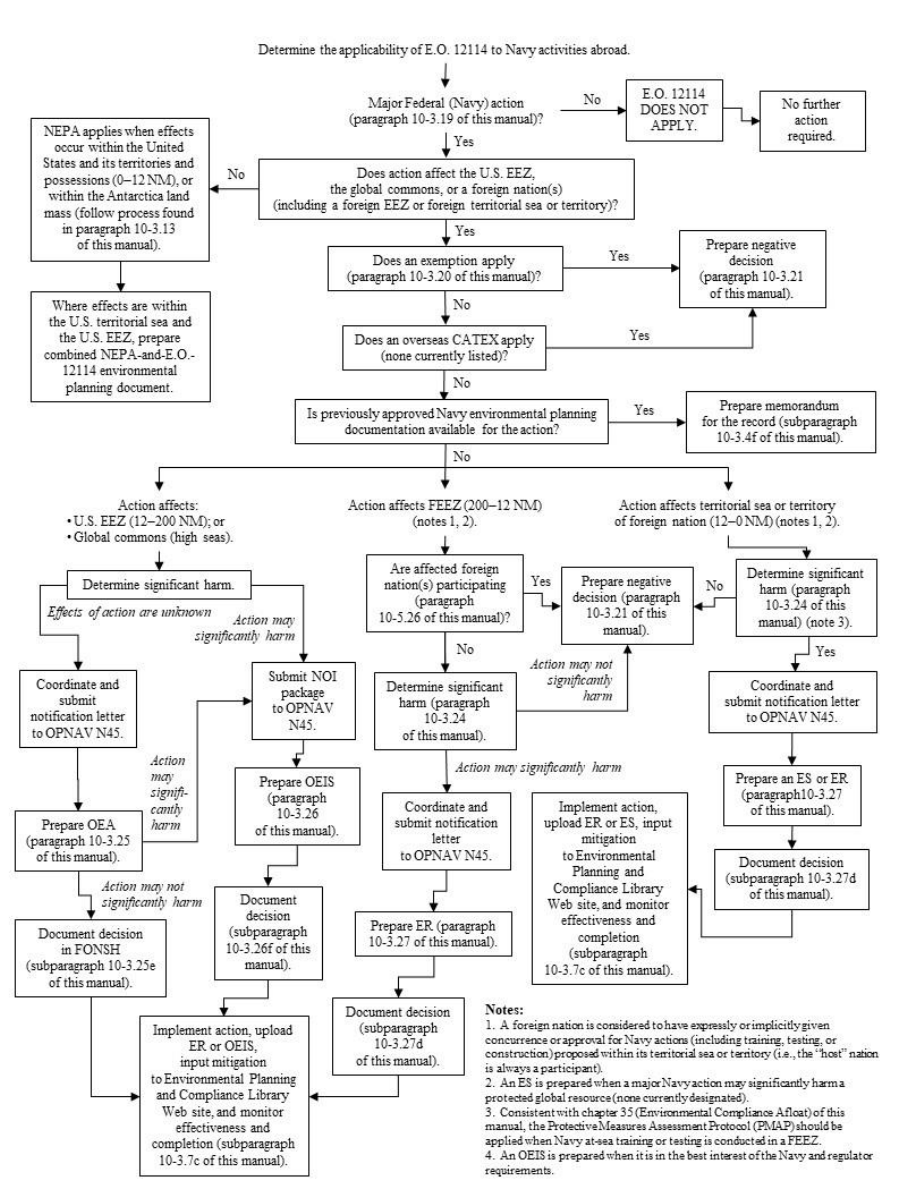
OPNAV M-5090.1
25 Jun 2021
10-78
Figure 10-3. E.O. 12114 Environmental Planning Flowchart for Navy Actions

OPNAV M-5090.1
25 Jun 2021
10-79
10-3.20. Exemptions to the Requirement to Prepare Environmental Documentation Under
Executive Order 12114. Reference (e) establishes several exemptions from E.O. 12114
applicability when a major Navy action would affect a FEEZ, foreign territorial sea, or foreign
territory. A negative decision is the appropriate documentation for reliance on an exemption
(refer to paragraph 10-3.21 of this manual for negative decision requirements).
a. General Exemptions. Reference (e) establishes general exemptions that can be used
without approval from a higher authority. The general exemptions most commonly applicable to
Navy actions are:
(1) Actions that lack any potential to cause significant harm to the environment outside
the United States (refer to paragraph 10-3.24 of this manual for guidance on making a significant
harm determination). To rely on this exemption, an action proponent must be certain that a
proposed action lacks the potential to cause significant harm;
(2) Actions taken or directed by the President or a cabinet officer during armed conflict.
This exemption applies to actions during armed conflict and as long as the armed conflict
continues. Armed conflict includes: a state of war declared by Congress and hostilities for
which Congress has authorized the use of armed force; hostilities or situations for which a report
is prescribed by section 4(a)(1) of the War Powers Resolution (reference (y), section 1543(a)(1));
and other actions by U.S. Armed Forces involving defensive use or introduction of weapons into
situations in which hostilities have occurred or are reasonably expected;
(3) Actions taken or directed by the President or a cabinet officer when national security
or national interests are involved that the Under Secretary of Defense, Acquisition, Technology,
and Logistics (USD(AT&L)) has determined, in writing, to involve national security or national
interest;
(4) Activities applicable to the intelligence components used by the Secretary of Defense
under references (z) and (aa), including the Office of Naval Intelligence;
(5) Activities of the Navy International Programs Office and other activities pertaining to
arms transfer. Arms transfer includes granting, loaning, leasing, exchanging, and selling defense
articles and services to foreign governments or international organizations, and extending or
guaranteeing credit in connection therewith;
(6) Navy participation in disaster and emergency relief, or providing assistance to, relief
efforts; and
(7) Actions involving nuclear activities and nuclear material, excluding actions providing
“nuclear production;” a “utilization facility,” as defined in reference (p), section 2014; or a
“nuclear waste management facility” to a foreign nation.
b. Case-by-Case Exemptions. If a case-by-case exemption applies, the action proponent
must obtain written approval of SECNAV via the chain of command to apply the exemption to
the proposed action. Upon receipt of written approval of SECNAV, the action proponent must

OPNAV M-5090.1
25 Jun 2021
10-80
prepare a negative decision (refer to paragraph 10-3.21 of this manual for negative decision
requirements).
(1) Emergencies. This exemption applies to actions to promote national defense or
security that must be taken without delay and to actions necessary to protect life or property.
SECNAV must report the granting of this exemption to USD(AT&L), who, working through the
Assistant Secretary of Defense for International Security Affairs (ASD(ISA)), must inform and
consult with DOS. For cases within the purview of CEQ, ASN(EI&E) must notify and confer
with CEQ as soon as it is feasible. Immediate actions necessary to either preserve lives or
protect national security assets from imminent danger should not be delayed to accommodate
identified consultation and coordination requirements.
(2) Special Circumstances. National security considerations, exceptional foreign policy
interests, and other special circumstances not identified in the general exemptions listed in
subparagraph 10-3.20a of this manual may preclude or be inconsistent with preparation of
environmental planning documentation. In such cases, SECNAV, with approval of
USD(AT&L), may exempt an action from the environmental planning requirements of
subparagraph 10-3.20a of this manual. Before granting approval, USD(AT&L), working
through ASD(ISA), must consult with DOS and CEQ.
(3) Class Exemptions for Related Actions. At present, there are no class exemptions.
SECNAV, after coordination with other interested DoD components, may submit a request for a
class exemption for groups of related actions to USD(AT&L), who is the approval authority for
exemptions. Working through ASD(ISA), USD(AT&L) must consult with DOS and CEQ on
such requests.
10-3.21. Negative Decision. Negative decisions are prepared and signed by the ICO or his or
her deputy or the PM for a weapons systems acquisition action. As applicable, a negative
decision must include the elements identified in table 10-18 of this manual.
Table 10-18. Elements of a Negative Decision
Element
Action Applicable To
Element (1): Describe or provide a reference to
the proposed action, including its location—
foreign nation, foreign nation’s territorial sea, or
FEEZ.
All negative decisions
Element (2): Identify whether or not the action
is a major Navy action.
All negative decisions
Element (3): Identify how or where the affected
foreign nation (or other foreign nations) is
participating in the action.
When the affected foreign nation is
participating
Element (4): Identify the exemption or overseas
CATEX (none currently listed) being applied.
Include this section only when an
exemption or overseas CATEX applies
(there are currently no approved overseas
CATEXs)

OPNAV M-5090.1
25 Jun 2021
10-81
Element
Action Applicable To
Element (5): Briefly discuss the facts
supporting the negative decision (such as how
the action is exempt from the requirement to
prepare environmental planning documentation
under E.O. 12114; or how the action would not
cause significant harm to the environment of a
FEEZ).
All negative decisions
10-3.22. Executive Order 12114 Categorical Exclusions. At present, there are no approved
CATEXs for use in complying with E.O. 12114. Should CATEXs be established for E.O. 12114
by the Office of the Secretary of Defense (OSD), OPNAV N45 must provide implementing
guidance. Refer to paragraph 10-5.3 of this manual for guidance in submitting recommendations
for establishing a CATEX under E.O. 12114.
10-3.23. Determining the Type of Environmental Planning Documentation Based on Location of
Effects. The appropriate environmental planning documentation that must be prepared for a
proposed major Navy action is determined by where the effects on the physical environment
occur rather than where the action takes place. Table 10-2 of this manual provides a summary of
the appropriate environmental planning documents an action proponent should prepare to
comply with the requirements of E.O. 12114 based on location of effects.
a. Environmental Planning Documentation for Actions Affecting the U.S. EEZ or Global
Commons. An OEA or OEIS is prepared when a major Navy action may significantly harm the
environment of the U.S. EEZ or the global commons (high seas). NEPA and E.O. 12114 hybrid
documents (e.g., EA/OEA, EIS/OEIS) may be prepared depending on the location of effects. An
action proponent may not prepare a hybrid document where one component is a NEPA record of
CATEX. The preparation of an EA/OEA hybrid is appropriate in such circumstances.
b. Environmental Planning Documentation for Actions Affecting a FEEZ
(1) When the affected foreign nation is participating in the major Navy action, the Navy
action proponent prepares a negative decision; and
(2) When the affected foreign nation is not participating in a major Navy action, the
Navy action proponent must first determine if the action will significantly harm the environment
of that nation. If the action proponent determines the action will not significantly harm the
environment of the foreign nation affected by the action, a negative decision is prepared. If the
action proponent determines the action will significantly harm the environment of the affected
foreign nation, an ER must be prepared. Hybrid documents (e.g., OEA/ER, OEIS/ER) must not
be prepared.
c. Environmental Planning Documentation for Actions Affecting a Foreign Nation or
Foreign Territorial Seas. A negative decision is prepared when a major Navy action will not
significantly harm the environment of a foreign nation’s territorial sea or the foreign nation itself.
If the action will significantly harm the environment of the affected foreign nation, an ER or ES

OPNAV M-5090.1
25 Jun 2021
10-82
must be prepared. A foreign nation is always considered a participant in a proposed action that
would occur within its territorial sea or on its territory.
d. Actions Affecting Protected Global Resources. Upon consultation with OPNAV N45, an
ES is prepared when a major Navy action may significantly harm a protected global resource
regardless of whether there is foreign nation participation. There are currently no designated
protected global resources.
10-3.24. Determining Significant Harm
a. Per reference (e), an action significantly affects the environment if it does significant harm
to the environment even though on balance the action may be beneficial.
b. “Significant harm” occurs when the major Navy action will introduce to a foreign nation’s
territory, territorial sea, or EEZ:
(1) A product, or a physical project, that produces a principal product, emission, or
effluent that is prohibited or strictly regulated by Federal law in the United States because its
toxic effects on the environment create a serious public health risk (i.e., a “toxic product”); or
(2) A physical project that is prohibited or strictly regulated in the United States by
Federal law to protect the environment against radioactive substances (i.e., a “radioactive
substance”).
c. Consistent with chapter 35 (Environmental Compliance Afloat) of this manual, the PMAP
should be applied when Navy at-sea training or testing is conducted in a FEEZ.
10-3.25. Overseas Environmental Assessments
a. General. An OEA under E.O. 12114 is an environmental analysis similar to an EA under
NEPA. The objective of an OEA is to document the environmental consequences of a proposed
action, allowing the reviewing authority to determine whether or not the effects of the action will
significantly harm the environment (refer to paragraph 10-5.32 of this manual for the definition
of significantly). If the action will affect the environment in the U.S. EEZ and the global
commons (high seas) (refer to figure 10-1 and table 10-1 of this manual) and the action
proponent does not know beforehand that the effects will result in significant harm to the
environment, the action proponent must prepare an OEA. If the action proponent believes or
knows that the proposed action will result in significant harm to the environment, an OEIS must
be prepared. Figure 10-3 of this manual is a flowchart illustrating the logic flow for determining
the proper E.O. 12114 environmental planning document to prepare.
b. Pre-Planning and Notification
(1) Pre-Planning and Other Procedural Requirements. As applicable, the procedural
requirements indicated in paragraph 10-3.4 of this manual must be followed in the preparation of
OEAs. These requirements include, but are not limited to correct resource regulatory and

OPNAV M-5090.1
25 Jun 2021
10-83
statutory conclusions, inclusion of mitigation measures and their implementation, and the upload
of final environment planning documents to the OPNAV N45 Environmental Planning and
Compliance Library Web site. Additional guidance is provided in subparagraphs 10-3.25c
through 10-3.25e of this manual.
(2) Notification. The pre-planning procedures delineated in subparagraph 10-3.15c of
this manual for an EA should be followed. The contents of the notification for an OEA are
generally the same as for an EA. Note: In the case of an OEA where the proposed action will
affect the U.S. EEZ (12 to 200 NM), the analysis of two reasonable action alternatives is
required, in addition to the no action alternative. If an additional action alternative is not
practical, the notification letter and the OEA must explain in detail the rationale for not including
an additional alternative.
c. OEA Content. The document should be brief and concise. For example, detailed
descriptions of potentially affected species should not be included in the body of the document
(but could be included in appendices depending on the cooperating or reviewing Federal
agencies’ needs). The size of an OEA should be commensurate with the complexity of the
proposed action and may range in size from 10 pages to 150 pages. OEAs should contain
sufficient information and analysis upon which to make a determination on whether it is
reasonably likely that an action will significantly harm the environment. Accordingly, an OEA
must include those core components identified in table 10-19 of this manual.
d. OEA Processing. An OEA must be submitted for review and processing via the chain of
command in the same manner as described for an EA in paragraph 10-3.15 of this manual. An
OEA is an internal Navy document; public participation during its preparation is not required. It
is releasable under reference (bb), subject to restrictions on records that are classified or exempt.
e. Review and Decision
(1) The decision maker for an OEA is the same as identified for an EA in paragraph 10-
3.15 of this manual. After considering the documented potential effects of the proposed action
on the environment, the decision maker must decide whether a FONSH is appropriate using the
same factors as described for a FONSI. If appropriate, he or she must prepare a FONSH.
(2) The inclusion of mitigation measures as part of the proposed action may bring
impacts below the threshold of significance. The action proponent must implement all
mitigation committed to in the FONSH.
(3) The FONSH must conclude with a finding that the proposed action will not
significantly harm the environment and that an OEIS will not be prepared. Within 30 days of
FONSH signature, the mitigation measures committed to in the FONSH must be inputted to the
OPNAV N45 Environmental Planning and Compliance Library Web site using the mitigation
and monitoring tracking tool within the Required Reporting module. This is required for
tracking completion.

OPNAV M-5090.1
25 Jun 2021
10-84
Table 10-19. Core Components of an OEA
1. Description of the proposed action in sufficient detail to allow a reader unfamiliar with it to
understand fully what is proposed, the location of the proposed action, the timing of the action,
and any other pertinent details.
2. Discussion of the purpose of and need for the action.
3. Identification and analysis of alternative means to accomplish the proposed action. For
actions affecting the environment of the U.S. EEZ (12 to 200 NM), the analysis of two
reasonable action alternatives is required, in addition to the no action alternative. If an
additional action alternative is not practical, the notification letter and the OEA must explain
in detail the rationale for not including an additional alternative.
4. Evaluation of potential effects to the natural and physical environment, including, but not
limited to underwater acoustics, water quality, air quality, marine biology, EFH (where
applicable, refer to table 10-1 of this manual), and marine geology.
5. Description of the mitigation measures (planned or taken) to avoid or reduce environmental
effects (may be in a matrix or separate chapter).
6. Identification of the preparers of the document, including their names and areas of
expertise.
7. To substantiate impact analysis and to verify that consultation and coordination have been
completed, inclusion of, as appropriate and preferably in an appendix, associated
correspondence, memos to file, associated e-mails, studies, biological evaluations or
assessments and BOs, permits, and final rules.
10-3.26. Overseas Environmental Impact Statements
a. General. An OEIS under E.O. 12114 is an environmental analysis similar to an EIS under
NEPA. The objective of an OEIS is to document the potential environmental consequences of a
proposed action that may cause significant harm to the environment (refer to paragraph 10-5.32
of this manual for the definition of significant) of the U.S. EEZ and the global commons (high
seas) (refer to figure 10-1 and table 10-1 of this manual).
b. Pre-Planning and Notification
(1) Pre-Planning Process and Other Procedural Requirements. As applicable, the
procedural requirements identified in paragraph 10-3.16 of this manual must be followed in the
preparation of OEISs. These requirements include, but are not limited to, correct regulatory and
statutory conclusions in environmental planning documents, inclusion of mitigation measures
and their implementation, and the upload of final environmental planning documents to the
OPNAV N45 Environmental Planning and Compliance Library Web site.
(2) NOI. The action proponent must notify OPNAV N45, via the chain of command, of
its intent to prepare an OEIS. The contents of the NOI package for an OEIS are generally the
same as for an EIS. OPNAV N45 will coordinate with ASN(EI&E) and then publish the NOI in
the Federal Register.
c. Scoping. There is no requirement for conducting public scoping under E.O. 12114, but
scoping may be appropriate, depending on the magnitude of the environmental effects and the

OPNAV M-5090.1
25 Jun 2021
10-85
need for mitigation, and if there is a potential for public controversy. Such scoping would be
conducted within the United States. If the environment of any foreign nation is potentially
affected, OPNAV N45, per reference (f), will assist the Navy Secretariat in executing any
necessary coordination with the Office of the Secretary of Defense for Policy (OSD-P) and DOS.
d. Draft OEISs
(1) Core Content. The document should consist of concise and analytical (rather than
encyclopedic and descriptive) discussions of the reasonably foreseeable environmental effects of
the proposed action. The core content and format of an OEIS must be the same as identified for
an EIS in table 10-14 of this manual, except that the OEIS must only address the potential effects
to the natural and physical environment as defined in paragraph 10-5.4 of this manual. Content
includes, but is not limited to underwater acoustics, water quality, air quality, marine biology,
EFH (refer to table 10-1 of this manual for EFH applicability), and marine geology. The OEIS
must evaluate reasonably foreseeable significant effects using the best scientific information
available.
(2) Process Timeline. A preliminary draft OEIS V.2 must be submitted to OPNAV N45
via the chain of command as soon as it is available for review. Further information on OEIS
processing following submittal to OPNAV N45 is available in the Reference Materials Library
module of the OPNAV N45 Environmental Planning and Compliance Library Web site.
(3) Distribution and Review. A draft OEIS must be made available for public comment
in the United States. The public comment period must be for a minimum period of 45 calendar
days unless USD(AT&L) determines that, upon a showing of probable important adverse effect
on national security or foreign policy, a lesser period is required. Consideration must be given to
whether any foreign government should be informed of the availability of the document and any
notifications to foreign governments must be coordinated with DOS. OPNAV N45, per
reference (f), will assist the Navy Secretariat in executing any necessary coordination with OSD-
P and DOS.
(a) Once approved by ASN(EI&E) or ASN(RD&A), OPNAV N45 will direct the
action proponent to forward the draft OEIS to CEQ and other interested Federal agencies, as
appropriate. In addition, if the environment of any foreign nation is potentially affected,
OPNAV N45, in conjunction with the Navy Secretariat, will execute any necessary coordination
with OSD-P and DOS.
(b) Public meetings or hearings are not required, but may be held in the United States,
if directed by ASN(EI&E), after consultation with ASD(ISA), DOS, and CEQ. The factors that
must be considered in determining if public meetings or hearings should be held are: foreign
relations sensitivities; whether the meetings or hearings would be an infringement or create the
appearance of infringement on the sovereign responsibilities of another government;
requirements of domestic and foreign governmental confidentiality; requirements of national
security; whether meaningful information could be obtained through hearings; time
considerations; and requirements for commercial confidentiality. There is no requirement that
all of the listed factors be considered when one or more factors indicate public meetings or

OPNAV M-5090.1
25 Jun 2021
10-86
hearings would not produce a substantial net benefit to those responsible for authorizing or
approving the proposed action.
(c) OPNAV N45 will be responsible for the Federal Register publication of the NOA
for the draft OEIS. If a public meeting or hearing is to be held, the Navy action proponent must
prepare a draft notice, which must be combined with the NOA for the draft OEIS, and identify
the schedule for meeting or hearing for cost savings. The action proponent must provide the
draft notice to OPNAV N45 at least 3 weeks in advance of the preferred date of publication in
the Federal Register. The preferred date for publication must take into account the need to
publish the notice in the Federal Register no less than 15 calendar days prior to the first
scheduled meeting or hearing. The date of publication in the Federal Register signifies the first
day of the public comment period.
(d) The action proponent should refer to subparagraph 10-3.16e of this manual for
guidance on procedures for conducting a public meeting or hearing.
e. Final OEISs
(1) The final OEIS must consider, individually or collectively, all substantive comments
received on the draft OEIS. All final OEISs, including drafts submitted for action, concurrence,
or endorsement, must identify the responsible technical and legal points of contact involved in
their preparation and review.
(2) The final OEIS must be made available to the public in the United States. OPNAV
N45 will publish the NOA for the final OEIS in the Federal Register. A draft NOA must be
provided to OPNAV N45 by the action proponent no less than 3 weeks prior to the preferred date
of publication in the Federal Register.
f. Decision
(1) Action proponents must not take any action that would cause or result in significant
harm to the environment or limit choice among reasonable alternatives until a decision document
is signed for the final OEIS. No decision may be made until the later of 90 calendar days after
the draft OEIS has been made available and notice thereof published in the Federal Register, or a
30-calendar-day public review and wait period after the final OEIS has been made available and
notice thereof published in the Federal Register. The 90-day period and the 30-day public
review and wait period may run concurrently. The date of publication in the Federal Register
signifies the first day of the 30-day public review and wait period.
(2) The decision document prepared on the proposed action by ASN(EI&E) or
ASN(RD&A), or their delegated authority, must indicate that the final OEIS has been considered
in the decision-making process. Within 30 days of decision-making, the mitigation measures
committed to in the decision document must be inputted to the OPNAV N45 Environmental
Planning and Compliance Library Web site using the mitigation and monitoring tracking tool
within the Required Reporting module. This is required for tracking completion for subsequent
tracking to completion.

OPNAV M-5090.1
25 Jun 2021
10-87
10-3.27. Environmental Reviews or Environmental Studies
a. Pre-Planning and Notification
(1) Pre-Planning Process and Other Procedural Requirements. Procedural requirements
applicable to E.O. 12114 environmental planning in paragraph 10-3.4 of this manual should be
tailored to and followed in the preparation of ERs or ESs. These requirements include, but are
not limited to correct resource regulatory and statutory conclusions, inclusion of mitigation
measures and their implementation, and the upload of final environmental planning documents to
the OPNAV N45 Environmental Planning and Compliance Library Web site.
(2) Notification
(a) The pre-planning and notification procedures delineated in subparagraph 10-3.15c
of this manual for an EA should be followed. The contents of the notification for an ER or ES
are generally the same as for an EA.
(b) Because an ES is a cooperative, bilateral, or multilateral effort, OPNAV N45
elevates ES notification letters to ASN(EI&E), who will coordinate with OSD-P and DOS.
ASN(EI&E) decides whether to prepare an ES after consultation with ASD(ISA). Once a
decision to prepare an ES has been made, the Navy action proponent must not take any action
that would significantly harm the environment until the ES is completed and approved by
ASN(EI&E).
b. ER or ES Content. The contents of an ER and ES should be commensurate with the
complexity of the proposed action. These documents are intended to be concise surveys of
important environmental issues and effects to be used in the decision-making process.
Generally, an ER must include the core components identified in table 10-20 of this manual.
However, the precise content of an ES must be flexible because of such considerations as the
sensitivity of obtaining information from foreign governments, the availability of useful and
understandable information, and other national security factors.
c. Processing an ER or ES. An ER or ES must be submitted for review, processing, and
decision-making via the chain of command in the same manner as an EA that is submitted for
OPNAV N45 action. ERs and ESs are internal Navy documents; public participation during
their preparation is not required. An ER or ES is releasable under reference (bb), subject to
restrictions on records that are classified or exempt.

OPNAV M-5090.1
25 Jun 2021
10-88
Table 10-20. Core Components of an ER or ES
1. A statement of the action to be taken, including its timetable, physical features, general
operating plan, and other similar broad gauge descriptive factors.
2. Identification of the important environmental issues involved.
3. Description of the aspects of the actions taken or to be taken by the Navy action proponent
that ameliorate or minimize the impact on the environment.
4. Identification of the actions known to have been taken or to be planned by the government
of any participating and affected foreign nations that will affect environmental
considerations.
5. Identification of the preparers of the document, including their names and areas of
expertise.
d. Review and Decision. The decision maker for an ER is OPNAV N45. The decision
maker for an ES is ASN(EI&E). The decision maker will evaluate the analysis prepared for the
proposed action and the proposed mitigation documented in the ES or ER. If appropriate, he or
she will prepare and sign a decision document. There is no follow-on documentation.
10-3.28. Combination National Environmental Policy Act and Executive Order 12114
Environmental Planning Documents
a. As a matter of policy, if both NEPA and E.O. 12114 apply (refer to paragraph 10-1.3 of
this manual), the analyses for both should be combined into a single environmental planning
document (e.g., EA/OEA, EIS/OEIS). However, should the circumstances or nature of the
proposed action warrant it, two separate environmental planning documents may be prepared.
b. In combining analyses, the action proponent must differentiate between NEPA and E.O.
12114 descriptions of the affected environment and the impact analysis so it is clearly
understood which authority applies to the affected environment being assessed and the resources
that are affected. In addition, the action proponent must consider:
(1) Using charts or matrices to identify which authority applies to specific elements of a
proposed action;
(2) Using charts or matrices to identify location of affected resources to assist in
identifying which authority applies to the respective analyses;
(3) Separating sections or paragraphs to set out the respective findings specifically
required by NEPA and E.O. 12114;
(4) Combining the NEPA and E.O. 12114 discussions in a unified paragraph or text,
especially when discussing relevant regulatory permitting, authorization, and consultation
requirements that apply within both NEPA and E.O. 12114 areas of applicability; and
(5) Addressing E.O. 12114 conclusions in the NEPA ROD when a hybrid EIS/OEIS is
prepared.

OPNAV M-5090.1
25 Jun 2021
10-89
10-4 Responsibilities
10-4.1. OPNAV N45 must:
a. Develop and promulgate Navy environmental planning policy guidance, act as resource
and assessment sponsor, and provide oversight of the Navy’s environmental planning program.
This includes development and promulgation of environmental planning document preparation
guides and document templates;
b. Review environmental planning documents submitted for the Navy Secretariat or OPNAV
N45 action to ensure compliance with Navy policy, consistency with Navy-wide environmental
planning practices, and avoidance of adverse Navy-wide precedents. When appropriate,
OPNAV N45 conducts these reviews concurrently with ASN(EI&E) staff and informs
ASN(EI&E) of any potentially controversial planning issues. For EAs prepared in compliance
with NEPA and submitted for OPNAV N45 review, OPNAV N45 will make decisions on
whether a FONSI is appropriate or if an EIS is required. Likewise, for OEAs or ERs prepared in
compliance with E.O. 12114, OPNAV N45 will make decisions on whether an OEIS is required;
c. Bring environmental planning matters that involve controversial issues or that may affect
environmental planning policies or their implementation to the attention of ASN(EI&E) and,
where appropriate, ASN(RD&A) for coordination and determination;
d. Conduct an annual audit of EAs prepared by Navy commands with delegated NEPA and
E.O. 12114 signature authority;
e. Represent the Navy to other U.S. Armed Services, the OSD, CEQ, and other Federal
agencies at the headquarters level regarding environmental planning matters;
f. Coordinate with the Judge Advocate General regarding publication of environmental
planning notices in the Federal Register;
g. Coordinate with the Navy Office of Information for public release of environmental
planning and decision documents; and
h. Coordinate with the Navy OLA regarding Congressional notification of environmental
planning documents.
10-4.2. Budget submitting offices or echelon 2 commands with installation-level
responsibilities, region commanders and ICOs, PEOs, weapons systems acquisition PMs, direct-
reporting PMs, and science and technology PMs with the exception of tenant commands must:
a. Ensure compliance with the requirements of this chapter in matters under their
cognizance;
b. Coordinate with the AEC and REC for all proposed actions that will occur within their
respective AOR;

OPNAV M-5090.1
25 Jun 2021
10-90
c. Plan and program for environmental planning documentation, as applicable, for
anticipated proposed actions;
d. Ensure high-quality environmental planning documents are produced for each proposed
action. Each environmental planning document must be consistent with Navy environmental
policy; rely on a common organizational structure; be based on the best available science; use
understandable, simple, and concise writing so that the public can understand the explanations of
project decisions; and clearly demonstrate compliance with the appropriate regulatory and legal
requirements. Specific Navy QA requirements are addressed in paragraph 10-3.9 of this manual;
e. Ensure funding for and implementation of any mitigation and monitoring requirements
established in environmental planning and decision documents prepared pursuant to NEPA and
E.O. 12114;
f. Plan, program, budget, and ensure training identified in paragraph 10-3.10 of this manual
is obtained by Navy environmental planners;
g. Ensure completed environmental planning documents are uploaded to the OPNAV N45
Environmental Planning and Compliance Library Web site; and
h. As appropriate, comply with required reporting, including submission of an annual
certification, annual program review summary, and mitigation and monitoring reporting.
10-4.3. AECs must:
a. Coordinate and review all Navy mission and operational environmental planning
occurring within their designated AOR; and
b. Ensure all environmental planning documents and related permits, authorization, or
consultations occurring within or affecting their AOR are coordinated with the RECs, as
appropriate.
10-4.4. RECs must:
a. Participate in the preparation of environmental planning documents for proposed actions
that affect resources under their control or issues of concern in their designated AOR; and
b. Coordinate and review environmental planning documents involving actions that affect
resources in their designated AOR.
10-5 Definitions
10-5.1. Action Proponent
a. The action proponent is the commander, CO, ICO, or civilian director of a unit, activity,
or organization who initiates a proposal for action. The general rule is that the action proponent

OPNAV M-5090.1
25 Jun 2021
10-91
is the most junior element in the chain of command that “controls” the entire proposed action.
Where multiple Navy organizations are involved in a proposed action, it is sometimes not
apparent which command should be the lead action proponent. Early discussion among the
participating commands is necessary in these cases to identify the appropriate lead action
proponent. If agreement cannot be reached, the matter must be elevated promptly through their
chains of command to OPNAV N45. Table 10-21 of this manual provides examples where
commands in the past have been action proponents for various types of proposed actions.
b. The action proponent is responsible for coordination during the environmental planning
process with respect to flow of information, document comment, review, concurrence, and
approval and resolution of environmental issues. Coordination between the action proponent and
other interested parties and stakeholders, both internal and external to the Navy, is necessary for
the preparation of accurate, consistent, timely, and cost-effective documentation that supports the
mission of all interested parties and stakeholders. Tenant commands proposing actions at an
installation must follow all environmental guidance of the ICO (refer to chapter 1 (Organization
and Coordination) of this manual).
Table 10-21. Action Proponent Guidance
Proposed Action
Usual Action Proponent
Comments
Actions affecting only one shore
installation (non-mission-specific or
operational issues)
ICO
Could also be Region
Commander
Actions affecting multiple shore
installations in the same region (non-
mission-specific or operational
issues)
CNIC Headquarters or
Region Commander
Supported by ICOs
Homeporting or homebasing
decisions
Fleet commander
Supported by Region
Commander(s)
Major training exercises on or off
established ranges and OPAREAs
(and any other mission-specific or
operational issues)
Fleet commander
Supported by Region
Commander and
numbered fleet
RDT&E, radar, sonar, and other
testing not involving the use of
commissioned vessels
SYSCOMs or PEO
Coordinate with AEC,
numbered fleet, REC,
Region Commander,
and range manager, as
appropriate (refer to
note). A SYSCOM is
the action proponent for
RDT&E conducted on a
SYSCOM range.
RDT&E, sonar, explosives, and
other testing involving the use of
commissioned vessels
Fleet chain of command,
SYSCOMs, or PEO
PEO is normally the
action proponent for
testing largely
independent of fleet
training activity. Fleet

OPNAV M-5090.1
25 Jun 2021
10-92
Proposed Action
Usual Action Proponent
Comments
is normally the action
proponent if RDT&E
testing is a small part of
larger exercise (refer to
note). A SYSCOM is
the action proponent for
RDT&E conducted on a
SYSCOM range.
Artificial reefing
Inactive ships PEO
Supported by Region
Commander
Action involving
COMNAVSPECWARCOM training
Range or property owner
and
COMNAVSPECWARCOM
For actions involving
ranges or property
owned by other Services
(e.g., U.S. Marine
Corps, Army, Air
Force) or other Federal
or State agencies, the
Navy (OPNAV N45)
may be required to co-
sign or sign the decision
document
Action involving
COMNAVSPECWARCOM shore
installation management on Navy
installations or other Navy-owned or
Navy-controlled property
ICO and
COMNAVSPECWARCOM
Supported by Region
Commander
Action involving
COMNAVSPECWARCOM
infrastructure on non-Navy property
COMNAVSPECWARCOM
The Navy (OPNAV
N45) may be required to
sign or co-sign the
decision document
Action involves an action proponent
whose chain of command does not
meet the eligibility requirements for
delegation of FONSI signature
authority
COMNAVSPECWARCOM
The Navy (OPNAV
N45) may be required to
sign or co-sign the
decision document
Key: COMNAVSPECWARCOM=Commander, Naval Special Warfare Command (OPNAV
N45 has not delegated FONSI signature authority to COMNAVSPECWARCOM).
Note: For weapons systems acquisition actions that will result in follow-on homebasing or
homeporting actions or changes to future training, weapons systems acquisition program
offices must coordinate with the affected AEC or REC to ensure the effects of future systems
are properly addressed.
10-5.2. Categorical Exclusion (NEPA). A CATEX is a published category of actions that, under
normal conditions, is excluded from further documentation requirements under NEPA.

OPNAV M-5090.1
25 Jun 2021
10-93
Categorically excluded actions do not individually or cumulatively have a significant effect on
the human environment and have been found to have no such effect in procedures adopted by the
Navy for implementing the CEQ regulations. Also, refer to paragraph 10-5.3 of this manual for
the E.O. 12114 CATEX definition.
10-5.3. Categorical Exclusion (E.O. 12114). An overseas CATEX is a category of actions that
normally do not, individually or cumulatively, do significant harm to the environment.
Commands may develop white papers with recommendations and supporting rationale that, upon
approval by their chains of command, may be submitted to OPNAV N45 and ASN(EI&E) for
consideration and forwarding to USD(AT&L)). USD(AT&L) is the approval authority for
overseas CATEXs. Overseas CATEXs will be published as an addendum to this chapter; at
present, there is none.
10-5.4. Cooperating Agency. A cooperating agency is any Federal agency, other than a lead
agency, that has jurisdiction by law or special expertise concerning any environmental impact
involved in a proposal (or a reasonable alternative) for legislation or other major Federal action
significantly affecting the quality of the human environment. Additionally, a State or local
agency of similar qualifications may, by agreement with the lead agency, become a cooperating
agency or a tribal government when the effects are on a reservation.
10-5.5. Environment (E.O. 12114). Environment means the natural and physical environment
and does not include social, economic, and other environments.
10-5.6. Environmental Assessment (NEPA). An EA is a concise public NEPA document that
briefly provides sufficient evidence and analysis for determining whether to prepare an EIS or a
FONSI, aids in the Navy’s decision-making when no EIS is necessary, or facilitates preparation
of an EIS when one is necessary.
10-5.7. Environmental Impact Statement (NEPA). An EIS is an analysis prepared pursuant to
NEPA for actions with the potential to have a significant impact on the quality of the human
environment or that is potentially controversial in environmental effects. A DEIS requires a
complete and comprehensive analysis of anticipated impacts to the human environment and is
distributed for agency and public review. An FEIS considers and addresses public and agency
comments received on the DEIS.
10-5.8. Environmental Planning. Environmental planning is a systematic process undertaken to
identify, facilitate, and ensure compliance with the substantive and procedural requirements of
NEPA and E.O. 12114 as well as other laws, E.O.s, and regulations of the United States
addressing environmental matters.
10-5.9. Environmental Review (E.O. 12114). Prepared unilaterally by the United States, an ER
is a survey of the environmental issues associated with a major Navy action that may, if
authorized or approved, significantly harm the environment of a foreign nation.
10-5.10. Environmental Study (E.O. 12114). Prepared bilaterally or multilaterally by the United
States and one or more foreign nations or an international body or organization in which the

OPNAV M-5090.1
25 Jun 2021
10-94
United States is a member or participant, an ES informs officials of pertinent environmental
considerations when authorizing or approving certain major Navy actions that do significant
harm to the environment of a foreign nation or to a protected global resource (refer to paragraph
10-5.28 of this manual).
10-5.11. Exclusive Economic Zone. As described and governed by the relevant provisions of
reference (g), an EEZ is an area beyond and adjacent to the territorial sea, subject to the specific
legal regime established in reference (g), part V, and under which the rights and jurisdiction of
the coastal State and the rights and freedoms of other States are governed. An EEZ may not
extend beyond 200 NM from the baseline from which the territorial sea of a foreign nation is
measured per reference (g).
10-5.12. Extraordinary Circumstances. As defined in reference (f), section 775.6, extraordinary
circumstances are those circumstances for which DON has determined that further
environmental analysis may be required because an action normally eligible for a CATEX may
have significant environmental effects.
10-5.13. Final Governing Standards. As defined in reference (i), FGSs are a comprehensive set
of country-specific substantive provisions, typically in the form of technical limitations on
effluents and discharges, or a specific management practice. These environmental requirements
for U.S. shore installations located in foreign nations are prepared per reference (i).
10-5.14. Finding of No Significant Harm. A FONSH is a determination based on an OEA that
presents the factors for a proposed action that, if implemented, would not significantly harm the
natural environment and that an OEIS will not be prepared.
10-5.15. Finding of No Significant Impact. A FONSI is a determination based on an EA and
other factors in the public planning record for a proposed action that, if implemented, would
have no significant impact on the human environment and that an EIS will not be prepared.
10-5.16. Global Commons (High Seas). For purposes of Navy environmental planning, global
commons do not include territorial seas or EEZs as defined in reference (g), part V. This
definition of global commons is consistent with the definition of high seas found in reference (g),
part VII.
10-5.17. Human Environment (NEPA). The human environment is the natural and physical
environment and the relationship of people with that environment.
10-5.18. Impacts (Effects)
a. The definition of impacts as used in this chapter is context sensitive, depending on the
applicability of NEPA or E.O. 12114 to the proposed action. Generally, impacts may include
those resulting from actions, which may have both beneficial and detrimental effects, even if
when on balance the agency believes the effect will be beneficial.

OPNAV M-5090.1
25 Jun 2021
10-95
b. Direct impacts result from an action and occur at the same time and place as the action.
Indirect impacts also result from an action, but occur later in time or at a removed location from
the action, and are reasonably foreseeable. Indirect impacts include, but are not limited to:
(1) Growth-inducing effects;
(2) Effects related to induced changes in the pattern of land use, population density, or
growth rate; and
(3) Related effects on the human environment.
c. Cumulative impacts (NEPA) result from the incremental impact of an action when added
to other past, present, and reasonably foreseeable future actions regardless of what agency
(Federal or non-Federal) or person undertakes such actions. Cumulative impacts can result from
individually minor but collectively significant actions taking place over time.
10-5.19. Lead Agency. The lead agency is the Federal agency preparing or having the primary
responsibility for environmental planning documentation for major Navy actions. If the Navy is
the lead agency, it will be responsible for conducting the required environmental planning as set
forth in this chapter. If another Federal agency is the lead agency, the Navy must support the
lead agency to the extent reasonable. When it is desirable to do so, two or more agencies may
exercise a joint lead. These factors should be used in determining the appropriate lead agency
jurisdiction:
a. The magnitude of each agency’s involvement in the proposed action;
b. The authority of each agency to approve (or disapprove) the undertaking of the proposed
action;
c. The expert technical capabilities of each agency regarding the reasonably foreseeable
effects of the proposed action;
d. The duration of each agency’s involvement in the proposed action; and
e. The sequence of each agency’s involvement.
10-5.20. Memorandum of Legal Sufficiency. A memorandum of legal sufficiency is a
memorandum signed or endorsed by a legal advisor for the action proponent documenting the
results of a legal review of an environmental planning document. The memorandum identifies
any legal issues inherent in the proposed action and their resolution, discusses any aspects of the
proposed action that may be considered controversial or sensitive, and assesses the risk of
litigation relating to the proposed action. The memorandum must be marked and handled as
protected under the attorney-client privilege.
10-5.21. Memorandum for the Record. An MFR is prepared when an action proponent relies on
previously approved NEPA and E.O. 12114 environmental planning documentation and

OPNAV M-5090.1
25 Jun 2021
10-96
regulatory consultation and coordination for a proposed action. An MFR describes the proposed
action and briefly discusses the supporting facts.
10-5.22. Mitigation. Mitigation includes measures identified in environmental planning
documents that reduce the severity or intensity of adverse impacts of a proposed action. Such
measures may include:
a. Avoiding the impact altogether by not taking a certain action, or parts of an action, or by
moving the project location;
b. Minimizing the impact by limiting the degree or magnitude of the action and its
implementation, for example, by adjusting site layout;
c. Rectifying the impact by repairing, rehabilitating, or restoring the affected environment;
d. Reducing or eliminating the impact over time by monitoring for the maintenance,
replacement, or both, of equipment or structures so that future environmental degradation due to
equipment or structural failure does not occur during the life of the action; and
e. Compensating for the impact by replacing or providing substitute resources or
environments.
BMPs or SOPs are not considered mitigation measures for the purposes of tracking and
reporting.
10-5.23. Negative Decision. A negative decision is a document prepared when a determination
has been made that the proposed action is exempt from the environmental planning requirements
of E.O. 12114 or when the proposed action does not trigger the need to prepare an ER or ES.
10-5.24. Notice of Intent. An NOI is a required notice published in the Federal Register
formally announcing the Navy’s intent to prepare an EIS under NEPA or E.O. 12114. The NOI
formally opens the public scoping process and usually, though not required, provides information
regarding public scoping meetings to be held. Public scoping is not normally conducted for an
OEIS prepared under E.O. 12114, but may be appropriate depending on the reason for the OEIS
and if U.S. public interest is indicated.
10-5.25. Overseas Environmental Assessment (E.O. 12114). An OEA is an environmental
planning document that contains a concise analysis of the environmental consequences of a
proposed action. The Navy action proponent uses an OEA to assist in determining whether
implementation of a major Navy action may cause significant environmental harm in the U.S.
EEZ or the global commons (high seas), thereby requiring preparation of an OEIS.
10-5.26. Overseas Environmental Impact Statement (E.O. 12114). An OEIS is an
environmental planning document that contains an analysis of the likely environmental
consequences of the proposed major Navy action that may cause significant environmental harm
in the U.S. EEZ or the global commons (high seas).

OPNAV M-5090.1
25 Jun 2021
10-97
10-5.27. Participating or Otherwise Involved Nation. A participating or otherwise involved
nation is a foreign nation whose government has expressly or implicitly given its approval of or
concurrence with U.S. actions within its EEZ, territorial sea, or territory. Approval may be
expressed by the conferring of rights upon the United States in a SOFA, or by some other
affirmative statement by the foreign nation’s political leadership or a defense official. A foreign
nation may also be considered participating or otherwise involved when its government
sponsors, controls, or otherwise has knowledge of a coordinated military exercise or research and
development effort in which the United States is also a participant.
10-5.28. Protected Global Resource. A protected global resource is a natural or ecological
resource of global importance designated for protection by the President or such a resource as
designated by the Secretary of State per international agreement binding in the United States.
There are currently no protected global natural or ecological resources designated by either the
President or the Secretary of State.
10-5.29. Record of Categorical Exclusion. The record of CATEX documents an action
proponent’s decision that a proposed action may be appropriately categorically excluded from
the requirement to prepare an EA or EIS. The record of CATEX is signed by the action
proponent or ICO or his or her designee, or the PM or designee for a weapons systems
acquisition action.
10-5.30. Record of Decision. The ROD is a decision document signed by an appropriate DON
official completing an EIS. ASN(EI&E) is the appropriate official to sign RODs for DON
except for weapons systems acquisition actions per reference (a) for which the ASN(RD&A) has
cognizance.
10-5.31. Scoping. Scoping is an early and open process used to determine the scope of issues to
be addressed and to identify the significant issues to be analyzed in depth and the range of
alternatives to be considered in a NEPA document. Scoping begins as soon as practicable after
the decision to prepare an EIS is made.
10-5.32. Significant(ly). “Significant(ly),” as used in NEPA and E.O. 12114 (the latter for
actions in the U.S. EEZ and global commons), requires consideration of both context and
intensity of the environmental effects of an action (reference (c), section 1508.27 contains the
complete definition). Factors that action proponents should also consider in evaluating an
action’s significance are:
a. The geographic extent of the action;
b. The duration of the action’s effects;
c. The risk of controversial or highly uncertain or unique and unknown environmental
impacts;
d. Whether the action is related to other actions with individually insignificant but
cumulative significant impacts; and

OPNAV M-5090.1
25 Jun 2021
10-98
e. Whether the action threatens a violation of Federal, State, or local laws and regulations.
10-5.33. Statement of Technical Review. A statement of technical review is a verification that
the environmental planning document has received internal Navy review by appropriate SMEs.
The form is OPNAV 5090/3 (Sep 2010) and can be found at Naval Forms Online (refer to
appendix E (Web Sites) of this manual for Web site address and appendix F (Forms and Reports)
of this manual). The completed statement of technical review is not a substitute for obtaining
proper organizational endorsements. In-house staff should be used to verify the technical
sufficiency of the document, based on their technical expertise.
10-5.34. Territorial Sea. Every nation has the right to establish the breadth of its territorial sea
up to a limit not exceeding 12 NM measured from baselines determined per reference (g). The
United States claims a 12-NM territorial sea.
10-5.35. United States. The United States are the 50 States, the District of Columbia, the
territories and possessions of the United States, and all waters and airspace subject to the
territorial jurisdiction of the United States. As of the publication of this chapter, territories and
possessions of the United States include American Samoa, Baker Island, Guam, Howland Island,
Jarvis Island, Johnston Atoll, Kingman Reef, Midway Island, Navassa Island, the
Commonwealth of the Northern Mariana Islands, Palmyra Atoll, the Commonwealth of Puerto
Rico, the U.S. Virgin Islands, and Wake Island.

OPNAV M-5090.1
25 Jun 2021
12-1
CHAPTER 12
NATURAL RESOURCES CONSERVATION
Table of Contents
12-1 Scope .................................................................................................................................12-1
12-1.1. Related Chapters ......................................................................................................12-1
12-1.2. References................................................................................................................12-2
12-2 Legislation ..........................................................................................................................12-5
12-3 Requirements .....................................................................................................................12-6
12-3.1. Joint Bases ...............................................................................................................12-6
12-3.2. Program Goals .........................................................................................................12-6
12-3.3. Ecosystem Management and Climate Resilience ...................................................12-7
12-3.4. Integrated Natural Resources Management Plans ..................................................12-8
12-3.5. Fish and Wildlife Resources ...................................................................................12-13
12-3.6. Marine Mammals and Special Marine and Aquatic Resources .............................12-15
12-3.7. Federally Threatened and Endangered Species ......................................................12-21
12-3.8. Land and Watershed Management .........................................................................12-25
12-3.9. Invasive Species ......................................................................................................12-29
12-3.10. Outdoor Recreation ...............................................................................................12-30
12-3.11. Mitigation for Impacts to Natural Resources ......................................................12-31
12-3.12. Integrating Natural Resources Conservation with the Other Navy Mission
Activities ................................................................................................................12-34
12-3.13. Miscellaneous ........................................................................................................12-35
12-3.14. Funding ..................................................................................................................12-37
12-3.15. Training Requirements ..........................................................................................12-37
12-4 Responsibilities ..................................................................................................................12-38
12-5 Definitions ..........................................................................................................................12-42
12-1 Scope. This chapter establishes Navy policy guidance and requirements to ensure
sustainable military readiness through compliance with all applicable laws and regulations
related to the conservation of natural resources in the United States and its territories and
possessions, and on the high seas.
12-1.1. Related Chapters. Due to the interdisciplinary nature of the natural resources
conservation (NRC) program, personnel should also refer to other chapters in this manual,
specifically chapter 2 (Funding), chapter 10 (Environmental Planning Under the National
Environmental Policy Act and Executive Order 12114) policies and requirements, chapter 13
(Cultural Resources Compliance and Management), chapter 14 (Coastal Zone Management),
chapter 24 (Pesticide Compliance Ashore), chapter 34 (Overseas Environmental Compliance
Ashore), chapter 41 (Natural Resource Damage), and chapter 42 (Environmental Restoration).

OPNAV M-5090.1
25 Jun 2021
12-2
12-1.2. References
(a) SECNAVINST 5090.8B, Policy for Environmental Protection, Natural Resources, and
Cultural Resources Programs;
(b) 16 U.S.C.;
(c) DoD Initial Guidance for BRAC 2005 Joint Basing Implementation, 22 January 2008;
(d) DoD Instruction 4715.03 of 18 March 2011, Natural Resources Conservation Program;
(e) DoD Manual 4715.03, Integrated Natural Resources Management Plan (INRMP)
Implementation Manual, 25 November 2013;
(f) SECNAV memo of 25 Oct 02, New Guidance on the Sikes Act Improvement
Amendments and Supplemental Guidance;
(g) 65 FR 62566, Unified Federal Policy for a Watershed Approach to Federal Land and
Resource Management;
(h) E.O. 13352, Facilitation of Cooperative Conservation;
(i) Integrated Natural Resources Management Plan Guidance for Navy Installations, of 10
April 2006;
(j) Memorandum of Understanding (MOU) Among the U.S. Department of Defense and U.S.
Fish and Wildlife Service and the International Association of Fish and Wildlife Agencies for a
Cooperative Integrated Natural Resources Management Program on Military Installations, of 29
Jul 13;
(k) DON OGC memo of 28 Jul 10;
(l) DoDD 3210.06, Defense Grant and Agreement Regulatory System (DGARS), of 6
February 2014;
(m) 10 U.S.C.;
(n) DoD Instruction 1100.21 of 11 March 2002, Voluntary Services in the Department of
Defense;
(o) OPNAVINST 5380.1D, Acceptance and Use of Voluntary Services in the Navy;
(p) DoD Instruction 8130.01 of 9 April 2015, Installation Geospatial Information and
Services (IGI&S);
OPNAV M-5090.1
25 Jun 2021
12-3
(q) SECNAV memo of 19 Jan 01, Implementation Guidance for Executive Order on
Protection of Migratory Birds;
(r) E.O. 13186, Responsibilities of Federal Agencies to Protect Migratory Birds;
(s) Memorandum of Understanding (MOU) Between the U.S. Department of Defense and the
U.S. Fish and Wildlife Service to Promote the Conservation of Migratory Birds, of 10 Jul 14;
(t) 50 CFR;
(u) UNDERSECNAV memo of 28 Dec 00, Compliance with Environmental Requirements in
the Conduct of Naval Exercises or Training At Sea (At Sea Policy);
(v) CNO memo of 9 Apr 12, Naval Undersea Warfare Center, Division Newport Roles and
Responsibilities as the Center of Excellence for Navy Acoustic Modeling;
(w) E.O. 13089, Coral Reef Protection;
(x) Department of Defense Coral Reef Protection Implementation Plan, of November 2000;
(y) CNO memo Ser N45D/8U589139 of 4 Dec 98, Coral Reef Protection Policy;
(z) OPNAV ltr 5090 Ser N456M/11U1588080 of 22 Mar 11, Essential Fish Habitat
Assessments and Consultations;
(aa) E.O. 13158, Marine Protected Areas;
(bb) CNO memo 5090 Ser N456N/3U574746 of 25 Jul 03, Section 7 Consultation
Procedures Under the Endangered Species Act;
(cc) SECNAV memo of 25 Nov 02, Policy Guidance for Endangered Species Actions;
(dd) 33 CFR Parts 320–330;
(ee) 40 CFR Part 230 and 33 CFR Parts 325 and 332;
(ff) E.O. 11990, Protection of Wetlands, as amended by E.O. 12608, Elimination of
Unnecessary Executive Orders and Technical Amendments to Others;
(gg) E.O. 11988, Floodplain Management;
(hh) E.O. 13834, Efficient Federal Operations;
(ii) 7 U.S.C. §136;
OPNAV M-5090.1
25 Jun 2021
12-4
(jj) COMNAVFACENGCOM memo of 2 Jul 96, Guidelines for Establishment of Ecological
Areas;
(kk) COMNAVFACENGCOM, Real Estate Operations and Natural Resources Management
Procedural Manual NAVFAC P-73 Volume II, of 30 September 2001;
(ll) DoD 7000.14-R, Financial Management Regulation Volume 11A, chapter 16, August
2002;
(mm) Navy Comptroller (NAVCOMPT) Manual Volume 3 (NOTAL), 1996;
(nn) Public Law 108–198, Forest Resources Conservation and Shortage Relief Act of 1990;
(oo) Memorandum of Agreement (MOA) Between the United States Department of
Agriculture and the United States Department of Defense for the Conduct of Forest Insect and
Disease Suppression on Lands Administered by the U.S. Department of Defense, 11 Dec 90;
(pp) E.O. 13112, Invasive Species, as amended by E.O. 13751, Safeguarding the Nation from
the Impacts of Invasive Species;
(qq) Public Law 104–332, National Invasive Species Act of 1996;
(rr) DoD Instruction 6055.06 of 21 December 2006, DoD Fire and Emergency Services
(F&ES) Program;
(ss) SECNAVINST 6401.1B, Veterinary Health Services;
(tt) CNO memo 5090 Ser N456M/1U595820 of 10 Jan 02, Policy Letter Preventing Feral Cat
and Dog Populations on Navy Property;
(uu) SECNAV memo of 15 Aug 02, Access to Outdoor Recreation Programs on Military
Installations for Persons with Disabilities;
(vv) Public Law 109–364, John Warner National Defense Authorization Act for Fiscal Year
2007;
(ww) Presidential Memorandum of 16 April 2010, A 21
st
Century Strategy for America’s
Great Outdoors;
(xx) DoD Manual 6055.09, DoD Ammunition and Explosives Safety Standards, 29 February
2008;
(yy) E.O. 11644, Use of Off-Road Vehicles on Public Lands, as amended by E.O. 11989,
Off-Road Vehicles on Public Lands;
(zz) E.O. 13443, Facilitation of Hunting Heritage and Wildlife Conservation;

OPNAV M-5090.1
25 Jun 2021
12-5
(aaa) E.O. 12962, Recreational Fisheries, as amended by E.O. 13474, Amendments to
Executive Order 12962;
(bbb) U.S. Fish and Wildlife Service and National Marine Fisheries Service Consultation
Handbook of March 1998, Procedures for Conducting Consultation and Conference Activities
Under Section 7 of the Endangered Species Act;
(ccc) 40 CFR 230.9;
(ddd) U.S. Fish and Wildlife Service memo of 02 May 03, Guidance for the Establishment,
Use, and Operation of Conservation Banks;
(eee) OPNAVINST 11010.40, Encroachment Management Program;
(fff) DoD Instruction 5525.17 of 17 October 2013, Conservation Law Enforcement Program
(CLEP);
(ggg) Public Law 111–11, Omnibus Public Land Management Act; and
(hhh) Public Law 107–314, Bob Stump National Defense Authorization Act for Fiscal Year
2003.
12-2 Legislation
a. Legislation that contains provisions pertaining to the protection, conservation,
management, and rehabilitation of natural resources includes:
(1) Bald and Golden Eagle Protection Act, 16 U.S.C. §668–668d;
(2) Clean Water Act (CWA) (Federal Water Pollution Control Act), 33 U.S.C. §1251–
1387;
(3) Coastal Barrier Resources Act, 16 U.S.C. §3501–3510;
(4) Endangered Species Act (ESA), 16 U.S.C. §1531–1544;
(5) Fish and Wildlife Coordination Act, 16 U.S.C. §661–667e;
(6) Magnuson-Stevens Fishery Conservation and Management Act (MSFCMA), 16
U.S.C. §1801–1884;
(7) Marine Mammal Protection Act (MMPA), 16 U.S.C. §1361, 1362, 1371–1389, 1401–
1407, 1411–1418, 1421–1423h;
(8) Migratory Bird Treaty Act (MBTA), 16 U.S.C. §703–712;

OPNAV M-5090.1
25 Jun 2021
12-6
(9) Sikes Act (Conservation Programs on Military Installations), 16 U.S.C. §670a–670o;
and
(10) National Marine Sanctuaries Act, 16. U.S.C. §1431–1445c.
b. A summary of this legislation is included in appendix A (Summary of Major Legislation,
Regulations, Executive Orders, and International Agreements). In addition, several laws including
the Anti-Deficiency Act, Coastal Zone Management Act, Forest Resources Conservation and
Shortage Relief Act, Migratory Bird Treaty Reform Act, and Soil Conservation and Domestic
Allotment Act contain provisions that affect NRC practices. All conservation laws are listed in
Title 16, U.S. Code, and can be found at the U.S. Government Publishing Office United States
Code Web site (refer to appendix E (Web Sites) for Web site address).
12-3 Requirements
a. The Navy’s mission is to maintain, train, and equip combat-ready naval forces capable of
winning wars, deterring aggression, and maintaining freedom of the seas. This chapter
establishes the requirements for maintaining the health and long-term ecological integrity of the
environment while ensuring the continued availability of the land, air, and sea space necessary
for the readiness of the operating forces and the shore support of the Navy.
b. The Navy has responsibilities for the stewardship of natural resources on land and at sea
(reference (a)). In addition to compliance with all appropriate environmental laws and
regulations, the Navy has a mandate to implement a program for the conservation of natural
resources (reference (b), sections 670a–f) on lands and in near-shore areas that are either titled to
the Navy or are under Navy access control. For activities at sea, the Navy is committed to
ensuring compliance with all appropriate laws and regulations and being a responsible steward of
marine resources.
c. Professionally trained natural resources managers must be assigned the responsibility of
implementing these requirements.
12-3.1. Joint Bases. NRC must be conducted by the supporting or supported command per the
joint base agreement (reference (c)).
12-3.2. Program Goals. To ensure the success of the NRC program:
a. Integrate NRC responsibilities with military activities, installation planning and
programming, and other activities as appropriate to ensure no net loss to the Navy mission;
b. Ensure sustainable multipurpose use of the resources and public access when consistent
with the mission, safety, and security requirements; and
c. Ensure NRC program requirements are implemented by or coordinated with
professionally trained natural resources managers.

OPNAV M-5090.1
25 Jun 2021
12-7
12-3.3. Ecosystem Management and Climate Resilience. Ecosystems are functioning units of
nature consisting of complex networks of relationships between land, water, and living
resources. Ecosystems are subjected to various stressors ranging from human impacts to
climate-related factors, and as such, need to be managed in a way that allows for mitigation,
adaptation, and long-term sustainability on a regional basis.
a. Ecosystem-Based Management. Ecosystem principles must be applied to all aspects of
the Navy’s NRC program to the extent practicable (reference (d)) and in ways that optimally
support the Navy mission. Ecosystem-based management includes, but is not limited to these
main principles:
(1) A shift from single-species to multiple-species conservation;
(2) Formation of partnerships necessary to consider and manage ecosystems that cross
installation boundaries; and
(3) Use of the best available scientific information and scientifically sound strategies for
adaptive management.
b. Climate Resilience. Climate resilience should be integrated into the Navy’s NRC
program in practical ways that support informed decisions about climate-related threats.
Adaptation consists of actions that enable species and ecosystems to better cope with changing
environmental conditions, and resilience is achieved when natural resources managers identify
and implement NRC strategies that strengthen ecosystem function.
(1) Identification and assessment of climate effects requires an environmental baseline
and subsequent monitoring designed to evaluate whether shifts in ecosystem form and function
are caused by climate-related factors or other stressors on the landscape. This must be
accomplished by ensuring monitoring efforts are “climate-informed.” For example, where
breeding seasons are an important constraint on mission activities, monitoring programs should
be evaluated and modified to ensure that impacts that may be related to climatic factors are
detected. The ability to determine whether species and ecosystems effects are driven by natural
variability, mission activities, or climatic factors is anticipated to be highly valuable in crafting
avoidance, minimization, compensatory mitigation, and adaptive management strategies. The
purpose of climate-informed monitoring is to reduce climate-related uncertainties associated with
the management of natural resources toward specific goals and objectives.
(2) Scale is also an important consideration in climate-related effects assessment,
monitoring, and adaptation planning. Climate vulnerability and resiliency assessments may
guide essential monitoring requirements and planning for adaptive management. However, the
abundance and distribution of species and habitats on Navy properties may be too small in scale
to address climate-related effects, and as such, installation-specific climate vulnerability and
resiliency assessments may not be appropriate. Natural resources managers are encouraged to
seek and use regional climate-related assessments and adaptation strategies to guide the
monitoring and management of installation natural resources.

OPNAV M-5090.1
25 Jun 2021
12-8
12-3.4. Integrated Natural Resources Management Plans. Reference (b), sections 670a–f, and
reference (d) require all military departments to prepare and implement comprehensive
integrated natural resources management plans (INRMP) for each military installation with
significant natural resources.
a. Evaluation of Need
(1) Commander, Navy Installations Command (CNIC) and any other budget submitting
offices (BSO) responsible for Navy Class I property must determine if an INRMP is required for
those properties. This includes all sites, special areas, and properties assigned to an installation
in the Internet Naval Facilities Assets Data Store (iNFADS), and all other lands assigned to an
installation by lease (including lands used by tenants), withdrawal, permit, or otherwise in the
control of the Navy (references (d), (e), and (f) or the most current guidance). The determination
must be based upon the presence of significant natural resources as defined in reference (d).
(2) An INRMP must be prepared for an installation when one or more of its assigned
properties have significant natural resources. When an INRMP is prepared for an installation, all
properties assigned to that installation must be described, including those assigned properties that
may not have significant natural resources. The status of all properties should be reviewed
periodically to determine whether the INRMP needs to be updated or revised to address new or
altered conditions or uses of those properties. If a specific installation’s sites, special areas, or
properties have unique resources or special circumstances, a separate INRMP can be developed,
but that INRMP should be referenced in the INRMP for the main installation.
(3) An INRMP is not required if it is determined that none of an installation’s assigned
properties has significant natural resources (references (e) and (f)). The BSO must provide
documentation of this determination to the Office of the Chief of Naval Operations, Energy and
Environmental Readiness Division (OPNAV N45) for review and approval. The BSO must
reevaluate these determinations every 5 years.
b. Near-Shore Areas
(1) Reference (b), sections 670a–f requires INRMPs for military installations. Many
Navy installations abut significant bodies of water, and the status of natural resources in near-
shore areas can become an encumbrance to waterfront mission activities if stewardship of these
areas is ignored. Navy INRMPs must, therefore, address installation watersheds, shorelines, and
near-shore areas such that conservation benefits are provided to aquatic species and habitats in
waters adjacent to Navy installations (reference (g).
(2) INRMPs must also address Federal regulatory requirements (e.g., ESA, MSFCMA) in
near-shore areas and should include actions developed in support of cooperative conservation
initiatives and other partnerships (reference (h)) with local natural resources agencies or other
stakeholders.

OPNAV M-5090.1
25 Jun 2021
12-9
c. INRMP Preparation and Implementation. Professionally trained installation natural
resources managers must ensure Navy INRMPs are updated, implemented, and kept compliant
per requirements of reference (e).
(1) INRMPs and Critical Habitat Designations. Natural resources managers must ensure
INRMPs are prepared and implemented using scientific principles of ecosystem management to
the maximum extent practicable, and in a manner consistent with the military mission, to
preclude designations of critical habitat under the ESA. INRMPs should have detailed
descriptions of the conservation practices being implemented to provide special management and
protection to listed species and specifically articulate how implementation of the INRMP
provides a conservation benefit to the species, provide certainty that INRMP actions will be
implemented (per the Anti-Deficiency Act), and provide certainty that the conservation effort
will be effective.
(2) Format and Required Plan Elements. Navy INRMPs must contain the information
outlined in references (d) and (e) and formatted per reference (i) or the most current guidance.
(3) Cooperative Preparation
(a) Reference (b), sections 670a–f require preparation of an INRMP in cooperation
with the U.S. Fish and Wildlife Service (USFWS) and the appropriate State fish and wildlife
agency. The process for engaging USFWS and the State fish and wildlife agencies is outlined in
reference (e). The INRMP and subsequent revisions must reflect mutual agreement of USFWS
and the State fish and wildlife agencies concerning the conservation of the natural resources
under their respective legal authorities (reference (j) or most recent memorandum of
understanding (MOU)). Mutual agreement on the INRMP by Navy, USFWS, and State officials
must be documented by signatures of the appropriate official on the title pages of the INRMP,
which can be accompanied by letters of endorsement attached to the INRMP.
(b) While cooperative preparation with the National Oceanic and Atmospheric
Administration (NOAA) National Marine Fisheries Service (NMFS) is not required by reference
(b), sections 670a–f, cooperative preparation with NMFS is appropriate and should be a priority
at installations adjacent to river, bay, and ocean waters when the near-shore environment will
benefit from INRMP implementation. NMFS will take INRMPs into consideration when
making critical habitat determinations for listed species under their jurisdiction and when critical
habitat exclusions in the near-shore environment may be necessary to support the installation
mission. Mutual agreement by NMFS is not required to complete an INRMP. While it must be
sought when appropriate, failing to obtain mutual agreement by NMFS must not be considered
an impediment to finalizing or implementing an INRMP.
(4) Coordination and Review
(a) Coordination with internal Navy stakeholders, including those responsible for
military readiness and shore support activities, is especially critical during preparation, updates,
or revision of the INRMP (reference (i)).

OPNAV M-5090.1
25 Jun 2021
12-10
(b) Federally recognized Indian tribes, Alaska Native entities, and Native Hawaiian
organizations must be given opportunity to consult on the development, updates, and revisions of
INRMPs where treaty rights, sacred sites, burial sites, or other rights to natural resources may be
affected by implementation of the INRMP (reference (d)).
(c) Natural resources managers also are encouraged to work with other organizations
and agencies both on and off the installation throughout the planning, development, update, and
revision processes. Building partnerships with the right organization(s) is essential for
ecosystem management.
(d) Draft INRMPs must be provided to CNIC via the chain of command for review
and approval before final Navy endorsement.
(5) Public Involvement. Per reference (e), each installation must provide an opportunity
for the public to comment on the initial draft final INRMP, or the draft of a revision that requires
National Environmental Policy Act (NEPA) analysis (see subparagraph 12-3.4c(6) of this
manual). Public comments must be obtained through the NEPA process if an environmental
assessment (EA) or environmental impact statement (EIS) is required. Specific funding
information in the INRMP’s implementation table and other sensitive information must be
removed from the INRMP prior to public release (reference (e)). Each installation must allow
USFWS and the appropriate State fish and wildlife agency officials to review all public
comments to ensure proper consideration of public concerns during INRMP development.
Public opportunity to review a revised or updated INRMP is not required if INRMP
implementation can be categorically excluded from further NEPA analysis (reference (e)).
(6) National Environmental Policy Act
(a) NEPA analyses are required before approval of all new INRMPs. INRMPs
generally provide for beneficial effects on the environment and, in such cases, an EA will suffice
(refer to chapter 10 (Environmental Planning Under the National Environmental Policy Act and
Executive Order 12114), table 10-8 of this manual). Chapter 10 (Environmental Planning Under
the National Environmental Policy Act and Executive Order 12114) of this manual provides
general guidance for preparing NEPA documents for INRMPs. References (e) and (i) (or the
most current guidance) also contain guidelines for preparing NEPA documents for INRMPs.
(b) In most cases the original INRMP NEPA analysis will cover an INRMP’s
updates. A new NEPA analysis, however, may be necessary if an extensive revision of the plan
is required due to significant changes in land ownership, land uses, installation mission, or any
change that results in environmental effects not previously considered (reference (e)). Navy
funds may not be used to pay other Federal agencies (i.e., USFWS and NMFS) or State fish and
game agencies to review NEPA documents (reference (k)).
(7) Navy Endorsement
(a) The INRMP title page must include a signature block for the installation
commanding officer (ICO) and commanding officers (CO) of hosted commands on joint bases

OPNAV M-5090.1
25 Jun 2021
12-11
where Navy is the hosting command, as a reflection of concurrence and acceptance of the
INRMP. Where a joint base is officially designated as “regional,” the INRMP must be signed by
the regional commander as well as the individual ICOs. The INRMP should also be signed by
the INRMP manager appointed by the ICOs as acknowledgement that the INRMP meets the
installation’s conservation goals developed in cooperation with USFWS, the State fish and
wildlife agency, and NMFS where appropriate.
(b) INRMPs can only be signed by Navy officials after obtaining CNIC concurrence
and a finding of no significant impact or a record of decision on the INRMP’s NEPA analysis.
Documentation of all endorsements must be uploaded to the Navy Conservation Web site (refer
to paragraph 12-3.13 of this manual for a description of the Web site and appendix E (Web Sites)
of this manual for Web site address).
(8) Compliant INRMPs
(a) INRMPS are considered compliant when all Navy endorsements, documentation
of mutual agreement with USFWS and appropriate State fish and wildlife agency, and a
documented review of operation and effect occur at least once every 5 years (reference (j)).
Mutual agreement is based on elements of the INRMP within the scope of USFWS’ and State
fish and wildlife agency’s authorities, i.e., the conservation and management of the installation’s
natural resources (reference (e)).
(b) A Navy-endorsed INRMP may be implemented (i.e., operational) without mutual
agreement from USFWS or the State fish and wildlife agency only if: (1) a delay in the
cooperative preparation process is documented as outlined in reference (e), or (2) the agency has
objections based on the military mission of the installation and the Sikes Act’s provision for no
net loss to capability of the installation lands to support the installation’s military mission. As
operational INRMPs are technically not compliant INRMPs, all efforts must continue to obtain
mutual agreement or endorsement from the other agencies.
(c) An electronic copy of each completed INRMP must be submitted via the chain of
command to CNIC. Electronic copies of all INRMPs and associated signature pages, regulatory
partner concurrence documentation, and NEPA documentation must be uploaded to the Navy
Conservation Web site and the OPNAV N45 Environmental Planning and Compliance Library
Web site (refer to chapter 10 (Environmental Planning Under the National Environmental Policy
Act and Executive Order 12114) of this manual for a description of the Web site and appendix E
(Web Sites) of this manual for Web site address).
(9) Implementation
(a) All INRMPs must be implemented per reference (e) and supplemental policy
memos issued by the Office of the Secretary of Defense (OSD) (refer to appendix E (Web Sites)
of this manual for DoD natural-resources-related Web site addresses).
(b) All INRMP actions and projects must be entered into the Environmental
Readiness Program Requirements Web (EPRWeb) (refer to appendix E (Web Sites) of this

OPNAV M-5090.1
25 Jun 2021
12-12
manual for Web site address) for review and approval by the BSO and OPNAV N45. These
include actions and projects that may be funded by OPNAV N45 via the POM or other sources
of funding, or implemented via mechanisms other than contracts or cooperative agreements.
(c) Sikes Act cooperative agreements (developed with Federal and State agencies,
universities, non-governmental organizations, and individuals) typically provide a suitable
vehicle to accomplish the work addressed in the INRMP and should be administered per
reference (l). Other options include, but are not limited to: interagency agreements; Economy
Act orders (usually executed by issuance of Directives Division (DD) Form 448, Military
Interdepartmental Purchase Request); cooperative ecosystem study unit agreements; contract;
and in-house and self-help processes. Voluntary services may be provided for an NRC program
under the authority of reference (m), section 1588, and of references (n) and (o).
(10) Recordkeeping and Data Management
(a) Installation natural resources managers must develop a centralized and organized
method of data management and track INRMP implementation.
(b) All data collected as part of the NRC program should be incorporated into an
installation data management system to support adaptive management of natural resources,
INRMP updates and revisions, data calls, and environmental planning efforts. Natural resources
managers are encouraged to use a geographic information system (GIS) (reference (p)) and
electronic data to the maximum extent practicable. All data must be collected in the most current
and approved scientific formats.
(11) Reviews and Updates
(a) Natural resources managers must conduct an annual assessment of the
installation’s NRC program by reviewing INRMP goals and objectives, actions taken to achieve
goals and objectives (references (d), (e), and (i), or the most current guidance); and by
completing the NRC metrics (formerly known as INRMP conservation metrics, annual reviews,
or INRMP metrics) using the Navy Conservation Web site (refer to appendix E (Web Sites) of
this manual for Web site address).
(b) ICOs must participate in the annual NRC program and NRC metrics review
because the INRMP assists the installation commander with his or her natural resources
responsibilities and to ensure adequate and appropriate conservation support for mission
requirements (reference (e)). Also, this review must be completed with internal installation
stakeholders prior to review with the USFWS (and NMFS when appropriate) and appropriate
State fish and game agency when possible (reference (d)), as this review serves to ensure
ongoing coordination between natural resources management and the installation mission
(reference (i)).
(c) INRMPs must be updated by incorporating findings and recommendations
developed as a result of the annual assessment required in subparagraph 12-3.4c(11)(a) of this
manual. INRMP updates and revisions are defined in reference (j).

OPNAV M-5090.1
25 Jun 2021
12-13
(d) INRMP updates and revisions should account for new policies issued by the OSD
that address specific natural resources issues (refer to appendix E (Web Sites) of this manual for
DoD natural-resources-related Web site addresses).
(12) Annual Reporting. The ICO must send a written report to USFWS (and NMFS,
when appropriate) and the appropriate State fish and wildlife agency following the annual
INRMP review and no later than 31 January of each year. This report must be uploaded to the
Navy Conservation Web site (refer to appendix E (Web Sites) of this manual for Web site address)
for end-of-year reporting purposes. The report must include:
(a) A copy of the invitation to the annual INRMP review meeting and a list of
participants;
(b) An explanation and summary of INRMP metric results for the previous fiscal year
(FY)
;
(c) A description of INRMP actions implemented in the previous FY
;
(d) A description of benefits INRMP implementation provided to Federally
threatened and endangered species or benefits provided by the INRMP’s ecosystem management
for species that are proposed for listing or are candidates for listing under the ESA;
(e) A description of changes to be made to the INRMP as a result of the annual
assessment, if any; and
(f) A statement of whether an agreement was obtained with USFWS and the State fish
and wildlife agency to recognize the annual INRMP meeting as a review of
the
INRMP for
operation and effect, as required no less than every 5 years by reference (b), sections 670a–f.
(13) Review for Operation and Effect. Installation natural resources managers must
review INRMPs for operation and effect with the cooperation of USFWS and the appropriate
State fish and wildlife agency, at least once every 5 years (reference (b), sections 670a–f, and
references (d), (f), and (i)). This review is the statutory responsibility of these agencies, and
Navy funds may not be used to pay for their participation in this requirement (reference (k)). It
is recommended that the review for operation and effect be conducted during the annual INRMP
review. Mutual agreement on operation and effect must be documented in writing from the
parties in the form of a new signature page for the INRMP. The new signature page must be
appended to the INRMP and uploaded to the Navy Conservation Web site (refer to appendix E
(Web Sites) of this manual for Web site address). NMFS is not required to review INRMPs for
operation and effect, but their participation is recommended when appropriate.
12-3.5. Fish and Wildlife Resources. Fish and wildlife resources include all vertebrate and
invertebrate species and their habitats found in aquatic and terrestrial environments on the
installation. Marine mammals and special marine and aquatic resources are addressed separately
in paragraph 12-3.6 of this manual.

OPNAV M-5090.1
25 Jun 2021
12-14
a. Surveys and Monitoring
(1) Each installation must conduct surveys to develop an inventory of fish and wildlife
species and habitats that may be present on the installation and provide this inventory in the
installation INRMP. Data should be collected as necessary to keep inventories and INRMPs
updated.
(2) Once identified, these resources should be monitored as necessary to determine their
condition, abundance, and distribution and to document changes over time. Surveys and
monitoring must be conducted using sound scientific methods and to a level sufficient to serve as
a foundation for ecosystem management of those resources.
b. Management. Installation natural resources managers must identify and implement
effective conservation and management programs for all fish and wildlife resources on their
installation in compliance with all applicable laws and regulations, with goals and objectives that
support the installation mission, and in ways that generate scientifically defensible data. Specific
requirements are:
(1) Migratory Birds
(a) Migratory birds are protected by reference (b), section 703. Reference (q)
requires that installations promote the goals of reference (r), which are detailed in reference (s).
Reference (s) identifies specific measures designed to promote conservation of migratory birds
and their habitats as affected by non-military readiness activities (i.e., NRC actions, shore
support activities, operation of industrial activities, facility construction or demolition, and
hazardous waste cleanup).
(b) The species of birds protected under reference (b), section 703 are listed in
reference (t), section 10.13. Installation natural resources managers should use USFWS’
Migratory Bird Program Web site (refer to appendix E (Web Sites) of this manual for Web site
address) to find lists of birds of conservation concern and birds of management concern and
address those species in INRMPs on installations where they occur. Additionally, lists of
migratory birds found on DoD installations, as well as recommendations for the conservation of
migratory birds in INRMPs, can be found on the DoD Partners in Flight Web site (refer to
appendix E (Web Sites) of this manual for Web site address).
1. Prohibitions. Reference (b), section 703 prohibits the taking, killing or
possession of migratory birds unless permitted by regulation. Installation natural resources
managers must ensure any intentional “takes” of migratory birds occurring on the installation are
covered by a permit obtained from the USFWS Regional Bird Permit Office (reference (t), Parts
13 and 21).
2. Military Readiness Rule. Reference (t), section 21.15 authorizes incidental
“take” of migratory birds for military readiness activities, provided the Navy action proponent
confers with USFWS to develop and implement appropriate conservation measures to minimize
or mitigate negative effects if the proposed action will have a significant negative effect on the

OPNAV M-5090.1
25 Jun 2021
12-15
viability of a migratory bird population. Population is defined in reference (t), section 21.3.
Potential impacts to migratory bird populations and MBTA compliance must be addressed in
NEPA analyses using information from the appropriate INRMP where applicable, and the best
scientific data available.
(2) Bald Eagles and Golden Eagles. While bald eagles are no longer protected under
reference (b), section 1531 et seq., they are protected under reference (b), sections 668a–c and
703, which contain prohibitions on incidental “takes” similar to reference (b), section 1531 et
seq. Installations must ensure bald eagles are managed per the USFWS National Bald Eagle
Management Guidelines to minimize or avoid adverse effects. Permits for incidental “takes” of
both bald and golden eagles under reference (b), sections 668a–c must be obtained according to
an application process promulgated by USFWS. Environmental planning analyses must address
potential impacts of a proposed action to bald and golden eagles, pursuant to reference (b),
sections 668a–c.
(3) Candidate Species and Species of Concern
(a) All Navy properties must be surveyed for the presence of candidate species
(USFWS) and species of concern (NMFS) and their habitats. If the species or their habitats are
found, conservation actions that benefit those species and their habitats, and that may obviate the
need for listing under the Federal ESA, should be included in INRMPs either as specific actions
or within the broader context of ecosystem management and in ways that support the installation
mission. Potential effects to these species must be afforded separate discussion in environmental
planning analyses.
(b) The Navy may use candidate conservation agreements (CCA), or other
mechanisms established by USFWS or NMFS to obviate the need for a future listing action.
OPNAV N45 must be notified in advance through the chain of command of proposed CCAs for
review and approval.
12-3.6. Marine Mammals and Special Marine and Aquatic Resources. This paragraph describes
Navy policy on how to address the effects of sound in the marine environment (both underwater
and in air) for environmental compliance, MMPA requirements, and policies for special marine
and aquatic resources. Special marine and aquatic resources include distinct features or
designations within the marine environment.
a. Sound. Training, testing, and construction activities produce sound in the water and in air
that may have effects on marine resources, including marine mammals, sea turtles, seabirds, and
fish.
(1) Marine Mammals
(a) The Navy is required to assess potential impacts to marine mammals from
training and testing (reference (u)), construction, and other in-water activities. Compliance with
the MMPA (reference (b), section 1361) requires the development of specific exposure criteria
and thresholds for certain naval activities using low-, mid-, and high-frequency active sonar,

OPNAV M-5090.1
25 Jun 2021
12-16
underwater explosives, pile driving, air guns, etc. These criteria may evolve with advances in
scientific and commercial research. OPNAV N45 should be contacted early in the
environmental planning process (i.e., notice of intent (NOI) package or notification letter (refer
to chapter 10 (Environmental Planning Under the National Environmental Policy Act and
Executive Order 12114) of this manual) for current exposure criteria and thresholds.
(b) An effects analysis must be conducted in cases where naval activities may
introduce sound or explosive energy into the marine environment. Quantitative modeling may be
necessary to determine if the sound or explosive energy is at levels where “take” may occur to
marine mammal species. There are two standards for “take” under the MMPA, depending on
whether an action qualifies as a “military readiness activity” or not. Action proponents will have
to determine which standard for “take” is appropriate before conducting an effects analysis. The
Navy has developed a single model (reference (v)) for estimating exposures of marine species to
sonar and other active sources, and explosives based on established criteria and thresholds, to
assist in determining if “take” will occur. This model is known as the Navy Acoustic Effects
Model (NAEMO). NAEMO must be used to estimate potential acoustic and explosive effects to
marine mammals in all environmental planning analyses, consultations, and permitting
applications. For actions involving pile driving or the use of air guns, more simplified modeling
(e.g., practical spreading equations) may be adequate, and the use of NAEMO is not required.
(2) Other Marine and Aquatic Species. For species other than marine mammals (e.g., sea
turtles, seabirds, fish), action proponents must contact OPNAV N45 early in the environmental
planning process (i.e., NOI package or notification letter (refer to chapter 10 (Environmental
Planning Under the National Environmental Policy Act and Executive Order 12114) of this
manual) for guidance on appropriate analyses of acoustic effects. Action proponents also must
consult with OPNAV N45 prior to agreeing to any natural resource agency suggestions to
modify existing criteria or establish new criteria for assessing acoustic effects to marine species.
These requirements are meant to ensure the best available science is being used and to ensure
consistency of similar actions throughout the Navy.
b. MMPA
(1) Marine mammals are protected under reference (b), section 1361; some marine
mammals are also protected by the ESA (reference (b), section 1531 et seq.). NMFS has
jurisdiction over most species of marine mammals (i.e., whales, dolphins, porpoises, seals, and
sea lions), while USFWS has jurisdiction over polar bears, sea otters, walruses, manatees, and
dugong.
(2) Authorization under reference (b), section 1361 may be obtained by NMFS or
USFWS to “take” marine mammals incidental to Navy activities if it is determined the Navy
action will: (a) have a negligible impact on the species or stock(s), and (b) include measures to
mitigate adverse impacts on the availability of the species or stock(s) for subsistence uses. If any
of those marine mammals are also Federally listed as threatened or endangered, an ESA section 7
consultation will be required.

OPNAV M-5090.1
25 Jun 2021
12-17
(a) Adverse Effects. The Navy must continue to avoid or minimize adverse effects to
marine mammals from underwater sound and all other potential stressors. Chapter 35
(Environmental Compliance Afloat) of this manual provides guidance on environmental
compliance by Navy vessels during training and testing activities at sea, including the
requirements for reporting marine mammal strikes. Navy commands must evaluate their
proposed actions and determine whether it is likely marine mammals will be affected in ways
requiring an MMPA permit or an ESA section 7 consultation (reference (u)) or both.
(b) Release of Information. In addition, prior to release to any outside agency or the
public of any documents containing analysis of effects on marine mammals (e.g., biological
assessments (BA) or biological evaluations (BE), MMPA “take” authorization applications,
NEPA or Executive Order (E.O.) 12114 documents), hard or electronic copies of the documents
must be submitted to OPNAV N45 via the chain of command for review and concurrence after
appropriate classification, legal, and technical review by the BSO. To ensure timely review and
comment, the BSO point of contact must verify with OPNAV N45 the receipt of the documents
to be reviewed. Comments must be resolved by the BSO before information is released.
(c) Authorizations
1. If an action proponent determines incidental “takes” are likely due to Navy-
generated effects of the action on land or in the water, the action proponent must notify and
receive concurrence from OPNAV N45 via the chain of command prior to notifying the
regulatory agencies. The action proponent must also notify the appropriate Region Commander
and the Navy area environmental coordinator (AEC) staff.
2. Permitting procedures under reference (b), section 1361 are contained in
reference (t), section 216.1–47 and the incidental “take” authorization Web page on the NOAA
Web site (refer to appendix E (Web Sites) of this manual for Web site address).
3. When the proposed action might affect marine mammals that are also listed
under the ESA, the Navy must consult with NMFS or USFWS under section 7 of the ESA.
NMFS or USFWS must conclude in a biological opinion (BO) that an action resulting in
incidental “take” is not likely to jeopardize the continued existence of the species before issuing
an MMPA permit. An incidental “take” statement provided with the BO, however, is not valid
until an MMPA incidental “take” authorization has been issued. Action proponents must ensure
adequate review time for both MMPA permitting and ESA consultation process completion.
a. Incidental Harassment Authorization (IHA) and Letter of Authorization
(LOA). An IHA is appropriate if a proposed action has no potential for serious injury or
mortality or the potential for serious injury or mortality can be negated through mitigation, and if
the action is not likely to exceed 1 year in duration. An LOA may be appropriate instead of an
IHA if the proposed action is likely to exceed 1 year in duration. If it is reasonably foreseeable
that there is potential for serious injury, the applicant must request an LOA, regardless of project
duration.

OPNAV M-5090.1
25 Jun 2021
12-18
b. NEPA and E.O. 12114 Documentation. For actions that require an IHA,
an EA is typically the appropriate level of NEPA documentation. In general, if an action
proponent determines that a proposed action has the potential to cause serious injury, and a
request for an LOA is warranted, an EIS or overseas EIS (OEIS) is usually warranted. Action
proponents must communicate with OPNAV N45 MMPA staff for guidance on whether an IHA
or LOA is appropriate and the level of NEPA documentation that is needed. Action proponents
are encouraged to request cooperating agency status from NMFS or USFWS to facilitate the
environmental review process required to issue MMPA permits. When using an EA, the
regulator generally adopts the lead agency EA or drafts its own EA. Refer to chapter 10
(Environmental Planning Under the National Environmental Policy Act and Executive Order
12114) of this manual for requirements of an EIS or OEIS and EA.
c. Uploading Documents. Per chapter 10 (Environmental Planning Under the
National Environmental Policy Act and Executive Order 12114), subparagraph 10-3.7b of this
manual, action proponents are required to upload the environmental planning and related
environmental compliance documents to the OPNAV N45 Environmental Planning and
Compliance Library Web site (refer to chapter 10 (Environmental Planning Under the National
Environmental Policy Act and Executive Order 12114) for a description of the Web site and
appendix E (Web Sites) of this manual for Web site address) not later than 30 working days after
the document is signed. These documents include MMPA permit applications (with transmittal
letters), notices of receipt, proposed and final rules, LOAs, ESA consultation packages (with
transmittal letters), and BOs.
c. Coral Reefs
(1) Coral reefs are biologically diverse and complex ecosystems that are afforded special
protection (references (w) and (x)). Installation near-shore areas must be surveyed for the
presence of coral reefs and their associated resources, where appropriate. Coral reefs in
installation near-shore environments must be addressed in the installation INRMP where found.
Information about coral reefs can be obtained by contacting NMFS’s regional offices.
(2) Adverse impacts to corals must be avoided to the maximum extent feasible. Corals
should be identified in areas where testing and training activities occur, and action proponents
must ensure corals and associated resources are given special consideration in environmental
planning analyses (reference (y)). Navy criteria for mitigation for unavoidable impacts and
mitigation options are discussed in paragraph 12-3.11 of this manual. Any action likely to
adversely affect a U.S. coral reef system or that may qualify as an exception under reference (w)
must be reported to OPNAV N45 promptly.
(3) Avoidance or minimization of impacts to corals attached to man-made structures not
intended as artificial reefs (e.g., pier pilings, sea walls) may be required by regulatory policies or
regulations. Potential compensatory mitigation requirements for such corals should be included
in environmental planning notification letters for EAs/OEAs and NOI packages for EISs.

OPNAV M-5090.1
25 Jun 2021
12-19
d. Essential Fish Habitat
(1) The Navy must consult with NMFS prior to undertaking any actions that may reduce
the quality or quantity of an essential fish habitat (EFH), as required by reference (t), sections
600.905–930 and reference (z). As part of the consultation, the Navy must provide NMFS with
an EFH assessment (i.e., a written evaluation of the effect of that action on EFH). EFH
assessments must be commensurate with anticipated effects (i.e., complexity and magnitude) and
contain the requirements (e.g., elements, level of detail, maps) outlined in reference (t), section
600.920, paragraphs (e)(3) and (e)(4), and in reference (z).
(2) Upon completion of the EFH assessment, Navy personnel professionally trained in
natural resources management must make a determination of effect (i.e., no adverse effect or
may adversely affect) per reference (z). A draft environmental planning document (with all EFH
assessment information clearly identified) may be submitted to NMFS for consultation if an
action is likely to result in minimal adverse effects on EFH. A stand-alone EFH assessment
should be prepared if an action is likely to have more than minimal adverse effects on EFH and
when a more detailed analysis is warranted than that provided in the environmental planning
document.
(3) Action proponents must respond to NMFS regarding proposed conservation
recommendations (reference (t), sections 600.905–930) to avoid, minimize, or offset adverse
impacts to EFH. Navy criteria for compensatory mitigation and mitigation options are discussed
in paragraph 12-3.11 of this manual. Mitigation for adverse impacts to EFH must be budgeted
for by the action proponent.
(4) Per chapter 10 (Environmental Planning Under the National Environmental Policy
Act and Executive Order 12114), subparagraph 10-3.7b of this manual, action proponents are
required to upload EFH assessments to the OPNAV N45 Environmental Planning and
Compliance Library Web site (refer to appendix E (Web Sites) of this manual for Web site
address) not later than 30 working days after the document is finalized.
(5) Identification of EFH in installation INRMPs may support EFH consultations. Where
appropriate, INRMPs should identify ways in which wetlands, rivers, streams, and coastal areas
may be enhanced to improve the quality and quantity of EFH adjacent to installations.
e. National Marine Sanctuaries
(1) National marine sanctuaries are defined in reference (b), section 1431 et seq. as
“...certain areas of the marine environment which possess conservation, recreational, ecological,
historical, scientific, educational, cultural, archeological, or esthetic qualities which give them
special national, and in some cases international significance.”
(2) Federal agency actions internal or external to a national marine sanctuary that are
likely to destroy, cause the loss of, or injure any sanctuary resources are subject to consultation
with the Secretary of Commerce (section 304(d)). Each Federal agency must provide a written
statement, termed a Sanctuary Resource Statement, which describes the action and its potential

OPNAV M-5090.1
25 Jun 2021
12-20
effects on sanctuary resources at the earliest practicable time, but no later than 45 days before
final approval of the action.
(3) If the Secretary finds that a Federal agency action is likely to destroy, cause the loss
of, or injury a sanctuary resource, the Secretary must (within 45 days of receipt of complete
information on the proposed action) recommend reasonable and prudent alternatives that can be
taken by the Federal agency to protect sanctuary resources.
(4) The Federal agency that receives the recommended alternatives must promptly
consult with the Secretary on the alternatives. If the agency decides not to follow the
alternatives, the agency must provide the Secretary with a written statement explaining the
reasons for that decision.
f. Marine Protected Areas
(1) Marine protected areas (MPA) are defined in reference (aa) as “...any area of the
marine environment that has been reserved by Federal, State, territorial, tribal, or local laws or
regulations to provide lasting protection for part or all of the natural and cultural resources
therein.”
(2) The Department of Commerce established a national system of MPAs and maintains a
current inventory of all MPAs. Natural resources managers and environmental planners should
become acquainted with the National System of MPAs Web site (refer to appendix E (Web Sites)
of this manual for Web site address) as a comprehensive resource tool to ensure compliance with
all appropriate statutes that regulate MPAs. Adverse impacts to MPAs should be avoided to the
maximum extent practicable.
(3) Installations must address adjacent MPAs in INRMPs, where appropriate, to ensure
proper management of watersheds and other linkages to MPAs.
g. Coastal Barriers. Coastal barriers in the John H. Chafee Coastal Barrier Resources
System should be identified in INRMPs, where appropriate, and conservation of these systems
by means of appropriate management actions should be addressed. Before construction,
maintenance, military activities, or other Federal expenditures may take place in designated
coastal barriers, the Navy is required to consult with USFWS. Navy installations may expend
funds in areas designated as coastal barriers in the John H. Chafee Coastal Barrier Resources
System only for uses that include military activities essential to national security; projects for the
study, management, protection, and enhancement of natural resources; scientific research;
essential emergency actions; maintenance (but not expansion) of publicly owned structures; and
non-structural projects for shoreline stabilization (reference (b), sections 3501–3510).
h. Coastal Zone Management. INRMPs should address management of all marine resources
in installation coastal and near-shore environments. Chapter 14 (Coastal Zone Management) of
this manual discusses all policies and requirements related to the coastal zone.

OPNAV M-5090.1
25 Jun 2021
12-21
12-3.7. Federally Threatened and Endangered Species. The Navy must consult with USFWS
and NMFS when any action authorized, funded, or to be carried out by the Navy may affect any
Federally threatened or endangered species or the physical or biological features of designated
critical habitat (section 7(a), paragraph (2) of the ESA).
a. Conservation
(1) All Navy properties must be surveyed as frequently as necessary to determine the
presence of Federally listed threatened and endangered species and their habitats. The Navy
must use its authority to further the conservation of those species (reference (x), section 7(a),
paragraph (1)) by including management actions for these species and their habitats in INRMPs.
(2) All commands conducting activities on land and at sea should be aware of the
presence of Federally listed threatened or endangered species, species proposed for listing, and
areas designated or proposed for designation of critical habitat. Impacts to these species and
critical habitat areas should be avoided to the extent practicable. Species and critical habitat
information can be obtained from USFWS and NMFS.
b. ESA Section 7 Consultations and Conferences
(1) If a proposed action may affect Federally listed species or designated critical habitat,
and those effects are reasonably certain to occur, the action proponent must request ESA section
7 consultations with USFWS and NMFS as required per reference (b), section 1531 et seq.
There is no statutory obligation to consult with USFWS or NMFS if a proposed action will have
no effect on Federally listed species or designated critical habitat. Informal and formal
consultation procedures are found in reference (t), sections 402.13 and 402.14, respectively.
Reference (bb) outlines specific ESA section 7 consultation procedures with NMFS for all Navy
organizations conducting research, development, testing, training, and other activities in the
marine environment.
(2) The trigger for a conference is a potential jeopardy situation for species proposed for
listing, and a potential destruction of or adverse modification of proposed critical habitat
(reference (b), section 1531 et seq.). All action proponents must request a conference when it is
determined that species proposed for listing or critical habitat proposed for designation may be
affected by a proposed action. This proactive step ensures compliance with reference (b), section
1531 et seq., and allows a non-jeopardy or adverse modification conference report issued by
USFWS or NMFS to be adopted as a BO, including, as appropriate, an incidental “take”
statement, upon request by the action proponent without the need to re-initiate consultation
should the species become listed or the critical habitat become designated.
(3) Consultations and conferences must be requested by the action-proponent and
coordinated as follows. For actions proposed ashore or in the near-shore environment, the
consultation or conference team must comprise Navy staff that include a natural resources
subject matter expert (SME) representing the ICO and an action-proponent SME representing the
mission requirement. In cases where the installation and action proponent both have natural
resources SMEs, the installation SME will be the lead in the consultation or conference though

OPNAV M-5090.1
25 Jun 2021
12-22
the action proponent’s natural resources SME will be fully engaged in the process. For actions
proposed offshore the consultation or conference team must comprise Navy staff that include
both natural-resources and mission requirement SMEs representing the action proponent
command. The lead for these consultations and conferences shall be the command natural
resources SME. Exceptions must be approved in advance by OPNAV N45.
(4) Action proponents must coordinate consultation and conference requests of national
or regional scope with OPNAV N45 via the chain of command.
(5) A draft NEPA analysis may be used to make the initial effect determination. It may
also be used for informal consultation.
c. BAs and BEs. A BA is required for evaluating the effects of a proposed major
construction action (or other actions having similar physical impacts) (reference (t), section
402.12), and a BE evaluates the effects of all other actions, on Federally listed species, species
proposed for Federal listing, designated critical habitat, and critical habitat proposed for
designation. The BA or BE, along with a letter requesting formal consultation, must constitute
the Navy’s formal consultation package. Per chapter 10 (Environmental Planning Under the
National Environmental Policy Act and Executive Order 12114), subparagraph 10-3.7b of this
manual, action proponents are required to upload ESA consultation packages to the OPNAV N45
Environmental Planning and Compliance Library Web site (refer to chapter 10 (Environmental
Planning Under the National Environmental Policy Act and Executive Order 12114) for Web site
description, and refer to appendix E (Web Sites) of this manual for Web site address) not later than
30 working days after the document is finalized.
(1) Preparation. Action proponents are responsible for the funding of BAs and BEs, and
must ensure they are prepared by natural resources managers with subject matter expertise.
(2) Content. BAs and BEs must contain the information prescribed in reference (t),
section 402.14, paragraph (c). A BA and BE must be developed as a separate document with
more detailed information than that provided in the corresponding NEPA analysis unless
otherwise approved in advance by OPNAV N45. When appropriate, INRMP actions and
conservation recommendations adopted from prior consultations must be incorporated into the
environmental baseline to ensure appropriate credit for benefits provided to species that may be
affected by a proposed action. The recommended format for BAs and BEs is available in the
OPNAV N45 Environmental Planning and Compliance Library described in chapter 10
(Environmental Planning Under the National Environmental Policy Act and Executive Order
12114) of this manual.
(3) Conservation Measures. Only those actions that avoid or minimize adverse effects
within the action area should be incorporated into the proposed action as conservation measures.
Conservation measures should not impact the effectiveness of the proposed action.
(a) Conservation measures can include activities undertaken off the military
installation as that term is defined by reference (b), sections 670a–f, or outside of the action area,
per reference (b), section 670c-1, and pursuant to a cooperative or interagency agreement, only if

OPNAV M-5090.1
25 Jun 2021
12-23
the measures are necessary to avoid a jeopardy determination, and if they bear a direct
relationship to the action under consultation.
(b) Exceptions to this policy on conservation measures must be coordinated with
OPNAV N45.
(4) Review. For the action area concerned, all BAs and BEs must be reviewed and
approved by the natural-resources SMEs described in subparagraph 12-3.7b(3) of this manual
prior to submittal to USFWS or NMFS. This is to ensure potential impacts to Federally listed
species and designated critical habitat are appropriately assessed and proposed conservation
measures meet the criteria described in subparagraphs 12-3.7c(2) through 12-3.7c(3) of this
manual.
d. BOs
(1) Action proponents are responsible for the planning, budgeting, and implementation of
the proposed action described in a BO as well as the terms and conditions of incidental “take”
statements. The action proponent must coordinate implementation of ashore and near-shore BO
conservation-related requirements with the natural resources SME representing the ICO or
Region Commander, unless an action proponent requests and an ICO or Region Commander
agrees to be responsible for those requirements. In this case, the ICO or Region Commander
must plan, budget, and implement the BO conservation requirements in support of the action
proponent’s mission. In the case of joint bases where the Navy is the hosting command, all
conservation-related BO requirements will be executed per the joint base memorandum of
agreement.
(2) Terms and conditions of incidental “take” statements in draft BOs must be reviewed
to ensure they minimize the amount or extent of incidental “take” in ways that do not alter the
basic design, location, scope, duration, or timing of the proposed action, and if necessary,
involve only minor changes to the proposed action as required by reference (t), section 402.14(i).
(3) Action proponents must notify OPNAV N45 as soon as it is determined that a
consultation may result in a draft jeopardy opinion.
(4) Action proponents are required to upload BOs, conference reports or opinions, and
letters of concurrence to the OPNAV N45 Environmental Planning and Compliance Library Web
site (refer to chapter 10 (Environmental Planning Under the National Environmental Policy Act
and Executive Order 12114) for a description of the Web site and appendix E (Web Sites) of this
manual for Web site address) not later than 30 working days after the document is received.
e. Coordination with Chain of Command on Threatened and Endangered Species Actions.
To ensure Navy lands remain available to support the military mission with proper planning and
budgeting of natural resources efforts (reference (cc)) installations must observe:
(1) Threatened and Endangered Species Conservation Actions. Installations must review
and coordinate requests for approval by the chain of command, including the Class I property

OPNAV M-5090.1
25 Jun 2021
12-24
authority, the BSO, and OPNAV N45, any action to introduce or commit to introduce species to
a Navy installation or lands controlled by the Navy that are, by Federal law or regulation,
protected as endangered or threatened, or are proposed, or are candidates for protection
(reference (cc)). Coordination and approval by the chain of command are also required prior to
commencing, or committing to commence, habitat enhancement designed to actively promote
the introduction of Federally listed endangered, threatened, proposed, or candidate species on a
Navy installation or lands controlled by the Navy. Availability of funds, required stewardship
efforts, and consistency with the Navy mission must be key considerations in evaluating requests
from field commands. Requests must also identify the need for, and extent to which,
documentation is required pursuant to NEPA. This approval process in no way alters the Navy
commitment to use its authority to enhance the recovery of Federally listed threatened and
endangered species and their habitats.
(2) Off-Site Conservation Partnerships. Conservation actions for threatened and
endangered species pursuant to section 7(a)(1) of the ESA can include activities undertaken off
of the military installation as that term is defined by reference (b), sections 670a–f per section
670c-1, when the purpose is to relieve or eliminate threatened and endangered species
management requirements that could restrict, impede, or otherwise interfere with military
activities. Goals and objectives that justify these actions must be clearly defined in an INRMP.
Natural resources managers must coordinate with installation community planning and liaison
officers (CPLO) to pursue funding through the OSD readiness and environmental protection
integration (REPI) program. The REPI program is an example of an encroachment partnering
program that allows commands to leverage partner and congressional funds to promote
compatible uses near military installations.
(3) Developing or Proposed Federal ESA Actions by Regulatory Agencies
(a) Installations and commands must advise their chain of command of proposed ESA
actions that have the potential to affect mission readiness. Installations, region commands, or
echelon 2 authorities must engage with USFWS or NMFS in a coordinated fashion to ensure
ESA proposals under development have minimal or no impact on the Navy mission.
(b) Official responses to regulatory agency proposals must be coordinated with all
Navy stakeholders that are likely to be affected by a developing ESA action. Comments in
response to any proposal published in the Federal Register to designate critical habitat or to list
species for protection under the ESA that occur on a Navy installation or lands controlled by the
Navy must be prepared by echelon 2 authorities and coordinated with OPNAV N45 for review
and approval.
(c) Guidance for responding to ESA developments is available in the OPNAV N45
Environmental Planning and Compliance Library described in chapter 10 (Environmental
Planning Under the National Environmental Policy Act and Executive Order 12114) of this
manual.
f. Candidate Species and Species of Concern. Action proponents may include candidate
species in ESA section 7 consultations when there is some certainty that the species will be

OPNAV M-5090.1
25 Jun 2021
12-25
proposed for listing during the environmental planning process or sometime during the conduct
of the proposed action. Re-initiation of consultation and resulting delays in proposed actions
may thus be avoided when species listings are proposed and finalized. Listing certainty may be
ascertained by requesting informal listing updates from USFWS and NMFS, reviewing candidate
species priority numbers, and monitoring Federal Register notices.
g. State- and Territory-Listed Species. State- or territory-listed species must not be included
in Federal ESA BAs or BEs and consultations as described in subparagraphs 12-3.7a through 12-
3.7f of this manual, unless they are also on the Federal list of threatened and endangered species,
are proposed for Federal listing, or are Federal candidates whose listing is certain. Potential
effects to State or territory listed species and their habitats must be evaluated and mitigations
proposed in environmental planning analyses, as appropriate. Conservation of these species and
any other species at risk and their habitats should be addressed in INRMPs and per State wildlife
action plans to the extent practicable and in ways that support the Navy mission.
12-3.8. Land and Watershed Management. Land and watershed management coordinates land-
use and water-management decisions to protect water resources. The requirements, which are
consistent with reference (d), are:
a. Water Development Projects. Any action that modifies a stream or body of water requires
consultation with USFWS and the appropriate State fish and wildlife agency concerning the
conservation of fish and wildlife resources possibly affected by the proposed action (reference
(b), section 661).
b. Wetlands. Wetlands are protected under the CWA. Reference (dd) prohibits certain
activities affecting navigation and navigable waters, including the discharge of dredged or filled
material into waters of the United States, without first obtaining all necessary permits, which
may include those from State regulatory agencies as well as the U.S. Army Corps of Engineers
(USACE). Any action significantly affecting wetlands must be addressed by the environmental
planning process described in chapter 10 (Environmental Planning Under the National
Environmental Policy Act and Executive Order 12114) of this manual. Navy commands with
natural resources responsibilities must comply with the national goal of “No Net Loss of
Wetlands Policy” established in 1989, and as required by reference (ee).
(1) Surveys and Mapping. All Navy properties must be surveyed for wetlands. Wetlands
must be mapped with sufficient accuracy to protect them from potential unplanned impacts, with
locational data entered into a GIS that is maintained and kept current. Wetland maps must be
included in an installation INRMP, and maps and GIS data must be made available upon request
to all potential users, including facilities planners, operational units, and tenant commands.
(2) Waters of the United States. Jurisdictional determinations of wetlands or other waters
of the United States may be required prior to construction or a military activity if wetlands or
other waters are within or adjacent to the action area. Jurisdictional determinations are made by
USACE or, in cases where the State has assumed CWA section 404 authority, by the appropriate
State agency. Action proponents must plan and budget for jurisdictional determinations, when
necessary, if wetlands or other waters of the United States may be impacted by a proposed

OPNAV M-5090.1
25 Jun 2021
12-26
action. See chapter 20 (Clean Water Ashore), paragraph 20-5.29 of this manual for definitions
and guidance.
(3) Avoiding Adverse Impacts. In carrying out construction and military activities, all
Navy commands should avoid adverse impacts to or destruction (e.g., loss of size, function, and
value) of wetlands (reference (ff)). Any requirement that cannot be sited to avoid wetlands must
be designed (in all phases of the project’s planning, programming, and budgeting process) to
minimize wetlands degradation and must include compensatory mitigation as required by
reference (ee). All requirements for compensatory mitigation must be budgeted for by the action
proponent. Compensatory mitigation options are discussed in paragraph 12-3.11 of this manual.
c. Floodplain Management. Direct or indirect development of floodplains must be avoided,
and the natural and beneficial values served by floodplains must be preserved to the extent
possible per reference (gg). All potential effects of actions in floodplains must be evaluated in
all environmental planning documents.
d. Soil Conservation. Surveys and mapping must be conducted and, if necessary, soil
conservation measures must be implemented, to control and prevent soil erosion in undeveloped
natural areas for the preservation of natural resources in support of the military mission.
e. Environmentally and Economically Beneficial Landscaping. Navy installations must
comply with the goals of reference (hh), section 207 on all new or extended landscaped areas and
must use native plants to the maximum extent practicable, when replacement or rejuvenation of
existing landscaping is required.
f. Nonpoint-Source Pollution. Development and implementation of nonpoint-source
pollution management programs must ensure water quality protection and place special emphasis
on preventing nonpoint-source pollution from naturally occurring or ground-disturbing actions in
shoreline, streamside, and near-shore areas. Natural resources managers should describe
pollution prevention plans in INRMPs by coordinating with installation environmental
compliance staff. Additionally, nonpoint-source problem areas (e.g., erosion) in undeveloped
areas of installations should be addressed in INRMPs and be consistent with coastal and
nonpoint-source programs where applicable.
g. Pesticide Use. All land-management activities, including habitat-enhancement activities,
involving the use of pesticides must be accomplished in compliance with reference (ii) and
applicable State laws, and be consistent with the requirements of chapter 24 (Pesticide
Compliance Ashore) of this manual.
h. Ecological Reserves or Conservation Areas. Natural areas on mission-compatible Navy
lands that warrant special conservation efforts may be identified as ecological reserves or
conservation areas and should include characteristic or outstanding botanical, ecological,
geological, and scenic features or processes. Reference (jj) provides guidance for selection and
establishment of ecological reserve or conservation areas. Any proposal to designate an
ecological reserve area on a Navy installation must be approved in advance through the chain of
command to OPNAV N45. Availability of funds, required stewardship efforts, and consistency

OPNAV M-5090.1
25 Jun 2021
12-27
with the installation mission (including proposed time period for designation) must be key
considerations in evaluating requests from field commands. Requests must also identify the need
for and extent to which documentation is required pursuant to NEPA and other environmental
laws, such as the ESA.
i. Agriculture. Lands suitable for agricultural uses that are compatible with the installation
mission may be identified for agricultural outleasing. Each agricultural outlease must include a
conservation plan that details the best management practices (BMP) to protect the natural
resources and government interests under the lease. Commander, Naval Facilities Engineering
Command (COMNAVFACENGCOM) provides the technical and administrative functions of
this program per reference (m), section 2667. Reference (kk), chapter 19 outlines procedures for
the administration of rent receipts received from lessees. Navy installations must identify and
minimize the adverse effects of their actions on prime and unique farmlands per reference (ii),
section 4201 et seq. Revenues from agricultural outleases are available for:
(1) Administrative expenses of agricultural leases. Funding natural resources
professionals directly responsible for the administration of agricultural programs must be given
priority;
(2) Initiation, improvement, and perpetuation of agricultural outleases; and
(3) Implementation of related INRMP projects.
j. Forest Management. It is Navy policy to manage forestlands by restoration, enhancement,
and improvement of forest resources and related ecosystems through an active program of
professional forest management, based on soil-site capabilities, in a multi-disciplinary,
ecologically sound manner. Navy forest management must include, as appropriate, harvest,
reforestation, afforestation, and silvicultural treatments that must foster forest health and vigor,
structural and biological diversity, and regeneration. Such management actions must produce
financial returns to the government, contribute commercial forest products to the economy, and
maintain and improve the economic and ecological value, health, and diversity of the forest
resources and related ecosystems.
(1) Sustainable Yield and Improvement of Resources. Installations with forests or lands
with the potential for the growth and production of forest products must provide for optimum
sustainable yield of forest products and the improvement of forest resources, consistent with the
installation mission and INRMP. INRMPs must, when appropriate, include current forest
inventories, conditions, trends, and potential uses; silviculture goals; maintenance actions
required for forested areas and access roads; forest and stand improvement methods; harvesting
and reforestation methods and schedules; and protection and enhancement of other natural
resources.
(2) Use of a Professional Forester. All Navy installations with commercial forestry
programs must employ or use a professional forester to manage forest resources. This includes
preparation and oversight of all forestry service and sales contracts and monitoring the use of
reimbursable forestry funds provided to support the program. COMNAVFACENGCOM

OPNAV M-5090.1
25 Jun 2021
12-28
provides the technical, administrative, and management functions of this program per reference
(kk).
(3) Use of Clear Cutting. Foresters should use clear cutting as a standard harvest
management practice only where essential to meet specific forest plan objectives, as defined in
the installation INRMP, or for cleanup after natural catastrophes such as hurricanes, tornadoes,
and wildfires. Alternative harvest methods must be used whenever feasible.
(4) Late Successional Forests. It is Navy policy to maintain old-growth forests in their
natural state to preserve their unique biological, scientific, and aesthetic benefits. The harvest of
mature or late successional forests must be based on balanced economic, social, and
environmental values identified during the management and planning process.
(5) Forest Product Sales. Navy contracts for the sale of forest products must include
requirements for orderly harvesting, operational procedures, and payment for sold products. The
Navy must not give away, abandon, or carelessly destroy forest products; use them to offset costs
of contracts; nor trade them for products, supplies, or services. Proceeds collected from the
disposal or sale of all merchantable forest products produced on a Navy installation must be
turned over to the servicing Navy accounting and finance officer and deposited in the Navy
forestry account. Records must be kept to show sales proceeds generated by FY for determining
payments to States, as required by reference (m), section 2665. Criteria and procedures for
administering timber sale contracts are contained in reference (kk), chapter 3.
(6) Accounting and Use of Forestry Proceeds. Navy installations or commands incurring
obligations for the production and sale of forest products must receive reimbursement from
collections made from the sale of such products. Forest management program obligations must
be related directly to the economic production and sale of forest products and the enhancement,
protection, conservation, and management of Navy forests. These anticipated program expenses
must be identified in the installation or command annual increment each year. Insofar as they
meet this test, obligations may include funding of cooperative agreements and research
agreements with appropriate agencies. Reimbursable program obligations do not include
expenses incurred for operations that, while related to the land and forest, are for other purposes,
nor do they include expenses for the protection of forests that are incapable of economic
production of forest products. Nonessential program expenses must be limited to ensure a
balanced program as required by references (ll) and (mm) and by reference (kk), chapter 3.
(7) Export Lumber. Reference (nn) prohibits the export of unprocessed timber
originating from Federal lands west of the 100th meridian in the contiguous 48 States and
restricts substitution of unprocessed Federal timber for timber exported from private lands. All
Navy solicitations and contracts for timber sales affected by this statutory limitation must contain
a provision restricting the export of unprocessed timber obtained on Navy lands.
(8) Forest Pest Suppression. Foresters and natural resources managers must cooperate
fully in the planning, coordination, and execution of field operations to prevent and suppress
damaging forest insect and disease outbreaks, consistent with the terms of reference (oo) and
whenever it is determined to be necessary by either the regional U.S. Forest Service (USFS)

OPNAV M-5090.1
25 Jun 2021
12-29
supervisor or cooperating State forestry department or commission. Forestry management
objectives should also include control and prevention of invasive species (references (d), (pp),
and (qq)).
k. Wildland Fire Management
(1) Uncontrolled fires have the capacity to effect the developed environment as well as
the undeveloped environment in ways that degrade the value of natural resources and capability
of lands to support military readiness activities. INRMPs must address the need for management
of fuel loads, including the use of prescribed burns, for habitat enhancement purposes and to
reduce the potential for wildfires. A wildland fire-management plan must be developed for
installations with vegetation in undeveloped areas capable of sustaining fire and per habitat-
management objectives.
(2) Wildland fire-management activities may not be implemented by natural resources
managers without coordination with and approval of the installation fire department and other
installation authorities, or as appointed by the ICO. All wildfire-management activities must
comply with all appropriate Federal laws and regulations and be consistent with reference (rr).
12-3.9. Invasive Species. Invasive species cause a loss of biodiversity, pose increased wildland
fire hazards and habitat degradation, and cause other environmental problems. “Biosecurity” is
achieved by controlling or eradicating the presence of invasive species, and the prevention of
introductions by implementing rapid responses to new invasive species detections. These
measures reduce impacts to the mission and human health and the environment while enhancing
native ecosystems (references (d), (pp), and (qq)).
a. Prevention and Control
(1) Invasive species must be addressed in INRMPs per reference (d); reference (ii),
sections 7701–7786; and reference (pp), section 3. The National Invasive Species Management
Plan should be used as guidance, and is available on the National Invasive Species Council Web
site (refer to appendix E (Web Sites) of this manual for Web site address). Refer to chapter 24
(Pesticide Compliance Ashore) of this manual and ensure sound integrated and environmentally
safe application of any pesticides used to control invasive species.
(a) Natural resources managers must conduct surveys and manage natural resources
in a way that prevents introductions of, reduces the spread of, or eradicates invasive species.
(b) Native plant species must be planted in bare or erodible soils and used in all
restoration and mitigation projects.
(2) The potential to introduce or spread invasive species must be addressed in
environmental planning analyses by all action proponents. Means by which the spread or
introduction of invasive species can be avoided or minimized must be identified and
implemented when and where appropriate.

OPNAV M-5090.1
25 Jun 2021
12-30
(3) Navy installations must cooperate with States that maintain programs for controlling
noxious plants and provide access for that control, provided access is consistent with installation
security procedures. Only proven control measures that have been used on adjacent lands should
be used.
(4) Navy installations must ensure, to the maximum extent possible, aquatic invasive
species are not introduced into near-shore environments or bodies of water on or adjacent to the
installation. Measures to prevent introductions of aquatic nuisance species through ballast water
or hull fouling, as mandated by reference (qq), are provided in chapter 35 (Environmental
Compliance Afloat) of this manual.
b. Feral Cat and Dog Control
(1) Feral or free-ranging domestic cats and dogs are considered by the professional
wildlife management community to be one of the most widespread and serious threats to the
integrity of native wildlife populations (e.g., birds, bats) and natural ecosystems in North
America. Navy commands must prevent feral cat and dog populations (references (ss) and (tt))
and ensure their humane removal from Navy lands through close coordination and cooperation
between natural resources, pest management, security, veterinary, and housing personnel.
(2) Navy commands must not allow trap-neuter-release (reference (tt)) or the release of
unwanted house pets on their lands due to the potential of feral or free-ranging cat populations to
act as disease reservoirs, threatening human health, native wildlife populations, and natural
ecosystems.
c. Pest Control. The implementation of pest control at Navy facilities is not a component of
the NRC program, and as such, pest control actions are not eligible for NRC program funding.
However, due to the potential impact on natural resources, natural resources managers must
provide biological expertise to assist in developing and implementing integrated pest
management plans. This will ensure consistency and compliance with installation INRMPs and
applicable natural resources laws and regulations.
12-3.10. Outdoor Recreation. The INRMP must address the appropriate level of public access
(references (b), sections 670a–f; and references (d), (e), (f), and (i)), including access for
disabled veterans, military dependents with disabilities, and other persons with disabilities
(references (uu) and (vv)) for natural-resources-based recreational opportunities consistent with
installation security, installation mission, and sustainable NRC objectives. Installations are
encouraged to develop their own outdoor recreation programs and cooperate with Federal, State,
and private organizations as outlined in reference (ww). Per reference (d), opportunities for
public access must be equitably and impartially allocated consistent with:
a. Prohibitions to Access. ICOs must prohibit public access for recreational purposes in
areas known to contain or suspected of containing unexploded ordnance or other munitions
(reference (xx)). The ICO has discretion to allow hunting and fishing in explosive storage and
operations areas under carefully controlled conditions that do not endanger life, property, or

OPNAV M-5090.1
25 Jun 2021
12-31
hazardous materials. Limits to public access for recreational purposes and any controlling
conditions must be specifically addressed in the installation INRMP.
b. Off-Road or Off-Highway Vehicles. Off-road or off-highway vehicle use on Navy land is
permissible only on designated areas and trails (reference (yy)). Refer to reference (kk), chapter
5 for policies, procedures, and criteria for establishing designated off-road or off-highway areas
and trails.
c. Recreational Hunting and Fishing. Reference (m), section 2671 established general
requirements for hunting, fishing, and trapping on a military installation or facility under the
jurisdiction of any military department in a State. Reference (zz) requires management of game
species and their habitats. Installations must incorporate these requirements in INRMPs. In
keeping with reference (aaa), INRMPs must address improvement of the quantity, function,
sustainable productivity, and distribution of U.S. aquatic resources for increased recreational
fishing opportunities. Per reference (d), installations must be available to the public for hunting
where such programs exist and when not in conflict with mission or environmental readiness and
NRC program goals.
d. Fees and Proceeds
(1) Fees and proceeds collected from hunting, fishing, aquaculture, mariculture, and
trapping must be used only for funding or supplementing wildlife-management programs,
including funding of partnerships and cooperative or research agreements with appropriate
agencies. User fees collected for the privilege of hunting, fishing, or trapping must be collected,
deposited, and used per reference (b), sections 670a–f. Further, collections must be used
exclusively for fish and wildlife conservation and management on the installation where
collected.
(2) The same fee schedule must be used for all participants with the exception of senior
citizens, children, and the handicapped. Membership in an installation conservation organization
must not give members priority in participating in hunting, fishing, and trapping programs.
Efforts should be made to use the services of the installation morale, welfare, and recreation
(MWR) function to collect funds locally per Sikes Act authorization.
12-3.11. Mitigation for Impacts to Natural Resources. Action proponents should follow the
mitigation hierarchy to the extent practicable (i.e., avoid, minimize, and compensate). Chapter
10 (Environmental Planning Under the National Environmental Policy Act and Executive Order
12114) of this manual describes the requirements for monitoring, tracking, and reporting of
mitigation measures.
a. Navy Criteria. Mitigation measures considered by natural resources managers and action
proponents for impacts to natural resources must be:
(1) Directly related to the proposed action;

OPNAV M-5090.1
25 Jun 2021
12-32
(2) Compatible with the Navy mission while avoiding future encumbrances to the
mission;
(3) Within the authority of the Navy to implement;
(4) Reasonable in terms of the scope of the impact;
(5) Reasonable in terms of cost;
(6) Not the mandated responsibility of another agency;
(7) Conducted off-installation if practicable and as allowed (see subparagraph 12-3.11d
of this manual); and
(8) Have some reasonable expectation of success based on prior practice or best available
commercial or scientific information.
b. Funding. Action proponents are responsible for funding and implementing all avoidance
and minimization mitigation measures for the duration of the action. This includes one-time or
other such non-recurring compensatory mitigation measures (i.e., there is a clear start and finish).
For actions ashore and in the near-shore environment, all mitigation requirements must be
coordinated in advance with natural resources managers representing the ICO. Natural resources
compensatory mitigation measures (addressed in subparagraph 12-3.11c of this manual) that will
have recurring requirements (i.e., maintenance in perpetuity) must be funded and implemented
by the action proponent for the first 5 years to allow for future programming into the NRC
program. If appropriate, the responsibility for the compensatory requirement can be realigned to
the NRC program, and natural resources managers must address the recurring requirements in
the installation INRMP.
c. Compensatory Mitigation
(1) General. Compensatory mitigation should be considered whenever a Navy action has
unavoidable impacts to natural resources using the criteria described in subparagraph 12-3.11a of
this manual. Some laws governing the conservation and protection of natural resources have
requirements for compensatory mitigation, while compensatory mitigation is discretionary under
other statutes. Compensatory mitigation must be conducted in compliance with Federal laws and
regulations.
(2) Endangered Species Act
(a) Compensatory mitigation is not required by section 7(a)(2) of the ESA (reference
(t), sections 402.14, paragraph (i)(1)(ii and iv) and 402.14, paragraph (i)(2); and reference (bbb))
to minimize the amount or extent of incidental “take.” Any action taken outside of the action
area to offset the impact of such “take” on a Federally threatened or endangered species pursuant
to section 7(a)(2) of the ESA may only be implemented per subparagraphs 12-3.7c(3) (i.e.,
conservation measures) and 12-3.7d(2) (i.e., BOs, terms, and conditions) of this manual.

OPNAV M-5090.1
25 Jun 2021
12-33
(b) USFWS or NMFS may include compensatory mitigation as conservation
recommendations in the last section of a BO. When appropriate, conservation recommendations
and other measures that may benefit species affected by an action should be incorporated into
INRMPs as actions to be taken to fulfill the Navy’s ESA section 7(a)(1) responsibilities. Except
as described in subparagraph 12-3.11d of this manual, any action taken outside of the action area
to offset the impact of such “take” on a Federally threatened or endangered species must be
implemented per subparagraphs 12-3.7c(3) and 12-3.7d(2) of this manual.
(3) Section 404 of the CWA. Compensatory mitigation is required when there are
unavoidable impacts to wetlands, streams, and other aquatic resources. Action proponents must
coordinate with natural resources managers and Class I property authorities when selecting the
most appropriate mitigation tool for the action under consideration using the criteria described in
subparagraph 12-3.11a of this manual. Detailed information on these requirements is provided
in references (ee) and (pp).
(4) Essential Fish Habitat. If necessary, mitigation measures may be proposed to reduce
or offset adverse effects to EFH from a proposed action. Avoidance and minimization measures
eliminate or reduce impacts on EFH. Compensatory measures will not eliminate or reduce
impacts and should not factor into an action proponent’s adverse effect determination but may be
used to offset unavoidable adverse impacts. Appropriate mitigation measures may be identified
in discussions with NMFS. All mitigation measures must follow the criteria identified in
subparagraph 12-3.11a of this manual.
d. Tools. The Navy’s authorities for compensatory mitigation include:
(1) Permittee-Responsible Compensatory Mitigation. This form of mitigation is typically
associated with permits received pursuant to section 404 of the CWA for unavoidable impacts to
wetlands and other aquatic resources (reference (ccc)). This type of action, however, may be
taken under any circumstances where a proposed Navy action has unavoidable impacts to any
natural resource. These actions should be taken by the action proponent within the boundaries of
an installation or within the action area of a project or activity, if practicable.
(2) Conservation Banking
(a) Reference (ddd) describes how conservation banks are established and how they
work. Briefly, a conservation bank is typically established through a conservation easement held
by a third-party on a parcel of land identified as containing natural resource values that are
conserved and managed in perpetuity. The party holding the easement is responsible for
enforcing the terms of the easement and in managing it as a conservation bank that must be used
to offset impacts occurring to the same resources elsewhere. Project proponents may work with
regulatory agencies to establish a conservation bank and purchase credits established for the
natural resources within an existing conservation bank. The conservation bank sponsor assumes
liability for mitigation performance and management.
(b) Conservation banking can be used for off-site (i.e., outside of installation
boundaries or a project action area) compensatory mitigation to fulfill obligations under any

OPNAV M-5090.1
25 Jun 2021
12-34
applicable provision of law protecting (or protection pending) species and their habitats. The
authority for participating in a conservation banking programs is reference (m), section 2694c.
(3) Wetland Mitigation Banking. Wetland mitigation banks differ from conservation
banks in several ways (reference (ddd)), primarily in that wetland mitigation banks specifically
compensate for unavoidable impacts to wetlands, streams, or other aquatic resources areas
regulated under reference (ccc). The responsibility for implementing the mitigation resides with
the bank sponsor, which typically is a for-profit private enterprise. Mitigation banks must be
already established and credits must be available (i.e., mitigation projects have been completed
or are under way) for this type of compensatory mitigation to be used by a Navy action
proponent. The mitigation bank sponsor assumes liability for mitigation performance and
management. The authority for participating in wetland banking programs is reference (m),
section 2694b.
(4) In-Lieu Fee Mitigation. An in-lieu fee is a payment to a pre-established fund,
organization, or program typically administered by State or local governments or non-profit
organizations. The in-lieu fee sponsor is responsible for performing and managing the
compensatory mitigation, but unlike mitigation banks, projects under this program are not
initiated until enough fees are collected and sponsors are not required to provide financial
assurances. As a result, in the past there was more risk of the mitigation not being accomplished.
Action proponents must be aware that there are caps on the number of advanced credits available
through an in-lieu fee program, and a hierarchal process has been established for the selection of
type and location of compensatory mitigation via the in-lieu fee program. The authorities for
participating in an in-lieu fee program are reference (m), sections 2694b and 2694c.
(5) Sikes Act §670c-1. Under this authority (reference (b), sections 670a–f), the Navy
may enter in cooperative agreements with eligible partners to use natural resources management
solutions to challenges that could restrict, impede, or otherwise interfere with military activities.
As stated in subparagraphs 12-3.7c(3) and 12-3.7d(2) of this manual, this authority may be used
only as a conservation measure to obviate a jeopardy opinion pursuant to the ESA. For purposes
other than the ESA, natural resources managers should work with action proponents to pursue
compensatory mitigation through the in-lieu fee and conservation or mitigation bank authorities
before considering the use of the Sikes Act authority.
12-3.12. Integrating Natural Resources Conservation with the Other Navy Mission Activities.
Reference (b), sections 670a–f and reference (d) require NRC be conducted in a manner where
there is no net loss to the military mission. In addition to the requirements described in
paragraphs 12-3.1 through 12-3.11 of this manual, natural resources managers must, to the
maximum extent possible, participate in or otherwise support other activities essential to the
Navy mission.
a. Encroachment Partnering. Reference (eee) describes the Navy’s Encroachment
Management Program. Navy natural resources managers should coordinate with CPLOs,
mission component commands, Navy ICOs, range COs, range complex coordinators, enhanced
readiness teams, and others with roles and responsibilities for encroachment identification and
quantification, to identify proactive opportunities for off-site conservation opportunities to

OPNAV M-5090.1
25 Jun 2021
12-35
relieve encroachment pressures on an installation or range. Opportunities exist pursuant to
reference (b), section 670c-1 and reference (m), section 2684a, for the authority to use or develop
real property in the vicinity of, or ecologically related to a military installation.
b. Bird/Animal Aircraft Strike Hazard (BASH). BASH is not the responsibility of OPNAV
N45, and as such, BASH-management actions are not eligible for OPNAV N45 funding. Due to
the potential impact on natural resources by a command’s BASH program, however, natural
resources managers must provide biological expertise to assist naval air installations, air
operations, and aviation safety officers in preparing and implementing BASH plans where
necessary. BASH plans should be reviewed to ensure consistency and compliance with
installation INRMPs and applicable natural resources laws and regulations. In support of BASH
efforts, NRC actions that affect the abundance and distribution of wildlife and their habitats
around active airfields are eligible for OPNAV N45 funding and should be identified and
addressed in INRMPs. Airfield mowing and clear-zone establishment and maintenance are not
considered OPNAV N45 NRC actions or military readiness activities under reference (t), Part
21.
c. Environmental Planning. Natural resources managers must review all environmental
planning documents to ensure action proponents are in compliance with this manual and serve in
an advisory capacity for any action that may necessitate consideration of NRC requirements.
d. Facilities Management. Climate resilience adaptation strategies will likely result in
infrastructure and facility modifications. It will be necessary to minimize impacts to natural
resources due to changes in the man-made environment in response to these strategies.
12-3.13. Miscellaneous
a. Navy Conservation Web Site. The Navy Conservation Web site is the Navy’s official
repository of natural resources information to track INRMP status and implementation measures
for regulatory review; generate official reports; record Department of the Navy measures of
merit and metrics; and centralize and track other documentation described in this chapter. This
Web-based tool helps natural resources managers submit, compile, and retrieve information
about the NRC program to obtain and maintain the most current information possible to track the
status of various natural resources programs, have current data to respond to various program
inquiries, and generate accurate reports. BSOs and regions must assign a specific installation
point of contact to keep their data in the system up to date. A Common Access Card and U.S.
Navy Environmental Portal account are required to access the Navy Conservation Web site (refer
to appendix E (Web Sites) of this manual for Web site address).
b. Environmental Damage. Chapter 41 (Natural Resource Damage) of this manual describes
polices, requirements, and all pertinent legislation, references, and information related to the
release of oil or hazardous substances that injure or threaten to injure natural resources within
Navy control or management.

OPNAV M-5090.1
25 Jun 2021
12-36
c. Natural Resources Awards. Navy installations are encouraged to participate fully in DoD
and other awards programs to promote conservation and demonstrate a leadership role in
protecting the environment.
d. Partnerships and Volunteers. Per reference (h), partnerships (e.g., Coastal America,
Partners in Flight, Student Conservation Association, Chesapeake Bay Initiative) should be used
to the extent practicable. Volunteers may be used to augment the NRC program following
procedures and guidelines described in references (n) and (o). Programs that foster pride in
accomplishment among volunteers, partners, and the Navy are encouraged.
e. Conservation Law Enforcement. Reference (fff) requires enforcement of laws primarily
aimed at protecting natural resources (and recreation activities that depend on natural resources).
Conservation law enforcement must be an integral part of a natural resources program (reference
(d)), and requirements must be coordinated with installation security forces and appropriate
conservation law enforcement agencies. Commanders must permit Federal and State
conservation officers’ access to enforce natural resources laws after taking proper safety and
security measures.
f. Paleontological Resources
(1) The Navy has general responsibility to protect paleontological resources, consistent
with its role as a steward of Federal lands and resources that may have scientific value.
(2) Paleontological resources are not subject to direct legal protection on DoD lands not
administered or controlled by the Department of the Interior (DOI) or USFS national forests
(reference (ggg)) except, when found in association with cultural resources, they may be subject
to laws and regulations that protect cultural resources.
(3) Where indicated by local geology, the potential presence of paleontological resources
may be addressed in conjunction with natural or cultural resources surveys. Natural resources
managers must coordinate with the installation or regional cultural resources manager (CRM) to
ensure proper management of paleontological resources with cultural associations discovered on
any land used or controlled by the Navy.
(a) Finds on Withdrawn or Special Use Permit Lands. Natural and cultural resources
managers must coordinate notification of the proper authority if the resources are discovered on
lands withdrawn from DOI or used by special permit within a national forest system. No
paleontological resources must be disturbed until these notifications are made and legal
requirements for collection or study are determined.
(b) Promote Cooperative Partnerships with Federal, State, and Local Organizations
on Other Navy Lands
1. Natural resources managers must coordinate with CRMs to notify the nearest
office within DOI (e.g., Bureau of Land Management, USFWS, National Park Service), USFS,
National Forest Office, or natural history museum permitted for possession of such resources.

OPNAV M-5090.1
25 Jun 2021
12-37
These agencies may be given access to the find before or after collection, the former being at the
discretion of the ICO.
2. If there is no scientific interest in or cultural associations with paleontological
resources found on a Navy property upon review by proper authorities, the resource may be
collected and used for educational or other such purposes on the property by Navy natural
resources managers. No person can take personal possession of such finds.
12-3.14. Funding
a. Chapter 2 (Funding) of this manual describes policies and guidance for the planning,
programming, budgeting, and execution of resources to comply with environmental laws,
regulations, E.O.s, and DoD instructions and directives. NRC is identified in the conservation
pillar of the Navy’s environmental quality program.
b. All NRC requirements identified through the implementation of this manual must be
included in the program objective memorandum (POM) and submitted to OPNAV N45 through
the chain of command using EPRWeb and Office of the Chief of Naval Operations guidance for
programming NRC requirements (refer to appendix E (Web Sites) of this manual for Web site
address).
c. All requirements must be submitted for Operations and Maintenance, Navy funding.
Funds may be available from other sources such as agricultural outleasing, forestry programs,
Sikes Act user fees, and MWR, but the funding requirement for natural resource projects should
be reflected in the POM.
12-3.15. Training Requirements. Personnel with NRC responsibilities must receive the
appropriate job-specific education and training to perform their assigned tasks.
a. Natural resources managers must receive, at a minimum, the education and training in:
(1) Basic environmental law (completion of Naval Civil Engineer Corps Officers School
(CECOS) Basic Environmental Law (A-4A-0058) will satisfy this requirement);
(2) Natural resources compliance (completion of CECOS Natural Resources Compliance
(A-4A-0087) will satisfy this requirement);
(3) Environmental protection (completion of CECOS Environmental Protection (A-4A-
0036) will satisfy this requirement);
(4) Introduction to NEPA (completion of CECOS NEPA Application (A-4A-0077) will
satisfy this requirement);
(5) Environmental negotiation (completion of CECOS Environmental Negotiation
Workshop (A-4A-0067) will satisfy this requirement); and

OPNAV M-5090.1
25 Jun 2021
12-38
(6) Program funding (EPRWeb online training will satisfy this requirement (refer to
appendix E (Web Sites) of this manual for Web site address)).
b. Natural resources managers may substitute formal training courses with on the job
training through specific job assignments, training events (e.g., annual natural resource
workshops), Web-based training, or other Federal agency sponsored natural resource training
programs (e.g., National Conservation Training Center, Webinars), as determined appropriate by
commands or supervisors for the required level of responsibility. Training substituted for formal
training courses should be sufficiently documented.
c. Personnel responsible for Federally listed species management must also receive
additional, specialized training, as applicable to their responsibilities.
d. Personnel responsible for wetlands must also receive additional, specialized training, as
applicable to their responsibilities.
e. Refer to chapter 3 (Environmental Readiness Training) of this manual for Navy
environmental readiness training requirements and approved Navy training resources.
12-4 Responsibilities
12-4.1. OPNAV N45 must:
a. Serve as principal leader, overall Navy program manager, and policy advisor for the Navy
in all matters related to natural resources per reference (a);
b. Ensure adequate resourcing and policy to meet Office of the Assistant Secretary of
Defense for Sustainment (OASD(Sustainment)) and legislative requirements for the conservation
of natural resources and the establishment of an NRC program on Navy installations;
c. Regularly update policy guidance and issue-specific implementing guidance based on new
or changing laws, regulations, and Assistant Secretary of the Navy (Energy, Installations, and
Environment) (ASN(EI&E)) and OASD(Sustainment) policies governing conservation of natural
resources;
d. Address and coordinate resolution of natural resources issues affecting the Navy mission;
e. Coordinate natural resources policy and program matters with (ASN(EI&E)),
OASD(Sustainment), other military Services, and other Federal agencies; and
f. Support as needed, OASD(Sustainment) programs, initiatives, and partnerships involving
natural resources.
12-4.2. All BSOs must:
a. Ensure effective natural resources compliance is an identifiable function of the command;
OPNAV M-5090.1
25 Jun 2021
12-39
b. Ensure all natural resources conservation activities are implemented according to this
manual, and in compliance with all appropriate laws and regulations;
c. Identify, program, budget and allocate resources for NRC requirements;
d. Ensure natural resources managers are professionally trained and receive all required
supplemental training;
e. Identify all developing species listing and critical habitat proposals that may affect the
Navy mission. Engage in early coordination with USFWS and NMFS at the local level to
achieve desired outcomes before proposed rules are published. Desired outcomes include: (1)
unwarranted listing determinations and critical habitat exemptions based on INRMPs; and (2)
critical habitat exclusions based on national security impacts when such impacts are identified.
Ensure responses to all such proposals are coordinated with other stakeholders when such
proposals overlap areas of responsibility;
f. Ensure any issue that needs resolution, or any action related to natural resources that may
be of national scope, controversial, or precedent setting, is coordinated in advance with OPNAV
N45;
g. Assist OPNAV N45, as needed, in addressing natural resources issues that may affect the
Navy mission;
h. Assist OPNAV N45, as requested, with OASD(Sustainment) reporting requirements,
programs, initiatives, and partnerships involving natural resources; and
i. Assist OPNAV N45, as requested, with coordination of natural resources policy and
program matters with ASN(EI&E), OASD(Sustainment), other military Services, and other
Federal agencies.
12-4.3. AECs, in addition to the duties listed in paragraph 12-4.2 of this manual, must ensure all
NRC requirements are entered in EPRWeb (refer to appendix E (Web Sites) of this manual for
Web site address), and validate POM submittals and other requests for funds for NRC program
requirements.
12-4.4. CNIC and other Class I property authorities, in addition to the duties listed in paragraph
12-4.2 of this manual, must:
a. Ensure all lands owned, leased, withdrawn, permitted, or otherwise under the control of
the Navy and under the purview of their command are evaluated for significant natural resources;
b. Re-evaluate lands without significant natural resources at least once every 5 years and
provide findings to OPNAV N45 for coordination with the Secretary of the Navy;
c. Ensure each installation with significant natural resources implements and maintains a
Sikes-Act-compliant INRMP;
OPNAV M-5090.1
25 Jun 2021
12-40
d. Ensure professionally trained natural resources managers have been assigned to
installations with significant natural resources.
e. Ensure all NRC requirements are entered in EPRWeb (refer to appendix E (Web Sites) of
this manual for Web site address); and validate POM submittals and other requests for funds for
NRC program requirements;
f. Ensure installation NRC program implementation and effectiveness is evaluated by natural
resources professionals as part of environmental quality assessments (refer to chapter 17
(Environmental Management Systems and Environmental Compliance Audits Ashore) of this
manual);
g. Ensure natural resources on government-owned, contractor-operated installations are
managed in compliance with this chapter.
h. Program and budget resources to maintain and upgrade as necessary, and manage the
Navy Conservation Web site (refer to appendix E (Web Sites) of this manual for Web site
address) to be used as a central repository for information gathered from installations,
COMNAVFACENGCOM field offices, and other BSOs to satisfy reporting requirements,
legislative information requests, and other data-call purposes; and
i. Ensure adequate NRC programs are in place at installations scheduled for closure to
ensure continued management and protection of resources until the land has been officially
transferred to base realignment and closure program management office or another owner.
12-4.5. COMNAVFACENGCOM must:
a. Provide natural resources technical expertise and services, using professionally trained
natural resources personnel, to assist CNIC, other BSOs, and AECs with their roles and
responsibilities for the execution of the requirements of this chapter as requested or as dictated
by echelon 2 command structure;
b. Provide overall management and oversight of fish and wildlife fees collected pursuant to
the Sikes Act; and
c. Ensure the Navy’s commercial forest production and agricultural outlease programs are
executed per all appropriate laws and regulations, and submit an expenditure report for the
preceding FY for each program, to OPNAV N45 by 15 November of each year.
12-4.6. CNIC region commanders must:
a. Advise OPNAV N45, via the chain of command, of situations involving natural resources
that require national-level coordination with other Federal agencies;
b. Ensure installations under their command comply with Navy policies on INRMP
preparation, implementation, review, updates, and revisions;
OPNAV M-5090.1
25 Jun 2021
12-41
c. To the extent practicable using available resources, ensure that sufficient numbers of
professionally trained natural resources management personnel and natural resources law
enforcement personnel are available and assigned responsibility at installations to perform tasks
necessary to carry out natural resources management responsibilities, including the preparation
and implementation of INRMPs;
d. Ensure installations under their command with INRMPs complete the annual INRMP
reviews and endorse the results prior to submittal to CNIC via the Navy Conservation Web site;
e. Approve budgets and plans for management of Navy forestry and agricultural outlease
programs;
12-4.7. ICOs of shore commands holding Class I property must:
a. Ensure all assigned properties have been evaluated for significant natural resources, and
where found an INRMP has been prepared;
b. Notify CNIC via the chain of command when an INRMP is not necessary as required by
this chapter;
c. Ensure INRMPs are coordinated between natural resources managers and major tenant
commands so there is no net loss to the installation’s capacity and capability to support mission
functions;
d. Sign the final version of the installation INRMP and the new signature page after each
required review for operation and effect;
e. Coordinate with the Region Commander and CNIC to appoint, by letter, a professionally
trained installation natural resources manager whose duties include ensuring the ICO is informed
of natural resources issues, conditions of natural resources, preparation and implementation of
the INRMP, and potential or actual conflicts between mission requirements and natural resources
mandates. The letter of appointment must be included in the INRMP as an appendix;
f. Integrate NRC requirements into the day-to-day decision-making process;
g. Ensure implementation of the installation INRMP and systematically apply the
requirements and conservation practices set forth in the plan:
(1) Identify a team of mutual partners or regulatory entities to participate in the review of
the NRC metrics required by this chapter;
(2) Personally evaluate INRMP implementation during the annual assessment required by
this chapter;
(3) Complete the “Mission” section of the NRC metrics; and

OPNAV M-5090.1
25 Jun 2021
12-42
(4) Send a written report to USFWS and the State fish and wildlife agency no later than
31 January of each year, summarizing INRMP implementation over the past FY, and the status
of any prior mutually agreed upon goals and updates.
h. Ensure BASH-management requirements are coordinated with the NRC program to
ensure consistency with INRMP goals;
i. Ensure current and planned mission activities are effectively coordinated in a timely
manner with appropriate natural resources managers;
j. Review all non-excess land to identify areas that may be suitable and available for
agricultural outleasing or commercial forestry and document the results of this review as
described in reference (kk), chapter 19;
k. Ensure tenant commands and activities comply with all statutory and regulatory
requirements governing the protection of natural resources and the requirements of this chapter;
l. Properly consider any action affecting natural resources in the environmental planning
process (refer to chapter 10 (Environmental Planning Under the National Environmental Policy
Act and Executive Order 12114) of this manual);
m. Provide access to local, State, or Federal conservation law enforcement officials as
described in this chapter;
n. Ensure access to installation natural resources by Federally recognized tribes, Alaska
Native entities, and Native Hawaiian organizations, by virtue of treaty rights, is appropriately
addressed in the INRMP; and
o. Determine, on a case-by-case basis, whether access by proper authorities responsible for
the protection of paleontological resources is reasonable, as described in this chapter.
12-5 Definitions
12-5.1. Adaptive Management. Adaptive management is the process of implementing policy
decisions as scientifically driven management experiments that test predictions and assumptions
in management plans and use the resulting information to improve policy and management
decisions.
12-5.2. Agricultural Outleasing. Agricultural outleasing is the use of non-excess DoD lands
under a lease to an agency, organization, or person generally for growing crops or grazing
domestic animals. The term “agriculture” includes activities related to producing; harvesting;
processing; or marketing an agricultural, aquaculture, maricultural, or horticultural commodity;
including the breeding; raising; shearing; feeding; caring for; training; and management of
livestock, bees, poultry, fish, shellfish, and fur-bearing animals and wildlife; and the planting,
cultivating for harvest, or processing short-rotation (less than 15 years) forest products.

OPNAV M-5090.1
25 Jun 2021
12-43
12-5.3. Best Management Practices. BMPs are resources-management decisions based on the
latest professional and technical standards for the protection, enhancement, and rehabilitation of
natural resources. BMPs include schedules of activities, prohibitions of practices, maintenance
procedures, treatment requirements, operating procedures, control practices, and other
management practices to prevent or reduce pollution.
12-5.4. Biodiversity. Biodiversity is the variety of life forms and the ecological processes that
sustain it, including living organisms; the genetic differences among them; the communities and
ecosystems in which they occur; and the ecological and evolutionary processes that keep them
functioning, yet ever changing and adapting, for a given geographic area.
12-5.5. Biological Assessment. Per reference (t), section 402.12, BA “refers to the information
prepared by or under the direction of the Federal agency concerning Federally listed and
proposed species and designated and proposed critical habitat that may be present in the action
area and the evaluation of potential effect of the action on such species and habitat.” A BE is
often prepared for actions not considered major construction activities.
12-5.6. Biological Opinion. Per reference (t), section 402.02, a BO is “the document that states
the opinion of the service as to whether or not the Federal action is likely to jeopardize the
continued existence of Federally listed species or result in the destruction or adverse
modification of critical habitat.”
12-5.7. Biosecurity. A comprehensive strategy of actions and coordination used to exclude,
manage, and eradicate alien and invasive species with the potential to harm the economy,
environment, human health, and cultural and societal values associated with the natural
environment.
12-5.8. Candidate Species (under USFWS) and Species of Concern (under NMFS). Candidate
species and species of concern are those species considered for possible addition to the Federal
list of threatened and endangered species. These are plant and animal taxa for which USFWS
and NMFS have on file sufficient information on biological vulnerability and threat(s) to support
issuance of a proposal to list under the Federal ESA, but for which issuance of a proposed rule is
currently precluded by higher priorities.
12-5.9. Coastal Barriers. Coastal barriers are unique landforms such as islands, sandbars,
tombolos, spits, dunes, and fringing mangroves that protect the mainland and landward aquatic
habitats against severe coastal storms and erosion. The John H. Chafee Coastal Barrier
Resources System is a collection of undeveloped coastal barriers and their associated aquatic
habitats mapped by USFWS that protect the Atlantic, Gulf, and Great Lakes coasts.
12-5.10. Compensatory Mitigation. Compensatory mitigation is the term of art for the
restoration, establishment, enhancement, or in certain circumstances, preservation of wetlands,
streams, or other resources or habitat for the purposes of offsetting unavoidable adverse impact.

OPNAV M-5090.1
25 Jun 2021
12-44
12-5.11. Conservation. Conservation is the planned management, use, and protection of natural
resources that best reflect sustainable use and continued benefit for present and future
generations, and the prevention of exploitation, destruction, waste, and neglect.
12-5.12. Conservation Bank. A conservation bank is a parcel of land containing natural
resources values that are conserved and managed in perpetuity, through a conservation easement
held by an entity responsible for enforcing the terms of the easement, for specified Federally
listed threatened or endangered species and used to offset impacts occurring elsewhere.
Conservation banks are market enterprises whereby landowners can buy and sell credits to
compensate for impacts to protected natural resources.
12-5.13. Cooperative Agreement. A cooperative agreement is an assistance vehicle used to
acquire goods or services or stimulate an activity undertaken for the public good. Cooperative
agreements assume substantial involvement between the Federal agency and recipient during
performance of the activity. They may be used to accomplish work identified in the INRMP, and
may be entered into with States, local governments, non-governmental organizations, and
individuals to provide for the maintenance and improvement of natural resources, or to benefit
natural resources research on DoD installations.
12-5.14. Cooperative Conservation. Cooperative conservation relates to the use, enhancement,
and enjoyment of natural resources, protection of the environment, or both, and involves
collaborative activity among Federal, State, local, and tribal governments; private for-profit and
nonprofit institutions; other non-governmental entities; and individuals compatible with and
supportive of the Navy mission.
12-5.15. Cooperative Ecosystem Study Unit. A cooperative ecosystem study unit is a national
network of government and university partnerships established to provide research, technical
assistance, and education to Federal land management, environmental, and research agencies and
their potential partners. Ecosystem studies include the biological, physical, social, and cultural
sciences.
12-5.16. Critical Habitat. Per reference (b), section 1532(5), critical habitat for Federally listed
species consists of: “the specific areas within the geographical area occupied by the species, at
the time it is listed per the provisions of section 4 of the Act, on which are found those physical
or biological features (constituent elements) (a) essential to the conservation of the species and
(b) which may require special management considerations or protection and (c) specific areas
outside the geographical area occupied by the species at the time it is listed per the provisions of
section 4 of the Act, upon a determination by the Secretary that such areas are essential for the
conservation of the species.”
12-5.17. Ecological Reserve Areas. Ecological reserve areas are areas dedicated primarily or
exclusively to preserving examples of ecosystems and genetic diversity and to scientific research
and education on ecological and environmental problems.

OPNAV M-5090.1
25 Jun 2021
12-45
12-5.18. Economy Act Order. An Economy Act order is an agreement between Federal
agencies for goods or services, typically executed by issuance of DD Form 448, Military
Interdepartmental Purchase Request.
12-5.19. Ecosystem. An ecosystem is a dynamic and natural complex of living organisms
interacting with each other and their associated physical environment.
12-5.20. Ecosystem-Based Management. Ecosystem-based management is a process that
considers the environment as a complex system functioning as a whole, not as a collection of
parts.
12-5.21. Encroachment. Encroachment is any action planned or executed that inhibits, curtails,
or potentially impedes on the attainment or sustainment of the Navy’s Title 10, U.S. Code
responsibilities.
12-5.22. Environmentally and Economically Beneficial Landscaping. Environmentally and
economically beneficial landscaping reduces adverse impacts to the natural environment by
implementing cost-effective and environmentally sound landscape practices.
12-5.23. Essential Fish Habitat. Per reference (t), section 600.10, EFH is defined by NMFS for
the purposes of fisheries conservation as “…those waters and substrate necessary to fish for
spawning, breeding, feeding, or growth to maturity. Waters include aquatic areas and their
associated physical, chemical, and biological properties. Substrate includes sediment underlying
the waters. Necessary means the habitat required to support a sustainable fishery and the
managed species’ contribution to a healthy ecosystem. Spawning, breeding, feeding, or growth
to maturity covers all habitat types utilized by a species throughout its life cycle.”
12-5.24. Fish and Wildlife Management. Fish and wildlife management is actions designed to
preserve, enhance and regulate indigenous wildlife (e.g., fish, birds, mammals and all other
classes of wild animals) and their habitats, including conservation of protected species and non-
game species, and management and harvest of game species.
12-5.25. Forest Management. Forest management is actions designed for the production and
sale of forest products and for maintaining the health and vigor of forest ecosystems, including
timber management, forest administration, timber sales, reforestation, afforestation, timber stand
improvement, timber access road construction and maintenance, forest protection, and other
directly related functions.
12-5.26. Forest Products. Forest products are those items produced from a forest such as
sawtimber, veneer logs, poles, piles, posts, pulpwood, pine straw, stumpwood, bark and other
mulch, cones, seeds, mistletoe, firewood, and wood chips.
12-5.27. Game Species. Game species are fish and wildlife species harvested per applicable
Federal and State hunting and fishing laws and regulations for recreational or subsistence
purposes.

OPNAV M-5090.1
25 Jun 2021
12-46
12-5.28. Geographic Information System. GISs are an organized collection of computer
hardware, software, and geographic data designed to capture, store, update, manipulate, analyze,
and display efficiently all forms of geographically referenced data.
12-5.29. Grounds. Grounds are all land areas not occupied by buildings, structures, pavements,
and other facilities. Depending on the intensity of management, grounds may be classified as
improved (as those near buildings), semi-improved, or unimproved.
12-5.30. Habitat. Habitat is an area where a plant or animal species lives, grows, and
reproduces, and the environment that satisfies its life requirements.
12-5.31. Incidental “Take.” Incidental “take” is takings that result from, but are not the purpose
of, carrying out an otherwise lawful activity conducted by the Federal agency or applicant. Refer
to paragraph 12-5.52 of this manual.
12-5.32. Integrated Natural Resources Management Plan. An INRMP is a plan focused, to the
maximum extent practicable, on ecosystem-based management that shows the interrelationships
of individual components of NRC (e.g., fish and wildlife, forestry, land management, outdoor
recreation) to mission requirements and other land-use activities affecting a Navy installation’s
natural resources. The primary purpose of the INRMP is to ensure NRC measures and military
operations on the installation are integrated and consistent with environmental stewardship, laws
and regulations, and the military mission.
12-5.33. Invasive Species. Invasive species means, with respect to a particular ecosystem, a
non-native organism whose introduction causes economic harm, or harm to human, animal, or
plant health. A “non-native species” or “alien species” means an organism, including its seeds,
eggs, spores, or other biological material capable of propagating that species, that occurs outside
of its natural range.
12-5.34. Land Management. Land management is programs and techniques to manage lands,
wetlands, and water quality, including soil conservation; erosion control and nonpoint-source
pollution; surface and subsurface waters; habitat restoration; control of noxious weed and
poisonous plants; agricultural outleasing; range management; identification and protection of
wetlands, watersheds, floodplains management, landscaping, and grounds maintenance.
12-5.35. Military Readiness Activity. Pursuant to reference (hhh), section 315(f), military
readiness activity includes all training and operations of the Armed Forces that relate to combat,
and the adequate and realistic testing of military equipment, vehicles, weapons, and sensors for
proper operation and suitability for combat use. The term does not include (a) the routine
operation of installation operating support functions (e.g., administrative offices, military
exchanges, commissaries, water treatment facilities, storage facilities, schools, housing, motor
pools, laundries, MWR activities, shops, mess halls); (b) the operation of industrial activities; or
(c) the construction or demolition of facilities used for a purpose described in subparagraphs 12-
5.35(a) or 12-5.35(b) of this manual.

OPNAV M-5090.1
25 Jun 2021
12-47
12-5.36. Natural Resources. Natural resources are all elements of nature and their environments
of soils, sediments, air, and water. They consist of earth resources (nonliving resources such as
minerals and soil components) and biological resources (living resources such as plants and
animals).
12-5.37. Natural Resources Manager. A natural resources manager is an individual assigned the
responsibility of managing installation natural resources on a regular basis and who keeps the
chain of command informed of natural resources issues.
12-5.38. Near-Shore Areas. Near-shore areas are waters and submerged lands adjoining the
installation from the mean high-water mark (i.e., the line on the shore established by the average
of all high tides) to the boundaries of installation waterfront activities where the Navy controls
access, and that are subject to the immediate authority of the ICO or tenant command.
12-5.39. Non-Game Species. Non-game species are fish and wildlife species not classified as
game species and not harvested for recreation or subsistence purposes.
12-5.40. Nonpoint-Source Pollution and Polluted Runoff. Nonpoint-source pollution and
polluted runoff is pollution caused by diffuse sources not regulated as point sources. It is
normally associated with runoff from construction activities; urban, agricultural, and silvicultural
runoff; and other land-disturbing activities such as military training and operations that disturb
lands, soils, and waters. Nonpoint-source pollution is pollution from many diffuse sources
caused by rainfall, snowmelt, or atmospheric deposition over, above, and through the ground,
that picks up and carries natural and human-made pollutants (e.g., fertilizers, oil, salt, sediments,
bacteria, pesticides) and deposits them into lakes, rivers, wetlands, coastal waters, and
groundwater resources.
12-5.41. Noxious Weeds. Noxious weeds are plant species identified by Federal or State
agencies as requiring control or eradication.
12-5.42. Off-Road or Off-Highway Vehicle. An off-road or off-highway vehicle is a vehicle
designed or used for recreational travel on natural terrain. Some off-road and off-highway
vehicles are not legal to operate on public roads. The term excludes a registered motorboat
confined to use on open water and a military, emergency, or law enforcement vehicle during use
by an employee or agent of the government or one of its contractors in the course of carrying out
their official duties.
12-5.43. Outdoor Recreation. Outdoor recreation is a program, activity, or opportunity
dependent on the natural environment, including picnicking, bird-watching, hiking, wild and
scenic river use, hunting, fishing, and primitive camping that will not impair or degrade natural
resources.
12-5.44. Professionally Trained. Professionally trained pertains to a person who has obtained an
undergraduate or graduate degree from an accredited university in a natural resources-related
science.

OPNAV M-5090.1
25 Jun 2021
12-48
12-5.45. Proposed Species. Proposed species are any species of fish, wildlife, or plant that is
proposed in the Federal Register to be listed under section 4 of the ESA.
12-5.46. Resilience. Resilience is the ability to anticipate, prepare for, and adapt to changing
conditions and withstand, respond to, and recovery rapidly from disruptions.
12-5.47. Review for Operation and Effect. Review for operation and effect is a comprehensive
review of an installation INRMP by the Navy, USFWS, and the appropriate State fish and
wildlife agency, at least once every 5 years, to evaluate the extent to which the goals and
objectives of the INRMP continue to meet the purposes of the Sikes Act.
12-5.48. Species of Concern. Refer to candidate species.
12-5.49. State- or Territory-Listed Species. A State- or territory-listed species is any species of
fish, wildlife, or plant protected by an appropriate State agency as issued in a State’s or U.S.
territory’s endangered species law and other pertinent regulations.
12-5.50. Stewardship. Stewardship is the responsibility to inventory, manage, conserve, protect,
and enhance the natural resources entrusted to one’s care in a way that enhances the resources
and their benefits for present and future generations.
12-5.51. Sustainable Yield. Sustainable yield is managing renewable natural resources to
provide an annual or periodic yield of goods, services, and direct and indirect benefits into
perpetuity. This may include, but is not limited to, maintaining economic benefits, ecological
processes and functions, and biodiversity.
12-5.52. “Take” (under the Bald and Golden Eagle Protection Act). “Take” means to pursue,
shoot, shoot at, poison, wound, kill, capture, trap, collect, destroy, molest, or disturb. Disturb
(and disturbance) is further defined as: to agitate or bother a bald or golden eagle to a degree
that causes, or is likely to cause, based on the best scientific information available, (1) injury to
an eagle; (2) a decrease in its productivity by substantially interfering with normal breeding,
feeding, or sheltering behavior; or (3) nest abandonment by substantially interfering with normal
breeding, feeding, or sheltering behavior.
12-5.53. “Take” (under the ESA). Per section 3, paragraph (19) of the ESA, “take” means “to
harass, harm, pursue, hunt, shoot, wound, kill, trap, capture, or collect or attempt to engage in
any such conduct.” Per reference (t), Part 402, harm is further defined by USFWS to include
significant habitat modification or degradation that results in death or injury to species by
significantly impairing behavioral patterns such as breeding, feeding, or sheltering. Harass is
defined by USFWS (but not NMFS) as actions that create the likelihood of injury to Federally
listed species to such an extent as to significantly disrupt normal behavior patterns, which
include, but are not limited to breeding, feeding, or sheltering. Refer to incidental “take”
(paragraph 12-5.31 of this manual).
12-5.54. “Take” (under the MMPA). Per reference (b), section 1362, paragraph (13) “take”
means to “harass, hunt, capture, or kill, or attempt to harass, hunt, capture or kill any marine

OPNAV M-5090.1
25 Jun 2021
12-49
mammal.” Harassment was further defined and sub-divided into level A and level B, per
reference (b), section 1362, paragraphs (18)(A), (C), and (D). Level A harassment has the
potential to injure a marine mammal or marine mammal stock in the wild. Level B harassment
has the potential to disturb a marine mammal stock in the wild by causing disruption of
behavioral patterns, including, but not limited to, migration, breathing, nursing, breeding,
feeding, or sheltering. Per reference (b), section 1362, paragraph (18)(B), in the case of a
military readiness activity, level A harassment was defined as any act that injures or has the
significant potential to injure a marine mammal or marine mammal stock in the wild, and level B
harassment was defined as any act that disturbs or is likely to disturb a marine mammal or
marine mammal stock in the wild by causing disruption of natural behavioral patterns, including,
but not limited to migration, surfacing, nursing, breeding, feeding, or sheltering, to a point where
such behavioral patterns are abandoned or significantly altered.
12-5.55. “Take” (under the MBTA). Per reference (q), “take” means to “pursue, hunt, take,
capture, kill, attempt to take, capture or kill, possess, offer for sale, sell, offer to purchase,
purchase, deliver for shipment, ship, cause to be shipped, deliver for transportation, transport,
cause to be transported, carry, or cause to be carried by any means whatever, receive for
shipment, transportation or carriage, or export, at any time, or in any manner, any migratory bird,
included in the terms of this Convention…for the protection of migratory birds…or any part,
nest, or egg of any such bird.”
12-5.56. U.S. Coral Reef Ecosystem. The U.S. coral reef ecosystem pertains to those species,
habitats, and other natural resources associated with live coral reefs in all maritime areas and
zones subject to the jurisdiction or control of the United States (e.g., Federal, State, territorial, or
commonwealth waters), including reef systems in the South Atlantic, Caribbean, Gulf of Mexico,
and Pacific Ocean.
12-5.57. Watershed. A watershed is a geographic area of land, water, and biota within the
confines of a drainage divide.
12-5.58. Wetlands. Wetlands are those areas inundated or saturated by surface or ground water
at a frequency and duration sufficient to support a prevalence of vegetation typically adapted for
life in saturated soil conditions, such as swamps, marshes, and bogs. Jurisdictional wetlands are
those that meet criteria established by the Environmental Protection Agency (EPA) regulations
and EPA and Department of the Army guidance.

OPNAV M-5090.1
25 Jun 2021
13-1
CHAPTER 13
CULTURAL RESOURCES COMPLIANCE AND MANAGEMENT
Table of Contents
13-1 Scope ..................................................................................................................................13-1
13-1.1. Related Chapters ......................................................................................................13-1
13-1.2. References................................................................................................................13-2
13-1.3. Applicability ............................................................................................................13-3
13-2 Legislation .........................................................................................................................13-3
13-3 Requirements ....................................................................................................................13-4
13-3.1. Preservation Program ..............................................................................................13-4
13-3.2. Compliance with Section 106 of the National Historic Preservation Act .............13-7
13-3.3. Consultation and Stakeholder Engagement...........................................................13-8
13-3.4. Integrated Cultural Resources Management Plans .................................................13-9
13-3.5. National Historic Landmarks ..................................................................................13-10
13-3.6. Archaeology .............................................................................................................13-11
13-3.7. Public Outreach and Heritage Tourism ..................................................................13-12
13-3.8. Paleontology ............................................................................................................13-13
13-3.9. National Environmental Policy Act Integration .....................................................13-13
13-3.10. Data Calls...............................................................................................................13-14
13-3.11. Enforcement of Cultural Resources Protection Laws ..........................................13-14
13-3.12. Training Requirements ..........................................................................................13-14
13-3.13. Funding .................................................................................................................13-15
13-4 Responsibilities .................................................................................................................13-16
13-5 Definitions ..........................................................................................................................13-22
13-1 Scope. This chapter provides Navy cultural resources implementing policy guidance and
assigns responsibilities for fulfilling the cultural resources management and historic preservation
compliance requirements of references (a) through (dd).
13-1.1. Related Chapters. Broad responsibilities are defined in chapter 1 (Organization and
Coordination) of this manual. Funding is addressed in chapter 2 (Funding) of this manual. Navy
training requirements and approved Navy training resources are addressed in more detail in
chapter 3 (Environmental Readiness Training) of this manual. Guidance on compliance with
cultural resources requirements associated with environmental planning is found in chapter 10
(Environmental Planning Under the National Environmental Policy Act and Executive Order
12114) of this manual. Information on planning for paleontological resources is included in
chapter 12 (Natural Resources Conservation) of this manual. Chapter 34 (Overseas
Environmental Compliance Ashore) of this manual includes information on overseas
requirements for cultural resources.

OPNAV M-5090.1
25 Jun 2021
13-2
13-1.2. References. Additional summaries and information can be found at the Navy
Conservation Web site, the Department of Defense (DoD) Conservation Web site, and the
National Park Service (NPS) Web site (refer to appendix E (Web Sites) of this manual for Web
site addresses).
(a) 54 U.S.C. §300101 et seq.;
(b) ASN(I&E) memo of 16 Nov 01, Historic Properties;
(c) 36 CFR;
(d) SECNAVINST 4000.35B, Department of the Navy Cultural Resources Program;
(e) SECNAVINST 5090.8B, Policy for Environmental Protection, Natural Resources, and
Cultural Resources Programs;
(f) 63 FR 20496–20508;
(g) DoD Instruction 4715.16 of 18 September 2008, Cultural Resources Management;
(h) 48 FR 44716;
(i) E.O. 13287, Preserve America;
(j) E.O. 13007, Indian Sacred Sites;
(k) E.O. 13327, Federal Real Property Asset Management;
(l) E.O. 13006, Locating Federal Facilities on Historic Properties in Our Nation’s Central
Cities;
(m) E.O. 13834, Efficient Federal Operations;
(n) DoD Instruction 4710.02 of 14 September 2006, DoD Interactions with Federally-
Recognized Tribes;
(o) SECNAVINST 11010.14A, Department of the Navy Policy for Consultation with
Federally Recognized Indian Tribes;
(p) 43 CFR Part 10;
(q) DoD Instruction 4710.03 of 25 October 2011, Consultation with Native Hawaiian
Organizations (NHOs);
(r) E.O. 13175, Consultation and Coordination with Indian Tribal Governments;

OPNAV M-5090.1
25 Jun 2021
13-3
(s) 42 U.S.C.;
(t) 25 U.S.C. §3001 et seq.;
(u) 16 U.S.C.;
(v) 32 CFR;
(w) Public Law 103–454, Federally Recognized Indian Tribe List Act;
(x) Public Law 108–375, Sunken Military Craft Act of 2004;
(y) SECNAVINST 5360.2, Human Remains Associated with Sunken Military Craft;
(z) NEPA and NHPA: A Handbook for Integrating NEPA and Section 106, March 2013;
(aa) ODUSD(I&E) memo of 26 Oct 10, Section 110(g) of the National Historic Preservation
Act;
(bb) DASN(E) memo of 29 Oct 10, Policy Guidance for Navy Department Funding of State
Historic Preservation Officers (SHPOs);
(cc) Program Comment Pursuant to 36 CFR 800.14(e) Implementing Section 106 of the
National Historic Preservation Act for the Evaluation of Vessels for Eligibility for Listing in the
National Register of Historic Places and the Treatment of Eligible Vessels to Resolve Adverse
Effects that May Result from Certain Methods of Final Disposition, 5 Mar 2010;
(dd) DoD Financial Management Regulation 7000.14; and
(ee) ASN(EI&E) memo of 27 Apr 18, National Historic Preservation Act Section 106
Compliance.
13-1.3. Applicability. Cultural resources management and compliance requirements apply to
land and water areas under direct control of the Navy; Navy undertakings (regardless of who
owns the property at issue); and real property assets and historic properties owned, leased, or
otherwise controlled or managed by the Navy. Navy commands in foreign countries are subject
to management and compliance for cultural resources, consistent with paragraph 13-4.10 and
chapter 34 (Overseas Environmental Compliance Ashore) of this manual.
13-2 Legislation
a. Legislation that contains provisions that pertain to the protection, preservation,
conservation, and possession of cultural resources include:
(1) American Indian Religious Freedom Act (AIRFA), 42 U.S.C. §1996–1996a;

OPNAV M-5090.1
25 Jun 2021
13-4
(2) Antiquities Act of 1906, 16 U.S.C. §431–433;
(3) Archaeological and Historical Preservation Act (AHPA), 16 U.S.C. §469–469c;
(4) Archeological Resources Protection Act (ARPA), 16 U.S.C. §470aa–mm;
(5) National Environmental Policy Act (NEPA), 42 U.S.C. §4321–4370h;
(6) National Historic Preservation Act (NHPA), 54 U.S.C. §300101 et seq.;
(7) Native American Graves Protection and Repatriation Act (NAGPRA), 25 U.S.C.
§3001–3013; and
(8) Sunken Military Craft Act (SMCA), 10 U.S.C. §113.
b. A summary of this legislation is included in appendix A (Summary of Major Legislation,
Regulations, Executive Orders, and International Agreements) of this manual.
13-3 Requirements
13-3.1. Preservation Program. Per references (a) and (b) and related requirements, the Navy
must maintain a preservation program for the identification, inventory, evaluation, maintenance,
nomination to the National Register of Historic Places (NRHP) when appropriate, and protection
of historic properties in a manner that considers the preservation of their historic, architectural,
archaeological, and cultural values. The Department of the Navy (DON) Federal Preservation
Officer (FPO) oversees the program. Consistent with reference (a), the Navy considers the
effects of its actions on historic properties, per reference (c), Part 800, in carrying out the Navy
mission.
a. Planning and Management. To ensure compliance with references (a) and (b); reference
(c), Part 800; and references (d), (e), (f), and (g), it is Navy policy to incorporate cultural
resources planning and management considerations in all aspects of planning, training,
management, and implementation of the Navy’s mission. It is Navy policy to give priority to
preservation in the management of cultural resources, as defined in paragraph 13-5.7 of this
manual, and to use professional preservation management and specific techniques to achieve
cost-effective cultural resources stewardship.
(1) Cultural Resources Managers (CRM). Navy CRMs are responsible for managing and
coordinating all aspects of installation cultural resources requirements. CRMs must be
designated in writing and may be delegated signature authority for routine correspondence by the
appropriate commander or installation commanding officer (ICO). CRMs must perform and
coordinate cultural resources staffing responsibilities for the command. Consistent with the
particular resource type(s) involved, CRMs must enlist the guidance and support of
professionally qualified subject matter experts (SME) (reference (h)).

OPNAV M-5090.1
25 Jun 2021
13-5
(a) Per reference (b); reference (c), Part 800; and references (d), (e), (f), and (g), and
in support of the Navy mission, Navy CRMs must review proposed projects at the earliest
opportunity, including, but not limited to, reviewing drafts of DD Form 1391 and providing input
to construction planning, work induction processes, and installation development and operational
planning efforts to ensure that potential impacts to cultural resources are properly considered.
(b) The requirement for CRM participation is determined by the character of the
action being considered, regardless of the assumed presence or absence of cultural resources.
Whenever Navy actions are of the type that could affect cultural resources, CRM participation is
part of the planning process, to manage, among other things, identification and evaluation of
historic properties; consultation with stakeholders; avoidance, minimization, and mitigation of
adverse effects; notifications in the event that human remains are encountered; data recovery and
curation of archaeological materials; rehabilitation, adaptive use, and economic analysis studies
of built historic properties; and scoping and costing of mitigation.
(2) Historic Property Inventory Identification and Management
(a) Per references (a), (i), and (j), the Navy provides for the timely identification,
evaluation, and management of historic properties under its jurisdiction or control, including
properties of traditional, cultural, and religious importance to Indian tribes, Alaska Natives, or
Native Hawaiian organizations (NHO). Successful inventory, identification, monitoring, and
management allow the Navy to plan for preservation effectively and take into account the effects
of its proposed actions on historic properties. In the case of sunken military craft outside of
Navy installation boundaries, identification is a key factor upon which Navy management
responsibility is based. Inventory data support consultation with stakeholders and interested
parties using the most accurate information concerning what eligibility of the resources for
listing in the NRHP, and what the best technical and operational practices are for keeping
historic properties in current mission use. Identification of historic properties is conducted in
consultation with State historic preservation officers (SHPO) and other appropriate parties
(reference (c), Part 800). Failure to identify historic properties adequately does not exempt the
Navy from any of its cultural resources responsibilities.
(b) Data regarding the NRHP eligibility status of the Navy’s historic buildings and
structures must be accurate and up-to-date in the Navy’s real property database of record known
as the Internet Naval Facilities Assets Data Store (iNFADS) (references (i) and (k)), which is
also the property record system for real property heritage assets. In addition, the NRHP
eligibility status (and non-historic status) of the Navy’s historic buildings, structures,
archaeological sites, and sites of religious or cultural significance to tribes or NHOs (subject to
appropriate confidentiality provisions) must be easily accessible in geographical information
systems (GIS). The real property database and GIS are tools to manage, account, and plan for
stewardship of historic properties.
(3) National Register Nomination. Formal nomination of properties for listing in the
NRHP is reserved for special circumstances, as determined by the DON FPO. Navy policy is to
afford the full protection of the law to all eligible and unevaluated properties, regardless of
NRHP listing status. Fiscal responsibility factors may limit the instances for investing additional

OPNAV M-5090.1
25 Jun 2021
13-6
resources in the nomination process. The decision to nominate shore installation properties for
the NRHP begins with the local installation command, and the nomination is routed up the chain
of command for review by Commander, Navy Installations Command (CNIC) and the Navy
Deputy Federal Preservation Officer (DFPO) for final decision by the DON FPO. Approved
nominations are submitted by the DON FPO to the keeper of the NRHP (reference (d)).
Nomination of National Historic Landmarks (NHL) must also be approved by the echelon 1
commander.
b. Surveys and Investigations. Reference (f) recognizes several techniques, methods, and
types of surveys to allow a Federal land manager to make decisions about property use that is
consistent with the legislated intent of protecting important cultural resources including, but not
limited to archival research, reconnaissance surveys, intensive surveys, predictive modeling,
sampling methodologies, and special survey techniques such as remote sensing or deep testing as
appropriate. In compliance with Federal requirements, the CRM must request and program
funding for systematic analysis of Navy lands and Navy submerged lands by qualified
professionals, using appropriate survey methods, sufficient to make generalizations about type
and distribution of cultural resources that may be present for planning purposes.
c. Monitoring of Condition
(1) Archaeological Resources. For archaeological resources, installations should develop
procedures for monitoring the condition of known archaeological sites for evidence of
disturbance from natural processes, such as erosion, fire, or floods; or human action, such as
training activities, landscape maintenance activities, recreational use, or intentional looting.
Monitoring procedures should be integrated with other installation management plans.
(2) Resources of Interest to Indian Tribes, Alaska Natives, or NHOs. For situations
involving resources of interest to Indian tribes, Alaska Natives, or NHOs, the CRM should
develop a monitoring procedure in consultation with the appropriate Indian tribes, Alaska
Natives, and NHOs.
(3) Historic Buildings, Structures, or Districts. For historic buildings, structures, or
districts that are eligible for or listed on the NRHP, or designated as protected cultural properties
on overseas installations, installations should develop maintenance and treatment plans (MTP)
for long-term care of these resources. An MTP typically identifies historic properties’ character-
defining features, contributing elements, materials, and condition and promotes the preservation
of these resources through planning, design, cyclic maintenance, and appropriate treatments for
repair, rehabilitation, and restoration. An MTP should be integrated with other installation
management plans.
d. Program Alternatives. Alternatives to case-by-case and step-by-step NHPA section 106
consultation, including programmatic agreements, program comments, and standard treatments,
must be used as appropriate (per reference (c), Part 800, section 14).

OPNAV M-5090.1
25 Jun 2021
13-7
e. Historic Structures and Sustainable Design
(1) It is Navy policy to use, to the maximum extent feasible, historic properties,
structures, and associated features (the built environment) for the purpose of carrying out its
responsibilities. Consistent with section 111 of the NHPA, the Navy considers alternatives such
as adaptive use to maintain usability of historic properties that may no longer be needed for their
original purposes. The Navy may lease, exchange, or enter into contracts for management of any
of these properties consistent with the requirements of section 106 of the NHPA. The
consideration of alternative uses must include an economic analysis that evaluates life-cycle
maintenance costs, utility costs, demolition costs, replacement costs, mitigation costs, and other
pertinent factors for both new construction and rehabilitation or conversion alternatives
(references (g) and (l)).
(2) Consistent with reference (m), the Navy must ensure the rehabilitation of its historic
buildings uses best practices and technologies in retrofitting to promote long-term viability of
buildings and adaptive use or rehabilitation of buildings. Consistent with reference (c), Part 68,
Part 68, the Navy implements adaptive use and rehabilitation of historic properties to reduce
demolition and construction waste in landfills and set an example for achieving the goals of
reference (m). Potential adaptive uses must be considered jointly with the CRM before deciding
to demolish or dispose of a historic property and associated features (reference (l)).
13-3.2. Compliance with Section 106 of the National Historic Preservation Act. All
undertakings, as defined under paragraph 13-5.29 of this manual, are subject to compliance
review by the CRM.
a. Section 106 review must be completed prior to the initiation of any Navy action of the
type that could affect historic properties per reference (c), Part 800, regardless of the assumed
presence or absence of historic properties.
b. Design-build projects reviewed at the concept stage for compliance with section 106 of
the NHPA may be subject to additional review by the CRM to confirm the design remains
consistent with the original determination of effect. Designs that create additional effects to
historic properties, as determined by the CRM, require further NHPA section 106 review prior to
construction. When design-build projects have the potential to affect historic properties, the
CRM must be given the opportunity to review and comment on the request for proposals prior to
release.
(1) The action proponent is responsible for funding measures to avoid, minimize, or
mitigate adverse effects to historic properties that may result from the proposed action.
(2) Long-term management of adverse effects may be funded by the Deputy Chief of
Naval Operations for Fleet Readiness and Logistics (CNO N4) when the commander or ICO
determines the actions are core elements of the installation mission. These requirements must be
coordinated by the CRM in support of the installation or action proponent.

OPNAV M-5090.1
25 Jun 2021
13-8
13-3.3. Consultation and Stakeholder Engagement. Navy commands must ensure appropriate
consultation or stakeholder engagement is conducted with other Federal agencies, State and local
agencies, Indian tribes, Alaska Natives, NHOs, and the public in compliance with NHPA,
NAGPRA, AIRFA, NEPA, and other requirements, as applicable (references (a) and (b);
reference (c), Part 800; references (d), (g), (j), (n), (o), (p), (q), and (r); reference (s), sections
1996, 4321, and 4331–4335; reference (t); reference (u), sections 470aa–mm; and reference (v),
Part 229). The CRM must coordinate and provide expertise to support the command in these
consultations. If the CRM does not meet the applicable professional qualification standards for
the cultural resources involved, the CRM must enlist appropriately qualified professional
support.
a. Consultation with Stakeholders Under the NHPA. It is Navy policy to consult with
interested parties, including Indian tribes, Alaska Natives, or NHOs, at the earliest stages in the
planning process to allow consideration of alternatives that facilitate timely completion of the
project or mission while avoiding or minimizing adverse effects to historic properties. With the
support of the CRM, the local command directly responsible must initiate timely consultation
with stakeholders whenever the Navy plans, conducts, or supports undertakings that may affect
historic properties. The Navy retains ultimate authority and responsibility for decisions
regarding the treatment of historic properties under Navy control.
b. Consultation with Tribes. The Federal trust responsibility, as well as reference (a) and
reference (c), Part 800; references (j), (n), (o), (p), (q), and (r); reference (s), section 1996;
reference (t); reference (u), sections 470aa–mm; and reference (v), Part 229, require Navy
commands to consult with Federally recognized Native American tribes, including Alaska
Natives, on a government-to-government basis in recognition of tribal sovereignty and in
accordance with reference (w) and enclosure (1) of reference (o), when Navy actions may affect
them. Consistent with requirements in reference (n), the Navy must assign tribe-liaison
responsibilities at the headquarters level and designate local points of contact. In coordination
with the CRM, consultations with Federally recognized tribes may occur at the staff level in
support of the government-to-government relationship and may include Navy commanders, as
appropriate (reference (a); reference (c), Part 800; references (j), (n), (o), (p), (q), and (r);
reference (s), section 1996; reference (t); reference (u), sections 470aa–mm; and reference (v),
Part 229). Additionally, the Navy will provide cultural communications training for civilian and
military personnel with tribe consultation responsibilities.
c. Federal Trust Responsibility. The Federal trust responsibility between Indian tribes and
the Federal government is an outgrowth of the Federal treaty period when Congress provided
certain assurances in return for ceded lands. Among these are reserved or tribal treaty rights,
which often include the use of their ancestral lands for fishing, hunting, and gathering in usual
and accustomed places and tribal sovereignty. Consultations with Indian tribes concerning
actions taken on Navy installations or undertaken by the Navy are recurring requirements.
Consultations regarding proposed Navy actions may include, but are not limited to, ground-
disturbing activities, construction, training, low-level overflights, management of sites with
religious or cultural significance, protection of sacred sites, access to sacred sites, access to
subsistence and medicinal natural resources, disposition of cultural items under the purview of

OPNAV M-5090.1
25 Jun 2021
13-9
reference (t), and land use decisions, including development of integrated cultural resource
management plans (ICRMP) and integrated natural resources management plans (INRMP).
d. Tribe Consultation Protocol. It is Navy policy to consult with Federally recognized tribes
to identify issues of interest to individual tribes and to develop a protocol outlining the manner in
which consultation will occur at government-to-government and staff levels. Consultation must
include both general engagements to establish and maintain relationships with the tribes and
Navy leadership or staff, as well as project-specific consultations. Consultation protocols, which
may take the form of memoranda of understanding (MOU) or other formal agreement, should be
incorporated in the ICRMP as an SOP. Comprehensive agreements may be executed under
reference (p) to address the protocol for the unanticipated discovery of Native American human
remains, funerary objects, sacred objects, and objects of cultural patrimony. Development of
tribe consultation protocol supports the Navy mission by building and maintaining relationships,
and streamlining consultation processes.
e. NHOs. It is Navy policy to consult with NHOs when planning an undertaking that may
affect a property or place of traditional, cultural, or religious importance to an NHO (reference
(a); reference (c), Part 800; and references (d) and (q)). Consistent with requirements in
reference (q), the Navy must assign NHO liaison responsibilities at the headquarters level and
designate a primary point of contact in Hawaii. As with tribes, comprehensive agreements may
be executed under reference (p) to address protocol for the unanticipated discovery of Native
Hawaiian human remains, funerary objects, sacred objects, and objects of cultural patrimony.
Additionally, the Navy must develop installation-specific consultation procedures and provide
cultural communications training for civilian and military personnel with consultation
responsibilities.
13-3.4. Integrated Cultural Resources Management Plans. An ICRMP is required to ensure
compliance with the NHPA, NAGPRA, and other cultural resources statutes, regulations, and
policies. This applies to all Navy installations with cultural resources, per references (d) and (g),
to ensure the most time- and cost-efficient methods of integrating compliance and preservation
requirements with project and operations planning to facilitate the Navy mission. It is Navy
policy that installations develop and implement ICRMPs in consultation with SHPOs, affected
tribes, NHOs, and other consulting parties, as appropriate. Commander, Naval Facilities
Engineering Command (COMNAVFACENGCOM) headquarters promulgates Navy ICRMP
guidelines.
a. Development. It is Navy policy for ICRMPs to be used in installation planning and
referenced in master plans, regional shore installation plans, INRMPs, installation appearance
plans, and similar documents. The ICRMP must:
(1) Address all cultural resources requirements, planning, and management for the area of
coverage;
(2) Be signed by the Region Commander, ICO, or officer in charge as appropriate;
(3) Be reviewed and revised as required to remain current;

OPNAV M-5090.1
25 Jun 2021
13-10
(4) Identify known historic properties and areas or properties requiring further assessment
for NRHP eligibility, based on overviews and surveys performed by cultural resources
professionals;
(5) Contain an inventory and evaluation of installation cultural resources or a strategy for
phased inventory and evaluation of unevaluated areas or resources. The inventory and
evaluation process must also be used to enter or validate and update cultural resources
information held in data repositories such as real property information systems;
(6) Identify management priorities as appropriate and describe applicable legal
compliance strategies that avoid potential conflicts between Navy mission and preservation
considerations. The ICRMP should incorporate applicable existing local and national
agreements and discuss whether new or revised agreements are recommended;
(7) Be consistent with Federal and State preservation programs, consider the interests of
Indian tribes or NHOs, and be consistent with other Navy planning documents and processes;
(8) Provide outreach strategies to ensure appropriate information about Navy cultural
resources is disseminated to Navy members, employees, families, and the general public;
(9) Identify compliance actions to be taken if Navy undertakings may affect historic
properties or other cultural resources; and
(10) Identify appropriate programmatic approaches to cultural resources management.
b. Installations Outside the United States. In foreign countries, commands must develop
ICRMPs consistent with this section and the program requirements, as outlined in paragraph 13-
4.10 and chapter 34 (Overseas Environmental Compliance Ashore) of this manual.
c. Distribution. Information in the ICRMP must be made widely available to planners,
facilities managers, and other installation and regional personnel in the performance of their
duties, subject to the confidentiality restrictions placed on the dissemination of information about
archaeological sites and certain Native American and NHO resources. Electronic copies of the
final signed ICRMP must be provided to the Region Commander, regional engineer
environmental office, Navy DFPO, and CNO N4.
d. Waiver. The requirement to prepare an ICRMP may be waived, as allowed by reference
(d), section 6b(12), if a qualified survey has shown the installation has no cultural resources.
Waivers must be reviewed at least every 5 years by CNIC headquarters to confirm they are still
valid.
13-3.5. National Historic Landmarks. Reference (c), Part 65, outlines procedures for
consultation with the SHPO, Advisory Council on Historic Preservation (ACHP), and NPS on
undertakings with the potential to affect NHL properties. It is Navy policy to minimize harm to
NHLs, consistent with section 110(f) of the NHPA. The Navy cooperates in periodic visits or
contacts with SHPOs and other appropriate means used by NPS to compile its annual report to

OPNAV M-5090.1
25 Jun 2021
13-11
Congress on threats to the integrity of NHLs, to advise agencies concerning accepted
preservation standards, and to update administrative records on NHL properties.
13-3.6. Archaeology. Reference (a) and reference (u), sections 470aa–mm, require the Navy to
develop plans to survey all accessible lands to determine the nature and extent of archaeological
resources. Disturbance of submerged lands requires appropriate survey methods to identify the
potential to affect submerged cultural resources and sunken military craft. Additionally,
reference (a); reference (c), Part 800; reference (i), references (p) and (t); reference (s), section
1996; reference (u), sections 470aa–mm; and reference (v), Part 229 require the Navy to protect
archaeological sites and associated sensitive information. Compliance with these requirements
must be coordinated by the CRM and must include participation of a qualified archaeologist.
a. Permitting for Archaeological Study. Per reference (u), sections 470aa–mm, and
reference (v), Part 229, the Navy ensures any person proposing to study, remove, or excavate
archaeological resources from Navy lands comply with reference (u), sections 431–433m or
470aa–mm. As applicable, permit requests must explicitly address and ensure professional
curation of all remains, samples, and documentation per reference (c), Part 79. Consistent with
reference (v), Part 229, individuals carrying out official duties under Navy direction are not
subject to the permit requirements when the Navy CRM ensures that all provisions of reference
(u), sections 470aa–mm, are met.
(1) Non-Navy Archaeological Work. ICOs of Class I property (Navy lands), in
consultation with concerned stakeholders including tribes and NHOs, have the authority to issue
ARPA permits for non-Navy archaeological work on Navy lands. Preparation and review of
ARPA permits must be coordinated by the CRM. All ARPA permits must be prepared or
recommended for approval by a professional Navy archaeologist meeting applicable
qualification standards (reference (h)). All non-Navy archaeological work must also be reviewed
and approved by the CRM.
(2) Contract Archaeological Work. In cases where the Navy contracts with an
archaeologist (or a Navy contractor subcontracts with an archaeologist) to perform
archaeological work for the Navy, commands may include a brief compliance statement in the
contract or subcontract as the equivalent of a permit. All contract work must be reviewed and
approved by the CRM.
(3) Navy Archaeological Work. In cases where Navy employees perform archaeological
investigations on Navy lands, legal permitting requirements can be satisfied by ensuring such
employees are, or are supervised by, professionally qualified archaeologists (as defined by
reference (h)).
b. Sunken Military Craft Under the Jurisdiction of the Navy
(1) The Naval History and Heritage Command (NHHC) serves as the center of expertise
and principal technical advisor within DON in matters related to the archaeological investigation,
evaluation, identification, excavation, conservation, and curation of sunken military craft.
Accordingly, NHHC may provide support to installations in fulfilling their submerged cultural

OPNAV M-5090.1
25 Jun 2021
13-12
resources management requirements as per ARPA and the NHPA, through either serving as a
consultant or engaging in coordinated and supported field research.
(2) Per reference (v), Part 767, and reference (x), any person proposing to engage in an
activity that would disturb, remove, or injure a sunken military craft under the jurisdiction of
DON must apply to NHHC for a permit. In coordination with applicable Navy operational and
shore commands, NHHC may issue a permit for archaeological, historical, or educational
purposes to any qualified person, subject to appropriate terms and conditions. In instances where
a sunken military craft is located within Navy lands, NHHC must consult with the appropriate
CRM in the adjudication of a permit request. In instances where a person proposes to disturb a
sunken military craft that is also an archaeological resource, a permit issued under reference (v),
Part 767, may include a brief compliance statement to comply with reference (v), Part 229.
(3) DON respects the sanctity of human remains and recognizes the sea as a fit and final
resting place for human remains. DON will not plan, assist, or participate in any activity that
disturbs, injures, or removes sunken military craft lost for more than 1 year, when such activity is
conducted primarily to identify or recover human remains or personal effects, except when
tasked by DoD or higher authority. In cases where human remains associated with sunken
military craft are under imminent threat, DON entities may submit requests for exception to
policy to the Director, NHHC, consistent with reference (y).
c. Curation. Reference (u), sections 470aa–mm, and reference (c), Part 79, establish that
archaeological collections excavated or removed from lands owned by the United States remain
Federal property. The Navy is required to deposit such collections and all associated
documentation in a facility with adequate long-term curatorial capabilities to provide for their
maintenance, physical security, research, and interpretive value. Reference (c) provides criteria
for curation facilities. Navy policy requires regular monitoring of the care of collections and the
capacity of its repositories to continue meeting the standards stipulated under Federal regulations
(reference (c), Part 79). The Navy must report annually to the Office of the Secretary of Defense
(OSD) on the state of curation of its archaeological collections.
d. Archaeological Site Location Protection and Management. Reference (a) and reference
(u), sections 470aa–mm, require the Navy to protect certain information regarding the nature and
location of archaeological resources to protect them from potentially destructive actions. The
release or distribution of precise or exact resource location data and related information must be
limited to the individuals who need to know. It is Navy policy to limit access to such
information in databases and GIS to CRMs, professionals, and Navy decision makers with a need
to know. Section 304(b) of the NHPA and the exemption b(3) of the Freedom of Information
Act pertain to the public release of such information.
13-3.7. Public Outreach and Heritage Tourism
a. Reference (i); reference (u), sections 470aa–mm; and reference (v), Part 229 require the
Navy to create public awareness and education programs promoting significance and protection
of archaeological resources and other cultural resources. Per these requirements, it is Navy
policy to promote and interpret the Navy’s cultural resources to encourage public awareness and

OPNAV M-5090.1
25 Jun 2021
13-13
to make appropriate cultural resources information available, consistent with reference (g), via
the installation’s Web page, public tours, and information packages to residents, employees, and
visitors.
b. Interpretation of Navy cultural resources also supports the NHPA sections 106 and 110
compliance program by informing internal and external stakeholders of the existence and
significance of Navy historic properties. In addition, the Navy promotes partnerships for public
benefit with communities, agencies, professional and advocacy organizations, tribes, NHOs, and
the general public, per reference (g), to promote local economic development and vitality,
enhance public awareness of cultural resources, and expand the Navy’s ability to manage and
maintain Navy cultural resources.
13-3.8. Paleontology
a. Protection and management of access to paleontological resources are part of the Navy’s
general responsibility as a Federal landowner. Paleontological resources may have inherent,
unique multiple-use values: (1) as the educational foundation of the history of life on earth; (2)
for scientific significance and preservation of this non-renewable resource that is part of the
public trust; and (3) for recreational opportunities to be enjoyed by all.
b. In cases where the Navy is conducting activities on lands owned or administered by other
Federal agencies, Navy actions may be subject to additional review and compliance with public
lands laws protecting paleontological resources. Analysis of impacts to the environment under
reference (s), sections 4321 and 4331–4335, must consider paleontological resources. Although
paleontological resources are not cultural resources unless they occur in direct physical
association with cultural resources, the CRM may be positioned to contribute to the greater
awareness of paleontological resources that may occur on Navy lands. Awareness of
paleontological resource considerations is a joint responsibility of the cultural and natural
resources programs. In coordination with the ICO, natural resources managers, and other experts
as applicable, Navy CRMs must participate in the protection of paleontological resources (see
chapter 12 (Natural Resources Conservation), paragraph 12-3.13 of this manual, for additional
information). Where indicated by local geology, the potential presence of paleontological
resources may be addressed in conjunction with archaeological and natural resources surveys.
Where paleontological resources are present or likely to occur on Navy land, paleontological
expertise should be sought to advise policies regarding protection and collection of these
resources, to protect rare fossils for their scientific and educational values, and to establish legal
parameters for preventing theft or damage.
13-3.9. National Environmental Policy Act Integration
a. Navy policy is to complete section 106 consultations and agreement documents prior to
the publication of the final environmental impact statement (EIS) or final overseas EIS, and
before signature of any finding of no significant impact or record of decision (refer to chapter 10
(Environmental Planning Under the National Environmental Policy Act and Executive Order
12114) of this manual. The statutory requirements of reference (a) and of reference (s), sections
4321 and 4331–4335, although independent, are interrelated. Consistent with reference (c), Part

OPNAV M-5090.1
25 Jun 2021
13-14
800, Navy commands are encouraged to coordinate compliance with NEPA and section 106 of
the NHPA. Substitution of the NEPA project planning process for NHPA section 106 purposes
is generally not recommended, and additional notifications are required (reference (c), Part 800,
and reference (z)).
b. Effective coordination of compliance actions under section 106 of the NHPA and NEPA
must begin as early as possible in the NEPA process and include a written plan for public
participation, analysis, and review. It is important to notify the ACHP, consulting parties, and
the public of the plan to coordinate public engagement under NEPA and section 106 of the
NHPA.
c. In situations where substitution of NEPA documentation for NHPA section 106
requirements is proposed, responsible commands must receive prior approval from the Office of
the Chief of Naval Operations, Energy and Environmental Readiness (OPNAV N45).
Additionally, the Navy must notify the SHPO or Tribal Historic Preservation Officer (THPO)
and the ACHP in advance that it intends to do so and must conform to the standards stipulated in
reference (c), Part 800.
13-3.10. Data Calls. Regional and installation commands are responsible for completion of
cultural resources data calls to be forwarded to CNO N4 for reports to DoD and Congress, as
well as trend analysis and funding priority decisions. Data are collected on the Environmental
Management System Web site (refer to appendix E (Web Sites) of this manual for Web site
address).
13-3.11. Enforcement of Cultural Resources Protection Laws. Reference (u), sections 470aa–
mm, and reference (v), Part 229 require enforcement of laws to protect archaeological resources.
Conservation law enforcement must be an integral part of the cultural resources program and
must be coordinated with installation security forces. Supplementary and separate enforcement
provisions apply to sunken military craft as per reference (v), Part 767, and reference (x).
13-3.12. Training Requirements. Personnel with cultural resources management responsibilities
will receive the appropriate job-specific education and training to perform their assigned tasks.
a. CRMs must receive, at a minimum, the education and training listed in subparagraphs 13-
3.12a(1) through 13-3.12a(5):
(1) Introduction to historic preservation compliance (completion of Naval Civil Engineer
Corps Officers School (CECOS) Intro to Cultural Resource Mgmt Laws & Regulations (A-4A-
0070) or by prior training for personnel meeting the Secretary of the Interior’s professional
qualifications standards (reference (h)) will satisfy this requirement);
(2) Advanced historic preservation compliance (completion of CECOS Advanced
Historic Preservation Law & Section 106 Comp (A-4A-0073) will satisfy this requirement);
(3) Introduction to NEPA (completion of CECOS National Environmental Policy Act
(NEPA) Application (A-4A-0077) will satisfy this requirement);

OPNAV M-5090.1
25 Jun 2021
13-15
(4) Environmental negotiation (completion of CECOS Environmental Negotiation
Workshop (A-4A-0067) will satisfy this requirement); and
(5) Program funding (Environmental Readiness Program Requirements Web (EPRWeb)
online training (refer to appendix E (Web Sites) of this manual for Web site address) will satisfy
this requirement).
b. Personnel responsible for communication and consultation with Indian tribes, NHOs, and
Alaska Natives must also receive additional, specialized training, as applicable to their
responsibilities.
(1) Native American communication (completion of CECOS Native American Traditions
and Cultures: Implementing DoD Native American Policy (A-4A-0085) or the DoD American
Indian Cultural Communication Course will satisfy this requirement);
(2) Native Hawaiian communication (completion of the DoD Native Hawaiian Cultural
Communication Course will satisfy this requirement); and
(3) Alaska Natives communication (completion of the DoD Alaska Natives Cultural
Communication Course will satisfy this requirement).
c. Refer to chapter 3 (Environmental Readiness Training) for Navy environmental training
requirements and approved Navy training resources.
13-3.13. Funding. Chapter 2 (Funding) describes policies and guidance for the planning,
programming, budgeting, and execution (PPBE) of resources to comply with environmental
laws, regulations, executive orders (E.O.), and DoD instructions and directives.
a. Cultural resources program requirements for Navy shore installations, such as those
identified in the ICRMP, must be included in the program objective memorandum and submitted
through the chain of command using EPRWeb (refer to appendix E (Web Sites) of this manual
for Web site address). Shore installation requirements are generally programmed for operations
and maintenance funding. Exceptions may include mitigation measures for adverse effects on
historic properties funded using military construction dollars, as determined by the ICO in
coordination with the CRM.
b. Funds for cultural resources projects may also be available from the Legacy Resource
Management Program and other grant and research programs to supplement portions of cultural
resources requirements.
c. CRMs may coordinate with installation community planning and liaison officers (CPLO)
to pursue funding through the OSD readiness and environmental protection integration (REPI)
program. The REPI program is an example of an encroachment partnering program that allows
commands to leverage partner and congressional funds to promote compatible uses near military
installations.

OPNAV M-5090.1
25 Jun 2021
13-16
d. Section 110(g) of the NHPA authorizes the Navy to procure services from SHPO or
THPO to gain assistance in carrying out the Navy’s preservation responsibilities. Services such
as tailored training, cultural resources surveys, data recovery and recordation, and data
management are examples of services that the Navy may hire SHPO or THPO staff to perform.
e. Consistent with references (aa) and (bb), the Navy may not provide funding assistance for
NHPA section 106 oversight responsibilities assigned to SHPOs or THPOs under reference (a).
13-4 Responsibilities. Cultural resources responsibilities are carried out consistent with the
broader roles and responsibilities addressed in chapter 1 (Organization and Coordination) of this
manual.
13-4.1. OPNAV N45 must:
a. Implement Navy cultural resources policy, act as resource and assessment sponsor, and
issue specific instructions and orders to provide guidance for cultural resources programs at
Navy shore installations, historic ships in the inactive fleet, and cultural resources aspects of
Navy environmental readiness programs per reference (d);
b. Ensure a cultural resources management program is appropriately integrated with other
planning and management processes to provide the most effective, efficient, and compliant
management of Navy cultural resources;
c. Designate a qualified cultural resources professional to coordinate the Navy’s cultural
resources programs per reference (d).
d. Promulgate cultural resources program guidance, as needed;
e. Delegate cultural resources program responsibilities, as appropriate;
f. Identify Navy-wide priorities for cultural resources surveys and other stewardship actions
to achieve compatibility with Navy missions and budgets;
g. Provide guidance on implementation of cultural resources policy and advise all levels of
command regarding compliance with cultural resources legislation, regulations, and professional
standards;
h. Review interagency cultural resources compliance agreements and National Register
nominations, as recommended by subordinate commands;
i. Coordinate interagency consultation concerning cultural resources, Indian tribes, and
NHOs at shore installations, in the inactive fleet, underwater, or affected by Navy undertakings;
j. Ensure full coordination with the Marine Corps and other military Services to avoid
duplication of effort or inadvertent setting of precedents by one Service; and
OPNAV M-5090.1
25 Jun 2021
13-17
k. Coordinate response(s) to Congressional inquiries and requests for cultural resources
information from Federal, State, or private interests.
13-4.2. CNIC must:
a. Program, budget, and allocate funds for qualified staffing, training, surveys, plans,
curation, and studies to facilitate the identification, evaluation, inventory, planning, maintenance,
and protection of historic properties and other cultural resources at installations under their
cognizance;
b. Ensure all real property under CNIC control is either addressed by an ICRMP or an
ICRMP waiver approved by the DON FPO;
c. Ensure that CNIC instructions and other documents are updated as necessary to reflect the
requirements of this chapter.
d. Delegate cultural resources program responsibilities, as appropriate;
e. Ensure subordinate commands and shore installations, as applicable, designate and train
CRMs responsible for compliance with applicable cultural resources laws, regulations, and
policy;
f. Coordinate cultural resources program data calls and cultural resources program metrics;
and
g. Program, budget, and allocate funding and provide guidance for cultural resources
training for Inter-Service Environmental Education Review Board courses and for
implementation of Navy cultural resources metrics data collection and management systems.
13-4.3. COMNAVFACENGCOM must:
a. Act as the Navy’s technical authority and principal advisor to CNO and CNIC in matters
related to historic buildings, structures, sites, districts, archaeological sites and collections,
traditional cultural properties, Native American sacred sites, and other cultural resources, except
sunken military craft and submerged cultural resources (see paragraph 13-4.6 of this manual);
b. At the headquarters level, provide direct support on an operating condition basis to the
CNIC Installation Environmental Program Manager.
c. Develop, promulgate, and update ICRMP guidelines;
d. Designate and train cultural resources professional staff as necessary at the echelon 2, 3,
and 4 commands to perform cultural resources management functions;
e. Support CNIC by maintaining a list of the Navy’s historic properties, integrated with the
Navy’s real property inventory system or iNFADS;
OPNAV M-5090.1
25 Jun 2021
13-18
f. Provide technical assistance to identify, evaluate, inventory, nominate, maintain, and
protect cultural resources under Navy control (except sunken military craft);
g. Cooperate with SHPOs and other preservation officials in their regions to expedite Navy
projects and programs affecting cultural resources;
h. Assist installations in negotiating memoranda of agreement (MOA), MOUs, and program
alternatives that protect, preserve, and manage cultural resources and facilitate Navy projects and
programs;
i. Provide technical and legal support in resolving questions related to cultural resources
management legal requirements, as requested;
j. Provide preservation guidance concerning appropriate cultural resources management
procedures, techniques, and materials;
k. Participate in DoD’s Historic Preservation Working Group (HPWG) and similar cultural
resources planning groups;
l. Consider the adaptive use of historic buildings when available and practical during
planning efforts; and
m. Support the development, collection, and review of cultural resources projects for
submittal to the DoD Legacy, Program, Strategic Environmental Research and Development
Program, and Environmental Security Technology Certification Program.
13-4.4. Commander, Naval Sea Systems Command (COMNAVSEASYSCOM) must:
a. Plan, program, budget, and implement subparagraphs 13-4.3b and 13-4.3c of this manual,
and the program comment for the identification and management of historic ships afloat and
historic ships in the inactive fleet under COMNAVSEASYSCOM control and coordinate with
other commands (reference (cc)), in coordination with the DON FPO and NHHC;
b. Comply with reference (a) and other legislation applicable to stewardship of other cultural
resources under COMNAVSEASYSCOM control;
c. Designate and train qualified staff responsible for compliance actions regarding cultural
resources under their control; and
d. Respond to cultural resources data calls and inquiries.
13-4.5. Region commanders and ICOs must:
a. Coordinate the delegation of the responsibilities listed in subparagraphs 13-4.5b through
13-4.5r, as deemed appropriate;
OPNAV M-5090.1
25 Jun 2021
13-19
b. Designate CRMs in writing and delegate signature authority for routine correspondence as
appropriate.
c. Coordinate among subordinate and tenant activities to achieve maximum efficiency
regarding compliance with cultural resources management requirements within their area of
responsibility including development and implementation of regional ICRMPs and compliance
agreements, when appropriate;
d. Ensure all cultural resources program requirements as required are addressed in the PPBE
processes and are entered into EPRWeb (refer to appendix E (Web Sites) of this manual for Web
site address);
e. Respond to and complete cultural resources data calls and inquiries and forward to CNO
N4 for reports to DoD and Congress, as well as trend analysis and funding priority decisions;
f. Provide for the professional identification, evaluation, inventory, nomination where
appropriate, and protection of historic properties under control of the Region Commander, and
ensure the appropriate data management systems, including spatial data systems, accurately
reflect the NRHP eligibility status of such resources (reference (f));
g. Ensure compliance with all legally mandated procedures when historic properties under
their control may be transferred, leased, sold, demolished, or substantially altered (reference (a));
h. Develop, implement, and integrate ICRMPs with other planning documents and routine
procedures applicable to activity projects and programs;
i. Consult with Federally recognized Indian tribes and NHOs on a government-to-
government basis, as appropriate (reference (a); reference (c), Part 800; references (j), (n), (o),
(p), (q), and (r); reference (s), section 1996; reference (t); reference (u), sections 470aa–mm; and
reference (v), Part 229);
j. Consult with Federally recognized Indian tribes and NHOs prior to any Navy action that
may impact tribal or NHO interests as defined by applicable laws and regulations, including
NAGPRA’s planned excavation and inadvertent discovery provisions (reference (a); reference
(c), Part 800; references (j), (n), (p), (p), (q), and (r); reference (s), section 1996; reference (t);
reference (u), sections 470aa–mm; and reference (v), Part 229);
k. Immediately initiate notification and consultation consistent with reference (a), reference
(c), Part 800; and references (s) and (t) for all post-review discoveries of cultural resources or the
inadvertent discovery of NAGPRA cultural items, and take appropriate steps to protect the
discovered resources;
l. Use historic buildings when available and practical instead of new acquisition(s),
construction, or leasing to satisfy mission requirements per references (i) and (l);
OPNAV M-5090.1
25 Jun 2021
13-20
m. Process applications and issue ARPA permits authorizing professional excavation and
removal of archaeological resources, as appropriate (reference (u), sections 470aa–mm, and
reference (v), Part 229);
n. Ensure appropriate storage and professional curation of archaeological collections and
associated records as may accrue in carrying out legal compliance actions (reference (c), Part
800; reference (v), Part 229; and reference (c), Part 79);
o. Determine whether to disclose potentially sensitive cultural resources information that
may be protected from release under reference (a); reference (u), sections 470aa–mm, and
reference (x); consult with NHHC in instances pertaining to sunken military craft prior to making
such a determination;
p. Request a waiver from the requirement to prepare an ICRMP as allowed by reference (d),
section 6b(12), if surveys have shown an installation has no cultural resources;
q. Complete the annual cultural resources program metrics; and
r. Designate and train qualified staff responsible for compliance actions regarding cultural
resources under their control.
13-4.6. NHHC must:
a. Act as principal advisor for the Navy in matters related to sunken military craft and
associated submerged cultural resources;
b. Support COMNAVSEASYSCOM in the implementation of the program comment for
historic Navy vessels (reference (cc));
c. Designate and train qualified staff responsible for compliance actions regarding sunken
military craft and for oversight and coordination of the Navy’s submerged cultural resources and
for oversight and coordination of the Navy’s cultural resources programs related to sunken
military craft;
d. Engage in and provide technical assistance with identifying, evaluating, inventorying,
nominating, maintaining, and protecting sunken military craft that also represent cultural
resources;
e. Advise and oversee, as appropriate, the preservation, conservation, and curation
requirements and maintenance of historic sunken military craft and associated documents,
artifacts, and materials;
f. Advise all levels of commands regarding compliance with submerged cultural resources
legislation, regulations, and professional standards;
OPNAV M-5090.1
25 Jun 2021
13-21
g. Review interagency compliance agreements and NRHP nominations of historic
shipwrecks and aircraft wrecks as recommended by subordinate commands, and prepare
nominations for DON FPO signature;
h. Negotiate MOAs and program alternatives that protect, preserve, and manage sunken
military craft as historic properties, where applicable; and
i. Process applications and issue research permits for disturbance of sunken military craft
under the jurisdiction of the Navy in compliance with reference (v), Part 767, and reference (x).
13-4.7. Tenant commands must coordinate with the ICO and the CRM to comply with
installation cultural resources requirements.
13-4.8. Undertaking proponents must:
a. Coordinate with the CNIC chain of command and CNO N4 prior to making any
commitment of Navy resources;
b. Plan, program, and budget in coordination with the CRM to ensure adequate identification
and evaluation of potentially affected cultural resources, and implement measures to avoid,
minimize, and mitigate adverse effects to historic properties (reference (c), Part 800); and
c. Coordinate with the host command, other commands, as applicable, and the CRM to
perform particular cultural resources management activities associated with their undertakings.
13-4.9. CRMs must:
a. Conduct cultural resources management responsibilities in support of the Region
Commander or ICO, as applicable;
b. Locate, evaluate, and protect historic properties per the NHPA and other cultural
resources per Navy policy, or supervise or program for these activities for subordinate
commands, as appropriate to the command;
c. Prepare or supervise the preparation of ICRMPs per applicable guidelines and policy;
d. Manage cultural resources consistent with professional standards and provide technical
oversight for contractors engaged in cultural resources activities on behalf of the Navy;
e. Formulate preservation alternatives for consideration when cultural resources are
proposed for demolition, deactivation, reactivation, rehabilitation, transfer, or disposal;
f. Perform timely interagency consultation and compliance with section 106 of the NHPA
whenever a Navy-funded, -licensed, -permitted, or -assisted undertaking is of the type that could
affect historic properties;

OPNAV M-5090.1
25 Jun 2021
13-22
g. Disseminate technical guidance regarding maintenance, storage, and protection of cultural
resources and proper procedures for interagency consultation;
h. Coordinate the maintenance of cultural resources records in the appropriate data
management systems to ensure accurate information regarding Navy cultural resources;
i. Ensure the guidance of a cultural resources professional qualified in the appropriate
discipline is incorporated in decisions regarding the identification and evaluation of historic
properties, determinations of effect, and mitigation of adverse effects. Recommendations
concerning the National Register eligibility of Navy properties must be reviewed by
appropriately qualified cultural resources professionals before being submitted to the Navy
decision maker;
j. Respond to cultural resources data calls and inquiries;
k. Prepare and enter into EPRWeb (refer to appendix E (Web Sites) of this manual for Web
site address) all cultural resources program requirements as required in the PPBE processes; and
l. Complete annual cultural resources program metrics.
13-4.10. Outside the United States, Navy commands, activities, and other components under
Navy supervision must:
a. Plan, program, and budget for applicable cultural resources requirements;
b. Take into account the effect of any Federal undertaking outside the United States that may
directly or adversely affect a property on the World Heritage List or the applicable country’s
equivalent of the National Register (reference (a));
c. Take into account applicable provisions of status of forces agreements, international
agreements, final governing standards, and Admiralty law;
d. Manage properties per reference (k); and
e. Respond to cultural resources data calls and inquiries.
13-5 Definitions. The abbreviated definitions listed in paragraphs 13-5.1 through 13-5.30 of this
manual are provided for illustrative purposes. Please refer to the reference materials for
complete definitions.
13-5.1. Adaptive Use. Adaptive use is utilization of a historic property for a purpose that differs
from what the property was originally designed to support. Adaptive use requires a
professionally qualified review to evaluate its potential effect to character-defining features,
consistent with reference (c), Part 800.

OPNAV M-5090.1
25 Jun 2021
13-23
13-5.2. Adverse Effect. An adverse effect results in the alteration, directly or indirectly, of the
characteristics of a historic property that qualify the property for inclusion in the NRHP in a
manner that would diminish the integrity of the property’s location, design, setting, materials,
workmanship, feeling, or association. In determining whether the effect of an undertaking is
adverse, all qualifying characteristics of a historic property are considered, including those that
may have been identified subsequent to the original evaluation of the property’s eligibility for the
NRHP. Adverse effects may include reasonably foreseeable effects caused by the undertaking
that may occur later in time, be farther removed in distance, or be cumulative. If an adverse
effect is identified, the ACHP must be notified (reference (c), Part 800).
13-5.3. Advisory Council on Historic Preservation. The ACHP is an independent Federal
agency charged with advising the President, Congress, and Federal agencies regarding the
protection of historic properties. It prepares and oversees reference (c), Part 800, which
implements reference (a).
13-5.4. Archaeological Resources. Archaeological resources are material remains of past
human life capable of contributing to scientific or humanistic understanding of past human
behavior, cultural adaptation, and related topics through the application of scientific or scholarly
techniques. Non-fossilized and fossilized paleontological specimens, or any portion or piece
thereof, will not be considered archaeological resources unless found in archaeological context.
13-5.5. Archaeological Survey. An archaeological survey is a systematic analysis by a qualified
professional designed to identify archaeological resources. Archaeological surveys can employ
numerous methods to develop information necessary to allow a Federal land manager to make
decisions about property use, consistent with the legislated intent of protecting important
archaeological resources. Methods may include archival research, pedestrian surveys,
reconnaissance surveys, intensive surveys, predictive modeling, sampling methodologies, and
special survey techniques such as remote sensing or deep testing.
13-5.6. Consultation. Consultation is a process of discussion between the Navy and other
parties, including, but not limited to the ACHP, SHPOs and THPOs, tribes and NHOs, local
governments and agencies, and the public, as appropriate. The consultation process includes
sharing information and considering the views of consultation participants with the goal of
reaching consensus.
13-5.7. Cultural Resources. Cultural resources comprise a range of resources, such as historic
buildings and structures, historic and prehistoric districts, cultural landscapes, archaeological
sites and collections, traditional cultural properties, Native American sacred sites, and objects (as
defined in reference (c), Part 800; references (g) and (p); and reference (v), Part 229).
13-5.8. Cultural Resources Manager. A CRM manages cultural resources compliance and
coordinates and engages support from appropriately qualified professionals, as needed for
specific projects. Individuals in this role must receive appropriate training to perform the CRM
duties.

OPNAV M-5090.1
25 Jun 2021
13-24
13-5.9. Cultural Resources Professional. A cultural resources professional is an individual
meeting the professional standards and qualifications established by the Secretary of the Interior
in the discipline appropriate to the type of resource, per reference (h). Cultural resources
professionals must complete appropriate training to perform Navy CRM duties.
13-5.10. Curation. Curation is the management and preservation of archaeological collections
and associated documentation. Curation is subject to compliance with reference (c), Part 79,
regulations intended to ensure appropriate handling of these resources.
13-5.11. Federal Trust Responsibility. Federal trust responsibility is a special trust relationship
between the Federal government and Indian tribes resulting from the Federal Trust Doctrine,
treaties, statutes, E.O.s, judicial decisions, and other legal instruments. The Federal trust
responsibility is discussed in reference (n). This trust responsibility creates a fiduciary duty and
obligation of the Federal agency to tribes to protect tribal lands and cultural and natural resources
for the benefit of tribes now and in the future. The trust responsibility guides Federal agency
policy on tribal relationships including government-to-government consultation when actions
have the potential to affect tribes, their culture, and their resources.
13-5.12. Government-to-Government. A government-to-government relationship is a
relationship between sovereigns. Federally recognized Indian tribes are considered to be
sovereign nations within the United States; consultations with such tribes are, therefore,
governed by different protocols depending on the nature of the issue being addressed.
13-5.13. Heritage Assets. Heritage assets are property, plant, and equipment of historical,
natural, cultural, educational, or artistic significance (e.g., aesthetic); or with significant
architectural characteristics (reference (dd)).
13-5.14. Historic Property. Historic property means any prehistoric or historic district, site,
building, structure, landscape, or object included in or eligible for inclusion on the NRHP,
including artifacts, records, and material remains related to such a property or resource
(reference (a) and reference (c), Part 60).
13-5.15. Indian Tribe. An Indian tribe is any tribe, band, nation, or other organized group or
community, including any Alaska native village, that the Department of the Interior (DOI)’s
Bureau of Indian Affairs recognizes as eligible for the special programs and services provided by
the United States to Native Americans because of their status as Native Americans. The Bureau
of Indian Affairs publishes a list of Federally recognized Indian tribes in the contiguous 48 States
and Alaska, “Indian Entities Recognized and Eligible to Receive Services from the United States
Bureau of Indian Affairs,” which is available on the Library of Congress Web site (refer to
appendix E (Web Sites) of this manual for Web site address).
13-5.16. Integrated Cultural Resources Management Plan. An ICRMP is a tool used by DoD
components to manage planning and compliance with cultural resources requirements
(references (d) and (g)). The ICRMP provides guidance and requirements for effective, efficient
cultural resources compliance processes.

OPNAV M-5090.1
25 Jun 2021
13-25
13-5.17. Intensive Survey. An intensive survey is a systematic detailed examination of an area
designed to gather information about cultural resources sufficient to evaluate them against
predetermined criteria of significance within specific historic contexts to determine eligibility for
listing in the NRHP. Appropriate survey methods vary widely for different environments and
cultural resource types.
13-5.18. Memorandum of Agreement. An MOA is a formal agreement normally associated
with the resolution of adverse effects under NHPA section 106 consultation. An MOA specifies
measures to avoid, minimize, and mitigate adverse effects. It is usually signed by the Navy ICO
or Region Commander, an authorized representative of the State Historic Preservation Office or
tribal historic preservation office, Federally recognized Indian tribes, or other interested groups
and individuals, as applicable. The ACHP must be notified of adverse effects and determine the
level of ACHP participation in development and execution of the MOA (reference (c), Part 800).
13-5.19. Mitigation. Mitigation refers to measures to resolve adverse effects to historic
properties that may include specific forms of documentation, data recovery, and measures to
protect historic properties in accordance with reference (c), Part 800, and reference (ee)).
13-5.20. National Historic Landmark. An NHL is a historic property that is designated by the
Secretary of the Interior as having exceptional national significance and that is subject to
additional consultation requirements under section 106 of the NHPA. NHL eligibility criteria
and requirements are published under reference (c), Parts 60 and 65.
13-5.21. National Register of Historic Places. The NRHP is a formal list of sites, districts,
buildings, structures, landscapes, and objects maintained by the Keeper of the NRHP within the
DOI. The NRHP lists properties of significance in history and prehistory, architecture,
archaeology, engineering, and culture. The criteria of eligibility are published in reference (c),
Part 60.
13-5.22. Native Hawaiian Organization. An NHO is any organization that serves and represents
the interests of Native Hawaiians, has as a primary and stated purpose the provision of services
to Native Hawaiians, and has expertise in Native Hawaiian affairs (reference (c), Part 800, and
reference (p)).
13-5.23. Paleontological Resource. A paleontological resource is any fossilized remains, traces,
or imprints of organisms preserved in or on the earth’s crust of paleontological interest that
provide information about the history of life on earth. On Federal lands, fossils may constitute
important stewardship resources of inherent scientific, educational, and recreational value.
Management of these resources includes preservation and protection of fossils and possibly
provisions for collection, as applicable and appropriate. Such collection and permitting
processes may be modeled after other Federal agency guidelines. While identification and
analysis of fossils require paleontological expertise, managing paleontological resources on
Navy lands will often involve a multidisciplinary effort in which the CRM should be involved.
13-5.24. Program Alternative. A program alternative is a broad category of measures to address
responsibilities under reference (a), including programmatic agreements, program comments,

OPNAV M-5090.1
25 Jun 2021
13-26
standard treatments, exemptions, and alternate procedures. Procedures are set forth in reference
(c), Part 800. Adopting a program alternative requires consultation with the chain of command,
ACHP, SHPO(s), and other relevant stakeholders. Implementation and use of program
alternatives generally require up-to-date inventories of historic properties and a comprehensive
management approach.
13-5.25. Reconnaissance Survey. A reconnaissance survey is an examination of all or part of an
area conducted by a qualified professional in sufficient detail to make generalizations about type
and distribution of cultural resources that may be present. A reconnaissance survey will usually
include archival research and may include predictive modeling, remote sensing, surface
inspection, and subsurface testing to determine presence or absence of archaeological properties.
It is often referred to as a Phase I survey.
13-5.26. State Historic Preservation Officer. The SHPO is the official appointed by the
governor of each State and territory responsible for administering historic preservation programs
within the State or territory. Partially funded by NPS via Federal appropriations, the SHPO
plays a key role in the review processes conducted under reference (a) and reference (c), Part 800
for Federal undertakings. The SHPO may also assist with related responsibilities under section
110(g) of the NHPA.
13-5.27. Tribal Historic Preservation Officer. The THPO is the individual officially designated
by a Federally recognized Indian tribe to direct a program approved by NPS under the authority
of section 101(d)(2) of the NHPA. The THPO must have assumed some or all of the functions
of SHPOs on tribal lands.
13-5.28. Undertaking. An undertaking is a project, activity, or program funded in whole or in
part under the direct or indirect jurisdiction of a Federal agency, including those carried out by or
on behalf of a Federal agency; those carried out with Federal financial assistance; and those
requiring a Federal permit, license, or approval (reference (c), Part 800).
13-5.29. Undertaking Proponent. An undertaking proponent is the commander, ICO, or civilian
director of a unit, activity, or organization who initiates a proposal for a project, activity, or
program.

OPNAV M-5090.1
25 Jun 2021
14-1
CHAPTER 14
COASTAL ZONE MANAGEMENT
Table of Contents
14-1 Scope .................................................................................................................................14-1
14-1.1. Related Chapters ......................................................................................................14-1
14-1.2. References................................................................................................................14-1
14-1.3. Applicability ............................................................................................................14-2
14-2 Legislation ..........................................................................................................................14-2
14-3 Requirements .....................................................................................................................14-2
14-3.1. Compliance with the Coastal Zone Management Act Federal Consistency
Process: Consistency Reviews ...............................................................................14-2
14-3.2. Other Types of Consistency Determinations ........................................................14-6
14-3.3. Relationship Between Consistency Determinations and Negative
Determinations and National Environmental Policy Act Documentation ...........14-7
14-3.4. State Agency Conditional Concurrences and Objections .....................................14-8
14-3.5. State Coastal Nonpoint Pollution Control Programs .............................................14-9
14-3.6. Supplemental Coordination for Proposed Activities ..............................................14-9
14-3.7. Training Requirements ............................................................................................14-10
14-4 Responsibilities ..................................................................................................................14-10
14-5 Definitions ..........................................................................................................................14-12
14-1 Scope. This chapter describes policy and guidance to ensure Navy action proponents
proposing actions or activities that could potentially affect coastal uses or resources are in full
compliance with the Federal consistency provisions of the Coastal Zone Management Act
(CZMA).
14-1.1. Related Chapters. Personnel should also refer to chapter 10 (Environmental Planning
Under the National Environmental Policy Act and Executive Order 12114) of this manual, as
well as chapter 12 (Natural Resources Conservation) for management of natural resources and
chapter 13 (Cultural Resources Compliance and Management) of this manual for cultural
resources, including paleontological resources.
14-1.2. References
(a) 16 U.S.C. §1451–1466, Coastal Zone Management Act (CZMA);
(b) 15 CFR; and
(c) 40 CFR 1508.7.

OPNAV M-5090.1
25 Jun 2021
14-2
14-1.3. Applicability. This chapter applies to all Navy actions or activities that may affect any
land or water use, or natural or cultural resources of the coastal zone.
14-2 Legislation. Through reference (a), Congress established national policy to preserve,
protect, develop, restore, or enhance resources in the coastal zone. This Act encourages coastal
States to properly manage use of their coasts and coastal resources, prepare and implement
coastal management programs (CMP), and provide for public and governmental participation in
decisions affecting the coastal zone. To this end, the CZMA imparts an obligation upon Federal
agencies whose actions or activities affect any land or water use, or natural or cultural resources
of the coastal zone to be carried out in a manner consistent to the maximum extent practicable
with the enforceable policies of Federally approved State CMPs.
14-3 Requirements
14-3.1. Compliance with the Coastal Zone Management Act Federal Consistency Process:
Consistency Reviews
a. Consistency Review. Reference (a) and reference (b), Part 930 require the Navy and other
Federal agencies proposing an action to determine if the action is reasonably likely to directly or
indirectly (cumulatively or secondarily) affect any land or water use, or natural or cultural
resources within the coastal zone. A consistency review should result in:
(1) Preparation of a consistency determination;
(2) Preparation of a negative determination; or
(3) Determination that no further action is necessary.
b. Flowchart. Figure 14-1 of this manual provides a flowchart for determining
documentation requirements for Navy actions described in this manual. A guidance factsheet is
available in the Reference Materials Library module of the Office of the Chief of Naval
Operations, Energy and Environmental Readiness Division (OPNAV N45) Environmental
Planning and Compliance Library Web site (refer to appendix E (Web Sites) of this manual for
Web site address).
c. Effects Test
(1) To decide whether an action requires a consistency review, the Navy action proponent
must first factually determine if reasonably foreseeable coastal effects will result from the
proposed action. Direct, indirect, and cumulative effects must be considered.
(2) Moreover, application of the effects test to an action is not limited by the geographic
location of the action. Consistency applies whenever an action may result in reasonably
foreseeable coastal effects on the coastal uses or resources within a State’s coastal zone, even if
the action is occurring outside the State’s coastal zone. In carrying out its effects test, the Navy
action proponent must:

OPNAV M-5090.1
25 Jun 2021
14-3
(a) Review the Federally approved State CMP’s relevant enforceable policies for
compliance, keeping in mind the definitions of coastal uses and resources. Action proponents
should consult with Navy legal counsel on determinations of enforceable policies;
(b) Consider the definition of effects as identified in paragraph 14-5.10 of this
manual;
(c) Assess whether an action taking place outside of a State’s coastal zone will affect
the coastal uses or resources within the State’s coastal zone, provided the uses or resources being
affected are, in fact, uses or resources of the State’s coastal zone. The burden for determining or
demonstrating effects is greater the farther removed an activity takes place outside of a State’s
coastal zone. The test is whether it is reasonably foreseeable that impacts that occur outside of
the coastal zone will affect uses and resources of the coastal zone. Merely showing effects from
an action outside of the coastal zone is not sufficient by itself to demonstrate that reasonably
foreseeable effects extend to uses or resources within the coastal zone. For example, it is
possible a Federal action could temporarily affect a coastal resource while that resource is
outside of the coastal zone such that resource impacts are not felt within the coastal zone (e.g.,
temporary harassment of a marine mammal in the open ocean beyond State waters); and
(d) Determine whether the proposed action is consistent to the maximum extent
practicable with the enforceable policies of the State’s approved CMP.
(3) The Navy action proponent must not claim insufficient funds as justification for not
being consistent to the maximum extent practicable with an enforceable policy of a Federally
approved State CMP.
d. Thorough Consistency Assessment. A Navy action proponent may assess the effects of
its action on coastal uses and resources (for which there are enforceable policies under the
State’s CMP) as part of its preparation of an environmental assessment (EA) or environmental
impact statement (EIS) pursuant to the requirements of the National Environmental Policy Act
(NEPA). By Navy policy, an EA or EIS constitutes a “thorough consistency assessment” within
the context of CZMA compliance.
e. Consistency Determination: When an Action May Have Reasonably Foreseeable Direct,
Indirect, or Cumulative Effects on Coastal Uses or Resources. A consistency determination must
be submitted for each affected coastal State when a Navy action may have a reasonably
foreseeable direct, indirect, or cumulative effect(s) on any coastal use or resource, regardless of
the location of the action. All Navy development projects within the coastal zone must be
deemed to cause coastal effects unless excluded from State agency review as de minimis
activities.
(1) The level of detail and information provided in a consistency determination must be
commensurate with the expected effects of the action on the coastal zone. Some States or
territories (e.g., the Commonwealth of Puerto Rico) require consistency determinations and
negative determinations to be documented using specific State forms. Federal regulations do not
require that consistency determinations and negative determinations be provided on the State
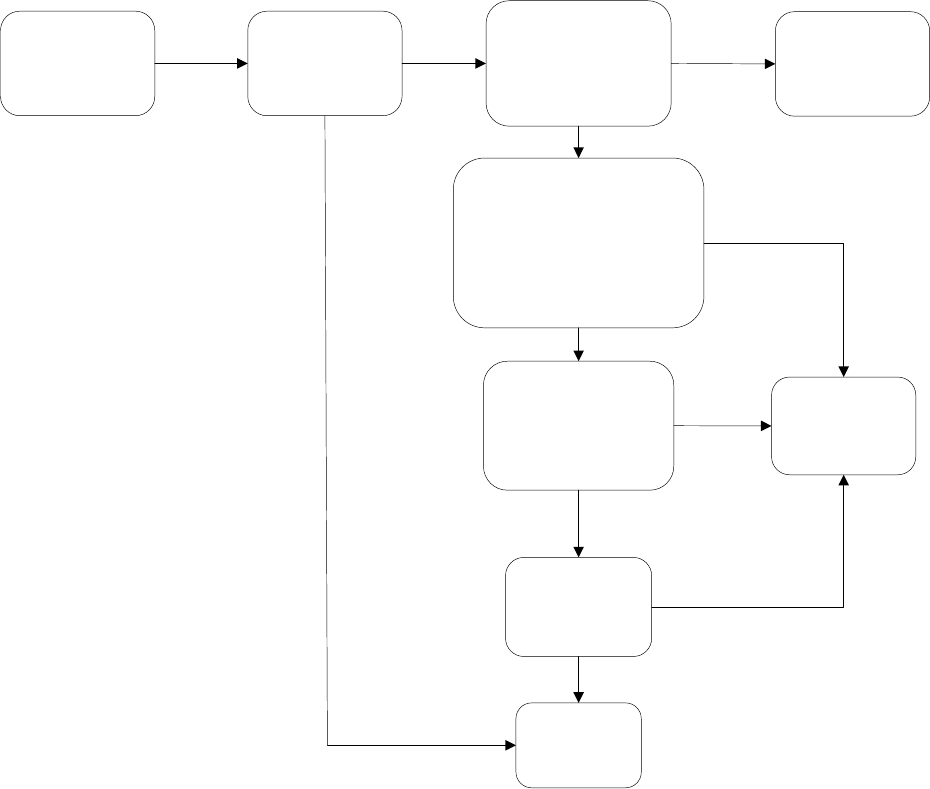
OPNAV M-5090.1
25 Jun 2021
14-4
Figure 14-1. CZMA Federal Consistency Flowchart
Proposed action
identified.
Is the action
listed as a de
minimis activity
1
?
Does the action have
direct, indirect, or
cumulative effects on
coastal uses
or resources?
No Yes
Prepare consistency
determination.
Is the action a State-listed
activity? Has the State notified
the action proponent that
the action may have reasonable,
foreseeable coastal effects?
Consistency
determination previously
prepared for this
or similar action.
Has a thorough
consistency
assessment been
conducted
2
?
No further
action.
No
No
No
No
Yes
Prepare negative
determination.
Yes
Yes
Yes
Notes:
1. De minimis activities are defined
in paragraph 14-5.9 of this
instruction and negotiated with State
agencies pursuant to reference (b),
section 33, paragraph (3).
2. The Navy considers an EA or EIS
prepared pursuant to NEPA, which
evaluates effects to coastal uses or
resources, to be a thorough
consistency assessment triggering
the requirement to prepare a
negative determination. However, in
cases where the activity falls within
a category of activities that the
relevant State(s) have agreed will
have either no or de minimis effects,
a negative determination would not
be required.
form as long as such determinations comply with the requirements of CZMA regulations. Using
such forms, where practical, is recommended, however, to avoid unnecessary conflict.
(2) The consistency determination must include data sufficient to support the Navy’s
determination. Where practicable, language contained in related documentation prepared
pursuant to NEPA may be directly incorporated into the consistency determination. At a
minimum, the consistency determination must include the elements identified in table 14-1 of
this manual.
(3) A consistency determination must be submitted by the Navy action proponent no later
than 90 days before final Navy approval of the proposed action, unless both the Navy action
proponent and the State agency agree to an alternative notification schedule. Action proponents
should also consider delivering the consistency determination as early as analysis and
circumstances permit. Some proposed actions may require time beyond the regulatory 90 days

OPNAV M-5090.1
25 Jun 2021
14-5
Table 14-1. Elements of a Consistency Determination
Element
Content
Brief
Introductory
Statement
Indicate whether or not the proposed action will be undertaken, to the
maximum extent practicable, in a manner consistent with the enforceable
policies of the relevant Federally approved State CMP.
Description of
the Action
Provide a detailed description of the action and its associated facilities and
reasonably foreseeable coastal effects.
Evaluation of
Relevant State
Enforceable
Policies
The evaluation should review each relevant State-enforceable policy and
explain how the Navy action is fully consistent or consistent to the
maximum extent practicable.
Consideration should be given to State CMP provisions that are in the
nature of recommendations.
If full consistency with the enforceable policies of the State CMP is
prohibited, the Navy action proponent must clearly describe the statutory
provisions, legislative history, or other legal authority that limits the Navy
action proponent’s discretion to be fully consistent (refer to note).
Note: OPNAV N45 must be notified regarding assertions that full consistency with the
enforceable policies of a State CMP is prohibited.
to address and resolve issues that may arise, particularly for potentially controversial actions. In
some cases, the action proponent may need time to consider and integrate issues that arise during
the consistency determination process into NEPA documentation or other regulatory processes or
authorizations. The Navy action proponent may presume State agency concurrence if a response
is not received within 60 days from receipt of the Navy action proponent determination.
However, State agency concurrence must not be presumed when an extension of time is
requested to review the matter. The Navy action proponent must approve one State agency
request for an extension period of 15 days or less.
f. Negative Determination: When an Action Does Not Have Coastal Effects
(1) A negative determination must be submitted to an affected State(s) when a Navy
action proponent determines an action does not have an effect(s) on any coastal use or resource,
and one or more of these items apply:
(a) The action is identified as a “listed activity or action” by a State agency;
(b) The State has notified the Navy action proponent that, as a result of its case-by-
case monitoring of unlisted activities or actions, a Navy action may have reasonably foreseeable
coastal effects and the Federal consistency provisions of reference (a), section 307 apply;
(c) The action is the same as, or similar to, actions for which consistency
determinations have been prepared in the past; or
(d) The action was the subject of a “thorough consistency assessment” undertaken by
the Navy action proponent that resulted in initial findings that the action had no coastal effects.

OPNAV M-5090.1
25 Jun 2021
14-6
(2) At a minimum, negative determinations must contain the information identified in
table 14-2 of this manual.
Table 14-2. Elements of a Negative Determination
Element
Content
Description of the Action
Provide a brief description of the action and its associated
facilities and its location.
Basis for Negative
Determination
Discuss the basis for determining the action that will not affect
any coastal use or resource.
Evaluation of Relevant
State-Enforceable Policies
The evaluation should review each relevant State-enforceable
policy and explain how the Navy action proponent determined
the Navy action would not result in effects on coastal uses or
resources.
(3) A negative determination must be submitted by the Navy action proponent no later
than 90 days before final Navy approval of the proposed action, unless both the Navy action
proponent and the State agency agree to an alternative notification schedule. A State is not
obligated to respond to a negative determination. Consequently, the Navy action proponent may
presume State agency concurrence if a response is not received within 60 days from receipt of
the Navy determination. State agency concurrence must not be presumed, however, when an
extension of time is requested to review the matter. The Navy action proponent must approve
one State agency request for an extension period of 15 days or less.
g. Classified Action. In the case of a classified action, the Navy action proponent is only
required to provide the State with a description of the action and effects that will not breach the
classified nature of the action. However, the Navy action proponent must conduct the classified
action consistent to the maximum extent practicable with the enforceable policies of a State’s
CMP, unless exempted by the President. The Navy action proponent must provide, to the
cognizant State agency, a description of the action and coastal effects the action proponent is
legally permitted to release and that do not otherwise breach the classified nature of the action.
h. No Documentation Required. No documentation is required pursuant to reference (a),
section 307 if there are no effects on any coastal use or resource and none of the provisions of
subparagraph 14-3.1c of this manual are triggered.
14-3.2. Other Types of Consistency Determinations
a. General Consistency Determinations. A Navy action proponent may prepare a general
consistency determination in cases where a repeated action will be performed (other than a
development project) that would have cumulative effects on any coastal use or resource.
Examples of repetitive actions include ongoing maintenance or waste disposal. Issuance of a
general consistency determination avoids the need to issue separate consistency determinations
for each iteration of the action. If a general consistency determination is issued, the Navy action
proponent must thereafter periodically consult with the State agency to discuss the manner in
which the repetitive actions are being undertaken. The Navy and State agencies may mutually
agree on a general consistency determination for de minimis activities or any other repetitive

OPNAV M-5090.1
25 Jun 2021
14-7
action or category of actions or activities. The Navy must document its decision to proceed with
an action listed as a de minimis activity in a memorandum for the record.
b. General Negative Determinations. A general negative determination may be prepared in
cases where the Navy action proponent will be performing a repeated action that will not have
reasonably foreseeable cumulative coastal effects, whether performed separately or
cumulatively. A general negative determination must describe in detail the action and repetitive
action covered by the general negative determination and the expected number of occurrences of
the activity over a specific period of time. If a general negative determination is issued, the
Navy action proponent must thereafter periodically assess whether the general negative
determination is still applicable.
c. Phased Consistency Determinations. A phased consistency determination may be
provided in cases where the decisions of the Navy action proponent related to a proposed
development project or other action will be made in phases based upon developing information
that may not be available at the time of the original consistency determination. In this case, a
separate consistency determination will be required for each major decision.
d. National or Regional Consistency Determinations. The Navy action proponent may
provide coastal States with consistency determinations for actions of national or regional scope
that affect any coastal use or resource of more than one State. Single consistency determinations
may be prepared that address common State coastal management issues and enforceable policies.
Where coastal effects and enforceable policies are unique to particular States, the consistency
determination must contain separate sections addressing these unique effects and policies.
National consistency determinations must be approved by and coordinated with OPNAV N45.
Regional consistency determinations must also be approved by and coordinated with the area
environmental coordinators (AEC) and regional environmental coordinators (REC).
e. Consistency Determinations in Emergency or Similar Unforeseen Circumstances. In the
event of an emergency or similar unforeseen circumstances (i.e., increased threat conditions
requiring immediate action), the Navy action proponent may deviate from full consistency with
the enforceable policies of the State CMP. However, to the extent that the emergency or
unforeseen circumstance allows, the action proponent must attempt to seek State agency
concurrence prior to taking action. Upon addressing exigent circumstances or completing
emergency response activities, the Navy action proponent must provide the State agency with a
description of its actions and impacts to the coastal zone.
14-3.3. Relationship Between Consistency Determinations and Negative Determinations and
National Environmental Policy Act Documentation. Consistency determinations and negative
determinations must be prepared as stand-alone documents. States may not require submission
of a draft or final NEPA analysis as a condition for a consistency determination application being
complete. Stand-alone consistency determinations should be incorporated, at a minimum, in the
correspondence appendix of a NEPA analysis.

OPNAV M-5090.1
25 Jun 2021
14-8
14-3.4. State Agency Conditional Concurrences and Objections
a. Development of Conditions. When applicable, action proponents should cooperate with
State agencies to develop conditions that, if agreed to during the State agency’s consistency
review period and included in the consistency determination, would allow the State agency to
concur with the proposed action.
b. Proceeding with an Action
(1) If a State agency issues a conditional concurrence, the action proponent must use the
remainder of the 90-day period to resolve any disagreements. The action proponent must also
review the conditions to ascertain whether the proposed action remains consistent to the
maximum extent practicable, by determining, at a minimum:
(a) Whether the conditions accurately represent the State’s approved CMP, and
(b) Whether the conditions violate principles of Federalism including whether
sovereign immunity has been waived or the identified conditions are preempted by Federal laws.
(2) If, after review, the action proponent concludes there are no legal or factual bases to
justify proceeding over the State’s objection, the action proponent should work with the State
agency to:
(a) Remove conditions not acceptable to the Navy;
(b) Modify the conditions to those that can be implemented by the action proponent;
and
(c) Implement the conditions.
(3) A conditional concurrence differs from a concurrence in that a concurrence may
merely forward recommendations, while conditions in a conditional concurrence must be
reviewed and implemented per subparagraph 14-3.4b(2) of this manual. Under a regular
concurrence, the action proponent must consider the recommendations, but has no obligation to
implement the recommendations and is not required to notify the State if it decides not to
implement them. Notification via the chain of command to OPNAV N45 is required if any
recommendation is not implemented. For a conditional concurrence, action proponents must
discuss the potential for agreement to conditions that may set adverse precedent for future Navy
actions through the chain of command with OPNAV N45. In the event these conditions remain a
condition of State agency concurrence and they are unacceptable to the Navy, the Navy must
treat the conditional concurrence as an objection by the State agency.
c. State Agency Objections
(1) If a State agency objects to a Navy consistency or negative determination, the action
proponent must not proceed with the action over those objections unless the action proponent

OPNAV M-5090.1
25 Jun 2021
14-9
provides written notification to OPNAV N45 requesting its participation in the review of the
action and coordination with the State agency objecting to the action.
(2) In the case of a State agency’s objection to a Navy consistency determination, such
notification must state that:
(a) the Navy action proponent has concluded that under existing law, it is prohibited
from the standard of being fully “consistent to the maximum extent practicable” with a Federally
approved State CMP. The notification must clearly describe the legal impediments to full
consistency; or
(b) the Navy action proponent has concluded that its action is fully consistent with the
enforceable policies of the State CMP.
(3) In the case of a State agency’s objection to a Navy negative determination, the
notification must state the Navy action proponent’s rationale for asserting that coastal effects are
not reasonably foreseeable.
d. Serious Disagreements. Mediation is an option in the event of a serious disagreement
between the Navy action proponent and a State agency regarding the consistency of a proposed
Navy action affecting any coastal use or resource. Should the action proponent believe the
disagreement can be resolved through mediation, it must notify OPNAV N45 and provide
reasons. OPNAV N45 must coordinate within the Office of the Chief of Naval Operations
(OPNAV), and if necessary, with the Secretariat on whether to approve the use of mediation.
14-3.5. State Coastal Nonpoint Pollution Control Programs. The Navy must support the
development and implementation of State coastal nonpoint pollution control programs on Navy
lands consistent with applicable laws and regulations. These may include identifying nonpoint
sources, specifying corrective measures, and coordinating nonpoint-source compliance efforts
with State programs. Consistent with Federal laws and regulations, the Navy must also identify
areas of sensitive natural resources of the coastal zone, minimize the loss or degradation of
coastal wetlands, enhance the natural value of wetlands, and protect water quality. Integrated
natural resource management plans (INRMP) should address management of all marine
resources in installation coastal and near-shore environments. Chapter 12 (Natural Resources
Conservation) of this manual discusses all INRMP requirements and those related to the coastal
zone. The Navy must encourage research-and-development efforts to address nonpoint sources
of pollution to identify and understand Navy impacts on the coastal and marine environment.
14-3.6. Supplemental Coordination for Proposed Activities
a. A Navy action proponent must prepare a supplemental consistency determination for any
proposed Navy action that was previously determined to be consistent with a State’s CMP (i.e.,
State concurred with the Navy’s determination), that has not yet begun, but that the action
proponent has subsequently determined that the proposed action will affect a coastal use or
resource substantially different than originally described. Substantially different coastal effects
are reasonably foreseeable if:

OPNAV M-5090.1
25 Jun 2021
14-10
(1) The Federal agency makes substantial changes in the proposed activity that are
relevant to management program enforceable policies; and
(2) There are significant new circumstances or there is information relevant to the
proposed activity and the proposed activity’s effect on any coastal use or resource.
b. Furthermore, the Navy action proponent should prepare a supplemental consistency
determination if substantial changes were made to a proposed action during the period of the
State agency’s initial review that were relevant to CMP enforceable policies or affect coastal
uses or resources, and the action proponent did not notify the State agency of those substantial
changes prior to State concurrence with the determination.
14-3.7 Training Requirements
a. The Navy’s goal is to implement efficient and effective training that provides the right
training to the right people at the right time in support of the Navy’s mission. The Navy
Environmental Readiness Training Program (NERTP) supports this goal by identifying and
resourcing the development and delivery of quality environmental training courses. In addition
to NERTP-sponsored courses, other specialty schools may also resource, develop and deliver
environmental courses to meet their specific requirements. All personnel (i.e., civilian, active-
duty military, and reserve military) must receive training as applicable to their specific job
assignments and levels of responsibility. NERTP course descriptions, target audiences, and
schedules are available on the Civil Engineer Corps Officer School and Naval Safety and
Environmental Training Center Web sites (refer to appendix E (Web Sites) of this manual for
Web site addresses). Refer to chapter 3 (Environmental Readiness Training) of this manual for
information on general overall and billet-specific environmental training requirements as well as
training requirements for personnel who have collateral environmental responsibilities. Chapter
3 (Environmental Readiness Training), table 3-1 of this manual provides NERTP formal training
courses and target audiences for each formal course offered.
b. Personnel who perform coastal zone management duties should take some or all of these
courses as needed to build and maintain proficiency in performing their specific job duties:
(1) NEPA Application (A-4A-0077);
(2) Basic Environmental Law (A-4A-0058);
(3) Environmental Law (Oceans and Coastal Law) (A-4A-0068); and
(4) Natural Resources Management and Compliance (A-4A-0087).
14-4 Responsibilities
14-4.1. OPNAV N45 must:
a. Develop and implement OPNAV policy guidance regarding CZMA compliance;
OPNAV M-5090.1
25 Jun 2021
14-11
b. Advise commands of the requirement for submitting consistency determinations or
negative determinations;
c. Coordinate with the National Oceanic and Atmospheric Administration (NOAA), Office
of the Secretary of Defense, Assistant Secretary of the Navy, Energy, Installations, and
Environment (ASN(EI&E)), and other Department of Defense components and Federal agencies
concerned with coastal zone matters;
d. Provide Navy representation, along with the budget submitting office (BSO), when
NOAA has been asked to mediate differences between the Navy action proponent and State
CMP agencies;
e. Coordinate with ASN(EI&E) should the action proponent elect to proceed over the State’s
objection to ensure the current ASN(EI&E) position is reflected; and
f. Coordinate with ASN(EI&E) for notification to the NOAA Office of Ocean and Coastal
Resource Management.
14-4.2. BSOs, region commanders, commanding officers of shore installations, training and
operations planners, weapon-system-acquisition program managers, and science and technology
program managers must:
a. Ensure all appropriate instructions (including those requiring written justification for
actions, collectively or separately); research, development, test, and evaluation; military
construction; operations and maintenance; Navy working capital fund; urgent minor
construction; land acquisitions; natural resources management; cultural resources management;
weapons and support-system procurement; and special projects include the requirements for
funding and scheduling for CZMA documentation, as necessary;
b. Participate in the formulation of, and ensure commitment to, any mitigation and
monitoring requirements established in consistency determinations or negative determinations;
and
c. Comply with the requirements outlined in paragraph 14-4.4 of this manual if acting as an
action proponent.
14-4.3. RECs must:
a. Participate in the preparation of consistency determinations and negative determinations
for proposed activities within the geographic boundaries of their regions and review these
determinations prior to their submittal to the State agency;
b. Provide Navy representation, along with the action proponent, at any formal hearings or
meetings of State CMP agencies where the proposed Navy action is on the agenda for discussion
or approval;

OPNAV M-5090.1
25 Jun 2021
14-12
c. Actively participate in the review process of proposed changes to State CMPs to ensure
the Navy’s interests are protected; and
d. Identify and negotiate de minimis and general consistency determinations for Navy
activities with State CMP agencies.
14-4.4. Action proponents must:
a. Prepare and submit consistency determinations and negative determinations for Navy
actions as provided in subparagraphs 14-3.1b and 14-3.1c of this manual;
b. Provide Navy representation, along with the AEC or REC, at any formal hearings or
meetings of State CMP agencies where the proposed Navy action is on the agenda for discussion
or approval; and
c. Provide notification to OPNAV N45 in the event of a serious disagreement between the
Navy action proponent and a State agency regarding the consistency of a proposed Navy action
or when the action proponent elects to proceed with an action over the objection of a State
agency.
14-5 Definitions
14-5.1. Action Proponent. An action proponent is the commander, CO, or civilian director of a
unit, activity, or organization responsible for initiating or carrying out a proposed action. In
general, the action proponent should be at the lowest level in the chain of command that “owns”
the entire action being proposed.
14-5.2. Any Coastal Use or Resource. Any coastal use or resource pertains to any land or water
use, or natural or cultural resource of the coastal zone. Coastal uses include, but are not limited
to: public access, recreation, fishing, historic or cultural preservation, development, hazards
management, marinas and floodplain management, scenic and aesthetic enjoyment, and resource
creation or restoration projects. Natural resources include biological or physical resources found
permanently or cyclically within a State’s coastal zone. Cultural resources include
archaeological resources, sunken craft, and other historic properties within a State’s coastal zone,
as well as properties of traditional, cultural, and religious importance to Native American tribes,
Alaska Natives, or Native Hawaiian organizations. Biological and physical resources include,
but are not limited to: air, tidal and non-tidal wetlands, ocean waters, estuaries, rivers, streams,
lakes, aquifers, submerged aquatic vegetation, land, plants, trees, minerals, fish, shellfish,
invertebrates, amphibians, birds, mammals, reptiles, and coastal resources of national
significance. Coastal uses and resources also include uses and resources described in the State’s
CMP.
14-5.3. Associated Facilities. Associated facilities are all proposed facilities specifically
designed, located, constructed, operated, adapted, or otherwise used, in full or in major part, to
meet the needs of a Navy action proponent (e.g., activity, development project, licensee,

OPNAV M-5090.1
25 Jun 2021
14-13
permittee, assistance recipient) and without which the action, as proposed, could not be
conducted.
14-5.4. Classified Action. A classified action is any action for which a Navy action proponent is
required to protect from disclosure. This includes national security information concerning
national defense or foreign policy, provided it has been properly classified per the substantive
and procedural requirements of an executive order.
14-5.5. Coastal Management Program. A CMP is the program of a coastal State or territory that
has been approved by NOAA pursuant to reference (b), Part 923 (Coastal Zone Management
Program Regulations), and that includes, but is not limited to, a comprehensive statement in
words, maps, illustrations, or other media of communication, prepared and adopted by the State,
that sets forth objectives, policies, and standards to guide public and private uses of lands and
waters in the coastal zone.
14-5.6. Coastal States. Coastal States are States of the United States bordering on the Atlantic,
Pacific, or Arctic Oceans, the Gulf of Mexico, Long Island Sound, or one or more of the Great
Lakes. The term also includes the Commonwealth of Puerto Rico, the U.S. Virgin Islands,
Guam, the Commonwealth of the Northern Mariana Islands, the Republic of the Marshall
Islands, the Federated States of Micronesia, the Republic of Palau, and American Samoa.
14-5.7. Coastal Zone. The coastal zone is the coastal waters (including lands lying in coastal
waters and submerged there under and adjacent shore lands) within the meaning of reference (a),
section 304(1), and as more fully defined and described in each coastal State’s Federally
approved CMP. Excluded from the coastal zone is any Navy facility or real estate owned, held
in trust, or used by the Navy in performance of its mission.
14-5.8. Consistent to the Maximum Extent Practicable. The Navy is required by the CZMA to
ensure its activities affecting any coastal use or resource are consistent to the “maximum extent
practicable,” as defined in reference (b), Part 930, section 32, paragraph (a)(1) as “fully
consistent” with the enforceable policies of the CMP unless Navy compliance is prohibited by
law.
14-5.9. De minimis Activities. De minimis activities are those activities expected to have
insignificant direct or indirect (cumulative and secondary) effects and for which a mutual
agreement exists between the Navy and a State agency that the action is not subject to further
State agency review.
14-5.10. Effect on Any Coastal Use or Resource. An effect on any coastal use or resource is any
reasonably foreseeable effect on coastal uses or resources resulting from a Navy action or
activity. These reasonably foreseeable effects can take the form of:
a. Direct effects: Effects that occur at the same time or place as a Navy action; or
b. Indirect and cumulative effects: Secondary and cumulative effects that result from the
action and are later in time or farther removed in distance, but are still reasonably foreseeable.

OPNAV M-5090.1
25 Jun 2021
14-14
Indirect effects are effects resulting from the incremental impact of a Navy action when added to
other past, present, and reasonably foreseeable actions, regardless of what agency or individual
undertakes such actions. This definition is consistent with the Council on Environmental
Quality’s definition of cumulative effects per reference (c).
14-5.11. Effects Test. An effects test is the test by which the Navy action proponent factually
determines compliance with the Federal consistency requirements of reference (a), section 307,
and the implementing regulations set forth in reference (b), Part 930.
14-5.12. Enforceable Policies of a State Coastal Management Program. Enforceable policies of
a State CMP are State policies legally binding through constitutional provisions, laws,
regulations, land use plans, ordinances, or judicial or administrative decisions, by which a State
exerts control over private and public land and water uses, and natural and cultural resources in
the coastal zone and which are incorporated in a Federally approved State CMP. NOAA’s
Office for Coastal Management has informed States that enforceable policies are given legal
effect by State law and do not apply to Federal lands, Federal waters, Federal agencies, or other
areas or entities outside a State’s jurisdiction, unless authorized by Federal law; the CZMA does
not confer such authorization.
14-5.13. Land Use. Land use is a use or activity conducted in, or on, the shore lands within the
coastal zone.
14-5.14. Listed Activities. Listed activities are activities or actions listed by State agencies in
their CMPs that, in the opinion of the State agency, will have reasonably foreseeable coastal
effects.
14-5.15. Navy Action or Activity. A Navy action or activity is any function performed by or on
behalf of the Navy action proponent in the exercise of its statutory responsibilities (e.g., facilities
development, tests, exercises). The term “action” is used interchangeably with the term
“activity.”
14-5.16. Navy Development Project. A Navy development project is a Navy action that: (a)
involves the planning, construction, modification, or removal of public works facilities or other
structures within the coastal zone or occurring outside the coastal zone but that could result in
effects being felt within the coastal zone; and (b) includes the acquisition, use, or disposal of any
coastal use or resource.
14-5.17. Thorough Consistency Assessment. A thorough consistency assessment is an
assessment of coastal effects fully meeting the requirements of reference (a), section 307, and the
implementing regulations set forth in reference (b), Part 930. Navy policy states that an EA or
EIS (prepared by the Navy action proponent pursuant to the requirements of NEPA) constitutes a
“thorough consistency assessment,” if that document includes an analysis of effects on coastal
uses or resources for which there are enforceable policies under the State’s CMP.

OPNAV M-5090.1
25 Jun 2021
14-15
14-5.18. Unlisted Activities. Unlisted activities are those activities or actions not specifically
listed in a State’s CMP, but which may have reasonably foreseeable coastal effects and for which
a State may advise the Navy action proponent that a consistency review is required.
14-5.19. Water Use. Water use is a use or activity conducted in or on waters within the coastal
zone.

OPNAV M-5090.1
25 Jun 2021
15-1
CHAPTER 15
NAVY OPERATIONAL RANGE ENVIRONMENTAL SUSTAINMENT
Table of Contents
15-1 Scope ..................................................................................................................................15-1
15-1.1. Related Chapters .....................................................................................................15-1
15-1.2. References................................................................................................................15-1
15-1.3. Applicability ............................................................................................................15-2
15-2 Legislation ..........................................................................................................................15-2
15-3 Requirements .....................................................................................................................15-2
15-3.1. Navy Range Sustainability Environmental Program Assessment Program ........15-2
15-3.2. Range Management Plans and Range Complex Management Plans ..................15-5
15-3.3. Navy Operational Range Clearance .......................................................................15-6
15-3.4. Environmental Planning Documentation ...............................................................15-6
15-3.5. Encroachment Management ....................................................................................15-6
15-3.6. Range Complex Sustainment Support ....................................................................15-6
15-3.7. Qualification Requirements ....................................................................................15-7
15-4 Responsibilities .................................................................................................................15-7
15-5 Definitions ..........................................................................................................................15-9
15-1 Scope. The Navy has a responsibility to sustain the highest levels of readiness to meet its
mission requirements while operating in an environmentally responsible manner that is
protective of the public. To address environmental requirements effectively and proactively and
to preserve the Navy’s operational ranges, a systematic approach to the management of ranges in
compliance with environmental requirements is essential. This chapter describes the
environmental requirements.
15-1.1. Related Chapters. Related chapters in this manual include chapter 10 (Environmental
Planning Under the National Environmental Policy Act and Executive Order 12114), chapter 17
(Environmental Management Systems and Environmental Compliance Audits Ashore), chapter
27 (Hazardous Waste Management Ashore), and chapter 28 (Solid Waste Management and
Resource Recovery Ashore).
15-1.2. References
(a) DoD Instruction 4715.14 of November 2018, Operational Range Assessments;
(b) DoD Directive 4715.11 of May 2004, Environmental and Explosives Safety Management
on Operational Ranges Within the United States;

OPNAV M-5090.1
25 Jun 2021
15-2
(c) OPNAV N45 ltr 5090/N453/84158028 of 29 Aug 08, Navy Policy for Conducting
Operational Water Range Sustainability Environmental Program Assessments;
(d) DoD Directive 3200.15 of December 2013, Sustaining Access to the Live Training and
Test Domain;
(e) OPNAVINST 3571.4, Operational Range Clearance Policy for Navy Ranges;
(f) DoD Instruction 3200.16 of April 2015, Operational Range Clearance (ORC);
(g) NAVSEA OP 5, Volume 1, Seventh Revision, Ammunition and Explosives Safety
Ashore;
(h) DoD Manual 4715.26, DOD Military Munitions Rule (MR) Implementation Procedures,
25 April 2017; and
(i) OPNAVINST 11010.40, Encroachment Management Program.
15-1.3. Applicability. The environmental requirements described herein apply to all Navy
operational ranges as defined in Title 10 of the U.S. Code within the United States and its
territories. Small arms ranges should be addressed separately as part of the environmental
system process described in chapter 17 (Environmental Management Systems and
Environmental Compliance Audits Ashore) of this manual.
15-2 Legislation
a. Legislation that contains provisions that pertain to the management and release of military
munitions includes:
(1) E.O. 12580, Superfund Implementation; and
(2) Military Munitions Rule, 40 CFR Parts 260–266 and 270.
b. A summary of this legislation is included in appendix A (Summary of Major Legislation,
Regulations, Executive Orders, and International Agreements) of this manual.
15-3 Requirements
15-3.1. Navy Range Sustainability Environmental Program Assessment Program. The Navy’s
Range Sustainability Environmental Program Assessment (RSEPA) program ensures consistent
Navy-wide compliance with references (a) and (b), and incorporation of the requirements of the
U.S. Navy RSEPA Policy Implementation Manual and reference (c) under one overarching
program. RSEPA is conducted to: (1) evaluate the regulatory compliance status of each
operational range including ways to maintain compliance; and (2) evaluate the potential for
adverse impacts to human health and the environment from munitions constituents (MC),
including identification and implementation of protective measures to minimize the risk. The

OPNAV M-5090.1
25 Jun 2021
15-3
U.S. Navy RSEPA Policy Implementation Manual provides a detailed description of the
assessment process for both operational land and water ranges. The key components and
requirements of the RSEPA program are provided in subparagraphs 15-3.1a through 15-3.1e of
this manual.
a. Assessments. Only operational land and water ranges within the United States and
territories where testing or training with military munitions occurs or has occurred are assessed.
Ranges where operations occur without use of munitions (e.g., electronic warfare) are excluded
from RSEPA. Small arms ranges are typically assessed as part of an existing environmental
compliance program and are addressed separately (see chapter 17 (Environmental Management
Systems and Environmental Compliance Audits Ashore) of this manual). The budget submitting
office (BSO) in charge of each operational range determines whether an assessment is required.
The assessment process consists of a range condition assessment (RCA) and, if required to
evaluate a risk to human health and the environment, a comprehensive range evaluation (CRE).
As each range has a unique mission and set of environmental conditions, the decision to conduct
a CRE is determined on a case-by-case basis by the BSO and the Office of the Chief of Naval
Operations, Energy and Environmental Readiness Division (OPNAV N45).
(1) Range Condition Assessments. A baseline RCA is required for each Navy
operational range, with a review or update required at a minimum of every 5 years. An RCA
gathers and reviews existing environmental compliance and operational activity data for the
range and includes a records review, site visit, and reporting. RCAs also include the
development of an operational range site model (ORSM) to assess for potential source-receptor
pathways (SRP) for MCs, should they migrate off-range.
(2) Comprehensive Range Evaluations. If additional data collection or sampling is
required to evaluate risks to human health and the environment, a CRE may be conducted. CREs
involve collection and analysis of environmental sampling data to fill data gaps from the RCA.
If the results of a CRE indicate a significant risk to human health or the environment or that any
promulgated regulatory criteria have been exceeded, sustainable range oversight (SRO) is
executed.
b. Sustainable Range Oversight. The echelon 2 command must immediately notify OPNAV
N45 of any discovery of a release or substantial threat of release of MCs from an operational
land range to off-range areas, or actual SRP interaction on an operational water range, that
creates an unacceptable risk to human health or the environment. OPNAV N45 will then notify
the Secretary of the Navy (SECNAV), the Office of the Secretary of Defense (OSD), and
applicable environmental regulators of the situation. The Navy will exercise its authority under
Executive Order (E.O.) 12580 to take appropriate actions. Navy stakeholders should strive to
eliminate or minimize environmental response actions that could have adverse effects on the
long-term sustainability of range operations. OPNAV N45 will coordinate with the appropriate
stakeholders in identifying and implementing a specific SRO strategy.
c. Protective Measures. Protective measures can be implemented at any point in the
assessment process to maintain range sustainability and address specific environmental concerns.
Protective measures are actions or management practices designed and implemented to prevent,

OPNAV M-5090.1
25 Jun 2021
15-4
minimize, stabilize, or eliminate a release or threat of release of MCs to off-range areas at land
ranges and risks to human health or the environment at water ranges.
d. Recordkeeping and Reporting. The team that conducts the assessment will record
findings, recommendations, and decisions in reports (a technical memorandum and a fact sheet,
at a minimum). BSOs and OPNAV N45 will review these reports. BSOs will maintain final
approved reports and place them in a range data folder (RDF).
(1) Range Data Folder. An RDF is created as an historical repository for each range
assessed through the RSEPA program for use by the applicable BSO and range manager. Each
RDF will include reference materials, results, outcomes, recommendations, copies of technical
memoranda and fact sheets, and other documents generated through the RSEPA assessment
process. RDFs may be used to assist range managers in developing range management plans
(RMP) or to enhance or broaden existing plans.
(2) Technical Memorandum. A technical memorandum is a stand-alone, summary-level
(fewer than 15 pages) document. The technical memorandum should include an analysis and
summary of the significant findings and recommendations resulting from the assessment. The
technical memorandum for periodic reviews or updates should focus on substantive changes that
have occurred since the previous assessment was completed. Following resolution of comments
among members of the RSEPA Assessment Team, the BSO will provide the technical
memorandum to OPNAV N45 for review. After resolving potential comments and concerns
from OPNAV N45, the BSO will send the final technical memorandum to OPNAV N45 via their
chain of command. At a minimum, a technical memorandum should include:
(a) Summary of updated information and new records documenting changes in
conditions at the range and surrounding area since the previous assessment was completed;
(b) Analysis of existing, updated, and newly obtained records (e.g., munitions
expenditure data, modeling results, updated ORSMs, newly documented impacts to range
operations);
(c) Confirmation of prior assessment findings or revisions of findings;
(d) Evaluation of the effectiveness of any implemented protective measures and
recommendations to determine if they need to be continued, modified, or terminated; and
(e) Presentation of recommendations and conclusions based on data analysis.
(3) Fact Sheet. A fact sheet is a brief (1–2-page) document written to help a local
community understand highly technical topics, concepts, and information. It contains essential
information only. The team that conducts the assessment must ensure all information presented
is factual, accurate, and current. The BSO will ensure the fact sheet is reviewed and approved by
the command and public affairs officer (PAO) for viewing by a public audience. The BSO will
provide the fact sheet to OPNAV N45 for review. After resolving potential comments and
concerns from OPNAV N45, the BSO will send the final fact sheet to OPNAV N45 via their

OPNAV M-5090.1
25 Jun 2021
15-5
chain of command to upload the fact sheet onto the appropriate public-facing Web site, as
required (e.g., Department of Defense (DoD) Environment, Safety, and Occupational Health
Network and Information Exchange (DENIX) (refer to appendix E (Web Sites) of this manual
for Web site address)). No other information (e.g., public availability notices) will be
disseminated outside the Navy. At a minimum, a fact sheet should include:
(a) Overview of the RSEPA program and historical range information excerpted from
the technical memorandum and modified, if needed, for public audiences;
(b) Presentation of ORSM figures or descriptions and other supporting figures and
tables;
(c) Summary of sampling and analysis results and conclusions, if applicable;
(d) Summary of results from the review of environmental compliance; and
(e) Contact information (e.g., telephone number, e-mail address) for the appropriate
PAO or designee to obtain additional information.
e. Periodic Review and Updates. Operational ranges must be assessed every 5 years or
sooner if there is significant change in the operational range mission or munitions used compared
to the previous assessment. Land and water ranges within a range complex should be assessed
concurrently.
15-3.2. Range Management Plans and Range Complex Management Plans. A comprehensive
planning and risk-management strategy is required for each operational range per references (b)
and (d). This multi-purpose strategic planning effort should identify mission requirements, range
operations, encroachment management, environmental requirements, and future planning efforts.
a. General Requirements. An RMP for an individual range, or a range complex management
plan (RCMP) for multiple ranges managed as one complex, is required. Either type is acceptable
as determined by the BSO. The RMP or RCMP describes missions; capabilities; current and
future operations; geographical information such as range boundaries, airspace, and operating
areas (OPAREA); environmental planning and compliance management; explosives safety
management; community outreach; and sustainable range management practices. Additionally,
the RMP or RCMP documents the contribution of the range to readiness, identifying necessary
procedures to ensure the range and associated infrastructure are prepared to meet future
operational readiness requirements. BSOs should review and update RMPs and RCMPs every 5
years at a minimum or as significant changes (e.g., changes in mission requirements, changes in
encroachment impacts) dictate, using a 10 year planning horizon.
b. Environmental Requirements. The RMP and RCMP identify the environmental setting,
weather and climate conditions, hydrology and hydrogeology, cultural and natural resources
present (including a summary of survey efforts completed to date), and current and future land
use management on and around ranges, as well as the area underlying the special use airspace
associated with ranges. These plans describe environmental compliance requirements for at-sea

OPNAV M-5090.1
25 Jun 2021
15-6
and on-land operations, as applicable, and summarize requirements associated with
environmental or operational permits and other formalized agreements with Federal, State, or
local agencies (e.g., biological opinions, memoranda of agreement, programmatic agreements).
15-3.3. Navy Operational Range Clearance. Navy operational range clearance (ORC) supports
sustainable range management by ensuring range personnel safety, maintaining target fidelity,
managing specular hazards, and minimizing potential explosive hazards and harmful
environmental impacts at land ranges. Navy ORC policy (reference (e)) implements the
requirements of reference (f).
a. General Requirements. Per reference (e), an ORC plan is required for each Navy
operational range that describes range-clearance goals, objectives, criteria, and schedule.
b. Environmental Requirements
(1) Natural resources, cultural resources, and environmental compliance requirements
should be considered and included as necessary when developing and implementing ORC plans.
(2) ORC activities curtail the accumulation of range debris, which supports recycling
efforts and reduces the potential for off-range migration of MCs. Once cleared from the range,
materials must be inspected and certified as safe, and stored, managed, and recycled following
procedures described in chapter 28 (Solid Waste Management and Resource Recovery Ashore)
of this manual and reference (g). Range-clearance activities conducted within the framework of
the Military Munitions Rule are described in reference (h).
15-3.4. Environmental Planning Documentation. Environmental planning is the process of
identifying and considering the effects of Navy activities on the human and natural environment.
This includes Navy actions undertaken on operational ranges and training ranges. The Navy
policy and guidance for conducting environmental planning per the National Environmental
Policy Act and E.O. 12114 are found in chapter 10 (Environmental Planning Under the National
Environmental Policy Act and Executive Order 12114) of this manual.
15-3.5. Encroachment Management. Changes in legislation, foreign investment, and competing
interests for energy and natural resources are creating increasingly difficult encroachment
challenges directly impacting Navy operational range sustainability. The Navy’s ability to
sustain operational readiness efficiently and effectively requires proactive engagement to prevent
or mitigate both internal and external encroachment issues as early as possible. The Navy
encroachment management policy and guidance is found in reference (i).
15-3.6. Range Complex Sustainment Support. The coordination effort required to support
requirements identified in section 15-3 of this manual is called range complex sustainment
support (RCSS) and includes data collection and range management to maintain Commander,
U.S. Fleet Forces Command and Commander, U.S. Pacific Fleet range-sustainment program
requirements.

OPNAV M-5090.1
25 Jun 2021
15-7
15-3.7. Qualification Requirements. Personnel assigned to positions involving responsibilities
for military-munitions-related activities such as range assessments and range-clearance activities
must have the appropriate, job-specific qualifications, experience, and explosives safety training
per reference (g), appendix A.
15-4 Responsibilities
15-4.1. OPNAV N45 must:
a. Serve as the policy, assessment, and resource sponsor for the Navy RSEPA program;
b. Notify SECNAV, OSD, and applicable environmental regulators of any discovery of a
release or substantial threat of release of MCs from an operational land range to off-range areas
or actual SRP interaction on an operational water range that creates an unacceptable risk to
human health or the environment;
c. Serve as the assessment and resource sponsor for the environmental requirements of Navy
ORC;
d. Serve as the assessment and resource sponsor for the environmental requirements of the
Navy RMP or RCMP program;
e. Serve as the assessment and resource sponsor for the environmental requirements of
RCSS;
f. Advise the Navy in matters related to environmental range sustainment;
g. Coordinate with other Service headquarters, SECNAV, and OSD with respect to
environmental issues on operational ranges; and
h. Provide additional guidance and support to echelon 2 commands, Navy regions, regional
environmental coordinators, fleet commanders, and installation personnel as needed.
15-4.2. The Office of the Chief of Naval Operations, Shore Readiness Division (OPNAV N46)
must:
a. Program, budget, and allocate funds to implement improvements in operational range real
property; and
b. Provide support to OPNAV N45 in monitoring implementation of environmental range
management initiatives.
15-4.3. OPNAV, Innovation, Technology Requirements, and Test and Evaluation Division
(OPNAV N94) must:
OPNAV M-5090.1
25 Jun 2021
15-8
a. Coordinate with OPNAV N45 on environmental range-sustainment efforts and initiatives
for Major Range Test Facility Base and training ranges; and
b. Provide guidance and support and monitor implementation of the Navy’s ORC policy.
15-4.4. Commander, Navy Installations Command must:
a. Act as the resource and assessment sponsor to implement improvements in operational
range real property; and
b. Provide support to OPNAV N45 in monitoring implementation of environmental range
management initiatives.
15-4.5. Commander, Naval Facilities Engineering Systems Command must provide technical
support, as requested, in developing and implementing environmental range-sustainment
initiatives.
15-4.6. BSOs with cognizance for operational ranges must:
a. Execute the RSEPA, ORC, RMP, RCMP, and RCSS programs as applicable;
b. Assign technical team leaders and ensure RSEPA operational range assessments comply
with the requirements of this chapter;
c. Program, plan, budget, and allocate sufficient resources to ensure range operations
maintain compliance with applicable Federal, State, and local environmental laws and
regulations; and
d. Respond and report to OPNAV N45 any release or substantial threat of release of MCs
from a land operational range to an off-range area or actual SRP interaction on an operational
water range that creates an unacceptable risk to human health or the environment.
15-4.7. Naval Ordnance Safety and Security Activity, Ordnance Environmental Support Office
must:
a. Serve as the delegated authority for ordnance range sustainment;
b. Provide explosives safety and ordnance environmental support to OPNAV N45 and
echelon 2 commands, as requested, during implementation of environmental range-sustainment
initiatives; and
c. Evaluate compliance with the requirements outlined in this chapter during the conduct of
explosives safety inspections.
15-4.8. Installation commanding officers with operational range management responsibilities
must implement relevant requirements as described in this chapter.

OPNAV M-5090.1
25 Jun 2021
15-9
15-5 Definitions
15-5.1. Military Munitions
a. Military munitions are all ammunition products and components produced for or used by
the armed forces for national defense and security, including ammunition products under the
control of the DoD, Coast Guard, Department of Energy (DOE), and National Guard. The term
includes: confined gaseous, liquid, and solid propellants; explosives, pyrotechnics, chemical,
and riot control agents; smokes; and incendiaries, including bulk explosives and chemical
warfare agents; chemical munitions, rockets, guided and ballistic missiles, bombs, warheads,
mortar rounds, artillery ammunition, small arms ammunition, grenades, mines, torpedoes, depth
charges, cluster munitions and dispensers, and demolition charges; and devices and components
of any item specified (section 101e(4) of Title 10, U.S. Code).
b. Military munitions do not include wholly inert items, improvised explosive devices,
nuclear weapons, nuclear devices, and nuclear components, other than non-nuclear components
of nuclear devices that are managed under the nuclear weapons program of the DOE after all
required sanitization operations have been completed (section 101e(4) of Title 10, U.S. Code).
15-5.2. Military Range. A military range is a designated land or water area set aside, managed,
and used to conduct research, development, testing, and evaluation of military munitions, other
ordnance, or weapons systems, and to train military personnel in their use and handling. Ranges
include firing lines and positions, maneuver areas, firing lanes, test pads, detonation pads, impact
areas, and buffer zones with restricted access and exclusionary areas. This definition does not
include airspace, water, or land areas underlying airspace used for training, testing, or research
and development where military munitions have not been used (section 101e(1) of Title 10, U.S.
Code).
15-5.3. Munitions Constituents. MCs are any materials originating from unexploded ordnance,
discarded military munitions, or other military munitions, including explosive and non-explosive
materials and emission, degradation, or breakdown products of such ordnance and munitions
(section 2710e(3) of Title 10, U.S. Code).
15-5.4. Operational Range. An operational range is a military range that is used for range
activities or is not currently being used but is still considered by OSD to be a range; is under the
jurisdiction, custody, or control of DoD; and has not been put to a new use that is incompatible
with range activities (section 101e(3) of Title 10, U.S. Code).
15-5.5. Operational Range Site Model. An ORSM is a description of a particular site and its
environment that is based on existing knowledge. It describes potential sources of munitions
constituents of concern and other potentially hazardous substances, transport pathways and
mechanisms, and routes of exposure to off range receptors. It assists the Assessment Teams and
BSOs in their planning, data interpretation, and communication. It is an iterative description that
changes over time as more information becomes available.

OPNAV M-5090.1
25 Jun 2021
15-10
15-5.6. Small Arms Range. A small arms range is a designated land or water area used for
training or recreational use of small arms weapons (excluding high-explosive -filled or -loaded
projectiles) including pistols, rifles, shotguns, and machine guns. This definition also includes
skeet and trap ranges.
15-5.7. Source. A source is an area where MCs may have been deposited, disposed of, or placed
(reference (a)).
15-5.8. Source-Receptor Pathway Interactions. SRP interactions are ways that receptors come
into contact with a source. Interaction between the receptor and MCs has two components:
access and activity. Access is the ability of a receptor to enter the area. Activity is any action by
a receptor that may result in direct contact with MCs in the source area. The SRP interaction
requires an exposure medium, such as surface water, and an exposure route, such as ingestion. A
release mechanism and transport medium may also be present if exposure occurs at other than
the source area.
15-5.9. Water Range. A water range is a designated water or water and land area set aside,
managed, and used to conduct research on, develop, test, and evaluate military munitions and
explosives, other ordnance, or weapons systems, or to train military personnel in their use and
handling. This definition does not include water or land areas underlying airspace used for
training, testing, or research and development where military munitions have not been used.

OPNAV M-5090.1
25 Jun 2021
17-1
CHAPTER 17
ENVIRONMENTAL MANAGEMENT SYSTEMS AND
ENVIRONMENTAL COMPLIANCE AUDITS ASHORE
Table of Contents
17-1 Scope ..................................................................................................................................17-1
17-1.1. Related Chapters ......................................................................................................17-1
17-1.2. References................................................................................................................17-2
17-1.3. Applicability ............................................................................................................17-2
17-2 Legislation ..........................................................................................................................17-3
17-3 Requirements .....................................................................................................................17-3
17-3.1. Navy-Environmental-Management-Systems-Appropriate Facilities ....................17-3
17-3.2. Elements of an Environmental Management System ............................................17-4
17-3.3. Environmental Management Systems and Environmental Compliance Audits ...17-19
17-3.4. Navy Environmental Management Systems Declaration of Conformance
Protocol ...................................................................................................................17-23
17-4 Responsibilities ..................................................................................................................17-23
17-5 Definitions ..........................................................................................................................17-28
17-1 Scope. This chapter provides policy on environmental management systems (EMS) and
outlines procedures and responsibilities for the assessment of environmental compliance and
EMSs at Navy shore installations and activities. An EMS is a formal management framework
that integrates environmental considerations into day-to-day activities and long-term planning
processes across all levels and functions of the Navy enterprise. EMS and environmental
compliance audit requirements have been incorporated into this chapter. A robust EMS is
essential to:
(a) Support mission readiness and minimize risk;
(b) Sustain and improve regulatory compliance;
(c) Effectively use resources to prevent pollution, conserve resources, and reduce hazardous
waste (HW) and solid waste (SW) generation; and
(d) Create environmental awareness.
17-1.1. Related Chapters. EMSs and properly conducted environmental audits are overarching
topics related to all other chapters in this manual. Additional policy guidance and information on
pollution prevention (P2) and green or sustainable procurement are found in chapter 22 (Clean
Air Ashore), chapter 23 (Hazardous Materials Management Ashore), chapter 27 (Hazardous

OPNAV M-5090.1
25 Jun 2021
17-2
Waste Management Ashore), and chapter 28 (Solid Waste Management and Resource Recovery
Ashore) of this manual.
17-1.2. References. References (d) and (e) are copyrighted documents and cannot be accessed
without an appropriate license. As of the date of this manual, the Naval Civil Engineer Corps
Officers School (CECOS) has the license for the Navy. Navy personnel can access references
(d) and (e) by enrolling in one of the CECOS EMS courses discussed in subparagraph 17-3.2g
(Element 7) of this manual.
(a) E.O. 13834, Efficient Federal Operations;
(b) DoD Instruction 4715.06 of 4 May 2015, Environmental Compliance in the United
States;
(c) DoD Instruction 4715.17 of 15 April 2009, Environmental Management Systems;
(d) ISO 14001:2015, Environmental Management Systems—Requirements with Guidance
for Use [Copyrighted];
(e) ISO 19011:2018, Guidelines for Auditing Management Systems [Copyrighted];
(f) Department of Navy Green Procurement Program Implementation Guide, February 2009;
(g) DoD Directive 5405.2 of 23 July 1985, Release of Official Information in Litigation and
Testimony by DoD Personnel as Witnesses;
(h) SECNAVINST 5820.8A, Release of Official Information for Litigation Purposes and
Testimony by Department of the Navy (DON) Personnel;
(i) SECNAVINST 5720.42F, Department of the Navy Freedom of Information Act (FOIA)
Program;
(j) ODUSD(ES) memo of 3 Feb 97, Invocation of State Audit Privilege Laws (NOTAL); and
(k) DASN(E) memo of 24 Mar 97, Invocation of State Audit Privilege Laws (NOTAL).
17-1.3. Applicability. Environmental compliance and EMS audits are required for Navy
installations and activities worldwide. In addition, Navy installations and activities classified as
EMS-appropriate facilities, unless specifically exempted, must continue to implement, maintain,
and improve their EMSs. Installation EMS requirements will apply to all ship and vessel
personnel when at Navy installations. Chief of Naval Operations Manual (OPNAV M) 5090.1,
Environmental Readiness Program Manual (this manual), and associated Navy policy and
oversight will function in lieu of an overall Navy organizational EMS.
a. EMSs and Compliance Audits for Operational Deployments. EMS and compliance audit
requirements do not apply to operational deployments (e.g., cases of hostilities, contingency

OPNAV M-5090.1
25 Jun 2021
17-3
operations in hazardous areas and expeditionary bases, when U.S. forces are operating as part of
a multinational force not under full control of the United States). Such excepted operations and
deployments must be conducted per applicable international agreements, other Department of
Defense (DoD) directives and instructions, and environmental annexes incorporated into
operation plans or operations orders.
b. EMSs and Compliance Audits at Closed and Closing Bases. Closed and closing bases are
in the process of resolving environmental permits and other requirements. These bases remain
subject to environmental compliance requirements and must maintain an EMS, if currently
classified as an EMS-appropriate facility, and be subject to environmental compliance audits
until final property transfer has occurred.
c. Exemptions. Budget submitting offices (BSO) and commands that serve only
administrative functions and pose little risk to the environment are exempt from EMS audit and
compliance audit requirements. The BSO must document the exemptions in the external EMS
audit schedule, and OPNAV N45 will keep a record of all exemptions.
17-2 Legislation
a. Legislation that contains provisions pertaining to P2, use of biobased products, and
products containing recovered materials, which are discussed in subparagraph 17-3.2e (Element
5) of this manual, includes:
(1) Energy Policy Act of 2005, 42 U.S.C. §15801;
(2) Farm Security and Rural Investment Act, 7 U.S.C. §7901–8001;
(3) Pollution Prevention Act, 42 U.S.C. §13101–13109; and
(4) Resource Conservation and Recovery Act (RCRA) (Solid Waste Disposal Act), 42
U.S.C. §6901–6992k.
b. A summary of this legislation is included in appendix A (Summary of Major Legislation,
Regulations, Executive Orders, and International Agreements) of this manual.
17-3 Requirements. All Federal agencies must increase efficiency and improve their
environmental performance per reference (a). Additionally, environmental readiness programs
in DoD are required to achieve, maintain, and monitor compliance per reference (b) and
implement EMSs at appropriate facilities to improve overall performance, achieve environmental
goals, and enhance operational mission per references (a) and (c). The Navy-EMS-appropriate
facility must implement, maintain, and continually improve its EMS, including the processes
needed and their interactions, per the requirements of this chapter, to enhance its environmental
performance. Navy-EMS-appropriate facilities may also fully conform to reference (d).
17-3.1. Navy-Environmental-Management-Systems-Appropriate Facilities. A Navy EMS-
appropriate facility is any facility conducting activities or having environmental aspects,
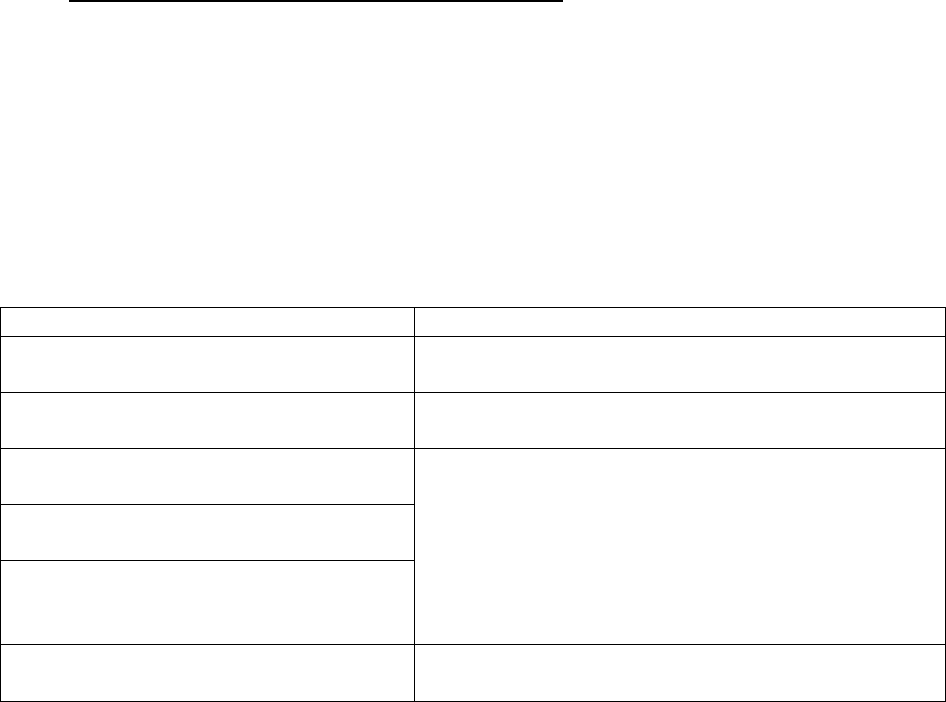
OPNAV M-5090.1
25 Jun 2021
17-4
products, and services that have or can have a significant impact on the environment, either
directly or indirectly. Examples of environmental aspects include, but are not limited to air,
water, wastewater, stormwater, and HW permits or HW generation. A Navy-EMS-appropriate
facility is typically a host command and its tenants within the installation’s fenceline. It also
includes any satellite properties under direct control of the installation commanding officer
(ICO) of the host command or the commanding officer (CO) of a tenant command.
Alternatively, a Navy-EMS-appropriate facility may:
a. In Navy-concentrated areas, encompass multiple non-contiguous fencelines under direct
control of a naval complex ICO or even the entire area of responsibility (AOR) of the Region
Commander; or
b. Be defined as a major mission tenant such as a naval shipyard or naval hospital where the
BSO elects to define its component commands’ EMSs separate from, but in coordination with,
its respective host command’s EMS. An environmental memorandum of agreement should be in
place in accordance with chapter 1 (Organization and Coordination), subparagraph 1-3.2f of this
manual.
17-3.2. Elements of an Environmental Management System. To satisfy the requirements of
references (a), (b), and (c), Navy-EMS-appropriate facilities must continue to implement,
maintain, and improve their EMSs. Full conformance with the required elements in this
paragraph must be achieved and validated with an external EMS audit at all Navy-EMS-
appropriate facilities by the BSO no later than 3 years from the date of this manual.
Environmental management procedures (EMP) must be developed and documented for each
element (refer to table 17-1 of this manual for a list of required elements and the corresponding
chapter(s) of this manual) that is not already addressed and described in an Internal Audit Plan
(IAP) (refer to subparagraph 17-3.2n (Element 14)) of this manual. Where appropriate, EMPs
may be combined to streamline documentation (see table 17-1, footnotes 2 and 3 of this manual).
Table 17-1. Required Elements of an EMS
Required Element
1
Corresponding OPNAVINST 5090.1E Chapter
Element 1: General Requirements and
Scope
Subparagraph 17-3.2a and chapter 1 (Organization
and Coordination)
Element 2: Leadership Commitment
and Environmental Policy
Subparagraph 17-3.2b and the Requirements section
of each chapter
Element 3: Environmental Aspects,
Risk, and Opportunities
Subparagraphs 17-3.2c, 17-3.2d, and 17-3.2e. In
addition, the environmental aspects, risk, and
opportunities; legal requirements and compliance
obligations; and objectives, targets, and POA&Ms of
applicable chapters
Element 4: Legal Requirements and
Compliance Obligations
Element 5: Environmental Objectives,
Targets, and Plans of Action and
Milestones (POA&M)
Element 6: Resources, Roles, and
Responsibilities
Subparagraph 17-3.2f and the Responsibilities
section of each chapter

OPNAV M-5090.1
25 Jun 2021
17-5
Required Element
1
Corresponding OPNAVINST 5090.1E Chapter
Element 7: Competence, Training, and
Awareness
Subparagraph 17-3.2g, chapter 3 (Environmental
Readiness Training), and the training requirements
in applicable chapters
Element 8: Communication
Subparagraph 17-3.2h and chapter 5 (Outreach and
Communications)
Element 9: Documented Information
2
Subparagraph 17-3.2i and the individual media
chapters
Element 10: Document Control
2
Subparagraph 17-3.2j and the individual media
chapters
Element 11: Operational Planning and
Control
Subparagraph 17-3.2k and the individual media
chapters
Element 12: Emergency Preparedness
and Response
Paragraph 17-3.2l, chapter 39 (Oil and Hazardous
Substance Spill Preparedness and Response), and
the individual media chapters
Element 13: Performance Evaluation
through Monitoring, Measurement, and
Analysis
Subparagraph 17-3.2m, chapter 4 (Environmental
Performance Reporting), and the individual media
chapters
Element 14: Evaluation of Compliance
3
Subparagraph 17-3.2n
Element 15: Nonconformity, Corrective
Action, and Preventive Action
Subparagraph 17-3.2o and chapter 19 (Processing
Notices of Violation Under Environmental Laws and
Regulations)
Element 16: Control of Records
2
Subparagraph 17-3.2p
Element 17: Internal Audit
3
Subparagraph 17-3.2q
Element 18: Management Review and
Continual Improvement
Subparagraph 17-3.2r
1
Adapted from International Organization for Standardization (ISO) 14001:2015,
Environmental Management Systems—Requirements with Guidance for Use.
2
Elements 9, 10, and 16 and may be a combined EMP at the EMS-appropriate-facility level.
3
Elements 14 and 17 may be combined as one integrated IAP at the EMS-appropriate-facility
level.
a. Element 1: General Requirements and Scope. Each Navy-EMS-appropriate facility must
determine the boundaries and applicability of the EMS to establish its scope. Once the scope is
defined, all activities, products, and services within that scope need to be included in the EMS.
The scope must be maintained as documented information and be available to interested parties.
Tenants, vendors, contractors, and suppliers must be coordinated with and included in the scope
when their actions potentially affect environmental, transportation, or energy issues. Where
Navy-EMS-appropriate facilities manage DoD real property on which private activities are
permitted, licensed, authorized, or regulated, the Navy-EMS-appropriate facilities must consider
the environmental impacts of such activities in the scope of their EMSs. When determining this
scope, the Navy-EMS-appropriate facility must consider:
(1) External and internal issues that are relevant to the installation or activity mission and
that affect its ability to achieve the intended outcome of the EMS, including environmental
conditions capable of affecting or being affected by the Navy-EMS-appropriate facility;

OPNAV M-5090.1
25 Jun 2021
17-6
(2) All relevant legal requirements and compliance obligations;
(3) Organizations, tenants, functions, and physical boundaries;
(4) Activities, products, and services; and
(5) Authority and ability to exercise control and influence.
b. Element 2: Leadership Commitment and Environmental Policy. The CO of each Navy-
EMS-appropriate facility must demonstrate leadership and commitment with respect to the EMS
by:
(1) Taking accountability for the effectiveness of the EMS;
(2) Ensuring that an environmental policy and environmental objectives are established,
implemented, and maintained and are compatible with the strategic direction of the installation
and the defined scope of its EMS. The environmental policy statement must be communicated
within the Navy-EMS-appropriate facility and made available to interested parties. The policy
must be reviewed at least annually and updated, as needed, to ensure it remains relevant to the
installation or activity’s mission, and must include commitments to:
(a) Protect the environment, including prevention of pollution;
(b) Conform to applicable legal requirements and compliance obligations; and
(c) Continually improve the EMS to enhance environmental performance.
(3) Ensure the integration of the EMS requirements into the Navy-EMS-appropriate
facility’s business processes;
(4) Ensure that the resources needed for the EMS are available;
(5) Communicate the importance of effective environmental management and of
conforming to the EMS requirements;
(6) Ensure that the EMS achieves its intended outcome(s);
(7) Direct and support persons to contribute to the effectiveness of the EMS;
(8) Promote continual improvement; and
(9) Support other relevant management roles to demonstrate their leadership as it applies
to their areas of responsibility.

OPNAV M-5090.1
25 Jun 2021
17-7
c. Element 3: Environmental Aspects, Risks, and Opportunities
(1) Environmental Aspects
(a) Within the defined scope of the EMS, the Navy-EMS-appropriate facility must
identify the environmental aspects of its operational practices, activities, products, and services
that it can control and those that it can influence, considering a life-cycle perspective. When
determining environmental aspects, the installation must consider:
1. Change, including planned or new developments, and new or modified
activities, products and services; and
2. Abnormal conditions and reasonably foreseeable emergency situations.
(b) The Navy-EMS-appropriate facility must determine those aspects that have or can
have a significant impact on the environment (i.e., significant environmental aspects). The
Navy-EMS-appropriate facility must communicate its significant environmental aspects among
the various levels and functions of the installation or activity. The Navy-EMS-appropriate
facility must maintain documented information on:
1. Criteria used to determine its significant environmental aspects;
2. Environmental aspects; and
3. Significant environmental aspects.
(2) Risk Planning
(a) The Navy-EMS-appropriate facility must:
1. Determine the risks and opportunities associated with the mission that need to
be addressed to give assurance that the environmental readiness program can achieve its intended
outcome to prevent or reduce undesired effects, including the potential for external
environmental conditions to affect the installation or activity;
2. Maintain documented information on risks and opportunities that need to be
addressed; and
3. Plan to take actions to address risks and opportunities, significant
environmental aspects, legal requirements, and compliance obligations; integrate and implement
the actions into its EMS processes; and evaluate the effectiveness of these actions.
(b) Each media manager must identify the location of their environmental aspects and
determine which locations present the highest risk. The media manager must maintain
documented information to the extent necessary to have confidence that the environmental
aspects and risks are being managed effectively.

OPNAV M-5090.1
25 Jun 2021
17-8
d. Element 4: Legal Requirements and Compliance Obligations
(1) The Navy-EMS-appropriate facility must maintain documented information on its
legal requirements and compliance obligations. Each Navy-EMS-appropriate facility must:
(a) Identify and have access to Federal, State, local, DoD, Department of the Navy,
regional, and installation-level legal requirements and compliance obligations related to its
environmental aspects; and
(b) Determine how these requirements apply to the installation or activity.
(2) Each media manager must identify the location of their environmental aspects and
determine the compliance obligations at those locations. The media manager must maintain
documented information to the extent necessary to have confidence that the compliance
obligations are being managed effectively.
e. Element 5: Environmental Objectives, Targets, and POA&Ms
(1) General. Each Navy-EMS-appropriate facility must establish environmental
objectives for the installation or activity and ensure that these objectives:
(a) Consider the Navy-EMS-appropriate facility’s significant environmental aspects
and its legal requirements and compliance obligations;
(b) Consider risks and opportunities associated with the mission;
(c) Are consistent with and supportive of the environmental policy statement;
(d) Are achievable within economic and technological restraints and meet operational
and business requirements;
(e) Are measurable (if practicable);
(f) Are documented, monitored, and communicated; and
(g) Are reviewed and revised at least annually, according to a schedule established by
the facility.
(2) Planning. When planning how to achieve its environmental objectives, the Navy-
EMS-appropriate facility must determine what will be done; what resources will be required;
who will be responsible; when it will be completed; and how the results will be evaluated,
including indicators for monitoring progress toward achievement of measurable environmental
objectives. The Navy-EMS-appropriate facility must consider how the actions to achieve
environmental objectives can be integrated into the Navy-EMS-appropriate facility’s mission
processes.

OPNAV M-5090.1
25 Jun 2021
17-9
(3) P2. P2 must be incorporated into EMS objectives as applicable to improve
environmental performance. A separate P2 plan may be required by State or local regulations.
(4) Green or Sustainable Procurement. The Navy-EMS-appropriate facility must
implement the DoD Sustainable Procurement Program using reference (f) as a guide. It requires
that the Navy consider green products and services as the first choice in all procurement actions
and use green products and services to the maximum extent practicable, consistent with Federal
procurement preference programs.
f. Element 6: Roles, Responsibilities, and Authority
(1) The most significant resource for every organization is its senior leadership’s
commitment to EMS implementation and sustainability. General Navy environmental roles,
responsibilities, and authority are outlined in chapter 1 (Organization and Coordination) of this
manual. Funding resources and requirements are included in chapter 2 (Funding) of this manual.
Top management must ensure that the responsibilities and authorities for relevant roles are
assigned and communicated within the Navy-EMS-appropriate facility to facilitate effective
environmental management. Top management must assign the responsibility and authority for:
(a) Ensuring that the EMS conforms to the requirements of this chapter; and
(b) Reporting on the performance of the EMS, including environmental performance,
to senior leadership.
(2) Each media manager must identify the personnel, at each location where their
environmental aspects occur, that can complete environmental management tasks on behalf of
the Environmental Department. The media manager must maintain documented information to
the extent necessary to have confidence that, at each location, assigned environmental tasks are
known, understood and are completed effectively.
(3) Requirements must be included in contracts to ensure that the contractor’s roles and
responsibilities under the EMS are properly addressed.
(4) Responsibilities assigned within the scope of the EMS are further detailed in section
17-4 of this manual.
g. Element 7: Competence, Training, and Awareness. The Navy’s goal is to implement
efficient and effective training that provides the right training to the right people at the right time
in support of the Navy’s mission. The Navy Environmental Readiness Training Program
(NERTP) supports this goal by identifying and resourcing the development and delivery of
quality environmental training courses. In addition to NERTP-sponsored courses, other specialty
schools may also resource, develop, and deliver environmental courses to meet their specific
requirements. All personnel (i.e., civilian, active-duty military, and reserve military) must
receive training as applicable to their specific job assignments and levels of responsibility.
NERTP course descriptions, target audiences, and schedules are available on the CECOS and
Naval Safety and Environmental Training Center Web sites (refer to appendix E (Web Sites) of

OPNAV M-5090.1
25 Jun 2021
17-10
this manual for Web site addresses). Refer to chapter 3 (Environmental Readiness Training) of
this manual for information on general overall and billet-specific environmental training
requirements as well as training requirements for personnel who have collateral environmental
responsibilities. Chapter 3 (Environmental Readiness Training), table 3-1 of this manual
provides NERTP formal training courses and target audiences for each formal course offered.
(1) Navy-EMS-Appropriate Facility Training Determination Requirements. The Navy-
EMS-appropriate facility must:
(a) Determine the necessary competence of person(s) doing work on the installation
that affects environmental performance and the ability to fulfill legal requirements and
compliance obligations;
(b) Determine training needs associated with their environmental aspects and the
EMS; and
(c) Retain appropriate documented information as evidence of training needs analysis,
conduct of the training, and competence.
(2) Environmental Awareness Training. All Navy military, civilian, and contractor
personnel must receive initial and refresher environmental awareness training as soon as
practical after reporting to an installation or activity and at least every 3 years. Both site-specific
and general EMS training can be obtained through the Environmental Compliance Assessment
Training and Tracking System (ECATTS) Web site, where available. (Refer to appendix E
(Web Sites) of this manual for Web site address.) Completion of training must be documented.
Personnel doing work under the Navy-EMS-appropriate facility’s control must be aware of:
(a) The environmental policy;
(b) The significant environmental aspects and related actual or potential impacts
associated with their work;
(c) The contribution to the effectiveness of the EMS, including the benefits of
enhanced environmental performance; and
(d) The implications of not conforming to the EMS requirements, including legal
requirements and compliance obligations.
(3) EMS Management Training. EMS management representatives and environmental
staff responsible for implementation and maintenance of an EMS must receive EMS
implementation, management, and sustainment training. Completion of the CECOS Advancing
an Effective EMS (A-4A-0098) course will satisfy this requirement. EMS implementation and
management personnel must be familiar with the provisions of this chapter.
(4) EMS and Environmental Compliance Auditor Training. Lead auditors, team
members, and all media managers performing EMS and compliance audits, EMS managers, and

OPNAV M-5090.1
25 Jun 2021
17-11
installation environmental program directors (IEPD) must complete the CECOS Integrated EMS
and Compliance Auditing (A-4A-0079) course, be familiar with the provisions of this chapter,
and receive training to perform their specific job duties. EMS auditor training is also
recommended for other individuals with responsibility for implementation and maintenance of
the EMS and environmental compliance, including major process owners, public works staff,
and members of the installation cross-functional team. Refresher training should occur when
there are significant changes to procedures or ISO standards to which the EMS is conforming. In
some extenuating instances, the BSO may approve a waiver to these auditor training
requirements.
h. Element 8: Communication. The Navy-EMS-appropriate facility must plan and
implement a process for internal and external communications relevant to the environmental
readiness program, including about what to communicate; when to communicate; with whom to
communicate; and how to communicate. When planning its communications process, the Navy-
EMS-appropriate facility must take into account legal requirements and compliance obligations
and ensure that environmental information communicated is consistent with information
generated within the EMS and is reliable. The Navy-EMS-appropriate facility also must respond
to relevant communications on its EMS. The Navy-EMS-appropriate facility must retain
documented information as evidence of its communications, as appropriate.
(1) Internal Communication. Internal communication within the Navy-EMS-appropriate
facility may include the CO, executive officer (XO), public works officer (PWO), deputy PWO,
IEPD, EMS management representative, EMS cross-functional team, environmental office, other
program managers (e.g., facilities, safety, medical), all units and departments that own operations
with environmental aspects, and others that may have an impact on the Navy-EMS-appropriate
facility’s environmental affairs. With regard to its EMS, the Navy-EMS-appropriate facility
must:
(a) Communicate among the various tenants, vendors, contractors, and suppliers of
the Navy-EMS-appropriate facility, including changes to the EMS, as appropriate; and
(b) Ensure its communication process enables any person doing work under the
Navy-EMS-appropriate facility’s control to contribute to continual improvement.
(2) External Communication. External communication may include communications
from regulatory agencies, the public, and others outside the Navy who are interested in the Navy-
EMS-appropriate facility’s environmental readiness programs. Each Navy-EMS-appropriate
facility must externally communicate information relevant to the EMS, as determined by its
communication process, coordinated with the appropriate public affairs officer (PAO), and as
required by legal requirements and compliance obligations.
(3) Release of Reports and Information. BSOs and Navy commands must consult legal
counsel for advice on releasability and exemptions under the Freedom of Information Act
(FOIA). If the request is made by a third party involved in litigation, references (g) and (h) also
apply. Additional Navy outreach and communications guidance is included in chapter 5
(Outreach and Communications) of this manual.

OPNAV M-5090.1
25 Jun 2021
17-12
i. Element 9: Documented Information
(1) Each Navy-EMS-appropriate facility must create, implement, and maintain all
environmental documents appropriate to its environmental readiness programs and EMSs that
demonstrate fulfillment of its legal requirements and compliance obligations. Each Navy-EMS-
appropriate facility must create and update essential documents so they:
(a) Are easily identified with appropriate description (e.g., title, date, author,
reference number) and location;
(b) Are in the appropriate format (e.g., language, software version, graphics) and
media (e.g., paper, electronic); and
(c) Are reviewed and approved for suitability and adequacy prior to issue or reissue,
and updated as necessary.
(2) Each media manager must create and implement environmental documents
appropriate to their environmental program and EMS that demonstrate fulfilment of its legal
requirements and compliance obligations.
j. Element 10: Document Control
(1) Each Navy-EMS-appropriate facility must inventory all documents appropriate to its
environmental readiness programs and practices and identify other documents essential to the
efficient operation of its EMS. Documented information of external origin determined by the
Navy-EMS-appropriate facility to be necessary for the planning and operation of the EMS must
be identified, as appropriate, and controlled. Each Navy-EMS-appropriate facility must control
essential documents to ensure:
(a) The most current version is available and suitable for use, where and when it is
needed, with older versions removed from circulation and destroyed or archived as appropriate;
and
(b) It is adequately protected (from, e.g., loss of confidentiality, improper use, loss of
integrity).
(2) Each media manager must inventory all documents appropriate to their environmental
program and practices and identify other documents essential to the efficient operation of their
program.
k. Element 11: Operational Planning and Control
(1) The installation must establish, implement, control and maintain the processes needed
to meet EMS requirements, and to implement the actions identified in Element 3, by:
(a) Establishing operating criteria for the process(es) and practices; and
OPNAV M-5090.1
25 Jun 2021
17-13
(b) Implementing control of the process(es), in accordance with the operating criteria.
(2) At multi-EMS installations, the host must coordinate the relevant parts of the EMS
with the other organizations.
(3) Navy-EMS-appropriate facilities must ensure each practice with significant aspects is
controlled, to minimize risk to mission and impacts to the environment and to comply with
applicable legal requirements and compliance obligations.
(4) The installation must establish a process(es) for the implementation and control of
planned temporary and permanent changes that impact environmental performance, including:
(a) New products, services and processes, or changes to existing products, services
and processes;
(b) Changes to legal requirements and compliance obligations;
(c) Changes in knowledge or information about environmental aspects and risks; and
(d) Developments in knowledge and technology.
(5) The installation must review the consequences of unintended changes, taking action
to mitigate any adverse effects, as necessary.
(6) The installation must establish, implement and maintain a process(es) to control the
procurement of products and services in order to ensure their conformity to its EMS.
(7) The installation must coordinate its procurement process(es) with its contractors, in
order to identify hazards and to assess and control the environmental risks arising from:
(a) Contractor activities and operations that impact the installation;
(b) Installation’s activities and operations that impact the contractors’ workers; and
(c) Contractor activities and operations that impact other interested parties in the
workplace.
(8) The installation must ensure that the requirements of its EMS are met by contractors
and their workers. The installation’s procurement process(es) must define and apply
environmental criteria for the selection of contractors.
(9) The installation must ensure that outsourced functions and processes are controlled.
The installation must ensure that its outsourcing arrangements are consistent with compliance
obligations and with achieving the intended outcomes of the EMS. The type and degree of
control to be applied to these functions and processes must be defined within the EMS.

OPNAV M-5090.1
25 Jun 2021
17-14
(10) Consistent with a life-cycle perspective, the Navy-EMS-appropriate facility must:
(a) Determine environmental requirements for the procurement of products and
services, as appropriate;
(b) Establish controls to ensure that environmental requirements are considered in the
design process for the development, delivery, use, and end-of-life treatment of its products and
services, as appropriate;
(c) Communicate relevant environmental requirement(s) to external providers,
including contractors; and
(d) Consider the need to provide information about potential significant
environmental impacts during the delivery of the products or services and during use and end-of-
life treatment of the product.
(11) Each media manager will ensure that their media program plan and procedures take
into account the requirements of Element 11 and that the media management plans are
effectively implemented and maintained.
l. Element 12: Emergency Preparedness and Response
(1) The Navy-EMS-appropriate facility must establish and implement a procedure(s) or
plan(s), if appropriate and applicable, specifying how it will respond to potential environmental
emergency situations and potential accidents. Emergency preparedness and response procedures
are detailed in chapter 39 (Oil and Hazardous Substance Spill Preparedness and Response) of
this manual and in individual program- and media-specific chapters of this manual. The Navy-
EMS-appropriate facility must:
(a) Respond to actual emergency situations and accidents;
(b) Take action to reduce the consequences of environmental emergency situations,
appropriate to the magnitude of the emergency or accident and the potential environmental
impact;
(c) Take action to prevent the occurrence of environmental emergency situations and
accidents;
(d) Periodically conduct drills of the procedure(s) and plan(s) where practicable; and
(e) Periodically review, evaluate, and, where necessary, revise the procedure(s) and
plan(s), in particular, after the occurrence of accidents, emergency situations, or tests.
(2) Each media manager will ensure that their media program plan specifies how it will
respond to potential environmental emergency situations and potential accidents.

OPNAV M-5090.1
25 Jun 2021
17-15
m. Element 13: Performance Evaluation through Monitoring, Measurement, and Analysis
(1) Navy-EMS-appropriate facilities must monitor overall environmental performance
and progress towards the facility’s environmental objectives. Program- and media-specific
monitoring and measurement requirements are located in chapter 4 (Environmental Performance
Reporting) of this manual and in the individual program- and media-specific chapters of this
manual.
(a) The Navy-EMS-appropriate facility must determine:
1. What needs to be monitored and measured;
2. The methods for monitoring, measurement, and analysis, as applicable, to
ensure valid results;
3. The criteria against which the Navy-EMS-appropriate facility must evaluate its
environmental performance, using appropriate indicators;
4. When the monitoring and measuring must be performed; and
5. When the results from monitoring and measurement must be analyzed and
evaluated.
(b) The Navy-EMS-appropriate facility must ensure that calibrated or verified
monitoring and measurement equipment is used and maintained as appropriate. The Navy-EMS-
appropriate facility must evaluate its environmental performance information and the
effectiveness of the EMS. The Navy-EMS-appropriate facility must provide input to the
management review for the evaluation of the effectiveness of the EMS. The Navy-EMS-
appropriate facility must retain appropriate documented information as evidence of the
monitoring, measurement, analysis, and evaluation results. In addition to the management
reviews, reporting requirements for EMSs include, but are not limited to:
1. Navy EMS Metrics. Effective implementation and maintenance of EMSs for
DoD facilities and organizations are necessary to achieve DoD environmental goals. Navy-
EMS-appropriate facilities worldwide must report the status of the Navy EMS metrics on a
fiscal-year basis by 1 November of each year.
2. Fully Conforming EMS In-Place Indicator. BSOs must maintain a roster of
conforming Navy-EMS-appropriate facilities and report updates to the Office of the Chief of
Naval Operations, Energy and Environmental Readiness Division (OPNAV N45). The Navy-
EMS-appropriate facility must communicate information relevant to its environmental
performance both internally and externally, as determined by its communication process and as
required by legal requirements and compliance obligations.
(2) Each media manager must evaluate the environmental performance of their program
and the effectiveness of the EMS in managing the environmental aspect and risks associated with

OPNAV M-5090.1
25 Jun 2021
17-16
the program. Each media manager will retain appropriate documented information as evidence
of the monitoring, measurement, analysis, and evaluation results.
n. Element 14: Evaluation of Compliance
(1) Navy installations and activities worldwide must, in coordination between host and
tenant commands, verify the environmental regulatory and policy compliance status of the
facility on a 1-year internal cycle. The internal compliance audits may be conducted in
combination with the internal EMS audits (subparagraph 17-3.2q (Element 17) of this manual),
depending on the complexity, needs, and demonstrated compliance posture of the facility.
(a) IAP. The installation, activity, or facility must establish and implement an IAP to
describe how the compliance audits will be accomplished over the course of the year. The Navy
installation, activity, or facility must review the IAP annually and update it as necessary.
(b) Internal Audit Documentation (IAD). The installation, activity, or facility must
retain IAD as evidence of completion for no less than 3 years. IAD must identify compliance
deficiencies, deficiencies that have remained open from previous audit periods, assigned root
cause codes, and POA&Ms. The results of the compliance audits must be submitted periodically
to the CO of the installation or activity and tenant CO (if applicable) and must be reviewed
annually to identify trends and outstanding compliance deficiencies. The BSO may request
submittal of the IAD to the BSO or, at a minimum, the BSO must review the IAD during the
external compliance audit site visit.
(2) Each media manager must verify the environmental regulatory and policy compliance
status of their program on a 1-year internal cycle per the IAP and will retain IAD as evidence of
completion for no less than 3 years. Results of the compliance audits will be submitted to the
CO on a periodic basis as part of the management review and be reviewed annually to identify
trends and outstanding compliance deficiencies.
o. Element 15: Nonconformity, Corrective Action, and Preventive Action. Problems are
often identified through EMS and compliance audits, monitoring of EMS objectives and targets,
and inspection of practices. When a compliance deficiency or EMS nonconformity occurs, the
Navy-EMS-appropriate facility must follow a structured problem-solving process that takes
immediate action to control, correct, and mitigate adverse environmental impacts. The process
should also evaluate the need for preventive action to eliminate the causes, in order that it does
not recur or occur elsewhere, by determining the root causes of the nonconformity and assigning
a root cause code to every compliance deficiency. Corrective and preventive actions (CAPA) are
typically the responsibility of the practice owner to resource and implement. The
nonconformity, corrective action, and preventive action process must also include updating EMS
documentation, such as instructions or training requirements and materials, to prevent
recurrence. The Navy-EMS-appropriate facility must retain documentation as evidence of the
nature of compliance deficiencies and EMS nonconformities, any subsequent actions taken, and
the results of any corrective action.

OPNAV M-5090.1
25 Jun 2021
17-17
p. Element 16: Control of Records
(1) Records are a form of documentation that provide evidence of results achieved.
(a) Each Navy-EMS-appropriate facility must inventory all records appropriate to its
EMS, including, but not limited to records necessary to demonstrate compliance with applicable
legal requirements and compliance obligations; the monitoring of practices and tracking of
environmental objectives, targets, and POA&Ms; internal and external EMS and compliance
audits (refer to subparagraphs 17-3.2n (Element 14) and 17-3.2q (Element 17) and paragraph 17-
3.3 of this manual); and management reviews (refer to subparagraph 17-3.2r (Element 18) of this
manual).
(b) Each Navy-EMS-appropriate facility must implement a system to maintain
records so they:
1. Can be easily located;
2. Are protected from alterations or damage;
3. Are available when and where needed; and
4. Are removed from circulation when obsolete and destroyed or archived as
appropriate.
(c) The policy on retention and disposition of records is located in chapter 1
(Organization and Coordination) of this manual and in individual program- and media-specific
chapters of this manual.
(2) Each media manager must inventory all records appropriate to their environmental
program and practices and identify other records essential to the efficient operation of their
program.
q. Element 17: Internal EMS Audit
(1) Navy-EMS-appropriate facilities must complete an internal EMS audit of all
processes, facilities, and practices within the scope of the EMS and document the findings at
least once within a 12-month period. The internal EMS audit may be conducted in combination
with the internal compliance audit (subparagraph 17-3.2n (Element 14) of this manual) to assist
in determining if the EMS is effectively implemented and maintained and conforms to:
(a) The Navy-EMS-appropriate facility’s own requirements for its EMS; and
(b) The requirements of this chapter and, if chosen, requirements of reference (d).

OPNAV M-5090.1
25 Jun 2021
17-18
(2) The Navy-EMS-appropriate facilities must:
(a) Plan, establish, implement, and maintain audit program(s) that outline the
frequency, methods, responsibilities, planning, and reporting requirements. The audit programs
must take into consideration the environmental importance of the processes concerned, risks and
opportunities, changes affecting the facility, and the results of previous audits;
(b) Define the audit criteria and scope for each audit;
(c) Document an IAP to describe how the internal audit will be accomplished over the
course of the year. The Navy-EMS-appropriate facility must review the IAP annually and
update it as necessary;
(d) Select auditors and conduct audits to ensure objectivity and the impartiality of the
audit process; and
(e) Report results of the audits to relevant management.
(3) The Navy-EMS-appropriate facility must retain audit documentation as evidence of
the implementation of the audit program and the audit results.
(4) Each media manager must complete an internal EMS audit, in accordance with the
IAP, of all processes, facilities, and practices where their environmental aspect occurs and
document the findings at least once within a 12-month period. The internal EMS audit may be
conducted in combination with the internal compliance audit (subparagraph 17-3.2n (Element
14) of this manual) to provide information on whether their program is effectively implemented
and maintained, and conforms to requirements. The results of the audits must be reported to
relevant management and documented information retained as evidence of the implementation of
the audit program and the audit results.
r. Element 18: Management Review and Continual Improvement. The CO, senior
leadership, and applicable tenant management personnel of each Navy-EMS-appropriate facility
must conduct a management review of the EMS, at least annually, to ensure its continuing
suitability, adequacy, and effectiveness. The Navy-EMS-appropriate facility must continually
improve the suitability, adequacy, and effectiveness of the EMS to enhance environmental
performance.
(1) The management review must include, but is not limited to:
(a) The status of actions from previous management reviews;
(b) Changes in:
1. External and internal issues that are relevant to the EMS;
2. Legal requirements and compliance obligations; and

OPNAV M-5090.1
25 Jun 2021
17-19
3. Its significant environmental aspects and risks and opportunities;
(c) The extent to which objectives have been met;
(d) Information on the Navy-EMS-appropriate facility’s environmental performance,
including trends in:
1. Internal compliance and EMS audit results, including compliance deficiencies,
EMS nonconformities, and corrective actions;
2. Monitoring and measurement results; and
3. Conformity to its legal requirements and compliance obligations, including
enforcement actions and notices of violation (NOV);
(e) Communication(s) from external interested parties;
(f) Opportunities for continual improvement; and
(g) The adequacy of resources required for maintaining an effective environmental
compliance program and EMS.
(2) The outputs of the management review must include:
(a) Conclusions on the continuing suitability, adequacy, and effectiveness of the
EMS;
(b) Decisions related to continual improvement opportunities;
(c) Needed changes to the EMS, including resource needs;
(d) Action items when objectives have not been met; and
(e) Any mission-related implications for the strategic direction of the Navy-EMS-
appropriate facility.
(3) Management reviews and outputs must be documented.
17-3.3. Environmental Management Systems and Environmental Compliance Audits. As
described in subparagraphs 17-3.2n (Element 14) and 17-3.2q (Element 17) of this manual,
evaluation of compliance and internal EMS audits are essential elements of an EMS to
accomplish the checking and evaluation of compliance and its ability to fulfill its legal
requirements, compliance obligations, and EMS requirements as applicable. Navy installations
and activities worldwide must verify the continuing EMS conformance and environmental
regulatory compliance status, at a minimum of a 1-year internal and 3-year external cycle.

OPNAV M-5090.1
25 Jun 2021
17-20
a. Internal EMSs and Environmental Compliance Audits. Internal EMS and environmental
compliance audit requirements are provided in subparagraphs 17-3.2n (Element 14) and 17-3.2q
(Element 17) of this manual.
b. External EMSs and Environmental Compliance Audits. External compliance audits must
be conducted at all Navy installations or activities worldwide, at a minimum of every 3 years on
a schedule determined by their BSO. They are generally conducted in conjunction with external
EMS audits, where applicable. An external EMS audit is required at a minimum of every 3 years
at EMS-appropriate facilities prior to self-declaration of conformance. External audits must
evaluate compliance with all applicable DoD and Navy policies and legal and other compliance
requirements for environmental media selected for auditing. Additional focus may be placed on
specific environmental readiness programs based on previous external audits and the
installation’s or activity’s compliance history and internal compliance audits.
(1) External Audit Schedule. External EMS and compliance audits must be conducted on
a schedule determined by the BSO at intervals not longer than 3 years from the last external
compliance audit. Installations or activities may also contact their BSO and request a
compliance audit at any time. The schedule must also indicate those installations and activities
that serve only administrative functions with minimal environmental requirements where
exemptions are justifiable (refer to subparagraph 17-1.3c of this manual). BSOs must, annually,
review this schedule, update it as necessary, and submit it to OPNAV N45.
(2) External Audit Plan. The external EMS and compliance audit plan describes the
schedule and scope of oversight planned for the external EMS and compliance audit site visit at
each of the BSO’s installations or activities. The BSO of the installation or activity, in
coordination with tenant commands, provides input on the schedule and scope of oversight based
on the review of the IAP, IAD, and internal EMS audit documentation provided by each
installation or activity; previous compliance audits; NOVs; and any additional information
available on each installation’s or activity’s environmental performance. The plan must also
indicate those organizations and special areas on the installation or activity that serve only
administrative functions with minimal environmental requirements where exemptions are
justifiable (refer to subparagraph 17-1.3c of this manual). The BSO must review and update the
plan annually.
(3) Navy-Qualified EMS and Environmental Compliance Auditors. The BSO of the host
installation or activity must conduct the external EMS and compliance audits and ensure
coordination with tenant commands. External EMS and compliance audit teams must be led by a
Navy-qualified auditor selected by the BSO. BSOs may delegate auditing responsibilities;
however, auditors must be independent of the appropriate facility or installation being audited.
Navy-qualified auditors may be staff, other DoD component personnel, another Federal agency
(outside of DoD) personnel, or private consultants. EMS and environmental compliance auditors
must be knowledgeable of the media they are assessing and of the auditing process, and
understand EMS concepts contained within this chapter. Every person preparing for,
conducting, reviewing, or approving external EMS and compliance audits must receive specific
comprehensive training in the assigned subject matter. In addition, EMS and compliance

OPNAV M-5090.1
25 Jun 2021
17-21
auditors must have completed the CECOS Integrated EMS and Compliance Auditing course (A-
4A-0079) and must be familiar with the provisions of this chapter.
(4) Root Cause Analysis. BSOs must incorporate root cause analysis in their
environmental compliance audit programs. Root causes of compliance deficiencies are generally
associated with an EMS element. Once a compliance deficiency is identified, it should be
investigated to determine the cause so corrective and preventive action can be taken. In
developing a plan for addressing a compliance deficiency, installations should consider what
actions need to be taken to address the problem, what changes need to be made to correct the
situation, and what should be done to prevent the compliance deficiency from recurring. The
character and timing of such actions should be appropriate to the nature and scale of the
compliance deficiency and the environmental impact. Appendix C (Message Formats), table C-1
of this manual provides a list of standard Navy root causes. A root cause code must be assigned
and for every identified compliance deficiency.
(5) Environmental Compliance Checklists. Checklists of regulations are available in
several forms for use in evaluating compliance and may be tailored to include those requirements
applicable to a particular installation or activity. Commander, Naval Facilities Engineering
Command (COMNAVFACENGCOM) can assist with identifying and tailoring checklists. U.S.
Navy ListBuilder (refer to appendix E (Web Sites) of this manual for Web site address) is a
checklist creator that includes Federal, State, and Navy requirements, final governing standards
(FGS), and the Overseas Environmental Baseline Guidance Document, and is updated on a
regular basis.
(6) External EMS and Environmental Compliance Audit Out-Brief. The audit team must
present its findings in an out-brief at the end of the site visit to the Navy installation, EMS-
appropriate facility ICO, and other applicable installation leadership (e.g., XO, PWO, IEPD,
EMS management representative), and provide a working draft audit report.
(7) External EMS and Environmental Compliance Audit Report. Results of the external
EMS and environmental compliance audit must be documented in the external audit report. The
audit report must include all identified EMS nonconformities; regulatory and policy compliance
deficiencies; and recommendations for corrective actions, preventive actions, and process
improvements.
(a) For EMS-appropriate facilities, the external report documentation must include
the effectiveness of the EMS and its role in supporting environmental performance with respect
to:
1. Conformance to this chapter and, if chosen, reference (d);
2. Compliance with environmental requirements;
3. Review of environmental aspects;
4. Status in meeting EMS objectives;

OPNAV M-5090.1
25 Jun 2021
17-22
5. Strengths and weaknesses of EMS elements potentially resulting in
nonconformities;
6. Potential underlying root causes of EMS nonconformities and environmental
compliance deficiencies that correlate with weaknesses in the EMS; and
7. Recommendations for improvements to the EMS.
(b) The BSO must release the final report to the installation, activity, or Navy-EMS-
appropriate facility within 90 days of completion of the external audit site visit. The EMS
management representative of the appropriate facility must brief findings of the external EMS
audit to senior leadership at the next management review (refer to subparagraph 17-3.2r
(Element 18) of this manual).
(c) BSOs must consult legal counsel for advice on the releasability of EMS records
and exemptions under the FOIA. Reference (j) applies to all FOIA requests. If the request is
made by a third party involved in litigation, references (g) and (h) also apply.
(8) POA&M and Follow-Up. Within 30 calendar days of the audit out-brief (or sooner at
the discretion of the BSO), the installation or appropriate facility must provide any comments on
the working draft audit report; provide a POA&M via the BSO-approved POA&M submittal and
review process; identify the root cause(s) of each EMS nonconformity and compliance
deficiency; and detail how each deficiency has been or will be resolved. The installation or
facility must provide evidence that EMS conformance and compliance deficiencies have been
adequately resolved before the POA&M can be closed. The BSO has the authority to close out
EMS nonconformity and non-compliance issues and may delegate this responsibility as
appropriate. Until all EMS nonconformities and compliance findings are adequately resolved,
the Navy installation, activity, or EMS-appropriate facility must submit an updated POA&M to
the BSO on a quarterly basis, or as otherwise specified by the BSO.
(9) Electronic Reporting Systems. Commands are encouraged to input EMS and
environmental compliance audit findings to electronic reporting systems. The Environmental
Management System Web site (EMSWeb) is one system that is recommended for conducting
internal and external EMS and compliance audits, developing and managing POA&Ms to
address resolution of findings, and maintaining EMS and compliance documents (refer to
appendix E (Web Sites) of this manual for Web site address).
(10) Third-Party Independent Reviews. BSOs must obtain third-party independent
reviews of those Navy-EMS-appropriate facilities with third-party certification to confirm
conformance to reference (d). Reviews must be conducted on a schedule to be determined by the
BSO. BSOs must assess their third-party independent review schedule annually and update it as
necessary. BSOs must provide the updated third-party independent review schedule to OPNAV
N45 annually.
(11) State Audit Privilege Laws. Installations must not invoke the protections of any of
the various State audit privilege or immunity laws without proper consultation with and approval

OPNAV M-5090.1
25 Jun 2021
17-23
by the chain of command. References (j) and (k) provide the procedures for required
consultation with the Office of the Deputy Assistant Secretary of the Navy, Environment, and the
Assistant Deputy Under Secretary of Defense for Environment, Safety, and Occupational Health.
17-3.4. Navy Environmental Management Systems Declaration of Conformance Protocol. This
protocol provides the Navy’s procedure for declaring continued EMS conformance and ensures
continual improvement in environmental performance. EMS conformance at all Navy-EMS-
appropriate facilities must be formally re-declared at least once every 3 years. Mission-funded
commands must not seek or fund third-party certification. The Navy-EMS-appropriate facility is
required to resolve all major findings of nonconformity to the satisfaction of the BSO. Once
resolved and approved by the BSO, the Navy-EMS-appropriate facility CO must sign an EMS
Declaration of Conformance Memorandum to re-declare conformance formally every 3 years.
Although an EMS can be considered conformant with minor nonconformities, it is necessary that
a POA&M for each minor nonconformity be defined and planned and that senior management
commit to correcting and preventing identified minor nonconformities. If the EMS external
audit is integrated with the external compliance audit, compliance deficiencies noted during the
external audit must be documented in the POA&M, clearly communicated and assigned to a
specific person for action, and tracked on a regular basis by status updates to senior leaders.
Compliance deficiencies noted during an external audit need not be corrected prior to the EMS
conformance declaration. Copies of the memorandum must be provided to the Navy-EMS-
appropriate facility’s EMS management representative, BSO, OPNAV N45, and other interested
parties. Navy-EMS-appropriate facilities with an externally registered EMS may use registration
documents to meet the EMS conformance requirement. However, they will still be required to
verify environmental compliance through the audit process.
17-4 Responsibilities
17-4.1. BSOs of Navy installations, activities, and EMS-appropriate facilities must:
a. Provide adequate resources, including staffing, to support the installation or activity under
their cognizance. For EMS nonconformities and compliance deficiencies identified in internal
and external EMS and environmental compliance audits, assist in identification and
programming for funding of corrective actions and process improvements. For mission-funded
commands, submit funding to correct Environmental Program Requirements Web (EPRWeb)
Guidebook chapter (e.g., Clean Water Act (CWA) requirements, Clean Air Act (CAA)
requirements, RCRA requirements). If necessary, submit funding requests as part of a mid-year
review to address emergent requirements;
b. Maintain a roster of conforming Navy-EMS-appropriate facilities under their cognizance
and report updates to OPNAV N45;
c. Advise OPNAV N45, the Region Commander, regional environmental coordinator, and
appropriate facility CO if an EMS nonconformity, compliance deficiency, or problem may result
in adverse public relations or require national coordination to solve;
OPNAV M-5090.1
25 Jun 2021
17-24
d. In coordination with other affected host and tenant BSOs, coordinate a cost-effective EMS
approach with the BSO of the host command that supports mission and operational requirements,
achieves full compliance with legal requirements, and continually improves performance by
reducing environmental risks and costs inherent to mission processes;
e. In coordination with other affected host and tenant BSOs, develop and execute an external
EMS audit and environmental compliance audit schedule for external auditing of its Navy-EMS-
appropriate facilities at intervals not longer than 3 years. Compliance audits are generally
conducted in combination with the external EMS audit, where applicable. The BSO should
release the final audit report to the Navy-EMS-appropriate facility within 90 days of completion
of the external audit site visit. Review external audit schedules annually and update as
appropriate. Provide the updated external EMS audit schedule to OPNAV N45;
f. Obtain third-party independent reviews of those Navy-EMS-appropriate facilities with
third-party certification to confirm conformance to reference (d). Reviews must be conducted on
a schedule to be determined by the BSO. BSOs must assess their third-party independent review
schedule annually and update as necessary. BSOs must provide the updated third-party
independent review schedule to OPNAV N45 annually;
g. Issue notification of upcoming external EMS and environmental compliance audits to the
ICO of the Navy installation, activity, or EMS-appropriate facility in a timely manner; and
h. Release the final external EMS and environmental compliance audit reports to the
installations and BSO headquarters within 90 days of the site visit.
17-4.2. BSOs of tenant commands included within a host installation or activity EMS must:
a. Ensure commands under their cognizance support and participate with the host Navy-
EMS-appropriate facility in implementing an EMS to cover all the tenant’s processes, facilities,
and practices with environmental aspects;
b. For EMS nonconformities and compliance deficiencies identified in internal and external
EMS audits and compliance audits, assist in identification and programming for funding of
corrective actions and process improvements. For mission-funded commands, submit funding to
correct nonconformities and deficiencies under the appropriate EPRWeb Guidebook chapter
(e.g., CWA requirements, CAA requirements, RCRA requirements). If necessary, submit
funding requests as part of a mid-year review to address emergent requirements;
c. Advise OPNAV N45, the host command, host BSO, and the tenant chain of command, if
an EMS nonconformity, compliance deficiency, or problem identified may result in adverse
public relations or require national coordination to solve;
d. Coordinate with the host BSO for any procurement that would affect environmental
aspects or have environmental implications at the host command;
OPNAV M-5090.1
25 Jun 2021
17-25
e. Coordinate with and support the BSOs of the host command in developing, documenting,
and executing a schedule and plan to conduct internal and external EMS and environmental
compliance audits as appropriate to cover processes, facilities, and practices on the installation or
activity; and
f. Close out nonconformity issues or delegate this responsibility as appropriate.
17-4.3. COMNAVFACENGCOM must:
a. Provide support to BSOs, region commanders, and shore commands in the use of EMS
software, such as selection and customization of automated checklists of Federal and State
regulations, FGSs, overseas requirements, and Navy policy requirements;
b. Provide assistance in the development of the 3-year audit schedule as directed by the
cognizant BSOs;
c. Upon request, assist BSOs in conducting external EMS and compliance audits, preparing
final audit reports, tracking corrective and preventive actions identified in the POA&Ms, and
reporting implementation quarterly to the BSO; and
d. Upon request, review results of annual internal EMS and compliance audits to identify
EMS nonconformities, compliance deficiencies, and their root causes.
17-4.4. Commander, Naval Supply Systems Command must:
a. Serve as the overall manager for the GPP and the supply and inventory control aspects of
the P2 program;
b. Provide green or sustainable procurement guidance and formal training to the acquisition
community, contracting officers, purchasing agents, and customers holding government credit
cards;
c. Ensure contracts include Federal Acquisition Regulation (FAR) and Defense FAR clauses
citing EMS and green or sustainable procurement requirements; and
d. Ensure DoD Sustainable Procurement Program metrics electronic tracking capabilities
exist to monitor and measure performance and audit effectiveness of program criteria specified
in reference (i).
17-4.5. In those regions where the Navy-EMS-appropriate facility is defined as the region, the
Region Commander must perform the responsibilities assigned to the COs of Navy-EMS-
appropriate facilities. COs of the Navy-EMS-appropriate facilities must:
a. Comply with all policy requirements described in subparagraph 17-3.2b (Element 2) of
this manual.
OPNAV M-5090.1
25 Jun 2021
17-26
b. Maintain EMS conformance and declare conformance per the Navy EMS Declaration of
Conformance Protocol at a minimum of every 3 years;
c. Sign and issue the Navy-EMS-appropriate facility environmental policy statement, review
it at least annually, and update it as needed to ensure it remains relevant to the facility’s mission;
d. Provide leadership and commitment to improve EMS by overseeing and conducting
periodic EMS management reviews throughout the year (at least one per year) to coincide with
the internal and external EMS and environmental compliance audit and the declaration of
conformance cycle;
e. Review the status of existing objectives and establish new objectives as needed per this
chapter;
f. In coordination with the affected commands, continually improve the EMS to cover all
processes, facilities, and practices with environmental aspects within the scope of the Navy-
EMS-appropriate facility;
g. Establish a means to communicate and coordinate the environmental aspects throughout
the Navy-EMS-appropriate facility with all Navy and non-Navy tenants, to include
environmental coordinator roles and responsibilities, where appropriate, for the purpose of
planning and sustaining the EMS;
h. Establish and participate in forums, such as environmental compliance boards, executive
management boards, and EMS cross-functional teams to ensure EMS policies are communicated
throughout the Navy-EMS-appropriate facility and with all tenant commands;
i. Designate an EMS management representative in writing to establish, implement, and
maintain the EMS and to report to senior management;
j. Conduct a documented management review with the EMS management representative and
the IEPD on a regular basis, at least annually, to review EMS conformance status and receive
updates on the status and progress of the EMS;
k. Review results of annual internal EMS and compliance audits to identify EMS
nonconformities, compliance deficiencies, and their root causes. For EMS nonconformities and
compliance deficiencies identified in internal or external EMS audits, develop and execute
POA&Ms to document corrective actions and process improvements and address the root causes;
l. Within 30 calendar days of the external audit out-brief (or sooner at the discretion of the
BSO), provide a POA&M to the BSO, identifying the root cause of each EMS nonconformity
and detailing how each has been or will be resolved. If the EMS external audit is integrated with
the external compliance audit, compliance deficiencies noted during the external audit also must
be documented in POA&M, clearly communicated and assigned to a specific person for action,
and tracked on a regular basis;
OPNAV M-5090.1
25 Jun 2021
17-27
m. Advise the host BSO, affected tenant commands, and tenant BSOs of any EMS or
compliance deficiencies found at the tenant command during a host installation or third-party
audit, and if a nonconformity, compliance deficiency, or problem may result in adverse public
relations or require regional coordination to solve;
n. In coordination with the affected commands, identify and fund corrective actions and
process improvements to address compliance deficiencies and their root causes. For mission-
funded facilities, submit funding requests to the BSO to correct EMS nonconformities and
compliance deficiencies under the appropriate EPRWeb Guidebook chapter (e.g., CWA
requirements, CAA requirements, RCRA HW requirements);
o. In coordination with the affected commands, maintain internal and external EMS audit
and compliance audit documentation and present a summary of the results to the Navy-EMS-
appropriate facility senior management during EMS management reviews;
p. Where EMS implementation staff and environmental functions are provided by a
COMNAVFACENGCOM component command, coordinate support of EMS with the
component’s CO;
q. Where contractors’ or concessionaires’ tasks or actions could potentially impact an
installation, evaluate those tasks and actions prior to contract award; and
r. Report the status of DoD EMS metrics by 1 November for the previous fiscal year.
17-4.6. Where a Navy command is a tenant on a non-Navy-EMS-appropriate facility, the Navy
command may participate in the host’s EMS and environmental compliance audit program per
their inter-Service or intra-governmental support agreement. Alternatively, Navy commands
may establish their own IAP and conduct EMS and compliance audits and provide appropriate
information to the non-Navy host command. COs of tenants or senior managers of tenants with
host-command significant environmental aspects must:
a. Support and participate with the host command in implementing and continually
improving the EMS to cover all processes, facilities, and practices with environmental aspects;
b. Support and participate in annual reviews of the EMS and IAP and update as necessary;
c. Help the host commands re-declare EMS conformance at least every 3 years;
d. Support and participate with the host command in preparing EMS audit documentation as
necessary;
e. For all EMS nonconformities and compliance deficiencies identified in internal and
external EMS and compliance audits, identify root causes and develop, execute, and document
POA&Ms with corrective actions and process improvements;

OPNAV M-5090.1
25 Jun 2021
17-28
f. Coordinate identification and funding of corrective actions and process improvements to
address deficiencies and their root causes. If necessary and appropriate, submit funding requests
to the BSO to support projects required to correct the identified deficiencies and root causes;
g. Advise the host command and the BSO as soon as possible if an EMS nonconformity,
compliance deficiency, or problem may result in adverse public relations or require regional
coordination to solve; and
h. Coordinate with the host ICO for any procurement that would affect environmental
aspects or have environmental implications at the host command.
17-5. Definitions
17-5.1. Compliance Deficiency. A compliance deficiency is a failure to comply with an
environmental requirement. A regulatory compliance deficiency is non-compliance with a legal
requirement; a policy compliance deficiency is non-compliance with a DoD or Navy policy
requirement. A compliance deficiency is a type of finding.
17-5.2. Compliance Obligations. Compliance obligations are legal requirements and other
requirements: legal requirements that an organization must comply with and other requirements
with which an organization has to or chooses to comply. Compliance obligations are related to
the EMS. They can arise from mandatory requirements, such as applicable laws and regulations,
or voluntary commitments, such as organizational and industry standards, contractual
relationships, codes of practice, and agreements with community groups or non-governmental
organizations.
17-5.3. Continual Improvement. Continual improvement is recurring activity to enhance
performance. Enhancing performance relates to the use of the EMS to enhance environmental
performance consistent with the organization’s environmental policy. The activity need not take
place in all areas simultaneously, or without interruption.
17-5.4. Corrective and Preventive Actions. CAPAs are measures taken to correct and prevent
future occurrences of an EMS nonconformity.
17-5.5. Effectiveness. Effectiveness is meeting the military mission while fully meeting
executive, Federal, State, and local environmental regulations, as well as the environmental
policies of DoD, the Navy, and the installation or regional complex.
17-5.6. EMS-Appropriate Facility. An EMS-appropriate facility is any Federal facility or
organization that conducts activities that can have a significant impact on the environment, either
directly or indirectly, individually or cumulatively, due to the operations of that facility’s or
organization’s mission, processes, or functions.
17-5.7. EMS Cross-Functional Team. An EMS cross-functional team is a group of individual
representation from various departments, divisions, branches, and tenant commands of the Navy-
appropriate facility supporting the functional development, implementation, and maintenance of

OPNAV M-5090.1
25 Jun 2021
17-29
the EMS. The cross-functional team must be chaired by an EMS management representative
designated by the CO in writing. The cross-functional team may include, but not be limited to:
a. The Navy-EMS-appropriate facility CO (i.e., the major mission tenant CO or the ICO of
the Navy host command or region command);
b. The XO and business manager;
c. The EMS management representative (appointed by the CO in writing) who will be
responsible for implementing and maintaining the EMS;
d. Key staff members responsible for the planning, implementation, and review of the EMS,
including heads of departments and tenant representatives whose practices may have significant
environmental aspects. Senior management representation should be consistent with the scope
and AOR of the EMS; and
e. Other key personnel, including, but not limited to mission units, procurement, logistics,
legal, budget, facilities, energy, environmental management, health and safety, tenant command
representatives, fire department or emergency response, public affairs office, contractor
representatives (as appropriate), and technical support functional areas.
17-5.8. EMS Nonconformity. EMS nonconformity is non-fulfillment of an EMS requirement.
A major nonconformity is the absence or total breakdown of an element to meet an EMS
requirement, or a number of minor nonconformities against one requirement, that is likely to
result in the failure of the EMS. A minor nonconformity is a failure in some part of the
documented EMS or a single observed lapse in conforming to one requirement of the EMS that
is not likely to result in failure of the EMS.
17-5.9. Environmental Aspects. An environmental aspect is a characteristic of a practice that
can cause, in normal operation or upset mode, an impact to an environmental or other resource.
Each practice may have several environmental aspects. Typical environmental aspects of
practices operated on Navy installations include: potential spills and releases; air releases;
hazardous materials use; HW generation; SW generation; medical waste generation; noise;
electricity use; fuel use; physical presence (in environmentally sensitive locations); and cultural,
historical, and natural resources.
17-5.10. Environmental Impact. An environmental impact is an effect of a practice’s aspect on
an environmental or other resource. Each practice may have several impacts. Typical impacts
associated with practices operated on Navy installations or regional complexes include:
personnel exposure, indoor air quality degradation, outdoor air quality degradation, surface water
degradation, groundwater degradation, soil quality degradation, wildlife or plant population or
habitat disturbance, other resource (e.g., landfill space) consumption, cost to mitigate risk,
adverse regulatory exposure, negative public perception, real property damage, historic or
cultural resource damage, natural resource disturbance, soil erosion, and human health effects.

OPNAV M-5090.1
25 Jun 2021
17-30
17-5.11. Environmental Management System. An EMS is part of an installation’s management
system used to develop and implement its environmental policy and manage its environmental
aspects. It is a formal management framework that provides a systematic way to review and
improve operations, create awareness, and improve environmental performance. It reflects
management principles based on a “plan-do-check-act” model using a standard process to
identify current practices, aspects, and impacts; establish goals; implement plans to meet the
goals; determine progress; and make continual improvement. It consists of a set of interrelated
elements used to establish policy and achieve objectives. A management system includes
organizational structure, planning activities, responsibilities, practices, procedures, and
resources.
17-5.12. Environmental Performance. Environmental performance is performance related to the
management of environmental aspects. For an EMS, results can be measured against the
organization’s environmental policy, environmental objectives, or other criteria, using indicators.
17-5.13. External EMS and Environmental Compliance Audit. An external compliance audit is
a systematic, documented, objective review of an installation’s environmental readiness program
and management system conducted at a minimum of every 3 years by its BSO or delegate.
17-5.14. Finding. A finding is identification of a compliance deficiency against a regulation or
policy, a major or minor EMS nonconformity, an observation of risk, a best practice
recommendation, or a process or practice that is particularly effective (e.g., positive observation,
noteworthy practice).
17-5.15. Green or Sustainable Procurement. Green or sustainable procurement is the purchase
of environmentally preferable products and services per the Federally mandated DoD
Sustainable Procurement Program. Such products and services have reduced impact on human
health or the environment when compared with competing products or services that serve the
same purpose. This comparison may consider raw materials acquisition, production,
manufacturing, packaging, distribution reuse, operation, maintenance, or disposal of the product
or service.
17-5.16. Internal EMS and Environmental Compliance Audit. An internal compliance audit is a
comprehensive environmental compliance review of installation, processes, facilities, and
practices completed within a 12-month period. Internal audits entail a comprehensive
management review of the EMS at EMS-appropriate facilities.
17-5.17. Interested Party. An interested party is a person or organization that can affect, be
affected by, or perceive itself to be affected by a decision or activity. Examples include
customers, communities, suppliers, regulators, non-governmental organizations, and employees.
17-5.18. Inventory. An inventory is a documented list of documents and records that the
installation has deemed pertinent to the implementation of the EMS and demonstrate compliance
with all legal and other requirements.

OPNAV M-5090.1
25 Jun 2021
17-31
17-5.19. Life Cycle. A life cycle is the consecutive and interlinked stages of a product (or
service) system, from raw material acquisition or generation from natural resources to final
disposal. The life-cycle stages include acquisition of raw materials, design, production,
transportation or delivery, use, end-of-life treatment, and final disposal.
17-5.20. Monitoring. Monitoring is determining the status of a system, process, or activity. To
determine the status, there might be a need to check, supervise, or critically observe.
17-5.21. Measurement. A measurement is a process to determine a value.
17-5.22. Objective. An environmental objective is an overall environmental goal, consistent
with the environmental policy that a command sets itself to achieve.
17-5.23. Performance. Performance is a measurable result. Performance can relate to either
quantitative or qualitative findings. Performance can relate to the management of activities,
processes, products (including services), systems, or organizations.
17-5.24. Plan of Action and Milestones. A POA&M provides proposed corrective and
preventive actions, process improvements, and schedules to address an EMS nonconformity or
compliance deficiency and its root cause(s). The documentation also serves as a record to verify
problems are resolved.
17-5.25. Pollution Prevention. P2 is reducing or eliminating waste at the source by modifying
production processes, promoting the use of non-toxic or less-toxic substances, implementing
conservation techniques, and reusing materials rather than putting them into the waste stream.
17-5.26. Practice. A practice is a process, action, or function with environmental aspects that
have and can have an impact on environmental resources. Practices may impact other resources
as well. Practices include the unit processes used to complete mission functions (e.g., parts
degreasing, oil and lubricant changes, battery recharging, refrigerant capture and replacement to
support vehicle maintenance) and their associated physical controls (e.g., berms, oil/water
separators, alarms). A practice often includes multiple processes, personnel, equipment, and
materials.
17-5.27. Practice Owner. The practice owner is the command, department, work center, tenant,
or contractor responsible for the day-to-day operation of a practice. Practice owners have the
authority to accomplish their mission by conducting the practice, and thus, have responsibility
for procedures necessary to control the practice.
17-5.28. Risk. A risk is an effect of uncertainty. An effect is a deviation from the expected—
positive or negative. Uncertainty is the state, even partial, of deficiency of information related to
understanding or knowledge of an event, its consequence, or its likelihood. Risk is often
characterized by reference to potential “events” or a combination of these. It is often expressed
in terms of a combination of the consequences of an event (including changes in circumstances)
and the associated “likelihood” of occurrence.

OPNAV M-5090.1
25 Jun 2021
17-32
17-5.29. Risks and Opportunities. Risks and opportunities are potential adverse effects (threats)
and potential beneficial effects (opportunities).
17-5.30. Root Cause. A root cause is the cause of an occurrence that, if corrected, would
prevent recurrence of that and similar occurrences. There may be a series of identifiable causes,
one leading to another. Commands and practice owners should pursue that series of causes until
identifying the fundamental correctable cause. The Navy standard list of root causes is found in
appendix C (Message Formats), table C-1 of this manual.
17-5.31. Senior Management. Senior management is defined by the EMS-appropriate facility
consistent with the scope and AOR of its EMS. It consists of the EMS-appropriate facility CO
(i.e., major mission tenant CO, ICO, or Region Commander); an EMS management
representative; and key staff members responsible for the planning, implementation, and review
of the EMS, including heads of departments and tenant representatives whose practices may have
significant environmental aspects and impacts.
17-5.32. Source Reduction
a. Any practice that:
(1) Reduces the amount of any hazardous substance, pollutant, or contaminant entering
any waste stream or otherwise released into the environment (including fugitive emissions) prior
to recycling, treatment, and disposal; or
(2) Reduces the hazards to public health and the environment associated with the release
of such substances, pollutants, or contaminants.
b. The term includes equipment or technology modifications; process or procedure
modifications; reformulation or redesign of products; substitution of raw materials; and
improvements in housekeeping, maintenance, training, or inventory control.
17-5.33. Target. An environmental target is a measurable, detailed performance requirement
that arises from the environmental objective and that needs to be set and met to achieve those
objectives.
17-5.34. Third-Party Certification. Third-party certification involves an audit conducted by an
accredited ISO-14001-certification body resulting in the facility or organization being fully
certified to ISO 14001 and receiving a certificate stating conformance.

OPNAV M-5090.1
25 Jun 2021
19-1
CHAPTER 19
PROCESSING NOTICES OF VIOLATION UNDER ENVIRONMENTAL LAWS AND
REGULATIONS
Table of Contents
19-1 Scope ..................................................................................................................................19-1
19-1.1. Related Chapters ......................................................................................................19-1
19-1.2. References................................................................................................................19-1
19-2 Legislation ..........................................................................................................................19-2
19-3 Requirements .....................................................................................................................19-2
19-3.1. Notices of Violation and Significant Non-Compliance .........................................19-2
19-3.2. Reporting Requirements ..........................................................................................19-3
19-3.3. Notice of Violation Inquiry .....................................................................................19-4
19-3.4. Payment of Fines and Penalties ..............................................................................19-4
19-3.5. Suggested Elements of a Penalty Analysis .............................................................19-5
19-3.6. Closing a Notice of Violation .................................................................................19-7
19-3.7. Resolving Significant Non-Compliance Status ......................................................19-7
19-4 Responsibilities ..................................................................................................................19-8
19-5 Definitions ..........................................................................................................................19-9
19-1 Scope. This chapter applies to the investigation and reporting of violations of, or non-
compliance with, environmental laws and regulations by Navy installations, tenant commands,
construction contractors, maintenance contractors, and operators; and the subsequent payment of
fines or penalties, where warranted.
19-1.1. Related Chapters. This chapter is applicable to all other chapters in this manual relating
to the reporting, recording, prevention, and correction of environmental violations, including
chapter 1 (Organization and Coordination), chapter 2 (Funding), chapter 4 (Environmental
Performance Reporting), and chapter 17 (Environmental Management Systems and
Environmental Compliance Audits Ashore) of this manual.
19-1.2. References
(a) DoD 4715.05-G, DoD Overseas Environmental Baseline Guidance Document, May 2007;
(b) E.O. 12088, Federal Compliance with Pollution Control Standards;
(c) ASN(EI&E) memo of 14 May 12, Department of the Navy Process for Reviewing
Potential Settlements of Penalties for Past Violations of the Clean Air Act (CAA); and

OPNAV M-5090.1
25 Jun 2021
19-2
(d) DoD Instruction 4715.06 of 4 May 2015, Environmental Compliance in the United States.
19-2 Legislation
a. Legislation that contains provisions that pertain to permits, regulations, and penalties
includes:
(1) Clean Air Act (CAA), 42 U.S.C. §7401–7671q;
(2) Clean Water Act (CWA) (Federal Water Pollution Control Act), 33 U.S.C. §1251–
1387;
(3) Resource Conservation and Recovery Act (RCRA) (Solid Waste Disposal Act
(SWDA), 42 U.S.C. §6901–6992k; and
(4) Safe Drinking Water Act (SDWA) (Title XIV of the Public Health Service Act), 42
U.S.C. §300f–300j-26.
b. A summary of this legislation is included in appendix A (Summary of Major Legislation,
Regulations, Executive Orders, and International Agreements) of this manual.
19-3 Requirements. Navy installations and tenant commands must comply with applicable
substantive and procedural requirements imposed by Federal, State, interstate, regional, and local
authorities to achieve compliance with regulatory environmental requirements. Navy shore
activities, facilities, and installations provided by the United States and under the jurisdiction of
the Navy in foreign nations must comply with applicable final governing standards (FGS).
Where FGSs have not been issued, Navy installations must comply with reference (a), host-
nation substantive pollution control laws of general applicability as required by reference (b),
U.S. law with extraterritorial effect, and applicable treaties (including the status of forces
agreement and bilateral agreements). Reference (b) requires, in part, the head of each executive
agency constructing or operating Federal facilities outside the United States ensure such
construction or operation complies with environmental pollution control standards of general
applicability in the host country or jurisdiction. When regulators detect violations of
environmental requirements, they may issue a notice of violation (NOV). Violations of
significant magnitude or duration may result in an installation or tenant command being placed
in significant non-compliance (SNC) status by the Environmental Protection Agency (EPA)
(commonly referred to as being “on the SNC list”). Note that the CAA uses the term “high-
priority violation (HPV)” instead of “SNC.”
19-3.1. Notices of Violation and Significant Non-Compliance. Navy installations and tenant
commands must strive to fulfill regulatory requirements and thereby minimize receipt of NOVs
and HPV/SNC status via implementation of a rigorous compliance program and environmental
management system program. It is Navy policy to inform the chain of command upon receipt of
an NOV, conduct an inquiry into the circumstance of the NOV (including obtaining legal
advice), determine the applicability of fines and penalties, and promptly close NOVs upon
completion of any corrective actions as required per paragraph 19-3.6 of this manual. In

OPNAV M-5090.1
25 Jun 2021
19-3
addition, Navy installations and tenant commands must monitor compliance data posted on
regulatory agency Web sites, databases, and tracking systems to ascertain their compliance
posture, such as HPV/SNC status as reported in EPA’s Enforcement and Compliance History
Online (ECHO) (refer to appendix E (Web Sites) of this manual for Web site address). Navy
installations and tenant commands responsible for NOVs and HPV/SNC status must make every
effort to close the NOVs and resolve the HPV/SNC status as soon as possible to return to
compliance and minimize the number of open violations.
19-3.2. Reporting Requirements
a. Upon Receipt of an NOV. Installations or tenant commands that receive an NOV
addressed to them must immediately:
(1) Inform the chain of command, including the installation commanding officer (ICO),
via an email message to [email protected], following the format in appendix C (Message
Formats) of this manual and containing as much information as possible; and
(2) Enter all pertinent details into the NOV module of the U.S. Navy Environmental
Portal (refer to appendix E (Web Sites) of this manual for Web site address). NOV class and
root cause descriptions can be found in appendix C (Message Formats), paragraph C-1.4 and
table C-1 of this manual.
b. Data Validation. Installations and tenant commands must review data in the NOV module
to ensure that NOVs for which they are responsible are properly documented and closed out per
paragraph 19-3.6 of this manual. Installations must review all open NOVs and follow up on all
corrective actions not yet complete. Budget submitting offices (BSO) must ensure NOVs are
entered into the NOV module, information is accurate and up-to-date, and corrective actions are
completed. In addition, installations and tenant commands must monitor compliance data posted
on regulatory agency Web sites, databases, and tracking systems that contain Navy compliance
data such as HPV/SNC status as reported in the EPA ECHO system. At a minimum,
installations and tenant commands must:
(1) Verify installation or tenant command address and permits associated with the
installation or tenant;
(2) Verify all reported data associated with the permits; and
(3) Report any errors and follow up with EPA and State data stewards until errors are
resolved.
c. Quarterly Updates for Open NOVs and HPV/SNC Status. On a quarterly basis,
installations or tenant commands must update the NOV module for all open NOVs. The update
should contain a remedial action plan or the status of pending actions. When an NOV is closed
per paragraph 19-3.6 of this manual, no additional quarterly updates are required. BSOs must
provide the Office of the Chief of Naval Operations, Energy and Environmental Readiness
Division (OPNAV N45) a summary of new and open NOVs and HPVs/SNCs within 30 days

OPNAV M-5090.1
25 Jun 2021
19-4
after the end of each quarter. The summary must include the description and plan of action and
milestones (POA&M) for each NOV and HPV/SNC. The summary must also identify any
trends and highlight any areas of concern that warrant guidance or specific attention.
19-3.3. Notice of Violation Inquiry. Installations or tenant commands must conduct a
preliminary inquiry into the facts and circumstances of NOVs under their purview and obtain
legal and technical support from the responsible environmental technical personnel and the
assigned staff judge advocate or the Navy Office of the General Counsel (OGC). If no attorney
is assigned, the ICO must seek advice from counsel advising the chain of command or the BSO
and may request that attorneys with subject specific environmental law expertise provide support
and representation to ensure the most favorable outcome where shutdown of operations is
threatened, a significant penalty is possible, or the action involves a significant Department of
the Navy (DON) legal precedent.
19-3.4. Payment of Fines and Penalties. Where applicable, the Federal Facilities Compliance
Act (FFCA) authorizes EPA to seek monetary penalties from Federal installations for certain
environmental media violations.
a. Responsible commands must seek the advice of legal counsel before honoring requests for
payment of fines and penalties for violation of environmental laws and regulations. In addition,
NOVs may trigger formal legal proceedings with specific deadlines, procedures, and
consequences. Accordingly, the responsible command must seek early consultation with legal
counsel in determining how to respond. Legal assistance is available from BSOs; Navy regional
environmental coordinators; and Commander, Naval Facilities Engineering Command.
b. Upon request for payment of a fine or penalty, the ICO must prepare a written
investigative report per procedures established by the BSO or delegated representative.
Commands should consult with counsel to ensure the investigation is convened and structured in
a manner that provides maximum benefit to the command’s defense and is privileged from
disclosure to regulators. The investigative report must include the facts and circumstances of the
incident, documents, statements, photographs, claims for damage, notice of fine or penalty, and
further data as may be required in the particular case. The report must be formatted as either a
Judge Advocate General Manual investigation or letter report.
c. After consultation with onsite or command counsel and if no factual or legal defense
exists, the installation must prepare a penalty analysis, develop a negotiation strategy, and
negotiate the lowest achievable penalty. Suggested elements of the penalty analysis and
negotiation strategy can be found in paragraph 19-3.5 of this manual.
d. The applicability of State and local penalties issued under the CAA is not clear due to
conflicting court opinions amongst the Federal circuit courts. Due to this uncertainty in the
courts, reference (c) has formally established a mandatory DON process to review settlement
packages of State and local penalties issued under the CAA and coordinate them with the
Department of Justice via the Navy OGC. Accordingly, any Navy installation proposing
settlement of a CAA penalty received from a State or local governmental agency must proceed
per the process established by reference (c).

OPNAV M-5090.1
25 Jun 2021
19-5
19-3.5. Suggested Elements of a Penalty Analysis. Report of violation (assertion by the
regulatory agency):
a. Background
(1) Applicable regulations;
(2) Responsible agency;
(3) Direct supervisor (if known);
(4) Specific circumstances;
(5) Date of corrective action; and
(6) Description of corrective action.
b. Facts
(1) Did the violation occur?
(a) Is this a repeat violation?
(b) Is the FFCA applicable?
(2) Liability of responsible agency or individual?
c. Fine or Penalty Analysis. Class of violation (as defined by regulatory agency).
d. Factors Associated with the Violation
(1) Determine the actual or potential harm associated with the violation. (Note: Use a
classification such as major, moderate, or minor as defined by the regulatory agency’s schedule
of penalties.)
(a) Characteristics of the substance involved:
1. Hazardous material or hazardous waste (HW)?
2. Characteristics (i.e., corrosive, toxic, ignitable, reactive)? Listed or
characteristic [waste]? Extremely hazardous? Carcinogenic?
3. Degree of hazard? (Note: Use a classification such as major, moderate, or
minor as defined by the regulatory agency’s schedule of penalties.)

OPNAV M-5090.1
25 Jun 2021
19-6
(b) Amount of material involved: Based on the characteristics, does the regulatory
agency consider the amount large or small?
(c) Specific situation information:
1. Was human life or health threatened? Extent?
2. Were natural resources threatened? Extent?
3. Was the environment threatened? Extent?
4. Were water supplies or resources threatened? Extent?
5. Can potential damage be minimized or prevented?
(2) Determine the extent of deviation from regulatory standards. (Note: Use a
classification such as major, moderate, or minor as defined by the regulatory agency’s schedule
of penalties.)
(3) Calculate initial penalty or fine from the regulatory agency’s schedule of penalties.
(4) Calculate multi-day penalties, if applicable.
(5) Calculate base total penalty.
(6) Adjust penalty for factors associated with the violator, for economic benefit of non-
compliance, and all other adjustments allowed by the regulatory agency’s schedule of penalties.
e. Recommendation
(1) If there is a legal defense, forward the investigative report to the BSO via the chain of
command with a copy to the Navy Office of the Assistant General Counsel (Energy,
Installations, and Environment) (OAGC(EI&E)) and recommend that the fine or penalty be
contested.
(2) Recommend settlement amount.
(3) Recommend corrective action.
(4) ICOs may also recommend the use of supplemental environmental projects (SEP)
when appropriate. SEPs are environmentally beneficial projects that an alleged violator agrees to
undertake in full or partial settlement of an enforcement action, but that the alleged violator is
not otherwise legally required to perform. SEPs can play a role in securing significant
environmental benefits and protection of public health and the environment.

OPNAV M-5090.1
25 Jun 2021
19-7
(5) Recommend disciplinary or personnel action. If there is a legal defense, forward the
investigative report to the BSO via the chain of command with a copy to the Navy OAGC(EI&E)
and recommend that the fine or penalty be contested.
19-3.6. Closing a Notice of Violation
a. Installations or tenant commands responsible for the NOV must contact the regulatory
agency to discuss the corrective action taken, request regulator concurrence that the NOV is
closed, and follow up with a memorandum to the regulator confirming the communication.
Alternatively, installations may address a letter to the regulatory agency detailing the corrective
action taken and requesting regulator concurrence by return-receipt mail. A statement such as
“We will consider this matter closed and remove it from the active database if we do not receive
a reply from you within the next 60 days” must be included. An installation may accept verbal
confirmation from the regulatory agency that the action is closed. If the regulator responds by
verbal communication, the installation representative must follow up with a memorandum to the
regulator confirming the communication. In cases where the regulator acknowledges that no
further action is required, installations must report the NOV as closed; additional coordination
with the regulator is not necessary.
b. If the regulator requires further action, installations or tenant commands responsible for
the NOV must negotiate and enter into a compliance agreement with the regulatory agency. A
compliance agreement may be used as justification to close out associated NOVs or other
notices. Installations must follow the closeout procedures described in this section for this
subsequent compliance agreement. A violation received later for similar circumstances is
considered a separate instance of non-compliance.
c. When the NOV is closed, installations or tenant commands must update the NOV module
accordingly.
19-3.7. Resolving Significant Non-Compliance Status
a. Installations or tenant commands responsible for HPV/SNC status must contact the
regulatory agency to determine the specific regulatory issues resulting in HPV/SNC status and
develop a POA&M to eliminate the NOVs and any other criteria that resulted in the HPV/SNC
listing. (Note: Once all regulatory issues are resolved, there may be a waiting period during
which the installation or tenant command must demonstrate compliance before the regulator will
rescind the HPV/SNC status.)
b. Upon meeting all conditions necessary for removal from the HPV/SNC list, the
installation or tenant command must notify the regulator of the corrective action taken, request
regulator concurrence that any related NOVs have been closed and any other criteria have been
met, and follow up with a memorandum to the regulator confirming the communication.
Alternatively, installations may address a letter to the regulatory agency detailing the corrective
action taken and requesting regulator concurrence by return-receipt mail. An HPV/SNC is not
resolved or closed until EPA removes the HPV/SNC status from its ECHO database.

OPNAV M-5090.1
25 Jun 2021
19-8
19-4 Responsibilities
19-4.1. OPNAV N45 must:
a. Formulate policy guidance, allocate resources, and oversee compliance tracking and
reporting requirements throughout the Navy; and
b. Analyze Navy compliance performance, identify trends, formulate guidance, and seek
Navy-wide corrective solutions.
19-4.2. BSOs must:
a. Review NOVs, identify trends across regions, and notify OPNAV N45 if any areas of
concern warrant guidance or specific attention;
b. Ensure NOVs are entered into the NOV module, information is accurate and up-to-date,
and corrective actions are completed;
c. Provide OPNAV N45 with a summary of new and open NOVs within 30 days of the end
of each quarter; and
d. Provide OPNAV N45 with a list of all their facilities on the HPV/SNC list, any changes
since the prior update (additions and deletions from the HPV/SNC list), and a POA&M for
removal from HPV/SNC status within 30 days of the end of each quarter.
19-4.3. Naval Facilities Engineering and Expeditionary Warfare Center must:
a. Maintain the NOV module and assist users, as requested; and
b. Provide data reports to OPNAV N45, as requested.
19-4.4. Commanding officers of Navy installations and tenant commands must:
a. Immediately report new NOVs per this chapter;
b. Conduct a preliminary inquiry into the facts and circumstances of the violation;
c. Negotiate payment of fines and penalties with the regulator, if applicable;
d. Review the NOV module and monitor the HPV/SNC status of their facilities as reported
by EPA on its ECHO Web site as well as any other applicable regulatory Web sites to ensure
information is accurate and current; and
e. Ensure violation corrective actions are programmed.

OPNAV M-5090.1
25 Jun 2021
19-9
19-5 Definitions
19-5.1. Notice of Violation
a. United States and Territories. For U.S. and territory installations, NOVs are enforcement
actions as defined in the reference (d) glossary. NOVs should cite the relevant standard or
criteria to be met and request that the installation take corrective action. NOVs do not include
warning letters that do not cite a violation of specific environmental law or regulation, informal
notices of deficiencies, or notices of deficiencies to permit applications. Warning letters or
similarly titled formal written notifications from authorized regulators that do cite violations with
environmental laws and regulations are considered NOVs. One written notice, regardless of the
number of individual violations, findings, or citations listed in it, counts as one NOV if all
violations cited relate to a single statutory category. If the NOV cites violations of more than
one statutory category (e.g., the CWA, the CAA, RCRA, SDWA), then it counts as multiple
NOVs, one under each applicable statutory category. Items found to be out of compliance
during any DoD internal review or audit are not to be counted as an NOV (i.e., are not included
in the definition). RCRA corrective action and Comprehensive Environmental Response,
Compensation, and Liability Act NOVs that will be corrected using Defense Environmental
Restoration Account funds are to be excluded.
b. Overseas. For overseas installations, NOVs should cite the relevant standard or criteria
to be met and request the installation take corrective action. An NOV does not include warning
letters that do not cite a violation of specific environmental law or regulation, informal notices of
deficiencies, or notices of deficiencies to permit applications. Warning letters or similarly titled
formal written notifications from authorized regulators that do cite violations with environmental
laws, standards, and regulations are considered NOVs. One written notice, regardless of the
number of individual violations, findings, or citations listed in it, counts as one NOV if all
violations cited relate to a single environmental medium. If the NOV cites violations in more
than one environmental media area (e.g., air, water, HW, drinking water), then it must count as
multiple NOVs, one under each of the applicable media areas. Items found to be out of
compliance during an internal or other DoD component review, or a compliance review or audit,
are not to be counted as an NOV (i.e., are not included in the definition).
19-5.2. Significant Non-Compliance. SNC is an EPA term that describes the status of facilities
that have a violation of significant magnitude or duration warranting priority for review or
response by an agency beyond that associated with ordinary NOVs. The air program uses the
term “HPV” instead of “SNC.” For the purposes of this chapter, the definition of SNC includes
HPVs. Media-specific definitions are developed by the EPA program offices, and a facility may
be in SNC status for more than one media area at any one time. SNC status may or may not be
associated with a single NOV, and in many instances is based solely on data routinely reported to
EPA without issuance of a corresponding NOV.
19-5.3. Inspection. An inspection is any inspection conducted by State, Federal, or local
regulators. An inspection that addresses more than one environmental medium must be counted
as more than one inspection; these inspections are referred as multimedia inspections. For
example, an inspection that reviews an air permit and a wastewater permit must be counted and
OPNAV M-5090.1
25 Jun 2021
19-10
reported as two inspections. Self-audits or inspections by Navy personnel do not count as an
inspection.

OPNAV M-5090.1
25 Jun 2021
20-1
CHAPTER 20
CLEAN WATER ASHORE
Table of Contents
20-1 Scope ..................................................................................................................................20-1
20-1.1. Related Chapters ......................................................................................................20-1
20-1.2. References................................................................................................................20-2
20-2 Legislation ..........................................................................................................................20-2
20-3 Requirements .....................................................................................................................20-3
20-3.1. Compliance ..............................................................................................................20-3
20-3.2. Surface Water Discharges .......................................................................................20-3
20-3.3. Subsurface Discharges ............................................................................................20-4
20-3.4. Land Application .....................................................................................................20-5
20-3.5. Hazardous Pollutant Discharges .............................................................................20-5
20-3.6. Sludge Disposal .......................................................................................................20-5
20-3.7. Waste Disposal Sites ...............................................................................................20-5
20-3.8. Dredge and Fill Operations .....................................................................................20-5
20-3.9. In-Water Construction .............................................................................................20-6
20-3.10. Watershed Management ........................................................................................20-7
20-3.11. Pretreatment Program ............................................................................................20-7
20-3.12. Water Reuse ...........................................................................................................20-7
20-3.13. Spills ......................................................................................................................20-7
20-3.14. Fines, Penalties, and Notices of Violation ............................................................20-7
20-3.15. Request to Board or Regulate Navy Vessels ........................................................20-8
20-3.16. Training Requirements ..........................................................................................20-8
20-3.17. Payment of Reasonable Stormwater Service Charges .........................................20-9
20-4 Responsibilities ..................................................................................................................20-10
20-5 Definitions ..........................................................................................................................20-12
20-1 Scope. This chapter identifies requirements and responsibilities for the control and
prevention of surface water pollution and ground water pollution related to underground injection
control (UIC) at Navy shore facilities within the United States, the District of Columbia, the U.S.
Virgin Islands, the Commonwealth of Puerto Rico, Guam, American Samoa, and the
Commonwealth of the Northern Mariana Islands.
20-1.1. Related Chapters. Refer to chapter 2 (Funding) of this manual for information on
resourcing, chapter 3 (Environmental Readiness Training) of this manual for information on Clean
Water Act (CWA) training, chapter 4 (Environmental Performance Reporting) of this manual for
reporting CWA metric data, chapter 19 (Processing Notices of Violation Under Environmental
Laws and Regulations) for information on processing notices of violation (NOV), chapter 34

OPNAV M-5090.1
25 Jun 2021
20-2
(Overseas Environmental Compliance Ashore) of this manual for information on Navy activities in
foreign countries, and chapter 35 (Environmental Compliance Afloat) of this manual for
information on ship discharges.
20-1.2. References
(a) E.O. 12088, Federal Compliance with Pollution Control Standards;
(b) 40 CFR;
(c) 33 U.S.C.;
(d) 42 U.S.C.;
(e) OPNAVINST F3100.6J, Special Incident Reporting (OPREP-3 PINNACLE, OPREP-3
NAVY BLUE, and OPREP-3 NAVY UNIT SITREP) Procedures (NOTAL);
(f) Assistant DUSD(I&E) memo of 20 Apr 11, DoD Legal Guidance on Stormwater Charges
Under Clean Water Act;
(g) Public Law 83–703, Atomic Energy Act of 1954;
(h) United Nations, Convention on the Law of the Sea, of December 1982; and
(i) 54 FR 777.
20-2 Legislation
a. Legislation that contains provisions that pertain to the restoration, maintenance, and
protection of the nation’s waters includes:
(1) Clean Water Act (CWA) (Federal Water Pollution Control Act), 33 U.S.C. §1251–
1387;
(2) Coastal Zone Management Act, 16 U.S.C. §1451–1466;
(3) Federal Facilities Compliance Act, 42 U.S.C. §6961;
(4) Marine Protection, Research, and Sanctuaries Act, 33 U.S.C. §1401–1445;
(5) Oil Pollution Act of 1990, 33 U.S.C. §2701–2762;
(6) Rivers and Harbors Appropriations Act (Rivers and Harbors Act), 33 U.S.C. §407; and
(7) Safe Drinking Water Act (SDWA) (Title XIV of the Public Health Service Act), 42
U.S.C. §300f–300j-26.

OPNAV M-5090.1
25 Jun 2021
20-3
b. A summary of this legislation is included in appendix A (Summary of Major Legislation,
Regulations, Executive Orders, and International Agreements) of this manual.
20-3 Requirements
20-3.1. Compliance. As required by reference (a) and the CWA, Navy facilities must comply with
all substantive and procedural requirements applicable to point and nonpoint sources of pollutants.
These requirements include Federal, State, interstate, and local laws; executive orders (E.O.); and
regulations respecting the control and abatement of water pollution such as load reduction
requirements resulting from the development of total maximum daily loads (TMDL) for impaired
water bodies (reference (b), part 130). Navy facilities must comply in the same manner and same
extent as any non-governmental entity, including paying reasonable service charges. The Navy
does not, however, pay civil penalties or fines under the CWA. The discharge of any pollutant that
does not comply with effluent standards or other procedural requirements is unlawful. The
discharge of radiological, chemical, or biological warfare agents or low-level radioactive waste is
prohibited.
20-3.2. Surface Water Discharges
a. Direct Discharges. National Pollutant Discharge Elimination System (NPDES) permits are
required for all point-source discharges of pollutants to waters of the United States (reference (c),
section 1342). For all discharge points in States with an Environmental Protection Agency (EPA)-
approved NPDES program for Federal facilities, permits must be requested from the applicable
State environmental agency. For all discharge points in States that do not have authority to issue
NPDES permits for Federal facilities, permits must be requested from EPA. All permit-
compliance records must be retained as required by Federal, State, and local regulations.
(1) Wastewater Discharges. Navy installations must explore opportunities for pollutant
reduction or elimination in wastewater discharges through product substitution, wastewater
reduction, water conservation, reuse, and recycling. Domestic and industrial wastewater treatment
plant discharges as well as wastewater and cooling water discharges to waters of the United States
from other processes from Navy installations must comply with all terms and conditions of EPA,
State, or locally issued permits.
(2) Stormwater Discharges. Pollutants must be reduced or eliminated from stormwater
discharges by control of pollutant sources through procedural and structural best management
practices (BMP).
(a) Compliance. Stormwater discharges must meet all applicable Federal, State, and
local permit requirements. Stormwater discharges are a major contributor to surface water quality
impairment. The NPDES Stormwater Program regulates stormwater discharges from municipal
separate storm sewer systems (MS4), construction activities, and industrial activities. These types
of stormwater discharges are either regulated under Phase I or Phase II of the CWA Stormwater
Program, included in reference (b), Part 122. Phase I regulations apply to MS4s serving a
population of 100,000 or more, as well as stormwater discharges associated with regulated
industrial activities as defined in the stormwater regulations, including construction activities

OPNAV M-5090.1
25 Jun 2021
20-4
disturbing 5 acres of land or more. Phase II regulations apply to MS4s serving a population less
than 100,000 that are located in an “urbanized area,” and construction activities that disturb greater
than or equal to 1 acre of land (including smaller sites in a larger common plan of development or
sale), or as specified by an individual State. Federally operated storm sewer systems are defined as
MS4s.
(b) Permit Application. Navy installations subject to stormwater regulations must
apply for NPDES permit coverage under either an individual permit or a general permit.
Installations applying for coverage under an individual or general stormwater NPDES permit will
be required to prepare a stormwater pollution prevention plan (SWPPP). Reference (b), section
122.26, paragraph (a) includes information on the types of stormwater discharges that are
regulated. Reference (b), section 122.34, paragraph (b)(3)(iii) includes information on non-
stormwater discharges such as water line flushing, lawn watering, and firefighting activities that
may be significant contributors of pollutants to an MS4.
(3) Pesticide Discharges. Installations must obtain an NPDES permit for all point-source
discharges to waters of the United States of biological pesticides and chemical pesticides that leave
a residue. In many cases, installations can be covered under an EPA- or State-issued general
permit. Installations must ensure onsite contractors are covered under the permit or require that
contractors obtain their own permit.
b. Indirect Discharges. Indirect discharges to Navy-owned treatment works (NOTW), publicly
owned treatment works (POTW), and privately owned treatment works must meet all applicable
Federal effluent guidelines (reference (b), Parts 403 and 405–471) and any State, county, and local
permit requirements pursuant to the CWA. Industrial wastewater discharges from Navy facilities
may be subject to Federal categorical treatment or pretreatment standards (reference (b), Parts 403
and 405–471) or other applicable standards as established by State, county, and local regulations.
c. Nonpoint-Source Control. Nonpoint source discharges must conform to best management
practices and control measures as defined by Federal, State, or local requirements (reference (c),
section 1329). Navy installations must comply with State and local laws and regulations regarding
nonpoint-source pollution control.
20-3.3. Subsurface Discharges. Discharges to groundwater must meet applicable requirements of
SDWA, State and local implementing requirements, and applicable permit conditions. Additional
information on SDWA’s Underground Injection and Wellhead Protection Program can be found in
chapter 21 (Safe Drinking Water Compliance Ashore), paragraphs 21-3.5 and 21-3.6 of this
manual. All owners or operators of Class I and V wells (as defined in reference (b), section 144.6)
and all applicants for UIC permits must comply with applicable provisions of reference (b), section
147.1250, subpart Z, and sections 144, 146, and 148. Onsite wastewater treatments systems,
commonly referred to as septic systems, can also be considered Class V underground injection
wells. New large-capacity cesspools are banned nationwide as of 5 April 2000 (new large-capacity
cesspools are those for which construction was started on or after 5 April 2000 (reference (b),
section 144.88, paragraph (a)(2)). Large-capacity cesspools may no longer be constructed.
Existing large-capacity cesspools should have been closed by 5 April 2005 (reference (b), section

OPNAV M-5090.1
25 Jun 2021
20-5
144.88, paragraph (a)(1)(i)). The definition of large-capacity cesspool may vary from State to
State.
20-3.4. Land Application. A permit may be required from the State for land application that
includes the use and disposal of treated wastewater, biosolids (sewage sludge), industrial sludge, or
septage. These systems may include spray fields, tile fields, rapid infiltration basins, percolation
ponds, and evaporation basins.
20-3.5. Hazardous Pollutant Discharges. Hazardous waste (HW) may be introduced into a
treatment facility only if the facility is specifically permitted to treat the type of waste introduced
under a Resource Conservation and Recovery Act (RCRA) treatment, storage, and disposal permit
or a “permit by rule” (reference (d), section 6901 et seq.). Reference (d), section 6939e provides
Federally owned treatment works (FOTW) with the same domestic sewage exclusion provided to
POTWs, provided no HW is introduced to the FOTW.
20-3.6. Sludge Disposal. The sewage sludge use and disposal regulation (reference (b), Part 503)
sets national standards for management and disposal of biosolids (sewage sludge). The rule is
designed to protect human health and the environment when biosolids (sewage sludge) is
beneficially applied to the land, placed in a surface disposal site, or incinerated. Generally, NOTW
biosolids (sewage sludge) disposal requirements are incorporated into NPDES permits. If they are
not, reference (b), Part 503 is self-implementing in most cases. This means the rule will generally
be fully enforceable, even in the absence of a permit. In addition, all installations must comply
with applicable Federal, State, and local biosolids (sewage sludge) disposal requirements. Navy
facilities must take all reasonable measures to beneficially dispose of sludge including land
application methods and composting.
20-3.7. Waste Disposal Sites. Surface water runoff and leachate from waste disposal sites must
conform to applicable requirements specified for disposal of HW (refer to chapter 27 (Hazardous
Waste Management Ashore) of this manual) or solid waste (refer to chapter 28 (Solid Waste
Management and Resource Recovery Ashore) of this manual).
20-3.8. Dredge and Fill Operations
a. Permit Application
(1) Permit applications must be made to the U.S. Army Corps of Engineers (USACE) for:
(a) A permit to construct a structure in, or to otherwise alter or modify, navigable
waters or wetlands;
(b) Dredge operations, including maintenance dredging; and
(c) Dredge disposal, unless the disposal is permitted under a nationwide permit.
(2) In addition, applicants are required to obtain State certification that such actions comply
with applicable State effluent limitations, water quality implementation plans, toxic effluent

OPNAV M-5090.1
25 Jun 2021
20-6
limitations, and fish and wildlife protection plans. State certifications may be obtained either as a
part of the USACE permit process or independently if no USACE permit is required because of a
nationwide permit. Projects covered by a nation-wide permit require USACE notification even
though no permit application is required.
b. Permit Renewal. Requests for renewal of permits for maintenance dredging from USACE
must be filed with the cognizant district engineer at least 2 years before expiration.
c. Permit Exemptions. Projects for which environmental impact statements (EIS) have been
written and submitted to Congress and that have specific Congressional authorization do not
require USACE or State permits. Projects covered by a nationwide general permit require USACE
notification, but do not require individual permits. On a case-by-case basis, however, some
additional individual requirements may be applied by USACE or States, for example, to account
for regional difference in aquatic resource functions and services.
d. Discharges of Dredged or Fill Material
(1) Early planning for dredge spoils disposal site selection, preparation, and use is essential.
The CWA requires a permit for discharge of dredged or fill materials into waters of the United
States. Refer to chapter 27 (Hazardous Waste Management Ashore), chapter 30 (Oil Management
Ashore), chapter 31 (Storage Tanks), and chapter 39 (Oil and Hazardous Substance Spill
Preparedness and Response) of this manual for information on oil and HW handling requirements.
Discharges of dredged or fill material into waters under USACE jurisdiction must comply with
Federal regulations. Discharges to waters of the United States under the regulatory jurisdiction of
States must comply with applicable permits and discharge regulations, including State fee
schedules. Disposal by ocean dumping requires a USACE permit and compliance with EPA
requirements (refer to chapter 36 (Permitted Ocean Disposition) of this manual).
(2) Existing dredge spoil disposal sites, approved by USACE, must be used wherever
possible. Proposed new dredge spoil disposal sites must be identified to the cognizant USACE
district engineer for evaluation and approval from 2 to 2.5 years before project initiation. Disposal
site selection may entail field sampling and analyses. Elutriate and bioassay testing may be
required to determine if the proposed dredged materials should be classed as polluted or
unpolluted. Other surveys, including site monitoring, may be required at disposal sites before,
during, and after disposal (reference (b), Part 503).
e. Environmental Assessment (EA) or EIS. An EA or EIS must be prepared by the sponsoring
Navy installation and reviewed under chapter 10 (Environmental Planning Under the National
Environmental Policy Act and Executive Order 12114) of this manual for each project involving a
change to the width or depth of a channel or other water body.
20-3.9. In-Water Construction. USACE and some States require a permit for any in-water
construction. Installations proposing in-water construction must obtain applicable permits prior to
award of construction contracts and comply with all permit conditions. Construction activities that
will need permit coverage are construction of piers, wharfs, bulkheads, pilings, marinas, docks,
ramps, floats, moorings, and like structures; construction of wires and cables over the water, and

OPNAV M-5090.1
25 Jun 2021
20-7
pipes, cables, or tunnels under the water; dredging and excavation; any obstruction or alteration of
navigable waters; depositing fill and dredged material; filling of wetlands adjacent or contiguous to
waters of the United States; construction of riprap, revetments, groins, breakwaters, and levees;
and transportation of dredged material for dumping into ocean waters.
20-3.10. Watershed Management
a. Installations should apply a watershed approach when evaluating the impact of their overall
activities on the quality of area water resources and address water impacts by reducing pollutant
discharges. A watershed approach is an integrated holistic management strategy that addresses the
condition of land areas within the entire watershed. It ensures nonpoint sources as well as point
sources of pollution are addressed. Navy water program managers should consult other media
experts (e.g., natural resources; RCRA; Comprehensive Environmental Response, Compensation,
and Liability Act; air) to fully implement the watershed approach.
b. Installations that discharge pollutants to or near impaired waters should get involved as
early as possible in the State or local process that leads to the identification of impaired waters and
the development of TMDLs. Even those installations with only a potential to discharge pollutants
to an impaired water body should participate as stakeholders in the process. Participation should
occur early in the TMDL process, including, when practicable, before the State or other authority
approves or creates a schedule for establishing the applicable TMDL.
20-3.11. Pretreatment Program. NOTWs must develop, implement, and maintain pretreatment
programs for all known industrial dischargers to the NOTW that could affect treatment processes
or impact compliance with permit limits. Installations must periodically develop a list of all
industrial waste discharges on the installation. This is to be accomplished no less than once every
5 years as part of an industrial wastewater management plan.
20-3.12. Water Reuse. To support water conservation efforts, Navy commands must ensure all
activities implement water reuse practices to reclaim, recycle, and reuse wastewater to the
maximum extent feasible, taking into account economic payback, process requirements, and the
scarcity of water resources available to the primary water supplier for the installation. Reuse of
water must be accomplished per all applicable Federal, State, and local laws; E.O.s; regulations;
and requirements.
20-3.13. Spills. Spills of sewage or other substances that might be considered pollutants that
endanger critical water areas, have the potential to generate public concern, become the focus of
enforcement action, or pose a threat to public health or welfare must be reported by Operational
Report (OPREP-3) Navy Blue or OPREP-3 Navy Unit Situation Report (SITREP) per reference
(e). Spills of oil and hazardous substances must be reported per the requirements in chapter 39 (Oil
and Hazardous Substance Spill Preparedness and Response) of this manual.
20-3.14. Fines, Penalties, and Notices of Violation. There is no waiver of sovereign immunity for
fines and penalties in the CWA. This includes EPA-imposed penalties, State-imposed penalties,
local penalties, or any penalties sought by citizens in a citizen’s suit. Because the Navy cannot pay
penalties, the Navy also cannot undertake supplemental environmental projects in lieu of

OPNAV M-5090.1
25 Jun 2021
20-8
environmental penalties. Refer to chapter 19 (Processing Notices of Violation under
Environmental Laws and Regulations) of this manual for more detailed and specific Navy policy
guidance on what actions must be taken upon receipt of any NOV of Federal, State, interstate, or
local environmental control laws, E.O.s, or regulations. This paragraph does not apply to payment
of reasonable stormwater service charges, which are discussed in paragraph 20-3.17 of this
manual.
20-3.15. Request to Board or Regulate Navy Vessels. Refer to chapter 35 (Environmental
Compliance Afloat) of this manual if there is any request by Federal, State, or local regulators to
board or regulate any Navy vessel.
20-3.16. Training Requirements. The Navy’s goal is to implement efficient and effective
training that provides the right training to the right people at the right time in support of the
Navy’s mission. The Navy Environmental Readiness Training Program (NERTP) supports this
goal by identifying and resourcing the development and delivery of quality environmental
readiness training courses. In addition to NERTP-sponsored courses, other specialty schools
may resource, develop, and deliver environmental courses to meet their specific requirements.
All personnel (i.e., civilian, active-duty military, and reserve military) must receive training as
applicable to their specific job assignments and levels of responsibility. NERTP course
descriptions, target audiences, and schedules are available on the Civil Engineer Corps Officer
School and Naval Safety and Environmental Training Center Web sites (refer to appendix E
(Web Sites) of this manual for Web site addresses). Refer to chapter 3 (Environmental
Readiness Training) of this manual for information on general overall and billet-specific
environmental readiness training requirements as well as requirements for personnel who have
collateral environmental responsibilities. Chapter 3 (Environmental Readiness Training), table
3-1 of this manual provides NERTP formal training courses and target audiences for each formal
course offered.
a. Personnel who manage water programs at Navy installations should take some or all of
the following courses as needed to build and maintain proficiency in performing their specific
job duties:
(1) Basic Environmental Law (A-4A-0058);
(2) Environmental Quality Sampling (A-4A-0026); and
(3) Water Quality Management (WENV 541).
b. Wastewater treatment plant operators must receive training and certification as required by
applicable State and local water quality regulations. Where State or local regulations do not
specify training, the operator training plan must include:
(1) Basic wastewater plant design;
(2) Wastewater plant operations;

OPNAV M-5090.1
25 Jun 2021
20-9
(3) Basic maintenance and calibration of plant controls and equipment;
(4) Wastewater treatment principles;
(5) Wastewater sampling and analysis; and
(6) Wastewater plant and systems documentation and reporting requirements.
20-3.17. Payment of Reasonable Stormwater Service Charges
a. Reference (c), section 1323 requires Federal entities to pay to state or local authorities a
“reasonable service charges,” to include any reasonable, nondiscriminatory fee, charge, or
assessment that is based on some fair approximation of the proportionate contribution of the
facility to stormwater pollution and is used to pay or reimburse the costs of managing stormwater
from the Federal property or facilities. The stormwater management costs that may be
reimbursed include the full range of costs attributable to collecting stormwater, reducing
pollutants in stormwater, and reducing the volume and rate of stormwater discharge. Any such
reasonable fee, charge, or assessment must be paid regardless of whether it is denominated as a
fee or a tax.
b. Determining whether a stormwater service charge is “reasonable” and therefore payable
requires a fact-specific analysis of the circumstances. In reference (f), the Department of
Defense provides guidance for conducting this analysis using seven criteria. To be payable by a
Navy facility, a stormwater service charge:
(1) Must relate to the control and abatement of water pollution;
(2) Must be reasonable;
(3) Must be nondiscriminatory;
(4) Must be based on some fair approximation of the proportionate contribution of the
property or facility to stormwater pollution;
(5) Must be measured in terms of quantities of pollutants, or volume or rate of stormwater
discharge or runoff from the property or facility;
(6) Must be used to pay or reimburse the costs associated with any stormwater management
program (whether associated with a separate storm sewer system or a sewer system that manages a
combination of stormwater and sanitary waste); and
(7) May include the full range of programmatic and structural costs attributable to
collecting stormwater, reducing pollutants in stormwater, and reducing the volume and rate of
stormwater discharge.

OPNAV M-5090.1
25 Jun 2021
20-10
c. Navy installations receiving a new or revised demand for payment of stormwater service
charges from a State or local entity must inform Facilities Engineering Command or Region
Counsel of the demand for payment, and a coordinated review of the demand by both
environmental technical and legal staff must be performed. Initial payment of a stormwater service
charge must not be made without Region Counsel’s advice that it is payable. Recurring charges
may be paid without additional legal analysis provided that the justification for and method of
calculating the amount payable remains unchanged.
(1) The coordinated review must consist of the following steps:
(a) Ensure that the charges are based on a reasonable assessment of the facility’s
stormwater profile using the criteria in subparagraph 20-3.17b of this manual. This includes, but is
not limited to careful analysis of any assumption or algorithms used to estimate impervious surface
area.
(b) Ensure that Region Counsel is given the opportunity to review all coordinated
technical and legal reviews. Region Counsel will advise through documented analysis whether the
demand to payment is payable under reference (f) and communicate the advice in writing to the
Region Comptroller. Payment of a stormwater service charge must not be made without Region
Counsel’s advice that it is payable.
(2) If after review and negotiation it is determined that the stormwater service charges are
valid and appropriate, payment must be made and cannot wait until the next program objective
memorandum (POM). The project will be entered as an emergent project into the Environmental
Readiness Program Requirements Web (EPRWeb) (refer to appendix E (Web Sites) of this manual
for Web site address) under the guidebook for wastewater and stormwater fees along with all legal
and cost documents that support the requirement. A legal memorandum or assessment supporting
the decision to pay must be attached to the EPR project demonstrating how the seven criteria in
subparagraph 20-3.18b of this manual have been met. This memorandum or assessment only
needs to be resubmitted in subsequent EPRWeb projects if the original assessment changes.
(3) If Region Counsel determines that a stormwater service charge is not payable, Region
Counsel must provide a legal opinion providing the reasons for determining why the bill is not
payable, along with the bill itself through the chain of command to the Office of the Chief of Naval
Operations, Energy and Environmental Readiness Division, and Assistant Deputy Under Secretary
of Defense for Installations and Environment prior to communication of the determination to the
State or local government entity that presented the demand for payment. The Department of
Justice has determined that no stormwater charge may be denied based on lack of specific
appropriations act language.
20-4 Responsibilities
20-4.1. BSOs must:
a. Ensure activities covered within this chapter and under their command comply with current
Federal, State, regional, and local laws, E.O.s, regulations, and permits; and
OPNAV M-5090.1
25 Jun 2021
20-11
b. Plan, program, budget, and provide funding for current and future requirements under the
CWA and revisions to the applicable regulations.
20-4.2. Commander, Naval Facilities Engineering Command must:
a. Prepare permit applications for construction and initial operation of military-construction-
funded projects, pay related fees from the funds appropriated and budgeted for the projects, and
provide permit applications for submittal to the applicable regulatory agency;
b. Assist commands, as requested, in identifying applicable effluent standards, appropriate
control technologies, and BMPs, and in developing SWPPPs and industrial wastewater
management plans;
c. Coordinate the review of all projects for the construction of new treatment works with the
appropriate Federal, State, and local regulatory agencies;
d. Maintain liaisons with USACE to facilitate dredge and fill project planning, preparation of
EAs and EISs, and disposal site approval; and
e. Operate and maintain NOTWs.
20-4.3. Region commanders and commanding officers (CO) of shore installations must:
a. Comply with applicable substantive and procedural Federal, State, local, and regional clean
water laws; E.O.s; regulations; and permits;
b. Ensure all required permit applications are prepared and signed by a responsible official.
The responsible official assumes responsibility for the accuracy and completeness of permit
applications and could be subject to criminal sanctions if the application is deficient. The
responsible official must also periodically certify ongoing compliance with all permit provisions
once a permit is issued. The responsible official could be either the CO of the Navy installation
or the Navy Region Commander having responsibility for the overall operation of the principal
geographic unit where the installation is located. Region commanders and COs may delegate
permits to tenant or mission commanders when requested for mission critical aspects. Tenant
commands must follow the host and tenant relationship guidelines located in chapter 1
(Organization and Coordination) of this manual;
c. Designate a responsible official to sign all routine correspondence required by a permit,
such as monthly discharge monitoring reports;
d. Identify and submit environmental compliance projects, per chapter 1 (Organization and
Coordination) of this manual, required to bring wastewater sources into compliance with
applicable requirements;

OPNAV M-5090.1
25 Jun 2021
20-12
e. Identify, plan, program, budget, and implement requirements for all current and future
requirements under CWA and State and local regulations, including maintenance and inspection
requirements for stormwater management features;
f. Improve opportunities to recycle and reclaim and reuse wastewater and sludge;
g. Develop, implement, and maintain current SWPPPs;
h. Ensure environmental personnel are properly trained and certified, as applicable; and
i. Implement the instructions outlined in chapter 19 (Processing Notices of Violation under
Environmental Laws and Regulations) of this manual upon receipt of a CWA violation.
20-4.4. COs or officers in charge of tenant commands that operate or use sewage and wastewater
collection or treatment systems must:
a. Ensure compliance with all permit conditions for applicable Federal, State, and local
permits;
b. Ensure compliance with the policies of this manual and with written sewage and wastewater
collection and treatment requirements established by the BSO and commanders of relevant districts
and regions; and
c. Advise their host command of any changes in process, materials, or procedures that may
impact permit requirements.
20-5 Definitions
20-5.1. Contiguous Zone. The entire zone established or to be established by the United States
under article 24 of the Convention of the Territorial Sea and the Contiguous Zone. For the
purposes of CWA jurisdiction, the Contiguous Zone is 12 nautical miles from the baseline from
which the territorial sea is measured.
20-5.2. Direct Discharge. A direct discharge is a discharge of a pollutant directly into waters of
the United States.
20-5.3. Discharge. Discharge includes, but is not limited to any spilling, leaking, pumping,
pouring, emitting, emptying, or dumping of any pollutant, but excludes certain cases under
reference (g), section 402.
20-5.4 Discharge of a Pollutant
a. Discharge of a pollutant includes:
(1) Any addition of any pollutant or combination of pollutants to waters of the United
States from any point source; or

OPNAV M-5090.1
25 Jun 2021
20-13
(2) Any addition of any pollutant or combination of pollutants to waters of the contiguous
zone or the ocean from any point source other than a vessel or other floating craft that is being used
as a means of transportation.
b. This definition includes additions of pollutants into waters of the United States from:
(1) Surface runoff that is collected or channeled by man;
(2) Discharges through pipes, sewers, or other conveyances owned by a State, municipality,
or other person that do not lead to a treatment work; and
(3) Discharges through pipes, sewers, or other conveyances leading into privately owned
treatment works.
c. This term does not include an addition of pollutants by any indirect discharger.
20-5.5. Domestic Discharge. Domestic discharge is any wastewater discharge produced by
ordinary living uses, including liquid waste containing animal or vegetable matter in suspension or
solution; water-carried waste from the discharge of water closets, laundry tubs, washing machines,
sinks, or dishwashers; or other source of water carried wastes of human origin.
20-5.6. Dredge and Fill Operations. Dredge and fill operations encompass construction or other
work involving excavation or discharge of dredged or fill material in waters of the United States.
20-5.7. Federally Owned Treatment Works. An FOTW is a domestic sewage treatment works
owned by the Federal government. This definition includes any devices and systems used in the
storage, treatment, recycling, and reclamation of sewage or industrial wastes of a liquid nature. It
also includes sewers, pipes, and other conveyances only if they convey wastewater to the FOTW.
FOTWs that discharge treated effluent directly to waters of the United States are “treatment
works.” FOTWs that discharge pretreated effluent to another treatment works for final treatment
and ultimate discharge to waters of the United States are “pretreatment works.”
20-5.8. Indirect Discharge. An indirect discharge is a nondomestic discharge introducing
pollutants to a POTW, FOTW, or NOTW.
20-5.9. Industrial Wastewater. Industrial wastewater is water that, during manufacturing or
processing, comes into direct contact with or results from the production or use of any raw
material, intermediate product, finished product, byproduct, or waste product. Examples of this
type of wastewater on Navy installations includes, but is not limited to wastewater resulting from
production of energetics and propellants, used oil and solvent handling operations, photo and X-ray
processing, laboratories and clinics activities, and operation of large food services and large-scale
laundries.
20-5.10. Industrial Wastewater Management Plan. An industrial wastewater management plan is
a document that includes a list of all industrial discharges and treatment processes, a copy of the

OPNAV M-5090.1
25 Jun 2021
20-14
applicable permit(s), and a description of how industrial wastewater will be managed to maintain
compliance with the applicable permit(s).
20-5.11. Industrial Wastewater Treatment Plant. An industrial wastewater treatment plant is a
facility that treats exclusively nondomestic wastewater. Treatment may be chemical or physical.
An oily waste treatment facility is a type of industrial wastewater treatment plant.
20-5.12. Injection Well. An injection well is any excavation that is cored, bored, drilled, jetted,
dug, or otherwise constructed, the depth of which is greater than its largest surface dimension used
to inject fluids into the subsurface. An injection well may also be any dug hole with a depth that is
greater than the largest surface dimension. Also included are improved sinkholes or subsurface
fluid distribution systems.
20-5.13. Land Application. Land application is the use or disposal of treated wastewater,
biosolids (sewage sludge), industrial sludge, or septage by application upon or incorporated into
the soil with no resulting discharge to surface waters.
20-5.14. National Pollutant Discharge Elimination System. NPDES is a national program for
issuing, modifying, revoking and reissuing, terminating, monitoring, and enforcing CWA permits
regulating discharges of pollutants from point sources, and imposing and enforcing pretreatment
requirements under sections 307, 318, 402, and 405 of the CWA. The term includes a State or
interstate program that has been approved or authorized by EPA.
20-5.15. Navigable Waters. As defined in section 502.7 of the CWA, navigable waters means
waters of the United States, including the territorial seas.
20-5.16. Navy-Owned Treatment Works. An NOTW is a type of FOTW that is owned by a Navy
installation. This definition includes any devices and systems used in the storage, treatment,
recycling, and reclamation of sewage or industrial wastes of a liquid nature. It also includes
sewers, pipes, and other conveyances only if they convey wastewater to the NOTW. NOTWs that
discharge treated effluent directly to waters of the United States are “treatment works.” NOTWs
that discharge pretreated effluent to another treatment works for final treatment and ultimate
discharge to waters of the United States are Navy-owned pretreatment works.
20-5.17. Nonpoint-Source Pollution. Nonpoint-source pollution is water pollution originating
from diffuse, non-discrete sources. Nonpoint-source water pollution generally results from land
runoff, percolation, atmospheric deposition, hydrologic modification, or precipitation.
20-5.18. Point Source. A point source is any discernible, confined, and discrete conveyance,
including but not limited to any pipe, ditch, channel, tunnel, conduit, well, discrete fissure,
container, rolling stock, concentrated animal feeding operation, landfill leachate collection system,
vessel, or other floating craft from which pollutants are or may be discharged. This term does not
include return flows from irrigated agriculture or agricultural stormwater runoff.
20-5.19. Pollutant. Pollutants include dredged spoil, solid waste, incinerator residue, filter
backwash, sewage, garbage, biosolids (sewage sludge), munitions, chemical wastes, biological

OPNAV M-5090.1
25 Jun 2021
20-15
material, radioactive materials (other than those regulated as source, by-product, or special nuclear
material under reference (g)), heat, wrecked or discarded equipment, rock, sand, cellar dirt, and
industrial, municipal, and agricultural waste discharged into water.
20-5.20. Pretreatment. Pretreatment is the reduction of the amount of pollutants, the elimination
of pollutants, or the alteration of the nature of pollutant properties in wastewater prior to or in lieu
of discharging or otherwise introducing such pollutants into a POTW, FOTW, or NOTW.
20-5.21. Privately Owned Treatment Works. A privately owned treatment works is any device or
system used in the treatment (including recycling and reclamation) of municipal sewage or
industrial wastes of a liquid nature that is owned by a private entity or corporation. This definition
includes sewers, pipes, and other conveyances only if they convey wastewater to a privately owned
treatment works providing treatment.
20-5.22. Publicly Owned Treatment Works. A POTW is any device or system used in the
treatment (including recycling and reclamation) of municipal sewage or industrial wastes of a
liquid nature that is owned by a State or a municipality. This definition includes sewers, pipes, and
other conveyances only if they convey wastewater to a POTW providing treatment.
20-5.23. Stormwater. Stormwater is the portion of precipitation that does not naturally percolate
into the ground or evaporate but flows via overland flows, channels, or pipes into a defined surface
water channel or stormwater system during and immediately following a storm event. Examples
include stormwater runoff, surface water runoff, infiltration (other than infiltration contaminated by
seepage from sanitary sewers or by other discharges), and drainage related to storm events or
snowmelt.
20-5.24. Territorial Sea Baseline. The territorial sea baseline is the line defining the shoreward
extent of the territorial sea of the United States drawn according to the principles, as recognized by
the United States, of references (h) and (i). Normally, the territorial sea baseline is the mean lower
low-water line along the coast of the United States, as shown on official U.S. nautical charts.
20-5.25. Territorial Seas of the United States. For the purpose of CWA jurisdiction, territorial
seas of the United States are the belt of seas measured from the line of ordinary low water along
that portion of the coast that is in direct contact with the open sea and the line marking the seaward
limit of inland waters, and extending seaward a distance of 3 miles.
20-5.26. Total Maximum Daily Load. The TMDL is the amount of a specific pollutant that a
water body can receive and assimilate and still meet water quality standards. The TMDL consists
of the sum of waste load allocations from point sources, load allocations from nonpoint sources,
and a margin of safety.
20-5.27. Treatment Works. A treatment works is any domestic or industrial wastewater treatment
devices or systems, regardless of ownership (including Federal facilities, such as FOTWs and
NOTWs), used in the storage, treatment, recycling, and reclamation of domestic and industrial
wastewater (including land dedicated for the disposal of associated sludge).

OPNAV M-5090.1
25 Jun 2021
20-16
20-5.28. Water Quality Standards. Water quality standards are the water quality goals of a water
body (or a portion of the water body) designating the use or uses to be made of the water and
establishing criteria necessary to protect those uses, including anti-degradation policies. Standards
can be either State regulations or laws, or Federal regulations applied to a specific State.
20-5.29. Waters of the United States. The definition of waters of the United States has been
intensively litigated and will likely remain in litigation for an indefinite period. Navy
organizations with activities that require, or may require, a permit under section 402 of the CWA
(NPDES) or section 404 of the CWA (dredged or fill material) should contact environmental
counsel for the current state of litigation and definition of waters of the United States.
20-5.30. Watershed. A watershed is a drainage area or basin in which all precipitation and other
waters drain or flow to a marsh, stream, river, lake, or groundwater.

OPNAV M-5090.1
25 Jun 2021
21-1
CHAPTER 21
SAFE DRINKING WATER COMPLIANCE ASHORE
Table of Contents
21-1 Scope .................................................................................................................................21-1
21-1.1. Related Chapters ......................................................................................................21-1
21-1.2. References................................................................................................................21-2
21-2 Legislation .........................................................................................................................21-3
21-3 Requirements ....................................................................................................................21-3
21-3.1. Executive Agent for Drinking Water Quality .......................................................21-3
21-3.2. Water System Classification ..................................................................................21-4
21-3.3. Consecutive Public Water Systems .......................................................................21-4
21-3.4. Water System Monitoring ......................................................................................21-5
21-3.5. Consumer Confidence Reports ...............................................................................21-13
21-3.6. Underground Injection Control Program ................................................................21-14
21-3.7. Wellhead Protection Program .................................................................................21-14
21-3.8. Surface Water Protection Program .........................................................................21-14
21-3.9. Water Underground System Vulnerability Assessments and Emergency
Response Plans ........................................................................................................21-14
21-3.10. Cross-Connection and Backflow Prevention ........................................................21-15
21-3.11. Operation and Maintenance ..................................................................................21-15
21-3.12. Sanitary Surveys ....................................................................................................21-16
21-3.13. Lead-Free Plumbing ..............................................................................................21-18
21-3.14. Consumptive Use Permits .....................................................................................21-18
21-3-15. Exemption from Permitting ..................................................................................21-18
21-3.16. Recordkeeping .......................................................................................................21-18
21-3.17. Sampling and Analysis ..........................................................................................21-19
21-3.18. Fines and Penalties ................................................................................................21-19
21-3.19. Certification and Training .....................................................................................21-19
21-4 Responsibilities ..................................................................................................................21-20
21-5 Definitions ..........................................................................................................................21-21
21-1 Scope. This chapter identifies requirements; establishes policy and guidance; and assigns
responsibilities for the production, use, and protection of drinking water at shore installations in
the United States, the District of Columbia, the U.S. Virgin Islands, the Commonwealth of Puerto
Rico, Guam, American Samoa, and the Commonwealth of the Northern Mariana Islands.
21-1.1. Related Chapters. Drinking water performance reporting must be reported per chapter 4
(Environmental Performance Reporting) of this manual. Chapter 7 (Sampling and Laboratory
Testing) of this manual provides Navy policy regarding sampling and testing protocols.

OPNAV M-5090.1
25 Jun 2021
21-2
Violations of the Safe Drinking Water Act (SDWA) must be reported per chapter 19 (Processing
Notices of Violation Under Environmental Laws and Regulations) of this manual. Navy
installations overseas must follow chapter 34 (Overseas Environmental Compliance Ashore) of
this manual for drinking water requirements.
21-1.2. References
(a) 40 CFR;
(b) EPA Operator Certification Guidelines Implementation Guidance of January 2000;
(c) NAVMED P-5010-5, Manual of Naval Preventive Medicine, Water Supply Ashore, 23
June 2008;
(d) BUMEDINST 6240.10C, Department of the Navy Medical Drinking Water Program, 18
Sep 2018;
(e) EPA 3Ts for Reducing Lead in Drinking Water in Schools and Child Care Facilities:
Revised Manual, October 2018;
(f) EPA 816-R-09-011, 2nd Revision, Preparing Your Drinking Water Consumer Confidence
Report, Guidance for Water Suppliers, of April 2010;
(g) Department of Defense Consumer Confidence Report Guidance Document, of September
1999;
(h) Public Law 107–188, Public Health Security and Bioterrorism Preparedness and
Response Act of 2002;
(i) USD(AT&L) memo of 3 Jul 03, DoD Policy on Drinking Water Vulnerability
Assessments and Emergency Response Plans;
(j) Naval Facilities Engineering Command Business Management System, B-24.10 Cross-
Connection Control and Backflow Prevention, of September 2017;
(k) EPA 816-R-03-002, Cross-Connection Control Manual, 1973, updated 2003;
(l) American Water Works Association Manual of Standard Practices, Emergency Planning
for Water Utility Management, Fourth Edition, 2001;
(m) EPA 815-R-99-016, Guidance Manual for Conducting Sanitary Surveys of Public Water
Systems; Surface Water and Ground Water Under the Direct Influence (GWUDI) of Surface
Water on Sanitary Surveys, April 1999; and
(n) Public Law 104–182, Safe Drinking Water Act Amendments of 1996.

OPNAV M-5090.1
25 Jun 2021
21-3
21-2 Legislation
a. Legislation and regulations that contain provisions that pertain to the regulation of the
nation’s public drinking water supply and its sources include:
(1) Safe Drinking Water Act (SDWA) (Title XIV of the Public Health Service Act), 42
U.S.C. §300f–300j-26;
(2) National Primary Drinking Water Regulations (NPDWR), 40 CFR Part 141 et seq.;
and
(3) National Secondary Drinking Water Regulations, 40 CFR Part 143.
b. A summary of this legislation is included in appendix A (Summary of Major Legislation,
Regulations, Executive Orders, and International Agreements) of this manual.
21-3 Requirements. Safe drinking water must be provided to all personnel assigned to Navy
shore facilities and installations. Navy water systems must comply with all applicable Federal,
State, and local safe drinking water regulations, executive orders (E.O.), and Navy policy. In
general, States are responsible for implementation of SDWA programs.
21-3.1. Executive Agent for Drinking Water Quality
a. Commander, Navy Installations Command (CNIC) is designated as executive agent for
drinking water quality matters for all Navy shore facilities and installations worldwide, including
government properties; leased facilities; non-contiguous facilities; and Naval Sea Systems
Command, Bureau of Medicine and Surgery (BUMED), and other budget submitting office
(BSO)-operated facilities. This responsibility extends to all property that is operated by or under
the responsibility of an installation commanding officer (ICO).
b. As executive agent for drinking water quality at Navy shore facilities and installations,
CNIC must serve as the single point of contact on all matters related to water systems that
provide drinking water to Navy personnel. Executive agent responsibility must include oversight
and ensure:
(1) Compliance testing and monitoring of drinking water supplied both by Navy-owned
treatment works and non-Navy (off-installation) drinking water suppliers;
(2) Treatment and distribution of drinking water;
(3) Operation and maintenance of all aspects of drinking water systems;
(4) Training and certification of personnel who operate such systems;
(5) Preparation and submission of annual consumer confidence reports (CCR) where
applicable; and

OPNAV M-5090.1
25 Jun 2021
21-4
(6) Preparation and submission of applicable public notifications and contingency plans
for alternative water supplies required in the event that a water system is unable to supply
drinking water that meets public health standards.
c. By 15 February of each year CNIC must provide an annual report on the status of Navy
shore facility and installation drinking water quality worldwide for the previous fiscal year (FY)
to the Deputy Chief of Naval Operations for Fleet Readiness and Logistics (CNO N4), who will
submit to the Vice Chief of Naval Operations (VCNO). This detailed report must include:
(1) An inventory of all water systems providing drinking water to Navy shore facilities
and installations;
(2) An analysis of the quality of drinking water provided by each system;
(3) Identification of any outstanding maintenance or repair requirements;
(4) Identification of any operational and water quality deficiencies; and
(5) Any other significant discrepancies or problems and associated funding requirements.
Discrepancies and problems to be identified include, but are not limited to violations of
applicable standards, issuance of public notifications, delayed or deferred maintenance and
repair, and any case in which an applicable water system outside the United States is providing
Navy consumers with lower-quality drinking water than provided to Navy consumers within the
United States as determined by the executive agent. Significant issues or discrepancies noted
must be accompanied by a plan of action to address the matter expeditiously and must include
contingency plans to provide alternate water supplies when necessary.
21-3.2. Water System Classification. Water systems are initially classified as public water
systems (PWS) or non-PWSs. Federal, State, and local regulations for determining compliance
with SDWA generally apply to PWSs and are not applicable to non-PWSs. Regulatory
requirements for each PWS depend on the classification of the system (i.e., primary or
consecutive; community water system (CWS) or non-community water system; transient, non-
community water system (TNCWS) or non-transient, non-community water system
(NTNCWS)); and the type of source water used (i.e., groundwater, surface water, or ground
water under the direct influence (GWUDI) of surface water). Refer to section 21-5 and figure
21-1 of this manual to determine the type of water system in operation.
21-3.3. Consecutive Public Water Systems
a. Consecutive PWSs generally are not subject to the requirements of NPDWRs if they
satisfy all of the criteria specified in reference (a), section 141.3:
(1) Consist only of distribution and storage facilities and do not have any collection and
treatment facilities;

OPNAV M-5090.1
25 Jun 2021
21-5
(2) Obtain all their water from, but are not owned or operated by, a PWS to which the
regulations apply;
(3) Do not sell water to any persons; and
(4) Are not carriers that convey passengers in interstate commerce.
b. While there is no definition of “selling water” in SDWA, the Environmental Protection
Agency (EPA) defines selling water in reference (b) as follows: “A distributor of water for
human consumption ‘sells’ water within the meaning of the Act if it charges consumers for the
water as a separate item or bills separately for the water it provides. (House Report No. 93-
1185). Conversely, if the entity includes charges for water in the rental fee, then it is not selling
water within the context of the Act.” The Navy does not consider reimbursement for
distribution-system maintenance costs and water from one Federal entity to another as selling
water; this is merely an internal allocation of funds within the executive branch. This EPA
definition would apply to non-Federal consumers including banks, credit unions, private
companies, and restaurants to which the Navy distributes water.
c. When a PWS supplies water to one or more other PWSs, State regulatory authorities, with
the concurrence of EPA, may modify monitoring requirements when the interconnection of the
systems justifies treating them as a single system for monitoring purposes as provided in
reference (a), section 141.29.
d. Consecutive PWSs that meet the exemption criteria in subparagraph 21-3.3a of this
manual are required to comply with the monitoring in subparagraphs 21-3.4a, 21-3.4b, 21-3.4c,
and 21.3.4d(3) of this manual.
21-3.4. Water System Monitoring. Navy PWSs must, at a minimum, accomplish the monitoring
described in subparagraphs 21-3.4a through 21-3.4o of this manual. Consecutive PWSs that
meet the exemption requirements in subparagraph 21-3.3a of this manual are required to meet
the monitoring requirements in subparagraphs 21-3.4a, 21-3.4b, 21-3.4c, and 21.3.4d(3) of this
manual. Installations must consult with BUMED for public health and preventive medicine
guidance for Navy personnel concerned with medical surveillance of PWSs at shore installations
per references (c) and (d).
a. Coliform Bacteria
(1) Navy PWSs must perform bacteriological monitoring as specified in the Total
Coliform Rule in reference (a), section 141.21. This rule sets requirements for coliform levels in
drinking water. Coliform bacteria in drinking water indicate the treatment system is not working
or there are problems in the distribution system. Reference (a), section 141.21 outlines the
minimum number of samples a system must take depending on system size and identifies
required sampling and follow-up actions in the event of a positive sample. Beginning 1 April
2016, the Revised Total Coliform Rule established a maximum contaminant level (MCL) for E.
coli and eliminated the MCL for total coliforms, replacing it with a treatment technique (TT) for
coliforms that requires assessment and corrective action.
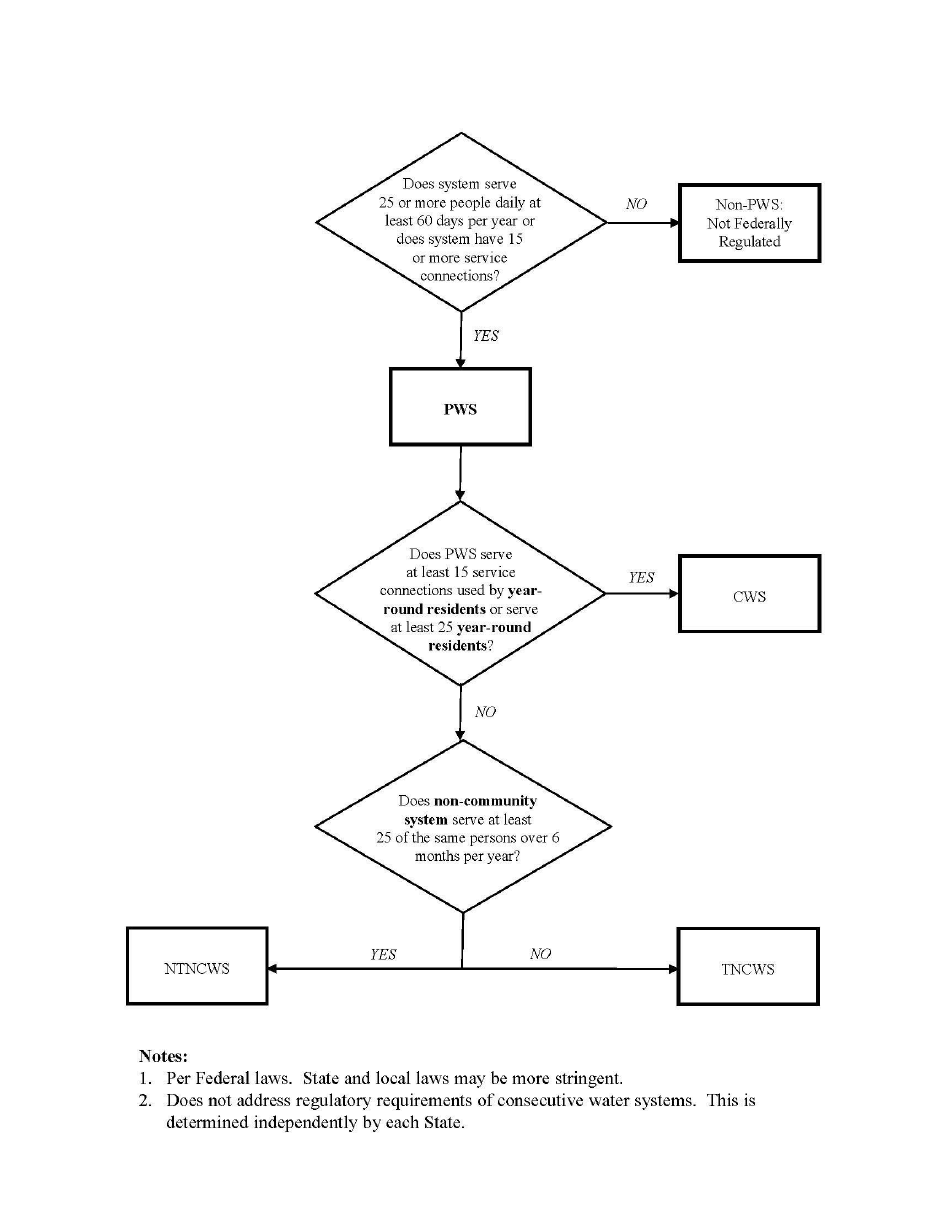
OPNAV M-5090.1
25 Jun 2021
21-6
Figure 21-1. Water System Classification Flowchart

OPNAV M-5090.1
25 Jun 2021
21-7
(2) Navy consecutive PWSs that meet the exemption criteria in paragraph 21-3.3 of this
manual are required to comply with the coliform sampling requirements in this subparagraph.
Consecutive non-community water systems may request waivers from this requirement. Waivers
must be submitted by BSOs to the Office of the Chief of Naval Operations, Energy and
Environmental Readiness Division (OPNAV N45) for approval. The use of EPA-approved kits
by trained personnel is acceptable for Navy policy total coliform analyses. If a sample tests
positive, however, follow-up analysis must be accomplished using a certified laboratory.
b. Asbestos. Navy PWSs with asbestos cement pipes must monitor for asbestos. At a
minimum, one sample must be taken during the first 3 years of every 9-year compliance period
and must comply with EPA’s limit of 7 million fibers per liter (longer than 10 micrometers).
Navy consecutive PWSs with asbestos cement pipes that meet the exemption criteria in
paragraph 21-3.3 of this manual are required to comply with the asbestos sampling requirements
in this subparagraph, regardless of any State variances or waivers. In the event of an asbestos
MCL exceedance, which may indicate corrosive water, the cognizant State may need to be
consulted to evaluate the corrosivity of the water when supplied by a water purveyor to a Navy
consecutive system, and to establish appropriate follow-up monitoring schedules.
c. Lead and Copper Rule. Navy PWSs must comply with all applicable requirements for the
control of lead and copper, as stated in the Federal Lead and Copper Rule (reference (a), Part
141, subpart I), to ensure the levels of lead and copper remain below the levels associated with
health risks in treated (finished) water and at the consumer’s free-flowing tap. Per reference (a),
Part 141, and if approved by the State regulatory agency or EPA (whichever has primacy),
installations may combine their consecutive PWS monitoring plan as part of the supplier’s plan,
instead of treating each as a separate system.
(1) Lead Action Level
(a) The lead action level (AL) is exceeded if the concentration of lead in more than 10
percent of tap water samples collected during any monitoring period conducted per reference (a),
Part 141 is greater than 0.015 milligrams per liter (mg/L) (i.e., if the 90th-percentile lead level is
greater than 0.015 mg/L). The copper AL is exceeded if concentrations of copper in more than
10 percent of tap water samples collected during any monitoring period conducted per reference
(a), Part 141 is greater than 1.3 mg/L (i.e., if the 90th-percentile copper level is greater than 1.3
mg/L).
(b) As specified in reference (a), Part 141, if an AL is exceeded, installation PWSs
must collect additional water-quality parameter samples. Optimal corrosion-control treatment
may also be required. Should prescribed treatment options fail to bring lead levels below the
AL, lead service lines may have to be replaced. Water systems that meet the lead and copper
ALs during specified monitoring periods may reduce the number and frequency of sampling per
reference (a), Part 141.
(2) Lead and Copper in Family Housing. Navy consecutive PWSs that serve family
housing and are not included in the primary system sampling pool (at the time the primary
system performed Lead and Copper Rule monitoring) for lead and copper must sample for lead

OPNAV M-5090.1
25 Jun 2021
21-8
and copper. Installations must ensure the number and location of samples are sufficient to be
representative of the system and in conformance with Lead and Copper Rule procedures. This
requirement can be waived if Navy installations operating consecutive PWSs document that their
water supplier passed its Lead and Copper Rule monitoring and that the water being supplied to
them is noncorrosive. A formal waiver does not need to be submitted, but documentation must
be maintained in drinking water program records.
d. Disinfectant and Disinfection Byproducts
(1) Stage 1 Disinfectant and Disinfection Byproduct Rule. This rule applies to all CWSs
and NTNCWSs that use a chemical disinfectant in any part of their system. It establishes
maximum residual disinfectant levels for disinfection using chlorine, chloramine, and chlorine
dioxide, and MCLs for disinfection byproducts (i.e., total trihalomethanes (TTHM), haloacetic
acids, chlorite, and bromate).
(2) Stage 2 Disinfectant and Disinfection Byproduct Rule. This rule provides additional
public health protection from disinfection byproducts and tightens compliance monitoring
requirements for trihalomethanes and haloacetic acids.
(3) Navy Consecutive PWSs. Navy consecutive PWSs that meet the exemption criteria
in paragraph 21-3.3 of this manual are required to comply with sampling requirements for
disinfectant and disinfection byproducts:
(a) Sample for TTHMs and haloacetic acids, chlorite, and bromate once per year at a
location in the distribution system reflecting the maximum residence time of water in the system.
Water systems that exceed the applicable MCL must increase sampling to quarterly. After four
consecutive quarters below the MCL, water systems may reduce sampling frequency to annually.
(b) Installations must follow the public notification procedures outlined in this
subparagraph if an annual sample, or running annual average (for quarterly sampling) is above
an applicable MCL.
e. Lead in Priority Areas Program. Sampling and testing under this program is in addition
to, not in place of, sampling conducted to determine whether a water supply system meets
system-wide regulations under the Lead and Copper Rule under reference (a), Part 141, subpart
I.
(1) All Navy installations must meet EPA guidelines found in reference (e) for testing
and sampling of drinking water fountains, faucets, and other outlets from which children may
drink, including schools and childcare facilities. For the purposes of this policy, “priority areas”
are identified as primary and secondary schools, Child Development Centers (CDC), School Age
Care (SAC) programs, Navy-operated 24/7 Group Homes, and youth program facilities. This
policy does not extend to recreational or seasonal camping areas or both, on- or off-base
residences (e.g., Child Development Homes, Family Child Care Homes used for childcare
purposes under the Navy’s Child Development Home program, or schools that are not owned or
OPNAV M-5090.1
25 Jun 2021
21-9
managed by the Navy or the Department of Defense (DoD). Reference (e) provides program
information including rationale and sampling protocols.
(2) Navy installations must meet EPA guidance through implementation of a three-step
program for training, testing, and taking action to reduce lead in drinking water in priority areas
following the guidance in reference (e) and any policy or guidance issued by CNIC as executive
agent for drinking water matters.
(3) All installations performed sampling and testing at all of the water outlets in priority
areas to establish a baseline. Those facilities existing and sampled in 2014 are the Navy
baseline. Water outlets in priority areas include:
(a) Drinking fountains, both bubbler and water-cooler style, indoor and outdoor (e.g.,
playgrounds, sports fields);
(b) Kitchen sinks;
(c) Home economic rooms sinks;
(d) Teacher’s lounge sinks;
(e) Nurse’s office sinks;
(f) Classroom sinks;
(g) Bathroom faucets;
(h) Utility sinks, hose attachments, and outdoor outlets if used to fill water jugs (e.g.,
for sports-team practice); and
(i) Any sink known to be or visibly used for consumption (e.g., coffee maker,
toothbrushes, or cups are nearby).
(4) If initial screening results exceed lead screening level of 15 parts per billion (ppb) (or
lower value if codified by the State), installations must (1) immediately label the outlet as
temporarily out of service; (2) use full protocol sampling on affected outlets (EPA’s two-step
sampling process identified in reference (e)) to determine if the fixture or plumbing is the lead
source; and (3) institute permanent corrective actions on two-step sampling results per reference
(e).
(5) The sampling and testing program includes sampling and testing water outlets in
newly constructed or modified priority areas since the last regular sampling event. Installations
must sample and test all water outlets identified in the baseline when Navy-owned water
treatment processes or plumbing are added or modified in any way that has the potential to
increase lead concentrations (e.g., system includes older plumbing lines and plumbing or solder
is disturbed, replaced, or removed). The environmental office must query each priority area

OPNAV M-5090.1
25 Jun 2021
21-10
annually to determine if any plumbing or treatment modifications have been made and if
sampling needs to be completed. This includes resampling all impacted initial baseline outlets
identified in newly constructed or modified priority areas prior to occupancy; however, if the
installation can document that all plumbing materials are “lead-free” per section 1417 of SDWA
and retain the documentation for future reference, the requirement to test new construction is
waived.
(6) Periodic re-testing and sampling of all outlets must be accomplished every 5 years
from the established baseline or per State requirements if more frequent.
(7) A copy of all test results must be made available to the local Preventive Medicine
Service/Medical Treatment Facility for all schools, CDCs, SACs, Navy-operated 24/7 Group
Homes, and youth program facilities where testing was conducted. At a minimum, availability
of past testing results must be provided to the parents or legal guardians of children attending the
schools, CDCs, SACs, Navy-operated 24/7 Group Homes, and youth program facilities. Direct
notification of results must be conducted for any lead detection greater than 15 ppb during a
sampling event. Notification requirements and procedures must be coordinated with public
affairs staff, the local Navy Preventive Medicine Service/Medical Treatment Facility, and the
legal department, and must be conducted in accordance with CNIC guidance. All records of
sampling and testing of drinking water in priority areas must be retained for 12 years.
(8) Compliance with the lead in priority areas testing requirements must be verified
during annual internal environmental compliance audits and triennial external environmental
compliance audits.
f. Arsenic. Navy PWSs are required to comply with EPA’s 10-ppb standard, including
reporting on the CCR (refer to paragraph 21-3.5 of this manual). Navy consecutive PWSs
(including those that are permitted and those that meet the exemption criteria in subparagraph
21-3.3a of this manual) are not required to sample for arsenic unless required by State or local
regulations.
g. Radionuclides. Navy PWSs are required to comply with EPA’s standards for
radionuclides and uranium as follows: combined radium 226/228 (5 picocuries per liter (pCi/L)),
beta emitters (4 millirems), gross alpha standard (15 pCi/L), and uranium (30 micrograms per
liter). Navy consecutive PWSs (including those that are permitted and those that meet the
exemption criteria in subparagraph 21-3.3a of this manual) are not required to sample for
radionuclides unless required by State or local regulations.
h. Unregulated Contaminants. Large Navy PWSs and some small PWSs may be required to
collect data on a selection of unregulated contaminants. Data from this monitoring will be used
in future rulemaking.
i. Surface Water Treatment Rule. The objective of this rule is to reduce illnesses caused by
pathogens. It establishes maximum contaminant level goals (MCLG) for viruses, bacteria, and
Giardia lamblia. The rule requires water systems using surface-water sources or GWUDI of
surface water to provide filtration and disinfection. The rule applies TT requirements for filtered

OPNAV M-5090.1
25 Jun 2021
21-11
and unfiltered systems. Unfiltered systems must meet specific filter-avoidance criteria by
performing source water monitoring and meet site-specific conditions that include a watershed
control program to minimize the potential for contamination by disease-bearing pathogens.
(1) Interim Enhanced Surface Water Treatment Rule. This rule strengthens filter
filtration and monitoring requirements to optimize treatment reliability. An overall goal of this
rule is to minimize levels of Cryptosporidium in finished water. The rule applies to PWSs
serving at least 10,000 people that use surface water or GWUDI of surface water. It requires
States to conduct sanitary surveys for all surface water systems, regardless of size, establishes
requirements for covers on new finished water storage facilities, turbidity monitoring and to
calculate levels of microbial inactivation to address risk trade-offs with disinfection byproducts.
Unfiltered systems must meet specific filter-avoidance criteria by performing source-water
monitoring and meet site-specific conditions that include a watershed control program to
minimize the potential for contamination by microbials, including control measures for
Cryptosporidium.
(2) Filter Backwash Recycle Rule. This rule applies to all PWSs using surface water or
GWUDI of surface water; using direct or conventional filtration processes; and recycling spent-
filter backwash water, sludge thickener supernatant, or liquids from dewatering processes.
Recycle systems will be required to return spent-filter backwash water, thickener supernatant,
and liquids from dewatering process prior to the point of primary coagulant addition, unless the
State specifies an alternative location.
(3) Long-Term 1 Enhanced Surface Water Treatment Rule. This rule applies to PWSs
using surface water or GWUDI of surface water and extends protection against Cryptosporidium
and other disease-causing microbes to water systems that serve fewer than 10,000 people
annually. The rule requires turbidity monitoring, calculates levels of microbial inactivation to
address risk trade-offs with disinfection byproducts, and establishes requirements for covers on
new finished water reservoirs. Unfiltered systems must meet specific filter-avoidance criteria by
performing source-water monitoring and meet site-specific conditions that include a watershed
control program to minimize the potential for contamination by microbials, including control
measures for Cryptosporidium.
(4) Long-Term 2 Enhanced Surface Water Treatment Rule. This rule increases
monitoring and treatment requirements for water systems at high risk of outbreaks of
Cryptosporidium and requires PWSs supplied by surface water sources to monitor for
Cryptosporidium. Those water systems that measure higher levels of Cryptosporidium or do not
filter their water must provide additional protection by using options from a “microbial toolbox”
of treatment and management processes. The rule requires open reservoirs to either be covered
or receive added treatment.
j. Groundwater Rule. This rule provides increased protection against microbial
contamination of drinking water systems that use groundwater sources by requiring sanitary
surveys to be conducted by the State every 3 years for CWSs and every 5 years for non-
community water systems. The rule’s additional requirements include hydrogeologic sensitivity

OPNAV M-5090.1
25 Jun 2021
21-12
assessments and enhanced source water monitoring for certain systems. Monitoring of source
water is also required if there is a detection of coliform in the distribution system.
k. Standardized Monitoring Framework (SMF). This rule standardizes, simplifies, and
consolidates monitoring requirements for primary drinking water contaminants across
contaminant groups. The SMF simplifies monitoring plans and synchronizes monitoring
schedules leading to increased compliance with monitoring requirements. Under the SMF, all
primary systems must monitor for nitrate and nitrite; CWSs and NTNCWSs must monitor for an
additional 13 inorganic compounds (IOC), 51 synthetic organic compounds (SOC), and volatile
organic compounds (VOC). Additionally, CWSs must monitor for four radionuclides.
Monitoring frequencies range from monthly for contaminants that exceed MCLs to every 9 years
for contaminants that have been demonstrated to be either non-detect or consistently below the
MCL. For specific requirements for drinking water sources and contaminants, see the EPA
Standardized Monitoring Framework: A Quick Reference Guide and reference (a), section
141.23 regarding IOCs, reference (a), section 141.24 regarding VOCs and SOCs, and reference
(a), section 141.26 regarding radionuclides.
l. Public Notification and Violations. The owner or operator of a PWS, including
consecutive PWSs that meet the exemption criteria in subparagraph 21-3.3a of this manual, that
fails to comply with an applicable MCL, AL, or TT, or with the requirements of any schedule
prescribed under a variance or exemption (refer to subparagraph 21-3.3n of this manual) must
notify persons served by the system per reference (a), section 141.201–210. The notices must
include specific language about the health effects of each contaminant, at-risk populations, and
possible actions consumers should take to mitigate risks. The public notices must be reviewed
by BUMED and any recommendations provided to the ICO. The PWS must publish notices by
newspaper, mail delivery, hand delivery, radio, and television announcements, depending upon
the type of violation or risk involved. Notices of violation must be reported per chapter 19
(Processing Notices of Violation Under Environmental Laws and Regulations) of this manual.
m. Consultations. All Navy ICOs are required to consult with the local Preventive Medicine
Authority (PMA), who will immediately consult with the Navy and Marine Corps Public Health
Center (NMCPHC) in the event of an exceedance of an MCL, AL, health advisory (HA) level, or
other promulgated drinking water standard. This is applicable to all public and non-public water
systems, and primary or consecutive (purchased water) systems, including those where the Navy
is notified by the supplier of an exceedance. The PMA will provide recommendations to the
ICO on whether alternative water supplies should be provided. The ICO will also consider input
from State or local regulators. If the ICO determines an alternative water supply is necessary,
but desires continued limited other consumptive uses (e.g., hand washing), the ICO must request
a public health risk assessment from the NMCPHC. The local PMA cannot override a regulatory
requirement to provide alternative water but can advise more protective measures.
n. Exemptions. Navy installations that own and operate a consecutive PWS subject to full or
partial exemption from regulatory monitoring requirements under reference (a), section 141.3 or
section 141.29, respectively, must submit a letter to the State regulatory agency explaining the
degree to which exemption criteria are applicable and request the exact requirements to be

OPNAV M-5090.1
25 Jun 2021
21-13
imposed on the consecutive PWS. The State’s response letter is to be retained permanently in
the requesting installation’s files.
o. Review of Primary PWS System Records. Navy consecutive PWSs must, at least once a
year, review the monitoring reports of the primary PWS. Installations must use these reports and
other sources of information to determine the risk of water quality deterioration within the
distribution system and adjust sampling required by subparagraphs 21-3.4a through 21.3.4d of
this manual, accordingly, to ensure water quality has not degraded above the MCL for
parameters within the distribution system.
21-3.5. Consumer Confidence Reports
a. CCRs present the quality of the water delivered by the system. Each Navy PWS must
develop an annual CCR to provide consumers access to information about the water in the
system. The report must contain data collected during, or prior to, the previous calendar year.
Requirements are outlined in reference (f) and in reference (a), sections 141.151 to 141.155. For
exceedances, only data based on certified laboratory results must be reported.
b. Navy CWSs must mail or otherwise directly deliver one copy of the CCR to each of its
customers by 1 July every year, that addresses the prior calendar year. Recommended methods
of report delivery include mailing to each housing unit, publishing in the command newspaper,
posting on a Web site, and posting in conspicuous locations in each building on the installation
(reference (g)). States may waive the mailing requirement for CWSs serving fewer than 10,000
persons. In such cases, systems would be required to inform their customers that the report will
not be mailed, make the report available on request to the public, and publish the report annually
in one or more local newspapers serving the areas in which the systems’ customers are located.
Navy consecutive CWSs must obtain a copy of their water supplier’s CCR and amend this report
with information on any additional testing or exceedances.
c. A “good faith” effort must be made to ensure all customers are aware of the CCR and
additional information. Alternative delivery methods should be used to make a “good faith”
effort to reach customers who do not receive water bills, including a mix of methods appropriate
to the particular system. In States with primary enforcement authority, utilities must mail a copy
of the completed CCR to the State, followed, within 3 months, by a certification that the report
has been distributed to customers and the information in the CCR is correct.
d. Certain electronic methods may be used to accomplish the required “direct delivery” of
CCRs.
(1) Electronic delivery must provide the CCR in a manner that is “direct.” This means
CWSs can use paper or electronic communication with uniform resource locators (URL) to meet
their CCR requirement if the URL provides a direct link to the CCR, and the communication
prominently displays the URL and a notice explaining the nature of the link. The link must take
the customer to the entire CCR so that navigation to another Web page to find the required CCR
content is not necessary.

OPNAV M-5090.1
25 Jun 2021
21-14
(2) Use of social media (e.g., Facebook, Twitter) directed at customers does not meet the
requirement to “directly deliver,” since these Internet outlets require a customer to join the Web
site to read the CCR.
(3) Use of automated phone calls (e.g., emergency telephone notification systems) is not
considered “direct delivery” because the entire contents of the CCR cannot be provided in a
phone call.
(4) If a Navy CWS is aware of a customer’s inability to receive a CCR by the chosen
electronic means, it must provide the CCR by an alternative means allowed by the rule, including
those discussed in subparagraph 21-3.5b of this manual.
e. Navy Non-Community Water Systems (NTNCWSs and TNCWSs). CCR “direct
delivery” requirements do apply to these systems. NTNCWSs and TNCWSs must post their
annual CCRs to the CNIC Web site, or otherwise make them available to consumers by 1 July
every year.
21-3.6. Underground Injection Control Program. Reference (a), Parts 144–147 require each
State to have an underground injection control (UIC) program to ensure underground injection
does not endanger underground sources of drinking water. All groundwater injection systems
must be permitted or authorized by rule. Under these requirements, installations must implement
a program that establishes and maintains a UIC well inventory and procedures for proper well
closure. The broadest category of UIC wells (i.e., Class V) includes stormwater drainage wells,
aquifer remediation wells, and some septic systems.
21-3.7. Wellhead Protection Program. Installations that receive drinking water from wells must
establish a wellhead protection program that meets applicable State or local wellhead protection
requirements or adopt and comply with local wellhead protection program requirements to
minimize contamination.
21-3.8. Surface Water Protection Program. Installations that receive drinking water from
surface water or GWUDI must establish a surface water protection program that meets
applicable Federal, State, or local requirements for drinking water obtained from these sources,
or adopt and comply with local surface water protection program requirements to minimize
contamination.
21-3.9. Water System Vulnerability Assessments and Emergency Response Plans
a. All Navy drinking water systems serving more than 25 consumers must complete a water
system vulnerability assessment (WSVA) and emergency response plan (ERP) as required by
reference (h) and DoD policy (reference (i)). Systems covered under this requirement include
consecutive as well as small community and non-community PWSs in the United States and its
possessions and territories.
b. Specific criteria to be addressed by the WSVA include, but are not limited to:

OPNAV M-5090.1
25 Jun 2021
21-15
(1) Pipes and constructed conveyances;
(2) Physical barriers;
(3) Water collection, pretreatment, treatment, storage, and distribution facilities;
(4) Electronic, computer, or other automated systems used by the PWS;
(5) The use, storage, or handling of various chemicals; and
(6) The operation and maintenance of the system.
21-3.10. Cross-Connection and Backflow Prevention
a. Cross-connection control programs apply to building interior domestic plumbing systems,
fire-protection plumbing systems, and exterior water distribution systems. These programs,
overseen by States with SDWA primacy, ensure compliance with primary and secondary
drinking water standards by establishing policy, procedures, and instructions for installing,
repairing, maintaining, inspecting, and testing backflow preventers.
b. All installations must develop and implement a cross-connection control and backflow
prevention program. At a minimum, this program must include procedures and mechanisms to:
(1) Find and eliminate existing cross-connections by conducting cross-connection control
surveys of all facilities at least every 5 years, and prevent new cross-connections;
(2) Install, inspect, and test backflow preventers when cross-connections cannot be
eliminated, or as required by State or local regulations;
(3) Keep an inventory of all existing backflow preventers, including the degree of hazard
and hydraulic condition that the device protects against (back siphonage or back pressure);
(4) Certify all backflow preventers as required by the regulatory agency. If there is no
regulatory requirement, then all backflow preventers should be certified at least once every 6
months for high hazards and once every 12 months for low hazards by a State or local water
authority certified tester; and
(5) Promptly repair or replace defective backflow preventers, and retain cross-connection
and backflow preventer inspection and maintenance records for at least 5 years.
c. Reference (j) provides guidance to Navy installations for complying with this
requirement, and reference (k) provides EPA guidance on cross-connection control programs.
21-3.11. Operation and Maintenance. Installations that own or operate water systems (public
and non-public, permitted and non-permitted) must develop and implement an operation and
maintenance program applicable to the system. The program must meet the requirements of

OPNAV M-5090.1
25 Jun 2021
21-16
reference (a), Part 141, in particular section 141.63, paragraph (d)(3), which stresses “proper
maintenance of the distribution system including appropriate pipe replacement and repair
procedures, main flushing programs, proper operation and maintenance of storage tanks and
reservoirs, and continual maintenance of positive water pressure in all parts of the distribution
system.” The program must include the proper implementation and documentation of:
a. Emergency and preventive maintenance;
b. System disinfection after maintenance work is performed;
c. Scheduled flushing of the system;
d. Reduction of water quality problems (as needed);
e. Implementation and documentation of a valve exercise and maintenance program;
f. Proper operation and maintenance of storage tanks and reservoirs;
g. Maintenance of current water distribution maps;
h. Documentation of location and dates of water line breakage;
i. Documentation of emergency operations procedures required as a result of events such as
earthquakes, hurricanes, chemical releases, and terrorist activities; and
j. Determination of response roles and responsibilities as well as contingency plans for
providing water safe for human consumption to the Navy installation. Reference (l) provides
information on emergency planning.
21-3.12. Sanitary Surveys. In many instances, a State may require treatment plants or PWSs
experiencing compliance problems, particularly with microbial pathogens, to perform a sanitary
survey. The State regulatory agency will usually perform the survey; if the State allows,
however, the installation can use a service provider of choice to complete the survey. In the
absence of a State requirement, all Navy PWSs must perform a sanitary survey every 5 years.
a. Treatment Plant Survey Requirements. For treatment plants, the survey should include:
(1) An evaluation of sampling and monitoring data for compliance with applicable water
quality standards (MCLs);
(2) Verification and reevaluation of vulnerability assessments, watershed protection
programs, and wellhead protection programs, as applicable;
(3) Examination of the source water physical components and condition;

OPNAV M-5090.1
25 Jun 2021
21-17
(4) Schematic diagrams of the treatment process and examination and evaluation of the
adequacy and appropriateness of all elements of the current treatment process, including an
assessment of operational flows versus treatment process rated capacity and, where appropriate,
CT assessment as defined in reference (a), section 141.2;
(5) Examination and evaluation of the operation and maintenance of the treatment
facility, including the condition and reliability of equipment, operator qualifications, use of
approved chemicals, recordkeeping, process control, and safety programs;
(6) Evaluation of the ability of the treatment plant to respond to changes in raw water
fluctuations; and
(7) Evaluation of the treatment plant’s emergency power supply and security measures.
b. Distribution System Sanitary Survey Review. For distribution systems, the survey should
include:
(1) An evaluation of sampling and monitoring data for compliance with applicable water
quality standards (i.e., MCLs);
(2) Concerning the distribution system, the sanitary survey should include a review of the
operation and maintenance program to ensure attention to areas of concern, including:
(a) Elimination of unneeded or excess storage;
(b) Adequate turnover of storage tanks;
(c) Storage tank cleaning and maintenance;
(d) Adequate disinfection practices during all main repairs and replacements;
(e) Effective corrosion control program, if applicable;
(f) Comprehensive cross-connection control program;
(g) Aggressive valve and hydrant exercise program;
(h) Adequate water quality monitoring program that achieves compliance with the
appropriate regulations and provides for effective water quality control;
(i) Adequate flushing program, preferably a unidirectional flushing program that is
implemented yearly; and
(j) Review of location and dates of water line breakage and system failures to
evaluate overall system reliability.

OPNAV M-5090.1
25 Jun 2021
21-18
(3) Reference (m) includes more information on sanitary surveys.
21-3.13. Lead-Free Plumbing. The use of any pipe, any pipe or plumbing fitting or fixture, any
solder, or any flux in the installation or repair of (i) any PWS or (ii) any plumbing in a residential
or non-residential facility providing water for human consumption that is not lead free, is
prohibited.
21-3.14. Consumptive Use Permits. In coordination with legal counsel and technical staff at the
BSO and appropriate region command, installations that withdraw groundwater must:
a. Document historical water use;
b. Determine reasonably foreseeable future water uses;
c. Evaluate water rights laws;
d. Determine on a case-by-case basis whether the installation should obtain a consumptive
use permit; and
e. Ensure, if applying for a consumptive use permit, that restrictions will not impact mission
requirements or existing water rights.
21-3.15. Exemption from Permitting. Navy installations that qualify for exemption from PWS
permitting as in paragraph 21-3.3 of this manual or for other reasons must apply, in writing, to
the regulatory agency with SDWA primacy for an exemption. In some cases, regulators issue a
permit when it is not required.
21-3.16. Recordkeeping. In the absence of more stringent Federal, State, or local recordkeeping
requirements, installations must maintain records listed in subparagraphs 21-3.16a through 21-
3.16i of this manual:
a. Bacteriological results—5 years;
b. Chemical results—10 years;
c. Lead and copper testing results—12 years;
d. Actions taken to correct violations—3 years after acting on the particular violation
involved;
e. Sanitary survey reports—10 years;
f. Variance or exemption records—5 years following the expiration of such variance or
exemption;

OPNAV M-5090.1
25 Jun 2021
21-19
g. Water treatment plant and distribution system operating records (including monthly
reports)—5 years;
h. Cross-connection inspection records—5 years; and
i. CCRs—5 years.
21-3.17. Sampling and Analysis. Installations must use laboratories certified by EPA or the
cognizant State to perform all PWS SDWA compliance sample analyses. Installations must
collect water samples at points that represent the quality of water in the distribution system.
Sampling and testing must comply with the requirements of chapter 7 (Sampling and Laboratory
Testing) of this manual.
21-3.18. Fines and Penalties. Reference (n) waives sovereign immunity for the payment of fines
and penalties imposed by Federal, State, or local agencies for violations. In addition, EPA may
assess civil penalties of up to $37,500 per day per violation occurring after 6 December 2013.
Note: EPA through regulation periodically adjusts the maximum amount of SDWA fines
upward to account for inflation.
21-3.19. Certification and Training
a. All Navy personnel involved in the drinking water program must receive appropriate
environmental readiness training (refer to chapter 3 (Environmental Readiness Training) of this
manual for detailed information). Installations must ensure their water treatment and distribution
system operators are trained and certified per applicable Federal, State, and local regulations.
Training should include the following elements:
(1) Basic water plant and distribution system design and operation;
(2) Basic maintenance and calibration of plant controls and equipment;
(3) Water plant and distribution systems treatment principles, including chemical storage
and handling;
(4) Water sampling and analysis;
(5) Water plant and distribution system documentation and reporting requirements; and
(6) Cross-connection control and backflow prevention.
b. Reference (n) requires States to develop operator certification programs that must specify
minimum standards for operators of community and non-transient, non-community PWSs.
Details include provisions for certification, recertification, and grandfathering.

OPNAV M-5090.1
25 Jun 2021
21-20
21-4 Responsibilities
21-4.1. OPNAV N45 must:
a. Coordinate the overall implementation of SDWA requirements;
b. Issue policy guidance as needed;
c. Act as the assessment sponsor for SDWA projects; and
d. Approve or disapprove of monitoring waivers for bacteriological sampling by Navy
consecutive non-community water systems.
21-4.2. CNIC must:
a. Serve as executive agent for drinking water quality matters for all Navy shore facilities
and installations; and
b. Provide annually, by 15 February, a report on the status of Navy shore facility and
installation drinking water quality for the previous FY as specified in subparagraph 21-3.1c of
this manual.
21-4.3. Commander, Naval Facilities Engineering Command (COMNAVFACENGCOM) must
support CNIC on all aspects of drinking water system management, including, but not limited to:
operation, maintenance, repair, compliance testing results from U.S.-accredited and certified
laboratories, and compliance with applicable drinking water quality standards.
21-4.4. BUMED must:
a. Formulate and disseminate Navy Medicine policy and guidance related to drinking water
quality;
b. Provide public health advice and consultative services to CNIC and Navy commands for
drinking water quality to include: risk assessment and risk communication; review of drinking
water sampling and compliance data; public health assistance on preparation of CCRs and public
notifications; health-related recommendations when water does not meet U.S. water quality
standards; consultations in the event of an exceedance of an MCL, AL, HA level, or other
promulgated drinking water quality standard;
c. Following an exceedance of an MCL, AL, HA level, or other promulgated drinking water
quality standard, immediately consult with the NMCPHC;
d. Advise when drinking water system issues or discrepancies warrant implementation of
alternative water supplies and coordinate corrective action with CNIC and
COMNAVFACENGCOM; and

OPNAV M-5090.1
25 Jun 2021
21-21
e. Provide public health subject matter expert support for sanitary survey teams, as
requested.
21-4.5. Regional environmental coordinators must:
a. Provide coordination and assistance to installations within the applicable region regarding
implementation of this chapter; and
b. Assist BSOs with resolution of issues and communication with OPNAV N45 and Federal,
State, and local regulators.
21-4.6. BSOs must:
a. Implement SDWA program requirements at their shore installations;
b. Plan, program, budget, and provide funding for current and future requirements of
SDWA, State and local regulations, E.O.s, and Navy policy;
c. Ensure activities under their command comply with current Federal, State, regional, and
local laws; E.O.s; regulations; and permits; and
d. Provide any information to CNIC as necessary for the annual drinking water quality report
to the VCNO, as specified in subparagraph 21-3.1c of this manual.
21-4.7. ICOs or officers in charge of shore installations must:
a. Ensure the installation is in compliance with all Federal, State, and local regulations;
E.O.s; and Navy policy pertaining to drinking water;
b. Identify, plan, program, budget, and implement current and future requirements under
SDWA State and local regulations, E.O.s, and Navy policy;
c. Ensure contracts between the Navy and water suppliers require the suppliers to provide
the results of all permit-required NPDWR monitoring performed on raw and treated water that
serves the applicable Navy installation or command at least once a year;
d. Ensure all personnel involved in the drinking water program are properly trained;
e. Report non-compliance with any NPDWR; and
f. Consult with the local PMA in the event of an exceedance of a drinking water MCL, AL,
HA level, or other promulgated drinking water quality standard.
21-5 Definitions
21-5.1. Action Level. The AL is the concentration of lead or copper in water that is used to

OPNAV M-5090.1
25 Jun 2021
21-22
determine compliance with the Lead and Copper Rule. Under the Lead and Copper Rule, ALs
have replaced lead and copper MCLs.
21-5.2. Backflow Preventer. A backflow preventer is an approved device, assembly, or piping
arrangement (i.e., air gap) used to prevent backflow into a drinking water system.
21-5.3. Community Water System. A CWS is a PWS that serves at least 15 service connections
used by year-round residents or regularly serves at least 25 year-round residents.
21-5.4. Consecutive Public Water System. A consecutive PWS is a water system that has no
water production or source facility of its own, obtains all of its water from another water system,
and meets the definition of a PWS.
21-5.5. Consecutive Water System. A consecutive water system is a water system that has no
water production or source facility of its own and obtains all of its water from another water
system. A consecutive water system may be further classified as any of the water system types
shown in figure 21-1.
21-5.6. Consumer. A consumer is any person served by a PWS.
21-5.7. Consumer Confidence Report. A CCR is an annual report that provides water quality
information to consumers. The CCR must contain mandatory information and be delivered to
customers annually by 1 July every year.
21-5.8. Consumptive Use Permit. A consumptive use permit regulates the withdrawal of
groundwater.
21-5.9. Cross-Connection. A cross-connection is any physical arrangement whereby a water
supply system is connected, directly or indirectly, with any other sewer, drain, plumbing fixture,
or other device that contains or may contain contaminated water.
21-5.10. Customer. A customer is a billing unit or service connection to which water is
delivered.
21-5.11. Disinfectant. A disinfectant is any oxidant including, but not limited to chlorine,
chlorine dioxide, chloramines, and ozone added to any part of the treatment or distribution
process for the purpose of killing or inactivating pathogenic microorganisms.
21-5.12. Disinfection Byproducts. Disinfection byproducts are compounds formed from the
reaction of a disinfectant with organic and inorganic compounds in the source water during the
disinfection process.
21-5.13. Emergency Response Plan. The ERP must include, but not be limited to plans,
procedures, and identification of equipment that can be implemented and utilized in the event of
a terrorist or other intentional attack on the PWS.

OPNAV M-5090.1
25 Jun 2021
21-23
21-5.14. Lead-Free. Solders and flux are considered lead-free if they contain no more than 0.2
percent lead; wetted surfaces of pipes, pipe fittings, plumbing fittings, and fixtures are
considered lead-free if they contain not more than a weighted average of 0.25 percent lead.
21-5.15. Lead Service Line. A lead service line is a service line made of lead that connects the
water main to the building inlet and any lead pigtail, gooseneck, or other fitting that is connected
to such lead line.
21-5.16. Maximum Contaminant Level. The MCL is the maximum permissible level of a
contaminant in water that is delivered to any user of a PWS.
21-5.17. Non-Community Water System. A non-community water system is a PWS that is not a
CWS. There are two kinds of non-community water systems: transient and non-transient.
21-5.18. Non-Transient, Non-Community Water System. An NTNCWS is a PWS that is not a
CWS and that regularly serves at least 25 of the same persons over 6 months per year.
21-5.19. Other Promulgated Drinking Water Quality Standard. Other promulgated drinking
water quality standards include State or local regulatory requirements or standards set forth in the
applicable final governing standards for overseas locations. They do not include secondary
drinking water standards that are non-enforceable.
21-5.20. Permitted Public Water System. A permitted PWS is a PWS that has been issued a
permit or other formal authorization to operate (i.e., has been issued a PWS identification
number).
21-5.21. Public Water System
a. A PWS is a system for the provision to the public of water for human consumption
through pipes or other constructed conveyances, if such system has at least 15 service
connections or regularly serves an average of at least 25 individuals daily at least 60 days out of
the year. Such term includes:
(1) Any collection, treatment, storage, and distribution facilities under control of the
operator of such system and used primarily in connection with such system; and
(2) Any collection or pretreatment storage facilities not under such control, used
primarily in connection with such system.
b. A PWS is either a CWS or a non-community water system. Figure 21-1 helps
installations determine which type of system they operate.
21-5.22. Sanitary Survey. A sanitary survey is an onsite review of the water sources, facilities,
equipment, operation, and maintenance of a PWS for the purpose of evaluating the adequacy of
such sources, facilities, equipment, operation, and maintenance for producing and distributing
safe drinking water.

OPNAV M-5090.1
25 Jun 2021
21-24
21-5.23. Selling Water. There is no definition of “selling water” in SDWA. Refer to discussion
under paragraph 21-3.2 of this manual.
21-5.24. Service Connection. A service connection is the opening, including all fittings and
appurtenances, at the water main through which water is supplied to the user.
21-5.25. Source Water Assessment Program. Source water assessment programs delineate
source water protection areas, inventory significant contaminants in these areas, and determine
the susceptibility of each public water supply to contamination.
21-5.26. Source Water Protection Program. Source water protection programs are State efforts
to manage identified sources of contamination in a manner that will protect drinking water
supplies based on the source water assessment program.
21-5.27. Supplier of Water. A supplier of water is any person who owns or operates a PWS.
Under SDWA, a person is defined as an individual; corporation; company; association;
partnership; municipality; or Federal, State, or tribal agency.
21-5.28. Transient, Non-Community Water System. A TNCWS is a non-community water
system that does not regularly serve at least 25 of the same persons over 6 months per year.
21-5.29. Treatment Technique. A TT is a required process intended to reduce the level of a
contaminant in drinking water.
21-5.30. Underground Injection. Underground injection means well injection (i.e., the
subsurface emplacement of fluids through a bored, drilled, or driven well or through a dug well
where the depth of the dug well is greater than the largest surface dimension (reference (a), Parts
144–147).
21-5.31. Water System Vulnerability Assessment. A WSVA is an assessment of the
vulnerability of a PWS to a terrorist attack or other intentional acts intended to substantially
disrupt the ability of the system to provide safe and reliable supply of drinking water.
21-5.32. Well. A well is a bored, drilled, or driven shaft; or a dug hole whose depth is greater
than the largest surface dimension.
21-5.33. Wellhead Protection Program. A wellhead protection program is a program to protect
groundwater supply wells and well fields that contribute drinking water to public water supply
systems.

OPNAV M-5090.1
25 Jun 2021
22-1
CHAPTER 22
CLEAN AIR ASHORE
Table of Contents
22-1 Scope ..................................................................................................................................22-1
22-1.1. Related Chapters ......................................................................................................22-1
22-1.2. References................................................................................................................22-1
22-1.3. Applicability ............................................................................................................22-3
22-2 Legislation ..........................................................................................................................22-3
22-3 Requirements .....................................................................................................................22-3
22-3-1. National Ambient Air Quality Standards ...............................................................22-3
22-3.2. General Conformity Analysis .................................................................................22-5
22-3.3. Provisions for Stationary Sources ...........................................................................22-6
22-3.4. Provisions for Mobile Sources ................................................................................22-11
22-3.5. Greenhouse Gas Emissions .....................................................................................22-13
22-3.6. Management of Ozone-Depleting Substances........................................................22-14
22-3.7. Other Clean Air Act Requirements .........................................................................22-20
22-3.8. Training Requirements ............................................................................................22-22
22-4 Responsibilities ..................................................................................................................22-23
22-5 Definitions ..........................................................................................................................22-32
22-1 Scope. This chapter applies to air emissions from stationary and mobile sources at all
shore facilities.
22-1.1. Related Chapters. Chapter 10 (Environmental Planning Under the National
Environmental Protection Act and Executive Order 12114) of this manual provides general
conformity analysis information. Chapter 25 (Toxic Substances Control Act) of this manual
provides Navy policy guidance for asbestos-containing material (ACM). Chapter 34 (Overseas
Environmental Compliance Ashore) of this manual provides Navy policy guidance with respect
to installations in foreign countries. Chapter 35 (Environmental Compliance Afloat) of this
manual provides Navy policy guidance with respect to Navy vessels and floating dry docks.
22-1.2. References
(a) 40 CFR;
(b) Navy Guidance for Compliance with the Clean Air Act General Conformity Rule, of 30
July 2013;
OPNAV M-5090.1
25 Jun 2021
22-2
(c) EPA memo of 02 Aug 96, Major Source Determinations for Military Installations under
the Air Toxics, New Source Review, and Title V Operating Permit Programs of the Clean Air
Act (Act);
(d) Public Law 109–58, Energy Policy Act of 2005;
(e) E.O. 13834, Efficient Federal Operations;
(f) Federal Greenhouse Gas Accounting and Reporting Guidance and Technical Support
Document, of 4 June 2012;
(g) Department of Defense Guidance for Executive Order 13693: Planning for Federal
Sustainability in the Next Decade (revised annually) (NOTAL);
(h) SECNAV memo of 28 May 93, Elimination of Class I Ozone-Depleting Substances in
Department of the Navy Contracts (NOTAL);
(i) SECNAVINST 5000.2E, Implementation and Operation of the Defense Acquisition
System and the Joint Capabilities Integration and Development System;
(j) DFARS Subpart 223.8, Ozone-Depleting Substances, of 19 December 2006;
(k) ASN(RD&A) memo of 13 Nov 97, Equipment/Systems Requiring the Unplanned Use of
Class I Ozone-Depleting Substances (ODS);
(l) Public Law 102–484, National Defense Authorization Act for Fiscal Year 1993;
(m) Unified Facilities Criteria 3-600-1: Fire Protection Engineering for Facilities;
(n) BUMEDINST 6270.8D, Health Hazard Assessments;
(o) DoD Manual 4160.21, Defense Materiel Disposition Manual, October 2015;
(p) ASN(EI&E) memo of 14 May 12, Department of the Navy Process for Reviewing
Potential Settlements of Penalties for Past Violations of the Clean Air Act (CAA);
(q) DoD 4165.66-M, Base Redevelopment and Realignment Manual, March 2006;
(r) ADUSD(I&E) memo of 12 Jul 12, Air Emission Rights at Department of Defense
Installations;
(s) 10 U.S.C. §2571; and
(t) 10 CFR Part 490.

OPNAV M-5090.1
25 Jun 2021
22-3
22-1.3. Applicability. Requirements and policies in this chapter are derived from the Clean Air
Act (CAA), other legislation, regulations, E.O.s, and instructions related to air emissions. They
apply to Navy facilities within the United States and its territories. The requirements of
subparagraph 22-3.5c of this manual apply to the Department of Defense (DoD) but cover all
Navy ships, aircraft, vehicles, and shore activities worldwide. The requirements of paragraph
22-3.6 of this manual apply to all Navy ships, aircraft, vehicles, and shore activities worldwide
except when the requirements in the Overseas Environmental Baseline Guidance Document
(OEBGD) and final governing standards (FGS), set per chapter 34 (Overseas Environmental
Compliance Ashore) of this manual, are more protective.
22-2 Legislation
a. Legislation and international treaties that contain provisions pertaining to clean air,
protection of stratospheric ozone, mitigation of climate change, and energy conservation that are
relevant to this chapter include:
(1) CAA, 42 U.S.C. §7401–7671q;
(2) Energy Policy Act of 2005, 42 U.S.C. §15801;
(3) Montreal Protocol on Substances that Deplete the Ozone Layer; and
(4) National Defense Authorization Act for Fiscal Year 1993, Section 326, 10 U.S.C.
§2301.
b. A summary of this legislation and the Montreal Protocol is included in appendix A
(Summary of Major Legislation, Regulations, Executive Orders, and International Agreements)
of this manual.
22-3 Requirements. Navy commands and installations must comply with applicable CAA
requirements and related regulations promulgated by Federal, State, and local regulatory
agencies in the same manner and to the same extent as a non-governmental entity. Navy policy
also requires all Navy installations to follow DoD- and Navy-specific guidance.
22-3.1. National Ambient Air Quality Standards
a. As directed by the CAA, the Environmental Protection Agency (EPA) sets primary and
secondary National Ambient Air Quality Standards (NAAQS) for pollutants that are considered
harmful to public health and welfare, and is required to review and, as needed, revise the
standards every 5 years. NAAQS have been established for six criteria pollutants: carbon
monoxide, lead, nitrogen dioxide, ozone, sulfur dioxide, and particulate matter regulated as
PM10 (10 microns or smaller) and PM2.5 (2.5 microns or smaller). To define air quality, EPA
designates all areas in the country as unclassifiable, attainment, nonattainment, or maintenance
with respect to the NAAQS for each criteria pollutant in reference (a), Part 81, subpart C. Some
regulatory requirements are fundamental and apply to sources in all areas, regardless of their

OPNAV M-5090.1
25 Jun 2021
22-4
attainment status, while other requirements are specific to attainment status of the area the source
is located.
b. Achieving CAA NAAQSs is the primary responsibility of the States, which must develop
State implementation plans (SIP) that outline to EPA how each State will achieve and maintain
the NAAQSs and implement the CAA programs. States may require pollution control and
prevention measures that are more stringent than those mandated by EPA, but may not allow
measures that are less stringent. Table 22-1 of this manual summarizes the primary requirements
applicable to Navy installations located in nonattainment areas.
Table 22-1. Primary Applicable Requirements in Nonattainment Areas
Area Designation
Summary of Applicable Requirements
a,b
Pollutant: Ozone
Subpart 1
c
State must complete emissions inventory, to be updated every 3
years. Will obtain data from sources.
New Source Review (NSR) offset ratio for volatile organic
compounds (VOC) and nitrogen oxides (NOx) of 1 to 1.
Marginal
State must complete emissions inventory, to be updated every 3
years. Will obtain data from sources. Specific requirements for
VOC and NOx emissions.
Basic motor vehicle inspection and maintenance (I/M) program.
NSR offset ratio for VOCs and NOx of 1.1 to 1.
Moderate
Requirements of marginal areas plus:
Reasonably available control technology applies to all major
stationary VOC and NOx sources.
Stage II vapor recovery required.
NSR offset ratio 1.15 to 1.
Serious
Requirements of moderate areas plus:
Clean fuel fleet program.
Enhanced I/M program enforced through denial of vehicle
registration.
NSR offset ratio 1.2 to 1.
Major source threshold for VOCs and NOx is 50 tons per year (tpy).
Severe
Requirements of serious areas plus:
NSR offset ratio 1.3 to 1.
Reformulated gasoline required in metropolitan areas.
Major source threshold for VOCs and NOx is 25 tpy.
Extreme
Requirements of severe areas plus:
NSR offset ratio 1.5 to 1.
Major source threshold for VOCs and NOx is 10 tpy.

OPNAV M-5090.1
25 Jun 2021
22-5
Area Designation
Summary of Applicable Requirements
a,b
Pollutant: Carbon Monoxide
Moderate
State must complete emissions inventory, to be updated every 3
years. Will obtain data from sources.
I/M program (type of program depends on ambient carbon
monoxide level).
Oxygenated fuel required in metropolitan areas during high carbon
monoxide season.
Serious
Requirements of moderate areas plus:
Transportation control measures.
Where stationary sources are believed to contribute substantially to
ambient carbon monoxide levels, major source threshold for carbon
monoxide is 50 tpy.
Multi-State
Affected States must coordinate the revision and implementation of the
carbon monoxide SIPs as they apply to the affected areas.
Pollutant: Particulate Matter—PM10, 24-Hour Standard
Moderate
State must complete emissions inventory, to be updated every 3
years. Will obtain data from sources.
Reasonably available control measures apply.
Serious
Meet requirements of moderate areas plus:
Best available control measures apply.
Major source threshold for PM10 is 70 tpy.
Pollutant: Particulate Matter—PM2.5, Annual and 24-Hour Standard
State must complete emissions inventory, to be updated every 3
years. Will obtain data from sources. Must include both direct and
PM2.5 precursor emissions.
Reasonably available control measures apply.
Notes:
1. This table lists those requirements that will likely affect Navy facilities. Details for these
provisions are set by each State per reference (a), Part 51. States have additional requirements
that must be included in their SIPs but do not directly affect sources such as ambient
monitoring plans.
2. The major stationary source threshold under the NSR and Title V permit programs is 100
tpy, except as noted in the table.
3. The subpart 1 category will no longer be used by EPA as it reconsiders the ozone NAAQS.
Refer to final 2008 Ozone NAAQS Implementation Rule for details.
22-3.2. General Conformity Analysis. Section 176(c) of the CAA prohibits Federal agencies
from engaging in, supporting, providing financial assistance for, licensing, permitting, or
approving any activity that does not conform to an applicable SIP or Federal implementation
plan (FIP). EPA criteria and procedures for determining conformity are found in reference (a),
Part 93, subpart B. Navy installations located in nonattainment and maintenance areas must
make a determination that an action conforms to the SIP or FIP before proceeding with the
action. Conformity analyses typically will be completed as part of the National Environmental

OPNAV M-5090.1
25 Jun 2021
22-6
Policy Act analysis and documentation procedures for the planned action, and must follow the
procedures described in reference (b).
22-3.3. Provisions for Stationary Sources. The requirements of the CAA listed in subparagraphs
22-3.3a through 22-3.3c of this manual apply to stationary sources only. EPA issued guidance in
1996 specific to military installations for the CAA permit programs and hazardous air pollutant
(HAP) regulations (reference (c)). This guidance provides details on how a military installation
may determine its major source status under CAA regulations, subject to approval by the
cognizant regulatory authority. Permitting authorities have the discretion to issue more than one
Title V permit to each major source at a single installation when certain conditions related to
command and control, industrial grouping, and interrelated support are met.
a. CAA Permit Programs. The two air permit programs under the CAA that apply to
emission sources located on Navy installations are discussed in subparagraphs 22-3.3a(1) and
22-3.3a(2) of this manual. A facility may choose to implement legally and practically
enforceable limits on the operation of an emission source (called a synthetic minor source
permit) to reduce emissions below the threshold required to be subject to these permit programs,
thus reducing the number and scope of applicable requirements. Greenhouse gases (GHG) are
subject to permitting under the CAA. Refer to subparagraph 22-3.5b of this manual for
additional information.
(1) NSR Permits
(a) The CAA preconstruction permit program is called NSR and is designed to ensure
no new or modified emission source will have a significant adverse impact on air quality. The
program is typically implemented by State or local regulatory agencies, which may impose
stricter requirements than EPA’s Federal program requirements. It is divided into two types of
preconstruction permits based on the attainment status of the area.
(b) Navy facilities must apply for and obtain required permits for air emission sources
prior to beginning construction. Navy installations must comply with Federal, State, and local
requirements, which will vary with the local ambient air quality, size of the project, and potential
emissions.
(c) The Prevention of Significant Deterioration (PSD) program applies to the criteria
pollutants for which an area is in attainment or maintenance of the NAAQS. Under PSD, the
major source threshold is a potential to emit 250 tpy or more of any single air pollutant, and 100
tpy for certain 28 source categories named in section 169(1) of the CAA. Navy installations
must comply with applicable permit requirements under the PSD program per reference (a),
section 51.166. The Nonattainment NSR (NNSR) permit program applies to the criteria
pollutants for which an area is designated nonattainment. Major source thresholds under NNSR
are shown in table 22-1 of this manual. Navy installations must comply with the applicable
permit requirements under the NNSR program per reference (a), section 51.165. Minor source
NSR permits may be required for projects that do not meet PSD or NNSR major source
thresholds and ensure that the construction or modification of smaller emitting sources will not
interfere with attainment or maintenance of the NAAQS.

OPNAV M-5090.1
25 Jun 2021
22-7
(2) CAA Title V Operating Permits. The Title V operating permit program consolidates
all CAA requirements applicable to the operation of a source, including requirements from the
SIP, preconstruction permits, and the Air Toxics program. It applies to stationary sources of air
pollution that exceed the major stationary source emission thresholds, as well as other non-major
sources specified in a particular regulation. The program includes a requirement for payment of
permit fees to finance the operating permit program, whether implemented by EPA, or State or
local regulator. Navy installations subject to Title V permitting must comply with the
requirements of the Title V operating permit program, which are detailed in reference (c), and all
specific requirements contained in their individual permits.
b. HAPs Requirements
(1) Source Categories. EPA originally developed and issued pollutant-specific standards
for individual HAPs (e.g., benzene, vinyl chloride, asbestos). Following this effort, the CAA
Amendments of 1990 required EPA to publish and update a list of source categories and
subcategories that emit one or more of the 189 HAPs listed in section 112(b)(1) of the CAA. For
each listed source category, EPA indicates whether the sources are considered “major” sources
or “area” sources. EPA sets standards for all major sources of air toxics (and some area sources
that are of particular concern). “Major” sources are defined as sources that emit or have the
potential to emit 10 tpy of any of the listed HAPs, or 25 tpy of a mixture of HAPs. The major
source thresholds typically apply to the entire facility. “Area” sources consist of facilities that
release less than major source threshold quantities of HAP pollutants into the air. If a facility is
not a major HAP source, it is an area source.
(2) National Emission Standards for Hazardous Air Pollutants (NESHAP). EPA’s
standards for sources of HAPs are known as NESHAPs. For major sources of HAPs, EPA must
initially establish technology-based standards for each listed source category and subcategory (as
described in subparagraph 22-3.3b(1) of this manual), according to a prescribed schedule. Eight
years after each technology-based standard is issued, EPA must assess residual health risk to the
population exposed. If the risk is too high, EPA must incorporate additional requirements in the
standards. For area sources of HAPs, the EPA administrator has the discretion to establish less
stringent technology-based standards. General provisions applicable to all NESHAPs are
available in reference (a), Part 63, subpart A. The specific characteristics of a source of HAPs
that determine the applicability of a particular NESHAP are provided in each NESHAP. Table
22-2 of this manual shows the most common NESHAPs that apply to Navy installations. For
additional requirements that affect ACM, refer to chapter 25 (Toxic Substances Control Act) of
this manual.
Table 22-2. Commonly Applicable NESHAPs
Subpart
NESHAP Source Category
Affected
HAP
Sources
40 CFR Part 61 (Pollutant-Specific Standards)
M
Asbestos
All
I
Radionuclide Emissions from Federal Facilities Other Than
NRC Licensees and Not Covered by Subpart H
All

OPNAV M-5090.1
25 Jun 2021
22-8
Subpart
NESHAP Source Category
Affected
HAP
Sources
40 CFR Part 63 (Source Category Standards)
N
Hard and Decorative Chromium Electroplating and
Chromium Anodizing Tanks
All
DD
Off-Site Waste and Recovery Operations
Major
GG
Aerospace Manufacturing and Rework Facilities (Coating)
Major
II
Shipbuilding and Ship Repair (Coating)
Major
EEE
Hazardous Waste (HW) Combustion
All
JJ
Wood Furniture Manufacturing Operations
Major
DDDD
Industrial, Commercial, and Institutional Boilers and Process
Heaters
Major
ZZZZ
Stationary Reciprocating Internal Combustion Engines
All
CCCCCC
Gasoline Dispensing Facilities
Area
JJJJJJ
Industrial, Commercial, and Institutional Boilers
Area
WWWWWW
Plating and Polishing Operations
Area
Notes:
1. Reference (a), Part 63, subpart ZZZZ contains provisions for requesting a National
Security Exemption (NSE) for stationary engines under reference (a), Part 1068, subpart C
(refer to subparagraph 22-3.4a of this manual for procedures to follow).
2. Other NESHAPs may affect Navy installations now or in the future due to changes in
operations or publication of new or amended rules. Reference (a), Parts 61 and 63 include a
complete list of NESHAPs and their particular requirements.
(a) Ship Building and Ship Repair NESHAP. Navy facilities that are major sources
of HAPs and use marine coatings in excess of 264 gallons per year must comply with the
emission limitations, management practices, certification, and recordkeeping requirements in
reference (a), Part 63, subpart II. Navy vessels that dock at these or commercial facilities must
comply with Navy policy and only use materials that do not exceed permissible VOC limits per
chapter 35 (Environmental Compliance Afloat), paragraph 35-3.13 of this manual. Affected
facilities must compile records of certification of the as-applied volatile organic HAP (VOHAP)
content or the VOC content as a surrogate for VOHAP of each batch of marine coating on a
monthly basis and maintain those records for a minimum of 5 years. Affected facilities are
prohibited from thinning marine coatings with anything except water unless authorized in writing
and in advance by Commander, Naval Sea Systems Command (COMNAVSEASYSCOM) and
the installation environmental office. Ship’s forces are prohibited from thinning marine coatings
with anything except water at all times per chapter 35 (Environmental Compliance Afloat) of this
manual. Affected facilities authorized to thin a marine coating must not cause or allow the
application of any coating to a ship or a part of a ship with an as applied VOHAP or VOC
content exceeding the applicable emission limit. Reference (a), Part 63 exempts coatings used in
volumes of less than 52.8 gallons per year, provided the total volume of coating exempt does not
exceed 264 gallons per year at any facility. These exempt coatings must be clearly labeled as
“low-usage exempt,” and the volume of each such coating applied must be maintained in the
facility’s records. Accordingly, such coatings may be thinned in excess of the applicable

OPNAV M-5090.1
25 Jun 2021
22-9
VOHAP limit if the as-applied volume is properly tracked and does not exceed the low-usage
thresholds.
(b) Batch Certificates
1. DoD supply activities must implement procedures ensuring all marine coatings
have batch certificates citing the content of VOHAP or VOC per the requirements of reference
(a), Part 63, subpart II (refer to note in subparagraph 22-3.3b(2)(b)2 of this manual) prior to issue
of marine coatings to affected sources. Batch certificates may be obtained:
a. Directly from the vendor or manufacturer;
b. From the Commander, Naval Supply Systems Command
(COMNAVSUPSYSCOM) NESHAP Certificate Repository Web site (refer to appendix E (Web
Sites) for Web site address); or
c. Locally, as prepared by an activity qualified to perform VOC content
analysis per EPA Method 24.
2. Note: When using VOC as a surrogate for VOHAP, reference (a), Part 63,
subpart II requires VOC-exempt compounds that are HAPs be included in the certified VOC
content when preparing batch certifications, if present. As required in paragraph 22-4.5 of this
manual, Defense Logistics Agency (DLA) must ensure contracts for marine coatings require
manufacturers or suppliers to provide batch certifications that include all information and
statements necessary to demonstrate compliance.
3. If a Navy shore activity or its contractor obtains a marine coating outside the
DoD supply system, that activity is responsible for obtaining the batch certificate and submitting
the certificate to the COMNAVSUPSYSCOM NESHAP Certificate Repository Web site (refer
to appendix E (Web Sites) for Web site address). Per chapter 35 (Environmental Compliance
Afloat) of this manual, if a ship’s force obtains a marine coating outside of the DoD supply
system, they must obtain the associated certificate, and submit it to COMNAVSUPSYSCOM
NESHAP Certificate Repository Web site (refer to appendix E (Web Sites) for Web site address)
for entry into the ship-NESHAP batch certification database.
(c) Solvents. All Navy facilities that are sources of HAPs must use HAP-free
solvents (containing no more than 0.1 percent by mass of carcinogenic HAPs and no more than
1.0 percent by mass of other HAP) for substrate cleaning and thinning, unless either a regulation
covering that process allows the use of a HAP-containing solvent or a military specification or
manual for that process requires the use of a HAP-containing solvent. As required in
subparagraph 22-4.2f of this manual, those who prepare and maintain such documents must
eliminate requirements for the use of HAP-containing solvents where possible.
(3) Accidental Releases and Risk Management Plans (RMP). Owners and operators of
stationary sources that manufacture, process, use, handle, or store EPA-regulated substances
have a general duty to identify hazards from releases of such substances and to design and
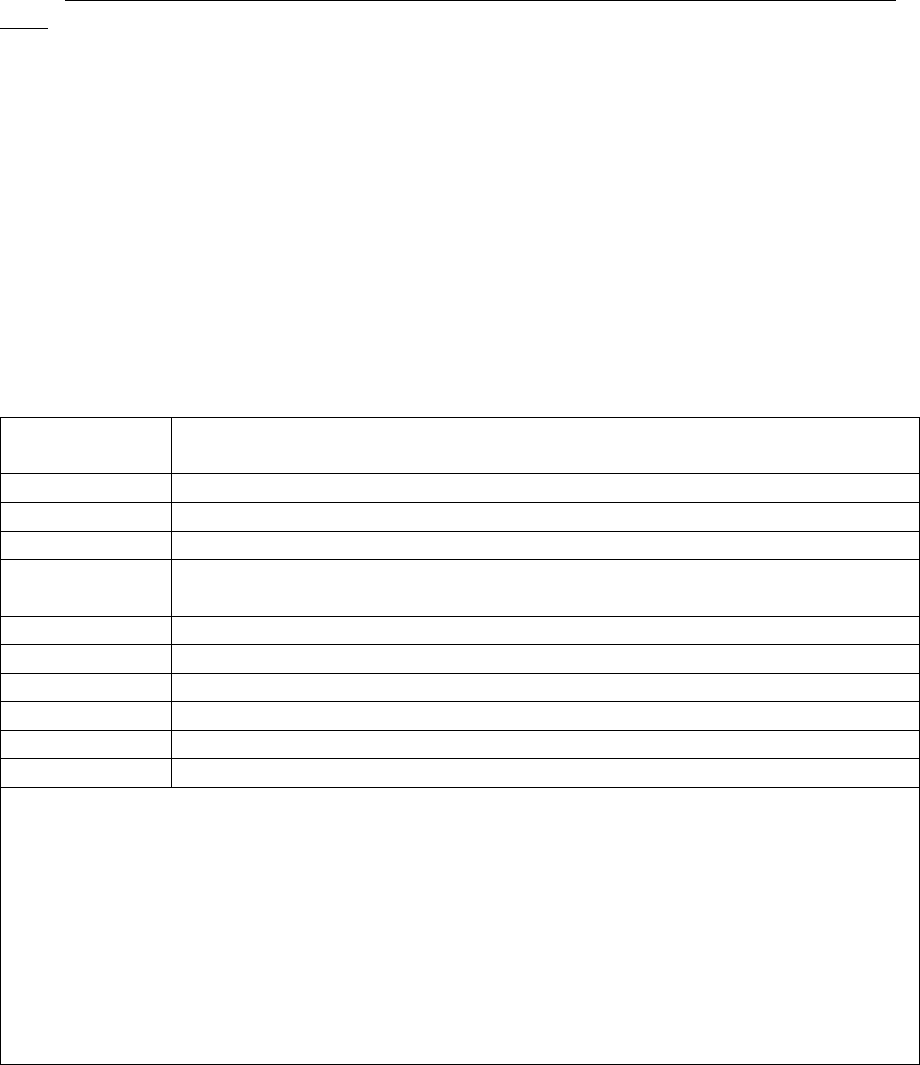
OPNAV M-5090.1
25 Jun 2021
22-10
maintain a safe facility to prevent releases and minimize the consequences of any accidental
releases. Facilities that exceed threshold quantity limits for a regulated substance contained in a
covered process must submit an RMP as required by reference (a), Part 68. Facilities are
responsible for updating their RMPs at least once every 5 years or sooner if required per
reference (a), sections 68.190(b) and 68.195.
c. New Source Performance Standards (NSPS) and Existing Source Emission Guidelines
(EG). Section 111 of the CAA requires EPA to establish Federal emission standards for source
categories that cause or contribute significantly to air pollution. Navy installations are required
to comply with applicable NSPSs, which can be found in reference (a), Part 60. NSPSs apply to
new and modified sources and reflect emission limits achievable through the application of the
best system of emission reduction, taking into account the cost of such technology and any other
non-air quality, health, environmental impact, and energy requirements. Generally, State and
local air pollution control agencies are responsible for NSPS implementation, compliance
assistance, and enforcement. The specific characteristics of an emissions source determine the
applicability of a particular NSPS. Section 129 of the CAA requires EPA to establish both
NSPSs and existing source EGs for solid waste combustion sources. EGs are model rules that
States use to develop their own rules for existing sources. They have also been established for
landfills and coal-fired electric steam-generating units. Table 22-3 of this manual shows the
most common NSPSs and EGs that apply to Navy installations.
Table 22-3. Commonly Applicable NSPSs and EGs
a
40 CFR Part
60 Subparts
NSPS or EG Source Category
Cc, WWW
Municipal Solid Waste Landfills EG and NSPS
Db, Dc
Industrial-Commercial-Institutional Steam-Generating Units NSPS
K, Ka
Storage Vessels for Petroleum Liquids
Kb
Volatile Organic Liquid Storage Vessels (Including Petroleum Liquid
Storage Vessels) NSPS
O
Sewage Treatment Plants NSPS
GG, KKKK
Stationary Gas and Combustion Turbines NSPS
JJJ
Petroleum Dry Cleaners NSPS
EEEE, FFFF
Other Solid Waste Incinerators NSPS and EG
b
IIII
Stationary Compression Ignition Internal Combustion Engines NSPS
JJJJ
Stationary Spark Ignition Internal Combustion Engines NSPS
Notes:
1. Reference (a), Part 60, subparts IIII and JJJJ contain provisions for requesting an NSE for
stationary engines under reference (a), Part 1068, subpart C (refer to subparagraph 22-3.4a of
this manual for procedures to follow).
2. Other NSPSs and EGs may affect Navy installations now or in the future due to changes
in operations or publication of new or amended rules. Reference (a), Part 60 includes a
complete list of NSPSs and EGs and their particular requirements.
3. Many NSPSs and EGs apply to incinerators. The Navy shut down most incinerators that
would have been subject to emission limits. Any Navy incinerators still operating are likely
exempt from the rules or covered by the Resource Conservation and Recovery Act
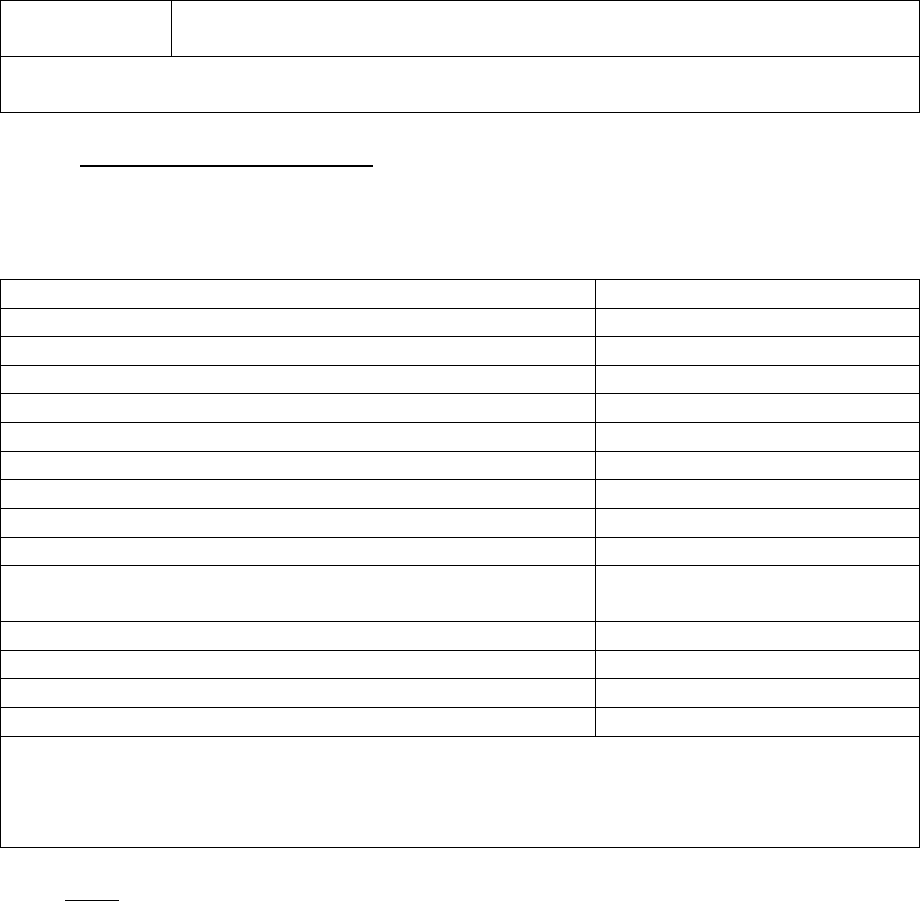
OPNAV M-5090.1
25 Jun 2021
22-11
40 CFR Part
60 Subparts
NSPS or EG Source Category
regulations or the HW Combustion NESHAP. EPA is expected to remove some of the
exemptions in subparts EEEE and FFFF and other incinerator rules in the future.
22-3.4. Provisions for Mobile Sources. EPA has issued a series of rules that reduce emissions
from a broad spectrum of mobile sources (e.g., vehicles, equipment). Table 22-4 of this manual
lists requirements applicable to mobile sources commonly used by the Navy.
Table 22-4. Regulations Applicable to Engines and Fuels
Regulated Entity
CFR Citation
Aircraft
40 CFR Part 87
Clean fuel vehicles
40 CFR Part 88
Engine test procedures
a
40 CFR Part 1065
Fuels and additives
b
40 CFR Parts 79 and 80
Highway motor vehicles
40 CFR Part 86
Large spark-ignition (SI) engines
40 CFR Part 1048
Locomotive compression-ignition (CI) engines
40 CFR Parts 92 and 1033
Marine CI engines
40 CFR Parts 94 and 1042
Marine SI engines
40 CFR Part 91
Mobile source control: conversions, importation,
preemption, exclusions
40 CFR Part 85
Non-road general compliance provisions
40 CFR Part 1068
Non-road diesel engines (other)
40 CFR Parts 89 and 1039
Recreational vehicles
40 CFR Part 1051
Small SI engines
40 CFR Part 90
Notes:
1. Applies to both mobile and stationary engines.
2. Reference (a), Part 80 includes additional details on requirements that apply to fuels and
refueling.
a. NSEs. The highway, non-road, locomotive, and marine engine rules promulgated under
Title II of the CAA (Emission Standards for Mobile Sources) contain an automatic NSE for
equipment with substantial combat features and for certain engines intended to be used outside
the United States as well as provisions for requesting an NSE. In addition, stationary engine
rules promulgated under 40 CFR Parts 60 and 63 refer to those Title II provisions. An automatic
or requested NSE should only be used when the use of a compliant engine is not possible
because of operational constraints. Before using or requesting an NSE, the Navy program
manager (PM) should perform an analysis in coordination with legal, environmental, and other
program stakeholders to validate the requirement for an NSE. The PM should document for the
record their determination that equipment contains substantial combat features prior to any
decision to purchase non-compliant engines using the automatic NSE. To obtain an NSE for
equipment without substantial combat features, the engine manufacturer must submit an official
request to EPA with an endorsement from a Federal agency responsible for national defense.
Prior to submission of an NSE request or endorsement to EPA, all Navy NSE actions must be
coordinated with the CAA Services Steering Committee through the Office of the Chief of Naval

OPNAV M-5090.1
25 Jun 2021
22-12
Operations, Energy and Environmental Readiness Division (OPNAV N45). The request typically
describes the equipment, engines, application, quantity, and requirement for the NSE. Once the
NSE is approved, the manufacturer may proceed with the production and sale of the engine and
must affix a label indicating that it is exempt. Since there are some restrictions on entering non-
compliant engines into commerce, non-compliant NSE engines that are declared as excess
should be identified as such when turning them over to DLA Disposition Services. Any engines
(stationary and mobile sources) acquired by a Navy organization from DLA Disposition Services
should be fully compliant with Federal, State, or local air quality regulations.
b. California Emission Standards. The CAA granted the State of California exclusive
authority to establish new engine and fuel standards. This authority does not cover aircraft or
locomotive engines, nor does it cover construction or farm equipment with engines less than 175
horsepower. New California engine standards generally harmonize with Federal engine
standards. California rules, however, are unlike Federal standards in that they require retrofit
and replacement of existing engines to maintain compliance. For Navy operations in California,
consult the regional environmental coordinator (REC) for applicable requirements.
c. Aircraft and Aircraft Engines. CAA regulations for aircraft and aircraft engines apply
only to engines on an aircraft that has a valid airworthiness certificate or equivalent foreign
airworthiness certificate. Except for some commercial aircraft owned by the military, military
aircraft do not normally have airworthiness certificates and, therefore, are exempt from the
regulatory standard. No State or local air quality regulator, including California, may adopt or
attempt to enforce any standard respecting emission of any air pollutant from any aircraft or
aircraft engine unless such standard is identical to an applicable standard developed by EPA and
the Secretary of Transportation.
d. Vehicle Inspection and Maintenance. Vehicles located in ozone nonattainment areas with
a marginal or higher classification or in carbon monoxide moderate or serious nonattainment
areas are subject to periodic inspections of the vehicle’s pollution control equipment and
emissions testing. Navy installations in these areas must demonstrate compliance with State I/M
programs for all motor vehicles operated on the installation even if the vehicle is not registered in
that State, as long as the State’s program is not discriminatory toward Federal agencies or
Federally owned or Federal-employee-owned vehicles. This requirement applies to all
employee-, military-, contractor-, and Federally owned or leased vehicles operated more than 60
days per year on the installation. Military tactical vehicles are exempt from the I/M program.
e. Tampering with Emission Controls. Navy personnel must not remove or render
inoperative any device or element of design that is installed in a government motor vehicle or
engine to comply with air quality regulations.
f. Alternative Fuel and Clean Fuel Fleet Vehicles
(1) Per Title II of the CAA, part C, Navy installations with a covered vehicle fleet (i.e.,
10 or more vehicles centrally fueled in a covered area) must ensure at least 70 percent of all new
light-duty fleet vehicles acquired are clean fuel vehicles. For heavy-duty trucks above 8,500
pounds (lb) and up to 26,000 lb gross vehicle weight rating, that percentage must be at least 50

OPNAV M-5090.1
25 Jun 2021
22-13
percent. Additional and more stringent requirements under reference (d) must also be
considered.
(2) Section 246(g) of the CAA mandates that any Federal facility that dispenses clean
alternative fuels to Federal fleet vehicles must offer the fuel for sale to the public during
reasonable business hours, subject to national security concerns and the commercial availability
of such fuels in the vicinity of the facility.
22-3.5. Greenhouse Gas Emissions. Although GHGs are not criteria pollutants and are not
specifically called out for regulation in the CAA, the U.S. Supreme Court determined that GHGs
are air pollutants under the CAA, and EPA has the authority to regulate GHGs under the CAA
(Massachusetts v. EPA, 549 U.S. 497 (2007)). Navy installations that emit GHGs above
established thresholds are required to comply with applicable requirements of reference (a), Part
98 (commonly known as the GHG Reporting Program (GHGRP)), State rules, and EPA
permitting requirements. In addition, the Navy reports its GHG emissions inventory annually to
the Office of the Secretary of Defense (OSD) for the submission of a single DoD-consolidated
GHG inventory to the Office of Management and Budget Director and the Council on
Environmental Quality Chair, as required by reference (e).
a. GHGRP. GHGs included under the GHGRP are carbon dioxide (CO
2
), methane, nitrous
oxide, sulfur hexafluoride, hydrofluorocarbons (HFC), perfluorocarbons (PFC), and other
fluorinated gases as defined in reference (a), section 98.6. In general, for facilities that emit
GHGs, the threshold for reporting is 25,000 metric tons or more of CO
2
equivalent (CO
2
e) per
year. This threshold is based on actual emissions. Facilities subject to the rule are required to
report annual emissions of GHGs per reference (a), Part 98. Some State GHG reporting
programs may be more stringent.
b. GHG Permitting Requirements. Under the PSD permit program, EPA can regulate GHG
emissions from a major stationary source that is identified as major based on emissions of other
pollutants, if the source has the potential to emit 75,000 tpy of CO
2
e or more. Applicable GHG
emission requirements issued in a PSD permit would be incorporated into the source’s Title V
permit.
c. GHG Emissions Reporting and Reduction Requirements under E.O. 13834. The
requirements of this subparagraph apply to DoD but cover all Navy ships, aircraft, vehicles, and
shore activities worldwide. Reference (e) requires agencies to measure, report, and reduce their
GHG emissions from direct and indirect activities. References (f) and (g) provide GHG
accounting and reporting methodologies to be used by the Navy in conducting a fiscal year (FY)
2008 baseline emissions inventory and subsequent years’ annual inventories under reference (e).
The Navy’s inventory for reporting GHGs under reference (e) is prepared by the Chief of Naval
Operations (CNO); Commander, Navy Installations Command (CNIC); and Commander, Naval
Facilities Engineering Command (COMNAVFACENGCOM) per the responsibilities identified
in paragraphs 22-4.1 and 22-4.6 of this manual, using a centralized approach primarily relying on
data already collected via existing reporting programs. There is no requirement, therefore, for
individual installations to develop their own inventory for purposes of compliance with reference
(e).

OPNAV M-5090.1
25 Jun 2021
22-14
22-3.6. Management of Ozone-Depleting Substances. The requirements of this paragraph of
this manual apply to all Navy ships, aircraft, vehicles, and shore activities worldwide except
when the requirements in the OEBGD and FGSs, set per chapter 34 (Overseas Environmental
Compliance Ashore) of this manual, are more protective. Regulations issued under sections 601
to 607 of the CAA phase out the production and import of ozone-depleting substances (ODS)
consistent with the schedules developed under the Montreal Protocol. In the United States,
ODSs are regulated as Class I or Class II controlled substances. Class I substances have a higher
ozone-depleting potential (ODP). Class II substances are hydrochlorofluorocarbons (HCFC),
which are transitional substitutes for many Class I substances and are also in the process of being
phased out. Reference (g) establishes DoD policy on GHG emissions reporting and reduction
per reference (e), which includes fluorinated substances that are GHGs (e.g., HFCs, PFCs) and
are used by the Navy as substitutes for Class I and Class II ODSs in multiple applications (i.e., as
refrigerants, solvents, and firefighting agents). Accordingly, Navy facilities must follow similar
procedures for HFCs and PFCs as are required for ODSs in subparagraph 22-3.6e of this manual,
including technician certification, recovery and recycling, and leak monitoring and repair to
reduce emissions to help achieve GHG-emission reduction targets established by DoD per
reference (e).
a. Class I and II ODS Phase-Out Schedule. Under the Montreal Protocol, Class I ODSs have
been completely phased out in the United States, except for exemptions. All uses of Class I ODS
solvents should have ceased by 1 January 2015, unless a waiver was granted by OPNAV N45
per subparagraph 22-3.6i of this manual. For Class II ODSs, the United States is obligated to
limit HCFC consumption to a specific level and to reduce it in a step-wise fashion as detailed in
reference (a), section 82.16.
b. Mission-Critical Applications
(1) The use of Class I and Class II ODSs must continue for mission-critical applications
so as not to jeopardize or degrade the safety or operational requirements of the Navy until such
time as the cognizant system command develops and approves, and echelon 2 commands
implement, the use of safe alternative substances or systems, or until existing hardware is retired
from service. Navy mission-critical applications are:
(a) Chlorofluorocarbon (CFC)-12 and CFC-114 used in legacy ship chilled-water air
conditioning, ships stores and cargo refrigeration, and legacy aircraft environmental control
systems;
(b) CFCs used in shore-based training applications where weapons systems
equipment is stationed at a shore facility responsible for training of personnel in the handling,
operation, and maintenance of that equipment;
(c) HCFC-22 used in legacy ship air conditioning, stores and cargo refrigeration,
shipboard oxygen and nitrogen producers (and oxygen and nitrogen producers at training
facilities), and landing craft air cushion (LCAC) air-conditioning systems;

OPNAV M-5090.1
25 Jun 2021
22-15
(d) Halon 1211 used in shipboard aircraft rescue and firefighting vehicles, LCAC fire
suppression systems, and for fire suppression in aircraft;
(e) Halon 1301 used in legacy shipboard total flooding fire suppression applications
and legacy aircraft explosion suppression and fire-protection applications;
(f) CFC-113 used in support of oxygen system cleaning; and
(g) Shore-based heating, ventilation, air conditioning, and refrigeration (HVAC&R)
equipment and fire-protection systems as approved by OPNAV N45.
(2) ODS Procurement and Use in Acquisition
(a) Prohibitions
1. Per references (h) through (l), use of Class I ODSs in contracts is prohibited
unless an appropriate technical representative (ATR) certifies that no suitable substitute is
available and a senior acquisition official (SAO) approves the procurement. Substitutes must
also be approved under EPA’s Significant New Alternatives Policy (SNAP) program for the
intended use and application.
2. Purchase and use of Class II ODS solvents (HCFCs) is prohibited per
reference (a), Part 82.
3. Procurement of ODSs by Navy activities for transfer to Foreign Military Sales
(FMS) customers is prohibited, since supply of such substances could be in violation of the
provisions of reference (a), Part 82, the Montreal Protocol, and the laws of the foreign
government. Navy activities that are designated as authorized users of the ODS reserve are also
not authorized to transfer ODS reserve material to FMS customers for any reason. Non-ODS
alternatives should be offered to FMS customers whenever possible. If alternatives are not
available, the FMS customer should be advised to procure Class I ODSs directly, preferably from
their own domestic sources.
(b) Requirements
1. The cognizant command must designate an ATR who will conduct a technical
review and certify there are no suitable substitutes available;
2. Flag officer or member of the senior executive service designated by the
requiring command to be the SAO for the procurement must approve the contract following
technical certification. The SAO is the person who actually authorizes the purchase and should
be in the chain of command of the activity that owns or has cognizance over the equipment or
facility requiring the use of a Class I ODS;
3. All Class I ODSs for mission-critical applications (planned use) must be
obtained from the ODS reserve and not by contracting action;

OPNAV M-5090.1
25 Jun 2021
22-16
(c) Unplanned use of Class I ODSs for mission-critical applications must be approved
per the procedures in reference (k).
(3) Use of ODS Reserve. The ODS reserve must be used to support only mission-critical
applications when no alternative is available or when interim support is required during retrofit
or implementation of alternatives. Accordingly, these provisions apply:
(a) Requisition of ODS reserve material for non-mission-critical applications is not
authorized;
(b) Oversight and control of access must be exercised through an authorized use list
(AUL);
(c) DLA has established procedures for deposits to and requisitions from the ODS
reserve. DLA publishes these procedures on the DLA Aviation Web site (refer to appendix E
(Web Sites) for Web site address);
(d) Upon approval of an unplanned use, OPNAV N45 may authorize access to the
ODS reserve and COMNAVSEASYSCOM must update the AUL accordingly; and
(e) Turn-in of unused excess Class I ODS solvent to the ODS reserve is mandatory.
DLA procedures for deposits to the reserve are found on the DLA Aviation Web site (refer to
appendix E (Web Sites) for Web site address).
c. Non-Mission-Critical Applications
(1) New Equipment
(a) All new shore-based, non-mission-critical HVAC&R equipment must use an
EPA-SNAP-program-approved refrigerant with an ODP of zero;
(b) New HVAC&R equipment (both mission-critical and non-mission-critical) must
not contain Class II substances;
(c) Outside continental U.S., activities should consult applicable FGS to determine if
earlier HCFC production or use phase-outs are applicable; and
(d) Installation of shore-based Halon 1301 fire-protection systems and procurement
of non-mission-critical portable Halon fire extinguishers is prohibited.
(2) Procurement. Refer to subparagraph 22-3.6b(1) of this manual for procurement
requirements for Class I ODSs.
(3) Use of ODS Reserve. Activities must not requisition ODSs from the ODS reserve for
non-mission-critical applications such as shore-based HVAC&R equipment or shore-based fire-
protection systems.

OPNAV M-5090.1
25 Jun 2021
22-17
(4) Conversions. Shore facilities should have already converted or replaced all existing
non-mission-critical HVAC&R equipment containing Class I ODSs based upon the policies in
previous versions of this manual, unless a waiver was received from OPNAV N45 per
subparagraph 22-3.6i of this manual. Equipment conversion does not apply to small appliances,
air-conditioning equipment with 5 tons or less cooling capacity (60,000 British Thermal Units),
and motor vehicle air conditioners (MVAC), but new equipment must meet the standards in
subparagraph 22-3.6c(1) of this manual. In addition, the following requirements apply:
(a) If an accidental discharge or fire should occur in a shore facility space protected
by Halon 1301, the system should not be refilled with Halon 1301. Reference (m) should be
used to determine if water sprinklers provide adequate protection or if retrofit with an alternative
agent is required; and
(b) All excess Class I ODS refrigerants, HCFC-22 refrigerant, and Halons should
continue to be recovered and returned to the ODS reserve using procedures posted on the DLA
Aviation Web site (refer to appendix E (Web Sites) for Web site address).
(5) Portable Halon Fire Extinguishers. As of 1 January 1996, activities are required to
remove and locally redistribute all non-mission-critical Halon portable fire extinguishers to
support mission-critical requirements or turn them in to the Navy portion of the ODS reserve.
(6) ODS Solvents. Use of Class I ODS solvents in non-mission-critical applications is
prohibited except for essential laboratory or analytical uses as defined in reference (a), Part 82,
subpart A, appendix G. Purchase and use of the Class II ODS solvent HCFC-141b is prohibited.
Purchase and use of other Class II ODS solvents are prohibited effective 1 January 2015.
(7) ODS Solvent Alternatives. If an activity identifies an ODS solvent application for
which it does not know of an alternative, the activity must consult with the cognizant engineering
authority. If no alternative has been identified, the activity must forward this information via the
chain of command to its cognizant echelon 2 command. The cognizant echelon 2 command is
responsible for developing a plan of action to test and qualify an alternative.
(8) Existing Supplies of ODS Solvents. Existing stocks of ODS solvents may be used to
provide interim support during the transition to non-ODS alternatives. Activities must turn in
unopened containers of Class I ODS solvents that are not required for interim support to the ODS
reserve. Activities were directed to cease all ODS solvent use (Class I and Class II) no later than
1 January 2015 unless a waiver has been granted by OPNAV N45 per subparagraph 22-3.6i of
this manual.
(9) Shipboard Galley and Ancillary Refrigeration Equipment. Chapter 35
(Environmental Compliance Afloat), subparagraph 35-3.13c of this manual contains policies and
procedures for support of shipboard galley and ancillary refrigeration equipment.

OPNAV M-5090.1
25 Jun 2021
22-18
d. Criteria for Selection of ODS Alternative
(1) Navy activities must select alternatives that are EPA-SNAP-program-approved with
an ODP of zero. Activities should also select low-global-warming-potential alternatives when
feasible.
(2) Activities must contact their local industrial hygienist or occupational safety and
health personnel to ensure proper identification of occupational safety and health hazards
associated with ODS alternatives. Activities must ensure recommended health and safety hazard
control measures are properly in place prior to implementing alternatives. Reference (n) details
specific procedures for obtaining health hazard assessments pertaining to operational use of
hazardous materials (HM).
e. Refrigerants Handling. In addition to the following requirements for ODS refrigerants
contained in reference (a), Part 82, Navy facilities must follow similar procedures for HFC and
PFC refrigerants to help reduce GHG emissions per reference (e). Refer to subparagraph 22-3.5c
of this manual for additional details.
(1) Maintenance. Navy personnel must conduct maintenance, service, repair, disposal,
leak monitoring, and recordkeeping on appliances and MVACs and MVAC-like appliances
containing Class I or II ODSs or substitutes for these refrigerants (e.g., HFCs, PFCs) per
requirements detailed in reference (a), Part 82, subparts B and F.
(2) Refrigerant Recovery. Intentional release of ODS refrigerants and their substitutes
(such as HFCs), while maintaining, servicing, repairing, or disposing of air-conditioning or
refrigeration equipment is prohibited. Activities must use EPA-approved refrigerant recovery
equipment and must certify to the appropriate EPA regional office, per reference (a), section
82.162, that they have acquired such equipment and are complying with reference (a), Part 82.
Overseas activities and ships are not required to submit this certification. Overseas facilities
must use EPA-approved refrigerant recovery equipment if available. If EPA-approved
equipment is not available, then locally available recovery equipment that achieves performance
comparable to EPA-approved recovery equipment must be used. For air-conditioning and
refrigeration equipment designed and used solely by the military (military-unique systems),
recovery equipment must be designed, to the extent practical, to achieve performance
comparable to that required of commercial recovery equipment by EPA.
(3) Refrigerant Technician Certification. All Navy military and civilian refrigerant
technicians, except for motor vehicle technicians, must be certified per reference (a), section
82.161. Proof of such certification must be readily available at the work place. Technicians may
require additional State or local certifications if they are more stringent than Federal certification.
Although technician certification requirements of reference (a), Part 82 do not apply to foreign
nationals working on U.S. Navy equipment overseas, certification of foreign nationals may be
required by the host nation. The applicable FGS should be consulted to determine if the host
nation has certification requirements for foreign nationals.

OPNAV M-5090.1
25 Jun 2021
22-19
(4) Motor Vehicle Technician Certification. All Navy military and civilian motor vehicle
technicians performing service and repair on MVACs must be certified as specified by reference
(a), section 82.40. Certification requirements do not apply to foreign nationals working on U.S.
Navy vehicles overseas. The applicable FGS should be consulted to determine if the host nation
has certification requirements for foreign nationals.
(5) Refrigerants as HMs. ODS refrigerants are considered HMs and must be controlled
and managed per this chapter and chapter 23 (Hazardous Materials Management Ashore) of this
manual. Used Class I and Class II ODS refrigerants that are to be recycled for future use,
however, are not considered HW under Federal HW regulations. Where they are more
restrictive, however, State and local HW regulations apply to storage, transportation, and
disposal of used ODS refrigerants.
f. Prohibition of Intentional Releases of Halon and Substitute Fire Suppressants. Navy
personnel must not intentionally release Halon or substitute fire suppressants that are GHGs,
such as HFCs, during the service, maintenance, repair, or disposal of any firefighting equipment.
Technicians who test, maintain, service, repair, or dispose of Halon-containing equipment must
be trained regarding Halon emission reduction as specified by reference (a), section 82.270.
g. Emerging Technology and Alternatives. Navy activities having any information
regarding new emerging technologies and alternatives for the elimination of ODSs or substitutes
that are GHGs should contact their budget submitting office (BSO) or COMNAVSEASYSCOM
for incorporation into the Navy Shipboard Environmental Information Clearinghouse. In
addition, activities may request information on ODS alternatives by contacting the clearinghouse
through COMNAVSEASYSCOM.
h. Disposal of ODSs
(1) Sale of ODSs. No Navy activity must sell or otherwise transfer any Class I ODSs or
HCFC-22 outside the Navy without written permission from their chain of command and
OPNAV N45. Contract specifications and contractual actions must not include the transfer of
Class I ODSs and HCFC-22 to contractors. Activities must deposit excess Class I ODSs and
HCFC-22 into the Navy’s portion of the ODS reserve.
(2) Turn-In of HVAC&R to DLA Disposition Services. Activities transferring
HVAC&R equipment to DLA Disposition Services for reuse must label the equipment to
indicate that it contains an ODS. Activities transferring HVAC&R equipment to DLA
Disposition Services for disposal as scrap must recover the ODS prior to disposal and label the
units as having had all refrigerants and oils removed per EPA regulations. Additional
information on HVAC&R equipment disposal can be found in reference (o), chapter 10.
i. Waivers. Requests for waivers to the provisions of the ODS subparagraphs of this chapter
must be submitted to OPNAV N45 via the chain of command. For such waivers, an activity
must demonstrate the application of the requirements of these subparagraphs is impractical or
results in the expenditure of resources that are not commensurate with the resultant reduction in

OPNAV M-5090.1
25 Jun 2021
22-20
the potential for unintentional release of ODSs to the environment. Statutory requirements will
not be waived.
(1) Content. At a minimum, waiver requests should contain:
(a) ODS involved and its intended use;
(b) Number of units affected;
(c) Quantity of ODS involved;
(d) Associated costs;
(e) Statement of environmental impact (e.g., annual leakage, average annual
discharge of material);
(f) Safety and occupational health impact;
(g) Operational impact;
(h) Plan for meeting requirement; and
(i) Additional information as appropriate.
(2) Review and Approval Process. OPNAV N45 must review waivers on a case-by-case
basis and provide responses by letter via the chain of command. All approved waivers must be
granted for a finite period.
22-3.7. Other Clean Air Act Requirements. This paragraph lists several additional CAA
sections that may impact Navy operations.
a. Enforcement
(1) Waiver of Sovereign Immunity. The broad waiver of Federal sovereign immunity in
section 118(a) of the CAA subjects Federal facilities to all Federal, interstate, State, and local air
pollution requirements to the same extent as any non-governmental entity. States or local air
districts generally enforce these CAA requirements; however, EPA also has enforcement
authority for most CAA violations. Methods of enforcement include compliance orders, field
citations, administrative assessment of civil penalties, civil judicial enforcement, and criminal
enforcement. The CAA provides for penalties of up to $37,500 per day for each violation. Navy
installations must notify their RECs and OPNAV N45 via their chain of command if EPA, the
State, or a local regulatory entity implements CAA regulatory requirements in a manner that is
discriminatory per section 118(a) of the CAA.
(2) State Civil Penalties. Although installations are subject to CAA penalties assessed by
EPA, the applicability of State and local air district penalties is not clear due to conflicting court

OPNAV M-5090.1
25 Jun 2021
22-21
opinions. Therefore, all penalty assessments should be coordinated per the provisions of chapter
19 (Processing Notices of Violation Under Environmental Laws and Regulations) of this manual
and the additional policy provisions of this chapter. Due to the uncertainty in the courts, CAA
penalty provisions response letters to State agencies are also reviewed by the Department of
Justice via the Naval Litigation Office, Office of the General Counsel, Department of the Navy.
Reference (p) formally established that process as a DON policy.
(3) Citizen Suits. Civil actions may be brought against any person (including the United
States) for present or past (if repeated) CAA violations of an emission standard, limitation, or
order issued by EPA or a State. In addition, actions may be brought against any person who
constructs without a required permit. Navy installations must notify their RECs and OPNAV
N45 via their chain of command if any civil action is brought against the installation or person
performing any act or duty on behalf of the installation.
b. Emission Reduction Credits
(1) Sections 110(a)(2)(A) and 172(c)(6) of the CAA authorize States or their local air
quality districts (AQD) to establish economic incentive programs (e.g., trading system for
emission reduction credits (ERC)). ERCs are created when equipment that emits pollutants is
removed from service or emissions from equipment remaining in service are reduced, provided
the emissions reductions would not otherwise be required by the CAA or current SIP, and the
owner applies under the AQD regulations for credit for the reduction.
(2) Navy installations located in areas where economic incentive programs have been
established under the CAA can create and trade ERCs. ERCs must be acquired and disposed by
a Navy entity as if they were personal property. No ERCs may be disposed of or traded to non-
Navy facilities unless such action has been coordinated with the appropriate REC. For
installations being closed or realigned, ERCs must be used and disposed of per reference (q).
For operating installations, ERCs must be utilized and disposed of per reference (r) in this
manner:
(a) ERCs generated from a change in operations, removal from service of equipment,
or any other action that results in emissions reductions may be banked for:
1. Future use by that same installation;
2. Transfer to another Navy installation within the same AQD or another AQD
that will accept transfer of the credits;
3. Transfer to any DoD installation within the same AQD or another AQD that
will accept transfer of the credits; or
4. Transfer to any other Federal agency within the same AQD or another AQD
that will accept transfer of the credits.

OPNAV M-5090.1
25 Jun 2021
22-22
(b) ERCs may be transferred between military Services under reference (s), with or
without compensation;
(c) ERCs determined to be surplus to the Federal government must be reported for
screening and disposal using the existing personal property disposal mechanisms; or
(d) Installations requiring ERCs must either purchase ERCs from other sources or
obtain emissions offsets from on-installation sources.
c. Air Pollution Emergency Episodes. Where required as part of a SIP approved by EPA per
reference (a), Part 51, Navy shore facilities must develop, in coordination with the appropriate
State authorities, an air pollution emergency episode contingency plan to reduce air emissions
during emergency episodes, identifying all actions that can reasonably be taken without
compromising essential services and mission responsibilities.
d. Exemptions for Certain Territories. Per section 325(a)(1) of the CAA, upon petition by
the Governor of Guam, American Samoa, U.S. Virgin Islands, or the Commonwealth of the
Northern Mariana Islands, the EPA administrator may exempt any person or source in such
territory from any CAA requirement other than those provisions concerning HAPs or
implementation plans for the achievement of the NAAQS. This is also applicable to Navy
entities located in American Samoa, U.S. Virgin Islands, or the Commonwealth of the Northern
Mariana Islands. After being petitioned by the governor, EPA may grant such exemptions based
on the finding that compliance is not feasible or is unreasonable due to unique geographical,
meteorological, or economic factors.
e. Federal Contractor Restrictions. No Navy entity may enter into a contract with any person
convicted of a criminal offense under the CAA. This restriction applies to the procurement of
goods, materials, and services to perform such contract at any facility that gave rise to such
conviction if such facility is owned, leased, or supervised by such person.
22-3.8. Training Requirements. The Navy’s goal is to implement efficient and effective training
that provides the right training to the right people at the right time in support of the Navy’s
mission. The Navy Environmental Readiness Training Program (NERTP) supports this goal by
identifying and resourcing the development and delivery of quality environmental readiness
training courses. In addition to NERTP-sponsored courses, other specialty schools may also
resource, develop, and deliver environmental readiness courses to meet their specific
requirements.
a. All personnel (i.e., civilian, active-duty military, and reserve military) must receive
training as applicable to their specific job assignments and levels of responsibility. NERTP
course descriptions, target audiences, and schedules are available on the Civil Engineer Corps
Officer School and Naval Safety and Environmental Training Center Web sites (refer to
appendix E (Web Sites) for Web site addresses).
b. Refer to chapter 3 (Environmental Readiness Training) of this manual, for information on
general overall and billet-specific environmental readiness training requirements as well as

OPNAV M-5090.1
25 Jun 2021
22-23
training requirements for personnel who have collateral environmental responsibilities. Chapter
3 (Environmental Readiness Training), table 3-1 of this manual provides NERTP formal training
courses and target audiences for each formal course offered.
c. In addition to the training requirements contained in chapter 3 (Environmental Readiness
Training) of this manual, personnel managing or operating certain sources or processes must
obtain specific training where required to build and maintain proficiency in performing their job
duties in compliance with applicable regulations and where explicitly required by the CAA,
including:
(1) Prevention of accidental releases under section 112(r) of the CAA;
(2) Solid waste incineration under section 129(d) of the CAA; and
(3) ODSs under Title VI of the CAA.
d. CAA-compliance PMs, at the activity or installation level, must have training
commensurate to their level of responsibilities consistent with the community management plan
for the position if applicable.
22-4 Responsibilities
22-4.1. OPNAV N45 must:
a. Coordinate the overall implementation of CAA requirements and chair the Navy CAA
Steering Committee;
b. Coordinate the review of proposed and final CAA regulations;
c. Issue policy and guidance as needed;
d. Coordinate the review of fines and penalties with the Navy Office of the Assistant
General Counsel (Energy, Installations, and Environment);
e. Review all requests for waivers (refer to subparagraph 22-3.6i of this manual) to the
requirements of ODS subparagraphs of this chapter and issue determinations as appropriate;
f. Provide oversight of the ODS reserve, control access through an AUL, and authorize any
supportable unplanned use approved per reference (k);
g. Compile BSO data on ODS reserve requirements and identify any shortfalls;
h. Review, in coordination with the cognizant OPNAV organizations in charge of activities
that emit reportable GHG per reference (e), activities such as personnel travel and commuting,
emission of HFC gases, waste disposal, operational and shore energy usage, and the annual GHG
OPNAV M-5090.1
25 Jun 2021
22-24
emissions inventories prepared by COMNAVFACENGCOM and CNIC per subparagraph 22-
4.6k of this manual; and
i. Submit the annual Navy GHG Emissions Inventory in compliance with reference (e) to
Deputy Assistant Secretary of the Navy (DASN) (Environment) (DASN(E)) and DASN
(Energy).
22-4.2. BSOs must:
a. Implement the policies and procedures of this chapter;
b. Ensure activities under their command comply with current Federal, State, interstate, and
local air pollution control requirements;
c. Include requests for resources to meet air pollution control requirements in program
objective memorandum and budget submissions;
d. Ensure activities execute funds to meet mandatory requirements of the CAA;
e. Revise preventive and corrective maintenance procedures, for which they are the
cognizant activity, to incorporate the use of ODS recovery and recycling units;
f. Revise military specifications and manuals, for which they are the cognizant activity, to
reduce or eliminate references to the use of HAP-containing solvents and other HM as required
in chapter 23 (Hazardous Materials Management Ashore), subparagraph 23-3.5c of this manual,
closely coordinating with other BSOs and systems commands, as appropriate, for cross-cutting
requirements.
g. Revise military specifications and manuals, for which they are the cognizant activity, to
reduce or eliminate references to the use of ODSs, closely coordinating with other BSOs and
systems commands, as appropriate, for cross-cutting requirements;
h. Ensure all field activities meet requirements for elimination of ODS equipment;
i. Review all requests from subordinate activities for waivers (refer to subparagraph 22-3.6i
of this manual) to the requirements of the ODS subparagraphs of this chapter and forward
recommendations to OPNAV N45; and
j. Assign a representative to the Navy CAA Steering Committee and participate in meetings
and activities of the committee.
22-4.3. All Navy systems commands must:
a. Ensure procurement or leasing of non-tactical or non-deployable commercial vehicles,
equipment, and vessels that are not covered under an NSE comply with applicable Federal and
OPNAV M-5090.1
25 Jun 2021
22-25
State standards and regulations in effect at the location where the equipment will be placed into
service;
b. Ensure all procured tactical or deployable vehicles, equipment, and vessels, when
required, are appropriately covered under an NSE per subparagraph 22-3.4a of this manual and
assigned the appropriate demilitarization code to prevent their sale to the public as a serviceable
engine; and
c. Ensure all new acquisitions or retrofitting of both mobile and stationary sources (e.g.,
facilities, equipment, engines, vehicles) are made to ensure compliance with all applicable
emission standards and operational requirements under the CAA.
22-4.4. COMNAVSEASYSCOM must:
a. Maintain the Navy Shipboard Environmental Information Clearinghouse for use by all
Navy activities;
b. Manage the conversion of Navy shipboard HVAC&R systems;
c. Monitor the drawdown of the Navy’s reserve of ODSs and provide quarterly reports of the
status of the ODS reserve to OPNAV N45. If the actual rate of drawdown varies from predicted
rates, develop corrective action plans, fully coordinate them with the appropriate echelon 2
commands, and provide recommended corrective actions to OPNAV N45;
d. In coordination with the fleets, evaluate, on an annual basis, the ODS reserve
requirements for cognizant mission-critical applications of ODSs and submit any changes to
OPNAV N45;
e. Revise procurement guidance for shipboard galley equipment to include only equipment
that meets the requirements of chapter 35 (Environmental Compliance Afloat), subparagraph 35-
3.13c of this manual;
f. Ensure miscellaneous COMNAVSEASYSCOM-owned equipment and systems that use
ODSs have material support plans or are converted or replaced to use non-ODS materials;
g. Review and approve requests for administrative additions, deletions, or changes to the
AULs for the ODS reserve for all shipboard mission-critical applications;
h. Maintain the ODS reserve AUL/Ships Hazardous Material List (SHML) as directed by
OPNAV N45 and ensure administrative changes to planned users are made as requested by
Commander, Naval Air Systems Command (COMNAVAIRSYSCOM); Commander, Military
Sealift Command (COMSC); and COMNAVSUPSYSCOM. If a request involves an unplanned
use, ensure the requesting activity has complied with the procedures contained in reference (k);
and
OPNAV M-5090.1
25 Jun 2021
22-26
i. Review and approve requests from shore facilities for thinning marine coatings per
subparagraph 22-3.3b(2)(a) of this manual.
22-4.5. COMNAVSUPSYSCOM must:
a. Serve as the Navy liaison with DLA on matters pertaining to marine coating procurement
contracts and ensure suppliers provide a batch certification that demonstrates compliance with
the applicable VOHAP limit given in reference (a), Part 63, subpart II, table 2;
b. Serve as the Navy liaison with DLA on matters pertaining to the establishment,
maintenance, operation, and funding, as appropriate, of the ODS reserve;
c. Revise, as necessary, procurement instructions and guidance to include additional ODSs
and ODS replacements as they are regulated by EPA;
d. Assist echelon 2 commands with the ODS recycling and reclamation program;
e. Incorporate refrigerant and Halon recovery and recycling equipment and appropriate spare
parts into the Navy supply system as soon as possible after contract award and notification by
other echelon 2 commands;
f. Provide monthly reports of ODS requisitions as compiled by COMNAVSUPSYSCOM,
Weapon Systems Support to COMNAVSEASYSCOM for incorporation into the ODS reserve
monitoring system; and
g. Review and approve requests for administrative additions, deletions, or changes to the
ODS reserve AUL for all logistics distribution activities in support of mission-critical
applications.
22-4.6. COMNAVSUPSYSCOM, in conjunction with COMNAVFACENGCOM and CNIC,
must ensure the Navy Enterprise Resource Planning Single Supply Solution with Environmental
Health and Safety functionality software used for HM management will facilitate data gathering
for annual emissions reporting and Emergency Planning and Community Right-to-Know Act
reporting for all applicable HAPs, toxic air pollutants, and VOCs.
22-4.7. COMNAVFACENGCOM, in coordination with CNIC, must:
a. Revise technical documents and manuals to reflect design, operation, monitoring, and
testing parameters required by emission and performance standards and permit requirements for
shore facilities;
b. Provide technical assistance to shore commands, as requested, to determine applicable
permit requirements, obtain permit data, complete permit applications and renewals, and
determine and implement requirements for mobile source controls;
OPNAV M-5090.1
25 Jun 2021
22-27
c. Develop and provide to installation commanding officers (ICO) required air permit
applications or renewals for all construction projects. For military-construction (MILCON)-
funded air projects, pay related fees from the funds appropriated and budgeted for the projects,
which include initial source testing for startup of facilities and initial operating permits;
d. Identify appropriate emissions offsets, where required for new construction, and prepare
and coordinate projects to implement offset requirements;
e. Identify compliance requirements for new construction by coordinating new projects or
modifications with appropriate State, local, or EPA regional offices and the affected facility;
f. Provide Navy-wide coordination and technical support for compliance with CAA Title II
requirements applicable to the Navy’s vehicle fleets;
g. Assist Navy vehicle fleets in I/M testing;
h. Maintain Navy-wide information on the location and physical characteristics of Navy
stationary sources, including key features of variances and delay compliance orders;
i. Develop and revise, as necessary, guidance for shore activities on ODS alternatives for
HVAC&R equipment and fire protection systems;
j. Provide technical support to shore activities for replacement of ODS; and
k. Prepare annual Navy energy and GHG emissions inventories required by reference (e) and
submit them to OPNAV N45 for review and subsequent submission to DASN(E) and
DASN(Energy).
22-4.8. COMNAVAIRSYSCOM must:
a. Monitor the drawdown of the COMNAVAIRSYSCOM portion of the ODS reserve and
develop any required corrective actions in cooperation with OPNAV N45,
COMNAVSEASYSCOM, and the fleets;
b. In coordination with the fleets, evaluate, on an annual basis, the ODS reserve
requirements for cognizant mission-critical applications of ODSs and submit any changes to
OPNAV N45;
c. Identify and address ODS program, technical, and supportability issues related to naval
aviation and coordinate solutions with appropriate aircraft PMs, echelon 2 commands, and
OPNAV N45; and
d. Review and approve requests for administrative additions, deletions, or changes to the
ODS reserve AUL for all aviation mission-critical applications.
OPNAV M-5090.1
25 Jun 2021
22-28
22-4.9. COMSC must:
a. Monitor the drawdown of the COMSC portion of the ODS reserve and develop any
required corrective actions in cooperation with OPNAV N45, COMNAVSEASYSCOM, and the
fleets;
b. In coordination with other echelon 2 commands, as appropriate, evaluate, on an annual
basis, the ODS reserve requirements for cognizant mission-critical applications of ODSs and
submit any changes to OPNAV N45;
c. Identify and address ODS program, technical, and supportability issues related to COMSC
operations and coordinate solutions with appropriate echelon 2 commands and OPNAV N45;
d. Revise procurement guidance for shipboard galley equipment to include only equipment
that meets the requirements of chapter 35 (Environmental Compliance Afloat), subparagraph 35-
3.13c of this manual;
e. Manage the conversion of shipboard HVAC&R systems on COMSC vessels;
f. Ensure miscellaneous COMSC-managed equipment and systems that use ODSs have
material support plans or are converted or replaced to use non-ODS materials; and
g. Review and approve requests for administrative additions, deletions, or changes to the
AUL for the ODS reserve for all sealift mission-critical applications.
22-4.10. Chief, Bureau of Medicine and Surgery (BUMED) must provide workplace hazard
evaluations and health risk assessments for ODS substitutes that are proposed for use in
industrial operations and Navy-unique working environments, as requested by other echelon 2
commands. Reference (n) provides guidance regarding procedures for requesting health hazard
assessments.
22-4.11. The Naval Education and Training Command (NETC) must:
a. Develop alternate training procedures using safe alternatives to ODSs where consistent
with operational requirements without degradation of mission effectiveness;
b. Incorporate ODS issues into HM control and management training as well as enlisted
Class A and Class C schools and officer training courses, as appropriate;
c. Incorporate EPA-required training on the proper use of ODS recovery and recycling
equipment into HVAC&R technician curriculums;
d. Ensure training in the proper use of ODS recovery and recycling equipment is
incorporated into the NERTP Navy Training System Plan;
OPNAV M-5090.1
25 Jun 2021
22-29
e. Ensure all graduates of NETC courses who teach maintenance on systems containing
ODSs are Federally certified per reference (a), Part 82 as a condition for graduation; and
f. Manage the Navy’s refrigerant technician training and certification program and ensure
compliance with all reporting and recordkeeping requirements as specified in reference (a), Part
82, subpart F, appendix D, including the submission of semi-annual certification reports to EPA
headquarters and maintenance of technician certification records to allow issuing of replacement
certification cards to technicians whose cards have been lost or stolen.
22-4.12. Commander, U.S. Fleet Forces Command and fleet commanders must:
a. Coordinate with COMNAVSEASYSCOM, COMNAVAIRSYSCOM, and COMSC, as
appropriate, to manage equipment and weapons systems conversion programs and schedules to
eliminate the use of ODSs;
b. In coordination with OPNAV N45, COMNAVSEASYSCOM, COMNAVAIRSYSCOM,
and COMSC, monitor the drawdown of the ODS reserve and develop any required corrective
actions;
c. In coordination with COMNAVAIRSYSCOM, COMNAVSEASYSCOM, and COMSC,
as appropriate, evaluate, on an annual basis, the ODS reserve requirements for cognizant
mission-critical applications of ODSs;
d. Develop and execute plans to meet Navy performance goals for shipboard HVAC&R
equipment leakage rates as described in chapter 35 (Environmental Compliance Afloat),
subparagraph 35-3.13a(5) of this manual; and
e. Ensure type commanders manage existing funds to replace shipboard galley equipment as
described in chapter 35 (Environmental Compliance Afloat), subparagraph 35-3.13c of this
manual.
22-4.13. RECs must:
a. Coordinate input and comments on all applicable CAA requirements in their area of
responsibility;
b. Coordinate ERC trading among Navy or other service facilities;
c. Notify OPNAV N45 of any significant or precedent-setting State or local regulatory
actions with the potential to impact Navy operations;
d. Perform the functions of the Navy air pollution episode coordinator within air quality
control regions, or portions thereof, under their jurisdiction. Air pollution episode coordinators
must ensure air episode plans and actions are consistent in degree and timing for all Navy
activities in the affected episode area and are also as consistent as possible with plans and actions
of other Federal activities and State and local air pollution control authorities; and
OPNAV M-5090.1
25 Jun 2021
22-30
e. Assign a representative to the Navy CAA Steering Committee and participate in meetings
and activities of the committee.
22-4.14. Region commanders and Navy shore ICOs must:
a. Comply with the applicable substantive and procedural Federal, State, local, and regional
clean air laws, E.O.s, regulations, and permits;
b. Ensure all required permit applications for existing and planned air emission sources are
prepared in a timely manner and reviewed and signed by a responsible official. The responsible
official assumes responsibility for the accuracy and completeness of permit applications and
could be subject to criminal sanctions if the application is deficient. The responsible official
must also periodically certify ongoing compliance with all permit provisions once a permit is
issued. The responsible official could be either the Navy ICO or the Navy Region Commander
having responsibility for the overall operation of the principal geographic unit of the Navy where
the installation is located;
c. Implement appropriate ODS procurement guidance as established by DLA,
COMNAVSUPSYSCOM, COMNAVFACENGCOM, CNIC, and other echelon 2 commands;
and establish requisition procedures to ensure DLA-managed ODS reserve material is used only
for prescribed mission-critical applications;
d. Ensure ODSs are identified and included in the HM AUL ashore and SHML;
e. Establish practices and procedures internally to reduce emissions of ODSs as much as
possible;
f. Provide resources (e.g., tuition, travel, per diem) for training refrigerant and Halon
technicians on ODS emission reduction, recovery, and recycling equipment and ensure
compliance with applicable technician certification requirements; and
g. Submit requests for waivers to any of the requirements of subparagraph 22-3.6i of this
manual via the chain of command to OPNAV N45. Statutory requirements may not be waived.
22-4.15. ICOs ashore must:
a. Ensure all non-mission-critical ODS equipment is managed per subparagraph 22-3.6c of
this manual and conversions and replacements are implemented per said subparagraph and CNO
waivers where applicable;
b. Identify and submit environmental compliance projects, per chapter 1 (Organization and
Coordination) and chapter 2 (Funding) of this manual, required to bring air sources into
compliance;
c. Budget sufficient resources to maintain and demonstrate compliance, including all routine
air monitoring and scheduled sampling or testing;
OPNAV M-5090.1
25 Jun 2021
22-31
d. Assure CAA General Conformity Rule requirements are satisfied for all Navy actions on
the installation;
e. Develop specific environmental memoranda of understanding between host commands
and tenant commands per chapter 1 (Organization and Coordination) of this manual to ensure
tenants comply with all CAA requirements;
f. Sign applications for permits related to demolition, preconstruction, construction, and
operational phases of projects unless multi-installation permit applications are to be signed by a
higher authority. Develop applications and pay related fees for non-MILCON projects.
Similarly, sign applications and pay related fees associated with operating permits and variances
to temporarily operate sources out of compliance with emission limitations;
g. Sign all compliance statements for operations conducted on the installation unless multi-
installation permit compliance statements are to be signed by a higher authority;
h. Maintain current records of physical, operational, and emission characteristics of air
sources, including the potential to emit and actual emissions of sources as required by applicable
Federal, State, and local regulations;
i. Notify State and local authorities to conform with permit requirements of all instances of
non-compliance;
j. Report all notices of violation and penalty assessments, and consult with counsel as
appropriate, per the requirements of chapter 19 (Processing Notices of Violation Under
Environmental Laws and Regulations) of this manual;
k. As part of the environmental management system processes established in chapter 17
(Environmental Management Systems and Environmental Compliance Audits Ashore) of this
manual, survey emission sources to identify potential reductions of emissions;
l. Report potential ERC sources to the REC;
m. Submit, via the chain of command to OPNAV N45, all instances in which compliance
with fuel standards are impractical, such as the use of ultralow sulfur fuels in deployable or
tactical equipment;
n. Ensure the development of air episode plans as required and provide copies of plans to the
REC;
o. Cooperate with the Navy air pollution episode coordinator, EPA, and State and local air
pollution control authorities in the execution of air episode plans while in episode areas;
p. Ensure motor vehicles and other mobile sources comply with applicable emission
standards and other requirements;

OPNAV M-5090.1
25 Jun 2021
22-32
q. Develop and implement transportation control measures as required by the SIP;
r. Where applicable, furnish, to the appropriate regulatory authority, proof of compliance
with all State and local motor vehicle I/M requirements for all vehicles operated on the
installation 60 or more days per year;
s. Ensure systems and adequate procedures are in place to ensure compliance with regulatory
requirements for composition of fuels used in commercial motor vehicles, equipment, and
vessels;
t. Implement and maintain proper adjustments in stationary heating and power plant
operations to reduce total emissions and optimize energy efficiency. Substantial fuel savings can
also result from proper combustion operations and combustion air monitoring;
u. Ensure personnel are properly trained as required by the CAA;
v. If required, develop, update, and submit an RMP to EPA per subparagraph 22-3.3b(3) of
this manual and coordinate its development or updates with the Navy on-scene coordinator
(NOSC); and
w. Notify the NOSC of any accidental releases of EPA-regulated substances if required by
chapter 39 (Oil and Hazardous Substance Spill Preparedness and Response) of this manual.
22-5 Definitions
22-5.1. Air Pollution Emergency Episodes. Air pollution emergency episodes exist when the
accumulation of air pollutants in any place are attaining or has attained levels that could, if such
levels are sustained or exceeded, lead to a substantial threat to the health of individuals.
22-5.2. Aircraft Engine. An aircraft engine is a propulsion engine that is installed in or that is
manufactured for installation in an aircraft.
22-5.3. Alternative Fuels. Motor vehicle emission regulations (reference (a), section 86.000-2)
define “alternative fuels” as any fuel other than gasoline and diesel fuels, such as methanol,
ethanol, and gaseous fuels. “Alternative Fuel Transportation Program” (reference (t)) defines
alternative fuels to include: methanol, denatured ethanol, and other alcohols; mixtures
containing 85 percent or more alcohol with the balance consisting of gasoline or other such fuels;
natural gas; liquefied petroleum gas; hydrogen; coal-derived fuels; fuels (other than alcohol)
derived from biological materials (including biodiesel); electricity; and other substantially non-
petroleum-based fuels.
22-5.4. Appliance. An appliance is any device that contains and uses a refrigerant and that is
used for household, industrial, or commercial purposes, including any air conditioner,
refrigerator, chiller, or freezer.

OPNAV M-5090.1
25 Jun 2021
22-33
22-5.5. Appropriate Technical Representative. An ATR is an individual (also referred to as
approved technical representative) who has sufficient technical experience and knowledge to
provide a competent certification.
22-5.6. Attainment Area. An attainment area is an area that meets the NAAQS of a specified
criteria pollutant.
22-5.7. Clean Alternative Fuels. Clean alternative fuels are any fuels (including methanol,
ethanol, fuel blends containing 85 percent or more alcohol, reformulated gasoline, diesel, natural
gas, liquefied petroleum gas, and hydrogen) or power source (including electricity) used in a
clean fuel vehicle that meet the requirements and emission standards of the CAA.
22-5.8. Clean Fuel Vehicle. A clean fuel vehicle is any vehicle in a class or category of vehicles
that has been certified to meet the clean fuel vehicle standards applicable under Title II of the
CAA for that class or category.
22-5.9. Commercial Motor Vehicles, Equipment, or Vessels. Commercial motor vehicles,
equipment, or vessels are vehicles, equipment, and vessels that are substantially similar to
commercial products that are available for sale to the general public.
22-5.10. Covered Area. For the purposes of CAA clean fuel fleet requirements, a covered area
is one designated as serious, severe, or extreme for ozone or serious for carbon monoxide, with a
1980 census population of 250,000 or more.
22-5.11. Criteria Pollutants. Criteria pollutants are the following six common air pollutants for
which the CAA has established NAAQS: ozone, carbon monoxide, particulate matter regulated
as PM10 (10 microns or smaller) and PM2.5 (2.5 microns or smaller), sulfur dioxide, nitrogen
dioxide, and lead. EPA calls these pollutants “criteria” air pollutants because they are regulated
by the development of human-health-based or environmentally based criteria (science-based
guidelines) for setting permissible levels.
22-5.12. Federal Implementation Plan. A FIP is a Federally imposed air quality plan that
supersedes a SIP due to a State’s failure to develop an adequate plan to achieve and maintain the
NAAQS.
22-5.13. Greenhouse Gases. GHGs are CO
2
, methane, nitrous oxide, sulfur hexafluoride, HFCs,
PFCs, nitrogen trifluoride, and other gases meeting the definition of fluorinated GHGs as defined
in reference (a), section 98.6.
22-5.14. Maintenance Area. A maintenance area is an area previously designated as
nonattainment that has attained the NAAQS for a particular pollutant and has been redesignated
to attainment. These areas must submit and implement a maintenance plan per section 175A of
the CAA to ensure continued attainment.
22-5.15. Major Source. A major source is any stationary source or group of stationary sources
located within a contiguous area and under common control that emits, or has the potential to

OPNAV M-5090.1
25 Jun 2021
22-34
emit, air pollutants in excess of specified threshold levels. The threshold amounts vary
according to the attainment classification of the area in which the source is located, the
pollutant(s) emitted, and the applicable section of the CAA. The term does not include motor
vehicles or non-road vehicles subject to regulation under Title II of the CAA.
22-5.16. Marine Engine. A marine engine is a non-road engine installed or intended to be
installed on a marine vessel. This definition does not include portable auxiliary engines for
which the fueling, cooling, and exhaust systems are not integral parts of the vessel.
22-5.17. Mission-Critical Application. Mission-critical applications are uses of ODSs as
determined by CNO and defined in subparagraph 22-3.6b of this manual.
22-5.18. Motor Vehicle. A motor vehicle is any self-propelled vehicle designed for transporting
persons or property on a street or highway.
22-5.19. New Source Review. The NSR is a national preconstruction permitting program for
new stationary sources and modifications to existing stationary sources. The program consists of
NNSR for major stationary sources located in nonattainment areas, PSD for major stationary
sources in attainment and maintenance areas, and minor NSR for non-major sources in all
geographic areas. NSR programs are typically implemented by the States.
22-5.20. Nonattainment Area. A nonattainment area is an area that does not meet (or that
contributes to ambient air quality in a nearby area that does not meet) the NAAQS for one or
more of the criteria pollutants.
22-5.21. Non-Road Engine. A non-road engine is any internal combustion engine: (a) in or on
a piece of equipment that is self-propelled or serves a dual purpose by both propelling itself and
performing another function (e.g., garden tractors, off-highway mobile cranes, bulldozers); or (b)
in or on a piece of equipment that is intended to be propelled while performing its function (e.g.,
lawnmowers, string trimmers); or (c) that, by itself, in, or on a piece of equipment, is portable or
transportable, meaning designed to be and capable of being carried or moved from one location
to another. Indicators of transportability include, but are not limited to wheels, skids, carrying
handles, dollies, trailers, or platforms. Non-road engines do not include engines in highway
vehicles, aircraft, and those specifically excluded in a particular regulation.
22-5.22. Non-Road Vehicle. A non-road vehicle is a vehicle powered by a non-road engine that
is not a motor vehicle or a vehicle used solely for competition.
22-5.23. Offsets. Offsets are emission reductions obtained from one source to compensate for
increased emissions from another.
22-5.24. Oxygenated Gasoline. Oxygenated gasoline is gasoline blended with additives to
increase the oxygen content.
22-5.25. Ozone. The major constituent of “smog,” ozone is formed when VOCs and nitrogen
oxide react in sunlight. The atmosphere has two distinct layers of ozone. For air quality

OPNAV M-5090.1
25 Jun 2021
22-35
purposes, interest rests in the formation and transport of ground level ozone. At ground level,
ozone has been shown to adversely affect the respiratory system and has proven to be the
primary criteria pollutant causing regions to be declared in nonattainment of the NAAQS. At
altitudes above 7 miles, stratospheric ozone plays a vital role in blocking out dangerous
ultraviolet radiation.
22-5.26. Ozone-Depleting Substance Reserve. The ODS reserve is a supply of selected Class I
ODS substances and HCFC-22 to support mission-critical applications as defined in
subparagraph 22-3.6b of this manual. The ODS reserve is located at DLA Aviation in
Richmond, Virginia, and was sized to meet all known mission-critical applications when
established.
22-5.27. Ozone-Depleting Substances. ODSs are any chemical listed as a Class I or Class II
substance in section 602 of the CAA.
22-5.28. Particulate Matter. Particulate matter is criteria air pollutants that include dust, soot,
and other small, solid materials that are released into and transported by the air. PM10 is that
portion of the total suspended particulate matter with an aerodynamic diameter of 10 microns or
less. PM2.5 is that portion of the particulate matter with an aerodynamic diameter of 2.5
microns or less.
22-5.29. Planned Use. Planned use is a mission-critical application as defined in subparagraph
22-3.6b of this manual that uses Class I ODSs and was identified and quantified to size the ODS
reserve.
22-5.30. Prevention of Significant Deterioration Program. The PSD program is a national
preconstruction permit program for reviewing new major stationary sources and major
modifications to existing major stationary sources located in attainment and maintenance areas.
The program is typically implemented by the States with Federal oversight.
22-5.31. Recovery. Recovery is the removal and containment (or capture) of any ODS in any
condition from a system without testing or processing.
22-5.32. Recycling. Recycling is the reduction of contaminants in a used ODS by oil separation
and single or multiple passes through devices that reduce moisture, acidity, and particulate
matter.
22-5.33. Reformulated Gasoline. Reformulated gasoline is gasoline that has undergone special
distillation processes to meet performance requirements for nitrogen oxide emissions, oxygen
content, benzene, heavy metals, VOCs, and toxic air pollutants.
22-5.34. Refrigerant. A refrigerant is any substance consisting in part or whole of a Class I or
Class II ODS used for heat-transfer purposes that provides a cooling effect.

OPNAV M-5090.1
25 Jun 2021
22-36
22-5.35. Senior Acquisition Official. An SAO is an official at a level no lower than a general or
flag officer or member of the senior executive service within the requiring activity or the
requiring activity chain of command.
22-5.36. Small Appliance. A small appliance is any appliance that is fully manufactured,
charged, and hermetically sealed in a factory with 5 lb or less of a Class I or Class II substance
used as a refrigerant, including, but not limited to refrigerators and freezers (designed for home,
commercial, or consumer use), medical or industrial research refrigeration equipment, room air
conditioners (including window air conditioners and packaged terminal air heat pumps),
dehumidifiers, under-the-counter ice makers, vending machines, and drinking water coolers.
22-5.37. State Implementation Plan. A SIP is a plan developed by a State to implement,
maintain, and enforce the NAAQS and other CAA requirements and goals within that State.
EPA is responsible for reviewing and approving each State’s SIP and any revision of a SIP.
22-5.38. Stationary Source. A stationary source is any source of an air pollutant except those
emissions resulting directly from an internal combustion engine for transportation purposes or
from a non-road engine or non-road vehicle. Uninstalled engines may be considered part of a
stationary source when operated in a test cell or stand.
22-5.39. Substitute. A substitute is any chemical or product, whether existing or new, that is
used as a replacement for a Class I or II ODS.
22-5.40. Synthetic Minor Source. A synthetic minor source is a major source that accepts
legally and practically enforceable limits to keep its potential to emit to below the major source
threshold. These limits generally are in the form of operational or production limits.
Recordkeeping and reporting of emissions are typically required to demonstrate compliance.
22-5.41. Title V Operating Permit. A Title V operating permit is a Federally enforceable
document issued by the States (or in certain situations by EPA) to major sources and certain non-
major sources of air pollution that defines emission standards, operational procedures, and all
obligations of the source under the CAA.
22-5.42. Unclassifiable Area. An unclassifiable area is an area that cannot be classified on the
basis of available information as meeting or not meeting the NAAQS for the pollutant.
22-5.43. Unplanned Use. Unplanned use is the use of Class I ODSs from the ODS reserve that
was not planned for when the reserve was established and sized to support those mission-critical
applications as defined in subparagraph 22-3.6b of this manual.
22-5.44. Volatile Organic Compounds. VOCs are any compound of carbon that participates in
atmospheric photochemical reactions unless specifically excluded in reference (a), Part 51.
Some of the carbon compounds excluded from the definition of VOC are carbon monoxide, CO
2
,
carbonic acid, metallic carbides or carbonates, ammonium carbonate, methane, ethane, methyl
formate, methylene chloride, 1,1,1-trichloroethane, acetone, and perchloroethylene. Some ODSs
OPNAV M-5090.1
25 Jun 2021
22-37
and other refrigerant substitutes are also excluded. The current version of reference (a), Part 51
includes a complete list of exclusions.

OPNAV M-5090.1
25 Jun 2021
23-1
CHAPTER 23
HAZARDOUS MATERIALS MANAGEMENT ASHORE
Table of Contents
23-1 Scope ..................................................................................................................................23-1
23-1.1. Related Chapters ......................................................................................................23-1
23-1.2. References................................................................................................................23-2
23-2 Legislation ..........................................................................................................................23-3
23-3 Requirements .....................................................................................................................23-3
23-3.1. Safety Data Sheets ...................................................................................................23-3
23-3.2. Safe Packaging, Labeling, Handling, Storage, Transportation, Issue, Tracking,
Use, and Disposal of Hazardous Materials ............................................................23-3
23-3.3. Authorized Use Lists ...............................................................................................23-3
23-3.4. Consolidated Hazardous Material Reutilization and Inventory Management
Program ...................................................................................................................23-3
23-3.5. Other Hazardous Material Control and Management Policies ..............................23-4
23-3.6. Training Requirements ............................................................................................23-5
23-4 Responsibilities ..................................................................................................................23-5
23-5 Definitions ..........................................................................................................................23-8
23-1 Scope. This chapter identifies requirements and responsibilities for environmental aspects of
hazardous material control and management (HMC&M) at Navy shore installations. Any other
hazard-specific instructions or directives take precedence over this manual for control purposes of
hazardous material (HM). Such materials include: ammunition, weapons, explosives and
explosive-actuated devices, propellants, pyrotechnics, chemical and biological warfare materials,
medical and pharmaceutical materials, medical waste and infectious materials, bulk fuels,
radioactive materials, and other materials such as asbestos and mercury. These materials are
hazardous, and exposure to personnel may occur during manufacture, storage, use, and
demilitarization of these items.
23-1.1. Related Chapters. Chapter 17 (Environmental Management Systems and Environmental
Compliance Audits Ashore) of this manual contains information on Green Procurement Program
(GPP) initiatives that can reduce procurement of HM. Chapter 26 (Procedures for Implementing
the Emergency Planning and Community Right-to-Know Act) defines Emergency Planning and
Community Right-to-Know Act (EPCRA) reporting requirements supported by data generated via
HMC&M processes. Chapter 27 (Hazardous Waste Management Ashore) of this manual provides
policy guidance for minimization of hazardous waste (HW) generation that includes effective
HMC&M. Chapter 31 (Storage Tanks) of this manual provides policy guidance for the
management of storage tanks, including those containing HM. Chapter 34 (Overseas
Environmental Compliance Ashore) of this manual provides HMC&M policy guidance with

OPNAV M-5090.1
25 Jun 2021
23-2
respect to Navy commands outside the United States. Chapter 35 (Environmental Compliance
Afloat) of this manual defines requirements and responsibilities for the management of HM aboard
Navy ships. Chapter 39 (Oil and Hazardous Substance Spill Preparedness and Response) of this
manual covers procedures for oil and hazardous substance spills, including HM spills.
23-1.2. References
(a) 29 CFR 1910.1200;
(b) OPNAVINST 5100.23G, Navy Safety and Occupational Health Program Manual;
(c) NAVSUP Publication 722, Consolidated Hazardous Material Reutilization and Inventory
Management Program (CHRIMP) Manual;
(d) Navy Enterprise Resource Planning (ERP) Program Operational Requirements Document
(ORD) under Joint Requirements and Oversight Council (JROC) memo 152-04 of 12 Aug 04
(NOTAL);
(e) CNO ltr 5090 Ser N4/4U745710 of 4 Feb 04;
(f) National Aerospace Standard 411 of 30 September 2013;
(g) DoD Instruction 5000.02 of 7 January 2015, Operation of the Defense Acquisition
System;
(h) Navy Safety and Occupational Health Navy Training System Plan (SOH NTSP), of May
2009;
(i) Navy Environmental Readiness Training Program Navy Training System Plan (N45-
NTSP-X-10-10010B/A), April 2015;
(j) NAVSUP Publication 723, Navy Inventory Integrity Procedures;
(k) DoD 4140.27-M, Shelf-life Item Management Manual, 5 May 2003;
(l) NAVSUP Publication 573, Storage and Handling of Hazardous Materials;
(m) Department of Navy Green Procurement Program Implementation Guide, February
2009;
(n) 49 CFR Part 173; and
(o) 40 CFR Part 261.

OPNAV M-5090.1
25 Jun 2021
23-3
23-2 Legislation
a. Legislation that contains provisions that pertain to HM labeling, disposal, training,
reporting, and management includes:
(1) Emergency Planning and Community Right-to-Know Act, 42 U.S.C. §11001–11050;
(2) Occupational Safety and Health Act, 29 U.S.C. §651–678; and
(3) Pollution Prevention Act, 42 U.S.C. §13101–13109.
b. A summary of this legislation is included in appendix A (Summary of Major Legislation,
Regulations, Executive Orders, and International Agreements) of this manual. In addition, the
Clean Air Act (CAA); Clean Water Act; Federal Insecticide, Fungicide, and Rodenticide Act;
Hazardous Materials Transportation Act; and Toxic Substances Control Act all contain provisions
that impact HM management practices.
23-3 Requirements. HM required in support of the Navy’s mission must be packaged, labeled,
handled, stored, transported, issued, tracked, used, and disposed of in a manner compliant with
Occupational Safety and Health Administration (OSHA) requirements and Department of
Transportation (DOT), EPCRA, PPA, Resource Conservation and Recovery Act (RCRA), CAA,
and other applicable laws, E.O.s, and regulations. Effective HMC&M is critical to achieving
pollution prevention (P2) goals by minimizing HW generation and subsequent disposal costs.
Navy policy is to employ a comprehensive HMC&M approach to support the various
environmental requirements associated with the use of HM.
23-3.1. Safety Data Sheets. Installations and commands must implement the requirements of
references (a) and (b) regarding management and availability of safety data sheets (SDS) and the
Department of Defense (DoD)’s central repository for SDSs.
23-3.2. Safe Packaging, Labeling, Handling, Storage, Transportation, Issue, Tracking, Use, and
Disposal of Hazardous Materials. See reference (b) for occupational safety and health
requirements associated with HM.
23-3.3. Authorized Use Lists. Navy policy is to restrict HM procurement, storage, issue, and use
via authorized use lists (AUL) based on validated need and trained and qualified users. This serves
to promote personnel safety, reduce potential environmental impacts, and minimize costs
associated with the use of HM and disposal of associated HW. AUL approval is required prior to
acquiring or adding any new HM products to the installation. AULs must be managed and
maintained per reference (b).
23-3.4. Consolidated Hazardous Material Reutilization and Inventory Management Program. The
Consolidated Hazardous Material Reutilization and Inventory Management Program (CHRIMP)
supports OSHA hazard communication (HAZCOM) and RCRA waste minimization requirements,
and uses government-designated systems (GDS) as the primary source of data necessary to
produce mandatory EPCRA and CAA reports. Under CHRIMP, all HM must be controlled

OPNAV M-5090.1
25 Jun 2021
23-4
centrally via a tracking system and container serialization when issued to work centers on an as-
needed basis per the AUL. Manufacturers’ SDSs are provided at the time of issue. Units of
issue must be modified to prevent excess HM disposal by the work center. Serviceable, partially
used, or excess HM is returned for potential redistribution, reuse, recycling, or as a last resort for
disposal. CHRIMP also supports shelf-life management and extension and transfer of unused
new stock to other Navy work centers or DoD commands in lieu of disposal. In addition to its
integral role supporting compliance with OSHA, the EPCRA, the CAA, and other applicable
laws, CHRIMP is a key element of the Navy’s P2 program that significantly reduces HW
disposal costs. Navy policy is to:
a. Implement CHRIMP at all Navy shore installations and commands per guidance in
reference (c);
b. Use GDSs developed with standardized software and data sets for CHRIMP operations.
The Navy Enterprise Resource Planning Single Supply Solution (ERP SSS) with environmental
health and safety (EHS) functionality is the logistics program of record for Navy HMC&M and
the only authorized GDS for Navy-managed CHRIMP operations. Installations using previously
authorized systems must convert to the Navy ERP SSS with EHS functionality per reference (d).
Navy commands with externally managed HM operations (e.g., managed by the Defense
Logistics Agency) must conform to CHRIMP business rules. Information technology systems
serving these commands must support EHS data management equivalent to the Navy ERP SSS
with EHS functionality; and
c. Regionalize CHRIMP operations per reference (e) so serviceable used or excess HM will be
used to the maximum extent feasible.
23-3.5. Other Hazardous Material Control and Management Policies. The Navy has adopted
additional HMC&M policies that support RCRA waste minimization requirements and PPA and
GPP requirements. Navy policy is to:
a. Use, to the maximum extent practicable, “green” products first in all procurements per
Department of the Navy GPP requirements detailed in chapter 17 (Environmental Management
Systems and Environmental Compliance Audits Ashore) of this manual;
b. Identify, reduce, and eliminate HM requirements associated with weapons systems via
reference (f) as early as possible in the systems acquisition process per the requirements detailed
in reference (g);
c. Reduce or eliminate requirements for HM in technical references consistent with safety
and reliability requirements, including weapons system maintenance record cards, technical
manuals, specifications, standards, and local process documents. HM citations in such reference
documents must be screened during initial drafting of new documents and reviewed for potential
reduction or elimination of HM during the routine revision of existing documents; and
d. Validate HM requirements before introducing new HM into the supply system. A valid
requirement may be substantiated by the original equipment manufacturer documentation,

OPNAV M-5090.1
25 Jun 2021
23-5
technical manual, or allowance parts list that specifies HM. An environment, safety, and
occupational health review must be performed per reference (b) and the GPP requirements in
chapter 17 (Environmental Management Systems and Environmental Compliance Audits
Ashore) of this manual to ensure the least hazardous, environmentally preferred, or “green”
product is stocked for new applications.
23-3.6. Training Requirements. Personnel involved in HM management must receive
appropriate, job-specific education, experience, and training to perform their assigned tasks per
references (h) and (i). Depending on the specific job duties, this may include HAZCOM
training, DOT 40 CFR Part 172 HM training, and Hazardous Waste Operations and Emergency
Response (HAZWOPER) training. Additional Navy-specific training requirements are covered
in reference (b), chapters 6 and 7.
23-4 Responsibilities
23-4.1. The Office of the Chief of Naval Operations, Energy and Environmental Readiness and
Division (OPNAV N45) must actively participate with industry and other Services through joint
initiatives to eliminate or reduce shared HM procurement, use, and requirements.
23-4.2. Budget submitting offices (BSO) must:
a. Ensure their commands and subordinate commands assist Commander, Naval Supply
Systems Command (COMNAVSUPSYSCOM) in implementing HMC&M practices including
SDS management, AUL management, product labeling, shelf-life management, regional CHRIMP
implementation, and conversion to the Navy ERP SSS with EHS functionality;
b. Ensure their commands and subordinate commands comply with Navy HM reporting
requirements and validate new HM requirements before requesting their addition to the supply
system;
c. Manage technical reference documents under their cognizance to ensure new documents
minimize HM requirements and existing documents are updated to reflect the least hazardous
technically acceptable materials;
d. Ensure new systems, processes, and operations incorporate the least hazardous technically
acceptable materials; and
e. Develop and implement HM elimination or substitution processes that replace HM in
existing systems, processes, and operations with the least hazardous technically acceptable
materials.
OPNAV M-5090.1
25 Jun 2021
23-6
23-4.3. COMNAVSUPSYSCOM must:
a. Serve as:
(1) The Navy’s lead organization with technical and management authority and
accountability for all logistics-support functions associated with P2 and HMC&M programs
including regional CHRIMP implementation and operations ashore;
(2) The logistics automatic identification technology and information technology
functional area manager for HM tracking systems; and
(3) The BSO for planning, programming, budgeting, and allocation of funds to support
HMC&M program requirements, including regional CHRIMP implementation and operation
ashore;
b. Implement and sustain standardized regional CHRIMP procedures for total asset visibility
and life-cycle management of HM products and services at all Navy installations ashore using
the Navy ERP SSS with EHS functionality;
c. Develop and maintain metrics to assess the effectiveness of regional CHRIMPs using the
criterion outlined in paragraph 23-3.4 of this manual. Monthly CHRIMP metrics reports must be
provided to region commanders and commanding officers (CO) of Navy installations in support
of environmental reporting requirements and environmental quality assessment audits;
d. In conjunction with Commander, Naval Facilities Engineering Command
(COMNAVFACENGCOM), ensure the Navy ERP SSS with EHS functionality provides
sufficient product hazard data (PHD) to support the full spectrum of the EPCRA; the CAA;
environmental, safety, and occupational health (ESOH); and Secretary of the Navy GPP metrics
and reporting requirements;
e. Develop, maintain, and manage standardized DoD logistics procedures and EHS data
associated with the Navy’s HMC&M program. This includes the Navy ERP SSS with EHS
functionality material master database, the master AUL that identifies and quantifies authorized
HM and approved users by installation and work center, and GPP products available in lieu of
HM;
f. Serve as the Navy’s focal point for PHD associated with installation EPCRA and CAA
reporting;
g. Coordinate periodic review of standard ESOH data elements with appropriate
stakeholders in the environmental, safety, and technical communities;
h. Implement policy guidance and procedures established by references (j), (k), and (l) for
storage and handling of HM and shelf-life management of all HM products to include receipt,
storage, surveillance, inspection and testing, issue, and disposal. A reliable and accurate audit
OPNAV M-5090.1
25 Jun 2021
23-7
trail must be maintained in the Navy ERP SSS with EHS functionality for all HM products
including HM located in work centers;
i. Integrate GPP practices guided by reference (m) into the HMC&M program in
collaboration with appropriate stakeholders in the environmental, safety, and technical
communities;
j. Screen requests for addition of new HM to the supply system to ensure a valid requirement
exists, an alternative GPP product is not available, and the new item is not duplicative of an
existing catalogued national stock number (NSN) for HM products;
k. Support the Office of the Chief of Naval Operations, Special Assistant for Safety Matters
Navy Safety and Occupational Health (SOH) Program requirements in reference (b) and serve as
a member of the SOH Navy Training System Plan Working Group to develop and improve
formal training capabilities for HMC&M-related functions; and
l. Coordinate with Naval Safety and Environmental Training Center, Naval Education and
Training Command, and Navy Supply Corps School and Center for Service Support, Newport,
RI, for development and remote or electronic delivery of computer-based training delivered via
Navy Web-based training venues.
23-4.4. COMNAVFACENGCOM must:
a. Assist COMNAVSUPSYSCOM in implementing HMC&M practices to ensure the full
spectrum of OSHA and environmental requirements associated with HM management are met; and
b. Coordinate with COMNAVSUPSYSCOM to ensure the Navy ERP SSS with EHS
functionality is implemented in a manner that supports the full spectrum of EPCRA and CAA
reporting requirements.
23-4.5. Region commanders and COs of Navy installations must:
a. Assist COMNAVSUPSYSCOM in implementing HMC&M program business practices
including the minimum elements of regional CHRIMP compliance:
(1) A centralized regional CHRIMP center under the consolidated leadership and
management of COMNAVSUPSYSCOM enterprise using Navy ERP SSS with EHS functionality
to serve as the single point of entry for all HM requirements;
(2) Full participation by every command, department, work center, and tenant within the
physical and jurisdictional boundaries of the Region Commander;
(3) Proactive chain-of-command support in the form of directives, instructions, training,
staffing, and funding resources;

OPNAV M-5090.1
25 Jun 2021
23-8
(4) Reduction of procurement, storage, and use of HM products by work-center personnel
to the minimum quantity necessary to perform assigned tasks or 7-day supply, whichever is less;
and
(5) Accountability for all HM and containers issued to work centers.
b. Ensure procedures are in place to restrict local purchases of HM to only those items
unavailable from the Federal supply systems necessary to support mission requirements per the
DoD Uniform Material Movement and Issue Priority System;
c. If an existing HM NSN item is not acceptable upon receipt, submit a product quality
deficiency report to the regional CHRIMP center;
d. Develop, implement, and measure GPP plans to evaluate environmentally friendly
products and services (including service contracts) as first-choice alternatives to products and
services containing or using HM; and
e. Identify GPP alternative products to the regional CHRIMP center during the EHS review
process to facilitate AUL revisions in the Navy ERP SSS with EHS functionality material master
database.
23-5 Definitions
23-5.1. Authorized Use List. The AUL is the list of all HM products approved by ESOH
representatives for use that are necessary to support the requirements of a region, command,
facility, or installation.
23-5.2. Consolidated Hazardous Material Reutilization and Inventory Management Program.
CHRIMP is the Navy’s standardized methodology to achieve life-cycle HMC&M and total
ownership cost reductions for HM products and services. CHRIMP establishes a centralized
approach to HMC&M that facilitates compliance with the CAA, OSHA, the EPCRA, the PPA,
RCRA, and other environmental laws, E.O.s, and regulations. CHRIMP also reduces total
ownership cost by efficiently managing HM procured, stocked, distributed, and eventually
disposed of as waste. CHRIMP is widely recognized for generating significant savings in HW-
disposal cost avoidance.
23-5.3. Excess Hazardous Material. Excess HM is HM for which there is no further immediate
requirement by the command or installation in possession of the material. Such materials must
be returned to the regional CHRIMP center for redistribution to other naval commands or
installations.
23-5.4. Green or Sustainable Procurement. Green or sustainable procurement is the purchase of
environmentally preferable products and services per the Federally mandated DoD Sustainable
Procurement Program and DoD Instruction 4105.72, Procurement of Sustainable Goods and
Services. Such products and services have reduced impact on human health or the environment
when compared with competing products or services that serve the same purpose. This

OPNAV M-5090.1
25 Jun 2021
23-9
comparison may consider raw materials acquisition, production, manufacturing, packaging,
distribution, reuse, operation, maintenance, or disposal of the product or service.
23-5.5. Hazardous Material. An HM is any material that is regulated as HM per reference (n);
that requires an SDS per reference (a); or that, during end use, treatment, handling, packaging,
storage, transportation, or disposal, meets or has components that meet or have the potential to
meet the definition of HW as defined by reference (o), subparts A, B, C, and D. In general, HM
is any material that, because of its quantity, concentration, or physical, chemical, or infectious
characteristics, may pose a hazard to human health or the environment. Included in this
definition are all extremely hazardous substances, hazardous chemicals (HC), hazardous
substances, and toxic chemicals as defined in EPCRA.
23-5.6. Safety Data Sheet. An SDS (formerly material safety data sheet) means written or
printed material concerning an HC or product following the format specified in reference (a),
appendix D. The SDS is used to communicate information on hazards to the downstream users.

OPNAV M-5090.1
25 Jun 2021
24-1
CHAPTER 24
PESTICIDE COMPLIANCE ASHORE
Table of Contents
24-1 Scope ............................................................................................................................24-1
24-1.1. Related Chapters .................................................................................................24-1
24-1.2. References ..........................................................................................................24-2
24-1.3. Applicability .......................................................................................................24-2
24-2 Legislation ....................................................................................................................24-2
24-3 Requirements ................................................................................................................24-3
24-3.1. Aerial Application of Pesticides .........................................................................24-3
24-3.2. Occupied Spaces .................................................................................................24-3
24-3.3. Paints and Coatings Containing Pesticides .........................................................24-3
24-3.4. Pesticide Approval, Records, and Recordkeeping..............................................24-4
24-3.5. Pesticide Labels ..................................................................................................24-4
24-3.6. Safety Data Sheet................................................................................................24-4
24-3.7. Personal Protective Equipment ...........................................................................24-4
24-3.8. Integrated Pest Management and Pesticide Use Reduction ................................24-4
24-3.9. Integrated Pest Management Plans .....................................................................24-5
24-3.10. Program Maintenance .......................................................................................24-5
24-3.11. Pesticide Storage and Facility Requirements ...................................................24-5
24-3.12. Pesticide Disposal and Spill Management........................................................24-5
24-3.13. National Pollutant Discharge Elimination System Permits ..............................24-6
24-3.14. Wastewater Discharges .....................................................................................24-6
24-3.15. State and Local Requirements ..........................................................................24-6
24-3.16. Pesticide Procurement ......................................................................................24-6
24-3.17. Government-Owned, Contractor-Operated Facilities.......................................24-6
24-3.18. Notices of Violation..........................................................................................24-7
24-3.19. Training Requirements .....................................................................................24-7
24-4 Responsibilities ..................................................................................................................24-9
24-5 Definitions ..........................................................................................................................24-12
24-1 Scope. This chapter provides policy guidance, safety, and compliance requirements
relative to the procurement, storage, and use of pesticides at Navy shore installations.
24-1.1. Related Chapters. This chapter is applicable to other chapters in this manual that discuss
topics pertinent to pesticides. Natural resources are discussed in chapter 12 (Natural Resources
Conservation) of this manual, prevention of pollutants in wastewater is discussed in chapter 20
(Clean Water Ashore) of this manual, management of hazardous waste (HW) is discussed in
chapter 27 (Hazardous Waste Management Ashore) of this manual, policy guidance with respect

OPNAV M-5090.1
25 Jun 2021
24-2
to installations in foreign countries is discussed in chapter 34 (Overseas Environmental
Compliance Ashore) of this manual, and spill prevention and management is discussed in chapter
39 (Oil and Hazardous Substance Spill Preparedness and Response) of this manual. Reference
(a) describes Navy policy with respect to pest management aboard naval vessels.
24-1.2. References
(a) NAVMED P-5010, Manual of Naval Preventive Medicine;
(b) OPNAVINST 6250.4C, Navy Pest Management Programs;
(c) DoD Instruction 4150.07 of 29 May 2008, DoD Pest Management Program;
(d) OPNAVINST 5100.23G, Navy Safety and Occupational Health Program Manual;
(e) 29 CFR Part 1910;
(f) Technical Guide 17 Military Handbook of August 2009, Design of Pest Management
Facilities;
(g) 40 CFR;
(h) EBUSOPSOFFINST 4200.1A, Department of Navy Policies and Procedures for the
Operation and Management of the Government Commercial Purchase Card Program;
(i) CNO ltr 5090 Ser N456M/1U595820 of 10 Jan 2002;
(j) DoD Manual 4150.07, Volume 1, DoD Pest Management Training: The DoD Plan for
Pesticide Applicators, May 2013;
(k) DoD Manual 4150.07, Volume 2, DoD Pest Management Training and Certification
Program: The DoD Plan for Non-Federal Insecticide, Fungicide, and Rodenticide Act Pesticide
Applicators, May 2013; and
(l) DoD Manual 4150.07, Volume 3, DoD Pest Management Training and Certification
Program: The DoD Plan for Federal Insecticide, Fungicide, and Rodenticide Act Pesticide
Applicators, May 2013.
24-1.3. Applicability. These requirements apply within the United States, the U.S. Virgin
Islands, the Commonwealth of Puerto Rico, Guam, American Samoa, and the Commonwealth of
the Northern Mariana Islands.
24-2 Legislation
a. Legislation that contains provisions that pertain to pesticide procurement, distribution, and
regulation includes:

OPNAV M-5090.1
25 Jun 2021
24-3
(1) Federal Insecticide, Fungicide, and Rodenticide Act (FIFRA), 7 U.S.C. §136–136y;
(2) Federal Water Pollution Control Act, 33 U.S.C. §1251–1387; and
(3) Food Quality Protection Act, 7 U.S.C. §136–136y.
b. A summary of this legislation is included in appendix A (Summary of Major Legislation,
Regulations, Executive Orders, and International Agreements) of this manual. In addition,
several laws including the Comprehensive Environmental Response, Compensation, and
Liability Act; Emergency Planning and Community Right-to-Know Act; Endangered Species
Act; Migratory Bird Treaty Act; Bald and Golden Eagle Protection Act; Sikes Act; Federal
Facility Compliance Act; and Resource Conservation and Recovery Act all contain provisions
that impact the release and disposal of pesticide products, notification of communities in the
event of a release, protection of endangered or threatened species from pesticides, and sovereign
immunity waivers.
24-3 Requirements. Reference (b) details requirements and responsibilities relative to the
application and regulation of pesticides on property under Navy stewardship. Responsibility for
Navy pest management program oversight is assigned jointly to Commander, Naval Facilities
Engineering Command (COMNAVFACENGCOM) and the Bureau of Medicine and Surgery
(BUMED), which is responsible for disease vector surveillance and control and safety matters. It
is unlawful to procure, mix, apply, store, or dispose of any pesticide or container in any manner
inconsistent with applicable Federal, State, and local regulations.
24-3.1. Aerial Application of Pesticides. Prior to execution, plans for aerial operations must be
submitted to the appropriate BUMED (for vector control) or COMNAVFACENGCOM (for non-
vector control) pest management consultant (PMC), who will validate the need for the aerial
spray operation and provide technical assistance for National Environmental Policy Act
documentation and quality assurance.
24-3.2. Occupied Spaces. Installations must not permit the application of liquid, dust, or aerosol
pesticide formulations in any space occupied by personnel not wearing proper personal
protective equipment (PPE). Pesticides contained in gel or paste bait formulations, however,
may be applied in occupied spaces per the pesticide label directions.
24-3.3. Paints and Coatings Containing Pesticides. Paints containing insecticides must not be
used on Navy property. This policy applies to both interior and exterior paints that contain
insecticides intended for application to broad structural surfaces such as walls, ceilings, and
siding. It also applies to insecticides formulated and labeled for use as paint additives. Paints
containing fungicides as mildew inhibitors may be used when application directions specify no
special restrictions due to the fungicide. Approved marine anti-fouling compounds or coatings
may be applied to protect surfaces of watercraft. Installations using marine anti-fouling coatings
registered by the Environmental Protection Agency (EPA) as pesticides must comply with State
and Federal requirements for applicator certification, recordkeeping, management, and control of
sandblasting residues and other applicable requirements.

OPNAV M-5090.1
25 Jun 2021
24-4
24-3.4. Pesticide Approval, Records, and Recordkeeping
a. All pesticides must be approved by the COMNAVFACENGCOM PMC and included on
the pesticide authorized use list prior to use on the installation.
b. Installations, including government-owned, contractor-operated (GOCO) facilities, must
maintain daily, comprehensive pest management operation records indefinitely. Reference (c)
describes the Department of Defense (DoD) computer recordkeeping and reporting requirements.
All Navy installations must keep and submit records electronically using the
COMNAVFACENGCOM-PMC-prescribed reporting system. Pest management operation
records must be submitted to the COMNAVFACENGCOM PMC monthly, at a minimum. If no
pesticides are applied, a negative report should be submitted.
c. All pest management operations performed on the installation must be recorded, including
surveys and non-chemical-control operations, such as work performed on golf courses by non-
appropriated-fund installations, contract services, and as part of outleases; land-management and
forestry programs; morale, welfare, and recreation (MWR); privatization partners (outdoors);
tenants; and work performed by installation pest management personnel. Records must include,
at a minimum, the date and type of operation; site description; pest; size of area treated; pesticide
applicator’s name; and pesticide trade name, active ingredient(s), formulation, quantity of
undiluted pesticide, and quantity of diluent (if used).
24-3.5. Pesticide Labels. Installations must ensure EPA-approved labels are on all pesticide
containers. If required, items such as supply department labels must be placed so as not to
obscure the pesticide label. Copies of pesticide labels must be maintained at a central location,
made available to interested departments (e.g., fire, safety), and provided to the integrated pest
management coordinator (IPMC). Legally, label instructions apply to all users.
24-3.6. Safety Data Sheet. A copy of the safety data sheet (SDS) for every pesticide product in
the shop inventory must be available at all pesticide facilities and provided to the IPMC.
24-3.7. Personal Protective Equipment. All personnel who apply pesticides must be equipped
with, trained on, and required to use appropriate PPE (e.g., face shields, respirators, eye
protection, impermeable gloves, and protective clothing). Occupational safety and health
standards in references (d) and (e), the SDS, and pesticide labels establish the requirements for
PPE. Installations may obtain guidance for selection of PPE from the cognizant BUMED
industrial hygienist, installation safety manager, or respiratory protection program manager.
Contractors who apply pesticides as a part of their service agreements are responsible for
providing their own PPE.
24-3.8. Integrated Pest Management and Pesticide Use Reduction. Installations must employ an
Integrated Pest Management (IPM) program that minimizes pesticide use, per references (b) and
(c). This policy also pertains to pesticide use by contractors. Per reference (c), paragraph 4.3,
the Navy must “comply with all Executive orders and Federal, State, and local statutory and
regulatory requirements that apply to IPM. Although Federal agencies maintain sovereignty
under reference (d), section 136, the DoD voluntarily complies with the substantive portions of

OPNAV M-5090.1
25 Jun 2021
24-5
State pesticide and pest management laws and regulations when such compliance does not
adversely impact DoD missions.” Pesticide reduction goals are also delineated in reference (c).
24-3.9. Integrated Pest Management Plans. Installations that conduct pest management
operations, whether by in-house personnel or by contract, must fund, implement, and maintain
written comprehensive IPM plans, incorporating elements delineated in reference (c), or be
covered by the plan of another installation. IPM plans must be specific to the installation(s).
The COMNAVFACENGCOM PMC writes or rewrites the plans on a reimbursable basis.
Installations must include the applicable Navy region in the distribution of IPM plans. Because
pest management is typically addressed in the integrated natural resources management plan
(INRMP), IPM plans must reference and implement goals and objectives of the INRMP. IPM
plans must be updated annually by the installation IPMC, approved by the responsible
COMNAVFACENGCOM PMC, and revised at least every 5 years, including re-signing of the
signature page.
24-3.10. Program Maintenance. Installations must maintain programs and plans through
technical onsite reviews by COMNAVFACENGCOM, performed every 3 years. Program
reviews will determine installation compliance with the plans and project sheets, evaluate
effectiveness of management operations, identify deficiencies, and provide additional
recommendations to keep the installation plan current. These reviews must confirm that
installation programs comply with FIFRA and other applicable Federal, DoD, and State
regulations. Technical assist visits may also be performed, upon request, by BUMED PMCs
addressing technical matters relating to disease vectors and other pests.
24-3.11. Pesticide Storage and Facility Requirements. Installations must store all pesticides in
an area with sufficient spill containment and in accordance with the label and Federal, State, and
local regulations. Installations must install powered ventilation providing six changes of air per
hour in pesticide storage areas containing pesticides that emit vapors, per reference (f). Pesticide
applicators, both contractor and in-house personnel, must perform all pesticide mixing in an area
with adequate spill containment. Contract pesticide applicators may only store or mix on base if
allowed by the contract and if available facilities meet the requirements of reference (f). All new
pesticide facilities must undergo installation environmental and safety review. The
COMNAVFACENGCOM PMC should be requested during the review process to review plans
and make recommendations for design changes to comply with pest control facility
requirements. Reference (f) provides detailed information on the design and operation of
pesticide facilities and workplace requirements.
24-3.12. Pesticide Disposal and Spill Management
a. Disposal. Stringent regulations govern the disposal of pesticides, their containers, and
related wastes. General guidance for HW applies to pesticide waste per reference (g), Parts 262
and 273. Pesticide labels list general guidance on the disposal of pesticide containers. The
cognizant PMC may provide guidance for disposal on a case-by-case basis per reference (b).
b. Spill Management. The installation IPM plan must include a plan for pesticide spill
management, which is coordinated with the installation’s hazardous material and HW programs,

OPNAV M-5090.1
25 Jun 2021
24-6
and included in the installation’s oil and hazardous substance spill contingency plans. Ready-to-
use pesticide spill kits must be present in every storage and mixing facility and in vehicles used
to transport or apply pesticides. Contractors who apply pesticides as a part of their service
agreement must be responsible for providing their own spill kits.
24-3.13. National Pollutant Discharge Elimination System Permits. Installations may be
required to obtain National Pollutant Discharge Elimination System (NPDES) permits for point-
source discharges to waters of the United States of biological pesticides and chemical pesticides
that leave a residue from mosquito and other flying-insect pest control, aquatic vegetation and
algae control, aquatic nuisance animal control, or forest canopy or other area-wide pest control.
Installations that conduct such activities on areas greater than thresholds listed in their respective
EPA- or State-issued permit may be required to submit a notice of intent (NOI) to the State to
obtain coverage. Installations will need to check their State NPDES permit to determine if an
NOI is required. The facilities engineering command’s drinking water or wastewater contact
should be able to assist with this. Installations will need to ensure contractors are covered under
the permit or obtain their own permit if so required by State or EPA regulations. In many cases,
installations will be able to have coverage under an EPA- or State-issued general permit.
Reference (g), Parts 122 and 123 describe the Federal EPA regulations for the NPDES program.
Installations should also consult their State NPDES regulations, as applicable.
24-3.14. Wastewater Discharges. The discharge of any wastewater from any pesticide mixing
or equipment-cleanup area is prohibited. Refer to environmental and HW personnel in the event
that a discharge occurs. The FEC wastewater or HW contact should be able to assist with this.
Rinsate from triple-rinsed containers must be applied to the application site per the pesticide
label. HW and storage requirements apply per reference (g), Part 262.
24-3.15. State and Local Requirements. Voluntarily comply with State and local pesticide
management laws to the greatest extent practicable when doing so does not adversely affect
military operations and missions or homeland security.
24-3.16. Pesticide Procurement. All pesticides must be approved by a
COMNAVFACENGCOM PMC prior to purchase, except those pesticides used by military
family housing occupants for their own personal relief. This approval applies to pesticides used
by DoD employees, commercial services, agricultural outleases, GOCO operations, base
operating services management, non-appropriated fund instrumentalities (MWR services),
purchase-card users, or any other pest management service provider. Purchase-card use must
conform to policies in references (b), (c), and (h) regarding approval of contract scope and
pesticide selection, application, and reporting.
24-3.17. Government-Owned, Contractor-Operated Facilities. Where pest management services
are required as part of the maintenance management program on GOCO facilities, the Navy
facility representative must:
a. Report all pesticide use;

OPNAV M-5090.1
25 Jun 2021
24-7
b. Ensure commercial pest control contractors are properly licensed and certified by
applicable State agencies; and
c. Review GOCO pest management programs every 3 years with the assistance of a
COMNAVFACENGCOM PMC and with emphasis on the protection of real property and the
environment.
24-3.18. Notices of Violation. Refer to chapter 19 (Processing Notices of Violation Under
Environmental Laws and Regulations) of this manual for specific Navy policy guidance on what
actions should be taken upon receipt of any notice of violation (NOV) of Federal, State, or local
environmental laws or regulations, or assessment of fines or penalties.
24-3.19. Training Requirements. The Navy’s goal is to implement efficient and effective
training that provides the right training to the right people at the right time in support of the
Navy’s mission. The Navy Environmental Readiness Training Program (NERTP) supports this
goal by identifying and resourcing the development and delivery of quality environmental
training courses. In addition to NERTP-sponsored courses, other specialty schools may
resource, develop, and deliver environmental courses to meet their specific requirements.
a. All personnel (i.e., civilian, active-duty military, and reserve military) must receive
training as applicable to their specific job assignments and levels of responsibility. NERTP
course descriptions, target audiences, and schedules are available on the Civil Engineer Corps
Officer School and Naval Safety and Environmental Training Center Web sites (refer to
appendix E (Web Sites) for Web site addresses).
b. Refer to chapter 3 (Environmental Readiness Training) of this manual for information on
general overall and billet-specific environmental training, approved Navy training resources, and
personnel who have collateral environmental responsibilities. Chapter 3 (Environmental
Readiness Training), table 3-1 of this manual provides the NERTP formal training courses
offered and the target audiences for each course.
c. Pest management personnel must receive the appropriate, job-specific education,
experience, and training to perform their assigned tasks. COMNAVFACENGCOM-sponsored
courses are listed on the Armed Forces Pest Management Board Web site (refer to appendix E
(Web Sites) of this manual for the Web site addresses). These personnel should take some or all
of the following courses as needed to build and maintain proficiency in their specific job duties:
Initial Pest Management Performance Assessment Representative/Integrated Pest Management
Coordinator; Initial DoD Pesticide Applicator Certification; and Pest Management
Recertification.
(1) Pest Management Performance Assessment Representatives (PMPAR). PMPARs
must be trained in contract performance, inspection, and pest management. PMPARs who
oversee contracts containing pesticide application must receive, at a minimum:
(a) PMPARs must successfully pass an initial PMPAR training course within 1 year
of appointment; and

OPNAV M-5090.1
25 Jun 2021
24-8
(b) PMPARs must maintain this qualification by successfully passing refresher
training every 3 years or repeating the initial PMPAR training course.
(2) IPMCs. IPMCs must receive, at a minimum:
(a) IPMCs must pass an initial PMPAR and IPMC training course within 1 year of
appointment; and
(b) IPMCs must maintain this qualification by passing the refresher-training course
sponsored by COMNAVFACENGCOM every 3 years or repeating the initial PMPAR and IPMC
training course.
(3) Pesticide Applicators
(a) Pesticide applicators must receive, at a minimum:
1. DoD-certified pesticide applicators must successfully pass an initial DoD-
certified pesticide applicator training course for the appropriate categories. All in-house
pesticide applicators must be certified within 2 years of their employment;
2. DoD-certified pesticide applicators must maintain this certification by
attending and successfully passing refresher training every 3 years through completion of a
COMNAVFACENGCOM- or other appropriate military-Service-component-sponsored DoD
recertification course. Army and Air Force recertification courses also meet this requirement.
These alternate courses may be substituted with COMNAVFACENGCOM PMC approval; and
3. State-certified applicators must receive appropriate training for certification
and recertification in the appropriate categories from the State where the installation is located.
(b) Federal or State commercial certification is required for all pesticide applicators
per reference (g), Parts 150–186, with the exception of those applying ready-to-use pesticides
under an approved self-help program, applying repellents for personal relief, or military family
housing residents applying pesticides to their residences for personal relief. DoD- or State-
certified pesticide applicators must perform all pesticide applications on Navy property (whether
performed in-house or by contract) with the exception that:
1. DoD civilian and military personnel in training to become certified applicators
may apply pesticides under the direct line-of-sight supervision of a DoD-certified applicator; and
2. Uncertified pesticide applicators may apply self-help and personal-relief
pesticides once the installation IPMC and the regional COMNAVFACENGCOM PMC have
approved the self-help program and proposed pesticides.
(4) Pest Management Professionals. Pest management professionals are also required to
be DoD-certified if they:

OPNAV M-5090.1
25 Jun 2021
24-9
(a) Work as PMCs and make recommendations for the use of pesticides or approve
annual pesticide use proposals;
(b) Approve the aerial application of pesticides on DoD installations;
(c) Apply pesticides or directly supervise the application of pesticides;
(d) Conduct demonstrations on the proper use and techniques of pesticide application
or supervise such demonstrations; and
(e) Conduct field research that includes using or supervising the use of pesticides.
24-4 Responsibilities
24-4.1. Commander, Navy Installations Command (CNIC) and Navy regional commanders must
ensure adequate funding is available for the commanding officers (CO) of Navy shore
installations to properly support their pest management programs.
24-4.2. COMNAVFACENGCOM, via its applied biology program, must:
a. Provide onsite program planning and assistance to Navy shore installations in developing
and maintaining IPM programs;
b. Maintain regional training and recertification programs in cooperation with BUMED for
civilian applicator personnel and training programs for PMPARs and IPMCs;
c. Maintain a generic performance work statement for pest control services;
d. Provide contractual assistance to shore installations outsourcing commercial pest control
services;
e. Provide support, including participation on technical review committees for source
selections, which is the preferred acquisition strategy for large or regional pest management
contracts;
f. Prepare IPM plans for regions or installations on a reimbursable basis;
g. Ensure outdoor pesticide applications on DoD land by private commercial partners, such
as public private venture housing, are in compliance with standards for oversight and reporting
delineated in reference (b) and with the lease agreement;
h. Ensure installation pest management programs are reviewed every 3 years;
i. Cooperate with other organizations on applied research, development, testing, and
evaluation (RDT&E) of pesticides; application equipment; and management procedures for
applicability to shore installation programs;
OPNAV M-5090.1
25 Jun 2021
24-10
j. Provide base realignment and closure support, including caretaker IPM plans and
specifications for affected shore installations;
k. Coordinate applied biology and pest management oversight with appropriate Navy region
commands;
l. Monitor homeland security aspects of pesticides and pesticide-dispersal equipment
security;
m. Recommend programs, in compliance with reference (i), to remove feral cats and dogs
from installations;
n. Help installations develop cooperative agreements with county or State mosquito-
abatement districts and coordinate these services with BUMED. Cooperative agreements with
county or State abatement districts are the preferred method for obtaining mosquito-control
services, when practical; and
o. Provide installations with guidance on EPA notices canceling pesticides or pesticide uses.
24-4.3. BUMED must:
a. Provide technical guidance, recommendations, and onsite assistance to shore and afloat
commands on all matters relating to disease vectors and other medically important pests. Local
preventive medicine personnel must coordinate with the installation IPMC, as well as preventive
medicine authorities;
b. Monitor and evaluate vector surveillance and control programs and provide technical
guidance for disease-vector surveillance, vector control, safety, and occupational health issues;
c. Coordinate with the cognizant Army veterinarian on food inspections and vector-borne
disease threats;
d. Conduct evaluation and testing studies in vector ecology, surveillance, prevention, and
control, including ground and aerial dispersal methods, for contingency operations;
e. Provide training, certification, and recertification of vector-control specialists and other
medical department personnel and provide initial training and certification of civilian applicator
personnel and non-medical department personnel per COMNAVFACENGCOM and DoD
standards;
f. Provide specialized, area-wide operational services including emergency vector-control
plans, contingency response, medical entomology information, vector-borne disease assessments,
and emergency disease vector control in the event of vector-borne disease outbreaks, disasters, or
other situations where vector control is beyond the capability of local commands;
g. Define and coordinate RDT&E requirements for vector biology and control; and
OPNAV M-5090.1
25 Jun 2021
24-11
h. When requested, thoroughly evaluate processes to accurately identify and quantify
potential human health hazards due to pest management operations.
24-4.4. COs of Navy shore installations must:
a. Coordinate with CNIC and regions to budget for pest management program operations
and facilities in compliance with legal and DoD requirements;
b. Officially designate, by letter, an IPMC to be responsible for maintaining the IPM plan
and providing oversight of the installation program, including public works in-house and
outsourced operations; non-appropriated fund activities such as golf operations and clubs; natural
resources; agricultural, range, and forest outleasing; purchase-card use; self-help; tenant
command contracts; retail outlets (Navy Exchange and commissary); and outdoor applications
by privatization partners. The installation IPMC must work closely with preventive medicine
authorities. The responsibilities of the IPMC do not overlap those of the PMPAR, whose
responsibility is to oversee the pest management contract operations. The PMPAR coordinates
with the IPMC if there is a problem or a new product or procedure is requested;
c. Fund, implement, and maintain a written IPM plan outlining IPM strategies and
documenting pest management operations;
d. Maintain records of all pest management operations (excluding those used for personal
relief) on the installation and electronically submit these data to a COMNAVFACENGCOM
PMC at least monthly;
e. Obtain and comply with applicable permits (e.g., NPDES, ESA, and depredation permits);
f. Report and manage FIFRA and Clean Water Act NOVs consistent with chapter 19
(Processing Notices of Violation Under Environmental Laws and Regulations) of this manual;
g. Maintain a pesticide authorized use list (AUL) containing pesticides approved by
COMNAVFACENGCOM for use by pest management service providers on the installation.
Submit requests to add pesticides to the AUL to the COMNAVFACENGCOM PMC. Ensure
that only authorized pesticides are used on the installation;
h. Ensure contract specifications and agricultural lease agreements that include the use of
pesticides are approved by a COMNAVFACENGCOM PMC prior to advertisement for bid;
i. Ensure an installation IPM plan and program, minimizing pesticide use, is implemented
and in compliance with all applicable environmental protection and conservation statutes.
Significant legislation is included in section 24-2 of this manual; and
j. Immediately report lost or stolen pesticide dispersal equipment through the chain of
command, Federal Bureau of Investigation, and COMNAVFACENGCOM PMC.

OPNAV M-5090.1
25 Jun 2021
24-12
24-5 Definitions
24-5.1. Applied Biology Program. The applied biology program is a network of
COMNAVFACENGCOM PMCs in the environmental business line that assists Navy and
Marine Corps installations with FIFRA and final-governing-standards-based compliance and
provides IPM solutions that protect operations, warfighters, quality of life, property, materiel,
and the environment from the adverse effects of living organisms.
24-5.2. Integrated Pest Management. IPM is a planned program incorporating education,
continuous monitoring, recordkeeping, and communication to prevent pests and disease vectors
from causing unacceptable damage to operations, people, property, materiel, or the environment.
IPM uses targeted, sustainable (e.g., effective, economical, environmentally sound) methods
including habitat modification, biological, genetic, cultural, mechanical, physical, and regulatory
controls, and, when necessary, the judicious use of the least-hazardous pesticides.
24-5.3. Integrated Pest Management Coordinator. The IPMC is the individual officially
designated by the CO to coordinate and oversee the installation pest management program and
installation IPM plan. IPMCs must be certified as pesticide applicators if their job
responsibilities require them to apply or supervise the use of pesticides.
24-5.4. Integrated Pest Management Plan. An IPM plan is a long-range, well-defined planning
and operational document that describes the installation IPM program. Written pest management
plans are required as a means of establishing and implementing IPM.
24-5.5. Pest. A pest is any organism (except for microorganisms that cause human or animal
diseases) that adversely affects operations, preparedness, the well-being of humans or animals,
real property, materiel, equipment, or vegetation, or is otherwise undesirable.
24-5.6. Pest Management Consultant. PMCs are degreed technical specialists, such as
COMNAVFACENGCOM civilian entomologists (applied biologists) and BUMED-
commissioned medical entomologists, who have command program oversight responsibilities
and provide guidance and information on the management of pest management programs for
commands and installations.
24-5.7. Pest Management Performance Assessment Representatives. PMPARs are installation
personnel trained in contract performance inspection or quality assurance and pest management,
whose duties include surveillance of commercial pest management services to ensure
performance complies with contract specifications and legal requirements.
24-5.8. Pesticide. A pesticide is any substance or mixture of substances, including biological-
control agents, that may prevent, destroy, repel, or mitigate pests and is specifically labeled for
use by EPA. It also includes any substance or mixture of substances used as a plant regulator,
defoliant, desiccant, disinfectant, or biocide. On DoD installations, this does not include
disinfectants or biocides.
24-5.9. Pesticide Applicator. Pesticide applicators are any individuals who apply pesticides.

OPNAV M-5090.1
25 Jun 2021
24-13
a. DoD-Certified Pesticide Applicators. DoD-certified pesticide applicators are military or
civilian personnel certified per reference (j), (k), and (l) in the pest management categories that
are appropriate for their type of work.
b. State-Certified Commercial Pesticide Applicators. State-certified commercial pesticide
applicators are personnel certified per FIFRA by a State (in which the work will be performed)
with an EPA-approved certification plan and certified in the category in which a pesticide will be
applied.
c. Uncertified Pesticide Applicators. Uncertified pesticide applicators are individuals who
have not successfully completed certification training. Uncertified military and DoD civilian
personnel who are in training to become certified pesticide applicators may apply pesticides
when under the direct line-of-sight supervision of a DoD-certified pesticide applicator.
Uncertified personnel may apply self-help or personal-relief pesticides when the operation has
been approved by a command PMC.
24-5.10. Pesticide Facility. The pesticide facility is comprised of the building and areas
designated for handling and storing pesticides, associated equipment, and machinery.
24-5.11. Safety Data Sheet. An SDS is an Occupational Safety and Health Administration form
containing identical data elements used by manufacturers of chemical products to communicate
to users the chemical, physical, and hazardous properties of their products.

OPNAV M-5090.1
25 Jun 2021
25-1
CHAPTER 25
TOXIC SUBSTANCES CONTROL ACT
Table of Contents
25-1 Scope ..................................................................................................................................25-1
25-1.1. Related Chapters ......................................................................................................25-1
25-1.2. References................................................................................................................25-1
25-1.3. Applicability ............................................................................................................25-2
25-2 Legislation ..........................................................................................................................25-2
25-3 Requirements .....................................................................................................................25-2
25-3.1. Polychlorinated Biphenyls ......................................................................................25-2
25-3.2. Radon .......................................................................................................................25-4
25-3.3. Asbestos. ..................................................................................................................25-7
25-3.4. Lead-Based Paint .....................................................................................................25-8
25-3.5. Training Requirements ............................................................................................25-10
25-4 Responsibilities ..................................................................................................................25-11
25-5 Definitions ..........................................................................................................................25-14
25-1 Scope. This chapter identifies requirements and Navy responsibilities applicable to the
protection of human health and the environment from polychlorinated biphenyls (PCB), radon,
asbestos, and lead-based paint, which are all regulated under the Toxic Substances Control Act
(TSCA).
25-1.1. Related Chapters. Chapter 22 (Clean Air Ashore) of this manual provides Navy policy
guidance with respect to hazardous air pollutants (HAP), including asbestos. Chapter 34 (Overseas
Environmental Compliance Ashore) provides Navy policy with respect to activities in foreign
countries. Chapter 35 (Environmental Compliance Afloat) discusses PCB management aboard
ships.
25-1.2. References
(a) 40 CFR;
(b) DoD Instruction 4140.01 of 14 December 2011, DoD Supply Chain Materiel Management
Policy;
(c) Navy Radon Assessment and Mitigation Program Guidebook for Naval Shore Installations,
of 30 September 2017;

OPNAV M-5090.1
25 Jun 2021
25-2
(d) Occupational Safety and Health Administration Standard Interpretation memo of 16 Aug
89, The Ionizing Radiation Standard, 29 CFR 1910.1096;
(e) Occupational Safety and Health Administration Standard Interpretation memo of 23 Dec
02, Occupational Exposure Limits, Access Restrictions, and Posting Requirements for Airborne
Radioactive Materials;
(f) 29 CFR;
(g) OPNAVINST 5100.23G, Navy Safety and Occupational Health Program Manual; and
(h) 42 U.S.C. §4852.
25-1.3. Applicability. The PCB, lead-based paint, radon, and asbestos management policies in this
chapter are applicable to Navy shore facilities within the United States, the Commonwealth of
Puerto Rico, the U.S. Virgin Islands, American Samoa, and the Commonwealth of the Northern
Mariana Islands. The Navy Radon Assessment and Mitigation Program (NAVRAMP) applies to
all Navy activities worldwide.
25-2 Legislation. TSCA addresses the production, importation, use, and disposal of specific
chemicals including PCBs, asbestos, and lead-based paint, and the management of radon gas.
Asbestos is also considered a HAP and, as such, is regulated under the Clean Air Act (CAA)
National Emission Standards for Hazardous Air Pollutants (NESHAP). Amendments to TSCA by
the Frank R. Lautenberg Chemical Safety for the 21
st
Century Act provide EPA with expanded
authority, dedicated funding, and an accelerated schedule to evaluate and regulate new and existing
chemicals based on potential harm to human health. A summary of TSCA, including the
Lautenberg Act amendments, is included in appendix A (Summary of Major Legislation,
Regulations, Executive Orders, and International Agreements) of this manual.
25-3 Requirements
25-3.1. Polychlorinated Biphenyls. Navy activities must comply with the requirements of
reference (a), Parts 750–761, and applicable State and local PCB management requirements.
a. Use. Except as authorized in reference (a), Parts 750–761, Environmental Protection
Agency (EPA) regulations ban the use of PCBs in any manner other than in totally enclosed
systems.
b. Materials. All items or materials containing PCBs or suspected of containing PCBs must
be considered regulated unless exempt by regulation. PCBs may exist in older Navy electrical
equipment and hydraulic and lubricating oils, subject to the restrictions in reference (a), Parts 750–
761.
c. Spill Reporting. Federal regulations list PCBs as a hazardous substance (HS). A spill of a
reportable quantity (RQ) of “pure PCB” must be immediately reported as required by regulation
(refer to chapter 39 (Oil and Hazardous Substance Spill Preparedness and Response) of this

OPNAV M-5090.1
25 Jun 2021
25-3
manual). Installations must use the PCB concentration of the spilled material, the amount of
material spilled, and the density of the particular type of PCB (if unknown, assume 10 pounds (lb)
per gallon) to calculate the quantity of “pure PCB” spilled. The National Oil and Hazardous
Substances Contingency Plan requires the reporting of all spills involving 1 pound or more of
PCBs to the U.S. Coast Guard National Response Center (NRC) at (800) 424-8802. Installations
must report spills that directly contaminate surface water, sewers, drinking water supplies, grazing
lands, or vegetable gardens to the appropriate EPA regional office within 24 hours. States,
particularly those that regulate PCBs as a hazardous material (HM) or hazardous waste (HW), may
have more stringent reporting requirements.
d. Spill Cleanup. All PCB spills must be cleaned up per reference (a), Parts 750–761. The
Federal PCB Spill Cleanup Policy presented in reference (a), Parts 750–761 applies to spills of
PCBs (50 parts per million (ppm) or greater) that have occurred since 4 May 1987. Spills that
occurred before 4 May 1987 are subject to the self-implementing cleanup provisions of reference
(a), Parts 750–761, or requirements established at the discretion of EPA or other authorized
cleanup authority.
e. PCB Transformers in Commercial Buildings. PCB transformers in commercial buildings
must be registered with the building owner, and PCB transformers in or near commercial buildings
must be registered with owners of all buildings located within 30 meters of the PCB transformers.
For Navy installations, however, compliance with the requirement is adequate if PCB transformers
in or near commercial buildings are registered:
(1) For Navy tenants, with the organization that prepares fire evacuation plans;
(2) For non-Navy tenants, with the tenant’s host; and
(3) For Navy host installations, with EPA per reference (a), Parts 750–761.
f. PCB Removal from Equipment. Navy policy is, to the maximum extent practicable, to
eliminate PCBs and PCB-contaminated material from all transformers, capacitors, and associated
electrical equipment; all Navy-owned electrical distribution systems and equipment; hydraulic and
lubricating fluids; and cooling and lubricating oils. This requirement applies to all equipment or
systems owned and operated by the Navy.
(1) Transformers. Navy activities must determine, by EPA-approved method, the PCB
concentration for all pad-mounted and pole-mounted transformers. Transformers must be marked
per reference (a), Parts 750–761, and activity records must note the PCB test results (in ppm) for
each transformer.
(2) Capacitors. Navy activities must maintain an accurate inventory of high- and low-
voltage capacitors based on manufacturing information and mark them per reference (a), Parts
750–761. Activity records must note the PCB classification of each large capacitor.
(3) PCB Elimination Plan. Any Navy activity that uses or possesses PCBs and PCB-
contaminated equipment must prepare a PCB elimination plan that includes the proposed date of

OPNAV M-5090.1
25 Jun 2021
25-4
removal and the requested source of funding for each PCB item. PCB elimination plans must be
submitted to the budget submitting office (BSO) for review and approval via the cognizant
facilities engineering command and updated as needed until all regulatory requirements and Navy
goals concerning the elimination of PCBs are met.
(4) Procurement. New transformers and related equipment are no longer manufactured
with PCBs and no longer require permanent labels stating they are PCB-free (i.e., no detectable
PCBs). Activities may still find it useful to mark the items non-PCB for inventory purposes.
g. Navy and Defense Logistics Agency (DLA) Interface on PCBs. Reference (b) designates
DLA Disposition Services as the responsible agency for worldwide disposal of all PCBs and PCB
items. Navy installations must use the DLA Disposition Services PCB contract disposal services
as much as economically and operationally feasible. However, when necessary to obtain the
combination of quality, responsiveness, and cost that best satisfies installation requirements, Navy
installations may use another appropriate contract authority to procure PCB disposal services. An
installation using PCB disposal contract services other than DLA Disposition Services must ensure
the contract requirements comply with Federal, State, and local PCB regulations; verify contract
requirements and contract quality control procedures are at least as stringent as those used by DLA
Disposition Services; and obtain concurrence by their BSO.
h. Contractors. Activities must ensure contractors performing work for the Navy on Navy
property comply with all applicable PCB requirements while onsite, including Navy requirements.
i. Transboundary Shipments of PCBs for Disposal. In general, PCBs and PCB-containing
items require an EPA exemption for importation to the United States or for exportation to other
countries for disposal. Other treaties and international agreements may also apply to exportation.
Retrograde of U.S.-manufactured PCBs from Navy activities outside the continental United States
is not considered export or import of PCBs under TSCA.
25-3.2. Radon
a. NAVRAMP. NAVRAMP provides implementation guidance for compliance with the
procedural requirements of TSCA related to radon. This includes the identification of the level
of indoor radon in existing and new buildings; undertaking of mitigation measures in existing
buildings; inspection and maintenance of radon mitigation systems; and incorporation of
preventative measures in new buildings to prevent buildup of indoor radon levels greater than or
equal to 4 picocuries per liter (pCi/L) in Navy-occupied or occupiable buildings. Reference (c)
details all requirements of NAVRAMP for non-family housing facilities. Compliance with
reference (c) is intended to assure compliance with NAVRAMP. Accordingly, Navy installations
must follow NAVRAMP per reference (c) and institute provisions under NAVRAMP including:
(1) Identify activities where indoor concentration of radon in occupied buildings exceeds
the EPA-recommended action level of 4 pCi/L;
(2) Maintain a central data management system containing results for radon testing
conducted per the NAVRAMP implementation guidance, reference (c). Installations must keep

OPNAV M-5090.1
25 Jun 2021
25-5
records of all NAVRAMP testing data and mitigation projects and must provide testing data to
Naval Facilities Engineering and Expeditionary Warfare Center (NAVFAC EXWC) per
developed guidance;
(3) Mitigate the indoor radon levels in buildings to below the EPA-recommended action
level of 4 pCi/L;
(4) Perform periodic inspections and preventive maintenance as required on mitigation
systems and periodic retesting of buildings with mitigation systems (at least every 2 years) per
subparagraph 25-3.2b(1)(c) of this manual, to ensure subject systems are operating properly to
reduce the building’s radon levels below 4 pCi/L; and
(5) Ensure building designs include appropriate radon-preventive measures where
necessary, such as sub-slab systems in new buildings to prevent buildup of indoor radon levels
above 4 pCi/L, considering applicable regulatory requirements, historical radon monitoring data,
and geological conditions at the location.
b. NAVRAMP Implementation. NAVRAMP implementation comprises testing, mitigation,
monitoring, maintenance, and prevention as required by this section and per reference (c)
established per subparagraph 25-3.2b(4) of this manual. The mitigation and prevention
requirements in subparagraphs 25-3.2b(1) through 25-3.2b(4) do not apply to non-Navy-owned
buildings. Refer to subparagraph 25-3.2c of this manual for additional information on how to
proceed when dealing with Navy leases and overseas locations.
(1) Testing. Installations must test occupied and occupiable testable buildings to
determine indoor levels of radon. Radon testing of buildings typically comprises the phases
described in subparagraphs 25-3.2b(1)(a) through 25-3.2(c):
(a) Screening. Installations must select a statistically significant sample of structures
(minimum 95 percent confidence that no more than one room has the potential for elevated
radon), mainly family housing [see reference (c)]. Included in the selection of buildings will be
all hospitals, bachelor quarters, schools, childcare centers, and brigs. A “screening” becomes an
“assessment” if the minimum statistically significant number of buildings (31 buildings per
installation or 31 housing units per housing area) is equal to or greater than the total number of
occupied buildings. Radon testing within these selected structures must be conducted using the
appropriate EPA testing protocols as described in reference (c). Under normal circumstances,
screening is performed only once, and therefore should not be considered a recurring
requirement.
(b) Assessment. If, during the screening process, an installation detects elevated
radon levels and confirms the level is equal to or greater than the 4 pCi/L action level, then the
installation must test all ground-contact family housing units and all occupied and occupiable
testable buildings at the installation for radon using the appropriate testing protocol as described
in the NAVRAMP implementation guidance, reference (c). This requirement applies even at
buildings where initial screening showed the radon level was below the EPA-recommended
action level.

OPNAV M-5090.1
25 Jun 2021
25-6
(c) Monitoring. After screening or assessment has been completed, all installations
must implement monitoring. At installations where elevated radon levels have been detected,
radon testing must be performed every 5 years for all buildings, including those where mitigation
systems have been installed. At installations where no elevated radon levels were found during
screening, testing must be performed in all new construction and acquisitions, within all
occupied and occupiable testable buildings constructed after 2003, and in all priority structures
(e.g., hospitals, bachelor quarters, schools, childcare centers, brigs) if they were not tested
previously.
(2) Mitigation. Activities must install and maintain a mitigation system in buildings
determined to have indoor radon levels with validated monitoring results above the EPA-
recommended action level of 4 pCi/L to reduce radon levels below 4 pCi/L and must schedule
mitigation steps conforming to this priority scheme:
Category Radon Level Action
(pCi/L)
1 0 < 4 No action required
2 4 < 20 Mitigation within 2 years
3 20 < 200 Mitigation within 6 months
4 ≥ 200 Mitigation within 3 weeks
(3) Prevention. Installations must incorporate appropriate radon-resistant new
construction (RRNC) techniques into the design and construction phases of new buildings or
significant modifications to existing buildings (where necessary due to applicable regulatory
requirements, historical data, and geological conditions at the location) to prevent indoor radon
levels from exceeding the EPA-recommended action level of 4 pCi/L.
(4) Periodic Reevaluation and Revision of NAVRAMP Implementation Guidance.
Commander, Naval Facilities Engineering Command (COMNAVFACENGCOM) must
periodically complete a thorough reevaluation of the effectiveness of the NAVRAMP
implementation guidance, taking into account return on investment and developments in practices,
processes, technologies, and regulatory requirements; and request approval from the Office of the
Chief of Naval Operations, Energy and Environmental Readiness Division (OPNAV N45) of
necessary revisions to testing, mitigation, and prevention requirements of subparagraph 25-3.2b of
this manual.
c. Navy Leases. Installations and activities responsible for leased space must evaluate all
existing and new lease agreements (including buildings used at overseas facilities under
international use agreements) to determine if it is clear who has the main responsibility to
implement NAVRAMP requirements and to ensure Navy occupancy is, or will be, under similar
radon-exposure protection obtained by implementing NAVRAMP in Navy-owned buildings.
Navy tenant commands of leased buildings, including housing public private ventures (PPV) and
buildings used at overseas facilities, in consultation with the appropriate Navy legal counsel,
must determine the feasibility of mitigation under current lease or international use agreements
or through its renegotiation. They must then initiate negotiations with the lessor (or appropriate

OPNAV M-5090.1
25 Jun 2021
25-7
authority at overseas locations) to mitigate when radon concentrations in non-Navy-owned
buildings exceed the action level of 4 pCi/L. Navy commands must adhere to the prevention
requirements in subparagraph 25-3.2b(3) of this manual when considering the design and
construction of new buildings for long-term leases (e.g., lease, limited partnerships, housing
PPVs).
d. Occupational Exposure to Radon. Exposure to naturally occurring radon is not considered
occupational exposure unless it results from artificially enhanced concentrations of radon in the
workplace. The Occupational Safety and Health Administration (OSHA), per reference (d),
considers the accumulation of naturally occurring radon in workplaces inside of buildings, or
other types of enclosures constructed on or in the ground as artificially enhanced concentrations
of radon. Per reference (e), OSHA has indicated that workplaces in buildings where the presence
of artificially enhanced concentrations of radon exposes employees to hazardous concentrations
of airborne radiation (above permissible exposure limits) are subject to the requirements of
reference (f), section 1910.1096.
e. Funding Requirements. Sponsorship of funding requirements by OPNAV N45 is limited
to screening, assessment, and monitoring at existing facilities, other than family housing,
worldwide. Mitigation system installation (including mitigation diagnostics and design) and
associated periodic monitoring and retesting at all locations as well as screening and assessment
at family housing should be funded under the sponsorship of the Office of the Chief of Naval
Operations, Shore Readiness Division or other applicable non-environmental funding. Radon
testing of new buildings and incorporation of RRNC methods must be addressed during the
design, construction, or acquisition process using project funding (e.g., military construction) and
not under OPNAV N45 sponsorship.
25-3.3. Asbestos. Asbestos-containing materials (ACM) are commonly found in older building
materials and related products such as building exterior surfaces; insulation in walls and ceilings;
floor tiles and adhesives; furnace, boiler, and heater piping and insulation; and interior surface
walls and ceilings. When disturbed, ACMs can become airborne, posing a significant risk to
human health. Asbestos is regulated by EPA under TSCA regulations in reference (a), Part 763,
and under the CAA NESHAP regulations in reference (a), Part 61. Worker exposure to asbestos is
also regulated by OSHA under reference (f), sections 1910.1001 and 1910.1101. Navy commands
must comply with the requirements of reference (a), Part 763, and applicable State and local
asbestos management requirements. Navy policy for ACM use, handling, maintenance, and
removal is contained in reference (g) to include:
a. Management. All Navy commands must establish an asbestos management program to
implement standards for the periodic inspection, sampling, control, evaluation, maintenance, and
abatement of ACMs. Installation commanding officers (ICO) must appoint an asbestos program
manager (APM), who must be responsible for carrying out the asbestos management program
ashore.

OPNAV M-5090.1
25 Jun 2021
25-8
b. Removal and Abatement
(1) Commands must not remove installed ACMs that are in good condition for the sole
purpose of eliminating asbestos. ACMs must be managed in place, provided that they are in good
condition and will not be disturbed.
(2) A qualified asbestos inspector must conduct a facility asbestos survey prior to any
renovation, alteration, and repair, or demolition project that will disturb building materials,
irrespective of the building’s age. Per reference (a), Part 61, this survey must identify all areas
where asbestos will be disturbed. All asbestos-removal operations must be performed with
adequate control measures and good housekeeping procedures to minimize, to the greatest extent
feasible, the release of asbestos fibers to the environment.
(3) Installations must provide written notification to EPA or the cognizant State (or both)
and local agencies per reference (a), Part 763.
c. Substitutes. Navy policy is to eliminate asbestos hazards by substitution with asbestos-free
material or, where this is not possible, through the use of engineering, administrative controls, and
respiratory protection. Commands must use only suitable asbestos-substitute materials approved
through identification and testing. Commands must not use existing supplies of ACM whenever
there are acceptable substitutes.
d. Cleanup. Commands must establish procedures to minimize the accumulation of asbestos-
containing waste, dust, and scrap materials. Dry sweeping, shoveling, or other dry cleanup of
asbestos-containing dust and debris is prohibited. ACMs must be adequately wetted and removed
using a high-efficiency particulate air (HEPA) filter vacuum.
e. Disposal. Commands must promptly collect, seal in impermeable bags or containers, and
dispose of asbestos waste, scrap, debris, bags, containers, equipment, and asbestos-contaminated
clothing (consigned for disposal) that may produce airborne concentrations of asbestos fibers. In
addition, asbestos waste must be properly labeled and sent to a disposal site that complies with
reference (a), Part 61, subpart M, and be accompanied by a waste shipment record. Upon receipt
of the waste shipment, the disposal site operator must sign and return a copy of the waste shipment
record to the generator. Reference (a), Part 61, subpart M includes time limits and reporting
requirements associated with the returned copies of waste shipment records. The generator must
keep copies of waste shipment records for at least 2 years.
25-3.4. Lead-Based Paint. TSCA requires owners of target housing and child-occupied facilities
to notify occupants regarding lead-based paint risks. TSCA also regulates renovation practices,
maintenance practices, sampling practices, and abatement practices for lead-based paint in target
housing and child-occupied facilities. Navy commands must comply with the requirements of
reference (a), Part 745, and applicable State and local lead-based paint management requirements.

OPNAV M-5090.1
25 Jun 2021
25-9
a. Lead-Based Paint Notification Requirements
(1) Installations providing target housing must notify prospective occupants about the
presence of any known lead-based paint or lead-based paint hazards. Where PPV partners provide
the housing, installations must ensure that the PPV contract includes provisions for occupant
notification and that the notifications are taking place. If the installation does not know whether
lead-based paint or lead-based paint hazards exist, the notification requirement does not impose a
requirement to test for such hazards. Notification must be given prior to signature of a lease and
comply with reference (a), Part 745 and reference (h).
(2) Occupants of target housing or child-occupied facilities in residential dwellings where
renovations involving lead-based paint will occur must be notified of the renovation no more than
60 days before renovation activities begin. An adult occupant must provide a written
acknowledgement of receipt of notification. Notification of renovation in lead-based paint areas
must also be provided for renovations in common areas or target housing and child-occupied
facilities. This notification requirement also applies to repair and maintenance that disrupt lead-
based-painted surfaces in occupied units and common areas of multi-family dwellings.
b. Renovations. Renovations involving target housing or child-occupied facilities require
posting warning signs; isolating the work area so no dust or debris leaves the work area while the
renovation is being performed; maintaining the integrity of the containment by ensuring any
plastic or other impermeable materials are not torn or displaced; and installing containment so
that it does not interfere with occupant and worker egress in an emergency (reference (a), section
745.85).
c. Lead-Based Paint Abatement. EPA must be notified of any abatement projects in target
housing or child-occupied facilities. Personnel involved in the abatement project must be trained
and certified from accredited programs per reference (a), Part 745. Specific EPA-defined work
practices in reference (a), Part 745 must be followed if personnel are performing an inspection, a
lead-hazard screen, a risk assessment, or an abatement.
d. Disposal. Regions, installations, and commands must dispose of lead-based-paint-
containing materials per applicable Federal, State, and local environmental requirements.
Construction and demolition (C&D) debris with intact lead-based paint may be sent to a C&D
landfill for disposal under Federal regulations, but State requirements may be more stringent.
Lead-based paint waste containing primarily waste paint, strippers, paint chips, etc., is typically an
HW. Disposal of such waste must be per the requirements in chapter 27 (Hazardous Waste
Management Ashore) of this manual, including any exceptions or exemptions for residential waste
that may apply. The environmental manager must determine environmental requirements relating
to lead-based paint disposal.
e. Contracts and Contractors. Construction projects with the potential to impact lead-based
paint must include appropriate references, clauses, or both necessary to ensure proper management,
control (including dust control), abatement, and disposal of lead-based paint (reference (g)). PPV
housing contractors may be responsible for lead-based paint notification, abatement, and disposal
per the terms of their contract or lease. Workers performing maintenance, repair, remodeling, and

OPNAV M-5090.1
25 Jun 2021
25-10
renovation in target housing and child-occupied facilities where lead-based paint may be disturbed
need not be certified, unless the specific intent is to abate a hazard. OSHA requirements for
worker protection still apply, however, and work practices that are protective of the occupants
should be followed.
25-3.5. Training Requirements. Refer to chapter 3 (Environmental Readiness Training) of this
manual for information on general overall and billet-specific environmental readiness training
requirements as well as training requirements for personnel who have collateral environmental
responsibilities. Table 3-1 provides Navy Environmental Readiness Training Program formal
training courses and target audiences for each formal course offered. Personnel responsible for
PCB, radon, asbestos, and lead-based paint management must receive the appropriate job-specific
education, experience, and training to build and maintain proficiency in performing their specific
job duties.
a. Environmental managers must receive, at a minimum, training in:
(1) Basic Environmental Law (A-4A-0058); and
(2) Introduction to HMs (Ashore) (A-493-0031).
b. PCB, radon, asbestos, and lead-based paint technicians and their supervisors must receive,
at a minimum:
(1) Hazard communication training; and
(2) Job-specific training on marking, inventorying, reporting, inspection, spill reporting,
and any applicable installation-specific requirements.
c. Personnel involved in asbestos management, removal, project design, project review,
maintenance and housekeeping, laboratory analysis, abatement, and sampling must receive training
per reference (g), appendix B.
d. Personnel and immediate supervisors who repair, maintain, replace, inventory, or test PCB,
PCB-contaminated, or suspected PCB articles must receive job-specific training on marking,
inventorying, reporting, inspection, spill reporting, and any applicable installation-specific
requirements.
e. Other environmental readiness staff and legal counsel with responsibilities related to PCBs,
asbestos, radon, and lead-based paint management must receive introductory or executive
overview training commensurate with their job duties.

OPNAV M-5090.1
25 Jun 2021
25-11
25-4 Responsibilities
25-4.1. OPNAV N45 must:
a. Assess the impact of proposed radon, PCB, asbestos, lead-based paint, and other Federal
legislation and regulations under TSCA on the Navy; and
b. Issue PCB, asbestos, lead-based paint, and radon policy guidance as needed.
25-4.2. BSOs must:
a. Program, budget, and allocate funds for all identified TSCA requirements applicable to
PCBs, radon, asbestos, and lead-based paint;
b. Identify and submit environmental compliance projects required to bring activities into
compliance with applicable Federal, State, and local regulations and Navy policy for TSCA
requirements;
c. Ensure compliance with TSCA requirements applicable to PCBs, radon, asbestos, and lead-
based paint at government-owned, contractor-operated facilities; and
d. Ensure subordinate commands develop and implement PCB elimination plans and that
funding is programmed to comply with all applicable regulations for elimination of PCBs.
25-4.3. COMNAVFACENGCOM must:
a. Provide technical assistance to commands in complying with applicable facilities-related
Federal, State, and local TSCA requirements for PCBs, radon, asbestos, and lead-based paint;
b. Evaluate alternatives to the use of PCBs in existing PCB equipment and transformers and
provide such information to appropriate commands;
c. Ensure facility design criteria and operating instructions include applicable PCB, radon,
asbestos, and lead-based paint requirements;
d. Manage NAVRAMP and designate within the COMNAVFACENGCOM organization a
radon center of expertise;
e. Develop and maintain a Navy-wide database for radon testing data;
f. Reevaluate and revise, if necessary, the NAVRAMP implementation guidance per
subparagraph 25-3.2b(4) of this manual and help revise technical documents and manuals to reflect
designs required to reduce indoor radon levels in buildings;
g. Provide technical assistance regarding radon testing within buildings, diagnostics for
selection of mitigation practices, design of mitigation and prevention practices, construction of
OPNAV M-5090.1
25 Jun 2021
25-12
mitigation and prevention practices, and operation and maintenance plans for mitigation
equipment;
h. Assist in implementing NAVRAMP requirements at Navy installations including training
on radon risks and management, as requested;
i. Help commands to ensure NAVRAMP is implemented per subparagraph 25-3.2b of this
manual and testing data meet NAVRAMP requirements per reference (c) (i.e., quality control
(QC) and quality assurance (QA));
j. Provide technical oversight of the facility asbestos management program ashore;
k. Maintain guide specifications per current regulations;
l. Provide advice and technical assistance concerning lead-based paint in Navy facilities,
particularly housing, childcare facilities, hospitals, and any other child-occupied facilities; and
m. Ensure contracting officers and contracting officers’ technical representatives receive the
appropriate level of training to adequately plan, design, oversee, and review lead-based paint
renovation and repair contracts.
25-4.4. Commander, Naval Supply Systems Command must include provisions in inter-service
support agreements with DLA for DLA Disposition Services support of PCB requirements Navy-
wide.
25-4.5. Region commanders and ICOs must:
a. Identify to the BSO funding needed to support all TSCA requirements applicable to PCBs,
radon, asbestos, and lead-based paint;
b. Ensure the training of personnel involved in PCB, radon, and lead-based paint management
operations;
c. Sign and submit, as appropriate, reports and other required data associated with TSCA
requirements to EPA, State, or local agencies;
d. Transfer accountability and custody of PCBs and PCB items stored for disposal to DLA
Disposition Services, insofar as possible;
e. Handle, store, mark, inspect, and assess risks of PCBs and PCB items according to
applicable Federal, State, or local regulations;
f. With regard to PCB transformers and PCB-contaminated transformers, inspect for and repair
all PCB leaks, maintain records, and provide notification to EPA;
OPNAV M-5090.1
25 Jun 2021
25-13
g. Inventory or validate all PCBs and PCB items annually per procedures required by
regulatory agencies;
h. Maintain records of testing for PCB concentrations in hydraulic systems, heat-transfer
systems, and converted or reclassified transformers for the life of the equipment (through disposal);
i. Report PCB spills or incidents involving combustion as prescribed in chapter 39 (Oil and
Hazardous Substance Spill Preparedness and Response) of this manual when the spill exceeds the
RQs established in Federal regulations;
j. Report fire-related incidents involving PCB transformers immediately to the NRC,
regardless of quantity;
k. Ensure all owners of PCB transformers, including those in storage for reuse, register their
transformers with EPA per reference (a), Parts 750–761. Newly identified PCB transformers must
be registered, in writing, with EPA no later than 30 days after they are identified as such. This
requirement does not apply to transformer owners who have already registered PCB transformers
and are located at the same address. Further, it is recommended that all PCB transformers and
equipment be registered with the appropriate fire departments;
l. Develop, implement, and maintain a current PCB elimination plan to comply with Federal,
State, and local PCB regulations and Navy policy on PCBs;
m. Apply control measures, monitoring procedures, and operations and maintenance plans to
processes using asbestos or ACM;
n. Appoint an APM per reference (g);
o. Follow the notification, inspection, assessment, abatement, and work practices required by
reference (a), Part 745 during management of lead-based paint in government-owned target
housing and child-occupied facilities;
p. Ensure NAVRAMP is implemented per subparagraph 25-3.2b of this manual; and
q. Ensure installations and activities keep records of all NAVRAMP testing data and
mitigation projects. A copy of records of NAVRAMP testing and mitigation must also be
forwarded to NAVFAC EXWC per reference (c).
25-4.6. Chief, Bureau of Medicine and Surgery (BUMED) must:
a. Assist COMNAVFACENGCOM in areas of radon public health assessment and risk
communication; and
b. Evaluate the appropriateness of radon action levels and mitigation schedules for Navy
installations.

OPNAV M-5090.1
25 Jun 2021
25-14
25-4.7. The Naval Education and Training Command must develop and provide training on the
occupational safety and health aspects of PCBs, asbestos, radon, and lead-based paint to Navy
personnel, as appropriate. Where possible, this training should be integrated into existing required
curricula.
25-4.8. Echelon 2 commands must:
a. Ensure ACMs are not procured or specified when suitable substitutes exist per reference (g);
b. During regular update cycles, review current military specifications, technical manuals,
contract guide specifications, and any other document or specification under Navy cognizance, and
eliminate requirements for an ACM where a suitable non-asbestos substitute exists;
c. Provide advice and technical assistance, in coordination with BUMED, to define appropriate
engineering and work practice controls, and identify acceptable non-asbestos-containing substitute
materials and lead-free paint substitutes; and
d. Ensure program support by providing the resources required to meet the regulatory
standards for the control of asbestos and lead-based paint.
25-5 Definitions
25-5.1. Asbestos-Containing Material. ACM is any material containing more than 1 percent
asbestos as determined using polarized light microscopy according to the method specified in
reference (a), Part 763, appendix A, subpart F.
25-5.2. Capacitor. A capacitor is a device for accumulating and holding a charge of electricity,
consisting of conducting surfaces separated by a dielectric. Types of capacitors include:
a. Small capacitors that contain less than 1.36 kilograms (kg) (3 lb)) of dielectric fluid;
b. Large, high-voltage capacitors that contain 1.36 kg (3 lb) or more of dielectric fluid and
operate at 2,000 volts (alternating capacitor (ac) or direct capacitor (dc)) or above; and
c. Large, low-voltage capacitors that contain 1.36 kg (3 lb) or more of dielectric fluid and
operate below 2,000 volts (ac or dc).
25-5.3. Child-Occupied Facility. A child-occupied facility is a building, or portion of a
building, constructed prior to 1978, visited regularly by the same child, under 6 years of age, on
at least 2 different days within any week (Sunday through Saturday), provided that each day’s
visit lasts at least 3 hours, the combined weekly visits last at least 6 hours, and the combined
annual visits last at least 60 hours. Child-occupied facilities may include, but are not limited to
daycare centers, preschools, and kindergarten classrooms. Child-occupied facilities may be
located in target housing or in public or commercial buildings. With respect to common areas in
public or commercial buildings that contain child-occupied facilities, the child-occupied facility
encompasses only those common areas that are routinely used by children under age 6, such as

OPNAV M-5090.1
25 Jun 2021
25-15
restrooms and cafeterias. Common areas that children under age 6 only pass through, such as
hallways, stairways, and garages, are not included. In addition, with respect to exteriors of
public or commercial buildings that contain child-occupied facilities, the child-occupied facility
encompasses only the exterior sides of the building that are immediately adjacent to the child-
occupied facility or the common areas routinely used by children under age 6.
25-5.4. Exposure. Per reference (f), section 1910.102(c)8, exposure or exposed means “that an
employee is subjected to a toxic substance or harmful physical agent in the course of
employment … but does not include situations where the employer can demonstrate that the
toxic substance or harmful physical agent is not used, handled, stored, generated, or present in
the workspace in any manner different from typical non-occupational situations.”
25-5.5. High-Efficiency Particulate Air Filter. HEPA filters are rated to trap at least 99.97 percent
of all particles 0.3 microns in diameter or larger.
25-5.6. In or Near Commercial Buildings. In or near commercial buildings means within the
interior of, on the roof of, attached to the exterior wall of, in an adjacent parking area serving, or
within 30 meters of a non-industrial, non-substation building. Commercial buildings include:
a. Civilian or Navy personnel assembly buildings;
b. Educational properties;
c. Institutional properties (e.g., museums, hospitals, clinics);
d. Residential properties (e.g., living quarters);
e. Stores;
f. Office buildings (including administrative buildings); and
g. Transportation centers (e.g., airport terminal buildings, bus stations, train stations).
25-5.7. Mitigation System. A mitigation system is any system or steps designed to reduce radon
concentrations in the indoor air of a building.
25-5.8. Occupiable Building. For purposes of radon testing, mitigation, monitoring,
maintenance, and prevention, an occupiable building is any building that is not currently
occupied but that could be easily occupied. Examples are bachelor quarter rooms, vacant
offices, or offices currently used as storage rooms that could easily be converted to office space.
The term “building” includes both residential and non-residential structures.
25-5.9. Occupied Building. For purposes of radon testing, mitigation, monitoring, maintenance,
and prevention, an occupied building is any building that is occupied more than 4 hours per day
on average per year. The term “building” includes both residential and non-residential
structures.

OPNAV M-5090.1
25 Jun 2021
25-16
25-5.10. Polychlorinated Biphenyls. PCBs are any chemical substances, limited to the biphenyl
molecule, that have been chlorinated to varying degrees or any combination of substances that
contain such substances. Prior to stringent regulation of PCBs, PCBs were used in a variety of
applications as a fire retardant, in paints, and for other purposes such as sound-insulating felt in
submarines and electrical cables. Often, PCBs were added in these applications without being
specified in material or equipment procurement specifications; thus, the presence of PCBs cannot
always be determined through review of applicable procurement documents. In the disposal of
materials and components, care should be taken to identify all potentially hazardous substances and
carry out the disposal accordingly.
25-5.11. PCB Article. A PCB article is any manufactured article, other than a PCB container, that
contains PCBs and whose surface(s) has been in direct contact with PCBs. This includes
capacitors, transformers, electric motors, pumps, pipes, and any other manufactured items.
25-5.12. PCB Equipment. PCB equipment is any manufactured item, other than a PCB container,
that contains a PCB article or other PCB equipment. This may include appliances, electronic
equipment, and fluorescent light ballasts and fixtures.
25-5.13. PCB Item. A PCB item is any PCB article, PCB-article container, PCB container, or
PCB equipment that deliberately or unintentionally contains any PCB or PCBs at 50 ppm or
greater.
25-5.14. PCB Leak. A PCB leak is any instance in which a PCB item has any PCB on any portion
of its external surface or surroundings.
25-5.15. PCB Transformer. A PCB transformer is a transformer that contains 500 ppm or greater
PCBs. The transformer classifications are:
a. Non-PCB transformer (<50 ppm);
b. PCB-contaminated transformer (50 to <500 ppm); and
c. PCB transformer (500 ppm).
25-5.16. Radon. Radon is a colorless, odorless, radioactive gas formed by the decay of radium.
It exists in varying amounts in all soils and rocks, and some groundwater supplies worldwide.
Under certain conditions, it can infiltrate into and concentrate to unacceptable levels in buildings.
25-5.17. Significantly Modified. A significantly modified building is one that is occupied or to be
occupied, altered, or renovated by either changing mechanical systems (e.g., heating, ventilation,
and air conditioning) or making modifications (e.g., changing the original number or type of
windows, doors, ground slabs, or walls) in any manner that significantly changed the air change or
flow into and within the building.
25-5.18. Target Housing. Target housing is any housing constructed prior to 1978, except housing
for the elderly or persons with disabilities (unless any child who is less than 6 years of age resides

OPNAV M-5090.1
25 Jun 2021
25-17
or is expected to reside in such housing) or any zero-bedroom dwelling. Target housing has a high
probability of the presence of lead-based paint that can endanger children.
25-5.19. Testable Building. For purposes of radon testing, mitigation, monitoring, maintenance,
and prevention, a testable building is any building that is enclosed, occupied, or occupiable and in
ground contact. The term “building” includes both residential and non-residential structures.
25-5.20. Validated Monitoring Results. Validated monitoring results are radon tests that meet
the requirements of NAVRAMP (e.g., a type of radon detection device; sampling strategies,
procedures, and intervals; QA and QC).

OPNAV M-5090.1
25 Jun 2021
26-1
CHAPTER 26
PROCEDURES FOR IMPLEMENTING THE EMERGENCY PLANNING AND
COMMUNITY RIGHT-TO-KNOW ACT
Table of Contents
26-1 Scope ............................................................................................................................26-1
26-1.1. Related Chapters .................................................................................................26-2
26-1.2. References ..........................................................................................................26-2
26-1.3. Applicability .......................................................................................................26-2
26-2 Legislation ....................................................................................................................26-3
26-3 Requirements ................................................................................................................26-3
26-3.1. Definition of Facility ..........................................................................................26-3
26-3.2. Reporting Responsibilities ..................................................................................26-4
26-3.3. Classified Information ........................................................................................26-4
26-3.4. State and Local Requirements ............................................................................26-5
26-3.5. Emergency Planning and Community Right-to-Know Act Fines and
Penalties ..............................................................................................................26-5
26-3.6. Documentation....................................................................................................26-5
26-3.7. Sections 302 and 303 of the Emergency Planning and Community
Right-to-Know Act: Emergency Planning Notification .....................................26-5
26-3.8. Section 304 of the Emergency Planning and Community Right-to-Know Act:
Emergency Release Notification ........................................................................26-6
26-3.9. Section 311 of the Emergency Planning and Community Right-to-Know Act:
Hazardous Chemical Safety Data Sheet Reporting ............................................26-7
26-3.10. Section 312 of the Emergency Planning and Community Right-to-Know
Act: Hazardous Chemical Inventory Reporting ...............................................26-8
26-3.11. Section 313 of the Emergency Planning and Community Right-to-Know
Act: Toxic Chemical Release Reporting..........................................................26-9
26-3.12. Toxic Chemical Reduction Goals and Reporting .............................................26-16
26-3.13. Training Requirements......................................................................................26-16
26-3.14. Public Availability of Emergency Planning and Community Right-to-Know
Act Information .................................................................................................26-16
26-4 Responsibilities ............................................................................................................ 26-17
26-5 Definitions ................................................................................................................... 26-18
26-1 Scope. This chapter implements the Emergency Planning and Community Right-to-Know
Act (EPCRA), Title III of the Superfund Amendments and Reauthorization Act, and the
requirements of references (a) and (b).

OPNAV M-5090.1
25 Jun 2021
26-2
26-1.1. Related Chapters. Chapter 1 (Organization and Coordination) of this manual provides
information on joint basing. Chapter 17 (Environmental Management Systems and
Environmental Compliance Audits Ashore) of this manual provides information on facility
pollution prevention planning. Chapter 19 (Processing Notices of Violation Under
Environmental Laws and Regulations) of this manual provides information on processing notices
of violation (NOVs). Chapter 23 (Hazardous Materials Management Ashore) of this manual
describes how incorporating materials into the installation authorized use list and reviewing non-
hazardous and less hazardous substitutes improve EPCRA reporting efforts. Chapter 27
(Hazardous Waste Management Ashore) of this manual describes how hazardous wastes are
managed and how information (e.g., manifests, waste profiles) can be useful in evaluation of
EPCRA thresholds and preparation of required reports. Chapter 39 (Oil and Hazardous
Substance Spill Preparedness and Response) of this manual describes Navy policy and planning
in relation to an accidental release of a hazardous substance (HS). Appendix C (Message
Formats) of this manual provides information on message formats.
26-1.2. References
(a) E.O. 13834, Efficient Federal Operations;
(b) USD memo of 21 Sep 06, Consolidated Emergency Planning and Community Right-to-
Know Act (EPCRA) Policy for DoD Installations, Munitions Activities, and Ranges;
(c) OPNAV N45, Getting Started With the Emergency Planning and Community Right-to-
Know Act (EPCRA), May 2009;
(d) USD memo of 15 Apr 08, Department of Defense Supplemental Guidance for
Implementing and Operating a Joint Base;
(e) 40 CFR;
(f) DoD Instruction 6050.05 of 15 August 2006, Hazard Communication (HAZCOM)
Program;
(g) OPNAVINST 5100.23G, Navy Safety and Occupational Health Program Manual;
(h) 29 CFR 1910.1200.
(i) 10 U.S.C. §101; and
(j) FAR Subpart 23.10, Federal Compliance with Right-to-Know Laws and Pollution
Prevention Requirements.
26-1.3. Applicability. This chapter provides EPCRA policies and procedures applicable to all
Navy shore installation operations in any State of the United States, District of Columbia, the
Commonwealth of Puerto Rico, Guam, American Samoa, the U.S. Virgin Islands, the
Commonwealth of the Northern Mariana Islands, and any other territory or possession over

OPNAV M-5090.1
25 Jun 2021
26-3
which the United States has jurisdiction. It does not impose any requirements on Navy shore
installation operations in foreign countries or directly upon ships. Any extremely hazardous
substance (EHS), hazardous chemical (HC), or toxic chemical (TC) stored or used aboard a ship
while in port does not become part of the shore facility’s threshold calculations and is not
reported by the shore facility even if reporting is triggered. Material maintained under the ship’s
custody is not subject to any EPCRA reporting requirements. Where shore-based personnel
perform maintenance or other activity on the ship and shore facility-owned materials are used,
however, the materials must be considered for purposes of EPCRA-compliance efforts.
26-2 Legislation
a. Legislation that contains provisions for HS release reporting, emergency planning and
response, and maintenance of safety data sheets (SDSs) includes:
(1) Comprehensive Environmental Response, Compensation, and Liability Act
(CERCLA), 42 U.S.C. §9601–9675;
(2) EPCRA, 42 U.S.C. §11001–11050; and
(3) Occupational Safety and Health Act (OSHA), 29 U.S.C. §651–678.
b. A summary of this legislation is included in appendix A (Summary of Major Legislation,
Regulations, Executive Orders, and International Agreements) of this manual.
26-3 Requirements. The primary purpose of emergency planning and release notifications is to
protect public health, safety, and the environment; and to establish and coordinate the nation’s
chemical emergency planning activities. Navy installations must implement EPCRA per the
policies in this chapter and executive orders (EO) (reference (a)), and Department of Defense
(DoD) and Navy-specific guidance (references (b) and (c)) when implementing the EPCRA.
Where DoD and Navy guidance differ from EPCRA guidance provided by the Environmental
Protection Agency (EPA), Navy installations must follow DoD and Navy guidance.
26-3.1. Definition of Facility. All installations must identify their covered facility or facilities,
their boundaries, and their processes subject to the EPCRA. A facility is defined as all buildings,
equipment, structures, and other stationary items located on a single site or on adjacent or
contiguous sites, owned or operated by the same person (i.e., under common control).
a. Fenceline Activities. All activities within the fenceline of the installation must be
examined to determine if they are considered part of the facility for EPCRA compliance. The
host installation, as the fenceline owner, is considered the owner or operator of the facility for
reporting purposes. All DoD activities within the fenceline, including contractor activities, are
part of the EPCRA facility and are included in all reporting assessments.
b. Geographically Separate Portions. The owner of geographically separated portions of an
installation must treat each establishment it operates as a separate facility.

OPNAV M-5090.1
25 Jun 2021
26-4
c. Non-DoD Activities. Non-DoD activities are not considered part of the facility.
d. Ships at Sea and Water Ranges. Ships at sea and water ranges (i.e., a water body that is
not within the facility fenceline) are not considered a facility, and therefore, are not subject to the
EPCRA.
e. Regionalized Areas. Regionalized areas may apply the definition of facility. For
regionalized areas where components are adjacent and contiguous, components should be
combined into a single regionalized facility for threshold calculations and reported under the
name of the regionalized installation. For regionalized areas where components are not adjacent
and contiguous (i.e., geographically separate), components should be considered as separate
facilities for threshold calculations under the EPCRA. Where reporting is triggered, the name of
the component should be reported as “Regionalized Installation Name—Component Name.”
f. Joint Basing. Where joint basing has occurred, the joint base must define the facility for
purposes of the EPCRA and determine and document reporting responsibility per reference (d).
g. Ranges. A range is either a stand-alone facility or part of another facility as detailed in
subparagraph 26-3.11b of this manual.
26-3.2. Reporting Responsibilities. Each Navy installation must meet the reporting deadline
requirement of EPCRA regulations. The fenceline owner must file the necessary reports for the
entire facility for each section of the EPCRA requiring a report.
a. Agreements. Installations must update inter-Service support agreements (ISSA), as well
as any other host-tenant agreements, to reflect the data-collection requirements of the tenants to
the host installation.
b. Tenants. Navy tenants of non-DoD host installations are independently responsible for
meeting Navy EPCRA reporting requirements.
c. Independent Owners and Contractors. Independent owners of contiguous or adjacent sites
are individually responsible for complying with EPCRA requirements. For example, a Navy
installation and an Army base that share a fenceline report as two separate facilities under the
EPCRA, except in situations of joint basing where the joint base decides the approach, per
reference (c). Private contract operations on Navy installations must be accounted for in the
facility calculations for purposes of the EPCRA. Government-owned, contractor-operated
(GOCO) facilities must comply with all provisions of the EPCRA to the extent that their
operations meet threshold and other requirements of the statute and implementing regulations.
26-3.3. Classified Information. Prior to the submission of any reports to the State Emergency
Response Commission (SERC), local emergency planning committee (LEPC) (or equivalent for
its jurisdiction), non-Navy fire departments, or EPA, installations must review the information to
prevent the release of classified information. In cases where information regarding the use of a
substance is classified, the installation must develop alternative procedures for protecting the
installation and offsite personnel.

OPNAV M-5090.1
25 Jun 2021
26-5
26-3.4 State and Local Requirements. Navy installations are not required to comply with State
and local right-to-know requirements, such as lower thresholds or State-specific reporting forms.
It is Navy policy to comply with State programs unless the program poses a significant burden
on staff or resources and provided such compliance does not interfere with command mission
accomplishments or other legal obligations.
a. Fees. Navy installations cannot pay State and local right-to-know fees and must forward
all State and local right-to-know fee invoices and reimbursement requests to their legal office for
review.
b. Adjacent Properties. Navy installations that have adjacent properties in multiple States or
in multiple local emergency planning districts should report to all applicable State and local
EPCRA reporting authorities (i.e., all SERCs and LEPCs), unless there is an agreement with
applicable State and local EPCRA reporting authorities to the contrary.
26-3.5. Emergency Planning and Community Right-to-Know Act Fines and Penalties. EPA does
not have the authority to penalize (e.g., fine) Navy installations for EPCRA non-compliance, but
EPA may issue notices of non-compliance or violation for EPCRA violations (e.g., a failure to
report TC releases, a failure to maintain TC release records). Refer to chapter 19 (Processing
Notices of Violation Under Environmental Laws and Regulations) of this manual for specific Navy
policy guidance on what actions should be taken upon receipt of any NOV of Federal, State, or
local environmental laws or regulations, or assessment of fines or penalties.
26-3.6. Documentation. Installations must ensure documentation (e.g., calculations for
threshold and release estimates) is in place to support EPCRA reporting efforts and inquiries,
including the decision not to report. Installations must maintain support documentation for a
minimum of 5 years, unless a cross-governing regulation (e.g., Resource Conservation and
Recovery Act) requires the installation to retain the records for a longer period. This
documentation is required for all installations subject to the EPCRA and is not limited only to
those installations that must submit a report.
26-3.7. Sections 302 and 303 of the Emergency Planning and Community Right-to-Know Act:
Emergency Planning Notification. A Navy facility that meets or exceeds a threshold is subject to
the reporting requirements of the EPCRA for emergency planning and for providing information
to support emergency planning.
a. Threshold Requirements. All installations must determine whether they meet or exceed
threshold requirements for any EHS present at the facility. Host installations (i.e., fenceline
owners) must calculate thresholds using the entire facility. The installation may apply any of the
exemptions available in reference (e), Part 355, and should document where and when they are
applied. Munitions and munitions-related items containing EHSs must be included in all facility
calculations for threshold requirements and must be reported as required.

OPNAV M-5090.1
25 Jun 2021
26-6
b. Notification
(1) A facility that has any EHS onsite, including those in munitions and munitions-related
items, in a quantity equal to or in excess of its applicable threshold planning quantity (TPQ) at
any one time, must provide a one-time notification to the SERC and LEPC (or equivalent for its
jurisdiction) that the facility is subject to the emergency planning requirements of the EPCRA.
The facility name, facility point of contact (who will serve as the facility emergency coordinator
per section 303 of the EPCRA), and phone numbers must be included.
(2) If any information in the original notification is no longer current and needs to be
updated, the facility must amend the original notification to the SERC and LEPC (or equivalent
for its jurisdiction) to include the updated information within 30 days after the changes have
occurred. If no notification has been required to date because a TPQ for an EHS was not met or
exceeded and then an EHS becomes present at the facility in excess of its TPQ for the first time,
or the EHS list is revised and the facility has an EHS present in excess of the TPQ for the first
time, the facility must submit the EPCRA section 302 notification within 60 days of determining
reporting is required based on the new information to the SERC and LEPC (or equivalent for its
jurisdiction).
c. Participation in Local Emergency Planning. A covered facility is required to provide any
emergency planning information requested by the LEPC (or equivalent for its jurisdiction), to the
extent practical, while taking into consideration national security issues. Each covered facility
must identify an installation representative who will participate in the local emergency planning
process as a facility emergency response coordinator.
26-3.8. Section 304 of the Emergency Planning and Community Right-to-Know Act:
Emergency Release Notification. Installations must notify EPCRA authorities in the event of
releases of EHSs (reference (e), Part 355), or HSs (reference (e), Part 302), including those from
munitions and munitions-related items, in an amount equal to or in excess of the reportable
quantity (RQ) in a 24-hour period for that substance into any environmental medium.
a. Verbal Notification. Immediate verbal notification and a written follow-up notice must be
given as soon as practicable to the SERCs and LEPCs (or equivalent for its jurisdiction) for all
areas likely to be affected by the release. To expedite the verbal notification process, the
installation must prepare and use a checklist of required information to provide during the phone
calls in the event of a reportable release.
b. Follow-Up Report. To expedite submission of the written follow-up report, the
installation must prepare and use a standard form that includes all required information and an
approval chain in the event of a reportable release.
c. Releases Within Facility Boundaries. The installation is not required to notify the SERC
or LEPC (or equivalent for its jurisdiction) of releases that result in exposure to personnel solely
within the boundaries of the facility regardless of whether the RQ for that substance was met or
exceeded.

OPNAV M-5090.1
25 Jun 2021
26-7
d. Exemptions. The installation must apply any of the exemptions available in reference (e),
Part 355, and should document where and when they are applied. Notification to the SERC or
LEPC (or equivalent for its jurisdiction) is not required for releases exempted per reference (e),
Part 355.
e. Other Reporting Responsibilities. These reporting requirements do not relieve the
installation of any notification requirements covered under other environmental regulations. For
example, each Navy installation reporting a release of a CERCLA HS under section 304 of the
EPCRA may also have reporting responsibilities under section 103 of CERCLA (i.e., notification
to the U.S. Coast Guard National Response Center). The installation must also notify the
cognizant budget submitting office (BSO) of the release in message form as soon as practicable
after the release has occurred.
26-3.9. Section 311 of the Emergency Planning and Community Right-to-Know Act:
Hazardous Chemical Safety Data Sheet Reporting. Installations are required to submit HC SDSs
or a list of HCs grouped by hazard category to the SERC, LEPC (or equivalent for its
jurisdiction), and the local fire department with jurisdiction over the facility if they meet or
exceed threshold levels for any HCs requiring an SDS that is present onsite at any one time
(reference (e), Part 370). State and local regulators cannot waive Navy installation EPCRA
reporting requirements by allowing EPCRA section 312 annual HC inventory reporting to
substitute for EPCRA section 311 SDS or list reporting.
a. Threshold Requirements. If the quantity of an HC is present at any one time in amounts
equal to or greater than 10,000 pounds (lb), it is reportable. If the HC is an EHS and the amount
present at any one time is equal to or greater than 500 lb or its TPQ, whichever is less, it is
reportable. Navy installations must calculate thresholds using the entire facility.
b. Munitions. This section includes those HCs associated with munitions and munitions-
related items. HC constituents of munitions and munitions-related items are subject to threshold
calculations or reporting if they are stored in bulk form. Stored munitions end items, however,
are considered to be a solid in any manufactured item; therefore, the chemicals contained in
munitions end items are not included in the threshold calculation or reporting for this section.
c. SDS or List Submission
(1) For each reportable HC, installations must provide a one-time submission of a copy of
the SDS or a list of reportable HCs, grouped by hazard category, to the SERC, LEPC (or
equivalent for its jurisdiction), and the fire department with jurisdiction over the facility.
Installations should contact local agencies to identify their preferred method of data submission.
DoD maintains a central repository of SDSs via the Hazardous Material Information Resource
System (HMIRS) that may be used to retrieve SDS copies when a manufacturer’s original SDS is
not available. Reference (f) includes information on obtaining SDSs, and reference (g) includes
additional detail regarding the Navy’s implementation and operation of HMIRS.
(2) If an installation submits a list, it must contain those HCs (by chemical or common
name as given on the SDS) for which an SDS is required under OSHA regulations, grouped by

OPNAV M-5090.1
25 Jun 2021
26-8
hazard category. Installation must only include those HCs (either in mixtures or in the pure
form) that meet or exceed threshold levels.
d. Requests. Should the SERC, LEPC (or equivalent for its jurisdiction), or local fire
department with jurisdiction over the facility request an SDS not previously submitted, the
installation must submit the requested SDS within 30 days of receipt of the request. The
minimum threshold for reporting in response to a request for submission is zero.
e. New or Revised Submissions. Should an HC not previously reported become present in
an amount equal to or greater than established thresholds or should significant new information
concerning the HCs (including a change in HC due to adoption of the Globally Harmonized
System of Classification and Labeling of Chemicals) for which a submission was previously
made become available, the installation must provide a new or revised submission within 3
months after discovery of this new information.
f. State Programs. Some States have adopted their own right-to-know provisions that may
include lower thresholds or State-developed reporting forms. Navy installations must comply
with State programs to the extent described in paragraph 26-3.4 of this manual.
26-3.10. Section 312 of the Emergency Planning and Community Right-to-Know Act:
Hazardous Chemical Inventory Reporting. All installations must determine if they meet or
exceed threshold levels for all HCs requiring an SDS present onsite at any one time during the
reporting year (i.e., calendar year) (reference (e), Part 370).
a. Reporting Requirements. Installations must submit an annual Emergency and Hazardous
Chemical Inventory Form, Tier I (EPA Form 8700-29) or Tier II (EPA Form 8700-30) (see
appendix F (Forms and Reports) of this manual), to the SERC, LEPC (or equivalent for its
jurisdiction), and the local fire department with jurisdiction over the facility for all HCs that meet
or exceed the threshold. Any HC requiring an SDS under OSHA present onsite at any one time
in amounts equal to or greater than 10,000 lb is reportable. If the HC is an EHS and the amount
present at any one time is equal to or greater than 500 lb or its TPQ, whichever is less, it is
reportable.
b. Thresholds. Navy installations must calculate thresholds using the entire facility. This
section includes those HCs associated with munitions and munitions-related items. HC
constituents of munitions and munitions-related items are subject to threshold calculation if
stored in bulk form. Stored munitions end items, however, are considered to be a solid in any
manufactured item; therefore, the chemicals contained in munitions end items are not included in
the threshold calculation or reporting in this section.
c. Submission Deadline. The annual submission is due on or before 1 March for the
previous calendar year’s inventory.

OPNAV M-5090.1
25 Jun 2021
26-9
d. Tier I and Tier II Submissions
(1) Installations may submit either the Tier I (EPA Form 8700-29) or Tier II (EPA Form
8700-30) reporting form (refer to appendix F (Forms and Reports) of this manual). Installations
are not required, however, to comply with requests to use any form other than the Federal Tier I
(EPA Form 8700-29) or Tier II (EPA Form 8700-30) forms. Most SERCs and LEPCs (or
equivalent for its jurisdiction) prefer the Tier II (EPA Form 8700-30) or a State-developed form.
Navy installations may file EPCRA section 312 inventory forms electronically using EPA’s
Tier2 Submit (or other EPA software), State-specific software, or other electronic means (e.g., a
Web portal), where available. An installation must obtain Navy Marine Corps Intranet approval
to download and use any EPA- or State-specific software. If approval is not granted or cannot be
obtained in time for a reporting deadline, MS-Word- and Adobe-formatted Tier II (EPA Form
8700-30) form templates are available for download on EPA’s EPCRA Web site (refer to
appendix E (Web Sites) of this manual for Web site address).
(2) The SERC and LEPC (or equivalent for its jurisdiction) have the authority to request
a Tier II form (EPA Form 8700-30) submission (refer to appendix F (Forms and Reports) of this
manual) for HCs present at the facility below threshold levels if the requester provides a written
statement of need. Should the SERC, LEPC (or equivalent for its jurisdiction), or local fire
department with jurisdiction over the facility request a Tier II form (EPA Form 8700-30) not
previously submitted, the installation must submit the requested form within 30 days of receipt
of the request, provided the request includes a written statement of need. The minimum
threshold for reporting in response to a request for submission is zero.
(3) The North American Industry Classification System (NAICS) code for Navy
installations is “928110.” No other or additional NAICS codes must be reported. If a State or
local form includes the Standard Industrial Classification (SIC) code, the SIC code for the Navy
installation is “9711.” No other or additional SIC codes must be reported.
e. Signing Authority. The Navy installation commanding officer (ICO) is not required to
sign the Tier II (EPA Form 8700-30) (refer to appendix F (Forms and Reports) of this manual) or
State-equivalent reporting form for section 312 of the EPCRA. Any responsible management
official may sign the report.
26-3.11. Section 313 of the Emergency Planning and Community Right-to-Know Act: Toxic
Chemical Release Reporting. For purposes of section 313 of the EPCRA, installations must
determine if they meet applicability criteria and exceed threshold levels for any TC that is
manufactured, processed, or otherwise used at the facility during the reporting year (i.e., calendar
year).
a. Reporting Requirements. Facilities must submit an EPA Toxics Release Inventory (TRI)
Form 9350-1 (Form R) (refer to appendix F (Forms and Reports) of this manual) for each
reportable TC that triggers reporting if the facility:
(1) Has 10 or more full-time employees; and

OPNAV M-5090.1
25 Jun 2021
26-10
(2) Manufactures (defined to include imported) or processes any listed TC in quantities in
excess of 25,000 lb in a calendar year; or
(3) Otherwise uses any listed TC in a quantity over 10,000 lb in a calendar year; or
(4) Manufactures, processes, or otherwise uses a persistent bioaccumulative and toxic
(PBT) chemical in excess of the PBT chemical-specific threshold, given in reference (e), Part
372, in a calendar year.
b. Definition of Facility for Ranges
(1) Navy installations must treat an entire operational range as a facility, regardless of the
presence of buildings, equipment, structures, or other stationary items, and determine EPCRA
section 313 threshold calculations based on all manufacture, process, or otherwise use of TRI
TCs on the range.
(2) All ranges (including small arms ranges) on, adjacent to, or contiguous with an
installation are to be considered part of the installation and part of the facility as defined for
EPCRA purposes. All assessments, including employee work-hour and TC thresholds, must be
completed using the aggregate facility (i.e., installation plus adjacent or contiguous ranges).
(3) Where a range is not on, adjacent to, or contiguous to any other DoD property, the
range itself is the facility for purposes of the EPCRA. In this case, all assessments, including
employee work hours and TC thresholds, must be completed for the range alone.
c. Full-Time Employee Threshold. Employee threshold calculations for ranges must account
for time spent physically on the range by personnel operating, maintaining, or managing the
range. This assessment includes range operators and personnel, explosive ordnance disposal
sweep and clearance personnel, target and maintenance crews, and environmental readiness staff,
when appropriate, but not personnel using the range. This assessment does not include personnel
physically located off range. For example, the employee threshold calculation must not account
for time spent by schedulers and controllers not physically located on the range. Where a range
is adjacent or contiguous to an installation, the calculation from the range is to be combined with
the total installation calculation to determine whether the threshold is met. Where a range is
geographically separate, the calculation is for the range only as its own facility.
d. TC Thresholds. Host installations must ensure all thresholds are calculated using the
entire facility. These thresholds are TC- and activity-specific and do not include storage or the
amount present at any one time. The EPA Form 9350-1 (Form R) (refer to appendix F (Forms
and Reports) of this manual) must cover not only the triggering activity but also all non-exempt
uses of the TC at the facility.
(1) Manufacturing Threshold. The manufacture, processing, or otherwise use of TCs for
use in munitions-related items is covered under this section. The manufacturing threshold must
include all TCs (including PBT chemicals) created at the facility, regardless of whether they are
created intentionally (e.g., as a product) or unintentionally (e.g., coincidentally manufactured as a

OPNAV M-5090.1
25 Jun 2021
26-11
byproduct of treatment or product of combustion). The creation of TCs as a result of using
munitions is considered manufacturing and is covered by this section. TCs (including PBT
chemicals) created as a result of exempt activities (e.g., burning fuel for personal comfort and
sanitary wastewater treatment) (refer to subparagraph 26-3.11g of this manual for exemptions)
will also be considered manufactured and must be included in a threshold determination.
(2) Processing or Otherwise Use Threshold. The processing or otherwise use of TCs
from the production or use of munitions-related items is covered under this section. The
demilitarization of munitions and munitions-related items, including disassembly, dismantling,
recycling, recovery, reclamation, and reuse, is considered a processing activity and is covered
under this section. Demilitarization activities (i.e., open burning and open detonation,
incineration, chemical neutralization, and other methods of final treatment that alter the chemical
composition of the munitions and its components) are considered otherwise use activities and are
covered under this section. All munitions treated onsite must be counted. Applicable
exemptions in reference (e), Part 372, as clarified by DoD and Navy guidance may be applied to
munitions activities.
(3) Range Activities. The manufacture or otherwise use of TCs as part of range activities
is covered under this section. The processing threshold activity does not apply to any activities
performed on ranges. Munitions used in training (e.g., live-fire exercises, target practice, aerial
bombing, obscurant and smoke training, burning of unused propellant) and destruction of
munitions on a range (e.g., range sweep, clearance operations) are examples of covered
activities. TCs in munitions items expended on a range for any activity are considered otherwise
used. TCs created as a result of range activities are considered manufactured. Applicable
exemptions in reference (h), Part 372, as clarified by DoD and Navy guidance, may be applied to
range activities.
(4) Calculation of Threshold Quantities. To calculate TC threshold quantities, Navy
installations must assume that all military munitions used in munitions or range activities will
function as intended (i.e., the dud rate is zero) and all energetics will detonate or burn as
designed. Navy installations should use the TRI–Data Delivery System (TRI-DDS) reporting
tool for calculating TC threshold and release data from munitions and range activities.
(5) Transfer of TCs. The transfer of a TC to or from a Navy ship is not considered to be
the manufacture, process, or otherwise use of a TC, and therefore, must not be used by an
installation to calculate threshold requirements. If the TC has triggered the reporting
requirement based on activities at the shore installation, then the installation must include
transfers to ships as offsite transfers in the EPA Form 9350-1 (Form R) release calculations.
Floating dry docks should be considered part of the shore installation and reported accordingly.
e. Submission Deadline. The annual submission deadline for EPA Form 9350-1 (Form R)s
(refer to appendix F (Forms and Reports) of this manual) covering releases for the previous
calendar year (i.e., reporting year) is 1 July. Installations are responsible for submitting EPA
Form 9350-1 (Form R)s to EPA and the State in advance of the reporting deadline.

OPNAV M-5090.1
25 Jun 2021
26-12
f. EPA Form 9350-1 (Form R) Submissions
(1) A separate and complete EPA Form 9350-1 (Form R) (refer to appendix F (Forms and
Reports) of this manual) must be submitted electronically by the reporting installation to EPA
and the State for each TC meeting threshold requirements. EPA will only accept electronic
submissions of EPA Form 9350-1 (Form R) using the Web-based TRI Made Easy Web (TRI-
MEweb) reporting tool. Navy installations must use TRI-MEweb to report EPA Form 9350-1
(Form R)s to EPA. Navy installations must not use the alternative threshold-certification-
statement option, EPA Form 9350-2 (EPA TRI Form A).
(2) Most States participate in TRI-MEweb and will automatically receive the EPA Form
9350-1 (Form R) submission (refer to appendix F (Forms and Reports) of this manual) when it is
submitted to EPA. A separate submission to the State is not required in this situation. Where a
State is not participating in TRI-MEweb, TRI-MEweb will generate electronic files to be sent via
compact disc or other method specified by the State, accompanied by the required certification
letter and signature.
(3) Installations must provide their TRI-MEweb access key, TRI Facility Identification
Designator (TRIFID) information (if it is new or changed from the previous year), and list of
EPA Form 9350-1 (Form R)s submitted to the cognizant BSO by 15 July.
(4) The NAICS code for Navy installations is “928110.” No other NAICS codes must be
reported.
(5) Navy installations must not use range codes to report release estimates on EPA Form
9350-1 (Form R); numeric values must be entered.
(6) The ICO must sign the EPA Form 9350-1 (Form R) report(s) unless the ICO
delegates this authority, in writing, to a subordinate.
(7) Where a range (or multiple ranges) is part of a Navy installation and reporting is
required (i.e., an EPA Form 9350-1 (Form R) must be submitted), two EPA Form 9350-1 (Form
R)s must be prepared and submitted such that operational range activities are reported separately
(i.e., on a separate EPA Form 9350-1 (Form R)) from the installation non-range activities. One
EPA Form 9350-1 (Form R) must be submitted for the installation accounting only for releases
from the non-range activities, and a second EPA Form 9350-1 (Form R) must be submitted for
the range (or ranges) accounting only for releases from the range. On EPA Form 9350-1 (Form
R)s (see appendix F (Forms and Reports) of this manual), the installation must report the
installation name and the range must report the installation name followed by “Range(s).” Both
the installation and the range must report the same TRIFID number. In addition, each facility
would check “(b) Part of a facility” and “(c) A Federal facility” under section 4.2 of EPA Form
9350-1 (Form R) to indicate they are two parts of a single facility.
(8) Navy installations must submit EPA Form 9350-1 (Form R)s (refer to appendix F
(Forms and Reports) of this manual) to EPA covering GOCO information as required by this
chapter. The installations must provide U.S. Navy GOCO information on a separate

OPNAV M-5090.1
25 Jun 2021
26-13
government-submitted EPA Form 9350-1 (Form R). The government EPA Form 9350-1 (Form
R) submission must list the U.S. DoD Navy as the “parent company” under section 5.1 of the
form.
(9) When necessary to correct a prior submittal, Navy installations must submit revised
EPA Form 9350-1 (Form R) report(s) to EPA and the State (as necessary) and the BSO. Revised
EPA Form 9350-1 (Form R)s (see appendix F (Forms and Reports) of this manual) must not be
submitted where a Navy installation is following DoD and Navy guidance that differs from EPA
guidance.
g. Exemptions. EPCRA section 313 regulations provide several exemptions from both
threshold and release calculations. The four primary categories under the exemptions are de
minimis, article, activity-related (i.e., structural use, routine janitorial and grounds maintenance,
personal use, motor vehicle maintenance, intake air and water), and facility-related (i.e.,
laboratory activities and property ownership). In general, use exemptions do not apply to TCs
manufactured or processed.
(1) De Minimis Exemption
(a) Navy installations are not required to consider the quantity of the TC when
making a threshold-quantity determination or calculating the amount of a release to be reported
when a mixture contains:
1. A non-PBT TC at a concentration less than 1 percent by weight, or
2. A non-PBT TC that is an OSHA-defined carcinogen at a concentration less
than 0.1 percent by weight carcinogen.
(b) This de minimis exemption only applies to mixtures as received and cannot be
applied to a concentration of chemicals in diluted waste streams or to TCs that are manufactured.
It does not apply to PBT TCs; any concentration of a PBT chemical must be considered in
threshold-quantity calculations and release reports.
(2) Article Exemption. Navy installations may exempt TCs contained in an article from
threshold-quantity determinations and release reporting under normal processing or otherwise
use of that article. If the processing or otherwise use of a manufactured item generates fumes,
dust, filings, or grindings that are released to the environment, however, that item does not meet
the definition of article. For example, some sealed maintenance-free batteries do not release a
TC (e.g., lead or sulfuric acid aerosol, mist) under normal conditions of use and may be
exempted as articles. As another example, some components of military munitions items (e.g.,
casings, clips, pins) that are expended at the point of fire and do not travel down range can be
considered articles. The TCs (e.g., copper) contained in them are exempt from threshold-
quantity determinations and release reporting. If the installation shreds or crushes an article and
changes its shape and design, however, the resulting scrap metal can no longer be considered an
article, and the TCs contained in the metal must be considered in threshold-quantity calculations
and release reports. The article exemption does not apply to article manufacture.

OPNAV M-5090.1
25 Jun 2021
26-14
(3) Activity-Related Exemptions
(a) Structural Use Exemption
1. The structural component category exempts TCs that are:
a. Used as structural components of the facility (e.g., copper in copper piping
used for the plumbing in the facility);
b. Used to ensure or improve structural or functional integrity;
c. Found in materials that are part of the facility’s structure; or
d. Released from passive degradation that naturally occurs in structural
components of a facility (e.g., small amounts of material passively abraded or corroded from
pipes and other facility equipment).
2. Maintenance and repair activities (e.g., painting to maintain the physical
integrity or function of the facility) performed by facility maintenance to the facility
infrastructure (e.g., buildings, roads, runways, fencelines, utilities) are also consistent with the
structural component exemption.
(b) Routine Janitorial and Grounds Maintenance Exemption. Navy installations may
exempt the use of TCs contained in products for routine janitorial or other custodial maintenance
and facility grounds maintenance such as cleaning supplies, fertilizers, pesticides, fungicides,
herbicides, rodenticides, and insecticides similar in type and concentration to consumer products.
For example, installations do not have to report the use of TCs for lawn maintenance, cleaning of
kitchen areas or bathrooms, or pest control.
(c) Personal Use Exemption. Navy installations may exempt the personal use of
listed TCs in products (e.g., foods, drugs, cosmetics, office supplies, other personal items
including TCs in fuel and any other materials related to personal automobiles) used by
employees or other persons at the facility. It also covers activities associated with facility-
operated cafeterias; commissaries; DoD exchanges; hospitals and other installation medical
facilities; facilities associated with morale, welfare, and recreation; and non-military weapons
training and other non-military munitions use on operational ranges and recreational ranges (e.g.,
local law enforcement qualification testing, Rod and Gun Club events). The personal use
exemption also covers TCs used strictly for reasons of personal comfort, necessity, or other such
purposes (e.g., heating and air conditioning units, lighting fixtures).
(d) Motor Vehicle Maintenance Exemption
1. Navy installations are exempt from reporting the use of TCs contained in
products used for the purpose of maintaining motor vehicles (e.g., aircraft, staff cars, installation
maintenance and support vehicles) owned or operated by the installation.

OPNAV M-5090.1
25 Jun 2021
26-15
2. Installations are not exempt from reporting the TCs used at the intermediate
and depot levels for the maintenance of tactical vehicles, aircraft (including missiles), and other
motor vehicles. In addition, large combined fleets of motor vehicles maintained at one central
location and TCs used by shore-based maintenance in repairing and painting ships that are in
port or in dry dock are not exempt.
3. Maintenance below intermediate- and depot-level (i.e., organizational-level)
maintenance is exempt. For example, field- or organizational-level units are exempt from
reporting TCs used in the maintenance of vehicles outside the intermediate- and depot-level
maintenance shop. Similarly, personnel maintaining aircraft and vehicles under field conditions
are exempt from reporting their use of TCs. TCs used on board by the ship’s company for
organizational-level maintenance are exempt.
4. TCs associated with fuel transfer from mobile fuel sources (e.g., tanker trucks)
and vehicle fueling from stationary fuel sources and bulk fuel storage, including movable bulk
storage tanks, are exempt. Specifically, refueling of motor vehicles owned or under operational
or custodial control of a Navy installation remains exempt under the motor vehicle maintenance
exemption. Similarly, releases from fuel transfer and fueling activities from both mobile and
stationary sources remain exempt when the fuel is used for Navy installation motor vehicle
refueling.
5. Navy installations cannot claim the motor vehicle maintenance exemption for
refueling of motor vehicles that are not under the operational or custodial control of the Navy
installation (i.e., transient vehicles). Transient vehicles are motor vehicles, including ships and
aircraft, that only stop at a Navy installation for fuel or rest and have no other mission at the
installation. Therefore, fueling of these transient vehicles should be included in the otherwise-
use threshold and release calculations for TCs in these fuels. In addition, other products
provided to transient motor vehicles are considered otherwise used and must be included in
threshold and release calculations.
6. Emissions (i.e., exhaust) from all motor vehicles (both transient and non-
transient) are exempt and include installation, military, and civilian motorized vehicles such as
cars, trucks, cranes, forklifts, aircraft, ships, and locomotives.
(e) Intake Air and Water Exemption. Navy installations are exempt from reporting
TCs present in process water or non-contact cooling water as drawn from the environment or
from municipal sources. The exemption also covers TCs present in air used either as compressed
air or as part of combustion.
(4) Facility-Related Exemptions
(a) Laboratory Exemption
1. The laboratory exemption applies to those listed TCs manufactured, processed,
or otherwise used in a laboratory for quality control (QC), research and development (R&D), and
other laboratory activities under the supervision of a technically qualified individual. The

OPNAV M-5090.1
25 Jun 2021
26-16
manufacture, process, or otherwise use of TCs for the purpose of testing munitions and weapons
systems, or qualifying munitions by personnel as part of the testing process, is considered part of
this exemption.
2. This exemption is not intended as a blanket exemption for any facility that has
the title “laboratory” in its name. To qualify, the listed TCs must be directly used in, or
produced by, a laboratory activity at a Navy installation. Generally, bench-scale activities and
the cleaning of equipment within a laboratory, as well as the standards and test samples that are
necessary to set up and calibrate laboratory equipment, are considered exempt. Specialty
chemical production, pilot plant scale activities, and activities that do not directly support R&D,
sampling and analysis, or quality assurance and QC are not exempt.
3. The laboratory exemption applies to certain activities that occur on ranges. In
many cases, DoD ranges are the only laboratories suitable for munitions or weapons research,
development, test, and evaluation (RDT&E). DoD conducts RDT&E activities on DoD ranges
under the direct supervision of technically qualified individuals. Therefore, range activities
related to RDT&E of new or existing munitions, weapons systems, and platforms are exempt
from threshold determinations and release reporting under this exemption.
(b) Property Ownership Exemption. The property ownership exemption excludes
property owners from all EPCRA section 313 reporting responsibilities where there is only a real
estate interest with no other value gained other than the real estate value. This exemption
includes leases to any non-DoD entities, including commercial entities (e.g., privatization efforts,
temporary leases).
26-3.12. Toxic Chemical Reduction Goals and Reporting. Installations must strive to meet any
EPCRA-related toxic chemical reduction goals established by DoD or the Navy and report any
metrics associated with such toxic chemical goals.
26-3.13. Training Requirements. Refer to chapter 3 (Environmental Readiness Training) of this
manual for information on general overall and billet-specific environmental readiness training
requirements as well as training requirements for personnel who have collateral environmental
responsibilities. Chapter 3 (Environmental Readiness Training), table 3-1 of this manual
provides Navy Environmental Readiness Training Program formal training courses and target
audiences for each formal course offered. EPCRA managers must ensure they have training
commensurate with their level of responsibilities to ensure they build and maintain proficiency in
performing their specific job duties. The EPCRA and TRI Reporting (A-4A-0082) course is
recommended on an as-needed basis.
26-3.14. Public Availability of Emergency Planning and Community Right-to-Know
Information. Navy policy is to make EPCRA submissions readily available to the public upon
request without requiring Freedom of Information Act requests.

OPNAV M-5090.1
25 Jun 2021
26-17
26-4 Responsibilities
26-4.1. BSOs must:
a. Program, budget, and allocate funds for all identified installation EPCRA requirements;
b. Ensure GOCO contracts include provisions for submission of EPCRA data per reference
(i);
c. Notify the Office of the Chief of Naval Operations, Energy and Environmental Readiness
Division (OPNAV N45) of any deficiencies cited by EPA inspectors during facility EPCRA
reviews and inspections to provide appropriate lessons learned and required improvements to
current policy and programs;
d. Review and forward these data collected from Navy installations to OPNAV N45
annually by 1 September:
(1) Electronic copies of EPA Form 9350-1 (Form R)s;
(2) Facility data regarding actual number and names of installations meeting reporting
requirements under all sections of the EPCRA;
(3) For all installations, detailed information on the processes and activities that
contribute to installation TC and threshold emissions and reasons for non-reporting; and
(4) TRI analysis including, but not limited to data discrepancies and actions, processes,
efforts, or events driving emissions changes.
e. Compile and review all revised installation EPA Form 9350-1 (Form R)s and provide to
OPNAV N45 as received.
26-4.2. Commander, Naval Facilities Engineering Command (COMNAVFACENGCOM) must:
a. Support EPCRA initiatives as tasked by BSOs;
b. Develop and implement standard procedures and guidance for collecting, managing, and
analyzing EPCRA reports and related data required from Navy installations (refer to
subparagraph 26-4.1c of this manual); and
c. Provide technical assistance to shore installations to implement EPCRA policy.
26-4.3. Commander, Naval Supply Systems Command, in conjunction with
COMNAVFACENGCOM, must ensure the Navy Enterprise Resource Planning Single Supply
Solution with Environmental Health and Safety functionality software used for hazardous
material management will facilitate data gathering for the EPCRA, including TRI reporting.

OPNAV M-5090.1
25 Jun 2021
26-18
26-4.4. The Naval Education and Training Command must incorporate EPCRA guidance and
policies into Navy training (refer to chapter 3 (Environmental Readiness Training) of this
manual). Appropriate training courses must include pollution prevention and source reduction
initiatives as applicable to EPCRA requirements.
26-4.5. Region commands and ICOs of shore installations must:
a. Define the facility fenceline, including all tenants, to support EPCRA reporting
requirements, and revise and update ISSAs to support these requirements;
b. Identify an installation representative who will participate in the local emergency planning
process as a facility emergency response coordinator;
c. Calculate all thresholds using the entire facility inventory and meet all reporting
requirements according to the EPCRA for that facility;
d. Review all publicly available data to prevent sensitive or classified information from
being released;
e. Sign the EPCRA Section 313 EPA Form 9350-1 (Form R) reports as the validating
official or designate in writing an alternate validating official;
f. Report annual EPCRA data per guidance provided by COMNAVFACENGCOM (refer to
subparagraph 26-4.2b of this manual);
g. Provide the BSO with the reason and description for any EPA Form 9350-1 (Form R)
revisions made to the most current or any prior-year EPA Form 9350-1 (Form R) by 1 August;
h. Provide the BSO with detailed information on the processes and activities that contribute
to installation TC thresholds and emissions; events driving emissions changes; progress and
accomplishments supporting any reduction goals established by EOs, Navy policy, or DoD
policy; and reasons for non-reporting by 1 August;
i. Honor public requests for EPCRA information in a timely and informative manner and
ensure the public affairs office is in agreement with and aware of information; and
j. Identify to the BSO funding needed to support all EPCRA requirements.
26-4.6. ICOs of tenants and commands must cooperate with and provide information to ICOs of
host installations to satisfy EPCRA reporting requirements, as requested.
26-5 Definitions
26-5.1. Covered Facility. A covered facility is a Navy installation that meets one or more of the
reporting requirements under any EPCRA section.

OPNAV M-5090.1
25 Jun 2021
26-19
26-5.2. Depot-Level Maintenance. Depot-level maintenance is material maintenance requiring
major overhaul or a complete rebuilding of parts, assemblies, subassemblies, and end items,
including the manufacture of parts, modification, testing, and reclamation. It serves to support
lower categories of maintenance by providing technical assistance, sometimes beyond their
responsibility. Depot maintenance provides stock of serviceable equipment because it has more
extensive facilities available for repair than are available in lower maintenance installations. It
includes all aspects of software maintenance.
26-5.3. Extremely Hazardous Substance. An EHS is any substance listed in reference (e), Part
355, appendix A or B.
26-5.4. Facility. A facility is comprised of all buildings, equipment, structures, and other
stationary items located on a single site or on contiguous or adjacent sites, owned or operated by
the same person, otherwise known as the “host,” “host installation,” or “fenceline owner” for
Navy installations. For the purposes of section 304 of the EPCRA, the term includes motor
vehicles, rolling stock, and aircraft.
26-5.5. Hazardous Chemical. An HC is a chemical that is a physical or health hazard as defined
in reference (e), Part 370, and in reference (j).
26-5.6. Hazardous Substance. For the purposes of this chapter, an HS is any substance listed in
reference (e), section 302.4, table 302.4.
26-5.7. Intermediate-Level Maintenance. Intermediate-level maintenance is material
maintenance that is the responsibility of, and performed by, designated maintenance installations
in support of using organizations. The intermediate-level maintenance mission is to enhance and
sustain the combat readiness and mission capability of supported installations providing quality
and timely material support at the nearest location with the lowest practical resource expenditure.
Intermediate-level maintenance includes: limited repair of commodity-oriented components and
end-items; job shop, bay, and production line operations for special mission requirements; repair
of printed circuit boards; software maintenance; and fabrication or manufacture of repair parts,
assemblies, components, jigs, and fixtures, when approved by higher levels.
26-5.8. Organization-Level Maintenance. Organizational-level maintenance is maintenance
normally performed by an operating unit on a day-to-day basis in support of its own operations.
The organization-level maintenance mission is to maintain assigned equipment in full mission-
capable status while continually improving the process. Group organizational-level maintenance
falls under the categories of “inspections,” “servicing,” “handling,” and “preventive
maintenance.”
26-5.9. Persistent Bioaccumulative and Toxic Chemicals. PBT chemicals are those listed by
EPA under section 313 of the EPCRA. EPA has established a subset of the TC list for those
chemicals identified as being PBT chemicals in the environment after being released. PBT
chemicals have assigned threshold levels that range from 0.1 grams to 100 lb per year and the de
minimis exemption may not be applied. PBT chemicals and their respective threshold levels for
section 313 of the EPCRA are identified in the TC list in reference (e), Part 372.

OPNAV M-5090.1
25 Jun 2021
26-20
26-5.10. Range. When used in a geographic sense, a range is a designated land or water area
that is set aside, managed, and used for range activities of DoD. A range includes: (1) firing
lines and positions, maneuver areas, firing lanes, test pads, detonation pads, impact areas,
electronic scoring sites, buffer zones with restricted access, and exclusionary areas; and (2)
airspace areas designated for military use per regulations and procedures prescribed by reference
(h).
26-5.11. Release. Under the EPCRA, the term “release” means any spilling, leaking, pumping,
pouring, emitting, emptying, discharging, injecting, escaping, leaching, dumping, or disposing
into the environment (including the abandonment or discarding of barrels, containers, and other
closed receptacles) of any HC, EHS, TC, or CERCLA HS.
26-5.12. Reportable Quantity. The RQ is the specified amount in pounds of any EHS or HS
that, when released in a 24-hour period in excess of or equal to that amount to the environment,
requires reporting under section 304 of the EPCRA. Reference (e), Part 302, appendices A and
B; reference (e), section 302.4, table 302.4; and reference (e), Part 370, list RQs.
26-5.13. Threshold Planning Quantity. The TPQ is the established amount in pounds of an
EHS, that when present onsite at a facility at any one time in quantities equal to or greater than
the TPQ, requires notification under section 302 of the EPCRA. Reference (e), Part 355,
appendices A and B, list TPQs.
26-5.14. Toxic Chemical. A TC is any substance listed in reference (e), Part 372.
26-5.15. Toxics Release Inventory-Data Delivery System. TRI-DDS is a Web-based reporting
tool that supports threshold and release calculations for munitions and range activities in support
of section 313 of the EPCRA. The tool provides the necessary information to calculate TC
amounts for combinations with installation values or direct comparison with reporting threshold
levels and to estimate releases associated with munitions and range activities.

OPNAV M-5090.1
25 Jun 2021
27-1
CHAPTER 27
HAZARDOUS WASTE MANAGEMENT ASHORE
Table of Contents
27-1 Scope ..................................................................................................................................27-1
27-1.1. Related Chapters ......................................................................................................27-1
27-1.2. References................................................................................................................27-2
27-1.3. Applicability ............................................................................................................27-3
27-2 Legislation ..........................................................................................................................27-3
27-3 Requirements .....................................................................................................................27-3
27-3.1. Regulatory Compliance ...........................................................................................27-3
27-3.2. Hazardous Waste Minimization ..............................................................................27-3
27-3.3. Hazardous Waste Generation ..................................................................................27-4
27-3.4. Hazardous Waste Management...............................................................................27-9
27-3.5. Hazardous Waste Permitting, Transportation, and Manifesting ............................27-10
27-3.6. Reporting and Recordkeeping .................................................................................27-12
27-3.7. Hazardous Waste Management Plans .....................................................................27-14
27-3.8. Spill Reporting .........................................................................................................27-15
27-3.9. Ship-to-Shore Interface ...........................................................................................27-15
27-3.10. Retrograde .............................................................................................................27-16
27-3.11. Military Munitions ................................................................................................27-16
27-3.12. Regulated Medical Waste and Pharmaceutical Waste Management ..................27-18
27-3.13. Electronic Waste ....................................................................................................27-18
27-3.14. Universal Waste ....................................................................................................27-18
27-3.15. Weapons Systems ..................................................................................................27-19
27-3.16. Fees, Assessments, Fines, and Penalties ...............................................................27-19
27-3.17. Training Requirements ..........................................................................................27-19
27-4 Responsibilities ..................................................................................................................27-20
27-5 Definitions ..........................................................................................................................27-26
27-1 Scope. This chapter identifies requirements and responsibilities for the management of
hazardous waste (HW) at Navy shore facilities within the United States, the U.S. Virgin Islands,
the Commonwealth of Puerto Rico, Guam, American Samoa, and the Commonwealth of the
Northern Mariana Islands.
27-1.1. Related Chapters. Chapter 17 (Environmental Management Systems and Environmental
Compliance Audits Ashore) of this manual describes the Navy’s environmental management
system (EMS) implementation to include pollution prevention (P2) and green or sustainable
procurement. Chapter 19 (Processing Notices of Violation Under Environmental Laws and
Regulations) of this manual includes information on processing notices of violation. Chapter 23

OPNAV M-5090.1
25 Jun 2021
27-2
(Hazardous Materials Management Ashore) of this manual describes the Navy’s integrated
logistics approach for effective hazardous material (HM) control and management (HMC&M).
Chapter 26 (Procedures for Implementing the Emergency Planning and Community Right-to-
Know Act) of this manual describes requirements for release reporting. Chapter 28 (Solid Waste
Management and Resource Recovery Ashore) of this manual provides policy guidance for non-
hazardous solid waste (SW). Chapter 29 (Low-Level Radioactive Waste Disposal Program) of
this manual provides policy guidance for HW mixed with radioactive waste. Chapter 31
(Storage Tanks) of this manual provides policy guidance for HW storage tanks. Chapter 34
(Overseas Environmental Compliance Ashore) of this manual provides Navy policy guidance
with respect to Navy commands in foreign countries. Chapter 35 (Environmental Compliance
Afloat) of this manual defines responsibilities for the management of HM aboard Navy ships.
27-1.2. References
(a) DoD Instruction 4715.06 of 4 May 2015, Environmental Compliance in the United States;
(b) 40 CFR Parts 260–279;
(c) 29 CFR 1910.1200;
(d) OASD(Sustainment) memo of 10 Jul 19, Spent Blast Media (SBM) Management Policy;
(e) DoD Manual 4160.21, Volume 4, Defense Materiel Disposition Manual: Instructions for
Hazardous Property and Other Special Processing Materiel, 22 October 2015;
(f) SECNAVINST 5090.8B, Policy for Environmental Protection, Natural Resources, and
Cultural Resources Programs;
(g) Department of Defense Policy to Implement the EPA’s Military Munitions Rule, 1 July
1998;
(h) NAVSEA OP 5, Volume 1 of 15 Jan 2001, Ammunition and Explosives Safety Ashore;
(i) BUMEDINST 6280.1C, Management of Regulated Medical Waste;
(j) 29 CFR 1910.120;
(k) BUMEDINST 6570.3A, Safe Handling and Disposal of Occupationally Hazardous Drugs
and Environmentally Hazardous Drugs;
(l) 33 CFR Part 1342; and
(m) 42 U.S.C. §2011 et seq.

OPNAV M-5090.1
25 Jun 2021
27-3
27-1.3. Applicability. The policies and procedures in this chapter apply to Navy installations in
the United States and its possessions and territories. Although this chapter deals primarily with
HW management, an effective overall HW management program must include HW and HM
minimization and must integrate occupational safety and health policy.
27-2 Legislation
a. Legislation that contains provisions that pertain to HW management, recordkeeping,
shipping, treatment, storage, disposal, cleanup, fees, assessments, fines, and penalties includes:
(1) Federal Facilities Compliance Act, 42 U.S.C. §6961; and
(2) Resource Conservation and Recovery Act (RCRA) (Solid Waste Disposal Act), 42
U.S.C. §6901–6992k.
b. A summary of this legislation is included in appendix A (Summary of Major Legislation,
Regulations, Executive Orders, and International Agreements) of this manual. In addition, several
laws, including the Clean Air Act; Clean Water Act (CWA); Emergency Planning and
Community Right-to-Know Act; Federal Insecticide, Fungicide, and Rodenticide Act; Hazardous
Materials Transportation Act; Occupational Safety and Health Act; and Toxic Substances
Control Act, also have provisions that impact HW management.
27-3 Requirements
27-3.1. Regulatory Compliance. Navy installations and shore commands must comply with all
applicable Federal, State, and local HW laws, regulations, and permit requirements. Compliance
with all aspects of an Environmental Protection Agency (EPA)-approved State HW management
program is considered compliance with Federal requirements. If a State has a program that is not
approved by EPA, Navy commands must comply with both State and Federal program
requirements. Contracting officers must ensure contractors performing work for the Navy on
Navy property comply with all applicable requirements while onsite.
27-3.2. Hazardous Waste Minimization
a. It is Navy policy to minimize HW generation for the protection of human health and the
environment and to reduce the regulatory burden and cost associated with HW management per
reference (a). HW minimization must be accomplished by incorporating HW into the installation
EMS and applying the HW management hierarchy by:
(1) Eliminating or reducing the use of HM at the source by changing the process,
equipment, requirement, or materials used;
(2) Substituting a less hazardous material into the process;
(3) Recycling or recovery and reuse of HM and HW (HW recycling may require a permit
unless exemptions apply);

OPNAV M-5090.1
25 Jun 2021
27-4
(4) Reducing or eliminating excess and expired shelf-life HM;
(5) Treating HW to reduce the volume or to reduce it to a less toxic or non-hazardous
state (may require a permit);
(6) Destroying HW (may require a permit); and
(7) Disposal.
b. The Navy’s long-term goal is to eliminate HW disposal to the maximum possible extent
by eliminating the use of HM and by implementing best management practices (BMP).
27-3.3. Hazardous Waste Generation. In general, the amount of HW (or acute HW as defined in
reference (b)) generated in a calendar month determines a generator’s category with respect to
the regulatory requirements that apply. Navy installations and shore commands must ensure
their generator category is clearly identified in HW management plans (refer to paragraph 27-3.7
of this manual), abide by all regulatory requirements applicable to their generator category, and
minimize waste generation to retain their status as non-permitted facilities, where applicable and
feasible. The requirements stated in this section are based on Federal regulations; State and local
requirements may differ.
a. Large-Quantity Generators (LQG). An LQG is a generator of 1,000 kilograms (kg) or
more of non-acute HW or 1 kg or more of acute HW in a calendar month. LQGs may
accumulate HW onsite for 90 days or less, provided certain notification, accumulation,
contingency-planning, and employee-training requirements of reference (b) are met. An LQG
that accumulates HW for more than 90 days becomes subject to RCRA permit requirements
unless an exception has been approved by the appropriate Federal or State regulatory agency.
Requirements applicable to LQGs are:
(1) Make HW determinations, including all applicable EPA HW numbers (EPA HW
codes), and maintain supporting records;
(2) Obtain an EPA identification (ID) number; re-notify EPA by 1 March of each even-
numbered year thereafter using EPA’s RCRA Subtitle C Site ID form (EPA Form 8700-12) as
part of the Biennial Report required under reference (b), section 262.41;
(3) Ensure all containers are in good condition, are compatible with the waste, remain
closed except when adding or removing waste, and comply with air emission standards of
reference (b), Part 265, subparts AA, BB, and CC;
(4) Implement additional measures such that incompatible wastes and materials are not
placed in the same container, nor in an unwashed container that previously held an incompatible
waste or material (see reference (b), Part 265, appendix V for examples). HW that is
incompatible with any waste or material stored nearby must be separated from the other
materials or protected from them by a dike, berm, wall, or other practical means;
OPNAV M-5090.1
25 Jun 2021
27-5
(5) Locate ignitable and reactive waste accumulation containers at least 50 feet from the
facility’s property line (unless a waiver is obtained from the local fire code authority) and protect
wastes from sources of ignition or reaction;
(6) For HW placed in tanks, comply with the applicable requirements of reference (b),
Part 265, subpart J, as well as the applicable air emission standards of subparts AA, BB, and CC;
(7) Label each container and tank, in a manner that is clearly visible for inspection, with:
(a) “Hazardous Waste;”
(b) Hazards of the contents using any of several established methods (e.g., the
applicable RCRA hazardous characteristic(s), hazard communication consistent with Department
of Transportation (DOT) 49 CFR Part 172, subpart E (labeling) or subpart F (placarding), a
hazard statement or pictogram consistent with the Occupational Safety and Health
Administration (OSHA) hazard communication standard in reference (c), or a chemical hazard
label consistent with National Fire Protection Association (NFPA) code 704). Note: Prior to
offsite shipment, DOT-compliant labeling and marking requirements described in subparagraph
27-3.3a(13) of this manual must be met; and
(c) The date upon which each period of accumulation begins. Note that the date of
accumulation begins (and must be placed on the container) when the container exceeds 55
gallons in the Satellite Accumulation Area (SAA), or when it arrives at a central accumulation
area. For tanks, maintain inventory logs, monitoring equipment or other records to demonstrate
waste is emptied within 90 days of first entering the tank.
(8) If treating HW in accumulation units, establish and follow a waste analysis plan;
(9) At least weekly, inspect central accumulation areas and take remedial action if
deterioration or leaks are detected. Documentation of inspections is considered a BMP by EPA
and is required by most States;
(10) For all areas where HW is generated or accumulated (both central and satellite
accumulation areas), comply with reference (b), Part 262, subpart M (“Preparedness, Prevention,
and Emergency Procedures” for LQGs), including coordination with local authorities and a quick
reference guide to contingency plans for emergency responders;
(11) Ensure facility personnel successfully complete a program of classroom instruction,
online training (e.g., computer-based or electronic), or on-the-job training that teaches them to
perform their duties in a way that ensures compliance with LQG requirements relevant to their
position, including contingency plan implementation. Maintain training documents and records
per reference (b), section 262.17(a)(7);
(12) Use transporters and treatment, storage, and disposal facilities (TSDF) with EPA ID
numbers;

OPNAV M-5090.1
25 Jun 2021
27-6
(13) Use the Uniform Hazardous Waste Manifest when shipping HW offsite;
(14) Follow Land Disposal Restriction (LDR) notification and recordkeeping
requirements;
(15) Prior to shipping waste offsite, mark each container of 119 gallons or less (i.e., DOT
non-bulk packaging) with these words and information:
(a) “HAZARDOUS WASTE: Federal Law Prohibits Improper Disposal. If found,
contact the nearest police or public safety authority or the U.S. Environmental Protection
Agency;”
(b) Generator’s name and address;
(c) Generator’s EPA ID number;
(d) Manifest tracking number; and
(e) EPA HW number(s).
(16) Submit a Biennial Report by 1 March of each even-numbered year covering
generator activities during the previous year. This reporting requirement applies to any generator
who is an LQG for at least one month of an odd-numbered year (reporting year); and
(17) If closing an HW accumulation unit, place a notice in the facility records within 30
days after closure identifying the location of the unit or meet the closure performance standards
required by reference (b), Part 262, and notify EPA. Coordinate any HW cleanup action with
ongoing Navy restoration or corrective action program, as appropriate.
b. Small-Quantity Generators (SQG). An SQG is a generator of 100 to 1,000 kg of HW and
less than 1 kg of acute HW in a calendar month. An SQG may accumulate HW onsite for 180
days or less, provided the quantity of waste accumulated onsite never exceeds 6,000 kg. If an
SQG exceeds monthly generation limits or the total onsite accumulation limit, it will become
subject to either LQG regulations or RCRA permit requirements, as appropriate. Requirements
applicable to SQGs are:
(1) Make HW determinations, including all applicable EPA HW numbers (EPA HW
codes), and maintain supporting records;
(2) An SQG must obtain an EPA ID number and re-notify EPA starting in the year 2021
and every 4 years thereafter using EPA Form 8700-12. Re-notification must be submitted by 1
September of each year in which re-notifications are required;
(3) Ensure all containers are in good condition, are compatible with the waste, remain
closed except when adding or removing waste, and comply with air emission standards of
reference (b), Part 265, subparts AA, BB, and CC;
OPNAV M-5090.1
25 Jun 2021
27-7
(4) Implement additional measures such that incompatible wastes and materials are not
placed in the same container, nor in an unwashed container that previously held an incompatible
waste or material (see reference (b), Part 265, appendix V, for examples). HW that is
incompatible with any waste or material stored nearby must be separated from the other
materials or protected from them by a dike, berm, wall, or other practical means;
(5) For HW placed in tanks, comply with the applicable requirements of reference (b),
Part 265, subpart J, as well as the applicable air emission standards of subparts AA, BB, and CC;
(6) Label each container and tank, in a manner that is clearly visible for inspection, with:
(a) “Hazardous Waste;”
(b) Hazards of the contents using any of several established methods (e.g., the
applicable RCRA hazardous characteristic(s), hazard communication consistent with DOT 49
CFR Part 172, subpart E (labeling) or subpart F (placarding), a hazard statement or pictogram
consistent with the OSHA hazard communication standard at reference (c), or a chemical hazard
label consistent with NFPA code 704). Note: Prior to offsite shipment, DOT-compliant labeling
and marking requirements described in subparagraph 27-3.3a(13) of this manual must be met;
and
(c) The date upon which each period of accumulation begins. Note that the date of
accumulation begins (and must be placed on the container) when the container exceeds 55
gallons in the SAA, or when it arrives at a central accumulation area. For tanks, maintain
inventory logs, monitoring equipment, or other records to demonstrate waste is emptied within
180 days of first entering the tank.
(7) If treating HW in accumulation units, establish and follow a waste analysis plan;
(8) At least weekly, inspect central accumulation areas and take remedial action if
deterioration or leaks are detected. Documentation of inspections is considered a BMP by EPA
and is required by most States;
(9) For all areas where HW is generated or accumulated (both central and satellite
accumulation areas): comply with reference (b), section 262.16, with respect to emergency
preparedness and prevention, emergency procedures, and employee familiarity with proper waste
handling and emergency procedures;
(10) Use transporters and TSDFs with EPA ID numbers;
(11) Use the Uniform Hazardous Waste Manifest when shipping HW off site;
(12) Follow LDR notification and recordkeeping requirements;
(13) Prior to shipping waste offsite, mark each container of 119 gallons or less (i.e., DOT
non-bulk packaging) with these words and information:

OPNAV M-5090.1
25 Jun 2021
27-8
(a) “HAZARDOUS WASTE: Federal Law Prohibits Improper Disposal. If found,
contact the nearest police or public safety authority or the U.S. Environmental Protection
Agency;”
(b) Generator’s name and address;
(c) Generator’s EPA ID number;
(d) Manifest tracking number; and
(e) EPA HW number(s).
c. Very Small Quantity Generator (VSQG). A VSQG is a generator of less than 100 kg of
HW and less than 1 kg of acute HW. There is no accumulation time limit for VSQGs; if a
VSQG either exceeds the monthly generation limit or accumulates more than 1,000 kg of HW
prior to disposal, it must comply with the more stringent requirements for SQGs or LQGs, as
appropriate. At a minimum, Navy VSQGs must:
(1) Ensure staff is aware and properly trained to handle HM and HW;
(2) Make HW determinations and maintain monthly generation log and total quantity
onsite (not to exceed 1,000 kg at any time) to qualify as a VSQG. If exceeded, appropriate SQG
or LQG requirements apply;
(3) Label HW containers and keep closed when not in use;
(4) Ensure HW containers are in good condition, free of leaks, and made of materials that
will not react with the HW. Do not mix incompatible wastes or place HW in an unwashed
container that previously held an incompatible waste or material;
(5) Keep HW containers holding waste that is incompatible with other nearby wastes and
materials separated by a dike, berm, wall, locker, or other means;
(6) Prepare containers for transportation by packaging, labeling, and marking them
accordingly per reference (b), Part 262, subpart C;
(7) Arrange for proper disposal at a facility properly permitted to manage HW as soon as
practicable. This will normally be accomplished via Defense Logistics Agency (DLA)
Disposition Services; and
(8) Alternatively, VSQGs have the flexibility to ship their HW, without a manifest, to an
LQG under the control of the same “person” as defined in reference (b), section 260.10, provided
these conditions are met:
(a) The VSQG must mark and label the waste containers in the manner described in
subparagraph 27-3.3a(7) of this manual and per reference (b), section 262.14(a)(5)(viii); and

OPNAV M-5090.1
25 Jun 2021
27-9
(b) The receiving LQG must notify EPA 30 days prior to receiving the waste using
EPA Form 8700-12; provide identifying information about the VSQG, maintain records of the
shipment for 3 years; mark the container(s) with the date received; and manage the VSQG’s
waste per LQG requirements, including reporting as HW received from offsite on biennial
reports per reference (b), section 262.17(f).
d. Episodic Generation. Federal regulations in reference (b), Part 262, subpart L allow a
VSQG or an SQG, generating a quantity of HW that exceeds the usual category limits due to
either a planned or unplanned event, to maintain its existing generator category, provided
specific conditions for notification, labeling or marking, and recordkeeping are met and the
episodic HW is manifested to a RCRA-permitted TSDF within 60 days from the start of the
event. Generators are limited to one episodic event per calendar year unless a petition for a
second is granted.
27-3.4. Hazardous Waste Management. It is the generator’s responsibility to determine whether
a waste is an HW subject to regulation under Federal RCRA requirements; applicable State and
local laws; or a combination of Federal, State, and local requirements. Knowingly diluting an
HW for the purposes of avoiding HW regulations is prohibited.
a. Waste Stream Identification and Determination
(1) HW either is listed (specifically named in reference (b), Part 261 or State regulations
or both) or exhibits any of four characteristics: ignitability, corrosivity, reactivity, or toxicity.
Mixtures of SW and a listed HW are also regulated as HW under RCRA, unless the listed HW
was listed solely for the characteristic of ignitability, reactivity, or corrosivity. Such mixtures are
not considered HW once they no longer exhibit a characteristic.
(2) Navy installations and commands must make an HW determination at the point of
generation for all waste streams. Following the initial waste-stream determination, Navy
installations and commands must review waste-stream characterizations periodically to ensure
each is correctly identified. If the results of the periodic review indicate a significant change,
testing or other analysis may be conducted to validate the waste-stream determination. Note:
Generator knowledge of the waste-stream constituents can and should be used to minimize the
need for laboratory testing for initial waste-stream determinations and subsequent validation.
(3) Any waste stream excluded or exempt from the full range of HW-management
requirements in reference (b) must be documented. Records of all exclusions and exemptions
must be maintained along with waste-stream determination documentation and periodically
reviewed to ensure continued eligibility for exempt or excluded status. Note that Spent Blast
Media must be tested to determine if it is hazardous, and if hazardous, is not eligible for HW
exclusions or exemptions as a matter of Office of the Assistant Secretary of Defense for
Sustainment policy (see reference (d)).
b. Satellite Accumulation. Per reference (b), section 262.15, SQGs and LQGs may
accumulate up to 55 gallons of non-acute HW (or 1 quart of liquid acute HW or 1 kg of solid
acute HW) at or near the point of generation and under the control of the operator of the process

OPNAV M-5090.1
25 Jun 2021
27-10
generating the waste. Waste at an SAA must be dated on the day it exceeds 55 gallons and
removed within 3 calendar days to a central accumulation area or to a TSDF. Navy installations
and commands must clearly identify SAAs; strictly adhere to accumulation limits; and ensure all
containers are in good condition, are compatible with the waste generated, remain closed except
when adding or removing waste or temporarily venting the container, and are clearly labeled
with “Hazardous Waste” as well as an indication of the hazards of the contents using any of
several established methods (e.g., DOT hazard communication, OSHA hazard statement or
pictogram, NFPA chemical hazard label, or RCRA characteristic). SAAs operated by an LQG
must meet the preparedness, prevention, and emergency procedures in reference (b), Part 262,
subpart M; SAAs operated by an SQG must meet the preparedness and prevention regulations
and emergency procedures of reference (b), section 262.16.
c. HW Accumulation Time. LQGs may accumulate HW for up to 90 days. SQGs may
accumulate HW for up to 180 days and up to 270 days if the requirements of reference (b),
section 262.16(c) are met. Installations and commands with a RCRA permit must follow the
provisions of the permit, which typically allow HW storage for up to 1 year. VSQGs are not
subject to time limitations with respect to HW accumulation, but they may not accumulate more
than 1,000 kg at any one time prior to disposal.
27-3.5. Hazardous Waste Permitting, Transportation, and Manifesting. LQGs and SQGs must
obtain an EPA ID number and send their HW, accompanied by a manifest, to a permitted TSDF
or obtain a permit allowing them to conduct onsite treatment, storage, or disposal of HW.
VSQGs are exempt from requirements to obtain EPA ID numbers and manifesting requirements,
as well as most other RCRA requirements per reference (b), Parts 262–279. If required by State
regulations or the TSDF accepting their waste, however, VSQGs may need to obtain an EPA ID
number and use HW manifests.
a. Permitting. RCRA permits contain detailed requirements for the operation of a TSDF
including inspection, monitoring, corrective action, and closure and post-closure care of
individual HW management units such as tanks, surface impoundments, container storage areas,
and landfills. The need for a RCRA permit is usually dictated by the nature of the processes or
wastes being generated and their subsequent handling. Navy installations must abide by all
conditions of the applicable RCRA permit. Region commanders and Navy installation
commanding officers (ICO) are authorized to sign RCRA permits for active installations and
may delegate authority to sign RCRA permits to tenant commands when requested for mission-
critical aspects.
b. Transportation. Prior to transport, a generator must mark each container of 119 gallons or
less (i.e., DOT non-bulk packaging) per reference (b), section 262.32. Each container must
include an HW statement, generator name and address, the generator’s EPA ID number, the
manifest tracking number, and the EPA waste number(s) as described in subparagraph 27-
3.3a(15) of this manual. Transporters must have an EPA ID number to pick up and haul HW to a
TSDF. DOT requirements for labeling, marking, placarding, using proper containers that are
closed per manufacturer specifications, reporting spills, and training HM employees, also apply.
Transport of HW over a public highway requires the vehicle operator to have a commercial
driver’s license with an HM endorsement. Some States may require additional training beyond

OPNAV M-5090.1
25 Jun 2021
27-11
DOT requirements. Transportation of HW from SAAs to central accumulation areas must be by
authorized personnel only and per reference (b), Parts 262–279, local instructions, and permit
provisions.
c. Manifesting. Generators offering HW for transport offsite must prepare EPA’s Uniform
Hazardous Waste Manifest form (EPA Form 8700-22), which must accompany HW transported
over public roads, or follow electronic manifesting procedures cited in reference (b). EPA Form
8700-22 must be purchased with the manifest tracking number pre-printed by an EPA-approved
registrant. Several States have additional requirements regarding the use of EPA Form 8700-22.
Some States require copies to be submitted to the State and may require State-specific waste
codes in addition to Federal HW codes. EPA Form 8700-22 does not replace DLA Disposition
Services Disposal Turn-in Document form (DD Form 1348-1A, Issue Release/Receipt
Document). Any Navy TSDF that receives manifested waste must comply with the eManifest
requirements of reference (b), to include payment of user fees.
(1) Manifest Preparation. The generator must certify to a statement on the manifest that
there is a program in place to reduce the volume and toxicity of waste generated and the method
selected for treatment, storage, or disposal is the best practicable method available to the
generator that minimizes the present and future threat to human health and the environment. The
manifest must also include a 24-hour manned-duty telephone number in the “generator” block.
Further, the generator or designated representative must sign the manifest certifying the shipment
has been prepared according to applicable EPA and DOT regulations. Whether Commander,
Naval Facilities Engineering Command (COMNAVFACENGCOM), DLA Disposition Services,
a support contractor, or in-house staff prepares and signs the manifest, the generator, as the EPA
ID holder, remains responsible for ensuring the manifest is correct and complete. The individual
signing the paper or eManifest should have firsthand knowledge of the information listed in it.
Each designated signatory must be qualified by appropriate DOT training to make such
certifications and must be authorized in writing to sign HW manifests on behalf of the
installation commander. Note that the DOT training satisfies the Defense Transportation
Regulation (DTR) 4500.9-R, paragraph 204.D.1 training requirements for technical specialists.
A generator who generates an HW subject to Federal LDRs must notify the receiving TSDF that
the waste is a restricted waste or certify the waste meets the requirements for land disposal.
(2) Manifest Distribution. Sufficient copies of the manifest must be provided to allow the
generator, each transporter, and the receiving TSDF operator to keep a copy for their records and
to allow copies to be returned to the generator for recordkeeping and distribution to the
appropriate State(s).
d. Navy and DLA Interface
(1) DLA Disposition Services is designated as the responsible agency for worldwide
disposal of all DoD-generated HW. DLA Disposition Services is not, in most cases, the HW
generator and assumes none of the HW generator’s responsibility for ensuring that wastes are
identified correctly and that manifests and all required documentation provided by the generator
are accurate and complete. If HM is turned into DLA Disposition Services for resale and is later
determined to be HW, DLA Disposition Services will fulfill the generator requirements.

OPNAV M-5090.1
25 Jun 2021
27-12
(2) DLA Disposition Services must accept HM and HW per the turn-in
requirements in reference (e), including, but not limited to providing safety data sheets
(SDS) and OSHA-compliant labels per reference (c). HM that does not have an SDS or an
OSHA-compliant label will be received as waste, and the generating command must
provide enough information to DLA Disposition Services to properly store and manage
the property.
(3) In the event DLA Disposition Services does not manage a particular HW stream, or
when necessary to get the combination of quality, responsiveness, and cost that best meets
mission requirements and maintains compliance, Navy installations may request authority from
their budget submitting office (BSO) to obtain contracting services for HW disposal per
reference (a). If DLA Disposition Services is not the HW disposal agent, the installation must
ensure that contract requirements comply with Federal, State, and local HW regulations and that
contract requirements and contract quality-control procedures are at least as stringent as those
used by DLA Disposition Services. Generator liability and responsibilities are the same whether
using DLA Disposition Services or any other HW contracting service.
(4) Navy personnel may perform contracting officer’s representative (COR) functions or
otherwise act as the government interface on behalf of DLA Disposition Services if:
(a) There is reasonable expectation that this arrangement will result in a lower overall
cost to the government in executing HW management functions;
(b) The responsibilities assumed by Navy personnel are documented in writing with
DLA Disposition Services; and
(c) If serving as COR, Navy personnel are qualified per Federal Acquisition
Regulations, appointed in writing by the contracting officer, and adhere to their respective BSO
acquisition policies.
27-3.6. Reporting and Recordkeeping. Many recordkeeping requirements are applicable to HW
generators. Note that RCRA permits for TSDFs may specify recordkeeping requirements that
vary from those outlined in this section. Installations and commands must comply with all
applicable reporting and recordkeeping requirements. In addition, it is Navy policy to retain HW
disposal records for a total of 50 years per reference (f). Once legally mandated record-retention
requirements have been met, HW-disposal records may be archived offsite for the remainder of
the 50-year period. The most common reporting and recordkeeping requirements are:
a. Biennial Reports. Generators and TSDFs must submit a biennial report to the appropriate
EPA regional office or designated State agency by 1 March of each even-numbered year (some
States require an annual report rather than or in addition to the biennial report). A copy of each
biennial report must be maintained for at least 3 years from the due date of the report.
b. Manifests. Except as otherwise required by State law, the generator must maintain copies
of manifests signed by the generator, transporter, and TSDF owner or operator for 3 years from
the date the HW was accepted by the original transporter. If a TSDF accepts HW from an offsite

OPNAV M-5090.1
25 Jun 2021
27-13
source without an accompanying manifest, the TSDF operator must submit a report to the EPA
regional administrator or appropriate State office within 15 days after receiving the waste. Host
installations that manage waste for tenants must make manifests available to tenants as needed to
support audits and inspections.
(1) LQGs. LQGs that have not received a signed manifest within 35 days of the date the
HW was shipped must contact the transporter or designated TSDF to determine the status of the
waste. Generators who do not receive a copy of the manifest with the handwritten signature of
the owner or operator of the designated TSDF within 45 days of the date the HW was shipped
must file an exception report with EPA or State, as appropriate. A copy of each exception report
must be maintained for at least 3 years from the due date of the report.
(2) SQGs. SQGs that do not receive a copy of the manifest with the handwritten
signature of the owner or operator of the designated facility within 60 days from the date the
waste was accepted by the initial transporter must submit a legible copy of the manifest, with
some indication the generator has not received confirmation of delivery, to the EPA regional
administrator for the region in which the generator is located.
c. LDR Notifications and Certifications
(1) Generators of HW must determine whether the waste meets LDR treatment standards,
either by testing or using knowledge of the waste. With the initial shipment of waste, the
generator must transmit a one-time written notice to each TSDF receiving the waste and place a
copy in the generator’s file. The notice should include the applicable notification and
certifications per reference (b), Part 268. No further notification is necessary unless the waste or
TSDF changes, in which case a new notification must be sent and a copy placed in the
generator’s file.
(2) Per reference (b), Part 268, generators must retain an onsite copy of all notices,
certifications, waste analysis data, and other documentation related to the LDRs for at least 3
years from the date the waste was last sent to onsite or offsite treatment, storage, or disposal.
The 3-year record-retention period is automatically extended during the course of any unresolved
enforcement action.
d. Waste Determinations. Whether waste determinations are based on knowledge of the
waste or analytical testing, generators must retain all supporting data used to make the
determination in the onsite files.
e. Waste Analysis Plans. Generators managing and treating HW in less-than-90-day tanks or
containers to meet applicable LDR treatment standards must develop and follow a written waste
analysis plan that contains all information necessary to treat the waste(s) per the LDR
requirements. The plan must be kept onsite in the generator’s records. Generators managing
HW in a CWA system must include a one-time note to the onsite file.
f. Training Documentation. Generators and operators of TSDFs must develop a training
plan and maintain personnel training records of those engaged in HW management, as required

OPNAV M-5090.1
25 Jun 2021
27-14
by Federal, State, and local regulation. Federal RCRA regulations require training records on
current personnel be kept until closure of the facility. Training records on former employees
must be kept for at least 3 years from the date the employee last worked at the facility. Training
documentation requirements apply to:
(1) General awareness training;
(2) 40-hour initial training for facility operators;
(3) 24-hour supervisory operations for facility managers;
(4) 8-hour Hazardous Waste Operations and Emergency Response (HAZWOPER)
refresher annual training; and
(5) Annual spill response training.
g. HW Metric Reporting. All Navy installations that manifest HW offsite, treat HW onsite,
or hold a RCRA permit must enter their annual calendar-year HW data into the U.S. Navy
Environmental Portal (Portal) HW module (refer to appendix E (Web Sites) of this manual for
Web site address). A completed annual report for the previous calendar year, prepared per
guidance provided via COMNAVFACENGCOM, must be promoted to the next level within the
Portal by 15 March. Host installation submittals must include all Navy tenants that generate
HW. Refer to chapter 4 (Environmental Performance Reporting) of this manual for a discussion
of other metric reporting.
h. Other Records. Installations must keep a written record of inspections such as that of
waste accumulation and container storage areas to demonstrate compliance with reference (b),
Parts 262–279 requirements. In addition, copies of correspondence with regulators, applications
for permits and renewals, reports of releases, and documentation of response actions are all
necessary records to have if questions arise.
27-3.7. Hazardous Waste Management Plans. Every Navy shore installation or command that
generates HW must develop and implement an HW management plan. This requirement may be
satisfied by a stand-alone document or incorporation of relevant requirements into other planning
documents such as EMS documents. HW management plans may be developed and
implemented on a regional basis, as long as each installation or command covered by the plan is
addressed in sufficient detail. Plans must be updated as needed to stay abreast of regulatory and
procedural changes affecting the installation or command and, at a minimum, must include:
a. Identification of applicable Federal, State, and local regulations pertaining to the
generation and management of HW;
b. Identification of training requirements and procedures for obtaining training and
maintenance of training records;

OPNAV M-5090.1
25 Jun 2021
27-15
c. Assignment of responsibilities for the generation, designation, handling, storage,
treatment, disposal, and all documentation of HW;
d. Description of all HW generation and management procedures including procedures for
documenting any exemptions or exceptions;
e. HW minimization plans and goals;
f. Reference to applicable contingency plans and emergency response procedures; and
g. Management of explosive HW components and associated explosive wastes subject to
reference (b), Part 266, subpart M. Include the management and disposition of any material
potentially presenting an explosive hazard (MPPEH) generated. (MPPEH management and
disposition guidance may reside in a stand-alone document that is referenced in the HW
management plan.)
27-3.8. Spill Reporting. In the event of a fire, explosion, or other release that could threaten
human health outside the facility or when a spill has reached surface water, the emergency
coordinator must immediately notify the National Response Center (using the 24-hour toll-free
number (800) 424–8802). Additional notification may be required by the facility spill response
plan. Refer to chapter 39 (Oil and Hazardous Substance Spill Preparedness and Response) and
chapter 26 (Procedures for Implementing the Emergency Planning and Community Right-to-
Know Act) of this manual for spill procedures and reporting requirements. Transporters must
report any discharge of HW in transit as specified in reference (b), section 263.3, and any
applicable State regulations.
27-3.9. Ship-to-Shore Interface. Shore commands must manage used or excess HM and SW
transferred from a Navy ship in compliance with applicable HM, HW, and SW regulations. For
all used or excess HM and SW determined by the shore command to be HW, the shore command
must be the HW generator and must assume all responsibility for subsequent management of the
HW except for funding. Ship or fleet accounts, as appropriate, must reimburse the receiving
command for HW handling and disposal and for laboratory testing, if needed. Refer to chapter
35 (Environmental Compliance Afloat) of this manual for additional information on shipboard
HM and SW management and offload procedures.
a. Segregation, Packaging, Handling, Safety, and Labeling. Ships’ forces must follow the
requirements and policy guidance in chapter 35 (Environmental Compliance Afloat) of this
manual regarding segregation, packaging, handling, safety, and labeling of used or excess HM.
If the ship does not provide adequate identification and labeling, the receiving shore command
may designate ship’s excess or used HM and SW as waste based on laboratory analysis and
charge the ships’ or fleet accounts for laboratory testing and any additional handling,
documentation, administrative, and overhead costs.
b. Decommissioning. A ship scheduled for decommissioning must coordinate with the
regional Consolidated Hazardous Material Reutilization and Inventory Management Program
(CHRIMP) center to identify and offload reusable HM as early as possible, consistent with

OPNAV M-5090.1
25 Jun 2021
27-16
operational requirements. All other used or excess HM and SW must be offloaded for
management by the shore command prior to the date of decommissioning to the extent
practicable and appropriate.
c. Ship-to-Ship Transfers. Refer to chapter 35 (Environmental Compliance Afloat),
subparagraph 35-3.16c of this manual for requirements and policy governing transfer of used or
excess HM from one ship to another.
d. HM and HW from Navy Ships in Private Shipyards. Refer to chapter 35 (Environmental
Compliance Afloat) of this manual for requirements and policy regarding HW management
under contracts, other than new construction, for work on board Navy ships in shipyards.
e. Application for EPA ID Numbers. Navy vessels must not be specified as the generating
site by any entity applying for an EPA ID number. This applies to Navy commands as well as
contractors at Navy commands or contractor-owned facilities. The Navy has not applied for, and
ships have not been granted, EPA ID numbers for the transport of HW.
27-3.10. Retrograde. Military Sealift Command (MSC) ships, U.S. naval ships, and U.S. ships
may transport retrograde HW from U.S. facilities located outside the United States into the
United States. Retrograde materials transported on a U.S. ship are handled per paragraph 27-3.9
of this manual. Following proper arrangements, including any required notifications to the U.S.
EPA, and State or local regulators; Navy commands must accept DoD shipments of retrograde
HW from facilities outside the United States.
27-3.11. Military Munitions. Intentionally dumping or disposing of munitions at sea is
prohibited except to safeguard life or safety of the ship (refer to chapter 36 (Permitted Ocean
Disposition) of this manual). Reference (b), Part 266, subpart M, and reference (g) define when
military munitions become wastes subject to RCRA HW management requirements and how
these waste military munitions (WMM) will be managed. Per reference (b), Part 266, subpart M,
munitions are waste when they are abandoned, removed from storage for disposal, damaged,
deteriorated so badly they cannot be recycled or used for another purpose, or declared waste by
the designated disposition authority. Military munitions are not a waste when used for their
intended purpose and are not a waste when recycled following any required demilitarization,
disposal, or treatment operations. Navy installations must comply with the provisions of
reference (g) and reference (b), Part 266, subpart M, which include, but are not limited to:
a. Designation Decision. Assignment of munitions or ordnance to the Special Defense
Property Account or Centralized Demilitarization Account does not, by itself, constitute a
designation as an HW. These munitions are rather awaiting a final decision of use, reuse,
reclamation, sale, or demilitarization.
b. Demilitarization of WMM. RCRA HW requirements are applicable to the
demilitarization process at the point where a determination is made in writing by an authorized
DoD-designated disposition authority that the munitions item must be disposed of rather than
retained. Any resultant products generated by a demilitarization process such as ash, sludge, or
other residues are subject to the full range of SW and HW regulation.

OPNAV M-5090.1
25 Jun 2021
27-17
c. RCRA HW Permitting. Navy installations must comply with appropriate RCRA
permitting requirements for demilitarization, disposal, and treatment operations for military
munitions. Permits obtained must adhere to RCRA regulations and DoD procedures and provide
for adequate protection of human health and the environment. They must avoid unnecessary
administrative burdens or operational requirements that would limit DoD’s flexibility in
managing its demilitarization program.
d. RCRA Subpart X Permitting for Open Burning/Open Detonation (OB/OD). WMM and
other explosive HW disposal is conducted by OB/OD under strict operating procedures at a
RCRA subpart X permitted unit and must comply with all applicable Federal, State, and local
environmental requirements. OB/OD is used to treat excess, obsolete, or unserviceable military
munitions that are unsafe to disassemble further for recycling or cannot be destroyed safely
onsite by other methods. OB/OD as a treatment method for HW is prohibited except for OB/OD
of WMMs and explosive HW.
e. Explosive Ordnance Disposal (EOD) Emergency Response. EOD emergency response is
a non-routine operation conducted to abate an imminent and substantial hazard to public health,
safety, or property from explosives of any type, including munitions. Such operations are not
subject to regulation or permitting under RCRA (reference (b), sections 264.1(g), 265.1(c)(11),
and 270.1(c)(3)), but may result in residue and contamination subject to RCRA once the
explosive hazard has been abated. RCRA subpart X treatment permit requirements do not apply
to EOD sites used solely for training, for emergency operations, or both. If, however, the site is
used for OB/OD to dispose of or destroy munitions or ordnance not related to training or
emergency operations, then such sites are subject to HW treatment permit regulations under
RCRA.
f. Training and Research, Development, Testing, and Evaluation (RDT&E). Military
munitions used for training and RDT&E purposes must not be considered demilitarization or
disposal operations. Further, RCRA regulations are not applicable to the associated firing tables
or impact ranges (as long as such areas are not used for demilitarization or disposal purposes).
Recovery, collection, and on-range destruction of military munitions (e.g., unexploded ordnance,
munitions fragments, residue resulting from RDT&E operations) during range clearance
activities on operational ranges are not subject to regulation under RCRA.
g. Off-Specification Munitions. Off-specification small-arms ammunition of calibers up to
and including 50 calibers must not be considered reactive within the definition of RCRA unless
they contain high explosives (i.e., hazard class division 1.1 or 1.2 material). They could,
however, be HW for some other reason, such as toxicity.
h. MPPEH. MPPEH generated during training or RDT&E activities on operational ranges
or during other munitions-related activities must comply with explosives safety and
environmental requirements. MPPEH is assumed to present an explosive hazard until it is
assessed and documented as safe per reference (h). After being documented as safe, metallic
material is normally recycled as scrap metal. Scrap metal (reference (b), section 261.1,
paragraph (c)(6)) and processed scrap metal (reference (b), section 261.1, paragraph (c)(10)) are
exempt or excluded from RCRA regulatory HW management requirements (reference (b),

OPNAV M-5090.1
25 Jun 2021
27-18
section 261.4, paragraph (a)(13) and section 261.6(a), paragraph (3)(ii)). If these materials are
not properly managed and recycled, however, they may become HW. Applicable MPPEH
explosives requirements, including mandatory training and the disposition of non-metallic
material, are contained in reference (h).
27-3.12. Regulated Medical Waste and Pharmaceutical Waste Management. Regulated medical
waste (RMW) is defined in reference (i), and “pharmaceutical” and “hazardous waste
pharmaceutical” are defined in reference (b), Part 266, subpart P.
a. RMW. RMW sometimes includes an HW component regulated under RCRA, such as
dental amalgam. Installations and commands managing RMW with an HW component must
coordinate waste management requirements with DLA Disposition Services and State and local
regulators to ensure both RMW and HW criteria are met when disposing of these wastes.
b. Pharmaceutical Wastes. Installations and commands in all generator categories must
identify, segregate, contain, and appropriately label, store, transport, and dispose of hazardous
waste pharmaceuticals in compliance with reference (b), Part 266, subpart P and are prohibited
from disposing of them via flushing or sewering. Notably, over-the-counter nicotine
replacement products are not considered HW under reference (b), Part 266, subpart P. For
hazardous waste pharmaceuticals that are also RMW, installations and commands must
coordinate waste-disposal requirements with DLA Disposition Services and State and local
regulators to ensure all regulatory requirements are met.
27-3.13. Electronic Waste
a. It is Navy policy to practice environmentally sound management of electronic waste (e-
waste). Refer to chapter 28 (Solid Waste Management and Resource Recovery Ashore) of this
manual for more information regarding handling of e-waste. Typically, e-wastes consist of used
electronic items or components and must be consigned to DLA Disposition Services as property
for transfer, donation, or resale outside the Navy when the owner has no further use for them.
b. Used electronics that cannot be consigned to DLA Disposition Services because they are
damaged, broken, or rejected by DLA Disposition Services are SW subject to the full range of
RCRA SW and HW regulations. This includes any exemptions, exclusions, or universal waste
(UW) provisions that may apply. Installations and commands must manage such e-waste as
HW, and must assume responsibility as the HW generator for any e-waste that cannot be
exempted or excluded from the full range of applicable HW regulations.
27-3.14. Universal Waste
a. Reference (b), Part 273 includes provisions that streamline Federal HW regulations
applicable to batteries, pesticides, mercury-containing equipment, and bulbs (lamps).
b. States may adopt the Federal UW regulations or modify them to include other wastes via
State legislation. The purpose of UW regulations is to promote recycling and resource recovery
by easing the regulatory burden associated with common HW streams. UWs have less stringent

OPNAV M-5090.1
25 Jun 2021
27-19
storage, accumulation, labeling, and tracking requirements than other HW. Navy installations
and commands have the option of managing HW under UW provisions available and applicable
in their State. Navy installations and commands may recycle UWs through qualified recycling
programs (refer to chapter 28 (Solid Waste Management and Resource Recovery Ashore) of this
manual), provided that all applicable regulatory requirements are met.
27-3.15. Weapons Systems. HM and HW considerations, especially those relating to
environment, safety, and health, must be incorporated into the earliest stages of integrated
logistics system planning and acquisition. When requirements in technical directives or weapons
systems operation and maintenance procedures drive the use of HM and generation of HW,
affected commands must advise the cognizant echelon 2 command with ownership of the
requirement that they need to take appropriate action to reduce or eliminate these drivers.
27-3.16. Fees, Assessments, Fines, and Penalties. The full range of available enforcement tools,
including fees, assessments, civil fines, supplemental environmental projects, and penalties is
available to EPA, States, and local governments in enforcing HW laws and regulations. Agents,
employees, and officers of the United States are exempt from personal liability for any civil
penalty arising from acts or omissions within the scope of their official duties. There is no
exemption from personal liability for criminal acts and any associated penalties. The installation
or command whose activities most directly led to a violation is responsible for payment of any
penalties using its operating budget or other available sources of funds. Navy installations and
commands must pay any non-discriminatory fees or service charges assessed in connection with
a Federal, State, interstate, or local HW regulatory program, including assessments in connection
with the processing and issuance of HW permits; amendments to permits; reviews of plans,
studies, and other documents; and inspection and monitoring of facilities.
27-3.17. Training Requirements. Refer to chapter 3 (Environmental Readiness Training) of this
manual for information on general environmental awareness and billet-specific environmental
readiness training requirements as well as training requirements for personnel who have
collateral environmental responsibilities. Chapter 3 (Environmental Readiness Training), table
3-1 of this manual provides Navy Environmental Readiness Training Program formal training
courses and target audiences for each formal course offered.
a. Personnel involved in HW management must receive the appropriate job-specific
education, experience, and training necessary to perform and maintain proficiency in assigned
tasks and be familiar with the requirements of this chapter. Shore installations and commands
that generate HW must include training requirements in their HW management plans per
paragraph 27-3.7 of this manual and retain training records per subparagraph 27-3.6f of this
manual.
b. Personnel who produce, package, handle, treat, or transport HW must receive applicable
hazard communication training per reference (c), and must receive initial and refresher job-
specific training regarding HW safety, packaging, labeling, handling, documentation,
transportation, and turn-in procedures specific to their installation. Training curricula must be
tailored to include State and local HW laws and regulations. Introduction to HW Generation and

OPNAV M-5090.1
25 Jun 2021
27-20
Handling (A-493-0080) and RCRA HW Annual Review (A-493-0081) meet these requirements.
In addition, as summarized in table 27-1 of this manual:
(1) Personnel with a role in emergency response must receive appropriate training per
reference (j), section (q)(6). Note that emergency response roles range from simply witnessing
and reporting an incident to participating in or supervising a response;
(2) Personnel with a role at HW cleanup sites must receive appropriate training per
reference (j), section (c); and
(3) Personnel with a role at TSDFs must receive appropriate training per reference (j),
section (p)(7).
c. Every person who directly affects HW transportation safety in commerce, to include those
with signature authority for HW manifests, must receive initial and refresher training that meets
the requirements of DOT 49 CFR 172.704. Note that personnel who sign HW manifests are
“technical specialists” as defined in the DTR 4500.9-R, chapter 204, section D, paragraph 1(c),
and the DOT training will satisfy the DTR 4500.9-R training requirements for those personnel.
d. Environmental professionals who have HW responsibilities must receive training
commensurate with their level of responsibility and be familiar with the provisions of this
chapter.
e. Personnel who manage HW and have responsibilities for incident response must also
receive training as described in chapter 39 (Oil and Hazardous Substance Spill Preparedness and
Response) of this manual.
f. All personnel involved in the management of WMMs must receive the environmental
readiness training required by reference (b), section 264.16, and Munitions Rule training as
required by reference (h), appendix D.
27-4 Responsibilities
27-4.1. BSOs must:
a. Ensure their commands comply with applicable Federal, State, and local HW laws and
regulations, and Navy HW management and reporting requirements;
b. Ensure subordinate commands develop and use HW management plans or an HW
management component of an EMS or P2 plan as required by paragraph 27-3.7 of this manual;
c. Budget and allocate sufficient resources to ensure shore commands manage HW per all
applicable Federal, State, and local HW laws and regulations, including the assignment and
training of operational and management personnel, operation and maintenance of equipment and
facilities, and transport and disposal of waste; and
OPNAV M-5090.1
25 Jun 2021
27-21
d. Where warranted, upon request from the ICO and in consultation with
COMNAVFACENGCOM and Office of the Chief of Naval Operations, Energy and
Environmental Readiness Division (OPNAV N45), provide written authorization for the
installation to contract directly for HW disposal services in lieu of DLA Disposition Services.

OPNAV M-5090.1
25 Jun 2021
27-22
Table 27-1. Health and Safety Training Requirements for HW and Emergency Response
HW Cleanup Sites
Staff
Supervisors or managers of
Routine site
employees
40 hrs initial
24 hrs field
8 hrs annual refresher
24 hrs supervised field
Routine site
employees
40 hrs initial
24 hrs field
8 hrs HW management
8 hrs annual refresher
8 hrs command specific job site
training
Routine site
employees
(minimal
exposure)
24 hrs initial
8 hrs field
8 hrs annual refresher
Routine site
employees (minimal
exposure)
24 hrs initial
8 hrs field
8 hrs HW management
8 hrs annual refresher
Non-routine site
employees
24 hrs initial
8 hrs field
8 hrs annual refresher
Non-routine site
employees
24 hrs initial
8 hrs field
8 hrs HW management
8 hrs annual refresher
Other Emergency Response Staff
Level 1: First
responder
(awareness level)
1
Sufficient training or proven
experience in specific
competencies
Level 4: Hazardous
material (HAZMAT)
specialist
4
24 hrs of Level 3 and proven
experience in specific competencies
Annual refresher
Level 2: First
responder
(operations level)
2
Level 1 competency and 8 hrs
initial or proven experience in
specific competencies;
Annual refresher
Level 5: On-scene
incident commander
5
24 hrs of Level 2 and additional
competencies
Annual refresher
.
Level 3: HAZMAT
technician
3
24 hrs of Level 2 and proven
experience in specific
Note: Reference (j), paragraph (q)(6) includes additional
information.

OPNAV M-5090.1
25 Jun 2021
27-23
Table 27-1. Health and Safety Training Requirements for HW and Emergency Response
competencies
Annual refresher
1
Witnesses or discovers a release of HM and is trained to notify the
proper authorities.
2
Responds to releases of HM in a defensive manner, without trying
to stop the release.
3
Responds aggressively to stop the releases of hazardous
substances.
4
Responds with and in support of HAZMAT technicians, but who
has specific knowledge of various hazardous substances.
5
Assumes control of the incident scene beyond first-responder
(awareness level).
Treatment, Storage, and Disposal Sites
Staff
General site
employees
24 hrs initial or equivalent
8 hrs annual refresher
Emergency
response
personnel
Trained to a level of competency
Annual refresher
Note: Reference (j), paragraphs (e) and (p)(7) include additional information.
OPNAV M-5090.1
25 Jun 2021
27-24
27-4.2. COMNAVFACENGCOM must:
a. As requested, provide technical assistance to BSOs and commands in complying with
Federal, State, and local HW laws and regulations and in the preparation of command HW
management plans, HW elements of EMS documents, and the HW section of P2 plans;
b. Collect and consolidate the Navy’s annual HW metric data and other information as
directed by OPNAV N45;
c. Assist ships, BSOs, and shore commands in reaching a long-range goal of eliminating HW
disposal to the maximum extent possible;
d. Designate and supervise facilities engineering commands and public works departments
in receiving, storing, and transferring HW to DLA Disposition Services;
e. Standardize COMNAVFACENGCOM HW operations including processes, procedures,
metrics, software, budget formulation, and financial management; exceptions must be based on a
defensible rationale and are contingent on consultation with OPNAV N45 and affected BSOs;
f. As requested, assist shore commands in preparing new applications as well as permit
renewal applications for RCRA permits; and
g. Include fees for applications and permits for constructing military-construction-funded
HW management facilities as part of the project cost.
27-4.3. Commander, Naval Supply Systems Command must:
a. Provide ship-to-shore offload assistance for excess and used HM products;
b. Make final disposition determination for all excess and used HM products received via the
ship-to-shore offload process;
c. Facilitate all excess and used HM offload dispositions and documentation requirements to
reduce operational forces workload;
d. Establish and maintain ship-to-shore offload performance metrics to monitor CHRIMP
afloat effectiveness for achieving HW minimization goals; and
e. Maintain and update procedures and instructions to ensure ship-to-shore transfer of used
HM is accomplished per requirements and policies for HCM&M detailed in chapter 23
(Hazardous Materials Management Ashore) of this manual.
27-4.4. The Naval Education and Training Command must develop and provide training on the
occupational safety and health aspects of HW applicable to Navy personnel.
OPNAV M-5090.1
25 Jun 2021
27-25
27-4.5. Chief, Bureau of Medicine and Surgery (BUMED) must ensure references (i) and (k) are
consistent with this manual with respect to management of HW aspects of RMW and
pharmaceutical waste.
27-4.6. ICOs of shore commands in coordination with the appropriate Region Commander must:
a. Develop and use an HW management plan or HW component of an EMS or P2 plan as
required by paragraph 27-3.7 of this manual;
b. Budget, fund, and manage HW in full compliance with applicable Federal, State, and local
HW laws and regulations;
c. Cooperate with Federal, State, and local HW regulatory officials;
d. Provide reports and other required data and information to Federal, State, and local HW
regulatory agencies;
e. Enter annual calendar-year HW metric data into the Portal HW module and promote to the
next level by 15 March of each year;
f. If the ICO of a host command serving as the HW generator for the site or facility as
defined by the applicable regulatory agency, obtain and maintain applicable EPA ID number;
g. If the ICO or officer in charge of a tenant command, comply with the policies of this
manual and with written HW management plans established by the host ICO;
h. Provide training for all personnel involved in HW management and operations under
applicable Federal, State, and local requirements;
i. If in charge of port facilities, provide capability to receive HM from ships and process it
for reuse or disposal per applicable Federal, State, and local regulations; and
j. If a generator of RMW or pharmaceutical waste, ensure that any RMW or pharmaceutical
waste that is also an HW is managed in accordance with all applicable HW regulations in
addition to RMW and pharmaceutical waste requirements.
27-4.7. ICOs of shore commands assigned to receive used or excess HM or SW from ships and
HW from other shore commands must:
a. Receive ships’ used or excess HM and SW and process it for reuse, recycling, or HW
disposal per applicable Federal, State, and local environmental laws and regulations;
b. Provide accessible facilities to receive and store HW per applicable Federal, State, and
local regulations until the material is disposed or transferred to DLA Disposition Services or
other approved disposal contractor per subparagraph 27-3.5d of this manual;

OPNAV M-5090.1
25 Jun 2021
27-26
27-4.8. Fleet commanders and type commanders, as appropriate, must reimburse Navy shore
commands receiving ships’ used or excess HM and SW for expenses incurred for laboratory
analysis, HW handling, storing, and disposal.
27-5 Definitions
27-5.1. Facility. A facility is a contiguous piece of land with structures, other appurtenances,
and improvements under common ownership or control.
27-5.2. Hazardous Waste. An HW is an SW, or combination of SW, that, because of its
quantity, concentration, or physical, chemical, or infectious characteristics, may:
a. Cause or significantly contribute to an increase in mortality or an increase in serious
irreversible or incapacitating reversible illness; or
b. Pose a substantial present or potential hazard to human health or the environment when
improperly treated, stored, transported, disposed of, or otherwise managed.
27-5.3. Hazardous Waste Generator. An HW generator is any person, by site, whose act or
process produces HW or whose act first causes an HW to become subject to regulation.
27-5.4. Open Burning/Open Detonation. OB/OD is a unique explosive HW disposal technology
regulated under reference (b), Part 264, subpart X and is used to treat excess, obsolete, or
unserviceable military munitions that are unsafe to disassemble further for recycling or cannot be
destroyed safely onsite by other methods.
27-5.5. Solid Waste. SW is any garbage; refuse; sludge from a waste treatment plant, water
supply treatment plant, or air pollution control facility; and other discarded material, including
solid, liquid, semisolid, or contained gaseous material resulting from industrial, commercial,
mining, and agricultural operation, and from community activities; but it does not include solid
or dissolved material in domestic sewage or solid or dissolved materials in irrigation return flows
or industrial discharges that are point sources subject to permits under reference (l)); or source,
special nuclear, or byproduct material as defined by reference (m).
27-5.6. Universal Waste. UW is any of the following HW subject to the following UW
requirements of reference (b), Part 273: (1) batteries as described in section 273.2; (2) pesticides
as described in section 273.3; (3) mercury thermostats as described in section 273.4; and (4)
lamps as described in section 273.5. Note that many States designate additional wastes subject
to State UW regulations.

OPNAV M-5090.1
25 Jun 2021
28-1
CHAPTER 28
SOLID WASTE MANAGEMENT AND RESOURCE RECOVERY ASHORE
Table of Contents
28-1 Scope ..................................................................................................................................28-1
28-1.1. Related Chapters ......................................................................................................28-1
28-1.2. References................................................................................................................28-1
28-1.3. Applicability ............................................................................................................28-2
28-2 Legislation ..........................................................................................................................28-3
28-3 Requirements .....................................................................................................................28-3
28-3.1. Integrated Solid Waste Management ......................................................................28-3
28-3.2. Qualified Recycling Programs ................................................................................28-7
28-3.3. Electronic Waste ......................................................................................................28-9
28-3.4. Construction and Demolition Waste .......................................................................28-10
28-3.5. Operational Range Waste ........................................................................................28-10
28-3.6. Foreign-Source Garbage .........................................................................................28-10
28-3.7. Training Requirements ............................................................................................28-11
28-4 Responsibilities ..................................................................................................................28-11
28-5 Definitions ..........................................................................................................................28-13
28-1 Scope. This chapter identifies solid waste (SW) and electronic waste (e-waste)
management, waste prevention, and recycling policies applicable worldwide.
28-1.1. Related Chapters. This chapter is applicable to other chapters in this manual that discuss
topics pertinent to SW, including pollution prevention (P2) and green or sustainable procurement
(chapter 17 (Environmental Management Systems and Environmental Compliance Audits
Ashore) of this manual), management of hazardous materials (chapter 23 (Hazardous Materials
Management Ashore)), management of hazardous waste (HW) (chapter 27 (Hazardous Waste
Management Ashore)), reclamation and recycling of used oils (chapter 30 (Oil Management
Ashore)), Navy SW policy specific to overseas installations (chapter 34 (Overseas
Environmental Compliance Ashore)), and handling of SW aboard ships (chapter 35
(Environmental Compliance Afloat) of this manual).
28-1.2. References
(a) NAVFAC UG-2084-ENV, Integrated Solid Waste Management Plan (ISWMP) Guide, of
April 2009;
(b) 40 CFR;

OPNAV M-5090.1
25 Jun 2021
28-2
(c) NAVMED P-5010-2, Manual of Naval Preventive Medicine, Sanitation of Living Spaces
and Related Service Facilities, January 1995;
(d) DoD Manual 4160.21, Volume 3, Defense Materiel Disposition Manual: Reutilization,
Transfer, and Sale of Property, October 2015;
(e) NAVFAC NFESC UG-2039-ENV, Qualified Recycling Program (QRP) Guide;
(f) 10 U.S.C. §2577;
(g) DoD Instruction 4715.23 of 24 October 2016, Integrated Recycling and Solid Waste
Management;
(h) USD(AT&L) memo of 23 Jun 11, DoD Implementation Guidance for Commercial Sale
of Expended Small Arms Cartridge Cases (ESACC);
(i) 32 CFR Part 172;
(j) 40 U.S.C. §571;
(k) 41 CFR Parts 102–38;
(l) DoD 7000.14-R, Department of Defense Financial Management Regulation (FMR),
Volume 11A, November 2014;
(m) Department of Defense Electronics Stewardship Implementation Plan, 27 February 2008;
(n) Navy Energy Efficiency and Electronic Stewardship of Information Technology (Green
IT) Implementation Plan, of 31 July 2009;
(o) USACE UFGS-017492, Construction and Demolition Waste Management;
(p) NAVSEA OP 5, Volume 1 of 15 Jan 2001, Ammunition and Explosives Safety Ashore;
(q) 9 CFR 94.5;
(r) 42 U.S.C. §2011 et seq.;
(s) 33 U.S.C. §1342; and
(t) Public Law 83–703, Atomic Energy Act of 1954, as amended (68 Stat. 923).
28-1.3. Applicability. Requirements and policies in this chapter derived from the Resource
Conservation and Recovery Act (RCRA) and similar statutes apply to installations within the
United States, the Commonwealth of Puerto Rico, Guam, American Samoa, the U.S. Virgin
Islands, and the Commonwealth of the Northern Mariana Islands. Policies regarding integrated

OPNAV M-5090.1
25 Jun 2021
28-3
solid waste management (ISWM), green or sustainable procurement, and recycling apply to all
installations worldwide.
28-2 Legislation. RCRA (the Solid Waste Disposal Act (SWDA)), 42 U.S.C. §6901–6992k,
requires Federal facilities to comply with all Federal, State, interstate, and local requirements
concerning the disposal and management of SW, including permitting, licensing, and reporting.
The SWDA encourages beneficial reuse of wastes through recycling and incineration for energy
recovery. A summary of this legislation is included in appendix A (Summary of Major
Legislation, Regulations, Executive Orders, and International Agreements) of this manual.
28-3 Requirements. All Navy installations worldwide must follow an ISWM hierarchy of
source reduction, sustainable procurement, reuse, donation, recycling, composting and mulching,
waste to energy recovery, and as a last resort, incineration or landfill disposal of SW generated in
support of the Navy’s mission. Those installations generating 1 ton or more of SW per day must
prepare written integrated solid waste management plans (ISWMP) and report ISWM metrics as
outlined in this chapter.
28-3.1. Integrated Solid Waste Management. Installations must use the guidance in reference
(a) when developing and implementing written ISWMPs. They may satisfy this requirement by
participation in a regional ISWM program with a written plan that specifically addresses the
installation’s ISWM requirements. It is Navy policy to use ISWM to pursue Department of
Defense (DoD) diversion goals established by executive order (E.O.) or DoD and Navy policy.
Navy ISWM programs must implement:
a. Compliance with Federal, State, and Local Requirements. Navy installations and
commands must comply with all applicable Federal, State, and local regulatory requirements
concerning collection, storage, handling, recycling, and disposal of SW (reference (b), Parts 240,
243, 257, 258, and 268, and section 262.11; reference (c), chapter 2; and reference (d)) and
ensure any SW that is also an HW is managed as required under reference (b), section 262.11,
and chapter 27 (Hazardous Waste Management Ashore) of this manual. SW generated by Navy
operations and actions on a Navy installation is government property for purposes of disposal.
Non-government-owned SW may not be brought aboard Navy installations for disposal at
government expense except when officially sanctioned events or programs exist for this purpose.
Examples include pharmaceutical and sharps take-back events and programs and certain
recycling events and programs. Contractors, including public-private venture housing
contractors, must manage SW generated on a Navy installation as specified in their contracts.
Refer to chapter 34 (Overseas Environmental Compliance Ashore) of this manual for regulatory
requirements applicable to installations located outside the United States.
b. Source Reduction. Source reduction through P2 and green or sustainable procurement
must be practiced as required under chapter 17 (Environmental Management Systems and
Environmental Compliance Audits Ashore) of this manual to reduce generation of SW. RCRA
amendments require Federal agencies to procure Environmental Protection Agency guideline
products containing recovered materials to the maximum extent possible (refer to chapter 17
(Environmental Management Systems and Environmental Compliance Audits Ashore) of this
manual and reference (b), Part 247). Examples of source reduction include using electronic

OPNAV M-5090.1
25 Jun 2021
28-4
documents in lieu of printed materials; dual-sided printing; take-back provisions for packing
materials; and purchasing items that are reusable, have extended service life, reduced packaging,
or recyclable packaging materials.
c. Diversion. It is Navy policy to reuse or donate unneeded but usable property and to
recycle or compost SW to minimize the amount of material sent to landfills and incinerators.
Navy installations must strive to meet any diversion goals established by E.O. or DoD and Navy
policy. If existing reuse, donation, recycling, and composting practices are not sufficient to
attain diversion goals, the installation must plan, program, and budget necessary resources to
achieve those goals in a cost-effective manner. Installations must implement:
(1) Reuse and Donation. Property no longer needed may be internally reassigned from
one Navy command to another. If there is no potential Navy recipient for such property, it must
be consigned to the Defense Logistics Agency (DLA) Disposition Services for other DoD
reutilization, transfer to other Federal agencies, donation to State or local agencies, or sale to the
public, as required under reference (d). Installations and activities anticipating large quantities of
unneeded property (e.g., furniture during a building renovation) must coordinate with DLA
Disposition Services as early as possible to arrange for a reuse customer. Navy installations and
commands must take reasonable steps to provide interim storage for such items to be held in
place until DLA Disposition Services can take custody or arrange for customer pick up. DLA
Disposition Services may elect to issue a certificate of abandonment and destruction (A/D) per
reference (d) for property with little or no value. Items covered by a certificate of A/D must be
recycled for their scrap value or disposed of as SW. Navy installations and commands are not
authorized to transfer, sell, or donate usable property outside the Navy except through DLA
Disposition Services as described in this paragraph. Scrap sold via the qualified recycling
program (QRP) or otherwise recycled or diverted is not considered usable property.
(2) Recycling. All Navy installations must incorporate recycling into their ISWM
program. Tenants, except for commissaries, exchanges, or working capital fund (WCF)
activities, are not authorized to operate their own recycling program and must participate in the
host’s recycling program and reimburse the cost, if any, associated with any legally mandated
recycling requirements. Commissaries and exchanges have the option of participating in the
installation’s recycling program, operating a program of their own, or both. WCF activities may
not conduct direct sale of scrap and must instead operate their own recycling programs for WCF
scrap turned into DLA Disposition Services. WCF activities must participate in installation
recycling programs for municipal waste streams. Recycling programs may operate on a regional
basis in conjunction with regional ISWM programs. Where regional programs are in effect, the
Region Commander may require installations to participate in the regional program. Recycling
programs may consign scrap materials to DLA Disposition Services for recycling, but DLA will
not return proceeds from the sale of recyclables to installations or QRPs. It is Navy policy to:
(a) Recycle all commodities in the SW stream for which Federal, State, or local
regulations require recycling, regardless of the cost relative to the revenue obtained from
recycling or economics of other disposal options. Note: Reference (b), Part 246 makes the
recycling of certain paper and cardboard products (including high-grade office paper and
corrugated containers) mandatory at most Navy installations;

OPNAV M-5090.1
25 Jun 2021
28-5
(b) In addition to any legally mandated recycling requirements, recycle all
commodities in the SW stream for which the cost of recycling is less than or equal to the cost of
disposal;
(c) Establish QRPs (refer to paragraph 28-3.2 of this manual), where economically
beneficial to retain the proceeds from the sale of recyclable materials as required under the
guidance in reference (e). QRPs are the only authorized mechanism for an installation to receive
funds from the sale of recyclable materials and augment overall recycling efforts. They are not
intended to be the sole means of achieving compliance with regulatory mandates or diversion
goals;
(d) Participate in external recycling programs. Where warranted, Navy installations
may participate in existing or planned civilian community or commercial resource recovery
facilities or systems. Such participation may include funding a pro rata share of a community
facility; and
(e) Limit recycling to authorized materials only. Scrap paper, office paper,
cardboard, wood, glass, and other obvious scrap may be recycled by the installation. QRPs
(refer to paragraph 28-3.2 of this manual) are prohibited from recycling excluded items as
defined in references (f) and (g). Usable items are not to be recycled unless the item has no
value aside from its inherent material content. In such cases, the item(s) may be downgraded to
scrap and recycled (but not transferred outside the Navy, donated, or sold as a usable item).
Installations may not accept non-government-owned property for recycling.
(3) Composting, Chipping, and Mulching. Navy installations must compost, chip, or
mulch landscaping cuttings, yard and green waste, limbs, branches, and other suitable organic
materials at an installation, municipal, or private facility. Installations or regions may establish
their own facilities for these processes if municipal composting facilities are not available or
feasible. Note: Some State and local regulations may require permitting of composting
facilities. Incineration or landfill disposal must only be used if allowed or required by State and
local regulations; and composting, chipping, or mulching are not available, cost-effective, or
feasible at the installation. Note: Many jurisdictions prohibit yard waste from landfills.
d. Disposal. Navy installations must follow all Federal, State, and local regulations for the
protection of human health and the environment when disposing of SW. Incineration with
energy recovery is preferred over landfill disposal, but still impacts the environment. Burn pits
and open burning are prohibited except in very limited circumstances as defined in subparagraph
28-3.1d(3) of this manual. Navy installations must construct new SW facilities such as transfer
stations, incinerators, and landfills only when there is a clear and compelling need that cannot be
met with existing DoD, Navy, or public infrastructure.
(1) Incineration with Energy Recovery. Incineration with energy recovery at municipal
or Navy-owned facilities may be used for disposal of SW that cannot be diverted from the waste
stream. When disposing of SW via incineration, installations must use only appropriately
permitted, designed, constructed, and operated facilities. Incinerators must be operated in
conjunction with a final land disposal facility for residues from the incineration operation and

OPNAV M-5090.1
25 Jun 2021
28-6
those non-hazardous wastes that cannot be incinerated for reasons of health, safety, or
technological limitation as required under reference (b), Part 240. Navy-owned incinerators
must be designed, constructed, and operated as required by the most stringent of Federal, State,
or local regulations.
(2) Landfill Disposal. Landfill disposal at municipal or Navy-owned facilities may be
used for disposal of SW that cannot be diverted from the waste stream. When disposing of SW
via landfill, installations must use only appropriately permitted, designed, and constructed
landfills. Navy-owned landfills must be designed, constructed, and operated as required by the
most stringent Federal, State, or local regulations.
(3) Burn Pits and Open Burning. Disposal of SW via burn pits and open burning is
prohibited worldwide except in emergencies for health or safety considerations. In the United
States, approval from cognizant State and local regulators is required for every instance of burn
pit and open burning. Outside the United States, installations must seek a waiver of applicable
requirements via the process described in chapter 34 (Overseas Environmental Compliance
Ashore), paragraph 34-3.5 of this manual.
e. Recordkeeping and Reporting. Installations must keep records of SW generation,
diversion, and disposal by actual waste measurement including weight (in tons), type of waste,
and method of diversion or disposal. Installation reporting must include all tenant commands,
including commissaries and exchanges. Tenant commands must support the host command’s
ISWM data-collection efforts.
(1) Recycling, Reuse, Transfer, and Donation Accomplished via DLA Disposition
Services. Installations must keep records of the total weight of materials diverted through
recycling, reuse, transfer, sale, or donation.
(2) Diversion. Installations must keep records of all diversion activities whether by QRP
(refer to paragraph 28-3.2 of this manual) or other recycling operation, disposal contracts or
other contracts generating SW, WCF operation, consignment to DLA Disposition Services, or
any other method. Commissaries, exchanges, and WCF activities operating recycling programs
independent of the host installation must report SW and diversion data to the host.
(3) Construction and Demolition. Installations must maintain records of all construction
and demolition (C&D) waste generated and diversion via recycling, reuse, or other methods
(refer to paragraph 28-3.4 of this manual).
(4) Reporting. All Navy shore installations worldwide that generate more than 1 ton of
SW per day must prepare an annual report following the fiscal year (FY) end using guidance
provided by Naval Facilities Engineering and Expeditionary Warfare Center (NAVFAC
EXWC). Each year, detailed guidance for installation SW reporting is provided in a data-call
package from NAVFAC EXWC. Information obtained from the installation SW annual report is
used to track diversion rates and prepare Navy-wide reports to Congress and the Office of the
Federal Environmental Executive.

OPNAV M-5090.1
25 Jun 2021
28-7
28-3.2. Qualified Recycling Programs. References (f) and (g) authorize installations to establish
QRPs to receive proceeds from the sale of recyclable materials. An installation may not retain
proceeds from the sale of recyclable materials via contract, direct sales, or any other means
unless it first establishes a QRP. In the absence of a QRP, any proceeds from recycling must be
deposited to the U.S. Treasury.
a. Establishment. Installations must request authorization from their budget submitting
office (BSO), via letter, to establish and operate a QRP. There will be only one QRP per
installation. All or part of a region’s QRP operations may be conducted on a regional basis to
reduce costs or improve efficiency. Installations or regions that generate 1 ton or more of SW
per day and operate a QRP must include a written QRP business plan as part of their ISWMP
(refer to paragraph 28-3.1 of this manual). Reference (e) includes detailed guidance on
establishing and operating QRPs.
b. Administration. While the host usually administers the QRP, administration may be
delegated to a tenant command at the installation. Installations and regions must charter and
establish QRPs via directive or instruction. QRP charters must include provisions for a QRP
committee to make recommendations regarding capital expenditures for equipment and recycling
infrastructure; improvements and corrective actions based on financial and environmental
compliance audits; and disposition of excess recycling funds, if any. Region commanders and
installation commanding officers (ICO) of Navy installations must appoint QRP managers, in
writing, who will oversee day-to-day operation of the QRP.
c. Operation. QRPs must operate in compliance with all applicable environmental and
occupational safety and health regulations.
(1) Authorized Recyclable Materials. In general, only obvious scrap materials may be
recycled by the QRP. There are strict prohibitions against the sale of excluded materials via
QRPs (refer to subparagraph 28-3.2c(2) of this manual). QRP-recyclable materials can include,
but are not limited to:
(a) High-quality paper and paper products, mixed paper, newspaper, cardboard,
plastic, metal cans, glass, used oil, batteries, tires, and other obvious scrap;
(b) Universal waste (subject to oversight by installation environmental personnel);
(c) Scrap metal (ferrous and non-ferrous scrap), excluding precious metals; and
(d) Expended small arms cartridge cases (ESACC) and mixed metal scrap gleaned
from ranges. Generally only unrecognizable range scrap will be eligible for QRP recycling per
exclusions cited in references (f) and (g). ESACCs and range scrap must be certified safe prior
to acceptance by the QRP (refer to paragraph 28-3.5 of this manual). Reference (h) includes
DoD guidance for QRP sale of ESACCs.
(2) Excluded Materials. QRPs are prohibited from selling excluded materials as defined
in references (f) and (g). QRP managers must consult with DLA Disposition Services regarding

OPNAV M-5090.1
25 Jun 2021
28-8
any questionable item or waste stream considered for recycling. QRP authority may be
restricted, suspended, or revoked by the BSO for selling excluded materials.
(3) Sales. All QRP sales must be conducted as required under references (d), (f), (g), (i),
(j), and (k), and under reference (l), chapter 5. QRPs may sell recyclable materials via any
combination of these strategies:
(a) Direct sales of recyclable materials by competitively selling materials to a vendor.
Note: BSO authorization to operate a QRP confers direct sales authority; and
(b) Indirect sales through contractors or partners, with net proceeds allocated to the
QRP.
(4) Financial Management. All QRP financial operations are subject to audits,
inspections, and other oversight. QRPs must account for all financial transactions as required
under reference (l) and retain copies of all records pertaining to financial transactions including,
but not limited to receipts, weight tickets, invoices, and sales agreements. QRPs must deposit all
proceeds from the sale of recyclable materials to **F3875 “Budget Clearing Account” or other
authorized account.
(5) Reimbursement of Recycling Operations. QRPs may be used to recycle commodities
that have a net cost to recycle (the cost of recycling exceeds the revenue obtained from
recycling) when there is a regulatory requirement for recycling or the cost of recycling is less
than the cost of disposal. Installations may reimburse QRPs for recycling commodities that have
a net cost to recycle. Reimbursement is limited to the difference between the cost of recycling
and the revenue from the sale of the commodity or waste stream (Reimbursement = Recycling
Cost − Recycling Revenue). Reimbursement is prohibited when the proceeds from recycling
equal or exceed the cost of recycling.
(6) Recordkeeping and Reporting. QRPs must maintain accountable, auditable financial
records and records of SW diversion to substantiate reporting requirements identified in
subparagraph 28-3.1e of this manual.
(7) Recycling Proceeds. As FY end does not affect the accumulation of funds in the
**F3875 “Budget Clearing Account (suspense),” balances may carry forward up to the statutory
limit of $2M at the end of each FY. Per references (f) and (g), disposition of proceeds from the
sale of recycled materials must be as stated in subparagraphs 28-3.2c(7)(a) through 28-3.2c(7)(c)
of this manual:
(a) Navy installations and regions must first use sales proceeds to cover the costs
directly attributable to QRP operations, including, but not limited to manpower, facilities,
collection, transportation, equipment, overhead, and other capital investments. In addition,
sufficient proceeds must be held in reserve to sustain fiscal viability of the QRP, based on
historic and projected income and loss;

OPNAV M-5090.1
25 Jun 2021
28-9
(b) After QRP costs are recovered, installation commanders may use up to 50 percent
of the remaining proceeds for pollution abatement, P2 (including other recycling efforts),
composting, alternative-fueled vehicle infrastructure support and vehicle conversion, energy
conservation, or occupational safety and health projects. All such projects must be reviewed by
the same chain of command that would normally review such projects if funded from normal
appropriations. Installations not meeting established diversion goals must give first
consideration to P2 projects designed to improve diversion rates; and
(c) Installations may transfer any remaining proceeds to the non-appropriated morale,
welfare, and recreation account for any approved programs, or hold them in reserve to sustain
fiscal viability of the QRP (subject to the $2M limit in reference (f)).
28-3.3. Electronic Waste. It is Navy policy to practice environmentally sound management
(ESM) of e-wastes. Landfill disposal and incineration of e-waste are prohibited due to
potentially hazardous constituents that may be released to the environment by these disposal
methods. E-waste must be handled as required by references (d) and (m). The Navy’s goal is to
maximize reuse, donation, transfer, sale, and recycling of e-wastes. As required by reference
(m), DLA Disposition Services is the primary agent for ESM of e-waste generated by DoD
components.
a. Enterprise and Leased Electronics. As required by reference (n), ESM and disposal costs,
if any, for enterprise (i.e., Navy Marine Corps Intranet or Next Generation Enterprise Network)
assets are the responsibility of the respective enterprise program. Leased electronic equipment is
the responsibility of the contractor or vendor providing the equipment as required by the
provisions of the lease or contract. If the lease or contract transfers ownership to the Navy, the
items must be handled as Navy-owned electronics.
b. Navy-Owned Electronics
(1) Usable Electronics. Most e-waste consists of usable electronics that must be handled
as required by the property management regulations under references (d) and (m). Note: Usable
electronics may not be in working condition, but may still be candidates for reuse, donation,
transfer, sale, or recycling. Navy-owned usable electronics may be reassigned to new owners
within the Navy or consigned to DLA Disposition Services for reuse, transfer, donation, sale, or
disposal. DLA Disposition Services assumes responsibility for ESM of e-waste upon turn-in.
(2) Non-Usable Electronics. E-waste items that cannot be consigned to DLA Disposition
Services must be handled in an environmentally sound manner. Because e-waste typically
includes hazardous constituents such as lead, cadmium, mercury, and other metals, non-usable
electronics must be handled as required by the HW management requirements in chapter 27
(Hazardous Waste Management Ashore) of this manual, including a preference for reuse or
recycling where feasible.
c. Non-Government-Owned Electronics. Installations must prohibit landfill disposal of
personally owned electronics generated on Navy property by personnel assigned to Navy
housing or quartered aboard Navy vessels. The provisions of subparagraph 28-3.1c(2)(e) of this

OPNAV M-5090.1
25 Jun 2021
28-10
manual notwithstanding, installations must facilitate cost-effective certified, e-waste recycling
opportunities via e-waste turn-in events, regularly scheduled collections, partnering with local
recyclers, or other mechanisms to prevent landfill disposal of e-waste. QRPs may participate in
or facilitate such events, including actual recycling of personally owned electronic items, at the
discretion of the installation integrated SW manager. Shore installations must support afloat
units as needed per chapter 35 (Environmental Compliance Afloat), paragraph 35-3.2 of this
manual. Navy military members and civilian employees may use the U.S. Postal Service
BlueEarth program to recycle certain personally owned electronics. This program allows
eligible persons (military members and civilian employees) to print a prepaid mailing label from
the Federal Recycling Program Web site (refer to appendix E (Web Sites) of this manual for
Web site address) and give the item to a postal carrier. The item will be shipped free of charge
to a certified recycler. Note: This service is strictly limited to personally owned electronics.
28-3.4. Construction and Demolition Waste. All C&D projects awarded to contractors at Navy
installations must include a construction waste management plan for C&D debris, per reference
(o), to support E.O. or DoD and Navy diversion goals. Recyclable C&D waste may be processed
through installation QRPs for in-house projects or contracted projects if appropriate provisions
are included in the contract and coordinated with the QRP.
28-3.5. Operational Range Waste. Waste generated from operational range clearance, including
ordnance, munitions, ESACCs, scrap metal, wood, plastic, and all other firing range scrap, is
material potentially presenting an explosive hazard (MPPEH) and must be processed and
handled as required by reference (p).
(a) Ordnance, munitions, and any other items requiring demilitarization, trade security
controls, or both must be processed accordingly, then recycled or disposed of by the range
clearance contractor; or transferred to DLA Disposition Services for recycling or disposal.
(b) ESACCs and mixed metals gleaned from range clearance, once certified as safe, may
be transferred to QRPs for recycling. QRPs may conduct direct sales of ESACCs that are
shredded, crushed, or mutilated to accomplish demilitarization. As an alternative, QRPs may
offer ESACCs for sale with demilitarization as a condition of sale (i.e., performed by the buyer),
provided that the demilitarization takes place onsite and all the pre-sale requirements of
reference (d), enclosure (3), paragraph 6.a.(5)(a) are met.
(c) Some waste generated from operational ranges may be HW subject to the munitions
rule requirements in chapter 27 (Hazardous Waste Management Ashore), subparagraph 27-3.11h
of this manual.
(d) Navy commands responsible for range clearance must ensure reporting requirements
for diversion data are incorporated into range-clearance contracts and provided to the host
installation as required by subparagraph 28-3.1e of this manual.
28-3.6. Foreign-Source Garbage. Foreign-source garbage includes goods, food wastes,
wrappers, containers, and disposable materials originating outside the United States and Canada.
Navy installations in the United States that receive foreign-source garbage from ships, aircraft, or

OPNAV M-5090.1
25 Jun 2021
28-11
any other source must maintain appropriate U.S. Department of Agriculture compliance
agreements and process and dispose of foreign-source garbage as required by reference (q).
Refer to chapter 35 (Environmental Compliance Afloat) of this manual for shipboard procedures
to minimize foreign-source garbage transferred from U.S. Navy vessels to shore installations.
28-3.7. Training Requirements. Refer to chapter 3 (Environmental Readiness Training) of this
manual for information on general overall and billet-specific environmental readiness training
requirements as well as that for personnel who have collateral environmental responsibilities.
Chapter 3 (Environmental Readiness Training), table 3-1 of this manual provides Navy
Environmental Readiness Training Program formal training courses and target audiences for
each formal course offered. Environmental personnel involved in the SW program must receive
the appropriate, job-specific education, experience, and training to perform their assigned tasks.
SW media managers and QRP managers must receive, at a minimum, recycling program
management training within 1 year of appointment to their positions. Completion of the Air
Force Institute of Technology Qualified Recycling Program Management course (WENV 160)
will satisfy this requirement.
28-4 Responsibilities
28-4.1. Commander, Navy Installations Command (CNIC) must:
a. As program manager (PM) for ISWM, ensure regions and installations comply with
applicable Federal, State, and local regulatory requirements concerning collection, storage,
handling, recycling, and disposal of SW via an ISWM approach;
b. Monitor regions and installations for progress toward any SW diversion goals established
by E.O. or DoD and Navy policy;
c. Ensure underperforming regions and installations develop and implement plans to
improve diversion rates;
d. Upon request, authorize regions and installations to establish QRPs for the receipt of
proceeds from the sale of recyclable materials;
e. Establish procedures to restrict, suspend, or revoke QRP authority in the event of
mismanagement of recycling proceeds or recycling of excluded materials;
f. Establish detailed guidance for installations and regions to use when evaluating the cost of
recycling versus disposal, identifying and calculating the costs attributable to QRP operations,
assessing overall cost-effectiveness of ISWM programs, reimbursing QRPs as required by
subparagraph 28-3.2c(5) of this manual, and determining reserve proceeds required to sustain
future QRP operations;
g. Ensure regions and installations periodically audit ISWM programs, including QRPs, for
both fiscal and regulatory compliance with applicable requirements. Fiscal audits must reconcile
financial transactions and verify that ISWM programs including QRPs are operated in a cost-
OPNAV M-5090.1
25 Jun 2021
28-12
effective manner. Regulatory audits must include evaluation of progress toward any diversion
goals established by E.O. or DoD and Navy policy; and
h. Ensure that regions provide both facilities management and environmental representatives
to participate in meetings and activities of the Navy ISWM Working Group.
28-4.2. Commander, Naval Facilities Engineering Command (COMNAVFACENGCOM) must:
a. Execute regional and installation-level ISWM programs and serve as the technical focal
point for ISWM issues;
b. Maintain appropriate technical directives, design manuals, and operation manuals
concerning ISWM;
c. Develop and maintain ISWM reporting and information collection systems;
d. Collect and consolidate the Navy’s annual ISWM data from installations and other
information as directed by the Office of the Chief of Naval Operations, Energy and
Environmental Readiness Division;
e. Include ISWM considerations in execution of Green Procurement Program (GPP)
responsibilities outlined in chapter 17 (Environmental Management Systems and Environmental
Compliance Audits Ashore) of this manual;
f. Incorporate ISWM diversion goals into environmental management system and
environmental quality audit programs;
g. Incorporate diversion requirements into contracts that generate C&D waste and contracts
for collection and disposal of non-C&D waste; and
h. Maintain ISWM cost data for both in-house and contract actions in sufficient detail to
support business-case analyses using guidance developed by CNIC under subparagraph 28-4.1f
of this manual.
28-4.3. Commander, Naval Supply Systems Command must:
a. Investigate and develop methods to reduce packaging of materials supplied to the Navy;
b. When developing specifications for the purchase of packaging materials, include ISWM
considerations such as recyclable content and recyclability; and
c. Include ISWM considerations in execution of GPP responsibilities outlined in chapter 17
(Environmental Management Systems and Environmental Compliance Audits Ashore) of this
manual.

OPNAV M-5090.1
25 Jun 2021
28-13
28-4.4. Region commanders and ICOs of shore installations must:
a. Comply with all applicable Federal, State, and local regulatory requirements concerning
collection, storage, handling, recycling, and disposal of SW;
b. Appoint ISWM PMs and QRP managers;
c. Develop ISWMPs and programs that maintain regulatory compliance and meet diversion
goals in a cost-effective manner;
d. Include recycling as part of all ISWM programs, including QRPs when cost-effective to
retain proceeds from the sale of recyclable materials;
e. Recycle or otherwise divert all materials for which the cost of disposal (via landfill or
incineration) equals or exceeds the cost of diversion;
f. Strive to meet any SW diversion goals established by E.O. or DoD and Navy policy and
develop and implement plans to achieve these goals if they have not yet been met;
g. Cooperate with the designated metropolitan statistical area (MSA) lead agency, if in a
listed MSA. (Note: MSAs are defined by the U.S. Office of Management and Budget and used
by the U.S. Census Bureau and other U.S. government agencies for statistical purposes);
h. Report annual ISWM information as required by the guidance provided by NAVFAC
EXWC, including C&D data from local contracts;
i. Include ISWM considerations in execution of GPP responsibilities outlined in chapter 17
(Environmental Management Systems and Environmental Compliance Audits Ashore) of this
manual; and
j. Comply with MPPEH criteria as required by reference (p), including operational risk
assessment, written procedures and personnel training requirements, at all QRPs receiving
ESACCs or mixed metals gleaned from range clearance.
28-4.5. Commanding officers (CO) of tenant commands must cooperate with the installation,
host, or lessor providing ISWM services, report required ISWM data, and reimburse the cost of
those services, including recycling costs if any, as required by host-tenant agreements.
28-4.6. COs of fleet activities must cooperate with the host command while in port and comply
with the command’s ISWM requirements.
28-5 Definitions
28-5.1. Diversion Rate. The diversion rate is the rate at which non-hazardous SW is diverted
from disposal via landfill or incineration. Reuse, donation, composting, mulching, and recycling

OPNAV M-5090.1
25 Jun 2021
28-14
are generally accepted waste diversion methods. Diversion rates are tracked for both C&D
debris and non-C&D SW. Refer to reference (e) for calculation details.
28-5.2. Electronic Waste. E-waste consists of electronic items and components, not requiring
demilitarization, that have reached the end of their service life. E-waste typically consists of
commercial off-the-shelf electronic items or consumer grade electronics that are still usable and
suitable for transfer, donation, or sale through DLA Disposition Services. E-waste sometimes
includes non-usable items that are damaged, broken, or inoperable items and must be handled as
HW due to constituents regulated under subpart C of RCRA.
28-5.3. Environmentally Sound Management. ESM ensures e-waste is managed in a manner
that conserves natural resources and is protective of human health and the environment. This
includes a prohibition on landfill disposal of e-waste, prevention of e-waste export to third world
countries, and requirements that resellers and refurbishers include take-back provisions for their
products.
28-5.4. Excluded Items. Excluded items are materials that may not be sold through a QRP.
These materials are listed in reference (g).
28-5.5. Integrated Solid Waste Management Plan. An ISWMP is a comprehensive study and
plan for SW management and diversion.
28-5.6. Material Potentially Presenting an Explosive Hazard. MPPEH is material owned or
controlled by DoD that, prior to determination of its explosives safety status, potentially contains
explosives or munitions (for example, munitions containers and packaging material; munitions
debris remaining after munitions use, demilitarization, or disposal; and range-related debris) or
potentially contains a high enough concentration of explosives that the material presents an
explosive hazard (e.g., equipment; drainage systems; holding tanks; piping; or ventilation ducts
that were associated with munitions production, demilitarization, or disposal operations).
Excluded from MPPEH are military munitions within DoD’s established munitions management
system and other hazardous items that may present explosion hazards (e.g., gasoline cans,
compressed gas cylinders) that are not munitions and are not intended for use as munitions.
28-5.7. Qualified Recycling Program. A QRP is a recycling operation authorized to retain
proceeds from the sale of recyclable materials originally obtained with appropriated funds.
28-5.8. Qualified Recycling Program Committee. A QRP committee is a committee established
by the Navy ICO that makes recommendations regarding approval of the QRP FY budget,
capital expenditures for equipment, and recycling infrastructure; improvements and corrective
actions based on financial and environmental compliance audits and internal monitoring and
reviews; and disposition of excess recycling funds, if any. Membership includes, but is not
limited to, the installation QRP manager, installation executive officer, and representatives from
the comptroller’s office; major installation commands and units; facilities and public works;
environmental; safety; and morale, welfare, and recreation.

OPNAV M-5090.1
25 Jun 2021
28-15
28-5.9. Recyclable Material. A recyclable material is a material that can be transformed into a
new, usable product through the process of recycling.
28-5.10. Recycling. Recycling is the result of a series of activities by which materials that
would become or otherwise remain waste, are diverted from the solid waste stream by collection,
separation, and processing, and are used as raw materials in the manufacture of goods sold or
distributed in commerce; or the reuse of such materials as substitutes for goods made of virgin
materials. For purposes of a QRP, scrap metal is a recyclable material.
28-5.11. Resource Recovery. Resource recovery is the recovery of materials or energy from
SW.
28-5.12. Solid Waste. Per reference (r), SW is any garbage, refuse, or sludge from a wastewater
treatment plant, water supply treatment plant, or air pollution control facility, and other discarded
material, including solid, liquid, semi-solid, or contained gaseous material resulting from
industrial, commercial, mining, and agricultural operations, and from community activities, but
not including solid or dissolved material in domestic sewage, or solid or dissolved materials in
irrigation return flows or industrial discharges that are point sources subject to permits under
reference (s), or source, special nuclear, or byproduct material as defined by reference (t).
28-5.13. Source Reduction. Source reduction is reducing, at the point of introduction into the
process, the volume or weight of material used before the products are purchased, used, or
discarded. This includes reuse, sale, transfer, or donation of materials, items, or products prior to
recycling or disposal.

OPNAV M-5090.1
25 Jun 2021
29-1
CHAPTER 29
LOW-LEVEL RADIOACTIVE WASTE DISPOSAL PROGRAM
Table of Contents
29-1 Scope ............................................................................................................................29-1
29-1.1. Related Chapters .................................................................................................29-1
29-1.2. References ..........................................................................................................29-1
29-1.3. Applicability .......................................................................................................29-2
29-2 Legislation ....................................................................................................................29-2
29-3 Requirements ................................................................................................................29-2
29-3.1. Department of the Navy Low-Level Radioactive Waste Disposal Program ......29-2
29-3.2. Naval Radiation Safety Committee ....................................................................29-3
29-3.3. Training Requirements .......................................................................................29-3
29-4 Responsibilities .............................................................................................................29-3
29-5 Definitions ....................................................................................................................29-5
29-1 Scope. This chapter establishes policy guidance and procedures for the Navy and Marine
Corps Low-Level Radioactive Waste (LLRW) Disposal Program.
29-1.1. Related Chapters. There are no related chapters.
29-1.2. References
(a) E.O. 12344, Naval Nuclear Propulsion Program;
(b) 42 U.S.C.;
(c) OPNAVINST 5100.23G, Navy Safety and Occupational Health Program Manual;
(d) OPNAVINST 6470.2D, Occupational Ionizing Radiation Protection Program;
(e) DoD 4715.6-R, Low-Level Radioactive Waste Disposal Program, 17 January 2001;
(f) OPNAVINST 6470.3B, Naval Radiation Safety Committee; and
(g) SECNAVINST 5100.10K, Department of the Navy Safety Program.

OPNAV M-5090.1
25 Jun 2021
29-2
29-1.3. Applicability
a. The policies of the Department of the Navy (DON) LLRW Disposal Program apply to all
DON commands that generate radioactive waste and dispose of:
(1) LLRW, which includes naturally occurring radioactive material (NORM) waste,
naturally occurring and accelerator-produced radioactive material (NARM) waste,
technologically enhanced naturally occurring radioactive material (TENORM) waste, and mixed
waste;
(2) Nuclear Regulatory Commission (NRC) regulated and non-regulated materials; and
(3) Unwanted items containing or contaminated with radioactive materials (RAM).
b. It does not apply to LLRW generated by the Naval Nuclear Propulsion Program under the
authority of reference (a) and reference (b), §7158 et seq.
29-2 Legislation
a. Legislation that contains provisions that pertain to the generation and disposal of LLRW
includes:
(1) Atomic Energy Act, 42 U.S.C. §2011–2259;
(2) Low-Level Radioactive Waste Policy Act, 42 U.S.C. §2021b; and
(3) Resource Conservation and Recovery Act (RCRA) (Solid Waste Disposal Act
(SWDA)), 42 U.S.C. §6901–6992k.
b. A summary of this legislation is included in appendix A (Summary of Major Legislation,
Regulations, Executive Orders, and International Agreements) of this manual.
29-3 Requirements
29-3.1. Department of the Navy Low-Level Radioactive Waste Disposal Program
a. The DON LLRW Disposal Program provides a means to minimize the storage of
unwanted DON RAM worldwide, reduce the potential for radioactive contamination and
personnel radiation exposure, and ensure proper disposal of LLRW. All DON commands are
required to dispose of LLRW through the DON LLRW Disposal Program.
b. Commander, Naval Sea Systems Command (COMNAVSEASYSCOM) has specific
program management for ionizing radiation, including LLRW, per references (c) and (d), and has
delegated program management of the DON LLRW Disposal Program to the Naval Sea Systems
Command, Director of Radiological Controls (NAVSEA 04N). The Naval Sea Systems
Command Detachment, Radiological Affairs Support Office (NAVSEADET RASO) provides

OPNAV M-5090.1
25 Jun 2021
29-3
day-to-day management of the DON LLRW Disposal Program. DON commands must submit
requests for LLRW disposal to NAVSEADET RASO, which must then coordinate all disposals
through the Department of Defense LLRW Executive Agency (DoDEA) in full compliance with
Federal and State regulations, as well as the LLRW compact regulations of reference (b), section
2021, subchapter 1. Reference (e) establishes the LLRW disposal policies and procedures for all
applicable Department of Defense (DoD) activities.
29-3.2. Naval Radiation Safety Committee. Reference (f) establishes the Naval Radiation
Safety Committee (NRSC), chaired by the Office of the Chief of Naval Operations, Energy and
Environmental Readiness Division (OPNAV N45), to manage the safe use of RAM within DON,
including disposal of LLRW.
29-3.3. Training Requirements. Personnel involved in the LLRW Disposal Program must
receive the appropriate, job-specific education, experience, and training to perform their assigned
tasks. Any questions regarding training should be referred to NAVSEADET RASO.
29-4 Responsibilities
29-4.1. OPNAV N45 must:
a. Provide policy guidance, oversight, and guidance for the DON LLRW Disposal Program;
b. Be the routine point of contact between DON and NRC concerning the disposal of NRC-
licensed material;
c. Assign a member to represent DON on the DoD LLRW Disposition Advisory Committee;
d. Serve as the chair to NRSC; and
e. Issue appropriate directives, in coordination with the Commandant of the Marine Corps,
in support of the Secretary of the Navy’s safety and occupational health programs, and ensure
implementation of the directives by all commands and personnel (reference (g)).
29-4.2. NAVSEA 04N, the DON LLRW Disposal Program manager, must:
a. Provide management oversight of the operation of the DON LLRW Disposal Program;
b. Provide funding to DoDEA for management and disposal of routine DON LLRW;
c. Establish an inter-Service support agreement (ISSA) with DoDEA for disposal of DON
LLRW; and
d. Provide resources for day-to-day management of the DON LLRW Disposal Program by
NAVSEADET RASO.
OPNAV M-5090.1
25 Jun 2021
29-4
29-4.3. NAVSEADET RASO must:
a. Act as the technical support center for OPNAV N45 and NAVSEA 04N;
b. Be responsible for execution of the DON LLRW Disposal Program;
c. Manage the day-to-day operation of the DON LLRW Disposal Program;
d. Dispose of DON LLRW through DoDEA;
e. Act as the liaison between DON commands and DoDEA and its contractors;
f. Develop and maintain current operating procedures for the management and disposal of
DON LLRW;
g. Execute the ISSA between NAVSEA 04N and DoDEA;
h. Provide information to DoDEA on the types, quantity, and locations of DON LLRW
awaiting disposal;
i. Ensure DoDEA maintains permanent records of each DON LLRW disposal transaction;
j. Ensure funding for emergent non-programmatic DON LLRW is transferred to DoDEA
from the DON command responsible for generating the LLRW; and
k. Provide information to DoDEA as needed to operate and support the DON LLRW
Disposal Program.
29-4.4. DON commands must:
a. Dispose of LLRW only through the DON LLRW Disposal Program unless NRSC and
DoDEA authorize an alternate method;
b. Submit formal requests for disposal of DON LLRW inventories to NAVSEADET RASO
and provide quarterly updates of LLRW inventories until a disposal action is completed by
DoDEA or its contractors (inventories only need updating if the inventory changes);
c. Comply with instructions and guidance issued by NAVSEA 04N, NAVSEADET RASO,
or DoDEA for LLRW disposal activities, particularly NAVSEA S0420-AA-RAD-010, section
16;
d. Be fiscally responsible for disposal of emergent DON LLRW;
e. Manage activities to limit the amount of radioactive waste produced;
f. Accept no LLRW from other DON commands, outside agencies, or the public sector;

OPNAV M-5090.1
25 Jun 2021
29-5
g. Upon approval from NAVSEA 04N or NAVSEADET RASO, only transfer or return
RAM to the manufacturer or another command or facility that has a use for it and is authorized to
possess the material;
h. Contact NAVSEADET RASO at (757) 887–4692 for handling and disposal instructions if
an orphan source is discovered or delivered to the command;
i. Ship no LLRW to OPNAV N45, NAVSEA 04N, or NAVSEADET RASO; and
j. Not use RAM or conduct any demilitarization or decontamination operations in such a
manner that LLRW is generated without the specific authority of NAVSEADET RASO.
29-5 Definitions
29-5.1. Low-Level Radioactive Waste. LLRW is RAM that is not high-level radioactive waste,
transuranic waste, spent nuclear fuel, or byproduct material as defined in reference (b), section
2014, paragraph (e)(2), and that NRC, consistent with existing law and per reference (b), sections
2011–2259, classifies as LLRW.
a. Types of LLRW include, but are not limited to:
(1) Any NORM waste, NARM waste, TENORM waste, and mixed waste;
(2) Any materials, including orphan sources, containing or contaminated with LLRW;
(3) Surplus, unwanted, or unserviceable devices, commodities, instruments, and articles
readily identifiable as containing RAM (e.g., exit signs, electron and vacuum tubes, compasses,
smoke detectors, ice detectors, radium dials and gauges, welding rods, chemical-agent detectors,
and some gun sights);
(4) RAM for which there is no longer a useful purpose;
(5) Property contaminated with RAM to the extent that decontamination is economically
unfeasible;
(6) Radioactive residue from decontamination activities; and
(7) Animal tissue contaminated with RAM.
b. LLRW does not include:
(1) Byproduct material as defined in reference (b), section 2014, paragraph (e)(2);
(2) 0.05 microcurie, or less, of hydrogen-3 or carbon-14 per gram of medium used for
liquid scintillation counting;

OPNAV M-5090.1
25 Jun 2021
29-6
(3) 0.05 microcurie, or less, of hydrogen-3 or carbon-14 per gram of animal tissue,
averaged over the weight of the entire animal;
(4) Excreta from individuals undergoing medical diagnosis or therapy with RAM; and
(5) RAM that is held for disposal by decay-in-storage or transferred to a commercial
contractor authorized to receive the material for disposal by decay-in-storage.
29-5.2. Low-Level Radioactive Waste Disposal. LLRW disposal involves the storage,
packaging, handling, manifesting, transportation, treatment, recycling, or disposition of LLRW.
29-5.3. Mixed Waste. RCRA hazardous waste sometimes becomes mixed with radioactive
waste, creating a combination that is regulated under both RCRA and the Atomic Energy Act.
The Director, Naval Nuclear Propulsion Program is responsible for all policy and other matters
pertaining to radioactive mixed waste resulting from naval nuclear propulsion work, and the
Deputy Chief of Naval Operations for Fleet Readiness and Logistics is responsible for all other
Navy mixed waste. RCRA generator requirements apply to mixed waste.
29-5.4. Naturally Occurring and Accelerator-Produced Radioactive Material. NARMs include
materials produced by a sub-atomic particle accelerator as well as NORMs.
29-5.5. Naturally Occurring Radioactive Material. NORM is material whose natural
radioactivity has been enhanced by some human process or activity. NORM waste is a subset of
NARM waste.
29-5.6. Orphan Source. An orphan source is a source of RAM or radioactively contaminated
material that is contained in a small volume and meets one or more of these conditions:
a. In an uncontrolled condition that requires removal to protect public health and safety from
a radiological threat;
b. Controlled or uncontrolled, but for which a responsible party cannot be readily identified;
c. Controlled, but the material’s continued security cannot be assured. If held by a licensee,
the licensee has few or no options for, or is incapable of providing for, the safe disposition of the
material;
d. In the possession of a person, not licensed to possess the material, who did not seek to
possess the material; or
e. In the possession of a State radiological protection program for the sole purpose of
mitigating a radiological threat because the orphan source is in one of the conditions described in
subparagraphs 29-5.6a through 29-5.6d and for which the State does not have a means to provide
for the material’s appropriate disposition.

OPNAV M-5090.1
25 Jun 2021
29-7
29-5.7. Technologically Enhanced Naturally Occurring Radioactive Material. TENORM is
produced when radionuclides that occur naturally in ores, soils, water, or other natural materials
are concentrated or exposed to the environment by activities such as uranium mining or sewage
treatment.

OPNAV M-5090.1
25 Jun 2021
30-1
CHAPTER 30
OIL MANAGEMENT ASHORE
Table of Contents
30-1 Scope ..................................................................................................................................30-1
30-1.1. Related Chapters ......................................................................................................30-1
30-1.2. References................................................................................................................30-2
30-1.3. Applicability ............................................................................................................30-2
30-2 Legislation ..........................................................................................................................30-2
30-3 Requirements .....................................................................................................................30-2
30-3.1. Oil Storage Facilities ...............................................................................................30-2
30-3.2. Operations Manuals .................................................................................................30-3
30-3.3. Spill Prevention, Control, and Countermeasure Plans ..........................................30-3
30-3.4. Used Oil Recycling .................................................................................................30-5
30-3.5. Used Oil Fuels Burned for Energy Recovery .........................................................30-5
30-3.6. Prohibited Uses of Used Oil ....................................................................................30-6
30-3.7. Oily Waste and Waste Oil Management ................................................................30-6
30-3.8. Training Requirements ............................................................................................30-7
30-4 Responsibilities ..................................................................................................................30-8
30-5 Definitions ..........................................................................................................................30-9
30-1 Scope. This chapter identifies requirements and responsibilities applicable to the
prevention of oil pollution and the collection, reclamation, and disposal of oily wastes and used
oils ashore.
30-1.1. Related Chapters. Chapter 27 (Hazardous Waste Management Ashore) of this manual
identifies requirements and responsibilities for the management of hazardous waste (HW).
Chapter 31 (Storage Tanks) of this manual describes management of storage tanks. Chapter 34
(Overseas Environmental Compliance Ashore) of this manual provides Navy policy guidance
with respect to activities in foreign countries. Chapter 35 (Environmental Compliance Afloat) of
this manual addresses shipboard oil pollution abatement and the requirements for ships,
including the handling of oil and associated waste products. Chapter 39 (Oil and Hazardous
Substance Spill Preparedness and Response) of this manual describes the Navy’s response to oil
and hazardous substance spills under reference (a), Part 300, and includes compliance
requirements under reference (b), section 2701 et seq., including facility response plans.

OPNAV M-5090.1
25 Jun 2021
30-2
30-1.2. References
(a) 40 CFR;
(b) 33 U.S.C. §2701 et seq., Oil Pollution Act of 1990;
(c) 33 CFR; and
(d) 49 CFR Part 194.
30-1.3. Applicability. This chapter primarily addresses policy related to shore facilities.
Requirements apply in all areas within the United States, the Commonwealth of Puerto Rico, the
U.S. Virgin Islands, Guam, American Samoa, the Commonwealth of the Northern Mariana
Islands, and any other U.S. territory or possession.
30-2 Legislation
a. Legislation that contains provisions that pertain to oil discharge and spill prevention, and
used oil recycling includes:
(1) Clean Water Act (CWA) (Federal Water Pollution Control Act), 33 U.S.C. §1251–
1387; and
(2) Oil Pollution Act of 1990 (OPA 90), 33 U.S.C. §2701–2762.
b. A summary of this legislation is included in appendix A (Summary of Major Legislation,
Regulations, Executive Orders, and International Agreements) of this manual.
30-3 Requirements
30-3.1. Oil Storage Facilities
a. Transportation-Related Facilities. Transportation-related facilities serving vessels are
subject to current U.S. Coast Guard (USCG) regulations under reference (c), Parts 154 and 156.
These regulations, which apply to facilities capable of transferring oil or hazardous material
(HM) (in bulk) and to all Department of Defense (DoD) components, address aspects of the
design and operation of onshore and offshore facilities engaged in the transfer of bulk oil to and
from vessels. They require facilities to develop operations manuals and spill contingency plans,
provide personnel training, and conduct testing of transfer equipment.
b. Non-Transportation-Related Facilities. Reference (a), Part 112, promulgated by the
Environmental Protection Agency (EPA) to comply with OPA 90 for non-transportation-related
facilities, requires the preparation of spill prevention, control, and countermeasure (SPCC) plans
and contains specific guidelines for the design and management of bulk storage containers. The
guidelines include preventative measures such as requirements for secondary containment;
control of drainage from containment areas; corrosion protection of buried metallic tanks and

OPNAV M-5090.1
25 Jun 2021
30-3
piping; inspection and integrity testing of aboveground storage tanks (AST) and piping;
requirements for spill-prevention devices such as high-level alarms; security requirements for oil
storage areas; and personnel training requirements. It also contains specific requirements for
responding to releases of oil.
30-3.2. Operations Manuals
a. USCG regulations in reference (c), Part 154, require facilities capable of transferring oil or
HMs in bulk, to or from a vessel, to prepare and maintain operations manuals for their facilities.
Navy shore installations that conduct bulk oil transfers to or from a vessel and meet the
requirements in reference (c), Part 156, are required to prepare and implement operations
manuals per USCG regulations in reference (c), Part 156, EPA regulations in reference (a), Part
112 and any applicable State regulations. These operations manuals must be submitted to USCG
for approval and amended whenever a change in operations occurs. In some States, operations
manuals are also subject to review and approval by the local or State authority.
b. USCG regulations prescribe the required contents of the operations manual. The manual
must describe how the facility will comply with the operating rules and equipment requirements
of reference (c), Parts 154 and 156. Additionally, specifics of the facility’s transfer operations
and personnel responsibilities should be discussed. Examples of facility transfer operations and
personnel responsibilities that must be included in the manual are types and hazards of fuel
transferred, descriptions of communications systems, descriptions of emergency shutdown
systems, personnel training requirements, and maximum allowable working pressure.
c. USCG will periodically inspect regulated facilities to ensure operations manuals,
equipment, and personnel meet all regulatory requirements. Facilities need to ensure any
deficiencies are corrected and documentation is provided to the regulatory agency. USCG has
the authority to suspend operations at any facility that does not comply with these requirements.
Facilities need to be cognizant of all applicable requirements and ensure they are in compliance.
30-3.3. Spill Prevention, Control, and Countermeasure Plans
a. Plan Preparation
(1) EPA, through reference (a), Part 112, requires spill prevention plans for applicable
onshore non-transportation-related facilities. Non-transportation-related facilities that meet the
applicability requirements of reference (a), section 112.1 must prepare an SPCC plan meeting the
requirement provided in reference (a), Part 112 that establishes procedures, methods, equipment,
and other requirements to prevent the discharge of oil into or upon navigable waters of the
United States. The plans must also comply with appropriate State and local regulations that may
have more stringent requirements.
(2) Per reference (a), section 112.1, SPCC plans are required for facilities that could
reasonably be expected to discharge oil into or upon navigable waters of the United States or
adjoining shorelines because of facility location. In addition, EPA requires facilities with the
potential to affect certain natural resources to prepare an SPCC plan. These plans are not

OPNAV M-5090.1
25 Jun 2021
30-4
required if the facility has an aggregate aboveground oil-storage capacity (ASTs and other
aboveground bulk storage containers) of 1,320 gallons or less, and if the total storage capacity of
completely buried storage containers is 42,000 gallons or less (excluding the capacity of an
underground storage tank (UST) that is subject to all requirements of reference (a), Part 280).
Only bulk storage containers and operating equipment with an oil-storage capacity of 55 gallons
or greater are included in these aggregate storage calculations. Construction contractors who
intend to use and store temporary fuel storage tanks on Navy facilities must comply with
applicable SPCC regulations and must provide secondary containment and overfill protection. If
the contractor’s oil storage exceeds 1,320 gallons, the contract must require the contractor to
develop and implement a SPCC plan. If a facility determines that they could not reasonably
discharge oil into or upon navigable waters of the United States, but otherwise meet the
requirements to prepare an SPCC plan, they must document the rationale for their decision in a
memorandum to file.
b. Plan Approval and Content. Plans must be approved by the installation commanding
officer (ICO). Plans must assess the potential for discharge of oil, as well as existing
containment procedures and equipment to prevent oil spills into or upon a navigable waterway or
shoreline of the United States.
c. Plan Certification. A licensed professional engineer (PE) must initially review and certify
the SPCC plan and any technical amendments. Qualified facilities (oil storage facilities that
have a total of 10,000 gallons or less of aggregate aboveground storage that meet the
requirements set forth in reference (a), section 112.3, paragraph (g), and that meet the qualified
facilities criteria of reference (a), section 112.6) can self-certify without a PE.
d. Plan Amendments. Per reference (a), section 112.5, facilities must amend their SPCC
plans when there is a change in the facility design, construction, operation, or maintenance that
materially affects its potential for a discharge. This amendment must be prepared, certified, and
implemented within 6 months of its preparation.
e. Plan Revisions. Notwithstanding compliance with the requirement in subparagraph 30-
3.3e of this manual, facilities must review and evaluate their SPCC plans at least once every 5
years. Based on the review and evaluation, facilities must revise their SPCC plans within 6
months and implement any amendment within 6 months of its preparation. PE certification is
required if there are technical amendments to the SPCC plan as an outcome of review.
Administrative changes to the plan do not need to be certified.
f. Documentation of Review. Facilities must also document completion of the review and
evaluation and must sign a statement as to whether the facility will amend the plan. The plan
should, preferably, follow regulatory sequence. If the specified sequence is not followed, an
equivalent plan must be prepared and supplemented with a section cross-referencing the location
where each element of the SPCC regulation has been addressed and discussing how it is met.
Additional details, such as procedures, methods, or equipment not yet fully operational, must be
discussed in separate paragraphs.

OPNAV M-5090.1
25 Jun 2021
30-5
g. Plan Availability. Facilities must maintain a complete copy of the SPCC plan at the site if
the facility is normally attended at least 4 hours per day or at the nearest office if the facility is
not so attended. Facilities must have the plan available to the EPA regional administrator or
designated representatives and State and local agencies for onsite review during normal working
hours.
30-3.4. Used Oil Recycling. Oil must be recycled and reused within the Navy whenever
technically feasible and environmentally acceptable. Navy policy is to recycle used oil per
Federal (reference (a), Part 279), State, and local regulations.
30-3.5. Used Oil Fuels Burned for Energy Recovery
a. If recycling of used lubricating oil is not feasible for economic reasons, the lubricating oil
may be burned as a fuel or fuel supplement, provided appropriate chemical and economic
analyses are made to determine suitability of burning as well as compliance with air pollution
control requirements (refer to chapter 22 (Clean Air Ashore) of this manual) and HW regulations
(refer to chapter 27 (Hazardous Waste Management Ashore) of this manual).
b. Reference (a), Part 279 includes standards for used oil generators, transporters, transfer
facilities, processors, marketers, and burners burning off-specification used oil for energy
recovery. It also includes specific spill prevention and contingency planning requirements for
used oil storage, transfer, and processing facilities. Facilities burning used oil for energy
recovery must test it. Used oil is subject to regulation under reference (a), Part 279, unless the
constituents and properties of the used oil do not exceed the allowable limits specified in
reference (a), section 279.11.
c. Mixtures of used oil and HW listed in reference (a), Part 261, subpart D are potentially
subject to regulation as HW. Mixtures of used oil and HW listed solely for the characteristics of
ignitability, reactivity, or corrosivity, or that exhibit a characteristic hazard as defined in
reference (a), Part 261, subpart C are only subject to regulation as HW if the mixtures exhibit the
characteristic hazard. Reference (a), Part 279 prescribes specific provisions regarding the
applicability of Resource Conservation and Recovery Act (RCRA) regulations to the
management and use of used oil. Burning used oil that is an HW solely because it exhibits a
characteristic of HW is subject to standards. The management and use of used oil, whether or
not the used oil exhibits any characteristics of an HW, are regulated under reference (a), Part
279. Synthetic oils, fluids, and lubricants must be segregated from the crude-oil-derived used
oil.
d. Persons marketing or burning HW fuel must notify EPA regarding their used oil activity
per reference (a), section 279.73 (marketing) or section 279.62 (burning). The sale of regulated
fuels by the Defense Logistics Agency (DLA) Disposition Services is considered marketing,
while the transfer of regulated fuels between various DoD components and activities is not
considered marketing.

OPNAV M-5090.1
25 Jun 2021
30-6
30-3.6. Prohibited Uses of Used Oil. Used oils must not be used for environmentally
unacceptable purposes such as weed control, insect control, road surfacing, dust control, or open-
pit burning.
30-3.7. Oily Waste and Waste Oil Management. The cost and potential environmental
compliance problems associated with oily waste and waste oil management both ashore and
afloat necessitate a comprehensive approach that maximizes opportunities for recovery and
recycling of usable products. This approach should be cost-effective, provide necessary support
to ships and submarines, and consider circumstances unique to specific ports, including State and
local regulations.
a. Use of Oil/Water Separators (OWS) by Ships in Port. Navy policy is to maximize
segregation, recycling, and reuse of fuel and oil. Shoreside collection of oily waste and waste
oil, followed by recovery of recyclable product, is therefore the preferred method of dealing with
oily waste and waste oil from ships. Ships equipped with OWSs and oil content monitors may
discharge to surface waters via those systems in port, provided certain requirements are met.
Discharged effluent may not exceed 15 parts per million of oil in water, cause a sheen, or violate
any other applicable water quality standard, local law, or regulation. Before discharging via an
OWS, chapter 35 (Environmental Compliance Afloat) of this manual requires ships to consult
with the supporting shore facility host command for discharge requirements.
b. Collection, Treatment, and Disposal of Oily Waste and Waste Oil. Commands should
examine all options to maximize the use of current facilities to manage oily waste and waste oil,
including transfer of facilities that accept oily waste and waste oil, to achieve the most
economical yet environmentally sound method of oily waste and waste oil management.
c. Oily Waste and Waste Oil as HW
(1) Under normal circumstances, bilge water or oily waste and waste oil does not exhibit
the characteristics of an HW and does not typically contain listed HW. Under certain
circumstances, however, such as when an event or a source introduces an HW identified under
reference (a), Parts 260–266, bilge water discharged to shore reception facilities can become
HW. Also, some States define bilge water as HW, even though it may not be contaminated with
a listed HW. Therefore, State regulations must also be consulted prior to determining whether
bilge water is an HW or not. Chapter 35 (Environmental Compliance Afloat) of this manual
requires ships to notify shore receiving facilities before offloading bilge water or any other oily
waste and waste oil if the oily waste is contaminated from other than routine sources, such as
aqueous film-forming foam, solvents, antifreeze, or other HM. Shore installations must handle,
store, transport, treat, and dispose of such oily waste and waste oil per applicable HW regulations
as described in chapter 27 (Hazardous Waste Management Ashore) of this manual.
(2) Wastes on board Navy vessels are not regulated as HW under RCRA until offloaded,
received, and determined to be HW by the shore installation. The shore installation becomes the
generator and ultimately has the responsibility of designating the ship’s waste as hazardous or
not. This does not relieve the ship of its responsibility to inform the receiving shore facility of
any HM or hazardous contaminants within the materials being offloaded. Designation is based

OPNAV M-5090.1
25 Jun 2021
30-7
upon information supplied by the ship and sampling and testing of the bilge water or other oily
waste and waste oil. Sampling and testing should be done periodically to see if the waste is a
“characteristic” HW under reference (a), section 261.24, meets the toxicity criteria of reference
(a), section 261.11, or exceeds State HW limits. Installations must determine the frequency of
testing by considering characteristics of historical samples and the level of confidence in
sampling results.
d. Compensating Fuel Ballast Water Systems and Oily Waste and Waste Oil. Under normal
circumstances, compensating fuel ballast water is neither oily waste and waste oil nor HW.
Chapter 35 (Environmental Compliance Afloat) of this manual requires ships to comply strictly
with fuel transfer and ballasting procedures to ensure ballast water does not become
contaminated with oil or any other material. Ships using self-compensating fuel tanks are
required to prevent inadvertent discharges of oil with the compensating water. Some State
regulations require supporting shore activities to collect and process compensating fuel ballast
water.
30-3.8. Training Requirements. The Navy’s goal is to implement efficient and effective training
that provides the right training to the right people at the right time in support of the Navy’s
mission. The Navy Environmental Readiness Training Program (NERTP) supports this goal by
identifying and resourcing the development and delivery of quality environmental training
courses. In addition to NERTP-sponsored courses, other specialty schools may also resource,
develop, and deliver environmental courses to meet their specific requirements. All personnel
(i.e., civilian, active-duty military, and reserve military) must receive training as applicable to
their specific job assignments and levels of responsibility. NERTP course descriptions, target
audiences, and schedules are available on the Civil Engineer Corps Officer School and Naval
Safety and Environmental Training Center Web sites (refer to appendix E (Web Sites) for Web
site addresses). Refer to chapter 3 (Environmental Readiness Training) of this manual for
information on general overall and billet-specific environmental training requirements as well as
personnel who have collateral environmental responsibilities. Chapter 3 (Environmental
Readiness Training), table 3-1 of this manual provides NERTP formal training courses and target
audiences for each formal course offered. Training courses recommended for this chapter
include:
a. All facility oil-handling personnel must be given initial SPCC training as well as annual
SPCC briefings as specified in reference (a), section 112.7, paragraph (f). Initial training can be
provided via the Environmental Compliance Assessment Training and Tracking System, which
is discussed in detail in chapter 3 (Environmental Readiness Training), paragraph 3-3.10 of this
manual. Training should include, at a minimum:
(1) Procedures to respond to discharges of oil;
(2) Operation and maintenance of equipment to prevent the discharge of oil; and
(3) Applicable pollution control and oil spill response laws, rules, and regulations.

OPNAV M-5090.1
25 Jun 2021
30-8
b. Annual briefings should ensure adequate understanding of general facility operations and
the contents of the SPCC plan.
30-4 Responsibilities
30-4.1. Budget submitting offices must:
a. Ensure shore activities meet Federal, State, and local requirements related to the
prevention of oil spills and the preparation and review of SPCC plans;
b. Ensure shore activities meet USCG requirements related to the preparation and
implementation of operations manuals; and
c. Ensure subordinate commands update applicable area or regional instructions.
30-4.2. Type commanders and immediate superiors in command must:
a. Ensure subordinate commands are familiar with the requirements of paragraph 30-3.7 of
this manual; and
b. Ensure subordinate units consult with the supporting shore facility host command for
discharge requirements prior to performing operations that may release material into the
environment.
30-4.3. Commander, Naval Facilities Engineering Command must:
a. Provide technical advice to assist shore activities in the preparation of SPCC plans;
b. Provide technical and administrative guidance associated with the collection, segregation,
and disposal of used lubricating oil and used contaminated fuels;
c. Provide technical advice and prepare appropriate manuals or other forms of guidance for
used oil management;
d. Provide input in updating the Office of the Chief of Naval Operations, Energy and
Environmental Readiness Division (OPNAV N45) and the Office of the Chief of Naval
Operations, Shore Readiness Division (OPNAV N46) instructions and policies related to oil
management requirements;
e. Provide technical advice and assistance to shore installations and regional environmental
coordinators in the preparation of environmental program requirements (EPR) and required
program objective memorandum (POM) exhibits for all compliance projects and requirements
and in the preparation of operations manuals; and
f. Ensure staff prepares EPR and required POM exhibits for shore installations without
access to the EPR database. Note: Submissions for environmental compliance at defense fuel

OPNAV M-5090.1
25 Jun 2021
30-9
support points (DFSP) use the DLA environmental compliance system and not the EPR or POM
system.
30-4.4. ICOs of shore activities must:
a. Prepare activity SPCC plans per Federal, State, and local requirements and implement and
review the plans within prescribed periods;
b. Ensure training specified in the operations manuals and SPCC plan is conducted for the
appropriate personnel and at the appropriate frequency and training records are maintained;
c. For activities with access to the EPR database, ensure staff prepares EPR and required
POM exhibits. Note: Submissions for environmental compliance at DFSPs use the DLA
environmental compliance system and not the EPR or POM system;
d. Comply with Federal, State, and local requirements concerning oil pollution and used oil
fuels for energy recovery;
e. Establish and maintain a used oil recycling program;
f. Comply with USCG, PHMSA, and State regulations for transportation-related oil storage
facilities and with EPA regulations for non-transportation-related facilities; and
g. Ensure operations manuals are prepared, implemented, maintained, approved, and
submitted to meet reference (c), Part 156 requirements.
30-5 Definitions
30-5.1. Aboveground Storage Tank. ASTs are bulk storage containers or storage tanks not
clearly identified as USTs and that are normally placed on or above the surface of the ground.
Containers in vaults, bunkered tanks, or partially buried tanks are considered ASTs or
aboveground storage containers. Due to the distinct and separate regulatory definitions, a tank
defined as a UST in reference (a), Part 280 may also be defined as an “aboveground storage
container” as defined in reference (a), Part 112.
30-5.2. Completely Buried Tank. A completely buried tank is any container completely below
grade and covered with earth, sand, gravel, asphalt, or other material. Containers in vaults,
bunkered tanks, or partially buried tanks are considered aboveground storage containers in part
112 of reference (a). Bunkered tanks and partially buried tanks are typically considered USTs
under reference (a), Part 280.
30-5.3. Lubricating Oil. Lubricating oil includes crankcase oil, cutting oil, gear lubricant,
metalworking lubricant, hydraulic oil, and transmission fluid.
30-5.4. Navigable Waters. See chapter 20 (Clean Water Ashore) of this manual for complete
definition.

OPNAV M-5090.1
25 Jun 2021
30-10
30-5.5. Off-Specification Used Oil. Off-specification used oil is used oil that is not mixed with
HW and that has constituents and properties, as determined by tests, that exceed the specified
limits set in reference (a), section 279.11, table 1.
30-5.6. Oil. Per reference (a), section 112.2, oil is defined as oil of any kind or in any form,
including, but not limited to fats, oils, or greases of animal, fish, or marine mammal origin;
vegetable oils, including oils from seeds, nuts, fruits, or kernels; and other oils and greases,
including petroleum, fuel oil, sludge, synthetic oils, mineral oils, oil refuse, or oil mixed with
wastes other than dredged spoil.
30-5.7. Oil-Filled Operating Equipment. Oil-filled operating equipment contains oil that is used
“operationally.” Examples of oil-filled operational equipment covered by SPCC regulations may
include oil-filled electrical transformers, switches, constant current regulators, lathes, mills,
metalworking machines, or hydraulic lifts (e.g., elevators). Only oil-filled operating equipment
containing 55 gallons or more of oil is regulated under reference (a), Part 112.
30-5.8. Oily Waste. Oily waste is oil mixed with water or other fluids such that the mixture is no
longer useful.
30-5.9. Partially Buried Tanks. A partially buried tank is a storage container that is partially
inserted or constructed in the ground, but not entirely below grade, and not completely covered
with earth, sand, gravel, asphalt, or other material.
30-5.10. Processing. Processing is any chemical or physical operations designed to produce
from used oil, or to make used oil more amenable for production of, fuel oils, lubricants, or other
used oil-derived products. Processing includes, but is not limited to blending used oil with virgin
petroleum products, blending used oil to meet the fuel specification, filtration, simple distillation,
and chemical or physical separation.
30-5.11. Reclaimed. A material is reclaimed if it is processed to recover a usable product, or if
it is regenerated.
30-5.12. Recycled. A material is recycled if it is used, reused, or reclaimed.
30-5.13. Transportation- or Non-Transportation-Related Oil Storage Facilities. Per reference
(a), Part 112, appendix A, shore activities with oil storage facilities are classified as either
transportation-related or non-transportation-related. Transportation-related facilities are
primarily involved with bulk oil transfer. Bulk oil transfer includes transferring oil from
stationary storage tanks to tanker ships, highway tankers, and railroad tank cars for transport to
offsite locations. Non-transportation-related facilities are primarily involved in fuel storage for
onsite use.
30-5.14. Used Oil. Used oil is any oil that has been refined from crude oil or any synthetic oil
that has been used and, because of such use, is contaminated by physical or chemical impurities.

OPNAV M-5090.1
25 Jun 2021
30-11
30-5.15. Used Oil Generator. Per reference (a), section 279.1, a used oil generator is any
person, by site, whose act or process produces used oil or whose act first causes used oil to
become subject to regulation.
30-5.16. Waste Oil. Waste oil is oil having characteristics that have changed markedly since
being originally refined, has become unsuitable for further use, and is not considered economically
recyclable.

OPNAV M-5090.1
25 Jun 2021
31-1
CHAPTER 31
STORAGE TANKS
Table of Contents
31-1 Scope ..................................................................................................................................31-1
31-1.1. Related Chapters ......................................................................................................31-1
31-1.2. References................................................................................................................31-1
31-1.3. Applicability ............................................................................................................31-2
31-2 Legislation ..........................................................................................................................31-2
31-3 Requirements .....................................................................................................................31-2
31-3.1. Tank Management Plans .........................................................................................31-3
31-3.2. General Operation and Maintenance ......................................................................31-3
31-3.3. Petroleum, Alternative Fuels, and Hazardous Substance Aboveground
Storage Tanks ..........................................................................................................31-4
31-3.4. Petroleum, Alternative Fuels, and Hazardous Substance Underground
Storage Tanks ..........................................................................................................31-5
31-3.5. Hazardous Waste Storage Tanks ............................................................................31-8
31-3.6. Spill Prevention, Control, and Countermeasure Plans ...........................................31-9
31-3.7. Training Requirements ............................................................................................31-9
31-4 Responsibilities ..................................................................................................................31-10
31-5 Definitions ..........................................................................................................................31-12
31-1 Scope. This chapter provides information and guidance applicable to the regulation of both
underground storage tanks (UST) and aboveground storage tanks (AST) containing petroleum
products, hazardous substances (HS), or hazardous waste (HW).
31-1.1. Related Chapters. This chapter should be read in conjunction with all other chapters in
this manual involving storage tanks, including chapter 27 (Hazardous Waste Management
Ashore) for responsibilities and requirements pertaining to the management of HW; chapter 30
(Oil Management Ashore) for information on spill prevention, control, and countermeasure
(SPCC) plan requirements; chapter 34 (Overseas Environmental Compliance Ashore) for
overseas environmental compliance ashore; and chapter 39 (Oil and Hazardous Substance Spill
Preparedness and Response) for spill reporting and notification requirements.
31-1.2. References
(a) DoD 4140.25-M, Volume 2, DoD Management of Bulk Petroleum Products, Natural Gas,
and Coal, June 1994;
(b) 40 CFR;

OPNAV M-5090.1
25 Jun 2021
31-2
(c) OPNAVINST 5100.23G, Navy Occupational Safety and Health Program Manual; and
(d) 42 U.S.C.
31-1.3. Applicability. This chapter covers USTs and ASTs containing petroleum products, HSs,
or HW at Navy shore facilities within the United States, the Commonwealth of Puerto Rico, the
U.S. Virgin Islands, Guam, American Samoa, and the Commonwealth of the Northern Mariana
Islands. Chapter 34 (Overseas Environmental Compliance Ashore) of this manual describes
responsibilities and requirements pertaining to Navy installations in foreign countries.
31-2 Legislation
a. Legislation that contains provisions that pertain to the design, operation, inspection, and
monitoring of storage tanks includes:
(1) Clean Water Act (CWA) (Federal Water Pollution Control Act), 33 U.S.C. §1251–
1387;
(2) Energy Policy Act of 2005, 42 U.S.C. §15801;
(3) Federal Facilities Compliance Act, 42 U.S.C. §6961;
(4) Oil Pollution Act of 1990 (OPA 90), 33 U.S.C. §2701–2762; and
(5) Resource Conservation and Recovery Act (RCRA) (Solid Waste Disposal Act
(SWDA)), 42 U.S.C. §6901–6992k.
b. A summary of this legislation is included in appendix A (Summary of Major Legislation,
Regulations, Executive Orders, and International Agreements) of this manual.
31-3 Requirements
a. The Navy’s storage tank program policy is to comply with all applicable Federal, State,
and local regulations pertaining to the management of ASTs and USTs. Aboveground or
underground bulk petroleum tanks on Navy installations are generally part of the Department of
Defense (DoD)’s bulk petroleum distribution system, which provides fuel in support of
worldwide DoD fuel requirements and, in some cases, other Federal agency requirements. Fuel
storage facilities on Navy installations are designated as government-owned, government-
operated (GOGO) defense fuel support points (DFSP) when Defense Logistics Agency (DLA)
fuel is stocked for distribution to multiple military end user operations and maintenance
accounts.
b. Per DoD policy established in reference (a), Navy, DLA Energy, and DLA have
interrelated responsibilities for the operation, maintenance, military construction, repair, and
environmental compliance of GOGO DFSPs on Navy installations. For GOGO DFSPs operated
by the Navy, DLA Energy retains responsibility for planning, programming, budgeting, and

OPNAV M-5090.1
25 Jun 2021
31-3
funding projects related to maintenance, repair, minor construction, and environmental
compliance. Navy installations retain complete responsibility for all aspects of programming,
designing, budgeting, and funding all operations, maintenance, repair, environmental
compliance, and construction for petroleum storage facilities on Navy installations that are not
part of the DLA system. Installation and regional environmental personnel must work closely
with DLA Energy personnel to ensure clear and unambiguous understanding of environmental
compliance responsibilities assigned to the installation, DLA Energy, and DLA for GOGO
DFSPs on Navy installations.
c. Most fuel storage tanks on Navy installations are utility tanks used for heating, emergency
power, or Navy Exchange (NEX) service stations. Installations and regional personnel must
work closely with NEX, tenant commands, and Commander, Naval Facilities Engineering
Command (COMNAVFACENGCOM) utility personnel to ensure clear and unambiguous
understanding of environmental compliance responsibilities, as assigned, for the fuel storage
tank program.
31-3.1. Tank Management Plans. Navy installations with storage tanks must have a tank
management plan. Installations may use a spreadsheet, database, or other tool to manage this
information in lieu of a formal plan if these relevant data are captured:
a. A listing of all storage tanks at the installation, including USTs, ASTs, integral emergency
generator tanks, mobile tanks, and oil-filled operational equipment tanks that have an oil
capacity of at least 55 gallons. All fixed-position tanks should be labeled with a unique facility
identification number that matches the SPCC plan tank inventory. This does not apply to 55-
gallon drums or mobile tanks;
b. Regulatory requirements applicable to each storage tank;
c. A plan of action for achieving and maintaining compliance through monitoring, testing,
inspection, removal, repair, retrofit, and replacement of storage tank systems;
d. Testing, inspection, maintenance, and repair schedules for storage tanks; and
e. Inclusion or reference to compliance inspection records of storage tanks.
31-3.2. General Operation and Maintenance. Navy installations must observe the operation and
maintenance requirements for storage tank systems:
a. Ensure procedures are in place so spilling or overflowing does not occur;
b. Use systems made of or lined with materials that are compatible with the substance stored
in the tank system;
c. Maintain overfill protection equipment to prevent releases;

OPNAV M-5090.1
25 Jun 2021
31-4
d. Ensure continuous operation of corrosion-protection systems for tanks that routinely
contain product;
e. Maintain and inspect corrosion-protection measures, including coatings and cathodic
protection systems. Cathodic protection systems must be tested by qualified technicians within 6
months of installation or repair and at least every 3 years thereafter, according to Federal, State,
and local laws and regulations;
f. Inspect impressed current cathodic protection systems (the rectifier) every 60 days to
ensure the equipment is working properly;
g. Install storage tank systems and make repairs to existing storage tank systems according
to Federal, State, and local requirements. Storage tanks must be installed per the latest Navy or
unified guidance and criteria (i.e., Unified Facilities Criteria and Unified Facilities Guide
Specification);
h. Conduct temporary or permanent closure of storage tanks in a manner ensuring protection
of soil, surface water, and groundwater and per requirements in Federal, State, and local
regulations;
i. Maintain written records documenting inspections and demonstrating compliance with
operational and closure requirements;
j. Operate, monitor, and test release-detection systems according to Federal, State, and local
laws and regulations;
k. Replace, wherever practicable, older, unprotected steel tanks with state-of-the-art ASTs or
state-of-the-art UST systems (tank and piping) with continuous interstitial monitoring; and
l. Label any bulk storage tanks, piping, vats, or similar vessels using the DD Form 2521,
Hazardous Chemical Warning Label (8-1/2 X 11) and DD Form 2522, Hazardous Chemical
Warning Label (4 X 6) when other means, such as placards, are not available or adequate to meet
hazardous communication requirements, which are discussed in reference (c).
31-3.3. Petroleum, Alternative Fuels, and Hazardous Substance Aboveground Storage Tanks.
The Navy’s ASTs must comply with all requirements in reference (b), Part 112, as well as other
applicable Federal, State, and local regulations. Per reference (a), DLA Energy must, upon
request, provide support in interpreting applicable environmental regulations and developing
projects to bring GOGO DFSPs into compliance and, upon request and approval, provide
funding and support.
a. Spill Prevention, Inspection, and Reporting. ASTs must have overfill-prevention devices
or operating procedures in place that prevent overfilling the tank. To prevent a discharge,
appropriate containment or diversionary structures or equipment should be provided for each
petroleum storage tank or container of 55 gallons or greater capacity. Spill-prevention devices

OPNAV M-5090.1
25 Jun 2021
31-5
and secondary containment must be inspected routinely to ensure they are operating properly and
are in good condition. Inspection reports must be kept for at least 3 years.
b. Release Detection, Testing, and Inspection. Whenever possible, installations must install
release-detection systems on ASTs containing petroleum systems per reference (b), Parts 110
and 112. Such release-detection devices, storage tank supports, and alarms must be inspected
routinely to ensure they are operating properly and are in good condition. Inspections must be
documented and inspection records kept for at least 3 years.
c. Release Reporting, Investigation, and Confirmation. Installations must report releases of
petroleum or HSs from ASTs according to the guidance in chapter 39 (Oil and Hazardous
Substance Spill Preparedness and Response) of this manual and must immediately investigate
suspected releases from ASTs by reviewing storage records, conducting integrity testing, or by
performing a subsurface investigation. If regulated substances are found in adjacent properties
not previously known to be contaminated, then installations must conduct a release investigation
of suspect ASTs.
d. Out-of-Service and Closure. Installations must maintain ASTs and other tanks regulated
by reference (b), Part 112, unless they have been permanently closed per reference (b), section
112.2.
31-3.4. Petroleum, Alternative Fuels, and Hazardous Substance Underground Storage Tanks.
The Navy’s USTs must comply with all applicable Federal requirements in reference (b), Part
280, as well as applicable State and local regulations.
a. General Operating Requirements. Installations may be required to replace or upgrade
existing USTs per the installation’s SPCC plan or best management practices (BMP), or as
required by State regulators in an EPA-approved State UST program. Historically, UST systems
with field-constructed tanks (FCT) and airport hydrant systems (AHS) were deferred from most
Federal UST regulations. Effective 13 October 2015, reference (b), Part 280 was updated to no
longer exempt FCTs and AHSs.
b. Release Detection, Testing, and Inspection
(1) Installations must install release-detection systems on petroleum and HS UST systems
as required by reference (b), Part 280, subpart D and applicable State or local regulations.
Installations must also install release-detection systems on non-regulated USTs whenever
possible.
(2) All USTs storing fuel blends with alternative fuel content in excess of 10 percent
must be constructed of compatible materials, engineered to ensure system reliability and integrity
for the life of the system assuming continued recommended preventive maintenance, and
certified by the component manufacturer or nationally recognized third-party independent test
laboratory.

OPNAV M-5090.1
25 Jun 2021
31-6
(3) Installations must ensure all UST systems have corrosion protection, spill and overfill
prevention equipment, and an approved form of containment or method of release detection.
These systems must meet applicable Federal and State regulations and be installed per nationally
recognized standards. Underground piping associated with UST systems that move regulated
substances must be properly designed and constructed to ensure protection from corrosion.
Installations must provide automatic leak detection on pressurized piping and some types of
suction piping and must conduct either annual tightness testing or monthly monitoring. After
any repair, the system must be tested for tightness, and records of all repairs must be maintained
for at least 5 years. Installations must maintain records demonstrating compliance with release-
detection, testing, and inspection requirements.
(4) Installations must ensure that all previously deferred FCTs and AHSs have corrosion
protection and spill- and overfill-prevention equipment, and an approved form of containment or
method of release detection as defined in reference (b), Part 280, subpart D.
(5) Per reference (b), Part 280, installations must conduct operation and maintenance
walkthrough inspections, perform testing of spill-prevention equipment and containment sumps
used for interstitial monitoring of piping, and conduct inspections of overfill-prevention
equipment.
c. Release Reporting, Investigation, and Confirmation. Installations must report releases and
suspected releases from USTs to EPA or the appropriate State agency within 24 hours of
discovery and must report petroleum and HS releases into surface waters from USTs according
to guidance in chapter 39 (Oil and Hazardous Substance Spill Preparedness and Response) of
this manual. Installations must immediately investigate suspected releases from USTs by
reviewing storage records, conducting integrity testing, or performing a subsurface investigation.
If regulated substances are found in adjacent properties, then EPA or the State agency can
require an installation to conduct a release investigation of suspect storage tanks.
d. Release Response and Corrective Action
(1) The installation must stop further releases from the UST; mitigate fire, explosion, and
vapor hazards through the emptying of the UST system; and take steps to prevent further
migration of any aboveground or exposed below-ground releases. If the source of an
underground release is not known, the installation must conduct subsurface sampling to
determine the source, investigate the possible presence of free product, and recover free product
as soon as practicable. Surface-water releases require installations to take the response actions
described in chapter 23 (Hazardous Waste Management Ashore) or chapter 39 (Oil and
Hazardous Substance Spill Preparedness and Response) of this manual, as appropriate, in
addition to the requirements described in this section.
(2) UST releases require an initial abatement report, initial site characterization report,
and free-product recovery report to be submitted to EPA per reference (b), sections 280.63 and
280.64 or to the State agency per its regulations. In addition, a release investigation report or
corrective action plan may be required. Installations must clean up soil and groundwater
contamination resulting from UST releases per approved corrective action plan or as otherwise

OPNAV M-5090.1
25 Jun 2021
31-7
authorized or requested by EPA or the State agency. Prior to any cleanup, the installation must
notify EPA or the State agency. Installations must remove free-floating product to the maximum
extent practicable. If the fuel is provided or sponsored by DLA, the site must also report a spill
to the DLA Environmental Management Office, which will trigger the appropriate action by
DLA. DLA action may include reimbursement for sampling, performance of the initial
assessment, or cleanup of the contaminated area.
e. Out-of-Service UST Systems and Closure. Navy installations must comply with the
requirements for out-of-service UST systems and closure:
(1) During temporary closure of UST systems, installations must maintain corrosion
protection and continue to operate release-detection systems per Federal, State, and local
regulations. Installations must comply with these requirements even if the tank is empty. If a
tank system is empty, measurement of tank inventory as an approved leak-detection method is
suspended during temporary closure;
(2) When temporarily closing USTs for 3 months or more, installations must leave vent
lines open and functioning and cap all other lines, pumps, man-ways, and ancillary equipment;
(3) Installations must either meet UST standards by upgrading or replacing them or
permanently close USTs that do not meet the standards within 12 months of temporary closure
unless EPA or the State agency grants an extension;
(4) The preferred method of permanent UST system closure is removal from the ground
with removal of associated piping and ancillary equipment, which some States require. Per
reference (b), section 280.71, installations must notify EPA or the State agency at least 30 days
in advance of UST permanent closure. Installations must leave a UST system in the ground only
when extenuating circumstances preclude the removal of the UST and must follow the approved
close-in-place procedure. All USTs taken out of service must be empty, clean, and filled with a
solid inert material such as sand. Associated piping and ancillary equipment must be emptied,
capped, and blank-flanged.
(5) The installation must conduct a site assessment at the time of permanent closure per
Federal, State, and local regulations. If contamination is encountered during closure, the
installation must initiate corrective action. Completely buried tanks regulated under reference
(b), Part 112 cannot be considered “permanently closed” until all product and sludge have been
removed from the tank and associated lines, all connecting lines and piping have been
disconnected from the container and blanked off, all valves (except ventilation valves) have been
closed and locked, and conspicuous signs have been posted on each container stating that it is a
permanently closed container and the closure date;
(6) Converting a regulated UST system to store a non-regulated substance is considered a
change-in-service. Per reference (b), section 280.71, a change-in-service requires the installation
to empty and clean out the UST, perform a site assessment, and notify the EPA or the State
agency 30 days in advance of a change-in-service;

OPNAV M-5090.1
25 Jun 2021
31-8
(7) EPA or the State agency can require investigation and cleanup of USTs that were
permanently closed prior to 22 December 1988 and for previously deferred FCTs and AHSs
closed prior to 13 October 2015 if the UST site poses a threat to human health or the
environment; and
(8) Installations must retain permanent closure, site assessment, site characterization, and
corrective action records for at least 50 years to protect the Navy from potential liability.
31-3.5. Hazardous Waste Storage Tanks
a. General Operating Requirements. HW is generated at nearly every Navy facility (refer to
chapter 27 (Hazardous Waste Management Ashore) of this manual for requirements and policy
guidance on HW management). An HW storage tank may be either aboveground or
underground. The Navy’s HW storage tanks must comply with all applicable Federal, State, and
local regulations. Contracting offices must ensure contractors performing work for the Navy on
Navy property comply with all applicable requirements while onsite. Reference (b), Part 264,
subpart J covers the Federal requirements for HW tank systems.
b. Spill Prevention, Inspection, and Reporting. HW storage tanks must be operated
following appropriate controls and practices to prevent spills and overflows. HW may not be
placed into a tank if it will cause the tank or its secondary containment system to rupture, leak,
corrode, or otherwise fail. Special precautions are taken for ignitable, incompatible, or reactive
wastes. Periodic inspections should be conducted to detect spills, corrosion, leaks, and operator
error. A secondary containment system that meets the Federal (reference (b), Part 264), State,
and local requirements must be in place for each HW storage tank. Spill prevention devices and
secondary containment must be routinely inspected to ensure they are operating properly and are
in good condition. Inspection reports must be kept for at least 3 years.
c. Release Detection, Testing, and Inspection. Whenever possible and as required by
reference (b), Parts 260–279, subpart J, installations must install release-detection systems on
HW storage tanks. Data gathered from monitoring and leak-detection equipment must be
inspected at least once each operating day to ensure the storage tanks are operating properly and
are in good condition. Inspections must be documented and inspection records kept for at least 3
years. Navy facilities must control air emissions from HW storage tanks per standards specified
in reference (b), Part 264, subpart CC and applicable State and local regulations.
d. Release Reporting, Investigation, and Confirmation. Response requirements for HW tank
systems differ from other storage tank systems. Installations must ensure compliance with
reference (b), section 264.196. In the event of a fire, explosion, or other release that could
threaten human health outside the facility or when a spill has reached surface water, the release
must be immediately reported to the National Response Center (using its 24-hour toll-free
number, (800) 424–8802). Additional notification may be required by the facility spill response
plan. Installations must immediately investigate suspected releases from HW storage tanks by
reviewing storage records. A tank system or secondary containment system from which there
has been a leak or spill or that is unfit for use must be removed from service immediately. The

OPNAV M-5090.1
25 Jun 2021
31-9
flow of HW must be immediately stopped and the tank must be immediately inspected to
determine the cause of the release.
e. Out-of-Service and Closure. At closure, all HW and residues, contaminated containment
system components (e.g., liners), contaminated soils, and structures and equipment contaminated
with waste tank system residues must be removed or decontaminated and, when required,
managed as HW. Installations must conduct permanent closure of HW storage tanks per
reference (b), section 264.197, and applicable State or local regulations.
31-3.6. Spill Prevention, Control, and Countermeasure Plans. Installations that determine an
SPCC plan is required must ensure a plan is in place that complies with EPA SPCC regulations
(refer to chapter 30 (Oil Management Ashore) of this manual).
31-3.7. Training Requirements. The Navy’s goal is to implement efficient and effective training
that provides the right training to the right people at the right time in support of the Navy’s
mission. The Navy Environmental Readiness Training Program (NERTP) supports this goal by
identifying and resourcing the development and delivery of quality environmental readiness
training courses. In addition to NERTP-sponsored courses, other specialty schools may
resource, develop, and deliver environmental courses to meet their specific requirements. All
personnel (i.e., civilian, active-duty military, and reserve military) must receive training as
applicable to their specific job assignments and levels of responsibility. NERTP course
descriptions, target audiences, and schedules are available on the Civil Engineer Corps Officer
School and Naval Safety and Environmental Training Center Web sites (refer to appendix E
(Web Sites) of this manual for Web site addresses). Refer to chapter 3 (Environmental
Readiness Training) of this manual for information on general environmental awareness and
billet-specific environmental readiness training requirements, as well as training requirements for
personnel who have collateral environmental responsibilities. Chapter 3 (Environmental
Readiness Training), table 3-1 of this manual provides NERTP formal training courses and target
audiences for each formal course offered. Commanders of shore installations must ensure all
personnel involved in design, construction, installation, management, and operation of storage
tanks receive appropriate storage tank training on an as-needed basis to build and maintain
proficiency in performing their specific job duties. This training includes:
a. Training on the Contents of the Installation SPCC Plan. SPCC plans are discussed in
chapter 30 (Oil Management Ashore) of this manual. Training on SPCC plans should include
Federal, State, and local regulations pertaining to storage tank inspection and maintenance
requirements; spill response procedures; other training per all Federal, State, and local
requirements; standard operating procedures for transfers of oil or filling tanks; corrosion-
protection measures; compliance records; and release-detection reporting, investigation, and
confirmation. Training on SPCC plans is provided via the Environmental Compliance
Assessment Training and Tracking System (ECATTS). See chapter 3 (Environmental Readiness
Training) of this manual for information on ECATTS. (Refer to appendix E (Web Sites) of this
manual for Web site address.)
b. General Awareness Training. See chapter 3 (Environmental Readiness Training) of this
manual.

OPNAV M-5090.1
25 Jun 2021
31-10
c. Class A, B, and C UST Operator Training, as Applicable. All personnel performing
duties as UST operators must follow State-specific training requirements. Class A and B
certification training may be provided in ECATTS (refer to appendix E (Web Sites) of this
manual for site address). Installations must designate at least one individual for A and B
operator classes, and all personnel performing duties as UST operators must meet Class C
operator definition. Retraining may be needed if UST systems are found to be not in
compliance.
d. Training in Leak Detection, Product Inventory, Recordkeeping, and Operation of
Monitoring Systems. The Tank Manager course (CIN A-493-0217) meets these requirements.
e. Personnel who manage HW storage tanks must obtain training as described in chapter 27
(Hazardous Waste Management Ashore) of this manual as well as tank management and
certification training as it applies to their specific job duties and assigned level of responsibility.
f. Personnel who manage tanks and participate in spill response must obtain training as
described in chapter 39 (Oil and Hazardous Substance Spill Preparedness and Response) of this
manual, as well as tank management and certification training as it applies to their specific job
duties and assigned level of responsibility.
31-4 Responsibilities
31-4.1. Budget submitting offices and subordinate commands must include requests for
resources to meet storage tank compliance requirements in program objective memorandum
(POM) budget submittals.
31-4.2. Commander, Navy Installations Command must:
a. Establish policies and guidance for, and provide oversight of, environmental compliance
of USTs and ASTs containing petroleum products, HSs, or HW located on Navy shore
installations;
b. Ensure funding is available to train personnel involved with storage tanks;
c. Plan, program, budget, and fund environmental compliance for USTs and ASTs, with the
exception of environmental compliance for GOGO DFSPs located on Navy installations that, as
noted in reference (a), are funded by DLA Energy; and
d. Coordinate all requests for assistance in interpreting applicable environmental regulations
and developing projects to bring GOGO DFSP terminals into compliance through Commander,
Naval Supply Systems Command (COMNAVSUPSYSCOM) Energy Office and DLA Energy.
DLA is responsible for planning, programming, budgeting, and funding the environmental
compliance of its GOGO DSPSs.
OPNAV M-5090.1
25 Jun 2021
31-11
31-4.3. COMNAVFACENGCOM must:
a. Assist Navy installations in the preparation of storage tank management plans, SPCC
plans, and environmental program requirement (EPR) reports;
b. Provide technical advice and assistance to Navy installations for leak-detection
requirements;
c. Update technical directives and design manuals to reflect the latest regulatory
requirements for storage tanks, including underground piping, leak-detection devices, and other
ancillary equipment;
d. Provide assistance to major commands and their installations for estimation of resource
requirements;
e. Provide funding and execution of storage tank corrective actions that qualify for
Environmental Restoration, Navy funding and is within current priorities (see chapter 42
(Environmental Restoration), paragraph 42-3.2 of this manual for what is and is not eligible); and
f. Provide input in updating the Office of the Chief of Naval Operations, Energy and
Environmental Readiness Division (OPNAV N45) and the Office of the Chief of Naval
Operations, Shore Readiness Division (OPNAV N46) instructions and policies related to storage
tank requirements.
31-4.4. COMNAVSUPSYSCOM must:
a. Provide technical input and assistance to COMNAVFACENGCOM concerning leak
detection, installation of sustainment, and disposal of storage tanks; disposition of petroleum
recovered during site restoration; and environmental compliance and restoration;
b. Maintain and update procedures and instructions to ensure that transportation, storage, and
handling of HSs and HW fully comply with applicable regulations; and
c. Maintain an energy office to serve as a liaison between DLA Energy and fuel storage sites
to determine requirements and seek DLA funds.
31-4.5. Commanding officers of shore installations must:
a. Assemble and maintain storage tank data including volume, type, installation date,
monitoring system, and tank contents for achieving and maintaining compliance with all
applicable Federal, State, and local laws and regulations;
b. Ensure notification forms are completed for regulated storage tanks and submitted to the
appropriate Federal, State, or local agency;

OPNAV M-5090.1
25 Jun 2021
31-12
c. Prepare and maintain storage tank management plans and SPCC plans if required with
assistance from COMNAVFACENGCOM. The storage tank management plan must include at a
minimum, the requirements identified in paragraph 31-3.1 of this manual;
d. Comply with leak-detection, inspection, maintenance, and product-inventory
requirements; recordkeeping; and operation of monitoring systems required by Federal, State,
and local storage tank laws and regulations;
e. Request sufficient resources to replace or repair storage tanks, including monitoring
systems, as required by applicable Federal, State, and local laws and regulations or by BMPs;
f. Comply with applicable Federal, State, and local laws and regulations concerning the
installation and closure of storage tank systems;
g. Except for GOGO DFSPs, prepare EPR and required POM exhibits for all storage tank
compliance projects mandated by Navy policy. DLA Energy retains responsibility for planning,
programming, budgeting, and funding projects related to maintenance, repair, minor
construction, and environmental compliance for GOGO DFSPs on Navy installations;
h. Ensure actions involving upgrading, repairing, removing, and replacing tanks comply with
health and safety requirements per reference (c). Whether government personnel or contractors
remove the tanks, they must plan and conduct associated activities to preclude injury to
personnel and accidental damage to the environment;
i. Ensure that operations, maintenance, and repair of USTs and ASTs, including GOGO
DFSPs located on the installation, comply with applicable environmental regulations and DoD
and Navy policy; and
j. Review the need for the temporarily out-of-service tanks and ensure proper closure if no
longer needed.
31-5 Definitions
31-5.1. Aboveground Storage Tanks. ASTs are bulk storage containers or storage tanks not
clearly identified as USTs and normally placed on or above the surface of the ground.
Containers in vaults, bunkered tanks, or partially buried tanks are considered ASTs. A tank
defined as a UST in reference (b), section 260.10 may also be defined as an AST in reference
(b), section 112.2.
31-5.2. Airport Hydrant System. As defined in reference (b), Part 280, subpart K, an AHS is a
UST system that fuels aircraft and operates under high pressure with large piping that typically
terminates into one or more hydrants (fill stands). The AHS begins where fuel enters one or
more tanks from an external source such as a pipeline, barge, rail car, or other motor-fuel carrier.
31-5.3. Alternative Fuel. Alternative fuel as defined in reference (d), section 13211 means
methanol, denatured ethanol, and other alcohols; mixtures containing 85 percent or more (or

OPNAV M-5090.1
25 Jun 2021
31-13
such other percentage, but not less than 70 percent, as determined by the Secretary of Energy, by
rule, to provide for requirements relating to cold start, safety, or vehicle functions) by volume of
methanol, denatured ethanol, and other alcohols with gasoline or other fuels; natural gas,
including liquid fuels domestically produced from natural gas; liquefied petroleum gas;
hydrogen; coal-derived liquid fuels; fuels (other than alcohol) derived from biological materials;
electricity (including electricity from solar energy); and any other fuel the Secretary determines,
by rule, is substantially not petroleum and would yield substantial energy security benefits and
substantial environmental benefits.
31-5.4. Ancillary Equipment. Ancillary equipment is any device including, but not limited to
such devices as piping, fittings, flanges, valves, and pumps used to distribute, meter, or control
the flow of regulated substances to and from a UST.
31-5.5. Bulk Oil Storage Containers. Bulk oil storage containers are any containers used to
store oil. These containers are used for purposes including, but not limited to the storage of oil
prior to use, while being used, or prior to further distribution. Oil/water separators (OWS) and
grease traps used for wastewater treatment are exempted from all requirements of reference (b),
Part 112. OWSs used to provide secondary containment required by reference (b), Part 112 must
meet relevant design standards such as capacity and permeability. Under reference (b), Part 112,
only bulk storage containers of 55 gallons or more in capacity are regulated. Oil-filled electrical,
operating, or manufacturing equipment is not considered to be a bulk storage container; however,
operating equipment with onboard petroleum storage capacity of greater than 55 gallons is
subject to the general secondary containment requirements.
31-5.6. Cathodic Protection. Cathodic protection is a technique to prevent corrosion of a metal
surface by making that surface the cathode of an electrochemical cell. For example, a tank
system can be cathodically protected through the application of galvanic anodes, an impressed
current system, or a combination of both.
31-5.7. Class A Operator. Per reference (b), section 280.12, a Class A operator is an individual
who has primary responsibility to operate and maintain the UST system in accordance with
applicable requirements.
31.5.8. Class B Operator. Per reference (b), section 280.12, a Class B operator is an individual
who has day-to-day responsibility for implementing applicable regulatory requirements.
31.5.9. Class C Operator. Per reference (b), section 280.12, a Class C operator is an individual
responsible for initially addressing emergencies presented by a spill or release from a UST
system.
31-5.10. Defense Fuel Support Points. Storage facilities are designated GOGO DFSPs wherein
DLA-owned fuel is stocked for distribution to multiple military end user operation and
maintenance, Navy (O&M,N) accounts (e.g., aircraft, vehicles, ships, or tanks for which fuel is
purchased through multiple O&M,N accounts). GOGO DFSPs range in size and scope from a
single tank to a pipeline system with a network of multiple terminals.

OPNAV M-5090.1
25 Jun 2021
31-14
31-5.11. Field-Constructed Tank. As defined in reference (b), Part 280, subpart K, an FCT is
any tank constructed in the field. For example, a tank constructed of concrete that is poured in
the field, or a steel or fiberglass tank primarily fabricated in the field, is considered field-
constructed.
31-5.12. Hazardous Substance
a. HS is defined as:
(1) Any substance so designated by the CWA;
(2) Any element, compound, mixture, solution, or substance so designated by the
Comprehensive Environmental Response, Compensation, and Liability Act (CERCLA). The
CERCLA list of HSs can be found in reference (b), section 302.4;
(3) Any solid waste (SW) having the characteristics identified under or listed pursuant to
RCRA. This does not include any waste suspended by an act of Congress;
(4) Any hazardous air pollutant listed under the Clean Air Act; or
(5) Any imminently hazardous chemical substance or mixture upon which the EPA
administrator has acted under the Toxic Substances Control Act.
b. The term does not include substances regulated as HW under reference (d), section 6921;
petroleum, including crude oil or any fraction thereof, which is not otherwise specifically listed
or designated as an HS under CERCLA, the CWA, or the SWDA; and natural gas liquids,
liquefied natural gas, or synthetic gas usable for fuel.
31-5.13. Hazardous Waste
a. Per reference (b), Part 261, an HW is an SW, or combination of SWs, that because of its
quantity, concentration, or physical, chemical, or infectious characteristics may:
(1) Cause or significantly contribute to an increase in mortality, or an increase in serious
irreversible or incapacitating reversible illness; or
(2) Pose a substantial present or potential hazard to human health or the environment when
improperly treated, stored, transported, disposed of, or otherwise managed.
b. State regulations may be more stringent and take precedence over Federal regulations.
31-5.14. Heating Oil. Heating oil is petroleum that is No. 1, No. 2, No. 4 (light or heavy), No. 5
(light or heavy), and No. 6 technical grades of fuel oil; other residual fuel oils (including Navy
Special Fuel Oil and Bunker C); and other fuels when used as substitutes for one of these fuel oils.

OPNAV M-5090.1
25 Jun 2021
31-15
31-5.15. Motor Fuel. Motor fuel is a complex blend of hydrocarbons typically used in the
operation of a motor engine, such as motor gasoline, aviation gasoline, No. 1 and No. 2 diesel fuel,
or any blend containing one or more of these substances.
31-5.16. Oil. Per reference (b), section 112.2, oil is defined as oil of any kind or in any form,
including, but not limited to fats, oils, or greases of animal, fish, or marine mammal origin;
vegetable oils, including oils from seeds, nuts, fruits, or kernels; and other oils and greases,
including petroleum, fuel oil, sludge, synthetic oils, mineral oils, oil refuse, or oil mixed with
wastes other than dredged spoil.
31-5.17. Permanently Closed. Permanently closed means any container or facility for which (1)
all liquid and sludge has been removed from each container and connecting line; and (2) all
connecting lines and piping have been disconnected from the container and blanked off, all
valves (except ventilation valves) have been closed and locked, and signs have been posted
conspicuously on each container stating that it is a permanently closed container and noting the
date of closure.
31-5.18. Petroleum Oil. Per reference (b), section 112.2, petroleum oil means petroleum in any
form, including but not limited to crude oil, fuel oil, mineral oil, sludge, oil refuse, and refined
products.
31-5.19. Regulated Substance. A regulated substance is any substance defined in section
101(14) of CERCLA (but not including any substance regulated as a HW under RCRA-C) and
petroleum. Some States exclude certain types of petroleum products; therefore, installations
should refer to their respective State regulations.
31-5.20. Release. Per reference (b), Part 280, release means any spilling, leaking, emitting,
discharging, escaping, leaching or disposing from an UST into ground water, surface water, or
subsurface soils.
31-5.21. Secondary Containment. A secondary containment is a release-prevention and release-
detection system for a tank or piping. This system has an inner and outer barrier with an
interstitial space that is monitored for leaks. This term includes containment sumps when used
for interstitial monitoring of piping.
31-5.22. Storage Tanks. Storage tanks are all tanks and bulk storage containers (both
aboveground and underground) containing HW, petroleum products, or HSs that are regulated
under reference (b), either Part 112 or Part 280.
31-5.23. Tank Management Plan. A tank management plan is a document, for installation-level
use, containing data and information that support AST and UST spill prevention, planning,
regulatory compliance, and recordkeeping. Installations may use a spreadsheet, database, or
other tool to manage these data and information in lieu of a formal plan if all relevant data and
information are captured.

OPNAV M-5090.1
25 Jun 2021
31-16
31-5.24. Underground Storage Tanks. As defined in reference (b), section 280.12, UST means
any tank or combination of tanks (including underground pipes connected thereto) used to
contain an accumulation of regulated substances, the volume of which (including the volume of
the underground pipes connected thereto) is 10 percent or more beneath the surface of the
ground. The regulations exclude:
a. Farm or residential tanks of 1,100 gallons or less capacity used for storing motor fuel for
non-commercial purposes;
b. Tanks used for storing heating oil for consumptive use on the premises where stored;
c. Septic tanks;
d. Pipeline facility (including gathering lines) that is:
(1) Regulated under chapter 601 of Title 49, U.S. Code; or
(2) An intrastate pipeline facility regulated under State laws as provided in chapter 601 of
Title 49, U.S. Code, and that is determined by the Secretary of Transportation to be connected to
a pipeline, or to be operated or intended to be capable of operating at pipeline pressure or as an
integral part of a pipeline;
e. Surface impoundments, pits, ponds, or lagoons;
f. Stormwater or wastewater collection systems;
g. Flow-through process tanks;
h. Liquid traps or associated gathering lines directly related to oil or gas production and
gathering operations; and
i. Storage tanks situated in an underground area (such as a basement, cellar, mine, drift,
shaft, or tunnel) if the storage tank is situated upon or above the surface of the floor.
OPNAV M-5090.1
25 Jun 2021
34-1
CHAPTER 34
OVERSEAS ENVIRONMENTAL COMPLIANCE ASHORE
Table of Contents
34-1 Scope ............................................................................................................................34-2
34-1.1. Related Chapters .................................................................................................34-2
34-1.2. References ..........................................................................................................34-2
34-1.3. Applicability .......................................................................................................34-3
34-2 Legislation ....................................................................................................................34-3
34-3 Requirements ................................................................................................................34-3
34-3.1. Funding of Capital Improvements for Environmental Compliance at Overseas
Installations ........................................................................................................34-3
34-3.2. Facility Visits and Inspections ............................................................................34-4
34-3.3. Notices of Violation............................................................................................34-5
34-3.4. Mobile Sources ...................................................................................................34-5
34-3.5. Waivers of Overseas Environmental Standards at Naval Installations ..............34-6
34-3.6. Environmental Planning .....................................................................................34-6
34-3.7. Environmental Management Systems ................................................................34-7
34-3.8. Emergency Planning and Community Right-to-Know Act ................................34-7
34-3.9. Hazardous Materials Management .....................................................................34-7
34-3.10. Hazardous Waste Management Ashore ............................................................34-7
34-3.11. Clean Air Ashore ..............................................................................................34-7
34-3.12. Ozone-Depleting Substances ............................................................................34-7
34-3.13. Polychlorinated Biphenyls Management Ashore .............................................34-7
34-3.14. Radon ................................................................................................................34-8
34-3.15. Water Programs Ashore....................................................................................34-8
34-3.16. Drinking Water .................................................................................................34-8
34-3.17. Oil Management ...............................................................................................34-9
34-3.18. Oil and Hazardous Substance Spills and Contingency Planning .....................34-9
34-3.19. Pesticide Compliance Ashore ...........................................................................34-9
34-3.20. Solid Waste Management and Resource Recovery Ashore .............................34-9
34-3.21. Low-Level Radioactive Waste .........................................................................34-10
34-3.22. Cleanup and Restoration ...................................................................................34-10
34-3.23. Storage Tanks ...................................................................................................34-10
34-3.24. Environmental Compliance Audits Ashore ......................................................34-10
34-3.25. Natural Resources Management .......................................................................34-10
34-3.26. Cultural Resources Management ......................................................................34-11
34-3.27. Training Requirements .....................................................................................34-11
34-3.28. Lead Environmental Components ....................................................................34-11
34-4 Responsibilities ..............................................................................................................34-11

OPNAV M-5090.1
25 Jun 2021
34-2
34-5 Definitions .....................................................................................................................34-14
34-1 Scope. This chapter provides environmental guidance for Navy installations outside the
United States and its territories, trusts, and possessions, but not to ships, aircraft, and operational
and training deployments outside the United States.
34-1.1. Related Chapters. Several related chapters are identified in section 34-3 of this manual.
Chapters referenced are chapter 3 (Environmental Readiness Training), chapter 10
(Environmental Planning Under the National Environmental Policy Act and Executive Order
12114), chapter 12 (Natural Resources Conservation), chapter 13 (Cultural Resources
Compliance and Management), chapter 17 (Environmental Management Systems and
Environmental Compliance Audits Ashore), chapter 19 (Processing Notices of Violation Under
Environmental Laws and Regulations), chapter 20 (Clean Water Ashore), chapter 21 (Safe
Drinking Water Compliance Ashore), chapter 23 (Hazardous Materials Management Ashore),
chapter 24 (Pesticide Compliance Ashore), chapter 25 (Toxic Substances Control Act), chapter
26 (Procedures for Implementing the Environmental Planning and Community Right-to-Know
Act), chapter 27 (Hazardous Waste Management Ashore), chapter 28 (Solid Waste Management
and Resource Recovery Ashore), chapter 29 (Low-Level Radioactive Waste Disposal Program),
chapter 30 (Oil Management Ashore), chapter 31 (Storage Tanks), chapter 39 (Oil and
Hazardous Substance Spill Preparedness and Response), and chapter 42 (Environmental
Restoration) of this manual.
34-1.2. References
(a) DoD Instruction 4715.05 of 1 November 2013, Environmental Compliance at
Installations Outside the United States;
(b) E.O. 12344, Naval Nuclear Propulsion Program;
(c) 42 U.S.C. §7158;
(d) Final Governing Standards (FGSs) for each country where the Undersecretary of
Defense, Acquisition, Technology and Logistics (USD(AT&L)) has directed FGS establishment
(NOTAL);
(e) DoD 4715.05-G, Overseas Environmental Baseline Guidance Document, May 2007;
(f) E.O. 12088, Federal Compliance with Pollution Control Standards;
(g) Department of the Navy Foreign Disclosure Manual, September 2007;
(h) E.O. 12114, Environmental Effects Abroad of Major Federal Actions;
(i) USD(AT&L) memo of 03 Jul 03, DoD Policy on Drinking Water Vulnerability
Assessments and Emergency Response Plans; and

OPNAV M-5090.1
25 Jun 2021
34-3
(j) DoD Instruction 4715.08 of 1 November 2013, Remediation of Environmental
Contamination Outside the United States.
34-1.3. Applicability
a. The policies and procedures in this chapter apply to Navy shore activities, facilities, and
installations located outside the United States and its territories, trusts, and possessions.
Applicability is limited to shore activities, facilities, and installations provided by the United
States and under the jurisdiction of the Navy.
b. The policies and procedures in this manual do not apply where excluded under reference
(a), paragraph 2.a(2), or to U.S. military ship and aircraft operations governed by other
Department of Defense (DoD) policies and directives and applicable international agreements;
facilities and activities covered under reference (b) and the Naval Nuclear Propulsion Program
and conducted under reference (c); or facilities located in Antarctica.
34-2 Legislation
a. Legislation that contains provisions that pertain to overseas Navy commands as detailed in
the scope includes:
(1) National Historic Preservation Act (NHPA), 54 U.S.C. §300101 et seq.; and
(2) Toxic Substances Control Act (TSCA), 15 U.S.C. §2601–2697.
b. A summary of this legislation is included in appendix A (Summary of Major Legislation,
Regulations, Executive Orders, and International Agreements) of this manual.
34-3 Requirements. Navy shore activities, facilities, and installations provided by the United
States and under the jurisdiction of the Navy in foreign nations must comply with applicable
country-specific final governing standards (FGS) (reference (d)). Where FGSs have not been
issued, Navy installations must comply with reference (e), host-nation substantive pollution
control laws of general applicability (as required by reference (f)), U.S. law with extraterritorial
effect, and applicable treaties (including the status of forces agreement (SOFA) and bilateral
agreements). Reference (f) requires, in part, the head of each executive agency constructing or
operating Federal facilities outside the United States ensure such construction or operation
complies with environmental pollution control standards of general applicability in the host
nation or jurisdiction.
34-3.1. Funding of Capital Improvements for Environmental Compliance at Overseas
Installations. When capital improvements are required at overseas installations or facilities to
comply with either the FGS (reference (d)) or references (e) and (f), as applicable, funding
decisions must be based on several considerations. These include which country provided the
facilities in question and the provisions of the pertinent SOFA and bilateral agreements. Unless
otherwise provided in the pertinent SOFA and bilateral agreements, the host nation is expected to

OPNAV M-5090.1
25 Jun 2021
34-4
fund environmental compliance projects at facilities the host nation provides. After consultation
or negotiation with the host nation, funding questions may be resolved in several ways:
a. Pollution abatement improvements may be accomplished as a result of inclusion in
bilateral or multilateral negotiations on programs not directly involving environmental
compliance;
b. In some cases, host-nation-provided facilities have been significantly modified by the
United States to meet operational requirements. When capital improvements are required to
meet the environmental standards of general applicability in the host nation or jurisdiction, the
Navy may negotiate shared contributions for such improvements. Shared contributions may be
done, after consultation with the Ambassador, when it is in the best interest of the Navy and does
not establish a precedent. The contribution should normally be no more than the proportion of
modification attributable to the United States. Project funding request documents must indicate
the results of negotiations, to include the basis for determination of the U.S. share; or
c. If the host nation declines to provide funds for required capital improvements, or if
negotiations with the host country for shared contributions are unsuccessful, the Navy may
program for required pollution control capital improvement projects when it is in the best interest
of the Navy and does not establish a precedent. Project funding request documents must indicate
the circumstances under which the projects are submitted.
34-3.2. Facility Visits and Inspections. Federal law and executive orders (E.O.) on information
and physical security matters, as implemented in Navy regulations, SOFAs, and bilateral
agreements, will govern access of host-nation environmental officials to U.S.-controlled fixed
facilities.
a. Sovereign Immunity Policy. U.S. military aircraft, warships, and naval auxiliaries
(including Navy vessels and afloat prepositioned force ships) enjoy sovereign immunity from
interference by foreign governmental authorities. Foreign officials must not be allowed access to
military aircraft, warships, or naval auxiliaries for purposes of environmental inspections or
examination. Commanding officers (CO), masters, and aircraft commanders may certify
compliance with host-nation environmental requirements, which may include a general
description of measures taken to comply with environmental requirements. At the discretion of
the CO, master, or aircraft commander, foreign authorities may be received aboard for the
purpose of accepting the certification of compliance, but under no circumstances may they be
permitted to exercise governmental authority, nor may they inspect military aircraft, warships, or
naval auxiliaries or act as an observer while U.S. personnel conduct such inspections.
b. Pre-Establishment of Procedures for Access to Navy Facilities and Installations. U.S.
region, installation, and facility commanders must consult with legal counsel, U.S. Embassy
officials, the DoD lead environmental component (LEC) for the host nation, or the combatant
commander where no LEC has been appointed, to pre-establish procedures for access by host-
nation officials to Navy facilities and installations. These procedures must comply with the
applicable SOFA and bilateral agreements. Since most U.S. facilities are tenants of host-nation
military installations, host-nation authorities must control access to the host-nation installation

OPNAV M-5090.1
25 Jun 2021
34-5
with COs of U.S. tenant facilities controlling access to U.S. facilities. Commanders of U.S.
facilities must comply with access procedures so established.
c. Additional Access Requests. Where the host-nation official’s access request is not
covered by the facility or installation’s pre-established access procedures, the U.S. installation or
facility commander must immediately notify the Navy component commander in theater, the
LEC (if applicable), and the Deputy Chief of Naval Operations for Fleet Readiness and Logistics
(CNO N4). The notice must include: the identity of the host-nation authority needing access;
the extent to which the host-nation authority requesting access is delegated national authority for
environmental regulation; the extent of access requested; the date for which access is requested;
an explanation for why established access procedures (if applicable) are insufficient; the extent
to which granting the request would establish precedent; and the commander’s recommendation
whether providing access would be in the best interest of the United States. Unless otherwise
directed, the installation commander may permit access after completing consultation with the
LEC, component commander, and CNO N4, or 3 working days after providing notification,
whichever is earlier. If access is denied, the U.S. installation commander must notify the same
parties and must ensure the chief of mission with the U.S. Ambassador to the host nation has
been notified as well.
d. Access to Propulsion Plant Spaces or Nuclear Propulsion Information. Access by foreign
officials to propulsion plant spaces of nuclear-powered ships or to naval nuclear propulsion
information is governed by reference (g) and is not authorized without endorsement of the
Director, Naval Nuclear Propulsion Program and personal approval of the CNO or VCNO.
34-3.3. Notices of Violation. For Navy installations outside the United States and its territories,
trusts, and possessions, a notice from regulatory authorities that the installation has violated an
applicable environmental standard may take several different forms. To be considered a notice
of violation (NOV), the notice should cite the relevant standard or criteria to be met and request
the installation take corrective action. An NOV does not include warning letters that do not cite
a violation of specific environmental law or regulation, informal notices of deficiencies, or
notices of deficiencies to permit applications. Warning letters or similarly titled formal written
notifications from authorized regulators that do cite violations with environmental laws,
standards, and regulations are considered NOVs. One written notice, regardless of the number of
individual violations, findings, or citations listed in it, counts as one NOV if all violations cited
relate to a single environmental medium. If the NOV cites violations in more than one
environmental media area (e.g., air, water, hazardous waste, drinking water), then it counts as
multiple NOVs, one under each of the applicable media areas. Items found to be out of
compliance during an internal or other DoD component review, or a compliance review or audit,
are not NOVs (i.e., are not included in the definition of NOV). Upon receipt of an NOV as
defined in this section, installations must follow the procedures set forth in chapter 19
(Processing Notices of Violation Under Environmental Laws and Regulations) of this manual.
34-3.4. Mobile Sources. Reference (d) governs the operation and maintenance of mobile
sources based in a host nation where such provisions have been issued, except for vessels and
aircraft. If no FGS has been issued, the operation and maintenance of mobile sources, with the
exception of aircraft and vessels based in a host country, will be governed by applicable

OPNAV M-5090.1
25 Jun 2021
34-6
provisions of the SOFA and bilateral agreements, and references (e) and (f) under reference (a).
In particular, reference (f) requires compliance with substantive host-nation pollution control
laws of general applicability. In most instances, the relevant host-nation pollution control laws
will be the pollution control standards observed by the host nation’s military forces for similar
vehicles. Except for sovereign immune vessels and aircraft, and unless otherwise provided in the
SOFA and bilateral agreements, transient mobile sources or those sources temporarily within a
foreign jurisdiction are subject to the host country’s standards for the terms and conditions set
forth in the visit clearance. Although not subject to enforcement by the host nation, sovereign
immune vessels and aircraft must operate under the environmental protection provisions of their
visit clearance. Where no specific environmental protection provisions are included in the visit
clearance, sovereign immune vessels and aircraft must follow environmental protection
standards used by the host nation’s military forces to the extent practical.
34-3.5. Waivers of Overseas Environmental Standards at Naval Installations
a. A U.S. installation commander should seek a waiver from standards in reference (d), or
when reference (d) has not been issued, from reference (e), host-nation laws of general
applicability (as required by reference (f)), and applicable treaties (including SOFAs and
bilateral agreements) if compliance with that particular standard would:
(1) Seriously impair its mission;
(2) Adversely affect relations with the host nation;
(3) Require substantial expenditure of funds for physical improvements at an installation
for which public notification for return has been made; or
(4) Apply to an installation that has been identified for closure or realignment and will no
longer be subject to the FGS requirement upon closure or realignment.
b. Waiver requests must include a budget submitting office (BSO) endorsement prior to
processing via procedures outlined in reference (a). Navy policy is to minimize requests for
waivers and limit the duration of waivers. Requests for waivers are appropriate, for example,
where the cost of the project to achieve compliance at an installation slated for closure is grossly
disproportionate to the period during which environmental benefits would be derived from the
project. Where this manual or instructions by Navy component commanders require measures
more protective than the applicable FGS, COs must request a waiver from the LEC before
requesting project funding.
c. Waiver requests will not be granted if the waiver would result in a breach of applicable
U.S. law with extraterritorial effect or breach of an applicable international agreement.
34-3.6. Environmental Planning. The National Environmental Policy Act does not apply
overseas. Navy activities must comply with the applicable requirements of reference (h) that
address environmental effects abroad of major Federal actions. Refer to chapter 10

OPNAV M-5090.1
25 Jun 2021
34-7
(Environmental Planning Under the National Environmental Policy Act and Executive Order
12114) of this manual for applicable environmental planning requirements.
34-3.7. Environmental Management Systems. Navy environmental-management-system-
(EMS)-appropriate facilities must implement a comprehensive EMS, including pollution
prevention and green or sustainable procurement elements, as required under chapter 17
(Environmental Management Systems and Environmental Compliance Audits Ashore) of this
manual.
34-3.8. Emergency Planning and Community Right-to-Know Act. EPCRA does not impose any
requirements on Navy shore installation operations in foreign countries or directly upon ships or
aircraft.
34-3.9. Hazardous Materials Management. Navy activities must manage hazardous materials as
required under reference (d). When reference (d) has not been issued, Navy facilities and
installations must comply with reference (e), host-nation laws of general applicability (as
required by reference (f)), U.S. laws with extraterritorial effect, and applicable treaties (including
SOFAs and bilateral agreements). In addition, activities must implement the Consolidated
Hazardous Material Reutilization and Inventory Management Program in the same manner and
to the same extent as delineated in chapter 23 (Hazardous Materials Management Ashore) of this
manual.
34-3.10. Hazardous Waste Management Ashore. Navy activities must manage their hazardous
waste (HW) per reference (d). When reference (d) has not been issued, Navy facilities and
installations must comply with reference (e), host-nation laws of general applicability (as
required by reference (f)), U.S. laws with extraterritorial effect, and applicable treaties (including
SOFAs and bilateral agreements). Refer to chapter 29 (Low-Level Radioactive Waste Disposal
Program) of this manual for policy on mixed waste. Waste that is considered hazardous under
reference (d) or reference (e) must not be disposed of in the host nation without an agreement as
described in reference (a), enclosure (3).
34-3.11. Clean Air Ashore. Navy activities must manage their air programs as required under
reference (d). When reference (d) has not been issued, Navy facilities and installations must
comply with reference (e), host-nation laws of general applicability (as required by reference
(f)), U.S. laws with extraterritorial effect, and applicable treaties (including SOFAs and bilateral
agreements).
34-3.12. Ozone-Depleting Substances. Navy activities must manage their ozone-depleting
substances as directed in chapter 22 (Clean Air Ashore) of this manual and as required under
reference (d). When reference (d) has not been issued, Navy facilities and installations must
comply with reference (e), host-nation laws of general applicability (as required by reference
(f)), U.S. laws with extraterritorial effect, and applicable treaties (including SOFAs and bilateral
agreements).
34-3.13. Polychlorinated Biphenyls Management Ashore. Navy activities must manage their
polychlorinated biphenyls (PCB) as required under reference (d). When reference (d) has not

OPNAV M-5090.1
25 Jun 2021
34-8
been issued, Navy facilities and installations must comply with reference (e), host-nation laws of
general applicability (as required by reference (f)), U.S. laws with extraterritorial effect, and
applicable treaties (including SOFAs and bilateral agreements).
34-3.14. Radon. Navy activities must manage their radon programs as required under the Navy
Radon Assessment and Mitigation Program as outlined in chapter 25 (Toxic Substances Control
Act) of this manual.
34-3.15. Water Programs Ashore
a. Navy activities must manage their water programs as required under reference (d). When
reference (d) has not been issued, Navy facilities and installations must comply with reference
(e), host-nation laws of general applicability (as required by reference (f)), U.S. laws with
extraterritorial effect, and applicable treaties (including SOFAs and bilateral agreements).
b. Navy activities should explore opportunities for pollutant reduction or elimination in
wastewater discharges through product substitution; wastewater reduction; and water
conservation, reuse, and recycling.
c. Navy activities must take steps to reduce or eliminate pollutants from stormwater through
control of pollutant sources via procedural and structural best management practices.
d. Spills of sewage or other substances that might be considered pollutants that endanger
critical water areas have the potential to generate public concern, become the focus of enforcement
action, or pose a threat to public health or welfare must be reported per the reporting requirements
of chapter 20 (Clean Water Ashore) of this manual.
34-3.16. Drinking Water
a. Navy activities must manage their drinking water systems as defined in chapter 21 (Safe
Drinking Water Compliance Ashore) of this manual under reference (d) and provide drinking
water that meets or exceeds U.S. water quality standards. When reference (d) has not been
issued, Navy facilities and installations must comply with reference (e), host-nation laws of
general applicability (as required by reference (f)), U.S. laws with extraterritorial effect, and
applicable treaties (including SOFAs and bilateral agreements). In addition, Navy activities must
monitor for lead in priority areas as specified in chapter 21 (Safe Drinking Water Compliance
Ashore), subparagraph 21-3.4c(2) of this manual. All non-continental U.S. water systems
serving greater than 25 DoD consumers must develop a water system vulnerability assessment
(WSVA) and emergency response plan (ERP) update (if required; for internal use only
(reference (i)).
b. The Commander, Navy Installations Command (CNIC) serves as executive agent for
drinking water quality matters for all Navy facilities and installations worldwide. The executive
agent responsibilities are outlined in chapter 21 (Safe Drinking Water Compliance Ashore),
paragraph 21-3.1 of this manual, and are applicable worldwide.

OPNAV M-5090.1
25 Jun 2021
34-9
c. U.S. Navy overseas installation drinking water systems, including leased facilities (such
as Navy housing) or under a U.S. Navy base operating support contract, will be subject to
oversight by installation water quality boards (IWQB) and regional water quality boards
(RWQB) and must receive a certificate to operate (CTO) per requirements established by the
executive agent for drinking water and the Navy Water Quality Oversight Council (WQOC). All
drinking water treatment and distribution system operators must be trained as required under
references (d) or (e), as appropriate.
d. All Navy installations including outlying facilities and leased government properties (such
as Navy housing) must develop and provide a copy of their water quality consumer confidence
reports to the RWQB. Copies of public notification reports must also be provided when
applicable.
34-3.17. Oil Management. Navy activities must manage their oily wastes and waste oils as
required under reference (d). When reference (d) has not been issued, Navy facilities and
installations must comply with reference (e), host-nation laws of general applicability (as
required by reference (f)), U.S. laws with extraterritorial effect, and applicable treaties (including
SOFAs and bilateral agreements).
34-3.18. Oil and Hazardous Substance Spills and Contingency Planning. Navy activities must
manage oil and hazardous substance spills and contingency planning as required under reference
(d). When reference (d) has not been issued, Navy facilities and installations must comply with
reference (e), host-nation laws of general applicability (as required by reference (f)), U.S. laws
with extraterritorial effect, and applicable treaties (including SOFAs and bilateral agreements).
Navy shore commands must implement the requirements of chapter 39 (Oil and Hazardous
Substance Spill Preparedness and Response) of this manual regarding internal reporting, drills,
and exercises.
34-3.19. Pesticide Compliance Ashore. Navy activities must manage their pesticides as required
under reference (d). When reference (d) has not been issued, Navy facilities and installations
must comply with reference (e), host-nation laws of general applicability (as required by
reference (f)), U.S. laws with extraterritorial effect, and applicable treaties (including SOFAs and
bilateral agreements). Activities responsible for pesticide application must develop integrated
pest management plans and ensure the program addresses pesticide applicator certification and
re-certification training, pesticide storage, handling and disposal practices, and pest management
operations recordkeeping and reporting.
34-3.20. Solid Waste Management and Resource Recovery Ashore. Navy activities must ensure
compliance with solid waste standards as required under reference (d). When reference (d) has
not been issued, Navy facilities and installations must comply with reference (e), host-nation
laws of general applicability (as required by reference (f)), U.S. laws with extraterritorial effect,
and applicable treaties (including SOFAs and bilateral agreements). In addition, integrated solid
waste management requirements, including those pertaining to recycling and qualified recycling
programs in chapter 28 (Solid Waste Management and Resource Recovery Ashore) of this
manual, apply worldwide.

OPNAV M-5090.1
25 Jun 2021
34-10
34-3.21. Low-Level Radioactive Waste. Navy activities must manage their low-level
radioactive waste as required under chapter 29 (Low-Level Radioactive Waste Disposal
Program) of this manual.
34-3.22. Cleanup and Restoration. The Installation Restoration Program is limited to the United
States and its territories, trusts, and possessions, and does not apply to foreign countries. Current
and past DoD activities, however, can result in the need for emergent environmental cleanup and
restoration overseas. The decision to conduct and execute cleanup actions must comply with the
provisions of reference (j).
34-3.23. Storage Tanks. Navy activities must manage their aboveground and underground
storage tanks as required under reference (d). When reference (d) has not been issued, Navy
facilities and installations must comply with reference (e), host-nation laws of general
applicability (as required by reference (f)), U.S. laws with extraterritorial effect, and applicable
treaties (including SOFAs and bilateral agreements).
34-3.24. Environmental Compliance Audits Ashore. Overseas installations must implement an
internal compliance assessment program and be subject to external compliance assessments as
required under chapter 17 (Environmental Management Systems and Environmental Compliance
Audits Ashore) of this manual and reference (a). Internal and external environmental audit
checklists must be derived from the applicable FGS. Checklists are required to be developed
into official forms. Prior to the establishment of the FGS, audit criteria must be based on
reference (e), host-nation laws of general applicability (as required by reference (f)), U.S. laws
with extraterritorial effect, applicable treaties (including SOFAs and bilateral agreements), and
applicable provisions of this manual.
34-3.25. Natural Resources Management
a. Navy activities must program, budget for, and ensure compliance with reference (d).
When reference (d) has not been issued, Navy facilities and installations must comply with
reference (e), host-nation laws of general applicability (as required by reference (f)), U.S. laws
with extraterritorial effect, and applicable treaties (including SOFAs and bilateral agreements).
b. Natural resources managers may use applicable elements from chapter 12 (Natural
Resources Conservation) of this manual as a framework for natural resources management,
subject to concurrence by the DoD LEC.
c. Integrated natural resource management plans at installations outside the United States are
not typically subject to E.O. 12114 analyses because they do not result in significant harm to the
host nation. The decision not to perform E.O. 12114 analysis must be documented in a record of
negative decision as required under chapter 10 (Environmental Planning Under the National
Environmental Policy Act and Executive Order 12114) of this manual.
d. Natural resources managers must conduct an annual assessment of the installation’s NRC
program by completing the NRC Metrics using the Navy Conservation Web site (refer to
appendix E (Web Sites) of this manual for Web site address).

OPNAV M-5090.1
25 Jun 2021
34-11
34-3.26. Cultural Resources Management. Navy activities must manage their historic and
archeological resource management program as required under reference (d). When reference
(d) has not been issued, Navy facilities and installations must comply with reference (e), host-
nation laws of general applicability (as required by reference (f)), U.S. laws with extraterritorial
effect, and applicable treaties (including SOFAs and bilateral agreements).
34-3.27. Training Requirements. Refer to chapter 3 (Environmental Readiness Training) of this
manual for information on general overall and billet-specific environmental training
requirements as well as training for personnel who have collateral environmental responsibilities.
Chapter 3 (Environmental Readiness Training), table 3-1 of this manual provides NERTP formal
training courses and target audiences for each formal course offered. In addition, Navy
commands must comply with the training requirements as required under reference (d). When
reference (d) has not been issued, Navy facilities and installations must comply with reference
(e), host-nation laws of general applicability (as required by reference (f)), U.S. laws with
extraterritorial effect, and applicable treaties (including SOFAs and bilateral agreements).
34-3.28. Lead Environmental Components. LECs are responsible for environmental matters in
foreign countries where DoD installations are located and where the Undersecretary of Defense,
Acquisition, Technology and Logistics determines that DoD presence justifies establishment of
FGSs. Specific LEC responsibilities are delineated in reference (a). Heads of military
departments designated as LECs normally delegate LEC authority to the theater component
commanders after coordination with the relevant combatant commander. Note that due to the
unique construct and influence of the European Union (EU), the Commander, USEUCOM, is
designated as the DoD Theater Environmental Coordinator (TEC) for Europe. As such, the
Commander provides specific oversight to ensure consistent application of this manual at
installations in host-nation countries within the EU and geographically located within the
USEUCOM area of responsibility.
34-4 Responsibilities
34-4.1. The Office of the Chief of Naval Operations, Energy and Environmental Readiness
Division (OPNAV N45) must:
a. Ensure BSOs allocate the resources required to achieve and maintain compliance with
reference (d). When reference (d) has not been issued, Navy facilities and installations must
comply with reference (e), host-nation laws of general applicability (as required by reference
(f)), U.S. laws with extraterritorial effect, and applicable treaties (including SOFAs and bilateral
agreements). Where the Navy has been delegated by DoD as the LEC as required under
references (a) and (i), ensure BSOs allocate the resources required to execute these
responsibilities; and
b. Provide policy guidance needed to establish and maintain a program for the management
of environmental concerns overseas.
OPNAV M-5090.1
25 Jun 2021
34-12
34-4.2. CNIC must serve as executive agent for drinking water quality matters for all Navy
shore facilities and installations worldwide as required under chapter 21 (Safe Drinking Water
Compliance Ashore), paragraphs 21-3.1 and 21-4.2 of this manual.
34-4.3. BSOs must:
a. Ensure compliance with reference (d). When reference (d) has not been issued, ensure
compliance with reference (e), host-nation laws of general applicability (as required by reference
(f)), U.S. laws with extraterritorial effect, and applicable treaties (including SOFAs and bilateral
agreements);
b. Conduct (or oversee the conduct of) environmental compliance audits at overseas
installations to ensure compliance with reference (d). When reference (d) has not been issued,
conduct environmental quality assessments (EQA) to ensure compliance with reference (e), host-
nation laws of general applicability (as required by reference (f)), U.S. laws with extraterritorial
effect, and applicable treaties (including SOFAs and bilateral agreements). EQAs must be
conducted as required under the requirements of reference (a) and chapter 17 (Environmental
Management Systems and Environmental Compliance Audits Ashore) of this manual;
c. Program and budget for environmental compliance projects;
d. Ensure contracts for services or construction where performance takes place outside the
United States and DoD contracts for the disposal of HW include provisions requiring contractors
to comply with reference (d). When reference (d) has not been issued, contractors must be
required to comply with reference (e), host-nation laws of general applicability (as required by
reference (f)), U.S. laws with extraterritorial effect, and applicable treaties (including SOFAs and
bilateral agreements). The BSO must also ensure contracts are administered to enforce such
compliance;
e. Ensure host-tenant agreements are as required under, and address compliance with,
reference (d). When reference (d) has not been issued, host-tenant agreements must address
compliance with reference (e), host-nation laws of general applicability (as required by reference
(f)), U.S. laws with extraterritorial effect, and applicable treaties (including SOFAs and bilateral
agreements);
f. Communicate with LECs regarding the compliance status of activities or installations,
waiver requests, proposed host-nation regulations, and environmental issues impacting their
installations and commands;
g. In consultation with Commander, Naval Facilities Engineering Command
(COMNAVFACENGCOM) and OPNAV N45, endorse waiver requests from Navy activities or
installations as required under paragraph 34-3.4 of this manual; and
h. Provide to CNIC any information needed for the annual drinking water quality report to
the Vice CNO as required by chapter 21 (Safe Drinking Water Compliance Ashore), paragraphs
21-3.1 and 21-4.2 of this manual.
OPNAV M-5090.1
25 Jun 2021
34-13
34-4.4. COMNAVFACENGCOM must:
a. Support CNIC on all aspects of drinking water system management as required under
chapter 21 (Safe Drinking Water Compliance Ashore), paragraph 21-4.3 of this manual;
b. Develop standard processes for issuance of consumer confidence reports to Navy
personnel at overseas installations; and
c. In consultation with the Chief, Bureau of Medicine and Surgery (BUMED), provide
independent oversight of RWQBs.
34-4.5. Navy components, when delegated authority to act as LECs, must execute the LEC
responsibilities assigned in reference (a) for their assigned area of responsibility. Note: In the
absence of formal diplomatic relations (e.g., Cuba), the requirement to consult with the host
nation in development of FGSs is waived.
34-4.6. Region commanders and installation and facility COs must:
a. Comply with reference (d). When reference (d) has not been issued, comply with
reference (e), host-nation laws of general applicability (as required by reference (f)), U.S. laws
with extraterritorial effect, and applicable treaties (including SOFAs and bilateral agreements);
b. Develop and conduct training and education programs to instruct required personnel in the
environmental aspects of their job;
c. Perform and document internal installation environmental compliance audits annually to
determine the overall compliance assessment status of the installation or facility, and support the
performance of, and corrective actions required by, external environmental compliance audits;
d. Communicate following the Navy chain of command with the Navy Region Commander,
if present, on the LEC’s environmental issues;
e. Ensure their installations provide drinking water that meets or exceeds U.S. water quality
standards and sign and issue a CTO for each installation drinking water system in their area of
responsibility; and
f. Establish IWQBs and RWQBs.
34-4.7 BUMED must:
a. Formulate and disseminate Navy Medicine policy and guidance related to drinking water
quality;
b. Provide consultative services to CNIC and Navy commands for drinking water quality as
required under chapter 21 (Safe Drinking Water Compliance Ashore), subparagraphs 21-4.4b
through 21-4.4e of this manual;

OPNAV M-5090.1
25 Jun 2021
34-14
c. Provide public health advice to Navy shore installations and facilities outside the United
States in carrying out their responsibilities for drinking water quality and distribution;
d. Appoint representative(s) to the Navy WQOC executive body and staff body to serve as
public health advisor and consultant;
e. Appoint representative(s) to serve on the RWQBs and IWQBs as public health advisor
and consultant. These representatives, in consultation with COMNAVFACENGCOM, must
provide independent oversight of RWQBs and IWQBs; and
f. Provide a formal training course for preventive medicine authorities in collaboration with
the Navy and Marine Corps Public Health Center.
34-5 Definitions
34-5.1. Department of Defense Lead Environmental Component. The DoD LEC is the secretary
of a military department, combatant commander, or subunified commander specifically
designated as described in reference (a). The DoD LEC executes responsibilities prescribed in
reference (a), enclosure (2), associated with DoD installations within a specified foreign nation.
LECs are responsible for environmental matters in foreign countries where DoD installations are
located and where the Office of the Assistant Secretary of Defense for Sustainment
(OASD(Sustainment)) determines that DoD presence justifies establishment of FGSs.
Secretaries of military departments designated as LECs may delegate LEC responsibilities
through the chain of command to an appropriate general-level or flag-level commander. The
LEC establishes FGSs for DoD installations within its geographic area of responsibility and
performs other functions as required under reference (a).
34-5.2. Drinking Water System. An assemblage of natural or man-made infrastructure by which
water is captured, collected, stored, treated, and delivered to end users. Components of drinking
water systems include raw water supplies (e.g., reservoirs, lakes, rivers, groundwater), water-
purification facilities, water storage facilities, water pressurization components, and distribution
piping networks.
34-5.3. Environment. Environment refers to the natural and physical environment and excludes
social, economic, or other environments.
34-5.4. Final Governing Standards. FGSs are a comprehensive set of country-specific
substantive environmental provisions; typically technical limitations on effluent, discharges, etc.,
or specific management practices developed per reference (a). FGSs are developed using the
Overseas Environmental Baseline Guidance Document (OEBGD) unless the OEBGD is
inconsistent with applicable host-nation environmental standards or standards under applicable
international agreements and these other applicable standards provide more protection to human
health and the environment. In the case of inconsistency, the more protective standard is
normally used to establish the FGS unless a specific international agreement with the host nation
establishes a different standard applicable to U.S. installations and commands.

OPNAV M-5090.1
25 Jun 2021
34-15
OASD(Sustainment) maintains a list of countries requiring FGSs. (See reference (a), enclosure
(3), appendix for the list of countries requiring FGSs and the corresponding LECs).
34-5.5. Foreign Nation. A foreign nation is a geographic area (i.e., land, water, airspace) under
the territorial jurisdiction of a government other than the United States, or a geographic area
under the territorial jurisdiction of the United States alone, or jointly with any other government,
by virtue of military occupation.
34-5.6. Navy Facilities and Installations. For determining overseas environmental compliance
requirements, naval facilities and installations are real property under the control of or used by
the U.S. Navy, including tenant facilities and installations on host-nation installations, non-
contiguous leased portions such as military housing and family support activities, and non-
contiguous installations, piers, and ports operated under the auspices of the North Atlantic Treaty
Organization by the host nation.
34-5.7. Overseas Environmental Baseline Guidance Document. The OEBGD is a current
compendium of criteria based on consideration of laws generally applicable to similarly situated
DoD installations within the United States but designated to protect the environment at DoD
installations outside U.S. territory.
34-5.8. United States. The United States is comprised of the 50 States, the District of Columbia,
the Commonwealth of Puerto Rico, the Commonwealth of the Northern Mariana Islands, Guam,
American Samoa, the U.S. Virgin Islands, and any other territory or possession over which the
United States has jurisdiction.

OPNAV M-5090.1
25 Jun 2021
35-1
CHAPTER 35
ENVIRONMENTAL COMPLIANCE AFLOAT
Table of Contents
35-1 Scope ..................................................................................................................................35-2
35-1.1. Related Chapters ......................................................................................................35-2
35-1.2. References................................................................................................................35-2
35-1.3. Applicability ............................................................................................................35-3
35-2 Legislation ..........................................................................................................................35-3
35-3 Requirements .....................................................................................................................35-4
35-3.1. Environmentally Sound Ships .................................................................................35-4
35-3.2. Afloat Environmental Protection Coordinator .......................................................35-4
35-3.3. Training Requirements ............................................................................................35-5
35-3.4. Environmental Inspection of Navy Ships Within the United States ......................35-5
35-3.5. Notices of Violation ................................................................................................35-9
35-3.6. Environmental Inspection of Navy Ships Outside the United States ....................35-9
35-3.7. Operation Within Foreign Nation Waters...............................................................35-9
35-3.8. Afloat Environmental Compliance Inspections and Assessments by Navy
Inspectors ................................................................................................................35-10
35-3.9. Shoreside Support to Ships .....................................................................................35-10
35-3.10. Prohibited Discharge Zones for U.S. Navy Shipboard Wastes ...........................35-11
35-3.11. Uniform National Discharge Standards ................................................................35-16
35-3.12. Sewage, Graywater, and Industrial Wastewater ...................................................35-26
35-3.13. Air Emissions ........................................................................................................35-29
35-3.14. Oil and Oily Waste ................................................................................................35-35
35-3.15. Oil and Hazardous Substance Spills .....................................................................35-43
35-3.16. Hazardous Material Control and Management ....................................................35-46
35-3.17. Solid Waste ............................................................................................................35-50
35-3.18. Medical Waste .......................................................................................................35-57
35-3.19. Surface Ship Ballast Water ...................................................................................35-58
35-3.20. Environmental Compliance During Training and Testing at Sea ........................35-61
35-3.21. Marine Mammal and Active Sonar Reports .........................................................35-63
35-3.22. Floating Dry Docks ...............................................................................................35-65
35-3.23. Noise ......................................................................................................................35-66
35-4 Responsibilities ..................................................................................................................35-66
35-5 Definitions ..........................................................................................................................35-77
35-1 Scope. This chapter defines environmental compliance policies and procedures applicable to
shipboard operations. The chapter is organized according to the various environmental media
potentially affected by the operation of Navy and Military Sealift Command (MSC) ships.

OPNAV M-5090.1
25 Jun 2021
35-2
35-1.1. Related Chapters. Ships generally need only refer to this chapter and chapter 36
(Permitted Ocean Disposition) of this manual for environmental compliance. If differences in
policy guidance exist between this chapter and any other chapter in this manual, this chapter takes
precedence. Chapter 3 (Environmental Readiness Training) of this manual includes additional
training requirements.
35-1.2. References
(a) DoD Manual 4715.06 Volumes 1–4, Regulations on Vessels Owned or Operated by the
Department of Defense;
(b) Naval Ships’ Technical Manual (NSTM);
(c) NAVSEA S9510-AB-ATM-010/(U), Nuclear Powered Submarine Atmosphere Control
Manual (NOTAL);
(d) OPNAVINST 5100.19E, Navy Safety and Occupational Health (SOH) Program Manual
for Forces Afloat;
(e) DoD Ozone Depleting Substances Reserve Requisition and Turn-in Procedures, June 2014;
(f) NAVSEA Catalog S6161-Q5-CAT-010;
(g) 40 CFR Part 63;
(h) NAVFACENGCOM MO 909, Oil Ship Waste Offload Barge (NOTAL);
(i) NAVSEA S9593-FF-MMA-010, U.S. Navy Shipboard Oil and Hazardous Substance Spill
Contingency Plan Guide;
(j) NAVSEA S9593-FA-MMA-010, Technical Manual for U.S. Navy Submarine Oil Spill
and Hazardous Substance Spill Contingency Plan Guide (NOTAL);
(k) OPNAVINST F3100.6J, Special Incident Reporting (OPREP-3 PINNACLE, OPREP-3
NAVY BLUE, and OPREP-3 NAVY UNIT SITREP) Procedures (NOTAL);
(l) NAVSEA PCB Advisories (NOTAL);
(m) NAVSUP Publication 485, Naval Supply Procedures, Afloat Supply;
(n) NAVSUP Publication 486, Food Service Management, General Messes;
(o) USDA, Manual for Agricultural Clearance;
(p) BUMEDINST 6280.1C, Management of Regulated Medical Waste;

OPNAV M-5090.1
25 Jun 2021
35-3
(q) BUMEDINST 6570.3A, Safe Handling and Disposal of Occupationally Hazardous Drugs
and Environmentally Hazardous Drugs;
(r) DoD Instruction S-2005.01 of 20 October 2014, Freedom of Navigation (FON) Program
(U); and
(s) NAVMED P-5010-7, Manual for Naval Preventative Medicine, Wastewater Treatment and
Disposal, Ashore and Afloat.
35-1.3. Applicability. This chapter applies to U.S. Navy ships and floating dry docks worldwide
and, as appropriate, to submarines, unmanned vessels, inactive vessels, boats, and other small craft.
This chapter also applies to U.S. naval ship (USNS) vessels operated by Commander, Military
Sealift Command (COMSC) and vessels chartered by COMSC, except for time- and voyage-
chartered vessels. Unless otherwise specified, “commanding officer” (CO) as used in this chapter
includes officers in charge (OIC) and masters of public vessels owned or operated by COMSC, as
well as coxswains and craftmasters of small craft, as applicable.
35-2 Legislation
a. Legislation that contains provisions that pertain to environmental compliance policies and
procedures applicable to shipboard operations includes:
(1) Act to Prevent Pollution from Ships (APPS), 33 U.S.C. §1901–1915;
(2) Antiquities Act of 1906, 16 U.S.C. §431–433;
(3) Clean Air Act (CAA), 42 U.S.C. §7401–7671q;
(4) Clean Water Act (CWA) (Federal Water Pollution Control Act), 33 U.S.C. §1251–
1387;
(5) Endangered Species Act (ESA), 16 U.S.C. §1531–1544;
(6) Federal Insecticide, Fungicide, and Rodenticide Act (FIFRA), 7 U.S.C. §136–136y;
(7) International Convention for the Prevention of Pollution from Ships (MARPOL);
8) Marine Mammal Protection Act (MMPA), 16 U.S.C. §1361, 1362, 1371–1389, 1401–
1407, 1411–1418, 1421–1423h;
(9) National Emission Standards for Hazardous Air Pollutants (NESHAP) for Shipbuilding
and Ship Repair, 40 CFR Part 63, Subpart II;
(10) National Marine Sanctuaries Act (NMSA), 33 U.S.C. §1431–1445;
(11) Noise Control Act, 42 U.S.C. §4901–4918;

OPNAV M-5090.1
25 Jun 2021
35-4
(12) Ocean Dumping Act, 33 U.S.C. §1401–1445;
(13) Resource Conservation and Recovery Act (RCRA) (Solid Waste Disposal Act
(SWDA)), 42 U.S.C. §6901–6992k;
(14) Toxic Substances Control Act (TSCA), 15 U.S.C. §2601–2697;
(15) U.S. Public Vessel Medical Waste Anti-Dumping Act, 33 U.S.C. §2501–2504; and
(16) National Invasive Species Act, 16 U.S.C. §4701.
b. A summary of this legislation is included in appendix A (Summary of Major Legislation,
Regulations, Executive Orders, and International Agreements) of this manual. In addition, various
other statutes authorize the U.S. Department of Agriculture (USDA) to regulate the handling of
foreign food and foreign source garbage entering the United States via ship and aircraft. Refer to
subparagraph 35-3.17g of this manual for requirements applicable to U.S. Navy ships.
35-3 Requirements. Navy policy is to comply fully with all applicable Federal, State, local, and
international requirements.
35-3.1. Environmentally Sound Ships. Protection of the marine environment is mission-essential.
Navy ships must conduct operations, in port and at sea, in a manner that minimizes or eliminates
any adverse impact on the marine environment and its resources.
35-3.2. Afloat Environmental Protection Coordinator. COs of ships must designate a person as
the afloat environmental protection coordinator (AEPC). The person assigned to this position will
be the CO’s advisor on the shipboard environmental protection program and must be at the rank of
E-6 or higher, or the equivalent for MSC vessels.
a. Personnel assigned as the AEPC must attend the Naval Safety and Environmental Training
Center (NAVSAFENVTRACEN)-offered AEPC course (A-4J-0021).
b. If unable to attend classroom training, a self-paced online course is available through the
Naval Postgraduate School Web portal (refer to appendix E (Web Sites) of this manual for Web
site address). Students may obtain a quota and login instructions by contacting
NAVSAFENVTRACEN by e-mail (refer to appendix E (Web Sites) of this manual for e-mail
address).
c. The assigned AEPC must normally receive the training and liaise with the outgoing AEPC
prior to turnover of the program; the assigned AEPC, however, must ensure completion of all
requirements in subparagraphs 35-3.2a or 35-3.2b of this manual within 6 months of assignment.
d. For MSC ships, COMSC must specify AEPC training requirements.

OPNAV M-5090.1
25 Jun 2021
35-5
35-3.3. Training Requirements
a. All hands must receive environmental readiness training upon reporting aboard (I Division
or School of the Boat) and annually thereafter. This training must include:
(1) The Navy’s commitment to environmental protection;
(2) The command environmental readiness program. This training should include a
summary of the ship’s policies and practices established to ensure pollution prevention; solid waste
(SW) handling and minimization; plastic management; protection of marine mammals and
endangered marine species; recycling; air pollution (including ozone-depleting substances (ODS));
water pollution; and oil and hazardous substance (OHS) management, handling, minimization, and
spill response; and
(3) The individual’s responsibility with regard to this program.
b. Ships may accomplish this training with videos for general subject matter and by
command instructors or other third-party subject matter experts for command-specific topics.
c. All hands are required to complete all modules identified in their career-path training plan.
The U.S. Navy Afloat Environmental Compliance Training Series contains four interactive
multimedia training modules, all accessible on Navy e-Learning (NeL) at My Navy Portal (refer to
appendix E (Web Sites) of this manual for Web site address).
d. Watch officers responsible for authorizing the overboard disposal of shipboard wastes must
receive training on the discharge restrictions for shipboard wastes as part of their watch
qualification procedures.
e. Billet- and job-specific environmental training requirements are listed in paragraphs 35-3.2
and 35-3.11 through 35-3.21 of this manual.
35-3.4. Environmental Inspection of Navy Ships Within the United States. Navy ships must be
available for inspection by U.S. environmental officials, subject to the requirements to protect
national security information, provided the inspector demonstrates a legitimate basis for requesting
access.
a. Access to Ships and Release of Information During Navy OHS Spills. Effective OHS spill
planning and response is an important issue for the Navy, regulatory agencies, and the public.
Navy ships may receive requests from non-Navy entities for access or information pertaining to
Navy OHS spill planning and response. COs must consider several factors in responding to these
requests. First, they must quickly provide officials and agencies responsible under laws and
regulations for responding to an actual spill with the necessary access or information to minimize
environmental damage and Navy liability. Second, they must ensure all access granted and
information disseminated is consistent with Navy information security requirements. Third, they
must ensure initial information released about OHS spills is as accurate as possible and is
characterized as preliminary and subject to later verification. Refer to chapter 39 (Oil and

OPNAV M-5090.1
25 Jun 2021
35-6
Hazardous Substance Spill Preparedness and Response) of this manual for a comprehensive
overview of the Navy’s shore planning and response requirements and ship support in the event of
an OHS release.
(1) OHS Spill Response Emergencies. During OHS spill response emergencies, although
not mandated by law, COs and masters should allow Federal on-scene coordinator (FOSC)
representatives access to their ships if requested, consistent with information security requirements.
The U.S. Coast Guard (USCG) Captain of the Port (COTP) is designated as the FOSC for oil spills
in the coastal regions of the United States.
(2) Non-Emergency Situations. During non-emergency situations, Navy ships are not
subject to inspection by USCG, State, or local officials in connection with OHS spill planning.
However, COs must cooperate with USCG and civilian authorities regarding OHS spill planning
and prevention consistent with information security requirements without impeding mission
accomplishment. COs, at their discretion, may invite USCG, State, and local officials aboard their
ships for assist visits or other discussions. They must coordinate requests for such access with the
cognizant Navy on-scene coordinator (NOSC), who, in most cases, is the Navy REC.
(3) Requests for Information
(a) Subject to the requirement to protect national security information, ships must
promptly and accurately respond to Federal, State, and local government requests for information
necessary to coordinate spill response and cleanup efforts or to prevent or reduce environmental
damage. Ship COs, masters, or persons in charge (PIC) providing initial information should
indicate the information provided is preliminary and subject to verification or change during
subsequent investigation. Responses should be provided promptly to requests regarding
preliminary information about Navy OHS spills:
1. Whether an OHS spill has occurred;
2. The specific source of the spill;
3. The type of substance spilled;
4. When and where the spill occurred;
5. The initial indication as to the general nature of the cause of the incident (e.g.,
whether due to equipment failure, operator error, undetermined origin); and
6. A preliminary estimate of how much OHS was spilled.
(b) Ships receiving requests for investigation reports must inform requestors they will
forward any Navy investigation reports generated in connection with the spill to the Office of the
Judge Advocate General (OJAG). OJAG will control the release of investigation reports.

OPNAV M-5090.1
25 Jun 2021
35-7
(c) When claims by or against the Navy have been filed or are reasonably anticipated,
requests for information pertaining to oil spills must be referred to the Navy attorney representing
the cognizant NOSC.
(d) The CO, master, or PIC will refer any media requests for information to the public
affairs officer on the cognizant NOSC staff.
b. Access to Ships and Release of Information Regarding Uniform National Discharge
Standards (UNDS) Non-Compliance Incidents. General access requirements from subparagraphs
35-3.4a and 35-3.4c of this manual must be followed, with one difference: under subparagraph 35-
3.4c(1)(c), the consultation with the Navy REC is mandatory, not optional.
c. Access Procedures
(1) If a State or local inspector requests access to inspect a Navy ship, the parties involved
must follow these procedures:
(a) The CO must confirm the inspector’s credentials;
(b) The inspector must identify specific equipment, operations, spaces, or work sites to
which he or she requests access;
(c) The inspector must make known the nature of the activity to be examined and its
relationship to regulations. The CO should consult counsel and the Navy REC if there is any
question on the applicability of the law or regulation to ships;
(d) If the request for access or information is a result of contractor actions aboard ship,
a representative of the contractor must accompany the inspector and ship representative;
(e) If practical, the CO must suggest off-ship alternatives that involve similar
operations or training demonstrations conducted ashore; and
(f) If off-ship alternatives are not practical, the CO must approve inspections that do
not involve access by inspectors to classified or restricted information, equipment, technology, or
operations.
(2) Shipboard air conditioning and refrigeration (AC&R) equipment designed or
constructed to general or military specification requirements aboard Navy ships or vessels owned,
operated, or bareboat chartered by the Navy or COMSC is not subject to the requirements of CAA
regulations on refrigerants. Federal, State, and local regulatory personnel have no authority to
inspect Navy ships or ship records to enforce these requirements. If regulatory personnel request
to board Navy ships for this purpose, do not grant access. Follow the procedures of subparagraph
35-3.4d of this manual and notify the Office of the Chief of Naval Operations, Energy and
Environmental Readiness Division (OPNAV N45) by routine message with information copies to
the chain of command should this occur.

OPNAV M-5090.1
25 Jun 2021
35-8
d. Environmental Inspector Security Clearances
(1) If the inspector requests access to sensitive areas such as spaces containing
cryptographic equipment, sonar systems, or naval nuclear propulsion plant spaces (NNPS) or to
naval nuclear propulsion information (NNPI), and the CO concludes that a legitimate requirement
exists for such access, he or she must forward a message request for access. The message request
must be forwarded to OPNAV N45 with information copies to the cleet commander and type
commander (TYCOM) for spaces that would involve access to classified information or to the
Director, Naval Nuclear Propulsion Program (CNO N00N) for NNPS or NNPI. The message must
identify:
(a) The space(s) to which the inspector wants access;
(b) The nature of the activity the inspector wants to examine;
(c) The classified or restricted information, equipment, or operation to which the
inspector would have access during the proposed inspection;
(d) The proposed alternatives that do not involve such access;
(e) Reasons why the inspector finds the proposed alternatives unsatisfactory; and
(f) Security clearance information, including the name of inspecting official(s); date of
visit; name of agency the official(s) represent(s); and level, basis, and date of security clearance.
(2) The CO must inform State or local inspector(s) that the security implications of their
request require consideration at Navy headquarters.
e. Dispute Resolution. If the CO, master, or PIC determines the inspector does not require
access to the space(s) or information cited in subparagraph 35-3.4c(1) of this manual, but the
inspector does not agree with that determination, the CO, master, or PIC must promptly refer the
matter up the chain of command for resolution by OPNAV N45 or CNO N00N as described in
subparagraph 35-3.4d(1) of this manual.
f. Regulatory Monitoring. To promote uniformity in the treatment of naval vessel discharges
nationwide, OPNAV N45 and fleet commanders should closely monitor local or State attempts to
impose requirements on ships beyond those specifically provided for by applicable U.S. Federal
law or EPA regulation. COs or masters must report any interest expressed by environmental
regulators in discharges from U.S. Navy ships or COMSC public vessels, by message to OPNAV
N45 with information copies to the chain of command and the REC. Navy vessels must not enter
into agreements with environmental agencies regarding ship discharges without prior coordination
with the REC and OPNAV N45 approval.
35-3.5. Notices of Violation. Ships that have been issued permits must comply with the
provisions of chapter 19 (Processing Notices of Violation Under Environmental Laws and
Regulations) of this manual regarding notices of violation (NOV) or other claims or allegations of

OPNAV M-5090.1
25 Jun 2021
35-9
environmental regulatory concern. Most Navy ships have not been issued permits and will not be
subject to NOVs from regulatory agencies for permit violations. While violations of UNDS
regulations should not result in an NOV, local authorities may erroneously issue one. These
should be referred to the designated office for adjudication.
35-3.6. Environmental Inspection of Navy Ships Outside the United States. Navy ships are not
subject to inspection by foreign authorities or enforcement of environmental requirements, even
when the ship is located within areas subject to the jurisdiction of foreign countries (i.e., internal
waters, ports, and ocean waters within 12 nautical miles (NM) from nearest land) or in foreign
nation exclusive economic zones (EEZ). They must operate with due regard, however, for foreign
nations’ resource-related laws and regulations. Additionally, Navy ships must comply with any
environmental regulations established in port visit clearances, operational orders (OPORD), and
the local status of forces agreements (SOFA).
a. Access Procedures. Environmental officials representing the foreign country or local
authority do not have the authority to inspect U.S. Navy ships to determine compliance with the
country’s laws. If a Navy ship is approached by representatives of a foreign country while in
foreign waters with a request to inspect the ship regarding a possible environmental violation, the
CO must refuse to permit the inspection and must notify the U.S. Embassy, OPNAV N45, or CNO
N00N, and the chain of command of the request, the alleged violation, and any amplifying
information.
b. Violation or Perceived Violation Procedures. If the ship has violated or is perceived to be in
violation of a foreign country’s environmental laws or regulations, the country may request the
ship to leave port or the ocean area under its jurisdiction. This does not include denial of the right
of innocent passage through foreign territorial seas per international law. In the case of a request
for a Navy ship to depart from a port or internal waters, the CO must comply with the request and
notify the U.S. Embassy, OPNAV N45, and the chain of command of this action.
35-3.7. Operation Within Foreign Nation Waters. Navy ships are not legally subject to
enforcement of environmental requirements by foreign coastal or port States. When operating in
foreign territorial seas or visiting foreign ports, Navy ships must abide by environmental provisions
contained in port visit clearances or in SOFAs (refer to tables 35-1a, 35-1b, and 35-1c of this
manual). Such conditions will normally be communicated to visiting ships in the port guide or the
logistics request (LOGREQ) reply. The U.S. government has agreed to these conditions in
advance. Navy ship compliance with such requirements is in no way an inappropriate
relinquishment of U.S. sovereignty. When port visit clearances and SOFAs either do not exist or
do not provide sufficient guidance, Navy ships should attempt to abide by the corresponding
requirement for U.S. waters or ports, as delineated in this chapter. In some cases, compliance with
the corresponding U.S. requirements will not be feasible overseas due to lack of offload facilities
or environmental services or other reasons. Where compliance with U.S. requirements is not
feasible, Navy ships should operate in a manner consistent with the environmental practices of
host-nation warships.

OPNAV M-5090.1
25 Jun 2021
35-10
35-3.8. Afloat Environmental Compliance Inspections and Assessments by Navy Inspectors
a. The afloat environmental compliance inspection process must consist of oversight
inspections by the Board of Inspection and Survey (INSURV). INSURV must conduct
environmental compliance oversight inspections for forces afloat as a part of the regular INSURV
inspection process using appendix D (Afloat Environmental Checklists) of this manual and other
Navy technical authority (Commander, Naval Sea Systems Command
(COMNAVSEASYSCOM)) environmental system checklists to the maximum extent practicable.
These inspections must include equipment operation, program compliance and effectiveness, and
training. The President, Board of Inspection and Survey (PRESINSURV) must report the status of
afloat environmental compliance, effectiveness, and issues requiring Chief of Naval Operations
(CNO) attention as a part of the periodic briefings to CNO.
b. INSURV will maintain data collected during final contract trials and underway material
inspection in the INSURV database for use by TYCOMs, OPNAV N45, Naval Safety Center, and
other Navy environmental protection organizations.
c. For USNS vessels owned by COMSC, the afloat environmental compliance inspection
program consists of a combination of periodic regulatory body inspections (American Bureau of
Shipping (ABS) or USCG), internal assessments, and Ship Material Assessment and Readiness
Testing (SMART) inspections (in lieu of INSURV). The results of SMART inspections are
reported to INSURV.
d. COs, masters, or PICs must, at a minimum, annually evaluate environmental compliance
practices using the Afloat Environmental Checklists (appendix D of this manual) and the INSURV
checklist (refer to appendix E (Web Sites) of this manual for INSURV checklist Web site address)
as appropriate.
35-3.9. Shoreside Support to Ships. Compliance with local environmental requirements often
requires specialized knowledge, expertise, or capability that afloat units may not possess. Ship
personnel should consult the Port Environmental Manual applicable to the port being visited, if
available, for guidance on local environmental compliance before entering port and while in port as
needed. The Port Environmental Manual provides specific local information for visiting ships
such as key port environmental points of contact, SW and wastewater offloading instructions, air
emission restrictions, prohibited discharges, hazardous material (HM) requirements, and painting
restrictions. To the maximum extent possible, shore commands, Navy regional environmental
coordinators (REC), and Commander, Navy Installations Command (CNIC) must provide
assistance to afloat units to ensure environmental compliance.
35-3.10. Prohibited Discharge Zones for U.S. Navy Shipboard Wastes. While transiting national
marine sanctuaries, ships and submarines must avoid any adverse impacts on sanctuary resources
and qualities. Ships and submarines must minimize, to the maximum extent practicable, any SW,
sewage, or bilge water discharges, and ships must minimize ballast water discharges.
a. Cordell Bank National Marine Sanctuary Discharge Prohibitions. Stringent discharge
requirements apply to all vessels, including military vessels engaged in routine exercises and

OPNAV M-5090.1
25 Jun 2021
35-11
vessel operations, in the Cordell Bank National Marine Sanctuary. The Cordell Bank National
Marine Sanctuary is a 529-square-mile marine protected area located 6 miles (at its closest point)
off the coast of northern California, just north of the Gulf of the Farallones. For vessels
(including military vessels engaged in transit of, or routine exercises within, Sanctuary waters)
permissible discharges from vessel sanitation systems are limited to “clean effluent” generated
incidental to vessel use by an operable Type I or II marine sanitation device (MSD). Untreated
sewage (black water) from collection, holding, and transfer (CHT) systems may not be
discharged within Sanctuary boundaries, including from military vessels engaged in routine
exercises within, or transits of, the Sanctuary. These discharge prohibitions do not apply to
vessels engaged in major exercises or when conducting military activities within the Sanctuary
other than for routine training purposes (e.g., search and rescue).
b. California Coastal Waters No Discharge Zone. All waters within 3 NM of the California
coast have been designated by EPA as a no discharge zone (NDZ). In this NDZ, vessels
equipped with Type II MSDs and that have available holding capacity may not discharge treated
sewage. Navy vessels equipped with Type II MSDs that have available holding capacity must
refrain from discharging effluent from Type II MSDs unless one or more conditions of
subparagraph 35-3.12c of this manual are met. If one or more conditions of subparagraph 35-
3.12c of this manual are met, discharge is permitted per subparagraph 35-3.12c of this manual.
Ships must use Type II MSDs, if operable, to discharge treated sewage to minimize
environmental impact and discharge volume to comply with the requirements of subparagraph
35-3.12c of this manual.
c. Washington State NDZ. All marine waters of Washington State inward from the line
between New Dungeness Lighthouse and the Discovery Island Lighthouse to
the Canadian border have been designated by EPA as an NDZ. In this NDZ, no discharge of
treated or untreated sewage is permitted. Navy vessels equipped with Type II MSDs that have
available holding capacity must refrain from discharging effluent from Type II MSDs unless one
or more conditions of subparagraph 35-3.12c of this manual are met. If one or more conditions
of subparagraph 35-3.12c of this manual are met, discharge is permitted per subparagraph 35-
3.12c of this manual. Ships must use Type II MSDs, if operable, to discharge treated sewage to
minimize environmental impact and discharge volume to comply with the requirements of
subparagraph 35-3.12c of this manual. Navy vessels equipped with Type III MSDs must refrain
from discharging effluent unless one or more conditions of subparagraph 35-3.12c of this manual
are met. If one or more conditions of subparagraph 35-3.12c of this manual are met, discharge is
permitted per subparagraph 35-3.12c of this manual.
d. Summary of Pollution Control Discharge Restrictions for Ships. Tables 35-1a, 35-1b, and
35-1c of this manual provide a summary of pollution control discharge restrictions for ships.
Detailed guidance and restrictions are provided in appropriate sections of this chapter. Ships must
report equipment casualties that either threaten or result in a discharge violating the restrictions in
tables 35-1a, 35-1b, and 35-1c of this manual in the casualty report (CASREP) system. If a
discharge prohibited in table 35-1a, 35-1b, or 35-1c of this manual is determined to be necessary
by the CO, master, or PIC for ship and crew safety, record and report to operational commander,
TYCOM, fleet commander, and OPNAV N45, as provided in this chapter.

OPNAV M-5090.1
25 Jun 2021
35-12
Table 35-1a. Summary of Navy Pollution Control Discharge Restrictions
Area
Hazardous
Materials
Solid Regulated Medical Wastes and Sharps
1
0–3 NM
No discharge
Sterilize or disinfect, store, and transfer ashore. No
discharges.
3–12 NM
No discharge
Sterilize or disinfect, store, and transfer ashore. No
discharges.
>12 NM
No discharge,
except as permitted
by table 35-3 of
this manual
Sterilize or disinfect, store, and transfer ashore. No
discharges.
2
MARPOL
special areas
(SA) in effect
No discharge,
except as permitted
by table 35-3 of
this manual
Sterilize or disinfect, store, and transfer ashore. No
discharges.
2
Foreign countries
(<12 NM)
No discharge
The packaging, handling, storage, transport, treatment,
and disposal of infectious waste must be as prescribed
by applicable visit clearance, OPORDs, SOFA, senior
officer present afloat (SOPA) regulations, and port
guides.
Comments
Dispose of all sharps ashore. Other non-regulated
medical waste may be disposed of as garbage and
does not require steam sterilization or disinfection.
1
Liquid regulated medical waste may be discharged to the ship’s MSD when the ship is >50 NM from
nearest land.
2
If health and safety are threatened, sterilize or disinfect waste, package and weigh for negative
buoyancy, record, and report to operational commander, TYCOM, fleet commander, OPNAV N45, and
then discharge >50 NM from nearest land. No discharge of sharps permitted.
Table 35-1b. Summary of Navy Pollution Control Discharge Restrictions
Area
Sewage (“Black
Water”)
Graywater
Oily Waste
0–3 NM
• In port, discharge to
pierside collection
facilities
• Underway, direct
discharge of treated
sewage from Type II
In port, discharge to
pierside collection
facilities if available,
otherwise, direct
discharge permitted
In port, discharge to
pierside collection
facilities if available,
otherwise, ≤15 parts per
million (ppm) oil. No
sheen.
4, 5, 6

OPNAV M-5090.1
25 Jun 2021
35-13
Area
Sewage (“Black
Water”)
Graywater
Oily Waste
MSD permitted
outside NDZs
• No discharge of
untreated sewage
Underway, direct
discharge permitted
3
Underway, discharge
≤15 ppm oil. No
sheen.
4, 5, 6
3–12 NM
Direct discharge
permitted
Direct discharge
permitted
3
Discharge ≤15 ppm oil.
No sheen.
4, 5, 6
>12 NM
Direct discharge
permitted
Direct discharge
permitted
Discharge ≤15 ppm oil.
No sheen.
4, 5, 6
MARPOL
SAs in
effect
Direct discharge
permitted >3 NM from
nearest land
Direct discharge
permitted
Refrain from discharging
any oil or oily waste to the
extent practicable without
endangering ship or
impairing operations.
When discharge is
determined necessary,
discharge ≤15 ppm oil. No
sheen.
4, 5, 6
Foreign
countries
(<12 NM)
Within foreign territorial seas, refer to visit clearance, OPORDs, or SOFA (as
delineated in the port guide or LOGREQ reply). If sufficient guidance is not
available, follow guidance of this manual. If not feasible, follow standards
observed by host-nation warships.
Comments
To the maximum extent
practicable, refrain from
discharge in prohibited
and no discharge zones
Collection to CHT tank
inside 3 NM from nearest
land prior to pierside
connection may result in
the unnecessary
overboard discharge of
sewage before reaching
pier facilities or
unrestricted waters
State and local rules may
vary; check SOPA or Navy
port regulations

OPNAV M-5090.1
25 Jun 2021
35-14
Area
Sewage (“Black
Water”)
Graywater
Oily Waste
3
Landing craft in the welldeck are prohibited from releasing graywater into the welldeck while within 12
NM from nearest land.
4
Vessels with no or inoperable oil content monitor must process oily wastewater through oil water
separators (OWS) or bilgewater processing tanks (BWPT) outside 12 NM from nearest land prior to
discharge.
5
Surface ships with an inoperable OWS must retain oily waste for shore disposal. If operating conditions
require at sea disposal (safety of ship and crew), then minimal discharge is permitted beyond 50 NM from
nearest land. Each instance of a discharge must be determined by the CO and must be recorded.
6
Submarines without BWPTs: After allowing adequate separation time, pump non-oily water phase
outside 50 NM from nearest land.
MARPOL Annex I (Oily Waste) SAs in Effect: Mediterranean Sea, Baltic Sea, Black Sea, North-West
European Waters, Antarctic Area, Gulfs Area (Arabian Gulf and Gulf of Oman), and Southern South
Africa Waters.
Table 35-1c. Summary of Navy Pollution Control Discharge Restrictions
Area
Garbage (Non-Plastics)
Discharge of unprocessed garbage prohibited
Garbage (Plastics)
0–3 NM
No discharge
No discharge
3–12 NM
• Pulped or comminuted food
• Pulped paper and cardboard
No discharge
>12 NM
Surface Ships:
• Pulped or comminuted food
7
• Pulped paper and cardboard
7
• Ash from incinerated garbage
9
• Shredded metal and glass placed in burlap
bags
7
Submarines:
Compacted, non-plastic, sinkable garbage
discharge permitted, provided depth of
water is greater than 1,000 fathoms
10
No discharge
8, 9
MARPOL SAs
in effect
• Discharge pulped or comminuted food and
pulped paper and cardboard waste >3 NM
from nearest land
• Discharge shredded glass and metal waste
placed in burlap bags >12 NM from nearest
land
No discharge

OPNAV M-5090.1
25 Jun 2021
35-15
Area
Garbage (Non-Plastics)
Discharge of unprocessed garbage prohibited
Garbage (Plastics)
• No other discharge of garbage or SW
Foreign
countries
(<12 NM)
• Discharge pulped or comminuted food and
pulped paper and cardboard >3 NM from
nearest land
• Discharge shredded glass and metal waste
placed in burlap bags >12 NM from nearest
land
No discharge
Comments
• Retain surplus material (damaged
equipment, office furniture, pallets,
dunnage, mattresses, textiles, and bailed
cardboard) for shore disposal
7
If the ship is not equipped with pulpers or shredders, direct discharge of unprocessed garbage is
permitted when >25 NM from nearest land. If the ship’s equipped pulpers or shredders are inoperable
and CASREPed, when determined necessary by the CO, minimal direct discharge of unprocessed
garbage is permitted when >25 NM from nearest land. In all instances, discharges must be made
negatively buoyant.
8
Minimal discharges authorized when >50 NM from nearest land if plastics waste processor is inoperable
and determined necessary by the CO for safety of ship or health of ship’s personnel. Discharge must be
reported to appropriate operational commander, TYCOM, fleet commander, and OPNAV N45.
9
Ships equipped with thermal destruction equipment may burn specified garbage per procedures. Ash
containing unburned plastics, heavy metals, or incomplete incinerated materials must be retained for
shore reception facilities for disposal. See restrictions covered under subparagraph 35-3.17i of this
manual.
10
Submarines can discharge compacted, non-plastic, sinkable garbage >25 NM from nearest land in any
depth of water.
MARPOL Annex V (Garbage) SAs In Effect: Baltic Sea, North Sea, Antarctic Area, Gulfs Area
(Arabian Gulf and Gulf of Oman), Mediterranean Sea, and Wider Caribbean Region.
35-3.11. Uniform National Discharge Standards. Discharges incidental to the normal operation
of a vessel are subject to UNDS regulations established in reference (a) and must comply with
any applicable standards, recordkeeping, and reporting requirements.
a. Compliance with Standards
(1) Every vessel must have a PIC responsible for ensuring the vessel is within UNDS
compliance. The PIC should be determined as appropriate within the command structure. For
larger vessels, the PIC will normally be the CO or the Master of the vessel. For commands with
multiple small vessels, one PIC may be responsible for multiple vessels.

OPNAV M-5090.1
25 Jun 2021
35-16
(2) Any changes to equipment, procedures, or materials must have a regulatory effect
assessment completed and approved before implementation. A modification to a UNDS
discharge may include; discharge volume, expected pollutants, expected pollutant
concentrations, locality, or nature of such a discharge. The assesssment must consider the effects
of the change(s) on UNDS discharge(s) including discharge volume, expected pollutants,
expected pollutant concentrations, locality, and nature of such a discharge. The assessment must
be reviewed and approved by the Navy technical authority (COMNAVSEASYSCOM). If the
likelihood is high that the discharge(s) will no longer be covered by the existing standards or
outside the scope of the currently established regulations and definitions, the change must be
approved by the Assistant Secretary of Defense for Sustainment (ASD(S)).
(3) Shipboard personnel who receive, transfer, or dispose of UNDS discharges or those
who supervise these processes will be trained in the requirements before performing these duties
by reviewing the material at the Fleet Forces Command Afloat Environmental Toolbox (refer to
appendix E (Web Sites) of this manual for Web site address) or by reviewing information
provided by COMSC or the AEPC.
(4) UNDS Records. The ship is responsible for maintaining UNDS records as required in
paragraph 35-3.11 of this manual to support data requests from the Navy REC in response to
requests by regulators. All UNDS records must be kept in the ship’s logs (main, engineering, or
damage control) or a standalone UNDS record book (electronic or paper) for 5 years, and may
contain actual reports and records as described below, or reference the location of the report or
record such that it is easily located. The PIC is responsible for retaining each record listed in
subparagraphs 35-3.11a(4)(a) through 35-3.11a(4)(c) of this manual for 5 years from the date the
records are created and stored in a retrievable manner. All records must be handled per
applicable classification requirements. UNDS records and reports required in this chapter only
apply to waters within 12 NM of the United States, unless otherwise specified.
(a) Exception Records. Compliance with UNDS standards is not required when, in
the judgement of the PIC, meeting the discharge standards would pose a threat to the safety of
the vessel or the health, safety, or welfare of the crew or other personnel aboard, or would
adversely impact the ability of the vessel to carry out its mission. In the event of a discharge
under this exemption, the PIC will create an exception record as soon as possible that contains:
1. Vessel owner information (e.g., U.S. Navy).
2. Vessel name and class.
3. Name and title of the PIC who determined the necessity of the discharge.
4. Date, location, and estimated volume of the discharge.
5. Explanation of the reason the discharge occurred, and the justification for why
it was necessary (i.e., to prevent personnel injury).
6. Actions taken to avoid, minimize, or otherwise mitigate the discharge.

OPNAV M-5090.1
25 Jun 2021
35-17
The exception record must be stored for 5 years. An exception record does not require
distribution, but must be retrievable if requested by the Navy REC.
(b) Non-Compliance Report. Any discharge into surrounding waters within 12 NM
of the United States that does not meet the UNDS performance standards of subparagraph 35-
3.11b of this manual is considered non-compliant and requires the issuance of an UNDS non-
compliance report as a naval message (see appendix C (Message Formats), section C-4 of this
manual). The PIC must report non-compliance, including the information as required in the
form, to the Navy REC, the ship’s chain of command, the base activity, and others (see appendix
C (Message Formats), section C-4 of this manual) in writing or electronically within 5 calendar
days from the time the PIC becomes aware of the non-compliance event. After submission, the
PIC is responsible for retaining the non-compliance report in the UNDS record book for 5 years.
This non-compliance report would be in addition to any reporting required under subparagraph 35-
3.15b(1) of this manual.
(c) Discharge-Specific Records. Any records specifically called out in subparagraph
35-3.11b of this manual are discharge-specific records.
(d) Ship or Ship Class Exemption. A ship or ship class exemption may be granted for
a discharge by ASD(S) per the requirements of reference (a), volume 4. A copy of the letter
granting that exemption must be retained for the life of the exemption. The vessel must comply
with any terms or conditions described in the letter.
b. Discharge Requirements. Operational and reporting requirements for the specified
controlled discharges are:
(1) Aqueous Film-Forming Foam (AFFF). AFFF is the firefighting foam and seawater
mixture discharged during training, testing, or maintenance operations of the firefighting system.
(a) Operational Requirements
1. Overboard discharge of AFFF is prohibited within 12 NM from nearest land.
AFFF must be either collected and stored for onshore disposal or discharged when the vessel is
beyond 12 NM from nearest land. This prohibition does not apply to actual firefighting or
emergency responses.
2. For vessels that do not normally operate or sail beyond 12 NM from nearest
land more than once per month, on average, approval may be granted by the vessel command
structure to allow the discharge of a non-fluorinated AFFF alternative that has been approved by
the appropriate Navy technical authority.
(b) Reporting and Recordkeeping Requirements. A PIC must issue an UNDS non-
compliance report if AFFF is discharged into surrounding waters within 12 NM of the United
States. If a vessel is pierside and AFFF is both discharged into surrounding waters and spilled on
the ship and subsequently cleaned up and disposed of on shore, both the amount dischaged into
surrounding waters and the amount cleaned up and disposed of on shore must be reported in the

OPNAV M-5090.1
25 Jun 2021
35-18
UNDS non-compliance report. The UNDS non-complaince report must specify the amount of
AFFF, and whether it is AFFF concentrate or an AFFF and seawater mixture. Issuance of a non-
compliance report for AFFF is in addition to any applicable reporting requirements found in
subparagraph 35-3.15c of this manual.
(2) Chain Locker Effluent. Chain locker effluent is the accumulated precipitation, water,
and sediment that is emptied overboard from the compartment used to store the vessel’s anchor
chain.
(a) Operational Requirements
1. For all vessels, except for submarines, the anchor chain must be carefully and
thoroughly washed down (i.e., more than a cursory rinse) as it is being hauled out of the water to
remove sediment and organisms, to prevent them from being transported to another location.
2. For all vessels, the chain lockers must be inspected and, if required, cleaned
during every dry docking to eliminate accumulated sediments and any potential accompanying
pollutants. For vessels that do not dry dock, chain lockers must be inspected and, if required,
cleaned every 6 years.
3. The rinsing or pumping out of chain lockers is prohibited within 12 NM from
nearest land, except as indicated in subparagraph 35-3.11b(2)(a)4 of this manual.
4. For vessels that do not normally operate beyond 12 NM from nearest land; the
rinsing or pumping out of chain lockers must occur as far from nearest land as possible, and must
not occur in Federally protected waters unless it is not technically feasible to avoid doing so
(e.g., due to essential vessel operations or limitations of vessel design).
(b) Reporting Requirements
1. If a vessel discharges chain locker effluent in Federally protected waters
because it was not technically feasible to do otherwise, the PIC must record the date and reason
why it was not feasible.
2. If chain locker effluent is discharged in Federally protected waters when it was
technically feasible to do otherwise, an UNDS non-compliance report must be issued.
3. A PIC must issue an UNDS non-compliance report if the anchor chain is not
washed down as it is being hauled out of the water (except for submarines).
4. A PIC must issue an UNDS non-compliance report if a vessel discharges chain
locker effluent within 12 NM of the United States, unless the vessel does not normally operate
beyond 12 NM from nearest land.
(c) Discharge-Specific Records. The dates of all chain locker inspections and
cleanings conducted worldwide must be recorded by the PIC.

OPNAV M-5090.1
25 Jun 2021
35-19
(3) Distillation and Reverse Osmosis (RO) Brine. RO brine is the concentrated seawater
(brine) produced as a byproduct of the processes used to generate freshwater from seawater in
distilling and RO equipment and machinery. The brine primarily consists of seawater, but can
also contain materials from these processes, such as nutrients and anti-scaling treatment
chemicals as well as some metals such as copper and zinc.
(a) Operational Requirements
1. Overboard discharge of distillation and RO brine within 12 NM from nearest
land is prohibited if it comes into contact with machinery, industrial equipment (other than
distillation or RO machinery and related components, piping, and pumps), or HMs.
2. Outside 12 NM from nearest land, distillation and RO brine collected in the
bilge is considered oily waste and must be managed as such per paragraph 35-3.14 of this
manual. Distillation and RO brine discharge that comes in contact with HMs must be held for
onshore disposal.
(b) Reporting and Recordkeeping Requirements. A PIC must issue an UNDS non-
compliance report if brine that has come in contact with machinery, industrial equipment (other
than distillation and RO machinery), or HMs is discharged within 12 NM of the United States.
(4) Elevator Pit Effluent. Elevator pit effluent is the liquid that accumulates in, and is
discharged from, the sumps of elevator wells on vessels.
(a) Operational Requirements
1. The discharge of elevator pit effluent is prohibited within 12 NM from nearest
land, except as allowed in subparagraph 35-3.11b(4)(a)2 of this manual.
2. Elevator pit effluent may be collected and processed as oily waste, provided
the elevator pit effluent constituents meet the requirements in subparagraph 35-3.14i of this
manual.
(b) Reporting and Recordkeeping Requirements. A PIC must issue an UNDS non-
compliance report if elevator pit effluent is discharged within 12 NM of the United States and
does not meet the operational requirements of subparagraph 35-3.11b(4)(a) of this manual.
(5) Gas Turbine Water Wash. Gas turbine water wash is the water released from the
washing of shipboard gas turbine components. It does not include water wash cleaning of
aircraft gas turbine engines aboard the ship. When cleaning landing craft gas turbines inside the
welldeck of an amphibious vessel, additional gas turbine water wash discharge restrictions
described in subparagraph 35-3.11b(11) of this manual also apply.
(a) Operational Requirements. To the greatest extent practicable, gas turbine water
wash must be collected separately and disposed of onshore per any applicable SW and hazardous
substance (HS) management and disposal requirements. Except as specified in subparagraph 35-

OPNAV M-5090.1
25 Jun 2021
35-20
3.11b(11) of this manual, gas turbine water wash must not be directly discharged overboard
within 12 NM from nearest land, and may only be discharged outside 12 NM from nearest land
when: the collection capacity is exceeded; operations prevent disposal onshore; the discharge is
limited to the minimum volume required to continue operations; and the discharge takes place
beyond 12 NM from nearest land.
(b) Reporting and Recordkeeping Requirements. A PIC must issue an UNDS non-
compliance report if gas turbine water wash is discharged within 12 NM of the United States.
(6) Non-Oily Machinery Wastewater. Non-oily machinery wastewater is the combined
wastewater from the operation of distilling plants, water chillers, valve packings, water piping,
low- and high-pressure air compressors, and propulsion engine jacket coolers. Non-oily
machinery wastewater systems are designed to segregate the wastewater generated from
machinery that does not contain oil from the wastewater generated from machinery that contains
oil. Vessels may have numerous sources of non-oily machinery wastewater, including distilling
plants start-up discharge, chilled water condensate drains, fresh and saltwater pump drains,
potable water tank overflows, and leaks from propulsion shaft seals.
(a) Operational Requirements
1. Water or wastewater known to contain oil or oily waste or additives that are
toxic or bioaccumulative as determined by the Navy technical authority must not be introduced
to the vessel’s non-oily machinery wastewater.
2. Direct discharge of non-oily machinery wastewater is permitted.
3. Any non-oily machinery wastewater that contains oil or oily waste is
considered oily waste and must be managed as such per paragraph 35-3.14 of this manual.
4. Employ management practices and provide appropriate training to prevent the
accidental dumping of oily waste into the non-oily wastewater system.
(b) Reporting and Recordkeeping Requirements. A PIC must issue an UNDS non-
compliance report if non-oily machinery wastewater is discharged and causes a sheen or is found
to contain an additive that is toxic or bioaccumulative within 12 NM of the United States.
(7) Photographic Laboratory Drains. Photographic laboratory wastewater is laboratory
wastewater resulting from the processing of photographic film. The wastewater results from the
processing of color, black and white, and X-ray film.
(a) Operational Requirements. The discharge of photographic laboratory wastewater
is prohibited. Photographic laboratory wastewater must be collected and held for onshore
disposal.

OPNAV M-5090.1
25 Jun 2021
35-21
(b) Reporting and Recordkeeping Requirements. A PIC must issue an UNDS non-
compliance report if photographic laboratory wastewater is discharged within 12 NM from
nearest land.
(8) Seawater Cooling Overboard Discharge. The seawater discharge from dedicated
piping systems that provides non-contact cooling water for other vessel systems. The cooling
water is typically circulated through an enclosed system that does not come in direct contact with
machinery, but still may contain sediment from water intake, traces of hydraulic or lubricating
oils, and trace metals leached or eroded from the pipes within the system.
(a) Operational Requirements
1. Secure seawater cooling systems not necessary for normal in port operation of
the vessel or vessel systems while pierside to minimize seawater cooling overboard discharge to
the greatest extent practicable.
2. If the vessel is appropriately equipped, shore power should be used when it is
readily available and capable of providing needed electricity to minimize the demand for cooling
water and the discharge of seawater cooling overboard discharge to the greatest extent
practicable.
(9) Seawater Piping Biofouling Prevention. Seawater piping biofouling prevention
chemicals are used to prevent the growth and attachment of biofouling organisms in dedicated
seawater systems on vessels.
(a) Operational Requirements
1. Vessels equipped with onboard biofouling prevention systems must limit
biofouling prevention chemicals to the quantity recommended or approved by the Navy technical
authority, the manufacturer’s recommended quantity, or the quantity recommended in the
technical manual or operating instructions if no COMNAVSEASYSCOM guidance is provided.
This will minimize discharge of biofouling prevention chemicals while effectively controlling
biofouling.
2. Pesticides or chemicals banned for use in the United States are prohibited.
Biofouling prevention chemicals registered per FIFRA must be used per any FIFRA label.
3. The ship must monitor dedicated seawater system performance to determine
when mechanical or chemical cleaning is required to remove attached biofouling organisms.
4. Except for submarines, the discharge of fouling organisms removed during a
cleaning event inboard of the hull isolation valves is prohibited within 12 NM from nearest land
and must be collected and disposed ashore in accordance with any applicable disposal
requirements.

OPNAV M-5090.1
25 Jun 2021
35-22
(b) Reporting and Recordkeeping Requirements
1. A PIC must issue an UNDS non-compliance report if biofouling prevention
chemicals added exceed those recommended by the Navy technical authority or the quantity
recommended by the biofouling prevention equipment manufacturer.
2. A PIC must issue an UNDS non-compliance report if seawater piping
biofouling prevention chemicals are not used per FIFRA labels.
3. A PIC must issue an UNDS non-compliance report if fouling organisms
removed during a pipe cleaning event are discharged within 12 NM of the United States, except
for submarines.
(10) Small Boat Engine Wet Exhaust. Small boat engine wet exhaust is the seawater that
is mixed and discharged with small boat propulsion engine exhaust to cool the exhaust and quiet
the engine. Small boat engine wet exhaust originates from vessels that are less than 79 feet in
length with a diesel or gasoline engine wet exhaust system.
(a) Operational Requirements
1. Vessels with four-stroke or two-stroke engines must be maintained in good
operating order, well-tuned, and functioning according to manufacturer specifications.
2. Vessels with two-stroke engines must use environmentally acceptable
lubricants, unless such use would be technologically infeasible as determined by the Navy
technical authority.
3. To the greatest extent practicable, low-sulfur or alternative fuels must be used
to reduce the concentration of pollutants in discharges from small boat engine wet exhaust.
(b) Reporting and Recordkeeping Requirements. If non-environmentally acceptable
lubricants are used in two-stroke engines, the justification as to why environmentally acceptable
lubricants were not used must be documented by the Navy technical authority with a copy
retained in the UNDS records. Examples of technologically infeasible environmentally
acceptable lubricants include those that do not have original equipment manufacturer approval,
do not meet lubricant performance requirements, contain materials that are not approved for use
on vessels, do not meet vessel operating conditions, or are not reasonably available to the vessel.
(11) Welldeck Discharges. Discharges generated in the welldeck include: washout when
the vessel ballasts to embark or disembark landing craft; water or detergent and water mixture
used for air-cushion landing craft gas turbine engine washes; graywater and condensate that can
be discharged from the utility landing craft; freshwater wash to remove salt and dirt from
vehicles, equipment, landing craft, and USDA washes for the welldeck; vehicle storage areas;
and all vehicles, equipment, and landing craft during overseas operations.

OPNAV M-5090.1
25 Jun 2021
35-23
(a) Operational Requirements
1. Landing craft in the welldeck are prohibited from releasing graywater into the
welldeck while within 12 NM from nearest land. Welldeck discharges that contain graywater
from landing craft stored in the welldeck are prohibited within 12 NM from nearest land.
2. Washdowns of gas turbine engines from landing craft in the welldeck are
prohibited within 3 NM from nearest land and, to the greatest extent practicable, must be
discharged outside of 12 NM from nearest land.
3. Vessels launching landing craft from or recovering landing craft into the
welldeck will ensure those landing craft and vehicles, including their treads, are washed down
after completion of operations. If available, vehicles and equipment must be washed ashore
before returning to the host vessel. Welldeck discharges from equipment and vehicle
washdowns must be free from garbage and must not contain oil.
4. Welldecks will be washed down with clean seawater when beyond 12 NM
from nearest land and the wash water and entrained sediments discharged overboard. Any
remaining sediments will be collected, offloaded, and disposed in compliance with any
applicable SW and HS management and disposal requirements. Vessels must keep the welldeck
flooded area free from garbage and oil to prevent discharge.
(b) Reporting and Recordkeeping Requirements
1. A PIC must issue an UNDS non-compliance report if graywater from landing
craft carried in the welldeck is discharged within 12 NM of the United States.
2. A PIC must issue an UNDS non-compliance report if gas turbine water wash
from landing craft carried in the welldeck is discharged within 3 NM from nearest land.
3. A PIC must issue an UNDS non-compliance report if garbage is discharged
from the welldeck within 12 NM from nearest land.
4. A PIC must issue an UNDS non-compliance report if a sheen is created from
the welldeck discharges within 12 NM of the United States.
c. Commingled Discharges. If two or more regulated discharge streams are commingled, the
resulting discharge stream must meet the requirements applicable to all discharge streams that
are combined before discharge, unless otherwise stated.
d. Regulations are under development for the discharges listed in subparagraphs 35-3.11d(1)
through 35-3.11d(14) of this manual. Revised policies will be developed and promulgated once
the regulations are finalized. In the interim, the applicable policies found in paragraphs 35-3.12
through 35-3.19 of this manual must be followed for the discharges listed in subparagraphs 35-
3.11d(1) through 35-3.11d(14) of this manual:

OPNAV M-5090.1
25 Jun 2021
35-24
(1) Catapult water brake tank and post-launch retraction exhaust;
(2) Clean ballast;
(3) Compensated fuel ballast;
(4) Controllable pitch propeller hydraulic fluid;
(5) Deck runoff;
(6) Dirty ballast;
(7) Firemain systems;
(8) Graywater;
(9) Hull coating leachate;
(10) Motor gasoline compensating discharge;
(11) Sonar dome discharge;
(12) Submarine bilge water;
(13) Surface vessel bilge water and OWS effluent; and
(14) Underwater ship husbandry.
e. Monitored Discharges. Monitored discharges are those that do not require additional
equipment use or management practices beyond normal operations are referred to as monitored
discharges, per reference (a). Changes to these discharges may necessitate future restrictions.
Monitored discharges are listed in subparagraphs 35-3.11e(1) through 35-3.11e(14) of this
manual:
(1) Boiler blowdown;
(2) Catapult wet accumulator discharge;
(3) Cathodic protection;
(4) Freshwater lay-up;
(5) Mine countermeasures equipment lubrication;
(6) Portable damage control drain pump discharge;

OPNAV M-5090.1
25 Jun 2021
35-25
(7) Portable damage control drain pump wet exhaust;
(8) Refrigeration or air-conditioning condensate;
(9) Rudder bearing lubrication;
(10) Steam condensate;
(11) Stern tube seals and underwater bearing lubrication;
(12) Submarine acoustic countermeasures launcher discharge;
(13) Submarine emergency diesel engine wet exhaust; and
(14) Submarine outboard equipment grease and external hydraulics.
35-3.12. Sewage, Graywater, and Industrial Wastewater
a. Shipboard Equipment
(1) MSDs. Navy ships, with installed toilets, must be equipped with MSDs designed to
prevent the discharge of untreated or inadequately treated sewage, or of any waste derived from
sewage (e.g., sludge), within 0 to 3 NM of the United States. Ships must have the capability to
collect and transfer graywater to shore while pierside. Department of Defense (DoD) regulations
governing the design, construction, installation, and operation of MSDs aboard vessels owned and
operated by DoD are contained in reference (a).
(2) MSD Types. The Navy must equip all new ships with Type II or Type III MSDs
certified by the Navy technical authority (COMNAVSEASYSCOM). New public vessels operated
under the direction of COMSC may be equipped with USCG-approved Type II MSDs. Existing
ships equipped with Type I or Type II MSDs installed on or before 1 April 1979 are in compliance
so long as the device remains satisfactorily operable. Type I or Type II MSDs that become
inoperable and require removal must be replaced with technical authority
(COMNAVSEASYSCOM)-certified Type II or Type III MSDs. Public vessels operating under
the direction of COMSC may replace inoperable MSDs with USCG-approved Type II MSDs.
(3) MSD Operation and Maintenance. Ships must properly operate and maintain MSDs
installed aboard Navy ships to prevent the overboard discharge of untreated or inadequately treated
sewage, or any waste derived from sewage (e.g., sludge), within 0 to 3 NM of the United States.
(4) MSD Pumping Capability. MSD installations must include pumps, piping risers, and
weather-deck connections to allow safe and convenient ship-to-shore transfer of collected sewage
and graywater.
(a) Cam-Lock Sewage Discharge Connections. Surface ships, submarines, and service
craft must be fitted with cam-lock sewage discharge connections in 4-inch (MS 27025 18), 2 1/2-

OPNAV M-5090.1
25 Jun 2021
35-26
inch (MS 27025 14), and 1 1/2-inch (MS 27025 10) sizes, respectively. Such fittings must allow
quick connection and disconnection with shoreside offloading hoses.
(b) Other Connections. Ships must also be equipped with North Atlantic Treaty
Organization (NATO) Standardization Agreement (STANAG) 4167-compliant fittings and
International Maritime Organization (IMO) standard flanges per reference (a).
b. Collection, Disposal, and Discharge Procedures
(1) Industrial Wastewater Disposal. Ships must not dispose of industrial wastewater
through ships’ sewage or graywater collection and transfer systems. Following use, ships must
deliver shipboard industrial wastewater to a shore activity for processing to determine if it has
further use and, if not, for disposal as waste.
(2) Solvent and Industrial Waste Disposal. Ships must not dispose of used solvents or
other industrial wastes to MSDs or graywater collection systems or dump them down sinks or deck
drains. They must containerize used solvents and industrial wastes for disposal ashore.
(3) In Port
(a) Graywater. Ships must collect graywater in installed MSDs or graywater collection
systems while in port and transfer to shore facilities, if so equipped. Landing craft in the welldeck
of amphibious support ships must meet the requirements of subparagraph 35-3.11b(11)(a)1 of this
manual.
(b) Food Service Garbage. When in port, food waste disposers must be diverted to the
MSD system or a segregated food waste tank for discharge ashore.
(c) Navy Ports. While visiting Navy ports, all ships must pump their collected sewage
and graywater to shoreside reception facilities, if available. The shore activity must provide the
transfer hoses and associated fittings to connect the ship discharge line with the shore equipment.
(d) Non-Navy Ports. While visiting non-Navy ports, ships must request sewage
reception facilities in LOGREQs or other pertinent documentation. Ships must use pier sewers
when available for sewage and graywater. If fixed sewers are not available, ships must discharge
sewage from a Type III MSD or effluent from Type I or II MSDs to other sewage collection
facilities such as barges or tank trucks unless it is impractical to do so, or if the CO or master
determines the safety of the crew or the ship is at risk. If pier sewers are not available and barge or
tank truck reception facilities are unavailable, impractical, or unsafe, ships may discharge
graywater and sewage from a Type III MSD or effluent from Type I or Type II MSDs unless
prohibited by law, regulation, or condition of port entry.
(4) Underway
(a) For MSDs not specifically designed to handle both sewage and graywater, holding
or treatment of graywater in addition to sewage would significantly reduce MSD holding capacity

OPNAV M-5090.1
25 Jun 2021
35-27
or MSD treatment effectiveness and might result in the unnecessary overboard discharge of
untreated or inadequately treated sewage before reaching pier facilities or unrestricted waters.
Unless the MSDs aboard have been specifically designed and constructed to hold or treat both
sewage and graywater, Navy ships must ensure MSD piping is configured to collect and hold
(Type III MSD) or treat (Type I or II MSD) only sewage while operating or transiting within 3 NM
from nearest land and must discharge graywater directly overboard. Navy vessels may discharge
treated effluent from properly functioning USCG-approved Type II MSDs, except if prohibited by
law, regulation, or condition of port entry. While operating beyond 3 NM from nearest land, Navy
ships may discharge all sewage and graywater directly overboard.
(b) Navy ships must not discharge any treated or untreated sewage into freshwater
lakes (excluding the Great Lakes), freshwater reservoirs, or other freshwater impoundments, or
into rivers not capable of interstate navigation. Navy ships that operate in such waters must be
modified to preclude accidental discharge. Ships operating in or transiting the Great Lakes must
follow the procedures described in subparagraph 35-3.12b(4)(a) of this manual.
(c) Landing craft in the welldeck of amphibious support ships must meet the
requirements of subparagraph 35-5.11b(11)(a)1 of this manual within 12 NM from nearest land.
c. Untreated Sewage Discharge Exceptions
(1) Navy ships may discharge minimal quantities of untreated sewage within 0 to 3 NM
from nearest land under the conditions in subparagraphs 35-3.12c(1)(a) through 35-3.12c(1)(e) of
this manual and with due consideration for environmental effects. Because certain State or local
water quality authorities may require notification of sewage discharges, ships must report any
untreated sewage discharges made within 3 NM of the United States to appropriate State or local
authorities through the appropriate fleets, TYCOMs, and port operations.
(a) The ship’s holding capacity is insufficient because transit time through the zone 0
to 3 NM from nearest land is of long time duration. The ship must minimize any necessary sewage
discharge and must pump out as far as possible from land;
(b) The ship is conducting or participating in military operations or exercises (including
training or readiness evolutions) within the zone 0 to 3 NM from nearest land, and terminating
these activities to offload sewage pierside or beyond 3 NM from nearest land would impair the
operation or mission, or holding sewage would pose a threat to the health, safety, or welfare of the
crew;
(c) The ship is at anchor or moored where sewage-reception facilities or services are
not reasonably available or where use of such services or facilities is not feasible because of foul
weather, poor visibility, or unsafe conditions, and onboard retention of sewage is not practicable;
(d) The ship is anchored, moored, or pierside and the use of sewage reception facilities
would not allow the ship to maintain its anti-terrorism/force-protection posture; or

OPNAV M-5090.1
25 Jun 2021
35-28
(e) The ship’s MSD is inoperable because of equipment malfunction or maintenance,
its use would interfere with an overhaul or repair effort, or its use would pose a hazard to the health
or welfare of the crew. Ships must minimize those periods prompting use of this exemption. Ships
must report inoperable MSDs that either threaten or result in discharge through the CASREP
system. The initial CASREP must note the potential for discharge. All subsequent reports must
report the frequency and approximate amount of actual discharges.
(2) Ships must discharge any sewage under these exceptions as far as possible from shore.
If in port, the ship must obtain the concurrence of the shore activity environmental manager before
the overboard discharge of sewage.
d. Training Requirements. Ships must train personnel who operate or maintain sewage and
graywater disposal or transfer equipment on the proper procedures for sewage or graywater
disposal, including hookup and transfer of sewage or graywater to shore facilities and at-sea
discharge restrictions. Personnel assigned to supervise sewage or graywater disposal operations
must complete the Shipboard Sewage CHT course (K 652-2141) found on the Naval Education
and Training Command (NETC) Shipboard Training Enhancement Program compact discs prior to
assuming these duties. All personnel who operate or maintain sewage or graywater disposal
equipment must complete the Shipboard Sewage CHT and Treatment Personnel Qualification
Standard (PQS) (Naval Education and Training (NAVEDTRA) 43199-F) prior to assignment to
those duties. COMSC must specify training requirements for personnel on ships owned or
operated by MSC.
35-3.13. Air Emissions. Navy ships must comply with applicable Federal, State, and local
regulations governing air pollution emissions.
a. Shipboard Procedures
(1) Stack Emissions Pierside. Navy ships at pierside must implement operation and
maintenance procedures, identified by the Navy REC or CNIC, to prevent stack emissions in
violation of State and local regulations. Specifically, Navy ships must comply with regulations on
the opacity of smoke during normal operation of boilers and special periods, such as lighting off,
securing, baking out, or testing of boilers.
(2) Stack Emissions in Port. In port, Navy ships must minimize operation of boilers and
diesel engines by using shore-provided “hotel” services whenever operational requirements permit.
Ships must limit blowing of boiler tubes in port to the minimum necessary to conform to
provisions of reference (b), chapter 221.
(3) Approved Material Usage. Ships must use only approved solvents, paints, fuels,
lubricants, and chemicals on board. The Ships Hazardous Material List (SHML) or the Submarine
Material Control List (SMCL) contains a list of HM approved for use aboard ship. For
submarines, additional restrictions may apply to solvents, paints, fuels, lubricants, and other
chemicals per reference (c).

OPNAV M-5090.1
25 Jun 2021
35-29
(4) Asbestos Insulation Repairs and Disposal. Only properly trained personnel equipped
with appropriate personal protective equipment must perform shipboard emergency or operational
readiness repairs on thermal insulation containing asbestos (reference (d), chapter B1). This
reference also discusses other asbestos work, including the removal of asbestos-containing deck
tiles, replacement of asbestos-containing gasket or packing material, and preventive maintenance
on asbestos-containing brake assemblies. Ships must properly containerize any asbestos material
removed during shipboard repair actions performed by ship’s force and dispose of it without
release of asbestos fibers into the environment (reference (d), chapter B1). In preparation for
disposal ashore, repair personnel must adequately wet asbestos residue before double bagging it in
heavy-duty (6-mm thickness) plastic bags or other suitable impermeable containers. Repair
personnel must provide standard asbestos danger labels on all bags or containers containing
asbestos material. Other applicable laws, regulations, and contract requirements govern asbestos
removal by Navy shore facilities or contractors.
(5) ODS Performance Goals. Navy ships, including COMSC ships with AC&R systems
with an installed refrigerant charge of 50 pounds or more that contain ODSs such as
chlorofluorocarbon (CFC)-12 or CFC-114 or ODS substitute material such as hydrofluorocarbon
(HFC)-134a, HFC-236fa, or R-404A (a blend of HFC-143a, HFC-125, and HFC-134a), must meet
these annual performance goals:
(a) Maintain maximum annual leakage rate of no more than 30 percent of total installed
refrigerant charge of air conditioning equipment; and
(b) Maintain maximum annual leakage rate of no more than 30 percent of total installed
refrigerant charge of ship’s stores and cargo refrigeration.
(6) ODS Recovery. Ships must recover ODSs and ODS-substitute materials, including
refrigerants and firefighting agents, prior to maintenance on AC&R systems and fire-protection
systems. Navy personnel must not intentionally release CFCs or Halons during the servicing,
maintenance, repair, and disposal of any AC&R or firefighting equipment. Only maintenance
personnel trained per subparagraph 35-3.13f of this manual will perform maintenance on
equipment containing such substances. Maintenance personnel must use only approved procedures
for minimizing loss of ODSs, regardless of the ship’s location.
(7) AC&R Maintenance Records. Navy personnel who perform maintenance on shipboard
AC&R systems must keep records of maintenance actions, names of technicians performing work,
pounds of refrigerant removed, and pounds of refrigerant added. Ships must keep records to
calculate annual equipment leakage rates addressed in subparagraph 35-3.13a(5) of this manual
and retain them for 3 years.
(8) Ozone-Depleting Solvents Use. Ships must use only those ODS-containing solvents as
authorized by the SHML or SMCL and must restrict their use to those maintenance procedures
specifically required.
b. ODS Reserve. The Navy established the ODS reserve to support mission-critical ODS
requirements. Shipboard CFCs for use in AC&R systems and Halons for use in firefighting

OPNAV M-5090.1
25 Jun 2021
35-30
systems are mission-critical designated. The ODS reserve material is set aside for these shipboard
systems. Reference (e), produced by Defense Logistics Agency Aviation, provides procedures for
deposits to and requisitions from the reserve. OPNAV N45; COMNAVSEASYSCOM;
Commander, Naval Air Systems Command; COMSC; and fleet commanders monitor requisitions
from the ODS reserve.
c. Shipboard Galley and Other Ancillary Refrigeration Equipment. Class I ODS refrigerants
used in shipboard galley and other ancillary refrigeration equipment such as air dehydrators,
drinking water fountains, and medical refrigerators were phased out of production on 31 December
1995. While existing supplies are limited; ships are authorized to use material from the ODS
reserve to support galley and other ancillary refrigeration equipment until the year 2020. Ships
must replace existing equipment with new equipment at the end of its normal life cycle or when it
is no longer usable or repairable. Replacement equipment must be EPA-approved (complying with
their Significant New Alternatives Policy Program) and must use only those refrigerants approved
by COMNAVSEASYSCOM with an ozone-depletion potential of zero. Reference (f) lists
approved food service replacement equipment for shipboard use.
d. Recordkeeping and Reporting Requirements
(1) Waivers. EPA headquarters has recommended that EPA regional offices grant waivers
to relieve Navy activities classified as affected source sites of the requirement to record and report
ship’s force marine coating use on operational ships. Operational ships are all ships other than
those in an overhaul availability. Overhaul is a depot-level maintenance availability that occurs at
Navy or commercial shipyards. EPA will not automatically grant waivers; the Navy must apply to
EPA regional offices to obtain them. Recordkeeping and reporting requirements, therefore, will be
administered and enforced on a variable basis by EPA regions and State and local environmental
agencies.
(2) Marine Coating Use Recordkeeping. When requested by the Navy activity or
Supervisor of Shipbuilding (SUPSHIP), ships must record and report marine coating use each day.
Hazardous Material Inventory Control System for Windows (HICSWIN) or Submarine Hazardous
Material Inventory and Management System (SHIMS), as appropriate, may be used to track this
information. Records must be provided by the seventh day of the month for the previous month, or
prior to departure, and must include:
(a) Coating type (e.g., general use, non-skid, special marking);
(b) Color;
(c) National stock number;
(d) Manufacturer name or commercial and government entity code;
(e) Manufacturer product name and part number;
(f) Volume of coating used;

OPNAV M-5090.1
25 Jun 2021
35-31
(g) Volatile organic compound (VOC) content of coating;
(h) Non-naval stock number coating certification (when available); and
(i) Date used.
(3) Commercial Affected Source Site Recordkeeping. Ship’s force must record and report
coating use when located at commercial affected source sites (e.g., private shipyards or
maintenance facilities) regardless of availability type or operational status.
(4) Ships in an Operational Status
(a) EPA has made the determination that routine, incidental preservation and
maintenance painting conducted by ship’s force aboard vessels in an operational status may be
exempted from recordkeeping and reporting requirements of the shipbuilding and ship repair
(surface coating or painting operations) NESHAP. However, Navy shore activities designated as
“EPA affected sources” must apply to the local EPA region for this exemption. At some locations,
State, regional, or local regulations may be applicable to ship’s force pierside use of marine
coatings in addition to any NESHAP requirements.
(b) Fleet commanders must direct Navy activities at affected sources to work with the
Navy RECs to request NESHAP recordkeeping waivers from EPA regional offices for ships in
operational status. In addition, waivers to any State, regional, or local regulations should also be
sought for ships in an operational status. If regional EPA offices grant appropriate waivers,
operational ships located at Navy affected source sites will not be required to maintain records of
ship’s force marine coating use.
(c) Affected activities unable to secure waivers for ship’s force painting recordkeeping
and reporting during operational availabilities are required to comply with reference (g), subpart II
or local permit requirements. Navy activities and SUPSHIPs must notify ships of their permit or
reporting responsibilities prior to entering the activity.
(5) Ships in a Non-Operational Status. Ships in an overhaul availability at Navy NESHAP
affected source sites must maintain records of ship’s force marine coating use for coatings
distributed from ship’s stores. Surface ships may use the installed COMNAVSEASYSCOM-
approved management software (HICSWIN) to maintain these records. Submarines may use
SHIMS to maintain these records.
e. Shipboard Marine Coating Use
(1) Restrictions. Ships are required to use materials that do not exceed permissible VOC
limits for applications as listed in table 35-2 of this manual (the information is obtained from the
VOC certificate issued by the manufacturer and can also be found on the coating can). The
SHML, or the SMCL for submarines, contains a listing of those marine coatings authorized for
shipboard use by ship’s force. If ship’s force cannot obtain materials meeting these standards
through the Navy’s supply system, they should contact COMNAVSEASYSCOM, Director of

OPNAV M-5090.1
25 Jun 2021
35-32
Ship Integrity and Performance Engineering (NAVSEA 05P) for a compliant substitute. If ship’s
force obtains marine coatings outside the Navy supply system, ship’s force is responsible for
obtaining the VOC certificate and submitting the certificate to Commander, Naval Supply Systems
Command (COMNAVSUPSYSCOM) for entry into the Ship-NESHAP batch certification
database.
(2) Restrictions on Thinners Use. Ship’s forces are prohibited from thinning marine
coatings with anything other than water. Ships must label paint lockers with a placard stating,
“Thinning of marine coatings or paints is prohibited.” Supervisors of the paint locker and those
personnel designated to apply paint must ensure no thinning of paints with any material, other than
water, occurs.
Table 35-2. Permissible VOC Limits for Applications
Application
EPA VOC Limit (Metric)
Conversion (U.S.)
Air flask
(340 grams/liter (g/L))
(2.83 pounds/gallon (lb/gal))
Antenna
(530 g/L)
(4.42 lb/gal)
Antifoulant
(400 g/L)
(3.33 lb/gal)
Heat resistant
(420 g/L)
(3.50 lb/gal)
High gloss
(420 g/L)
(3.50 lb/gal)
High-temperature
(500 g/L)
(4.17 lb/gal)
Inorganic zinc high-build
primer
(340 g/L)
(2.83 lb/gal)
Military exterior
(340 g/L)
(2.83 lb/gal)
Mist
(610 g/L)
(5.08 lb/gal)
Navigational aids
(550 g/L)
(4.58 lb/gal)
Non-skid
(340 g/L)
(2.83 lb/gal)
Nuclear
(420 g/L)
(3.50 lb/gal)
Organic zinc
(360 g/L)
(3.00 lb/gal)
Pretreatment wash primer
(780 g/L)
(6.50 lb/gal)
Repair and maintenance of
thermoplastic coating
(550 g/L)
(4.58 lb/gal)
Rubber camouflage
(340 g/L)
(2.83 lb/gal)
Sealant coat for thermal spray
aluminum
(610 g/L)
(5.08 lb/gal)

OPNAV M-5090.1
25 Jun 2021
35-33
Application
EPA VOC Limit (Metric)
Conversion (U.S.)
Special marking
(490 g/L)
(4.08 lb/gal)
Specialty interior
(340 g/L)
(2.83 lb/gal)
Tack coat
(610 g/L)
(5.08 lb/gal)
Undersea weapons systems
(340 g/L)
(2.83 lb/gal)
Weld-through shop primer
(650 g/L)
(5.42 lb/gal)
General use*
(340 g/L)
(2.83 lb/gal)
*General use coating is defined as any coating not defined as a specialty coating.
(3) Certification. Navy supply activities including fleet industrial supply centers have
implemented procedures ensuring all marine coatings have batch VOC certificates complying with
the requirements of reference (g), subpart II prior to issue of marine coatings to affected sources.
VOC certificates may be obtained:
(a) Directly from the vendor or manufacturer;
(b) From COMNAVSUPSYSCOM Ship-NESHAP batch certification database; or
(c) Locally prepared by an activity qualified to perform VOC content analysis per EPA
Method 24.
(4) Work Practices. Ships must implement these marine coating work practices:
(a) Minimize spills of marine coatings;
(b) Ensure marine coating containers are intact and leak-free; and
(c) Ensure marine coating containers are closed when not in use.
f. Training Requirements
(1) Ships must train personnel whose watch duties may result in air emissions (e.g., diesel
engine operators, boiler operators, gas turbine operators) in the minimization of air pollution as a
part of their watch qualification. Ships must train personnel whose task assignments may result in
air emissions (e.g., topside painters, users of volatile solvents) on the proper use of the material
prior to performing the task, to minimize the release of pollutants.
(2) All Navy AC&R technicians who perform maintenance on AC&R equipment must be
certified under an EPA-approved technician certification program appropriate for the type of
equipment they maintain. Ships must provide these personnel with training on ODS regulations as
well as spent or recyclable ODS labeling prior to assigning them to perform these duties. Ships

OPNAV M-5090.1
25 Jun 2021
35-34
must train personnel who work with other ODSs (e.g., Halons, solvents) or perform maintenance
on equipment containing such substances on methods to prevent release prior to assigning them to
such work.
(3) Personnel assigned to operate incinerators or other thermal destruction equipment must
complete all PQS appropriate for the type of equipment, including NAVEDTRA 43074, prior to
assignment.
(4) For MSC ships, COMSC must prescribe environmental protection training
requirements.
35-3.14. Oil and Oily Waste. Ship COs will comply with applicable oil discharge regulations
and the operational requirements contained in this chapter.
a. Minimizing Oil Spill Risks
(1) COs will make every effort to minimize oil spill risks across all Navy operations
through application of aggressive spill prevention measures. All ships should strive to reduce oil
spills continuously through proper preparation, rigid adherence to published procedures, and
application of the full measure of command attention to any operation involving movement of oil
and oily waste.
(2) Preventing oil spills is one of the Navy’s top priorities; in the event of a discharge of oil
or oily waste, however, COs must ensure minimal amounts of oil or oily waste are discharged and
duly note the details in the ship’s engineering log. Recordkeeping must include the date, time of
occurrence, ship location at the beginning and end of the incident, substance discharged, quantity
discharged, and the cause of the discharge. If such a discharge occurs within 12 NM of the United
States and its territories and a sheen is created, the discharge must be treated as an OHS spill and
immediately reported to the USCG National Response Center (NRC) and military authorities per
requirements set forth in subparagraph 35-3.15b(2) of this manual.
b. Surface Ships with OWSs and OCMs. Navy ships equipped with OWSs and OCMs must
process all machinery-space bilge water through OWSs and OCMs in a manner designed to limit
oil and oily discharges to 15 ppm oil worldwide. OWSs will generally operate more effectively if
the processed oily waste does not contain mechanical emulsions generated by shipboard
equipment, chemical emulsions produced by detergents or other emulsifying agents, or particulates
that could clog the OWS.
c. Surface Ships with OWSs but with Inoperable OCMs and Submarines with BWPTs. Navy
ships equipped with an OWS or submarines equipped with BWPTs must process all machinery-
space bilge water through an OWS or BWPT before discharge.
d. Surface Ships Without an Operating OWS but with an Oily Waste Holding Tank (OWHT).
Navy ships without an operating OWS but with an OWHT must, to the maximum extent possible,
hold tank contents for shore disposal. If operating conditions require the disposal of oily bilge
water at sea, CO approval must be obtained and the discharge must be made at least 50 NM from

OPNAV M-5090.1
25 Jun 2021
35-35
nearest land and only while the ship is making way. The discharge may be conducted only after a
concerted effort has been expended to repair the equipment malfunction. Ships must report
equipment casualties that either threaten or result in a discharge of oily water through the CASREP
system. The initial report must note the potential for discharge of untreated oily bilge water. COs
or ship masters must minimize discharge volume and environmental impact by discharging only
the water portion of the holding tank. Details of the discharge must be noted in the ship’s
engineering log. Recordkeeping must include the date, time of occurrence, ship location at the
beginning and end of the incident, substance discharged, quantity discharged, and the cause of the
discharge. If such a discharge is conducted within 12 NM of the United States and its territories
and a sheen is created, the discharge must be treated as an OHS spill and immediately reported to
the USCG NRC and military authorities per requirements set forth in subparagraph 35-3.15b(2) of
this manual.
e. Surface Ships Without an Operating OWS and Without an OWHT. Navy ships without an
operating OWS and without an OWHT must retain all oily bilge water for shore disposal to the
maximum extent possible, without endangering the ship or impairing its operations or operational
effectiveness. If operating conditions require the disposal of oily bilge water at sea, CO approval
must be obtained and the discharge must be made at least 50 NM from nearest land, outside of
MARPOL Annex I SAs as mission limits allow, and only while the ship is making way. The
discharge may be conducted only after a concerted effort has been expended to repair the
equipment malfunction. Ships must report equipment casualties that either threaten or result in a
discharge of oily water through the CASREP system. The initial report must note the potential for
discharge of untreated oily bilge water. COs or ship masters must minimize discharge volume and
environmental impact by discharging only the water portion of the holding tank. Details of the
discharge must be noted in the ship’s engineering log. Recordkeeping must include the date, time
of occurrence, ship location at the beginning and end of the incident, substance discharged,
quantity discharged, and the cause of the discharge. If such a discharge is conducted within 12
NM of the United States and its territories and a sheen is created, the discharge must be treated as
an OHS spill and immediately reported to the USCG NRC and military authorities per
requirements set forth in subparagraph 35-3.15b(2) of this manual.
f. Submarines Without BWPTs. When bilge water is to be discharged, after allowing for
adequate separation time, submarines must pump the bottom, non-oily, water phase of bilge water
overboard. The non-oily water phase of bilge water must not be pumped overboard within 50 NM
from nearest land, except when the operations or operational capabilities of the submarine would
be impaired by this requirement. In this case, the non-oily water phase should be pumped as far
from shore as practicable and the oily phase must be held aboard and pumped to a shore collection
facility. Submarines must ensure this policy is met by written procedure.
g. Foreign Countries. Within foreign territorial seas (12 NM from nearest land), refer to the
visit clearance or SOFA as delineated in the LOGREQ reply. If sufficient guidance is not
available, follow the procedures in subparagraphs 35-3.14b through 35-3.14f of this manual. If
these procedures are not feasible, U.S. Navy ships must operate in a manner consistent with the
host nation’s warships.

OPNAV M-5090.1
25 Jun 2021
35-36
h. Shipboard Equipment
(1) The Navy must equip ships with oil pollution abatement equipment certified by the
Navy technical authority (COMNAVSEASYSCOM). The Navy must install the equipment or
systems on ships in subparagraphs 35-3.14h(1)(a) through 35-3.14h(1)(h), as applicable, to allow
proper segregation, collection, processing, and monitoring of shipboard oily waste and collection
of waste oil:
(a) OWSs, OCMs, OWHTs, and waste oil tanks (WOT) to allow adequate processing
of shipboard oily waste prior to its discharge overboard and to allow proper segregation and
collection of shipboard waste oil;
(b) Bilge pumps (oily waste transfer pumps), piping risers, and weather deck
connections to allow safe and convenient ship-to-shore transfer of oily waste and waste oil;
(c) Cam-lock discharge connections, 2 1/2 inch (MS 27023 14), for oily waste and
waste oil discharge to allow quick connect or disconnect with shoreside offloading hoses;
(d) Oily waste and waste oil adapters to accommodate hoses with NATO STANAG
4167-compliant fittings and standard IMO flanges per reference (a) for use by Navy ships visiting
foreign or non-Navy ports;
(e) Mechanical seals on appropriate shipboard pumps to minimize the quantity of oily
wastewater collected in ship bilges;
(f) Tank-level indicators to reduce the potential for overboard spills during fueling and
oil and oily waste handling and transfer operations;
(g) Contaminated fuel settling tanks (CFST) to receive and assist reclamation of fuel
tank strippings that might otherwise be discharged overboard; and
(h) Oil and water interface detectors, cargo tank cleaning systems, and where
appropriate, segregated ballast tanks on oilers and oil tankers.
(2) All oil pollution abatement equipment or systems must be inspected prior to the
issuance of a user’s certificate to verify proper installation and operation per
COMNAVSEASYSCOM’s inspection and certification process. Inspections are required before
ships are placed into service, after major oily waste equipment modification, and every 5 years per
reference (a), volume 2. Uncertified equipment may be used so long as no safety issues or risk of
inadvertent discharge is present.
(3) The installation and operation of oil pollution abatement equipment or systems on MSC
vessels must be inspected and certified to commercial standards by USCG or ABS.
i. Operational and Management Requirements. Shipboard operational and management
requirements for bilge water, oil, oily waste, and shipboard oil pollution abatement are described in

OPNAV M-5090.1
25 Jun 2021
35-37
subparagraphs 35-3.14i(1) through 35-3.14i(10) of this manual. Reference (b), chapter 593,
section 3 provides detailed procedural instructions implementing these requirements.
(1) Bilge Water and Oily Waste Minimization. Ships must minimize oil contamination of
bilge water. Mechanical seals in oil and water pumps and proper segregation of oily and non-oily
wastewater must be required and will greatly reduce the generation of oily waste.
(2) Contaminated Bilge Water and Oily Waste
(a) Ships must use bilge cleaners or chemical agents that are OWS-compatible and do
not promote stable chemical emulsions (i.e., detergents and surfactants) for machinery space
cleaning. Navy ships must not procure bilge cleaners or chemical agents that have not been
approved for use by COMNAVSEASYSCOM. Use of unapproved bilge cleaners will prevent oil
and water separation, cause OCM malfunction, and force recirculation of the OWS effluent until
the OWHT is full. COMNAVSEASYSCOM-approved short-lived or non-emulsifying detergents
for bilge cleaning are listed in reference (b), chapter 593.
(b) In port, ships must offload oily waste containing chemical emulsion agents or
contaminants from sources of bilge water that cannot be processed by the OWS to shore receiving
facilities. If oily waste has become contaminated from other than routine sources (e.g., AFFF,
solvents, anti-freeze, other HM), ships must advise the receiving shore facility prior to offload.
Since some States may consider bilge water to be contaminated or have varying oil discharge
requirements, ships in those States must consult with the shore receiving facility for collection and
discharge requirements.
(c) At sea, ships must not attempt to process oily bilge water containing chemical
emulsion agents or contaminants that are not compatible with the OWS. If bilges have become
contaminated from other than routine sources (e.g., AFFF, solvents, anti-freeze, other HM), ships
must educt the contaminated bilge water and follow the requirements of subparagraph 35-3.14i(4)
of this manual. Ships must not pump any of the contaminated oily waste to the OWHT or WOT.
If planning for drills or exercises involving the use of AFFF, all bilges containing oily waste must
be pumped to the OWHT prior to the use of AFFF. If the OWHT has already been contaminated
with emulsion agents or contaminants, the OWS may be unable to adequately separate the bilge
water. In this situation, the ship must keep processing oily waste and retain all oily wastewater to
the maximum extent practical.
(3) Bilge Water and Oily Waste Disposal in Port. Navy policy is to maximize separation,
recycling, and reuse of oil. While in a Navy port, ships must comply with shore-activity-
established bilge water and oily waste sampling requirements and must dispose of bilge water and
oily waste per supporting activity guidance using one or more of these approaches:
(a) Permanent Shore Reception Facilities. In Navy ports that provide adequate shore
oily waste collection, shoreside collection of bilge water and oily waste followed by recovery of
recyclable products is the preferred method of dealing with these shipboard wastes.

OPNAV M-5090.1
25 Jun 2021
35-38
(b) OWS OCM Systems. Ships equipped with OWS and OCM systems may use them,
provided the overboard discharge does not exceed 15 ppm, cause a sheen, or violate any other
applicable water quality standard, local law, or regulation. Prior to discharging in a Navy port via
an OWS, ships must consult with the supporting shore facility host command for discharge
requirements. In non-Navy ports, use of the OWS in conjunction with the OCM is the preferred
method of dealing with bilge water.
(c) Ship Waste Offload Barges. Supporting shore activities must operate ship waste
offload barges (SWOB) per reference (h). Ships not equipped with an operable OWS must use
oily waste and waste oil collection lines ashore, if available, or must discharge to a SWOB.
(4) Emergency Dewatering. Ships must not use eductors to dewater bilges containing oily
waste (e.g., all machinery space bilges), except in emergency situations when OWS systems
(including OWHTs) are inoperable or are not of sufficient capacity to handle the immediate flow
requirements. If a ship must use an eductor, it must make every effort to discharge beyond 50 NM
from nearest land and while underway. The ship must make an engineering log entry (e.g., nature,
quantity, geographic location) concerning eductor use to discharge bilge waste overboard. If such
a discharge occurs within 12 NM of the United States and its territories and a sheen is created, the
discharge must be treated as an OHS spill and immediately reported to the USCG NRC and
military authorities per requirements set forth in subparagraph 35-3.15b(2) of this manual.
(5) Waste or Used Oil. Shipboard personnel must make maximum use of available port
facilities for disposal of all waste or used oil products prior to departing from and upon returning to
port. Port facilities include SWOBs, pierside collection tanks, tank trucks, bowsers, and
contaminated fuel barges. Required actions include:
(a) Shipboard personnel must collect, store separately, and label used lubricating oils
for eventual shore reclamation;
(b) Shipboard personnel must not discharge lubricating oils into the bilge, OWHTs, or
WOTs;
(c) Shipboard personnel must collect synthetic lube oils and hydraulic oils separately
from other used or waste oils;
(d) Ships that do not have a system dedicated to collect used synthetic oils must use 5-
or 55-gallon steel containers, properly labeled for eventual shore recycling;
(e) All personnel handling synthetic oil must wear protective clothing, as specified in
safety data sheets (SDS); and
(f) Ships must retain containers (e.g., drums, cans) in which oil products were
originally packaged and properly label them for storing and transferring oil ashore.
(6) Fuel Transfer. Ships must fuel, defuel, transfer fuel internally, and offload oil during
normal daylight working hours, when operating schedules permit. They must conduct these

OPNAV M-5090.1
25 Jun 2021
35-39
evolutions with trained personnel (refer to subparagraph 35-3.14k of this manual). They must
observe these precautions to minimize oil spills:
(a) Maintain topside watches at all locations of possible spills and rig direct
communication to fuel transfer pump stations;
(b) Ensure continuous communications among all personnel involved in the fuel
transfer;
(c) Establish check-off lists and procedures for valve alignment and transfer
operations;
(d) Double-check alignment of all transfer system valves;
(e) Use only qualified personnel to perform the detailed transfer procedures;
(f) Continuously monitor each tank level while fueling;
(g) Use remote tank-level indicators as the primary method of obtaining tank levels;
(h) Prior to actual fuel transfer, transfer personnel must inform the responsible ship’s
officer (i.e., CO, command duty officer, or officer of the deck) and the fuel supplier the ship is
ready to commence fueling operations; and
(i) Stop all fuel transfers at the end of work shifts. Restart when the next shift begins.
(7) Fuel Tank Stripping. Ships must not use eductors to strip fuel or cargo tanks. On ships
equipped with fuel tank stripping systems, ships must discharge the strippings to CFSTs for reuse.
Ships must not discharge fuel tank strippings overboard. CFSTs are for strippings from fuel
storage and service tanks only. Ships must not discharge bilge water and waste or other
wastewater into CFSTs.
(8) Compensated Fuel Ballast Water Systems and Oily Waste/Waste Oil. Under normal
circumstances, compensated fuel ballast water is neither oily waste nor waste oil nor HW. Ships
with compensated fuel ballast systems must comply strictly with fuel transfer and ballasting
procedures to ensure ballast water does not become contaminated with oil or any other waste.
Ships using self-compensating fuel tanks must ensure an adequate margin is preserved in tanks to
prevent inadvertent discharges of oil with the compensating water. Because some State regulations
require supporting shore activities to collect and process compensated fuel ballast water prior to
discharge to the environment, ships must consult with the shore facility for local requirements.
(9) Oil-Contaminated SW
(a) Surface ships must containerize oil and fuel filters and other items coated or soaked
with oil for shore disposal in closed steel 55-gallon drums.

OPNAV M-5090.1
25 Jun 2021
35-40
(b) If necessary for the safety of ship or health of the crew they may weigh these items
for negative buoyancy and jettison them beyond 50 NM from nearest land.
(c) Surface ships equipped with COMNAVSEASYSCOM-approved thermal
destruction equipment must not burn heavily soaked oily rags or rags contaminated with HM.
(d) Ships may only dispose of rags that are lightly soaked (i.e., less than 50 percent of
the rag surface area wetted and not dripping without wringing) with petroleum products or other
non-hazardous liquids ashore or via thermal destruction equipment beyond 12 NM from nearest
land per subparagraph 35-3.17i of this manual.
(e) Ships, other than MSC vessels, must use the shop towels instead of baled rags to the
maximum extent practicable.
(f) Ships should store all rags that are not incinerated aboard in suitable closed
containers designed to contain flammable or combustible materials in a space fitted with adequate
ventilation and fire-suppression systems per reference (d).
(g) Submarines may weigh oil-contaminated SW (including oily rags or sorbents) for
negative buoyancy and jettison beyond 50 NM from nearest land, or as necessary for the safety of
the submarine and crew.
(10) Vegetable and Other Cooking Oils. Ships may dispose of small quantities of cooking
oils and cleaning solutions (i.e., wash or rinse water) containing these oils outside of 12 NM from
nearest land without restriction. Inside of 12 NM from nearest land, ships must not dispose of such
material. Ships must containerize larger quantities (e.g., the content of a deep fat fryer) for
disposal or recycling ashore. Ships and submarines must not dispose of quantities of cooking oil
via the MSD or graywater systems as this has the potential to clog piping and associated system
components. Rags, paper towels, and other materials used to absorb cooking oil should be
disposed of per SW processing requirements for the material.
j. Exemption from Oily Waste Requirements. Exemption from oily waste requirements may
be necessary at certain times and under certain circumstances. Instances of specifically authorized
exemptions include:
(1) A Navy ship may discharge oily waste to the sea in any situation in which a CO decides
that a discharge of such wastes is required to ensure crew or ship safety, or to prevent machinery
damage. For example, the ship must not allow oily bilge water to reach levels that threaten
chloride contamination of shipboard condensate systems. COs must minimize such discharges and
ensure the recording of details of the discharge (e.g., nature, quantity, geographic location) in the
engineering log. Where a ship has no installed OWS/OWHT equipment, or its installed equipment
is inoperable, such discharges must, to the extent practicable, occur at least 50 NM from nearest
land, outside of MARPOL Annex I SAs, while the ship is underway and only if all reasonable
efforts have been made to repair any equipment malfunction. If such a discharge is conducted
within 12 NM of the United States or its territories and creates a sheen, ships must treat the

OPNAV M-5090.1
25 Jun 2021
35-41
discharge as an OHS spill and immediately report to the USCG NRC and military authorities per
requirements set forth in subparagraph 35-3.15b(2) of this manual; and
(2) While operating in waters beyond 50 NM from nearest land, a Navy ship may
discharge directly overboard oily waste from isolated spaces, such as JP-5 pump rooms, if the ship
does not have the capability to collect and transfer such waste for processing through the OWS
system. Such discharges must contain only distillate (non-persistent) oils and must result in
discharges of minimal quantities of oily waste.
k. Training Requirements. Ships must train personnel who operate or maintain oil, waste oil,
and oily waste holding, processing, disposal, or transfer equipment on the proper procedures for
oily waste processing and disposal, including hookup and transfer of waste oil and oily waste to
shore facilities. These personnel must also be trained on in-port and at-sea discharge restrictions.
Personnel assigned to supervise and perform oily waste processing and disposal operations must
complete the Oil Pollution Abatement Equipment Operation and Maintenance course (K 652-
2196) prior to assuming these duties. All personnel who operate or maintain oil processing,
transfer, or disposal equipment must complete the On Water, Oil Spill Response, Containment, and
Recovery PQS (NAVEDTRA 43195-D) prior to assignment to those duties. For MSC ships,
COMSC must specify applicable training requirements.
35-3.15. Oil and Hazardous Substance Spills. CWA prohibits OHS discharges in harmful
quantities into or upon navigable waters of the United States, including the contiguous zone, EEZ,
and adjoining shorelines.
a. Navy Spill Response Capability
(1) Shore-Based Facility Response Teams. Facility response teams (FRT) maintain trained
personnel and specialized equipment to contain and recover OHS spilled into harbor waters. The
primary functions of the FRTs are to respond to port spills and spills that can be readily contained
and recovered using local facility equipment.
(2) Supervisor of Salvage and Diving Spill Response Capability
(a) Supervisor of Salvage and Diving (SUPSALV) maintains an extensive inventory of
salvage and large-scale oil spill response equipment to support pre-designated NOSCs in offshore-
and salvage-related spill control operations. SUPSALV’s salvage inventory includes all equipment
needed to remove oil and repair and salvage a stranded or damaged vessel. The spill response
inventory includes booms; skimmers; tow vessels; pumps for offloading petroleum, oil, and
lubricants; portable storage; and related equipment. These inventories are located in response
centers in Williamsburg, VA; Port Hueneme, CA; Pearl Harbor, HI; Anchorage, AK; and Bahrain,
and are designed for rapid mobilization to spill sites worldwide. Salvage equipment is also
maintained in Livorno, Italy; Sasebo, Japan; and Singapore.
(b) Trained operators, mechanics, and supervisory personnel deploy from U.S.
response centers with the equipment. SUPSALV, headquartered in Washington, DC, also

OPNAV M-5090.1
25 Jun 2021
35-42
maintains access to a full range of technical experts and advisors as well as specialty equipment
from other government agencies, industry, and academic institutions.
(3) Ship Spill Response Capability
(a) Oil Spill and HM Spill Response Kits. Each surface ship must maintain a
minimum of one oil spill response kit—Allowance Equipage List (AEL) serial number 2-
550024006—for overboard oil spill response. Small craft may maintain an appropriately sized
spill kit for overboard oil spill response. Each surface ship must maintain a minimum of one HM
spill response kit—AEL 2-550024007 (for surface ships), 2-550024008 (for small craft), or 2-
550024009 (for MCM vessels)—discussed in reference (b) for HS spills that occur on board the
ship.
(b) Otto Fuel Spill Cleanup Kit. Each submarine must maintain an Otto fuel spill
cleanup kit (AEL 0006350027) for TORP Otto fuel and HM spill response.
(c) Shipboard Spill Contingency Plan (SCP). Each Navy and MSC ship must develop
a shipboard SCP to respond to onboard and overboard OHS spills. COMNAVSEASYSCOM
developed a surface ship (reference (i)) and a submarine (reference (j)) OHS SCP guide to assist
the fleet in preparing a ship-specific, comprehensive OHS SCP for both onboard and overboard
spills. The plan(s) must contain procedures for reporting, containment, control, recovery, and
disposal of spilled material, protective clothing, and spill cleanup materials; information sources
for oil and HM; and telephone numbers of the fleet Maritime Operations Center (MOC), shore
Regional Operations Center (ROC), and NOSCs. The plan(s) must be reviewed and updated
annually, and after any significant OHS spill, to ensure consistency with current ship conditions
and policies and must contain up-to-date MOC, ROC, and NOSC contact information to ensure
appropriate notification of spills. Although neither USCG nor State officials have authority to
require preparation of public vessel OHS SCPs, the Navy will provide Navy ship SCPs to USCG
and State officials upon request to promote strong, cooperative relationships with the local
community.
b. Ship Spill Response. For spills into the water, ship’s personnel must initiate immediate
actions to mitigate the effects of the spill. If the response to Navy ship spills is considered beyond
the ship’s limited capability, the cognizant shore activity CO, shore NOSC, or fleet NOSC will
provide appropriate assistance and direct response efforts.
(1) Initial Spill Reporting. While mitigating the spill, in all cases of spills, the CO must
immediately report the incident to the cognizant shore activity CO, ROC or fleet MOC, and other
officials as required by the ship’s SCP. This OHS spill report would be in addition to any
reporting that may have occurred to comply with the requirements of subparagraph 35-3.11a(4)(b)
of this manual.
(2) Response Within 12 NM of the United States. In Navy or non-Navy ports and when
the ship is within 12 NM of the United States, the CO must:

OPNAV M-5090.1
25 Jun 2021
35-43
(a) Initiate immediate action to mitigate the effects of the spill. Rapid action by the
ship’s crew can result in containment and collection of the spill. Shipboard personnel must use
available means to clean up minor spills before requesting assistance from shore-based personnel;
(b) Notify the cognizant shore ROC by the most expeditious means possible;
(c) Ensure the USCG NRC is notified by telephone at (800) 424–8802;
(d) Follow up by submitting a naval message. Appendix C (Message Formats) of this
manual provides formats for OHS spill reports. For environmentally significant spills, refer to
subparagraph 35-3.15c of this manual; and
(e) Coordinate with the appropriate shoreside NOSC to implement the applicable
NOSC OHS regional response plan (NOSC plan).
(3) Response Outside 12 NM of the United States. For OHS spills in these areas, the CO
must:
(a) Initiate immediate action to mitigate the effects of the spill;
(b) Notify the fleet MOC by the most expeditious means possible;
(c) Follow up by submitting a naval message. Appendix C (Message Formats) of this
manual provides formats for OHS spill reports. For environmentally significant spills, refer to
subparagraph 35-3.15c of this manual; and
(d) Coordinate with the appropriate fleet NOSC to implement the applicable NOSC
plan.
(4) Response in Foreign Ports. For OHS spills in these areas, the CO must:
(a) Initiate immediate action to mitigate the effects of the spill;
(b) Notify the appropriate ROC, pre-designated shoreside NOSC, or fleet MOC/NOSC
(as defined in governing contingency plans) by the most expeditious means possible;
(c) Follow up by submitting a naval message. Appendix C (Message Formats) of this
manual provides formats for OHS spill reports. For environmentally significant spills, refer to
subparagraph 35-3.15c of this manual; and
(d) Coordinate with the appropriate shoreside or fleet MOC/NOSC to implement the
applicable NOSC plan.
c. Environmentally Significant Spills. For spills anywhere resulting from catastrophic events,
causing significant adverse public reaction, or having geopolitical implications—or for other
causes warranting Operational Report (OPREP-3) special incident reports per reference (k)—COs

OPNAV M-5090.1
25 Jun 2021
35-44
must make the initial report by the OPREP-3 system. Following the OPREP-3 report, the
cognizant fleet or shoreside NOSC must forward an amplifying report in the format prescribed in
appendix C (Message Formats) of this manual.
d. Training Requirements
(1) Ships must conduct and document at least one overboard OHS spill response drill for
each duty section annually. These drills must include deployment of the oil spill response kit or
HM spill response kit (not applicable for submarines) and exercising notification practices,
including simulated telephone calls and the drafting of “do not release” messages to higher
authority. Ships may take credit for responding to actual spills when such spills meet drill
objectives. Where possible, the ship must include OHS spill response requirements into other
routine shipboard emergency drills. Responsible officers must incorporate lessons learned during
these drills into the ship’s SCP. Ships are encouraged to participate in local area OHS spill
exercises and in NOSC or USCG-sponsored triennial “area exercises” designed to test worst-case
spill response capabilities. The ship must train in-port watchstanders and command-duty officers
on in-port OHS spill response procedures, the ship’s SCP, and local notification requirements prior
to assignment.
(2) One petty officer in each in-port fire party and each repair party must qualify as oil spill
cleanup supervisor within 6 months of assignment (Watchstation 324 in NAVEDTRA 43704, PQS
for engineering collaterals and qualifications). For submarines and commands operating small
craft, TYCOMs must specify requirements so appropriately qualified individuals are present at the
scene of any OHS spill.
35-3.16. Hazardous Material Control and Management. Reference (d) establishes policy for the
management of new and virgin HM. HM will be selected, used, and managed over its life cycle to
achieve the lowest cost required to protect human health and the environment. Additionally, State
and local regulations prescribe requirements for the proper storage, packaging, labeling,
transportation, and disposal of HM.
a. Shipboard Procedures. Ships must follow these procedures in the management of used or
excess HM:
(1) Surface ships and submarines must implement the Consolidated Hazardous Material
Reutilization and Inventory Management Program (CHRIMP) by following policies and
requirements in subparagraphs 35-3.16a through 35-3.16f of this manual; reference (b), chapters
593 and 670; and reference (d). Elements that are essential for effective CHRIMP implementation
are (the requirements associated with these elements are described in reference (d)):
(a) Centralized inventory management and tracking;
(b) Requisitioning and receiving authorized HM;
(c) HM container labeling;
OPNAV M-5090.1
25 Jun 2021
35-45
(d) Storage of HM;
(e) Controlling HM issue, reissue, and return;
(f) HM container compatibility;
(g) Consolidation of used HM and empty HM containers;
(h) Offload or disposal of used or excess HM and empty HM containers;
(i) HM use and handling requirements; and
(j) Training requirements.
(2) Navy ships and submarines must not commingle different HM for the purpose of
disposal. Consolidation of HM with identical stock numbers is permitted. Consolidation of HM
with identical composition but different stock numbers is permitted only if the different stock
numbers represent different units of issue. When this requirement cannot be met, HMs must be
sorted by compatibility and a list of HM commingled in each container must be maintained and
provided to the shore receiving activity.
(3) Except for MSC vessels, submarines, and small surface ship types such as mine
countermeasures (MCM), patrol craft (PC), and littoral combat ship (LCS), all HM containers must
be managed by the ship’s HM minimization centers (HAZMINCEN). HM containers aboard MSC
vessels must be managed by the supply officer. HM aboard submarines must be centrally managed
by the supply department using SHIMS. HM on small surface ship types such as MCM, PC, and
LCS must be managed by the supply department.
(4) HAZMINCEN personnel must determine if HM containers meet the definition of an
empty HM container and can be declared “empty.” Guidance is provided in reference (c), chapter
670.
(a) When underway, empty HM containers meeting these requirements are no longer
considered hazardous and may be disposed of as shipboard SW per the procedures in paragraph
35-3.17 of this manual.
(b) When pierside, empty HM containers meeting these requirements are no longer
considered hazardous and must be consolidated separately for review by the shore-based Enhanced
CHRIMP Afloat Program (ECAP) technician prior to being treated as SW.
(5) Ships must retain used or excess HM aboard for shore disposal. Navy ships must not
discharge overboard used or excess HM generated aboard unless specifically allowed by table 35-3
of this manual or if necessary for crew or ship safety. Table 35-3 of this manual provides detailed
guidance for authorized HM discharges. If HM discharge is necessary for crew or ship safety,
every effort will be made to discharge greater than 200 NM from nearest land. In the event of HM
discharge for crew or ship safety, the CO must note the details of such a discharge (i.e., date, time,

OPNAV M-5090.1
25 Jun 2021
35-46
and location of discharge; nature of the material discharged; and reason for discharge) in the ship’s
deck log.
(6) Under no circumstance may a ship collect used or excess HM from other ships or HW
from shore facilities and transport it to sea for the purpose of disposal.
(7) References (b) and (d) govern shipboard labeling, handling, and storing of HM.
(8) References (b), (d), and (l) govern shipboard labeling, handling, and storing of
polychlorinated biphenyls (PCB) and items containing PCBs. Ships must implement the PCB
requirements of reference (l).
(9) Certain specific HM instructions are contained in other sections of this chapter:
(a) Asbestos: Refer to subparagraph 35-3.13a(4) of this manual.
(b) Shipboard Marine Coatings: Refer to subparagraph 35-3.13e of this manual.
(c) Waste or Used Oil: Refer to subparagraph 35-3.14i(5) of this manual.
(d) Oil-Contaminated SW: Refer to subparagraph 35-3.14i(9) of this manual.
(e) Fluorescent Light Bulbs: Refer to subparagraph 35-3.17f(6) of this manual.
(f) Aerosol Cans: Refer to subparagraph 35-3.17f(7) of this manual.
(10) Ships must turn over used HM received from another ship within 12 NM of the United
States to a supporting shore activity for processing within 90 days of receipt.
(11) To the maximum extent practicable, ships must remove all HM from a ship before
decommissioning, but in no case later than 90 days after decommissioning or removal from
service. Any HW created by shipboard operations, preservation, or maintenance after
decommissioning must be removed within 30 days of the time it is created.
b. Ship-to-Shore Transfer. Ships must transfer used or excess HM to a shore activity for
determination of disposition. If the shore activity determines that used or excess HM has no
further use, it will declare the material to be waste and process it per RCRA requirements
governing generation of HW. Under no circumstance will a Navy vessel be listed as a “generating
site” by a shore facility or contractor when applying for EPA HW identification (ID) numbers.
(1) Prior to transfer ashore, ships must segregate, containerize, and label used HM per
reference (d), chapter B3. Ships must fill containers with only one type of HM (i.e., all the used
HM in a container must normally be of only one stock number (except where different stock
numbers are issued to specify different-sized containers)). When this requirement cannot be met, a
list of HM commingled in each container must be maintained and provided to the shore receiving
activity. Failure to do so may result in a charge to the fleet or ship for laboratory analyses if it is
OPNAV M-5090.1
25 Jun 2021
35-47
determined that the material will be disposed of as HW. If the contents of the container are
unknown, the label must state so, and the cost of chemical analysis to determine specific content
must be paid out of fleet accounts.
(2) HAZMINCEN personnel aboard Navy and MSC ships must contact the local
COMNAVSUPSYSCOM Fleet Logistics Center (FLC) CHRIMP center or, if at a non-Navy
port, the local COMNAVSUPSYSCOM-contracted husbanding agent for ship-to-shore HM
offload support. The FLC CHRIMP technician will assist HAZMINCEN personnel with excess
HM offload planning and facilitate document preparation, staging, and transportation to the
CHRIMP center. HAZMINCEN personnel will coordinate with the local Commander, Naval
Facilities Engineering Systems Command environmental department for used or excess HM
offload support per chapter 27 (Hazardous Waste Management Ashore), paragraph 27-3.9 of this
manual. HAZMINCEN personnel must ensure original containers with manufacturer’s original
label affixed, if available, are used to turn in used and excess HM. Otherwise, a container
specified in reference (d), chapter B3 must be used. In the absence of manufacturer’s original
label, a “Used HAZMAT” label and either Directives Division Form 2521 Hazardous Chemical
Warning Label (8-1/2 by 11 inches) or Directives Division Form 2522 Hazardous Chemical
Warning Label (4 by 6 inches) must be attached to the container prior to turn-in ashore.
Additionally, a copy of the manufacturer’s SDS and Directives Division Form 1348-1A Issue
Release/Receipt Document, prepared per reference (m), paragraph 5105, citing TYCOM
expenditure number and fund code, must accompany the used and excess HM container(s) being
transferred to the receiving activity ashore.
(3) When visiting non-Navy ports and foreign ports, Navy ships must offload used HM
only when necessary and feasible. The ship must identify in the LOGREQ the types and amount
of used HM to be offloaded. If unable to find adequate facilities at non-Navy ports, the ship must
hold HM for offloading at a Navy port. All HM must be properly labeled and containerized. If
offload is necessary in foreign ports, COs must consult with their TYCOM staffs to ensure they are
in a port authorized for HM offload and to ensure compliance with applicable customs laws and
SOFA.
(4) Prior to entering a private shipyard for an availability, naval vessels (except contractor-
operated vessels) must:
(a) To the maximum extent feasible, offload HM not anticipated for use by ship’s force
during the availability and used or excess HM at a Navy or other public facility;
(b) Identify to the SUPSHIP regional maintenance center (RMC) or port engineer
responsible for the private shipyard a ship HM coordinator for the availability. Give this individual
authority and resources to ensure shipboard compliance with HM and HW management
procedures and site-specific management practices established by the SUPSHIP or port engineer;
(c) Identify to the SUPSHIP RMC or port engineer during pre-availability planning
conferences the types and amounts of HW anticipated by ship’s force during the availability; and

OPNAV M-5090.1
25 Jun 2021
35-48
(d) Comply with all established HW and HM management practices and those site-
specific procedures delineated by the SUPSHIP RMC or port engineer.
(5) TYCOMs responsible for ships in private shipyards for availabilities must monitor ship
compliance with established procedures.
c. Ship-to-Ship Transfer
(1) Except where used or excess HM is transferred from a tended unit to a tender, ships
must only transfer used HM to another ship during operations that preclude the ship entering a port
in which normal offloads may occur. Transfers of HM must be for the sole purpose of returning
the material to a supporting shore activity. Ships must offload all used HM within 5 working days
of arrival at a U.S. Navy port.
(2) Prior to transfer to the receiving ship, ships and submarines must properly segregate,
containerize, and label used HM per reference (d), chapters B3, C23, and D15. Responsibility for
packaging, documentation, and labeling must rest with the originating ship. After receiving used
HM from another ship for eventual shore processing, the receiving ship must offload the material
to a shore facility within 90 days of receipt. This includes transfer from another ship while in port.
d. Transporting Shore-Generated HW Aboard Ship. Navy ships must not accept HW from
shore facilities in the United States for transportation to another location. Navy ships may accept
HW from a shore activity outside the United States for transportation to the United States or to a
foreign country only when specifically tasked by competent authority. The authority must include
specific instructions on procedures to be used to ensure proper notice to the receiving authorities
and compliance with applicable laws and regulations at the destination. For information on shore
activity requirements, refer to paragraph 27-3.9 of this manual.
e. Electronic Waste (E-Waste). All e-waste must be handled through the HAZMINCEN or
supply department. E-waste includes personal devices such as cell phones, laptops, computers, and
electronic tablets. E-waste must not be disposed of as SW.
f. Training Requirements. Reference (d), chapter B3 provides training requirements for
personnel handling, storing, and disposing of HM.
35-3.17. Solid Waste. Requirements applicable to garbage discharge at sea include both legal
requirements and Navy requirements adopted as a matter of policy to enhance protection of the
marine environment. Although the at-sea disposal of ship-generated garbage by Navy ships is
permissible as indicated in subparagraphs 35-3.17a through 35-3.17i of this manual, international
guidelines encourage the use of port reception facilities as the primary means of shipboard garbage
disposal whenever practical. For all Navy ships, surplus materials that can be safely stored on
board, including items such as damaged equipment, office furniture, pallets, dunnage, and textiles,
must be retained on board for shore disposal. Ships must establish and promulgate policies to
prevent at-sea disposal of material not specifically addressed in subparagraphs 35-3.17a through
35-3.17i of this manual, unless CO authorization is granted.

OPNAV M-5090.1
25 Jun 2021
35-49
a. Plastic Materials. All Navy vessels will minimize the volume of plastic material taken to
sea that may become waste while at sea. They must replace plastic disposable items with non-
plastic items where possible. If appropriate, plastic wrapping and shipping materials will be
removed from supply items before bringing them aboard.
b. Surface Ship Plastic Discharge
(1) Discharge of plastic waste to the marine environment from Navy surface ships is
prohibited unless necessary to ensure ship safety, protect the health of ship’s personnel, or save a
life at sea. In the event of such a discharge, the ship must report the date of discharge, location of
discharge, and estimated amount of plastic discharged, via message, to OPNAV N45 and provide
information copies to the chain of command. Plastics waste processors will normally be used to
manage plastic waste. Ships without plastics waste processor equipment installed must use
specifically designed self-sealing odor barrier bags (OBB). Ships with inoperable plastics waste
processor(s) must use remaining processor(s) to their maximum extent. If the generation rate
exceeds processing capacity, plastic must be sorted and stored until processor(s) are repaired or
waste can be offloaded. Ships must report equipment casualties that either threaten or result in a
discharge of plastic through the CASREP system. The initial CASREP must note the potential for
discharge.
(2) If plastic waste interferes with normal operation of the ship or poses a potential health
problem to ship’s personnel, surface ships should use combat logistics force ships (including
COMSC ships) to transfer plastic waste ashore rather than disposing of it overboard. If
transferring processed or non-food-contaminated plastic waste to another ship, ships must observe
these practices:
(a) The sending ship must contact the receiving ship to determine if space is available
to accommodate the plastic waste. The sending ship must not transfer waste without the receiving
ship’s concurrence;
(b) The sending ship must transfer only processed or non-food-contaminated plastic.
Ships must develop procedures to ensure packages for transfer do not contain articles such as food-
contaminated plastic, other trash, garbage, and HM;
(c) The sending ship must package the plastic waste to permit safe handling by both the
sending and receiving ships. Securely banded triwalls are the preferred method of transferring
processed or non-food-contaminated plastic waste. If compactors are installed aboard, ships
should compact plastic waste prior to packaging; and
(d) Ships must clearly mark the content of processed or non-food-contaminated plastic
waste packages on the outside.
(3) If the plastic waste storage capacity of the ship is exhausted and operational
considerations require the discharge of plastic, then as a last resort, plastic overboard discharge is
authorized. Such discharges may only be made beyond 50 NM from nearest land. COs must
minimize the amount of plastics discharged under these circumstances. The ship must make such

OPNAV M-5090.1
25 Jun 2021
35-50
discharges in weighted bags to ensure negative buoyancy. The CO must note the details of such a
discharge (i.e., date, time, and location of discharge; approximate weight and cubic volume of the
discharge; and nature of the material discharged) in the ship’s deck log and report the
commencement of plastics discharges to the appropriate operational commander, who will report
the discharge to OPNAV N45.
c. Submarine Plastic Discharge
(1) Discharge of plastic waste to the marine environment from Navy submarines is
prohibited unless necessary to ensure boat safety, protect the health of the crew, or save a life at
sea. In the event of such a discharge, the submarine must report the date of discharge, location of
discharge, and estimated amount of plastic discharged via message to OPNAV N45 and provide
information copies to the chain of command. The submarine plastic waste management process
and related equipment will normally be used to manage plastic waste. Submarines with inoperable
plastic waste management equipment must continue using the process to the maximum extent
possible. Submarines must report equipment casualties that either threaten or result in a discharge
of plastic through the CASREP system. The initial CASREP must note the potential for discharge.
(2) If the plastic waste storage capacity of the submarine is exhausted and operational
considerations require the discharge of plastic, then as a last resort, plastic overboard discharge is
authorized. Such discharges may only be made beyond 50 NM from nearest land. COs must
minimize the amount of plastics discharged under these circumstances. The submarine must
ensure such discharges are negatively buoyant. The CO must note the details of such a discharge
(i.e., date, time, and location of discharge; approximate weight and cubic volume of the discharge;
and nature of the material discharged) in the boat’s deck log and report the commencement of
plastics discharges to the appropriate TYCOM and fleet commander, who will report the discharge
to OPNAV N45.
d. Release of Military Equipment Containing Plastic. The plastic-retention requirements apply
only to disposal of plastic waste. These requirements do not apply to normal use of expendable
military equipment that contains plastic (e.g., targets, weather balloons, sonobuoys) because the
plastic in these items is not considered “waste” when normal use of the items results in their release
into the ocean. However, in keeping with Navy policy to protect the marine environment,
expendable items that can be retrieved after use, particularly targets, should be retrieved if safe and
practicable to do so. Once collected after use, plastic components of such items should be regarded
and managed as plastic waste.
e. Accidental Release of Expended Munitions. Empty shell casings and duds that go
overboard during gun-firing exercises are not considered “waste.” However, ships should take all
reasonable precautions to prevent overboard discharge and collect empty shell casings and duds for
appropriate shore disposal or recycling.
f. Non-Plastic Garbage Discharge. All references to “garbage” within this section refer to non-
plastic garbage discharge. Garbage discharge must not occur within 3 NM from nearest land.
Alternative methods or equipment for processing garbage must not be used.

OPNAV M-5090.1
25 Jun 2021
35-51
(1) Pulpers, Food Waste Disposers, and Shredders
(a) Ships equipped with a pulper must use it worldwide. Ships must limit the discharge
of pulped food products, paper, and cardboard to beyond 3 NM from nearest land.
(b) Ships must limit the discharge from food waste disposers to beyond 3 NM from
nearest land. Ships must not use food waste disposers within 3 NM from nearest land to maximize
necessary sewage holding capacity and thus reduce the risk of inadvertent overboard discharges of
sewage. Ships may discharge processed food waste from food waste disposers into shipboard
MSDs only when a ship is docked and the MSDs are discharging to pier facilities.
(c) Ships equipped with a metal and glass shredder must use it worldwide. Ships must
limit the discharge of shredded glass and metal products that are contained in a sinkable, burlap
bag to beyond 12 NM from nearest land.
(d) The 3-NM and 12-NM restrictions described in subparagraphs 35-3.17f(1)(a)
through 35-3.17f(1)(c) of this manual do not apply when discharge of non-plastic garbage is
necessary to ensure ship safety, protect the health of ship’s personnel, or save a life at sea. In the
event of such a discharge, the ship must report the date of the discharge, location of the discharge,
and estimated amount and types of non-plastic garbage discharged to OPNAV N45, with
information copies to the chain of command.
(2) Operating Outside MARPOL Annex V SAs in Effect
(a) Ships Without Installed Pulpers or Shredders. When operating outside SAs in
effect, if a ship does not have pulper or shredder equipment or if this equipment is inoperable, the
ship may discharge unprocessed garbage beyond 25 NM from nearest land. Surface ships must use
available means to cause unprocessed garbage to sink as rapidly as possible.
(b) Ships With Inoperable Pulpers or Shredders. When operating outside SAs in effect,
ships with inoperable pulpers or shredders may not discharge unprocessed garbage into the sea
unless such discharge is authorized by the CO.
1. On the occasions in which a discharge of unprocessed garbage may be necessary
outside a SA in effect, Navy ships must discharge the garbage greater than 25 NM from nearest
land and must use all available means to cause unprocessed garbage to sink as rapidly as possible.
The CO must note the details of such a discharge (e.g., date of discharge, geographic location of
the discharge, nature and amount of discharge) in the ship’s deck log.
2. Ships with inoperable installed pulpers or shredders must report equipment
casualties that either threaten or result in a discharge of unprocessed garbage through the CASREP
system. The initial CASREP must note the potential for discharge.
(3) Operating Within MARPOL Annex V SAs in Effect. Current MARPOL Annex V SAs
in effect are: Baltic Sea, North Sea, Gulfs Area (Arabian Gulf and Gulf of Oman), Mediterranean
Sea, Wider Caribbean Region, and Antarctic Area (south of 60 degrees south latitude). When

OPNAV M-5090.1
25 Jun 2021
35-52
operating within SAs in effect, surface ships that do not have Navy SW equipment installed or
surface ships with inoperable equipment must, to the maximum extent practicable, without
impairing the operational capabilities of the ship, operate in this manner:
(a) Prior to entering into a MARPOL Annex V SA in effect, these ships will identify
essential logistics requirements needed to facilitate offload and disposal of shipboard garbage.
This may be accomplished via either port reception facilities or supply ships that have the capacity
to receive and store other ship’s garbage for transfer and disposal ashore.
(b) These ships may not discharge unprocessed garbage into SAs in effect unless such
discharge is in compliance with these exceptions:
1. The disposal of garbage is necessary for the purpose of securing the safety of the
ship and those aboard, the health of ship’s personnel, or for saving life at sea; or
2. The escape of garbage results from damage to the ship or its equipment,
provided all reasonable precautions have been taken before and after the occurrence of the damage
for the purpose of preventing or minimizing the escape.
(c) On the unusual occasions in which a discharge may be necessary in an SA in effect,
per the exceptions noted in subparagraphs 35-3.17f(3)(b)1 and 35-3.17f(3)(b)2 of this manual,
surface ships must discharge unprocessed garbage as far from land as possible and use all available
means to cause unprocessed garbage to sink as rapidly as possible. The CO must note the details
of such a discharge (e.g., date of discharge, SA involved, nature and amount of discharge) in the
ship’s deck log. Ships with inoperable installed equipment must report equipment casualties that
either threaten or result in a discharge of unprocessed garbage to an SA in effect through the
CASREP system. The initial CASREP must note the potential for discharge.
(d) Upon completion of operations in an SA in which a garbage discharge was
necessary, Navy surface ships must report the information in subparagraphs 35-3.17f(3)(d)1
through 35-3.17f(3)(d)4 of this manual to OPNAV N45—and provide information copies to the
chain of command—regarding all discharges of other than food waste, pulped garbage, and
shredded and bagged metal and glass:
1. Date and time of discharge;
2. SA involved;
3. Latitude and longitude in the SA; and
4. Nature and amount of discharge (e.g., estimated pounds of unshredded metal
and glass, unpulped paper and cardboard, wood, ceramic, or other non-food material).

OPNAV M-5090.1
25 Jun 2021
35-53
(4) Submarines
(a) Submarines equipped with a Navy-approved submarine food waste disposer must
use it worldwide. Submarines must limit discharges of ground food waste processed by Navy-
approved food waste disposers to beyond 3 NM from nearest land.
(b) Submarines may discharge compacted, sinkable, non-plastic garbage between 12
NM and 25 NM from nearest land, provided the depth of water is greater than 1,000 fathoms.
When greater than 25 NM from nearest land, compacted, sinkable, non-plastic garbage direct
discharge is permitted.
(c) The 3-NM, 12-NM, and 25-NM restrictions described in subparagraphs 35-
3.17f(4)(a) and 35-3.17f(4)(b) of this manual do not apply when discharge of non-plastic garbage
is necessary to ensure submarine safety, protect the health of submarine personnel, or save a life at
sea. In the event of such a discharge, the submarine must report the date of the discharge, location
of the discharge, and estimated amount and types of non-plastic garbage discharged to OPNAV
N45, with information copies to the chain of command.
(5) Transporting Material for Sea Disposal. Transporting any material to sea for the
purpose of dumping requires a permit from EPA. Obtaining a permit is a complex undertaking and
beyond the capability of afloat units. To ensure compliance with the Ocean Dumping Act, Navy
ships are prohibited from taking on any material in port for the purpose of dumping it at sea unless
permission has been obtained from OPNAV N45.
(6) Fluorescent Light Bulbs. Fluorescent light bulbs contain a small amount of mercury
and must not be processed but must be retained, intact, for shore disposal (refer to table 35-3 of this
manual).
(7) Aerosol Cans
(a) All aerosol cans, processed or unprocessed, must be retained for shore disposal or
recycling due to plastic content.
(b) When underway, aerosol cans reasonably believed to be empty may be punctured,
drained, or crushed and only with a COMNAVSEASYSCOM-approved aerosol can puncturing or
draining, or puncturing, draining, and crushing device and installed per COMNAVSEASYSCOM
requirements.
(c) An aerosol can is considered “empty” if its contents have been emptied to the
extent possible using the can’s propellant and very little of the original amount remains inside. If
the aerosol can is not empty under this definition (e.g., spray nozzle is broken off or clogged, can
feels or sounds as though more than “very little” of the original amount remains), or if the ship is
not equipped with the COMNAVSEASYSCOM-approved device(s), the aerosol can must not be
punctured, drained, or crushed but must be retained for disposal ashore.

OPNAV M-5090.1
25 Jun 2021
35-54
(d) When pierside, ships must follow local Navy region policies on aerosol can
crushing and disposal.
g. Foreign Food and Garbage. Navy ships must comply with USDA regulations pertaining to
ship introduction of foreign-source garbage into the United States and its territories. If practicable,
ships must totally consume all regulated foreign food stores, transfer it to an outbound vessel prior
to docking, or otherwise dispose of it as waste beyond 25 NM from the United States. Garbage
that is not disposed of beyond 25 NM from the United States will be retained on board, treated as
foreign-source garbage, and disposed of ashore by USDA-approved methods provided in
references (n) and (o). Plastic disks from plastics waste processors or plastic waste from ships or
submarines, contaminated with foreign-source food and garbage will be retained on board, treated
as foreign-source garbage, and also disposed of ashore by the USDA-approved methods provided
in references (n) and (o). These instructions do not preclude discharge of any SW in an emergency
when failure to do so would clearly endanger the health or safety of shipboard personnel.
h. Miscellaneous Wastes. Pilot urine bags and feminine hygiene products are not considered
medical waste. These products should be placed into OBBs and adhesive-sealed or heat-sealed
closed for shore disposal.
i. Thermal Destruction
(a) Ships equipped with COMNAVSEASYSCOM-approved thermal destruction
equipment may incinerate non-plastic, non-hazardous garbage outside of 12 NM from nearest land.
(b) Ships equipped with thermal destruction equipment for high thermal content wastes
may burn specific items outside of 12 NM from nearest land as approved by
COMNAVSEASYSCOM and only per specified procedures. Such items can include one or more
of these wastes: textiles, dunnage, plastics, pilot urine bags, feminine hygiene products, lightly
soaked oily rags (i.e., less than 50 percent of the rag surface area is wetted and not dripping without
wringing), and other non-hazardous material.
(c) Ash from incinerators not containing incompletely burned plastics or heavy metals may
be disposed of at sea by direct discharge outside of 12 NM from nearest land. Ash containing
unburned plastics or heavy metals must be retained and transferred to appropriate shore reception
facilities for disposal.
(d) Incinerators installed on MSC vessels must be USCG-certified.
j. Training Requirements. Ships must train personnel responsible for handling ship’s garbage
on the discharge restrictions applicable to the waste before assignment to those duties. Such
training must include the proper collection, treatment, and disposal of plastic waste. Ships must
train personnel responsible for the supervision and approval of overboard disposal of SW on the
legal requirements applicable to this waste category. All personnel assigned to operate and
maintain SW processing equipment (e.g., plastics waste processors, shredders, pulpers,
incinerators), must complete the applicable computer-based training interactive courseware or

OPNAV M-5090.1
25 Jun 2021
35-55
appropriate SW-processing equipment sections of PQS (NAVEDTRA 43704) within 7 working
days of assignment. For MSC ships, COMSC must specify applicable training requirements.
35-3.18. Medical Waste. References (p) and (q) provide guidance on the labeling, handling, and
storage of regulated medical waste and pharmaceuticals. While references (p) and (q) are intended
for shore medical treatment facilities, the guidance they contain can be applied to medical waste
generated on ships and submarines until the Afloat Medical Waste Management Guide has been
updated and published.
a. Pharmaceuticals. All expired or excess prescription and over-the-counter pharmaceuticals
(liquid and solid) must be held for proper disposal ashore. Pharmaceuticals must not be disposed
of as SW or through the ship’s MSD or graywater system.
b. Liquid Medical Wastes. Ships may dispose of non-regulated liquid medical wastes via the
ship’s MSD. Regulated medical waste may be disposed into the ship’s MSD only when the ship is
greater than 50 NM from nearest land.
c. Solid Non-Regulated Medical Waste. Ships may dispose of solid non-regulated medical
waste as garbage. Ships must process and dispose of this material in the same method as
prescribed for similar material in paragraph 35-3.17 of this manual (e.g., plastic will be sent to the
plastics waste processor; paper and cardboard will be pulped; glass and metal (excluding sharps)
will be shredded).
d. Solid Regulated Medical Waste
(1) Surface ships must steam or chemically sterilize or disinfect solid regulated medical
waste, which is also referred to as “infectious waste.” The resultant sterilized or disinfected solid
regulated medical waste must be suitably packaged and stored for ultimate disposal ashore or
incinerated in COMNAVSEASYSCOM-approved thermal destruction equipment (refer to
subparagraph 35-3.17i of this manual). The requirement for steam sterilization does not apply to
ships with installed autoclaves smaller than 16 inches by 26 inches by 16 inches. Wastes that have
been processed through a properly functioning COMNAVSEASYSCOM-approved medical waste
processor are not medical wastes and may be disposed of as SW (refer to paragraph 35-3.17 of this
manual).
(2) If retention of solid regulated medical wastes would threaten the health or safety of
personnel aboard, overboard discharge (excluding sharps) is authorized (using the methods
prescribed for similar material in paragraph 35-3.17 of this manual) beyond 50 NM from nearest
land, provided such waste has been sterilized or disinfected and packaged for negative buoyancy.
Ships must record in the deck log the overboard discharge of solid regulated medical wastes,
including time and location of the discharge, approximate weight and volume, and nature of the
discharged material. The requirement to steam sterilize before disposal at sea does not apply to
submarines.
(3) Ships must establish a system of tracking storage and disposal of solid regulated
medical waste.

OPNAV M-5090.1
25 Jun 2021
35-56
e. Sharps. Ships must collect sharps in approved sharps containers. They must never recap,
clip, cut, bend, or otherwise mutilate needles or syringes to avoid causing accidental puncture
wounds and infectious aerosols. Ships must retain all sharps aboard for proper disposal ashore.
They must dispose of unused sharps ashore in the same manner as solid regulated medical waste.
Ships equipped with COMNAVSEASYSCOM-approved medical waste processors that use
shredding and chemical disinfection must process sharps per equipment instructions.
f. Training Requirements. Ships must train personnel responsible for processing and disposing
of shipboard medical waste to ensure actions comply with the requirements governing this waste.
Submarine independent duty corpsmen (IDC) receive their training as part of the Submarine IDC
School. For MSC ships, COMSC must specify applicable training requirements.
35-3.19. Surface Ship Ballast Water
a. Surface Ship Ballast Water Exchange Requirements. These requirements apply to surface
ships not equipped with operational ballast water treatment systems that meet the performance
requirements of subparagraphs 35-3.19e(1)(a) through 35-3.19e(1)(c) of this manual:
(1) Ballast Water Exchange Procedures. Ships that have taken on ballast water within 12
NM from nearest land (including residual ballast water remaining in rapid ballast tanks after
amphibious operations are concluded) must perform one of these ballast water exchange
procedures prior to discharging ballast water within 12 NM from nearest land:
(a) Single Exchange in Waters Greater than 200 NM from Nearest Land. A single
exchange (a complete empty, a complete refill, and a complete empty of each tank that took on
ballast water within 12 NM from nearest land) must be conducted in mid-ocean waters that are
greater than 200 NM from nearest land. A ship that took on ballast water while operating within
12 NM from nearest land while operating in foreign waters must perform a single exchange in
mid-ocean waters that are greater than 200 NM from nearest land prior to entering within 12 NM
of U.S. waters.
(b) Single Exchange in Waters Greater than 50 NM from Nearest Land and in Water
Depths Greater than 200 Meters. If the single exchange in ocean waters greater than 200 NM from
nearest land is not possible, then conduct a single exchange in ocean waters that are greater than 50
NM from nearest land and in water depths greater than 200 meters.
(c) Double Exchange in Waters Greater than 12 NM from Nearest Land. If the single
exchange in water 50 NM or greater from nearest land and in water depths greater than 200 meters
is not possible, then conduct a double exchange (a complete empty, a complete refill, a second
complete empty, a second complete refill, and a final complete empty of each tank that took on
ballast water within 12 NM from nearest land). The double exchange must be conducted in ocean
waters that are greater than 12 NM from nearest land.
(2) Ballast Water Discharged Prior to Exiting 12 NM from Nearest Land. Ships must
perform one of the ballast water exchange procedures described in subparagraphs 35-3.19a(1)(a)
through 35-3.19a(1)(c) of this manual, even if some or all the ballast water was discharged prior to

OPNAV M-5090.1
25 Jun 2021
35-57
exiting 12 NM from nearest land, as residual water and sediments remaining in a tank may still
contain unwanted organisms, which could be transferred during the next ballasting evolution.
(3) Recordkeeping. Surface ships’ engineering logs must record the amount of ballast
water uptake within 12 NM from nearest land, the geographic location of the uptake, and any
ballast water exchange procedures that are conducted, including the geographic location of the
exchange.
b. Surface Ship Ballast Water Treatment Requirements
(1) Ballast Water Treatment. Ships equipped with operational ballast water treatment
systems that meet the performance requirements of subparagraphs 35-3.19e(1)(a) through 35-
3.19e(1)(c) of this manual must treat ballast water through the treatment system before discharge.
(a) Ships with ballast water treatment systems are not required to treat ballast water
from rapid ballast tanks used to raise and lower the ship draft to facilitate loading and unloading of
the welldeck.
(b) After welldeck loading and unloading operations are completed, however, any
residual water in the rapid ballast tanks must be treated prior to discharging within 12 NM from
nearest land or prior to the next set of welldeck operations in a different location, as residual water
remaining in a rapid ballast tank may still contain unwanted organisms, which could be transferred
during the next ballasting evolution.
(2) Non-Operational Ballast Water Treatment Systems. If the installed ballast water
treatment system is not operational, a ship must not discharge untreated ballast water within 12
NM from nearest land or must follow one of the three ballast water exchange procedures and
recordkeeping described in subparagraph 35-3.19a of this manual.
c. Ballast Water Exchange or Treatment Exceptions. Exchange or treatment of ballast water
prior to discharge is not required:
(1) During local operations or when reentering within 12 NM from nearest land in the
same locale as the ballast water was initially loaded. “Local operations,” for this section only, are
defined as an underway period of short duration (less than 5 days), during which the ship operates
exclusively within a 50-mile radius of the port of departure or within Navy operating areas
associated with the port (e.g., Southern California Range Complex for Naval Station (NAVSTA)
San Diego, Hawaii Range Complex for NAVSTA Pearl Harbor), does not make any intermediate
stops or port calls, and returns to the port of departure. “Same locale” is defined as water taken
from within 12 NM of the same geographical position, or of the mouth of the same harbor, port,
river, estuary, or bay, or from the same landlocked water body.
(2) If the ship is equipped to use potable water for ballast, as long as the ballast water is not
mixed with seawater. If the ballast system becomes mixed with seawater the ship must clean all
tanks and supply lines that used seawater to remove any residual water and sediments prior to
discharging ballast water within 12 NM from nearest land.

OPNAV M-5090.1
25 Jun 2021
35-58
(3) If the ship offloads ballast water to port facilities for treatment or disposal.
d. Compensated Fuel Ballast Systems. The ballast water requirements described in
subparagraphs 35-3.19a and 35-3.19b of this manual do not apply to discharges from a
compensated fuel ballast system. Such discharges must be conducted per the requirements listed in
subparagraph 35-3.14i(8) of this manual.
e. Ship Ballast Water Management Design Requirements
(1) Ships with keels laid on or after 1 October 2023 that require a clean ballast system
must be designed to treat ballast water, use potable water as ballast water, offload ballast water
ashore, or have no ballast water. Such ships must also be designed to manage ballast water
discharges to minimize the risk of introducing nonindigenous species from releases of ballast
water through use of a COMNAVSEASYCOM-approved, or, in the case of MSC ships, a
USCG-approved ballast water treatment system that meets the performance standards listed in
subparagraphs 35-3.19e(1)(a) through 35-3.19e(1)(c) of this manual:
(a) For organisms greater than or equal to 50 micrometers (μm) in minimum
dimension, discharge must include fewer than 10 viable organisms per cubic meter of ballast
water;
(b) For organisms less than 50 μm and greater than or equal to 10 μm, discharge must
include fewer than 10 viable organisms per milliliter (mL) of ballast water;
(c) Indicator microorganisms must not exceed:
1. For toxicogenic Vibrio cholerae (serotypes O1 and O139), a concentration of
less than 1 colony forming unit (cfu) per 100 mL;
2. For Escherichia coli, a concentration of fewer than 250 cfu per 100 mL; and
3. For intestinal enterococci, a concentration of fewer than 100 cfu per 100 mL.
(2) Additional Requirements for Ships that Use Potable Water as Ballast Water. Ships’
clean ballast systems will be designed and equipped to use only potable water filled pier side or
generated onboard. If a ship’s clean ballast system is designed for seawater fire main fill, the
ship will be designed either to hold for offload ashore or to treat in accordance with the
performance requirements listed in subparagraph 35-3.19e(1)(a) through 35-3.19e(1)(c) of this
manual.
(3) Additional Requirements for Ships that Offload Ballast Water and Sediments. The
piping and pumps of ships’ clean ballast systems must be adequate for the volumes of ballast
water and sediments necessary to connect and offload to a shore facility.
(4) Additional Requirements for Ships with Treatment Systems. Ships’ clean ballast
systems will be designed and equipped to use ballast water pumps (instead of gravity draining) to
discharge ballast water when required to facilitate the treatment process.

OPNAV M-5090.1
25 Jun 2021
35-59
f. Exemption. The discharge requirements of subparagraphs 35-3.19a and 35-3.19b of this
manual are not required, when in the judgment of the CO or ship master, following these
requirements would pose a threat to the safety of the ship or the health, safety, or welfare of the
crew or other personnel aboard. Any discharges made for this reason must be recorded in the
engineering logs. The record must include: the amount discharged within 12 NM from nearest
land, the geographic location of the discharge, and the reason for not following the requirements.
35-3.20. Environmental Compliance During Training and Testing at Sea
a. Environmental Compliance Policy. In conducting training and testing at sea, Navy
commands must comply with applicable statutes, regulations, and executive orders (E.O.) and
will strive to protect the environment, prevent pollution, and protect natural, historic, and cultural
resources. Chapter 10 (Environmental Planning Under the National Environmental Policy Act
and Executive Order 12114) of this manual identifies environmental planning and compliance
requirements under E.O. 12114 for major Navy actions, including U.S. joint and combined
exercises and training at sea. Navy policy is to comply with environmental requirements in a
consistent and efficient manner that minimizes administrative burdens on commanders of
operating units. For the purposes of this policy, training and testing does not include combat
operations, operations in direct support of combat, or other activities conducted primarily for
purposes other than training. In addition, this section does not provide guidance for exercises
conducted under an Operations Order.
b. Protection of Marine Mammals and Threatened and Endangered Marine Species
(1) Marine Mammal Protection. Marine mammals are protected under the MMPA.
Therefore, Navy vessels or personnel must not deliberately harass a marine mammal. COs must
plan and act to protect marine mammals during operations and training. Navy personnel must
conduct the required training associated with their career path, which may include Marine Species
Awareness Training (MSAT) and Protective Measures Assessment Protocol (PMAP) training.
PMAP is to be used by all Navy assets prior to conducting training or testing events to determine
the applicable mitigation requirements for that activity.
(2) Threatened and Endangered Marine Species Protection. Threatened and endangered
marine species enjoy protection under the ESA. Therefore, Navy vessels must not deliberately
harass any threatened or endangered marine species. COs must plan and act to protect threatened
or endangered marine species, including sea turtles and their eggs, during operations and training.
Navy personnel must conduct the required training associated with their career path, which may
include MSAT and PMAP training. PMAP is to be used by all Navy assets prior to conducting
training or testing events to determine the applicable mitigation requirements for that activity.
c. Mitigation Measures for Training and Testing. This guidance applies to the
implementation of mitigation measures during training and testing conducted worldwide.

OPNAV M-5090.1
25 Jun 2021
35-60
(1) Within the U.S. EEZ and High Seas
(a) Unit or squadron COs conducting training and testing must ensure the use of the
PMAP.
(b) PMAP is updated regularly to ensure that it contains all mitigation measures
developed through environmental impact statements or regulatory processes or imposed by court
order. There may be more restrictive mitigation measures in certain geographic regions as a
result of consultations or litigation.
(2) Within Foreign Nation EEZs and Foreign Nation Territorial Seas, as Defined by
Reference (r). The protective measures contained in the PMAP must form the minimum
requirements absent definitive guidance from the applicable SOFA (or other bilateral
agreement(s)), U.S. fleet commander, or U.S. operational commander. Routine training and
testing within a foreign nation territorial sea, however, is only conducted with the concurrence of
the host nation. In the event of conflict between the protective measures contained in the PMAP
and those provided by the applicable SOFA (or other bilateral agreement(s)), U.S. fleet
commander, or U.S. operational commander, the more stringent protective measures must apply.
d. Training. Appropriate personnel (including civilian personnel) involved in mitigation and
reporting requirements associated with training and testing activities will complete one or more
modules of the U.S. Navy Afloat Compliance Training Series, as identified in their career path
training plan. Modules include:
(1) Introduction to the U.S. Navy Afloat Environmental Compliance Training Series. All
personnel will take this training. The introductory module provides information on
environmental laws (e.g., the ESA, the MMPA) and the corresponding responsibilities that are
relevant to Navy training and testing activities. The material explains why environmental
compliance is important in supporting the Navy’s commitment to environmental stewardship.
(2) MSAT. All bridge watch personnel, COs, executive officers (XO), maritime patrol
aircraft crews, anti-submarine warfare (ASW) and mine warfare rotary-wing crews, lookouts,
and equivalent civilian personnel must successfully complete the MSAT prior to standing watch
or serving as a lookout. The MSAT provides information on sighting cues, visual observation
tools and techniques, and sighting notification procedures. Navy biologists developed the MSAT
to improve the effectiveness of visual observations for biological resources, focusing on marine
mammals and sea turtles, and including floating vegetation, jellyfish aggregations, and flocks of
seabirds.
(3) U.S. Navy PMAP. All personnel who use PMAP or plan events that will use PMAP
will take this training. This module provides the necessary instruction for accessing mitigation
requirements during the event-planning phase using the PMAP software tool. PMAP training is
available at the My Navy Portal Web site under the NeL tab in the DON training category,
environmental and safety subcategory, or on the PMAP Web site (refer to appendix E (Web
Sites) of this manual for Web site address).

OPNAV M-5090.1
25 Jun 2021
35-61
35-3.21. Marine Mammal and Active Sonar Reports
a. Marine Mammal Reports. Whale strikes and strandings must be reported as OPREP-3
NAVY BLUE per reference (k). Reports are intended to assist the Navy in assessing compliance
status only. Ships are not expected to report to outside agencies unless special circumstances apply
and guidance has been provided through the chain of command. Other direct interactions with
whales, such as instances where naval units assist responsible agency personnel (National Marine
Fisheries Service (NMFS) or U.S. Fish and Wildlife Service) in freeing whales entangled in nets,
must be reported as an OPREP-3 UNIT Situation Report (SITREP) in the format prescribed in
reference (k).
b. Active Sonar Reporting. Prudent environmental stewardship requires enhancing the Navy’s
ability to determine quickly and accurately if active sonar training, testing, or maintenance had
been conducted in proximity to a specific marine mammal event. SPORTS has been developed to
support the reporting requirements under some of the Navy’s environmental compliance permits
and as a tool in support of assessing the potential effects of active sonar on the marine
environment. All units must submit a daily SPORTS report when any active sonar source in the 0
hertz (Hz)–200 kilohertz (kHz) frequency range is used during training, testing, or maintenance
activities (either in port or at sea). Subparagraphs 35-3.21b(1)(a) through 35-3.21b(1)(k) of this
manual provide descriptions of commonly used (but not all-inclusive) sources that are required to
be reported in SPORTS. This requirement applies to all units (e.g., surface, submarine, aviation,
and other platforms) that employ active sonar or other acoustic devices.
(1) Sound sources required to be reported in SPORTS are:
(a) Low-frequency (LF): Sources that produce signals less than 1 kHz.
(b) Mid-frequency (MF): Tactical and non-tactical sources that produce signals
between 1 and 10 kHz.
(c) High-frequency (HF): Tactical and non-tactical sources that produce signals
between 10 and 100 kHz.
(d) Very high-frequency (VHF): Non-tactical sources that produce signals between
100 and 200 kHz.
(e) ASW: Tactical sources (e.g., active sonobuoys and acoustic counter-measures
systems) used during ASW training and testing activities.
(f) Torpedoes (TORP): Source classes associated with the active acoustic signals
produced by torpedoes.
(g) Forward-looking sonars (FLS): Forward- or upward-looking object avoidance
sonars used for ship navigation and safety.
(h) Acoustic modems (M): Systems used to transmit data through the water.
OPNAV M-5090.1
25 Jun 2021
35-62
(i) Swimmer detection (SD) sonars: Systems used to detect divers and submerged
swimmers.
(j) Synthetic aperture sonars (SAS): Sonars in which active acoustic signals are post-
processed to form high-resolution images of the seafloor.
(k) Broadband (BB) sound sources: Sonar systems with large frequency spectra, used
for various purposes.
(2) SPORTS reports must be submitted as of 2359Z (Note: This is a change from
previous requirement) covering the previous 24 hours and within 4 hours of the end of the
reporting period, or for aircraft within 4 hours of landing. Aircrews must submit a single report
for each flight when any of the sources listed in subparagraph 35-3.21d(1) of this manual were
used. Reports must be submitted using the SPORTS WebForm reporting tool (primary method)
or via Record Message Traffic (alternate method) and can be submitted prior to 2359Z if sonar
use is completed for that day (e.g., arriving in port, FINEX ASW event). The SPORTS
WebForm reporting tool can be accessed directly from the SPORTS SIPRNET Web site (refer to
appendix E (Web Sites) of this manual for Web site address). A login account is not needed for
access to the SPORTS WebForm reporting tool or the user’s guides and tutorials.
(3) All units should use the SPORTS WebForm reporting tool as the primary method of
reporting if sufficient bandwidth and accessibility to the SIPRNET Web site exists (refer to
appendix E (Web Sites) of this manual for Web site address). If unable to submit a SPORTS
report via the SPORTS WebForm reporting tool, a “Daily SPORTS Report” message must be
transmitted to Naval Undersea Warfare Center Division (NAVUNSEAWARCENDIV)
NEWPORT RI, information to CNO WASHINGTON DC/N45, Commander, U.S. Fleet Forces
Command (COMUSFLTFORCOM) NORFOLK VA/N46, Commander, U.S. Pacific Fleet
(COMUSPACFLT) PEARL HARBOR HI/CDO/N465, and Naval Undersea Warfighting
Development Center (UNSEAWARDEVCEN SAN DIEGO CA and UNSEAWARDEVCEN
NORFOLK VA) with the subject line “Daily SPORTS Report” as an alternate reporting method
as of 2359Z, for the previous 24 hours on days when any of the sources listed in subparagraph
35-3.21d(1) of this manual were used for training, testing, or maintenance purposes. Use of this
subject line is imperative as it serves as the sorting mechanism for the database. An incorrect
subject line will prevent data from being parsed into the SPORTS database. The message must
be marked at the appropriate classification level, at a minimum CONFIDENTIAL. If a SPORTS
report fails to automatically process the sending command will receive a message or e-mail
indicating the errors and directing resubmission of the SPORTS reports. Submarines unable to
meet the 2359Z reporting requirement due to operational constraints (i.e., unable to establish
communications) must report by either method at the next available communications window.
(4) To better track active sonar usage per Navy environmental permits, in each SPORTS
report units must report a time and position (TMPOS) every hour or every 10 NM of linear
distance traveled while sonar is being used (Note: This is a change from previous requirements).
Units should use multiple active lines to report individual periods of sonar use, rather than one
long period where sonar was only used intermittently.

OPNAV M-5090.1
25 Jun 2021
35-63
c. Training. All personnel tasked with preparing and approving SPORTS reports must
receive SPORTS training upon reporting aboard and annually thereafter. This module provides
instruction on the procedures and activity reporting requirements for SPORTS and marine
mammal incident reporting.
35-3.22. Floating Dry Docks
a. Industrial Wastes
(1) Using vacuum methods, dry docks must periodically remove and send to shore
facilities for disposal spent sand, metals, wood, liquid wastes, SW, and all other industrial waste
from the floor of the dry dock. Dry dock personnel must prevent those wastes from entering the air
or surrounding waters. Prior to flooding the dock, all loose materials and floors must be removed,
and chainways vacuum-cleaned.
(2) Floating dry docks equipped with industrial waste collection systems must use the
systems to the maximum possible extent for processing waste from hull blasting, anti-fouling
paints, or other industrial processes. Dry-dock discharges from the industrial waste collection
system to treatment systems ashore, the sewer system, or directly into surface waters must comply
with applicable Federal, State, and local regulations.
b. Sewage and Graywater. Where possible, dry docks and hosted vessels must transfer all
sewage and graywater ashore for proper disposal.
c. Seawater Cooling. Seawater that is generated by a floating dry dock for dry dock or hosted-
vessel machinery that does not originate from a shore facility and does not contact the dry dock
floor is considered cooling water discharge and must comply with subparagraph 35-3.11b(8) of
this manual.
35-3.23. Noise. The use of powered tools, machinery, outboard loudspeakers, or any other
devices that emit excessive noise, either directly or indirectly through re-radiation, must be
restricted to normal daylight working hours to the maximum possible extent.
35-4 Responsibilities
35-4.1. COMNAVSEASYSCOM must:
a. Designate the technical authority responsible for approving environmental systems and
equipment for installation on vessels and administering certification requirements;
b. Develop, test, evaluate, design, construct, procure, and install the necessary shipboard
sewage systems, SW processing equipment, oil pollution abatement equipment, marine pollution
control devices (MPCD), and associated logistics support designed to minimize health and safety
hazards and to comply with applicable standards;
OPNAV M-5090.1
25 Jun 2021
35-64
c. Develop, test, evaluate, procure, and install the necessary pollution abatement equipment
and associated logistic support to allow Navy floating dry docks to operate in full compliance with
guidelines and standards;
d. Manage the inspection and certification program to ensure shipboard oil pollution
abatement systems and sewage systems are properly designed and installed and have adequate
technical documentation and spare parts support. Provide system inspection results to the
respective TYCOM. Provide technical guidance to training teams and training developers to
ensure accurate information is provided in support of crew indoctrination;
e. Provide engineering and technical assistance and material support to the fleet, as required, to
ensure the safe and effective operation of shipboard pollution abatement systems and equipment,
the proper management of HM, and the meeting of air pollution control requirements;
f. Establish procedures for safe and effective ballast water and sediment control per paragraph
35-3.19 of this manual. Ensure that future ship designs or alteration plans include processes for
ballast water and sediment control per reference (a);
g. Provide support and hardware for shipboard environmental training programs established by
NETC;
h. Set the requirements for and provide appropriate technical support for disposal systems,
containers, labels, handling equipment, cleanup materials, and protective clothing to allow safe and
effective control of HM aboard Navy ships;
i. Ensure associated funding requirements are properly identified, budgeted, and programmed;
j. Develop improvements to shipboard processes to reduce the use of HM and the generation
of shipboard used HM;
k. Provide assistance and guidance to fleet and shoreside NOSCs in the preparation of oil spill
and HS release response plans;
l. Provide general shipboard OHS SCPs to Navy ships for use in preparation of ship-specific
OHS SCPs;
m. Develop shipboard overboard oil spill kits and onboard HS spill kits containing appropriate
equipment for personnel use in responding to OHS spills;
n. Provide specialized equipment and trained personnel to assist NOSCs or COs in responding
to offshore, salvage-related, and major inland oil-spill and HS-release response operations;
o. Provide proper reception capabilities at COMNAVSEASYSCOM facilities for receipt of
ship-generated oily waste and waste oil, sewage and graywater, SW, and used HM. This includes
transfer hoses, associated fittings, and adequate tank holding capacity at each
COMNAVSEASYSCOM facility for all visiting ships, Navy and non-Navy;
OPNAV M-5090.1
25 Jun 2021
35-65
p. Ensure operating forces have available to them adequate system documentation with
particular emphasis on ensuring the documentation contains health, sanitation, and safety guidance.
Documentation must include:
(1) Equipment technical manuals for all installed pollution abatement equipment and
systems;
(2) Maintenance requirements cards covering a comprehensive preventive maintenance
program and certification criteria for all installed pollution abatement equipment;
(3) Operational procedures that consist of systematic and detailed written procedures using
charts, instructions, and diagrams developed for the operation of all installed pollution abatement
equipment;
(4) Reference (b), chapter 593; and
(5) PCB Advisories;
q. Develop contract requirements for ship availabilities in private shipyards to process ship-
generated waste in compliance with the law;
r. Apply for required EPA ID numbers required to manage Navy-generated and co-generated
HW at private shipyards;
s. Develop and issue to the fleet site-specific HW management procedures for private
shipyards;
t. Provide onsite coordination from the SUPSHIP office with the identified ship HM
coordinator;
u. Identify to the TYCOM or TYCOM representative any unresolved issues of ship non-
compliance with SUPSHIP-generated procedures;
v. Monitor requisitions from the ODS reserve;
w. Determine the acceptability of environmentally acceptable lubricants; and
x. Establish processes to identify and assess changes that will affect UNDS discharges and
their compliance with the requirements of this chapter.
35-4.2. NETC must:
a. Establish formal training programs on the operation, maintenance, sanitation, and safety of
all shipboard sewage systems. Monitor and update training programs as required;
OPNAV M-5090.1
25 Jun 2021
35-66
b. Develop shipboard indoctrination programs on sanitation, safety, and basic operation of all
sewage systems. Review and revise indoctrination programs as necessary;
c. Establish formal training programs at appropriate facilities on the operation and
maintenance of shipboard oil pollution abatement systems and equipment. Monitor and update
training programs as required;
d. Provide shipboard indoctrination programs on oil spill control, oil reclamation, and the basic
operation of all oil pollution abatement systems and equipment. Review and revise indoctrination
programs as necessary;
e. Establish formal training programs on the planning documents, reporting, equipment, and
cleanup actions associated with shipboard OHS. Monitor and update training programs as
required; and
f. Incorporate environmental protection training, including protection of marine mammals and
endangered species and use of the PMAP, into relevant curricula.
35-4.3. COMNAVSUPSYSCOM must:
a. Implement programs for source reduction of plastic aboard ship by identifying non-plastic
packaging products and non-plastic consumables for shipboard use; and
b. Ensure ECAP services are provided to all Navy ships and submarines in Navy ports to
maximize reutilization of HM and ensure proper training and system updates occur on Navy ships
and submarines.
35-4.4. Commander, Naval Legal Service Command, in conjunction with NETC, must establish
training courses on environmental compliance afloat for military lawyers assigned to afloat billets,
fleet staffs, and shore stations providing support to afloat units.
35-4.5. Chief, Bureau of Medicine and Surgery must:
a. Issue guidance for shipboard medical department personnel concerning health and sanitation
aspects of shipboard sewage systems;
b. In conjunction with NETC, ensure training programs for shipboard medical personnel
include all aspects of health and sanitation associated with shipboard sewage systems; and
c. Provide, at Navy ports, the required services for disposal of medical waste generated by
ships and ensure disposal ashore complies with applicable Federal, State, and local laws or
regulations and SOFAs or international agreements.
OPNAV M-5090.1
25 Jun 2021
35-67
35-4.6. PRESINSURV must:
a. Conduct environmental compliance oversight inspections as a part of the regular ship
inspection process including review of equipment operation, program compliance, and training;
b. Train assigned inspectors on the requirements of this chapter; and
c. Report to CNO the status of afloat environmental compliance and issues requiring CNO
attention as a part of the periodic brief.
35-4.7. CNIC must provide, at Navy ports under their command, proper facilities for receipt of
ship-generated SW, industrial waste, sewage and wastewater, HM and oily waste, and waste oil.
Such facilities will include appropriate discharge hoses, fittings, and holding capacity for wastes.
35-4.8. RECs must:
a. Coordinate with the cognizant port clearance authority to ensure LOGREQ replies fully
apprise arriving ships of local environmental requirements and port practices;
b. Notify the cognizant area environmental coordinator (AEC) and OPNAV N45 in advance
when anticipating regulatory concern over arriving ship environmental compliance and
recommend a course of action to resolve the issue;
c. Maintain close liaison with SUPSHIP and RMC offices and naval shipyards to ensure
proper resolution of environmental issues regarding ships in overhaul;
d. Report to CNO N00N and COMNAVSEASYSCOM (Director, Nuclear Propulsion
Program (NAVSEA 08)) any regulatory attempt to assert authority over radioactive or non-
radioactive discharges from naval nuclear propulsion plants;
e. Upon request, assist both U.S. and foreign Navy ships in resolving environmental issues,
including, but not limited to inspection of ships, air emissions, water discharges, oil spill planning,
and response and natural resource damage assessments following oil spills;
f. Provide information on Federal, State, and local environmental regulations that apply to
ships in port. Such information must describe necessary actions by ship COs to comply with the
requirements of this manual and all other Federal, State, and local regulations applicable to the
port;
g. Inform ship COs of reference (g), subpart II compliance requirements for marine coatings at
Navy and commercial affected source sites activities;
h. Direct Navy activities, at affected sources, to work with RECs to request recordkeeping
waivers from regional offices for ships in “operational status;” and
OPNAV M-5090.1
25 Jun 2021
35-68
i. Act as the designated office to receive UNDS non-compliance reports and prepare an annual
report that consolidates and summarizes all such reports in that region, for submission by OPNAV
N45 to the EPA’s Office of Water and NMFS. Forward this report to OPNAV N45 for review no
later than 31 January each year.
35-4.9. Fleet commanders must:
a. Ensure ships under their command are equipped with appropriate sewage systems, air
emission and oil pollution abatement equipment, SW treatment and disposal systems, and low-
noise emission equipment;
b. Ensure ships under their command possess appropriate disposal or treatment systems,
containers, labels, handling equipment, cleanup materials, spill kits, and protective clothing to
allow safe and effective control of shipboard HM;
c. Ensure ships operate their sewage systems; air, oil, and SW control systems; and other
pollution abatement systems per the requirements of this manual;
d. Provide for repair and maintenance of air, oil, sewage, and SW pollution abatement systems
that are beyond the capability of ship’s force to accomplish;
e. Issue operational guidelines and reporting procedures for compliance with the policies set
forth in this manual for ship-generated plastic waste;
f. Perform duties as the fleet NOSC when assigned and provide the names and addresses of
NOSC representatives to fleet units;
g. Fund the cleanup of OHS spills from Navy vessels under their command;
h. Ensure assigned Navy floating dry docks possess appropriate pollution abatement systems
and equipment;
i. Ensure assigned floating dry docks operate their pollution abatement systems per paragraph
35-3.22 of this manual;
j. Provide for repair and maintenance of pollution abatement systems beyond the capability of
assigned floating dry dock’s force;
k. Establish procedures to ensure, to the maximum extent feasible, used and excess HM is
offloaded at a Navy or other public facility prior to a ship entering a private shipyard for an
availability. Such procedures must include the offloading of HM not anticipated for use by ship’s
force during the availability;
l. Ensure ships identify a shipboard HM coordinator to the RMC for each ship’s availability at
a private shipyard. Ensure this individual has the authority and resources commensurate with the
OPNAV M-5090.1
25 Jun 2021
35-69
assigned responsibility to ensure shipboard compliance with HM and HW management procedures
and site-specific management practices established by the RMC;
m. Ensure ships identify, in pre-availability planning conferences, the types and amounts of
used HM anticipated by ship’s force during the availabilities;
n. Direct ships to comply with all established HM and HW management practices and those
site-specific procedures delineated by the RMC;
o. Ensure TYCOMs provide:
(1) Oversight of environmental-equipment-related ship maintenance and use of installed
sewage, oil pollution abatement, SW treatment and disposal equipment;
(2) Oversight of CASREP management and other reports that impact the use or operation
of installed environmental equipment;
(3) Oversight to ensure ship management of HM and used/excess HM are in accordance
with requirements specified herein as well as local guidance provided by the regional
commander;
(4) Oversight to ensure adherence to shipboard training requirements associated with
environmental compliance or equipment maintenance/operation that support compliance; and
(5) Required MPCDs.
p. Develop, manage, support, and implement PMAP;
q. Incorporate the protection of marine mammals and endangered marine species by directing
subordinate commands to use PMAP for training and testing at sea and ensuring compliance with
the PMAP requirement through a comprehensive assessment mechanism;
r. In conjunction with COMNAVSEASYSCOM, monitor requisitions from the ODS reserve;
s. Establish, resource, and maintain a SPORTS to collect and store data on when and where
active sonar is used for training, testing, or maintenance;
t. Ensure all units under their command implement and execute active sonar reporting via
SPORTS per this manual;
u. Ensure all data generated or obtained in support of SPORTS are provided in electronic
format meeting the standards set by Federal, DoD, and Navy policies; and
v. Ensure ships are compliant with all applicable environmental laws and regulations.
OPNAV M-5090.1
25 Jun 2021
35-70
35-4.10. COMSC must:
a. Properly equip assigned ships with appropriate sewage systems, air emission and oil
pollution abatement equipment, SW treatment or disposal systems, and low-noise emission
equipment;
b. Equip assigned ships with appropriate disposal or treatment systems, containers, labels,
handling equipment, cleanup materials, spill kits, and protective clothing to allow safe and
effective control of shipboard HM;
c. Ensure assigned ships operate installed sewage systems; air, oil, and SW control systems;
UNDS MPCDs; and other pollution abatement systems per the requirements of this manual;
d. Provide for repair and maintenance of air, oil, sewage, and SW pollution abatement
systems, and UNDS MPCDs that are beyond the capability of ship’s force to accomplish;
e. Issue operational guidelines and reporting procedures for compliance with the policies set
forth in this manual for ship-generated plastic waste;
f. Fund the cleanup of OHS spills from assigned Navy and contract ships;
g. Establish procedures to ensure, to the maximum extent feasible, used HM is offloaded from
assigned ships at a Navy or other public facility before entering a private shipyard for an
availability. Such procedures must include the offloading of HM not anticipated for use by ship’s
force during the availability;
h. Ensure ships identify, in pre-availability planning conferences, the types and amounts of
HW anticipated by ship’s force during the availabilities;
i. Direct ships to comply with all established HM and HW management practices and those
site-specific procedures delineated for the private shipyard;
j. Monitor ship compliance with established HM and HW procedures while in private
shipyards;
k. In conjunction with COMNAVSEASYSCOM, monitor requisitions from the ODS reserve;
l. Direct ships to employ PMAP to ensure the appropriate measures are implemented,
consistent with the activity being conducted, to protect marine mammals, sea turtles, and other
endangered species during ship operations and planning; and
m. Ensure ships are compliant with all applicable environmental laws and regulations.
35-4.11. COs of Navy ships and masters of MSC vessels must:
a. Ensure ships comply with the guidelines, standards, and procedures of this manual;
OPNAV M-5090.1
25 Jun 2021
35-71
b. Complete and document training of shipboard personnel as prescribed in paragraph 35-3.3
of this manual;
c. Report to the chain of command, cognizant REC, AEC, and OPNAV N45 any request by a
regulatory agency that the Navy apply for permits involving ship discharges or implement
measures regarding ship discharges beyond the requirements contained in this chapter. Do not
enter into agreements with environmental agencies regarding ship discharges without OPNAV
N45 approval;
d. Assign and ensure training of a crewmember as the AEPC per paragraph 35-3.8 of this
manual;
e. Obtain certification and recertification, and properly operate, periodically inspect, and
properly maintain the ship’s sewage and oil pollution abatement systems;
f. Carry out ship-to-shore transfers of sewage and graywater in a safe and effective manner;
g. Specific to COs of Navy ships: Schedule periodic inspections (at least quarterly) per
reference (s) by senior medical department personnel to maintain sanitary and hygienic conditions
of MSD systems and operational practices. Sanitation and hygiene inspections should also be
made of SW processing equipment (when installed and operating). Specific to masters of MSC
vessels: COMSC must specify inspection requirements for MSD systems and SW processing
equipment;
h. Post appropriate health and sanitation precautions as required by reference (b), chapter 593,
and by references (d) and (s);
i. Report, as required and established by the chain of command, sewage discharge within 3
NM of the United States;
j. Operate and maintain his or her ship to conform to applicable State and local air pollution
emission regulations and HM regulations;
k. Maintain records of ship force’s marine coating use for coatings distributed from ship’s
stores for domestic Navy and commercial affected source sites, as appropriate. Deliver a monthly
report of daily coating use by the seventh day of the month following use or before departure, if
departing before the end of the month or after a short visit (i.e., several days). Deliver the report to
the affected source site Navy shore activity or, when located at a commercial affected source site,
to the appropriate SUPSHIP RMC office;
l. Use only marine coatings that meet VOC content standards of reference (b), chapter 631,
table 3-7. These coatings are compliant with reference (g), subpart II. When approved marine
coatings are not available or there is uncertainty whether a material is regulated under reference
(g), subpart II, contact COMNAVSEASYSCOM (Naval Systems Engineering (NAVSEA 05)) for
information on compliant substitutes. Remove non-compliant coatings from ship’s stores and
return them to the supply system as excess HM as soon as possible;
OPNAV M-5090.1
25 Jun 2021
35-72
m. Prohibit the thinning of marine coatings and label paint lockers per subparagraph 35-
3.13e(2) of this manual;
n. Implement the marine coating work practices identified in subparagraph 35-3.13e(4) of this
manual;
o. Report to the chain of command any conditions or equipment malfunctions that:
(1) Could result in unlawful air pollutant emissions; and
(2) Would necessitate oily waste, HM, or SW discharge into waters in which discharge is
restricted;
p. Ensure the engineering log or equivalent oil record book records any oily waste discharge
that causes a sheen. When a sheen-producing discharge occurs, determine the cause.
Recordkeeping must consist of the date, time of occurrence, ship location at the beginning and end
of the incident, substance discharged, quantity discharged, and the cause of the discharge;
q. Ensure that crew understands that by-passing the oil pollution abatement system to
manage oily wastewater is prohibited unless directly approved by the CO or if it is required to
abate an emergency that could impact the safety of the crew, ship, or equipment;
r. Prepare shipboard OHS SCPs and coordinate with the cognizant NOSC plan and provide
these plans, via the chain of command, to USCG and State officials for information, upon request;
s. Properly train shipboard personnel and make them fully aware of the OHS SCPs. Conduct
required OHS spill drills;
t. Report all OHS spills as prescribed in subparagraphs 35-3.15b and 35-3.15c of this manual;
u. Take immediate actions to contain, control, and mitigate all spills caused by the ship;
v. Consider the factors outlined in subparagraph 35-3.4a of this manual when responding to an
OHS spill;
w. Ensure the requirements of references (d) and (l) are followed for all activities associated
with PCBs, PCB-containing materials, or systems potentially contaminated with PCBs (e.g.,
ventilation systems that employ PCB-containing felt gaskets);
x. Offload used and excess HM, to the maximum extent feasible, to a Navy or other public
facility prior to entering a private shipyard for an availability. Also offload HM not anticipated for
use by ship’s force during the availability before entering the private shipyard;
y. Identify to the SUPSHIP RMC or port engineer responsible for a private shipyard the ship’s
HM coordinator for the availability. Provide that individual the authority and resources to ensure
OPNAV M-5090.1
25 Jun 2021
35-73
shipboard compliance with HW management procedures and site-specific management practices
established by the SUPSHIP;
z. Identify to the SUPSHIP or port engineer, in pre-availability planning conferences, the types
and amounts of used HW anticipated by ship’s force during the availability;
aa. Comply with all established HM and HW management practices and those site-specific
procedures delineated by the RMC;
bb. Designate an officer as HM coordinator to ensure all shipboard personnel comply with
reference (d) requirements for HM handling, packaging, storage, labeling, treatment, and disposal.
Prior to the ship leaving port, the HM coordinator or HAZMINCEN supervisor must request used
or excess HM pickup by the cognizant shore activity representative;
cc. During paint-removal operations, to the maximum extent feasible, collect the debris, dust,
and residual materials from the paint-removal operation and properly package them for disposal
ashore;
dd. Follow the requirements of subparagraph 35-3.16c of this manual when transferring or
receiving used HM from another ship while at sea;
ee. Personally approve any plastic discharges and properly enter reports of all plastic
discharges by surface ships in the deck log;
ff. Prior to getting underway from port, ensure all trash and garbage is collected and offloaded,
ensure no HM is left on the pier, and include this requirement in the ship’s sea detail checklist;
gg. Dispose of no medical materials in a manner that poses a risk or perception of a risk to the
public health and welfare or to the marine environment;
hh. Ensure that ballast water and sediments are controlled per paragraph 35-3.19 of this
manual that are applicable to the ship;
ii. Record in the ship’s engineering log the geographical position of ballast water uptake
within 12 NM from nearest land and during exchange procedures;
jj. Avoid deliberately harassing marine mammals and sea turtles or other endangered species.
Employ PMAP to ensure the appropriate measures are implemented, consistent with the activity
being conducted, to protect marine mammals, sea turtles, and other endangered species during ship
operations and planning. Ensure the PMAP requirement is included in appropriate ships’
instructions, bills, and checklists and maintain documentation per fleet commander and TYCOM
requirements;
kk. Ensure personnel serving as lookouts, and responsible for carrying out mitigation and
reporting requirements have conducted the requisite training from the modules contained within
the U.S. Navy Afloat Compliance Training Series (i.e., MSAT, PMAP, SPORTS);
OPNAV M-5090.1
25 Jun 2021
35-74
ll. All units employing active sonar must preferably report via the SPORTS WebForm
reporting tool (refer to appendix E (Web Sites) of this manual for Web site address) or
alternatively via naval message with a subject line of “Daily SPORTS Report” as of 2359Z on days
when active sonar has been used for training, testing, or maintenance purposes. Submarines unable
to meet the 2359Z reporting requirement due to operational constraints must report by either
method at the next scheduled communications window;
mm. Report equipment casualties that either threaten or result in a discharge violating the
restrictions in tables 35-1a, 35-1b, or 35-1c of this manual in the CASREP system;
nn. Ensure compliance with all applicable environmental laws and regulations, including
UNDS;
oo. Submit UNDS exemption requests to be routed through the chain of command up to
ASD(S); and
pp. Submit UNDS non-compliance reports to the Navy REC within 5 days of the time the PIC
becomes aware of the circumstance.
35-4.12. COs of floating dry docks must:
a. Appoint an officer or petty officer to ensure that dry-dock personnel properly operate and
maintain oil and oily waste collection and treatment systems and that they safely and effectively
handle ship-to-shore transfers of the waste;
b. Properly train dry-dock personnel working with oil pollution systems, send them to
appropriate schools, and fully document this training;
c. Coordinate with the shore activity CO to ensure compliance with State or local regulatory
requirements;
d. Report to the fleet commander any conditions or equipment malfunctions that would
necessitate SW discharge upon or into restricted waters;
e. Properly operate dry-dock systems for the collection and transfer of sewage and wastewater
from the ship in dry dock to shoreside receiving facilities. Periodically inspect and properly
maintain the systems. Handle transfers of sewage and wastewater in a safe and effective manner.
Reference (b), chapters 593 and 670, and reference (s) provide guidance concerning CHT systems;
f. Ensure discharges from floating dry docks are permitted as required;
g. Ensure compliance with all applicable environmental laws and regulations, including
UNDS;
h. Submit UNDS exemption requests to be routed through the chain of command up to
ASD(S); and

OPNAV M-5090.1
25 Jun 2021
35-75
i. Submit UNDS non-compliance reports to the Navy REC within 5 days of the time the PIC
becomes aware of the circumstance.
35-5 Definitions
35-5.1. Affected Source. An affected source is a major source of hazardous air pollutants (HAP)
that emits at least 25 tons per year of HAPs aggregate or at least 10 tons per year of any single
HAP and uses at least 264 gallons of marine coating per year.
35-5.2. At Sea. For the purposes of this chapter, “at sea” is the area from the U.S. high water mark
seaward to the recognized EEZs or fishing zones as set out in reference (r). Nothing in this
chapter, however, is meant to expand the area where any particular legal requirement applies. “At
sea” also includes the airspace above this area.
35-5.3. Bilge Water. Bilge water is a mix consisting primarily of water, some oil (normally less
than 5 percent), and other unspecified substances, resulting from the normal operation of a vessel.
Bilge water is considered an oily waste. Under normal circumstances, bilge water does not contain
HM or other constituents that would classify it as an HW.
35-5.4. Bilge Water Processing Tank. A BWPT is a tank used to separate the oil part from an oil
water mixture.
35-5.5. Bioaccumulative. Bioaccumulative is the opposite of “not bioaccumulative” as defined in
paragraph 35-5.35 of this manual.
35-5.6. Biodegradable
a. Regarding environmentally acceptable lubricants and greases, biodegradable means
lubricant formulations that contain at least 90 percent (weight in weight (w/w) concentration) or
grease formulations that contain at least 75 percent (w/w) of a constituent substance or constituent
substances (only stated substances present above 0.10 percent must be assessed) that each
demonstrate either the removal of at least 70 percent of dissolved organic carbon, production of at
least 60 percent of the theoretical carbon dioxide, or consumption of at least 60 percent of the
theoretical oxygen demand within 28 days. Test methods include: Organisation for Economic Co-
operation and Development (OECD) Test Guidelines 301 A-F, 306, and 310; ASTM 5864, ASTM
D-7373, Office of Chemical Safety and Pollution Prevention (OCSPP) Harmonized Guideline
835.3110, and International Organization for Standardization (ISO) 14593:1999. For lubricant
formulations, the 10 percent (w/w) of the formulation that need not meet the above
biodegradability requirements, up to 5 percent (w/w) may be non-biodegradable, but not
bioaccumulative, while the remaining 5 to 10 percent must be inherently biodegradable. For
grease formulations, the 25 percent (w/w) of the formulation that need not meet the above
biodegradability requirement, the constituent substances may be either inherently biodegradable or
non-biodegradable, but may not be bioaccumulative. Test methods to demonstrate inherent
biodegradability include: OECD Test Guidelines 302C (>70 percent biodegradation after 28 days)
or OECD Test Guidelines 301 A-F (>20 percent but <60 percent biodegradation after 28 days).

OPNAV M-5090.1
25 Jun 2021
35-76
b. Regarding cleaning products, biodegradable means products that demonstrate either the
removal of at least 70 percent of dissolved organic carbon, production of at least 60 percent of the
theoretical carbon dioxide, or consumption of at least 60 percent of the theoretical oxygen demand
within 28 days. Test methods include: OECD Test Guidelines 301 A-F, 306, and 310; and ISO
14593:1999.
c. Regarding biocidal substances, biodegradable means a compound or mixture that yields 60
percent of theoretical maximum carbon dioxide and demonstrate a removal of at least 70 percent of
dissolved organic carbon within 28 days as described in EPA 712-C-98-075 (Office of Prevention,
Pesticides, and Toxic Substances (OPPTS) 835.3100 Aerobic Aquatic Biodegradation).
35-5.7. Coating. A coating is any material that can be applied as a thin layer to a substrate and
that cures to form a continuous solid film. Coatings include paints, primers, varnishes, and
lacquers. Marine coatings meeting this definition are regulated under reference (g), subpart II.
35-5.8. Consolidated Hazardous Material Reutilization Inventory Management Program.
CHRIMP is an HMC&M program that requires all HM (including used and excess HM and all
empty HM containers) to be centrally controlled aboard ships and submarines. CHRIMP requires
the establishment or installation of HAZMINCENs. CHRIMP includes centralized inventory
management; procurement; storage; issue, receipt, and reissue; and collection, consolidation, and
offload of HM.
35-5.9. Domestic. The term “domestic” refers to areas within the United States and its territories.
35-5.10. Empty Hazardous Material Container. An HM container must be considered empty if
there is no liquid in the container and there is less than 1 inch of solid residue (hardened product) in
the container.
35-5.11. Endangered Marine Species. Endangered marine species include any listed endangered
marine species, including all six species of sea turtles, in the United States. It is illegal to harm,
harass, or in any way interfere with a sea turtle or its eggs.
35-5.12. Environmentally Acceptable Lubricants. Environmentally acceptable lubricants are
lubricants that are biodegradable, minimally toxic, and not bioaccumulative as defined in
paragraph 35-5.35 of this manual. The labeling programs and organizations that meet the
definition of being environmentally acceptable lubricants are: Blue Angel, European Ecolabel,
Nordic Swan, the Swedish Standards SS 155434 and 155470, Safer Choice, and the Convention
for the Protection of the Marine Environment of the North-East Atlantic (OSPAR) requirements.
35-5.13. Facility Response Team. The FRT is comprised of the emergency response personnel
(formerly known as on-scene operations teams) who are designated, trained, and equipped to
provide rapid response to OHS releases that occur on or from their facility.
35-5.14. Federally Protected Waters. Federally protected waters are waters within 12 miles of the
United States that are also part of any of:

OPNAV M-5090.1
25 Jun 2021
35-77
a. Marine sanctuaries designated under the NMSA or marine national monuments designated
under the Antiquities Act of 1906;
b. A unit of the National Wildlife Refuge System, including wetland management districts,
waterfowl production areas, national game preserves, wildlife management areas, and national fish
and wildlife refuges;
c. National wilderness areas; and
d. Any component designated under the National Wild and Scenic Rivers System.
35-5.15. Floating Dry Dock. A floating dry dock is a mobile dock, floating in water, capable of
lifting a host ship for repairs to its underwater hull.
35-5.16. Food Waste. Food waste is spoiled or unspoiled victual substances, such as fruits,
vegetables, dairy products, meat products, food scraps, and food particles.
35-5.17. Foreign-Source Garbage. Foreign-source garbage includes goods, food wastes, wrappers,
containers, and disposable materials originating in any foreign country (excluding Canada) or
Hawaii, the Commonwealth of Puerto Rico, the U.S. Virgin Islands, American Samoa, Guam, and
the Commonwealth of the Northern Mariana Islands.
35-5.18. Garbage. For consistency with international law, this chapter adopts the MARPOL
Annex V definition of garbage, which defines garbage as “All kinds of victuals and domestic and
operational waste generated during the normal operation of the ship.” The MARPOL term
“garbage” therefore encompasses shipboard SW, including plastics; food waste; and dry waste
such as paper, cardboard, and wood, traditionally referred to as “trash.”
35-5.19. General Use Coating. A general use coating is any coating that is not a specialty coating.
Marine coatings meeting this definition are regulated under reference (g), subpart II.
35-5.20. Graywater. Graywater is discarded water from deck drains, lavatories, showers,
dishwashers, and laundries, as well as discarded water from shipboard medical facilities. It does
not include industrial wastes, infectious wastes, and human body wastes.
35-5.21. Graywater Collection and Transfer System. A graywater collection and transfer system
is an independent, auxiliary system designed to collect graywater and pump the waste to shore
facilities in port or direct water overboard at sea.
35-5.22. Hazardous Material
a. An HM is any material that, because of its quantity, concentration, or physical, chemical, or
infectious characteristics, may pose a substantial hazard to human health or the environment when
incorrectly used, purposefully released, or accidentally spilled. This definition includes:
(1) Flammable or combustible materials;

OPNAV M-5090.1
25 Jun 2021
35-78
(2) Toxic materials;
(3) Corrosive materials (including acids and bases);
(4) Oxidizing materials;
(5) Aerosol containers; and
(6) Compressed gases.
b. For this manual, the definition does not include ammunition, weapons, explosives,
explosive actuated devices, propellants, pyrotechnics, chemical and biological warfare materials,
medical and pharmaceutical supplies, medical waste and infectious materials, bulk furls, and
radioactive materials.
c. Asbestos and lead require special guidance for handling and control, which are addressed in
reference (d).
35-5.23. Hazardous-Material-Contaminated Rags. HM-contaminated rags are cleaning rags or
other sorbents contaminated with solvents, adhesives, paint, or other HM as identified in the HM
definition.
35-5.24. Hazardous Material Minimization Center. HAZMINCEN is the facilities, equipment,
and procedures used to execute CHRIMP. HAZMINCEN designs can vary greatly, depending on
the size of the ship, mission, and requirements for HM.
35-5.25. Hazardous Substance. An HS is an HM or HW.
35-5.26. Hazardous Waste
a. An HW is an SW or combination of SW that because of its quantity; concentration; or
physical, chemical, or infectious characteristics; may:
(1) Cause or significantly contribute to an increase in mortality or an increase in serious
irreversible or incapacitating reversible illness; or
(2) Pose a substantial present or potential hazard to human health or the environment when
improperly treated, stored, transported, disposed of, or otherwise managed.
b. The term “SW” includes liquid, semi-solid, or contained gaseous material.
35-5.27. Industrial Wastewater. Industrial wastewater is wastewater or semi-solid material
generated in shipboard processes such as manufacturing, production, and maintenance (e.g., metal
plating, acid cleaning, photo processing, solvent cleaning, painting materials).

OPNAV M-5090.1
25 Jun 2021
35-79
35-5.28. Marine Mammal. A marine mammal is any ocean-dwelling mammal (e.g., sea otters,
manatees, dugongs, sea cows, sea lions, seals, walruses, whales, dolphins, porpoises) or mammal
that primarily inhabits the marine environment (e.g., polar bears).
35-5.29. Marine Sanitation Device. An MSD is any equipment aboard a ship or craft designed to
receive and treat sewage or a combined sewage and graywater waste stream to a level acceptable
for overboard discharge or which receives or retains sewage aboard for later discharge ashore or in
waters where discharge is permissible. Within the generic term MSD, the Navy uses these terms to
identify general types:
a. Type I. “Flow through” and “discharge” device designed to receive and treat sewage aboard
ship and produce an overboard effluent with a fecal coliform count of not more than 1,000 per 100
mL and no visible floating solids (Type I MSDs are no longer applicable to new construction);
b. Type II. “Flow through” and “discharge” device that produces an overboard effluent with a
fecal coliform count of not more than 200 per 100 mL and total suspended solids of not more than
150 milligrams per liter (mg/L), which meets 33 CFR Part 159 requirements;
c. Type III A. A device that treats and holds the treated sewage. This type includes reduced
flush devices that ultimately evaporate or incinerate the sewage to a sterile sludge or ash; and
d. Type III B. A system consisting of drain piping, holding tanks, pumps, valves,
connectors, and other equipment used to collect and hold shipboard sewage waste for later
transfer to a shore sewage system or sewage barge, or for overboard discharge when in
unrestricted waters (also known as a collection, holding, and transfer system).
35-5.30. Medical Waste. Medical waste is any waste generated during patient diagnosis,
treatment, or immunization, and consists of two categories: regulated medical waste and non-
regulated medical waste. The waste matter remaining after medical wastes have been processed
through a properly functioning medical waste processor is not medical waste.
35-5.31. Medical Waste Processor. A medical waste processor is a device that uses shredding and
chemical disinfection to disinfect infectious medical wastes, including sharps, and render them
unrecognizable.
35-5.32. Minimally Toxic. A minimally toxic substance is a substance that passes either OECD
201, 202, and 203 for acute toxicity testing, or OECD 210 and 211 for chronic toxicity testing. For
purposes of the standards, equivalent toxicity data for marine species, including methods ISO/DIS
10253 for algae, ISO TC147/SC5/W62 for crustacea, and OSPAR 2005 for fish, may be
substituted for OECD 201, 202, and 203. If a substance is evaluated for the formulation and main
constituents, the LC50 of fluids must be at least 100 mg/L and the LC50 of greases, two-stroke
oils, and all other total loss lubricants must be at least 1,000 mg/L. If a substance is evaluated for
each constituent substance, rather than the complete formulation and main compounds, then
constituents comprising less than 20 percent of fluids can have an LC50 between 10 and 100 mg/L
or a no-observed-effect concentration (NOEC) between 1 and 10 mg/L, constituents comprising
less than 5 percent of fluids can have an LC50 between 1 and 10 mg/L or a NOEC between 0.1 and

OPNAV M-5090.1
25 Jun 2021
35-80
1 mg/L, and constituents comprising less than 1 percent of fluids can have an LC50 less than 1
mg/L or an NOEC between 0 and 0.1 mg/L.
35-5.33. Navy On-Scene Coordinator. The NOSC is the Navy official pre-designated to
coordinate Navy OHS spill contingency planning and direct Navy OHS spill response efforts in a
pre-assigned area. NOSCs are pre-designated by the cognizant AEC. The NOSC is the FOSC
for all Navy HS releases. The NOSC also acts as the incident commander for spills that exceed
the response capability of a facility located within the NOSC area of responsibility. The NOSC
may designate a “qualified individual” who meets the qualifications identified in the definition to
implement a NOSC OHS regional response plan and manage an oil spill incident.
35-5.34. Non-Regulated Medical Waste. Non-regulated medical waste includes disposable
medical supplies and materials that are generated in the health-care setting but that are not
potentially infectious and thus require no additional treatment before disposal.
35-3.35. Not bioaccumulative. Not bioaccumulative means: the partition coefficient in the marine
environment is log Kow <3 or >7 using test methods OECD 117 and 107; molecular mass >800
Daltons; molecular diameter >1.5 nanometer; bioconcentration factor or bioaccumulation factor
(BAF) is <100 L/kg, using OECD 305, OCSPP 850.1710, or OCSPP 850.1730, or a field-
measured BAF; or polymer with molecular weight fraction below 1,000 grams per molecule is <1
percent.
35-5.36. Oil. For the purposes of compliance with MARPOL Annex I and APPS, the term “oil”
refers to any petroleum-based fluid or semisolid, including crude oil, liquid fuels (like gasoline,
kerosene, and diesel), lubricating oil, waste oil, oil sludge, and oil refuse. Oil also includes
synthetic-based lubricating and transmission products. MARPOL Annex II classifies non-
petroleum-based oils, such as vegetable oils, as noxious liquid substances. For the purposes of
CWA compliance, the term “oil” refers to oil of any kind or in any form, including petroleum, fuel
oil, sludge, oil refuse, vegetable oil, and oil mixed with waste other than dredge spoils.
35-5.37. Oil Content Monitor. An OCM is an analytical instrument that measures and displays the
oil content (in ppm) of the effluent of the OWS and automatically stops the effluent from
discharging overboard if the oil content exceeds the equipment’s alarm set point.
35-5.38. Oil Water Separator. An OWS is water-treatment equipment that removes the oil part
from an oil-and-water mixture. Oil-and-water separation involves several techniques that use
parallel-plate separators, coalescing filters, centrifugal separators, and various polishing
technologies. The OWS’s output, during normal operation, should be less than 15 ppm of oil
remaining in the water.
35-5.39. Oily Rags. Oily rags are cleaning rags or other sorbents contaminated with oil as defined
in the definition of oil. The term does not include sorbents contaminated with vegetable oils, liquid
or solid shortening, or animal fat or lard used in food preparation.
35-5.40. Oily Waste. Oily waste is oil mixed with water or other fluids such that the mixture is no
longer useful.

OPNAV M-5090.1
25 Jun 2021
35-81
35-5.41. Person in Charge. A PIC is the single individual named master of the vessel or placed in
charge of the vessel, by the U.S. DoD or by the Department in which the U.S. Coast Guard is
operating, as appropriate, and who is responsible for the operation, manning, victualing, and
supplying of the vessel of the Armed Forces. Examples of a PIC include, but are not limited to:
a. A CO, OIC, or senior commissioned officer on board the vessel;
b. A civilian or military person assigned to a shore command or activity who has been
designated as the PIC for one or more vessels, such as a group of boats or craft;
c. A tugmaster, craftmaster, coxswain, or other senior enlisted person onboard the vessel;
d. A licensed civilian mariner onboard a Military Sealift Command vessel; or
e. A contracted commercial person at a shore installation who is not part of the Armed Forces
but is identified by the U.S. DoD.
35-5.42. Plastics Waste Processor. A plastics waste processor is a device that melts and
compresses plastic waste so that it can be efficiently and safely stored aboard ship for shore
disposal.
35-5.43. Protective Measures Assessment Protocol. PMAP is an IT-21-certified tool designed to
assist units in identifying applicable environmental mitigation requirements during training and
testing activities at sea. The measures in PMAP may change periodically based on revised
permit requirements or new natural resource information. Affected training and testing activities
are typically those that involve the firing of weapons, the dropping/launching/deploying of
ordnance, underwater detonations, the transmission of in-water acoustic energy (sonar, mine
detection), the towing of mine warfare equipment, and anchoring. See the PMAP Web site (refer
to appendix E (Web Sites) of this manual for Web site address) for specific protective measures
to PMAP activities.
35-5.44. Pulped Garbage. Pulped, ground, or comminuted garbage capable of passing through a
screen with openings no greater than 12 millimeters (0.47 inch).
35-5.45. Reclamation. Reclamation is the processing of used oil to recover useful oil products.
35-5.46. Regulated Medical Waste. Regulated medical waste, also referred to as “infectious
medical waste,” has the potential to contain pathogens in sufficient numbers and with sufficient
virulence to cause infectious disease in susceptible hosts exposed to the waste.
35-5.47. Sewage. Sewage is human body wastes and the wastes from toilets and other receptacles
intended to receive or retain body wastes.
35-5.48. Sheen. Sheen is an iridescent appearance on the surface of the water.

OPNAV M-5090.1
25 Jun 2021
35-82
35-5.49. Short-Lived Detergent. A short-lived detergent is a cleaner or degreaser that produces a
brief emulsion period to effectively remove oil during the cleaning process and, over a short period
of settling time, breaks to release the oil for subsequent separation from water.
35-5.50. Special Area. An SA is a sea area where, for recognized technical reasons in relation to
its oceanographic and ecological condition and to the particular character of its traffic, enhanced
efforts are required to minimize pollution from ships. The IMO designates SAs under MARPOL
annexes I and V. The Annex I SAs in effect as of publication date of this manual are
Mediterranean Sea, Baltic Sea, Black Sea, North-West European Waters, Gulfs Area (Arabian
Gulf and Gulf of Oman), Southern South Africa Waters, and Antarctic Area. The Annex V SAs in
effect as of publication date of this manual are Baltic Sea, North Sea, Gulfs Area (Arabian Gulf
and Gulf of Oman), Mediterranean Sea, Wider Caribbean Region, and Antarctic Area (south of 60
degrees south latitude).
35-5.51. Spill. A spill is an accidental or not permitted discharge of oil and HS into or upon the
water. In this chapter, this definition does not apply to spills aboard ships that do not go over the
side.
35-5.52. Stranding. For the purposes of this chapter, a marine mammal stranding includes animals
found alive or dead on beaches or floating dead in open water.
35-5.53. Submarine Plastic Waste Management Process. The submarine plastic waste
management process is a process that consists of using high-strength OBBs, cable ties, and heat
sealers in conjunction with the submarine trash compaction process to compact, package, and store
plastic waste on submarines for shore disposal.
35-5.54. Supervisor of Salvage and Diving Spill Response Team. The SUPSALV spill response
team is a specially trained and equipped mobile spill response team maintained by
COMNAVSEASYSCOM Supervisor of Salvage (NAVSEA 00C). COMNAVSEASYSCOM
maintains the team and an extensive inventory of offshore and large-scale spill response equipment
to support NOSCs and COs for offshore, salvage-related, or major inland oil spills and HS releases.
35-5.55. Technical Authority. An acquisition official in a technical oversight office responsible
for approving systems and equipment for installation on vessels and administering certification
requirements has technical authority. Technical authority for Navy ships is generally
COMNAVSEASYSCOM or COMSC.
35-5.56. Toxic Material. A toxic material is any toxic pollutant identified in 40 CFR 401.15,
which includes:
Acenaphthene
Endrin and metabolites
Acrolein
Ethylbenzene
Acrylonitrile
Fluoranthene
Aldrin/Dieldrin
Haloethers (other than those listed elsewhere;
includes chlorophenylphenyl ethers,
bromophenylphenyl ether,bis(dichloroisopropyl)

OPNAV M-5090.1
25 Jun 2021
35-83
ether, bis(chloroethoxy) methane and polychlorinated
diphenyl ethers)
Antimony and compounds
Halomethanes (other than those listed elsewhere;
includes methylene chloride, methylchloride,
methylbromide, bromoform, dichlorobromomethane
Arsenic and compounds
Heptachlor and metabolites
Asbestos
Hexachlorobutadiene
Benzene
Hexachlorocyclohexane
Benzidine
Hexachlorocyclopentadiene
Beryllium and compounds
Isophorone
Cadmium and compounds
Lead and compounds
Carbon tetrachloride
Mercury and compounds
Chlordane (technical mixture and metabolites)
Naphthalene
Chlorinated benzenes (other than
dichlorobenzenes)
Nickel and compounds
Chlorinated ethanes (including 1,2-
dichloroethane, 1,1,1-trichloroethane, and
hexachloroethane)
Nitrobenzene
Chloroalkyl ethers (chloroethyl and mixed
ethers)
Nitrophenols (including 2,4-dinitrophenol,
dinitrocresol)
Chlorinated naphthalene
Nitrosamines
Chlorinated phenols (other than those listed
elsewhere; includes trichlorophenols and
chlorinated cresols)
Pentachlorophenol
Chloroform
Phenol
2-chlorophenol
Phthalate esters
Chromium and compounds
PCBs
Copper and compounds
Polynuclear aromatic hydrocarbons (including
benzanthracenes, benzopyrenes, benzofluoranthene,
chrysenes, dibenzanthracenes, and indenopyrenes)
Cyanides
Selenium and compounds
DDT and metabolites
Silver and compounds
Dichlorobenzenes (1,2-, 1,3-, and 1,4-
dichlorobenzenes)
2,3,7,8-tetrachlorodibenzo-p-dioxin
Dichlorobenzidine
Tetrachloroethylene
Dichloroethylenes (1,1-, and 1,2-
dichloroethylene)
Thallium and compounds
2,4-dichlorophenol
Toluene
Dichloropropane and dichloropropene
Toxaphene
2,4-dimethylphenol
Trichloroethylene
Dinitrotoluene
Vinyl chloride
Diphenylhydrazine
Zinc and compounds
Endosulfan and metabolites

OPNAV M-5090.1
25 Jun 2021
35-84
35-5.57. United States. For the purposes of this chapter, the United States includes the
Commonwealth of Puerto Rico, the U.S. Virgin Islands, Guam, American Samoa, and the
Commonwealth of the Northern Mariana Islands.
35-5.58. Used Oil. Used oil is oil whose characteristics have changed since being originally
refined but that may be suitable for future use and is economically reclaimable. Used oil excludes
synthetic-based lubricating and transmission products.
35-5.59. Used or Excess HM. Used or excess HM includes HM for which there is no further,
immediate use aboard the ship possessing the material. Such material may ultimately be used on
another ship or within the shore establishment for the same purpose or a purpose other than
initially manufactured or by commercial industry. Used HM is material that has been used in a
shipboard process. Excess HM is unused material in full, properly sealed containers. Ships are
required to transfer used or excess HM to a Navy shore activity for determination of suitability for
further use. Navy shore activities possess trained personnel who can determine, working with
ships’ personnel, whether shipboard HM is usable or reusable or should be disposed of as HW.
The shore activity will act as the HW generator if it determines that the material has no further use,
and dispose of it as required by Federal, State, and local regulations.
35-5.60. Volatile Organic Compounds. VOCs are photochemically reactive organic compounds
that evaporate readily under normal temperature and pressure conditions. As a result of the
tendency to evaporate readily, VOCs are primary contributors to the formation of ground-level
ozone.
35-5.61. Waste Oil. Waste oil is oil whose characteristics have changed markedly since being
originally refined, has become unsuitable for further use, and is not considered economically
recyclable.
Table 35-3. Disposal of Shipboard HM
The HMs listed in this table are representative of materials used during conduct of normal
shipboard operations and in performance of planned maintenance and general housekeeping
procedures. If disposal guidance is sought for a material not listed in the table, contact your
ship’s HM coordinator.
Shipboard HM
Type
Examples of
Generation
Sources
Examples of
Associated HMs
Authorized Methods
Acid, spent
Cleaning
Acetic, citric,
hydrochloric, sulfuric,
and sulfamic acids
Containerize for shore
disposal.

OPNAV M-5090.1
25 Jun 2021
35-85
Shipboard HM
Type
Examples of
Generation
Sources
Examples of
Associated HMs
Authorized Methods
Aerosol cans
Empty paint,
lubricant,
deodorant, and
shaving cream cans
Flammable products,
flammable propellants
(propane, butane),
oxidizer (nitrous oxide)
If the ship is equipped with a
COMNAVSEASYSCOM-
approved aerosol puncturing
or draining device and
installed per
COMNAVSEASYSCOM
requirements, puncture and
drain the exhausted aerosol
container. The container
must be marked “empty” and
treated as an empty HM
container.
If the ship is not equipped
with a
COMNAVSEASYSCOM-
approved and installed
aerosol puncturing or
draining device, containerize
for shore disposal.
Aerosol cans, whether
punctured, drained or
crushed or not, must be
containerized for shore
disposal. Aerosol cans
contain plastic, which is
prohibited for overboard
discharge.
Alkali, spent
Cleaning,
deoxidizing
Sodium hydroxide,
potassium hydroxide
Containerize for shore
disposal.
Asbestos-containing
materials
(to be removed by
properly trained
personnel equipped
with appropriate
personal protective
equipment only)
Thermal insulation,
pipe lagging,
flooring tile, safety
curtains, gasket and
packing materials
Asbestos
Dispose per requirements set
forth in reference (d), chapter
B1.

OPNAV M-5090.1
25 Jun 2021
35-86
Shipboard HM
Type
Examples of
Generation
Sources
Examples of
Associated HMs
Authorized Methods
Batteries
Lead-acid batteries
Propulsion systems
auxiliary lighting,
communication, and
power systems
Lead, lead sulfate, lead
dioxide, antimony,
sulfuric acid electrolyte
Containerize for shore
disposal. Do not empty
electrolyte from battery.
Rechargeable
batteries:
Nickel-cadmium
Silver-zinc
Nickel-iron
Silver-cadmium
Nickel-zinc
Nickel metal
hydride
Auxiliary power
systems, power
supply for portable
equipment
Nickel, silver, zinc,
cadmium, potassium
hydroxide electrolyte
Containerize for shore
disposal. Do not empty
electrolyte from battery.
Dry cell batteries:
Lelanche cells
Mercury cells
Low-temperature
cells
Power supply for
portable equipment
Manganese dioxide,
mercuric oxide, zinc
Containerize for shore
disposal.
Lithium batteries
Power supply for
portable equipment
Lithium, acetonitrile
Containerize for shore
disposal.
Biocides
Water from MK41
vertical launch
deluge system
Polyhexamethalene
biguanide hydrochloride,
sodium hypochlorite
Overboard discharge
permitted beyond 25 NM
from nearest land. In port,
containerize for shore
disposal.

OPNAV M-5090.1
25 Jun 2021
35-87
Shipboard HM
Type
Examples of
Generation
Sources
Examples of
Associated HMs
Authorized Methods
Boiler wastewater
Boiler blowdown,
boiler water,
continuous boiler
water treatment tank
Boiler treatment
chemicals
Boiler water or
feedwater test
chemicals
Boiler waterside
cleaning solutions
Trisodium and disodium
phosphate,
carbohydrazide,
ethylenediamine-
tetraacetic acid (EDTA),
sodium sulfite
Anhydrous disodium
phosphate, trisodium
phosphate dodecahydrate,
trisodium EDTA,
carbohydrazide, caustic soda
Nitric acid, EDTA,
mercuric nitrate,
potassium chloride,
phenolphthalein, methyl
purple, chloride indicator,
carbohydrazide test
reagents, caustic soda,
oxygen ampoules,
molybdate reagents,
hardness indicator,
hardness buffer,
dimethylglyoxime
EDTA, citric acid,
sulfamic acid
Overboard discharge of
blowdown effluents and
boiler water permitted inside
12 NM from nearest land.**
Continuous boiler feedwater
treatment tank contents or
diluted carbohydrazide
solution may be discharged
outside 50 NM from nearest
land. Carbohydrazide stock
solution must be disposed of
ashore.
Containerize excess boiler
water treatment chemicals for
shore disposal.
Carbohydrazide stock solution
must be disposed of ashore.
Containerize excess reagents
(including oxygen ampoules)
and samples containing
mercuric contaminated
wastewater for shore disposal.
If available, process mercuric
samples through ion exchange
cartridge. Overboard
discharge of cartridge effluent
permitted. Containerized
exhausted cartridges for shore
disposal. Boiler water or
feedwater samples, except
samples containing mercuric
compounds, discharge
overboard permitted outside
12 NM from nearest land.
Overboard discharge
permitted beyond 50 NM
from nearest land. In port,
offload to tank, barge, or
truck.* Offloading to bilge
and shore bilge water
collection system is not
permitted.

OPNAV M-5090.1
25 Jun 2021
35-88
Shipboard HM
Type
Examples of
Generation
Sources
Examples of
Associated HMs
Authorized Methods
Boiler layup
solutions
Acid cleaning
solutions
Passivator solutions
Boilout and
degreasing solutions
Waterjet wastewater
Feedwater and
mercuric sample
demineralizer resins
Carbohydrazide,
morpholine, sodium
nitrate
Hydrochloric, sulfamic
acid, citric acid
Sodium nitrite
Trisodium phosphate,
sodium metasilicate, non-
ionic wetting agent,
degreaser
Sodium nitrite
Ion exchange resin with
absorbed metal ions
(including mercury)
Overboard discharge
permitted beyond 50 NM
from nearest land. In port,
offload to tank, barge, or
truck. Offloading to bilge
and shore bilge water
collection system is not
permitted.* For
carbohydrazide layup, boiler
light-off with subsequent
steaming direct from layup
permitted (reference (b),
chapter 220, volume 2).
Overboard discharge not
permitted. In port, offload to
tank, barge, or truck.
Offloading to bilge and shore
bilge water collection system
is not permitted.*
Overboard discharge not
permitted. In port, offload to
tank, barge or truck.
Offloading to bilge and shore
bilge water collection system
is not permitted.*
In port, offload to tank,
barge, or truck. Offloading
to bilge and shore bilge water
collection system is not
permitted.*
Overboard discharge
permitted outside 50 NM
from nearest land. In port,
offload to tank, barge or
truck. Offloading to bilge
and shore bilge water
collection system is not
permitted.*
Containerize for shore
disposal as used HM.

OPNAV M-5090.1
25 Jun 2021
35-89
Shipboard HM
Type
Examples of
Generation
Sources
Examples of
Associated HMs
Authorized Methods
Canisters
Battery water
purification canister
Cation exchanger,
mixed bed
exchanger
Ion exchange resin with
adsorbed metal ions
Containerize for shore
disposal.
Used or expired
oxygen breathing
apparatus canisters
Damage control
operations
Potassium superoxide,
sodium chlorate
Label and containerize for
shore disposal. Contact
with oil, grease, or water
during storage is
prohibited. Follow
guidelines within reference
(b), chapter 077.
Chemical light
sticks
Underway
replenishment
operations
Tert-butyl alcohol,
dimethylphtalate, dibutyl
phthalate, hydrogen
peroxide
Containerize for shore
disposal.
Distilling plant
cleaning wastes
Offline distilling
plant chemical
cleaning
On-line distilling
plant chemical
cleaning
Citric acid, sulfamic acid,
disodium EDTA,
tetrasodium EDTA,
trisodium phosphate
Citric acid, sulfamic acid,
disodium EDTA,
tetrasodium EDTA,
trisodium phosphate
In port, offload to tank, truck,
or barge. Offloading to bilge
and shore bilge water
collection system is not
permitted.*
Overboard discharge
permitted beyond 50 NM
from nearest land. In port,
offload to tank, truck, or
barge. Offloading to bilge
and shore bilge water
collection system is not
permitted.*
Film-processing
wastes
Color film
Continuous
processor effluent,
small quantities of
processing liquids
Hydroquinone, sodium
thiosulfate
See subparagraph 35-
3.11b(7) of this manual.
Excess film; batch
quantities of
developer, fixer,
and intensifier
solutions
Hydroquinone, sodium
thiosulfate, cellulose
acetate

OPNAV M-5090.1
25 Jun 2021
35-90
Shipboard HM
Type
Examples of
Generation
Sources
Examples of
Associated HMs
Authorized Methods
Black and white
film
Continuous
processor effluent,
stop bath, photo-flo,
detergents, and
hardener solutions
Acetic and sulfuric acids,
potassium chrome alum
Excess film; batch
quantities of
developer and
intensifier solution
Fixer solutions
Hydroquinone,
ethanolamine, diethylene
glycol, cellulose acetate
Sodium thiosulfate,
silver, halides
Emergency escape
breathing devices
(EEBD)
Emergency escape
operations
Sodium chlorate, barium
peroxide, iron, lithium
hydroxide, potassium
perchlorate
Label and containerize for
shore disposal. Contact with
oil, grease, or water during
storage is prohibited. Follow
guidelines within reference
(b), chapter 077.
Firefighting materials
Firefighting, testing
of fire-fighting
equipment
AFFF (perfluorocarbon
compounds mixed with
polyoxyethylene
compound)
See subparagraph 35-
3.11b(1) of this manual.
Fluorescent light
bulbs, other light
bulbs containing
mercury
Normal shipboard
operation
Mercury
Retain for shore disposal.
Do not crush.
Greases
Machine
maintenance,
motors, roller
bearings
Greases and antisieze
compounds such as:
MIL-G-18458, MIL-G-
21164, MIL-G-24139,
MIL-L-15719, and DOD-
G-24508
Containerize for shore
disposal.

OPNAV M-5090.1
25 Jun 2021
35-91
Shipboard HM
Type
Examples of
Generation
Sources
Examples of
Associated HMs
Authorized Methods
HM-contaminated
items
Contaminated
sorbents, rags,
unrecoverable
personal protective
clothing
Empty HM
containers
Normal ship
maintenance
operations, spill
response operations
Normal ship
maintenance
operations, spill
response operations
Cleaning operations
Items contaminated with
HMs that must be
containerized for shore
disposal (find specific
contaminants in this table
to learn if
containerization is
required)
Items contaminated with
HMs that may be
discharged overboard
(find specific
contaminants in this table
to learn if overboard
discharge is permitted)
Containers with residual
HM
Containerize for shore
disposal.
Jettison beyond 25 NM from
nearest land or specified
disposal distance in this
table, whichever is greater.
Discharged material must be
negatively buoyant.
Containerize for shore
disposal if within 25 NM
from nearest land or disposal
restriction distance of land.
Empty HM containers that
are metal or glass may be
disposed of as SW per
paragraph 35-3.17 of this
manual. Empty HM
containers that are plastic or
contain plastic must be
handled as plastic SW.
Hydraulic fluids
Petroleum-based
hydraulic fluids
Machinery, heavy
lift elevators, trucks
Fluids per MIL-H-17672,
MIL-L-17331, MIL-F-
17111, MIL-H-5606
Hold for shore disposal.
Keep separate from synthetic
hydraulic fluids.
Synthetic hydraulic
fluids
Aircraft elevators,
weapons-handling
systems, some
ballast valve
operating systems
and replenishment-
at-sea systems
Fluids per MIL-H-19457
contain tertiary butylated
triphenyl phosphate
Hold for shore disposal.
Keep separate from
petroleum hydraulic fluids.

OPNAV M-5090.1
25 Jun 2021
35-92
Shipboard HM
Type
Examples of
Generation
Sources
Examples of
Associated HMs
Authorized Methods
Catapult retracting
engines, jet blast
deflectors, weapons
elevators
Fluids per MIL-H-22072
contain 30–60 percent
ethylene glycol, 10–30
percent polyoxypropylene
glycol, and 30–60 percent
water
Hold for shore disposal.
Keep separate from
petroleum hydraulic fluids.
Weapon and combat
systems
Synthetic fluids such as
MIL-S-81087 and MIL-
H-83282
Hold for shore disposal.
Keep separate from
petroleum hydraulic fluids.
Insecticides,
pesticides
Pest control
operations
Diazinon, Baygon,
Dyrethrin, Resmethrin,
Dursban, Malathion
Containerize for shore
disposal.
Lubricants, dry-film
Machine
maintenance,
motors, roller
bearings
Dry lube, molybdenum
disulfide, graphite, talc
Containerize for shore
disposal.
Medical or dental lab
chemicals and
materials
Dental amalgam
used as filling
material,
thermometers,
mercury from
broken
thermometers
Silver, silver nitrate,
mercuric nitrate, mercury
Containerize for shore
disposal.
Expired
pharmaceuticals
(prescription and
over the counter)
Prescription medications,
aspirin, cold and fever
medication, nicotine gum
Containerize for shore
disposal.
Antiseptics,
disinfectants
Isopropyl alcohol
Overboard discharge
permitted beyond 12 NM
from nearest land. In port,
containerize for shore
disposal.
X-ray film
processing wastes
X-ray film
processing
X-ray film processing
chemicals
Containerize for shore
disposal.
Oils
Waste oils
Non-PCB
containing
capacitors, coils
Mineral, silicone,
paraffin-based oils
Containerize for shore
disposal.

OPNAV M-5090.1
25 Jun 2021
35-93
Shipboard HM
Type
Examples of
Generation
Sources
Examples of
Associated HMs
Authorized Methods
Cutting fluids
Chlorinated and
sulfurized minerals oils,
MIL-C-47220
Containerize for shore
disposal.
Damping fluids
Silicone-based oils,
dimethylpolysiloxane
Containerize for shore
disposal.
Lubricating oils
from machinery,
turbines, engines,
and motors
Lubricating oils such as
MIL-L-9000, MIL-L-
15019, MIL-L-17331,
and MIL-L-23699
Containerize for shore
disposal.
Oily sludge
Oily SW
Residue from
OWSs, fuel tanks,
degreasing
operations
Normal ship
maintenance, spill
response
Normal ship
maintenance, spill
response
Oil mixed with lead, zinc,
chromium, copper, or tin
residues
Heavily oiled sorbents or
rags, oil and fuel filters
Lightly oiled rags (less
than 50 percent soaked
and not dripping without
wringing)
Containerize for shore
disposal.
Containerize for shore
disposal. Submarines, refer
to subparagraph 35-
3.14i(9)(g) of this manual.
Incinerate outside of 12 NM
from nearest land.
Containerize for shore
disposal if within 12 NM
from nearest land or not
equipped with an incinerator.
Paint wastes from
painting, resurfacing
operations
Paints, enamels,
varnishes, lacquers,
paint chips and
debris
Unusable paint; paint
contaminated solvents,
strippers, application and
cleanup materials
Containerize for shore
disposal.
Personal items
Disposable butane
lighters
Lighters no longer
usable
Butane, plastics
Containerize for shore
disposal.
PCB-contaminated
components
Capacitors, coils
(usually with radar
systems) (a listing
of components
containing PCBs
has been provided
to each ship),
electrical cables,
felt gaskets
PCBs
Containerize for shore
disposal.

OPNAV M-5090.1
25 Jun 2021
35-94
Shipboard HM
Type
Examples of
Generation
Sources
Examples of
Associated HMs
Authorized Methods
Propellants
TORP overhaul
Otto Fuel II, substituted
hydrazine
Containerize for shore
disposal.
Solvents
Chlorinated
solvents
Cleaning operations
Perchloroethylene,
trichloroethylene,
trichloromethane,
trichloroethane, Freon™
Containerize for shore
disposal. Keep separate from
non-chlorinated solvents.
Non-chlorinated
solvents
Cleaning operations
Ethyl acetate, acetone,
morpholine, methyl ethyl
ketone, toluene, xylene,
kerosene, petroleum
naphtha, petroleum ether,
petroleum distillates
Ethylene and propylene
glycols; methyl, ethyl,
isopropyl, and butyl
alcohols
Containerize for shore
disposal. Keep separate from
chlorinated solvents.
Containerize for shore
disposal. Keep separate from
chlorinated solvents.
Vitreous fibers,
materials containing
man-made fibers
Thermal insulation,
pipe lagging
Man-made vitreous fibers
Dispose per requirements set
forth in reference (d), chapter
B1.
Water, waste
Water with
corrosion inhibitors
Diesel generator
cooling water,
diesel engine
cooling water,
electronic cooling
water, closed loop
cooling water,
locked-in ballast,
fuel ballast, central
fresh water,
chillwater
A-A-52624, Paxcool,
Catcool, Shell Rotella
ELC (glycol-based
antifreezes)
Overboard discharge
permitted beyond 12 NM
from nearest land. In port
and within 12 NM,
containerize for shore
disposal. Containerize
excess stock chemicals for
shore disposal.
MIL-A-53009 (sodium
metaborate, potassium
silicate,
mercaptobenzothiazole)
Overboard discharge
permitted beyond 12 NM
from nearest land. In port
and within 12 NM from
nearest land, containerize for
shore disposal. Containerize

OPNAV M-5090.1
25 Jun 2021
35-95
Shipboard HM
Type
Examples of
Generation
Sources
Examples of
Associated HMs
Authorized Methods
excess stock chemicals for
shore disposal.
Diesel generator
cooling water,
diesel engine
cooling water,
electronic cooling
water, closed loop
cooling water,
locked-in ballast,
fuel ballast, central
fresh water,
chillwater
Nalcool 2000, Nalfleet 9-
111 (nitrite-based
corrosion inhibitors)
Loopguard 278, CCI-
A216, Glysacorr G-93
(organic acid-based
inhibitors)
Overboard discharge
permitted beyond 12 NM
from nearest land. In port
and within 12 NM from
nearest land, containerize for
shore disposal. Containerize
excess stock chemicals for
shore disposal.
Overboard discharge
permitted beyond 12 NM
from nearest land. In port
and within 12 NM from
nearest land, containerize for
shore disposal. Containerize
excess stock chemicals for
shore disposal.
Residue from diesel
engine coolant
testing
Chloride test residues;
copper sulfate mixed with
A-A-52624, Paxcool,
Catcool, MIL-A-53009,
Nalcool 2000, or Nalfleet
9-111
Overboard discharge
permitted beyond 12 NM
from nearest land. In port
and within 12 NM from
nearest land, containerize for
shore disposal. Containerize
excess stock chemicals for
shore disposal.
Sodium chromate
solution mixed with
residual fuel or soluble
oil
Containerize for shore
disposal. Containerize
excess stock chemicals for
shore disposal.
Detergent flush of
engine cooling
systems
MIL-D-16791 detergent
Overboard discharge
permitted beyond 12 NM
from nearest land. In port
and within 12 NM from
nearest land, containerize for
shore disposal. Containerize
excess stock chemicals for
shore disposal.

OPNAV M-5090.1
25 Jun 2021
35-96
Shipboard HM
Type
Examples of
Generation
Sources
Examples of
Associated HMs
Authorized Methods
Acid cleaning of
engine cooling
systems
Acid cleaning of
diesel engine cooler
cores
Diammonium citrate,
diethylthiourea (DETU),
MIL-D-16791 detergent
Sulfamic acid, MIL-D-
16791 detergent
Beyond 12 NM from nearest
land, overboard discharge
permitted after neutralizing with
sodium bicarbonate. In port and
within 12 NM from nearest land,
containerize for shore disposal.
Containerize excess stock
chemicals for shore disposal.
Beyond 12 NM from nearest
land, overboard discharge
permitted after neutralizing with
sodium bicarbonate. In port and
within 12 NM from nearest land,
containerize for shore disposal.
Containerize excess stock
chemicals for shore disposal.
Aircraft engine
washdown
wastewater
Water solutions
with detergents,
solvents, marine
salts, and engine
corrosion products
Glycols, triethanolamine,
naphtha, 2-butoxyethanol,
cadmium, chromium
Overboard discharge
permitted beyond 12 NM
from nearest land. Inside 12
NM from nearest land and in
port, collect and containerize
for shore disposal.*
Marine gas turbine
water wash
wastewater
Cleaning of
shipboard gas
turbine propulsion
power systems
Naphthalene, naval
distillate fuel, gas turbine
fuel, synthetic lube oil,
copper, cadmium, nickel
See subparagraph 35-
3.11b(5) of this manual.
Carbon dioxide (CO
2
)
scrubber waste
monoethanolamine
(MEA) and acid
flush waste
solutions
Normal submarine
CO
2
scrubber
maintenance
MEA, citric acid
Overboard discharge
permitted beyond 12 NM
from nearest land. Inside 12
NM from nearest land and in
port, collect and containerize
for shore disposal.*
Submarine missile
tube post-launch
wastewater
Submarine missile
tubes
Heavy metals, cyanide
Overboard discharge
permitted beyond 12 NM
from nearest land. Inside 12
NM from nearest land and in
port, collect and containerize
for shore disposal.*
*Contact local public works center or public works department for authorized procedures.
**Except when a State has a no-discharge zone applicable to this discharge.

OPNAV M-5090.1
25 Jun 2021
36-1
CHAPTER 36
PERMITTED OCEAN DISPOSITION
Table of Contents
36-1 Scope ............................................................................................................................36-1
36-1.1. Related Chapters .................................................................................................36-1
36-1.2. References ..........................................................................................................36-1
36-2 Legislation ....................................................................................................................36-2
36-3 Requirements ................................................................................................................36-2
36-3.1. Ocean Dumping and Emergency Jettison or Discharge of Material
to Safeguard Life at Sea .....................................................................................36-2
36-3.2. Transport of Target Vessels ................................................................................36-2
36-3.3. Burial at Sea........................................................................................................36-4
36-4 Responsibilities .............................................................................................................36-5
36-5 Definitions ....................................................................................................................36-7
36-1 Scope. This chapter identifies requirements and responsibilities for ocean disposal of
material, other than dredged or fill material (refer to chapter 20 (Clean Water Ashore) of this
manual), and the discharges covered in chapter 35 (Environmental Compliance Afloat) of this
manual.
36-1.1. Related Chapters. Chapter 20 (Clean Water Ashore) of this manual provides
information on clean water ashore, and chapter 35 (Environmental Compliance Afloat) of this
manual provides information on environmental compliance afloat.
36-1.2. References
(a) 40 CFR Parts 220–225 and 227–229;
(b) NAVSEA OP 4 of 1 Jul 2015, Ammunition and Explosives Safety Afloat;
(c) OPNAVINST 1541.5, General Policy for Sinking Exercise Approval;
(d) United Nations, Treaty Series, vol. 516, p. 205, UN Convention on the Law of the Sea:
Territorial Sea and Contiguous Zone; and
(e) NAVMEDCOMINST 5360.1, Decedent Affairs Manual.

OPNAV M-5090.1
25 Jun 2021
36-2
36-2 Legislation
a. Legislation containing provisions that pertain to permitted ocean disposition includes:
(1) Marine Protection, Research, and Sanctuaries Act, 33 U.S.C. §1401–1445; and
(2) Ocean Dumping Act.
b. A summary of this legislation is included in appendix A (Summary of Major Legislation,
Regulations, Executive Orders, and International Agreements) of this manual.
36-3 Requirements
36-3.1. Ocean Dumping and Emergency Jettison or Discharge of Material to Safeguard Life at
Sea.
a. Ocean Dumping. Ocean dumping may only be authorized on a case-by-case basis by the
Office of the Chief of Naval Operations (OPNAV), Energy and Environmental Readiness
Division (OPNAV N45). Except in emergency conditions, requests for such authorization must
be accompanied by documentation per the criteria established in reference (a). Following
OPNAV N45 approval, full compliance with Environmental Protection Agency (EPA)
permitting procedures is required.
b. Emergency Jettison or Discharge of Material in Emergencies to Safeguard Life at Sea.
Any material may be jettisoned or discharged from ships and aircraft in an emergency to
safeguard life at sea. See chapter 35 (Environmental Compliance Afloat) of this manual,
paragraphs 35-3.12 through 35-3.18, for specific instructions and any reporting requirements for
specific materials jettisoned or discharged in emergency circumstances. Requirements specific
to the emergency jettison of ordnance at sea are found in reference (b), section 2-20.
36-3.2. Transport of Target Vessels
a. The transportation of naval ships and craft from the United States or from any other
location for conducting a sinking exercise (SINKEX) concerning training or tests and evaluations
of conventional ammunition and weapons systems is subject to EPA permit requirements
established in reference (a), section 229.2. The permit requirements relating to SINKEX are
periodically clarified and updated through written agreements between the Navy and EPA,
copies of which are maintained by OPNAV N45. The requirements from the current Navy-and-
EPA written agreement are reflected in subparagraph 36-3.2b through 36-3.2g and 36-3.2i of this
manual. Sinking vessels for other than SINKEX purposes, such as creation of an artificial reef,
are covered by different regulations and are not addressed in this section.
b. Not more than 90 days after an inactive Navy ship has been designated as a SINKEX
asset through the processes established in reference (c), OPNAV N45 must provide notice of
SINKEX vessel selection to EPA.
OPNAV M-5090.1
25 Jun 2021
36-3
c. Before a SINKEX target vessel may be employed in an exercise, a polychlorinated
biphenyls (PCB) survey and sampling plan must be created and employed to ascertain the
possible presence of PCBs in shipboard materials, as well as the presence of liquid PCBs.
Appropriate measures must be taken by qualified personnel at a Navy command or other
appropriate facility to remove, to the maximum extent practicable, all materials that may degrade
the marine environment, including, but not limited to:
(1) Emptying of all fuel tanks and lines to the lowest point practicable, flushing of such
tanks and lines with water, and again emptying such tanks and lines to the lowest point
practicable so tanks and lines are essentially free of petroleum;
(2) Removing other pollutants and all readily detachable material capable of creating
debris or contributing to chemical pollution from the hulls;
(3) Removing all transformers containing 3 pounds (lb) or more of dielectric fluid and all
capacitors containing 3 lb or more of dielectric fluid and to drain and flush hydraulic equipment,
heat transfer equipment, high- and low-pressure systems, cutting power machinery that uses
cooling or cutting oil, and containers containing liquid PCBs, regardless of concentration. In
addition, such personnel must make reasonable efforts to remove capacitors and transformers
containing less than 3 lb of dielectric fluid;
(4) Removing all readily detachable shipboard materials that deliberately or
unintentionally contain any PCBs capable of creating debris or contributing to chemical
pollution; and
(5) Leaving on board and in place shipboard materials containing PCBs that cannot be
practicably removed without threatening the structural integrity of the vessels so as to impede the
SINKEX (e.g., removal of materials mounted under heavy equipment). If removal of shipboard
materials containing PCBs would require heat, chemical stripping, or abrasive blasting, or if
removal would endanger human safety or health, even when conducted with protective
equipment and reasonable safety measures, the Navy may leave these shipboard materials in
place.
d. Vessels used as SINKEX target vessels must not contain PCBs in amounts that exceed
100 lb of PCBs remaining on board. If a vessel is needed for a critical test or exercise and the
amount of PCBs remaining on board cannot be reduced below the 100-lb threshold without
damaging its structural integrity, the general permit under reference (a), section 229.2, is not
applicable, and the major claimant that requested the SINKEX assets must apply for a special
permit under the Marine Protection, Research, and Sanctuaries Act to conduct the SINKEX;
e. Not later than 45 days prior to a SINKEX, OPNAV N45 must provide electronic
notification of the event to EPA’s Director of Oceans and Coastal Protection Division
containing:

OPNAV M-5090.1
25 Jun 2021
36-4
(1) SINKEX target vessel name;
(2) SINKEX target vessel class;
(3) SINKEX target vessel tonnage;
(4) Location of SINKEX vessel;
(5) Estimated weight of PCBs to remain on board the SINKEX target vessel; and
(6) Estimated number and types of shipboard materials that may contain PCBs to be
removed and estimated weight of PCBs in these materials, if known.
f. EPA must be granted access to records, reports, data, schedules, and other documents
establishing permit compliance; and EPA personnel must be granted access to SINKEX target
vessels and supporting areas for the purpose of conducting walkthroughs.
g. A SINKEX operation must be conducted only after the Chief of Naval Operations
approves it and the target is prepared per specific OPNAV directions and the EPA permit as
clarified by any Navy-and-EPA written agreement in effect. Requests for conducting SINKEX
exercises must be prepared per reference (c).
h. Prior to conducting a SINKEX, Navy commands must also comply with the mitigation
measures provided in the Protective Measures Assessment Protocol (PMAP) (refer to appendix E
(Web Sites) for Web site address). The PMAP identifies mitigation measures that are required
for a SINKEX.
i. During a SINKEX, necessary measures must be taken to ensure that the vessel sinks to the
bottom rapidly and permanently and that marine navigation is not impaired by the sunken vessel.
All such vessel sinkings must be conducted in water of at least 1,000 fathoms (6,000 feet) and at
least 50 nautical miles (NM) from land, as measured from that portion of the baseline from
which any territorial sea is measured (as provided for in reference (d)) that is in the closest
proximity to the proposed SINKEX site.
j. After a SINKEX, the fleet commander or other major claimant that requested the SINKEX
assets will submit an After Action Report to Commander, Naval Sea Systems Command
(COMNAVSEASYSCOM), Navy Inactive Ships Program (copies to OPNAV, Fleet Readiness
Division; OPNAV N45; OPNAV, Integrated Warfare Division; Naval History and Heritage
Command (NHHC); and appropriate fleet and force commanders) that includes the name of each
vessel sunk, approximate tonnage, location, water depth, and date of sinking.
36-3.3. Burial at Sea. Transporting human remains from any location for the purpose of burial
at sea and burying such remains at sea are subject to EPA permit requirements established in
reference (a), section 229.1. Human remains must be prepared for burial at sea and be buried per
reference (e), chapter 8.

OPNAV M-5090.1
25 Jun 2021
36-5
a. For non-cremated human remains, burial at sea must take place no closer than 3 NM from
U.S. land and 12 NM from foreign land and in water of no less than 100 fathoms (600 feet)
depth. The Military Medical Support Office must provide certification that remains are in a
metal casket and are properly prepared per reference (e). If the casket does not submerge upon
impact with the water the commanding officer (CO) must retrieve the casket and provide
additional weight or additional holes prior to returning the casket to the sea. For purposes of this
paragraph, “land” means that portion of the baseline from which any territorial sea is measured
(as provided for in reference (d)) that is in closest proximity to the proposed disposal site.
b. Cremated remains disposition from ships:
(1) Scattering. If the cremated remains are to be scattered at the time of committal, then
the cremated remains must be in an urn or a plastic or metal container to prevent spillage.
(2) Sea Committal. Urns or other containers used for at sea committal must not be made
of plastic.
(3) Cremated remains must be buried in or on ocean waters without regard to the depth
limitations specified in subparagraph 36-3.3a of this manual, provided that such burial takes
place no closer than 3 NM from U.S. land and 12 NM from foreign land.
c. Placement of plastics (such as plastic flowers and wreaths) or other materials that are not
readily decomposable in the marine environment must not be permitted.
36-4 Responsibilities
36-4.1. OPNAV N45 must:
a. Not more than 90 days after selection of a SINKEX asset through the Supply Discrepancy
Reporting process, provide notice of SINKEX target vessel selection to EPA and respond to
requests for follow-up information within 30 days.
b. Not later than 45 days prior to a SINKEX, provide electronic notification of the event to
EPA’s Director of Oceans and Coastal Protection Division containing the information required in
subparagraph 36-3.2e of this manual.
c. Submit an annual report to the EPA administrator prepared by COMNAVSEASYSCOM
on or about 1 February of each year.
36-4.2. COMNAVSEASYSCOM must:
a. Establish procedures to ensure that all SINKEX target vessels are prepared in full
compliance with reference (a), section 229.2, as clarified by any Navy-and-EPA agreement in
effect, and the requirements of this manual.
OPNAV M-5090.1
25 Jun 2021
36-6
b. Establish procedures to provide EPA with access to records, reports, data, schedules, and
other documents establishing permit compliance; and to grant EPA personnel access to SINKEX
target vessels and supporting areas for the purpose of conducting walkthroughs.
c. Provide all information required in subparagraph 36-3.2e of this manual to OPNAV N45,
no later than 60 days prior to a SINKEX.
d. Prepare an annual report for submission by OPNAV N45 to the EPA administrator
(forward this report to OPNAV N45 for review no later than 15 January of each year), setting
forth:
(1) Documentation regarding efforts taken to clean each vessel prior to a SINKEX
activity, including any amendments to documentation previously provided to EPA in conjunction
with SINKEXs conducted in the previous 12 months;
(2) Documentation regarding estimates of the weight of PCBs based on potential PCB-
containing materials remaining on board at the time of sinking, including any amendments to
documentation previously provided to EPA in conjunction with SINKEXs conducted in the
previous 12 months;
(3) Estimated number and types of shipboard materials that may contain PCBs removed
and calculations with supporting information (including the results of the PCB sampling
conducted) used to estimate the total weight of PCBs in these materials, if known. This estimate
will clearly identify any amendments to documentation previously provided to EPA in
conjunction with SINKEXs conducted in the previous 12 months;
(4) Calculations and supporting information (including the results of the PCB sampling
conducted) used to estimate the total weight of non-liquid PCBs remaining on board the
SINKEX vessel;
(5) Location of all SINKEX target vessels sunk that year, presented as the vessels’
location on the bottom within 500 yards; and
(6) Water depth at which the vessel rests.
36-4.3. COs of a vessel or aircraft conducting burials at sea must, within 20 days of conducting
the burial, report the date, longitude and latitude, number, and type of burial (whole body or
cremated remains) to the fleet commander, with copies to the type commander and the regional
environmental coordinator (REC).
36-4.4. RECs must submit a report to the appropriate EPA regional office detailing the burial at
sea within 30 days of conducting the burial.

OPNAV M-5090.1
25 Jun 2021
36-7
36-5 Definitions
36-5.1. Dumping. Dumping refers to the intentional disposition of wastes generated ashore or
materials on-loaded in port for the express purpose of disposal at sea. Dumping does not include
routine discharge of materials or wastes generated aboard ship or effluent incidental to the
propulsion or operation of motor driver equipment on vessels (i.e., those discharges covered in
chapter 35 (Environmental Compliance Afloat) of this manual). It does, however, include the
discharge of contaminated material, including bilge water received from another ship or shore
source.
36-5.2. Material. In this context, material is matter of any kind or description, including, but not
limited to solid waste, incinerator residue, garbage, sewage, sewage sludge, munitions, discarded
equipment, and radiological, chemical, and biological warfare agents.
36-5.3. Ocean Waters. Ocean waters are those seaward of the baseline from which the boundary
of the territorial sea is measured.

OPNAV M-5090.1
25 Jun 2021
39-1
CHAPTER 39
OIL AND HAZARDOUS SUBSTANCE SPILL PREPAREDNESS AND RESPONSE
Table of Contents
39-1 Scope ..................................................................................................................................39-1
39-1.1. Related Chapters ......................................................................................................39-1
39-1.2. References................................................................................................................39-2
39-1.3. Applicability ............................................................................................................39-2
39-2 Legislation ..........................................................................................................................39-3
39-3 Requirements .....................................................................................................................39-3
39-3.1. Response Personnel .................................................................................................39-4
39-3.2. Planning ...................................................................................................................39-4
39-3.3. Training Requirements ............................................................................................39-10
39-3.4. Exercises ..................................................................................................................39-12
39-3.5. Spill Response .........................................................................................................39-15
39-3.6. Reporting .................................................................................................................39-17
39-3.7. Natural Resource Trusteeship .................................................................................39-20
39-3.8. Health and Safety ....................................................................................................39-20
39-3.9. Navy Web Site Reporting .......................................................................................39-20
39-4 Responsibilities ..................................................................................................................39-21
39-5 Definitions ..........................................................................................................................39-30
39-1 Scope. This chapter identifies requirements to prepare for and respond to oil and
hazardous substance (OHS) spills from Navy vessels and shore facilities worldwide and
summarizes Navy planning and response requirements for both Navy and non-Navy OHS spills.
39-1.1. Related Chapters. Chapter 20 (Clean Water Ashore) of this manual identifies the
requirements and responsibilities for the control and prevention of water pollution. Chapter 23
(Hazardous Materials Management Ashore) of this manual describes the comprehensive
management of hazardous material (HM). Chapter 27 (Hazardous Waste Management Ashore)
of this manual describes the comprehensive management of hazardous waste (HW). Chapter 30
(Oil Management Ashore) of this manual discusses oil management at shore facilities. Chapters
31 (Storage Tanks) and 35 (Environmental Compliance Afloat) of this manual discuss the
prevention and minimization of OHS pollution from storage tanks at shore facilities and OHS
management aboard ships, respectively. Chapter 34 (Overseas Environmental Compliance
Ashore) of this manual covers Navy policy for overseas activities, and chapter 41 (Natural
Resource Damage) of this manual identifies Navy responsibility with respect to natural resource
damage (NRD) after an OHS spill incident.

OPNAV M-5090.1
25 Jun 2021
39-2
39-1.2. References
(a) 33 U.S.C.;
(b) Department of Homeland Security, National Response Framework, June 2016;
(c) 40 CFR;
(d) 33 CFR Part 154;
(e) 30 CFR Part 254;
(f) 49 CFR;
(g) 29 CFR;
(h) 61 FR 28642;
(i) DoD 4715.05-G, Overseas Environmental Baseline Guidance Document, of May 2007;
(j) Commander, Naval Sea Systems Command, S9593-FF-MMA-010, U.S. Navy Shipboard
Oil and Hazardous Substance Spill Contingency Plan Guide;
(k) OPNAVINST 3440.17A, Navy Installation Emergency Management Program;
(l) Memorandum of Agreement Between Department of Defense and Department of
Transportation on the Administration of the Ready Reserve Force, 28 Jan 09 (NOTAL);
(m) OPNAVINST F3100.6J, Special Incident Reporting (OPREP-3 PINNACLE, OPREP-3
NAVY BLUE, and OPREP-3 NAVY UNIT SITREP) Procedures (NOTAL);
(n) OPNAVINST 5100.19E, Navy Safety and Occupational Health (SOH) Program Manual for
Forces Afloat;
(o) OPNAVINST 5100.23G, Navy Safety and Occupational Health Program Manual;
(p) Homeland Security Presidential Directive 5 of 23 February 2003;
(q) Public Law 95–604, Uranium Mill Tailings Radiation Control Act of 1978; and
(r) 10 U.S.C. §113 et seq.
39-1.3. Applicability. Navy vessels and shore facilities, both in the continental United States
and overseas, are subject to a wide array of OHS planning, training, exercise, reporting, and
response requirements. The specific Federal, State, and local laws and regulations that apply are
dependent on factors such as facility’s location, nature of operations, and whether certain criteria

OPNAV M-5090.1
25 Jun 2021
39-3
and threshold requirements are met. Federal laws applicable to OHS preparedness and response
include the Clean Water Act (CWA) and Oil Pollution Act of 1990 (OPA 90). This chapter
explains Navy-specific shipboard preparedness and response requirements applicable to Navy
vessels, which are exempt from corresponding provisions of OPA 90 because the definition of
vessel in reference (a), section 2701, paragraph 29 specifically excludes public vessels.
39-2 Legislation
a. Legislation containing provisions that pertain to OHS spill preparedness and response
includes:
(1) Clean Air Act (CAA), 42 U.S.C. §7401–7671q;
(2) Comprehensive Environmental Response, Compensation, and Liability Act
(CERCLA), 42 U.S.C. §9601–9675;
(3) Clean Water Act (CWA) (Federal Water Pollution Control Act), 33 U.S.C. §1251–
1387;
(4) Emergency Planning and Community Right-to-Know Act (EPCRA), 42 U.S.C.
§11001–11050;
(5) Occupational Safety and Health Act, 29 U.S.C. §651–678;
(6) Oil Pollution Act of 1990 (OPA 90) 33 U.S.C. §2701–2762; and
(7) Resource Conservation and Recovery Act (RCRA) (Solid Waste Disposal Act
(SWDA)), 42 U.S.C. §6901–6992k.
b. A summary of this legislation is included in appendix A (Summary of Major Legislation,
Regulations, Executive Orders, and International Agreements) of this manual.
39-3 Requirements
a. The Environmental Protection Agency (EPA); Department of Transportation (DOT)
Pipeline and Hazardous Materials Safety Administration (PHMSA); U.S. Coast Guard (USCG);
Bureau of Ocean Energy Management, Regulation and Enforcement (BOEM, R&E); and
Occupational Safety and Health Administration (OSHA) all regulate portions of OHS
preparedness and response. Navy facilities typically fall under EPA or USCG or both
jurisdictions, but all facilities should carefully evaluate their responsibilities to meet other
regulatory requirements.
b. In addition, State programs requiring OHS spill prevention, preparedness, and response
vary widely. All States require notification of State and local authorities of OHS spills. Certain
States, and coastal States in particular, have stringent requirements for vessel and facility spill
response plans and prevention measures that exceed Federal standards. Department of Defense

OPNAV M-5090.1
25 Jun 2021
39-4
(DoD) facilities, including Navy facilities, are subject to State and local facility prevention and
response planning requirements. Public vessels, including military vessels, are exempt from
most State requirements. Some facilities are required to develop and submit to EPA a risk
management plan (RMP) for the EPA’s regulated substances under the CAA. Refer to chapter
22 (Clean Air Ashore), subparagraph 22-3.3b(3) of this manual, for RMP requirements under
CAA regulations.
39-3.1. Response Personnel
a. Reference (b) defines the role of the response personnel.
b. The Federal on-scene coordinator (FOSC) is the Federal official pre-designated by EPA
or USCG to coordinate and direct Federal responses under reference (c), Part 300. In the case of
Navy hazardous substance (HS) releases on or solely from Navy facilities, the Navy on-scene
coordinator (NOSC) has been pre-designated to serve as the FOSC. The NOSC coordinates
Navy OHS spill contingency planning and directs Navy OHS spill response efforts in a pre-
assigned area. NOSCs are pre-designated by the cognizant naval forces commanders or
Commander, Navy Installations Command (CNIC). The naval forces commanders are U.S. Fleet
Forces Command, U.S. Pacific Fleet, U.S. Naval Forces Europe, U.S. Naval Forces Africa, U.S.
Naval Forces Southern Command, and U.S. Naval Forces Central Command. The NOSC also
acts as the incident commander for spills that exceed the response capability or extend beyond
the fenceline of a facility located within the NOSC area of responsibility (AOR). The NOSC
may designate a qualified individual (QI) who meets the qualifications of paragraph 39-5.15 of
this manual to implement a NOSC OHS regional response plan (NOSC plan) and manage an oil
spill incident.
c. The facility incident commander (FIC) is responsible for all aspects of the response,
including developing incident objectives and managing all incident operations. The FIC
designations are based on OHS spill risk and response capability of the command to ensure
rapid, effective response to OHS spills within the assigned area. The FIC may designate a QI to
develop and implement the facility response plan (FRP) and manage an oil spill incident
(reference (c), Part 112). The FIC also has authority to appoint appropriate staff to serve as
incident commander during a response. The title of FIC is retained by the installation
commanding officer (ICO) and may not be delegated.
39-3.2. Planning. All Navy facilities must maintain contingency plans to combat releases of
HSs or discharges of oil and minimize hazards to human health and the environment. These
plans must provide information on facility emergency equipment, evacuation, and coordination
(reference (c), Parts 264 and 300). Depending on a facility’s size and the nature of its operations,
it may come under the jurisdiction of several Federal, State, and local contingency planning laws
and regulations. Under some of these laws and regulations, contingency plans require regulatory
approval. Facilities must review appropriate regulations to determine if they meet the criteria to
prepare and submit plans. Activities must submit a copy of these plans to all local police and fire
departments, hospitals, and State and local emergency response teams that may be called upon to
provide emergency services. At a minimum, each plan must be reviewed and updated annually.
Depending on personnel turnover rate, the responsibility and notification sections must be

OPNAV M-5090.1
25 Jun 2021
39-5
updated at least quarterly. Each plan must be updated and resubmitted as required by regulations
or, at a minimum, every 5 years or after any major spill event. Facilities should coordinate with
tenant commands to ensure host-tenant agreements or commercial leases identify the appropriate
spill response actions are taken.
a. Facility Plans. All Navy facilities must develop either an FRP or spill contingency plan
(SCP), depending upon the regulatory requirements, size, and location of the facility. Facilities
must report, via the NOSC, the status of their plans through the use of a Web-based database
maintained by COMNAVSEASYSCOM to CNIC annually (refer to appendix E (Web Sites) of
this manual for Web site address). To ensure a coordinated response, installation commands
must ensure all tenant commands coordinate their respective plans with the applicable facility
plans.
(1) FRPs. Facilities that store, transport, or handle oil and meet the specific threshold
requirements of any of the OPA 90 regulations (reference (c), Part 112; references (d) and (e);
and reference (f), Parts 194 and 195) must submit an FRP to the appropriate regulatory agency
(i.e., EPA; USCG; BOEM, R&E; or PHMSA). Each agency has established criteria that define
which facilities fit this description. Table 39-1 of this manual provides a brief description of
these criteria. The actual regulations must be reviewed to determine applicability.
Table 39-1. Facilities Criteria
Facility Type
FRP Threshold Requirement
Regulatory
Agency
Citation
Non-
transportation-
related onshore
facilities
(1) The facility, because of its location,
could be reasonably expected to cause
“substantial harm” to the environment;
(2) The facility transfers oil over water to or
from vessels and has a total oil storage
capacity greater than or equal to 42,000
gallons; or
(3) The facility’s total oil storage capacity is
greater than or equal to 1 million gallons,
and one of these is true:
(a) The facility does not have secondary
containment for each aboveground storage
area sufficiently large to contain the
capacity of the largest aboveground oil
storage tank within each storage area plus
sufficient freeboard to allow for
precipitation;
(b) The facility is located at a distance
such that a discharge from the facility could
EPA
Reference
(c), Part
112,
subpart A

OPNAV M-5090.1
25 Jun 2021
39-6
Facility Type
FRP Threshold Requirement
Regulatory
Agency
Citation
cause injury to fish and wildlife and
sensitive environments;
(c) The facility is located at a distance
such that a discharge from the facility
would shut down a public drinking water
intake; or
(d) The facility has had a reportable oil
spill in an amount greater than or equal to
10,000 gallons within the last 5 years.
Marine-
transportation-
related (MTR)
facilities
(1) The facility, because of its location,
could be reasonably expected to cause
“substantial harm” to the environment;
(2) Fixed MTR onshore facilities capable of
transferring oil to or from a vessel with a
capacity of 250 barrels or more;
(3) Mobile MTR facilities used or intended
to be used to transfer oil to or from a vessel
with a capacity of 250 barrels or more; and
(4) Those MTR facilities specifically
designated as substantial harm facilities by
the captain of the port.
USCG
Reference
(d), subpart
F
Non-
transportation-
related facilities;
offshore platforms
and pipelines
Each owner or operator of an oil handling,
storage, or transportation facility, located
seaward of the coastline, must submit a spill
response plan to BOEM, R&E for approval.
BOEM
Reference
(e), subpart
B
Onshore pipelines
Each operator of an onshore pipeline facility
must prepare a response plan and submit it
to PHMSA.
Note: PHMSA allows numerous exceptions
to this rule based on factors such as pipe
size, operating pressure, age, and
construction type. Consult reference (f),
Part 194 for specific criteria.
PHMSA*
Reference
(f), Part
194,
subpart B
*Navy facilities with pipelines that leave the facility or with mobile sources may fall under
PHMSA’s jurisdiction. Pipelines that transport fuel off facility grounds must comply with the
safety standards and reporting requirements of reference (f), Part 195.

OPNAV M-5090.1
25 Jun 2021
39-7
(a) Facilities meeting the criteria for more than one type of facility are considered
“complex facilities” and must submit the FRP to each Federal agency with jurisdiction. While
the requirements for the FRP vary widely depending on the type of facility, certain essential
elements are common to all plans, including:
1. Designation of an individual who can be reached on a 24-hour basis and has
the authority to take necessary response action;
2. An emergency section of the plan that provides concise response direction;
3. Extensive drills and exercises with specified documentation and
recordkeeping;
4. A provision for regular update and review of FRPs; and
5. Provisions for responding to spills up to and including worst-case discharges
(WCD).
(b) “Substantial harm” facilities must submit FRPs to the relevant regulatory agency
for information; “significant and substantial harm” facilities must submit FRPs to the appropriate
regulatory agency for review and approval.
(c) Facilities owning barges that are used only at that facility to store, transfer, or
handle oil for that facility should include these barges in their response plans.
(d) Facilities may rely on their NOSC for WCD response, and FRPs submitted to
regulators may reflect this fact. A facility’s FRP must include the NOSC as part of the spill
management team (SMT) for WCDs for the facility to receive Preparedness for Response
Exercise Program (PREP) credit when the NOSC responds to a facility incident or conducts
WCD exercises.
(2) SCPs. Navy facilities storing petroleum or HS and triggering Federal requirements
for preparing an FRP must maintain an SCP. SCPs should be tailored to the specific size and
operations of the facility. The SCP must, at a minimum, be sufficient to protect employee safety
and allow the facility to quickly contact external spill responders, the NOSC, and the facility’s
chain of command. At facilities using their own personnel for emergency spill responders, SCPs
must address all of the emergency response plan elements of OSHA’s Hazardous Waste
Operations and Emergency Response (HAZWOPER) regulations in reference (g), Part (q),
section 1910.120. In most cases, SCPs do not need to be submitted for agency approval; such
plans, however, should be readily available for agency review if requested.
b. Integrated Contingency Plan (ICP)
(1) A facility may choose to develop an ICP per reference (h). This is not an additional
plan. The guidance was intended for facilities that wanted to combine different FRP
requirements found in various EPA, DOT, USCG, and OSHA regulations into a single response

OPNAV M-5090.1
25 Jun 2021
39-8
document. ICP development may be beneficial for those facilities that need to meet multiple
spill contingency regulatory requirements from various Federal agencies. ICPs may also be used
in locations where facilities share response resources or that are in close proximity. Areas with a
high concentration of Navy facilities may benefit from having a single plan with appendices that
cover each facility.
(2) An ICP is not a suitable solution for all cases. The added complexity and potential
cost of maintenance should be considered when evaluating the appropriateness of this option.
Consultation with regulators regarding acceptance of such an arrangement must be conducted
prior to combining plans into a single plan.
c. NOSC Plan. NOSC plans, in combination with facility FRPs, must provide sufficient
detail to ensure the Navy can respond to oil spills up to the WCD and to spills beyond facility
boundaries. For spills beyond their capability, facilities may rely on the NOSC for additional
resources. Delineation of responsibility between fleet and shoreside NOSCs must be clear.
NOSC plans must be signed by the NOSC (typically a flag officer) to ensure management
endorsement and awareness, and reviewed and maintained for currency annually, with
notification sections validated quarterly. They must receive a thorough review and update,
including a new signature, every 5 years. Status of shoreside NOSC plans must be forwarded by
assigned NOSCs annually to CNIC and status of fleet NOSC plans must be forwarded by
assigned NOSCs annually to COMNAVSEASYSCOM through the use of a Web-based database
maintained by COMNAVSEASYSCOM (see appendix E (Web Sites) of this manual for Web
site address).
(1) Shoreside NOSC Plans
(a) The shoreside NOSC plan must be a comprehensive response plan, similar to an
FRP, but more general in nature. It must cover notifications, responsibilities, initial actions,
resources, sensitive area prioritization, disposal, or NRDs, and address WCD scenarios and the
WCD support required by the facility within the NOSC’s AOR, as well as scenarios that occur
beyond facility boundaries.
(b) These plans must be consistent and aligned with area contingency plans (ACP)
and NOSC plans for adjacent AORs (shoreside and fleetside). Delineation of responsibility
between shoreside and fleet NOSCs must be clear. Overseas shoreside NOSC plans must also
include information regarding host-nation assistance and requirements.
(2) Fleet NOSC Plans. Fleet NOSCs are required to develop contingency plans to
combat Navy ship OHS spills that occur outside the AORs of shoreside NOSCs. As fleet units
typically have minimal response assets, fleet NOSC plans must focus on assigned
responsibilities, notifications, and initial actions. Information regarding foreign nations within
an assigned AOR that may be affected by Navy spills must be included. Plan coverage must
provide for all Navy vessels (including Commander, Military Sealift Command (COMSC) and
U.S. Maritime Administration (MARAD)) regardless of fleet operational control within their
AOR. Supervisor of Salvage and Diving (SUPSALV) must provide assistance to fleet

OPNAV M-5090.1
25 Jun 2021
39-9
commanders or their designees in preparing the plans. These plans must be consistent and
aligned with shoreside NOSC plans within the AOR.
d. Spill Prevention, Control, and Reporting (SPCR) Plans. Overseas facilities are governed
by both DoD guidance and applicable local laws and regulations and must develop and maintain
an SPCR plan per the final governing standard (FGS) for the country where the facility is located
(see chapter 34 (Overseas Environmental Compliance Ashore) of this manual). If an FGS does
not exist for a particular country, the plan must be developed per reference (i). The plan must
contain information on necessary notifications, emergency procedures, response assets, and
sensitive areas.
e. Shipboard SCP. Each Navy and COMSC ship must develop a contingency plan to
respond to onboard and overboard oil spills. COMNAVSEASYSCOM developed OHS SCP
guides (reference (j)) to assist the fleet in preparing specific and comprehensive OHS SCPs for
both onboard and overboard spills. The plan(s) must contain procedures for reporting,
containment, control, recovery, and disposal of spilled material, protective clothing, and spill
cleanup materials; information sources for oil and HM; and telephone numbers of the fleet
Maritime Operations Center (MOC), shore Regional Operations Center (ROC), and NOSCs.
The plan(s) must be reviewed and updated annually to ensure they are consistent with current
ship conditions and policies and must contain up-to-date MOC or ROC and NOSC contact
information to ensure appropriate notification of spills. Although neither USCG nor State
officials have authority to require preparation of public vessel OHS SCPs, the Navy must
provide Navy ship SCPs to USCG and State officials upon request to promote strong,
cooperative relationships with the local community. Shipboard OHS spill response policy
guidance is found in chapter 35 (Environmental Compliance Afloat) of this manual.
f. Non-Navy Ports Planning. Navy vessels (including COMSC vessels regardless of
operating condition (OPCON) and MARAD vessels as assigned) calling on non-Navy ports must
arrange through logistics requirements, contract, or other means for necessary spill preparedness;
these must be consistent with generally accepted industry standards and practices for operating
within the port in question. NOSCs must provide assistance as needed to determine necessary
preparedness measures for situations which could potentially arise during vessel operations in a
non-Navy port called upon by the U.S. Navy, U.S. Naval Ship (USNS), or MARAD vessels in
their respective AORs. Preparedness measures must address all accepted operations (e.g.,
fueling) and must include meeting all criteria set forth in the Overseas Environmental Baseline
Guidance Document (OEBGD), FGS, and respective NOSC plans.
g. Emergency Management (EM) Plans. Facility commanders and NOSCs must coordinate
planning activities’ EM functions as appropriate. OHS plan information should be either
incorporated or referenced in EM plans as part of the national policy outlined in reference (c),
Part 300, reference (b), and the Navy’s overall EM approach (reference (k)) to ensure efficient
use of resources, minimal duplication of effort, and maximum readiness.
h. Other Planning Considerations. Facilities may be subject to additional HS contingency
planning laws and regulations including RCRA, the EPCRA, and the CAA. Additionally, State

OPNAV M-5090.1
25 Jun 2021
39-10
and local jurisdictions may have planning requirements. Facilities must review the requirements
for the area in which they are located and develop and submit plans accordingly.
(1) SUPSALV is designated as the Navy’s corporate oil spill response organization and
must maintain and operate oil discharge containment and recovery equipment with the requisite
knowledge and expertise to support large spill response operations. Facilities must consider
these assets when planning WCD response. SUPSALV oil spill response equipment is procured,
maintained, and exercised to comply with USCG oil spill response organization guidelines and
meets WCD requirements for most facility and ship scenarios, especially in the United States.
Planners should contact SUPSALV directly for specifics on capabilities and response timelines.
(2) In addition to response assets available from local Navy activities, commercial oil
pollution response assets, available through basic ordering agreements (BOA) pre-negotiated by
USCG, may be a CO’s best means of meeting the response requirements of more significant spill
scenarios by augmenting a facility’s equipment and personnel resources. Planning efforts should
consider these assets and, where appropriate, include them in response plans. NOSCs should
validate that USCG BOAs can be implemented within their respective regions under existing
USCG BOA contracts prior to an emergency. Access to BOAs is managed by Commander,
Naval Facilities Engineering Command (COMNAVFACENGCOM).
(3) Membership in oil spill cooperatives potentially exposes the Navy to the risk of
significant liability. Accordingly, Navy activities considering membership in an oil spill
cooperative must forward a request to participate to the Office of the Chief of Naval Operations,
Energy and Environmental Readiness Division (OPNAV N45) via their chain of command.
(4) Protective booming strategies must be developed where feasible and implemented for
petroleum, oils, and lubricant transfer operations when any of these conditions exist:
(a) Protective booming is required by law or regulation;
(b) The nature or volumes of fuels to be transferred is of sufficient magnitude that
prudent operational risk management indicates protective booming is required;
(c) Environmentally sensitive areas are likely to be negatively impacted in the event
of a spill; or
(d) Potential spills could generate significant negative public perception or so
adversely affect political relations with a host nation or local jurisdiction that continued port
access may be jeopardized.
39-3.3. Training Requirements. The Navy’s goal is to implement efficient and effective training
that provides the right training to the right people at the right time in support of the Navy’s
mission. The Navy Environmental Readiness Training Program (NERTP) supports this goal by
identifying and resourcing the development and delivery of quality environmental training
courses.

OPNAV M-5090.1
25 Jun 2021
39-11
a. In addition to NERTP-sponsored courses, other specialty schools may resource, develop,
and deliver environmental courses to meet their specific requirements. All personnel (i.e.,
civilian, active-duty military, and reserve military) must receive training as applicable to their
specific job assignments and levels of responsibility. NERTP course descriptions, target
audiences, and schedules are available on the Civil Engineer Corps Officer School (CECOS) and
Naval Safety and Environmental Training Center (NAVSAFENVTRACEN) Web sites (refer to
appendix E (Web Sites) of this manual for Web site addresses).
b. All Navy facilities that store oil or HSs in regulated quantities must ensure personnel are
trained to combat discharges of HS or oil and perform response duties as defined in the facility’s
plans, while maintaining safety as the number one priority. ICOs and NOSCs must coordinate
training activities with EM and other training as much as possible. OHS training elements
should be incorporated into EM training and OHS personnel must, where possible, take
advantage of applicable courses under the EM program. NAVSAFENVTRACEN and CECOS
manage a number of courses applicable to environmental regulations, including spill response
techniques, spill management, and response worker health and safety. For a full listing of
courses offered by NAVSAFENVTRACEN and CECOS, see appendix E (Web Sites) of this
manual. Training recommended for this chapter includes:
(1) FRP Training
(a) EPA; USCG; BOEM, R&E; and PHMSA (reference (c), Part 112; references (d)
and (e); and reference (f), Parts 194 and 195) require applicable facilities to conduct training as
part of their FRP requirements. While the training requirements are very general and do not
include specific performance targets, frequency, or other measurable criteria, personnel must be
trained on an as-needed basis to build and maintain proficiency in performing their specific job
duties.
(b) Navy facilities owning and maintaining spill response equipment must act as the
first responder to a Navy oil spill, per reference (c), Part 112, subpart D. As such, Navy
personnel must be trained on the safe use of this equipment and effective response techniques.
Typically, this training should be received annually, but depending on the level of expertise of
the facility response team (FRT), the amount of personnel turnover, the number of actual
deployments, and other factors, training may be received at an interval not to exceed once every
2 years. NAVSAFENVTRACEN offers these courses in FRT operations:
1. FRT Five Day (A-493-0012); and
2. FRT Three Day (A-493-0013).
(2) OSHA Training. OSHA requires HAZWOPER training including identification of
hazards, use of personal protective equipment, and other safety-related measures for all
emergency response personnel before they are permitted to engage in emergency response
operations. Training must be completed prior to a spill event to avoid any delays in response.
Reference (f), section 1910.120, paragraphs (e)(3) and (4) identify required training but are
written for uncontrolled HW sites. Additional guidance is available from OSHA that addresses

OPNAV M-5090.1
25 Jun 2021
39-12
the applicability of these regulations to oil spill response training in more detail. OSHA requires
HAZWOPER training to be updated annually. Depending on the nature of the position or
expected responsibilities of the individual, incident management training may also be required.
Navy-personnel assigned response duties must receive training commensurate with the level of
responsibilities to build and maintain proficiency. Some or all of these courses may apply:
(a) HS Incident Response Management (A-493-0077) (for controlled sites);
(b) HS Incident Response Management Refresher (A-493-0083) (for controlled and
uncontrolled HW site workers); and
(c) HAZWOPER for Uncontrolled Hazardous Waste Site Workers, Initial 40-Hour
Training (A-4A-0075).
(3) National Incident Management System Training
(a) It is Navy policy to comply with reference (k) regarding National Incident
Management System (NIMS) training and incident command system (ICS) training. NIMS
designates the requirement for hazard incident preparedness activities, including implementing
an ICS for managing incident response. ICS is an effective crisis management system and has
been proven for OHS spill response. Training defines NIMS operations and ICS roles and
responsibilities. Various levels of training are required, depending on assigned responsibilities
(reference (c), Part 300, and references (i) and (j)).
(b) All personnel assigned to an SMT must receive an appropriate level of ICS
training. Facility commanders and NOSCs must determine the expected level of participation of
SMT members and provide an appropriate level of ICS training. NAVSAFENVTRACEN offers
these ICS courses:
1. ICS 300 (A-493-2300); and
2. ICS 300 Refresher (A-493-2301).
(4) General Training. It is imperative NOSC management has an understanding of
environmental issues beyond OHS response and OSHA concerns. Awareness training, such as
general environmental and spill management, is necessary to ensure NOSCs fully understand the
issues and problems that may arise surrounding OHS spill, response, mitigation, and
management. Refer to chapter 3 (Environmental Readiness Training) of this manual for
information on general overall and billet-specific environmental training requirements as well as
training requirements for personnel who have collateral environmental responsibilities. Chapter
3 (Environmental Readiness Training), table 3-1 of this manual, provides NERTP formal training
courses and target audiences for each formal course offered.
39-3.4. Exercises. Reference (c), Part 112, subpart D requires facilities to train and exercise to
be prepared to respond to oil spills. NAVSAFENVTRACEN offers tabletop exercise courses
that meet OPA 90 requirements.

OPNAV M-5090.1
25 Jun 2021
39-13
a. National PREP. National PREP is an exercise program that meets the requirements of
reference (a), section 1321, paragraph 311(j). PREP describes various types of exercises and the
frequency of performance for each type. Exercises are conducted so all plan components are
tested at least once every 3 years. OPA 90 and its implementing regulations require that
employees responsible for conducting spill response receive proper training to accomplish these
tasks. Four Federal agencies (USCG, EPA, the Bureau of Safety and Environmental
Enforcement, and PHMSA) have developed exercise guidelines to establish a workable exercise
program that meets the intent of OPA 90. Complex facilities using PREP to meet OPA 90
exercise requirements need only to conduct one exercise to fully meet the requirements of all
regulating agencies for that particular type of exercise. PREP outlines these exercises:
(1) QI notification exercises are conducted to ensure the QI can be reached in an
emergency to carry out his or her required duties. Each facility must conduct one of these
exercises each calendar quarter;
(2) Emergency procedure exercises are performed to ensure personnel are capable of
conducting the initial actions necessary to mitigate the effects of a spill. This type of exercise is
considered by regulators to be optional for facilities. These exercises, however, should be
conducted as necessary to ensure personnel are capable of performing these tasks. Additionally,
these exercises can be performed to satisfy the requirements for an unannounced exercise (see
subparagraph 39-3.4a(5) of this manual);
(3) SMT tabletop exercises are conducted to ensure SMTs are familiar with the
contingency plan and individual responsibilities assigned by the plan and able to use it
effectively to conduct a spill response. Facilities must conduct one tabletop exercise annually;
(4) Equipment deployment exercises ensure personnel who would normally deploy and
operate or supervise the operation of response equipment are capable of doing so. They also
ensure equipment is in good working order. Facilities that maintain response equipment must
conduct this type of exercise semi-annually;
(5) Unannounced exercises require one of the emergency procedure exercises, tabletop
exercises, or equipment-deployment exercises be conducted without providing the participants
with prior knowledge of the exercise. Facilities must conduct one emergency procedure,
tabletop exercise, or equipment-deployment exercise unannounced each calendar year;
(6) WCD exercises should be conducted annually in each 3-year cycle in the facility’s
SMT tabletop exercise schedule. This is not an additional exercise, but it serves as the SMT
tabletop for that year; and
(7) Area exercises are designed to test the entire response community and may be led by
regulators or plan holders. Navy facilities that participate in area exercises must document their
participation in their spill response plans to receive proper credit.
b. Facility Requirements. Facility commanders and SPCC and FRP planholders of both
OPA-90 and non-OPA-90 SPCC-regulated facilities must forward an annual report to the NOSC

OPNAV M-5090.1
25 Jun 2021
39-14
indicating intended 3-year exercise schedule and previous-year accomplishments through the use
of the Web-based database maintained by COMNAVSEASYSCOM (refer to appendix E (Web
Sites) of this manual for Web site address) on a near-real-time basis. As much as possible,
facility SMT personnel must participate in NOSC or area exercises. Navy facilities that
participate in these exercises must document their participation to receive proper credit. NOSCs
must review the annual reports and forward to CNIC.
(1) OPA-90 Facilities. OPA-90-regulated facilities must follow the PREP guidelines to
accomplish exercise requirements. Facilities must document exercise accomplishments per
PREP guidelines and the appropriate regulating agency or agencies to ensure exercise credit is
received. Where possible, credit should be taken for actual spill responses conducted and for
operations conducted during training evolutions. Facilities may take PREP credit for completing
a WCD exercise when a NOSC conducts an exercise of this type. The facility’s FRP, however,
must name the NOSC as part of the WCD SMT, and the exercise must be similar in scope to the
facility’s FRP WCD requirements. Navy facilities should coordinate these exercises with the
NOSC and participate when possible to minimize cost. Additionally, facility commanders and
NOSCs must coordinate exercises with EM exercises as much as possible. OHS information
should be incorporated into EM exercise scenarios, and OHS personnel must participate in EM
exercises where applicable. Prior to any EM exercise involving an OHS incident, EM personnel
must receive proper training (Incident Command Post or Emergency Operations Center) to
understand their role under NIMS ICS and understand the National Oil and Hazardous
Substances Pollution Contingency Plan (NCP).
(2) Non-OPA-90 Facilities. Non-OPA-90-regulated facilities must develop an exercise
program commensurate with facility complexity and risk that ensures planning documents are
adequate for response and personnel assigned have the necessary skills to respond. These
programs must follow the principles of the PREP guidelines in terms of exercise type and
frequency. Exercise scope must be appropriate for the level of complexity and risk at the
facility. Exercise accomplishments must be documented. Actual spill responses and training
evolutions may serve to meet the intent of exercises, and the exercise schedule should be
adjusted to reflect these evolutions. To minimize cost, facilities should coordinate with
neighboring installations, NOSCs, and the community when possible.
c. NOSC Exercise Requirements
(1) Shoreside NOSCs. The Navy’s tiered response system may use the NOSC SMTs for
response to WCDs. While NOSCs in themselves are not regulated under OPA 90, some FRPs
must rely on the NOSC for WCD support. Therefore, NOSCs must conduct an SMT tabletop
exercise annually. Once every 3 years, the tabletop exercise must include a WCD scenario.
NOSCs must ensure familiarity with the spill scenarios of Navy vessels, all FRPs, SCPs, and
SPCRs within their AOR. Where possible, NOSC SMT personnel should be included in facility
SMTs to assist the NOSC in providing WCD SMT support for the regulatory requirements of the
FRP. NOSCs must ensure the WCD scenario involves core components of fleet units, FRPs,
SCPs, and SPCRs and includes interaction between the NOSC and FIC SMTs. NOSCs must
forward an annual report to CNIC indicating intended 3-year exercise schedule and previous-
year accomplishments for all facilities in the assigned AOR, as well as for NOSC exercises.

OPNAV M-5090.1
25 Jun 2021
39-15
(2) Fleet NOSCs. Fleet NOSCs must conduct annual SMT exercises to ensure planning
documents are adequate for response and personnel assigned have the necessary skills to
respond. As much as possible, fleet NOSCs must coordinate exercises with shoreside NOSCs to
minimize costs. NOSCs must forward an annual report to COMNAVSEASYSCOM indicating
intended 3-year exercise schedule and previous-year accomplishments through the use of the
Web-based database maintained by COMNAVSEASYSCOM (refer to appendix E (Web Sites)
of this manual for Web site address) on a near-real-time basis.
d. Equipment. Navy spill response equipment must be drilled and exercised per the
designated exercise program (PREP or otherwise) to allow activities listing Navy spill response
equipment in their plans to take credit accordingly.
39-3.5. Spill Response. The Navy must respond to Navy OHS spill incidents in such a manner
as to retain control of the response and undertake immediate, direct action to minimize the effect
of a Navy OHS spill upon the environment. The Navy’s OHS Pollution Contingency Planning
and Response Organization executes this policy. This organization uses existing chains of
command and regional coordination authorities to satisfy the requirements and intent of
applicable statutes and regulations.
a. OHS Spill Response. Reference (c), Part 300 describes DoD’s roles and responsibilities
in responding to DoD OHS spills:
(1) In the event of an OHS spill from a Navy facility or vessel, the Navy must always
assume initial responsibility for cleanup;
(2) In cases where an HS release is on, or the sole source of the release is from, any
facility or vessel under the Navy’s control, the NOSC assumes the role of the FOSC. As the
FOSC, the NOSC must direct the Federal response effort, including coordination with the area
coordinators and other Federal, State, and local authorities; and
(3) Depending upon the location of the oil spill, EPA or USCG assumes the role of the
FOSC. Typically, EPA or the USCG FOSC must monitor the Navy’s response effort and advise
on the appropriate action if necessary. The FIC or NOSC must take all appropriate measures to
ensure they maintain control of the OHS incident. If EPA or the USCG FOSC determines the
Navy’s response is inadequate or inappropriate, then the FOSC has the authority to assume
command of response efforts. In cases where EPA or USCG assumes command of response
efforts, COs and masters of public vessels remain in command of their vessels and personnel.
b. Salvage-Related Spills. The Navy must direct response efforts to pollution incidents
resulting from Navy vessel casualties such as grounding and collision. Fleet salvage forces must
take all reasonable precautions to reduce the threat of OHS pollution during salvage operations.
c. Collision Spills. The Navy must provide immediate spill response assistance, regardless
of fault, where a collision between a Navy vessel and non-Navy vessel or structure results in an
OHS spill from the non-Navy vessel. In such situations, the numbered fleet commander must
report the spill, monitor the situation, and offer appropriate support to the stricken vessel.

OPNAV M-5090.1
25 Jun 2021
39-16
d. Sunken Military Craft Oil Spills. The Navy retains title to a number of sunken craft lost
while in Navy service due to armed conflicts, acts of God, or other reasons. Navy response to oil
spills from such craft or oil spills that are reported to be from such craft must be conducted per
the procedures in chapter 40 (Sunken Military Craft) of this manual.
e. COMSC Spills. The Navy must manage response to OHS spills from vessels owned,
operated, or chartered by COMSC:
(1) Any vessel carrying the designation of USNS is a public vessel of the United States.
The NOSC and other Navy shore facilities must respond to an OHS spill from a USNS vessel
just as it would a spill from any other Navy vessel;
(2) Vessels of the DOT’s MARAD Ready Reserve Force (RRF) may be activated to meet
sealift requirements identified by the U.S. Transportation Command. Operation of MARAD
RRF vessels is governed by reference (l). RRF vessels are managed by various commercial ship
managers. Administrative control of RRF vessels remains a MARAD responsibility at all times,
including activation, crewing, training, logistical support, maintenance, and repair. OPCON of
activated vessels tendered to DoD must be exercised by COMSC. MARAD must provide oil
spill liability insurance coverage for RRF vessels under COMSC OPCON and manage oil spill
response for those vessels while under COMSC OPCON. MARAD must pay any deductibles
for its insurance policy. COMSC, or the NOSC for oil spill response, reserves the right to
manage the spill response as incident (or unified) commanders, provided they expressly relieve
the MARAD of management and liability responsibility during a spill incident. In such cases,
MARAD must continue its insurance coverage as a potential financial and management resource;
(3) Vessels under bareboat charter (or long-term build-to-charter lease) to COMSC and
operated by COMSC exclusively for the benefit of the United States are public vessels of the
United States for the purposes of this manual. The NOSC and other Navy shore activities must
respond to an OHS spill from such a vessel, just as it would a spill from any other Navy vessel;
and
(4) Commercial vessels under time or voyage charter to COMSC are not considered
public vessels under applicable U.S. law, and are subject to Federal pollution prevention and
control regulations that derive their authority from reference (a), section 2701, and CWA OHS
provisions. Such time- and voyage-chartered vessels must manage their own spill response per
their OHS SCPs. Under international law, such vessels are entitled to sovereign immunity and
are not subject to regulation by foreign nations.
f. Non-Navy Spills (Other DoD). The FOSC may request Navy response assistance for non-
Navy spills. The Navy must respond to such requests under the terms and conditions of
reference (c), Part 300, reference (k), and the Navy’s SUPSALV and USCG Interagency
Agreement for Pollution Response. In the case of large marine oil discharges, requests for Navy
assistance from the Defense Logistics Agency, Marine Corps, or other DoD components are
particularly likely. Navy response to such requests must be consistent with procedures
established by DoD and any applicable inter-Service agreement.

OPNAV M-5090.1
25 Jun 2021
39-17
g. Non-DoD Spills. As one of 16 Federal agencies comprising the National Response Team,
the Federal response organization tasked with coordinating OHS spill response and contingency
planning efforts, DoD and its component services must, upon request of the FOSC, provide any
response assistance they can for non-DoD spills, insofar as such assistance would not impair
DoD mission readiness. SUPSALV is listed as a “Special Team” in the NCP. As such,
SUPSALV resources are available to USCG and EPA.
h. SUPSALV Assistance. In the case of a large or salvage-related pollution incident or an
OHS spill that exceeds local capabilities, the NOSC must consider activating SUPSALV
personnel, equipment, and expertise. SUPSALV is one of several national special teams named
in the NCP as available to provide assistance to the FOSC (reference (c), Part 300).
i. BOAs. If a spill exceeds a facility’s response capabilities and BOA resources are needed,
the ICO should request assistance from the NOSC, and the NOSC should contact
COMNAVFACENGCOM to request BOA activation. When engaging commercial spill
response assets, Navy commands must carefully assess and monitor legal, financial, and
technical factors.
39-3.6. Reporting. Navy vessels within 12 nautical miles (NM) of the United States and shore
activities in the United States must report OHS spills immediately upon discovery per
subparagraph 39-3.6a of this manual to the National Response Center (NRC) at (800) 424–8802
or (202) 267–2675. NRC is the 24-hour OHS spill notification center, located at USCG
headquarters in Washington, DC. It is the single Federal notification point (outside the Navy
chain of command) for emergency spill response and is responsible for notifying the pre-
designated FOSC of reported OHS pollution incidents. Activities must not delay NRC
notification to obtain more detailed information about the incident. Immediate voice notification
to the NRC fulfills all Federal notification requirements. If reporting activities cannot reach the
NRC by voice on the first attempt, they must immediately notify the nearest EPA office or
USCG station. Reporting to EPA or USCG does not relieve the spiller of the responsibility to
report to NRC.
a. Reporting Requirements
(1) NRC
(a) Navy commands must report any spills or discharges to NRC that meet one or
more of these criteria:
1. Any discharge of oil in quantities that may be harmful to the environment;
defined by CWA regulations as a discharge that causes a film or sheen upon, or discoloration of,
the surface of navigable water or adjoining shorelines; or causes a sludge or emulsion to be
deposited beneath the surface of navigable water or upon adjoining shorelines;
2. Any discharge of oil that threatens to reach navigable waters of the United
States; and

OPNAV M-5090.1
25 Jun 2021
39-18
3. Any release of an HS in the United States or its territories, possessions, or
navigable waters in excess of quantities proscribed by reference (c), Parts 117, 302, and 355.
(b) No report is needed for discharges from properly functioning vessel engines, or
discharges verified by monitoring equipment to contain less than 15 parts per million (ppm) oil
(regardless of the presence of sheen). These discharges have been determined not to be harmful
and therefore are exempted from the reporting requirements;
(c) When in doubt, Navy personnel must be mindful of environmental stewardship
responsibilities and report to NRC any discharge that they suspect presents a significant harm to
the environment.
(2) Vessels. While public vessels are generally exempt from State and Federal reporting
requirements, commanding officers (CO) and masters of Navy vessels must immediately report
the fact and nature of an OHS spill from their vessels per chapter 35 (Environmental Compliance
Afloat) of this manual and ensure naval messages are sent per appendix C (Message Formats) of
this manual. COs and masters of Navy vessels must:
(a) For spills in port or between 0 and 12 NM from the U.S. coast, report the spills to
NRC and the chain of command, and notify the nearest ROC or other office established by the
Region Commander to receive such reports by the most expeditious means possible, and they
must implement the applicable NOSC plan;
(b) For spills outside 12 NM from the U.S. coast, report the spills to the chain of
command and notify by the most expeditious means possible the appropriate MOC responsible
for the AOR in which the spill occurred. The appropriate MOC must report spills beyond 12
NM to within 200 NM of the U.S. coast to the NRC as soon as possible after receiving the initial
report from the spilling vessel and implement the applicable fleet NOSC plan; and
(c) For spills in foreign ports, immediately notify the chain of command and the
appropriate ROC or MOC or both, as appropriate, and by the most expeditious means possible.
(3) Hazardous and Extremely Hazardous Substances. In addition to the reporting
requirements set forth in subparagraphs 39-3.6a(1) and 39-3.6a(2) of this manual, the EPCRA,
and chapter 26 (Procedures for Implementing the Emergency Planning and Community Right-to-
Know Act) of this manual require all activities to report to the State emergency response
commission and local emergency planning committee any release of a reportable quantity of an
HS or an extremely hazardous substance (EHS) that crosses the facility boundary or escapes into
the atmosphere.
(4) Internal Navy. COs must immediately report the fact and nature of an OHS spill from
Navy vessels or facilities in any location worldwide that meets these criteria:
(a) Any OHS spill reported to the NRC, State, or local authorities;

OPNAV M-5090.1
25 Jun 2021
39-19
(b) Any discharge of oil in quantities that may be harmful to the environment;
defined by CWA regulations as a discharge that causes a film or sheen upon, or discoloration of,
the surface of the water or adjoining shorelines or causes a sludge or emulsion to be deposited
beneath the surface of navigable water or upon adjoining shorelines; and
(c) Any OHS spill that may endanger critical water areas, have the potential to
generate public concern, become the focus of an enforcement action, or pose a threat to public
health or welfare that warrants an Operational Report (OPREP-3) as prescribed by reference (m).
(d) No report is needed for discharges from properly functioning vessel engines, or
discharges verified by monitoring equipment to contain less than 15 ppm oil, regardless of the
presence of sheen. These discharges have been determined not to be harmful and therefore are
exempted from the reporting requirements.
b. Reporting Procedures
(1) Reports must be made through the chain of command and NOSC by:
(a) Voice immediately upon discovering the spill;
(b) Official Navy message in the format provided in appendix C (Message Formats)
of this manual as soon as practicable; and
(c) Updated message as soon as the reporting activity becomes aware of new
information concerning the origin, quantity, type, operation under way, root cause, or lessons
learned of the spill. Similarly, if the final estimate of the amount released differs substantially
from the amount initially reported, the reporting activity must send an updated message to all
action and information addresses on the original spill message.
(2) Note: If NRC or State or local authorities are called, or if in doubt, send a Navy
message. Sending an OPREP 3, Situation Report, or other message does not substitute for the
requirement to submit the OHS message detailed in appendix C (Message Formats) of this
manual.
c. Message Formats for Oil Spill and HS Release Reports. Appendix C (Message Formats)
of this manual outlines a format for reporting oil discharges and HS releases to the Navy chain of
command.
d. Excess Navy Property. Caretakers must continue to report OHS spills from excess Navy
property until management and control is passed to local reuse authorities.
e. Sheen Sightings. Responsible environmental stewardship and longstanding maritime
tradition require COs report to proper authorities any oil on the water’s surface discovered in the
course of daily operation whether at sea or in port and whether attributable to Navy sources or
not. Accordingly, COs must submit voice and Navy message reports to appropriate Federal,
State, local, and military authorities for any oil sheen discovered by naval personnel, even if the

OPNAV M-5090.1
25 Jun 2021
39-20
cause or source of the spill is unknown. Such reports, however, should not speculate as to cause
or source and clearly indicate a responsible party cannot be identified from currently available
information. No report is needed for discharges from properly functioning vessel engines, or
discharges verified by monitoring equipment to contain less than 15 ppm oil, regardless of the
presence of sheen. These discharges have been determined not to be harmful and therefore are
exempted from the reporting requirements.
f. Penalties. Federal law provides criminal penalties for failure to report OHS spills. In
addition, State and local jurisdictions may impose reporting requirements that differ from
Federal requirements. Facilities must be aware of the reporting thresholds for the State and local
area. This may be particularly true for oil spills that do not reach or threaten to reach navigable
waterways.
g. Reporting OHS Spills Outside the United States. When reporting OHS spills outside the
United States, facility commanders must refer to the appropriate NOSC plans, FGSs, and
subsequent SPCR plans for host-nation reporting requirements. COs and masters of Navy
vessels must follow policy as described in chapter 35 (Environmental Compliance Afloat) of this
manual.
39-3.7. Natural Resource Trusteeship. NCP regulations assign roles and responsibilities to
certain Federal and State agencies to provide for efficient, coordinated, and effective action to
minimize damage from oil discharges and HS releases and protect natural resources held in trust
for the public (reference (c), Part 300). These trustees act on behalf of the public to assess
damages and to develop and implement a plan for restoration, rehabilitation, replacement, or
acquisition of the equivalent of the natural resources injured, lost, or destroyed as a result of a
discharge of oil. After an OHS spill incident, the Secretary of Defense is responsible for
protecting natural resources within Navy management and control. For additional discussions of
trustee responsibilities and NRD assessment procedures, refer to chapter 41 (Natural Resource
Damage) of this manual.
39-3.8. Health and Safety. The health and safety of Navy personnel and the public must be the
highest priority of all Navy OHS spill response operations. Responders must comply with all
requirements of reference (g), sections 1910.119 and 1910.120, and of references (n) and (o),
including establishment of a process safety management program to prevent or mitigate
catastrophic chemical workplace emergencies and the requirement for employers to have an
emergency action plan. In addition, Navy facilities may incorporate HS planning into FRPs or
SCPs. Regardless of whether HS planning is included in these plans or a separate planning
document, Navy facilities must ensure HS planning is accomplished.
39-3.9. Navy Web Site Reporting. COMNAVSEASYSCOM maintains a Web site to coordinate
the NOSC review of OHS spill messages for spills within its AOR. NOSCs should validate the
reported data on the OHS spill database Web site (refer to appendix E (Web Sites) of this manual
for Web site address).

OPNAV M-5090.1
25 Jun 2021
39-21
39-4 Responsibilities
39-4.1. Naval forces commanders must:
a. Develop and periodically update an area-wide OHS spill contingency planning instruction
specifying NOSC responsibilities for OHS spill contingency planning and response in the AOR
and request technical assistance from COMNAVSEASYSCOM and COMNAVFACENGCOM,
as needed;
b. Establish contingency planning and response policies in their areas consistent with this
manual;
c. Establish a spill response training program consistent with this chapter and regulatory
requirements and request assistance from COMNAVSEASYSCOM and
COMNAVFACENGCOM, as needed; and
d. Pre-designate NOSCs to plan for and direct response efforts to OHS spills throughout
their AORs.
39-4.2. Budget submitting offices (BSO) must:
a. Fund OHS spill response expenditures beyond the capability of the Navy subordinate
activity ultimately responsible for the cost of spill cleanup from existing funds;
b. Ensure all staff personnel under their command who have responsibilities in this chapter
(including, but not limited to safety, public affairs, logistics, legal, comptroller, security,
communications, and transportation) receive the general overview spill response training per
section 39-3.3 of this manual and introductory or executive overview training in emergency
response management and become familiar with the provisions of this chapter; and
c. Ensure facilities fully comply with Federal, State, international, and foreign laws and
regulations for spill prevention, preparedness, and response.
39-4.3. CNIC must:
a. Identify and fund shoreside oil spill preparedness and response preparedness
requirements;
b. Provide oversight of shoreside NOSCs ensuring all required training, drill, and exercise
requirements are met and appropriately documented;
c. Provide oversight of shore installation and facility OHS contingency planning and
response requirements ensuring all required training, drill, and exercise requirements are met and
appropriately documented;
OPNAV M-5090.1
25 Jun 2021
39-22
d. Obtain status of shoreside NOSC and facility plans, exercise accomplishments and
requirements, and equipment readiness and provide information to OPNAV N45 and
COMNAVSEASYSCOM with an assessment of overall shoreside Navy preparedness to respond
to OHS spills worldwide;
e. Integrate OHS spill preparedness and response program requirements into the Navy
Installation EM Program; and
f. Develop and establish a spill response training program policy guidance ensuring all
assigned staff personnel who have responsibilities under this chapter (including, but not limited
to safety, public affairs, logistics, legal, comptroller, security, communications, and
transportation) receive general overview spill response training per paragraph 39-3.3 of this
manual and introductory or executive overview training in emergency response management and
become familiar with the provisions of this chapter and request technical assistance from
COMNAVSEASYSCOM and COMNAVFACENGCOM, as needed.
g. Develop, maintain, and promulgate contact information, including telephone numbers,
email addresses, and Web sites for ROCs or other organizations designated to receive OHS spill
reports in the Region Commander’s AOR. Provide this information to COMNAVSEASYSCOM
for inclusion in COMNAVSEASYSCOM’s list of current NOSC contact information.
39-4.4. COMNAVSEASYSCOM must:
a. As requested by naval forces commanders, provide technical assistance in the
development and update of the area-wide OHS spill contingency planning and response
instructions;
b. Assist fleet NOSCs in developing and updating NOSC plans with guidance about current
worldwide regulatory compliance and in worst-case spill scenario planning;
c. Assist COMNAVFACENGCOM in developing and updating shoreside NOSC plans to
include vessel spills and worst-case spill scenario planning;
d. Develop, issue, and maintain an OHS SCP guide;
e. Maintain a list of current NOSC contact information and provide to ships and other Navy
activities upon request;
f. Collect status of fleet and shore NOSC plans, exercise accomplishments and requirements,
and equipment readiness via a Web-based reporting system (NOSCnet) (refer to appendix E
(Web Sites) of this manual for Web site address);
g. Provide OPNAV N45 with an annual readiness status of the Navy’s spill response
program based upon fleet NOSC contingency plans, shoreside NOSC input, results of training
exercises, and OHS spill reports;
OPNAV M-5090.1
25 Jun 2021
39-23
h. Determine requirements for, budget for, and obtain investment category equipment for,
major and salvage-related spill response;
i. Ensure sufficient expertise exists to operate the Navy’s equipment inventory for major and
offshore spill events and that equipment is available for immediate response;
j. As requested, support COMNAVFACENGCOM by providing technical advice to
OPNAV N45 in review of requests by Navy shore commands to participate in spill cooperatives;
k. Provide a Web-based mechanism for the reporting of lessons learned from major drills,
exercises, and spill events;
l. As requested, assist NAVSAFENVTRACEN in developing technical content of associated
training courses;
m. Upon request and as resources allow, assist NOSCs in meeting WCD exercise
requirements for testing and exercising Navy capabilities to respond up to worst-case spill
scenarios;
n. Upon request and as resources allow, assist fleet NOSCs in meeting exercise
requirements;
o. Upon request and as resources allow, support fleet commanders in execution of various
OHS exercises and drills under the overall requirements of the fleet NOSC plans;
p. Ensure the Navy’s equipment inventory is used for major offshore spill event drills and
exercises;
q. Notify all Navy regions within the United States indicating the status of these drills and
exercises so the regions may take credit for readiness, when appropriate;
r. Maintain a Navy-wide OHS spill report database and provide Navy periodic and annual
reports of OHS release to OPNAV N45;
s. Assist NOSCs in major OHS pollution response issues as they arise and in decision-
making for major or offshore and salvage-related response operations;
t. Provide expertise and equipment at the request of the NOSC for spills exceeding local
capability including WCD, offshore, or salvage-related OHS pollution incidents;
u. Provide advice, personnel, and equipment, as appropriate, for joint salvage and pollution
operations; and
v. Coordinate with the Navy’s EM program while carrying out responsibilities under this
chapter.
OPNAV M-5090.1
25 Jun 2021
39-24
39-4.5. COMNAVFACENGCOM must:
a. Provide primary support to CNIC to prepare response planning guidance covering the
determination and evaluation of response resources for FRPs, spill response equipment planning
levels and criteria, and a standardized methodology for calculating equipment requirements and
converting plan recovery requirements into spill response equipment types and quantities;
b. Maintain technical, legal, and logistic expertise in the OHS Spill Response Regulatory
Program arena and stay abreast of planning developments and changing guidance to provide
facilities with accurate up-to-date OHS spill response planning compliance guidance;
c. Assist ICOs in developing OHS spill contingency and response plans by preparing and
maintaining guidance that includes minimum content requirements and essential elements for
compliance with current regulations;
d. Assist shoreside NOSCs in developing and updating shoreside NOSC plans to include
coordinating with COMNAVSEASYSCOM for vessel spills and worst-case spill scenario
planning;
e. Determine requirements for, as well as budget for and obtain, investment category
equipment for inland water and harbor oil discharge control;
f. As requested, provide technical advice to OPNAV N45 in review of requests by Navy
shore commands to participate in spill cooperatives;
g. Provide technical assistance and advise CNIC and other BSOs, as requested;
h. As requested, assist NOSCs in the determination of emergency response training needs;
i. As requested by NAVSAFENVTRACEN, provide assistance in the development of
technical content for training curricula and courses;
j. Assist shoreside NOSCs and facilities in meeting exercise requirements;
k. Coordinate Navy access to USCG BOAs for response to spills beyond the capability of
the facility; and
l. Coordinate with the Navy’s EM program while carrying out responsibilities under this
chapter.
39-4.6. NAVSAFENVTRACEN must:
a. Develop curricula and delivery mechanisms for comprehensive courses of instruction that
meet training requirements as referenced in chapter 3 (Environmental Readiness Training) of this
manual and request assistance from COMNAVFACENGCOM and COMNAVSEASYSCOM in
developing technical content of associated training and courses, as applicable; and
OPNAV M-5090.1
25 Jun 2021
39-25
b. Deliver training necessary to meet the requirements of this chapter or as negotiated with
sponsors of environmental training.
39-4.7. Fleet NOSCs must:
a. Develop area-wide fleet NOSC plans per the naval forces commander’s instructions,
coordinate these plans with adjacent shoreside NOSCs, and request assistance from
COMNAVSEASYSCOM as needed;
b. Coordinate fleet planning and operations and ensure Navy senior officer present afloat
(SOPA) instructions contain guidance for fleet OHS spill response consistent with the shoreside
NOSC plans;
c. Ensure response plans are reviewed, approved and signed;
d. Review NOSC plans at least annually, make necessary changes, validate notifications
quarterly, conduct a complete review, and submit for signature at least every 5 years;
e. Ensure all staff with OHS response responsibilities are properly trained and maintain their
competencies;
f. Conduct spill response exercises to test the validity and effectiveness of the NOSC plan;
g. Promptly notify Federal, State, regional, local, or foreign governments when required.
For a vessel spill that produces a visible sheen between 12 NM and 200 NM from the United
States, the NOSC or MOC or both, as appropriate, must report the spill to NRC at (800) 424–
8802 or (202) 267–2675 as soon as possible and should submit the spill message within 24 hours
of receiving the initial report from the spilling vessel;
h. Coordinate review of OHS spill messages for spills within the AOR, and validate reported
data on the COMNAVSEASYSCOM-maintained OHS spill database Web site (refer to appendix
E (Web Sites) of this manual for Web site address);
i. At least annually, provide COMNAVSEASYSCOM with a status of the NOSC plans and
exercises, including accomplishments, upcoming exercises, or plan reviews or revisions through
the use of a Web-based database maintained by COMNAVSEASYSCOM (refer to appendix E
(Web Sites) of this manual for Web site address) on a near-real-time basis;
j. Ensure operations orders and instructions containing guidance or policy for fleet OHS
pollution response are consistent with fleet NOSC plans and SOPA instructions;
k. Direct response operations and coordinate closely with ongoing fleet salvage operations
and request support from COMNAVSEASYSCOM, as needed;
l. Ensure the health and safety of response personnel at any point during on-scene response;
OPNAV M-5090.1
25 Jun 2021
39-26
m. Provide coordination and direction for the cleanup of OHS spills from Navy ships outside
12 NM unless otherwise directed by the naval forces commander; and
n. Coordinate with the Navy’s EM program while carrying out responsibilities under this
chapter.
39-4.8. Shoreside NOSCs (in U.S. areas) must:
a. Ensure Navy facilities within their assigned AOR can control, contain, and clean up OHS
spills, and evaluate impacts to natural resources;
b. Serve as the FOSC under part reference (c), Part 300 for HS releases when the release is
on, or the sole source of the release is from, Navy facilities or vessels within assigned geographic
boundaries;
c. Consistent with the cognizant naval forces commander’s instructions, develop area-wide
NOSC plans and coordinate the development of the plans with the applicable regional
contingency plans (RCP) and ACPs;
d. Ensure an appropriate plan(s) covers all facilities and vessels within their AOR and
request assistance from COMNAVFACENGCOM, as needed;
e. Coordinate with other DoD component oil spill contingency (OSC) plans, including
Marine Corps plans, to the extent specified by DoD or as required by any Navy or DoD
component inter-Service agreement;
f. Maintain the NOSC plan for currency on an annual basis, validate notifications quarterly,
conduct a complete review and update of the NOSC plan (including any changes resulting from a
review of SPCR plan changes within the AOR), and submit it for signature at least every 5 years;
g. Coordinate shoreside NOSC plans with fleet planning and operations;
h. Establish a spill response training program consistent with this chapter and regulatory
requirements and ensure all staff with OHS response responsibilities are properly trained and
maintain their competencies;
i. Coordinate planning efforts for WCD exercises at facilities within the assigned AOR;
j. Thoroughly review and approve Annual Allowance Requirements Requests (A2R2) from
each facility within the assigned AOR, forward a consolidated and prioritized request list to
COMNAVFACENGCOM, and coordinate an exercise schedule for all facilities in the NOSC’s
AOR to affect cost savings and ensure uniformity and effectiveness of the exercises;
k. Accomplish all required exercises and conduct combined exercises, whenever appropriate,
to reduce costs and document exercise credit for SMT partnership training conducted jointly or
as a single SMT within and serving a specific geographic area;
OPNAV M-5090.1
25 Jun 2021
39-27
l. Coordinate with COMNAVSEASYSCOM to ensure facilities within the NOSC’s AOR
receive credit for oil spill removal organization drills and exercises conducted within the
response area;
m. Promptly notify Federal, State, regional, and local authorities of spills in their AOR, per
all Navy, Federal, State, and local OHS spill notification procedures;
n. Coordinate review of OHS spill messages, NRC reports, and local reports for spills within
their AOR and validate reported data on the COMNAVSEASYSCOM-maintained OHS spill
database Web site (refer to appendix E (Web Sites) of this manual for Web site address);
o. At least annually, provide CNIC with a status of plans and exercises for all facilities
within assigned AOR including accomplishments and upcoming exercises or plan reviews or
revisions through the use of a Web-based database maintained by COMNAVSEASYSCOM
(refer to appendix E (Web Sites) of this manual for Web site address) on a near-real-time basis;
p. Coordinate response operations with adjacent NOSCs, including fleet NOSCs, for Navy
OHS spills that may have an impact on more than one NOSC region;
q. Ensure the health and safety of response personnel at any point during on-scene response;
r. Coordinate response operations with the DoD representative to the regional response team
(RRT);
s. Direct and coordinate response operations closely with ongoing fleet salvage operations;
t. As needed, coordinate SUPSALV response assistance for spills beyond local capability
including incorporation of WCD response into the NOSC plans;
u. Direct all major response efforts for Navy OHS spills within assigned shoreside
boundaries, including coastal areas out to the 12 NM zone unless otherwise instructed by the
naval forces commander;
v. Coordinate with the Navy’s EM program while carrying out responsibilities under this
chapter;
w. At least annually, provide COMNAVSEASYSCOM with a status of the NOSC plans and
exercises, including accomplishments, upcoming exercises, or plan reviews or revisions; and
x. Review RMPs developed per chapter 22 (Clean Air Ashore) of this manual for accidental
releases of EPA HS regulated under the CAA.
39-4.9. Shoreside NOSCs (in foreign areas) must:
a. Ensure Navy facilities within assigned AOR can control, contain, and clean up OHS spills
and evaluate impacts to natural resources;
OPNAV M-5090.1
25 Jun 2021
39-28
b. Develop overseas NOSC plans, consistent with the cognizant naval forces commander’s
instructions, FGS, and OEBGD, and coordinate the development of these plans with applicable
host nations;
c. Ensure an appropriate NOSC plan(s) covers all facilities and vessels within their AOR and
request assistance from COMNAVFACENGCOM, as needed;
d. Coordinate with other DoD component OSC plans, including Marine Corps plans, to the
extent specified by DoD, or as required by any Navy or DoD component inter-Service
agreement;
e. Maintain the NOSC plan for currency annually, validate notifications quarterly, conduct a
complete review, update the NOSC plan (including any changes resulting from a review of such
changes within the AOR), and submit for signature at least every 5 years;
f. Coordinate shoreside NOSC plans with fleet planning and operations;
g. Establish a spill response training program consistent with this chapter and regulatory
requirements and ensure all staff with OHS response responsibilities are properly trained and
maintain their competencies;
h. Coordinate planning efforts for WCD exercises for facilities within assigned AOR;
i. Thoroughly review and approve A2R2s from facilities within assigned AOR and forward a
consolidated and prioritized request list to COMNAVFACENGCOM;
j. Coordinate an exercise schedule for all facilities under the NOSC’s AOR to effect cost
savings and ensure uniformity and effectiveness of the exercises;
k. Accomplish all required exercises and conduct combined exercises whenever appropriate
to reduce costs;
l. Promptly notify foreign country authorities of spills per foreign country notification
requirements and within the guidelines established by the OEBGD and applicable FGS;
m. Coordinate review of OHS spill messages for spills within their AOR and validate
reported data on the COMNAVSEASYSCOM-maintained OHS spill database Web site (refer to
appendix E (Web Sites) of this manual for Web site address);
n. At least annually, provide CNIC with a status of plans and exercises for all facilities
within their AOR including accomplishments and upcoming exercises or plan reviews or
revisions of NOSC plans and exercises through the use of a Web-based database maintained by
COMNAVSEASYSCOM (refer to appendix E (Web Sites) of this manual for Web site address)
on a near-real-time basis;
OPNAV M-5090.1
25 Jun 2021
39-29
o. Oversee response operations for Navy OHS spills within assigned areas and coordinate
response operations with adjacent NOSCs and with applicable foreign nation agencies;
p. Ensure the health and safety of response personnel at any point during on-scene
responses;
q. Pre-assign geographic areas for response by Navy shore facilities;
r. As appropriate with host-nation agreements, mitigate OHS spills from Navy vessels and
activities and reimburse other commands that provide assistance;
s. As needed, coordinate SUPSALV response assistance for spills beyond local capability
including incorporation of WCD response into the NOSC plans;
t. Direct all major response efforts for Navy OHS spills within assigned shoreside
boundaries, including coastal areas out to the 12 NM zone, unless otherwise instructed by the
naval forces commander; and
u. Coordinate with the Navy’s EM program while carrying out responsibilities under this
chapter.
39-4.10. ICOs must:
a. Develop, annually review, and periodically update FRPs, SCPs, or SPCR plans per this
chapter, OEBGD, or applicable FGS, and coordinate these plans with the NOSC plans;
b. Review FRPs or SCPs for consistency with appropriate State and local environmental and
emergency planning authorities;
c. Provide the NOSC with WCD scenarios from completed FRPs or SCPs so they may be
incorporated into the NOSC plans;
d. At least annually, provide the NOSC with the status of plans and exercises, including
accomplishments and upcoming exercises or plan reviews or revisions;
e. Maintain the readiness of the Navy spill response personnel and equipment assigned to the
facility;
f. Forward completed A2R2s to the NOSC;
g. Properly train assigned staff responsible for OHS response;
h. Tailor training curricula to include State and local emergency response laws and
regulations;

OPNAV M-5090.1
25 Jun 2021
39-30
i. Maintain training records and documentation as required by Federal, State, and local
regulations;
j. Accomplish all required exercises and support the regional SMT when requested by the
NOSC;
k. Incorporate drill and exercise requirements into routine business or other emergency drills
wherever practicable;
l. Make all required Federal, State, and local notifications for Navy OHS spills and make
Navy chain-of-command notifications up to the NOSC level;
m. Oversee response efforts for Navy OHS spills as the FIC within pre-assigned areas until
response is completed or relieved by the NOSC. If requested by the NOSC, oversee response
efforts outside the facility’s boundaries until relieved by the NOSC;
n. Mitigate OHS spills from vessels and activities and reimburse other commands that
provide assistance when appropriate; and
o. Coordinate with the Navy’s EM program while carrying out responsibilities under this
chapter.
39-5 Definitions
39-5.1. Area Committees. Area committees are the Federal, State, and local agencies that
cooperate to prepare an area contingency plan and work with Federal, State, and local officials to
pre-plan joint response efforts.
39-5.2. Area Contingency Plan. An ACP is a plan prepared by the area committee to respond to
worst-case OHS spill scenarios that identifies equipment and personnel available for such
response activities. The ACP also identifies and prioritizes sensitive areas and natural resources,
identifies strategies for their protection, and pre-approves specific countermeasures and removal
actions within the planning area.
39-5.3. Complex Facility. A complex facility is a facility that possesses a combination of
transportation-related and non-transportation-related components subject to the jurisdiction of
more than one Federal agency under reference (c), Part 311, paragraph (j).
39-5.4. Discharge. Discharge includes any spilling, substantial threat of spilling, leaking,
pumping, pouring, emitting, emptying, or dumping of oil or HS. It excludes:
a. Discharges permitted under the CWA;
b. Discharges resulting from circumstances identified, reviewed, and made a part of the
public record regarding a permit issued or modified under the CWA, and subject to a condition
in such permit; and

OPNAV M-5090.1
25 Jun 2021
39-31
c. Continuous or anticipated intermittent discharges from a point source identified in a
permit or permit application under the CWA and caused by events occurring within the scope of
a relevant operating or treatment system.
39-5.5. Facility. A facility is any structure, group of structures, equipment, or device (other than
a vessel) used for one or more of these purposes: exploring for, drilling for, producing, storing,
handling, transferring, processing, or transporting OHS. This term includes any motor vehicle,
rolling stock, or pipeline used for one or more of these purposes.
39-5.6. Facility Response Plan. An FRP is a plan of action for facility spill scenarios required
for facilities that meet the threshold requirements of the OPA 90 regulations. These plans, which
should be coordinated with the local ACP and NOSC plan, identify notification procedures,
response and cleanup capabilities, response management organization, environmentally sensitive
areas, natural resource protection strategies, and measures to protect human health and safety.
39-5.7. Final Governing Standards. An FGS is a comprehensive set of country-specific
substantive environmental provisions containing environmental compliance criteria applicable at
DoD installations overseas. FGSs are generally based on the more protective requirements of the
OEBGD, host-nation or European Union environmental laws and regulations, and applicable
international agreements.
39-5.8. Hazardous Substance. An HS is:
a. Any substance so designated by the CWA;
b. Any element, compound, mixture, solution, or substance so designated by CERCLA;
c. Any solid waste having the characteristics identified under or listed pursuant to the Solid
Waste Disposal Act but not including any waste suspended by an Act of Congress;
d. Any hazardous air pollutant listed under the CAA;
e. Any imminently hazardous chemical substance or mixture upon which EPA has regulated
under the Toxic Substances Control Act; however;
f. The term does not include:
(1) Petroleum, crude oil, any refined product (such as gasoline, diesel, or fuel oil), or
synthetic oil not otherwise specifically listed or designated as an HS under CERCLA, the CWA,
or the Safe Drinking Water Act;
(2) Natural gas, natural gas liquids, liquefied natural gas, or synthetic gas usable for fuel
(or mixtures thereof);
(3) Sewage or sewage and water mix, aqueous film-forming foam; or

OPNAV M-5090.1
25 Jun 2021
39-32
(4) Other substances not specifically designated by the laws cited in subparagraph 39-
5.8f(1) of this manual.
39-5.9. Incident Command System. An ICS is an emergency response structure that defines
roles and responsibilities to be used during crisis response or planning. The ICS consists of an
individual in charge of the incident and four functional groups (operations, logistics, planning,
and finance and administration) that support the incident. During major incidents, including
OHS spills, Federal agencies establish an ICS under the National Response System. State
agencies may also establish an ICS. An ICS becomes a “unified command system” when the
party responsible for the spill works jointly with State and Federal agencies. Where the Navy is
potentially responsible, the Navy’s designated incident commander, the State on-scene
coordinators, and the FOSC make up the unified command. Reference (p) mandates the use of
NIMS for all Federal crisis response. ICS forms a part of the NIMS.
39-5.10. National Incident Management System. NIMS is a standardized approach to all
hazards incident management and response, which includes OHS spills. Implemented by the
Department of Homeland Security in March 2004, it provides a consistent nationwide approach
for Federal, State, local, and tribal governments to work effectively and efficiently together to
prepare for, prevent, respond to, and recover from domestic incidents, regardless of cause, size,
or complexity.
39-5.11. National Oil and Hazardous Substances Pollution Contingency Plan. Per reference (c),
Part 300, the NCP is the legal framework for Federal government OHS pollution contingency
planning and response above the facility level. The NCP describes the RRT and the NRC and
designates the roles and responsibilities of DoD in national OHS spill response planning.
39-5.12. Navigable Waters. Refer to reference (a), section 2701(21), and chapter 20 (Clean
Water Ashore), paragraph 20-5.29 of this manual for the complete definition.
39-5.13. Oil. Oil is any animal, vegetable, synthetic, or petroleum-based oil of any kind or in
any form, including, but not limited to: fuel oil; sludge; oil refuse; oil mixed with wastes other
than dredged spoil; refined products such as gasoline; diesel; jet fuel; cooking oil; and synthetic,
hydraulic, and lube oils.
39-5.14. Public Vessel. A public vessel is owned (or bareboat-chartered) and operated by the
United States, or by a State or political subdivision thereof, or by a foreign nation, except when
such vessel is engaged in commerce.
39-5.15. Qualified Individual
a. A QI is the individual identified in spill response plans (such as the FRP or NOSC plan)
who:
(1) Is available on a 24-hour basis and able to arrive at the facility in a reasonable time;
(2) Is familiar with the implementation of the plan;

OPNAV M-5090.1
25 Jun 2021
39-33
(3) Is trained in the responsibilities of the QI under the plan;
(4) Has authority to activate the OHS spill response organization;
(5) Has authority to direct the obligation of funds required to carry out response
activities; and
(6) Will act as a liaison with the pre-designated FOSC.
b. NOSCs and facility commanders are assigned these responsibilities but may delegate QI
responsibility to trained personnel in their respective plans.
39-5.16. Regional Contingency Plans. RCPs are developed by the RRT to assist the FOSC in
the event that an incident exceeds the response capabilities identified in the ACP. Among other
things, the RCP sets forth criteria for issues such as the use of alternative response techniques
(such as dispersants and in-situ burning).
39-5.17. Regional Response Team. The RRT is the Federal response network under the
National Response Team, consisting of representatives from regional, Federal, and State
agencies. There are 13 RRTs, one for each of the 10 standard Federal regions and one each for
Alaska, Oceania (Hawaii and the U.S. Pacific Islands), and the U.S. Caribbean Islands. DoD is a
member of each RRT and assigns an executive agent from one of the Services to each RRT. The
Navy represents DoD at RRT regions I, III, and IX.
39-5.18. Release. A release is any spilling or substantial threat of spilling, leaking, pumping,
pouring, emitting, emptying, discharging, injecting, escaping, leaching, dumping, or disposing
into the environment of any HS (including the abandonment or discarding of barrels, containers,
and other closed receptacles containing any HS, pollutant, or contaminant). The term “release”
excludes:
a. Any spilling or leaking that results in exposure to persons solely within a work place;
b. Emissions from the engine exhaust of a motor vehicle, rolling stock, aircraft, vessel, or
pipeline pumping station engine;
c. Spilling or leaking of source, byproduct, or special nuclear material from a nuclear
incident subject to the jurisdiction of the Nuclear Regulatory Commission, or any spilling or
leaking of source, byproduct, or special nuclear material from any processing site designated
under reference (q); and
d. The normal application of fertilizer or insecticides, herbicides, rodenticides, fungicides,
biocides, and other pesticide products whose registration and use is managed by the Federal
Insecticide Fungicide and Rodenticide Act.
39-5.19. Reportable Quantity. A reportable quantity is a release of a CERCLA- or EPCRA-
listed HS or EHS exceeding the threshold planning quantity (TPQ) for reporting the substance

OPNAV M-5090.1
25 Jun 2021
39-34
(reference (c), Parts 117, 302, and 355). HS or EHS releases that equal or exceed these TPQs
must be reported to Federal, State, and local authorities immediately upon discovery.
39-5.20. Responsible Party. The responsible party is the person or persons who have caused, or
could potentially cause, an HS release or oil discharge, including these categories:
a. Vessels. Any person owning, operating, or bareboat-chartering a vessel, other than a
public vessel;
b. Onshore Facilities (Other Than a Pipeline). Any person owning or operating the facility,
except where possession and right to use the property has been transferred to another person by
lease, assignment, or permit; and
c. Offshore Facilities (Other Than a Pipeline or a Deepwater Port Licensed Under Reference
(a), Section 1501 et seq.). The lessee or permit holder of the area in which the facility is located
or the holder of a right of use or easement granted under applicable State law.
39-5.21. Significant and Substantial Harm. Under OPA 90 regulations, EPA; USCG, Minerals
Management Service; and PHMSA can identify certain facilities as being able to cause
“significant and substantial” harm to the environment upon a release of oil. Regulators base their
determinations on factors similar to the criteria to determine “substantial harm” as well as the
age of tanks, proximity to navigable waters, and spill frequency. Facilities identified as being
able to cause “significant and substantial harm” must have their FRP submitted to the applicable
regulators.
39-5.22. Spill. The term “spill” is used to include both releases of HS and discharges of oil.
39-5.23. Spill Contingency Plan. An SCP is a plan of action for facility spill scenarios that
identifies, among other items, notification and response procedures. An SCP is used by facilities
that are not required to meet the OPA 90 threshold requirements for FRP development. The
magnitude and scope of the SCP is commensurate with storage capacity, facility operations, and
spill risks. It should address OHS issues. Installation commands must ensure that tenant
commands coordinate their respective SCPs with the installation SCP.
39-5.24. Substantial Harm. A “substantial harm” facility is one that could reasonably be
expected to cause harm to the environment by discharging oil into or on navigable waters.
39-5.25. Sunken Military Craft. All or any portion of a sunken warship, naval auxiliary, or other
vessel that was owned or operated by a government or military non-commercial Service when it
sank; any sunken military aircraft or military spacecraft that was owned or operated by a
government when it sank; and the associated contents of a craft, if title thereto has not been
abandoned or transferred by the government concerned (reference (r)).
39-5.26. Territorial Sea. Refer to chapter 20 (Clean Water Ashore), paragraph 20-5.25 of this
manual for the complete definition.

OPNAV M-5090.1
25 Jun 2021
39-35
39-5.27. United States. The United States is comprised of the 50 States, the District of
Columbia, the Commonwealth of Puerto Rico, the Commonwealth of the Northern Mariana
Islands, Guam, American Samoa, the U.S. Virgin Islands, and any other territory or possession
over which the United States has jurisdiction.
39-5.28. Vessel. A vessel is every type of watercraft or other artificial conveyance used, or
capable of being used, as a means of transportation on water.
39-5.29. Worst-Case Discharge. A WCD is the largest foreseeable discharge in adverse weather
conditions. For specific information on calculating WCD, consult reference (c), Part 112;
references (d) and (e); or reference (f), Parts 194 and 195.

OPNAV M-5090.1
25 Jun 2021
40-1
CHAPTER 40
SUNKEN MILITARY CRAFT
Table of Contents
40-1 Scope ............................................................................................................................40-1
40-1.1. Related Chapters .................................................................................................40-1
40-1.2. References ..........................................................................................................40-1
40-2 Legislation ....................................................................................................................40-1
40-3 Requirements ................................................................................................................40-2
40-3.1. Review Panel ......................................................................................................40-2
40-3.2. Navy Actions ......................................................................................................40-3
40-3.3. Coordination with Other Agencies .....................................................................40-3
40-3.4. Funding ...............................................................................................................40-3
40-4 Responsibilities .............................................................................................................40-4
40-5 Definitions ....................................................................................................................40-5
40-1 Scope. This chapter outlines environmental response procedures for releases of oil or other
hazardous substances (HS) from sources that have been reported to be, or may be identified as,
U.S. Navy sunken military craft. This chapter in no way implies or creates any legal liability on
behalf of the Navy not otherwise provided by existing U.S. law. Under no circumstances do the
procedures described in this chapter obligate the Navy to perform any action on any vessel,
constitute tacit admission of fault, imply legal liability, or grant authority to obligate funds to
carry out preemptive response actions on U.S. Navy sunken military craft. Further, this chapter
does not create any right or benefit, substantive or procedural, enforceable in law or equity by a
party against the U.S. Navy, the United States, its agencies, its officers, or any person.
40-1.1. Related Chapters. Chapter 39 (Oil and Hazardous Substance Spill Preparedness and
Response) of this manual describes the plans and procedures to be used if a response is
determined to be necessary.
40-1.2. References
(a) OPNAVINST 4740.2G, Salvage and Recovery Program.
40-2 Legislation. A summary of the Sunken Military Craft Act is included in appendix A
(Summary of Major Legislation, Regulations, Executive Orders, and International Agreements) of
this manual.

OPNAV M-5090.1
25 Jun 2021
40-2
40-3 Requirements
a. U.S. Navy sunken military craft have been lost around the world because of armed
conflict, acts of God, or other reasons. As these vessels age, corrosion or other natural processes
may result in a failure in hull integrity or associated systems, leading to potential releases of oil
or other HSs into the sea. Such situations can present difficult questions of national sovereignty,
jurisdiction, political sensitivity, and legal responsibility. Because each situation is unique, the
appropriate U.S. response to potential releases of oil or other HSs from U.S. Navy sunken
military craft can only be determined on a case-by-case basis.
b. Upon receipt of a report alleging release of oil or other HSs from a U.S. Navy sunken
military craft, the Navy must evaluate the incident and implement steps that facilitate an
appropriate response under the circumstances. These steps must include a review or decision
panel composed of subject matter experts from pertinent commands; the allocation of
responsibilities; and recommendations for appropriate responses, if any, based on the existing
circumstances presented by the release incident on a case-by-case basis.
40-3.1. Review Panel. Upon notification or discovery of a release of oil or other HSs that may
be attributed to a U.S. Navy sunken military craft, a review panel, convened by the Office of the
Chief of Naval Operations, Energy and Environmental Readiness Division (OPNAV N45), must
meet to address issues, coordinate actions, and make recommendations to the Deputy Assistant
Secretary of the Navy (Environment) (DASN(E)) concerning the Navy’s response to the event.
At a minimum, the review panel should include a representative from each of the commands
shown in table 40-1 of this manual.
Table 40-1. Minimum Review Panel Representation
Command
Functions
Office of the Chief of Naval Operations,
Ashore and Afloat Environmental
Compliance Branch (OPNAV N452)
and Deputy Chief of Naval Operations
(DCNO) for Fleet Readiness and
Logistics (CNO N4) Legal Counsel
Policy guidance, resources, legal, environmental
planning, public affairs (in coordination with Navy
Office of Information)
DCNO for Operations, Plans, and
Strategy (CNO N3/N5)
Fleet coordination and operational tasking
Navy Judge Advocate General
Admiralty (OJAG Code 11)
Legal
Office of Legislative Affairs (OLA),
Legislative Division
Congressional inquiries
Naval History and Heritage Command
(NHHC)
Preservation and protection of DON sunken
military craft
Commander, Naval Sea Systems
Command (COMNAVSEASYSCOM),
Supervisor of Salvage (NAVSEA 00C),
and COMNAVSEASYSCOM,
Technical support, response actions, and
environmental planning

OPNAV M-5090.1
25 Jun 2021
40-3
Command
Functions
Environmental Management and Policy
Division (NAVSEA 04RE)
Commander, U.S. Pacific Fleet,
Environmental Readiness
(COMUSPACFLT N465) or
Commander, U.S. Fleet Forces
Command, Environmental Readiness
(COMUSFLTFORCOM N465) (as
appropriate)
Local support (e.g., assets, media)
40-3.2. Navy Actions. Table 40-2 of this manual presents an outline of procedures the review
panel may follow when notified of a potential release of oil or other HSs from a U.S. Navy
sunken military craft. This is a general outline, and the actual process used may vary based on
the nature of the release, the resources at risk, and other factors.
Table 40-2. Review Panel Procedures After Notification of Potential Release
A. Determine Title
(1) Evaluate location and probability of vessel being Navy-owned
(2) Investigate any transfers and chain of custody
B. Determine Risk
(1) Conduct literature and document research on sinking
(2) Determine ship condition
(3) Determine expected quantity of fuel aboard
(4) Evaluate need for a physical survey
(5) Evaluate feasibility of conducting surveys (including technical approach and cost)
(6) Evaluate applicable law, if any
C. Determine Appropriate Response
(1) Assess and survey the scene, as needed
(2) Determine options and alternatives
(3) Provide recommendations to the chain of command
D. Respond if Appropriate for the Circumstances
40-3.3. Coordination with Other Agencies. The review panel must assist the DASN(E) in
coordinating with other Federal and State agencies that may have jurisdiction over property or
resources that may be affected by operations on U.S. Navy sunken military craft, or with
delegating authority to coordinate with other agencies. The Federal agencies involved may
include such entities as the Department of State, Department of the Interior, U.S. Coast Guard,
Environmental Protection Agency, and National Oceanic and Atmospheric Administration. The
level of assistance required will vary depending on the nature of the actions considered or taken.
40-3.4. Funding. Advance programming for funds is not an available option in the case of
unspecified future release response actions. If the review panel determines site surveys are
needed to assess the risk or response fully, or follow-on remediation operations are warranted for
a specific incident, coordination with the Assistant Secretary of the Navy, Financial Management
and Comptroller, Office of Budget must be initiated to identify potential funding options for each

OPNAV M-5090.1
25 Jun 2021
40-4
incident on a case-by-case basis. When advance planning is possible, claimants must use the
program objective memorandum and program review process to identify necessary funding
requirements.
40-4 Responsibilities. The review panel must make recommendations to DASN(E) concerning
the Navy’s appropriate response for each vessel on a case-by-case basis. Pertinent factors to be
considered when addressing releases from U.S. Navy sunken military craft include ownership,
legal liability, political implications, technical feasibility of response, magnitude of the release,
historical significance of the vessel, whether the sunken military craft may contain human
remains, environmental impacts, interest by foreign governments, and interest from other U.S.
government agencies. Release of information and decisions from review-panel deliberations
must be carefully managed. DASN(E) or a designee must approve any release to outside
agencies of information developed or decisions reached by the review panel. OPNAV N45 and
DASN(E) must approve the distribution to the media of any information developed or decisions
reached. Responsibilities to be assigned for other actions include:
40-4.1. OPNAV N45 must:
a. Convene and chair a review panel as required after receipt of a report alleging release of
oil or other HSs from a sunken Navy vessel; and
b. Provide policy guidance, resources, legal, environmental planning, and public affairs
information and guidance.
40-4.2. CNO N4 Legal Counsel must coordinate any legal issues that arise with OJAG Code 11
and Office of the General Counsel (Energy, Installations, and Environment), as well as legal
representatives from other commands represented on the review panel.
40-4.3. CNO N3/N5 must provide fleet coordination and operational tasking information and
guidance for all identified survey and salvage requirements.
40-4.4. OJAG Code 11 must provide legal advice and information relating to admiralty and
salvage issues. If there are any questions surrounding ownership or title, OJAG Code 11 must
provide support to resolve such issues prior to conducting a risk assessment. Only where the
vessel in question is determined to be a U.S. Navy vessel must the review panel determine the
appropriate response, if any.
40-4.5. Navy OLA must perform duties relating to receiving and responding to Congressional
inquiries about sunken vessel issues.
40-4.6. NHHC must conduct archival, management, field, or other research on the subject
military craft considered to be the potential source of the release and summarize its findings.
40-4.7. NAVSEA 00C and NAVSEA 04RE must, per reference (a), work with the applicable
fleet staff in developing risk assessments including ship information, alternative response
actions, and potentially affected resources. NAVSEA 00C and fleet staff representatives must

OPNAV M-5090.1
25 Jun 2021
40-5
summarize the information and present options for action to the review panel for consideration.
If DASN(E) determines on-scene response actions are appropriate, NAVSEA 00C must assume
technical lead and work with the appropriate fleet to ensure effective use of Navy resources.
Environmental planning, if required for proposed actions, must be coordinated through the
Office of the Chief of Naval Operations, Operational Environmental Readiness and Planning
Branch (OPNAV N454) and NAVSEA 04RE.
40-4.8. COMUSFLTFORCOM or COMUSPACFLT must provide local support (e.g., assets,
media) as needed.
40-5 Definitions
40-5.1. Sunken Military Craft. All or any portion of any sunken warship, naval auxiliary, or
other vessel that was owned or operated by a government on military noncommercial Service
when it sank; any sunken military aircraft or military spacecraft that was owned or operated by a
government when it sank; and the associated contents of a craft, if title thereto has not been
abandoned or transferred by the government concerned.

OPNAV M-5090.1
25 Jun 2021
41-1
CHAPTER 41
NATURAL RESOURCE DAMAGE
Table of Contents
41-1 Scope ..................................................................................................................................41-1
41-1.1. Related Chapters ......................................................................................................41-1
41-1.2. References................................................................................................................41-2
41-1.3. Applicability ............................................................................................................41-2
41-2 Legislation ..........................................................................................................................41-3
41-3 Requirements .....................................................................................................................41-3
41-3.1. Navy Roles as Trustee and Potentially Responsible Party .....................................41-3
41-3.2. Natural Resource Injury or Potential Natural Resource Injury Resulting
from a Sudden or Current Release of Oil or Hazardous Substances .....................41-6
41-3.3. Natural Resource Injury and Response Alternative(s) Conducted from
Historical Contamination ........................................................................................41-11
41-3.4. Damage Assessment ................................................................................................41-11
41-3.5. Funding ....................................................................................................................41-16
41-3.6. Potentially Responsible Party Funding ...................................................................41-18
41-4 Responsibilities ..................................................................................................................41-18
41-5 Definitions ..........................................................................................................................41-21
41-1 Scope. This chapter establishes Chief of Naval Operations (CNO) requirements,
guidelines, and standards for the assessment of damages arising from the sudden or current
release of oil and hazardous substances (OHS) and historical contamination that injures or
threatens to injure the natural resources of the United States. This chapter also describes the
responsibilities and conduct of the Navy regional environmental coordinator (REC) when acting
as the Federal trustee for natural resources on behalf of the Assistant Secretary of the Navy
(Energy, Installations, and Environment) (ASN(EI&E)).
41-1.1. Related Chapters. Chapter 10 (Environmental Planning Under the National
Environmental Policy Act and Executive Order 12114) of this manual provides guidance on
National Environmental Policy Act (NEPA) regulations, chapter 39 (Oil and Hazardous
Substance Spill Preparedness and Response) of this manual identifies requirements to prepare for
and respond to OHS spills, chapter 42 (Environmental Restoration) of this manual provides
information regarding the restoration process under the Comprehensive Environmental
Response, Compensation, and Liability Act (CERCLA) and the Resource Conservation and
Recovery Act (RCRA) for past releases of OHS, and appendix C (Message Formats) of this
manual provides message formats.

OPNAV M-5090.1
25 Jun 2021
41-2
41-1.2. References
(a) DoD Instruction 4715.06 of 4 May 2015, Environmental Compliance in the United States;
(b) 33 U.S.C. §2701–2762 (§2706 is the natural resource damage assessment (NRDA)
section);
(c) 15 CFR Part 990;
(d) E.O. 12777, Implementation of Section 311 of the Federal Water Pollution Control Act of
October 18, 1972, as amended, and the Oil Pollution Act of 1990;
(e) 40 CFR;
(f) USD(AT&L) memo of 18 Feb 11, Delegation of DoD Trustee Responsibilities for Future
Natural Resources Damage Assessment Issues;
(g) SECNAV memo of 13 Jun 11, Delegation of Natural Resources Trustee Authorities under
The Oil Pollution Act of 1990;
(h) PDASN(E,I&E) memo of 11 Mar 13, Delegation of Natural Resources Trustee
Authorities Under the Oil Pollution Act of 1990;
(i) 42 U.S.C. §9601–9675 (§9607 is the natural resource trustee (NRT) section);
(j) 43 CFR Part 11;
(k) E.O. 12580, Superfund Implementation;
(l) DoD Instruction 4715.07 of 21 May 2013, Defense Environmental Restoration Program
(DERP);
(m) CNO ltr 5090 Ser N453E/1U595846 of 21 Dec 01;
(n) 43 U.S.C. §1651;
(o) U.S. Coast Guard, NPFC User Reference Guide, July 2002; and
(p) USACE Wetlands Research Program Technical Report Y-87-1, Corps of Engineers
Wetlands Delineation Manual, January 1987.
41-1.3. Applicability. This chapter applies to OHS releases (sudden or current release and
historical contamination) from any source that injure or threaten to injure natural resources of the
United States within Navy management or control. This chapter also applies to OHS releases
originating from Navy sources (including public vessels) that injure or threaten to injure the
natural resources of the United States wherever found.

OPNAV M-5090.1
25 Jun 2021
41-3
41-2 Legislation
a. Legislation containing provisions that assign trustee responsibilities for the protection of
natural resources and the assessment of damages caused by OHS releases includes:
(1) Clean Water Act (CWA) (Federal Water Pollution Control Act), 33 U.S.C. §1251–
1387;
(2) Comprehensive Environmental Response, Compensation, and Liability Act
(CERCLA), 42 U.S.C. §9601–9675;
(3) Federal Water Pollution Control Act;
(4) Oil Pollution Act of 1990 (OPA 90), 33 U.S.C. §2701–2762; and
(5) National Environmental Policy Act (NEPA), 42 U.S.C. §4321–4370h through OPA
90.
b. A summary of this legislation is included in appendix A (Summary of Major Legislation,
Regulations, Executive Orders, and International Agreements) of this manual.
41-3 Requirements
a. The Navy is committed to the restoration, rehabilitation, or replacement of natural
resources and services, within its management or control, injured by OHS releases to the
environment. Reference (a) states that it is Department of Defense (DoD) policy to comply with
applicable Federal, State, and local environmental requirements. If natural resources under DoD
control are damaged by oil or hazardous substance (HS) releases by another party, that party is
potentially liable.
b. This manual maintains a distinction between physical injury to natural resources (natural
resource injury (NRI)) and monetary damages arising by law from such injury (natural resource
damage (NRD)). Additionally, there is a distinction between response to a sudden or current
release of OHS and remediated historical release from past Navy activities that cause or
potentially cause NRI to natural resources under Navy management and control.
41-3.1. Navy Roles as Trustee and Potentially Responsible Party
a. Trusteeship. Natural resource trustees (NRT) are Federal, State, and Indian tribe officials
authorized to act on behalf of the public for natural resources under their respective trusteeship.
Additionally, foreign entities can be trustees under OPA 90.
(1) In the Case of an Oil Discharge
(a) Reference (b) provides for the designation of Federal, State, Indian tribe, and
foreign NRTs empowered to determine if injury to natural resources and services under their

OPNAV M-5090.1
25 Jun 2021
41-4
trusteeship has resulted from a discharge, or substantial threat of discharge, of oil into or upon
the navigable waters or adjoining shorelines of the United States. Trustees are responsible for
the assessment of NRD resulting from those injuries; the presentation of claims for damages; the
recovery of damages; and the development and implementation of a plan for the restoration,
rehabilitation, replacement, or acquisition of equivalent natural resources or services.
(b) Reference (b) provides that the President, acting through the Department of
Commerce or the National Oceanic and Atmospheric Administration (NOAA), must issue
regulations for the assessment of NRD resulting from a discharge of oil. Assessments performed
by Federal, State, or tribal trustees under these regulations are accorded a rebuttable presumption
of reasonableness.
(c) Reference (c) provides for the use of authorized trustees in executing such
assessments.
(d) Reference (d) designates the Office of the Secretary of Defense (OSD) as an
authorized Federal trustee for natural resources and directs trustees to exercise the duties defined
in reference (e), Part 300. It also designates the secretaries of Interior, Agriculture, Commerce,
and Energy as Federal trustees for natural resources.
(e) Per reference (f), OSD has permanently delegated trustee authority under OPA 90
to the secretaries of the military departments, and, per reference (g), the Secretary of the Navy
has permanently delegated trustee authority under OPA 90 to ASN(EI&E). ASN(EI&E) has
delegated trustee authority under OPA 90 to the Office of the Chief of Naval Operations, Energy
and Environmental Readiness Division (OPNAV N45) in reference (h). The delegation requires
that OPNAV N45 obtain prior approval from the Deputy Assistant Secretary of the Navy
(Environment) before pursuing any affirmative monetary claim against a private party. The
delegated NRT authority may be further delegated to appropriate senior executive service
civilians or flag or general officers. Accordingly, Navy RECs should ask OPNAV N45 for
assistance in securing authority to proceed as an NRT when required.
(2) In the Case of HS Releases
(a) Reference (i) provides for the designation of Federal and State NRTs who assess
damages for injury to, destruction of, loss of, or loss of use of natural resources under their
trusteeship as a result of the release of an HS. Reference (i) also recognizes the authority of
Indian tribes to commence actions as NRTs. Damages recovered by Federal and State trustees
are available for use only to restore, replace, or acquire the equivalent of the natural resources
impacted by the release.
(b) Reference (i) requires the issuance of two types of procedures for the assessment
of these NRDs. Assessments performed by Federal and State trustees under either regulation are
accorded a rebuttable presumption of reasonableness.
(c) The Department of the Interior (DOI) has issued reference (j), establishing two
types of natural resource damage assessment (NRDA) regulations: A and B. The Type A

OPNAV M-5090.1
25 Jun 2021
41-5
procedure sets forth standard procedures for simplified assessments requiring minimal field
observation and relies upon a computer model to measure injury to the natural resources using
historical data or reference data from appropriate literature. Type A is only applicable to minor
spills in coastal and marine environments or the Great Lakes. The Type B procedure establishes
alternative protocols for calculating NRD based upon the cost of restoring, rehabilitating,
replacing, or acquiring equivalent resources and is used when Type A is not applicable. Type B
also allows for the assessment of all uses lost to the public pending restoration or rehabilitation
of the injured resource.
(d) Reference (k) also designates the secretaries of Defense, Interior, Agriculture,
Commerce, and Energy as Federal trustees for natural resources under CERCLA. Reference (k),
in turn, delegates that authority from OSD to the secretaries of the military departments.
(e) At the time of the publication of this manual, ASN(EI&E) has not delegated
standing trustee authority under CERCLA to CNO.
(3) Sudden or Current Release. In the event of a sudden or current release to, or
historical contamination of, property under Navy management and control, the Navy, in its role
as NRT, is to seek compensation or financial participation from parties responsible for injuries to
natural resources within Navy management or control.
(a) Potentially Responsible Party (PRP)
1. PRP for HS or Historical Contamination Releases. Reference (i), section 9607
provides the circumstances under which a person (defined to include the United States) may be a
PRP for HS or historical contamination releases. As a PRP for sudden or current HS releases,
the Navy must participate in NRDA and restoration processes instituted by lawfully directed
NRTs. In the case of historical contamination due to past releases for which the Navy has been
identified as a PRP, the Environmental Restoration (ER) Program discussed in chapter 42
(Environmental Restoration) of this manual provides policy guidance. If there are natural
resources potentially impacted by Navy historical contamination releases, the impacted resources
must be investigated during the ecological risk assessment (ERA) process in the remedial
investigation (RI) phase. During the ERA process the remedial project manager (RPM) must
involve appropriate NRTs during the selection of the screening benchmarks, the assessment and
measurement endpoints, and the problem formulation. Endangered species (Federal- or State-
listed) must not be selected as assessment or measurement endpoints. Although NRT
involvement is encouraged in the cleanup program, the Navy is the lead response agency, and the
Navy and appropriate parties (i.e., CERCLA regulators only) must make all final decisions. In
most cases, the evaluation of NRI will be conducted during the ERA, but some injuries may be
human-health-based (for example, exceeding drinking water standards) and thus require
evaluation during the human health risk assessment process. If an NRT is performing an NRDA,
documentation collected during the ERA can be provided to the NRT. Under the ER Program,
Navy participation in the process to ascertain monetary damages for NRI is constrained by
budgetary considerations. According to reference (m), ER, Navy (ER,N) funds may not be used
to determine monetary damages resulting from NRI, whether the resource is owned by the Navy

OPNAV M-5090.1
25 Jun 2021
41-6
or another party. Refer to chapter 42 (Environmental Restoration) of this manual for a full
discussion of ER matters.
2. The Navy as a PRP for NRDA Claims under the CWA or OPA 90. There is
no clear and unequivocal waiver of sovereign immunity for natural resource damages under the
CWA or OPA 90. Responses to demands for natural resource damages resulting from oil spills
should be immediately coordinated with REC counsel and OPNAV N45 as necessary.
(b) The Navy as Both an NRT and a PRP. There may be circumstances where the
Navy is both an NRT and a PRP. In such circumstances there may be other PRPs that share
responsibility for the NRI, and other State or tribal trustees with whom the Navy acts as co-
trustee. In such cases, the role of the NRT and PRP is inherently in conflict. Navy RECs who
have been delegated responsibility as NRTs when the Navy is also a PRP must seek guidance
from the REC counsel, who must coordinate with OPNAV N45 and the Secretariat, as necessary,
to determine the appropriate course of action.
41-3.2. Natural Resource Injury or Potential Natural Resource Injury Resulting from a Sudden
or Current Release of Oil or Hazardous Substances. For an incident resulting from a sudden or
current release of oil by a party that injures, or threatens to injure, natural resources under Navy
management and control, the Navy REC may be delegated responsibility from OPNAV N45 to
act as NRT. For HS releases, ASN(EI&E) has not delegated standing trustee authority under
CERCLA to CNO, and any delegation would need to come from ASN(EI&E). As the on-scene
officer with oversight over natural resources under Navy management and control, and if
designated as NRT subsequent to a release, the Navy REC is responsible for executing certain
actions before, during, and after a sudden or current release of oil or HS incident.
a. Prior to the Incident. As a trustee of resources under the Navy’s management and control,
the Secretary is responsible for conducting pre-incident planning to help ensure any assessment
results in technically sound and cost-effective restoration and to restore to baseline the resources
injured by OHS releases.
(1) Pre-Incident Planning. In anticipation of being called upon to act as NRT for natural
resources under its management or control, the Navy REC must coordinate with OHS-response
organizations and other trustees in its area of responsibility (AOR) to identify:
(a) NRDA teams;
(b) Trustee notification systems;
(c) Support services;
(d) Natural resources and services at risk;
(e) Area and regional response agencies and officials;
(f) Available baseline information;

OPNAV M-5090.1
25 Jun 2021
41-7
(g) Data management systems;
(h) Assessment funding issues and options;
(i) State trustee NRDA methodologies with reduced procedural requirements for
small-scale restoration plans; and
(j) ERA information, if applicable for historical contamination releases.
(2) Regional and Area Contingency Planning. The Navy REC must represent the
interests of the Navy in regional and area contingency planning activities including, but not
limited to contingency plan development, drills, and exercises. The Navy REC must ensure that
Navy on-scene coordinator (NOSC) OHS regional response plans (NOSC plans) incorporate
Navy natural resource expertise into the management of spill response, both real-time and on-
scene, to evaluate and mitigate potential NRI. NOSC plans should be seamlessly integrated with
regional and area contingency plans and provide for coordination between DoD and non-DoD
NRTs.
(3) Baseline Assessment. The collection and maintenance of ecological information
required by chapter 35 (Environmental Compliance Afloat) of this manual are essential to pre-
incident planning on behalf of the Navy REC. Baseline data may include, but should not be
limited to:
(a) U.S. Coast Guard (USCG) shoreline assessment maps;
(b) NOAA environmental sensitivity index maps;
(c) Studies conducted by and reports issued by regional educational institutions or
governmental agencies that describe natural resources within Navy management or control;
(d) Integrated natural resource management plans (INRMP); and
(e) Navy studies and reports including those conducted for purposes other than
natural resource management describing natural resources within Navy management or control
(such as environmental assessments and impact statements).
b. During the Incident
(1) Pre-Assessment Phase. Upon notification of an OHS-release incident, the trustees
must first determine whether certain threshold criteria have been met to authorize
commencement of the damage assessment process and to establish which assessment procedure,
if any, may be applicable. Each Navy activity facility response team (FRT) must execute Office
of the Chief of Naval Operations (OPNAV) Form 5090/4 Preliminary Impact and Exposure
Report (PIER) (refer to appendix F (Forms and Reports) of this manual) within 6 hours of release
notification. The PIER records observable NRI and services by an OHS release. The FRT must,
by close of business the next business day, deliver the PIER to the Navy REC. When, in the

OPNAV M-5090.1
25 Jun 2021
41-8
view of the Navy REC, the PIER warrants a more detailed survey of NRIs, the Navy REC must
activate facilities engineering commands (FEC), regional counsel, and comptrollers to execute
the responsibilities outlined in section 41-4 of this manual. The Navy REC staff must, in turn,
maintain a record of all command PIERs for at least 3 years.
(2) Mitigation of Damages. Upon notification or discovery of an injury or threat of NRI
within Navy management or control, the Navy REC must take appropriate action to mitigate
such injury both during and after spill-response activities.
(3) Coordination with the Federal On-Scene Coordinator (FOSC). Some damage
assessment activities, such as data collection and analysis, will require coordination with the
FOSC in charge of the spill response. The FOSC will also require advice from the trustees
regarding potentially affected resources, environmental sensitivities, and environmentally
prudent response alternatives. Trustees should communicate requirements and advice to the
FOSC via the government liaison official in the FOSC’s unified command.
(4) Coordination with Other Trustees
(a) Trustee responsibilities for natural resources may overlap between various
agencies depending upon the resource threatened and the extent to which trustee authority has
been vested in a particular agency. The Secretary of Commerce acts as the Federal trustee for
natural resources found in, under, or using navigable waters of the United States, its exclusive
economic zone (EEZ), and outer continental shelf. These resources include marine fisheries,
anadromous (migrating) fish, endangered species, marine mammals, and the resources of
national marine sanctuaries and national estuarine research reserves. The Secretary of the
Interior acts as the Federal trustee for natural resources managed or controlled by DOI. These
resources include migratory birds, anadromous fish, endangered species, marine mammals,
Federally owned minerals, certain Federally owned lands, and certain Federally managed water
resources. These agencies have broad authority over the resources within their management or
control, as well as over resources within the management or control of other Federal agencies.
(b) States and Indian tribes may exercise trustee roles. For example, ASN(EI&E)
may share trustee responsibilities with the governor of the State of Alaska and the Secretary of
the Interior for the same migratory birds located on property managed by the U.S. Navy in
Alaska. The coordination of damage assessment, mitigation, and restoration activities with non-
DoD trustees is an important part of the Navy REC’s responsibilities and should be among his or
her primary and immediate concerns when notified of potential NRI.
(c) Foreign entities may exercise trustee roles. The head of any foreign government
may designate the trustee who must act on behalf of that government as trustee for natural
resources under reference (b).
(5) Coordination with the PRP
(a) The trustees are required to invite the party or parties responsible for NRD to
participate in the damage assessment and restoration planning process. Reference (c) requires

OPNAV M-5090.1
25 Jun 2021
41-9
delivery of such invitations in writing to the PRP not later than the notice of intent (NOI) to
conduct restoration planning. Reference (j) requires delivery of written invitations to the PRP
before preparation of an assessment plan.
(b) To mitigate the adversarial nature of the damage assessment process, the Navy
REC must endeavor to include the PRP in trustee activity at the earliest possible opportunity to
promote a climate of cooperation and mutual trust. To facilitate cost-effective cooperation, the
Navy REC must negotiate with the PRP and endeavor to enter into a memorandum of
understanding (MOU) that provides, among other things, for:
1. Funding of Navy assessment and restoration activities;
2. Consolidation of technical expertise;
3. Review of relevant data;
4. Assessment, planning, implementation, and monitoring milestones; and
5. Dispute-resolution procedures.
c. After the Incident. The trustees are responsible for the assessment of damages to natural
resources, presentation of claims for damages to the PRP, recovery of damages, and development
and implementation of a plan for restoring the injured natural resources or services.
(1) Formal Assessment. The trustees must quantify the degree and extent of injuries to
natural resources and must determine the source of exposure, pathway, and adverse change to
natural resources or services because of an OHS-release incident. They must also assess injuries
to a natural resource caused by spill response and cleanup activities.
(2) Restoration Planning Phase. Reference (c), section 990.23, paragraph (b) requires
that the restoration planning by Federal trustees be subject to NEPA. Restoration actions
required by reference (j) are not subject to NEPA because these actions occur under CERCLA
authority, which has procedures and public involvement requirements that are “functionally
equivalent” to NEPA.
(a) Evaluation and Selection of Restoration Alternatives. The trustees must evaluate
the restoration alternatives developed based upon the criteria listed in references (c) or (j), as
appropriate.
(b) Draft Restoration Plan. The trustees may use a regional restoration plan or
existing restoration project where such a plan or project is determined to be the best alternative
among a range of feasible restoration alternatives considered. The draft restoration plan must be
able to meet the trustees’ obligation to restore the injured natural resources and services and
endeavor to compensate the public for interim loss of use. Because Federal agencies have
adopted differing NEPA procedures, trustees must agree upon the NEPA procedures to use when
assessing NRD for a particular spill. Where the Navy is a trustee, the Navy REC should promote

OPNAV M-5090.1
25 Jun 2021
41-10
the Navy’s NEPA procedures found in chapter 10 (Environmental Planning Under the National
Environmental Policy Act and Executive Order 12114) of this manual and must consult with
OPNAV N45 on relevant NEPA requirements before initiating negotiations with co-trustees.
(c) Public Review and Comment. Once the trustees have decided to proceed with
restoration, they must publish a written NOI to conduct restoration or make available to the
public an administrative record (AR) documenting the basis for the trustees’ decision to proceed
with restoration. The notice must give the public a reasonable opportunity to review and
comment upon the record and draft restoration plan.
(d) Final Restoration Plan. Once trustees have taken public comment on the draft
restoration plan, they must develop a final restoration plan.
(3) Damage Claims
(a) Oil. Under reference (c), the trustees may settle claims for NRD, with or without
completing the damage assessment process, provided that the settlement is fair, reasonable, and
in the best interest of the public. In the judgment of the trustees, the settlement must satisfy the
goals of OPA 90 with particular consideration for the ability of the settlement to restore injured
natural resources or services. Funds recovered in the settlement of such claims may be expended
only per the restoration plan. Costs incurred by the trustees in the assessment, planning, and
implementation process may be reimbursed from these funds.
(b) HSs. Under reference (j), the trustees may settle claims for NRD, with or without
completing the damage assessment process, provided the settlement is fair, reasonable, and in the
best interest of the public. Funds recovered in the settlement of such claims may be expended
only to restore, replace, rehabilitate, or acquire the equivalent of the injured natural resources or
services per the final restoration plan. Costs incurred by the trustees in the assessment, planning,
and implementation process may also be reimbursed from these funds.
(4) Restoration Implementation. At the conclusion of damage assessment and restoration
planning activities, as described by references (c) and (j), the trustees:
(a) Must open an AR to document restoration implementation phase decisions,
actions, and expenditures, as well as modifications to the final restoration plan;
(b) Must present the PRP with a written demand for the damages determined per
references (c) and (j) by certified mail or such other means to establish the date of receipt by the
PRP. The demand must also include:
1. Identification of the incident from which the claims arise;
2. Identification of the trustees asserting the claims and a statement of the
statutory basis for trusteeship;
3. A brief description of the injuries for which the claim is being sought;

OPNAV M-5090.1
25 Jun 2021
41-11
4. An index to the AR;
5. A final restoration plan or NOI to use a regional restoration plan or existing
restoration project; and
6. A request for reimbursement of reasonable assessment costs, the costs of
emergency restoration, and interest on the amounts so claimed.
(c) Must open an account for recovered damages per references (c) and (j). Joint
trustee recoveries may be deposited in a joint account under the registry of the applicable Federal
court where an enforceable agreement is established to govern management of such an account.
(5) Restoration Monitoring. The trustees must assess the success of restoration
implementation under the monitoring provisions of the final restoration plan.
41-3.3. Natural Resource Injury and Response Alternative(s) Conducted from Historical
Contamination. If there are natural resources injured or potentially injured by historical
contamination due to Navy OHS releases, the provisions of chapter 42 (Environmental
Restoration) of this manual apply to the response and removal actions. In summary, a
preliminary assessment or site inspection is conducted, followed by an RI or feasibility study
(FS). Reference (m) provides details of the NRI policy for ER. Potential NRIs must be
investigated during the ERA process in the RI phase. NRTs must be consulted as appropriate
during the ERA. To the extent practicable, a response alternative that addresses and minimizes
the NRI must be selected during the FS. Paying NRDs and conducting NRDAs may not be done
with ER,N or base realignment and closure (BRAC) funding. Damages are assessed based on
the injury to the natural resource by the NRT(s). NRD can only be recovered by the NRTs, and
must be obtained using the legal system. Under Navy policy, NRD claims should only be
brought after all remediation at a site is complete. At that time, Navy should share the ERA with
claimants upon request. NRD claims generally must be brought within 3 years of completion of
all remediation at a site. If an NRD claim is filed, consult with OPNAV N45. While there is no
prohibition against engaging in or participating in NRDA in ER of historical contamination,
ER,N and BRAC funding must not be used to conduct NRDAs whether the resource is owned by
the Navy or another party. If the cleanup response action selected has an element that addresses
the injury to the natural resource it must specifically be stated in the record of decision. This
provides documentation of the Department of the Navy (DON) attempt to restore the natural
resource in the event that an NRD claim is filed against DON. The response action
documentation should be reviewed to determine if the natural resource has been restored beyond
what is required by the remediation.
41-3.4. Damage Assessment
a. NRD for Oil Spills. The three phases of the NRDA process for a discharge of oil as
detailed in reference (c) are pre-assessment, restoration planning, and restoration
implementation. Navy policy calls for these procedures regardless of the location of the spill, the
provisions of OPA 90 notwithstanding. Where an oil spill, regardless of source or physical
location, injures or threatens to injure natural resources within Navy management or control,

OPNAV M-5090.1
25 Jun 2021
41-12
reference (c) must serve as guidance to Navy activities in the mitigation, assessment, and
collection of NRD occasioned by such spill. Where oil spills from Navy vessels or facilities
result in NRI not within Navy control, the Navy must encourage trustees conducting NRDA to
use the procedures in reference (c).
(1) Pre-Assessment Phase. The pre-assessment phase is a preliminary fact-finding
exercise that provides the information necessary to determine whether the trustee has jurisdiction
over a particular incident and if restoration planning is necessary.
(a) Determining Jurisdiction under OPA 90. Upon notification of a spill or release
incident, the trustees must first determine whether an incident has occurred as defined by
reference (c), subpart (c), and whether natural resources within Navy management or control
have been, or may be, injured as a result of the incident. If the conditions of reference (c),
subpart (c) are met, the trustees may assume jurisdiction and pursue restoration under OPA 90,
provided the release is not:
1. Permitted under a permit issued by Federal, State, or local authority;
2. From a public vessel; or
3. From an onshore facility subject to reference (n).
(b) Determining Need to Conduct Restoration Planning. If jurisdiction under OPA 90
is satisfied, trustees must decide whether to conduct restoration planning. Criteria to determine
whether restoration planning may be appropriate include whether:
1. NRI has resulted from or is likely to result from the incident;
2. Response actions have adequately addressed or are expected to address the
injury; and
3. Feasible primary and compensatory restoration alternatives exist to address
potential injury.
(c) Threshold Requirements. If the criteria of subparagraphs 41-3.4a(1)(a) or 41-
3.4a(1)(b) of this manual are not met, the trustees may not take additional action to pursue
restoration under OPA 90. The trustees may take additional action, however, to finalize these
determinations and to recover from the PRP all reasonable assessment costs.
(d) NOI to Conduct Restoration. If the criteria of subparagraphs 41-3.4a(1)(a) and
41-3.4a(1)(b) of this manual have been met and the trustees decide to proceed with damage
assessment, they must prepare a NOI to conduct restoration planning. Trustees must make this
notice available to the public and deliver it to the PRP (reference (c), section 990.44).

OPNAV M-5090.1
25 Jun 2021
41-13
(e) Public Record. If restoration planning is to proceed, the trustees are required to
make available to the public an AR documenting the basis for all decisions pertaining to the
restoration plan (reference (c), section 990.45).
(2) Restoration Planning Phase. If restoration planning is justified, the trustees must
conduct injury determination, injury quantification, and restoration selection.
(a) Injury Determination
1. The trustees must determine whether:
a. The definition of injury has been met; and
b. The injured resource has been exposed to the oil, a pathway can be
established from the discharge to the injured resource, and the injury resulted from the discharge;
or
c. An injury to a resource or an impairment of a natural resource service has
occurred as a result of response actions or a substantial threat of discharge of oil.
2. When selecting the potential injuries to assess, factors the trustees should
consider include:
a. Natural resources and services of concern;
b. Procedures available to evaluate and quantify injury including time and
cost requirements;
c. Evidence indicating exposure;
d. Pathway from the incident to the natural resource or service of concern;
e. Adverse change or impairment constituting injury;
f. Evidence indicating injury;
g. Mechanism by which injury occurred;
h. Potential degree, spatial, and temporal extent of the injury;
i. Potential natural recovery period; and
j. Kinds of primary and compensatory restoration actions that are feasible.
(b) Injury Quantification. Upon determining that injury has occurred, the trustees
must quantify the extent of injury relative to the baseline by estimating, quantitatively or

OPNAV M-5090.1
25 Jun 2021
41-14
qualitatively, the time for natural recovery without restoration through consideration of these
factors:
1. Nature, degree, and spatial and temporal extent of injury;
2. Sensitivity and vulnerability of the injured resource or service;
3. Reproductive and recruitment potential;
4. Resistance and resilience of the affected environment;
5. Natural variability; and
6. Physical and chemical processes of the affected environment.
(c) Primary Restoration. Primary restoration is the action of returning injured natural
resources and services to baseline.
1. Natural Recovery. The trustees must consider a natural recovery option in
which no human intervention would be taken directly to restore injured natural resources and
services to baseline.
2. Active Primary Restoration. The trustees should also consider whether
accelerated recovery due to direct human intervention may be preferable to natural recovery to
restore natural resources and services to baseline.
(d) Compensatory Restoration. For each alternative, the trustees must consider
compensatory restoration actions to compensate for the interim loss of natural resources and
services pending recovery. When evaluating compensatory restoration actions, the trustees must
consider if the actions provide services of a comparable type, quality, and value to those injured
and scale the actions accordingly.
(e) Draft Restoration Plan. The draft restoration plan is generally subject to the
requirements of NEPA and reference (e), Part 6. Trustees should make the plan available for
public review and comment. Where appropriate, the trustees may propose a regional restoration
plan or existing restoration project as a feasible restoration alternative. These plans or projects
must satisfy the trustees’ obligation to “restore, rehabilitate, replace, or acquire the equivalent of
the injured natural resources and services and compensate for interim losses.” At a minimum,
the draft restoration plan must include:
1. Summary of injury assessment procedures used;
2. Description of the nature, degree, spatial extent, and temporal extent of injuries
resulting from the incident;
3. Goals and objectives of restoration;

OPNAV M-5090.1
25 Jun 2021
41-15
4. Range of restoration alternatives considered and a discussion of how they were
developed and evaluated under reference (c);
5. Trustees’ tentative preferred alternatives;
6. Description of the past and proposed involvement of the PRPs in the
assessment; and
7. Description of the monitoring procedures required to document the
effectiveness of the restoration action taken, including performance criteria used to determine the
success of restoration or the need for interim corrective action.
(f) Final Restoration Plan. Following an opportunity for public review and comment,
the trustees should develop a final restoration plan that will include responses to public
comments, indicating where changes were made to the draft restoration plan, if any. The trustees
must then present a written demand to the PRP per reference (c), section 990.62.
(3) Restoration Implementation Phase. The trustees should give the PRP a reasonable
opportunity (90 days per reference (p)) to either implement the final restoration plan or fund the
trustees’ implementation of the plan. While PRP implementation and management of the
restoration project is probably in the best interest of the public, the guiding principle should be
the settlement of damage claims without litigation. Should the PRP decline to settle the claim,
the trustees should refer the claim to the Environment and Natural Resources Division of the
Department of Justice (DOJ) for collection and civil action in Federal court if required.
(4) Restoration Monitoring. Per the monitoring component of the final restoration plan,
the trustees should gauge the success of restoration implementation by monitoring both reference
and control sites reasonably calculated to assess the progress and performance of the action
taken.
b. NRD for HSs. The four phases of the NRDA process for HSs per reference (j) are pre-
assessment, assessment planning, assessment, and post-assessment. Where the release of HSs,
regardless of source, injures or threatens to injure natural resources within Navy management or
control, reference (j) must serve as guidance to Navy activities in the assessment and collection
of NRD occasioned by such release. Where HS releases from Navy vessels or facilities may be
responsible for NRI not within Navy control, the Navy must encourage trustees conducting
NRDAs to use the procedures in reference (j).
(1) Pre-Assessment Phase. The first phase of NRDA conducted under reference (j)
involves a pre-assessment screen to determine if further assessment actions are warranted and to
determine the procedures most appropriate to assessment planning in the instant circumstances.
The pre-assessment screen evaluates whether:
(a) An HS release has occurred;
(b) Natural resources have been, or are likely to be, adversely affected by the release;

OPNAV M-5090.1
25 Jun 2021
41-16
(c) Quantity or concentration of HSs is sufficient to cause injury;
(d) Assessment data are readily obtainable or likely to be obtained at reasonable cost;
and
(e) Response actions will sufficiently remedy the NRI without further action.
(2) Assessment Planning Phase. The goal of this phase is to draft an assessment plan that
adequately describes the methods that the trustees intend to use to conduct NRDA in the most
cost-effective manner. Trustees must make the assessment plan available for public review and
comment. The assessment plan must include a description of the natural resources and
geographic area involved, a statement of the authority for asserting trusteeship, and a description
of the procedures the trustees intend to use to conduct injury determination, quantification, and
damage determination. During the planning phase, the trustees must choose between Type A
and B procedures. The methodology chosen must facilitate the execution of the assessment plan.
If applicable for historical contamination releases, a response alternative that minimizes the
damage must be included.
(3) Assessment Phase. During this phase, the trustees execute the protocol described in
the assessment plan determining injury and quantifying damages under Type A or B assessment
procedures, issued per reference (j).
(a) Type A Procedures. In a Type A procedure, the trustees perform injury
determination and quantification and damage determination using standardized procedures
involving minimal fieldwork. Typically, Type A involves the use of a computer model to assess
damages and measure injury to the natural resources using historical data or reference data from
appropriate literature on small HS releases in coastal and marine environments or the Great
Lakes.
(b) Type B Procedures. In a Type B procedure, the trustees perform the same
determinations using a range of alternative scientific and economic methodologies to calculate
the cost of restoring, rehabilitating, replacing, or acquiring equivalent resources. Type B
procedures are more labor-intensive in the collection and analysis of available data and,
consequently, significantly more expensive and time-consuming, and allow for the assessment of
all uses lost to the public pending restoration or rehabilitation of the injured resource.
(4) Post-Assessment Phase. Whether the trustees elect Type A or Type B procedures,
reference (j) requires the post-assessment preparation of a report of assessment, the
establishment of an escrow account to receive damage payments, and the development of a
restoration plan.
41-3.5. Funding
a. Oil Spill Liability Trust Fund (OSLTF). OPA 90 states funds must be made available
from the OSLTF for the payment of costs incurred by the trustees in assessing NRD and in
developing and implementing plans for the restoration, rehabilitation, replacement, or acquisition

OPNAV M-5090.1
25 Jun 2021
41-17
of equivalent natural resources. The National Pollution Funds Center (NPFC) administers the
OSLTF.
(1) Assessment Costs. Federal trustees have access to the OSLTF to fund the cost of:
(a) Notification of and coordination with other trustees and the FOSC;
(b) Pre-assessment determination;
(c) Damage assessment determination;
(d) Data collection and analysis; and
(e) Report preparation.
(2) Damage Claims. Under a 1997 interagency ruling, the NPFC may pay
uncompensated NRD claims from the OSLTF funds without seeking further appropriation.
(3) Requests for Funds. The trustees should first seek funding from the PRP for both the
costs of assessment and NRD claims. If the PRP is unknown, unable, or unwilling to cooperate
with the reasonable requests of the trustees, the trustees may petition the NPFC for funding from
the OSLTF.
(a) Interagency Agreement. To access the fund, the lead administrative trustee
(LAT) must conclude an interagency agreement with the NPFC for each OPA 90 incident
requiring OSLTF funds. The LAT must submit the request on behalf of all of the affected
trustees to the cognizant NPFC regional manager. The request for OSLTF funds must provide
the information specified in reference (o), chapter 2, “Procedures for Accessing the Funds.”
(b) Reimbursement and Cost Recovery. According to the interagency agreement, the
NPFC will review the trustees’ request and advise them whether funding will be available for
assessment costs and damage claims. To trigger access to OSLTF funds, the trustees must
submit to the NPFC and USCG SF-180 or equivalent together with cost documentation.
(4) Recordkeeping
(a) Cost Documentation. The LAT and each participating trustee are required to
establish a system to record and to document costs, including the cost of personnel, equipment,
and services.
(b) Content of Documentation. While the NPFC does not specify a format that cost
documentation must take, Navy RECs are advised to follow the format identified in the OPA
claims section of reference (o).
(c) Trustee Reports. Where the OSLTF advances funds, trustees are required to
submit a final report of costs to the NPFC within 60 days of completing the funded activity. The

OPNAV M-5090.1
25 Jun 2021
41-18
LAT should review the cost documentation submitted by each of the trustees and certify that the
expenses were both reasonable and necessary. A narrative summary in layman’s language
describing the activity and the rationale for it must accompany the cost documentation.
b. CERCLA Superfund. Section 111 of CERCLA establishes a Hazardous Substance
Response Trust Fund (the “Superfund”). Section 112 of CERCLA directs the President to
establish forms and procedures for the filing of claims against the Superfund. Congressional
appropriations language expressly prohibits the payment of NRD claims or assessment costs
from the Superfund.
41-3.6. Potentially Responsible Party Funding
a. MOU Accounts. Where an MOU between the trustees and PRP so provides, the PRP may
establish an account from which funds may be drawn to cover the cost of pre-assessment and
damage assessment activities. Trustees may ultimately be required to invoke the statutory
funding mechanisms described in paragraph 41-3.5 of this manual. Accordingly, trustees may be
well advised to establish a cost accounting system similar to that described in subparagraph 41-
3.5a(4) of this manual.
b. Revolving Escrow Accounts. DOI and NOAA have secured, via special legislation,
Congressional authorization to establish a revolving escrow account for the receipt of funds from
non-Federal sources in the settlement of NRD claims. DOI also has used its account to receive
funds in settlement of claims interposed by Federal trustees other than DOI where DOI served as
co-trustee in the same action. Whether the DOI or NOAA account would be available to receive
funds in settlement of claims interposed by the Navy RECs acting on behalf of ASN(EI&E) as
Federal trustee for natural resources has yet to be determined by interagency agreement.
41-4 Responsibilities
41-4.1. OPNAV N45 must:
a. Develop, issue, review, and provide execution oversight of Navy policy on natural
resource trusteeship, and NRDA and restoration procedures; and
b. Provide assistance to the Navy REC in securing authority to proceed as an NRT when
appropriate.
41-4.2. The Navy REC must:
a. Act on behalf of CNO as Federal trustee for natural resources within Navy management or
control when so authorized;
b. Establish procedures consistent with the provisions of this chapter and references (c) and
(j) to assess damages resulting from OHS releases into or upon natural resources within the Navy
REC’s management or control;
OPNAV M-5090.1
25 Jun 2021
41-19
c. Provide executive oversight to the regional counsel, regional comptrollers, facility
commanders, and FEC representatives;
d. Ensure that activities within the REC’s AOR incorporate a PIER into the standard
operating procedure of the local FRT;
e. Document all Navy costs related to NRDA and restoration activities, including but not
limited to pre-assessment, restoration planning, plan execution, and monitoring costs (reference
(c), section 990.30, and reference (j), section 11.15);
f. Report these costs in writing to OPNAV N45 each year that NRDA or restoration
activities are pending in the REC’s AOR;
g. Provide support and work with the Commander, Naval Facilities Engineering Command
(COMNAVFACENGCOM) FEC on NRD claims against the ER National Priorities List (NPL)
and non-NPL sites that have met the within-3-year completion of the remedy standard.
h. Conduct annual exercises for local FEC representatives, regional counsel, comptrollers,
and FRTs in the execution of NRT responsibilities. Annual exercises may take the form of
comprehensive tabletop drills or RECs may conduct them in combination with area spill
response exercises, including National Preparedness for Response Exercise Program events.
Contracted support personnel relied upon in local contingency plans should also be invited to
participate in these exercises.
41-4.3. The Navy REC counsel must:
a. Coordinate the Navy REC’s communications and negotiations with the PRP and non-
Navy trustees having jurisdiction over natural resources affected or threatened by the release;
b. Negotiate with the PRP and trustees an MOU regarding the funding of and procedures to
be used in NRDA and restoration planning;
c. Attend relevant trustee meetings and report the status of trustee negotiations in writing to
the Admiralty Claims Division of the Navy Judge Advocate General and OPNAV N45
biannually;
d. Periodically advise the DOJ’s Environment and Natural Resources Division on the status
of NRD claim negotiations and refer such claims to DOJ when negotiations with the PRP have
reached an impasse or have otherwise failed to implement the trustees’ restoration plan within a
reasonable period of time;
e. Assist the Navy REC in the planning and execution of NRDA and restoration activities
within the REC’s AOR; and
f. Annually exercise the responsibilities identified in subparagraphs 41-4.3a through 41-4.3e
of this manual.
OPNAV M-5090.1
25 Jun 2021
41-20
41-4.4. COMNAVFACENGOM must:
a. Act as natural resource technical consultant to Navy, providing technical support in the
planning and execution of NRDA and restoration activities; and
b. Coordinate with the FECs to develop expertise in NRD mitigation, assessment, and
restoration.
41-4.5. FECs must, upon request:
a. Act as the Navy REC’s primary point of contact for the planning and execution of NRDA
and restoration activities within the REC’s AOR;
b. Act as the Navy REC’s primary repository of natural resource baseline information until
the REC determines local activities in his or her AOR have sufficient resources and training to
assume this function;
c. Help the REC develop local area guidance on NRDA and restoration procedures in
consonance with the provisions of this chapter and references (c) and (j), and coordinate the
development of this guidance with installation and facilities where they have knowledge
concerning onsite resources;
d. Act as the Navy REC’s primary contracting authority in retaining technical assistance
from the private sector to facilitate the planning and execution of NRDA and restoration
activities within the REC’s AOR;
e. Assist the Navy REC in the planning and execution of NRDA and restoration activities
within the REC’s AOR; and
f. Annually exercise the responsibilities identified in subparagraphs 41-4.5a through 41-4.5e
of this manual.
41-4.6. FRTs must:
a. Report whether and the extent to which natural resources have been exposed to an OHS
release;
b. Compile and sign a PIER, the form of which is OPNAV 5090/4 (July 2012) (refer to
appendix F (Forms and Reports) of this manual), within 6 hours of being notified of an OHS
release in their AOR;
c. Deliver the PIERs to the Navy REC no later than the close of business on the next
business day following notification of an OHS release in their AOR; and
d. Annually exercise the responsibilities identified in subparagraphs 41-4.6a through 41-4.6c
of this manual.

OPNAV M-5090.1
25 Jun 2021
41-21
41-4.7. When a Navy vessel or facility is deemed the PRP for a sudden or current HS release,
the cognizant Navy command must:
a. Cooperate with the trustees in the NRDA planning, restoration, and monitoring process;
b. Enter into an MOU with the trustees to fund the reasonable cost of pre-assessment
activities and to meet the other objectives of subparagraph 41-3.2b(5) of this manual; and
c. Pay to the trustees the reasonable cost of NRDA planning, restoration, and monitoring
activities as may be negotiated between the PRP and the trustees.
41-5 Definitions. In some cases, references (c) and (j) define identical terms differently. In
those cases, the definitions provided combine elements of each reference to best accommodate
Navy policy. In any case, the definitions are provided only for the purpose of issuing Navy
policy guidance.
41-5.1. Baseline
a. Baseline is the condition of the natural resources and services that would have existed had
the OHS release not occurred. Baseline data may be estimated using historical data, reference
data, control data, or data on incremental changes, alone, or in combination, as appropriate.
b. Types of information that may be useful in evaluating baseline include information that:
is collected regularly for a period prior to the incident; identifies historical patterns or trends; is
collected from areas unaffected by an incident that are similar to the affected area; and is from
the area of the incident after particular natural resources or services have recovered. This
information may be obtained from INRMPs, base master plans, natural resource management
plans, NEPA documents, special studies, and other such documents.
41-5.2. Cost-Effective. Cost-effective means the least costly activity among two or more
activities that, in the judgment of the trustee, provides the same or comparable level of benefit.
41-5.3. Damages. Damages are each party’s responsibility for the release or threatened release
of OHS affecting the natural resources of the United States including liability for monetary
compensation for injury to, destruction of, loss of, or loss of use of natural resources, including
the reasonable assessment costs.
41-5.4. Discharge (Spill). A discharge (spill) is any emission (other than natural seepage),
intentional or unintentional, including but not limited to leaking, pumping, pouring, emitting,
emptying, or dumping.
41-5.5. Exclusive Economic Zone. The EEZ is the zone extending 200 nautical miles (NM)
from the territorial sea baseline, unless a maritime boundary with another country is closer than
200 NM.

OPNAV M-5090.1
25 Jun 2021
41-22
41-5.6. Exposure. Exposure is the direct or indirect contact with the released OHS, including
indirect injury as a result of disruption within an organism’s food web. Exposure does not apply
to response-related injuries and injuries resulting from a substantial threat of an OHS release.
41-5.7. Facility. A facility is any structure, group of structures, equipment, or device (other than
a vessel) that is used for to explore for, drill for, produce, store, handle, transfer, process, or
transport OHS. This term includes any motor vehicle, rolling stock, or pipeline used for one or
more of these purposes.
41-5.8. Facility Response Team. The FRT is those emergency response personnel who are
designated, trained, and equipped to provide rapid response to OHS releases that occur on or
from their facility.
41-5.9. Federal On-Scene Coordinator. The FOSC is the U.S. government official pre-
designated by the Environmental Protection Agency (EPA) or USCG to coordinate and direct the
Federal response under the National Oil and Hazardous Substances Pollution Contingency Plan
(NCP). In the case of HS releases from Navy facilities or vessels, the NOSC is the FOSC.
41-5.10. Federal Trustees for Natural Resources. OPA 90 and CERCLA designate the President
as the trustee for Federally protected or managed natural resources on behalf of the public.
Executive orders in turn designate the heads of specified departments, including OSD, as NRTs.
41-5.11. Hazardous Substance. An HS is:
a. Any substance so designated by CWA;
b. Any element, compound, mixture, solution, or substance so designated by CERCLA;
c. Any solid waste having the characteristics of or listed as, a hazardous waste as defined
under RCRA (but not including any waste that has been exempted by an act of Congress);
d. Any toxic pollutant listed under the Clean Air Act; or
e. Any imminently hazardous chemical substance or mixture for which the EPA
administrator has taken action under the Toxic Substances Control Act; however, the term does
not include:
(1) Crude oil or any refined petroleum product (such as gasoline or fuel oil) that is not
otherwise specifically listed or designated as an HS; and
(2) Natural gas, natural gas liquids, liquefied natural gas, or synthetic gas useable for fuel
(or mixtures of natural gas and synthetic gas), unless otherwise defined by State regulations.
41-5.12. Historical Contamination. Historical contamination refers to natural resources
impacted by a release or releases of OHS resulting from past activities in which the Navy is no
longer engaged at the affected location.

OPNAV M-5090.1
25 Jun 2021
41-23
41-5.13. Incident. An incident is any occurrence or series of occurrences having the same
origin, involving one or more vessels, facilities, or any combination thereof, resulting in the
release or substantial threat of release of OHS.
41-5.14. Injury. An injury is an observable or measurable adverse change in a natural resource
or the impairment of its services. Injury includes the destruction, loss, or loss of use of a natural
resource or service resulting from an OHS release or the threat of such release. Injury may be
found to have occurred directly or indirectly so long as a pathway from the release to the injury
can be established.
41-5.15. Lead Administrative Trustee. The LAT is the trustee selected by mutual agreement
among trustees having jurisdiction over the natural resources affected by an OHS release to
coordinate joint assessments, avoid duplicate damage claims, and serve as the trustees’ primary
point of contact with response agencies, the PRP, and the public. The LAT provides general
administrative support to the restoration process, unless the trustees decide otherwise.
41-5.16. National Oil and Hazardous Substances Pollution Contingency Plan. The NCP
addresses the identification, investigation, and study of, as well as response to, OHS-release
incidents.
41-5.17. Natural Resource Damage Assessment. NRDA is the process of collecting and
evaluating information to determine the nature and extent of NRI resulting from an incident,
determining whether and which restoration measures may be necessary to bring the injured
resources and services back to baseline, and seeking to make the public whole for interim lost
use of those resources and services.
41-5.18. Natural Resources. Natural resources include land, fish, wildlife, biota, air, surface
water, groundwater, drinking water, and other such resources belonging to, managed by, held in
trust by, or otherwise controlled by the United States (including the resources of the EEZ).
41-5.19. Navigable Waters. As defined in section 502.7 of the CWA, navigable waters means
waters of the United States, including the territorial seas. Also refer to reference (p).
41-5.20. Navy On-Scene Coordinator. The NOSC is the Navy official pre-designated to
coordinate Navy OHS pollution contingency planning and direct Navy OHS pollution response
efforts in a pre-assigned area. U.S. shoreside NOSCs are normally RECs pre-designated by the
area environmental coordinators.
41-5.21. Oil. Oil is any animal, vegetable, or petroleum-based oil of any kind or in any form,
including, but not limited to petroleum, fuel oil, sludge, oil refuse, and oil mixed with wastes
other than dredged spoil. In practice, this includes refined products such as gasoline, diesel, jet
fuel, and cooking oil.
41-5.22. Potentially Responsible Party. A PRP is any person (legal or natural) who, in the view
of the trustees, may ultimately be found liable for damages resulting from the actual or
threatened release of OHS affecting natural resources under their trusteeship, including:

OPNAV M-5090.1
25 Jun 2021
41-24
a. Vessels, including the owner, operator, or bare-boat charter of such vessel;
b. Onshore facilities, including the owner or operator of such facilities;
c. Offshore facilities, including the owner or operator of such facility, the lessee or permit
holder of the area in which the facility is located, or the holder of a right of use and easement
within such area;
d. Pipelines, including the owners or operators; and
e. Any person who owns or operates an HS disposal facility; arranges for the disposal,
treatment or transportation of HS; or accepts HS for transport to a disposal or treatment facility
may also be deemed a PRP under CERCLA.
41-5.23. Preliminary Impact and Exposure Report. A PIER is a rapid “first-order” report made
onsite by the FRT to determine whether and to what extent natural resources have been exposed
to an OHS release.
41-5.24. Reasonable Assessment Costs. Generally, reasonable assessment costs are the costs of
assessments conducted under the NOAA, Department of Commerce, NRDA procedures; and
DOI NRDA procedures. Trustees may recover their reasonable assessment costs, even absent
restoration, provided that assessment actions undertaken were premised on the reasonable
likelihood of injury and need for restoration. Reasonable assessment costs also include
administrative and some legal costs necessary to restoration planning, implementation, and
monitoring as well as the costs associated with public participation in these processes.
41-5.25. Rebuttable Presumption. Rebuttable presumption is an evidentiary rule of law that
presumes without further proof that damages assessed by the trustees using the procedures
specified in either the NOAA, Department of Commerce NRDA procedures or the DOI NRDA
procedures are reasonable, shifting the burden of proof to the PRP to demonstrate that the
damages so assessed are not reasonable.
41-5.26. Recovery. Recovery is the return of injured natural resources and services to baseline.
41-5.27. Release. A release is any actual or threatened spilling, leaking, pumping, pouring,
emitting, emptying, discharging, injecting, escaping, leaching, dumping, or disposing of OHS
into the environment; the abandonment or discarding of barrels, containers, or other closed
receptacles containing OHS. The term “release” does not include:
a. Activities that result in exposure to persons solely within a workspace;
b. Emissions from the engine exhaust of a motor vehicle, rolling stock, aircraft, vessel, or
pipeline pumping station engine;
c. The release of nuclear material; or

OPNAV M-5090.1
25 Jun 2021
41-25
d. The normal application of fertilizer and herbicides that are applied per the manufacturer’s
labeled directions.
41-5.28. Response. Response is the containment or removal of OHS released into the natural
environment; and the taking of other actions as may be necessary to minimize or mitigate
damage to the public health or welfare, including, but not limited to injuries to fish, shellfish,
wildlife, and public or private property.
41-5.29. Restoration. Restoration is any action (or alternative) or combination of actions (or
alternatives) intended to restore, rehabilitate, replace, or acquire the equivalent of injured natural
resources and services.
41-5.30. Services or Natural Resource Services and Functions. Services or natural resource
services and functions are the physical or biological functions performed by a natural resource
that benefit another natural resource or the public. For example, the delivery of oxygen and
nutrients to aquatic life would be a “natural resource service” provided by a healthy river.
Similarly, recreational fishing at the river would be a “natural resource service” to the public.
41-5.31. Sudden or Current Release. A sudden or current release is a release of OHS requiring
response that is recognized upon occurrence or a release that is associated with ongoing Navy
activity.
41-5.32. Trustees (Natural Resource Trustees). NRTs are resource agencies designated by the
President, State governors, and American Indian tribes who prosecute claims for damages and
act on behalf of the public to protect and restore natural resources within their jurisdiction.
41-5.33. Value. Value is the maximum amount of goods, services, or money an individual is
willing to forgo to obtain other goods or services. It can also be minimum amount of goods,
services, or money an individual is willing to accept to forgo other goods or services. It is a
measure of the public’s willingness to pay for a service.
OPNAV M-5090.1
25 Jun 2021
42-1
CHAPTER 42
ENVIRONMENTAL RESTORATION
Table of Contents
42-1 Scope ..................................................................................................................................42-2
42-1.1. Related Chapters ......................................................................................................42-2
42-1.2. References................................................................................................................42-2
42-1.3. Applicability ............................................................................................................42-4
42-2 Legislation ..........................................................................................................................42-4
42-3 Requirements .....................................................................................................................42-4
42-3.1. Environmental Restoration Process ........................................................................42-4
42-3.2. Funding ....................................................................................................................42-5
42-3.3. Cleanup Process .......................................................................................................42-7
42-3.4. Vapor Intrusion ........................................................................................................42-11
42-3.5. Emerging Contaminants ..........................................................................................42-12
42-3.6. Natural Resource Injury, Natural Resource Damage, and Natural Resource
Damage Assessment ...............................................................................................42-13
42-3.7. Emergency Response ..............................................................................................42-14
42-3.8. Interagency Agreement and Federal Facility Agreement ......................................42-14
42-3.9. National Priorities List Delisting ............................................................................42-14
42-3.10. Administrative Record ..........................................................................................42-14
42-3.11. Retention of Records .............................................................................................42-15
42-3.12. Protection of Health and Safety ............................................................................42-15
42-3.13. Five-Year Reviews ................................................................................................42-15
42-3.14. Public Health Assessment .....................................................................................42-15
42-3.15. Fines and Penalties ................................................................................................42-16
42-3.16. Public Participation ...............................................................................................42-16
42-3.17. Restoration Advisory Board ..................................................................................42-16
42-3.18. Technical Assistance for Public Participation ......................................................42-16
42-3.19. Regulatory Coordination .......................................................................................42-17
42-3.20. Environmental Management Review Cleanup .....................................................42-17
42-3.21. Construction Projects on Contaminated Sites ......................................................42-17
42-3.22. Radiological Concerns ..........................................................................................42-18
42-3.23. Formerly Used Defense Sites ................................................................................42-18
42-3.24. Training Requirements ..........................................................................................42-18
42-3.25. Remedy Optimization and Green and Sustainable Remediation .........................42-20
42-3.26. The Navy as Potentially Responsible Party ..........................................................42-20
42-3.27. Government-Owned, Contractor-Operated Facilities ..........................................42-21
42-3.28. Real Property Transactions and Management ......................................................42-21
42-3.29. Munitions-Response-Program-Specific Requirements ........................................42-23
42-3.30. Program Goals .......................................................................................................42-26

OPNAV M-5090.1
25 Jun 2021
42-2
42-4 Responsibilities ..................................................................................................................42-26
42-5 Definitions ..........................................................................................................................42-33
42-1 Scope. This chapter discusses the Navy’s Environmental Restoration (ER) Program, which
includes two components: the Installation Restoration Program (IRP) and the Munitions
Response Program (MRP). Additionally, Building Demolition and Debris Removal (BD/DR) is
a part of the ER Program. The purpose of the ER Program is to protect human health and safety
and the environment at Navy installations. The purpose of the IRP is to identify, investigate, and
clean up or control releases of hazardous substances (HS), pollutants, and contaminants from
past waste-disposal operations and activities at Navy commands. The purpose of the MRP is to
address environmental and safety hazards from munitions and explosives of concern (MEC) and
munitions constituents (MC) used or released onsite from past operations and activities. All IRP
requirements identified in this chapter also apply to the MRP. Some MRP requirements,
however, do not apply to installation restoration (IR). These MRP-unique requirements are
identified in paragraph 42-3.29 of this manual. The BD/DR category is based on the statutory
authority in section 2701(b)(3) of Title 10, U.S. Code. Building Removal of Unsafe Buildings
under the jurisdiction of the Secretary of Navy are subject to the Comprehensive Environmental
Response, Compensation, and Liability Act (CERCLA) in some cases. The demolition and
removal of unsafe buildings and structures are not subject to CERCLA unless they involve the
need for, or are an integral part of, a response action to address releases to the environment of
CERCLA HSs or pollutants or contaminants that pose an imminent threat to the public health or
welfare or the environment. While the Department of the Navy (DON) conducted these in the
past, it has no current or projected funds budgeted for this category. The Office of the Assistant
Secretary of Defense for Sustainment approval is required prior to proceeding in this BD/DR
category.
42-1.1. Related Chapters. Chapter 15 (Navy Operational Range Environmental Sustainment),
chapter 20 (Clean Water Ashore), chapter 21 (Safe Drinking Water Compliance Ashore), chapter
29 (Low-Level Radioactive Waste Disposal Program), and chapter 27 (Hazardous Waste
Management Ashore) of this manual provide information relevant to the ER Program.
42-1.2. References
(a) DoD Manual 4715.20, Defense Environmental Restoration Program (DERP)
Management, 9 March 2012;
(b) DoD Instruction 4715.07 of 21 May 2013, Defense Environmental Restoration Program
(DERP);
(c) 40 CFR Part 300;
(d) 42 U.S.C. §9601–9675;
(e) E.O. 12580, Superfund Implementation, as amended;
OPNAV M-5090.1
25 Jun 2021
42-3
(f) Department of the Navy Environmental Restoration Program Manual of August 2006;
(g) ASN(I&E) memo of 26 Oct 95, Guidance for Environmental Restoration Program at
Active Bases;
(h) U.S. Environmental Protection Agency EPA-505-B-04-900A/DTIC ADA 427785,
“Uniform Federal Policy for Quality Assurance Project Plans: Evaluating, Assessing, and
Documenting Environmental Data Collection and Use Programs,” of March 2005;
(i) U.S. Environmental Protection Agency EPA-505-F-03-001/DTIC ADA 39530, “Uniform
Federal Policy for Implementing Environmental Quality Systems: Evaluating, Assessing, and
Documenting Environmental Data Collection/Use and Technology Programs,” of March 2005;
(j) CNO ltr 5090 Ser N453E/1U595846 of 21 Dec 01;
(k) CNO ltr 5090 Ser N453/SU158104 of 29 Apr 08;
(l) CNO ltr 5090 Ser N45C/N4U732212 of 30 Jan 04;
(m) DoD Instruction 4715.18 of 11 June 2009, Emerging Contaminants;
(n) 29 CFR 1910.120;
(o) NAVSEA OP 5, Volume 1 of 15 Jan 2001, Ammunition and Explosives Safety Ashore;
(p) CNO ltr 5090 Ser N453/11U158119 of 07 Jun 11;
(q) CNO ltr 5090 Ser 453C/4U596021 of 09 Feb 94;
(r) 10 U.S.C. §2705e;
(s) ASN(EI&E) memo of 28 Jan 02, Department of the Navy Environmental Policy
Memorandum 02-101; Third Party Sites and Affirmative CERCLA Claims;
(t) DON memo 06-06 of 05 Jul 06, Streamlined Environmental Procedures Applicable to
Non-BRAC Real Estate Action;
(u) NOSSAINST 8020.15C, Explosives Safety Review, Oversight, and Verification of
Munitions Responses;
(v) 10 U.S.C. §2710;
(w) 32 CFR Part 179; and
(x) CNO ltr 5090 Ser N45C/6U838171 of 03 Aug 06.

OPNAV M-5090.1
25 Jun 2021
42-4
42-1.3. Applicability. Reference (a) describes ER Program eligibility requirements and
eliminates certain eligibility cutoff dates previously in effect. Therefore, IR sites where releases
occurred after 17 October 1986 and munitions response sites (MRS) where releases occurred
after 30 September 2000 are eligible for inclusion in the ER Program. Per reference (b), the ER
Program is limited to installations within the United States and its territories and possessions and
does not apply in foreign countries.
42-2 Legislation
a. Legislation that contains provisions that pertain to restoration of Department of Defense
(DoD) facilities includes:
(1) Community Environmental Response Facilitation Act (CERFA) 42 U.S.C. §9601–
9675;
(2) CERCLA, 42 U.S.C. §9601–9675;
(3) Resource Conservation and Recovery Act (RCRA) (Solid Waste Disposal Act
(SWDA)), 42 U.S.C. §6901–6992k; and
(4) Superfund Amendments and Reauthorization Act (SARA) of 1986, 42 U.S.C. §9601–
9675.
b. A summary of this legislation is included in appendix A (Summary of Major Legislation,
Regulations, Executive Orders, and International Agreements) of this manual.
42-3 Requirements
42-3.1. Environmental Restoration Process
a. DON is the lead agency for conducting response actions at Navy IR and munitions
response (MR) sites following the provisions of references (c), (d), and (e). Although CERCLA
is the preferred process for conducting response actions, the Environmental Protection Agency
(EPA) and States also have authority to impose corrective action under RCRA. During all
phases of the CERCLA program, the Navy should attempt to incorporate the regulator’s
substantive requirements to the maximum extent practicable and resolve any issues in a manner
consistent with both parties’ delegated authorities. Additional information is provided in
reference (f).
b. The National Oil and Hazardous Substances Pollution Contingency Plan (NCP)
established by reference (c) sets forth general procedures for initiating and carrying out the
remedial process under the ER Program. The Navy must follow EPA guidance in determining
reasonable interpretation and application of NCP regulations. The phases and milestones for
implementing the cleanup process are shown in figure 42-1 of this manual and described in
subparagraphs 42-3.3a through 42-3.3q of this manual. Additional information on the cleanup
process can be found in reference (f).

OPNAV M-5090.1
25 Jun 2021
42-5
c. The Navy must comply with all applicable requirements of CERCLA, SARA, and RCRA
in carrying out actions under its ER Program using terminology consistent with that used in the
relevant legislation. The Navy must not adopt any guidelines or rules inconsistent with EPA’s
guidelines and rules.
Figure 42-1. Navy ER Process
d. The Commander, Naval Facilities Engineering Command (COMNAVFACENGCOM)
Base Realignment and Closure (BRAC) Program Management Office (PMO) administers the
BRAC ER Program. Generally, all policies that apply to active installation sites also apply to
BRAC response actions.
42-3.2. Funding. Congress provides funding for ER Program response actions through an
Environmental Restoration, Navy (ER,N) account for active installations and the BRAC account
for installations designated for closure. Per reference (g), it is DON policy to use ER,N or
BRAC accounts as the exclusive source of funding for ER Program execution. Other types of
funding are not authorized as a substitute or supplement for ER,N and BRAC funds except where
the work is within the scope of the military construction (MILCON)- or operation and
maintenance, Navy (O&M,N)-funded construction projects. ER is a prioritized environmental
restoration program based on risk to health, including safety, and the environment. To the extent
that a construction project (MILCON or non-MILCON) generates actions to address
contamination, or a need to change ER-generated timing actions to address contamination, the
OPNAV M-5090.1
25 Jun 2021
42-6
costs of such actions are not ER,N eligible and shall be funded as part of the construction project.
This includes the handling, mitigation, and disposal or other disposition of contamination
discovered before or during the construction activity.
a. ER,N funds can be used for RCRA corrective action for past releases of hazardous waste
(HW) at permitted facilities, or facilities seeking permits, if these are the same types of releases
covered by the ER Program (reference (g)). Although CERCLA contains a petroleum exclusion,
releases of petroleum, oils, and lubricants (POL) are eligible for ER,N funding under RCRA or
other applicable authorities consistent with the Defense Environmental Restoration Program
(DERP). Removal of operational aboveground storage tanks (AST) and associated piping, or
USTs and associated piping for tanks at an installation other than a BRAC location are ineligible.
Removal of newly discovered, previously abandoned tanks may be eligible for ER,N or BRAC
funding. Tanks are typically removed by the installation Public Works Department or as part of
a MILCON project. The cost of tank removal is the responsibility of the operator that holds the
tank maintenance User Identification Code. This is related to the requirement that removal or
disposal of debris, and investigation and cleanup of contamination without documented evidence
of HS release, is ineligible for ER,N or BRAC funding.
b. The DoD Management of Bulk Petroleum Products, Natural Gas, and Coal Manual
provides guidance on responding to spills and leaks from Defense-Logistics-Agency-(DLA)-
Energy-managed bulk storage facilities and transportation systems, including USTs. DLA will
fund the identification, assessment, and remediation costs of fuel spills and leaks from their bulk
storage facilities and transportation systems that occur after 1 October 1992. The DON
installation must identify these sites and the estimated costs. POL-contaminated sites resulting
from activities conducted prior to 1 October 1992 will remain an ER,N-funded responsibility. In
some cases, the DON installation and DLA may enter into a memorandum of understanding that
divides ER responsibilities for a specific location or facility differently from the breakdown
described in paragraph 42-3.2 and subparagraph 42-3.2a of this manual. If the contamination is
otherwise DON ER Program eligible, the ER,N or BRAC account should be used to fund the
DON portion of the response action. DLA Energy must fund remediation costs associated with
MILCON projects for POL facilities on Navy installations.
c. Per reference (a), section 4.4, immediate or short-term response actions required to limit
or mitigate a spill or release caused by current operations are not addressed by the ER Program
and must be funded by installation O&M,N accounts. Any required long-term remedial actions
(RA) to address spill residuals, however, are covered by the ER Program.
d. DON uses the Defense and State Memorandum of Agreement Program or Navy Cost
Reimbursement Cooperative Agreement Program to provide funds to State regulatory agencies
for ER Program oversight costs. Reference (f) includes additional information on these
programs.
e. In exceptional circumstances, certain other issues, such as off-base contamination at third-
party sites, may be eligible for funding after consultation with the Office of the Chief of Naval
Operations, Energy and Environmental Readiness Division (OPNAV N45).

OPNAV M-5090.1
25 Jun 2021
42-7
42-3.3. Cleanup Process
a. General Procedures. The NCP sets forth general procedures for initiating and carrying out
the remedial process under the ER Program. The phases and milestones for implementing the
cleanup process are shown in figure 42-1 of this manual and described in subparagraphs 42-3.3b
through 42-3.3r of this manual. Additional information on the cleanup process can be found in
reference (f).
b. Review and Negotiation. EPA, appropriate State and local officials, and the public in
accordance with CERCLA have an opportunity to review and comment on assessments, studies,
and proposals for removal or RAs. In addition, the Navy must negotiate schedules and
procedures with State and Federal regulators early in the study process. For National Priorities
List (NPL) sites, EPA is the lead regulator while the State is the lead regulator for non-NPL sites.
Failure to meet approved regulatory schedules under both scenarios could lead to fines and
penalties.
c. MRP Response Actions. MRP response actions also follow the CERCLA process. In
most cases, sites known or suspected to contain MECs or material potentially presenting an
explosive hazard (MPPEH) should not be released from Navy control until MR actions
consistent with the reasonably anticipated land use are completed per a DoD Explosive Safety
Board (DDESB)-approved explosives safety submission (ESS). Any MC not present in a high
enough concentration to present an explosive hazard should be managed according to the hazard
the chemical presents.
d. Radiological Concerns. Radiological contamination also follows the CERCLA process at
ER sites. In most cases, sites known or suspected to contain Radiological Affairs Support
Program radioactive material (RASP-RAM) or general radioactive material (G-RAM) must not
be released from Navy control until radiological cleanup actions consistent with the reasonably
anticipated land use are completed with Naval Sea Systems Command Detachment, Radiological
Affairs Support Office (NAVSEADET RASO) assistance.
e. Knowledge of a Release. The Navy installation commanding officer (ICO) must
immediately report a release of a reportable quantity of HSs to the National Response Center
(NRC) at 800-424-8802 per section 103(a) of CERCLA, the reportable quantities codified at Part
302 of Title 40, CFR. If notification to the NRC is not practical, the U.S. Coast Guard (USCG)
on-scene coordinator (OSC) or EPA regional OSC should be notified. The appropriate Federal,
State, and local regulatory agencies must also be notified of the release.
f. Discovery and Notification. Reference (c), section 300.405 requires the immediate
notification to regulatory agencies upon the discovery of HSs, hazardous constituents, MEC, or
MC that have been released to the environment.
g. Federal Agency HW Compliance Docket. In reference (d), section 9620(c), EPA
established a Federal Agency HW Compliance Docket that contains information on Federal
facilities that manage HW or from which a reportable quantity of HSs has been released. A list
of the facilities is published in the Federal Register. The docket is updated every 6 months

OPNAV M-5090.1
25 Jun 2021
42-8
through a process that involves collaboration between EPA, the lead Federal agency, States, and
tribes as necessary to ensure sites are properly listed. The Navy must submit a preliminary
assessment (PA) or site inspection (SI), as appropriate, including sufficient information on
preparing a hazard-ranking-system-scoring package to EPA for each listed site within a
reasonable timeframe.
h. PA and SI
(1) Reference (c), section 300.420 describes the requirements for the PA and SI in
remedial site evaluation. Reference (d), section 9620(d), also contains evaluation and listing
criteria for facilities. The PA phase identifies potentially contaminated sites based mostly on a
review of existing information on disposal practices on the installation. The SI phase must
include limited field data. At the conclusion of the PA or SI phase, sites either are determined to
have no further action (NFA) or will move forward in the cleanup process. The site-designated
NFA may be included in a record of decision (ROD) if acceptable to all stakeholders.
(2) An NFA determination is appropriate when, based on the historical and physical
evidence collected, it is determined that either no HSs, pollutants, or contaminants that are the
responsibility of DON are present at the site, or no releases of HSs, pollutants, or contaminants
that are the responsibility of DON are present at the site at concentrations that pose a significant
threat to public health or the environment.
i. Remedial Investigation (RI) and Feasibility Study (FS)
(1) Reference (c), section 300.430, the RI phase, includes a sampling and analysis
program that is adequate to determine the nature and extent of contamination and baseline human
health and ecological risk assessments (ERA). If information exists to support sampling, a field
sampling and analysis plan with agreed-upon data quality objectives must be developed. The
quality assurance (QA) project plan (QAPP) for such efforts should comply with EPA’s uniform
Federal policies for QAPPs and for implementing environmental quality systems (references (h)
and (i)). Among other things, the plan should identify an approved analytical method that meets
the required detection limits for the constituents being investigated. In the event that the sample
quantification limit (SQL) is insufficient to analyze at the levels necessary to determine whether
an unacceptable risk exists, other options such as analytic surrogates may be explored. If an
analytical method with a sufficiently sensitive SQL is not available, the issue generally should be
brought to the attention of the COMNAVSEASYSCOM Laboratory Quality and Accreditation
Office (LQAO). Also refer to reference (d), section 9620(e), for possible NPL timeframe
requirements. If it is determined that an RA is necessary, an FS is conducted that includes an
initial screening and a detailed evaluation of remedial alternatives. Sites may also be designated
as NFA at the RI/FS phase if it is determined that they do not pose an unacceptable risk to
human health and the environment. The NFA must be documented in a ROD.
(2) Per reference (j), if any natural resources are potentially impacted by Navy releases of
HSs, the injury to natural resources must be investigated during the ERA process in the RI phase.
Natural resource trustees (NRT) must be consulted as appropriate during the ERA. To the extent
practicable, a response alternative that addresses and minimizes the natural resource injury (NRI)

OPNAV M-5090.1
25 Jun 2021
42-9
must be selected during the FS. NRI, the actual harm or injury to a natural resource, is separate
and distinct from natural resource damage (NRD). NRD, the monetary value assessed for the
injury, is addressed in paragraph 42-3.6 of this manual.
j. Proposed Plan. At the conclusion of the RI/FS phase, the preferred alternative is identified
in a proposed plan (reference (c), section 300.430(f)(2)). To be consistent with the NCP, the
selected remedy must be protective of human health and the environment, attain all State and
Federal applicable or relevant and appropriate requirements (ARAR) for that site, be cost-
effective, and use permanent treatment technologies or resource recovery technologies to the
maximum extent practicable. This document is made available for public and regulatory review.
DON then prepares a responsiveness summary addressing all stakeholder issues at the end of the
comment period.
k. ROD or Other Decision Document
(1) Per reference (c), section 300.430, the ROD or other decision document is a formal
decision document that describes the remedy selection process and the pertinent features of the
RA. A ROD is prepared for NPL sites, while a decision document is prepared for non-NPL sites.
The ROD must document any significant changes from the proposed plan and respond to all
comments, written and oral, received during the comment period.
(2) COMNAVFACENGCOM must provide a draft ROD or decision document and a
recommendation of action to the Navy ICO or COMNAVFACENGCOM BRAC PMO, as
appropriate. If the ICO or COMNAVFACENGCOM BRAC PMO concurs with the proposed
ROD or decision document, then he or she must sign it. If the ICO or COMNAVFACENGCOM
BRAC PMO disagrees or has questions on the document, he or she must present the issues to
COMNAVFACENGCOM for discussion and resolution. For NPL sites, the ICO or
COMNAVFACENGCOM BRAC PMO forwards the ROD to the EPA regional office for
concurrence. As required under section 117(b) of CERCLA, the Navy must publish a notice of
the final ROD and make it available to the public in the administrative record (AR) before
adopting any plan for RA.
(3) Although a ROD is not required under reference (d) at non-NPL sites, a decision
document must still be prepared and submitted for regulatory agency review. Where such
requirements apply, COMNAVFACENGCOM must prepare a decision document for submittal
by the installation. If the State remediation law contains no specific requirements for decision
documentation, COMNAVFACENGCOM must prepare a decision document that contains the
elements of a ROD. If the ICO or COMNAVFACENGCOM BRAC PMO concurs with the
decision document, he or she must sign and forward the decision document to the State with a
copy to EPA. If the ICO or COMNAVFACENGCOM BRAC PMO disagrees or has questions
on the document, he or she must present the issues to COMNAVFACENGCOM for discussion
and resolution.
l. Remedial Design (RD). After the ROD is signed, the Navy must initiate the RD for the
selected remedy. This phase involves the preparation of detailed design of the proposed RA
selected in the ROD or decision document.

OPNAV M-5090.1
25 Jun 2021
42-10
m. RA-Construction (RA-C). The designated remedial system is constructed at the site
during this phase. The RA commences after completion of the RD with the execution of the RD
by in-house forces or the award of a contract to construct or implement the selected alternative.
n. Remedy in Place (RIP). This milestone in the cleanup process is achieved when the
construction of the long-term remedy is complete and the remedy is operating as planned.
Determination of achieving the RIP milestone is a Navy decision and regulatory concurrence for
this milestone is not needed.
o. RA-Operation (RA-O). This phase involves the operation, maintenance, and monitoring
actions for the remediation system and site. Periodic monitoring reports are prepared during this
phase to document the performance of the remediation system.
p. Response Complete (RC). This milestone signifies that the cleanup objectives have been
met per the ROD or decision document. The Navy must prepare an RA completion report
(RACR) when the RA objectives and actions at a specific site, group of sites, or an entire
installation or BRAC location have been met and is protective of human health and the
environment. Per reference (a), the Navy should seek EPA review and written approval of the
RACR for RCs at NPL sites. The Navy must formally document achieving the RC milestone at
non-NPL sites. The Navy must seek regulatory agreement for its RC determinations at non-NPL
sites. If the Navy is unable to obtain regulatory agreement for NPL or non-NPL sites for any
reason, the Navy must document that it sought regulatory agreement on RC determinations. The
Navy will begin the process to obtain and document regulatory agreement once a site achieves
remedial action objectives. If, within 1 year of making a reasonable number of attempts to
obtain regulatory agreement, the Navy is unsuccessful, the Navy must develop a memorandum
for the record (MFR) to document the RC determination. A final RACR should be prepared
once the RA objectives have been met at the last site or operable unit (OU) of an installation.
The final RACR should provide a summary and reference for all the previous RACRs and for
any NFA ROD(s) for the installation. The individual RACRs or final RACR for an installation
provides the basis for partial or full deletion from the NPL. See reference (a) for more RACR
requirements.
q. Long-Term Management (LTM). Following RC, this phase might be required to monitor
the long-term effectiveness of the remedy. LTM is required at sites where HSs, pollutants,
contaminants, MECs, or MCs remain on a site after RC and are above levels that allow for
unlimited use or unrestricted exposure. Activities conducted during this phase may include long-
term monitoring, implementing, or managing land-use controls (LUC), maintaining a
containment cap, and preparing 5-year review reports. The start of construction acts as the
trigger date for the 5-year review process for sites that require an RA-C phase. For remedies that
require an RA-O phase (e.g., monitored natural attenuation or institutional controls), the remedy
start date or trigger date is the ROD signature date.
r. Site Closeout (SC). This milestone signifies the Navy has completed active management
and monitoring, the remedy is protective of human health and the environment, no restrictions on
future land use are needed, and no additional ER,N or BRAC funds are expected to be expended
at the site. Some sites, however, will achieve protectiveness of human health and the

OPNAV M-5090.1
25 Jun 2021
42-11
environment while never achieving the SC milestone. These include sites where contaminants
are left in place, such as landfills, and require future funding to ensure the protectiveness of the
remedy. The SC milestone can occur at any stage of the restoration process, including the PA,
SI, removal actions, RI/FS, RA-O, or LTM phase.
42-3.4. Vapor Intrusion
a. The vapor intrusion (VI) pathway must be evaluated at Navy ER-Program-eligible sites
contaminated with a chemical compound(s) that is or are sufficiently volatile to pose an
unacceptable VI risk into overlying or nearby existing structures and that meet certain conditions
specified in reference (a), section 6c(1). The VI pathway evaluation can be made at any point in
the response process (e.g., investigations, remediation, 5-year reviews) and must be conducted
per references (a) and (k). For additional policies refer to the DoD Environment, Safety, and
Occupational Health Network and Information Exchange Web site (refer to appendix E (Web
Sites) of this manual for Web site address).
b. All VI pathway investigations and response actions must be consistent with the Navy’s
policy on background chemical levels (reference (l)) to include establishing and eliminating
background chemicals as contaminants of potential concern during the screening steps of an
investigation. ER,N or BRAC funds must not be used to address indoor air contamination due to
background or operational sources.
c. Screening tools such as mathematical models may be used to indicate whether a detailed
VI pathway investigation and site-specific risk assessment are warranted. When a site-specific
risk assessment indicates an unacceptable risk to human health due to a release to the
environment that is the responsibility of the Navy, appropriate response actions must be
conducted in any impacted existing structures. Risk-based methodologies, including the use of
site-specific exposure scenarios, must be used to evaluate the VI pathway for all residential and
commercial settings. When applicable, Occupational Safety and Health Administration (OSHA)
standards and workplace requirements must be considered and appropriately incorporated when
evaluating potential exposures related to the VI pathway for industrial settings. When there are
no existing structures overlying or near a potential VI pathway, the potential VI risk must be
documented and the appropriate notices provided per reference (a), section 6c(4).
d. When response actions are warranted, the selected remedy must be protective of human
health in existing buildings and allow for continued land use at active installations. To the extent
practicable, the remedy should also be appropriate for the reasonably anticipated future land use
at BRAC installations.
e. Pursuant to section 120(h) of CERCLA, in cases where the Navy has conveyed property,
the Navy must only become re-involved at the site if the current landowner or regulatory agency
demonstrates the existence of a complete VI pathway from a former Navy ER source area. For
the Navy to become re-involved at the site and take action, the incremental risk must be above
risk-based levels, or OSHA standards where appropriate, based either upon existing Navy land
use at the time of transfer or according to Navy-imposed LUCs on the property.

OPNAV M-5090.1
25 Jun 2021
42-12
42-3.5. Emerging Contaminants. OSD developed DoD’s instruction on emerging contaminants
(EC) (reference (m)), which establishes policy for the identification, assessment, and risk
management of EC that have the potential to impact DoD. The instruction contains guidance on
the use of a three-tiered hierarchy for selection of toxicity values, including the use of
provisional values. The working DoD definition of an EC is “a chemical or material that is
characterized by a perceived or real threat to human health or the environment with no published
health standard, or an evolving standard.” ECs may also have insufficient or limited health and
science data necessary to fully address them. There may also be new detection limits or
contaminant migration pathways associated with ECs. Since standards, toxicity values, and
science are continually evolving, so is the list of chemicals currently considered ECs. ECs
should be considered when they have health-based toxicity values or established standards (e.g.,
MCLs). When ECs are lacking health-based toxicity values or established standards (e.g.,
MCLs), it is less clear what concentration may trigger site characterization or cleanup and if
action should be taken requiring the use of funds. If this is the case, the site and concern should
be elevated up the chain of command. Two ECs that are currently gaining more visibility are:
a. Per- and Polyfluoroalkyl Substances (PFAS). DON is implementing a comprehensive
strategy to manage and address PFAS issues. A DON PFAS Web site (refer to appendix E (Web
Sites) of this manual for Web site address) includes policy, general information, and resources.
PFASs are a class of ECs that with regard to DoD activities are primarily associated with the
historic use and release of aqueous film-forming foams and potentially associated with other
industrial processes (e.g., hard chrome plating). There are a number of acronyms referring to
chemicals identified within the PFAS family. Perfluorinated compounds (PFC) are a subset of
PFASs. The best known and most studied PFASs are the perfluorocarboxylic acids, which
include perfluorooctanoic acid (PFOA), and the perfluorosulfonates, which include
perfluorooctane sulfonate (PFOS), and perfluorobutane sulfonate (PFBS). On 19 May 2016 EPA
released lifetime health advisories (HA) for PFOA and PFOS. DON will apply the lifetime HAs
to drinking water sample results only to determine if there is complete exposure. Other media,
such as groundwater and soil, should be addressed on a site-specific basis. Consideration should
also be given to other PFASs if there are promulgated State values. If results confirm the
presence of PFASs in environmental media, then subsequent investigations and remedial
decisions should focus on PFASs for which EPA-vetted toxicity values are available. Per DON
policy on PFASs for on-base drinking water, off-base drinking water, and groundwater
requirements to determine ER,N and BRAC funding eligibility, actions for PFASs are eligible
for ER,N and BRAC funding include:
(1) On-base investigation and remediation:
(a) Additional groundwater sampling to determine plume; and
(b) Any necessary ER,N eligible remediation;
(2) Off-base drinking water sampling: Investigative sampling where there is potential
exposure from a DON source;

OPNAV M-5090.1
25 Jun 2021
42-13
(3) Off-base bottled or alternate water: Water filling stations and bottled water where there
is confirmed unacceptable exposure from a DON source;
(4) Off-base investigation and remediation: All investigative sampling and necessary
remediation where there is a release from a DON source; and
(5) Actions for PFASs are ineligible for ER,N funding include:
(a) On-base drinking water sampling;
(b) On-base bottled water; and
(c) On-base installation of drinking water treatment.
b. 1,4-Dioxane. 1,4-dioxane is an emerging issue because it was not included in many
historical investigations. Similar to PFASs, 1,4-dioxane was used as a component in other
chemical formulations and therefore it may not have been included historically in analyte lists.
In industrial applications, 1,4-dioxane was added to stabilize chlorinated solvents, primarily
1,1,1-trichloroethane. Since 1,4-dioxane is a listed CERCLA HS, it should be included in
investigations when supported by the conceptual site model.
42-3.6. Natural Resource Injury, Natural Resource Damage, and Natural Resource Damage
Assessment. Per reference (j), ER,N and BRAC funds are used to evaluate and remediate sites
that have been contaminated by past Navy releases of CERCLA HSs. If there are natural
resources injured or potentially injured by historical contamination due to Navy HS releases, the
provisions of chapter 41 (Natural Resource Damage) of this manual apply. In summary, a PA or
SI is conducted, followed by an RI or FS. Potential NRIs must be investigated during the ERA
process in the RI phase. NRTs must be consulted as appropriate during the ERA. To the extent
practicable, a response alternative that addresses and minimizes the NRI must be selected during
the FS. If the cleanup response action selected has an element that addresses the injury to the
natural resource it shall specifically be stated in the ROD. This provides documentation of the
DON attempt to restore the natural resource in the event that an NRD is filed against DON. The
response action documentation should be reviewed to determine if the natural resource has been
restored beyond what is required by the remediation. Paying NRD and conducting NRD
assessments (NRDA) are not ER,N- or BRAC-funding eligible. Damages are assessed on the
injury to the natural resource by the NRTs. NRD can only be recovered by the NRTs and must
be obtained using the legal system. For Navy purposes, NRD is a claim against the U.S.
government for natural resources injured by the Navy. The Department of Justice (DOJ)
Judgment Fund typically represents the Navy in the defense of such NRD claims. Under Navy
policy, NRD claims should only be brought after all remediation at a site is complete. At that
time, the Navy should share the ERA with claimants upon request. NRD claims generally must
be brought within 3 years of completion of all remediation at a site. If an NRD claim is filed,
consult OPNAV N45. For further information on NRD and NRDA, refer to chapter 41 (Natural
Resource Damage) of this manual.

OPNAV M-5090.1
25 Jun 2021
42-14
42-3.7. Emergency Response
a. Under references (c) and (e) and section 104 of CERCLA, DON has the authority to
respond to emergency situations (i.e., those circumstances that may immediately endanger
human life, health, or the environment) where the release or threatened release is on, or the sole
source of the release is from, a Navy facility. If a site appears to be causing an emergency
situation, the Navy is responsible for taking appropriate action to protect the public and the
environment from the threat.
b. In situations where prompt action is required to address releases or threatened release, the
NCP allows for the implementation of a removal action to be performed in an expedited manner.
EPA categorizes removal actions in three ways: emergency, time-critical, and non-time-critical
removal actions. These categories are based on the type of situation, the urgency of the threat of
the release, and the subsequent timeframe in which the action must be initiated. A removal
action could be either the final remedy or an interim action, followed by a longer-term RA as the
final remedy.
42-3.8. Interagency Agreement and Federal Facility Agreement. CERCLA requires Federal
agencies to enter into an interagency agreement (IAG) with EPA within 180 days after
completion of each RI/FS for an NPL site. The IAG addresses the expeditious completion of all
necessary RAs. To expedite the entire cleanup process, DON must enter into a Federal Facility
Agreement (FFA) with EPA at NPL sites as early as possible after identifying the requirement
for an RI/FS. The purpose of an FFA is to define the procedural framework and schedule for
developing, implementing, and monitoring response actions at the site earlier in the process than
an IAG. An FFA becomes an IAG for an OU or site cleanup at an installation once the ROD is
signed and new schedules are negotiated for the actual RA. After negotiations with the
regulators, FFAs must be forwarded with appropriate endorsements via the chain of command
and OPNAV N45 to the Deputy Assistant Secretary of the Navy (Environment) (DASN(E)) for
signature. For non-NPL sites, a Federal facility site remediation agreement (FFSRA) may be
signed but is not required.
42-3.9. National Priorities List Delisting. EPA may delete a site or re-categorize it on the NPL
where no further response is appropriate. EPA, in consultation with the State, will determine
whether the NPL site has met the requirements and, if it has, will prepare a notice of intent to
delete. Usually, all sites within a Federal installation must have achieved RC before delisting
from the NPL, although partial delisting is possible.
42-3.10. Administrative Record
a. The NCP requires the establishment of an AR for all cleanup sites under the authority of
the NCP. The AR contains those documents that form the basis for selection of a response
action. The Navy must establish an AR and make it available to the public at the start of the RI
for RAs, or at the time of the engineering evaluation and cost analysis for removal actions. The
AR must be initiated as soon as the SI shows the program will move into the RI/FS phase.
Pursuant to reference (d), section 9603(d)(2), the AR must be retained for a minimum of 50
years. The records should be kept indefinitely in an electronic format, where the remedy in place

OPNAV M-5090.1
25 Jun 2021
42-15
involves a land use control to respond authoritatively to future inquiries about these activities,
protect human health and safety and the environment, and protect the interests of the United
States.
b. A copy of the AR must be placed in an information repository that is available to the
public at or near the site. The information repository is a location where current information,
technical reports, and reference materials including site-related documents that may or may not
be suitable for inclusion in the AR file are housed. A notice of the availability is part of the
record. The AR is a CERCLA requirement. Although not required where the Navy conducts
cleanup actions under RCRA corrective action authority, an AR must be maintained at all
cleanup sites, including RCRA sites. Reference (b), Subpart I, and reference (f), chapter 15
(Records, Reporting, and Information Management Systems) include additional information on
recordkeeping on documents.
42-3.11. Retention of Records. CERCLA requires that any person responsible for providing
notification of known, suspected, or likely releases retain records of the facility and the HS
release for 50 years. For DON the records should be kept indefinitely electronically where the
remedy in place involves an LUC to respond authoritatively to future inquiries about these
activities, protect human health and safety and the environment, and protect the interests of the
United States. For installations on the NPL, the start date for record-retention requirements is
the date the installation NPL de-listing announcement appears in the Federal Register. For non-
NPL installations, the start date is the date the NFA or facility closeout document is finalized.
The records include information on the location, title, and condition of the facility and the
identity, characteristics, quantity, origin, or condition (including containerization and previous
treatment) of any HS contained or deposited on the facility. It is unlawful to destroy, mutilate,
conceal, or falsify such records.
42-3.12. Protection of Health and Safety. Response actions under the NCP must comply with
the provisions for health and safety protection for workers engaged in HW operations, found in
reference (n). Additional safety concerns are required under the MRP and for any incidental
MECs, MPPEHs, or MCs found at IR sites, per reference (o).
42-3.13. Five-Year Reviews
a. If an RA results in HSs, pollutants, or contaminants, including MECs, MPPEHs, and
MCs, remaining at the site above levels that allow for unlimited use and unrestricted exposure,
the remedy must be reviewed no less than every 5 years thereafter, per reference (p).
b. With respect to MEC, MPPEH, or MC possible contamination, the Navy must evaluate
MRSs that cannot achieve unrestricted land use. The continued protectiveness of the remedy
must be verified, and the efficacy and cost-benefit of new technology application must be
evaluated. This evaluation includes a determination whether the new technology will reduce
life-cycle management costs sufficiently to justify additional MR actions.
42-3.14. Public Health Assessment. Per reference (d), the Agency for Toxic Substances and
Disease Registry (ATSDR) must perform a public health assessment for each facility listed or

OPNAV M-5090.1
25 Jun 2021
42-16
proposed for inclusion on the NPL. ATSDR must perform the assessment using available
information from IR studies and from site visits. The Navy must coordinate with ATSDR
concerning public health assessments by ensuring ATSDR is aware of new NPL listings.
42-3.15. Fines and Penalties. The installation must not pay fines and penalties assessed
concerning ER work that is currently ER,N funded, or planned for future ER,N funding, out of
installation operating accounts. Upon receipt of a notice of violation or non-compliance that
proposes to assess a fine or penalty relating to work that is ER,N eligible, and thus under the
cognizance of COMNAVFACENGCOM, the installation must immediately forward the notice
to COMNAVFACENGCOM for action. Installations must pay fines and penalties related to
ongoing HW operations (actions that are not eligible for ER,N funding) from the installation’s
operating account. Any fines or penalties assessed against BRAC sites must immediately be
forwarded to the COMNAVFACENGCOM BRAC PMO for action.
42-3.16. Public Participation. The function of public participation activities is to inform the
community of planned and ongoing activities, give them an opportunity to comment on and
provide input on technical decisions, and allow them to address environmental concerns as early
as possible during the remedial process. Opportunities for public participation begin at initiation
of the ER process and continue through cleanup. Navy public participation requirements,
described in detail in reference (f), are more comprehensive than the NCP.
42-3.17. Restoration Advisory Board
a. Navy policy, per references (a) and (q), is to have a restoration advisory board (RAB) at
all installations with cleanup programs. Community interest, however, is a condition to establish
and maintain a RAB. If the community does not display an interest in establishing or
maintaining a RAB, the Navy must note this and re-investigate community interest in the RAB
every 5 years until SC per reference (a).
b. By increasing the diversity and number of community representatives, establishing a
community co-chair, and opening meetings to the public, RABs must ensure all stakeholders
have an increased opportunity to actively participate in the timely review of ER documents and
plans and to present various points of view for careful consideration. At base-closure
installations, RABs serve to help facilitate accelerated cleanup and property transfer. RABs
must not make decisions on ER activities as a group, but must provide information, suggestions,
and community input for use by the Navy in making decisions on actions concerning releases or
threatened releases. ER,N or BRAC funding, as appropriate, is used for RAB support.
42-3.18. Technical Assistance for Public Participation. Opportunities for technical assistance
through DoD’s Technical Assistance for Public Participation (TAPP) Program are made
available to community members of RABs per reference (r). TAPP provides funding for RABs
to buy independent (third-party) technical expertise that may assist them in understanding or
evaluating technical documents, concepts, or other information related to the restoration activity.
Community members of a RAB may ask the ICO or appropriate DoD official for assistance. All
TAPP requests are approved by the ICO for eligibility. Reference (f) contains additional
information on the TAPP Program.

OPNAV M-5090.1
25 Jun 2021
42-17
42-3.19. Regulatory Coordination. CERCLA exempts actions occurring entirely onsite that are
consistent with section 121 of CERCLA from obtaining Federal, State, or local permits. As
substantive requirements must be followed, however, interagency coordination is often required
to ensure consistency with ARARs or other environmental laws. To assist in this interaction,
early involvement of other Navy specialists, including natural and cultural resources personnel,
is required to ensure identification and completion of the Endangered Species Act section 7
consultations, National Historic Preservation Act section 106 consultations, and related
requirements. These requirements may occur at any phase of an ER Program investigation,
including PA, SI, RI/FS, removal action, interim action, or RA. ER Program actions that follow
the NCP and fulfill public participation requirements are deemed to have complied with the
National Environmental Policy Act.
42-3.20. Environmental Management Review Cleanup. The cleanup management review is
conducted annually by the Deputy Under Secretary of Defense (Installations and Environment)
(DUSD(I&E)). DUSD(I&E) reviews the entire ER Program data each year, which include site
investigations, any site re-openers, cost sent, removal and remedial actions, site response
complete, site closeout, and any fines or penalties. The purpose of the review is to provide
oversight, share information, and conduct a detailed assessment of DoD component efforts to
implement the DERP. This review is a critical mechanism to ensure the cleanup program is
moving toward completion per departmental policy, guidance, and program goals.
42-3.21. Construction Projects on Contaminated Sites. Installations must make every effort to
avoid construction projects on contaminated sites. There may be times, however, during
planning for a project or after the project commences, when contamination is discovered. In
such instances:
a. If an installation discovers contamination during the planning stage,
COMNAVFACENGCOM may investigate to determine if the site can be cleaned up following
ER procedures using ER,N funds. The SI and cleanup actions, however, must compete with
other ER sites based on relative risk ranking. In most cases, this will take several years and the
site may not be available in time for the project; and
b. If contamination is discovered during construction and it is ER eligible,
COMNAVFACENGCOM can carry out the SI and cleanup actions using ER,N funds. The site
will compete with other sites, however, based on relative risk ranking. If funding is not available
in time to meet the construction schedule, the installation may use project funds to investigate
and cleanup the site. If neither ER,N nor project funding is available in time to meet the
construction schedule, the installation must stop the project altogether or re-site it. An
installation does not have an option to pay for any ER-eligible work with installation O&M,N
funds except to accomplish ER-eligible work within the scope of an O&M,N-funded
construction project. Therefore, only ER funds can be spent on ER sites.
42-3.22. Radiological Concerns
a. The radioactivity present at DON installations may be broadly characterized as Naval
Nuclear Propulsion Program (NNPP) radioactive material (NRAM) or RASP-RAM. NRAM

OPNAV M-5090.1
25 Jun 2021
42-18
refers to radioactive material used by or under the cognizance of the NNPP and is not addressed
in this manual. RASP-RAM, also known as G-RAM, is DON radioactive material that is not
used by, controlled by, or associated with the NNPP. For the purposes of the ER Program, only
RASP-RAM or G-RAM, not NRAM, are investigated or remediated.
b. Investigation and cleanup of RASP-RAM or G-RAM is technically challenging and
requires specialized knowledge and expertise. There are special complexities because the
management of RASP-RAM entails overlapping Federal and State regulatory authority,
including some exercised by DON itself. Additional information on activities involving RASP-
RAM or G-RAM on ER Program sites can be found in reference (f).
42-3.23. Formerly Used Defense Sites. The U.S. Army Corps of Engineers (USACE) is
responsible for the Formerly Used Defense Sites (FUDS) Program. The Navy’s responsibility
for FUDS that were formerly Navy sites is informational only. Should local interest arise, Navy
installations, in consultation with COMNAVFACENGCOM, should pass questions regarding the
status of FUDS to appropriate USACE officials. In special circumstances, the USACE can grant
authority for the Navy to address (spend ER,N funds on) FUDS located on property formerly
owned or operated by the Navy. There are cases where the Navy has already started the cleanup
(investigation and removal) process, not knowing that the site is FUDS eligible. Once this is
determined, there may be a transition period to turn over the cleanup process to USACE. This
requires OPNAV N45 concurrence. USACE should reimburse Navy for funds executed.
42-3.24. Training Requirements
a. Personnel involved in the ER Program must obtain the appropriate, job-specific training to
perform their assigned tasks effectively. ER Program staff must acquire knowledge and skills in
several categories including health and safety, technical, regulatory, and contract administration
to ensure effective ER Program implementation.
b. OSHA Hazardous Waste Operations and Emergency Response (HAZWOPER) rules
(reference (n)) require HW site training. All Navy and contractor employees working onsite
exposed to HSs and health or safety hazards, and supervisors and management personnel
responsible for the site, must receive training before they are permitted to engage in cleanup
operations. These requirements include:
(1) All employees exposed to HW, health hazards, or safety hazards must have 40 hours
of offsite instruction and 3 days of field experience. Training must be as practical as possible
and include hands-on use of equipment and exercises designed to demonstrate and practice
classroom instruction;
(2) Onsite management personnel and supervisors of personnel engaged in HW
operations must receive training equal to that of subparagraph 42-3.24b(1) of this manual, plus 8
additional hours on managing such operations;
(3) The Navy must provide employees and managers with 8 hours of refresher training
annually; and
OPNAV M-5090.1
25 Jun 2021
42-19
(4) All personnel authorized for access to MRSs must be appropriately trained on MEC,
MPPEH, and MC health risks and explosives safety hazards.
c. The Naval Civil Engineer Corps Officers School (CECOS) Web site (refer to appendix E
(Web Sites) of this manual for Web site address) is the primary source for Navy ER Program
training and provides course descriptions and registration information. The 8-hour HAZWOPER
course is available through CECOS and, although the Navy no longer offers the 40-hour
HAZWOPER course, the 40-hour course and 8-hour course are available through EPA via the
Training Exchange Web site (refer to appendix E (Web Sites) of this manual for Web site
address) or through various private vendors:
(1) 40-hour HAZWOPER (HAZWOPER 40 HR) (A-4A-0075); and
(2) 8-hour HAZWOPER for Uncontrolled Hazardous Waste Site Workers–Refresher (A-
4A-0074).
d. Although each COMNAVFACENGCOM field engineering command is responsible for
establishing specific training plans for its remedial project managers (RPM) and technical
support staff, CECOS and non-Navy Inter-Service Environmental Education Review Board
courses are recommended to fulfill technical and regulatory competencies needed in the ER
Program:
(1) Basic Environmental Law (A-4A-0058);
(2) Navy Environmental Restoration Program (A-4A-0069);
(3) Environmental Background Analysis (A-4A-0092);
(4) Human Health Risk Assessment (A-4A-0078);
(5) Munitions Response Site Management (A-4A-0093);
(6) Uniform Federal Policy for Quality Assurance Project Plans (A-4A-0095);
(7) Ecological Risk Assessment (A-4A-0081);
(8) Environmental Negotiation Workshop (A-4A-0067);
(9) Health and Environmental Risk Communication Workshop (A-4A-0072);
(10) Environmental Sampling Design and Data Quality Assurance (Air Force Institute of
Technology) (WENV 441); and
(11) Optimizing Remedy Selection and the Site Closeout Process (A-4A-0089).

OPNAV M-5090.1
25 Jun 2021
42-20
e. Additional courses may be required for personnel working in the ER Program, depending
on duties and responsibilities. CECOS courses are also available for supplemental training:
(1) Advanced Environmental Law (A-4A-0068);
(2) Advanced Health and Environmental Risk Communication Workshop (A-4A-0072);
(3) Environmental Protection (A-4A-0036);
(4) Environmental Quality Sampling (A-4A-0026); and
(5) Introduction to Hazardous Waste Generation and Handling (A-493-0080).
f. In addition to the technical training described subparagraphs 42-3.24b through 42-3.24e of
this manual, ER personnel must have a strong foundation in contract administration. The Naval
Facilities Acquisition Center for Training provides procurement training relevant to the
acquisition process for the ER Program:
(1) Contracting Officer Representative (CTC-342);
(2) Architect-Engineer Fixed Price Contracting (CTC-466); and
(3) Environmental Contracting (CTC-423).
g. ER Program personnel should have an individual training plan that is directly related to
their current duties and needed competencies. Further training information, including other
organizations that provide training relevant to the Navy ER Program, is available in reference (f).
42-3.25. Remedy Optimization and Green and Sustainable Remediation. The Navy must
continue to identify and implement remedy optimizations and green and sustainable remediation
practices using ER,N funds at sites that require future funding per reference (a). Once a response
action at the ER site has been completed to the level agreed to in the ROD and the current
remedy remains protective, the Navy must not fund or conduct additional ER actions, including
remedy optimization and green and sustainable remediation activities, solely to accommodate a
change in land use not reasonably anticipated at the time of remedy selection.
42-3.26. The Navy as Potentially Responsible Party
a. The Navy has historically contracted with private companies to transport and dispose of
HW generated at its installations. There may be instances where the disposal sites selected by
contractors are themselves threatening or contaminating the environment and need to be
investigated and subsequently remediated. Because such sites were never owned or controlled
by the Navy, they are referred to as “third-party” sites, for which specific funding and liability
resolution policies apply. Reference (s) provides that ER,N funding is not available for
remediation expenses, settlements, or judgments at third-party sites. Remediation expenses are
to be provided through settlements negotiated by DOJ and paid through the Judgment Fund. The

OPNAV M-5090.1
25 Jun 2021
42-21
Navy may use ER,N funding, however, for specified expenses prior to determination or
acknowledgement of liability such as attendance at potentially responsible party (PRP) meetings
and pre-litigation case evaluation expenses.
b. Upon receipt of a formal notice from EPA or State or local authorities that a Navy
installation is involved in a site as a PRP, the installation must notify, by message, its chain of
command; the regional environmental coordinator; COMNAVFACENGCOM headquarters;
cognizant COMNAVFACENGCOM Facilities Engineering Command (FEC); Office of the
Assistant General Counsel (Energy, Installations, and Environment) (OAGC)(EI&E)); Office of
the General Counsel (OGC) Litigation Office; and OPNAV N45. The message must describe
the salient points of the formal notice. Simultaneously, the installation must mail a copy of the
formal notice and other appropriate documents to the same addressees.
COMNAVFACENGCOM must take the lead role in negotiations. Any communication
acknowledging possible Navy involvement in a particular site must be coordinated with the OGC
Litigation Office.
42-3.27. Government-Owned, Contractor-Operated Facilities. The Navy’s liability and
responsibility for cleanup of sites at government-owned, contractor-operated (GOCO) facilities
arise from its status as owner of the facility. Past and present contractors share this liability since
they are operators or generators at these facilities. Absent special contractual provisions to the
contrary, Navy policy is to require GOCO contractors to pay for all cleanup costs associated with
their operation of Navy facilities.
42-3.28. Real Property Transactions and Management. ER issues in Navy property transfers
including BRAC and non-BRAC transfers to both Federal and non-Federal entities must be
conducted per reference (a). Prior to the transfer of any property known or suspected to contain
explosive hazards, DDESB approval must be obtained as detailed in paragraph 42-3.29 of this
manual.
a. BRAC Installations
(1) As Navy installations are closed and realigned, ER Program efforts must continue.
The Navy must identify ER Program requirements and complete them per CERCLA, SARA,
CERFA, and the NCP. Congress has established guidelines for funding the necessary
investigations and cleanups and has similarly established a specific fund account for ER Program
work at BRAC installations.
(2) CERFA requires that all Federal agencies entering into a contract for the sale or other
transfer of real property include a notice that identifies whether HSs were released or disposed of
on the property. This notice must identify the type and quantity of such HSs and the time at
which such storage, release, or disposal took place.
(3) CERFA expanded section 120(h) of CERCLA to require that, before termination of
Federal activities on any real property owned by the government and subject to base closure, the
head of the agency with jurisdiction over the property must identify the real property on which
no HS and no petroleum products or their derivatives were known to have been released or

OPNAV M-5090.1
25 Jun 2021
42-22
disposed of. The Navy must prepare an environmental condition of property (ECP) for all
leases, easements, transfers, and disposals of real property per reference (t). The Navy must
identify uncontaminated property based on an investigation of the real property, available
records, and other sources of information about the property, as well as preparation of an ECP
report. Where appropriate, an ECP should be prepared for other actions involving the use of real
property, depending on such factors as proposed use, the term of use, and presence of any
contaminants on the property. In preparing these documents, the Navy must consult with
Federal, State, and local regulators as necessary and appropriate. It must obtain concurrence
with the identification from EPA for NPL sites. For non-NPL sites, the Navy must provide the
State 90 days for review and comment. If the Navy receives no comments, it may deem
concurrence.
b. Non-BRAC Installations or Property. The Navy must consider ER Program ramifications
before any real property transactions and as part of all land-management decisions.
(1) Acquisition. The Navy acquires no known contaminated property without careful
consideration of the cleanup liability involved. The Navy should acquire contaminated property
only in cases of the most critical operational necessity, and only with OPNAV N45 approval to
ensure insertion of incurred cleanup liabilities into the ER Program.
(a) From Other DoD Services or Federal Agencies. For inter-Service transfers of
property, DoD policy requires that a Service acquiring known contaminated real property must
normally assume the responsibility for managing restoration actions at the property. Navy
policy, however, is to try to negotiate a transfer agreement that leaves funding and management
of restoration actions of the property with the transferring Service. In either case, transfer
agreements must clearly assign continuing responsibility for cleanup after the transfer. Where
the Navy assumes funding and management of restoration activities, the transferring Service is
responsible for providing the Navy with all reports and a history of restoration actions taken
prior to property transfer. If appropriate, the transferring Service must also be responsible for
transferring the cleanup funding as planned for the property in the Future Years Defense
Program. For transfers of property from another Federal agency, the Navy must not accept
property from a non-DoD Federal agency unless the agency certifies it has met the requirements
of section 120(h) of CERCLA and provides supporting reports and documentation.
(b) From Private Parties. Acquisition of contaminated property from private parties is
not encouraged. Where such acquisition is operationally necessary, the Navy should negotiate
cleanup costs as an offset to the purchase price. The Navy must carefully balance operational
requirements for the property against any associated cleanup liability.
(2) Lease, Transfer, or Disposal of Property. For non-BRAC property, the Navy must
prepare an ECP for all leases, easements, transfers, and disposals of real property per reference
(t). Where appropriate, an ECP should be prepared for other actions involving the use of real
property depending on such factors as proposed use, the term of use, and presence of any
contaminants on the property. In preparing these documents, the Navy must consult with
Federal, State, and local regulators as necessary and appropriate (e.g., EPA should be consulted
if the parcel involved is part of an NPL site). The Navy must clean up contamination on Navy

OPNAV M-5090.1
25 Jun 2021
42-23
property scheduled for non-BRAC disposal using ER,N funds following the normal ER,N
prioritization process of worst-first risk management. ER,N-funded cleanup activities must not
be accelerated solely to accommodate the property-disposal schedule.
42-3.29. Munitions-Response-Program-Specific Requirements. The requirements and policy
guidance that apply only to the MRP (reference (f) includes a discussion of the distinction
between MR and IR sites) are:
a. Explosives Safety and Chemical Warfare Material (CWM) Hazards. Because MR sites
present the potential for explosives hazards, explosives safety procedures and requirements must
be followed during all phases of site response activities. In addition, unique hazards from
CWMs may be present on some sites. The Army is the executive agent for handling chemical
warfare responses and should be consulted for technical assistance. Sites known or suspected to
contain CWMs should be immediately reported to the Naval Ordnance Safety and Security
Activity (NOSSA), which must coordinate Army assistance, as required.
(1) Reference (u) requires NOSSA be notified when MECs or MPPEHs are first
encountered at a site where neither MECs nor MPPEHs were known or suspected to be present.
An ESS (or a request for determination that an ESS is not required) must be prepared for review
and approval by NOSSA prior to conducting any MR actions that include explosive storage,
intentional physical contact with MEC, or any intrusive or ground disturbing activities in the
areas known or suspected to contain MEC or MPPEH. An After Action Report (AAR)
documenting the actions taken and the MEC or MPPEH recovered at the site must be submitted
to NOSSA within 6 months after actions taken under the ESS are completed.
(2) Installations must prohibit and prevent unauthorized access as well as limit access to
MRSs by authorizing personnel entry to Navy property only after full consideration of the type,
amount, and location of MEC or MPPEH present and the MRP planned activities.
(3) Prior to transferring or leasing any property known or suspected to contain explosive
hazards out of DoD control (other than to USCG), DDESB must approve the Navy measures that
ensure the property recipient is fully informed of both the actual and potential hazards relating to
the presence or possible presence of explosives, and restrictions or conditions placed on the use
of the property to avoid harm to users due to the presence of explosives. See references (o) and
(u) for more details, including the applicable notice, restriction, and condition requirements for
property transfer.
b. Inventory. Reference (v) requires DoD and its components to develop and maintain an
inventory of sites known or suspected to contain unexploded ordnance, discarded military
munitions, and MCs. This inventory of MRSs is updated annually, provided to DUSD(I&E), and
shared with public stakeholders and regulators to ensure all MRSs are identified.
c. Eligibility Considerations
(1) Eligible Response Activities. Activities (i.e., identification, investigation, removal
actions, RAs, or a combination of removal actions and RAs) to address MECs and MCs under

OPNAV M-5090.1
25 Jun 2021
42-24
the MRP can be conducted where sites or areas of concern (AOC) are known or suspected to
contain MECs and MCs located at:
(a) Former ranges and disposal sites at active, BRAC, and non-BRAC closure
installations; and
(b) Shallow water areas where munitions releases are known or suspected to have
occurred, where Navy actions were responsible for the release, and where the site or AOC is not:
1. Part of, or associated with, a designated operational range;
2. A designated water disposal site;
3. A FUDS;
4. A result of combat operations;
5. A maritime wreck; or
6. An artificial reef.
(c) If an eligible MRS encompasses water, the MRS-specific evaluation of explosive
hazards and human health risk associated with munitions underwater should consider munitions
at depths greater than 120 feet (the maximum depth to which most recreational divers may
descend) to have a physical constraint equivalent to a barrier that prevents direct access and to be
beyond potential human exposure.
(2) Ineligible Response Activities. Activities not eligible for inclusion in the MRP
include:
(a) Operational ranges, which are covered by the Range Sustainability Environmental
Program Assessment Implementation Policy;
(b) An active munitions demilitarization facility;
(c) A site that is currently being addressed as part of the IRP;
(d) Indoor firing ranges;
(e) MEC and MC sources that are incidental to an IRP cleanup; or
(f) Responses to address releases that are solely the result of an act of war. When the
act-of-war ineligibility provision pursuant to section 9607(b)(2) of CERCLA is being considered,
the issue must be elevated to DUSD(I&E) for approval before proceeding with the exclusion per
reference (a).

OPNAV M-5090.1
25 Jun 2021
42-25
(3) Military Munitions Burial Sites. Although reference (a) prohibits burial of unused
munitions as a means of disposal, OPNAV N45 should be consulted for specific guidance on any
past military munitions burial sites located on an operational range.
d. Site Priority Considerations
(1) Using reference (w), the Navy must assign a priority to each MRS in the inventory.
The MRS prioritization protocol (MRSPP) process requires consultation with Federal agencies,
Indian tribes, States, and public stakeholders. Site priorities must be reviewed annually and
updated based on new information and site conditions. An independent QA panel must be
established to review all prioritization decisions to ensure consistent and appropriate application
of the MRSPP.
(2) In consultation with appropriate regulators and public stakeholders, the Navy must
apply the MRSPP to all MRSs to determine a priority for each site in the inventory. Sufficient
data to apply one or more of the three MRSPP hazard evaluation modules may not be available
until after completion of a PA or SI. An MRS, however, must be prioritized as soon as sufficient
information is available to evaluate at least one of the three modules that comprise the MRSPP.
The module producing the highest hazard ranking will determine the overall site priority. The
site priority may change when additional data are collected and all three modules are evaluated.
Module(s) for which there are insufficient data will be assigned a status of “evaluation pending.”
Documentation of scores and any adjustments must be included in the AR.
(3) The MRSPP should be applied as MRP sites are added to the inventory. Each site
priority must be reviewed at least annually and the protocol reapplied as necessary to reflect new
information. Circumstances under which reapplication of the protocol is required include:
(a) Upon completion of a response action that changes MRS conditions in a manner
that could affect the evaluation under the protocol;
(b) To update or validate a previous evaluation at an MRS when new information is
available;
(c) To update or validate the priority assigned where that priority has been previously
assigned based on evaluation of only one or two of the three evaluation modules; or
(d) To categorize an MRS previously classified as “evaluation pending.”
e. QA. An independent MRSPP QA panel must be established per reference (x). The panel
must review all prioritization decisions to ensure appropriate and consistent application of the
MRSPP. While the MRSPP QA panel may adjust an MRS priority, it must provide rationale for
the change with feedback to the RPM. The RPM must solicit comments on any changes to the
site priority from appropriate regulators and public stakeholders involved in determining the
original priority, include all comments in the AR, and provide changes in priority to
DUSD(I&E).

OPNAV M-5090.1
25 Jun 2021
42-26
f. Sequencing. Sequencing of sites must be developed in consultation with appropriate
regulators and stakeholders. Typically, higher-priority sites are addressed before lower-priority
sites. If sequencing results in a lower-priority site being addressed before a higher-priority site,
the Navy must provide specific justification for this action. Information that influences the
sequencing of a site must be included in the AR and the information repository.
42-3.30. Program Goals. The Office of the Secretary of Defense (OSD), per reference (a), has
established specific program goals to enable each DoD component to properly plan, program,
and budget for future-year execution and to ensure all legal requirements are fulfilled. RC goals
established by reference (a) for the IR and MR programs, including any newly qualified sites that
resulted from rescinding prior program eligibility cutoff dates as described in reference (a), are:
a. Ninety percent of all IRP sites, BD/DR sites, and MRSs at active installations and BRAC
locations achieve RC by the end of FY 2018; and
b. Ninety-five percent of all IRP sites, BD/DR sites, and MRSs at active installations and
BRAC locations achieve RC by the end of FY 2021.
42-4 Responsibilities
42-4.1. OPNAV N45 serves as the ER resource and assessment sponsor, overall Navy program
manager, and Navy advisor in matters related to the ER Program, including, but not limited to:
a. Developing overarching programmatic ER policy guidance;
b. Providing oversight of COMNAVFACENGCOM for the execution of the ER Program;
c. Coordinating the ER Program requirements with, and providing support to DASN(E);
d. Coordinating all docket listings with the appropriate EPA headquarters and regional
docket coordinators with the assistance of COMNAVFACENGCOM and installation personnel;
e. Reviewing and forwarding FFAs to DASN(E) for signature;
f. Reviewing and signing FFSRAs;
g. Coordinating with other military Service headquarters and OSD with respect to the ER
Program;
h. Serving as chair of the MRSPP QA panel;
i. Serving as the advisor for DON in matters related to the ER Program cleanup of G-RAM;
and
j. Reviewing waiver requests to TAPP funding limits.
OPNAV M-5090.1
25 Jun 2021
42-27
42-4.2. Budget submitting offices (BSO) other than COMNAVFACENGCOM must:
a. Pass ER Program information and guidance to their installations;
b. Ensure installations with ER Program sites meet public participation and other legal
requirements;
c. Ensure subordinate installations fulfill their responsibilities under the Navy’s ER Program
and appoint an ER coordinator, as necessary;
d. Ensure subordinate commands review all facility site proposals against the requirements
of the ER Program, especially where an ER decision document has identified or put in place
land-use restrictions; and
e. Obtain OPNAV N45 approval before acquiring known contaminated property from
another DoD component, other Federal agency, or private party.
42-4.3. COMNAVFACENGCOM must:
a. Manage and execute the ER Program for OPNAV N45;
b. Develop the ER Program’s technically oriented guidance as directed by OPNAV N45.
Also provide site-specific technical, progress, and budgeting information to satisfy program
reporting requirements;
c. Develop and support ER,N resource requests and manage funds allocated for program
execution;
d. Resolve issues and problems associated with ER Program conduct and raise issues and
problems to OPNAV N45 where clarification of policy is necessary;
e. Provide technical and financial oversight during project performance;
f. Respond to emergency situations at ER sites through the geographical FEC using ER,N or
BRAC funds as appropriate;
g. Assist the coordination of all docket listings;
h. Update the ER database at least semi-annually;
i. Track project progress to meet schedule requirements;
j. Assist the Navy ICO in establishing a proactive public information program, including a
formal community relations plan (CRP) for both NPL and non-NPL installations;
k. Be responsible for implementing the RAB;
OPNAV M-5090.1
25 Jun 2021
42-28
l. Develop and implement an LTM plan that identifies the specific requirements for each
site;
m. Ensure the requirements for protecting site worker health and safety are developed and
enforced;
n. Ensure COMNAVFACENGCOM FECs coordinate the ER Program with ICOs and the
BRAC PMO, as necessary;
o. Perform ER studies and RA projects and prepare SC documentation by contract, in-house
effort, or combination;
p. Prepare and submit ESSs and other explosives safety documentation;
q. Coordinate with NOSSA to schedule explosives safety audits of MR projects;
r. Identify and train ER Program staff;
s. Negotiate FFAs or FFSRAs on behalf of DON. Forward draft final FFAs to OPNAV N45
for review and submission to DASN(E) for signature. Forward draft final FFSRAs to OPNAV
N45 for signature. When substantial changes to model language or policy are contemplated, the
changes should be referred to OAGC(EI&E) and OPNAV N45 as early as possible;
t. With respect to PRPs, participate in remediation planning meetings with other PRPs and
agencies, forward proposed remediation agreements to OPNAV N45 and OGC for review and
comment, sign and administer the agreements, and disseminate information to all interested
parties at all stages of the process;
u. Represent the Navy in matters relating to the assessment of fines or penalties associated
with ER programs;
v. Develop and perform site-specific projects to assess and control contamination from past
HW-disposal and MEC and MC sites;
w. Ensure ER work plans and ERAs are reviewed by health and safety and natural resources
professionals familiar with the site;
x. Coordinate, at all stages, with ICOs, BRAC PMOs, and regulatory agencies;
y. Prepare project plans, reports, and contract documents; coordinate review and comments;
and distribute final documents to the appropriate installation for ICO signature, as necessary;
z. Prepare the ROD or decision document and forward to the Navy ICO with a
recommended alternative;
aa. Maintain AR files and distribute copies as required;
OPNAV M-5090.1
25 Jun 2021
42-29
bb. Provide ER study results to installation planning, real estate, and natural resources
personnel;
cc. Work with acquisition project managers to ensure HS, MEC, and MC site conditions are
taken into account before project decisions are finalized;
dd. Validate installation facility planning proposals against ER Program site installation or
land-use restrictions;
ee. Participate as a member of the MRSPP QA panel;
ff. Ensure ER-response actions addressing CERCLA-listed RASP-RAM and G-RAM at
active installations and BRAC sites are appropriately addressed. Work with NAVSEADET
RASO to evaluate and select appropriate response actions. Also consult with NAVSEADET
RASO for all RASP-RAM and G-RAM investigations, remedial and removal actions, and DON
interaction and communication with Federal and State regulatory agencies;
gg. Prepare 5-year reviews of completed remedies for Navy ICOs, FEC commanding
officers, or BRAC environmental coordinator signature, as appropriate;
hh. Develop ER Program cost and budget estimates to establish funding requirements for the
DON planning, programming, and budgeting process; and
ii. Prepare and issue ER Program manuals and procedures (e.g., Navy Environmental
Restoration Program (NERP) Manual, optimization procedures) as necessary and required to
enable effective implementation of DoD or DON policy by COMNAVFACENGCOM FECs.
The NERP Manual must be prepared for OPNAV N45 and Marine Corps headquarters
signatures.
42-4.4. Chief, Bureau of Medicine and Surgery (BUMED) (through the Navy and Marine Corps
Public Health Center) must:
a. Coordinate with ATSDR concerning ATSDR’s legally mandated health related activities,
including public health assessments, public health consultations, health surveys and
investigations, toxicology databases, emergency response, and health education;
b. Review public health assessments, consultations, surveys, and DoD-specific toxicological
profiles;
c. Provide health- and medical-related support to the DON ER Program for risk assessments
and other cleanup program documents, including: work plans, sampling plans, RI/FS
documents, QA plans, health and safety plans, and EC reviews relevant to pollution-related
activities as requested by COMNAVFACENGCOM. The EC reviews may include technological
reviews of draft toxicological evaluations or regulations by Federal and State agencies;
OPNAV M-5090.1
25 Jun 2021
42-30
d. Provide technical support for risk communication, risk assessment, health and safety, MR,
and other health-related training courses;
e. Conduct human health risk assessments, as required;
f. Provide assistance in developing ARARs for cleanup program activities; and
g. Help COMNAVFACENGCOM and installations prepare for public meetings and respond
to community concerns regarding health and safety aspects of projects.
42-4.5. ICOs of active Navy installations must:
a. Notify Federal, State, and local officials and the chain of command upon discovery of a
release of HW, MECs, or MCs;
b. Assist in coordinating all docket listings;
c. Provide logistical support for ER projects at their installation including support for
periodic meetings with the RAB on ER Program sites;
d. Provide necessary review and comment on ER plans of action, reports, etc., to the
cognizant COMNAVFACENGCOM FEC;
e. Prepare and implement a public participation program, including a CRP, for ER sites.
Consult with COMNAVFACENGCOM. Place appropriate information in the information
repository;
f. Appoint a contact or spokesperson for community-relations activities that must be
responsible for receiving all inquiries and releasing information concerning the installation’s ER
Program. This may be the DON public affairs officer or RPM;
g. Forward, or authorize COMNAVFACENGCOM to forward, all final primary documents
to EPA and State regulatory agencies prior to deadlines in either FFAs or State agreements and
orders;
h. In conjunction with the COMNAVFACENGCOM FEC, select the remedy and sign the
decision documents for all ER Program sites;
i. Ensure installation OM,N funds are not used to perform work eligible for ER,N funding;
j. Notify appropriate commands of any EPA or State notice of PRP action and support PRP
response;
k. Consider ER Program site conditions or land-use restrictions before land-use planning,
development, or operation, especially for MILCON and special projects;
OPNAV M-5090.1
25 Jun 2021
42-31
l. Ensure the shore facilities planning process incorporates a review of the ER efforts at the
installation;
m. Establish, in coordination with affected parties (e.g., the current owner or tenant; in the
case of BRAC property, the prospective transferee), clearly defined and enforceable LUCs when
appropriate;
n. Implement LUCs through established real estate and land use management mechanisms
and ensure LUCs remain effective; and
o. Review and sign 5-year review reports prepared by COMNAVFACENGCOM.
42-4.6. NOSSA must:
a. Provide an explosives safety oversight role in the MRP and at any IRP sites where MECs
or MCs have been identified;
b. Maintain an archive of MRS-related documents;
c. Review MR notification reports;
d. Review and endorse ESSs prepared by COMNAVFACENGCOM FEC or BRAC PMO to
the DDESB for approval;
e. Review AARs and submit to DDESB, as appropriate;
f. Review and endorse to the DDESB for approval real property transfer packages prepared
by COMNAVFACENGCOM FEC or BRAC PMO that detail actual and potential hazards
relating to the presence or possible presence of explosives and any restrictions or conditions
placed on the proposed recipient’s use of the property;
g. Review explosive mishaps reports and explosive ordnance disposal incident reports;
h. Conduct audits to ensure compliance with explosives safety requirements at MRSs;
i. Provide formal verification that the final response action was completed per approved
explosives-safety-related requirements;
j. Provide explosives safety oversight for all MR actions with BSOs,
COMNAVFACENGCOM, BRAC PMO, installations, and activities; and
k. Review proposed language for deeds, activity master plans, or other LUCs in
collaboration with BSOs, COMNAVFACENGCOM, installations, and activities, with respect to
explosives safety requirements.
42-4.7. NAVSEADET RASO must:

OPNAV M-5090.1
25 Jun 2021
42-32
a. Support Navy personnel (COMNAVFACENGCOM RPMs at active installations and
BRAC PMO environmental coordinators at BRAC installations) with CERCLA response actions
addressing CERCLA-listed RASP-RAM and G-RAM;
b. Provide technical and policy assistance and support to Navy personnel
(COMNAVFACENGCOM RPMs at active installations and BRAC PMO environmental
coordinators at BRAC installations) authorized to select CERCLA response actions addressing
CERCLA-listed RASP-RAM and G-RAM;
c. Assist COMNAVFACENGCOM and BRAC PMO in the evaluation and selection of
appropriate ER-response actions for addressing CERCLA-listed RASP-RAM and G-RAM;
d. Perform onsite evaluations of work efforts and make available written notification of
significant findings to the RPM to assess technical compliance with work documents; Federal,
State, and local regulations; radiological controls; and health physics practices. During these
evaluations, NAVSEADET RASO personnel may take confirmatory surveys or samples, and
observe fieldwork, but must not participate in field activities;
e. Recommend work stoppages to BRAC PMO or COMNAVFACENGCOM resulting from
unsafe work practices in the field or unsatisfactory findings during evaluations of G-RAM work
practices. Should work stoppages occur, review and concur on corrective actions prior to
resumption of field activities;
f. Participate in the drafting and technical review process for documents involving RASP-
RAM and G-RAM issues or radiologically impacted sites. These documents include but are not
limited to CERCLA and RCRA documents, historical radiological assessments, contractor field
work documents, and presentations pertinent to G-RAM aspects of the ER Program;
g. Investigate radiological incidents involving RASP-RAM and G-RAM in the ER Program
upon notification;
h. Provide performance criteria to COMNAVFACENGCOM and BRAC PMO for selecting
the contractors for work on RASP-RAM and G-RAM; and
i. Assist COMNAVFACENGCOM and BRAC PMO with the project scoping of sites that
may be contaminated with RASP-RAM and G-RAM.
42-5 Definitions
42-5.1. After Action Report. The AAR is a document required to be submitted to NOSSA
within 6 months of completion of an MR. It documents that the explosives safety aspects of the
response have been completed as outlined in the approved ESS and addresses the MECs found,
effectiveness of the response techniques, any LUCs, LTM provisions for the residual risk, and
other pertinent information.

OPNAV M-5090.1
25 Jun 2021
42-33
42-5.2. Discarded Military Munitions. Discarded military munitions have been abandoned
without proper disposal or removed from storage in a military magazine or other storage area for
the purpose of disposal. The term does not include unexploded ordnance, military munitions
being held for future use or planned disposal, or military munitions that have been properly
disposed of consistent with applicable environmental law and regulations.
42-5.3. Ecological Risk Assessment. An ERA evaluates the likelihood that adverse ecological
effects could result from exposure to one or more stressors.
42-5.4. Environmental Restoration, Navy. Section 211 of SARA, codified at section 2703 of
Title 10, U.S. Code, established the Defense Environmental Restoration Account (DERA) to pay
the cost of DoD responses to clean up HS sites. Funds from DERA were transferred to the ER,N
account for uses consistent with DERP.
42-5.5. Federal Facility Agreement. An FFA is a negotiated legal agreement between DON and
EPA governing CERCLA and RCRA administrative process for cleanup at NPL sites. The
provisions of these agreements are factors in setting project execution priorities through risk
management and are tools for formalizing commitments, making selection of RA less
adversarial. States may participate in the FFA at their discretion. FFAs and IAGs refer to the
same type of document.
42-5.6. Federal Facility Site Remediation Agreement. An FFSRA is a negotiated agreement
governing the CERCLA and RCRA administrative process for cleanup at non-NPL sites. As
with FFAs, provisions of FFSRAs are factors in setting project execution priorities through risk
management and are tools for formalizing commitments, making selection of RA less
adversarial.
42-5.7. General Radioactive Material. G-RAM is Navy radioactive material (e.g., byproduct,
source, and special nuclear materials; naturally occurring radioactive materials; technologically
enhanced naturally occurring radioactive materials; and naturally occurring and accelerator-
produced radioactive materials) not used by, controlled by, or associated with the NNPP.
42-5.8. Hazardous Substance. For purposes of the IRP, HS is as defined in section 101(14) of
CERCLA. This includes materials that, because of their quantity, concentration, or physical, or
chemical characteristics, may pose a hazard to human health or the environment when released
or spilled.
42-5.9. Historical Radiological Assessment. A historical radiological assessment is a document
prepared to describe the radiological history of a site and designate radiologically impacted
areas.
42-5.10. Human Health Risk Assessment. A human health risk assessment is a technical
assessment of the likelihood of undesirable effects from exposure to a stressor.
42-5.11 Industrial Settings. Industrial settings are facilities where one or more chemical
compounds are used or stored as part of the business operation of the facility, such as plating

OPNAV M-5090.1
25 Jun 2021
42-34
facilities, maintenance shops, manufacturing facilities, hangars, and welding shops. An office
within an industrial setting, such as a foreman’s office in a plating shop, is also considered to be
part of the industrial setting.
42-5.12. Installation. An installation is the real property owned, formerly owned, or leased by
the Navy, including a main base and any associated contiguous real properties identified by the
same real property number.
42-5.13. Land-Use Controls. LUCs include engineering controls and institutional controls.
Engineering controls are remedies to contain or reduce contamination, or physical barriers
intended to limit access to property. Engineering controls may include fences, signs, guards,
landfill caps, provision of potable water, slurry walls, sheet pile, and monitoring wells.
Institutional controls are actions, such as legal controls, that help minimize the potential for
human exposure to contamination by ensuring appropriate land or resource use. Institutional
controls include easements, deed restrictions, zoning, and permits.
42-5.14. Long-Term Management. LTM is the period of site management (e.g., maintenance,
monitoring, recordkeeping, 5-year reviews) initiated after the RA objectives have been met, but
HSs, pollutants, or contaminants, including MECs and MCs, remain onsite and are above levels
that would allow for unlimited use and unrestricted exposure.
42-5.15. Material Potentially Presenting an Explosive Hazard. MPPEH is material owned or
controlled by DoD that, prior to determination of its explosives safety status, potentially contains
explosives or munitions (for example, munitions containers and packaging material; munitions
debris remaining after munitions use, demilitarization, or disposal; and range-related debris) or
potentially contains a high enough concentration of explosives that the material presents an
explosive hazard (e.g., equipment; drainage systems; holding tanks; piping; or ventilation ducts
that were associated with munitions production, demilitarization, or disposal operations).
Excluded from MPPEH are military munitions within DoD’s established munitions management
system and other hazardous items that may present explosion hazards (e.g., gasoline cans,
compressed gas cylinders) that are not munitions and are not intended for use as munitions.
42-5.16. Military Munitions. Military munitions are all ammunition products and components
produced for or used by the armed forces for national defense and security, including
ammunition products or components under the control of DoD, USCG, Department of Energy
(DOE), and National Guard. The term includes confined gaseous, liquid, and solid propellants;
explosives, pyrotechnics, chemical and riot-control agents; smokes and incendiaries, including
bulk explosives and chemical warfare agents; chemical munitions, rockets, guided and ballistic
missiles, bombs, warheads, mortar rounds, artillery ammunition, small arms ammunition,
grenades, mines, torpedoes, depth charges, cluster munitions and dispensers, demolition charges;
and devices and components thereof. The term does not include wholly inert items, improvised
explosive devices, nuclear weapons, nuclear devices, and nuclear components, except the term
does include non-nuclear components of nuclear devices that are managed under the nuclear
weapons program of the DOE after all required sanitization operations under the Atomic Energy
Act of 1954, as amended, have been completed.

OPNAV M-5090.1
25 Jun 2021
42-35
42-5.17. Military Munitions Burial Site. A military munitions burial site is a site where military
munitions were intentionally buried, with the intent to abandon or discard. This term includes
burial sites used to dispose of military munitions in a manner consistent with applicable
environmental laws and regulations or the national practice at the time of burial. It does not
include sites where munitions were intentionally covered with earth during authorized
destruction by detonation, or where in-situ capping is implemented as an engineered remedy
under an authorized response action.
42-5.18. Munitions and Explosives of Concern. MECs include unexploded ordnance, discarded
military munitions, and MCs in high enough concentrations as to present an explosive hazard.
42-5.19. Munitions Constituents. MCs are any materials originating from unexploded ordnance;
discarded military munitions; or other military munitions, including explosive and non-explosive
materials and emission, degradation, or breakdown elements of such ordnance or munitions.
42-5.20. Munitions Response. MR actions include investigation, removal, and RAs to address
the explosives safety, human health, or environmental risks presented by unexploded ordnance,
discarded military munitions, or MCs.
42-5.21. Munitions Response Site. An MRS is a discrete location known or suspected to
contain unexploded ordnance, discarded military munitions, or MCs. Examples include former
ranges, munitions burial areas, and explosive processing facilities. The term does not include
any operational range, operating storage or manufacturing facility, or facility that is used for or
was permitted for the treatment or disposal of military munitions.
42-5.22. National Priorities List. The NPL is EPA’s list of the nation’s highest-priority sites that
need to be cleaned up. EPA bases a site’s inclusion on the list on its threat to public health or
welfare or the environment using the hazard ranking system (HRS). Sites receiving HRS scores
at or above 28.5 are eligible to be added to the NPL.
42-5.23. Natural Resource Damage. NRD is the amount of money sought by the NRT as
compensation for injury, destruction, or loss of natural resources as set forth in section 107(a) or
111(b) of CERCLA.
42-5.24. Natural Resource Damage Assessment. NRDA is the process of collecting, compiling,
and analyzing information, statistics, or data through prescribed methodologies to determine
damages for injuries to natural resources.
42-5.25. Natural Resource Injury. NRI is a measurable adverse change, either long- or short-
term, in the chemical or physical quality of the viability of a natural resource resulting either
directly or indirectly from exposure to a discharge of oil or release of an HS. The aspects of
injury could be determined during the site’s ERA.
42-5.26. Natural Resource Trustee. An NRT is any Federal natural resources management
agency designated in the NCP and any State agency designated by the governor of each State
pursuant to section 107(f)(2)(B) of CERCLA.

OPNAV M-5090.1
25 Jun 2021
42-36
42-5.27. Naval Nuclear Propulsion Program Radioactive Material. NRAM is radioactive
material used by, controlled by, or associated with the NNPP.
42-5.28. Preliminary Assessment. A PA is a review of existing site information to determine if
a release may require additional investigation or action; it may include onsite reconnaissance, if
appropriate.
42-5.29. Public Health Assessment. A public health assessment is the evaluation of data and
information on the release of HSs into the environment to assess any current or future impact on
public health, develop HAs or other recommendations, and identify studies or actions needed to
evaluate and mitigate or prevent human health effects. A public health assessment is only
required for NPL sites.
42-5.30. Radiologically Impacted Site. A radiologically impacted site is an outdoor area,
building, or underground system (e.g., sewer) that has a potential of being affected by use of G-
RAM or has been determined to be contaminated by G-RAM.
42-5.31. Record of Decision. A ROD is the official term used by CERCLA and the NCP for the
documentation of a final remedial response action decision at a NPL site. It describes the
remedy selection process and the remedy method selected. For non-NPL sites, the term
“decision document” is used. The decision document is developed in the same manner as a
ROD.
42-5.32. Release. As defined by section 101(22) of CERCLA, release means any spilling,
leaking, pumping, pouring, emitting, emptying, discharging, injecting, escaping, leaching,
dumping, or disposing into the environment (including the abandonment or discarding of barrels,
containers, and other closed receptacles containing any HS or pollutant or contaminant). The
term excludes any release that results in exposure to persons solely within a workplace, or with
respect to a claim that such persons may assert against the employer of such persons, emissions
from the engine exhaust of a motor vehicle, rolling stock, aircraft, vessel, or pipeline-pumping-
station engine; release of source, byproduct, or special nuclear material from a nuclear incident
or any processing site, under conditions specified in reference (c); and the normal application of
fertilizer. For purposes of the NCP, release also means threat of release.
42-5.33. Remedial Action. An RA is an action consistent with permanent remedy taken instead
of, or in addition to, removal actions to prevent or minimize the release of HSs. RA covers two
periods of activity at the site:
a. Remedial Action-Construction. During RA-C, the designed remedial system is
constructed at the site. This phase also may include any construction related to the
implementation of LUCs.
b. Remedial Action-Operation. RA-O (formerly Long-Term Operation) is that period of
operation and maintenance required after the RA-C is completed but the RA objectives have not
yet been met (RC has not been achieved). During the RA-O phase, the remediation system is
operated or chemical or biological processes are occurring leading to the cleanup objective

OPNAV M-5090.1
25 Jun 2021
42-37
identified in the ROD or decision document. Monitoring programs on a site during the RA-O
phase are part of the RA-O; they are not LTM.
42-5.34. Remedial Action Objectives. RA objectives are site-specific goals based on the
contaminants of concern, the impacted media, fate and transport of the contaminants of concern,
and those potential exposure routes, receptors, and preliminary remediation goals identified in
the conceptual site model.
42-5.35. Remedial Design. RD includes preparation of technical work plans, drawings, and
specifications to convert the conceptual design for the remedy selected for a site from the FS into
a full-scale detailed design for implementation.
42-5.36. Remedial Investigation and Feasibility Study. An RI/FS is an extensive technical study
conducted to determine the nature and extent of the threat presented by a release and, where
appropriate, to evaluate proposed remedies. The FS serves as the mechanism for the
development, screening, and detailed evaluation of potential remedial alternatives, including
NFA.
42-5.37. Remedy in Place. The RIP milestone is achieved when the construction of a long-term
remedy is complete and the remedy is operating as planned to meet project RA goals in the
future, or a short-term remedy has been successfully implemented and the final documentation is
being prepared.
42-5.38. Removal Action. A removal action is a response implemented in an expedited manner
to address releases or threatened releases of HSs or MECs that require prompt action.
42-5.39. Reportable Quantity. The reportable quantity is the amount of an HS that must be
reported if released. Section 102 of CERCLA requires EPA to establish and revise a list of HSs
and their associated reportable quantities.
42-5.40. Residential and Commercial Settings. Residential and commercial settings are housing
units and businesses that do not use substantial amounts of chemical compounds as part of the
business operation such as single-family homes, condominiums, apartments, hospitals, nursing
homes, offices, stores, banks, and exchanges.
42-5.41. Response Complete. The RC milestone signifies the RA objectives have been met and
the RA-O phase has achieved cleanup goals specified in the ROD or decision document. Formal
documentation for the RC milestone is essential to ensure recognition of completion of cleanup
goals at the site. Prior to claiming completion of the RC milestone, regulatory concurrence of
this documentation is required.
42-5.42. Restoration Advisory Board. The RAB is a group established to serve as a focal point
for the exchange of cleanup information between the Navy, regulators, and an installation’s local
community. Members of the RAB include Navy, EPA officials, appropriate State and local
authorities, Federal and State natural resource trustees, and representatives of the affected
community.

OPNAV M-5090.1
25 Jun 2021
42-38
42-5.43. Site. A site is a location on or off an installation’s property where an HS or MEC has
been deposited, stored, disposed, or placed, or has otherwise come to be located. Such areas may
include multiple sources and may include the area between sources. This should not be confused
with EPA’s practice of listing an entire installation on the NPL. An NPL installation will
generally have several discrete sites.
42-5.44. Site Closeout. The SC milestone signifies the Navy has completed active management
and monitoring at a site, the remedy is protective of human health and the environment, no
restrictions on future land use are needed for the site, and no additional ER,N or BRAC funds are
expected to be expended at the site.
42-5.45. Site Inspection. An SI is an onsite inspection to determine whether there is a release or
potential release and the nature of the associated threats.
42-5.46. Stakeholder. Stakeholders include interested parties such as individual residents who
live on or near the installation; representatives of citizen, environmental, and public interest
groups whose members live in the vicinity of the installation; workers involved or affected by
installation operations; elected and appointed local government officials; and representatives of
Federal and State regulatory agencies. This chapter uses the term stakeholder in the context of
RABs.
42-5.47. Unexploded Ordnance. Unexploded ordnance is military munitions that:
a. Have been primed, fused, armed, or otherwise prepared for action;
b. Have been fired, dropped, launched, projected, or placed in such a manner as to constitute
a hazard to operations, installations, personnel, or material; and
c. Remain unexploded either by malfunction, design, or any other cause.
42-5.48. Vapor Intrusion. VI is the migration of vapor of sufficiently volatile chemical
compounds from the subsurface environment into the indoor air of overlying buildings.

OPNAV M-5090.1
25 Jun 2021
A-1
APPENDIX A
SUMMARY OF MAJOR LEGISLATION, REGULATIONS, EXECUTIVE ORDERS, AND
INTERNATIONAL AGREEMENTS
A-1 Act to Prevent Pollution from Ships, 33 U.S.C. §1901–1915
A-1.1. Description. The Act to Prevent Pollution from Ships (APPS) applies to U.S. vessels
worldwide and implements the requirements of annexes I (Oil Pollution), II (Noxious Liquid
Substances Carried in Bulk), V (Ship-Generated Garbage), and VI (Air Pollution) of the
International Convention for the Prevention of Pollution from Ships (MARPOL) for the United
States. APPS excludes warships and naval auxiliaries from the preventive measures in annexes
I, II, and VI. For Annex V, APPS requires Navy ships and submarines to comply fully with
discharge restrictions applicable outside of “special areas” designated under Annex V and places
limitations on Navy ship discharges within Annex V special areas.
A-1.2. Related Chapters. Chapter 35 (Environmental Compliance Afloat) of this manual.
A-2 American Indian Religious Freedom Act, 42 U.S.C. §1996–1996a
A-2.1. Description. The American Indian Religious Freedom Act protects and preserves
American Indians’ rights to believe, express, and exercise the traditional religions of the
American Indian, Eskimo, Aleut, and Native Hawaiians. Such protection and preservation
includes access to sites, allowing the use and possession of sacred objects, and preserving
freedom to worship through ceremonial and traditional rites.
A-2.2. Related Chapters. Chapter 13 (Cultural Resources Compliance and Management) of this
manual.
A-3 Anti-Deficiency Act, 31 U.S.C. §1341
A-3.1. Description. The Anti-Deficiency Act provides that government officials may not make
payments or commit the United States to make payments at some future time for goods or
services unless there is enough money in the available appropriation.
A-3.2. Related Chapters. Chapter 12 (Natural Resources Conservation) of this manual.
A-4 Antiquities Act of 1906, 16 U.S.C. §431–433
A-4.1. Description. The Antiquities Act of 1906 concerns national monuments, marine national
monuments, reservation of lands, and relinquishment of private claims; and requires the issuance
of permits for study, removal, or excavation of any ruins, sites, structures, or objects of historical
or scientific interest. Guidance regarding implementation of this statute can be found in 43 CFR
Part 3.

OPNAV M-5090.1
25 Jun 2021
A-2
A-4.2. Related Chapters. Chapter 13 (Cultural Resources Compliance and Management) of this
manual.
A-5 Archaeological and Historic Preservation Act, 16 U.S.C. §469–469c
A-5.1. Description. The Archaeological and Historic Preservation Act, also known as the
Reservoir Salvage Act, requires all Federal agencies to notify the Secretary of the Interior when a
dam construction project threatens to irreparably harm or destroy significant scientific,
prehistoric, historic, or archeological data, including paleontological resources. Additionally, the
Act requires Federal agencies that determine, or are notified, its activities in connection with any
Federal construction project or Federally licensed project, activity, or program may cause
irreparable loss or destruction of significant scientific, prehistorical, historical, or archeological
data, to notify the Secretary of the Interior, who is given authority to act to survey and preserve
the data.
A-5.2. Related Chapters. Chapter 13 (Cultural Resources Compliance and Management) of this
manual.
A-6 Archaeological Resources Protection Act, 16 U.S.C. §470aa–470mm
A-6.1. Description. The Archeological Resources Protection Act authorizes Federal land
managers to protect archaeological resources through permits authorizing excavation or removal
of archaeological resources; civil and criminal penalties for unauthorized excavation or removal,
damage, alteration, or defacement of archaeological resources or attempts to perform such
unauthorized acts; provisions for the preservation of archaeological resource collections and
data; and provisions for ensuring confidentiality of information about archaeological resources
when disclosure would threaten the resource. It also requires Federal agencies to create
programs to promote public awareness of archaeological resources and authorizes criminal and
civil penalties against any person who violates any prohibition of the Act.
A-6.2. Related Chapters. Chapter 13 (Cultural Resources Compliance and Management) of this
manual.
A-7 Atomic Energy Act, 42 U.S.C. §2011–2059
A-7.1. Description. The Atomic Energy Act assures the proper management of source, special
nuclear, and byproduct material. The Atomic Energy Act and the statutes that amended it
delegate the regulation of radioactive materials to the Department of Energy (DOE) and Nuclear
Regulatory Commission (NRC), while the Environmental Protection Agency (EPA) is tasked in
establishing standards. The Atomic Energy Act covers both civilian and military uses and
disposal of nuclear materials. DOE controls material used for the production of nuclear fuel and
weapons for national defense and NRC controls the rest.
A-7.2. Related Chapters. Chapter 29 (Low-Level Radioactive Waste Disposal Program) of this
manual.

OPNAV M-5090.1
25 Jun 2021
A-3
A-8 Bald and Golden Eagle Protection Act, 16 U.S.C. §668–668d
A-8.1. Description. The Bald and Golden Eagle Protection Act provides for the protection of
the bald eagle and the golden eagle by prohibiting, except under certain specified conditions, the
taking, possession, and commerce of such birds.
A-8.2. Related Chapters. Chapter 12 (Natural Resources Conservation) of this manual.
A-9 Clean Air Act, 42 U.S.C. §7401–7671q
A-9.1. Description
a. The purpose of the Clean Air Act (CAA) is “to protect and enhance the quality of the
nation’s air resources so as to promote public health and welfare and the productive capacity of
its population.” The CAA regulates air emissions from stationary and mobile sources. The CAA
establishes National Ambient Air Quality Standards (NAAQS) for six common air pollutants
(“criteria pollutants”) and requires States to institute controls with established air quality control
regions to achieve the NAAQS. The CAA requires EPA to establish necessary air quality
control where States fail to do so; mandates EPA to regulate 188 identified hazardous air
pollutants; and implements the Montreal Protocol on ozone-depleting substances (ODS),
mandating phase-out of ODS production, prohibiting intentional venting of ODS refrigerants
during appliance servicing, and requiring technician certification.
b. The CAA requires Federal agencies to comply with Federal, State, interstate, and local air
pollution requirements in the same manner and to the same extent as any non-governmental
entity. Although most air pollution regulations address shoreside sources, Navy ships operating
within the United States may also be subject to certain regulations. Navy shore facilities
typically have numerous sources of air pollutant emissions that are regulated and may require
permits for construction or operation. In addition, emissions from facility operations are of
special concern in areas that do not meet air quality standards. Maintaining clean air can consist
of preventing new sources of pollution or reducing or eliminating pollutant emissions from
existing sources.
A-9.2. Related Chapters. Chapter 3 (Environmental Readiness Training), chapter 7 (Sampling
and Laboratory Testing), chapter 19 (Processing Notices of Violation Under Environmental
Laws and Regulations), chapter 22 (Clean Air Ashore), chapter 23 (Hazardous Materials
Management Ashore), chapter 25 (Toxic Substances Control Act), chapter 27 (Hazardous Waste
Management Ashore), chapter 35 (Environmental Compliance Afloat), and chapter 39 (Oil and
Hazardous Substance Spill Preparedness and Response) of this manual.

OPNAV M-5090.1
25 Jun 2021
A-4
A-10 Clean Water Act (Federal Water Pollution Control Act), 33 U.S.C. §1251–1387
A-10.1. Description
a. The Federal Water Pollution Control Act, commonly referred to as the Clean Water Act
(CWA), regulates the discharge of pollutants from both point- and nonpoint-source discharges to
surface waters. Nonpoint sources of pollution are managed through State or local controls.
b. Section 402 of the CWA establishes the National Pollutant Discharge Elimination System
(NPDES) program, which requires permits to discharge pollutants into waters of the United
States. Sampling and laboratory testing are required to demonstrate compliance with NPDES
permits. Discharges incidental to the normal operation of a vessel of the Armed Forces are not
subject to the NPDES Program but are subject to the Uniform National Discharge Standards
(UNDS) program. A list of Armed Forces vessel discharges regulated under the UNDS program
may be found in 40 CFR Part 1700. In addition, section 312 of the CWA authorizes the
Department of Defense (DoD) to issue regulations governing the design, construction,
installation, and operation of marine sanitation devices aboard vessels owned and operated by
DoD.
c. Section 404 of the CWA provisions require permits to dispose of dredged and fill
materials into navigable waters, which is important for wildlife protection purposes. Section 319
of the CWA describes guidelines for the control of nonpoint-source pollution. Federal
consistency provisions also authorize States to review Federal activities for consistency with
State nonpoint-source programs. In addition, section 303(d) of the CWA requires each State to
develop total maximum daily loads for impaired water bodies.
d. The CWA also regulates the discharge of oil and hazardous substances (OHS) and
pollutants into or upon navigable waters including the contiguous zone, exclusive economic zone
(EEZ), and adjoining shorelines. It provides for the establishment of the National Response
Team, National Response Center, and National Oil and Hazardous Substances Pollution
Contingency Plan. For additional information, see the Oil Pollution Act of 1990.
A-10.2. Related Chapters. Chapter 3 (Environmental Readiness Training), chapter 7 (Sampling
and Laboratory Testing), chapter 12 (Natural Resources Conservation), chapter 19 (Processing
Notices of Violation Under Environmental Laws and Regulations), chapter 23 (Hazardous
Materials Management Ashore), chapter 27 (Hazardous Waste Management Ashore), chapter 30
(Oil Management Ashore), chapter 31 (Storage Tanks), chapter 35 (Environmental Compliance
Afloat), chapter 39 (Oil and Hazardous Substance Spill Preparedness and Response), and chapter
41 (Natural Resource Damage) of this manual.
A-11 Coastal Barrier Resources Act, 16 U.S.C. §3501–3510
A-11.1. Description. The Coastal Barrier Resources Act restricts Federally subsidized
development of undeveloped coastal barriers along the Atlantic and Gulf of Mexico coasts.
A-11.2. Related Chapters. Chapter 12 (Natural Resources Conservation) of this manual.

OPNAV M-5090.1
25 Jun 2021
A-5
A-12 Coastal Zone Management Act, 16 U.S.C. §1451–1466
A-12.1. Description
a. The Coastal Zone Management Act (CZMA) establishes a voluntary national program to
encourage coastal States to properly manage the use of their coasts and coastal resources, prepare
and implement coastal management programs, and provide for public and governmental
participation in decisions affecting the coastal zone. The CZMA provides incentives for coastal
States to develop and implement coastal area management programs, which frequently
incorporate flood control, sediment control, grading control, and stormwater runoff control
statutes.
b. Federal actions must be conducted in a manner consistent with a Federally approved State
plan. To this end, Federal actions that affect any land or water use or natural resource of the
coastal zone must be consistent with the State program to the maximum extent practicable.
A-12.2. Related Chapters. Chapter 10 (Environmental Planning Under the National
Environmental Policy Act and Executive Order 12114), chapter 12 (Natural Resources
Conservation), chapter 14 (Coastal Zone Management), and chapter 20 (Clean Water Ashore) of
this manual.
A-13 Community Environmental Response Facilitation Act, 42 U.S.C. §9601–9675
A-13.1. Description. The Community Environmental Response Facilitation Act (CERFA)
amended the Comprehensive Environmental Response, Compensation, and Liability Act
(CERCLA) provisions relating to Federal activities on real property owned by the Federal
government. CERFA requires the Federal government, before termination of Federal activities on
any real property owned by the government, to identify uncontaminated real property (where no
hazardous substance (HS) was stored, released, or disposed of). It amends section 120(h) of
CERCLA to allow expedition of reuse and redevelopment of Federal facilities being closed.
CERFA recognized that the closure of certain Federal facilities was having adverse effects on the
economies of local communities by eliminating jobs associated with such facilities, and delay in
remediation of environmental contamination of real property at such facilities was preventing
transfer and private development of such property.
A-13.2. Related Chapters. Chapter 42 (Environmental Restoration) of this manual.
A-14 Comprehensive Environmental Response, Compensation, and Liability Act, 42 U.S.C.
§9601–9675
A-14.1. Description
a. CERCLA establishes requirements concerning closed and abandoned hazardous waste
(HW) sites, provides for liability of responsible parties, and establishes a trust fund to provide for
cleanups when responsible parties cannot be found. CERCLA establishes the planning and
response framework for HS releases and authorizes natural resource trustees (Federal and State

OPNAV M-5090.1
25 Jun 2021
A-6
officials and Indian tribes) to recover damages for injury to, destruction of, or loss of natural
resources resulting from the release of a HS. It requires releases of covered HS meeting or
exceeding thresholds to be reported to NRC. It also requires sampling and testing at CERCLA
sites to characterize the nature and extent of contamination, estimate risks to human health and
the environment, select remedial alternatives, and evaluate the effectiveness of selected
remedies.
b. CERCLA gives EPA (for inland zones) and the U.S. Coast Guard (for coastal zones)
authority to designate a Federal on-scene coordinator (FOSC) to direct emergency response and
HS removal activities. The FOSC has the administrative and enforcement authority to
implement the provisions of CERCLA. Under 40 CFR Part 300, DoD is required to designate
the FOSC for HS releases when the release is on, or the sole source of the release is from, DoD
facilities or vessels. Additionally, CERCLA enables FOSCs to conduct cleanup.
A-14.2. Related Chapters. Chapter 3 (Environmental Readiness Training), chapter 7 (Sampling
and Laboratory Testing), chapter 24 (Pesticide Compliance Ashore), chapter 26 (Procedures for
Implementing the Emergency Planning and Community Right-to-Know Act), chapter 39 (Oil
and Hazardous Substance Spill Preparedness and Response), chapter 41 (Natural Resource
Damage), and chapter 42 (Environmental Restoration) of this manual.
A-15 Data Quality Act, 44 U.S.C. §3504d(1) and 3516
A-15.1. Description. The Data Quality Act, also known as the Information Quality Act, was
part of the Treasury and General Government Appropriations Act for Fiscal Year 2001. Section
515 directs the Office of Management and Budget to issue government-wide guidelines to ensure
and maximize “the quality, objectivity, utility, and integrity of information (including statistical
information) disseminated by Federal agencies.” It requires influential scientific information,
including environmental data, to be capable of being substantially reproduced.
A-15.2. Related Chapters. Chapter 7 (Sampling and Laboratory Testing) of this manual.
A-16 Defense Appropriations Act of 1991 Legacy Program, 10 U.S.C. §2301
A-16.1. Description. This Act establishes the Legacy Resource Management Program, which
provides financial assistance to DoD for efforts to preserve our natural and cultural heritage.
A-16.2. Related Chapters. Chapter 12 (Natural Resources Conservation) and chapter 13
(Cultural Resources Compliance and Management) of this manual.
A-17 Emergency Planning and Community Right-to-Know Act, 42 U.S.C. §11001–11050
A-17.1. Description. The Emergency Planning and Community Right-to-Know Act (EPCRA)
supports emergency planning and provides information to the public about the hazards associated
with chemicals present at facilities and toxic chemical releases. Under the EPCRA, covered
facilities must provide timely and comprehensive information about the storage, use, and release
of certain hazardous chemicals. The EPCRA also requires immediate notification of releases of

OPNAV M-5090.1
25 Jun 2021
A-7
extremely hazardous substances, as defined under the EPCRA, and HSs, as defined under
CERCLA, to State and local emergency response planners. Most notably, the EPCRA requires
all submissions be made publicly available by State and local EPCRA authorities.
A-17.2. Related Chapters. Chapter 23 (Hazardous Materials Management Ashore) and chapter
26 (Procedures for Implementing the Emergency Planning and Community Right-to-Know Act)
of this manual.
A-18 Endangered Species Act, 16 U.S.C. §1531–1544
A-18.1. Description
a. The Endangered Species Act (ESA) protects listed endangered species by prohibiting
unauthorized taking of listed species in the United States or on the high seas. Section 7 of the
ESA requires Federal agencies to consult with the U.S Fish and Wildlife Service (USFWS) or
the National Marine Fisheries Service (NMFS) to ensure their actions will not jeopardize the
continued existence of a listed species. This is done through the preparation of a biological
assessment, which is submitted to the resource agency (USFWS or NMFS). The resource
agency conducts an assessment of the potential effects of the proposed action in the context of
the status of the listed species and issues an opinion to the requesting Federal agency. The
majority of the conclusions that are reached for Navy actions will be one of two conclusions: (1)
may affect, but not likely to adversely affect, or (2) may affect, but not likely to jeopardize the
continued existence of the listed species.
b. The ESA also requires the designation of “critical habitat” for listed species when it is
judged to be “prudent and determinable.” Critical habitat includes geographic areas that contain
the physical or biological features essential to the conservation of the species and that may need
special management or protection. Critical habitat designations affect only Federal agency
actions or Federally funded or permitted activities. Federal agencies are required to avoid
“adverse modification” of designated critical habitat. Critical habitat may include areas not
occupied by the species at the time of listing but that are essential to its conservation. Per
National Defense Authorization Act for Fiscal Year 2004 (NDAA 2004) provisions, the resource
agency (USFWS or NMFS) cannot designate critical habitat on an installation with an integrated
natural resources management plan (INRMP) (see Sikes Act) that the secretary of the resource
agency finds has a benefit to the listed species. Additionally, the resource agency must consider
national security impacts when designating critical habitat.
A-18.2. Related Chapters. Chapter 10 (Environmental Planning Under the National
Environmental Policy Act and Executive Order 12114), chapter 12 (Natural Resources
Conservation), chapter 24 (Pesticide Compliance Ashore), and chapter 35 (Environmental
Compliance Afloat) of this manual.

OPNAV M-5090.1
25 Jun 2021
A-8
A-19 Energy Policy Act of 2005, 42 U.S.C. §15801
A-19.1. Description
a. The Energy Policy Act (EPAct) amends numerous provisions of the U.S. Code, covering
topics in the areas of energy and water conservation, alternative energy sources, reduction in
fossil fuel use, and sustainable building design. It includes specific procurement requirements
for energy-efficient products and the increased use of cement and concrete with recovered
mineral content.
b. Subtitle B of the EPAct (also known as the Underground Storage Tank Compliance Act of
2005) focuses on preventing underground storage tank (UST) releases and includes provisions
regarding inspections, operator training, delivery prohibition, secondary containment, financial
responsibility, and cleanup of releases that contain oxygenated fuel additives.
c. Section 15228 of the EPAct waived sovereign immunity for reasonable nondiscriminatory
user fees; inspection fees; monitoring fees; civil sanctions; civil fines; and criminal acts in
owning, managing, and oversight of USTs.
d. Title I, subtitle A of the EPAct establishes energy and water management requirements
for Federal facilities, building performance standards, and requirements for procurement of
energy-efficient products.
e. Title II, subtitle A of the EPAct establishes requirements for use of renewable energy in
Federal facilities.
A-19.2. Related Chapters. Chapter 17 (Environmental Management Systems and
Environmental Compliance Audits Ashore), chapter 22 (Clean Air Ashore), and chapter 31
(Storage Tanks).
A-20 Executive Order 12580, Superfund Implementation
A-20.1. Description. Executive Order (E.O.) 12580 delegates responsibilities to DoD for
implementing CERCLA. Under E.O. 12580, the Navy will exercise its authority to address off-
range releases of military munitions and munitions constituents in a manner consistent with
CERCLA.
A-20.2. Related Chapters. Chapter 15 (Navy Operational Range Environmental Sustainment) of
this manual.
A-21 Farm Security and Rural Investment Act, 7 U.S.C. §7901–8001
A-21.1. Description. The Farm Security and Rural Investment Act, also known as the 2002
Farm Bill, establishes the U.S. Department of Agriculture biobased product procurement
program, which designates biobased items for Federal agencies to purchase, and provides
recommendations for agencies purchasing these items with biobased content.

OPNAV M-5090.1
25 Jun 2021
A-9
A-21.2. Related Chapters. Chapter 17 (Environmental Management Systems and
Environmental Compliance Audits Ashore) of this manual.
A-22 Federal Facilities Compliance Act, 42 U.S.C. §6961
A-22.1. Description
a. The Federal Facilities Compliance Act (FFCA) amended the Resource Conservation and
Recovery Act (RCRA) and subjects Federal facilities to all provisions of Federal, State, interstate,
and local HW laws and regulations (to include fees, assessments, fines, and penalties). FFCA
exempts agents, employees, and officers from personal liability for any civil penalty arising from
acts or omissions within the scope of their official duties. The installation or command whose
activities most directly led to the violation(s) is responsible for payment of possible penalties
with its operating budget or other available sources of funds. FFCA also requires payment of
any non-discriminatory fees, including assessments in connection with the processing and
issuance of HW permits; amendments to permits; reviews of plans, studies, and other documents;
and the inspection and monitoring of facilities.
b. RCRA, as modified by the FFCA, provides that HW generated on public vessels is not
subject to storage, manifest, inspection, or recordkeeping requirements until the ship transfers
such waste ashore or transfers it to another public vessel within 12 nautical miles of the United
States and then only after the receiving vessel stores it aboard for more than 90 days after the
date of transfer.
A-22.2. Related Chapters. Chapter 20 (Clean Water Ashore), chapter 24 (Pesticide Compliance
Ashore), chapter 27 (Hazardous Waste Management Ashore), and chapter 31 (Storage Tanks) of
this manual.
A-23 Federal Insecticide, Fungicide, and Rodenticide Act, 7 U.S.C. §136–136y
A-23.1. Description. The Federal Insecticide, Fungicide, and Rodenticide Act (FIFRA)
provides the principal means for preventing adverse effects from pesticides through product
registration (which results in label instructions on each container for use, storage, and disposal)
and applicator certification. It is unlawful to purchase, distribute, or use any pesticide that does
not have an EPA registration number or for which registration has been cancelled or suspended.
EPA approves Federal and State agency plans for training and certification of pesticide
applicators.
A-23.2. Related Chapters. Chapter 23 (Hazardous Materials Management Ashore) and chapter
24 (Pesticide Compliance Ashore) of this manual.
A-24 Federal Water Pollution Control Act
A-24.1. Description. Refer to section A-11 (Clean Water Act (Federal Water Pollution Control
Act), 33 U.S.C. §1251–1387) of this manual.

OPNAV M-5090.1
25 Jun 2021
A-10
A-24.2. Related Chapters. Chapter 24 (Pesticide Compliance Ashore) and chapter 41 (Natural
Resource Damage) of this manual.
A-25 Fish and Wildlife Conservation Act, 16 U.S.C. §2901–2911
A-25.1. Description. The Fish and Wildlife Conservation Act, commonly known as the
Nongame Act, encourages States to develop conservation plans for nongame fish and wildlife of
ecological, educational, aesthetic, cultural, recreational, economic, or scientific value.
A-25.2. Related Chapters. Chapter 12 (Natural Resources Conservation) of this manual.
A-26 Fish and Wildlife Coordination Act, 16 U.S.C. §661–667e
A-26.1. Description. A primary function of the Fish and Wildlife Coordination Act is to ensure
wildlife conservation receives equal consideration and is coordinated with other features of
water-resources development programs. Federal agencies must consult with USFWS and the
appropriate State wildlife agency when a body of water is proposed to be modified, or a Federal
permit is proposed to be issued to modify a body of water, to identify potential impacts to
wildlife resources and means by which those impacts can be prevented. Such impacts and
mitigations must be an integral part of an any report prepared by a Federal agency to authorize
the water-resource development project. The project proponent must give full consideration to
the recommendations provided by USFWS and the State wildlife agency and include in the
project those recommendations that should be adopted to obtain maximum overall project
benefits, although project cost limitations apply. This requirement does not apply to
impoundment of surface water of less than ten acres or for land management programs on
Federal land by Federal agencies. Further, modified water bodies must provide for the
conservation of wildlife resources in ways that are consistent with the purpose of the
modification.
A-26.2. Related Chapters. Chapter 12 (Natural Resources Conservation) of this manual.
A-27 Food Quality Protection Act, 7 U.S.C. §136–136y
A-27.1. Description. The Food Quality Protection Act amends FIFRA, adding language directly
applicable to the DoD Pest Management Program by defining “maintenance applicator,” “vector
and public health pesticide,” and “integrated pest management (IPM);” establishing a
requirement for minimum training; and promoting IPM through procurement and regulatory
policies.
A-27.2. Related Chapters. Chapter 24 (Pesticide Compliance Ashore) of this manual.
A-28 Forest Resource Conservation and Shortage Relief Act of 1990, 16 U.S.C. §620
A-28.1. Description. This Act generally prohibits exporting from the United States unprocessed
timber originating from Federal lands west of the 100th meridian in the 48 contiguous States. It
also directs the Secretary of Commerce to issue orders containing a similar prohibition for State

OPNAV M-5090.1
25 Jun 2021
A-11
and other public lands. Procedures for monitoring and restrictions on sales and transfers of
unprocessed timber are established for both types of land.
A-28.2. Related Chapters. Chapter 12 (Natural Resources Conservation) of this manual.
A-29 Hazardous and Solid Waste Amendments of 1984, 42 U.S.C. §6901
A-29.1. Description. The Hazardous and Solid Waste Amendments of 1984 amended RCRA to
include provisions addressing waste minimization, restrictions on the land disposal of HW,
corrective action for releases, and USTs. The amendments provide for the development and
implementation of a comprehensive regulatory program for USTs containing regulated
substances and releases of these substances to the environment. They also require Federal
facilities to comply with all Federal, State, and local requirements regarding USTs, including
payment of registration fees or permit fees when such fees are not taxes. States with approved
UST programs or memoranda of understanding with EPA have primary enforcement
responsibility regarding UST program requirements. Federal facilities must comply with all
applicable provisions of approved State UST programs.
A-29.2. Related Chapters. Chapter 31 (Storage Tanks) of this manual.
A-30 Hazardous Materials Transportation Act, 49 U.S.C. §5101–5127
A-30.1. Description. The Hazardous Materials Transportation Act regulates the marking,
manifesting, labeling, packaging, placarding, and spill reporting provisions for hazardous
materials (HM) in transit.
A-30.2. Related Chapters. Chapter 3 (Environmental Readiness Training), chapter 23
(Hazardous Materials Management Ashore), and chapter 27 (Hazardous Waste Management
Ashore) of this manual.
A-31 International Convention for the Prevention of Pollution From Ships
A-31.1. Description
a. MARPOL is an international agreement designed to minimize pollution of the seas from
commercial vessels. While the requirements and standards established by MARPOL do not
apply directly to warships, auxiliaries, and other government-owned vessels, parties to MARPOL
have an obligation to ensure, by the adoption of appropriate measures not impairing the
operations or operational capabilities of such ships, they act in a manner consistent with the
agreement, so far as is reasonable and practicable.
b. MARPOL currently has six annexes addressing various shipboard pollution sources:
(1) Annex I: Oil Pollution;
(2) Annex II: Noxious Liquid Substances Carried in Bulk;

OPNAV M-5090.1
25 Jun 2021
A-12
(3) Annex III: Harmful Substances Carried in Packaged Form;
(4) Annex IV: Sewage;
(5) Annex V: Ship-Generated Garbage; and
(6) Annex VI: Air Pollution.
c. The United States is not party to Annex IV.
d. For additional information on a particular MARPOL annex, refer to the International
Maritime Organization Web site (refer to appendix E (Web Sites) for Web site address).
A-31.2. Related Chapters. Chapter 35 (Environmental Compliance Afloat) of this manual.
A-32 Low-Level Radioactive Waste Policy Act, 42 U.S.C. §2021b–2021j
A-32.1. Description. The Low-Level Radioactive Waste Policy Act (LLRWPA) gives each U.S.
State the responsibility of developing a method for disposing of low-level radioactive waste
(LLRW) generated within its borders. It leaves to the States’ discretion whether such methods
consist of establishing a site within their territory or joining an interstate LLRW compact.
LLRWPA also applies to LLRW produced by the Federal government, making agencies under
Federal authority responsible for the disposal of their waste.
A-32.2. Related Chapters. Chapter 29 (Low-Level Radioactive Waste Disposal Program) of this
manual.
A-33 Magnuson-Stevens Fishery Conservation and Management Act, 16 U.S.C. §1801–1884
A-33.1. Description. The Magnuson-Stevens Fishery Conservation and Management Act
provides for the conservation and management of the fisheries and other purposes, including a
requirement to designate essential fish habitat.
A-33.2. Related Chapters. Chapter 10 (Environmental Planning Under the National
Environmental Policy Act and Executive Order 12114) and chapter 12 (Natural Resources
Conservation) of this manual.
A-34 Marine Mammal Protection Act, 16 U.S.C. §1361, 1362, 1371–1389, 1401–1407, 1411–
1418, 1421–1423h
A-34.1. Description
a. The Marine Mammal Protection Act (MMPA) established a Federal responsibility to
conserve marine mammals. Subject to limited exceptions, the MMPA protects marine mammals
by prohibiting unauthorized “taking” of marine mammals in the United States or on the high seas
unless exempted or authorized by NMFS, the regulating agency. “Taking” is defined by NDAA

OPNAV M-5090.1
25 Jun 2021
A-13
2004 as “to harass, hunt, capture, or kill or attempt to harass, hunt capture or kill any marine
mammal.”
b. Permission may be granted to “take” marine mammal(s) incidental to Navy activities if
the regulatory agency secretary determines the Navy action will: (1) have a negligible impact on
the species or stock(s) so the taking is not likely to reduce annual rates of adult survival or annual
recruitment; and (2) the activity affects “small numbers” of species or stock so the taking will be
small relative to the estimated population size and relevant to the behavioral, physiological, and
life history characteristics of the species.
A-34.2. Related Chapters. Chapter 10 (Environmental Planning Under the National
Environmental Policy Act and Executive Order 12114), chapter 12 (Natural Resources
Conservation), and chapter 35 (Environmental Compliance Afloat).
A-35 Marine Protection, Research, and Sanctuaries Act, 33 U.S.C. §1401–1445
A-35.1. Description. The Marine Protection, Research, and Sanctuaries Act (MPRSA), also
referred to as the Ocean Dumping Act, regulates the dumping of material from outside the
United States into a territorial sea or the contiguous zone of the United States and transportation
of material from the United States for dumping into ocean waters; implements for the United
States the London Dumping Convention; and requires an EPA permit for transportation from the
United States, or from elsewhere in the world, of any “material” for the purpose of disposing of
it in the ocean. The U.S. Navy holds two general permits from EPA for use of target vessels and
for burial at sea. The Act does not apply to waste generated aboard ships while underway. In
practical terms, it requires trash and garbage generated in port to be offloaded for shore disposal
before getting underway. Also, wastes generated during exercises ashore cannot be loaded
aboard ships for subsequent ocean disposal.
A-35.2. Related Chapters. Chapter 20 (Clean Water Ashore) and chapter 36 (Permitted Ocean
Disposition).
A-36 Migratory Bird Treaty Act of 1918, 16 U.S.C. §703–712
A-36.1. Description. The Migratory Bird Treaty Act (MBTA) prohibits the taking, possessing,
or killing of migratory birds. The statute also grants full protection to any bird parts, including
feathers, eggs, and nests. In addition, the Act makes it illegal to disturb the nests of any native
birds without a permit from USFWS or to incubate wild bird eggs.
A-36.2. Related Chapters. Chapter 12 (Natural Resources Conservation).
A-37 Migratory Bird Treaty Reform Act of 2004
A-37.1. Description. The Migratory Bird Treaty Reform Act amends MBTA to exclude non-
native migratory bird species from the application of that Act, and for other purposes.
A-37.2. Related Chapters. Chapter 12 (Natural Resources Conservation) of this manual.

OPNAV M-5090.1
25 Jun 2021
A-14
A-38 Military Construction Codification Act, Section 6, 10 U.S.C. §2577
A-38.1. Description. The Military Construction Codification Act, section 6, amends Title 10,
U.S. Code to add a provision that allows net proceeds from the sale of recyclable materials
(including used oil) to be used by military activities for certain purposes.
A-38.2. Related Chapters. Chapter 30 (Oil Management Ashore) of this manual.
A-39 Military Munitions Rule, 40 CFR Parts 260–266 and 270
A-39.1. Description. The Military Munitions Rule (MMR) defines special requirements for the
management of waste military munitions that differ from how other solid waste (SW) and HW
are managed under RCRA. MMR defines when military munitions are classified as an SW, and
therefore, potentially subject to RCRA regulations.
A-39.2. Related Chapters. Chapter 15 (Navy Operational Range Environmental Sustainment) of
this manual.
A-40 Montreal Protocol on Substances that Deplete the Ozone Layer
A-40.1. Description. The Montreal Protocol, an international treaty ratified by the United States
and 195 other nations, requires the production phase-out of ODSs.
A-40.2. Related Chapters. Chapter 22 (Clean Air Ashore) of this manual.
A-41 National Defense Authorization Act of Fiscal Year 1993, Section 326, 10 U.S.C. §2301
A-41.1. Description. This provision restricts the purchase of Class I ODSs. It also requires that
no Class I ODS contracts be issued unless an appropriate technical representative determines and
provides a written technical certification that no suitable substitute is available for an application
and a senior acquisition official approves the procurement.
A-41.2. Related Chapters. Chapter 22 (Clean Air Ashore) of this manual.
A-42 National Emission Standards for Hazardous Air Pollutants for Shipbuilding and Ship
Repair, 40 CFR Part 63, Subpart II
A-42.1. Description. The National Emission Standards for Hazardous Air Pollutants are
stationary source standards for hazardous air pollutants. Subpart II imposes limits on the volatile
organic hazardous air pollutant (VOHAP) content of 23 types of coatings used at shipyards and
establishes requirements for handling and transfer of VOHAP-containing materials.
A-42.2. Related Chapters. Chapter 35 (Environmental Compliance Afloat) of this manual.

OPNAV M-5090.1
25 Jun 2021
A-15
A-43 National Environmental Policy Act, 42 U.S.C. §4321–4370h
A-43.1. Description. The National Environmental Policy Act (NEPA) mandates Federal
agencies incorporate environmental considerations in their planning and decision-making
through a systematic interdisciplinary approach. Specifically, all Federal agencies are to prepare
detailed statements assessing the impact of major Federal actions that may significantly affect
the quality of the human environment of the United States, its territories, and possessions. The
analyses must consider reasonable alternatives to a proposed action to mitigate potential adverse
environmental effects. NEPA requires consideration of cultural resources consistent with the
National Historic Preservation Act (NHPA) and other applicable statutes.
A-43.2. Related Chapters. Chapter 10 (Environmental Planning Under the National
Environmental Policy Act and Executive Order 12114), chapter 13 (Cultural Resources
Compliance and Management), and chapter 41 (Natural Resource Damage) of this manual.
A-44 National Historic Preservation Act, 54 U.S.C. §300101 et seq.
A-44.1. Description
a. The NHPA requires Federal agencies to provide professionally qualified historic
preservation management programs to identify and protect historic properties, to designate a
Federal preservation officer to coordinate agency activities under the Act, and to take into
account the effects of their undertakings on historic properties. Under section 106 of the NHPA,
Federal agencies must afford the Advisory Council on Historic Preservation an opportunity to
comment whenever agency undertakings may affect historic properties or resources eligible for
listing on the National Register (refer to 36 CFR Part 800, Protection of Historic Properties), and,
to the maximum extent possible, undertake planning and actions necessary to minimize harm to
national historic landmarks.
b. With respect to overseas activities, the NHPA requires that prior to the approval of any
Federal undertaking outside the United States that may directly and adversely affect a property
on the World Heritage List or on the applicable country’s equivalent of the National Register, the
head of a Federal agency having direct or indirect jurisdiction over such undertaking will take
into account the effect of the undertaking on such property for purposes of avoiding or mitigating
any adverse effects.
A-44.2. Related Chapters. Chapter 13 (Cultural Resources Compliance and Management) and
chapter 34 (Overseas Environmental Compliance Ashore) of this manual.
A-45 National Invasive Species Act, 16 U.S.C. §4701
A-45.1. Description. The National Invasive Species Act authorizes the Federal government to
produce guidelines for how to guard against the introduction and dispersal of invasive species,
regulations for vessel operations and crew safety, and education and training programs to
promote compliance.

OPNAV M-5090.1
25 Jun 2021
A-16
A-45.2. Related Chapters. Chapter 35 (Environmental Compliance Afloat) of this manual.
A-46 National Marine Sanctuaries Act, 33 U.S.C. §1431–1445
A-46.1. Description. Title III of MPRSA is known as the National Marine Sanctuaries Act
(NMSA). The NMSA establishes the National Marine Sanctuary Program, under which the
National Oceanic and Atmospheric Administration designates and establishes specific
regulations pertaining to activities and uses allowed within each designated national marine
sanctuary.
A-46.2. Related Chapters. Chapter 10 (Environmental Planning Under the National
Environmental Policy Act and Executive Order 12114) of this manual.
A-47 National Primary Drinking Water Regulations, 40 CFR Part 141 et seq.
A-47.1. Description. The National Primary Drinking Water Regulations (NPDWR) or primary
standards are legally enforceable standards that apply to public water systems (PWS). Primary
standards protect drinking water quality by limiting the levels of specific contaminants that can
adversely affect public health and are known or anticipated to occur in water. There are set
standards for inorganics, organics, total coliform, disinfectants and disinfection byproducts, and
radionuclides. For each contaminant identified, EPA establishes a maximum contaminant level
(MCL), treatment technique, or action level that, where feasible, has been used to establish
NPDWRs for the contaminant. Once issued, NPDWRs are mandatory for all PWSs.
A-47.2. Related Chapters. Chapter 21 (Safe Drinking Water Compliance Ashore) of this
manual.
A-48 National Secondary Drinking Water Regulations, 40 CFR Part 143
A-48.1. Description. For contaminants that may cause drinking water to become aesthetically
unpleasing, the Safe Drinking Water Act (SDWA) requires EPA to specify the MCL requisite to
protect the public welfare. These contaminants are regulated under the National Secondary
Drinking Water Regulations (NSDWR). Although they are not Federally enforceable, several
State SDWA programs provide for enforcement of NSDWRs. If the State enforces NSDWRs,
then Navy activities must comply.
A-48.2. Related Chapters. Chapter 21 (Safe Drinking Water Compliance Ashore) of this
manual.
A-49 Native American Graves Protection and Repatriation Act, 25 U.S.C. §3001–3013
A-49.1. Description. The Native American Graves Protection and Repatriation Act (NAGPRA)
requires each Federal Agency to complete an item-by-item inventory of human remains and
associated funerary objects in the possession or control of the Agency. The agency is also
required to complete a summary of the unassociated funerary objects, sacred objects, and objects
of cultural patrimony in the Agency’s possession or control, providing general information about

OPNAV M-5090.1
25 Jun 2021
A-17
the kinds of objects held by the agency. Each agency has an ongoing obligation under NAGPRA
to consult with Federally recognized Indian tribes and Native Hawaiian organizations (NHO)
about these objects and to resolve their disposition through repatriation or other means to lineal
descendants or culturally affiliated Federally recognized tribes and NHOs. NAGPRA also
includes notification and consultation provisions for intentional and inadvertent discoveries as
well as penalties for non-compliance.
A-49.2. Related Chapters. Chapter 13 (Cultural Resources Compliance and Management) of
this manual.
A-50 Noise Control Act, 42 U.S.C. §4901–4918
A-50.1. Description. The Noise Control Act provides for Federal performance standards for
environmental noise, which the Navy must incorporate into the design of new ship systems and
equipment to reduce noise emissions. Retrofit modifications are not prescribed for existing noise
sources. Military aircraft, combat equipment, and weapons systems are exempt from new
product design standards. Workplace noise is not environmental noise.
A-50.2. Related Chapters. Chapter 35 (Environmental Compliance Afloat) of this manual.
A-51 Occupational Safety and Health Act, 29 U.S.C. §651–678
A-51.1. Description
a. The Occupational Safety and Health Act directs employers to establish and maintain
comprehensive and effective occupational safety and health programs. It covers emergency
response planning for facilities that handle, store, or transport HS to protect facility employees
and emergency responders. It is made applicable to Federal employees through E.O. 12196.
Employers must implement a program that includes a written safety and health program, site
evaluation and control, training, personal protective equipment, monitoring, medical
surveillance, decontamination procedures, and an emergency response program. Sampling and
testing are required to evaluate workplace exposure to harmful substances and to demonstrate
compliance with permissible exposure limits established under the Act.
b. The Act also governs when a safety data sheet (SDS) is required. Requirements for SDSs,
product labeling, and workplace training on HMs are established under 29 CFR 1910.1200. In
addition, 29 CFR 1910.119 includes provisions to clean up uncontrolled HW sites, implement
corrective action, and establish routine and emergency HW operations.
A-51.2. Related Chapters. Chapter 7 (Sampling and Laboratory Testing), chapter 23
(Hazardous Materials Management Ashore), chapter 26 (Procedures for Implementing the
Emergency Planning and Community Right-to-Know Act), chapter 27 (Hazardous Waste
Management Ashore), and chapter 39 (Oil and Hazardous Substance Spill Preparedness and
Response) of this manual.

OPNAV M-5090.1
25 Jun 2021
A-18
A-52 Ocean Dumping Act
A-52.1. Description. Refer to MPRSA.
A-52.2. Related Chapters. Chapter 35 (Environmental Compliance Afloat) and chapter 36
(Permitted Ocean Disposition) of this manual.
A-53 Oil Pollution Act of 1990, 33 U.S.C. §2701–2762
A-53.1. Description. The Oil Pollution Act of 1990 (OPA 90) amended the CWA to expand oil
spill prevention activities, improve preparedness and response capabilities, and ensure companies
are responsible for damages from spills. It provides for the prevention of, liability for, removal
of, and compensation for the discharge, or substantial threat of discharge, of oil into or upon the
navigable waters, adjoining shorelines, or the U.S. EEZ. It also provides for the designation of
resource trustees, who determine whether injury to, destruction of, or loss of use of natural
resources has resulted from such a discharge. OPA 90 authorizes trustees to present claims for
damages (including the reasonable cost of assessing damages), to collect such damages, and to
restore, rehabilitate, or replace natural resources under their trusteeship.
A-53.2. Related Chapters. Chapter 20 (Clean Water Ashore), chapter 30 (Oil Management
Ashore), chapter 31 (Storage Tanks), chapter 39 (Oil and Hazardous Substance Spill
Preparedness and Response), and chapter 41 (Natural Resource Damage) of this manual.
A-54 Pollution Prevention Act, 42 U.S.C. §13101–13109
A-54.1. Description. The Pollution Prevention Act of 1990 establishes the national policy to
prevent or reduce pollution at the source whenever feasible. For pollution that cannot be
prevented, this hierarchy applies: pollution that cannot be prevented should be recycled in an
environmentally safe manner, whenever feasible; pollution that cannot be recycled should be
treated in an environmentally safe manner, whenever feasible; and disposal or other release into
the environment should be employed only as a last resort and conducted in an environmentally
safe manner.
A-54.2. Related Chapters. Chapter 17 (Environmental Management Systems and
Environmental Compliance Audits Ashore) and chapter 23 (Hazardous Materials Management
Ashore) of this manual.
A-55 Resource Conservation and Recovery Act (Solid Waste Disposal Act), 42 U.S.C. §6901–
6992k
A-55.1. Description. RCRA, which amended the Solid Waste Disposal Act of 1965, regulates the
management of SW and HW. RCRA requires cradle-to-grave management of HW through a
recordkeeping system that tracks shipments of HW, from the point of generation to ultimate
disposal, using a manifest. HW treatment, storage, and disposal facilities are regulated through the
issuance of operating permits. EPA may delegate authority to States to regulate HW under State
law in lieu of RCRA. Irrespective of EPA-delegated HW authority, State HW substantive and

OPNAV M-5090.1
25 Jun 2021
A-19
procedural requirements, including the requirement to obtain State permits, are applicable to Navy
facilities under the FFCA. RCRA also requires contingency plans designed to minimize hazards
to human health and the environment. The plans require information on facility emergency
equipment, evacuation, and coordination.
A-55.2. Related Chapters. Chapter 7 (Sampling and Laboratory Testing), chapter 17
(Environmental Management Systems and Environmental Compliance Audits Ashore), chapter
19 (Processing Notices of Violation Under Environmental Laws and Regulations), chapter 24
(Pesticide Compliance Ashore), chapter 27 (Hazardous Waste Management Ashore), chapter 29
(Low-Level Radioactive Waste Disposal Program), chapter 31 (Storage Tanks), chapter 35
(Environmental Compliance Afloat), chapter 39 (Oil and Hazardous Substance Spill
Preparedness and Response), and chapter 42 (Environmental Restoration) of this manual.
A-56 Rivers and Harbors Appropriation Act, 33 U.S.C. §407
A-56.1. Description. This law, generally referred to as the Rivers and Harbors Act, regulates the
disposal of refuse and debris into U.S. rivers and harbors and makes it illegal to create any
obstruction to navigable waters without the approval of the U.S. Army Corps of Engineers
(USACE). EPA, USACE, and States regulate dredge and fill operations and material disposal.
Specifically, EPA establishes criteria and guidelines to protect the nation’s waters from
contamination by dredged or fill material. USACE and some States administer permit programs
for dredge-and-fill operations in waterways and wetlands and for construction activities in
navigable waters.
A-56.2. Related Chapters. Chapter 20 (Clean Water Ashore) of this manual.
A-57 Safe Drinking Water Act (Title XIV of the Public Health Service Act), 42 U.S.C. §300f–
300j-26
A-57.1. Description
a. SDWA creates a system for the protection of drinking water supplies through the
establishment of contaminant limitations and enforcement procedures. SDWA requires EPA to
issue primary drinking water standards to protect public health. It allows EPA to designate sole
source aquifers as the principal source of drinking water for communities. It also requires each
State to adopt a wellhead protection program to prevent contamination of surface and subsurface
areas that surround wells within their jurisdiction from contamination. States have primary
responsibility to enforce compliance with national primary drinking water standards and
sampling, monitoring, and notice requirements.
b. SDWA also requires EPA to identify MCL goals (MCLG), which are non-enforceable
goals for contaminants that may have an adverse effect on human health and are known or
anticipated to occur in PWSs. The goal of SDWA is to move toward implementing these
MCLGs when possible. A table listing all contaminants and standards can be found on the EPA
Web site (refer to appendix E (Web Sites) for Web site address).

OPNAV M-5090.1
25 Jun 2021
A-20
A-57.2. Related Chapters. Chapter 21 (Safe Drinking Water Compliance Ashore) and chapter
28 (Solid Waste Management and Resource Recovery Ashore) of this manual.
A-58 Sikes Act (Conservation Programs on Military Installations), 16 U.S.C. §670a–670o
A-58.1. Description
a. The Sikes Act requires the Secretary of Defense (through each military department) to
carry out a program to provide for the conservation and rehabilitation of natural resources on
military installations. The Secretary of each military department must prepare and implement an
INRMP for each installation in the United States, unless the Secretary determines that the
absence of significant natural resources on a particular installation makes the preparation of such
a plan inappropriate.
b. The INRMP must be prepared in cooperation with USFWS and the appropriate State fish
and wildlife agency. The Act requires INRMPs reflect mutual agreement of the parties
concerning the conservation, protection, and management of fish and wildlife resources. The
plan should also provide for the sustainable multipurpose use of the resources and public access
to military installations, subject to safety and security requirements. Furthermore, the Act
requires that, to the extent practicable, the INRMP provide for no net loss in the capability of the
installation to support the military mission, and the Secretary ensure sufficient numbers of
professionally trained natural resources management personnel are available to implement the
plan. Each INRMP must be reviewed annually as to the plan’s effectiveness.
A-58.2. Related Chapters. Chapter 12 (Natural Resources Conservation) of this manual.
A-59 Soil Conservation and Domestic Allotment Act, 74 Public Law 461
A-59.1. Description. Also called the Soil Conservation Act, the Act provides for permanent
control and prevention of soil erosion, and other purposes.
A-59.2. Related Chapters. Chapter 12 (Natural Resources Conservation) of this manual.
A-60 Solid Waste Disposal Act
A-60.1. Description. Refer to RCRA.
A-60.2. Related Chapters. Chapter 28 (Solid Waste Management and Resource Recovery
Ashore) of this manual.
A-61 Sunken Military Craft Act, 10 U.S.C. §113
A-61.1. Description. The Sunken Military Craft Act (SMCA) establishes the United States’
right, title, and interest in any U.S. sunken military craft. The SMCA also specifies that the
right, title, and interest of the United States in and to any U.S. sunken military craft and its
associated contents will not be extinguished except by express divestiture of title, and is not

OPNAV M-5090.1
25 Jun 2021
A-21
affected by the passage of time. It further provides that no person will engage in any salvage or
other activity directed at sunken military craft that disturbs, removes, or injures any sunken
military craft unless authorized by law or regulation or at the direction of the United States.
Civil penalties may be assessed for violating the Act and violators may also be held liable for
damages to any sunken military aircraft.
A-61.2. Related Chapters. Chapter 13 (Cultural Resources Compliance and Management) and
chapter 40 (Sunken Military Craft) of this manual.
A-62 Superfund Amendments and Reauthorization Act of 1986, 42 U.S.C. §9601–9675
A-62.1. Description. The Superfund Amendments and Reauthorization Act (SARA) amended
CERCLA and requires that Federal facilities “shall be subject to, and comply with, this Act in the
manner and to the same extent, both procedurally and substantively, as any non-government
entity.” SARA also established the Defense Environmental Restoration Program (DERP).
Through DERP, DoD conducts environmental restoration activities at sites on active installations,
installations undergoing base realignment and closure, and Formerly Used Defense Sites.
A-62.2. Related Chapters. Chapter 42 (Environmental Restoration) of this manual.
A-63 Toxic Substances Control Act, 15 U.S.C. §2601–2697
A-63.1. Description
a. The Toxic Substance Control Act (TSCA) authorizes EPA to require reporting,
recordkeeping, testing, and restrictions related to toxic substances. It specifically addresses the
production, importation, use, and disposal of polychlorinated biphenyls, asbestos, and lead-based
paint and the assessment and management of naturally occurring radon inside buildings. It also
provides EPA with authority to place restrictions on the use of new or existing chemicals in
commerce. Amendments to TSCA by the Frank R. Lautenberg Chemical Safety for the 21
st
Act
provide EPA with expanded authority, dedicated funding, and an accelerated schedule to evaluate
and regulate new and existing chemicals based on potential harm to human health. Sampling and
testing are required to characterize potential releases of toxic substances and to evaluate
compliance with limits established by EPA.
b. Overseas installations that export from or import to the United States may be subject to
sections 12 and 13 of TSCA. DoD dependents’ schools overseas are subject to the asbestos
hazard emergency response requirements in subchapter II of TSCA. Section 12 of TSCA
contains export notification obligations and export exemptions. Section 13 of TSCA discusses
importer regulations, definitions, and exclusions.
A-63.2. Related Chapters. Chapter 7 (Sampling and Laboratory Testing), chapter 23
(Hazardous Materials Management Ashore), chapter 25 (Toxic Substances Control Act), chapter
27 (Hazardous Waste Management Ashore), chapter 34 (Overseas Environmental Compliance
Ashore), and chapter 35 (Environmental Compliance Afloat) of this manual.

OPNAV M-5090.1
25 Jun 2021
A-22
A-64 U.S. Public Vessel Medical Waste Anti-Dumping Act, 33 U.S.C. §2501–2504
A-64.1. Description. The U.S. Public Vessel Medical Waste Anti-Dumping Act prohibits public
vessel dumping of infectious medical waste into ocean waters during peacetime, except under
emergency conditions.
A-64.2. Related Chapters. Chapter 35 (Environmental Compliance Afloat) of this manual.
OPNAV M-5090.1
25 Jun 2021
B-1
APPENDIX B
ACRONYMS
A/D
abandonment and destruction
A2R2
Annual Allowance Requirements Request
AAR
After Action Report
ABS
American Bureau of Shipping
ac
alternating capacitor
AC&R
air conditioning and refrigeration
ACM
asbestos-containing material
ACP
area contingency plan
ADC
Acoustic Device Countermeasure
AEC
area environmental coordinator
AEL
Allowance Equipage List
AEPC
afloat environmental protection coordinator
AESO
Aircraft Environmental Support Office
AFFF
aqueous film-forming foam
AFIT
Air Force Institute of Technology
AHS
airport hydrant system
AICUZ
air installations compatible use zones
AIRFA
American Indian Religious Freedom Act
AL
action level (chapter 21 (Safe Drinking Water Compliance Ashore))
AL
Alabama (chapter 1 (Organization and Coordination))
ALNAV
All Navy
ANSI/ASQ
American National Standards Institute/American Society for Quality
AOC
area of concern
AOR
area of responsibility
APM
asbestos program manager
APPS
Act to Prevent Pollution from Ships
AQD
air quality district
AR
administrative record
ARAR
applicable or relevant and appropriate requirement
ARPA
Archeological Resources Protection Act
ASD(ISA)
Assistant Secretary of Defense for International Security Affairs
ASN
Assistant Secretary of the Navy
ASN(EI&E)
Assistant Secretary of the Navy (Energy, Installations, and
Environment)
ASN(I&E)
Assistant Secretary of the Navy (Installations and Environment)
ASN(RD&A)
Assistant Secretary of the Navy (Research, Development, and
Acquisition)
AST
aboveground storage tank
OPNAV M-5090.1
25 Jun 2021
B-2
ASW
anti-submarine warfare
ATR
appropriate technical representative
ATSDR
Agency for Toxic Substances and Disease Registry
AUL
authorized use list
BA
biological assessment
BASH
bird/animal aircraft strike hazard
BB
broadband
BD/DR
Building Demolition and Debris Removal
BE
biological evaluation
BEC
base realignment and closure environmental coordinators
BMP
best management practice
BO
biological opinion
BOA
basic ordering agreement
BOEM,R&E
Bureau of Ocean Energy Management, Regulation and Enforcement
BRAC
base realignment and closure
BSO
budget submitting office
BUMED
Bureau of Medicine and Surgery
BUMEDINST
Bureau of Medicine and Surgery Instruction
BWPT
bilge water processing tank
C&D
construction and demolition
CAA
Clean Air Act
CAC
Common Access Card
CAPA
corrective and preventive action
CASREP
casualty report
CATEX
categorical exclusion
CBA
capabilities-based assessment
CCA
candidate conservation agreement
CCR
consumer confidence report
CDC
Child Development Center
CDD
capability development document
CEC
Civil Engineer Corps
CECOS
Naval Civil Engineer Corps Officers School
CEQ
Council on Environmental Quality
CERCLA
Comprehensive Environmental Response, Compensation, and
Liability Act
CERFA
Community Environmental Response Facilitation Act
CFC
chlorofluorocarbon
CFIUS
Committee on Foreign Investment in the United States
CFR
Code of Federal Regulations
OPNAV M-5090.1
25 Jun 2021
B-3
CFST
contaminated fuel settling tank
CG
cruiser
CHINFO
Chief of Information
CHRIMP
Consolidated Hazardous Material Reutilization and Inventory
Management Program
CHT
collection, holding, and transfer
CI
compression ignition
CLEP
Conservation Law Enforcement Program
cm
centimeter(s)
CMP
coastal management program
CNIC
Commander, Navy Installations Command
CNO
Chief of Naval Operations
CNO N00N
Director, Naval Nuclear Propulsion Program
CNO N2/N6
Deputy Chief of Naval Operations for Information Dominance
CNO N3/N5
Deputy Chief of Naval Operations for Operations, Plans, and Strategy
CNO N4
Deputy Chief of Naval Operations for Fleet Readiness and Logistics
CNO N8
Deputy Chief of Naval Operations for Integration of Capabilities and
Resources
CO
commanding officer
CO
2
carbon dioxide
CO
2
e
CO
2
equivalent
COMJTREG MARIANAS GU
Commander, Navy Region Marianas
COMNAVAIRSYSCOM
Commander, Naval Air Systems Command
COMNAVFACENGCOM
Commander, Naval Facilities Engineering Command
COMNAVFACSYSCOM
Commander, Naval Facilities Systems Command
COMNAVREG MIDLANT
Commander, Navy Region Mid-Atlantic
COMNAVREG MIDWEST
Commander, Navy Region Midwest
COMNAVREG NW
Commander, Navy Region Northwest
COMNAVREG PEARL
HARBOR HI
Commander, Navy Region Hawaii
COMNAVREG SE
Commander, Navy Region Southeast
COMNAVREG SW
Commander, Navy Region Southwest
COMNAVSAFCEN
Naval Safety Center
COMNAVSEASYSCOM
Commander, Naval Sea Systems Command
COMNAVSPECWARCOM
Commander, Naval Special Warfare Command
COMNAVSUPSYSCOM
Commander, Naval Supply Systems Command
COMNAVSPAWARSYSCOM
Commander, Space and Naval Warfare Systems Command
COMSC
Commander, Military Sealift Command
COMUSFLTFORCOM
Commander, U.S. Fleet Forces Command
COMUSFLTFORCOM (N465)
Commander, U.S. Fleet Forces Command, Environmental Readiness
COMUSPACFLT
Commander, U.S. Pacific Fleet
OPNAV M-5090.1
25 Jun 2021
B-4
COMUSPACFLT (N465)
Commander, U.S. Pacific Fleet, Environmental Readiness
CONOPS
concept of operations
CONUS
continental United States
COR
contracting officer’s representative
COTP
Captain of the Port
CPD
capability production document
CPLO
Community Planning and Liaison Officer
CRE
comprehensive range evaluation
CRM
cultural resources manager
CRP
community relations plan
CTC
cost-to-complete
CTF
Commander, Task Force
CTO
certificate to operate
CVN
aircraft carrier
CWA
Clean Water Act
CWM
chemical warfare material
CWS
community water system
CZMA
Coastal Zone Management Act
DADMS
Department of the Navy Database Management System
DASN(E)
Deputy Assistant Secretary of the Navy (Environment)
DASN(Energy)
Deputy Assistant Secretary of the Navy (Energy)
dc
direct capacitor
DC
District of Columbia
DCNO
Deputy Chief of Naval Operations
DDESB
Department of Defense Explosives Safety Board
DDG
destroyer
DEIS
draft environmental impact statement
DENIX
Department of Defense Environment, Safety, and Occupational
Health Network and Information Exchange
DEPSECDEF
Deputy Secretary of Defense
DERA
Defense Environmental Restoration Account
DERP
Defense Environmental Restoration Program
DESC
Defense Energy Support Center
DETU
diethylthiourea
DFARS
Defense Acquisition Regulations System
DFPO
Deputy Federal Preservation Officer
DFSP
defense fuel support point
DITPR
Department of Defense Information Technology Portfolio Repository
DLA
Defense Logistics Agency
DoD
Department of Defense
OPNAV M-5090.1
25 Jun 2021
B-5
DoDD
Department of Defense Directive
DoDEA
Department of Defense LLRW Executive Agency
DoDM
Department of Defense Manual
DoDSC
Department of Defense Siting Clearinghouse
DOE
Department of Energy
DOI
Department of the Interior
DOJ
Department of Justice
DON
Department of the Navy
DOPAA
description of proposed action and alternatives
DOS
Department of State
DOT
Department of Transportation
DRPM
direct reporting program manager
DSCR
Defense Supply Center Richmond
DSN
Defense Switched Network
DTIC
Defense Technical Information Center
DTR
Defense Transportation Regulation
DUSD(I&E)
Deputy Under Secretary of Defense (Installations and Environment)
e-waste
electronic waste
EA
environmental assessment
EBUSOPSOFFINST
eBusiness Operations Office Instruction
EC
emerging contaminant
ECAP
Enhanced CHRIMP Afloat Program
ECATTS
Environmental Compliance Assessment Training and Tracking
System
ECHO
Enforcement and Compliance History Online
ECP
environmental condition of property
EDTA
ethylenediamine-tetraacetic acid
EEBD
emergency escape breathing device
EEZ
exclusive economic zone
EFH
essential fish habitat
EG
emission guideline
EHS
environmental health and safety (chapter 21 (Safe Drinking Water
Compliance Ashore))
EHS
extremely hazardous substance (chapter 26 (Procedures for
Implementing the Emergency Planning and Community Right-
to-Know Act); chapter 39 (Oil and Hazardous Substance Spill
Preparedness and Response))
EIC
engineer in charge
EIS
environmental impact statement
EL
environmental liability
eLearning
electronic learning
OPNAV M-5090.1
25 Jun 2021
B-6
EMI
electromagnetic interference
EMP
environmental management procedure
EMR
environmental management review
EMS
environmental management system
EMSWeb
Environmental Management System Web Site
E.O.
executive order
EOD
explosive ordnance disposal
EPA
Environmental Protection Agency
EPAct
Energy Policy Act
EPCRA
Emergency Planning and Community Right-to-Know Act
EPR
environmental program requirement
EPRWeb
Environmental Readiness Program Requirements Web
EQA
environmental quality assessment
ER
environmental restoration (chapter 42 (Environmental Restoration))
ER
environmental review (chapter 10 (Environmental Planning under the
National Environmental Policy Act and Executive Order 12114))
ERA
ecological risk assessment
ERC
emission reduction credit
ERL
environmental readiness level
ER,N
Environmental Restoration, Navy
ERP
emergency response plan (chapter 21 (Safe Drinking Water
Compliance Ashore); chapter 34 (Overseas Environmental
Compliance Ashore))
ERP
Enterprise Resource Planning (chapter 23 (Hazardous Materials
Management Ashore))
ERP SSS
Enterprise Resource Planning Single Supply Solution
ES
environmental study
ESA
Endangered Species Act
ESACC
expended small arms cartridge case
ESG
Executive Steering Group
ESM
environmentally sound management
ESOH
environment, safety, and occupational health
ESQD
explosive safety quantity distance
ESS
explosives safety submission
EU
European Union
F&ES
Fire and Emergency Services
FAA
Federal Aviation Administration
FAR
Federal Acquisition Regulation
FCT
field-constructed tank
FEAD
facility engineering and acquisition division
FEC
facilities engineering command
OPNAV M-5090.1
25 Jun 2021
B-7
FEEZ
foreign nation exclusive economic zone
FEIS
final environmental impact statement
FFA
Federal Facility Agreement
FFCA
Federal Facilities Compliance Act
FFSRA
Federal facility site remediation agreement
FFG
frigate
FGS
final governing standard
FIC
facility incident commander
FIFRA
Federal Insecticide, Fungicide, and Rodenticide Act
FINEX
stop time for anti-submarine warfare action
FIP
Federal implementation plan
FLC
Fleet Logistics Center
FLS
forward-looking sonar
FMR
Financial Management Regulation
FMS
Foreign Military Sales
FOD
foreign object damage
FOIA
Freedom of Information Act
FON
Freedom of Navigation
FONSH
finding of no significant harm
FONSI
finding of no significant impact
FOSC
Federal on-scene coordinator
FOST
Finding of Suitability for Transfer
FOTW
Federally owned treatment works
FPO
Federal Preservation Officer
FR
Federal Register
FRP
facility response plan
FRP DR
full rate production decision review
FRT
facility response team
FS
feasibility study
ft
feet
FUDS
Formerly Used Defense Sites
FY
fiscal year
g/L
grams per liter
G-RAM
general radioactive material
gal
gallon(s)
GDS
government-designated system
GHG
greenhouse gas
GHGRP
Greenhouse Gas Reporting Program
GIS
geographic information system
GOCO
government-owned, contractor-operated
OPNAV M-5090.1
25 Jun 2021
B-8
GOGO
government-owned, government-operated
GPP
Green Procurement Program
GS
General Schedule
GWUDI
groundwater under the direct influence
HA
health advisory
HAP
hazardous air pollutant
HAZCOM
hazard communication
HAZMAT
hazardous material
HAZMINCEN
hazardous material minimization center
HAZWOPER
Hazardous Waste Operations and Emergency Response
HC
hazardous chemical
HCFC
hydrochlorofluorocarbon
HEPA
high-efficiency particulate air
HF
high-frequency
HFC
hydrofluorocarbon
HICSWIN
Hazardous Material Inventory Control System for Windows
HM
hazardous material
HMC&M
hazardous material control and management
HMIRS
Hazardous Material Information Resource System
HMTA
Hazardous Materials Transportation Act
HPV
high-priority violation
hr
hour
hrs
hours
HS
hazardous substance
HSIRM
Hazardous Substance Incident Response Management
HVAC
heating, ventilation, and air conditioning
HVAC&R
heating, ventilation, air conditioning, and refrigeration
HW
hazardous waste
Hz
hertz
I/M
inspection and maintenance
IAD
internal audit documentation
IAG
interagency agreement
IAP
Internal Audit Plan
IBR
integrated baseline review
ICD
initial capabilities document
ICO
installation commanding officer
ICP
integrated contingency plan
ICRMP
integrated cultural resources management plan
ICS
incident command system
OPNAV M-5090.1
25 Jun 2021
B-9
ID
identification
IDC
independent duty corpsmen
IEC
International Electrotechnical Commission
IEER
Improved Extended Echo Ranging
IEPD
installation environmental program director
IHA
incidental harassment authorization
IMO
International Maritime Organization
iNFADS
Internet Naval Facilities Assets Data Store
INRMP
integrated natural resources management plan
INSURV
Board of Inspection and Survey
IOC
inorganic compound
IPM
integrated pest management
IPMC
integrated pest management coordinator
IR
installation restoration
IRP
Installation Restoration Program
ISEERB
Inter-Service Environmental Education Review Board
ISO
International Organization for Standardization
ISR
in-service review
ISSA
inter-Service support agreement
ISWM
integrated solid waste management
ISWMP
integrated solid waste management plan
IT
information technology
IWQB
installation water quality board
JAG
U.S. Navy Judge Advocate General’s Corps
JHSV
joint high-speed vessel
JROC
Joint Requirements and Oversight Council
kg
kilogram(s)
kHz
kilohertz
L
liter(s)
LAT
lead administrative trustee
lb
pound(s)
LCAC
landing craft air cushion
LCC
amphibious command ship
LCS
littoral combat ship
LDR
land-disposal restriction
LEC
lead environmental component
LEPC
local emergency planning committee
LF
low-frequency
OPNAV M-5090.1
25 Jun 2021
B-10
LHA
Tarawa-class amphibious assault ship
LHD
Wasp-class amphibious assault ship
LLRW
low-level radioactive waste
LLRWPA
Low-Level Radioactive Waste Policy Act
LMR
Living Marine Resources
LOA
letter of authorization
LOGREQ
logistics request
LPD
amphibious transport dock
LQAO
Laboratory Quality and Accreditation Office
LQG
large-quantity generator
LSD
dock landing ship
LTM
long-term management
LTMgt
long-term management
LUC
land-use control
m
meter(s)
M
modem
MAC
multi-static active coherent
MARAD
Maritime Administration
MARPOL
International Convention for the Prevention of Pollution from Ships
MBTA
Migratory Bird Treaty Act
MC
munitions constituent
MCL
maximum contaminant level
MCLG
maximum contaminant level goal
MCM
mine countermeasure
MDD
Materiel Development Decision
MEA
monoethanolamine
MEC
munitions and explosives of concern
MEM
military-expended material
MEMC
military-expended material constituent
MEMCC
military-expended material constituent of concern
MF
mid-frequency
MFR
memorandum for the record
mg/L
milligrams per liter
MILCON
military construction
MIW
mine warfare
mm
millimeter(s)
MMPA
Marine Mammal Protection Act
MMR
Military Munitions Rule
mo
month
MOA
memorandum of agreement
OPNAV M-5090.1
25 Jun 2021
B-11
MOC
Maritime Operations Center
MOU
memorandum of understanding
MPA
marine protected area
MPPEH
material potentially presenting an explosive hazard
MPRSA
Marine Protection Research and Sanctuaries Act
MR
munitions response
MR
Munitions Rule (chapter 15 (Navy Operational Range Environmental
Sustainment))
MRP
Munitions Response Program
MRS
munitions response site
MRSPP
munitions response site prioritization protocol
MRT
mitigation response team
MS
milestone
MS4
municipal separate storm sewer system
MSA
metropolitan statistical area
MSAT
marine species awareness training
MSC
Military Sealift Command
MSD
marine sanitation device
MSFCMA
Magnuson-Stevens Fishery Conservation and Management Act
MTE
Major Training Exercise
MTP
maintenance and treatment plan
MTR
marine-transportation-related
MVAC
motor vehicle air conditioner
MWR
morale, welfare, and recreation
NAAQS
National Ambient Air Quality Standards
NAE
Naval Acoustic Electromechanical
NAGPRA
Native American Graves Protection and Repatriation Act
NAICS
North American Industry Classification System
NARM
naturally occurring and accelerator-produced radioactive material
NARW
North Atlantic Right Whale
NAS
naval air station
NAVCO
Navy Office of Community Outreach
NAVCOMPT
Navy Comptroller
NAVEDTRA
Naval Education and Training
NAVFACENGCOM MO
Naval Facilities Engineering Command Maintenance and Operation
Publication
NAVFAC EXWC
Naval Facilities Engineering and Expeditionary Warfare Center
NAVMED
Navy Medicine
NAVMEDCOMINST
Navy Medical Command Instruction
NAVOSH
Navy Occupational Safety and Health
OPNAV M-5090.1
25 Jun 2021
B-12
NAVRAMP
Navy Radon Assessment and Mitigation Program
NAVSAFENVTRACEN
Naval Safety and Environmental Training Center
NAVSEA
Commander, Naval Sea Systems Command
NAVSEA 00C
Commander, Naval Sea Systems Command, Supervisor of Salvage
NAVSEA 04N
Naval Sea Systems Command, Director of Radiological Controls
NAVSEA 05
Naval Sea Systems Command, Naval Systems Engineering
NAVSEA 05P
Naval Sea Systems Command, Director of Ship Integrity and
Performance Engineering
NAVSEA 04RE
Commander, Naval Sea Systems Command, Environmental
Management and Policy Division
NAVSEA 08
Director, Naval Sea Systems Command, Nuclear Propulsion Program
NAVSEA 21
Commander, Naval Sea Systems Command, Navy Inactive Ships
Program
NAVSEADET RASO
Naval Sea Systems Command Detachment, Radiological Affairs
Support Office
NAVSTA
Naval Station
NAVSUP
Commander, Naval Supply Systems Command
NAVSURFWARCEN
Naval Special Warfare Center
NAVUNSEAWARCENDIV
Naval Undersea Warfare Center Division
NCP
National Oil and Hazardous Substances Pollution Contingency Plan
NCSP
Navy Community Service Program
NDAA
National Defense Authorization Act
NDAA 2004
NDAA for Fiscal Year 2004
NDZ
no discharge zone
NeL
Navy eLearning
NEPA
National Environmental Policy Act
NERP
Navy Environmental Restoration Program
NERTP
Navy Environmental Readiness Training Program
NESDI
Navy Environmental Sustainability Development to Integration
NESHAP
National Emission Standards for Hazardous Air Pollutants
NETC
Naval Education and Training Command
NEX
Navy Exchange
NFA
no further action
NFOL
Navy Forms Online
NFPA
National Fire Protection Association
NHHC
Naval History and Heritage Command
NHL
National Historic Landmark
NHO
Native Hawaiian organization
NHPA
National Historic Preservation Act
NIMS
National Incident Management System
NM
nautical mile
NMAWC
Naval Mine and Anti-Submarine Warfare Command
OPNAV M-5090.1
25 Jun 2021
B-13
NMCI
Navy Marine Corps Intranet
NMCPHC
Navy and Marine Corps Public Health Center
NMFS
National Marine Fisheries Service
NMSA
National Marine Sanctuaries Act
NNPI
naval nuclear propulsion information
NNPP
Naval Nuclear Propulsion Program
NNPS
naval nuclear propulsion plant spaces
NNSR
Nonattainment New Source Review
NOA
notice of availability
NOAA
National Oceanic and Atmospheric Administration
NOC
National Ocean Council
NOI
notice of intent
NOPH
notice of public hearing
NOPM
notice of public meeting
NORM
naturally occurring radioactive material
NOSC
Navy on-scene coordinator
NOSC plan
NOSC oil and hazardous substance regional response plan
NOSSA
Naval Ordnance Safety and Security Activity
NOSSAINST
NOSSA Instruction
NOTAL
Not to All
NOTW
Navy-owned treatment works
NOV
notice of violation
NO
x
nitrogen oxide
NPDES
National Pollutant Discharge Elimination System
NPDWR
National Primary Drinking Water Regulation
NPFC
National Pollution Funds Center
NPL
National Priorities List
NPS
National Park Service
NRAM
Naval Nuclear Propulsion Program radioactive material
NRC
natural resources conservation (chapter 12 (Natural Resources
Conservation))
NRC
National Response Center (chapter 25 (Toxic Substances Control
Act); chapter 26 (Procedures for Implementing the Emergency
Planning and Community Right-to-Know Act); chapter 35
(Environmental Compliance Afloat); chapter 39 (Oil and
Hazardous Substance Spill Preparedness and Response); chapter
42 (Environmental Restoration); appendix C (Message Formats))
NRC
Nuclear Regulatory Commission (chapter 29 (Low-Level Radioactive
Waste Disposal Program))
NRD
natural resource damage
NRDA
natural resource damage assessment
NRHP
National Register of Historic Places
OPNAV M-5090.1
25 Jun 2021
B-14
NRI
natural resource injury
NRSC
Naval Radiation Safety Committee
NRT
natural resource trustee
NSDWR
National Secondary Drinking Water Regulation
NSE
National Security Exemption
NSN
national stock number
NSPS
new source performance standards
NSR
New Source Review
NSTM
Naval Ships’ Technical Manual
NTNCWS
non-transient, non-community water system
NTSP
Navy Training System Plan
O&M,N
operation and maintenance, Navy
O&S
operations and support
OAGC(EI&E)
Office of the Assistant General Counsel (Energy, Installations, and
Environment)
OASD(Sustainment)
Office of the Assistant Secretary of Defense for Sustainment
OB/OD
open burning/open detonation
OBB
odor barrier bags
OCE
officer conducting exercises
OCM
oil content monitor
OCONUS
outside the continental United States
OCS
Outer Continental Shelf
ODP
ozone-depleting potential
ODS
ozone-depleting substance
ODUSD(ES)
Office of the Deputy Under Secretary of Defense, Environmental
Security
ODUSD(I&E)
Office of the Deputy Under Secretary of Defense, Installations and
Environment
OEA
overseas environmental assessment
OEBGD
Overseas Environmental Baseline Guidance Document
OEIS
overseas environmental impact statement
OEL
other accrued environmental liability
OESO
Ordnance Environmental Support Office
OEWG
Office of the Chief of Naval Operations Encroachment Working
Group
OGC
Office of the General Counsel
OHS
oil and hazardous substance
OHSTTX
Oil and Hazardous Substance Spill Response Tabletop Exercise
OIC
officer in charge
OJAG
Office of the Judge Advocate General
OJAG Code 11
Navy Judge Advocate General Admiralty
OPNAV M-5090.1
25 Jun 2021
B-15
OLA
Office of Legislative Affairs
OMB
Office of Management and Budget
OOS
Ocean Observing System
OP
Ordnance Pamphlet
OPA 90
Oil Pollution Act of 1990
OPAREA
operating area
OPCON
operating condition
OPN
Other Procurement, Navy
OPNAV
Office of the Chief of Naval Operations
OPNAV N4
Office of the Chief of Naval Operations, Fleet Readiness and
Logistics
OPNAV N41
Office of the Chief of Naval Operations, Logistics Programs and
Business Operations Division
OPNAV N42
Office of the Chief of Naval Operations, Strategic Mobility and
Combat Logistics Division
OPNAV N45
Office of the Chief of Naval Operations, Energy and Environmental
Readiness Division
OPNAV N452
Office of the Chief of Naval Operations, Ashore and Afloat
Environmental Compliance Branch
OPNAV N453
Office of the Chief of Naval Operations, Readiness Sustainment and
Compatibility Branch
OPNAV N454
Office of the Chief of Naval Operations, Operational Environmental
Readiness and Planning Branch
OPNAV N455
Office of the Chief of Naval Operations, Navy Energy and Foreign
Direct Investment Branch
OPNAV N46
Office of the Chief of Naval Operations, Shore Readiness Division
OPNAV N86
Office of the Chief of Naval Operations, Surface Warfare Division
OPNAV N9I
Office of the Chief of Naval Operations, Integrated Warfare Division
OPNAV N94
Office of the Chief of Naval Operations, Innovation, Technology
Requirements, and Test and Evaluation Division
OPNAV N95
Office of the Chief of Naval Operations, Expeditionary Warfare
Division
OPNAV N96
Office of the Chief of Naval Operations, Surface Warfare Division
OPNAV N97
Office of the Chief of Naval Operations, Undersea Warfare Division
OPNAV N98
Office of the Chief of Naval Operations, Air Warfare Division
OPNAVINST
Chief of Naval Operations Instruction
OPNAV M
Chief of Naval Operations Manual
OPREP-3
Operational Report
ORC
Operational Range Clearance
ORD
Operational Requirements Document
ORSM
operational range site model
OSC
on-scene coordinator (chapter 42 (Environmental Restoration))
OPNAV M-5090.1
25 Jun 2021
B-16
OSC
oil spill contingency (chapter 39 (Oil and Hazardous Substance Spill
Preparedness and Response))
OSCCM
On-Scene Coordinator Crisis Management
OSD
Office of the Secretary of Defense
OSD-P
Office of the Secretary of Defense for Policy
OSHA
Occupational Safety and Health Administration
OSLTF
Oil Spill Liability Trust Fund
OTIS
Online Targeting Information System
OU
operable unit
OWHT
oily waste holding tank
OWS
oil/water separator
P2
pollution prevention
P&D
production and deployment
PA
preliminary assessment (chapter 1 (Organization and Coordination);
chapter 42 (Environmental Restoration))
PA
Programmatic Agreement (chapter 10 (Environmental Planning under
the National Environmental Policy Act and Executive Order
12114))
PAO
public affairs officer
PBT
persistent bioaccumulative and toxic
PC
patrol craft
PCB
polychlorinated biphenyl
pCi/L
picocuries per liter
PDASN(E,I&E)
Principle Deputy Assistant Secretary of the Navy (Energy,
Installations, and Environment)
PE
professional engineer
PEO
program executive office(r)
PESHE
programmatic environment, safety, and occupational health
evaluation
PFAS
per- and polyfluoroalkyl substance
PFC
perfluorocarbon
PHD
product hazard data
PHMSA
Pipeline and Hazardous Materials Safety Administration
PIER
Preliminary Impact and Exposure Report
PM
program manager
PMA
Preventative Medicine Authority
PMAP
Protective Measures Assessment Protocol
PMC
pest management consultant
PMO
Program Management Office
PMPAR
pest management performance assessment representative
POA&M
plan of action and milestones
OPNAV M-5090.1
25 Jun 2021
B-17
POL
petroleum, oils, and lubricants
POM
program objective memorandum
Portal
U.S. Navy Environmental Portal
POTW
publicly owned treatment works
PPA
Pollution Prevention Act
ppb
parts per billion
PPBE
planning, programming, budgeting, and execution
PPE
personal protective equipment
ppm
parts per million
PPV
public private venture
PQS
personal qualification standard
PREP
Preparedness for Response Exercise Program
PRESINSURV
President, Board of Inspection and Survey
PRP
potentially responsible party
PSD
Prevention of Significant Deterioration
PT
proficiency testing
PWO
public works officer
PWS
public water system
QA
quality assurance
QAM
quality assurance manager
QAPP
quality assurance project plan
QC
quality control
QI
qualified individual
QRP
qualified recycling program
QSM
Quality Systems Manual
R&D
research and development
RA
remedial action
RA-C
remedial action—construction
RA-O
remedial action—operation
RAB
restoration advisory board
RACR
remedial action completion report
RADIAC
Radiation Detection, Indication, and Computation
RAICUZ
range air installations compatible use zones
RAM
radioactive material
RASP
Radiological Affairs Support Program
RC
response complete
RCA
range condition assessment
RCMP
Range Complex Management Plan
RCP
regional contingency plan
OPNAV M-5090.1
25 Jun 2021
B-18
RCRA
Resource Conservation and Recovery Act
RCS
report control symbol
RCSS
range complex sustainment support
RCT
regional coordination team
RD
remedial design
RDF
range data folder
RDT&E
research, development, test, and evaluation
REC
regional environmental coordinator
REPI
readiness and environmental protection integration
RFP
request for proposal
RI
remedial investigation
RIP
remedy in place
RMC
regional maintenance center
RMP
Range Management Plan (chapter 15 (Navy Operational Range
Environmental Sustainment))
RMP
risk management plan (chapter 22 (Clean Air Ashore); chapter 39
(Oil and Hazardous Substance Spill Preparedness and
Response))
RMW
regulated medical waste
ROC
Regional Operations Center
ROD
record of decision
ROICC
resident officers in charge of construction
RPB
regional planning body
RPM
remedial project manager
RQ
reportable quantity
RRF
Ready Reserve Force
RRT
regional response team
RS
resource sponsor
RSC
readiness sustainment and compatibility
RSEPA
Range Sustainability Environmental Program Assessment
RTM
remedial technical manager
RWQB
regional water quality board
SA
Special Area
SAA
Satellite Accumulation Area
SAC
School Age Care
SAO
senior acquisition official
SARA
Superfund Amendments and Reauthorization Act
SAS
synthetic aperture sonar
SBM
Spent Blast Media
SC
site closeout
OPNAV M-5090.1
25 Jun 2021
B-19
SCP
spill contingency plan
SD
swimmer detection
SDR
Supply Discrepancy Reporting
SDS
safety data sheet
SDWA
Safe Drinking Water Act
SECNAV
Secretary of the Navy
SECNAVINST
Secretary of the Navy Instruction
SEP
supplemental environmental project
SERC
State Emergency Response Commission
SHIMS
Submarine Hazardous Material Inventory and Management System
SHML
Ships Hazardous Material List
SHPO
State Historic Preservation Officer
SI
site inspection (chapter 42 (Environmental Restoration))
SI
spark ignition (chapter 22 (Clean Air Ashore))
SIC
Standard Industrial Classification
SINKEX
sinking exercise
SIP
State implementation plan (chapter 22 (Clean Air Ashore))
SIPRNet
Secret Internet Protocol Router Network
SITREP
Situation Report
SJA
staff judge advocate
SMART
Ship Material Assessment and Readiness Testing
SMCA
Sunken Military Craft Act
SMCL
Submarine Material Control List
SME
subject matter expert
SMF
Standardized Monitoring Framework
SMT
spill management team
SNAP
Significant New Alternatives Policy
SNC
significant non-compliance
SOC
synthetic organic compound
SOFA
status of forces agreement
SOH
safety and occupational health
SOH NTSP
Safety and Occupational Health Navy Training System Plan
SOP
standard operating procedure
SOPA
senior officer present afloat
SPCC
spill prevention, control, and countermeasure
SPCR
spill prevention, control, and reporting
SPEAR
Strategic Planning for Execution: Assessment and Risk
SPORTS
Sonar Positional Reporting System
SQG
small-quantity generator
SQL
sample quantification limit
SRO
sustainable range oversight
OPNAV M-5090.1
25 Jun 2021
B-20
SRP
source-receptor pathway
SRT
spill response team
SSBN
ballistic missile submarine
SSGN
guided missile submarine
SSN
attack submarine
SUPSALV
Supervisor of Salvage and Diving
SUPSHIP
Supervisor of Shipbuilding
SUS
sound, underwater source
SW
solid waste
SWDA
Solid Waste Disposal Act
SWOB
ship waste offload barge
SWPPP
stormwater pollution prevention plan
SYSCOM
systems command
TAPP
Technical Assistance for Public Participation
TC
toxic chemical
TEC
Theater Environmental Coordinator
TENORM
technologically enhanced naturally occurring radioactive material
THPO
Tribal Historic Preservation Officer
TMDL
total maximum daily load
TMPOS
time and position
TNCWS
transient, non-community water system
TORP
torpedo
TPQ
threshold planning quantity
tpy
tons per year
TRI
Toxics Release Inventory
TRI-DDS
Toxics Release Inventory–Data Delivery System
TRIFID
Toxics Release Inventory Facility Identification Designator
TRI-MEweb
Toxics Release Inventory Made Easy Web
TSCA
Toxic Substances Control Act
TSDF
treatment, storage, and disposal facility
TT
treatment technique
TTHM
total trihalomethane
TYCOM
type commander
U.S.
United States
U.S.C.
United States Code
U.S.T.
United States Treaty
UFGS
Unified Facilities Guide Specification
UFP
Uniform Federal Policy
OPNAV M-5090.1
25 Jun 2021
B-21
UIC
underground injection control (chapter 20 (Clean Water Ashore);
chapter 21 (Safe Drinking Water Compliance Ashore))
UIC
unit identification code (appendix C (Message Formats))
UN
United Nations
UNDERSECNAV
Under Secretary of the Navy
UNDS
Uniform National Discharge Standards
UNSEAWARDEVCEN
Undersea Warfighting Development Center
URL
uniform resource locator
USACE
United States Army Corps of Engineers
USCG
United States Coast Guard
USD
Under Secretary of Defense
USDA
United States Department of Agriculture
USD(AT&L)
Under Secretary of Defense, Acquisition, Technology, and Logistics
USEUCOM
United States European Command
USFS
United States Forest Service
USFWS
United States Fish and Wildlife Service
USNS
United States Naval Ship
USSOCOM
U.S. Special Operations Command
UST
underground storage tank
UW
universal waste
V.1
Version 1
V.2
Version 2
V.3
Version 3
V.4
Version 4
VCNO
Vice Chief of Naval Operations
VDS
Variable Depth Sonar
VHF
very high-frequency
VI
vapor intrusion
VOC
volatile organic compound
VOHAP
volatile organic hazardous air pollutant
VSQG
very small quantity generator
WCD
worst-case discharge
WCF
working capital fund
wk
week
WMM
waste military munitions
WOT
waste oil tank
WQOC
Water Quality Oversight Council
WSVA
water system vulnerability assessment
OPNAV M-5090.1
25 Jun 2021
B-22
XO
executive officer
yr
year

OPNAV M-5090.1
25 Jun 2021
C-1
APPENDIX C
MESSAGE FORMATS
Table of Contents
C-1 Notices of Violation ............................................................................................................C-1
C-2 Hazardous Substance Release Report ................................................................................C-4
C-3 Oil Spill Report ...................................................................................................................C-8
C-4 Uniform National Discharge Standards Non-Compliance Report ....................................C-15
C-1 Notices of Violation
C-1.1. One written notice, regardless of the number of individual violations, findings, or
citations, counts as one notice of violation (NOV), unless more than one environmental medium
is cited. Do not include items found to be out of compliance by a regulator but not set forth in
writing.
C-1.2. If the NOV cites violations in more than one environmental medium, it will be counted as
multiple NOVs, one under each of the applicable media categories. While only one e-mail
message is required, include specific information in the message separately for each
environmental medium. As outlined in paragraph C-1.3 of this manual, make steps 1 through 9
of this e-mail message the same for each of the different media violations that result from a
multimedia inspection. Repeat steps 10 through 25 with detailed information for each different
environmental medium cited.
C-1.3. General Guidelines
a. If the line item is a question, do not answer simply “Yes” or “No.” Provide a response
with the assumption that the reader does not have access to this document. For example, if item
14 of the closeout message asks, “Was a fine assessed or requested?” the response in line 14 of
the e-mail message would then read, “No fine was assessed” instead of “No.”
b. If the line item is a phrase, repeat or paraphrase the phrase followed by the response. For
example, if item 12 of the e-mail message reads, “Date of inspection (mm/dd/yy),” the response
in line 12 of the message would then read, “Date of inspection: 03/05/11” instead of “03/05/11.”
C-1.4. Required Initial E-Mail Information for NOVs
From: Installation Environmental Staff or Other Locally Authorized Designee
To: [email protected]; chain of command (including the installation commanding officer);
regional environmental coordinator;
Cc: Others as appropriate

OPNAV M-5090.1
25 Jun 2021
C-2
Subj: Receipt of Notice of Environmental Violation
1. Installation name in violation.
2. Navy unit identification code (UIC) number.
3. State (use two-letter State abbreviations).
4. Point of contact (POC) for additional information.
5. POC telephone number.
6. POC e-mail address.
7. Budget submitting office (BSO).
8. Environmental Protection Agency (EPA) region.
9. Name of issuing agency and violation number(s).
10. Environmental media cited in the violation notice. This refers to the law under which the
violation was issued. If a State or local violation is received, report under the applicable Federal
statutes from which the State law or local regulation was derived.
11. Date of notification (mm/dd/yy). The date the regulatory agency initiated the NOV
(preferably the date on the letterhead).
12. Date of inspection (mm/dd/yy). The date of the inspection during which the violation was
detected. If the inspection took place over several days use the date noted on the NOV or the
date the inspection started.
13. Was the NOV a result of a self-inspection or reporting? Y or N
14. Description of NOV.
15. Classification of violation cited (use one of these categories). Note: For multiple violations
cited under an NOV, use the category that applies to the highest threat. Descriptions and
examples are included in paragraph C-1.5 of this manual.
a. Class A: Release to the environment.
b. Class B: Potential to cause release or damage to the environment.
c. Class C: Administrative.

OPNAV M-5090.1
25 Jun 2021
C-3
16. Root cause. Choose one of the root causes listed in table C-1 of this manual. Note: For
multiple root causes, select the largest contributor and cite the remainder in the Comments
section.
17. Was a fine assessed or requested? Y or N
18. Dollar amount of fines assessed. Total dollar amount of the fine assessed.
19. Dollar amount of fines paid to regulatory agency.
20. Nature of response required and date due (mm/dd/yy) to the regulatory authority (e.g.,
regulator requests answer to complaint by 09/25/20).
21. Date installation corrected all violations (mm/dd/yy).
22. Is the NOV resolved? Y or N
23. Date of NOV resolution (mm/dd/yy).
24. Has the issuing agency closed the NOV? Y or N
25. Date of concurrence by the regulator (mm/dd/yy).
26. Date of last annual installation inspection and BSO inspection. Was the discrepancy noted
during these inspections?
27. Comments (i.e., additional information; unusual circumstances or events leading to the
NOV).
Note: If the NOV is closed within 3 months of the NOV issue date, then no quarterly status
message is required.

OPNAV M-5090.1
25 Jun 2021
C-4
C-1.5. NOV Class Code Descriptions
a. Class A: Release to the Environment. The NOV resulted from spills, overflows, or other
unauthorized discharges or releases. This category includes NOVs that resulted from wastewater
or stormwater discharges that exceeded effluent limits, air emissions that exceeded emission
standards, or potable water samples that exceeded primary drinking water standards.
b. Class B: Potential to Cause Release or Damage to the Environment. This category
includes NOVs resulting from inspections that note conditions with potential for release or
damage to the environment such as improper storage or handling of waste or regulated
substances (e.g., oil, hazardous materials).
c. Class C: Administrative. The NOV resulted from administrative errors such as failure to
submit or update, complete in a timely manner, or properly prepare required permit applications,
monitoring or compliance reports, and plans. This category also includes improper or
incomplete documentation of waste storage and disposal and notifications required in advance of
taking action.
C-2 Hazardous Substance Release Report
C-2.1. Precedence (for Messages Only). Provided that prior voice reports have been made both
to the U.S. Coast Guard (USCG) National Response Center (NRC) and the reporting command’s
chain of command, use “Routine” precedence for Hazardous Substance (HS) Release Report
messages not classified as an extremely hazardous substance (EHS). If either voice report has
not been made, use “Priority” precedence. If it is an EHS, always use “Priority” precedence.
C-2.2. Classification or Special Handling Marks. HS Release Report messages are unclassified
and do not warrant special handling marks unless classified or sensitive business information
must be incorporated. Avoid inclusion of such information to the maximum extent possible to
allow HS Release Report messages to be handled on a solely unclassified basis.
C-2.3. Correcting HS Release Report Messages. HS Release Report messages should be
updated with a follow-up message as soon as the reporting activity becomes aware of new
information concerning the origin, amount, and nature of the substance; type of operation at
source or root cause; or lessons learned of the release. Similarly, if the final estimate of the
amount released differs substantially from the amount initially reported, the reporting activity
must send an update message to all action and information addressees on the original message.
C-2.4. Action and Information Addressees
FROM: Navy activity/ship responsible for or discovering spill
TO: Navy On-Scene Coordinator
Chain of Command
INFO: Area Environmental Coordinator
Host Activity

OPNAV M-5090.1
25 Jun 2021
C-5
CNO WASHINGTON DC//N45//
CNIC WASHINGTON DC//N45//
CHINFO WASHINGTON DC//JJJ//
COMNAVSEASYSCOM WASHINGTON DC//00C//
NAVFAC EXWC PORT HUENEME CA//424//
NAVJAG WASHINGTON DC//11//
[Add NRC for releases into or upon navigable waters of the United States, its contiguous
zone (within 12 nautical miles (NM) of U.S. shores), and adjoining shorelines.]
COAST GUARD NATIONAL RESPONSE CENTER WASHINGTON DC//JJJ//
[For spills from ships add appropriate fleet and type commander (TYCOM)]
C-2.5. Body of Report. Use this format for the body of all HS Release Report messages. It is
important for data-management purposes that the format be followed.
UNCLAS//N05090//
SUBJ: HAZARDOUS SUBSTANCE RELEASE REPORT (MIN: CONSIDERED)
MSGID/GENADMIN/ORIGINATOR//
RMKS/
1. LOCAL TIME AND DATE RELEASE [OCCURRED/DISCOVERED]
2. [FACILITY/VESSEL] ORIGINATING RELEASE:
a. For Navy ships, list ship name and hull number.
b. For Navy shore facilities, list facility name.
c. For release occurring during transportation, list name of activity responsible for shipment.
d. For non-Navy spills, list name of the responsible party, if known.
e. For organizations under contract to the Navy, list firm name and contracting Navy
activity.
f. If the source is unknown at time of this report, list only “Unknown” until such time as
definitively established.
3. RELEASE LOCATION:
a. For release at sea, list latitude, longitude, and distance to nearest land.
b. For release in port, list port name, host naval command (Naval Station (NAVSTA),
shipyard), and specific location.
c. For release ashore, list city, State, facility name, and specific location (building
designation).
OPNAV M-5090.1
25 Jun 2021
C-6
d. For release during transportation, give exact location (highway mile marker or street
number and city).
4. AMOUNT RELEASED:
a. Use convenient units of weight or volume (e.g., kilograms (kg), pounds (lb), gallons (gal),
liters (L)).
b. For continuous release, estimate rate of release and amount left in container.
c. Estimates should be made by examining loss at source (e.g., checking the sounding tank,
calculating flow rate of spill).
d. Unreliable estimates of volume using visual observation of HS on water may not be
reported here.
e. If amount unknown at time of this report, list only “Unknown” until such time as
definitively established.
5. HAZARDOUS SUBSTANCE RELEASED:
a. If EHS, headline this paragraph “EXTREMELY HAZARDOUS SUBSTANCE
RELEASED:” For additional notification requirements refer to chapter 39 (Oil and Hazardous
Substance Spill Preparedness and Response), subparagraph 39-3.6a of this manual.
b. Consult container labels, user directions, reference books, and experts for advice.
c. Provide chemical and product names, formula, synonym, physical and chemical
characteristics, and inherent hazards. For example, “Container label identifies substance as
acrylonitrile. Synonyms: cyansethylene, vintleyanide. Characteristics and hazards: poisonous
liquid and vapor, skin irritant, highly reactive, or flammable.”
d. Describe appearance, physical and chemical characteristics, and actual or potential
hazards observed. For example, “Substance released is colorless to light yellow unidentified
liquid; highly irritating to eyes and nose; smells like kernels of peach pits; vaporizing quickly,
posing ignition problem.”
6. TYPE OF OPERATION AT SOURCE: Examples include plating shop, painting shop,
hazardous waste (HW) facility, truck, ship, pipeline, ship rebuilding, and entomology shop.
7. CAUSE OF RELEASE:
a. Provide narrative description of specific cause of release.
b. Account for personnel error, or equipment failure, directly contributing to release. For
example: “Railing supporting 55-gal drums on a flatbed truck gave way because it was not
securely fastened, causing seven drums to fall and rupture.”
OPNAV M-5090.1
25 Jun 2021
C-7
c. If cause unknown at time of this report, list only “Unknown” until such time as
definitively established.
8. TYPE OF CONTAINER FROM WHICH SUBSTANCE ESCAPED:
a. Examples include 55-gal drums, 5-lb bags, tank truck, storage tank, and can.
b. Estimate number of containers damaged or dangerously exposed.
9. RELEASE ENVIRONMENT:
a. Describe scene of release.
b. Include information on physical characteristics, size and complexity of release, and
weather conditions. For example: “Solvent released formed shallow pool covering area about
30 ft by 45 ft of bare concrete. Solvent slowly running into storm drain. Pool emitting highly
toxic, flammable vapors. Dark clouds threatening rain. Light wind drifting vapors northbound
to residential area about 30 ft above ground.”
10. AREAS DAMAGED OR THREATENED:
a. Describe actual and potential danger or damage to surrounding environment.
b. Identify body of water, area, or resources threatened or affected.
c. Describe nature and extent of damage to property, wildlife, or other natural resources (if
any).
11. NOTIFICATIONS MADE AND ASSISTANCE REQUESTED:
a. List all organizations informed of release within and beyond Navy jurisdiction. Include
Navy, Federal, State, and local authorities, response teams, fire departments, and hospitals.
b. Specify type of assistance requested from these organizations.
c. If telephonic report to NRC made, list: date, time, group of telephonic report; NRC report
and case number; name of NRC official taking report; quantity of HS released; and Navy
command making telephonic report.
12. FIELD TESTING: Indicate findings and conclusions as to concentration and pH.
13. CONTROL AND CONTAINMENT ACTIONS [PLANNED/TAKEN]:
a. If none, explain why.

OPNAV M-5090.1
25 Jun 2021
C-8
b. Specify method used to control and contain release. For example: “Gas barriers used to
control and contain vapor emissions. Runoff contained by excavating ditch circumscribing
affected area.”
14. CLEANUP ACTIONS [PLANNED/TAKEN]:
a. If none, explain why.
b. Identify onsite or offsite treatment, method used, parties involved in cleanup and removal,
and disposal area. For example: “No cleanup action taken. Toxic vapors present, potential
danger to cleanup crew. Contaminated soil will be excavated and shipped by NAS personnel to
Class I HW disposal site in Portstown, CA, when conditions allow.”
15. AMOUNT OF SUBSTANCE RECOVERED [VOLUME/WEIGHT] (PURE PRODUCT)
16. PARTIES PERFORMING [CONTAINMENT/CLEANUP] ACTIVITIES:
a. Identify lead organization in charge (e.g., Navy command, USCG, EPA).
b. Identify all other parties involved: Commercial firms, supporting Navy activities, and
State or local agencies.
17. FEDERAL, STATE, OR LOCAL REGULATORY ACTIVITY DURING THIS
INCIDENT:
a. Identify by name and agency any regulatory official attending on-scene or making
telephonic inquiry.
b. Note whether officials boarded vessel and include date, time, and spaces inspected.
18. ASSISTANCE REQUIRED/ADDITIONAL COMMENTS
19. LESSONS LEARNED: How could this release have been avoided?
20. ACTIVITY CONTACT FOR ADDITIONAL INFORMATION: List name, rank and rate,
command, code, e-mail address, and Defense Switched Network (DSN) and commercial
telephone numbers.//
C-3 Oil Spill Report
C-3.1. Precedence (for Messages Only). Provided that prior voice reports have been made both
to the USCG NRC and the reporting command’s chain of command, use “Routine” precedence
for Oil Spill Report messages. If either voice report has not been made, use “Priority”
precedence.
C-3.2. Classification or Special Handling Marks. Oil Spill Report messages are unclassified and
do not warrant special handling marks unless classified or sensitive business information must be

OPNAV M-5090.1
25 Jun 2021
C-9
incorporated. Avoid inclusion of such information to the maximum extent possible to allow Oil
Spill Report messages to be handled on a solely unclassified basis.
C-3.3. Spill Volume Classification. To better advise the Navy on-scene coordinator and Navy
leadership of the magnitude of each oil spill, the subject line of an Oil Spill Report message should
bear a volume estimate of the spill, if known, in this format:
a. OIL SPILL REPORT, X GALLONS, [ACTIVITY NAME] (MINIMIZE
CONSIDERED);
b. OIL SPILL REPORT, UNKNOWN VOLUME, [ACTIVITY NAME] (MINIMIZE
CONSIDERED); or
c. OIL SPILL REPORT, SHEEN SIGHTING (MINIMIZE CONSIDERED).
C-3.4. Updating Oil Spill Report Messages. Oil Spill Report messages must be updated with a
follow-up message as soon as the reporting activity becomes aware of new information
concerning the origin, quantity, type, operation under way, root cause, or lessons learned of the
spill. Similarly, if the final estimate of the amount spilled differs substantially from the amount
initially reported, the reporting activity must send an update message to all action and
information addressees on the original spill message.
C-3.5. Action and Information Addressees
FROM: Navy activity/ship responsible for or discovering spill
TO: Navy On-Scene Coordinator
Chain of Command
INFO: Area Environmental Coordinator
Host Activity
OPNAV WASHINGTON DC//N45//
CNIC WASHINGTON DC//N45//
CHINFO WASHINGTON DC//JJJ//
COMNAVSEASYSCOM WASHINGTON DC//00C//
NAVFAC EXWC PORT HUENEME CA//424//
NOLSC DC FT BELVOIR VA//JJJ//
NAVJAG WASHINGTON DC//11//
NAVSURFWARCEN SHIPSYSENGSTA PHILADELPHIA PA//90//
[Add NRC for spills into or upon navigable waters of the United States, its
contiguous zone (within 12 NM of U.S. shores), and adjoining shorelines.]
COAST GUARD NATIONAL RESPONSE CENTER WASHINGTON DC//JJJ//
[For spills from ships add appropriate fleet and TYCOM]
C-3.6. Body of Report. Use this format for the body of all Oil Spill Report messages. It is
important for data management purposes that this format be followed.
OPNAV M-5090.1
25 Jun 2021
C-10
UNCLAS//NO5090//
SUBJ: OIL SPILL REPORT, X GALLONS, [ACTIVITY NAME] (MINIMIZE
CONSIDERED) or OIL SPILL REPORT, UNKNOWN VOLUME, [ACTIVITY NAME]
(MINIMIZE CONSIDERED) or OIL SPILL SHEEN SIGHTING, (MINIMIZE CONSIDERED)
MSGID/GENADMIN/ORIGINATOR//
RMKS/
1. LOCAL TIME AND DATE SPILL [OCCURRED/DISCOVERED]
2. [FACILITY/VESSEL] ORIGINATING SPILL:
a. For Navy ships, list ship name and hull number.
b. For Navy shore facilities, list facility name.
c. For non-Navy spills, list name of responsible party, if known.
d. For organizations under contract to the Navy, list firm name and contracting Navy
activity.
e. If the facility or vessel of spill is unknown at time of this report, list only “Unknown” until
such time as definitively established.
3. SPILL LOCATION:
a. For spills at sea, list latitude, longitude, and distance to nearest land.
b. For spills in port, list port name, host naval command (NAVSTA, shipyard), and specific
location (pier or mooring designation).
c. For spills ashore, list city, State, facility name, and specific location (building
designation).
4. VOLUME SPILLED IN GALLONS:
a. Estimates must be made by examining loss at source (e.g., checking the sounding tank,
calculating flow rate of spill).
b. If amount is unknown at time of this report, list only “Unknown” until such time as
definitively established.
c. Estimating volume by visual observation of oil on water can be very unreliable.
d. If volume estimate can only be made by visual observation of oil on water, do not report
estimate here.
e. If oil-and-water mixture, indicate percent oil.
OPNAV M-5090.1
25 Jun 2021
C-11
5. TYPE OF OIL SPILLED:
a. List whether marine gas oil, naval distillate (F-76), jet fuel (JP-4 or -5), aviation or
automotive gasoline, automotive diesel, heating fuels (e.g., grade 1 or 2, kerosene), residual
burner fuel (e.g., grade 4, 5, or 6), lubricating oil; hydraulic oil, oil/oil mixture (including slops
and waste oil), or oil/water mixture (including bilge waste).
b. If type unknown at time of this report, list only “Unknown” until such time as definitively
established.
6. OPERATION UNDERWAY WHEN SPILL [OCCURRED/DISCOVERED]:
a. If fueling or defueling, list whether underway or in port by pipeline, truck, or barge.
b. Specify whether conducting internal fuel oil transfer operations (including movement
from one storage tank to another), pumping bilges, conducting salvage operations, aircraft
operations, or “Other” (specify).
c. Include any evolution or operation that had been conducted within 4 hours of spill
discovery that may have resulted in oil discharge.
d. If operation unknown or if no evolution can be attributable at time of this report, list only
“Operation Not Known” or “To Be Determined” until such time as definitively established.
7. SPILL CAUSE:
a. Classify the spill cause by citing one or more of these categories and then provide a
narrative description of the specific spill cause: structural; electrical; hose; valve or fitting; tank
level indicator; oil/water separator and oil content monitor; other equipment (specify component
that failed); collision, grounding, or sinking; valve misalignment; monitoring error; procedural
and communications error; chronic or recurring; or weather related. This information will be
used by Commander, Naval Sea Systems Command for causal analysis and spill prevention.
b. If the spill resulted from a mechanical or equipment failure, identify failed equipment or
suspected failed equipment by system, nomenclature, allowance part list, service, part number,
and location.
c. If cause unknown or undetermined at time of this report, list only “To Be Determined” or
“Under Investigation” until such time as definitively established.
8. SLICK DESCRIPTION AND MOVEMENT:
a. Size: Length and width (yards or NM) and percentage of that area covered.
b. Color: Silver transparent, gray, rainbow, blue, dull brown, dark brown, black, or brown-
orange mousse.
OPNAV M-5090.1
25 Jun 2021
C-12
c. Odor: Noxious, light, or undetectable.
d. Slick movement: Set (degrees true toward) and drift (knots).
9. SPILL ENVIRONMENT:
a. Weather: Clear, overcast, partly cloudy, rain, or snow.
b. Prevailing wind at scene: Direction (degrees true from), speed (knots), and fetch (yards or
NM).
c. Air and water temperature: Indicate ice cover.
d. Sea state: Beaufort Force number.
e. Tide: High, low, ebb, flood, or slack or current: Set (degrees true toward) and drift
(knots).
10. AREAS DAMAGED OR THREATENED:
a. Body of water, area, or resources threatened or affected.
b. Nature and extent of damage to property, wildlife, or other natural resources (if any).
11. TELEPHONIC REPORT TO NATIONAL RESPONSE CENTER [WAS/WAS NOT]
MADE:
a. If made, list:
(1) Time and date of telephonic report.
(2) NRC report and case number.
(3) Name of NRC official taking report and quantity of oil reported.
b. If not made, provide reason why. For example, “Beyond 12 NM from U.S. shores, no
threat to navigable water.”
c. Navy command making telephonic report.
12. SAMPLES [WERE/WERE NOT] TAKEN: If taken, identify location(s) from which taken
(e.g., tanks, hoses, piping, slip, jetty) and collecting officer by name, rank, and agency.
13. CONTAINMENT METHOD [PLANNED/USED]:
a. If none, state reason.

OPNAV M-5090.1
25 Jun 2021
C-13
b. Otherwise, indicate equipment used (e.g., boom, ship’s hull, camel, water spray, chemical
agent).
14. SPILL REMOVAL METHOD [PLANNED/USED]:
a. If none, state reason.
b. List equipment planned and used (e.g., Rapid Response or Dip 3001 skimmer, portable
skimmer, absorbent materials (oil-absorbent pads, chips), dispersants, vacuum trucks or pumps,
other (specify)).
15. VOLUME OF OIL RECOVERED IN GALLONS (DECANTED PURE PRODUCT)
16. PARTIES PERFORMING SPILL REMOVAL:
a. Identify lead organization in charge (e.g., Navy command, USCG, EPA).
b. Identify all other parties involved (e.g., commercial firms, supporting Navy activities,
State or local agencies).
17. FEDERAL, STATE, OR LOCAL REGULATORY ACTIVITY DURING THIS
INCIDENT:
a. Identify by name and agency any official attending on-scene or making telephonic
inquiry.
b. Note whether officials boarded vessel and include date, time, and spaces inspected.
18. ASSISTANCE REQUIRED OR ADDITIONAL COMMENTS
19. LESSONS LEARNED: How could this spill have been avoided?
20. COST OF RECOVERY: Probably not known for initial report. Include in follow-up report
to the extent known.
21. ACTIVITY CONTACT FOR ADDITIONAL INFORMATION: List name, rank and rate,
command, code, e-mail address, and DSN and commercial telephone numbers.//
Table C-1. Navy Root Cause Analysis Codes
Root Cause Code
International
Organization for
Standardization
14001:2004(E)
PLAN
(Environmental Policy/Planning)
Leadership/Policy/Organizational Management
4.1–4.3

OPNAV M-5090.1
25 Jun 2021
C-14
Root Cause Code
International
Organization for
Standardization
14001:2004(E)
LPM01
Leadership lacks commitment or sufficient organizational
framework, stature, independence, and authority.
4.1/4.2
LPM02
Formal policies are not appropriate to the nature, scale,
and environmental impacts of the activities, products, and
services.
4.2
LPM03
Environmental requirements and significant aspects are
not adequately considered.
4.3.1
LPM04
Procedure is not in place for updating applicable legal
requirements.
4.3.2
DO
(Implementation)
Resources/Roles/Responsibility and Authority
4.4.1
RRA01
Programmatic roles, responsibilities, and authorities are
not clearly defined, assigned, documented, or
communicated.
4.4.1
RRA02
Specific management representatives (e.g., line-
management supervisors, practice owners) do not show
commitment or responsibility for the performance of the
environmental management system (EMS).
4.4.1
RRA03
Funds for program-related activities are not sufficient.
4.4.1
RRA04
Staffing levels are not sufficient to manage all program-
related activities or requirements.
4.4.1
RRA05
Resources for controlling or improving daily operations
including the procurement of appropriate materials or
equipment, technology, or services are absent or
inadequate.
4.4.1
RRA06
Lack of proper or adequate materials, equipment, or
contract deliverables.
4.4.1
RRA07
Lack of adequate maintenance caused failure or
discrepancy.
4.4.1
RRA08
Inadequate design of facility or selection of material or
equipment caused failure or discrepancy.
4.4.1
Competence/Training and Awareness
4.4.2
CTA01
No training is conducted.
4.4.2
CTA02
Training is inadequate or ineffective.
4.4.2
CTA03
Personnel do not perform duties as trained.
4.4.2
Communication
4.4.3
COM01
Internal communication is missing or ineffective.
4.4.3
COM02
External communication is missing or ineffective.
4.4.3
Documentation/Control of Documents
4.4.4/4.4.5
DOC01
Necessary details within documents and records are
absent or are inadequate.
4.4.4
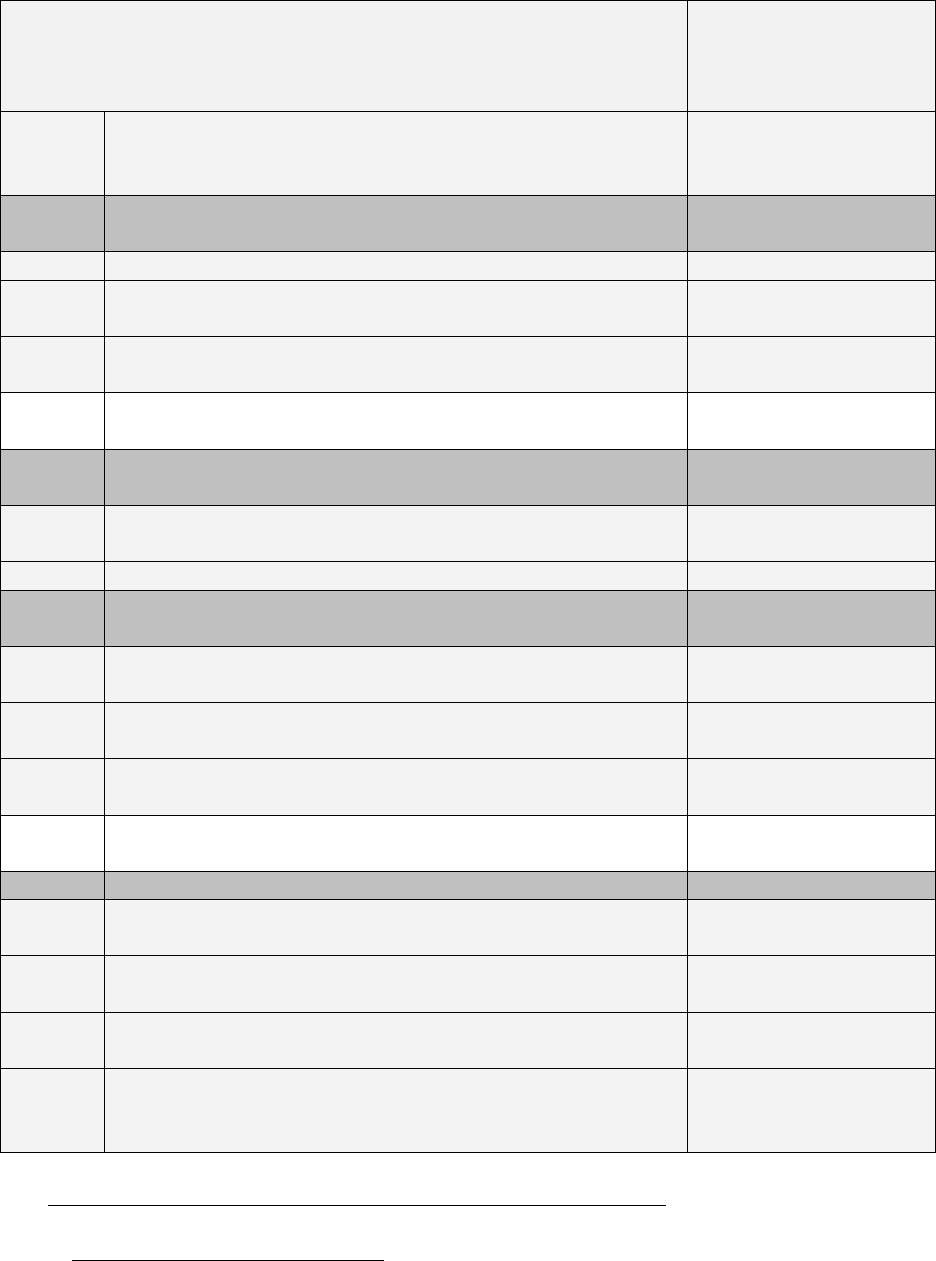
OPNAV M-5090.1
25 Jun 2021
C-15
Root Cause Code
International
Organization for
Standardization
14001:2004(E)
DOC02
Procedure(s) to approve, review and update, and retain
relevant versions of information is not established or is
not adequately implemented.
4.4.5
Operational Control/Emergency Preparedness and
Response
4.4.6/4.4.7
OCP01
Documented plans or procedures are inadequate.
4.4.6
OCP02
Documented plans or procedures not properly
implemented to control activities.
4.4.6
OCP03
Appropriate contingency planning for emergency
preparedness and response is missing or ineffective.
4.4.7
CHECK
(Checking and Corrective Action)
Monitoring and Measurement/Evaluation of
Compliance
4.5.1/4.5.2
MMC01
Calibrated and verified monitoring or measurement
equipment is not used or maintained.
4.5.1
MMC02
Internal compliance evaluation is not effective.
4.5.2
Nonconformity, Corrective Action and Preventive
Action/Control of Records/Internal Audit
4.5.3/4.5.4/4.5.5
NCA01
The corrective action and preventive action process is not
effective.
4.5.3
NCA02
Control and tracking procedure(s) for documents and
records is absent or inadequate.
4.5.4
NCA03
Internal audit program is not implemented or is
ineffective.
4.5.5
IMPROVE
(Management Review)
Management Review
4.6
MRV01
Documented procedure describing the management
review process is inadequate.
4.6
MRV02
Roles, responsibilities, and authorities are not clearly
defined, documented, or communicated.
4.6
MRV03
Management review process or procedure is not
implemented effectively.
4.6
MRV04
Management review process is insufficient to create
change, provide leadership, or effectively improve the
EMS.
4.6
C-4 Uniform National Discharge Standards Non-Compliance Report
C-4.1. Precedence (for Messages Only). If prior voice reports have been made both to the NRC
and the reporting command’s chain of command, use “Routine” precedence for HS/Uniform

OPNAV M-5090.1
25 Jun 2021
C-16
National Discharge Standards (UNDS) Discharge Release Report messages not classified as an
EHS. If voice report has not been made, use “Priority” precedence.
C-4.2. Classification or Special Handling Marks. UNDS non-compliance report messages are
unclassified and do not warrant special handling marks unless classified or sensitive business
information must be incorporated. Avoid inclusion of such information to the maximum extent
possible to allow UNDS non-compliance report messages to be handled on a solely unclassified
basis.
C-4.3. Correcting UNDS Non-Compliance Report Messages. UNDS non-compliance report
messages should be updated with a follow-up message as soon as the reporting activity becomes
aware of new information concerning the origin, amount, nature of substance, type of operation
at source or root cause, or lessons learned. Similarly, if the final estimate of the amount released
differs substantially from the amount initially reported, the reporting activity must send an
update message to all action and information addresses on the original message.
C-4.4. Action and Information Addressees
FROM: Navy activity/ship responsible for or discovering discharge
TO: Navy On-Scene Coordinator
Chain of Command
INFO: Local Navy Regional Environmental Coordinator
Host Activity
CNO WASHINGTON DC//N45//
CNIC WASHINGTON DC//N45//
CHINFO WASHINGTON DC//JJJ//
COMNAVSEASYSCOM WASHINGTON DC//00C//
NAVFAC EXWC PORT HUENEME CA//424//
NAVJAG WASHINGTON DC//11//
[Add NRC for releases into or upon navigable waters of the United States, its
contiguous zone (within 12 NM of U.S. shores), and adjacent shorelines.]
COAST GUARD NATIONAL RESPONSE CENTER WASHINGTON DC//JJJ//
C-4.5. Body of Report. Use this format for the body of all UNDS non-compliance report
messages. It is important for data-management purposes that the format be followed.
UNCLAS//N05090//
SUBJ: UNIFORM NATIONAL DISCHARGE STANDARDS NON-COMPLIANCE REPORT
(MIN: CONSIDERED)
MSGID/GENADMIN/ORIGINATOR//
RMKS/
1. LOCAL TIME AND DATE RELEASE [OCCURRED/DISCOVERED]
2. FACILITY/VESSEL ORIGINATING RELEASE:

OPNAV M-5090.1
25 Jun 2021
C-17
a. For Navy ships, list ship name and hull number.
b. For vessels without a name or hull number, list other vessel identifying information.
c. If the source is unknown at time of this report, list only “Unknown” until it has been
definitively established.
3. RELEASE LOCATION:
a. For release at sea, list latitude, longitude, and distance to nearest land.
b. For release in port, list port name, host naval command (NAVSTA, shipyard), and
specific location.
4. AMOUNT RELEASED:
a. Use convenient units of weight or volume (e.g., kg, lb, gal, L).
b. For continuous release, estimate rate of release and amount left in container (if
applicable).
c. Estimates should be made by examining loss at the source (e.g., measured loss from a
source tank, calculating flow rate of discharge).
d. Unreliable estimates of volume using visual observation of substance on water may not be
reported here.
e. If amount is unknown at time of this report, list only “Unknown” until it has been
definitively established.
f. If a release is contained to prevent any release to the water, an UNDS non-compliance
report is not required.
5. UNDS NON-COMPLIANCE DISCHARGE:
a. Select UNDS Non-Compliance Discharge: Aqueous Film-Forming Foam (AFFF), Chain
Locker Effluent, Distillation and Reverse Osmosis Brine, Elevator Pit Effluent, Gas Turbine
Water Wash, Non-Oily Machinery Wastewater, Photographic Laboratory Drains, Seawater
Cooling Overboard Discharge, Seawater Piping Biofouling Prevention, Small Boat Engine Wet
Exhaust, or Welldeck Discharge.
6. RELEASE DESCRIPTION:
a. Provide narrative description of UNDS Non-Compliance Discharge. Consult the UNDS
Implementation Brief (refer to appendix E (Web Sites) of this manual for Web site address) for
definitions of UNDS discharges and what constitutes an UNDS non-compliance.
OPNAV M-5090.1
25 Jun 2021
C-18
b. Provide any applicable chemical and product names, formulas, synonyms, physical and
chemical characteristics, and inherent hazards. For example, “Container label identifies the
contents as 6 percent AFFF solution.”
c. Describe appearance, physical and chemical characteristics, and actual or potential
hazards observed. For example, “Substance released is a colorless to light yellow unidentified
liquid” or “Highly irritating to eyes and nose.”
7. CAUSE OF RELEASE:
a. Provide narrative description of the specific cause of release.
b. Account for personnel error and equipment failure, directly contributing to release. For
example, “AFFF station was inadvertently activated due to shorted AFFF switch causing AFFF
to discharge overboard.”
c. If cause unknown at time of this report, list only “Unknown” until it has been definitively
established.
8. TYPE OF CONTAINER FROM WHICH SUBSTANCE ESCAPED:
a. 55-gal drum, elevator sump, storage tank, or can.
b. Estimate number of containers damaged or exposed if applicable.
9. RELEASE ENVIRONMENT:
a. Describe the scene of release.
b. Include information on physical characteristics, size and complexity of release, and
weather conditions. For example, “AFFF released to the local waters. Visible floating foam
covering an area of approximately 50 feet by 100 feet with winds blowing the foam toward the
channel.”
10. AREAS DAMAGED OR THREATENED:
a. Describe actual and potential danger or damage to surrounding environment.
b. Identify body of water, area, or resources threatened or affected.
c. Describe nature and extent of damage to property, wildlife, or other natural resources (if
any).
11. NOTIFICATIONS MADE AND ASSISTANCE REQUESTED:
a. List all organizations informed of release within and beyond Navy jurisdiction. Include
Navy, Federal, State, and local authorities; response teams; fire departments; and hospitals.
OPNAV M-5090.1
25 Jun 2021
C-19
b. Specify type of assistance requested from these organizations.
c. If telephonic report to NRC made, list: date, time, group of telephonic report; NRC report
and case number; name of NRC official taking report; reported quantity of discharge released;
and Navy command making telephonic report.
12. FIELD TESTING: Indicate findings and conclusions as to concentration or pH.
13. CONTROL AND CONTAINMENT ACTIONS [PLANNED/TAKEN]:
a. If none, explain why.
b. Specify method used to control and contain release. For example, tagged out AFFF
cutout valves to prevent further inadvertent discharge.
14. CLEANUP ACTIONS [PLANNED/TAKEN]:
a. If none, explain why.
b. Identify on-site or off-site treatment, method used, parties involved in cleanup and
removal, and disposal area.
15. AMOUNT OF SUBSTANCE RECOVERED [VOLUME/WEIGHT] (PURE PRODUCT):
16. PARTIES PERFORMING [CONTAINMENT/CLEANUP] ACTIVITIES:
a. Identify lead organization in charge (e.g., Navy command, USCG, EPA).
b. Identify all other parties involved: Commercial firms, supporting Navy activities, and
State or local agencies.
17. FEDERAL, STATE, OR LOCAL REGULATORY ACTIVITY DURING THIS
INCIDENT:
a. Identify by name and agency any regulatory official attending on-scene or making
telephonic inquiry.
b. Note whether officials boarded vessel and include date, time, and spaces inspected.
18. ASSISTANCE REQUIRED/ADDITIONAL COMMENTS
19. LESSONS LEARNED: How could the release have been avoided? How could the release
be avoided in the future? For example, “Command submitted a Preventative Maintenance
Feedback Report to inspect AFFF switches that are susceptible to weathering conditions to
prevent switch malfunction in the future.”
20. ACTIVITY CONTACT FOR ADDITIONAL INFORMATION: List name, rank and rate,
command, code, e-mail address, and DSN and commercial telephone numbers.//

OPNAV M-5090.1
25 Jun 2021
D-1
APPENDIX D
AFLOAT ENVIRONMENTAL CHECKLISTS
D-1 Scope. The two checklists in this appendix are provided to evaluate command
environmental compliance requirements at sea.
Indicate the answer to each of the questions with an X. If a question is not applicable to the
command, put NA in the YES block. Explain or describe the conditions warranting any NO
answer in the space at the end of the checklist or on additional sheets, if necessary.
D-2 Afloat Pollution Prevention and Waste Management Compliance Checklist. This checklist
is provided to guide afloat commands in the evaluation of command pollution prevention and
waste management compliance procedures, practices, and training. An underlined question does
not apply to all ships, but only to the category indicated. The chapter 35 (Environmental
Compliance Afloat) reference of this manual is in parentheses at the end of the question.
YES
NO
TRAINING
1. Are all hands trained in environmental protection in I Division or School of
the Boat? (35-3.3a)
2. Are ship watch officers responsible for authorizing overboard disposal of
shipboard wastes trained on discharge restrictions for shipboard wastes as part of
their watch qualification procedures? (35-3.3d)
3. Is there a designated afloat environmental protection coordinator (AEPC)
who is trained and knowledgeable? (35-3.2)
4. Does the AEPC know who the designated person in charge (PIC) is?
(35-3.11a(1))
5. Are the AEPC and PIC aware of the Uniform National Discharge Standards
operational, reporting, and recordkeeping requirements? (35-3.11)
6. Are personnel who operate or maintain sewage and graywater disposal or
transfer equipment trained on the proper procedures for sewage or graywater
disposal, including hookup and transfer of sewage or graywater to shore
facilities and at-sea discharge restrictions? (35-3.12d)
7. Have personnel assigned to supervise sewage or graywater disposal
operations completed the Shipboard Sewage Collection, Holding, and Transfer
(CHT) course (K 652-2141)? (35-3.12d)
8. Have all personnel who operate or maintain sewage or graywater disposal
equipment completed the Shipboard Sewage CHT and Treatment Personal
Qualification Standard (PQS), Naval Education and Training (NAVEDTRA)
43199-F, prior to assignment to those duties? (35-3.12d)
9. Are personnel whose watch duties may result in air emissions (e.g., diesel
engine operators, boiler operators, gas turbine operators) trained on the
minimization of air pollution as a part of their watch qualification? (35-3.13f)

OPNAV M-5090.1
25 Jun 2021
D-2
YES
NO
10. Are personnel whose task assignments may result in air emissions (e.g.,
topside painters, users of volatile solvents) trained on the proper use of the
material prior to performing the task to minimize the release of pollutants?
(35-3.13f)
11. Have the air conditioning and refrigeration (AC&R) technicians who
perform maintenance on AC&R equipment received Environmental Protection
Agency (EPA) technician certification and training on ozone-depleting
substance (ODS) regulations and spent or recyclable ODS labeling, prior to
assignment? (35-3.13f)
12. Are personnel who work with other ODSs (e.g., Halons, solvents) or
perform maintenance on equipment containing such substances trained on
methods to prevent release, prior to assignment? (35-3.13f)
13. Have personnel assigned to operate the incinerator or other thermal
destruction equipment completed all PQSs appropriate for the type of
equipment, prior to assignment, including NAVEDTRA 43704? (35-3.13f)
14. Are personnel who operate or maintain oil, waste oil, and oily waste
holding, processing, disposal, or transfer equipment trained on the proper
procedures for oily waste processing and disposal, including hookup and
transfer of waste oil and oily waste to shore facilities and on in-port and at-sea
discharge restrictions:
a. Have personnel assigned to supervise and perform oily waste processing
and disposal operations completed the Oil Pollution Abatement Equipment
Operation and Maintenance course, K 652-2196, prior to assignment?
b. Have all personnel who operate or maintain oil processing, transfer, or
disposal equipment completed the On Water, Oil Spill Response, Containment,
and Recovery PQS, NAVEDTRA 43195-D, before assignment to those duties?
(35-3.14k)
15. Has at least one overboard oil and hazardous substance (OHS) spill
response drill for each duty section been held annually? (35-3.15d)
16. Has the ship trained in port watchstanders and command duty officers on in
port OHS spill response procedures, the ship’s spill contingency plan (SCP), and
local notification requirements prior to assignment? (35-3.15d)
17. Is at least one petty officer in each in port fire party and each repair party
qualified in oil spill cleanup supervisor duties within 6 months of assignment?
(35-3.15d)
18. For submarines and small craft only. Are type commander requirements
followed so that appropriately qualified individuals are present at the scene of
hazardous material (HM) or oil spill? (35-3.15d)
19. Are personnel who handle, store, or dispose of HM trained per Chief of
Naval Operations Instruction (OPNAVINST) 5100.19E, Navy Occupational
Safety and Occupational Health (SOH) Program Manual for Forces Afloat,
chapter B3? (35-3.16f)
20. Are personnel responsible for handling ship’s garbage trained on the
discharge restrictions applicable to the waste? (35-3.17j)

OPNAV M-5090.1
25 Jun 2021
D-3
YES
NO
21. Are personnel responsible for the supervision and approval of overboard
disposal of solid waste (SW) trained on the legal requirements for this waste
category? (35-3.17j)
22. Have personnel assigned to operate and maintain SW processing equipment
(e.g., plastics waste processors, shredders, pulpers, incinerators), completed the
computer-based training interactive courseware or appropriate SW processing
equipment sections of PQS (NAVEDTRA 43704)? (35-3.17j)
23. Are personnel responsible for processing and disposing of shipboard
medical waste trained to ensure such actions comply with the requirements
governing this waste? (35-3.18f)
EQUIPMENT OPERATION
24. Does the ship observe these procedures within 12 nautical miles (NM) from
nearest land:
a. Are all AFFF maintenance and testing procedures conducted outside of
12 NM from nearest land?
b. Are all chlorinators used according to documentation (manufacturer’s
manual or Technical Warrant Holder instruction)?
c. Are fouling organisms collected from pipe cleaning events held for
onshore disposal?
d. Does the ship thoroughly clean its anchor chain as it is drawn out of the
water?
e. Is water collected in the elevator pit and from gas turbine water washing
always held for onshore disposal?
f. Are management practices in place to ensure that landing craft in the
welldeck do not release graywater into the welldeck?
g. Are management practices in place to ensure that discharge from the
welldeck does not include garbage or oil?
h. Are washdowns of gas turbine engines on landing craft in the welldeck
only conducted outside 3 NM from nearest land?
i. Are landing craft returned to the welldeck always washed down after
completion of operations? (35-3.11b)
25. Does the ship have a marine sanitation device (MSD) of the type
appropriate to its status and year of construction? Is the MSD certified by
Commander, Naval Sea Systems Command (COMNAVSEASYSCOM) and is it
operable? (35-3.12a)
26. Does the ship observe these procedures:
a. Does the ship operate and maintain the installed MSD to prevent the
improper overboard discharge of untreated or inadequately treated sewage, or
any waste derived from sewage (e.g., sludge), within 0 to 3 NM of the United
States?
b. Unless the MSD on board has been specifically designed and constructed
to hold or treat both sewage and graywater, does the ship operate the MSD to
collect only sewage and not graywater while operating or transiting within 3 NM
from nearest land?

OPNAV M-5090.1
25 Jun 2021
D-4
YES
NO
c. In port, does the ship collect graywater in the installed MSDs or
graywater collection systems (if so fitted) and pump the waste ashore?
d. When in ports and connected to pier sewers, sewers, is food waste
discharged to shore by either diverting disposers to a segregated food tank or to
the MSD system does the ship divert food waste disposers to a segregated food
waste tank or to the MSD system for discharge ashore?
e. If the ship operates in fresh water other than the Great Lakes, does it
refrain from discharging treated or untreated sewage into freshwater lakes,
freshwater reservoirs, or other freshwater impoundment, or into rivers not
capable of interstate navigation?
f. With reference to item 26e of this table, is the ship modified to preclude
accidental discharge?
g. Are used solvents or other industrial wastes prohibited from being
discharged to MSDs or graywater collection systems and from being dumped
down sinks or deck drains? (35-3.12a and 35-3.12b)
27. While visiting non-Navy ports, does the ship request sewage reception
facilities (barge or installed sewage hookups) in logistics requirements or other
pertinent documentation? (35-3.12b)
28. Are only solvents, paints, fuels, lubricants, and chemicals approved on the
Ships Hazardous Material List (SHML) or the Submarine Material Control List
(SMCL) ordered or used? (35-3.13a)
29. Are only properly trained personnel equipped with appropriate personal
protective equipment permitted to perform shipboard emergency or operational
readiness repairs on thermal insulation containing asbestos? (35-3.13a(4))
30. Is asbestos material removed during shipboard repair actions performed by
ship’s force properly containerized and disposed of without release of asbestos
fibers into the environment? (35-3.13a(4))
31. For Navy and Commander, Military Sealift Command ships with AC&R
systems with an installed refrigerant charge of 50 pounds or more that contain
ODSs such as chlorofluorocarbon (CFC)-11, CFC-12, or CFC-114 or ODS-
substitute material such as hydrofluorocarbon (HFC)-134a, HFC-236fa, or R-
404A (a blend of HFC-143a, HFC-125, and HFC-134a), does the ship meet the
annual performance goals:
a. Maintain a maximum annual leakage rate of no more than 15 percent of
total installed refrigerant charge of air conditioning equipment?
b. Maintain a maximum annual leakage rate of no more than 35 percent of
total installed refrigerant charge of ship’s stores and cargo refrigeration?
(35-3.13a(5))
32. Are ODSs and ODS-substitute materials including refrigerants and
firefighting agents recovered prior to maintenance on AC&R systems and fire-
protection systems? (35-3.13a(6))
33. Do personnel who perform maintenance on AC&R systems keep records of
maintenance actions, names of technicians performing work, pounds of
refrigerant removed, and pounds of refrigerant added and retain them for 3
years? (35-3.13a(7))

OPNAV M-5090.1
25 Jun 2021
D-5
YES
NO
34. When replacing inoperable galley refrigeration equipment, is new
equipment EPA-approved (complying with their Significant New Alternatives
Policy Program), and COMNAVSEASYSCOM-approved, using refrigerant
with an ozone-depletion potential of zero? (35-3.13c)
35. If the ship has had an overhaul availability at Navy National Emission
Standards for Hazardous Air Pollutants (NESHAP)-affected source sites, were
records of ship’s force marine coating use maintained for coatings distributed
from ship’s stores? (Note: The Hazardous Material Inventory Control System
for Windows or the Submarine Hazardous Material Inventory and Management
System may be used to keep these records.) (35-3.13d)
36. If the ship has had an overhaul availability at a commercial NESHAP-
affected source site, was the use of paint recorded and reported regardless of
availability type or operational status? (35-3.13d)
37. Are the paint work practices observed, including:
a. Are marine coatings or paint spills minimized?
b. Are only intact and leak-free coating containers stored?
c. Are coating containers closed when not in use? (35-3.13e)
38. Is a monthly report of daily coating use delivered by the seventh day of the
month following use or before departure, if departing before the end of the
month, or after a short visit (i.e., several days) to the affected source site (Navy
shore activity) or, when located at a commercial affected source site, to the
appropriate Supervisor of Shipbuilding office? (35-4.12hh)
39. Are paint lockers labeled with placards stating, “Thinning of marine
coatings/paints is prohibited”? (35-3.13e)
40. Is an installed oil/water separator (OWS) and oil content monitor (OCM)
fully operable and used to process all machinery space bilge water? Is the oil
pollution abatement equipment certified by COMNAVSEASYSCOM?
(35-3.14b and 35-3.14h)
41. For a ship equipped with an OWS and an OCM, are oil and oily discharges
limited to 15 parts per million (ppm) oil worldwide? (35-3.14b)
42. For surface ships equipped with an OWS but with an inoperable OCM and
submarines with a bilge water processing tank (BWPT), is all machinery space
bilge water processed through an OWS or BWPT before discharge? (35-3.14c)
43. For a ship without an operating OWS but with an oily waste holding tank
(OWHT):
a. To the maximum extent possible, without endangering the ship or
impairing its operations or operational effectiveness, is all oily bilge water
directed to the OWHT for shore disposal?
b. Is discharge volume and environmental impact minimized by discharging
only the water portion of the holding tank overboard?
c. Are such discharges of oily bilge water made at least 50 NM from nearest
land, only while the ship is making way, and noted in the engineering log?
(35-3.14d)

OPNAV M-5090.1
25 Jun 2021
D-6
YES
NO
44. For a ship equipped with neither an operating OWS nor an operating
OWHT, is oily bilge water retained for shore disposal to the maximum extent
possible, without endangering the ship or impairing its operations or operational
effectiveness? (35-3.14e)
45. For submarines without BWPTs:
a. Is bilge water discharged, after allowing for adequate separation time?
b. Is only the bottom, non-oily water phase of bilge water pumped
overboard? (35-3.14f)
46. Is oil contamination of bilge water minimized? (35-3.14i)
47. Does the ship refrain from use of bilge cleaners that have not been approved
by COMNAVSEASYSCOM? (35-3.14i)
48. While in port, does the ship dispose of bilge water only by pumping to a
permanent shore reception facility, using its installed OWS, or pumping to a
ship waste offload barge, and use eductors only in an emergency? (35-3.14i)
49. Is waste or used oil disposed of in port and not at sea, and collected and
stored separately for eventual shore reclamation? Are hydraulic and synthetic
oils kept separate from other lubricants? (35-3.14i)
50. Does the ship conduct fuel operations:
a. In port or restricted waters during daylight hours only?
b. With trained personnel?
c. Using topside watches in communication with pumping stations?
d. Using check-off lists?
e. Continuously monitoring each tank level while filling it?
f. Only after informing the commanding officer (CO), command duty
officer, or officer of the deck, as appropriate? (35-3.14i)
51. Does the ship refrain from the use of eductors to strip fuel or cargo tanks?
Does the ship avoid stripping tanks overboard, but instead strip to contaminated
fuel settling tanks? (35-3.14i)
52. Does the ship properly dispose of oil-contaminated SW? (35-3.14i)
53. Does the ship maintain a minimum of one oil spill response kit—Allowance
Equipage List serial number 2-550024006—for overboard OHS spill response?
(35-3.15a(3))
54. Does each ship listed maintain a minimum of one HM response kit,
including:
Surface Ships: AEL 2-550024007?
Small Craft: AEL 2-550024008?
Mine Countermeasures Vessels: AEL 2-550024009? (35-3.15a(3))
55. Submarines: Does each submarine maintain an Otto fuel spill cleanup kit
(AEL 0006350027) for torpedo Otto fuel and HM spill response? (35-3.15a(3))
56. Has each ship and submarine developed and maintain an SCP that is
coordinated with the cognizant NOSC plan? (35-3.15a(3))
57. Does the ship manage HM following table 35-3? (Table 35-3)
58. Is paragraph 35-3.16 pertaining to ship-to-shore transfers and ship-to-ship
transfers of excess HM or used HM followed? (35-3.16b and 35-3.16c)

OPNAV M-5090.1
25 Jun 2021
D-7
YES
NO
59. Are the ship’s plastics waste processor, pulper, and metal/glass shredder
properly operated worldwide and is processed material handled per paragraph
35-3.17? (35-3.17)
60. Do all ships and submarines minimize the volume of plastic material taken to
sea that may become waste while at sea? (35-3.17a)
61. Surface Ships: If inoperable plastics waste processor(s) either threatens or
results in the discharge of plastics, has a casualty report been submitted?
(35-3.17b)
62. Submarines: If inoperable plastics waste management equipment either
threatens or results in the discharge of plastics, has a casualty report been
submitted? (35-3.17c)
63. Are responsible personnel aware of the requirement to report discharges of
unprocessed non-food SW into “in effect” International Convention for the
Prevention of Pollution from Ships Annex V Special Areas? (35-3.17f(4))
64. For ships equipped with COMNAVSEASYSCOM-approved thermal
destruction equipment, are rags burned only if lightly petroleum-soiled and
when beyond 12 NM from nearest land? (35-3.17i)
65. Is the autoclave functional so that medical personnel may sterilize and
disinfect medical waste? (35-3.18d)
66. Does the medical department representative understand medical waste
management requirements? (35-3.18)
67. Surface Ships: Are ships that took on ballast water within 12 NM from
nearest land performing and logging ballast water exchanges? (35-3.19a)
PROGRAM COMPLIANCE AND EFFECTIVENESS
68. Is the ship aware of the requirement to report by message to the Office of
the Chief of Naval Operations, Energy and Environmental Readiness Division
(OPNAV N45) with information copies to the chain of command, any interest
expressed by regulators in discharges from U.S. Navy ships? Do responsible
officers understand they should make no agreements with environmental
agencies about ship discharges without OPNAV N45 approval? (35-3. 4.b(3))
69. Does the ship maintain and have accessible UNDS non-compliance reports
of UNDS non-compliance events for the past 5 years? (35-3.11a)
70. Does the ship have these UNDS records:
a. Exception records detailing justification for why a specific discharge is
non-compliant (impact to health, safety, or mission; equipment failure)?
b. Class-specific discharge exemptions as approved by ASD(S)?
c. Records of chain locker inspections and cleanings?
d. Justification for why using an environmentally acceptable lubricant in
two-stroke engines is not feasible? (35-3.11)
66. Is the ship operated and maintained to conform to applicable Federal, State,
and local air pollution emission regulations? (35-3.13)

OPNAV M-5090.1
25 Jun 2021
D-8
YES
NO
72. On floating dry docks, are industrial wastes periodically removed from the
floor of the dry dock and sent to shore facilities for disposal? Are there
processes in place to ensure that all discharges from industrial waste collection
systems to shore treatment facilities, sewer systems, or surface waters are in
compliance with applicable Federal, State, and local regulations? Is an officer
or petty officer appointed to ensure dry dock personnel properly operate and
maintain oil and oily waste collection and treatment systems and they safely and
effectively handle ship-to-shore transfers of the waste? (35-3.22 and 35-4.13)
73. Are periodic inspections (at least quarterly) by senior medical department
personnel conducted to maintain sanitary and hygienic conditions of MSD
systems and operational practices? Are periodic sanitation and hygiene
inspections of SW processing equipment conducted? (35-4.11g)
74. Are appropriate health and sanitation precautions posted as required by
OPNAVINST 5100.19E, Navy Occupational Safety and Occupational Health
(SOH) Program Manual for Forces Afloat; Naval Ships’ Technical Manual
(NSTM), chapter 593; and Navy Medicine (NAVMED) P-5010-7, Manual for
Naval Preventative Medicine, Wastewater Treatment and Disposal, Ashore and
Afloat? (35-4.11h)
75. Are sewage discharges within 0 to 3 NM of the United States permitted
under 35-3.12c reported as required and established by the chain of command?
(35-4.11i)
76. Are only marine coatings used that meet volatile organic compound content
standards of the NSTM, chapter 631, table 3-7? (35-4.12l)
77. Are non-compliant coatings removed from ship’s stores and returned to the
supply system as excess HM as soon as possible? (35-4.12l)
78. If there are any conditions or equipment malfunctions that could necessitate
oily waste, HM, or SW discharge into waters in which discharge is restricted,
are they reported to the chain of command? (35-4.11o)
79. Are the date, time of occurrence, ship location at the beginning and end of
the incident, substance discharged, quantity discharged, and cause of the
discharge for any oily waste discharge that causes a sheen recorded in the
engineering log or equivalent oil record book? (35-4.11p)
80. Are personnel aware of and do they understand the oil or OHS SCPs?
(35-4.11s)
81. Are all OHS spills reported as prescribed in subparagraphs 35-3.15b and 35-
3.15c? (35-4.11t)
82. Is immediate action taken to contain, control, and mitigate any spills caused
by the ship? (35-4.11q)
83. Are the requirements of OPNAVINST 5100.19E, Navy Occupational Safety
and Occupational Health (SOH) Program Manual for Forces Afloat, and
COMNAVSEASYSCOM PCB Advisories followed for all activities associated
with polychlorinated biphenyls (PCB), PCB-containing materials, or systems
potentially contaminated with PCBs (e.g., ventilation systems that employ PCB-
containing felt gaskets)? (35-4.12w)

OPNAV M-5090.1
25 Jun 2021
D-9
YES
NO
84. Is used and excess HM offloaded, to the maximum extent feasible, to a
Navy or other public facility prior to entering a private shipyard for an
availability? Does the ship also offload HM not anticipated for use by ship’s
force during the availability before entering the private shipyard? (35-4.11x)
85. Do personnel comply with OPNAVINST 5100.19E, Navy Occupational
Safety and Occupational Health (SOH) Program Manual for Forces Afloat
requirements for HM handling, packaging, storage, labeling, treatment, and
disposal? Is an HM coordinator appointed by the CO? (35-4.11bb)
86. Does the ship collect the debris, dust, and residual materials from the paint
removal, to the maximum extent feasible, and properly package these materials
for dispose ashore? (35-4.11cc)
87. If plastic discharges have occurred, are they properly recorded in the ship’s
deck log? Are plastic discharges personally approved by the CO? (35-4.12ee)
D-3 At-Sea Marine Mammal and Endangered Species Permit Compliance Checklist. This
checklist is provided as a self-evaluation tool for commands conducting training, testing, or
acoustic active sonar maintenance activities at sea. The checklist covers training, mitigation, and
reporting requirements under the Navy’s Marine Mammal Protection Act and Endangered
Species Act permits. The chapter 35 (Environmental Compliance Afloat) reference of this
manual is in parentheses at the end of the question, where applicable. Those items without a
chapter 35 reference can be found on the Protective Measures Assessment Protocol (PMAP)
Web site (refer to appendix E (Web Sites) for Web site address).
YES
NO
TRAINING
1. Do all hands receive, upon reporting aboard and annually thereafter, marine
mammal and endangered species compliance training? (35-3.3a)
2. Do all personnel tasked with running the PMAP program receive training on
its use upon reporting aboard and annually thereafter? (35-3.20d)
3. Do all lookouts, COs, executive officers, bridge watch personnel, Maritime
Patrol Aircraft aircrews, anti-submarine warfare (ASW) and mine warfare
(MIW) helicopter crews, and civilian equivalents complete marine species
awareness training upon reporting aboard and annually thereafter? (35-3.21e)
4. Do all personnel tasked with preparing and approving Sonar Positional
Reporting System (SPORTS) reports receive SPORTS training upon reporting
aboard and annually thereafter? (35-3.21e)
MITIGATION
5. Does the ship use PMAP in planning for training, testing, and acoustic active
sonar maintenance events at sea? (35-3.20c)
6. Are the mandatory mitigation measures contained in PMAP implemented and
adhered to for training, testing, and acoustic active sonar maintenance events at
sea? (35-3.20c)
7. Is the latest version of PMAP being used?
8. Are PMAP records signed by the CO?

OPNAV M-5090.1
25 Jun 2021
D-10
YES
NO
9. Are PMAP records retained for 2 years?
10. Does the ship’s crew avoid deliberately harassing marine mammals and
threatened or endangered species and consider marine mammal and threatened
or endangered species protection during ship operations and training? (35-3.21a)
11. Are all time-specific mitigation measures (e.g., North Atlantic Right Whale
(NARW) Calving Season announcement messages) and area-specific (e.g.,
northeastern U.S. NARW sighting reporting requirements) mitigation measures
promulgated by COMUSFLTFORCOM and COMUSPACFLT complied with?
12. Are the detailed mitigation and reporting requirements specific to Major
Training Exercises (MTE), required by fleet commanders or officers conducting
exercises (OCE) complied with?
13. When using active sonar, are two lookouts positioned in the forward
position of the ship (e.g., Bridgewings)?
14. Do the CO’s standing orders address marine mammal mitigation measures?
REPORTING
15. If so equipped, does the ship report the use of active acoustic sources for
training exercises, testing, and maintenance via SPORTS? (35-3.21d)
16. Are whale strikes and strandings reported in accordance with OPNAVINST
F3100.6J? (35-3.21c)
17. In the Commander, Task Force 80 Area of Operations, is ordnance
expended for training, testing, or maintenance being reported via unclassified e-
mail to Fleet Forces Atlantic Exercise Coordination Center at [email protected]
and the Fleet Forces Range Complex Support Team at [email protected]?
18. Are MTE mitigation after action reports, required by fleet commanders or
the OCE, submitted within the period specified?
OPNAV M-5090.1
25 Jun 2021
E-1
APPENDIX E
WEB SITES
Web Site
Web Site Link
Air Force Institute of Technology (AFIT)
Courses
http://www.afit.edu/cess
Armed Forces Pest Management Board
http://www.afpmb.org/
Army Logistics University Web Site for
Training Courses
http://www.alu.army.mil/
Board of Inspection and Survey
http://www.public.navy.mil/fltfor/insurv/Pages/
default.aspx
Commander, Naval Sea Systems Command
(COMNAVSEASYSCOM) Oil and
Hazardous Substance (OHS) Spill
Database (Common Access Card (CAC)
enabled) (NOSCnet)
https://secure.supsalv.org
Contaminants and standards related to the
Safe Drinking Water Act
http://www.epa.gov/safewater/mcl.html
Council on Environmental Quality
https://ceq.doe.gov/
Defense Logistics Agency (DLA) Aviation
http://www.aviation.dla.mil/
DLA Courses
http://www.hr.dla.mil/dtc/courses.asp
Defense Supply Center Richmond (DSCR)
http://www.aviation.dla.mil/
Department of Defense (DoD)
Conservation
http://denix.osd.mil/index.cfm
DoD Natural Resources Instructions,
Policies, and Guidance
http://denix.osd.mil/nr/otherlinks.cfm
http://www.dodnaturalresources.net/Resources.
html
http://www.denix.osd.mil/nr/LegislationandPoli
cy/PolicyandGuidance/dodinstructions.cfm

OPNAV M-5090.1
25 Jun 2021
E-2
Web Site
Web Site Link
DoD Installation Restoration Cleanup
Tools: Vapor Intrusion
Department of the Navy (DON)
Applications and Database Management
System (DADMS) (CAC enabled)
https://www.denix.osd.mil/irp/vaporintrusion/?
https://www.dadms.navy.mil/
DON Chief of Information
http://www.doncio.navy.mil/Main.aspx
DON Perfluorinated Compounds
(PFC)/Perfluoroalkyl Substances (PFAS)
http://www.secnav.navy.mil/eie/pages/pfc-
pfas.aspx
Environmental Compliance Assessment
Training and Tracking System (ECATTS)
https://environmentaltraining.ecatts.com
Environmental Information Management
System
https://eims3.sscno.nmci.navy.mil/
Environmental Management System Web
Site (EMSWeb)
https://eprportal.cnic.navy.mil/
Environmental Readiness Program
Requirements Web (EPRWeb) (requires
CAC and login)
https://eprweb.cnic.navy.mil/
Federal Recycling Program
www.fedrecycling.com
Fleet Forces Command Afloat
Environmental Toolbox
https://eims.dc3n.navy.mil/afloat/
Incentivized Shipboard
Energy Conservation
http://www.i-encon.com
Incidental Take Authorizations, Office of
Protected Resource, National Oceanic and
Atmospheric Administration (NOAA)
Fisheries
http://www.nmfs.noaa.gov/pr/permits/incidental
.htm
Indian Entities Recognized and Eligible to
Receive Services from the United States
Bureau of Indian Affairs
http://www.loc.gov/catdir/cpso/biaind.html
International Maritime Organization (IMO)
http://www.imo.org
OPNAV M-5090.1
25 Jun 2021
E-3
Web Site
Web Site Link
Maritime Claims Reference Manual
https://www.jag.navy.mil/organization/code_10
_mcrm.htm
National Park Service
http://www.nps.gov/history/laws.htm
Naval Civil Engineer Corps Officers
School (CECOS)
https://www.netc.navy.mil/centers/csfe/cecos/
Naval Forms OnLine (NFOL)
https://navalforms.documentservices.dla.mil/we
b/public/home
Naval Postgraduate School Collaborative
Learning and Research Portal
https://cle.nps.edu/xsl-portal
Naval Safety and Environmental Training
Center (NAVSAFENVTRACEN)
http://www.public.navy.mil/navsafecen/navsafe
nvtracen/Pages/default.aspx
Naval Safety Center
(COMNAVSAFECEN)
Naval Sea Systems Command Detachment,
Radiological Affairs Support Office
(NAVSEADET RASO)
Navy Community Service Program
http://www.cnic.navy.mil/
Navy Conservation Web Site (CAC and
login)
https://eprweb.cnic.navy.mil/
Navy Office of Community Outreach
(NAVCO)
http://www.navy.mil/navco
Navy’s Energy, Environment, and Climate
Change Web Site
http://navysustainability.dodlive.mil/
Navy Facility Engineering Systems
Command (COMNAVFACSYSCOM) Air
Installation Compatible Use Zone training
information
Navy and Marine Corps Public Health
Center
https://hub.navfac.navy.mil/webcenter/portal/a
m?_afrLoop=77518475097665
https://www.med.navy.mil/sites/nmcphc/Pages/
Home.aspx

OPNAV M-5090.1
25 Jun 2021
E-4
Web Site
Web Site Link
National Emission Standards for
Hazardous Air Pollutants (NESHAP)
Certificate Repository
https://my.navsup.navy.mil/apps/ops$neshap.ht
ml_home_page
Office of the Chief of Naval Operations,
Energy and Environmental Readiness
Division (OPNAV N45) Environmental
Planning and Compliance Library
https://epl.navfac.navy.mil
OPNAV N45 Functional E-Mail Account
N456EnvPlanning.opnav@navy.mil
Protective Measures Assessment Protocol
(PMAP) (CAC enabled)
https://eims.dc3n.navy.mil/pmap
or
https://pmap.nola.navy.smil.mil
Sonar Positional Reporting System
(SPORTS) (NOTAL)
https://sports.navy.smil.mil
Training Exchange Web Site
http://www.trainex.org
Toxic Release Inventory (TRI) Made Easy
Web
Accessible through the U.S. Environmental
Protection Agency (EPA)’s Central Data
Exchange at http://cdx.epa.gov
U.S. Army Corps of Engineers Training
Courses
http://ulc.usace.army.mil
U.S. Coast Guard On-Scene Coordinator
Crisis Management (OSCCM-MS-523)
http://uscg.mil/tcyorktown/info/contact.asp
U.S. Code
https://www.gpo.gov/fdsys/browse/collectionU
Scode.action?collectionCode=USCODE
U.S. Environmental Protection Agency
(EPA)
http://www.epa.gov/
U.S. EPA’s Central Data Exchange
http://cdx.epa.gov
U.S. EPA’s Enforcement and Compliance
History Online (ECHO)
https://echo.epa.gov/
U.S. EPA’s Online Targeting Information
System (OTIS)
http://www.epa-otis.gov/
OPNAV M-5090.1
25 Jun 2021
E-5
Web Site
Web Site Link
U.S. EPA’s Resource Conservation and
Recovery Act (RCRA) Public Participation
Manual
http://www3.epa.gov/epawaste/hazard/tsd/permi
t/pubpart/
U.S. EPA’s Initial HAZWOPER Training
https://trainex.org/hazwoper.cfm
U.S. Navy Environmental Portal (CAC
enabled)
https://eprportal.cnic.navy.mil
U.S. Navy List Builder
https://listbuilder.erdc.dren.mil/listbuilder/index
.cfm?page=main.naHome
UNDS Implementation Brief
https://www.mnp.navy.mil/group/environmental
-compliance-afloat/uniform-national-
discharges-unds
OPNAV M-5090.1
25 Jun 2021
F-1
APPENDIX F
FORMS AND REPORTS
PART 1. FORMS
Directives Division
DD Form 448, Military Interdepartmental
Purchase Request
DD Form 1348-1A, Issue Release/Receipt
Document
DD Form 2521, Hazardous Chemical
Warning Label (8x11)
DD Form 2522, Hazardous Chemical
Warning Label (4x6)
http://www.dtic.mil/whs/directives/forms/eform
s/dd0448.pdf
http://www.dtic.mil/whs/directives/forms/eform
s/dd13481a.pdf
http://www.dtic.mil/whs/directives/forms/eform
s/dd2521.pdf
http://www.dtic.mil/whs/directives/forms/eform
s/dd2522.pdf
Environmental Protection Agency (EPA)
EPA Form 8700-29, Tier I Emergency and
Hazardous Chemical Inventory Form
EPA Form 8700-30, Tier II Emergency and
Hazardous Chemical Inventory Form
EPA Form 8700-22, Uniform Hazardous
Waste Manifest Form
EPA Form 9350-1, Toxics Release
Inventory (TRI) Form R
https://www.epa.gov/sites/production/files/2013
-08/documents/t1-form2012-1.pdf
(Instructions can be found at:
https://www.epa.gov/sites/production/files/2013
-08/documents/t1-instr2012-1.pdf)
https://www.epa.gov/sites/production/files/2016
-01/documents/t2form2012_2016.pdf
(Instructions can be found at:
https://www.epa.gov/sites/production/files/2013
-08/documents/t2-instr2012-1.pdf)
https://www.epa.gov/sites/production/files/2015
-06/documents/newform.pdf
(Instructions can be found at:
https://www.epa.gov/sites/production/files/2015
-06/documents/man-inst.pdf)
https://www.epa.gov/sites/production/files/2016
-01/documents/ry_2015_form_r.pdf
OPNAV M-5090.1
25 Jun 2021
F-2
EPA Form 9350-2, TRI Form A
EPA Form 9350-3, TRI Form R, Schedule
1
EPA State Tier II Reporting Requirements
(Instructions can be found at:
https://www.epa.gov/sites/production/files/2016
-
01/documents/ry_2015_tri_reporting_forms_an
d_instructions.pdf)
https://www.epa.gov/sites/production/files/2016
-01/documents/ry_2015_form_a.pdf
(Instructions can be found at:
https://www.epa.gov/sites/production/files/2016
-
01/documents/ry_2015_tri_reporting_forms_an
d_instructions.pdf)
https://www.epa.gov/sites/production/files/2016
-01/documents/ry_2015_form_r_schedule_1.pdf
(Instructions can be found at:
https://www.epa.gov/sites/production/files/2016
-
01/documents/ry_2015_tri_reporting_forms_an
d_instructions.pdf)
http://www2.epa.gov/epcra/state-tier-ii-
reporting-requirements-and-procedures
Office of the Chief of Naval Operations (OPNAV)
OPNAV Form 5090/3, Statement of
Technical Review for NEPA/E.O. 12114
Documents
OPNAV Form 5090/4, Preliminary Impact
and Exposure Report (PIER)
https://navalforms.documentservices.dla.mil/for
msDir/_OPNAV_5090_3_6448.pdf
https://navalforms.documentservices.dla.mil/for
msDir/_OPNAV_5090_4_10838.pdf
Occupational Safety and Health Administration (OSHA)
OSHA Safety Data Sheet
https://www.osha.gov/pls/oshaweb/owadisp.sho
w_document?p_table=standards&p_id=10103
(Instructions can be found at:
https://www.osha.gov/Publications/OSHA3514.
html)
OPNAV M-5090.1
25 Jun 2021
F-3
PART 2. REPORT CONTROL SYMBOLS
SECNAV RCS 5090-1, NEPA Action Proponent Periodic Status Report, assigned to data
collection in chapter 10 (Environmental Planning Under the National Environmental Policy Act
and Executive Order 12114), subparagraph 10-3.4c(2)(c) of this manual.
OPNAV RCS 5090-2, NOSC Annual Report and Navy Spill Response Program and Report
Database (formerly known as Oil Spill Report), assigned to data collection in chapter 39 (Oil and
Hazardous Substance Spill Preparedness and Response), subparagraphs 39-3.4c(1); 39-3.4c(2);
39-4.4g; 39-4.4r; 39-4.7i; 39-4.8o; 39-4.8w; and 39-4.9n of this manual.
OPNAV RCS 5090-4, Reporting Requirement for Environmental Notices of Violation (NOV)
and Significant Non-Compliance (SNC), assigned to data collection in chapter 19 (Processing
Notices of Violation Under Environmental Laws and Regulations), subparagraph 19-3.2c of this
manual.
OPNAV RCS 5090-5, Environmental Compliance Audit Reports, Schedules and Documentation
of Corrective Action and Report of Compliance Deficiencies, assigned to data collection in
chapter 17 (Environmental Management Systems and Environmental Compliance Audits
Ashore), subparagraphs 17-3.2c, 17-3.2d, 17-3.2f, 17-3.2i, 17-4.1e, and 17-4.1h of this manual.
OPNAV RCS 5090-8, Ozone-Depleting Substance (ODS) Reserve Requirements, assigned to
data collection in chapter 22 (Clean Air Ashore), subparagraph 22-4.4d of this manual.
OPNAV RCS 5090-9, Burial at Sea Report, assigned to data collection in chapter 36 (Permitted
Ocean Disposition), paragraph 36-4.4 of this manual.
OPNAV RCS 5090-12, Target Vessel Sinking Report, assigned to data collection in chapter 36
(Permitted Ocean Disposition), subparagraph 36-3.2j of this manual.
OPNAV RCS 5090-15, Preliminary Impact and Exposure Report (PIER), assigned to data
collection in chapter 41 (Natural Resource Damage), subparagraph 41-3.2b(1) of this manual.
OPNAV RCS 5090-16, Cooperating Agency Status Reporting Requirements, assigned to data
collection in chapter 10 (Environmental Planning Under the National Environmental Policy Act
and Executive Order 12114), subparagraphs 10-3.5b(3) and 10-3.5b(5) of this manual.
OPNAV RCS 5090-19, CNIC Cultural Resources Metrics, assigned to data collection in chapter
13 (Cultural Resources Compliance and Management), subparagraph 13-4.4e of this manual.
OPNAV RCS 5090-20, Environmental Management Systems (EMS) Third-Party Independent
Review Schedule, assigned to data collection in chapter 17 (Environmental Management
Systems and Environmental Compliance Audits Ashore), subparagraph 17-4.1f of this manual.
OPNAV M-5090.1
25 Jun 2021
F-4
OPNAV 5090-21, Annual Status Report on Navy Shore Facility and Installation Drinking Water
Quality Worldwide, assigned to data collection in chapter 21 (Safe Drinking Water Compliance
Ashore), subparagraph 21-3.1c of this manual.
OPNAV RCS 5090-22, Board of Inspection and Survey (INSURV) Environmental Compliance
Oversight Inspections for Naval Forces Afloat, assigned to data collection in chapter 35
(Environmental Compliance Afloat), subparagraphs 35-3.7a and 35-4.6c of this manual.
OPNAV RCS 5090-23, Discharges from Naval Vessels, assigned to data collection in chapter 35
(Environmental Compliance Afloat), subparagraphs 35-3.10b; 35-3.13d(2); 35-3.14d; 35-
3.15b(2)(d); 35-3.15b(3)(c); 35-3.15b(4)(c); 35-3.17b; 35-3.17b.(3); 35-3.17c; 35-3.17c(2); 35-
4.11i; 35-4.11o; 35-4.11t; and 35-4.12d of this manual.
OPNAV RCS 5090-24, Monthly Report of Daily Coating Use, assigned to data collection in
chapter 35 (Environmental Compliance Afloat), subparagraph 35-4.11k of this manual.
OPNAV RCS 5090-25, Annual Solid Waste Data Call, assigned to data collection in chapter 28
(Solid Waste Management and Resource Recovery Ashore), subparagraph 28-4.2d of this
manual.
